TORG by Evil Mastermind
tl;dr
Original SA post Back on April 15, 2013, I started something big. Very big. Possibly too big. But now, it's time to revisit and revise, to remember and reword, and to finish what I started over a year and a friggin' half ago. But to do that, we need to go back to where it all began...The Storm Has A Name - Let's Read TORG

Part 1: tl;dr
TORG. Man...TORG.
Where the hell do I start with this?
TORG was a huge game line in the early to mid 90's, back in the day where boxes sets were still a Thing and having a ton of supplements was not just expected but was the standard way of doing things. I've said many times in the past how it's the epitope of 90's design both mechanically and in terms of the metaplot. It's the poster child for setting bloat. It had great ideas handled in a really bad way. It’s the culmination of rules-as-physics (and metaphysics) Hell, a large part of the metaplot didn't even happen in-game, it happened in a novel trilogy that came out before the game itself did because, as you'll see, the game designers really wanted to be writers. It has Jeff Mills, the worst NPC ever.
But I'm getting ahead of myself.
The hardest thing about talking about TORG is that there's no easy "in". It's a huge, sprawling, heavily entangled mess. It's a mess I admittedly love, it's one of my favorite settings ever, but everything in both the crunch and fluff is so heavily intertwined it's ridiculous. TORG is the embodiment of "rules as physics", because the setting has a lot of metaphysics that are modelled in the actual game mechanics, and in a few cases the metaphysics informed the game mechanics themselves.
Dammit, I'm getting ahead of myself again. Hell, I haven't even talked about what the game's about yet. Let's start with the basics.
TORG was first released by West End Games in 1990, and is a multi-genre game about an invasion of Earth by multiple alternate realities in an attempt to drain the world of "possibility energy", allowing the man who organized the invasion in the first place to ascend to multiversal godhood.
(Oh, and in case you're wondering, the game is called TORG because in early development it was called "That Other Roleplaying Game" and the acronym stuck.)
The core of TORG was a boxed set that came with three books (the core rules, the Worldbook that barely described all the different realities, and a starter adventure), a cool looking d20, and a custom deck of 160 cards that were needed to play the game.
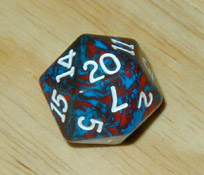
The Torg die. I still have mine.
The TORG line ran for about 5 years, and ended up with just over 50 books on top of the core set. Over half of them were adventures, which were all tied into the overall metaplot and caused a lot of the problems that arose in the later years of the line. In addition, there was a monthly newsletter you could subscribe to that had updates of what was going on in the metaplot, adventure seeds, and so on.
And that raises another problem: I can't talk too much about the mechanical side of things without giving you folks at least a base understanding of the setting and metaplot. So let's start there...
FAIR WARNING: There is a lot of backstory here, and most of it won't make sense until we get to other parts of the system later. Just bear with me.
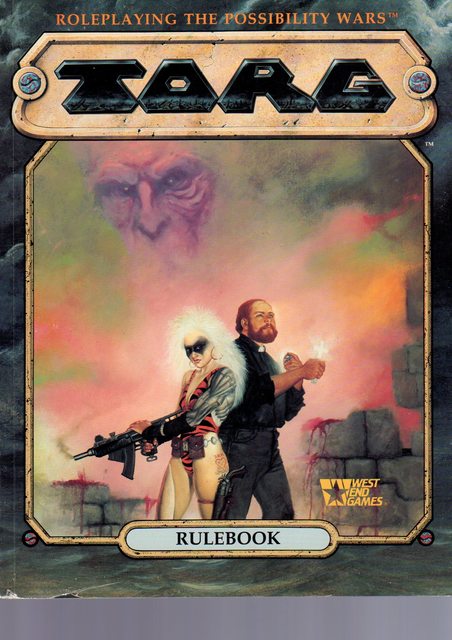
The cover of the boxed set and core rulebook. Pictured: Dr. Hachi Mara-Two and Father Christopher Bryce, two of the characters from the novels
quote:
Legends. They speak of The Place, in the Time of Nothing. The Void was alone in The Place, possessed by an unending hunger but unable to sate it. Then Eternity entered The Place, full of dreams and possibilities locked within its infinite instant with no method of release. Void and Eternity met, and The Maelstrom was formed.
The Void tasted the essence of Eternity, and it became aware of what it craved. Eternity boiled away into the Void and billions of possibilities were destroyed. Whole galaxies came and went as the Void fed. The Maelstrom endlessly tossed out possibilities that were destroyed in the whirling currents of creation. But, eventually, two possibilities survived.
The Nameless One, a being that took after the Void, was destruction personified. Apeiros, created from realized possibilities, was of Eternity's image. The two waged a war of creation and destruction - Apeiros setting possibilities free, the Nameless One feeding on their power. But as fast as the Nameless One could feed, Apeiros could create. There could be no victor. Then the Nameless One invoked the Void.
With no other course available, Apeiros left The Place. It appealed to Eternity and saw an infinite number of possibilities opened before it. Apeiros took them all, diffusing the possibilities throughout the new place — throughout the cosmverse.
The Nameless One, now alone in The Place with the Void, vowed to hunt down Apeiros and Eternity, no matter how long it took. It used what limited creative powers it had learned during its war against Apeiros to create the Darkness Devices. Then it sent these items of evil into the cosmverse to perpetuate acts of destruction and capture the dispersed shards of Eternity.
Legends. They tell of the discovery of the first Darkness Device, and how it elevated its possessor to High Lord and then led him to other cosms to destroy and drain possibilities. Thus was born the first of the Possibility Raiders; thus was spoken The Prophecy — there would arise a High Lord with the knowledge and power to absorb so much energy as to become immortal, all powerful, a god. And this High Lord would be called the Torg!
And thus the multiverse was created.
A central idea of TORG is that the core building block of a reality (or "cosm"), the fundamental unit of energy, is the Possibility. Possibilities are what allow worlds to grow and change, what allow people to find their own destinies and shape the world around them. But every world could also potentially have a Darkness Device: an ancient artifact that could steal possibilities from the world and give them directly to its owner, who would become the High Lord of that world. The High Lord could then take that energy and use it to travel to other realities, raiding other worlds for their possibility energy.
One of these High Lords was a figure known only as "The Gaunt Man". He was the High Lord of the world of Orrorsh; an alternate Earth where the Victorian empire never ended, and controlled a world beset by monsters and horrors out of nightmares. The Gaunt Man's overall goal was to become the Torg, and in pursuing this goal he spent centuries travelling through the multiverse, finding other worlds and stripping them of possibilities. Once he had enough possibility energy, we would only need a large amount of physical energy (of the "major geological catastrophe" variety) to complete his transformation into the Torg and attain control of the multiverse.
The physical energy would be easy; a large enough act of destruction would take care of that. The hard part was finding enough possibility energy. He could drain worlds as he found them, but that was time consuming even for an immortal like himself.
Then, in his travels, he discovered Earth.
Earth was unique in The Gaunt Man's travels because it had more possibility energy than any world he'd ever encountered. This one world alone could finally provide him with the needed energy to become the Torg, but this power was also an incredible disadvantage to him.
Through the use of a Darkness Device it was possible to create "maelstrom bridges" between two realities, allowing High Lords to send invading armies from one reality to another. However, it's a multiversal law that two realities cannot exist in the same place at the same time. When one reality invades another, the invader "pours in" like oil poured into water. Then there is a contest of realities, in which possibility energy surges from the invading cosm, then from the defending cosm, then back to the invading cosm, until one reality is triumphant; either the defending reality pushes the invader back to its own dimension, or the attacking reality overwrites the defending one. High Lords can use their Darkness Devices to sustain and absorb the surge from the defending cosm, preventing their reality from being pushed back. But because Earth had so much possibility energy, the defensive surge from Earth would be too large to be handled by Orrorsh alone. The invasion would be repelled and the bridge destroyed almost as soon as the invasion started.
Unwilling to let such a little thing as certain defeat stop him when he was so close to his goal, The Gaunt Man researched and experimented for years to come up with a plan: invade Earth with multiple realities at once. In his travels, he had come across other "Possibility Raiders", other High Lords who used their own Darkness Devices to travel to and conquer other worlds.
The problem was determining how many allies he wanted to bring to the invasion. He needed help, true, but he also wanted to ensure he was sharing his power with as few "allies" as possible, as well as making sure they were people he could easily manipulate. At the same time, he needed to have enough realities invade that Earth's reality couldn't effectively push back against all of them at once. He determined that an invasion force of seven realities would be optimum, and set out to gather his invasion force:
-
There was the
Gaunt Man
himself, High Lord of
Orrorsh
, the world of Victorian horror.
-
His former chief officer
Uthorion
. Uthorion was the High Lord of
Asyle
, the fantasy cosm. Uthorion was actually a spirit possessing the body of the world's queen,
Lady Pella Ardinay
, and was slowly corrupting Aysle itself.
-
Another of the Gaunt Man's former lieutenants,
Kranod
, was also brought in. Kranod was a "techno-demon" from
Tharkhold
, a harsh world of perpetual war between techno-demons and humans, where magic and high technology were merged.
-
Baruk Kaah
, fanatic and High Lord of the primitive cosm
The Living Land
, was tapped because his reality was the strongest in spiritual strength out of all the Gaunt Man's options. Baruk Kaah is an edinos; a race of lizard-people who worship life and physical sensations. Like pain.
-
The Gaunt Man also recruited
Pope Jean Malraux I
, High Lord of
Magna Verita
. Pope Malraux had conquered many realities in the name of God, changing them to dark, medieval worlds like his own where only the Church held sway and science was forbidden before "cleansing" them with holy fire. His world was referred to as
The False Papacy
by the other High Lords, but never to Malraux's face.
-
Next was the costumed madman known only as
Dr. Mobius
, the insane "supervillain" of the pulp cosm of Terra and self-proclaimed Pharaoh of the
Nile Empire
. Even though he was not High Lord of his homeworld, his Empire spanned nine different realities.
-
Lastly, negotiations came to a close with
3327
, the CEO of the Kawana Corporation and High Lord of the world known as
Marketplace
. In this reality, also known as
Nippon Tech
, the laws of capitalism and profit were as powerful as the laws of physics.
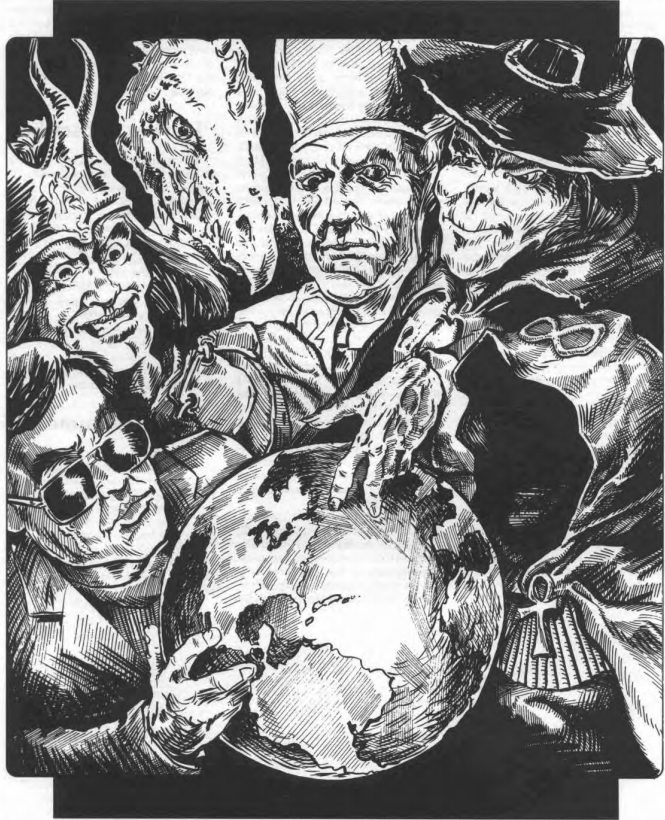
Clockwise from the left: 3327 (a.k.a Ryuchi Kanawa), Uthorion, Baruk Kaah, Cyberpope Jean Malraux I, The Gaunt Man, and Dr. Mobius
The invasion took years to plan, but one of the advantages of being bonded to a Darkness Device is effective immortality. The High Lords sent advance agents ahead through smaller bridges called "dimthreads" (that only exist for moments and would not cause major disturbances in Earth's reality). These agents were able to keep their home realities wrapped around themselves, and subtly prepared Earth for their masters' invasion.
The Gaunt Man led the attack, dropping a maelstrom bridge into Indonesia and bringing with him an army of monsters, horrors, and unwitting British armed forces. As Orrorshian reality slowly overwrote Earth's reality in Indonesia, technology started to break down as the rules of a "Victorian" reality took hold. Dangerous storms surrounded the islands as Earth's reality fought back against the invading cosm.
To the outside world, all that anyone knew was that Indonesia was being buffeted by what looked like a giant hurricane and communication with the were cut off. Before the world governments could investigate, however, Baruk Kaah attacked.
Kaah had chosen North America for his invasion; where the Gaunt Man employed subtlety he used brute force. Three bridges dropped from the Living Land: one in New York, one in Sacramento, and one in Fort Providence in Canada. Kaah sent thousands of edinos down the bridges, as well as other, more alien races he'd conquered. As the Living Land's primitive reality overwrote Earth's, thousands upon thousands of Earth's inhabitants were "transformed" to the new cosm, forgetting their old lives and becoming followers of Baruk's Kaah's fanatic religion: the worship of the Goddess Lanala. The Living Land now covered the east and west coasts of the United States and a large part of Canada.
Canadian and US forces were caught completely unprepared, and adding to the chaos the American president and vice-president were in New York when the invasion happened, and were at ground zero for the bridge's landing. There was no choice but to declare them dead.
The few survivors found it almost impossible to fight back, because of another important fact: each reality has different "rules" as to what is and isn't possible. In the reality of the Living Land, what we think of as "modern technology" simply does not work . Gunpowder will not fire, engines will not run, matches won't even light when struck. Not only that, but some concepts are not possible either. The Living Land is a primitive world where there is no farming, no industry, and very little social structure beyond the tribe. The Earth military in the Living Land found themselves unable to remember concepts like "the chain of command", or even "minutes". They were defeated the instant they tried to fight back.
Aysle was the next to invade, dropping several bridges onto England and Scotland, covering northern Europe almost entirely with the new reality. The United Kingdom was suddenly overrun by vikings, giants, dragons, and wizards as technology died and was replaced with magic.
The False Papacy invaded France next, changing the country into a despotic theocracy and dragging the technology and social levels of central Europe down to their level: one where the power of the Church was absolute and technology was forbidden. Pope Malraux did not come to Earth personally to oversee the invasion, a decision that would ultimately change his reality at its most fundamental levels.
Tharkold was to invade northern Russia next, but it was here that the Possibility Raiders met their first setback.
In order to safely invade another reality, devices called stelae needed to be set up in the reality that was to be invaded. Stelae are set up in threes, forming a triangle. When a bridge is dropped inside this triangle, the stelae would become empowered and create a barrier that served two purposes. First, it created a wall that prevented the invading reality from pushing back directly against the invading realm, allowing the High Lord to establish footholds. Second, the area inside the triangle described by the stelae would transform to the invading reality, taking on that reality's rules. Inhabitants would have their possibility energy striped, and would transform to the new reality. They would forget their old lives, their old world, and would become effective inhabitants of the new cosm.
This is why the more "primitive" realities invaded first. As these realities overwrote Earth's, the lower technological levels would cause Earth's technology to stop working. A military assault rifle would not work at all in Asyle, not because it hadn't been invented in that reality yet, but because that reality didn't support that level of technology at all . In extreme cases, the assault rifle might actually physically transform into something appropriate, like a crossbow.
Moments before the Tharkold bridge dropped, a Russian task force attached to the government’s psychic research project had discovered the location of one of Tharkold's stelae, thanks to the precognitive Katrina Tovarish. She led Captain Nicolai Ondarev to the location of the stelae just as the bridge began to drop. Destroying the stelae broke the circuit and allowed Earth's reality to fight back. Not only was the bridge destroyed and the invading force repelled, the resulting surge of Earth's energy travelled back up the connection to Tharkhold itself, wreaking havoc on that reality for years afterward.
The sudden surge of energy from Earth pushed hard against the cosms that had already invaded, and it seemed as if Earth could destroy the invaders after all. The High Lords hurried to readjust and bolster their holdings against the sudden reversal of fortunes. Four realities were not enough to stand against Earth's possibilities.
Then the Nile Empire invaded.
Dr. Mobius landed in Egypt, and the Nile Empire quickly spread over northern Africa, transforming it into a realm of two-fisted heroes, shadowy villains, ancient magic, and lost treasures. Dr. Mobius expanded recklessly into the deserts and quickly turned his attentions to conquering Israel and the Sudan.
Seeing that the High Lords were now capable of winning, 3327 finally dropped his maelstrom bridge in Japan. Unlike the other High Lords, however, 3327 didn't go in for flashy effects. He dropped his bridge inside a skyscraper his corporation had purchased as part of the attack preparations. All the people of Earth knew was that the Kawana Corporation and its CEO Ryuchi Kanawa (3327 himself) were a new major financial power. The invasion of Japan was so subtle, the Nippon Tech reality so similar to Earth's, that it would be about three years before anyone even realized that Japan had been invaded.
Now six realities invaded Earth, leaving everything in a rough sort of equilibrium. The Gaunt Man was ready to become Torg when the second major setback occurred.
Every living being in a cosm contains possibility energy. Most are only capable of having one possibility, one major change in their lives. These "ords" are the people who become transformed when they enter new realities, and are unable to fight back.
Some, however, are capable of more.
When faced with a true moment of crisis, some people are able to draw more possibilities from their world. They can keep their reality around them in a sort of "bubble", allowing them to accomplish things not possible by the local reality. They can fight the invaders on their own terms.
The High Lords call them "Stormers", based on the storms that are created when two realities clash. The heroes prefer to call themselves Storm Knights .
The large amount of possibility energy on Earth created an inordinate amount of Storm Knights. In addition, Storm Knights from the invading realities joined the fight, trying to stop the High Lords from destroying Earth as they had so many worlds before.
One group of Knights managed to face two of the High Lords directly. As Pope Malraux descended his maelstrom bridge into France, ready to present himself as their savior, he was confronted between realities by a survivor of the cyberpunk reality Kandara . As she fought him, she managed to use her technology to show Malraux her high-tech reality; one of common cybernetics and where computer networks were integrated into everyday life. Malraux, ever the fanatic, saw this as a vision from God Himself, and the vision was so powerful it actually altered his personal reality. When he arrived in France, he used his Darkness Device to alter his home cosm's technology levels, bringing it from the printing press to cybernetics in a matter of weeks. He went on to declare that cybernetics were the body of Christ, and that the Internet was the realm of God. He was physically transformed as well; half of his body was replaced with “divine” cybernetics. He was now the Cyberpope, and his realm mixed futuristic technology with medieval mindsets. And thus was formed the Cyberpapacy .
These Knights then fought Uthorion, driving him from Lady Ardinay's body and leaving Aysle without a High Lord. Although Lady Ardinay is on the side of good and has allied herself with Earth, she is still bound to the Darkness Device, and it still whispers to her, tempting her with the power to "fix" everything.
It wasn't long before this group of Storm Knights confronted the Gaunt Man himself. The Gaunt Man is an ancient foe, unable to be killed by normal means. Instead, the Knights used an artifact called The Heart of Coyote to trap him in a pocket dimension, where he is caught in an endless cycle of creation and destruction. His body is eternally and painfully being ripped to shreds, only to be reformed so he can be destroyed again.
The invasion force has lost its head, and now the High Lords see opportunities for themselves to take the Gaunt Man's place.
Which brings us to the Near Now. With the Gaunt Man gone, the remaining High Lords scramble for territory and power in an attempt to become the Torg. The American government is in disarray, with a temporary government being set up in Dallas. America and Europe have lost their abilities to be major financial and technological world powers, leaving Japan and Russia to pick up the slack, nobody knowing that the now-largest financial power is run by a Possibility Raider. Dr. Mobius continues to expand, threatening Iran and Saudi Arabia with bizarre creations of weird science. Berlin finds itself a major world player as the just-reunited Germany is the only thing standing between Russia and the Cyberpapacy. And the Kawana Corporation sells to all sides, motivated solely by profit, nobody on Earth realizing that they're actually just another invading force.
This is the world of Core Earth. And it is in need of heroes.
---
Okay. You see that huge chunk of text I just wrote?
That's just a hair over 3,000 words. And that's the setup for the setting, and the minimum you need to know about what's going on so the rest of what I'm going to tell you makes sense. And that's all stuff that happened in the novel trilogy before the "game" actually starts . Technically speaking the box set takes place about three months after the end of the trilogy, where everything I just told you about happens.
And I haven't even touched on how possibility energy works. Or world laws. Or axioms. Or disconnecting and reconnecting. Or the Everlaws. Or eternity shards. Or Tolwyn of House Tankred. Or the Signal Fire. Or the logarithmic scale. Or the newsletter. Or Malcolm Kain. Or spell design. Or glass ninjas.
Yeah. 90's design.
Strap in, kids.
NEXT TIME: We actually crack open the rulebook!
The Other Basics
Original SA post The storm has a name... - Let's Read TORG
Part 2: The Other Basics
With the pile of backstory shoved aside for now, let's look at the core mechanics.
At first glance, TORG uses a standard stat+skill+d20 system. But the fact of the matter is a little more complex...
quote:
Because Torg uses a unique system to translate back and forth between the game and the real world, we've created terms to distinguish game numbers from "real" numbers. A value refers to a quantity measured in a way which can be used in the game, such as a Strength of 11. A measure is a measurement from the real world, such as "150 pounds." Measures can sometimes be translated into values, and vice versa, but that is a task for the gamemaster. For instance, the gamemaster has a way to find out whether a Strength value of 11 is enough to lift a measure of 150 pounds.
So yeah, this is a game that's going to try and model everything mechanically.
Every character has seven attributes: Dexterity, Strength, Toughness, Perception, Mind, Charisma, and Spirit. Torg uses preconstructed templates for character generation, and attributes run the range from 8 to 13, with 10-11 being average.
In addition, there are just over 50 skills in the core book (later books would add more, eventually topping out at over 100 skills), ranging from the basics like Lock Picking and Fire Combat to more esoteric things like Space Vehicles and Alteration Magic. Skill ranks are called adds and are added to one specific attribute when rolling. Every skill is assigned a specific attribute.
Every character has one skill designated as their tag skill , which starts at 3 adds. This is the character's "signature skill". For example, the Core Earth Intrepid Reporter's tag skill is persuasion , but the Contract Ninja from Nippon Tech has martial arts as his tag skill.
(Oh, one thing I like about the game's presentation: stats and skills are always italicised so you know when they're being referred to, and stats are always capitalized.)
When a character is created, they automatically get the three adds in their tag skill, and then get an additional 13 adds to put in whatever skills they want. The only limitations are that you can't start with more than three adds in a skill (so you can't bump your tag skill up any further), some skills are unavailable to start with depending on your home cosm, and you have to put at least one add in the reality skill.
Reality is the most important skill on your sheet, because it's the skill that allows you to maintain connection to your home reality. Really, it's the fact that you have the reality skill in the first place that makes you a storm knight.
When you want to do something in Torg, you roll a d20. This roll is open-ended in a different way than most games; if you roll a natural 10 or 20, you get to roll again and add. If the reroll comes up 10 or 20, you can roll again and add until you don’t roll a 10 or 20. If you don’t have any adds in the skill you’re using, though, you only reroll and add on 10s.
So if I’m skilled in fire combat with a 13, and roll a 20, I get to roll again and add. If my second roll is a 10, then I roll and add again. My final roll is a 3, so my total die roll is 20+10+3 = 33. If I wasn’t skilled, I wouldn’t have gotten the reroll on the 20 and that would have been my final roll.
Now you'd think you'd just add that number to your attribute or skill, then compare that to a difficulty number. And you'd be almost correct. In Torg, you don't add the roll to your skill; you look it up on the Bonus Chart . And this is where the headaches begin.

The Bonus Chart
That chart is on the bottom of the character sheet, because you're going to use it every goddamn time you roll the die. The top row is the result of the die roll, the bottom is the bonus number.
See, TORG math works on a logarithmic scale because that was a thing designers did in the 90's. You'll notice that in the 15-20 die roll range, numbers line up one-for-one. But as you get higher die rolls, the bonus increases at a slower rate.
Once you roll the die, you look that number up on the Bonus Chart to get the bonus number, and that number is what gets added to your skill. If you meet or beat the difficulty value of the task, you succeed. The difficulty is set by the GM for unopposed tasks and is usually an NPC's skill rank for opposed tests. If you're attacking someone, you also add the bonus number to your weapon's damage rating, but we'll get to that later.
Let's say I'm trying to climb something. I have a Strength of 8 and two adds in climb for a total skill rating of 10. I roll the die and get a 17, for a final roll of 27. Looking that up on the bonus chart gives me a bonus number of 9. Adding that to my skill gets me a final action total of 19. Simple!
And believe me, that's the easiest the mechanical bits will be around here. Fair warning.
Now let's say you roll a 6 (for a -5 to your skill) and are in a situation where you can't afford to fail. That's where possibilities come in.
I mentioned last time that in TORG, "Possibilities" are a form of energy. Every living being has at least one Possibility Point , which is what ties them to their reality. A person who's only capable of holding one Possibility Point at a time is called an Ord . Ords can unconsciously spend that one point to generate a change in their life, and that point will eventually be replenished by their cosm, but ultimately they can only hold one Possibility at a time.
Storm Knights, on the other hand, can hold more than one Possibility at a time. Not only that, but they can use these Possibilities to bend reality in their favor. This is referred to as being possibility rated , or P-Rated for short. Every character starts with 10 Possibilities, and get more as the game goes on with no upper limit on how many you can have.
The main mechanical use of Possibilities is to get rerolls. After rolling the die, you can spend one (and only one ) possibility to get a reroll. This reroll is added to the original roll, can still explode, and as a bonus if the first bonus roll is always considered to be at least a 10. Which is nice, that way you don't really waste the roll.
Example: Jake Silver is driving a jeep and attempting to lose a Nile Empire patrol. The GM says Jake needs to beat the trooper's driving skill of 12 to get away. He makes a land vehicles roll with his skill of 12, and rolls a 6, which is a -5 on the Bonus Chart for an action total of 7. Jake spends a possibility and rolls again, this time getting a 3. This is treated as a roll of 10, which is added to his first roll of 6 for a total of 16/+3. His final action total is 12 (his skill) + 3 (bonus from the roll) = 15.
NPCs can be possibility rated too, and the GM can spend Possibilities for them as well. Players can spend their own possibility points to cancel an NPC's point. On top of that, Possibilities can also be used to counter damage, which I'll discuss in a bit.
There's one last use for Possibility Points, and I'm just going to c&p this one because this is the point where things start getting complicated.
quote:
Reality works differently between one cosm and another (see "The Axioms" later in this chapter), and possibility energy constantly flows to maintain the reality — meaning that equipment, magic, and even skills from your home cosm might not work so well in an alien cosm.
A character in a foreign cosm may spend a Possibility and cocoon himself in a "reality bubble" for 15 minutes. During that time, everything — technology, magic, etc. — works for that character as it would work in his home cosm. There are restrictions, but leave those to the gamemaster.
Example: Quin is in a "pure zone" of the New Empire of the Nile. In the pure zone of a lower tech level, his Uzi simply does not work. If he wished, Quin could spend a Possibility to make the automatic weapon work for 15 minutes. During this time, Quin's other equipment (his night scope, his antiseptic spray, his tear gas grenades)would also work.
So for 15 minutes, you get to use your character's abilities and equipment! What a bargain! Especially since, given the nature of the game, at any given point at least one PC will not be in his home cosm. This restriction also includes what we'd think of as "normal" gear, so if you're the soldier whose tag skill is fire combat and is built around using an assault rifle, and you wind up in Aysle where it doesn't work, then you're going to have to either spend Possibilities or just not be able to use your rifle.
I should point out here, too, that you only get Possibilities at the end of an adventure, so they don't refresh quickly. They're also your XP so you need to be careful how you spend them during play.
So yes, this is a game where your metagame currency has multiple mutually exclusive uses. If you ever played a mage in Shadowrun, you know how much this can suck.
Next up are how to use the social skills, despite the fact that we still haven’t gotten a skill list yet. Charm , persuasion , and intimidate each have several paragraphs of rules on how they work. Charm is used to move people up and down a reaction table, persuasion just gets NPCs to do what you want, and intimidate can actually be used to prevent NPCs from taking actions. You can also do a Test of Wills to get opponents to flee or surrender, taunt them to force them to act in a certain way, or trick them to not act at all.
From here we go to the basics of combat. Yes, I know it feels like we're jumping around a lot, but this is the order things are presented in the book. Things just jump all over the place with no rhyme or reason.
(And as an aside, this is also a symptom of the game's need to mechanically model everything. Every game concept has a corresponding mechanical bit, and all these game concepts are interconnected. Therefore, all the mechanics are likewise interconnected and depend on each other. That means that there's no real simple mechanical "in" to the system because if I explain the skill system, I need to explain Possibilities. And to explain Possibilities, I need to explain Axioms. It doesn't help that the system explanations tend to jump around from concept to concept a lot. The whole system is one big tangle and sometimes I'm amazed I ever figured it out to begin with.)
Anyway, combat.
Combat in TORG uses group initiative. You start by determining who goes first (the heroes or villains), then the characters on that side go in reverse-Dexterity order. So if the heroes have initiative, then the character with the highest Dex goes first, then the next highest and so on until everyone on that side has acted, then you do the same for the villains.
On your turn, you get one action: attack, defend, maneuver, movement, intimidation, taunt, test of will, or trick. These are mostly pretty self-explanatory; "defend" means doing nothing this round but hunkering down, "maneuver" means getting to a more advantageous position versus "movement" which is getting from point A to point B.
It should also be pointed out that you are always assumed to be trying to defend yourself in combat if possible; the difficulty for hitting someone is the skill level of the appropriate defensive skill. So if you're shooting someone, you roll your fire combat against the target's dodge . If you want to actively defend, then you declare it before your opponents go (you can break the initiative order to do this) and roll your defensive skill as normal, but any action result less than 1 is treated as 1. Again, this is set up so you don't completely waste a vital roll, and I like the fact that you can fully defend yourself even if you're going dead last in initiative.
And how do you determine initiative? With the Drama Deck , of course!
The Drama Deck came with the boxed set, and consisted of 156 cards that looked like this:
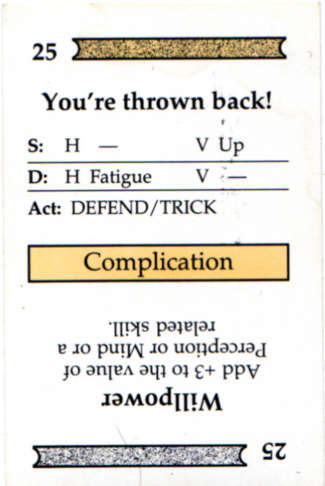
A typical card from the Drama Deck
I'll explain what all that stuff means later, but for now we're just going to look at the top half.
The end of the card with the orange border is the initiative side, and determines who goes first, what advantages/disadvantages they get, and what the approved actions for the round are. The "S" row is for "Standard" scenes, which are normal conflicts. The "D" row is for "Dramatic" scenes, and is used for things like major end-of-act boss fights. The main difference is that the heroes ultimately have the upper hand on two thirds of the S lines, but the villains have it two thirds of the time on the D lines.
At the start of a round, the top card of the deck is flipped over and you look at the appropriate line to determine which side goes first, and what advantages or disadvantages they have. On this card, the heroes go first if it's a standard scene, but the villains are "Up", which means that everyone on that side gets one free reroll this round as if they had spent a Possibility. If this was a dramatic scene the heroes would still go first, but they'd suffer from "Fatigue" and automatically take two shock damage at the end of their turns.
Each card has a different set-up, with different effects like "Flurry" (everyone on that side gets two actions) or "Stymied" (everyone loses one chance at a reroll). And honestly, I really like this initiative set-up, because the added effects keep everyone on their toes and keeps people guessing about twists in the fight. It's pretty awesome to be losing then see that heroes-first-and-get-Flurry card come up.
The side of the card with the grey border is the player's side. In addition to the 10 starting Possibility Points, every character also starts with four cards in their hand. The player's side of the card has effects like giving bonuses to rolls under certain circumstances, free rerolls, or the ability to introduce a subplot. When you're out of combat, you can just play cards as you need them. So if I had that Willpower card there and was making an evidence analysis roll, then I could play the card to get a free +3 to my skill.
That's out of combat. In combat it works a little differently. Big shock, right?
When you're in combat, you can't just play cards from your hand. To play a card in combat, you need to add it to your pool . Every time you succeed at an action, no matter what that action is, you can put a card from your hand into your pool. During combat, cards can only be played from your card pool. In addition, if you succeed at one of the approved actions listed on the initiative card, you draw a card from the deck and put it in your hand. Regardless of whether or not you succeeded at the approved action, you play a card into your pool. At the end of the fight, all the cards in your pool go back to your hand.
Example: At the start of the fight, I have four cards in my hand and none in my pool, and the card up there is in play for the first round (approved actions DEFEND and TRICK). When my turn comes around, I decide I want to attack someone. If I succeed, then I can play a card from my hand into my pool, and I can use that card in my pool whenever it's appropriate. If I had decided to try and trick someone instead and I succeeded, I'd also draw one for my hand, leaving me with four in my hand and one in my pool.
Believe it or not, this part of the system isn't that complex in motion. As long as you remember to put a card in your pool when you succeed at a roll, and draw one when you do an approved action, you're pretty much set.
There's a few more things you can do with your cards; you can play for the critical moment once per act, where you put as many cards as you want into your pool to be used immediately, you can lose cards by having bad guys perform trick/taunt/tests against you, and you can trade cards between people's pools.
So we tangented a bit there, so let's get back to combat and talk about taking damage.
There are three kinds of damage you can take in TORG: shock damage, knockout condition, and wounds.
Shock damage is recorded as a number, and if you have more shock damage than your Toughness, you're knocked unconscious.
Knockout condition is recorded as a "K" or an "O". If you have taken a "K" blow and take another "K" blow, you get two shock damage. If you have the "K" and get an "O" blow, then you're knocked unconscious.
(Yes, this means there's two damage types that effectively do the same thing. 90's design.)
Wounds are serious damage, and has four ranks: wounded->heavily wounded->mortally wounded->dead. Every time you take a wound you move up one level on that ladder. Mortally wounded character will die without immediate attention, but dead characters are dead on the spot.
When you beat someone's defense (armor is a flat add to defense), you need to figure out the damage value. For melee attacks, you add the weapon's damage value to your Strength , whereas guns have fixed damage values. You then add the bonus number from your attack to your damage value and look it up on this table:
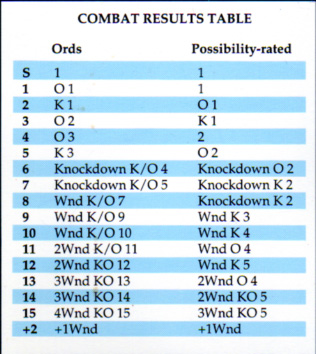
You'll notice that there are separate columns for ords and p-rated characters. Torg tries to be pretty "action movie"-y in overall tone, so faceless NPCs aren't anywhere near as hardy as p-rated folks. Think of it as an early version of Feng Shui's named/unnamed split.
It should also be pointed out that guns tend to have Damage Values in the high teens-low 20's. Hell, the lowest-damage gun has a base damage of 13, and an AK-47 is a 21.
Let's say I'm using a baseball bat (damage rating +3) with a Strength of 10 and no skill, and attacking someone who's Possibility-rated with a defense of 9. My roll is 15, which is +2. 10+2 beats the guy’s defense, so I hit. I now take the damage value of the bat 10+3=13), add the +2, which gives me a damage total of 15. I deal three Wounds, a K and an O, and 5 Shock. The KO means that on top of everything else, the guy's out cold on top of being almost dead.
(This is where the whole "glass ninja" thing comes from: when someone has a really high defense, you have to roll a really high number to hit them. However, melee damage isn't determined by how much you hit them by, it's determined by your final action total . So if I'm fighting someone with a dodge skill if 15, odds are I’m going to need a really high bonus number to hit, which means a large bonus to my damage. In other words, if I manage to hit Mr. Dodgy Pants, odds are I'm going to kill him.)
As stated previously, you can spend possibilities to reduce incoming damage. It works as follows:
quote:
A player may spend a Possibility to reduce the damage his character takes from the current blow. Each Possibility may do three of the following:
1. Remove three points of shock damage from the blow.
2. Remove a knockout condition from the blow.
3. Remove a knockdown result.
4. Remove one level of wound.
A player may spend one Possibility to reduce damage from a single blow. The Possibility is spent after the blow is taken. Cards that act as Possibilities may be spent in excess of one.
Yes, that's complicated.
Unsurprisingly, combat in Torg is pretty deadly. You end up having to spend Possibilities most times you get hit otherwise you’re going to get wreck in a few hits. The idea is that it’s supposed to be like an action movie where people can take tons of damage before dropping, but instead of just making it so you need to take a lot of damage before it matters, they made everything high-damage and put the onus on the player to mitigate it.
Anyway, at the end of a scene, all the cards in your pool go back into your hand, and you discard back down to four cards. You can then discard one card if you want, then you fill your hand back up to four cards. Cards carry over between sessions (which is why they're numbered), and there are three special cards that don't count against your hand size:
-
Subplot
cards like "Romance" or "Mistaken Identity", which cause said subplots to be created and reward you with extra Possibilities at the end of the act.
-
Alertness
, which lets you notice a clue everyone else missed.
-
Connection
, which means you have a contact or ally nearby.
There are other cards too, of course. Some let you perform actions like escaping from combat for free, others act as free Possibilities. But I'm not going to get into them here because this is getting ridiculous enough as it is.
Oh, now we talk about leveling up. You increase your stats and skills by permanently spending Possibilities. Buying adds in a skill costs the rank you're buying up to (so going from +2 to +3 costs 3 Possibilities), buying a new skill costs 2 Possibilities if you can find a teacher, 5 if you're teaching yourself. Increasing a stat works like increasing a skill, but at triple cost (so going from a 10 Dexterity to an 11 would cost 33 Possibilities.
That, in a nutshell, is the first three chapters of the book. Chapter 1 is character creation, chapter 2 is everything I described above except the Drama Deck stuff, which is chapter 3.
That's only 26 pages. This shit is dense .
And again, you can see how heavily intertwined all the rules are. Individually, things like the cards and Possibility Points are simple, but when they start interacting with the rest of the system then I have to bounce back and forth and I feel like I'm coming off like a crazy person as I describe this stuff. I don't know how you guys are going to follow all this. Hell, I'm not sure I can follow it, and I not only wrote it, I [i]re[i]wrote it. I did fix some stuff I messed up the first time, but I’m pretty sure I missed some other stuff.
Like I said, I like the card mechanics. I like the way initiative is handled with regards to sudden boosts or drawbacks you don't see coming, and for players they act like Aspect-less Fate points, giving the players a little narrative control or a little "oomph" when they need it most. But goddamn if they're not presented terribly.
For those of you who are still paying attention, you'll notice how there's kind of the seeds of the Fate system in there; Possibilities are very similar to Fate Points, and the damage mechanics are similar to Fate's if you ignore the K-O bullshit. Yet another reason why I'd love to see a Fate Core version of TORG.
But again: we still haven't gotten to the GM's section yet. That's when the rails will be coming off this train.
NEXT TIME : GMing this motherfucker.
Gamemastery
Original SA post The storm has a name... - Let's Read TORG
Part 3: Gamemastery
On being a gamemaster posted:
If you're just planning on being a player, you don't need to read any more of this book. As long as you've read the Player Section, you know how to figure skill values, how to roll the die and generate a bonus number, how to generate action and effect totals, how to play drama cards into a pool, and what drama cards can do for you.
And that's all you need to know.
But, who sets the difficulty numbers for the players to beat? Who decides what the villains' abilities are, and how much damage is done when a blow lands or a bullet strikes home? The gamemaster does, and to do those things you will need to read the rest of the Rule Book. If you're planning on being a gamemaster, you might want to read a little of the World Book next, then come back here and start getting familiar with the rules.
There is a ton of shit you need to keep track of as a TORG gamemaster.
See, unlike other RPGs, a Torg GM pretty much exclusivly does all the heavy lifting. The players just roll their skill; it's the GM who determines the difficulty numbers. The players don't figure out on their own if they hit and how much damage they do, the GM does. The players technically don't have to worry about the worst of the crunch, that's what the GM is there for. Hell, even the skill list and individual rules for skills are in the GM's section, which the players "don't need to read".
And damn, there is a lot of crunch. There's a lot of tables, too, and if you're GMing then you need pretty much all of them, and a lot of the time you need more than one at once.
Starting out the Gamemastering section is some generic GMing advice I'm not going to bother reproducing here because it's stuff we've all heard before.
The first real chapter of the GMing section is about how to calculate totals and results. The total is the final value generated by a player, which is trying to beat a difficulty, a.k.a. the target number. If the total meets or beats the target number, then you succeed and the amount you succeed by is the result . So if I try to do something that has a difficulty of 14 and I get a total of 19, then I have a result of 5 points.
Now, that's all well and good, but what do you do with these result points?
That's where the results tables come into play.
There are three main result tables, and which one you look at is determined by the type of action you're trying to do. There's a combat result chart, a social interaction result chart, and a general result chart.
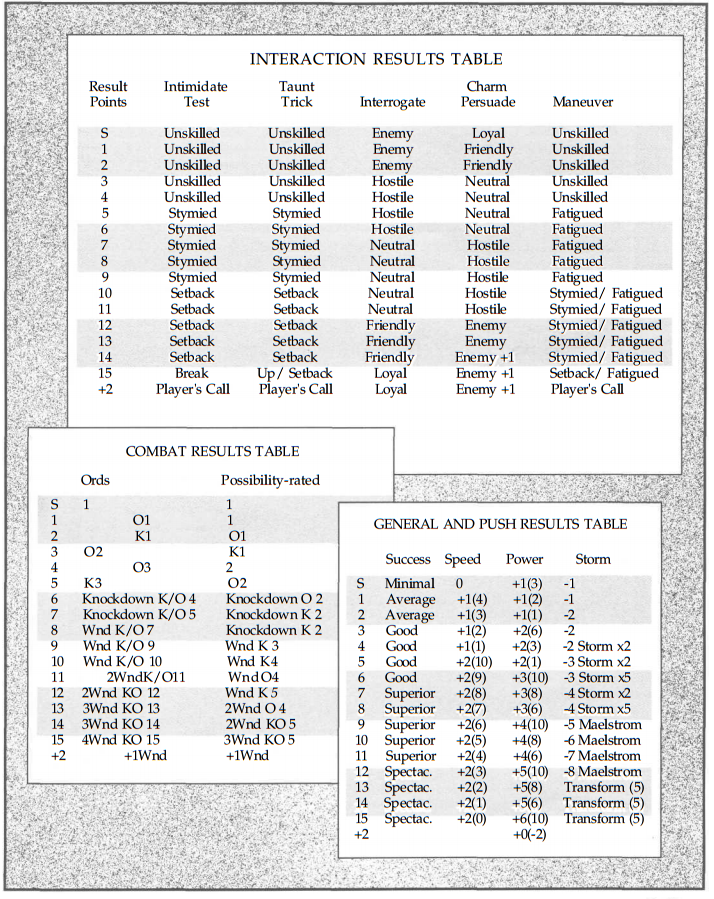
Charts, part 1
We've already talked a bit about the combat results table, and the interaction table is used to determine what effect you had on the target of your intimidate/charm/whatever attempt. So let's look at the general results table. Ignore the last three columns for now, just look at the "success" column. For normal skill use, you look the result value up to see the degree of success. What do those values mean?
quote:
Minimal implies that the character just barely succeeded; you might want to describe how narrowly he avoided failure. Average is average; no extra description is warranted. Good success sometimes merits a more detailed description, particularly if the character faced long odds. A superior success deserves special emphasis. For a spectacular success, pull out all the stops in your description. Your players will love you for it.
The next section is about the attribute scale, and I have to let the first two paragraphs speak for themselves.
quote:
The attribute scale in Torg is an innovative use of attribute numbering, made necessary by the multiple genres in the game. Most game systems either use a consistent scale for their attributes—in other words, each point of an attribute represents a specific amount of real-world measure — or they have no scale at all. The problem with such systems is that while they work fine in a limited setting (fantasy, horror, etc.) they either fall apart when bigger things (like technological weapons) are introduced, or they require huge numbers to represent the top end of the scale. For example, if a dagger does "one die of damage," how many dice do you roll for the main cannon of the Death Star?
Torg solves this problem by the use of a logarithmic scale. A logarithmic scale is one like the Richter scale, or the Decibel scale, where each point represents a greater proportional amount than the point before. For example, a level four earthquake is far more than twice as powerful than a level two earthquake, because each point on the Richter scale is 10 times as large as the point before. This is because earthquakes can range so greatly in size.
Anyway, the idea is that any real-world measurement of weight, distance, or time can be converted into a difficulty number. Said difficulty number can then be used for skill checks. So if a player needs to jump between buildings that are 64 feet apart, the GM would check the Value Chart . 64 isn't a value on the chart for distance, so he moves up to the next highest value (100), and that would be the difficulty of the jump; in this case it'd have a difficulty of 10.
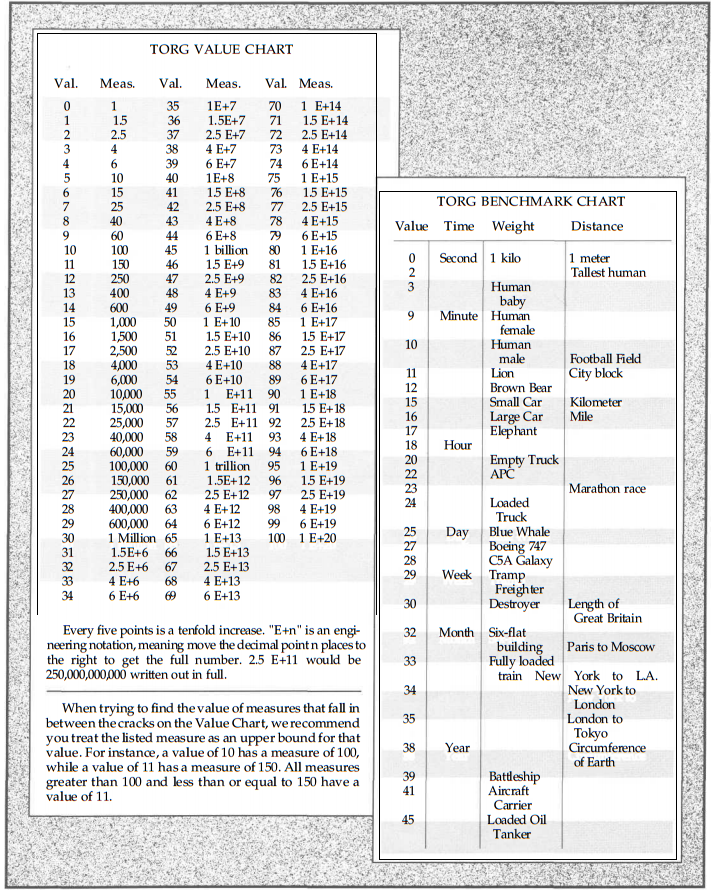
Charts, part 2
Except that the chart in in metric, and was designed and mainly distributed in a country that uses imperial measurement! So do we just convert 64 feet into meters? Of course not, because we didn't have Google back then. Instead, we have another chart!
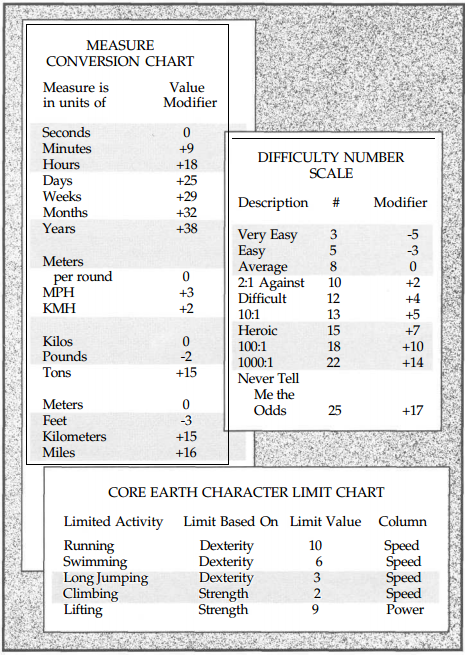
Charts, part 3
To find the actual value of 64 feet, we look up 64 on the Value Chart. 64 doesn't appear on the table, so we go with the next row up (100), which has a Value of 10. Then we look at the Measure Conversion Chart to see what the modifier is for feet. The modifier is -3, which is applied to the target number from the Value Chart for a final difficulty of 7.
(And just for the record, that's not all that hard in terms of difficulty. Most starting characters will have at least a 9 in their stats, which means they're going to have to roll above a 5 on a d20 to succeed if they don't have a relevant skill. If they are skilled, they'll probably have to critically fail to actually fail. Also for the record, the current world record for the long jump is just shy of 30 feet, but again they're trying for an action movie feel. Also, since we have to move up to the next highest value when the exact value we want isn't there, that means it's just as difficult to jump 61 feet as it is to jump 100 feet.)
Now, I appreciate good guidelines for the GM to set difficulty numbers, but come on...the GM is expected to do this every time he needs a difficulty number.
Anyway, there's also the Difficulty Scale for when you want a situational modifier. If the GM decides that a task should be a little harder than normal, you can look up how hard you want to make it on the Difficulty Scale table, and add the appropriate value to the difficulty. For an Easy task, for instance, you reduce the difficulty by 3, but for "2:1 Against" you increase it by 2.
Next up is...another chart! The Limit Chart is what's used to determine human (or non-human for some realms) limits so you don't get results like someone rolling well enough to bench-press a tank. The way it works is that it lists the maximum value a character can generate on the Value Chart for a given task/stat. For instance, the Core Earth human limit for running is 10. To find out how fast someone can run in a round, you look up their Dex on the Value Chart. Someone with a 9 Dex can run 60 meters (about 10 car-lengths) a round. But if someone has a Dex of 11, the highest Value they can generate is a 10, which is 100 meters (just shy of a football field) a round. That's a pretty significant speed boost there.
A round is 10 seconds, by the way.
It's possible to push past these limits by making a difficulty 8 roll and applying the result to the Push Chart. You take the result of that chart and add it to your stat.
quote:
Example: The Yellow Crab is trying to sprint for his life from a horde of angry, heavily-armed gangsters. Chris declares that the Crab is pushing his speed this round. The Crab generates a Dexterity total of 12. This earns four result points on the push table (total of 12 minus difficulty of 8 = 4), for a value modifier of +1. The Crab's running value for that turn is 11 (Dexterity of 10, +1 value modifier). He sprints 150 meters that round, successfully outdistancing his pursuers.
And now, it's time for the "optional" rules about multiple actions: many-on-one, and one-on-many.
These are not just combat actions; they're used when a bunch of people are trying to work together on a task (many-on-one), or when someone's trying to affect multiple targets at once (one-on-many).
How do they work? Well, they involve charts. I'm sure you're surprised by this.
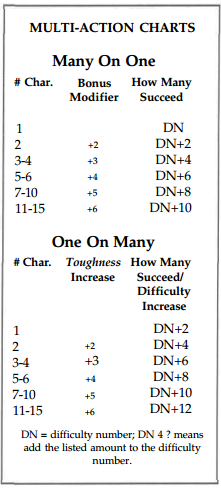
Charts, part 4
When a group is performing many-on-one , you only roll for one of the characters in the group, and the number of other people performing the action add a modifier to the roll. The result will determine how many of the people in the group succeeded.
quote:
Four shocktroopers are trying to leap a pit which has a difficulty number of 10. They have jumping at 9. The gamemaster rolls a 14 for a bonus of one, increased to four because of the multi-action bonus modifier. They generate a total of 13 (9 plus 1 plus 3). They have beaten the difficulty number by three, which is enough for two of them, but not quite enough for all four. Two shocktroopers make it across, while two fall screaming into the pit.
If you're performing one-on-many , you're trying to use one or more skills for multiple tasks at once, like shooting two foes in one round, or swinging across a chasm while firing a gun. You only roll once, and the result is applied to each skill/task in whatever order the player wants. However, each task you're trying to do gets an increased difficulty modifier.
quote:
The gamemaster tells Paul to use Quin's Dexterity for the swing, and fire combat for shooting. Swinging across the ravine has a difficulty of 8. The shocktroopers' dodge scores are 9. Paul rolls a bonus of 0; he decides to check the swing first, as he'd prefer not to be hanging over the chasm (or falling in). The modified difficulty of the swing is DN+2, or 10; his Dexterity of 11 is enough to cross the ravine. The first shot difficulty is DN+4, or 13. Quin's fire combat total is 14 and he hits the first shocktrooper. The third action (shooting the second shocktrooper) is DN+6 or 15. Quin misses the third shot.
There can be further complications if not everyone involved in a many-on-one doesn't have the same skill, or if getting everyone coordinated is an issue. This is because Torg is intended to be used for big-scale combats; there's an example in the book of 100 bad guys attacking, and some of the modules have combats with 200 or more people.
There are no mook rules. At all. Everyone gets full stats.
Oh, there's a shortcut...
quote:
What if 200 gamemaster characters are coordinating their efforts in a mystic ritual? Do you have to roll 200 Perception checks to come up with the correct answer? Well, yes; but if you are willing to live with an approximation, use the following
Now, I'm sure you're wondering how the GM is supposed to deal with cross-referencing all these numbers every five minutes across all these tables. Don't worry, the game thought of that.
quote:
The whole purpose of the chart is to give you something to guess with; pick a number you think is reasonable and go on with the game. Getting the numbers perfect is not the point. If you are off by a point or so, don't worry; being close counts in gamemastering.
And that finishes out the basic GMing chapter. We've been told how to use about a dozen or so tables, and we haven't gotten to skills or in-depth combat yet.
As I've said: crunchy as fuck. There's no assumption of eyeballing values here! We are modeling a ficitonal reality here, people.
Serious. Fucking. Business.
Again, I love Torg, but goddamn this system...
I will leave you with the actual last paragraphs of the chapter, though, because they're pretty good for a laugh.
quote:
The rules are a framework upon which you and your friends build stories set in the dynamic world of Torg. As with most frameworks, the rules work best when they show the least, and when they can bend under stress. If you need to bend the rules to keep a story flowing with a nice dramatic beat, do so. Keeping to the letter of the rules is almost certainly counterproductive.
We wrote the rules so you could play a game in a unique setting, not so we could dictate exactly how you should use that setting. So go have fun.
That's a rule.
NEXT TIME : Skills, cards, and human interaction!
Interactions, violent and otherwise
Original SA post The storm has a name... - Let's Read TORG
Part 4: Interactions, violent and otherwise
This post is going to cover a couple of chapters of the GM's section, since they're all related.
We start with a full chapter on "Attributes and Skills", which is something you'd expect to be in the player's section but whatever. Really there's very little about attributes, though, apart from the fact that every skill is tied to a specific attribute, and if you try to use a skill without any adds you just use the base stat value (assuming it's something you can do unskilled).
Before we go any further, there are two things I'd like to point out:
-
First, there are just shy of 50 skills, not counting skills that will be introduced in the world books. By the time Revised & Expanded comes out, this number will more than double.
-
Second, twelve of them have their own tables. Admittedly, those tables are all "here's the difficulty to do task X with this skill", but still. More tables.
Needless to say, Torg has a fairly granular skill list. There's a space vehicles skill, for instance, because that's a thing you'll be doing a lot. There are four separate skills for magic, and two for miracles (which is divine magic as opposed to wizard-style magic, and of course has completely different rules). Acrobatics , running , and long jump are all separate skills. And again, that's not including the skills that are cosm-specific or added in later books. It's not as bad as, say, BESM (where you had to buy every possible type of attack and defense separately), but given how few skill adds you start out with, you have to be pretty focused to be effective.
The skill list also has that old design mindset of making everything a character might want to do as its own skill, regardless of how rarely the skill would have to be rolled, or how unlikely it'd be to have to know a degree of success with said skill. For example, there's an artist skill that lets you paint/sculpt/compose/etc, but the only thing the skill determines is the quality of the created work, which has no mechanical use. Nothing about how much it'd cost to make, how much you could sell it for, or why you'd want to spend your hard-to-come-by skill adds in it. It's a point sink. It's just a skill for the sake of having a skill, because back in the 90's (and sadly, up to the 3.X era) you couldn't just let people do hobby/background stuff because of balance or some shit.
There are optional rules for narrowing skills down if you don't think the list is granular enough, or broadening the scope if you don't like having so many skills.
You can also get a "trademark item" for a skill by spending three possibilities; when you use your trademark item your effective skill increases by 2. This is not the current-RPG-style "you will always have this item" deal where the trademark item has a level of plot immunity, however.
quote:
The item cannot be replaced. If it is permanently lost or destroyed, the specialization is lost, and must be bought again for another such item. Only one "trademark" item may be specialized per skill, and if the character has a type specialization as well, the trademark must be of that type.
Anyway this chapter is a detailed run-down of how to use the skills that don't get chapters to themselves (like the combat or magic skills), but there are some... interesting quirks here.
There's a flight skill, which determines your ability to fly under your own power (flying a plane uses air vehicles ). Note that the only way you can fly is to 1) have a spell that lets you fly, 2) have a special power that allows you to fly, or 3) be of a non-human race with flight (which isn't possible in the core set). In other words, only two archetypes in the core set will get any use out of this skill, and even once things expand it's not going to get used that much.
There's rules to determine how long it took you to get somewhere with your running or climbing skill.
There's no pickpocket skill; instead we have prestidigitation , which is the ability to pick pockets.
And then there's the language skill.
Torg is, unsurprisingly, intended to be a globetrotting game. Which can cause a problem when you have people from different parts of the world on the same team, who probably wouldn't all be able to speak the same languages. There are a few ways that RPGs deal with this:
-
Not lose sleep over it; everyone understands everyone else and we move on (also known as the Feng Shui method).
-
Let people pick X languages they know during character creation, based on Intelligence or whatever.
-
The Torg Way.
The language skill doesn't determine how many languages you know, or how well you know the ones you do. It determines your ability to understand a language or dialect you, and I quote, do not speak and have never heard before . It's only difficulty 12 to recognize a completely foreign language, and the quality of the success determines how much of the language you just happen to know. A "minimal" success (the best you can get unskilled) lets you communicate using pigdin "slowly and loudly" methods, whereas a "good" or better success gives you complete understanding of the language.
So let's say I'm Joe American, skilled in languages at 11 (slightly-above-average Intelligence and one add) and I find myself talking to a Chinese speaker for the first time in my life. I make a skill roll, and if I generate a bonus value of +1 or better (a roll of 13+) then that's a minimal success and I can roughly understand what he's saying and can get basic ideas across. If I get a good success (which means beating the difficulty by 3, which means a final total of 15, which will require a roll of 16+) then I magically know Chinese. That's a 25% chance to just happen to speak a completely foreign language the first time I encounter it. If it's a similar language base to mine (such as Spanish to French) then it's easier.
No, I have no idea why they did it that way.
The next chapter is "Using the Drama Deck". This is more GM advice on how to expand on the things the card will tell you (like what it means when the villains get an Up result) and work it into the overall story, both mechanically and narratively.
One new thing here is Dramatic Skill Resolution , which is for those moments where you want to expand the resolution of an important action to more than just the result of one single skill roll. This is for things like trying to beat a timer or reach someone before they accomplish their own task, and it uses the middle row of the Drama Deck cards.
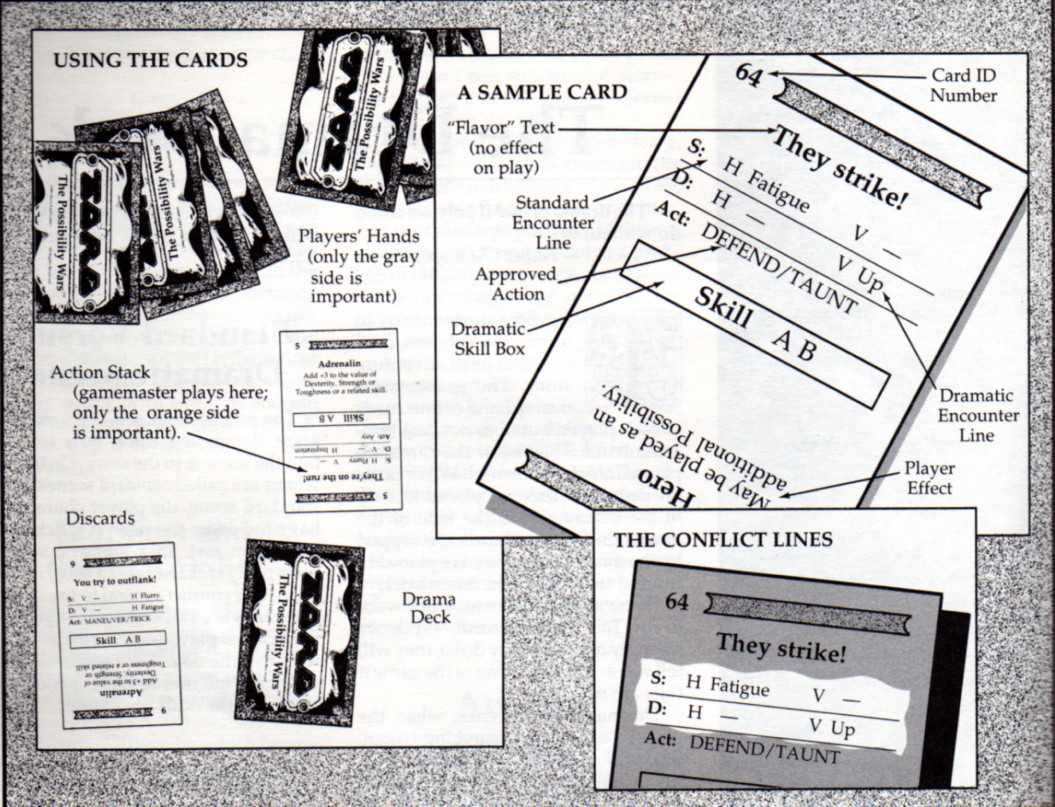
as seen here
When you're doing a dramatic skill resolution, you break the single use of a skill (like science to shut down a missile launch console) down into a maximum of four separate steps labeled A, B, C, and D, and assign a single difficulty for the overall challenge. You can assign one task to more than one letter.
Let's take the "disarm the launch console" example. I could say that step A is figuring out the password, step B is finding the launch control part of the software, step C is disarming the missile warhead, and step D is cancelling the launch. I could also say that getting into the system is both steps A and B if I wanted, but let's stay with the four-step setup and say that the difficulty is 10.
A character can only attempt to do one step per round, and can only perform steps that are showing on the top card of the Action Stack (i.e., the card that is currently being used for initiative). Not only that, but steps have to be performed in order. You can't disarm the warhead until after you get into the system. On the plus side, if the card shows more than one sequential step, you can try to multi-action your way through them in one round.
As cards get flipped, you can run into setbacks. Drawing a "possible setback" moves you back one step ("oops, looks like the computer locked you out of the system"), while a "complication" card increases the difficulty of the remaining steps by 1.
If you fail a skill roll during a challenge, then there's no problem beyond wasted time...unless a "critical problem" card is in play. If you fail with that card in play, you have two options: either start over from step A ("dammit, this must be the wrong login. Now I gotta start again"), or start using a different skill ("The computer's locked up hard, but I think I can get under the controls and rewire things").
If the player can't complete all the steps before whatever timer he's trying to beat runs out, he can attempt a Last Ditch Effort succeed; he attempts to perform all the remaining steps with a One-On-Many skill use with +4 to the difficulty.
Now, that's all well and good, but the problem is that you're at the mercy of the card flips for determining what steps you can try to accomplish. Which means it can be a little tricky for the GM to work out how much time to give the players.
quote:
To have a good chance of having the sequence A,B,C, and D appear in order requires 14 cards to be flipped if the character is going do the steps one at a time, or about 10 cards if the character is skilled enough to attempt two when the opportunity presents itself. If your characters have high skill levels (larger than the difficulty number), good cards, and no other pressing business, five flips is fine; otherwise we recommend giving them seven to 10 flips before disaster strikes.
There is one card I forgot to mention before, and that's the Glory card. Playing a Glory card actually requires you to roll a 60 or more on an action that has a direct important impact on the scene. If you manage to pull that off, then every character gets an additional 3 possibilities at the end of the adventure. There's also another effect, but I'll get to that later.
The next chapter is about Character Interaction, which is an expansion of the charm, persuasion, and intimidation skills that already had a bunch of text back in the player's chapter.
Charm has the most mechanics, because it has the most conditions (charming someone "requires five minutes at the minimum", by the way). Ultimately, charm is used to move people's attitudes up the Interaction Results Table . You roll against the target's willpower (which is a skill, based off Mind ), and if you succeed their attitude towards you improves a bit. If you do well, you can even get a permanent effect out of it. If you fail, then you can't charm them anymore that scene unless you attempt to press the issue.
If you press things and succeed, it's a normal success. If you fail, though, then the target's attitude drops one step.
Persuasion is also a roll against Willpower , and is more about getting people to do what you want rather than making them like you. Again, there's a chart you move up and down to determine the target's overall reaction. You can also use it for haggling.
quote:
Haggling takes place in alternating rounds, usually using the drama deck to determine initiative and advantages.
quote:
Example: The usual market price for a stereo is 250 dollars. This measure has a value of 12. If the offer was 101-250 dollars (value of 11-12), the merchant's attitude would be neutral. If the offer was 61-100 dollars, the merchant would be hostile, at 41-60 he would be enemy; the offer could not be less than 41. If the offer was 251+ dollars, the merchant would be friendly.
Yeah, in case you were wondering why I'm rushing through these sections? That's why. These chapters are crunchy as hell, and it's not even entertaining crunch. On the plus side, there's a lot of examples, but you have to ask why the hell you need this level of complication to use a simple social skill.
The only social skill that doesn't need a lot of space is intimidation , and that's because it really only has two uses: to awe someone to get them to freeze and miss an action in combat, or to interrogate someone, which is like persuasion but meaner.
But enough about talking to people! It's time for the "Combat and Chases" chapter!
And again, this is mostly a rehashing of the player's chapter on combat, only with more detail and a few more rules that the GM is supposed to be the custodian of, like range modifiers. Remember, the player just rolls a result on his skill and the GM is expected to add all the modifiers and determine the result.
Just as a refresher, there's nine possible actions you can take during your turn, and you get one action per turn:
-
Attack, where you try to inflict damage on someone.
-
Defend, where you spend the whole round doing nothing but improving your defense value.
-
Intimidate, which can put the "unskilled", "stymied" or "setback" effects on people.
-
Maneuver, which can put the "unskilled", "stymied" or "fatigued" effects on people.
-
Movement, which is getting from one place to another. You can move further with skills.
-
Simple Actions, like talking or loading a gun.
-
Taunt, which can put the "unskilled", "stymied" or "setback" effects on people.
-
Trick, which can put the "unskilled", "stymied" or "setback" effects on people.
-
Test of Wills, which can put the "unskilled", "stymied" or "setback" effects on people.
You'll notice that some of these actions look a little repetitious. That's because they're all basically the same skill; the only differences is what attribute they use, what skill you roll against, and which column of the Interaction Results table you use. Really, that's it. The only difference between taunt and trick in combat is that the first is based off Charisma and is resisted with the taunt skill, whereas the second is based off Mind and is resisted with test .
I feel like this is an attempt to solve the old "the guy with Str 18 and Cha 9 is less intimidating than the Str 9/Cha 18 guy" problem, but it's probably the dumbest way to go about it.
We also get a rundown of the various "effects" that can come up in combat, either through the Drama Deck or through skill use:
-
Unskilled: the character is considered unskilled in everything; he cannot use skills that can't be used unskilled, and loses his rerolls on 20s.
-
Stymied: you lose your first reroll-and-add, regardless of where it'd come from.
-
Setback: Something narrative and bad happens. Maybe the other side gets a bonus or something.
-
Break: This is NPC-only; the bad guys will attempt to flee or surrender on their next action if they've taken any damage this fight
and
don't damage the PCs by the end of the round.
-
Up: You get a free reroll-and-add on top of whatever ones you'd get through 10s, 20s, cards, or Possibilities.
-
Fatigued: You take 2 shock damage at the end of your turn.
-
Confused: This only affects PCs, and prevents them from playing cards from their pools.
There are a few things here that I don't think we covered before, like aiming (+3 attack value for each round you aim) or called shots (-8 to the final value of the attack, but +4 damage value), but ultimately they boil down to "take -X to attack to get +Y to something else".
There's also a little more about armor; specifically how armor increases Toughness , but only up to a certain point (bolding mine):
quote:
Armor absorbs much of the punishment meant for characters. Armor increases the character's Toughness for purposes of resisting damage, up to a maximum value as listed in the equipment section (Gamemaster Chapter Twelve). The amount of increase is called the armor add. The maximum value is necessary for realism, to prevent wrapping a battleship in leather to make it tougher, when the leather would be completely ineffective against the attack forms against which a battleship is armored.
 That's some grogs.txt shit right there.
That's some grogs.txt shit right there.
Moving on, we learn of the two types of surprise: complete (where the attacked party wasn't expecting it at all) and normal (where the attacked party was expecting something, but didn't know what or from where). Complete surprise lets the attackers play two cards into their hands before combat, normal only gets you one.
There's also some rules for movement (base movement is 10 meters/round) and explosives (they always hit if you're in the blast radius) before we close out with the Chase rules. Basically, when you're chasing someone, you need two totals.
First, each side rolls their appropriate skills (like
The second total is used to determine how far everyone's going in the round. You take bonus number of the first roll and add it to your movement value, and then use that total on the Push Results Table to determine how far you moved this round. Interestingly for a high-action game, there's more rules for haggling than there are for car chases.
Okay, I know that was rushed. I did that for two reasons. First, I don't think anyone's paying attention to the preliminary rules chapters because you only care about the setting stuff. Second, it's because the rules, while complicated, aren't that interesting.
Really, everything in the skill and combat chapters more or less boils down to "roll this skill, add a number, and look it up on one of the dozen GM tables". It's just dull, in the way that only something needlessly complex can be dull.
But look at the bright side! Next post will be about possibilities, axioms, world laws, realms, cosms, and High Lords! You know, the part you've all been waiting for!
NEXT TIME : The metaphysics of the multiverse! Narrative physics! More useless numbers!
Metaversal metaphysics
Original SA post The storm has a name... - Let's Read TORG
Part 5: Metaversal metaphysics
Okay, now it's time to get to the interesting stuff: how the Torg mulitverse works and how realities interact. (spoiler: confusingly and violently )
This post is going to cover the next two chapters ("The Possibility Wars and the High Lords" and "Everlaws and Axioms") because they're full of interconnected ideas. Get your psyduck emotes ready.
--
Every distinct reality is referred to as a cosm , and the Torg multiverse is referred to as the cosmverse . Under normal circumstances, cosms are all physically unconnected from each other with no way for people to move between them. Some cosms may be nearly identical, while others are completely unique. It's actually possible for two separate cosms to have completely different physical laws.
That was the multiverse for eons; each cosm evolving and changing by the actions of its inhabitants, and in turn shaping the people within it. But inevitably, someone had to throw the whole system out of whack.
Nobody knows who the first being was to discover other cosms beyond his or her own, but what is known is that this person created the first maelstrom bridge to travel between realities.
A maelstrom bridge is, well, a bridge created between two realities through a rip in space. People can walk back and forth over this bridge from one cosm to another. Picture a huge tower that drops out of a hole in space onto your world.
The discovery of the maelstrom bridge led to the discovery of the bridge's side-effect: reality storms . It's a multiversal rule that two realities can't occupy the same space at the same time. When the first bridge was created and activated, the two realities began clashing the instant the connection was made. Violent storms destroyed the bridge and everything in the surrounding area as the two cosms battled, and the expenditure of possibility energy from both cosms was enormous.
Of course, it wasn't long before someone learned how to harness that power for their own gain. Which brings us to the topic of Darkness Devices .
Nobody's really sure where the Darkness Devices came from; all that's known for certain is that they're not native to the cosms they've been discovered in. The popular theory is that they were created by an ancient entity known as The Nameless One as a means to destroy creation itself.
Every Darkness Device is unique, and all are seemingly intelligent (if not self-aware), and have one universal purpose: to destroy. To this end, they seek out those who can not only aid them in destruction, but are morally capable of spreading that destruction across realities. Darkness Devices allow their bonded master to create maelstrom bridges to other cosms, so they could suck those cosms dry of possibility energy. There are thousands of these possibility raiders , and they've destroyed countless worlds as they traveled across the multiverse.
Possibility raiders, also known as High Lords , have complete control over their cosms. Through their Darkness Devices, the High Lords were capable of altering cosms on a fundamental scale, stripping and altering the very possibilities that shaped that reality.
So how does one actually conquer another cosm?
As stated previously, you can't just drop a bridge into a new cosm and march troops into it. When the two realities meet, there's a huge storm that will destroy the bridge and everything in the immediate area on both ends. The trick to reality invasion is to create a realm , a sort of beachhead, in the cosm you're invading.
Prior to the full-scale invasion, a High Lord will drop a dimthread into the other cosm. Dimthreads are smaller maelstrom bridges that aren't intended to last for very long. It opens, drops off a few of the High Lord's possibility-rated agents, and is destroyed in a small reality storm. The agents are able to carry their own reality with them, and their primary mission is to plant artifacts called stelae .
Stelae have three very important functions. First off, when three stelae are set up in a triangle, they will form a boundary when a maelstrom bridge is dropped inside said triangle. This prevents the invaded reality from fighting back against the invading one, which "pours" down the bridge into the area defined by the stelae. Reality storms will still rage around the boundary, but the realm demarked by the stelae boundary will remain unaffected.
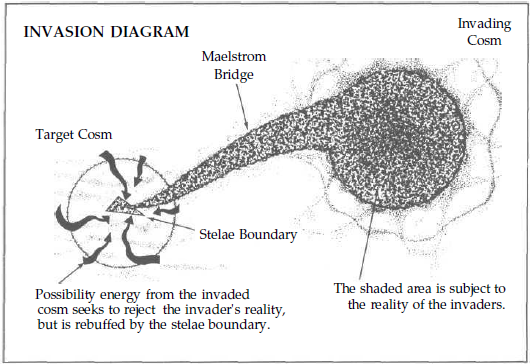
How reality invasions work
Second, stelae will absorb the possibility energy of those people inside the realm. Normally, possibility energy flows from a person to their cosm and back again, each supporting the other. But when that person is in an alien reality, the possibility energy that would normally flow to his home cosm will instead be siphoned from him by the stelae and stored in the High Lord's Darkness Device for his own use later.
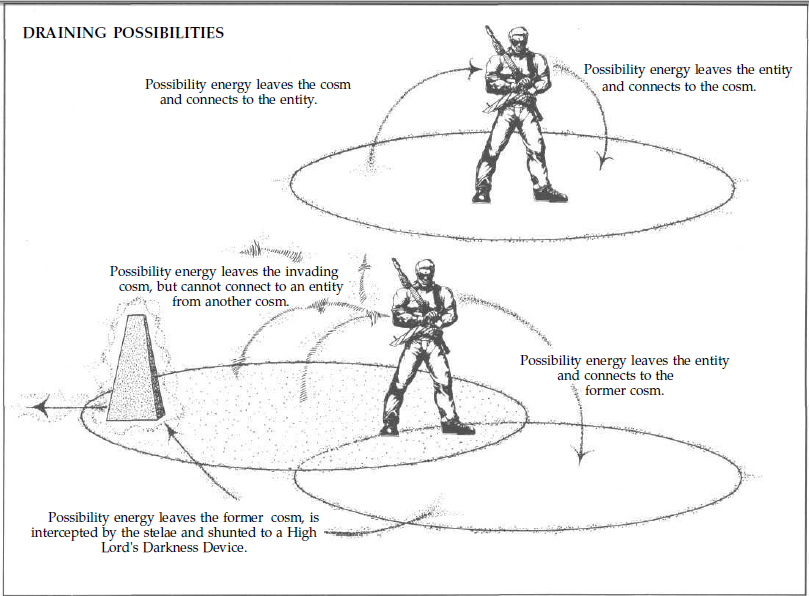
The circle of life, interrupted
(As an aside, one side-effect of this disruption of flow is that worlds conquered by High Lords invariably stagnate because the inhabitants can't feed possibilities to the cosm. Orrorsh, for example, has been run by the British Empire for about 300 years, and almost no social or technological advancement has taken place during this time. Terra (Dr. Mobius's homeworld), on the other hand, was never conquered by Mobius, so it's still advancing socially and technologically.)
Third, stelae can empower the nearby agents of a High Lord, shunting stolen possibility energy to them.
Once the realm is established, expanding it is simply a matter of planing more stelae outside the realm's boundary and pumping some energy into them. Stelae will always link up in triangles, and cannot connect to more than six other stelae at a time.
Ultimately, the High Lord's goal is to completely conquer the new cosm by spreading his own reality and supplanting the invaded reality with his own.
quote:
In order to capture an area, two conditions must be met: the unliving reality of the High Lord's cosm must be successfully introduced within the stelae boundaries, and living beings who live in that reality, or living beings who are prepared to accept that reality, must be present. For a standard stelae area, it is estimated that 25,000 beings must be from the invading reality, or must be natives ready to accept the new reality.
If the High Lord chooses a direct approach, armies or vast migrations of people from the invading cosm cross into the bounded realm as soon as the stelae are placed. Other High Lords are more devious, sending a greater number of agents to recruit natives prior to or just after the Bridge appears. These agents are often trained in rituals or processes for transforming converts, so they can help support the new reality.
Case in point: when Pope Malraux was preparing France for invasion, he sent his priests through months ahead of time to start converting people into the faithful of his particular brand of Catholicism. He managed to convert enough Core Earthers that, when he dropped his bridge (which appeared as a road of divine light) over Avignon, enough people in central France were prepped to accept Manga Verita's new reality. Baruk Kaah, on the other hand, just dropped a gigantic tree-bridge directly on Shae Stadium, sent thousands of troops swarming over, and called it a day.
As a High Lord expands the realm, new stelae-defined areas might not carry all of the invading reality through to the new part of the realm. Each zone (stelae-defined triangle) can be one of three types: pure, dominant, or mixed.
A pure zone contains one reality, period. Non-possibility rated people inside this type of zone will transform into inhabitants of the reality almost instantaneously as their possibilities are ripped away. Possibility-rated characters need to create reality bubbles around themselves to be able to use abilities not allowed by this reality.
In a dominant zone , there are two realities in conflict but one has the upper hand. People in mixed zones will still be changed to the dominant reality, but the process is much slower, taking weeks or even months as the steale drain their possibilities. People from other realities can use their abilities without needing a bubble, but there can be consequences if you're not careful.
Mixed zones are generally newly created zones. The two realities exist in a sort of equilibrium, but it's not a peaceful one. Mixed zones tend to be filled with reality storms as the two realities struggle for dominance. This struggle will also transform people into Storm Knights.
Speaking of normal people and transformation, this is an important bit of information to remember for when we get to the "How Do I Storm Knight" part of the review:
quote:
Eventually, an Ord in an alien pure or dominant area will be transformed into a close approximation of a "proper" denizen of that area. This transformation completely drains the character of possibility energy, as every iota of energy he possesses is used to survive the transformation. If a transformed character is later forced to transform again, he is destroyed.
Before we dive into the mechanics of how a reality operates, let's talk about Darkness Devices a bit more.
As stated, the ultimate goal of a Darkness Device is to destroy cosms, and to this end it will drain possibilities from a cosm and provide them to its High Lord.
Each Darkness Device is unique, and has its own "personality" and appearance. For example: Heketon, the Gaunt Man's Darkness Device, looks like a stone heart, whereas 3327's Darkness Device looks like a slim glossy-black laptop. Despite its appearance, a Darkness Device is immobile unless it choses to move. They're also damn near indestructible, with a Toughness of 200 (so -200 to your damage result if you try to attack it), and an effectively infinite amount of possibilities to spend. You could drop one in the sun and it wouldn't even scratch the paint. And yes, Darkness Devices have full stat blocks despite being effectively indestructible/literal plot devices.
On top of that, every Darkness Device has a few powers up its sleeve. These powers are common to all the Darkness Devices, and in addition each Device will have its own unique powers:
-
They can transfer possibilities to their High Lord or any willing subject, up to about four points an hour.
-
They can spend possibilities for their High Lord, getting around the "one point per action" rule.
-
They can communicate mentally with their High Lord or any being it has given possibility energy to.
-
Scan a stelae-bounded area for possibility-rated people, and "mark" them with a power called "soulstain" that marks these people for the High Lord and his minions.
-
Create stelae from scratch.
-
Reverse the High Lord's aging (or the aging of someone of his choosing) for three years.
-
Transfer itself to somewhere else in the realm or cosm.
-
Adjust the axioms of the realm or cosm, moving them up or down as desired (although this takes a while). We'll talk about the implications of this in a bit.
-
Increase the High Lord's stats based on how many realities he has conquered (1 reality = up to 7 stat points or 13 skill adds).
-
The creation of gospog.
A Darkness Device can only be bound to one person at a time, and the only way to break that connection is to kill the High Lord (good luck), for the High Lord to be transformed in a reality storm (again, good luck because High Lords generally stay put in their pure zones), or for the Darkness Device itself to sever the connection if it looks like its current owner isn't cutting the mustard.
Gospog are a High Lord's renewable mook resource. They are mindless slaves specifically designed to kill people, and are barely alive in any traditional sense.
Gospog are created by planting special Darkness Device-created seeds in specially prepared "gospog fields". And by "specially prepared" I mean "a field of corpses". This field can be used five times, and each successive planting will generate fewer, but stronger, gospog. The first planting will generate 10,000 gospog that look like traditional zombies and aren't much of an individual threat (although with that many, they don't need to be). Each successive planting will produce fewer but more powerful gospog, and their appearance and abilites wil vary from realm to realm. The fifth and final planting will only ever produce a single gospog, but it will be ridiculously powerful.
The Gaunt Man has also gifted his fellow raiders with ravagons . Ravagons are the survivors of a burned-out reality conquered by the Gaunt Man ages ago. Ravagons are winged lizard-people with the unique ability to track beings through their possibility energy. They're very dangerous, but fortunately for the most part the designers seemed to forget they existed for most of the adventures in the game line.
(And yes, this is the order things are presented in the book. We go from Darkness Devices to gospog and ravagons with no real transition.)
For those High Lords who want more than to just destroy worlds or rule with an iron fist, the point of doing all this is to get enough energy to become the Torg, the godlike ruler of the multiverse. This was the Gaunt Man's ultimate goal, and the reason he assembled his team of possibility raiders. But now that the Gaunt Man is trapped in a dimensional pocket getting destroyed and reborn every five seconds, the title is up for grabs and each High Lord is scrambling to get there before the others.
--
So now we understand how High Lords operate and what the Darkness Devices are capable of, and the types of rules and laws they can break. But what are those rules and laws, exactly?
The most important laws are called Everlaws , and they are universal to every cosm. In fact, they determine how cosms work and interact.
quote:
The Everlaw of One states that only one possibility from a set of two or more contradictory possibilities can become a reality at one time. In other words, a world in which you are going to die and stay alive at the same time is not allowed. Either you live or you don't.
The Everlaw of Two states that the living and the unliving are linked by the rules of their cosm, and this link causes possibility energy to flow between the living and the unliving. The living may use the possibility energy to create and change their world. Possibility energy is only generated when the living and unliving interact through the "axioms" of that world.
Basically, the Everlaw of One means that you can't exist in two states (or realities) at the same time, and the Everlaw of Two means that people are linked to their cosms through the flow of possibility energy. The Everlaw of Two is the weaker of the two laws, and as such it can be circumvented by Darkness Devices; this is how they drain possibility energy.
There were two more Everlaws added by the time Revised & Expanded Edition came out:
The Everlaw of Three states that in addition to the living and unliving parts of every cosm, there is a third part created from (or by) the cosmic force Aperios (who was mentioned at the start of my first Torg post). This part seeks to protect each cosm by manifesting as artifacts called eternity shards .
The Everlaw of Four is...uh...
quote:
The existence of the Everlaw of Four is a matter of some dispute; some see its effects as being a part of the Everlaw of Two while others consider it a companion to the Everlaw of Three. In effect the Everlaw of Four does fit somewhere between the second and third Everlaws. It’s placed fourth as a matter of convenience; the Everlaw of One stipulates that there is one outcome for every event, the Everlaw of Two states there are two sides of reality (living and unliving) and the Everlaw of Three adds a third part to reality, eternity shards.
The Everlaw of Four states that there is a second effect of the Everlaw of Two, and two twice is four. Also, its effect is seen as being complimentary but weaker than the Everlaw of Three so it has to come after it in the numbering scheme, which it couldn’t do if its effects are part of the Everlaw of Two.
Where the Everlaw of Three creates objects imbued with possibility energy that can be used to inspire and empower a reality, the Everlaw of Four creates living beings imbued with possibility energy that serve this same purpose. It does this by strengthening the connection that the living being has to the Everlaw of Two, which allows the being to amass and store larger amounts of possibility energy than normal. With this excess of possibility energy the being can change and affect the world much more dramatically than a normal living being. The Everlaw of Four is what’s responsible for the existence of possibility-rated beings.
Everlaws have no mechanical use, and are only there to validate the reality interaction mechanics and stuff. But...who cares? Why do they feel the need to set up all these complex rules to validate their fiction? There's nothing wrong with just saying "okay, here's how the various cosms interact" and leave it at that. It's like they're afraid people won't buy into their world unless they can back everything up with "facts" and weird-ass laws.
Anyway. In addition to the Everlaws, each cosm is defined by its own individual axioms and world laws.
Axioms are the hard limits of what is currently possible in a cosm or realm. There are four axioms:
-
The
Magic
axiom determines the level and types of magic possible in the cosm.
-
The
Social
axiom determines the level of interaction and organization possible between the cosm's inhabitants.
-
The
Spiritual
axiom determines not only the types of religious metaphysical concepts available, but if miracles are possible.
-
The
Technology
axiom determines the highest level of scientific development possible.
Each axiom is rated from 0 (completely impossible) to 33 (transhuman perfection). The axiom values vary from cosm to cosm, and are always in effect. If someone tries to perform an action that is not supported by the local axioms, that creates a contradiction and the Everlaw of One kicks in. This can lead to devices and abilities not working at all, or complete transformation in the worst cases.
As an example, Core Earth has a social axiom of 21.
quote:
Pluralism, the balancing of many factions within a government and society, is possible. More inhabitants of a nation are enfranchised. Vast bureaucracies may be spawned to handle the increased social complexity.
The Living Land, however, has a social axiom of 7.
quote:
Village/agricultural organization possible. "Kings" are possible. The concept of land ownership is possible. Unfortunately, so is the concept of owning other intelligent beings. Semi-professional military and militia formed for common defense can exist. A combination sound/pictographic alphabet may be developed. Trade, epic poetry and sports are invented.
When the Living Land invaded, not only did Core Earth weaponry (tech axiom 23) just flat-out stop working in the Living Land (tech axiom 7), the military units sent in were unable to function because, when the troops entered the Living Land zones, the concepts of modern military structure stopped existing for them . It wasn't a case of them not being able to communicate with their immediate commander, they actually lost the ability to think "this guy is my military commander, representing a higher chain of command, and I'm supposed to listen to him."
Unfortunately, even though every reality has defined limits of how they fit into the axiom structure, the way the realms are presented doesn't always jive up with the numbers.
As the prime example of this problem, let's look at the Living Land. The cosm is basically "Jurrasic Park with lizard people" and has a tech axiom of 7. Not only that, but in the Living Land anything that is even remotely technological (such as, say, a lever or a rock for hittin' people) is forbidden by their race's main religion. Nunchucks are a tech 9 item, so they stop working in the Living Land. Whatever that means. Because while the game explains clearly that items above a reality's Tech axiom can't work, they don't clearly explain what that actually means in the game world itself. Do the chain links rot? Do people forget how the nunchucks work? As presented, the answer is "both".
Never mind that the Living Land's tech axiom is actually higher than the realm is described as having.
This is the tech axiom summary from the Living Land sourcebook:
quote:
The low Technological axiom of the Living Land makes only simple tools and weapons possible. Remember, the Tech axiom limits what a character can think of to solve a problem. A character from the Living Land with a high intelligence will be able to heal someone with primitive medicine, but could not perform brain surgery no matter what his skills, because thinking to that degree is simply not possible.
This is what's possible for a tech axiom 7 reality:
quote:
0 — No technology is possible.
2 — Fire making is invented. Small stone tools are possible.
3 — Advanced stone tool making possible. Animals may be domesticated and bred. Spears and clubs are state-of-the-art weapons. Armor made from animal products possible. Rafts and small river craft appear.
5 — Agriculture invented, but still practiced largely as a dietary supplement to hunting and gathering. Calendars based on easily visible phenomena maybe invented. The wheel or axled rollers first used for transportation. Fishing vessels (four or more beings, muscle powered)appear. Arithmetic may be invented.
7 — Metal is first smelted, alloys of softer metals appears. Potter's wheel appears, plow speeds agriculture. Glass, cloth, wine invented. Sea worthy ships are possible. Swords and daggers state of the art weapons. Bows are possible, but only with enough punch for small game. Oil lamps invented.
If anything, the Living Land should be tech axiom 2, maybe 3 tops to line up with all the fluff for the realm. Especially since metals in the Living Land decompse at an accelerated rate thanks to how reality works there.
A cosm's axioms can be changed by its inhabitants, although this is a slow process. For example, let's say we have a group of Core Earth scientists all working on some new technology. While they research and push the boundaries of knowledge, they're subconsciously spending possibilities and channeling them into the cosm itself. When they do enough research (and spend enough possibilities), the tech axiom will increase by one, and what is possible in the cosm will expand accordingly.
Unless you're a High Lord, in which case you can use the Darkness Device to alter a cosm's axioms at a much faster rate. This is what happened when Pope Malraux created the Cyberpapacy; the tech axiom there was originally around 7 or so (smelting metals and oil lamps were the highest "tech" possible"), but Malraux used his Darkness Device to crank it up to 26 (cybernetics) in a matter of weeks.
Where the axioms describe how a reality works, world laws are about how the reality operates within the structure of those limits.
Think of world laws as the "narrative physics" of a reality; they map out the overall tone and feel of the reality.
Some world laws are passive, meaning they're always in effect. One example is Nippon Tech's "Law of Profit", which states that the wealthier someone is, the less goods and services will cost them, whereas the poorer you are, the more things will cost. "The rich get richer" isn't just an economic theory, it's built into the fabric of that reality and has shaped the culture accordingly.
Other world laws are active, which means they have to be invoked by that reality's inhabitants. The prime example of an active law is the Nile Empire's "Law of Action", which lets the invoker spend two possibilities on a roll instead of just one like everybody else.
Every reality has three or four world laws, although Core Earth didn't get any until about halfway through the game line because I guess the designers forgot or something. Kind of like how they forgot that technically all of Core Earth should be a pure zone and thus make life incredibly difficult for characters from other realities.
I'll get more into axioms and world laws once I start talking about the individual cosms, but for now you've got the basics.
Now, the whole game is based around the idea of what happens when two realities with different axioms clash, right? What happens is you get a reality storm . These occur mostly around the borders of realms, but it's possible for them to happen inside realms if someone tries something outside the axiom levels. They appear as powerful reality-warping thunderstorms with winds of up to 100 miles an hour, and represent the changing of axiom values; in fact they're the physical manifestation of transformation.
Oh, and if you're p-rated, then you can actually invoke a reality storm on someone in an attempt to forcibly alter their reality. That will come up more in the next chapter, but a very common way for PCs to defeat bad guys was for them to invoke storms, change the bad guy to a reality where none of his powers or gear work, then proceed to beat him down. Exciting!
It's important to point out that some parts of a reality are so infused with the concepts of that reality, they actually can't be transformed. These are called hardpoints , and are like oases in the sea of a realm. Core Earth has a number of hardpoints, such as the Statue of Liberty and the Eiffel Tower. These objects project a bubble of Core Earth's reality out a number of miles, allowing Core Earth's axioms and world laws to function without interference. As a result, some major Core Earth cities such as Nee York or Paris have not changed despite being in enemy territory. Hardpoints can be moved if they're small enough, but it's not a good idea to do so because this causes their power to drain.
And now the book crashes headlong into another new concept (have I mentioned the book isn't organized very well?). I mentioned contradictions before; they're what happen when you try to use an item or ability not supported by local axioms.
When you use something you're not supposed to, you have to make a contradiction check . If whatever you're doing requires a roll, then that's effectively the check; otherwise you have to make a separate roll just to see if a contradiction happens. Depending on the type of contradiction and result of the roll, you can disconnect from your home reality.
The difficulty of the roll depends on the type of contradiction. There are three types:
A zero-case contradiction is what happens when the axiom level of your tool is below that of the reality you're in and the character using it. In this case, there's no check because the contradiction is so minor. So if someone from Core Earth (tech 23) brings a shortsword (tech 8) from Asyle to the Nile Empire (tech 24), that won't cause a contradiction because the technology level of the sword is possible in the Empire and Core Earth, despite the fact that this particular sword came from another reality altogether.
A one-case contradiction happens when the axioms of the tool are above than either the user or the realm, but not both. So a knight from Aysle (tech 15) is in Core Earth and tries to fire an assault rifle (tech 21). The rifle is allowed in Core Earth's axioms but not Asyle's so that's a one-case. If this happens, a roll of 1 means he disconnects.
A four-case contradiction is when the item's axioms are above both the user and the local axioms. This is someone from the Living Land trying to use an assault rifle in Asyle. In this case, you disconnect on a roll of 1-4.
Note that it doesn't matter how irrelevant the roll or item is; you still run a chance of disconnecting. If you're from Asyle, are currently in Core Earth, and are wearing blue jeans, then you might actually disconnect on a find roll because technically you're creating a one-case contradiction. With your pants.
Now, one question I know not a single one of you is thinking is, "but what happens if I throw something like a grenade somewhere grenades shouldn't be?" But don't worry; instead of not caring or saying "it holds on to it's axioms for a few seconds", it creates a long-range contradiction . Doing so can actually cause you shock damage if you roll low enough, but at least it won't make you disconnect.
So what does "disconnecting" mean? Well, it means that you're temporarily between two realities but not part of either. The multiple sets of axioms aren't allowed under the Everlaw of One, so it tries to settle you into one reality or the other. When you're disconnected, you can't create contradictions, collect Possibilities, or do anything that violates local axioms.
In case you're wondering what this looks like in-game, keep on wondering. They never describe disconnection in a non-mechanical sense, so I don't know if you just look out of it, or if there's any kinds of special effects where you kind of flicker between appearances or what.
What you can do is try to reconnect by rolling your reality skill. Doing so requires you to still have the item that cause the disconnection in the first place if you're not in your home reality. Attempting to reconnect just needs you to make the skill roll, with the difficulty number depending on both your original cosm and the cosm that caused the contradiction; the further apart the realities are, the harder it is to reconnect. If you're from the Cyberpapacy and disconnect in Core Earth, the reconnection difficulty is only 9, but if he was in the Living Land then it's 21.
It's important to note that you don't have to try to reconnect right away, but until you do reconnect you're cut off from a lot of things (such as gaining Possibilities/XP) so it's not something you want to put off.
Disconnecting sucks, but if it happens around or near a reality storm, then you run the risk of transformation . When this happens, you physically and mentally transform to a new reality; you lose all your Possibilities, your personal axioms change, you get a new set of world laws, and all your abilities and gear change to match your new axioms. The rule for transformation is living to living, unliving to unliving , which means that living things can't turn into inorganic things and vice versa. Transforming to Cyberpapal reality won't cause you to spontaneously grow cyberware (despite this happening in the game fluff), and a guy with a cyberleg transforming to Asyle doesn't grow his leg back (it'll probably change into a pegleg). We'll talk more about this next chapter.
Obviously, contradictions can be a huge pain in the ass. Having all kinds of bad shit happen to you because you rolled a 1 crossing the street can slow a game down. To avoid this happening, you can spend a Possibility to create a reality bubble around yourself. For 15 minutes, the only axioms that matter are your own personal ones, and you only create contradictions if you're using something above your own axioms.
And smash cut the end of the chapter.
--
So. Confused yet?
I hate to keep repeating myself, but god damn this book is organized terribly. Part of the reason it's hard to wrap your head around the game concepts is because they're not laid out in a logical order. The game talks about High Lords and Darkness Devices and reality invasion before it talks about the basic shit like axioms, then tangents into monster stat blocks. They keep describing the exceptions before they get to the rules.
They also spend way too much time trying to validate setting concepts. They didn't need Everlaws at all,
all they needed to say was "the axioms of two realities can't mix, and you can only be under one set at a
time". That's it. Everything else flows from that. You don't need this big metaphysic backing for it
because it doesn't matter . If I'm going to play your game, odds are I've bought into your setting already. But they have this strange need to explain why this is the case despite it not mattering.
And throughout the discussion of contradictions and transformation they keep bringing up the Everlaws. Contradiction doesn't happen because you did something not supported by local reality, it's because the Everlaw of One is trying to do a thing but you can use the Everlaw of Two to stop it by blah blah blah.
I mean, the Everlaw of Three only exists to give an in-setting reason why eternity shards exist, despite nobody apparently caring in the howevermany years it was before they added it to the rules.
It's like if you wanted to play Pokemon, and the first hour of the game was Professor Oak explains how evolution and/or genetic engineering made all these strange creatures that replaced "normal" animals and how they've affected society throughout history. That's not what I'm here for. I'm not here for a lecture, I'm here to play a cyberpunk who goes to the Forgotten Realms to punch ancient-Egyptian-themed bad guys in the face.
I feel like one of the big problems with the game is that the designers were worried their concepts wouldn't stand up on their own, so they had to shore them up to the point where the supports overshadow the thing they're supporting. (The other is one-way design, but I'll talk about that more later.)
NEXT TIME: Storm Knighting 101!
Storm Knighting 101
Original SA post The storm has a name... - Let's Read TORG
Part 6: Storm Knighting 101
Now we finally get to what the PCs are supposed to be doing in the game. You'd think that would have come first (or that it'd be in the players' section), but why be surprised at this point?
On the plus side, this is a short chapter so it's a nice little break in the
 ness.
ness.
When a invading cosm touches down and starts spreading its axioms through the new world, most people are transformed into the new reality. These are Ords; people who have only one Possibility point.
Some folks, however, experience what's called a "moment of crisis" where they unconciously try to hold on to their original axioms. This moment happens when the person in question has to make a strong moral choice for good or evil, and causes the Everlaw of Two to strengthen the link between the person and their reality. When this happens, the person in question gains more Possibility energy and immediate adds in the reality skill.
This is where PCs come from.
High Lords refer to possibility-rated people as stormers , due to how they're created in the wake of reality storms. However, major setting
Before the invasion, the High Lords knew that Earth was going to create more stormers than other worlds; the early estimate was that 1 in 100,000 would "transcend", and while a number of them could be convinced or manipulated into serving the invaders, more would probably fight back. But when the invasion happened, more stormers than even the invaders expected started appearing. What's more, due to Core Earth's high amount of Possibilities, more Knights are appearing the longer the war goes on.
To add insult to injuries, it turns out that Core Earth has a high affinity for other realities. As a result, Knights from the invading realities have managed to find their way to Core Earth to aid in the fight; even cosms where Knights have been effectively stamped out more and more heroes are appearing to fight back against the invaders.
But how do you do that, exactly?
Technically speaking, to take back territory from the Possibility Raiders you need to uproot stelae to destroy the barriers keeping Core Earth's reality out of the realm. But, of course, it's not that simple.
As stated previously, all Ords have only one point of Possibility energy, which is spent to survive the transformation to the new reality, and the Darkness Devices prevent these people from refreshing that energy. If you uproot a stelae, and allow Core Earth's reality to retake the bounded area, these people will be transformed back to Core Earth's reality. But without any possibility energy to power the transformation back, the Everlaw of One fuels the transformation with their life energy instead.
In other words, destroying a stelae boundary will kill every single Ord in that region. Not exactly what you'd call a "victory".
Now, if you could somehow give the Ords a possibility point back, then they could survive the second transformation. Which begs the question: how do you do that?
Technically a Darkness Device could do this quite easily, but as you can imagine the High Lords aren't in a real hurry to empower their six-or-seven-digits worth of believers/hostages.
Storm Knights can re-empower the people by giving them hope.
quote:
To reclaim the people the characters need to re-imbue them with a small amount of possibility energy before
destroying the stelae. High Lords can do this through a Darkness Device, which the Storm Knights do not have.
But they do have legends.
Stories, myths and legends are ways of framing events from a particular point of view, a point of view with its own beliefs and visions of reality. Certain stories can even serve as a spark for the Everlaw of Two, a slender thread of idea which the Law strengthens to reconnect a person with her former reality. Once reconnected by this tenuous thread, and given a tiny bit of energy by the Storm Knights to initiate the living/unliving link, the person is slowly refilled with possibility energy. The process may take a few days, or a few weeks.
And how do you do this? By being fucking awesome .
Remember a while back when I talked about the Glory drama card? That's the one you can only play if you roll a 60 or higher on a dramatically appropriate action. When you play this card, what you're doing is fixing that action in the minds of the people and focusing the magnitude of how awesome you are. Once you do this, you can spread the legend among the people. Yes, you actually have to tell people what you did, even if everone saw it.
Torg actually mechanically supports "let me tell you about my character".
Spreading the legend requires a character to be designated the "storyteller" for the legend. This person must then spend a Possibility (because god forbid you don't pay a Possibility for something) and make a persuasion roll against the person in the audience with the highest Mind score. Succeeding at this roll means that you've convinced that key person of how cool and important you are (and can retell this story elsewhere in the region); failure means you wasted the Glory card (and associated Awesome Thing You Did) and have to start over again from scratch.
Once you've done all that, a story seed will start to spread for every time you successfully told the story. This takes a while as the legend works its way from person to person. How long does it take? Well, that's kind of random. When you're finally pulling the stelae, one person rolls for every story seed in play in the region. This roll doesn't get rerolls with Possibilities or cards, but still rerolls on 10s and 20s. You then look at the Transformation Table and find the next highest row to the amount of time that passed from when you first told the story.
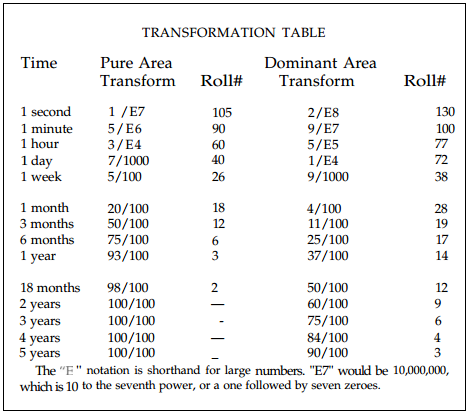
This table was in the last chapter, in case you need to know how long it takes for everyone in a zone to transform.
If any of the rolled dice beat the "Roll #" in the dominant area column of the table, then the story took and you can finish uprooting the stelae without committing mass murder. So if I told the story 4 times in a region, and it's been 9 months since the first time was told, I need a total of 14 on at least one of my four dice to be able to keep everyone from exploding.
Now, if you successfully plant three different story seeds in the same region, then you get to use the Roll # for the Pure column instead, because you've managed to neutralize all three boundary stelae.
So there you go. Tell people you're awesome enough times and you can save the world, right?
Wrong. It's a bit more complicated than that, for a couple of reasons.
First off, stelae are extensions of the Darkness Devices, and as a result the Device (and its High Lord) know when someone's fucking with them. Darkness Devices are capable of informing all bad guys in the immediate area what's going on, so once you start to uproot the thing you can damn well bet that you're going to get a lot of company real quick.
Second, you can't tell that something's a stelae just by looking at it. Every realm's stelae are different, and the High Lords like to keep them well guarded or hide them in plain sight. Dr. Mobius' stelae look like jackal-headed idols, so he puts jackal-headed idols on every street corner, building, and outpost. In Nippon Tech, stelae in the cities are functioning ATMs, and in the country they're telephone exchange boxes.
Third, the weaking the barriers between worlds creates reality storms as the axioms duke it out. This can cause even possibility-rated characters to transform. The storm attacks everyone in the area, and has an effective skill of 20. Being attacked by a reality storm can drain your possibilities, and once those are gone it starts draining your reality skill adds. Once you're out of adds, you immediately transform.
It's also possible to invoke a reality storm against another p-rated character; in this case both sides roll their reality skills against each other (with a +3 bonus if you're in your home cosm). Invoked storms actually seal the two characters off from the rest of the world, which means that nobody can interfere, aid, or otherwise help out the people in the invoked storm.
So you're in a reality storm. You've got two characters, or the storm and one character, rolling off. Each side rolls, and whoever has the higher number wins that round. You then look up how much they won by on the Storm Results Table to see what happens.
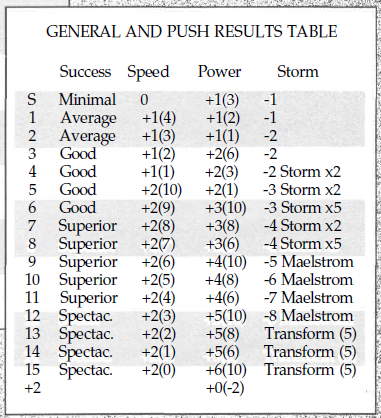
The table is, of course, part of another table
The number is how many Possibilities are drained by the loser. The winner doesn't get these points, they're just lost. The other results have other effects:
-
Storm Multiplier
causes the storm to expand and gain in strength. The stronger the storm, the more carnage it causes.
-
Maelstrom
means that the storm stops growing (ignore all "strom multiplier" results until the end of the conflict) but is breaking down the participant's axioms and rebuilding them from scratch; when this comes up the only way to end the storm is for one person to be drained of all Possibilities. On top of that, for the rest of the contest the round's winner may chose to gain a number of Possibilities equal to the table's result instead of having the other person lose them.
-
Transformation
means that, well, the loser is transformed. Said character immediately loses all their Possibilities, up to five of which are gained by the winner. The loser then makes a contradiction check; on a 1 he transforms to the cosm that defeated him.
Now, I'm sure at least one of you is thinking, "wait: if I can just invoke a reality storm on any p-rated character, what's to stop me from trying to do that to a High Lord?" And the answer, surpisingly, is not much. It's entirely possible to invoke a storm against a High Lord (assuming you can get to him in the first place), except that High Lords have an insane amount of Possibility points stored in their Darkness Devices to mitigate losses. Now, that makes it sound like you couldn't win...BUT! If you get a "maelstrom" result, the High Lord will actually be cut off from their Darkness Device. If the High Lord loses, he'd have to re-bond himself with his Darkness Device...and that's assuming the Device will take him back after losing. Most of the Devices have a few "back up" candidates they keep an eye on in case their owners start to lose or just piss off the Device enough. No honor among thieves, after all.
The only piece of the puzzle we're still missing is how you're supposed to actually find a stelae in the first place. To do that, you need an eternity shard .
Eternity shards are items powered by the Everlaw of Three with a bit of power of Apeiros, the creator of the cosmverse. Eternity shards are legendary items of a cosm (such as Excalibur, or the Ark of the Covenant), and always had a red-and-blue marbled appearance. Each shard is unique, and p-rated characters can bond to them and tap them for power.
The first use of a shard is that it's a Possibility battery that can contain dozens, if not hundreds, of Possibilities. You can make a reality roll against the shard's "tapping difficulty", and succeeding will get you one to five Possibilities depending on how well you succeeded. The only thing is, they have to be used right away. On the plus side, these points get around the "one Possibility per roll" limitation.
The second use of a shard is accessing its group powers . Every shard has a few of these, and they're pretty damn powerful. Buying a group power simply requires everyone in the group to spend a certain number Possibilities between them. Once that's done (it doesn't need to be all at once), then anyone in the group can access the power by having everyone chip in to pay the Possibility cost.
For example, one common group power is stelae sense , which lets you detect and identify stelae. It has a group cost of 10, so everyone in the group has to pay 10 points total between everyone to unlock the power. Once they do that, then they can use the power by spending the Use Cost of 5 Possibilities between them.
Of course, despite paying a ton of XP for these powers, you still have to make rolls. One person has to be the "lead character", and everyone else are the "supporters". First, each supporter rolls reality against the power's Coordination Difficulty . The number of people who succeed is used as a bonus number of the lead character's roll. If nobody succeed, then the power can't be used.
Then the lead character rolls reality , adds the bonus from the supporting characters, and tries to beat the power's difficulty. You do all that, the power goes off.
And what kinds of powers are there?
Well, there's self-explanatory ones like Create Hardpoint or Stelae Sense . There's Gate , which lets you create a teleporter. Herald lets you send a message to someone in another cosm...or, at least, to a point within 10km of someone. It's not that accurate. The most powerful is probably Send , which allows you to send the soul of a dying Storm Knight through time and space into a new body that's being...uh, "vacated".
So here's what you have to do to take back territory from the High Lords:
-
Get an eternity shard with the "stelae sense" power.
-
Pay the 10 Possibilities to unlock it.
-
Perform an act so awesome you can play a Glory card.
-
Tell people what you did and succeed at a skill roll.
-
Wait a month or so.
-
Spend 5 Possibilities to use stelae sense.
-
Have everyone make skill rolls.
-
Hope you roll high enough for the power to home in on the stelae.
-
Fight your way through whatever defensive forces are around the stelae.
-
Uproot the stelae, which is a dramatic skill resolution (which means the A-B-C-D card flipping).
-
Survive the reinforcements that show up once you start uprooting it.
-
Make the roll to see if the story took.
-
Survive the ensuing reality storm.
-
Defeat or escape from the bad guys who survived the storm.
Easy!

Don't worry, next chapter we're back to the really complex shit.
NEXT TIME: Getting your mojo working!
It's magic, I ain't gotta explain shit.
Original SA post The storm has a name... - Let's Read TORG
Part 7: It's magic, I
Okay. This is going to suck.
Magic. Oh lord, Torg magic.
Throughout the whole game line, there are seven main categories of player powers: magic, miracles, martial arts, pulp powers, cybernetics, psionics, and biotech. Martial arts are pretty much unique to Nippon Tech, and only Nile Empire characters can get access to pulp powers. Cybernetics can come from either the Cyberpapacy or Tharkold. Biotech and psionics will come from a cosm that was introduced later in the line, which I'm keeping secret for now.
Magic and miracles, however, are universal to pretty much every realm.
They're so universal, in fact, they each have their own axioms. And like anything tied to an axiom, there can be hard limits on what's available in a given realm. For the most part, magic and miracles are possible in every realm with a few exceptions. Nippon Tech has very low Magic and Spiritual axioms, and the Living Land has a Magic axiom of 0, meaning that no magic is possible there at all. And yes, magic and miracles are possible on Core Earth all of a sudden; the axioms support them, it's just that people didn't know that. Or something.
And just for the record, magic and miracles are two separate things. They have separate mechanics, so are referred to as magic and miracles in the text.
Let's start with magic.
Oh good christ Torg magic.
Casting spells in Torg is a fucking mess.
To start with, spells come in four different categories:
-
Alteration magic is about changing existing things.
-
Apportation magic is for moving things around.
-
Conjuration magic creates things.
-
Divination magic covers perception and interpretation.
Every magic spell in the game falls into at least one of these four categories, and some spells can fall under more than one type. So you could have a spell that conjures something (conjuration), then flings it at a target (apporation). The game describes these as the "verbs" of spells, and that's as good a description as any.
Each of these magic styles is a separate skill in the game. There's an alteration magic skill, an apportation magic skill, and so on. If you start the game as a caster, one of these is more than likely your tag skill, and you can buy the others with the skill adds you get during character creation.
The game then explains that a caster doesn't just make his spells up (spell creation rules will come later in the Aysle book), but that spells were created by other people ages ago and stored in grimoires . Yup, you need a spellbook.
quote:
To cast a spell from a grimoire requires only the skill necessary for the most important component of the effect. Secondary effects may be subsumed under the spell at the time of its design, but are not necessary to cast the spell. For example, altering a small sphere into a fireball is the most important element of a fireball spell; moving the fireball is secondary. The magician who designed the spell would have to take into account the problems of moving it (apportation) and accuracy (divination) as well as the initial alteration, but once designed and placed in a grimoire these effects are "built in"; the only skill the caster need furnish is alteration.
Now, that's a little more complex than it needs to be, but still manageable, right? I mean, even if a spell falls under more than one skill it looks like you only need the one to cast it, right?
Wrong.
There's a second factor to spells beyond the skill needed to cast it: arcane knowledges .
Remember how the skills were referred to as the "verbs" of the spell? Arcane knowledges are the nouns and modifiers. They determine what the spell will look like and what it can affect. When you make your character, you get 12 extra skill adds that can only be used to by knowledges and spells. That's right, arcane knowledges are technically skills, can't be used untrained, and cost just as much as normal skills to improve. However, unlike all the other skills in the game, arcane knowledges aren't based off a stat. You just use the flat skill ranks.
So what are the arcane knowledges? Glad you asked!
quote:
The Essences
Death
Life
Time
True Knowledge
The Principles
Darkness
Light
Magic
The Mixed Forces
Inanimate Forces
Living Forces
The Elements
Air
Earth
Fire
Metal
Plant
Water
The Seven Kindred
Aquatic
Avian
Earthly
Elemental
Enchanted
Entity
Folk
Theory Knowledges
Cast Time
Control
Duration
Range
Speed
State
-
First off, magic skills and knowledges work the same way regardless of what reality you're in. The "metaphysics" of magic are constant throughout the multiverse despite the fact that the laws of physics can change. Funny, that.
-
Folk are intelligent beings whose defining relationship is, and I quote, "with others of their kind, rather than with any of the elements or with magic". So basically intelligent races.
-
Living forces covers your attributes.
-
The theory knowledges do nothing in the core game. They're used for spell creation, which is in the Aysle book.
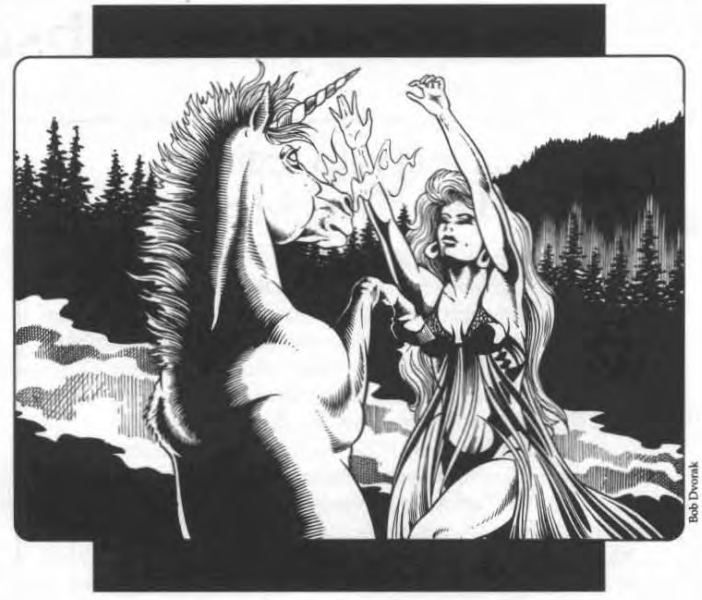
I don't what to know which knowledge this is.
All told, there are 24 arcane knowledges, and 4 magic skills. That's 28 skills you have to keep track of if you're a spellcaster.
Why? Because every spell has a skill and arcane knowledge, and if you don't have both at the right total level you can't cast the spell. So if a metal-moving spell is "apportation/metal 17", your apportation magic and metal skills need to total up to at least 17 or you can't cast the spell.
Oh, but we have a few things we still need to talk about before we actually hit learning how to cast spells. Because this is Torg, and god fucking forbid we have character abilities that don't have ridiculous mechanics to validate them.
Like the Principle of Definition , which states that a subject cannot be under the influence of more than one "active" spell with the same knowledge at a time, with "active" defined as any spell that's still got some duration left on it. When someone is under the influence of an ongoing spell, then is the target of a second spell, then the spells actually have to duke it out to see which one remains in effect. Each spell has a strength equal to its casters' magic skill, and the spells roll off against each other. Whichever spell gets the highest total sticks around. So if you're under the influence of a Strength spell (folk knowledge), you couldn't also be under the effect of an Understand Language spell because that's also based off the folk knowledge.
You can get around this with the idea of Synonymous Knowledges , which involves having multiple definitions of a single knowledge. If a fire mage had three definitions of "fire", he could keep three active fire spells running on himself at once. This is useful, and would have been more useful if they'd explain how you actually went about doing this. Apart from saying they have to be learned, there's no example of, say, what three different definitions of fire means in-character.
Anyway, a character starts with zero spells. You have to use those bonus 12 points you got for arcane knowledges and spells to buy new spells one-for-one, and later on you have to spend a Possibility to learn a new spell and put it in your grimoire.
Finally! Spellcasting! To cast a spell, you generate a total using the appropriate magic skill, and try to beat the difficulty of the spell. If you make it, the spell goes off.
Before you start going "wait, that's it? We had to go through all that for 'beat the spell's difficulty'?", hold on. This is Torg. Nothing is that simple.
Just because you successfully cast the spell doesn't automatically mean it actually goes off. Between the skill roll and the effect of the spell is the speedbump of backlash . Backlash is the "resistance" of the spell, and you have to check it regardless of whether or not you made the skill roll. Once you determine the success or failure of the you then take your skill total (or your Mind stat if you're casting a spell out of your grimoire, whichever's higher) and compare it to the spell's backlash value. If your total is less than the backlash, then you take the difference and apply it to the Damage Table to see how much you get hurt; unlike normal damage, the damage isn't reduced by Toughness. If you get knocked out or killed, then the spell doesn't go off even if you made the initial spellcasting roll.
Yes, it's possible to successfully cast a spell but not have it go off. Because balance or something.
Damage taken from backlash is actually mental damage, which is exactly the same as normal damage with two fun kickers:
1. When you're KO'd by mental damage, you lose the arcane knowledge used to cast the spell for 24 hours.
2. If suffer wounds from mental damage and go above "heavily wounded", you lose the spell's arcane knowledge and magic skill for 24 hours. On top of that , you can't be healed below "wounded" status until you get the skills back.
So if you manage to cast the spell and not blow your head off, the spell happens. The bonus generated in the initial casting roll is applied to part of the spell's effect. This varies from spell to spell and is listed in the spell's stat block.
Those of you whose eyes haven't glazed over yet will have noticed the "casting from the grimoire" bit up there. It's possible to actually cast spells on the fly, making up a whole new spell on the spot. The way you do this is by buying the Aysle sourcebook, because that's where the rules are.
Also mentioned but actually put off to that book are the focus item rules (casting a spell into an object) so I guess we'll worry about those later.
Some spells have to be cast impressed , which is a sort of Vancian pre-casting available at magic axiom 17 (Asyle's magic axiom is 18, and is the only cosm where this is possible). Spells that have to be cast impressed are "cast" in advance, generating a total and figuring backlash as normal. However, the spell's effect doesn't happen until the caster releases it. When you release the spell, you generate a new bonus number to determine the spell's effect(so you kind of have to cast it twice), but you don't have to check again for backlash and the spell goes off even if you fail the second roll. Not that it really matters, because only two spells in the core book have to be cast impressed: "conjured fireball" and "cleanse".
You can impress a number of spells equal to the sum of your conjuration magic adds and your state knowledge. On the plus side, impressed spells never fade unless you "clear" one out to make room for a different spell.
From there, we get almost a whole page about illusion magic.
quote:
Illusions are magical "cheats," ways of conjuring reality without expending the energy necessary to create the full reality. Illusions can run the gamut from fully illusory (merely a sensory impression of the object "conjured") to almost real (there is some reality conjured, but not the whole amount). Illusions "borrow" possibility energy from those around them who believe in the illusion, and thus become more real over time (the amount of possibility energy taken from a believer is minute — no energy is lost by those who believe). This effect is temporary, though — as soon as the belief ceases (either because the believers leave the area or because someone becomes convinced that the object is an illusion), the illusion vanishes as well.
Which is the trade-off; illusions are easier to cast, but have the slight disadvantage of winking out of existence if someone goes "wait, hold on..." But since there's only one illusion spell in the core book, again we can pretty much ignore this for now.
There's one last thing before we finally get to the actual spells, and that's The Primary Rule of Magic . It's a long-ass thing about how magic isn't technology and therefore doesn't follow the same rules and blah blah blah.
quote:
Magic is not physics, or chemistry, or biology. It is a distinct discipline with its own rules. Magic works by extending the will of the spellcaster, interweaving it with nature and coming up with a result. The primary rule of magic is a spell will have no positive effect without being willed by the caster; negative or non-effects are generally a result of insufficient control and will.
Thus magic and technology are at odds at a fundamental level. Technology works with natural laws, while magic intervenes in those laws. Each has its advantages and drawbacks.
Magic can accomplish spectacular feats beyond the possibility of even sophisticated technology, but is limited by the primary rule of magic. To those raised in a technological society, the very workings of magic make no sense. A magically propelled bullet could be deadly within the range of the spell, but once it reached the end of the range, it would fall straight to the ground; out of the range of the will that powered it, the bullet has no velocity, no momentum, no physically measurable force whatsoever. Within the range of the spell, such concepts as friction, angular momentum, and other crucial underpinnings of science have greatly reduced meanings. In a sense all magic is illusory, in that magical effects can create a reality at odds with the local laws of physics. When the magic wears off, physical laws resume.
However, magic is real in that when magic takes effect, the natural can be affected by eldritch forces. A rock split by magic will not miraculously reseal itself when the magic wears off. "Nature concedes the destruction of anything, the construction of nothing" is a magician's maxim.
Magic and natural law can work together. For example, magicians quickly made the messy discovery that wounds could be healed easily through gross use of alteration magic, but would reappear when the spell wore off. When more effort and finer control were put into the spell, a solution was found: if you repair human tissue at so fine a level as to facilitate natural healing processes, then when the spell wears off, the healing will have proceeded in accordance with natural laws.
This doesn't mean a goddamn thing. It's completely irrelevant to the game, because it's not something anyone cares about. There's no real conflict between magic and technology; if you wanted to enchant an assault rifle you can do it without any real problems apart from trying to wrap your head around the enchanting rules (which are, again, in the Asyle book).
There are 36 spells in the core book, and they're pretty much the standard issue list of mage tricks; fireballs, feather fall (called "floater", tee hee), mage light, open locks, stat boosts, and so on. The Worldbook that came with the boxed set and acted as the "lite" sourcebook for all the cosms had another 10, so your options were pretty limited until you bought the Aysle or Orrosh sourcebooks, or bought "Pixaud's Practial Grimoire", which had over 150 new spells.
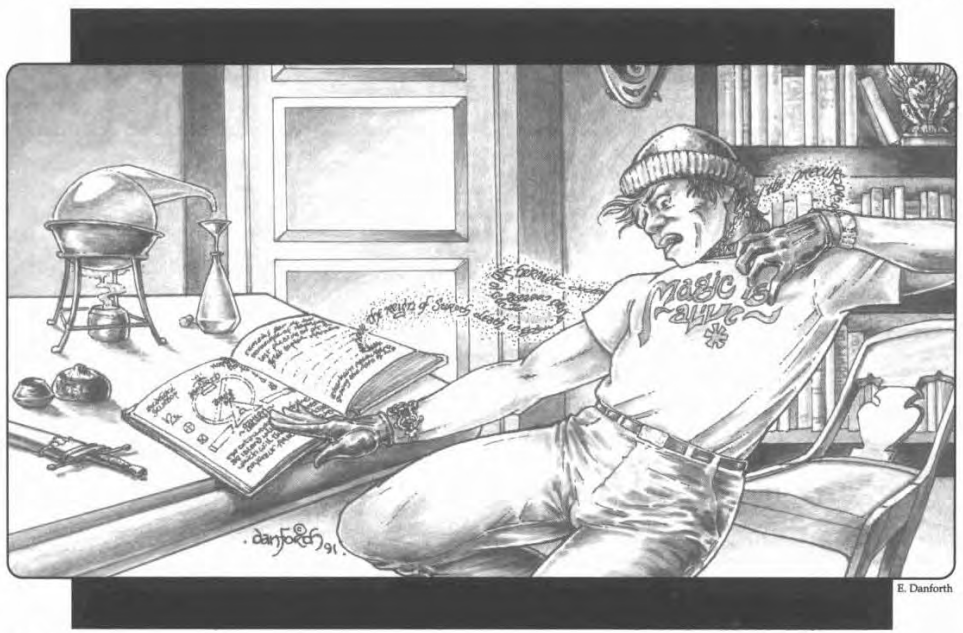
This is long as hell, so let's break up the wall of text.
Anyway, all the spells have the same statblock format, so let's take a look at the basic attack spell in the game:
quote:
Bullet
Axiom Level: 7
Skill: apportation/metal 13
Backlash: 15
Difficulty: 11
Effect Value: 15
Bonus Number to: effect
Range: 5 (10 meters)
Duration: 5 (10 seconds)
Cast Time: 3 (four seconds)
Manipulation: control
The spell is set for metal the mass of a small sling bullet, or a coin about the size of a quarter. The magician pantomimes the whirling of a sling with the hand holding the metal, then releases it aiming at his opponent. The apportation total must exceed the Dexterity or dodge of the target character in order to hit him.
First, every spell has an axiom level. Casting spells above your axiom can cause a contradiction.
The backlash and difficulty we've already covered. The effect value is the mechanical part of the spell. For an attack spell, that's damage; bullet is about as powerful as a 9mm. Bonus to tells you where to put the bonus generated by the initial casting roll; in this case it's added to the effect value.
Range and duration are self-explanatory, and include the values from the Value Table in case you need to convert them for some reason. Combat spells have to have a cast time of 3 or less to be used in combat, and a cast time of 4 to be used on a friendly target if you want the effect to take place on the same round you cast it. Anything with a cast time higher than 23 can't be cast in one go. Lastly, there's Manipulation, which is used for the spell manipulation rules which are, again, in the Aysle sourcebook.
So let's put this all together.
I'm playing a mage from Aysle with an apportation magic of 15 and a metal knowledge of 2, which is possible for a freshly-made character. I want to cast Bullet on a possibility-rated guy with a dodge skill of 12 and a Toughness of 9.
First I have to make sure I'm within my axioms. For the sake of this example let's say I'm in Nippon Tech, which has a magic axiom of 2. My magic axiom is 18 and the spell's is 7. That's a one-case contradiction, so I better not roll a 1 or I'll disconnect.
The difficulty of Bullet is 11. I roll a d20 and get a 9. I look that up on the bonus chart for a result of -1. Adding that to my apportation magic gives me a total of 14. That beats the difficulty, but is 2 less than the backlash value. Looking that up on the Combat Results Table gives me a result of "O1", so I take 1 shock and an "O" result. That's fine, let's assume I'm still up so the spell goes off.
I add the bonus generated by my roll to the spell's Effect of 15 for a total of 14. That beats the target's dodge 12 (barely), so I take the final effect total (14) subtract the target's Toughness (9) for a final result of 5. Looking that up on the Combat Results Table gives me "O2", so that's 2 shock and an O.
Just for the record, if I had rolled a 1, then I not only would have disconnected, I would have taken a backlash result of 15, which is "3Wnd KO 5"; or 3 wounds, a KO, and 5 shock. Assuming I would have survived that (and about the only way I could would be to be uninjured to begin with or spend some Possibilities), I'd lose access to apportation magic and metal for 24 hours, couldn't be healed below wounded in that timeframe, and would still need to get a 17 with my reality skill to reconnect while I was in Nippon Tech.
--
So there we are. Spellcasting, Torg style. And once again, it's way more complex than it needs to be because the designers feel that they have to back all the game concepts up with more math or long-ass theories because they think we care. They leave no room for anything even resembling suspension
Bear in mind, this isn't the complete magic system . The rest of it is in the Aysle sourcebook, which has stuff like inherent magic, eight pages of fluff about a lecture on the theory of magic because you care, casting on the fly, and tweaking spells.
Just wait until we get to spell creation. Ooooh, you just fucking wait.
NEXT TIME: Miracles! They're as bad as magic, just in a different way!
Having faith. And focus.
Original SA post The storm has a name... - Let's Read TORG
Part 8: Having faith. And focus.
Last time we hammered our way through the Torg magic system, which had a bunch of unnecessary mechanics because they can't let you do anything more complex than using a simple skill without a bunch of drawbacks in place. But this is the miracles section, right? I mean, can't we just take it on faith that divine magic just works?
Ha ha of course not. Because Torg, that's why.
Unsurprisingly, there's a completely different system for miracles that has very little relation to the magic system.
quote:
Religion and spirituality differ from magic in a fundamental way: magic bends the forces of the universe according to alternate laws of nature; religion creates a spiritual community linked by a divine will separate from each individual's will.
Magic is much like an alternate technology limited only by the practitioner's mentality. A wizard can study in his tower for years, never see a living soul, and be unhindered in his quest for magic. Religion, on the other hand, connects people to their cosm through the community. When people of a belief gather and interact in a service or ritual, the community is reaffirmed. Even hermits begin their lives of faith in the community. When they leave to seek solitude, they are still bound to the community by their faith, linked to others through the divine principles they seek to explore.
The game refers to a religion and its associated stories, symbolism, and such as a mythos . Why they can't just call a religion a "religion" is beyond me, but anyway.
To be able to perform miracles, you need to accept all the core beliefs of your mythos. If, for whatever reason, you stop believing in even a part of your religion, then you can't perform miracles anymore. That seems...unfair, especially since a) we're looking at this from a 2015 standpoint, and b) most practitioners can't agree on 100% of their own religions 100% of the time.
There are, surprisingly, only two skills needed for performing miracles: focus is the skill that's used to actually cast the miracle, and faith is the skill used to determine the actual effect value of the miracle. Both skills are based off Spirit .
Here's the thing, though. When you cast a miracle on someone, it's the faith skill of the beneficiary that determines the total effect. This is where terminology gets confusing: if the miracle is helpful to the target, the target is the "beneficiary" and you use his faith score to determine the outcome. If it's a harmful miracle, though, then the caster is the beneficiary and uses his own faith score.
On the plus side, if you're performing a miracle and there are other believers around, they can help you perform the miracle. Every character who wants to help with the miracle has to make a faith roll against the miracle's community rating . The total number of people who succeed is then added to the caster's focus total. Or you can just use this formula if you don't feel like rolling for 50 NPCs.
quote:
Value of number of characters
+ average faith
- community rating of miracle
- 2
- bonus modifier for focus character
There is a limitation on this, though: people who don't have faith in the main caster's mythos can't contribute. Due to the book's poor organization, this important tidbit isn't mentioned until the next section. Instead of, you know, just saying that the people who help have to be of the same belief system as the caster.
It is possible to cast a beneficial miracle on a willing subject of a different faith as normal, but if you do so then a spiritual struggle will erupt as the two belief systems clash. Each character must generate a new faith total using the other character's faith skill total as the difficulty. Then you look up the result on the Combat Results Chart and apply the damage to the characters.
quote:
Example: In a pinch, Father Bryce performs a healing miracle on an Edeinos companion. The miracle succeeds, the Edeinos is healed. Even though the Edeinos wanted to be healed, there are still consequences to performing a miracle on a "disbeliever," or accepting a miracle from another faith.
Bryce's faith value is 13. The Edeinos' faith value is 14. Bryce gets a total of 13; no effect on the Edeinos. The Edeinos rolls a total of 19. Bryce takes 6 result points of stun damage (O 2). There are also "spiritual consequences."
For some reason, the next section is about "evil enemies"; if you're around someone who shares your mythos but is an opposed side (like a Satanist around Christians), then the evil character's faith adds are treated as a penalty to the "good" character's rolls.
For some other reason, the next section after that is about conversion . It's possible to convert from one religion to another; doing so will reduce your faith adds by 1 (but if you go to 0 adds, you're still considered to have the skill), and converting clears all spiritual damage effects you're suffering from. Also, if you don't have the faith skill and someone performs a miracle on you with a spectacular success (beating the difficulty by 12 or more), then the target will automatically convert to the caster's religion whether they want to or not, and must immediately buy an add in the faith skill for 2 Possibilities whether they want to or not.
Again: Torg gives no shits about your character concept.
Oh, hey, we finally get to the spiritual damage rules! Like backlash, this is normal damage with special fun riders:
1) If you're KO'd by spiritual damage, you lose your focus skill . You can't get it back until you either convert, or are the subject of the ritual of purification miracle.
2) If you suffer any wounds from spiritual damage and become heavenly wounded, you lose both your faith and focus skills, and can't get them back or be healed below wounded until you are the target of the ritual of hope miracle.
Hope you know an NPC of your mythos who knows those rituals!
Next up is a list of various belief systems (monotheism, animism, polytheism, etc.). Surprisingly, the nature of your belief system doesn't have a mechanical effect on your character.
Unless you are an atheist! If you're an atheist, you can actually cancel out a miracle of any religion by making a faith roll and beating the caster's focus total. Yes, this means you can have faith in being an athiest.
Moving on from that interesting theological paradox, there's some information on the spiritual axiom. Interestingly, the higher a cosm's spiritual axiom, the more likely the belief systems there will become literal truths.
quote:
In cosms with lower spiritual axioms such as Core Earth, the documents of a religion tend to be slightly altered or vary more from the literal history of the religion — but they are still valid beliefs because they are true for the originating cosm of the religion, and faith in that religion will yield spiritual power in any cosm (at least those with an axiom greater than zero). A worshipper's faith tenuously connects her with the originating cosm, as well as other members of the community who hold the same faith.
Then out of nowhere we get some stuff about spending Possibilities on miracles. You'd think this would be back with the information about, you know, making the skill check but whatever.
quote:
Only one Possibility may be spent to enhance this roll, as usual; however, since there are two participants in the miracle, there are limitations on who may spend the Possibility. The focus character may spend the Possibility if and only if the focus total did not exceed the difficulty of the miracle before the additional roll. If it did, the faith character must spend the Possibility.
Oh, by the way, this rather important bit is just tossed out there:
quote:
If a miracle fails, the character may not attempt the miracle for 24 hours, or until he undergoes the ritual of purification. In addition, the character providing the faith must wait 24 hours or be cleansed in a ritual of hope before he can use his faith in any miracle.
If a character is providing both faith and focus, both restrictions apply.

Oh, and because there's not enough stuff to keep track of, there are global modifiers to the difficulty depending on the situation the miracle's being cast in.
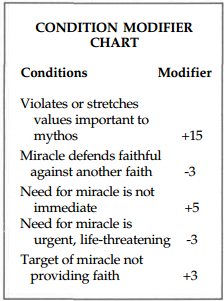
Because god forbid we have a chapter without charts
There are a few more small rules bits before we get to the actual miracles. First off, a character can only receive healing once every 24 hours because. Also, if you want to cast a miracle on multiple targets, it's not one-on-many, it's considered a multi-action. No, I don't know why. Oh, and the targets aren't all affected at the same exact time; if the miracle is beneficial then it affects everyone in descending faith order, and if it's harmful it's in ascending order. Again: why? Was that a concern?
There are also "freeform" miracles called invocations , which is an appeal for direct divine intervention. The community rating and focus difficulty for an invocation is 20 + (33 - local spiritual axiom). For instance the Nile Empire has a spiritual axiom of 17, so the difficulty for invocation is 20+(33-17)=36. When you invoke, there's no faith roll because the deity is powering the invocation. If you succeed, the degree of success determines the overall effect. A minimal success means that the effect goes off, but in a way that doesn't really disturb the world and can be written off as a coincidence, but a spectacular success will be undeniably a divine act and will also have an extra divine effect.
The miracles listed in the core book are the "Miracles of Core Earth", but some of them have a Spiritual Rating (the axiom level of the spell) higher than Core Earth's spiritual axiom of 9. Which means that, even though "a Core Earth character who has a focus value has access to all of the miracles below", you couldn't try to cast them without risking creating a contradiction. It also begs the question of how Core Earth PCs can learn them in the first place, because as far as anyone knew divine magic wasn't a Thing until the invasion happened three months ago; before that it seems like miracles were impossible. Maybe nobody just thought to try?
So let's take a look at a typical miracle.
quote:
Healing
Spiritual Rating: 10
Community Rating: 11
Difficulty: 15
Range: touch
Duration: na
Effect: reduces damage and wounds by number of success levels
If the miracle succeeds at all, the target removes all KO-conditions and shock. In addition, each success level of the miracle reduces the target character's wound level by one. For example, a character with a heavy wound who received average healing would be completely healed. A character suffering a loss of faith due to spiritual damage may not have his wounds fully healed, even via this miracle, until he undergoes the ritual of hope.
We've already covered what this all means since a lot of it is from the magic chapter, so let's do an example again.
I'm playing a Cyberpapal priest with a faith of 15 and a focus of 13. I need to cast healing on Sir Franklin, a friend from Aysle who has a faith of 10 (he's a follower of Dunaad, god of honor), a focus of 13, and has been hurt pretty badly: 4 shock, a K, and two wounds. We're in the Cyberpapacy, so the local axioms match my character's axioms.
The Cyberpapacy's spiritual axiom is 14, so that's not a problem. I make a focus roll and get a final result of 20. This isn't an immediate need situation, so that increases the difficulty by 5, but I still made it. The miracle is cast successfully, but now we have to see if it takes. Sir Franklin is the benifcator of the miracle, so he makes a faith roll and gets a 14.
So the miracle has taken effect on both sides because I made the initial casting roll and Sir Franklin got a positive result. All his shock and KO effects are healed. We look up his focus total on the General Results Table. Unfortunately, at no point does the book tell me what the target number is for the faith roll so I'm going to assume it's 0. 12 is a "spectacular" success (4 levels), so he also heals all his wounds.
But! The two characters believe in different mythoses, so there's a spiritual struggle. Each character rolls their faith against the other character's focus.
I bomb and get a total of 10 against Sir Franklin's focus of 13. I missed the roll by 3, so I take a K and 1 shock. Sir Franklin gets a 12 against my focus of 13. He takes 1 shock.
Now, if I had beaten the difficulty of the initial faith roll by 12 or more we would have bypassed the whole spiritual struggle thing because Sir Franklin would have converted; he'd have to reduce his faith adds by one, and would become a devout follower of Cybercatholicism. Which will be interesting when he tries to follow the tenets of the religion and get some cyberware that wouldn't be supported by his personal axioms.
So what kinds of things can you do with miracles? Uh...not a lot. There's the standard-issue bag of cleric tricks; healing, bless, create/purify food. There are 17 miracles in the core book, three of which are meant to communicate with different kinds of spirits. There are the two rituals mentioned under spiritual damage, but their whole purpose is to deal with the effects of spiritual damage.
--
Overall, miracles are just like all the other Torg power structures: overly complicated and full of unneeded drawbacks. And like the other player abilities, you can see what they were going for before it gets buried in theorycrafting and extra rolls.
Like, why do we need to worry about conversion? If anything, it can make people leery of performing helpful miracles on friends because it's pretty much brainwashing. It doesn't matter if I don't want my gun-toting merc to suddenly become a follower of Lanala and not want to use his guns any more, or if I convert to Cybercatholicism and suddenly feel the need to get a bunch of cybernetics installed even though they'll make me a perpetual contradicition.
In fact, it's a setup that actually punishes someone else when you roll too well on your miracle.
Seriously, would it have been so bad to just say "roll your Cast Spell/Miracle skill"? Why make all this?
The answer is the same one it always is: verisimilitude.
NEXT TIME: Equipment you can use about half the time!
Gearing up, template creation, and finishing the main rulebook.
Original SA post The storm has a name... - Let's Read TORG
Part 9: Gearing up, template creation, and finishing the main rulebook.
The last real chapter of the core book is the Equipment chapter, and there's really not much to talk about here so this is gonna be a short one.
One thing that should be pointed before we get going is that all prices are given in Core Earth dollars. Each cost also has a value to look up on the conversion tables for different realms' monetary systems.
It should also be pointed out that each piece of equipment has a tech axiom level. Remember, using an item not supported by the local axioms can cause contradictions.
First off is armor. Armor is pretty straightforward; it has a value that adds to the wearer's Toughness when determining damage, and bulky armors can reduce your dodge value. Leather armor is Tech 5, gives +2 Toughness, and costs $400. A bullet proof vest is tech 21, and gives +6 Toughness. One interesting thing is that there's a significant tech jump from plate mail (tech 13) straight to a bulletproof vest.
And as a reminder, armor has a "max value" that it can increase your effective Toughness to, generally in the low 20's. A few armors have special rules to add to the realism:
-
Bone and hide armor can break if you take a wound while wear armor that isn't specifically fitted for your character.
-
Bronze and plate armor can cause you to take more shock damage when you're fatigued because they're so heavy.
-
Kawana Corp security armor is actually a bit better than subdermal plating.
-
You can get special "silk lining armor" that's as good as chain mail, but doesn't protect you from guns above tech axiom 19. Chain mail, however, can stop bullets.
Next is general gear, and this is mostly statless items you'd just buy or have. Again, the tech levels look weird here; a normal wristwatch is tech 20, but an electric watch is tech 21, and a pocket watch is tech 18. A glass mirror is tech 10, and an iron spike is tech 10, which again doesn't jive up with the tech axiom example I gave way back when: at tech 8 "medicine and astronomy are possible", iron is smeltable and metal armor is invented. If astronomy is possible as an organized science, wouldn't that imply that lenses have been invented?
And this is the biggest problem Torg runs into with the axioms: they spend all this time and effort laying down hard numbers about what's possible where, then run into problems when what they intend for realms/gear/powers doesn't line up with the axiom numbers. Really, after a certain point axioms really stopped being a part of the setting and just became numbers you had to worry about to avoid disconnecting.
Air vehicles are next, and are split into piston aircraft, rotary, and jet-powered aircraft. Not that it matters because they all have the same stat types.
In fact, all vehicles are pretty much stated up the same way; tech axiom, speed, number of passengers, and Toughness.
In the interest of brevity, let me just hit a few high points on vehicles:
-
Gliders are tech axiom 19. Sadly, you can't pull an Ator.
-
A DC-3 ($150k) is cheaper than a Spitfire ($200k).
-
You can buy an SR-71 Blackbird, assuming you have $32,000,000.
-
They list the prices for several era's worth of trains. To buy.
-
Also submarines and tanks. Because those are all things you can just, you know, buy.
-
They actually have US Space Shuttles as a vehicle you can buy.
Space shuttles
.
quote:
20 — Radio voice transmission possible. Crude airplanes. Radioactivity understood. Discovery of relativity possible. Automobiles reliable enough to replace animal-drawn transport. Sonar invented. Brain surgery successful. Automatic pistol. Submachine gun. Movies, including "talking pictures."
But let's get to the important part of the equipment lists: weapons!
Melee and man-powered ranged weapons do damage based on the wielder's Strength , but also cap out at a certain damage level. A broadsword or longbow does STR+6, but tops out at 20, so no matter how much your strength is above 14.
There's more tech axiom wonkery here, too. A short sword is tech 8, but a longsword is tech 9. A "Baseball Bat/Club" is tech 6, but a spear is tech 5!? None of the values feel like they make sense, even when you go back and check what the axioms actually represent. Why is a club higher technology than a spear? What is the technological leap that allowed people to look at a shortsword and say, "maybe we can make the blade a bit longer"?
I admit I do like the idea that someone could pick up a large piece of wood, try to swing it at someone else's head, and suddenly disconnect because clubs aren't supported by local axioms. Not that that could happen, because the lowest tech axiom in the game is the Living Land at 7.
It's all just another casualty of the need to model everything mechanically and keep the various realities separate. I can understand not wanting people hopping from realm to realm and wind up with magic and superpowers and cyberlimbs all at once. That's fine if that's the theme you're going for. And I get wanting to keep realities from mixing as a Thing in the game. But again things get taken too far and you end up with these weird situations where your short bow can stop working (the bow's tech 8, Living Land is tech 7. It can happen.)
The main difference between firearms and melee weapons is that the damage for firearms and related weapons is a flat value, usally in the 20s. There's not much to see here, but just for reference the available weapons range from muskets to automatic pistols to mounted rifles to anti-aircraft cannons to fucking hellfire missiles. Where are they expecting people to buy these things?
I mean, I understand that you need to include heavy artillery for when NPCs bust them out. But adding prices is just silly. Why would PCs want to buy a train? It's not like they can take it with them everywhere.
The last chapter of the book is a page on freeform character creation for people who don't want to just use the provided templates. Basically, it boils down to spending 66 points on stats, 16 points on skills (and three on the tag skill), and 10 possibilities. Oh, and if you're a magician you get the 12 points for magic skills and spells.
You also have to pick starting equipment, but instead of saying how much cash everyone starts with, you just get stuff appropriate for the type of character you're making. Sort of.
quote:
If the player wants possessions which do not appear on the equipment list, she is responsible for providing you with enough information about the item so you can make up your mind. For example, if the item in question is a weapon, the player would have to describe, in game terms, how effective the weapon is, and what sort of ammunition or maintenance is required, how she came across the weapon, etc. A picture would be useful.
If the player wanted a mansion, she would have to draw the floor plans of the mansion, a map of the grounds, delineate the caretakers, and give you enough written description so that the mansion can fit into the campaign.
In short, if a player wants lots of equipment or material possessions, she must pay for it. The payment is not only in game money, but in imagination; she must work the equipment in so that it contributes to the story, and is fun for you and the other players, as well as herself.
And...that's the end of the core book.
The core box set came with two other small books. One was the World Book, which gave a run-down on each of the cosms and some of the cosm's unique skills/powers/spells/etc. Unfortunately, each cosm gets maybe a half-dozen pages so there's barely enough information to sink your teeth into. And there's absolutely nothing about each realm's tone apart from the high-level stuff that comes with the realm's general genre.
I'm not going to cover the Worldbook on its own, since it's better to fold that info into the cosm book reviews where they belong.
The other was the "Adventure Book", which contained a starting adventure and some GMing advice. The advice is all general stuff, but oddly enough there's no advice on how to get a group of five characters from vastly different and distant parts of the world together at the start of the campaign.
What it does have, however, is a warning of what Torg's adventure and fluff writing would be like for the rest of the game line.
Get ready for some railroading and the purplest of proses!
NEXT TIME: Sample adventure time!
Keep on rocking in the Still World.
Original SA post The storm has a name... - Let's Read TORG
Part 10: Keep on rocking in the Still World.
So the original Torg boxed set came with a sample adventure/campaign starter called "Before the Dawn".
Sample adventures can be useful. They're easy, convenient ways to communicate what the game should look like "in motion" and can provide a few sample encounters for GMs and players to cut their teeth on as they learn the system.
Not this one, though.
See, at the end of the first Torg novel, the Gaunt Man put a supernatural device called the "vortex machine" at the bottom of the ocean near Indonesia. The device was designed to slow the rotation of Earth; the stolen rotational energy (which is a thing, I guess?) in his Darkness Device as the physical energy needed to become Torg.
Unfortunately for him, he got stuck in the dimensional prison by the Heart of Coyote before he could use the stored energy. Unfortunately for everyone else, nobody else knew about the vortex machine in the first place. So the thing is still running, slowing Core Earth's rotation and causing all sorts of fun problems. At the start of the adventure (and the default start of a Torg campaign), it's been three months since the invasion, and people are starting to notice the slowing of Earth. It's generally accounted to the invading realities fucking everything up, but no one knows what to do about it.
Except that Dr. Mobius has learned about the vortex machine, and knows where it is. He's sending agents to sieze the vortex machine for himself.
The gist of the adventure is the PCs stumble into Mobius' scheme while delivering supplies to survivor colonies in the Living Land. They get involved because that's what the adventure says happens.
And that's the first of the three central problems with Torg adventures: they're very heavily railroded, with the whole thing assuming that the PCs will follow the plot as imagined by the author. It's assumed that the characters will get involved because they're the Good Guys and thus want to stop Mobius doing whatever he's doing. Which is a fair assumption, yes, but as things progress the adventure is written with the assumption that the PCs will notice clues, interpret them correctly, and follow the lead to the next act. But this is decades before the GUMSHOE system, so there's a lot of "roll to see if you find the clue. You didn't? Oh well." in there.
The second problem stems from the first: there's no assumption that the PCs might fail at some point. A lot of the published adventures gave zero thought to "so what happens if the PCs fail to complete this task?" There are some adventures that have major impact on the setting, but even at the big climax where the characters need to use the thing on the thing to stop the Bad Guys from doing it there's no sidebar of "here's what happens if the PCs don't win".
The third problem is that you can tell that the fiction writers really wanted to be novel writers, but weren't very good at it. All in-game fiction and boxed text is stilted, wordy, and has a lot of "you think/you feel"-isms.
As an example, here's the boxed text the GM is supposed to read to the players at the start of Act I of the adventure:
quote:
The world has surely gone to hell recently. The USA has been invaded by dinosaurs and lizard-men; the United Kingdom and Scandinavia have been overrun by knights in armor, Vikings and sorcerers; France has been transformed into a dark-ages theocracy; the Middle East has been taken over by a raygun-wielding lunatic who wishes to recreate the glories of Ancient Egypt. It's been a bad couple of months.
And now the Earth has stopped moving. The sun has been in the same place for over 20 hours — somewhere over the ocean near South America — and the temperature over North America has risen almost six degrees above the record high for this day. You shudder to think what it must be like in South America now — and what it will be like here in a week.
But there's nothing you can do about that, so you are doing the best you can, running supplies into the boundaries of the so-called "Living Land" - a place that used to be called Ohio. Despite the invasion of the dinosaurs and the Edeinos, despite the destruction of the cities, despite the collapse of technology, people still live there, refusing to leave their beloved homes.
They may be foolish — even crazy - but you cannot simply let them starve or die for lack of food or proper medicine. So, every day for the last couple of weeks, you have been running a truckload of supplies into Ohio from still-normal Kentucky, at the same time, attempting to convince the people to leave.
After a few terrifying experiences in the first trips, you've gotten the hang of it by now — more or less — and this trip has so far been uneventful. You are heading down a dirt road back toward Kentucky. The road has degraded significantly, and, hitting a sharp rock, your front left tire blows out.
(This is also an example of what winds up being the only real "adventure" the developers could come up with for the Living Land: p-rated people driving supplies to survivor colonies in the Living Land. A lot of humans can't leave due to not wanting to transform, not wanting to be eaten by dinosaurs, or not having anywhere else to go.)
Torg adventures are universally broken up into Acts, which are then broken up into Scenes. GMs are supposed to do this too, because they hand out Possibility rewards at the end of acts.
So anyway the driver has to make a save vs. car crash or people might take a little damage. Presumably the PCs will want to fix the jeep. Good luck with that.
quote:
The deuce-and-a-half is so-named because it weighs around 2.5 tons; it's not so easy to change a tire. The difficulty of changing a tire is 8 ( land vehicles skill); the base time value is 17, or around 40 minutes.Subtract one from the time value for each level of success above minimal the character receives (that is, on an average success it takes 25 minutes; good success, 15 minutes; etc.). The coordination difficulty of this task is 5.
Not that it matters, because before they can finish something starts running through the jungle towards the party. This is Hildy Marlen, daughter of a Nile Empire scientist and Damsel In Distress. Of course, people might be a little trigger-happy due to being in a jungle full of dinosaurs.
quote:
Under no circumstances should the Knights be allowed to kill Hildy. If anyone foolishly wishes to fire off a burst before seeing what they are firing at, Hildy gives off a frightened scream (she saw a large snake in the trees) just as they are about to fire. If the Knights insist upon firing anyway, they miss. Period.
Hildy runs out of the brush, latches onto the "nearest handsome male", and starts frantically asking for help in German.
See, as per the way reality in the Nile Empire works, any kidnapped scientist has a beautiful daughter, and should said scientist be kidnapped for nefarious purposes, his daughter will escape and find a hero to help her and probably fall in love with. This is actually accurate to the reality of the Empire, so I can forgive it somewhat. I really do have to ask if they needed to make her as helpless as they did, though.
Once people get Hildy to calm down, she manages to remember her English and exclaims she's being chased by lizards just as an Edeinos hunting party shows up.
And here we are at the shakedown fight! The hunting party is six warriors and an optant (Edeinos priest). They've been chasing Hildy longer than they needed to because they love the feeling of the hunt, and thanks to a handy miracle they can see through the Living Land's Deep Mist up to 40m, as opposed to 10m which is the normal draw distance in the Mist. That means that this is pretty much going to be an ambush since the PCs probably won't see the Edeinos first. They spread out around the jeep, the optant casts an Animate Plant miracle, then they attack.
What this means is that all the plants in the miracle's area of effect (20 meters) start attacking the PCs in an attempt to wrap around them. The plants are only animated for one round, but if they hit a PC then that character is at -5 to all Dexterity -based rolls for the rest of the fight or until they break free.
This is a pretty rough fight for the first of a campaign; seven NPCs attacking at once when some of the characters are at a severe defensive penalty means that people are going to have to start paying out Possibilities to not get wrecked.
Anyway assuming the PCs win, the adventure continues. Now people can question Hildy, who gives the following exposition dump:
quote:
"I am the daughter of Herr Doctor Heinrich Marlen, a famous engineer. We were in Cairo when the Pharoah came. My father was captured, and forced to work for the Pharoah, under the direction of Professor Shariff." (Here she gives a pretty shudder.) "Professor Shariff said he would do things — terrible things! — to me if my father did not work for him.
"In the next two months, my father built a fantastic digging device. He could never do this before; I think he changed somehow when the world did." (In fact he transformed into a weird scientist.)
"Three days ago, Professor Shariff took my father and myself onto the digging device and forced my father to drive it to this place. During the two-day trip, we overheard the Professor talking to the soldiers. He told them that they were to meet some Edeinos, to trade weapons — there are several hundred rifles on the device — for a key. He said that Pharoah would be able to use the key to unlock the power of the Still World!"
"When we arrived here this morning, the Professor met with some of the lizards — I do not know what they said. Then the lizards left; we have been waiting ever since. Two hours ago, my father and I were let out of the device to get some fresh air. My father hit our guard on the back of the head and told me to run and get help. As I left he was struggling with the guard.
"An hour later, I was discovered by the Edeinos. They chased me until I met you.
"My father is an old man; they are sure to kill him! Won't you please rescue him?"
This scene takes place around a good old-fashioned drilling vehicle, with giant drills at both ends and everything. Hildy leads the group to the machine, which is being guarded by ten Nile Empire stormtroopers armed with machine guns. Hildy knows that there are ten troopers plus Professor Shariff, and that the digger takes a long time to start when the engine's cold, but that's it.
There are four guards outside the digger; the rest are inside. If the PCs are spotted (or just run in guns blazing), the visible guards will sound the alarm by firing their rifles into the air. Next round, the rest of the troopers come pouring out of the digger, then Shariff the round after that.
So that's 11 NPCs versus the group, with no mook rules, and all the bad guys will fight to the death. Shariff is also armed with two weird science gizmos: a sonic pistol and a personal force field generator. On top of that, this is a "Dramatic" scene, which means the Drama Deck is stacked against the PCs.
Amazingly, there is something here to say what happens if the PCs lose.
quote:
If so, Professor Shariff will attempt to capture them and imprison them in the digging machine, so that he can gloat over them at his leisure, and bring them back to Dr. Mobius as prizes. If this occurs, you will have to give them an opportunity to break free of their bonds and overwhelm their opponents, either during the trip, or when they reach the base (see the next scene).
The adventure also says that the PCs shouldn't be allowed to blow up the digging machine since they need it to get to the next act, so assume it's mostly underground and thus has tons of armor.
But wait, you ask; what if the PCs decide that something pretty big's going on here and try to head back to Kentucky for help? Don't worry, the writers got you covered.
quote:
Finally, you may be in trouble if the Knights decide not to attack at all, instead preferring to return to Kentucky to get help or do something else altogether. You have a number of choices: you can use Edeinos to herd them back to the encounter; once they are in Kentucky, you can feed them clues and hints suggesting that they go to the Nile Empire and find the hidden base; or you can somehow get them directly to Act Three in Indonesia, skipping Act Two altogether.
Anyway, either the PCs win and save the Doctor (who's tied up in the back of the digger) or they lose and get taken prisoner. If they win, they can reunite Hildy with her father and search the digger. Searching the digger will turn up a few crates of assault rifles and Shariff's diary. The diary states that Shariff is here to trade the rifles to the Edeinos for an egg, then he has to bring the egg to a Nile base. But don't worry; if the PCs don't think to search the digger then it turns out that Dr. Marlen knows all this because he managed to sneak a look at Shariff's diary during the trip despite being held prisoner
And this leads to an actual character decision point ! Holy shit! The group can either stick around and get the egg from the Edeinos, or go straight to the Nile base.
(Oh, in case you're wondering about lizardmen using modern weapons despite the fact that their religion expressly forbids the use of dead things...Baruk Kaah has been subverting the worship of Lanala by creating a special "priesthood" who are allowed to use dead things, like rifles. He also likes to give the rifles to his gospog since the mindless constructs don't give a shit about religion. The Edeinos all believe that Kaah is speaking the will of Lanala and thus belive this is all kosher with her, but even so very few Edeinos know about his use of dead things because Kaah knows that this would be pushing it with his followers. This is one of many plans that eventually bite Kaah in the ass.)
If the PCs decide to stick around for the trade, then they have a few hours to prepare. They can set traps, sabotage the rifles, disguise themselves as stormtroopers, and so on. The Edeinos aren't expecting trouble, but even so there's a dozen of them and they brought a Bor Aka, "a dinosaur roughly the size of a bad-tempered football field." On the plus side, the Edeinos won't test the rifles (since they're dead things, and they don't know how to use rifles anyway) or realize that these aren't the people they're supposed to meet (all humans look alike to them). The PCs can get the egg without a hassle if they play it cool.
Oh, and it turns out it's not an animal egg, it's a Faberge Egg. This fact is not revealed until a sidebar near the end of the adventure, so thanks game writers!
Regardless of whether or not the PCs get the egg, the next scene assumes that the PCs take the digging machine to the Nile Empire base. Presumably they take Dr. Marlen and Hildy with them, since only Dr. Marlen knows how to drive this thing.
And that closes out Act One! For completing the act, the PCs each gets "around two" Possibility Points. Better play gets them three each, playing "below average" only gets them one each. Regardless, they're probably going to have spent more points than that so they're gonna be in the hole.
The first scene of Act Two takes place at a Nile Empire airbase that's in a Nile pure zone. Oh, the digger apparently has an autopilot that takes it back to its dock under the airbase, so the party doesn't need to bring Dr. Marlen along after all.
Anyway, the airbase is ten miles out in the desert and is pretty bog-standard; prefab metal buildings, some hangars, guard towers, kennels, and so on. There are also 40 fully-stated stormtroopers, a pilot, a bunch of faceless workers, and a p-rated colonel.
Presumably, the PCs are here to learn the location of the Earth-stopping device, but again: nobody tells them about any Earth-stopping device. Neither Dr. Marlen or Hildy know about it, Shariff's diary doesn't mention it, and the Edeinos don't know about it. All the PCs know is that Mobius wants the egg because it's the key to the Still World, which is another thing they don't know about.
The PCs can deal with the base however they want; given that they're probably outnumbered at least two-to-one, they'll probably want to be sneaky. This is a standard scene, not dramatic, so at least the PCs have the advantage there.
quote:
Try to run this encounter as though it were a scene from your favorite Macho American Bodybuilder vs. the Dimwitted Foreigners who Can't Shoot Worth a Damn film. The hero wades out into a storm of automatic fire, taking not a scratch, and, with a single burst of his M-16, knocks the enemy soldiers down like tenpins. Encourage the players to be flamboyant — let even outrageous plans succeed, if they are cinematically appropriate to the genre.
And that still doesn't solve the problem that the PCs don't know what (if anything) they're supposed to be looking for. It turns out they're supposed to be looking for flight plans to a location off the coast of Indonesia. The flight plan also includes a manifest of the cargo of one of the planes here; underwater gear and weapons. This is the hint that they need to take the provided plane to their destination, so I hope someone knows how to fly a plane!
Scene two assumes the PCs took the seaplane from the airbase and are en route to the vortex machine when they encounter some boxed text.
quote:
You've got the flight plans; you've got a plane capable of getting there; and it's loaded with the equipment you need to complete your mission. Considering that you have had to go through 50-odd guards to get this, everything has gone quite smoothly, indeed. Why does that make you nervous?
In a moment you find out why, as two Nile Spitfires come screaming out of the clouds. Taking up positions to your rear, they call over the radio and demand to know who you are and what you are doing.
This is a dramatic scene, so again things are stacked against the PCs. They can try to talk their way out of the situation, but don't worry! It turns out that one of the base's mechanics has been taking a nap in the plane's secret compartment (since his boss can't find him there) and wakes up around this time. So now you get to have a dogfight while someone's trying to brain the pilot! Fun!
Again, assuming the group isn't shot out of the sky,
quote:
It is dark and very, very cold - outside of the range of Dr. Mobius's artificial sun, it is about 15 degrees colder than it should be. Below you, you see the lights of a few cities and towns bravely attempting to carry on in the face of the unending night, but you know that, if the Earth does not soon begin moving, they will all die in the cold darkness.
Hours pass. You cross the Indian ocean, flying south to avoid Indian airspace — a good thing to do, flying a Nile airplane. Up ahead you see lightning and dark black clouds. It is the border to Orrorsh, the dark realm. Beyond, in what used to be the Indonesian Sea, is your destination. You tighten your seatbelts and prepare to brave the storm.
That's the end of the act, so everyone gets a flat three Possibilities and we move on to Act Three. And this is where the bullshit kicks into high gear.
The first scene picks up with the plan approaching a giant vortex of energy spiraling out of the sky into the ocean, glowing in the darkness and begging the question of why nobody else has noticed this yet.
When the plane lands in the surprisingly calm water around the vortex, they're attacked by the demon Gibberfat. Gibberfat was bound to protect the vortex machine by the Gaunt Man, and is an old-fashioned three-form boss fight.
When the plane lands, Gibberfat attacks them in the form of a giant white shark before the PCs can even get into the water. Gibberfat is p-rated, his attack skills are all 14, and his bite is damage 21. Killing the shark doesn't actually kill Gibberfat; he just sinks into the ocean.
Now the group will probably start gearing up to get into the water. If they stole the plane from the airbase, then not only are there ten sets of 30's style deep-water suits, there are also ten "Sun blades" (basically neon swords), "octi-grenades" (grenades for uderwater use) and "torpedo pistols" (guess). If they didn't take the Nile Empire plane, then I guess they're out of luck because Gibberfat makes his second appearance once everyone's in the water.
This time, he appears as a giant electric eel with better stats and a stronger attack. This is still a rough fight, but winnable. The body of the eel will once again sink into the depths, where Gibberfat will take on his terrifying true form! That of...a cubby naked red guy with gills and webbed feet and hands.
quote:
The demon will swim up to the Knights and tell them in a sonorous voice: "Flee puny humans! Or I will send you to the coldest pit of hell, where you will writhe in agony for all eternity!" He will ruin the effect somewhat by sneezing violently at the end of his recital.
Or the PCs can offer him the Faberge Egg. Gibberfat wants the egg because he can use it to buy off his demonic supervisor and get a better assignment, and is so grateful that he'll warn the PCs that the device is guarded by "some dead humans, I believe." He then teleports away, leaving the way free to the last scene.
And again, there's nothing to hint that the egg is for Gibberfat. It's not in any of the notes the PCs come across, the NPCs apparently don't know, so how the PCs are supposed to figure this out is beyond me. In fact, if the players do have the egg, odds are they're going to think they need it to unlock something, since it's referred to as a key.
Regardless, here we are at the last scene of the adventure. It's a dramatic scene, of course.
The base of the vortex is coming out of the wreck of an old pirate ship 100 meters below the surface. The instant the PCs touch the ship, the vortex starts spinning faster and skeletal figures start crawling out of the wreckage.
There are 12 pirate zombies guarding the vortex machine, and their only goal is to stop the PCs from reaching the vortex machine. As an added bonus, they do not take shock damage, can't be KO'd, and heal completely when a Villain Up result is drawn on the Drama Deck. Oh, and they can only be killed -killed if you dismember the body after "killing" them (which takes three full rounds) otherwise...I don't know, it doesn't say. I guess they just keep fighting. Oh, and because the PCs are in underwater gear they have a bunch of penalties to deal with that the pirates don't.
Believe it or not, the writers felt that wasn't hard enough so they added a timer! See, the vortex machine is belowdecks, which means you have to get past the pirate zombies to get to it. The machine is huge, and is actually sunk mostly into the ocean floor, but there's still a control panel available. The PCs can't break the device because the Gaunt Man has imbued the thing with Possibility energy so it can fully buy off any damage it takes.
He also put in a security measure that causes the machine to start heating up the instant the PCs touch the ship (and wake up the zombies). As soon as the PCs touch the ship, they have 20 rounds to deactivate the vortex machine via dramatic skill resolution or the whole kit and kaboodle will burn so hot it burrows itself deep into the earth where nobody can reach it to turn it off, it keeps stopping the world from turning, the PCs are par-broiled, and everything sucks forever (which is three months, tops).
As near as I can tell, there's no indication that there's a time limit apart from the GM telling them flat-out.
So here's how the last scene probably shakes out if the PCs aren't told what they have to do:
-
The PCs reach the shipwreck.
-
The zombies wake up.
-
Everyone tries to fight the zombies, wasting a bunch of their 20 rounds.
-
They reach the machine.
-
They start trying to blow it up, wasting more time.
-
They try to turn off the machine in whatever time they have left.
Even if the GM does just tell people what to do, they still have to try to complete the dramatic skill resolution while being attacked by zombies that probably outnumber them. Good luck with that!
But assuming everyone manages to get things together long enough to deactivate the device, it destroys itself in a burst of energy (which is another security measure to prevent other High Lords from using it against the Gaunt Man) but surprisingly no boxed text.
quote:
You are ready to begin a Torg "Infiniverse" campaign.
Saving the world gets you 12 Possibilities.
So there you go. You've saved the world against some pretty high odds! Way to go!
But what if you didn't? What if the PCs couldn't overcome the arrays of bad guys or cause the vortex machine to sink into the earth?
Well, that's a problem.
Two days after the adventure, the earth's rotation stops completely. The American half of the planet is now stuck facing the sun, and Eurasia is now trapped in shadow. Temperatures in the Americas start to rise, eventually hitting 140 degrees Fahrenheit while Russia drops to -80 degrees. Technically Europe is still livable, but the Americas are pretty much screwed as the heartlands are rendered useless.
After a month, things still get worse. The centers of the Americas are uninhabitable as temperatures top 160 degrees, and now the lack of food production is having its effect on the still-inhabited areas. The Amazon rainforest is also destroyed, but at this point it's not like it's going to break the environment any worse that it's already been ravaged.
And three months after the vortex machine sinks into the earth...well...
quote:
Alaska basks in the 80s, only the southern tip of South America is livable. The Greenland icecap melts more rapidly. Britain, France, Spain, and West Africa are the only other livable areas on Core Earth.
Unless the High Lords provide magical, spiritual, or technological means to support life on Earth, the planet and its lifeforms will die. This does not make for fun roleplaying. We suggest that you stop the dramatic temperature changes at something livable(via a High Lord's intervention) or allow your Storm Knights to restart Earth's spin at some point during your campaign.
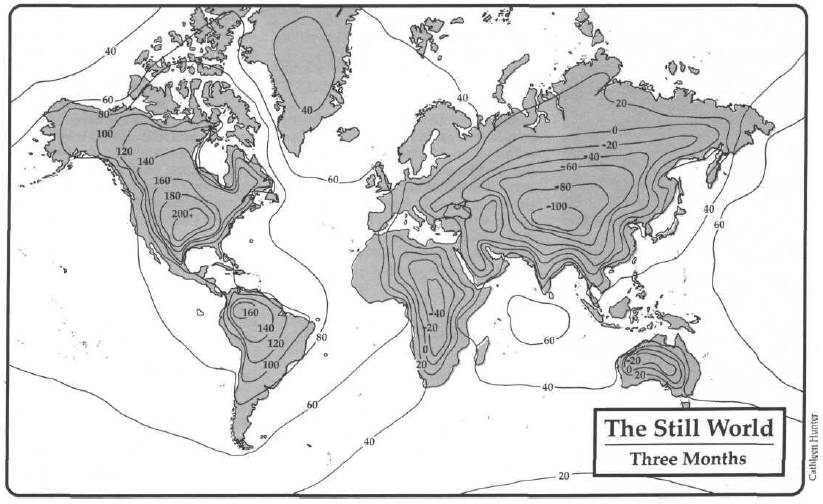
The end of the world as we know it
So there you go. You get to play The Road: The RPG for a few weeks before the world ends and you restart the whole thing without the whole earth-isn't-turning factor.
But here's the really dumb thing: at no point in the game line after the core set is any mention ever made of the Still World. The default assumption of the game like is that the PCs succeed at the adventure, fight their way past about 100 fully-stated bad guys and stop the vortex machine in 20 round while being pounded on by underwater zombie pirates.
And let's be honest here; the High Lords aren't going to help Earth. At best they're going to cut their losses and pull their forces back up the bridges once it's clear that Earth is doomed, and at worst they're going to leave their forces behind. The only one who'd want to help is Lady Ardinay of Asyle, but what could she do? She can't use her Darkness Device without dooming her own cosm, and you can't exactly move the entire population of Core Earth to Asyle.
If the PCs fail the adventure, then none of the rest of the game books will apply. But it's clear that the writers didn't want this outcome for the adventure. Which begs the question: why include that in the first place?
I mean, I get wanting to show that this is a game about high-stakes events and global-level threats. But you can't just do that out of the gate! The sample adventure should be a way to ease people into the game, to show off the core concepts. But the adventure barely spends any time in the Living Land before heading to the Nile Empire and then back to Core Earth. And do you really need higher stakes than a six-way battle for control of reality?
And you know what the funniest part is? This isn't the worst published adventure by a long shot.
NEXT TIME: Touring the cosmverse!
The Cyberpapacy
Original SA post The storm has a name... - Let's Read TORG
Part 11a: The Cyberpapacy
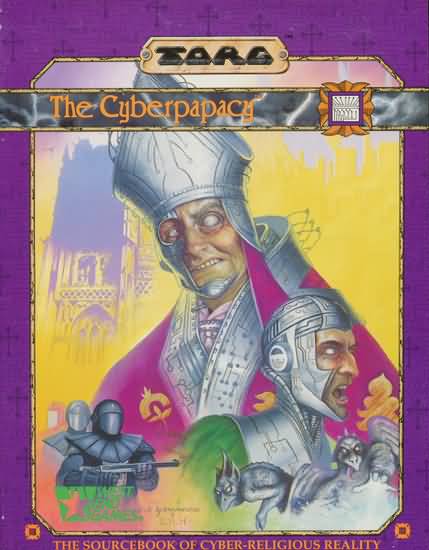
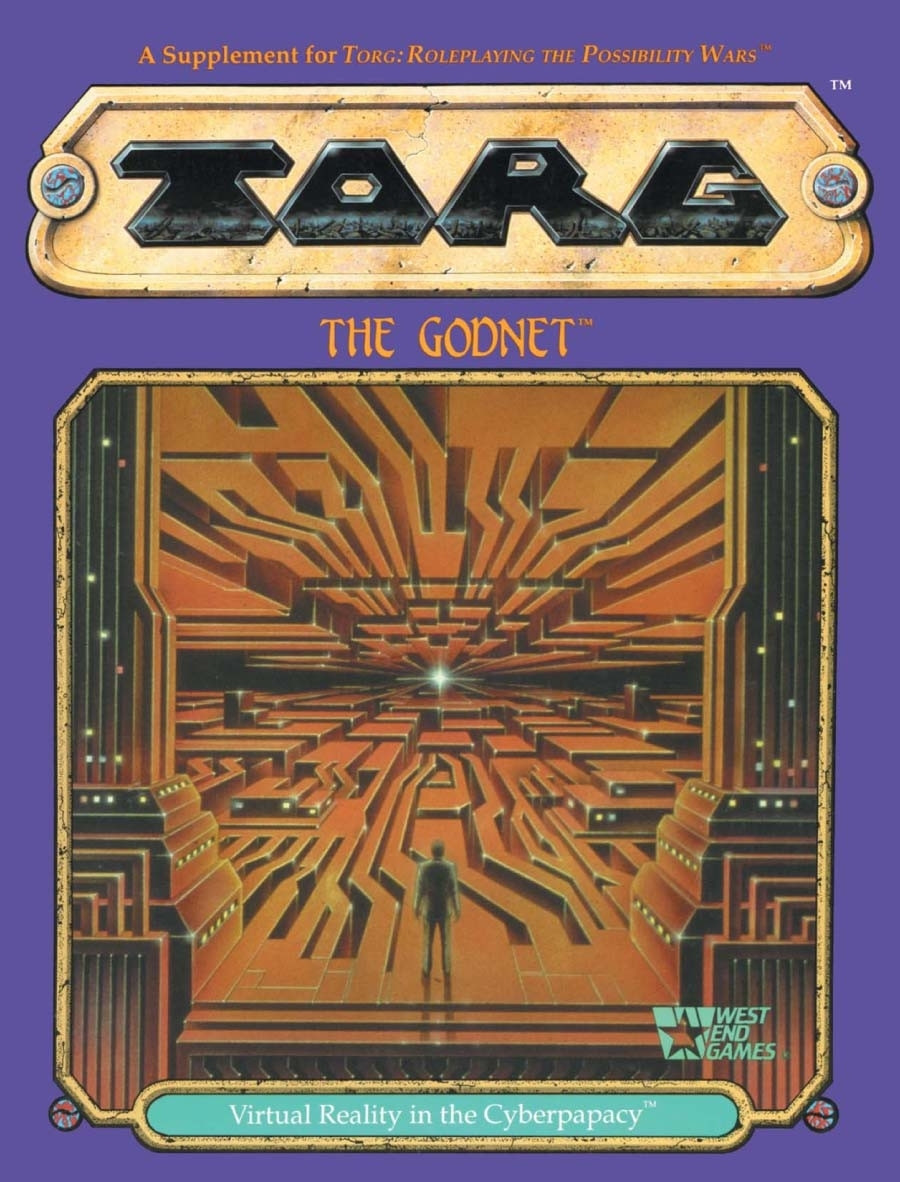
An ordained priest plugs a cable into a coaxial port installed in his temple in order to gaze upon the face of God. His mind interfaces directly with the GodNet, giving him access to every computer system in France. Digital angels watch over him as he works to seek out the forces of the Antichrist.
Gang members with cybernetic arms drag the bodies of their victims to a street doctor, who plans to extract the organs from the corpses to sell on the black market. They use the money to buy new guns and cybernetic upgrades so they can fight alongside the French Underground...for the right price, of course.
A "heretic" is trapped in cyberspace by the Church, his soul downloaded into an eternal prison of a computer chip. He will "live" there forever, unaware of anything until his chip is plugged into a body's cybernetic hardware. At which point, he will be nothing but a tool to strip skills and experiences from...unless he's strong enough to take over his host and seek revenge.
A woman suspected of witchcraft is tortured by the Church Police, who bind her hands and feet and plunge her deep into frigid water. If she drowns, she is innocent. If she does not, she will be burned at the stake. If she manages to keep her mind together through the pain well enough to summon her bound demon, things will go quite differently.
This is life in modern France, under the watchful eyes of the CyberChurch and its pope, Jean Malraux I.
The Cyberpapacy
Out of all the realities invading Core Earth, the Cyberpapacy is unique because it's an example of how powerful the High Lords actually are, and the kind of stakes everyone's fighting for.
France has been almost entirely taken over by a fanatical, warped version of the Catholic Church. The Church bears many similarities to the Roman Catholic church of the 16th Century, with the strong doctrines and the slaying of heathens (defined as "anyone who does not accept the Church as the rightful rulers in the name of God"). The biggest difference, of course, is the high technology. Cybernetics and virtual reality are not only commonplace, but are in fact part of church doctrine: cybernetics are the body of Christ, and to jack into the virtual computer network is to gaze upon the face of God.
In fact, the CyberChurch is so dangerous because they have such tight control over France's new technology. The church controls most places that can legally install cybernetics, so if you're not part of the church (or "accepted" by the church) and you want to get something installed, you're probably going to have to go to an illegal street doc and hope that he knows what he's doing, scrubbed the operating table in the past month, or isn't just going to strip you for parts as soon as he puts you under. On top of that, the CyberChurch controls all computer-based media in the CyberPapacy. Not just the normal computer networks, but also phones, radios, and TV broadcasts. France is off the global grid now, and the Church controls everything its followers watch, hear, and believe.
At the head of the church itself is Pope Jean Malraux I , the High Lord. Utterly fanatical, deeply insane, and ridiculously paranoid, he is convinced that God Himself has given him the mandate to conquer, and his church has spread out from his home reality of Magna Verita , moving across cosm after cosm. What is interesting, however, is that until the invasion of Core Earth, Magna Verita barely had a medieval level of technology. In fact, any "technology" more advanced than a horse-drawn plow was banned by the church.
So how did Malraux go from banning the printing press to cybernetic implants practically overnight?
To answer that, we need to talk about his home cosm of Magna Verita, and the cosm of Kadandra.
The world of of Magna Verita closely resembles Core Earth, and for a long time had the same developmental history. There are differences, of course; for example, Manga Verita is actually the center of the universe with the sun, moon, and planets revolving around it . But what makes Magna Verita different is the history of the Roman Catholic Church.
As on Core Earth, when Pope Urban VI was elected head of the Catholic Church in 1378, many of the cardinals rebelled and elected Clement VII as Pope. As a result, there were two popes at the same time: Pope Urban VI ruled from Rome, and Pope Clement VII was based out of Avignon. This eventually lead to the Great Schism within the church, and both popes actually excommunicated each other.
Just over 20 years later, a Church Council was convened and declared both Urban and Clement heretics. They elected a third pope, Alexander V , as head of the Catholic Church. Unfortunately, neither Urban or Clement wanted to step down or even accept the power of the Council. Now there were three popes , each declaring themselves the true pope while decrying the other two.
For the most part, the history of the church up to this point roughly matched the church's development on Core Earth. Some of the names and dates were a little different, but it wasn't until 1415 that the main divergence point happened.
On Core Earth, the Council of Constance was convened and basically kicked all three popes out, placing Martin V as the true leader of the Catholic Church. On Magna Verita, however, Avignon pope Benedict XIV (who took power by poisoning his predecessor) refused to attend the Council. Instead, he funneled his not-inconsiderable wealth towards the king of France. The king used that money to buy mercenaries to bolster his military in their battles with England and King Henry V. The French forces won, and Henry V was killed in the conflict, driving England into civil war over the succession.
Benedict now had France's backing to be the one true pope, and through force of arms Benedict drove out the Council, declared himself leader of the church, sacked Rome, and gave control of England to France.
Over the next few centuries, the church expanded out of Europe bringing every country in the world under its aegis whether they wanted it or not. Northern Africa and western Russia fell quickly to Crusades, and it wasn't long before the Crusades reached the Americas.
quote:
Following much heated debate, Pope Countenance II decreed that the native peoples of the Americas did not possess souls and were therefore the same as animals. Millions of Indians were enslaved and worked to death by their masters. Belief in religious and racial superiority, and the blessing of the Pope, meant that little compassion was shown to the human “animals”.
History rolled on. Japan and China fell to the Popes. Africa was explored and the natives converted. India was quickly eaten up, and the Australias became outposts of the Papacy. By 1841, the Papacy ruled supreme.
quote:
Magna Verita is very similar to Europe in the 15th and 16th centuries. Gunpowder is used in cannons and in primitive hand guns, but the main missile weapons are still the crossbow and bow. The Papal armies are composed of halberdiers and swordsmen, with large numbers of heavy cavalry in plate armor. Hand to hand fighting is the standard way of winning battles.
Only the telescope and the printing press have had an impact on Magna Verita. After an initial period of liberalism, during which thousands of heretical books were published, the Church began to destroy printing presses and published an Index of Banned Books in 1489. Anyone caught in possession of these forbidden books was accused of being in league with the Devil, and duly executed. Now, all presses are under the direct control of the Church. The evil of free thought has been expunged and God’s word holds sway.
This was the way of the world for about 400 years.
Just over 100 years ago, Jean Malraux was an Inquisitor working in the New World, hunting down, torturing, and killing those who thought they could escape the reach of the church. It was during his "divine work" that he witnessed a beam of divine light. It shone down upon him, revealing a glowing crucifix that spoke to him with the voice of God. It spoke about power and destiny, and about taking this world and others for his own.
And thus did the Darkness Device Ebenuscrux choose its High Lord.
Armed with the power of the Darkness Device, it wasn't hard for Malraux to rise up in the church's ranks and seize control of the whole organization, declaring himself pope and killing anyone who said otherwise. He renewed the wanning Crusades, destroying his enemies without mercy. Ebenuscrux fed Malraux's ego more and more, egging him towards the Device's own agenda: conquering and destroying other realities.
Malraux began creating Maelstrom Bridges in preparation of spreading the word of God to heathens in other realities.
quote:
Over half a dozen cosms have been destroyed to feed the Darkness Device and the Pope’s craving for religious purity. The Inquisition has tortured millions. Smoking, barren worlds are all that remain. Fire and blood have cleansed them of sin.
The Vicar of Christ has eradicated heresy and heaped millions of souls before the gates of heaven and hell. Fueled with vast quantities of possibility energy, the Pope and his Cardinals have extended their lives manifold.
When the Maelstrom Bridge finally dropped in Avignon in the form of a giant bridge of light, the axiom wash began to destroy or transform all technology in France. Phones, cars, televisions, and computers stopped working. The faithful gathered around the bridge, waiting for their pope to save them from this decadent world and the failure of their technology at the supposed hands of the Antichrist. Malraux's plan was to wait until the initial axiom wash finished, let people panic for a while, then descend upon a literal bridge of light from Magna Verita to Core Earth to "save" them. This act that would cement the people's belief that his was their savior.
What Malraux did not expect was that he would be attacked by Storm Knights between realities.
One of these Storm Knights was Dr. Hachi Mara-Two, from the cosm of Kadandra . Kadandra was a reality without a High Lord, a high-tech world that had first learned the truth of alternate realities when they managed to fight off an invasion by Tharkold. Learning that Tharkold's next target was Earth, Hachi volunteered to take a one-time, one-way artificial dimthread to Earth to warn them.
When she arrived, however, the invasion had already begun. Tharkold had been repelled from Russia, but she landed in North America shorty after the Living Land's arrival. Far too late to warn anyone, she allied with a group of Storm Knights and ended up confronting Malraux on his maelstrom bridge.
Hachi Mara-Two knew that she would never see her homeworld again. To help her deal with this, she brought a dataplate with her that contained a virtual simulation of Kadandra to help ease her loneliness. She also had an item called a Jaz pack ; jaz is a chemical that creates a temporary connection between a person's nervous system and some cybernetic systems, allowing people to access cybernetic technology without getting implants.
In an attempt to distract Malraux, Hachi attached her dataplate to the jaz pack and jammed the whole contraption into the pope's body. The jaz pack caused Marlaux to experience the contents of a dataplate: a full simulation of a world with cybernetics, high technology, and a world-spanning computer network people could plug their minds into directly.
And with the visions of another world thrust upon him in the space between worlds, he was transformed.
quote:
“Lo, I was bathed in the light. It flooded me and illuminated my soul. Though I was struck blind, I could see with eyes that looked upon a new earthly paradise. There the sins of the flesh were controlled by machines. No longer did mortals fear the betrayal of their own flesh. I looked and saw that it was good.
“I wandered with only my faith to comfort me. Then I knew what I must do. I knew that the Lord had chosen me a second time to do his work. The Cross floated before me. I merged with it and prepared myself for the task ahead.
“I walked upon the celestial bridge. The strength of the Lord poured through me. With each step I took the Lord imbued the bridge with new power. Its blinding white light was replaced by sparkling lines of circuity that erupted from my feet. I watched the cyber power streak toward the Earth and transform His chosen land of France.
“It was then I knew change was indeed upon us. My coming heralded a new age: The age of the Cyberpapacy. As His envoy upon Earth, I took up the burden of redemption and became the Cyberpope.”
quote:
Metal plates used for printing; printing press possible. Crude firearms possible; ballistics invented. Steam power possible. Magnetism and electricity connected. Cut-glass process invented. Telescope, microscope possible. Basic mechanics of physics understood. Atomic nature of matter proposed and possibly accepted. Barometers invented; crude weather prediction begins. Probability theory invented.
quote:
"Living computers," personal energy weapons, "slow" interstellar travel, self-aware robots, memory chips and cyberware possible, nanotech appendages for enhanced functions, teleportation possible, mind-boosting processes allow psi functions which mimic magic.
The internet and other communication systems came back up, but were transformed as well; with the new advances in cybernetics, people were able to connect their minds to directly to the net. What the first netrunners found was that the local network now existed as a group of connected "realms", and was populated by angels and demons fighting an eternal war. In the middle of it sat Ebenuscrux, having moved itself to this virtual reality. The power of the Darkness Device had transformed the internet into both a virtual reality simulation and a sort of "pocket reality" that exists alongside the Cyberpapacy.
This is the GodNet , and it is the second battlefield the war for France is fought on.
Cyberpope Jean Malraux, High Lord of the Cyberpapacy
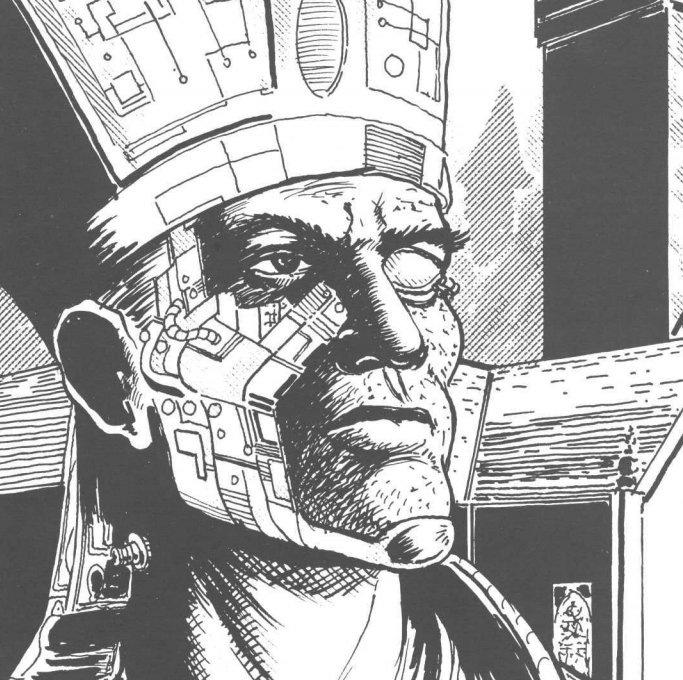
Cyberpope Malraux is power-hungry, corrupt, fanatical, and thoroughly paranoid. He sees heretics and enemies everywhere, and truly believes that God Himself has given him the mandate to conquer. He likes to think that he is a "father figure" to the people of France (he's called "Père Jean" in the media), despite the fact that he is clearly and unapologetically oppressing them. After all, violence in the service of God is not a sin.
Malraux has also rewritten the Bible, "updating" it to take his new beliefs and the new technologies into account. One of the central tenets of the Cyberpapacy is that cybernetics are the "body of Christ". As a result, every actual member of the chuch has some form of cybernetics. The only real exceptions are those operatives who must operate outside the Cyberpapacy (because they risk disconnection), but if anything it makes them more fanatical because they feel the need to prove their devotion without the hardware there to do it for them.
Malraux's overall agenda actually hasn't changed much since his "ascension", and pretty much boils down to one single bullet point:
1. Bring the world under his control and convert everyone to CyberCatholosism. Every single thing he does, long-term or short-term, is to bring this world (and every other) under his "benevolent" control and save their souls. If that means becoming Torg, so be it. But for Malraux, this is a secondary consideration; he really doesn't care if he becomes the Torg or not. What matters is that the righteous shall be saved, and that the heretics will be "saved" via flame and sword and high-powered rifle. The tech surge has added many news tool to his arsenal, such as the "faith chip" that makes people loyal to the church whether they want to be or not. Until he can easily install these chips into the entire population, he makes do with propaganda broadcasts over the national TV networks, showing how he and he alone is capable of protecting the followers of the CyberChurch against the forces of the Antichrist.
It's also worth pointing out that Malraux is pretty much the only High Lord who's delusional about his place in the world. When you get right down to it, all the other High Lords are quite aware that they're the bad guys in this equation. After all, they're the ones who are invading other worlds, subjugating the population, draining the world of Possibility energy, and leaving it a dry husk. Malraux, on the other hand, thinks he's saving people in that old-school Inquisition way. This causes a certain amount of eye-rolling behind his back from the other High Lords, especially when Malraux calls them heathens to their faces.
Axioms
Technology: 26 (formerly 15) - As stated, the Cyberpapacy's new tech axiom makes things like cybernetic limbs, chipware implants, and netrunning possible. Originally, the tech axiom was 15 but most sciences that were possible at that level were forbidden by the church. Now, the church embraces the new technologies. Fortunately, the gap of the change between the old and new axioms was pretty short, so most of France's technological infrastructure was still in place when the tech surge happened and hadn't transformed yet.
It should be pointed out that the new tech axiom has also flowed back up the bridge to Manga Verita. But while the tech level has increased, almost nobody knows it. Malraux has sent agents back home to allow technology to progress at a pace of his choosing, but the actual inhabitants don't realize anything has changed (yet) and are still operating at a feudal level. Malraux's smart enough to realize that an increase in tech back home will destabilize his power base, so he's keeping a tight reign on what the folks back home will learn.
Social: 18 (formerly 13) - The social axiom is a little lower than Core Earth's, due to the fact that the only accepted form of government is the theocracy. Between the Darkness Device staunching development and the fact that they've been unopposed for centuries, the church does not adapt to change well. This is causing a few problems with the tech surge and related effects. In fact, until the recent raising of the social axiom ideas like "personal liberty" weren't possible, but between the Tech Surge and mixing with Core Earth's reality things have actually changed without Malraux's permission. This has allowed something new to occur: rebellion against the church itself. Ideally, the church would want to get the social axiom back to its old levels, but Malraux doesn't seem to want to tamper with the axioms again. Still, the lower social axiom has helped keep people under the thumb of the church and beholden to the theocracy.
The social level is also responsible for the plodding, bureaucratic nature of the church. Those in power are corrupt and complacent, and (again) don't respond well to change. As a result, the CyberChurch isn't really in a position to deal with rebellion because large-scale rebellion has never been possible before.
Spiritual: 14 - The spiritual axiom is higher than that of Core Earth, allowing miracles to be performed. It's not as high as you might expect, however, because in reality faith in God has been replaced by fear of the Church. Even with visible proof of divine power in the form of miracles, people see the Church as a thing to cling to in fear rather than as a way to be better people.
Interestingly, the Cyberpapacy's spiritual axiom is only the fifth highest out of all the realities in the core set; the only two that are lower are Core Earth's and Nippon Tech's.
Magic: 10 - Magic is possible in the Cyberpapacy, but it's not very advanced, especially when compared to realms like the Nile Empire or Aysle. Minor conjurations and the alteration of living things is just barely possible. Unsurprisingly, "witchcraft" is forbidden in the Cyberpapacy, but magic is actually becoming widespread thanks to the sudden availability of mass communication and the ability to transfer knowledge over the GodNet.
World Laws
The Cyberpapacy as four World Laws, none of which have really affected or been affected by the Tech Surge. Only three of them really matter in actual play, though.
The most important one is the The Law of the One True God . It's pretty straightforward: the catholic God is the only true god, He is the only source of divine power, and any other form of worship is heretical. In game terms, this means that people of any faith other than Cybercatholisism have a hard time performing miracles in the Cyberpapacy. The further away the caster is from "core" Cyberpapal doctrine, the harder it is for him to cast a miracle. For instance, a "normal" Catholic priest would have a +1 to his difficulty, a Jewish rabbi would have a +3, and a Buddhist monk would have a +6.
The Law of Heretical Magic is a bit of a double-edged sword. It makes magic more difficult to cast (since it's forbidden), but at the same time makes it more powerful (because it's "powered by evil"). The difficulty of casting any spell in the Cyberpapacy is +3, but a successful spell has its final outcome increased by 5. If you suffer backlash, however, then it's possible an actual demon will show up to try and possess you. Price of sin, I suppose.
The Law of Suspicion means that strangers are not trusted, and everyone is, if not guilty until proven innocent, is at least under close scrutiny. Heretics and agents of the Antichrist are everywhere, after all. Attempts to use the charm or persuasion skills are easier to resist, but at the same time trying to intimidate or taunt someone increases your effective skill by 3.
The Law of Ordeal is part of why the Church is in change, and works thus: "In the Cyberpapal view of the world, the choice of a priest to accuse a character morally obligates the character to prove her innocence through a trial by ordeal. Failure to take the trial is an admission of guilt, and not incidentally, heresy." There are four types of ordeals: having your arms thrust into boiling water, being submerged in frigid water, burning, and trial by combat. If you're actually guilty, then surviving these trials is more difficult, but if you succeed you're considered innocent. If you fail, you're either dead or will be killed as punishment. This is the one that really doesn't work, and feels like it was added solely because they needed a fourth World Law. When Storm Knights get caught during missions, they're not arrested, they're shot at.
Ultimately this all results in a world where suspicion of heresy is enough to get you burned at the stake, where street gangs get cyberarms and implanted guns and pretty much rule the city streets, where angels and demons clash in cyberspace, and where the Church is in every computer, every television, every phone. The Cyberchurch sees all, knows all, and forgives nothing.
But don't worry. As your body is punished, your soul will be saved. And doesn't that make all the pain worth it?
Think carefully before you answer. You are being watched. For your own good, of course.
NEXT TIME: The cyberstructure of the CyberChurch!
CyberCatholicism For Dummies
Original SA post The storm has a name... - Let's Read TORG
Part 11b: CyberCatholicism For Dummies
I've said it before, and I'll probably say it again, but the worldbooks are very poorly organized. The Cyberpapacy book gets into the major power groups before it actually gets into the locations of the realm itself.
Although I suppose in this case, it makes sense. Unlike most of the other realms, the Cyberpapacy has a lot of different organizations operating in its name and inside its borders.
Of course, sitting at the top of the whole shebang is The Avignon Papacy . They've been in charge of Magna Verita for the last 600 years, and Malraux has been in charge of the Papacy for just over 100 years now. Below the Cyberpope is a more traditional papal power structure, but there's little doubt about who's calling the shots.
The papacy itself consists of a number of sub-organizations. First and foremost is the College of the Way , which is (technically) composed of 60 cardinals. In actuality, there's only 40 cardinals at the moment. Of the original 60 cardinals, half were outside of France when the Tech Surge hit. For the 30 cardinals that were at "Ground Zero" if the Surge, things were a little rough. Only 16 of them are left: two fled from the Cyberchurch and are currently in hiding, six were found to be heretics and were installed into spirit chips, two went back to Magna Verita to oversee the cosm, and four cardinals are permanently trapped in the GodNet.
The College's purpose is to manage the rest of the organization for Malraux so he can concentrate on higher concerns, or to act as remote "managers" for the outlying areas of the realm. All the remaining cardinals are completely loyal to Malraux thanks to a combination of belief in the power of God and some rather invasive surgeries.
Church finances are handled by the Apostolic Chamber . It's main purpose is to collect taxes and tithes from around the Papacy and manage these funds in the fight against the Antichrist and his followers. The Chamber has benefited greatly from the Tech Surge, having moved from rooms full of scribes with abacuses and hand calculations to rooms full of hackers manipulating national finances. One of their most important tasks is to keep an eye out for any Kanawa Corporation operations and deal with them before they get rolling.
The Chancery is responsible for the management and dissemination of Papal decrees. In the light of the tech surge, they're also responsible for keeping a record of citizens with legal cyberware. Of course, if you don't have legal cyberware but still want to join the church, you can
Of course, if you want to grease the karmic wheels a bit, you can also pay to have your sins absolved. The going rate for a minor crime is a thousand francs, but large-scale public heresy can cost you up to 25 million. Still, how can you put a price on not getting arrested and tortured by the Inquisition?
The Cyberchurch's legal and bureaucratic needs are handled by The Penitentiary . This branch handles punishments of "smaller" heresies, such as not paying your taxes or failing in your job for the church. They're also responsible for converting heathens, due to their ability to know how far you can go when dealing with said heathens before you commit heresy.
quote:
Père Jean is not one to deny the chance of salvation to his people. Everyone, including Jews, Muslims, the godless and heretics are given a chance to convert. This is a sign of the Cyberpope’s magnanimity. Admittedly they are treated as second-class citizens, who will be ultimately contained within ghettoes and watched carefully to ensure that they embrace the Cyberpope’s teachings completely. Even heretics who willingly confess their heresy and repent are accepted back into the fold.
At least, that's the idea. Unfortunately, Papal tradition gets in the way.
See, when suspicious activity is detected, what is supposed to happen is that a virtual messenger is sent to Babel Central (the church's "core" in the GodNet), giving word to the Council. But there's two problems with this.
First off, and we'll talk more about this later, the GodNet operates at normal human speeds. It's not like Shadowrun or Cyberpunk where a decker can spend two virtual hours hacking a system and in meatspace it took five minutes. If you spend two hours hacking a system in the GodNet, then that takes two hours in meatspace too. Yes, there are virtual vehicles and shortcuts, but it still takes time.
The second problem is that, according to six centuries of Papal tradition, the messenger has to stop at each data exchange along the way to Babel Central to inform the Abbot Monitor there of six things: where he's going, who he's delivering the message to, who the message is from, how long the message is, which exchange he just came from, and which exchange he's going to.
Then, once a week, the Monitor Abbot sends other messengers to each exchange he's connected to with a list of who arrived, where they were going, and so on. The Abbots compare this information with each other to make sure that all the original messenger's information was legit.
It's a very primitive method of error-checking, and wasn't too bad back home where everything was done on paper and on foot, you got maybe two or three messengers a month, and you didn't need an answer right away. Now, though, they're monitoring information across an entire self-contained internet.
As you can imagine, the hackers had a fucking field day with this. Any illegal activity wouldn't even be noticed by the main authorities for at least a week, making it pretty easy to run rings around the early Cyberpapal security systems.
Cardinal-Priest Roger-Bernard, head of the Council of Monitors, realized that this set-up didn't work any more, and got special permission from Malraux to create virtual "seals" that allow messengers to just move through exchanges without having to stop and announce themselves. This has made it possible for the Council of Monitors to actually deal with hackers in "real time", making the battle against these heretics a little more even.
Moving on, we come to the Cyber Council . Headed by Malraux himself, the Council is a collection of scientists and industrialists gathered to advise the CyberPope on the best way to exploit cybernetic technologies. The members of the Cyber Council are the richest people in the realm outside the actual church hierarchy, and are also under the closest scrutiny.
So remember how I talked a few paragraphs ago about how there are four Cardinals trapped in the GodNet? Well, three of these GodNet Cardinals were actually sucked in during the creation of the GodNet and have transformed into virtual archangels. The fourth Cardinal, Cardinal-Bishop August-Challier, entered voluntarily and acts as Marlaux's Legate in cyberspace. August-Challier is ambitious, and sees his existence in the GodNet as a way to expand his own personal power. He's smart enough to not make any overt moves against the CyberPope, especially since the other Cardinals are still fiercely loyal to Malraux.
And now, the moment you've all been waiting for: The Inquisition.
quote:
The Cyberpapacy is geared towards ensuring the subjugation of the flesh to the spiritual will of the Pope. In practice, the Pope is an absolute monarch with the power of life and death over all his subjects. Ultimately, the Inquisition is the body which ensures that society conforms to the Pope’s wishes. Anything else is classified as heresy.
Needless to say, the Inquisition is having none of this backtalk. As far as they're concerned, the church should be the ultimate basis of society and the people within are just there to serve the church. Breaking a law is a direct act against the church, and forfeits your rights as a member. Questioning the church or its methods is "intellectual arrogance" (because you're daring to question the CyberPope), something that is to be burned out at every opportunity. The church is the extension of God's will, and the Inquisition seeks those who would dare to go against God's will or lead others astray, and does so without rest or mercy. Nobody but the CyberPope himself is beyond the reach of the Inquisition.
Guidance for Inquisitors posted:
“Either the heretic confesses and is proved guilty, or he refuses and is equally guilty on the evidence of witnesses. If a heretic confesses the whole of what he has been accused, he is unquestionably guilty of the whole; but if he confesses only a part, he ought to still to be regarded as guilty of the whole, since what he has confessed proves him to be capable of guilt as to the other points of the accusation.
“Bodily torture has ever been found the most salutary and efficient means of leading to spiritual repentance. Therefore, the choice of the most befitting mode of torture is left to the Judge of the Inquisition, who determines according to the age, sex, and the constitution of the party....
“If, notwithstanding, all the means employed, the unfortunate wretch still denies his guilt, he is to be considered as a victim of the Devil: and, as such, deserves no compassion from the servants of God, nor the pity and indulgence of Holy Mother Church: he is a son of perdition. Let him perish among the damned.”
From the Inquisitor’s Black Book
So what exactly is considered "heresy"? Glad you asked!
quote:
“Every human being must do as the Cyberpope tells him. To act otherwise, is to fall into heresy.”
- Cyberpope Jean Malraux I
Heretical Acts:
† Showing disrespect to the Cyberpope and his decrees.
† Eating meat on Fridays.
† Omitting Easter duties.
† Not attending church.
† Reading false Bibles — only the Malraux Bible is true and holy.
† Speaking ill of a cleric.
† Saying it is a sin to persecute for sake of conscience.
† Committing sacrilege, blasphemy, sorcery, or witchcraft.
† Licentious behavior.
† Refusing to pay taxes.
† Sloth in the service of the church.
† Possession of a forbidden book.
† Possession of unsanctified cyberware.
† Accessing the GodNet without the clergy’s permission.
† Living in or visiting Paris, the modern day Sodom and Gomorrah.
† Harboring heretical thoughts.
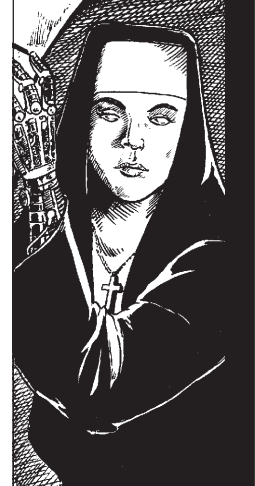
The lower ranks of the church have been affected by the tech surge as well. Cyberpriests and cybernuns exist both inside and outside the GodNet; some were pulled in involuntarily (and permanently) by Ebenuscrux during the GodNet's creation, while others took up the vows later and operate mainly in the real world. No matter how they operate, cyberpriests and cybernuns are the "workforce" of the church, and have jobs in most of the branches of the Papacy. They tend to have large amounts of high-end cyberware and are more resistant to cyberpsychosis than most.
The Church Police are the church's military arm. Monty Python references aside, they're dangerous because for all intents and purposes they're crusaders with high-power firearms. Front-line combatants and hit squads who don't feel the need to even pretend to be secretive, the Church Police are the CyberChurch's strong, sweeping arm and its pitiless, stomping boot. When the CyberChurch wants to make a show of force, these are the people they send in. Related to (but separate from) the Church Police are the Hospitallers , the elite warriors who are used for more advanced or important operations, or to deal with any threat that needs something a little more effective than disposable troops.
So that covers the CyberChurch itself. There are still a few more important factions operating outside of (or against) the church.
For starters, there's a large number of priests who came over from Magna Verita who were horrified at the Tech Surge and the sudden changes in the church overall. Some of the old guard who came over with the initial invasion force refused to "upgrade", and (thanks to the new axioms) have actually managed to rebel and escape the Inquisition's grasp. These preachers travel around CyberFrance proclaiming that Malraux is, in fact, the Antipope and has been corrupted by the forces of darkness. Technically that is indeed what happened, but they're still pretty much bad guys because they're still loyal to the "old" fire-and-brimstone church.
Witchcraft (a.k.a. normal Torg magic) was practiced back on Manga Verita despite the Inquisition's best efforts, and some sorcerers have managed to get to Core Earth to escape the Inquisition and help stop Malraux. They're finding their work difficult, partially due to the way magic works thanks to the Law of Heretical Magic, and partially because the Inquisition now has all these friggin' video cameras everywhere. Still, it can be worth the risk, especially since you can get access to the magics of other realities to grow your own power. Witchcraft has it's own built-in risks, because thanks to the Law of Heretical Magic all spells cast in this realm or back in the cosm are tainted by demonic energies.
The French Armed Forces have pretty much collapsed. When the original axiom wash happened and all their technology stopped working in the face of the invaders, commanders scrambled to seize any supplies they could before they were transformed. Then the Surge happened, causing their equipment to start working again, but by that point the armed forces had splintered into lots of small individual forces. Some of these forces actually gained higher technology thanks to the Surge, and used their advanced weaponry to seize supplies from former allies. Some military units have joined forces with the CyberChurch since they're the current governing force, while others have set themselves up as warlords or brigands, taking advantage of the confusion in the outlying areas of the realm. Other units have set themselves up as the "Militia of Paris Liberté", defending the Paris hardpoint from the Cyberpapacy.
One group that's sort-of allied themselves with the Church is the Hands of God . The HOGs aren't so much an organization as a loose confederacy of neo-facists, survivalists, and right-wing nutjobs. Their main unifying traits are a hatred of foreigners, a return to "traditional values", and a desire to wipe out Jews, blacks, Muslims, liberals, intellectuals, hippies, and other such undesirables. Shortly after the Tech Surge, Malraux sent agents to these various groups to supply them with funding and advanced weaponry. He managed to get the various groups organized (so to speak), pointed them at Paris, and let them loose. HOG members tend to be pretty collateral with their damage, espousing their values and saying they're "trying to save France" as they mow down innocent bystanders and blow up civilian buildings with rocket launchers. They're mainly used by Malraux as a distraction from his own operatives that has the added benefit of wearing down his enemies' defenses. The only reason the HOGs aren't as much of a threat as they might be is because they engage in as much in-fighting as they do attacks against everyone else. In the grand scheme of things, they're cannon fodder. Dangerous cannon fodder, but cannon fodder nonetheless.
It should come as no surprise that the Roman Catholic Church is in a bad place right now. The elements of the Roman Catholic Church that were in France were, unsurprisingly, crushed by the invasion. At first, they declared that the invasion was a hoax, but the Collapse, Tech Surge, and appearance of the CyberPope forced that view to change. The Roman Catholic Church in France actually supported Malraux's inauguration as CyberPope due to the axiom wash, and many more people joined later as they saw actual miracles being performed by the CyberChurch.
Outside of France, things are a little different. The RCC is in direct opposition of the Cyberpapacy; they see the Cyberpapacy as a complete abomination, a society where the word of God is twisted, corrupted, and enforced at gunpoint. Those RCC priests who have braved heading into France to speak against Malraux have either transformed or vanished in one way or another, and the RCC is reluctantly coming around to the idea that they need to approach this in a more militant manner.
It should go without saying that Malraux wants Rome. He wants it so bad he can taste it. He knows that if he can gain control of the seat of Core Earth's Roman Catholic Church it would be a game-changing victory on a lot of levels. As it is, he's declared that Pope John Paul II is in fact Antichrist, setting his followers against him.
The RCC's position is further weakened by the fact that Italy (and therefore Rome) is nearly cut off from the rest of Europe by the Cyberpapal realm, leaving them badly isolated. Not only that, but Malraux is in constant battle with Dr. Mobius for control of the Mediterranean Sea, so Italy is constantly having to deal with the fallout of battles between futuristic naval ships and giant robo-squid-submarines.
Let's take a second to talk about the whole Antichrist thing for a bit. The concept of the Antichrist is a large part of Cyberpapal doctrine and propaganda, and is basically a focal point for Malraux to rail against, an enemy he can point to. Everything Malraux does, he does to stop the forces of the Antichrist from destroying France and the loyal followers of the church. Everything bad that happens, every
And last, but not least, is The Resistance .
quote:
With the overthrow of the legitimate government of France, the Cyberpope looked set to impose his will without opposition. But many refused to meekly accept the fate that lay in store. Liberals, socialists, communists, trade unionists, nationalists, dissident Roman Catholics and members of heretical religions, have banded together to oppose the Cyberpope. They have established a Resistance Movement that seeks to halt and turn back the spread of the Cyberpapacy.
Still, the Resistance has managed to hold its own against Cyberpapal forces because, as stated previously, the church still isn't used to the idea of people rebelling against it yet. It wasn't until the Tech Surge and the mixing of Core Earth's, Kandara's, and Magna Verita's axioms that it was possible for anyone to openly rebel against the Avignon Papacy in the first place.
The church may have high technology, heavy weapons, thousands of loyal troops, and control over the nation's communication networks, but for the most part they still think in their old, established ways. Look at the example above about the messengers, for instance. The habits of 600 years of doctrine aren't easy to break (especially when a Darkness Device is in play preventing societal evolution), and it took a lot of time for someone to realize "hey, maybe we don't need to have a messenger stop at every single exchange , do an infodump, then not check his credentials until the end of the week", whereas someone native to Core Earth would realize what a bad idea that was and come up with a workaround in a matter of minutes.
The Cyberpapacy has numbers and high technology at its disposal, but at its core it's still a large organization that literally hasn't had to deal with change or serious rebellion for centuries. Not only are they being opposed by people for what is (from their point of view) the first time ever, the rebels and heretics are people who can embrace change, have a better understanding of technology (having grown up with most of it), and did this once before against a world-threatening fascist regime. They were pretty damn good at it, too.
Viva La Résistance, bitches.
NEXT TIME: A tour of CyberFrance
A Cybertour of CyberFrance
Original SA post The storm has a name... - Let's Read TORG
Part 11c: A Cybertour of CyberFrance
France has had a rough time of it lately. The invasion of the Cyberpapacy brought not one but two distinct axiom washes, both of which had very heavy effects on the country. First there was the Collapse, where all the technology stopped working, then not long after was the Tech Surge, where Core Earth's technology not only started working again, but advanced by leaps and bounds.
Before we get too deep into that, though, let's take a look at the realm map.
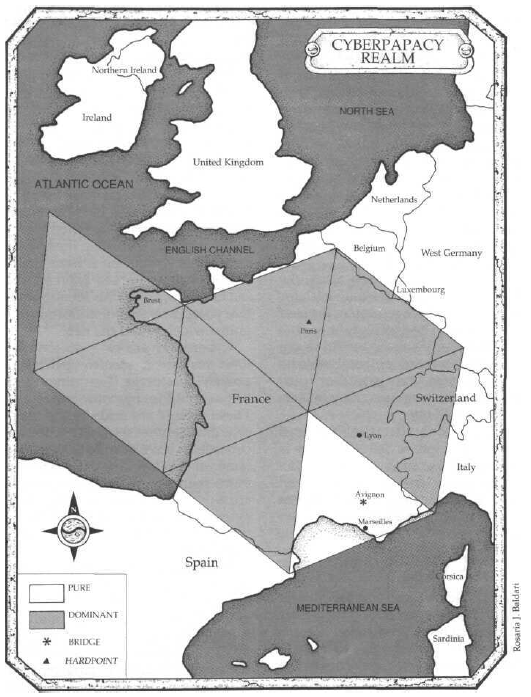
The Cyberpapacy, about three weeks after the initial invasion.
The Cyberpapacy is the smallest of all the realms, barely extending outside the borders of France (although between the core set and the release of the sourcebook they actually manage to extend a zone into Spain). It's also in a very bad position: the map doesn't show it, but the Cyberpapacy is boxed in both to the north (by Aysle) and south (by the Nile Empire).
Aysle's borders go right up to the English Channel, meaning that at some points there's literally only a few miles between the Ayslish and Cyberpapal borders. The proximity of the two realities (three, if you count Core Earth) means that the English Channel is one big perpetual reality storm with the added bonus of sea monsters. The proximity between the two realms was actually done on purpose, because Malraux had allied himself with Uthirion, Aysle's former High Lord. The two became allies due to "a common interest in pain" (Malraux because it purifies the soul, Uthirion because he was a sadistic fuck), but the recent ousting of Uthirion has put a bit of a crimp in the alliance.
The Nile Empire is a little further away, being on the far side of the Mediterranean Sea, but that doesn't mean Mobius isn't a problem. There is constant warfare between Malraux and Mobius over control of the Mediterranean, and while the Cyberpapacy has the better technology, Malraux can't keep up with the insane creations of Dr. Mobius. Especially since Mobius actually has a better grip on technology than the Cyberpapacy does.
So that leaves the east and west for expansion. Expanding to the west is possible, but ultimately a dead end once you reach Portugal. And standing in the way to the east is Germany, and that's become a problem.
Remember, Torg originally takes place in 1990. At this point, Germany had literally just reunified , and now all of a sudden they've found themselves as the only thing stopping the Cyberpapacy from expanding into eastern Europe and Russia. But we'll get more into that when I'm done with the "core" realms and talk about Core Earth in general.
So let's get back to France, and talk abou the Collapse and the Tech Surge.
Malraux's maelstrom bridge did not drop down upon Core Earth's Avignon, but instead dug up into the dungeons and basements of the city. When the bridge "dropped", all Core Earth technology just...stopped working. Electricity ceased to flow, engines failed, and essential services collapsed. Millions were killed as planes died in mid-flight, hospitals went dark, and the population began to riot.
This was, of course, all according to Malraux's plan.
As part of the initial prep work for the invasion, Malraux sent his own agents to Earth via dimthread to start converting people to Magna Verita's version of Christianity so he'd have enough believers to power the stelae. In the outlaying areas where Malraux had converted the population, things weren't as bad. In the major metropolitan areas, it was a different story. Lack of technology meant lack of communications, so hysteria spread through France rapidly as theories ranging from "World War Three" to "The Antichrist" were bandied about.
And into this chaos came the Church, ready to help the needy and to ease the suffering.
Malraux's Church was ready to start seizing control right away, and had organized many right-wing groups to act as muscle (c.f. the Hands of God). Roman Catholic priests who were stuck in the realm were a high-priority target for the Church, in order to cement Malraux's "God" as the One True God.
Just over a month after the initial invasion, the Church's forces converged on Paris. Paris is a Core Earth hardpoint, and as a result it was vital for Malraux to take it down. His forces burst through the city's defensive forces, and attacked the National Assembly without mercy.
quote:
Seizing the outer chambers, they set fire to the building and mercilessly turned their guns on those fleeing from the inferno. A Papal Legate proclaimed that the Church was now in control. The savior was coming in the form of the Pope. France would be safe from the Antichrist now that the godless socialists had been destroyed.
As he waited in what the Core Earthers called the "Dreamtime" for the correct moment to arrive on his bridge of light, he was waylaid by Storm Knights.
This is the attack by Dr. Hachi Mara-Two I talked about back here ; the sudden vision of the high-tech reality taking place in a spiritual realm had a severe effect on Malraux. Seeing this as a "vision from God", Malraux's personal axioms were altered to a mix of Magna Verita's and Kandara's.
When Malraux entered the new realm, he carried these new axioms with him. Powered by the Darkness Device, a second axiom wash occurred across the realm. Technology that had ceased functioning came back to life, devices that had been transformed completely by the initial invasion changed back, and Possibility-rated people found themselves fluctuating between the two axiom sets.
It took surprisingly little time for the changes to settle, but once they did a new reality was formed; a mix of medieval mindsets and high technology ruled now; the Church was no more, and the Cyberpapacy took its place.
The Church has adapted surprisingly well to the new situation. Not perfectly, as established previously, but the axiom wash and Malraux's tight grip on the church power structures have kept it in control of France throughout the changes. The main linchpin of Malraux's control is, of course, the GodNet.
quote:
Information contained within the GodNet was at first fragmentary and confused. Thanks to the work of the cyberpriests, data has been collated and systemized within the vast data bases of the GodNet. The Cyberpope now has instant access to information detailing the extent and structure of his new realm. Confident in its workings, the Cyberpope has decreed that all loyal Catholics will be connected to the GodNet and their activities monitored by it. Information is currently being compiled on the activities and locations of all heretics and opposition groups. The Cyberpope is tightening his grip to create the perfect totalitarian state.
quote:
The Malraux Bible was the first order of business for Père Jean, and it encapsulates the Cyberpope’s message of salvation through Cybernetics. It is based upon the Julian Bible of Magna Verita, but adds a final book: the Cybernetic Vision.
Within its pages, the vision experienced by Jean Malraux when the dataplate, Dream Time and his mind interacted is described in lurid terms. The Cyberpope’s role as saviour of the world and the threat posed by the Antichrist is elaborated in great detail. Its message is clear: Salvation is only possible through complete acceptance of the Cyberpope’s teachings and the power of the GodNet. To reject the new technology is to reject hope itself.
God has provided the GodNet for His people. It is the Cyberpope’s task to bring everyone into the fold.
So we've talked about the GodNet, but haven't really said what it is yet.
When Mara-Two slapped the dataplate onto Malraux, he wasn't the only one overcome with visions. Ebenuscrux, his Darkness Device, also saw the visions of Kadandra. While the visions were strange to it as well, it was better equipped to analyze and understand them than its master was. Where Malraux saw "the face of God", Ebenuscrux saw a tool that could be used to spread misery and destruction. As the second axiom wash happened, Ebenuscrux began to create a sort of sub-reality in the restored telecommunication systems and technology. It was like weaving a web, with the Darkness Device at the center and symbology drawn from its master's mind.
quote:
When it had finished, it had created a matrix of data and communication comprised of biblical images. Databases and computers took on the shapes of religious buildings. Huge Gothic cathedrals came into being in its cyber landscape. Churches and shrines appeared which held less important data. In the center, where the arms of the cross met, it raised a cybernetic Tower of Babel. Signals are routed through and monitored through here. In Avignon, monitor screens and cyberdecks were established to allow the cyberpriests to watch over this new tool of Papal power.
So what does this all mean for the inhabitants of the CyberPapacy? What's life like in modern day CyberFrance for the millions of ords?
It should go without saying that life in France has changed pretty drastically since the invasion. For the people who live in the cities, or who can afford all the new things the increased Tech axiom allows, the standard of living has actually improved, and these people are more capable of dealing with the dangers the new world puts in front of them. Those who cannot, however, find themselves in a pretty bad position.
CyberFrance is isolated from the rest of the world in several senses of the phrase. The entire country is surrounded by reality storms, and is (again) boxed in by Asyle and the Nile Empire. This makes it difficult, if not impossible, to get basic supplies shipped in from other countries.
The biggest issue this has caused is the lack of oil and gasoline. Cars are basically luxury items now, because oil shipments can't get into the country. It doesn't help that most of the oil in the world is currently controlled by either the Middle East (who are heathens) or by Mobius (who Malraux hates with a fiery passion), of course. Electric-powered cars are starting to become available to the populace at large, but as it stands now most Core Earth vehicles are out of the picture.
The Collapse did a number on the existing industries, of course, but the Tech Surge just compounded the problem with the advent of cyberdecks. Factories and large-scale services came back online, but now are either fully automated or can be done by a few people with cyberdecks instead of a full-fledged workforce. Millions are out of work, and the economy is suffering for it.
One good thing that happened in the wake of the Tech Surge is the transformation of existing electric and nuclear power plants into more powerful and safer power production. Basic services (like electricity) are provided free to every home now.
Rural France has remained pretty much the same for the most part. There's a larger pressure on the farms to produce since they're the sole food producers for the realm, and as a result farms and rural areas tend to be targets for gangs, rebels, and thugs working under the umbrella of the CyberChurch. The Cyberpapacy has a strong hold on these regions thanks to the protection they offer the "farm belt".
Unfortunately, the lack of food production is taking its toll on the urban centers. Food riots are not uncommon, and the Cyberpapacy doesn't tend to intervene unless church property is directly threatened. The Church has even been known to instigate a riot or two on its own, blaming Jews, Muslims, and other assorted "heretics". The Cyberchurch sees the riots as a sort of pressure release for the population, and if a few
The GodNet (and, by extension, the CyberPapacy) is also isolated from the rest of the world. The GodNet doesn't connect to any outside data resource or communication network; it is completely and intentionally off Core Earth's global grid. This means that the Internet, television, phones, even radio transmissions from outside France can't get into the country. The Church has a hard lock on what information is available to the public, with the news networks filtering any major news events through their needs. Most major news events from the "outside world" are spun to seem worse than they are, are attributed to the forces of the Antichrist, and reinforce how only the Cyberpope can protect his people from the evils of the rest of the world.
Of course, the Cyberpapacy has a few other ways of keeping the populace in line. The big three are Faith Chips, Homers, and HolyVids.
Homers are small implanted devices that transmit basic homing signals to a range of 25 km, which can be (and are) recorded in the GodNet. If you have a homer installed, then the Church will always know where you are, where you've been, and will probably have some suggestions on where you're going to end up.
HolyVids are mass-produced "entertainment systems" that are distributed to the faithful once they prove themselves "worthy". HolyVids are simple virtual reality systems that plug directly into the GodNet. You don't need cyberjacks to use them, so they're safe for the whole family! A HolyVid allows the users to project themselves into fully immersive recreations of Biblical events, allowing the faithful to experience them first-hand as if they were really there. It should come as no surprise that HolyVids are psychologically addictive, and contain subliminal messages that let the Church control the flock. These devices are the most widespread of the three main control points, because they don't require the user be cybered to use it. On top of that, they're becoming popular means of escapism in a rapidly deteriorating society.
But the worst of the three are Faith Chips ; these datachips are installed directly onto a person's cyber-control system (i.e., the spine/brainstem region), and cannot be removed without major surgery. A Faith chip broadcasts the Cyberpapacy's beliefs and doctrines directly into the victim's brain, making him a fanatical follower of Malraux who will kill or die for the Church without question or hesitation. When you're fitted with a Faith Chip, you fully believe in the threat posed by the Antichrist, and that only the Cyberpope is capable of saving the world from it. Trying to perform any action that goes against Cyberpapal doctrine requires a very difficult Spirit check to perform. Failing the check means you have to follow doctrine. But don't worry. Sooner or later, you'll love it.
Ultimately, Malraux wants to install Faith Chips and homers in the entire Cyberpapal population, and eventually in everyone in the world. As stated previously, he doesn't care so much about becoming Torg; his goal is controlling the world (for its own good, of course).
Now, at this point in the chapter, there's a bunch of stuff about all the individual provinces in CyberFrance. It's another case of things not being presented in a logical manner; we go from background to "life in CyberFrance" for about two minutes now we're in a province-by-province breakdown of what's going on across the country. This whole part of the chapter can be summed up as follows:
1. The city of Avignon, the capital of the Cyberpapacy, is expanding rapidly.
2. The farming areas are pretty much under Cyberpapal control, and the Church is trying to meet demand by applying new technologies to farming, with mixed results.
3. In the industrial areas, unemployment is at an all-time high thanks to the new technologies. One guy with a cyberdeck can control a whole factory now, so who needs workers? It doesn't help that unions are considered "heretical".
4. The Resistance has been gaining strength on the outskirts of France.
The situation in Belgium deserves special mention, though.
quote:
The stelae planted in western Belgium isolate the Belgian coal fields from the industries of Brussels. Fierce reality storms have set fire to the underlying coal seams turning the west of Belgium into a raging inferno. Thousands of Belgians have been killed in the resulting disaster and now lead a precarious existence amongst the smoking ruins.
The Cyberpapacy’s policy is to maintain this area as living representation of Hell in order to further its claims that the Antichrist continues to assail France.
The GodNet does get its own sourcebook (which I'll talk about in more detail later), but for now let's cover the basics. The GodNet is France's Internet, and is completely cut off from the rest of the world. Due to the Tech Surge, people are able to interface with it through cyberdecks, and view it as a 3-dimensional "virtual experience" (VX for short). Churches, Cathedrals, and Monasteries act as system relay points, data centers, and network control points.
Because of this, and the importance placed on the GodNet, data cathedrals and churches are rapidly becoming the central focus of most communities.
quote:
The concept of a neighborhood is undergoing rapid change. Now the center of the neighborhood is the cathedral, even more than it was in medieval times. Everyone connected to the GodNet is two short exchanges away from a meeting place for thousands of people, and similarly connected to hundreds of businesses. Mass at a cathedral has become a focal social point for hundreds of thousands of French citizens. They go to Mass, enjoy the sense of awe and belonging which is magnified many times by the nature of the GodNet, and then meet friends who might live hours away by car. Their own image is more attractive in the VX environment, and they feel themselves more capable. This facet of the GodNet gives Jean Malraux I a seductive and powerful tool for getting the French citizenry to voluntarily and loyally join his cause.
And that's the "Cathedrals and Monasteries" section of the chapter! From there we logically move to Getting Around .
France is a big country, and since it's pretty much cut off from the rest of the world now transport is...tricky.
Normal air service everywhere in France is pretty much done. Between the lack of fuel and the constant weird weather, it's just not practical anymore. The Cyberpapacy is trying to introduce new planes with alternate fuel sources, but for the most part that effort is going into combat jets. People who own chartered planes are still going about their business, but again the lack of fuel is driving prices up.
Ground services haven't fared much better. The Collapse didn't do wonders for the road system, and even after the Tech Surge fixing the roads wasn't really a high priority. Cars are rapidly becoming luxury items, and (again) alternate fuel sources are being rolled out slowly.
The only mass transit system that's still working is the rail system. If anything, it's improved thanks to the Tech Surge allowing bullet trains that are faster and safer than Core Earth's.
I do want to point out that there's a map in the book that shows all of France's major roads, and another that shows all the rail lines. Previously, there was a map of all of France's provinces. I just find that quaint, a relic of a time before you could just type "France maps" in Google and get all the maps you want. But it's also an unnecessary addition; does anyone really care what the "real" roads are, and what connects to what? I can't imagine some player going "wait, you can't just drive from East Generic Village to Otherville! MY IMMERSION!" It's just another example of Torg's ridiculous need for detail nobody wanted, made even funnier by the fact that this is the only realm book that has maps like this.
I am ten pages into this chapter.
The next section is about Avignon, and it's not much we don't already know. The city is expanding rapidly due to new cyberware factories being built and the assorted needs of the thousands of pilgrims streaming into the city. Avignon is a historical city; the papacy was located there from the early 1300's to the early 1400's, so there's a lot of old buildings reflecting the ancient glory of the church.
As you can imagine, Malraux has "improved" on that.
Ancient frescoes have been replaced with holographic projections. The Palace of Popes has had a monitor tower attached to it, broadcasting the word of Malraux across the skyline. The bell tower of the Avignon cathedral has been replaced with a giant glowing cross visible from anywhere in the city.
Subtle, it is not.
The next part of the chapter is a "typical locations" deal again, and you'll forgive me for not getting into too much detail here. Provided are maps and NPCs for a Cyberlegger Hideout (basically a street doc/chopshop), a GodWare hospital (complete with techpriests, innocent patients, and cyberboosted guard dogs), and Church Police Checkpoints. Interestingly, we don't get sample cathedrals or other places where you'd go to actually deal with Cyberpapal personnel or get your cyberhack on; those are in the GodNet book.
The last part of the chapter is about how CyberFrance gets along with its European neighbors. As you can imagine, it's "not well".
Germany is probably in the best and worst position. Unification had just happened when the invasion hit, and they were not ready to deal with a major national threat at all . They had a few NATO forces available, but sending modern troops into Collapsed France didn't work out so well. Falling back from the French border, the German and NATO forces got a front-row seat for the Tech Surge. It wasn't long after the Surge that the CyberPapal forces attacked in earnest: demons and cybered-up troopers poured over the border.
But by this point, people had started to get a handle on how reality mechanics worked. German forces basically played a defensive game; they'd "retreat" while fighting, drawing Cyberpapal forces deeper into Core Earth and wait for them to disconnect. Germany couldn't really attack in the traditional sense, but they could at least hold the line.
As it stands now, Germany has found itself awkwardly trust into the role of "major world power". It's no secret that Germany is pretty much the only thing between Malraux and Russia, and thus has found itself as a launching point for Storm Knights who want to get in on the action in the Cyberpapacy, Aysle, or the Nile Empire. The main focus now is on defense; missile silos are rapidly being set up along the western border, and there's a greater push on industrial production. In fact, due to North America and most of Europe being off the grid, Germany has also found itself becoming a major player in the world economy. Fortunately, the Japanese government has been helping out with that, giving them money and helping improve their technological frameworks. It's a good thing the Kanawa Corporation is there to help, huh?
Luxembourg didn't make out quite as well as Germany. Between the reality storms sweeping through the tiny country and the almost constant influx of refugees from France, the government has pretty much collapsed. NATO troops tried to get things under control, but they're not having much luck since they need to focus more on keeping Germany strong. At this point, Luxembourg is pretty much a done deal as a nation.
Italy isn't having a much better time. Italy isn't completely off from the rest of Europe, but the Cyberpapacy controls about half of the national border, plus Italy has to deal with being stuck in the middle of the wars over control of the Mediterranean Sea. The other problem is that the Roman Catholic Church is Malraux's primary target. Malraux has declared that Pope John Paul II is the Antichrist, and taking out the Roman Catholic Church (or better, converting it) is at the top of Malraux's to-do list. Rome, for its part, has declared that Malraux is "an abomination under God" and is currently engaged in propaganda wars throughout Italy. Unfortunately, the Cyberpapacy backs it propaganda up with assassinations and mass violence, and the Roman Catholic Church is having a hard time adjusting to needing to hire mercenaries and Storm Knights. The recent awakening of Core Earth's spiritual power has helped, though.
quote:
Miracle at Saint Peter’s Square
At the Vatican, the Pope holds masses more frequently, and miracles are commonly reported. His public appearances and speeches have helped greatly to bolster the hopes of the faithful. Since the Possibility Wars began, the Roman Pope’s verve and charisma seemed to have increased dramatically. During one mass, the Pope was attacked by four hospitallers masquerading as pilgrims. The assailants made quick work of the Swiss Guards who tried to intervene, but as each hospitaller attacked the Pope, his cyberware failed. Fatally. Roman Catholics everywhere have taken this incident as the surest sign that God is on their side.
The Netherlands got hit hard by reality storm-powered tidal waves that were created by the insanely close proximity of the Ayslish and Cyberpapal borders. The waves actually reached as far inland as Amsterdam, destroying most of the city. The Netherlands, like Luxembourg, are devistated. People are abandoning the country en masse as anrachy reigns.
Switzerland is slowly falling to Cyberpapal influence. The government hasn't been very effecting in dealing with the destruction the invasion caused, and lynching of "heretics" is becoming more widespread thanks to Cyberpapal agents.
Spain is pretty much fucked. Completely cut off from Europe, and with the Cyberpapacy already getting a foothold, the country tries to hold onto their faith and resist the invaders as best they can. In fact, Spain is one of the few countries that seem to be able to resist Cyberpapal doctrine. Spain has enacted a sealed-border policy, letting nobody into the country. Unfortunately, agents of the College of the Way managed to get into Spain before the border was closed, and are slowly worming their way into the lives of the people.
As for the rest of the world...well, Malraux knows he needs to keep his physical forces focused on Europe. He also knows that Core Earth religious artifacts have probably transformed into hardpoints or eternity shards, so any forces he has that aren't trying to take the rest of Europe or stomp Mobius are dedicated to artifact hunting. Outside Europe, the Cyberpapacy is focusing on winning hearts and minds. Healing miracles are used in front of as many people (particularly Catholics) as possible in an attempt to undermine the Roman Catholic Church's spiritual base, and high-tech medical procedures and alternate power solutions are winning over the atheists.
---
And...done.
This is a long-ass chapter. Well, technically it's not, it's only 20 pages. But it feels a lot longer than it is. It once again suffers from the two main problems that plague the Torg sourcebooks: there's too much goddamn detail you'll probably never use, and it's not presented in any kind of logical order. I don't need to know what's going on in every single province in France; just give me a quick list of common problems and little things like "in northeastern France the farms are having a lot of trouble with bandits and Cyberpapal forces clashing" and we're good. Don't bounce from background to maps to the GodNet to talking about trains. None of it follows!
Still, this is probably the roughest part of the book to get through, so hopefully things will get more interesting from here.
NEXT TIME: The Free City of Paris
Paris Liberté with Cheese
Original SA post The storm has a name... - Let's Read TORG
Part 11d: Paris Liberté with Cheese
This is a surprisingly short chapter, especially given the density of info the last one. And again, it's a bit of an artifact of an earlier time where you didn't have the ability to just go onto Google or Wikipedia and get basic information about a country, like population breakdown or the layout of the metro system.
Of course, I'm not going to cover that stuff because nobody gives a shit. Instead, I'm going to talk about the changes the invasion has had on the city.
As stated previously, Paris (to be specific, the Eiffel Tower) is a Core Earth hardpoint. Core Earth's axioms still hold sway in the city, and have since the initial invasion.
That's not to say that Paris weathered the Collapse without a problem, of course. When Malraux dropped his bridge, all of France except Paris started dropping off the grid. There was no way to contact people outside the city to see what the hell was going on, world communication was cut off, and it wasn't long before people started to panic. Many people fled the city out of fear or to find out what happened to loved ones in the outlying areas, only to find castles, manor houses, and carts where suburban areas once stood.
It didn't take long for people to find out that Paris wasn't changing like the rest of the country, and thousands headed there to seek shelter from the changing reality. Papal forces managed to infiltrate the city by coming in with the waves of refugees, and took out the city leaders as discussed in the previous chapter.
Not that they needed to do much to destabilize the city, really. Core services collapsed due to the lack of technological or financial support. Supplies dwindled rapidly, and it was impossible to get basic needs like food from outside the city. Gang warfare became common over such important locations as gas stations and food warehouses. The Hands of God did their part, too, egging on conflict and just flat-out wrecking shit.
Things went from bad to worse when the food supplies started running out. Rationing was instituted, for all the good it did. It wasn't long before people started fighting to the death over food, then pet food, then pets, then any animal you could catch and cook.
By the time the Tech Surge came around, the damage was done. Still cut off from the rest of the world, the citizens of Paris eek out a tenuous existence surrounded by the enemy.
That's the Paris of the Near Now: once one of the most spectacular cities in the world, now reduced to a post-apocalyptic wreck.
With the fall of the French government, Paris has had to set up its own government. In response to the insanely right-wing forces taking over the rest of the country, a body of liberals, communists, and socialists was rapidly elected into office. The leadership of Paris is called "The Commune", and they wasted no time organizing people to fight back against the HOGs and Church forces. It took a lot of fighting, but eventually the Church's forces were driven out of the city. Despite the victory over Malraux, things are still pretty shaky for the Commune. Basic supplies are still hard to come by, refugees still pour into the city, Cyberpapal forces still attack the outlaying areas.
The peacekeeping force in Paris is the "Paris Liberté Militia" (PLM), and is a militia in the traditional sense: citizens who are willing to take up arms in defense of what's theirs. If these folks have their own guns, so much the better. PLM "troops" patrol the streets in small groups searching for Cyberchurch agents and keeping the numerous gangs at bay.
The PLM has no standard uniform or gear. They identify themselves by wearing red armbands on their left arm and using whatever weapons or defensive gear they can scrounge. They're headquartered just outside the Eiffel Tower.
It should be pointed out that while not well-equipped for the most part, the PLM do have access to twelve tanks (two of which are mobile), four functioning Apache helicopters, and sixteen missile sites. Obviously, none of these see any regular use; they're pretty much all for emergency use only. Despite all that, Paris's best defense is still the reality storm raging around the city.
The population of post-invasion Paris is just over 13 million people. Which doesn't seem so bad until you realize that the population just before the invasion was 10.5 million. Needless to say, that much of a jump in a few months means there's not a lot of free space in Paris right now. Refugee camps are set up anywhere you can stick three tents together, and the strain is being felt on basic human services.
Life in Paris is nasty, brutish, and short. Street gangs and leftover HOG forces roam the streets battling for territory and supplies, not caring who gets caught in the crossfire. The Metro no longer runs due to being too expensive to operate, and the tunnels have been taken over by punks and nutbags who've been driven off the streets. Any building large enough to hold people is used as shelter, even if that wasn't the original purpose. Landmarks like the Louvre and Le Pantheon have become overcrowded shelters. Outside the borders of the City, Church Police forces keep anyone from leaving the city, while at the same time ushering refugees into Paris, putting further strain on a city that's one bad day away from collapse already. The overcrowding has also put a strain on everyone's general health; lack of medical supplies combined with forced close quarters means that disease runs rampant, with cholera and typhoid making big comebacks.
Despite all this, Paris remains free. Yes, it's overcrowded and starving, but the people of Paris have a unique viewpoint on it: they may be trapped, staving, and surrounded by the enemy, but their souls are still theirs. The people of Paris refuse to give in to hopelessness or despair. They're not going to let some monster who thinks he's the mouthpiece of God control their souls. The Marseille is played on public address systems throughout the city, and the French flag still flies from the top of the Eiffel Tower. They may be trapped and beset on all sides by an insane tyrant representing the worst of both the past and the future, but the people of Paris aren't going down without a fight.
Viva Liberté indeed.
The Eiffel Tower is the hardpoint that keeps Paris working as a Core Earth zone. Everything within about 100 meters is a pure zone, and beyond that it's Core Earth dominant to about 4 kilometers. Sometimes the reality storms shift, and the effect can go out as far as 6 km. Reality storms rage around Paris 24/7, and on occasion they ground themselves out as electrical storms on the Eiffel Tower. When this happens, the storms have been known to blow the tops off the larger buildings in the city.
The reality storms in and around Paris are a little different than most. While most reality storms strike with impunity and without direction, the ones around Paris seem to target the invading forces rather than Core Earthers. Nobody knows why this is (the top theories are that the storms are reacting to the population's desire for freedom, or that it's a sign from God), but every little bit helps, right? This actually has a mechanical effect in that anyone from Core Earth who gets involved in one of these storms has a +3 bonus to their reality total, and folks from the Cyberpapacy have any damage value caused by the storm increased by 3.
Because most of Paris is a dominant zone, cybernetics and related technologies still work there. Cyberleggers have begun setting up shop on the outskirts of the city, getting "supplies" from dead Cyberpapal agents and dealing mainly with the street gangs. Most cyberware in Paris is subdermal; nobody wants to look like they work for Malraux if they can help it unless they actually want to get lynched. Still, in the rougher areas of Paris it's nice to have a set of cyberclaws or a skinweave to give yourself a bit of an edge. And, of course, the gangs like to go full chrome anyway because otherwise what's the point?
Now, the next few pages are just general info about Paris, but it's nothing you couldn't look up on Wikipedia or Google Maps. So I'm going to skip them and get to the part you really want to know about : Cybergangs of Paris !
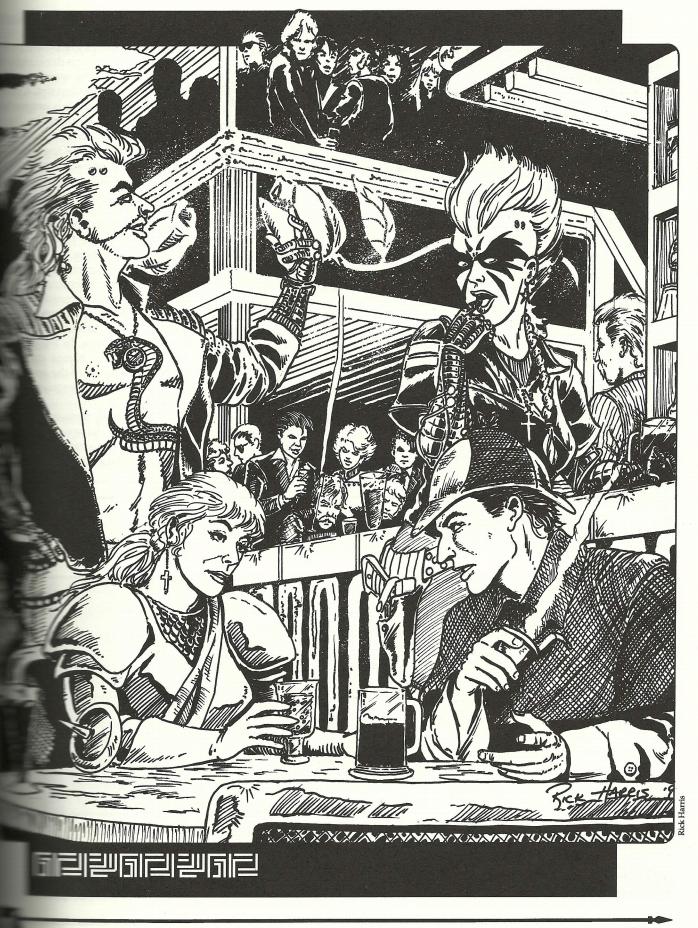
Cyberpunks in their native habitat, fighting against the machine.
Oh come on, like you didn't know that was coming at some point.
Any major city has gangs. But when the city is hit by a sudden spike in technology and a downturn in overall quality, the street gangs upgrade to cyberpunks. And these are totally 90's RPG cyberpunks, with the weird outfits and gimmicks and everything. This is street trash mixed with Generic 90's Cyberpunk then dumped into The Warriors. Seriously, the Baseball Furies would not be that out of place here. Just give them, like cyberbats or something.
One thing I haven't mentioned yet about the Cyberpapacy is West End's attempt at coming up with cyberslang. You know how bad they were with humor? They're not any better with this stuff.
I did not change a word of this posted posted:
Crimes against the citizens of Paris began with the normal theft and muggings. Then came drugs. Then came zipyanks, murders in which the victim’s organs or cyberware were removed for sale; fry-bys, where punks drive by citizens and attack them with energy weapons modified so as to ignite the victim; grabaways, where the victims, usually entire families, are kidnapped and assaulted.
The PLM cannot stop the all gang activity, so they're forced to prioritize its responses. Muggings and thefts are ignored, and zipyanks are tolerated as long as an unofficial “quota” is not exceeded. However they, and Paris at large, draw the line at grabaways and fry-bys. These crimes provoke a considerable response. Most PLM members consider such crimes reprehensible enough to dispose of any legal niceties they are supposed to observe as law enforcement officers. Mob justice has been invoked, and at least one gang, the NazBoys, was hunted to extinction after a rash of grabaways.
God, I feel so stupid just using those slang terms.
Anyway. We get the down-low (as it were) on six of Paris's biggest cyberstreetgangs. Street cybergangs? Whatever, let's just enjoy this glimpse back to an earlier age.
First up are The Sun Kings and Queens , who, and I quote, "are streetwise posers who dress in the style of Ancièn France with pomaded wigs, chalked faces (complete with beauty spots) and elegant clothing."

Pictured: A Cyberpunk
Regardless of how they dress, Sun Kings and Queens are usually pretty cyber-ed up and are good fighters. They control the docks of Paris, and anyone dumb enough to enter their territory while possessing cyberware will quickly find themselves swarmed by gangers and dragged to the local cyberlegger to be stripped for parts. Their normal activities boil down to protection rackets and "sin-palaces". They also have a small presence in the GodNet, and their data base (yes, that's what it's called) is a virtual recreation of the Palace of Versailles.
The current leader of the Sun Kings and Queens is Louis XIV; the leader of the gang is always called Louis or Marie. They're nothing if not unoriginal. For some reason, the "number" of the leader always counts down, not up. Also for some reason a map for the Sun King and Queens' HQ is provided.
Next up are the Carrion Dogs . As I'm sure you can all guess, these guys are all street-wolf-ish, dressing in dirty rags and living it up on the streets. Every member has fangs, and most have either slicers (finger- or toe-blades) or slashers (forearm blades). They'd be considered a pretty bad joke if it weren't for two factors: one, they're pretty much all cannibals and like pack-hunting innocent people, and two, they all have modified their fangs to inject victims with rabies. Yes, rabies. Unfortunately for the Dogs, most of their cyberware is so low-quality that the disease holders leak and the majority of the gang members have rabies themselves. If it wasn't for the secret backing of the Cyberpapacy, these guys probably would have died out on their own a long time ago.
Like all true cyberpunks, the Crucifaces have large brightly-colored hairdos and tattered leathers. They also paint crosses on their faces with the crosspiece going across their eyes. They also favor slicers/slashers, or just normal knives if they can't get the tech, and perform what can be best described as "basic level" street crimes. You know, muggings and shakedowns. And that's pretty much it for these guys. No idea why they're here because they get no info beyond "they exist" and "they dress like this".
And we move into Obvious Pun territory with the Warewolves . The Warewolves are obsessed with cyberware, installing as much as their bodies (and souls, but we'll get to that later) can handle, and then tagging on a few extra parts just to be on the safe side. They get most of their cyberware through theft or (ugh) zipyanking. Their "emblem" is a side view of a howling wolf's head stitched out in metallic thread, and they hang out around the edge of the dominant zone because I guess they like the thrill of knowing that if they disconnect they'll probably die?
Next, there's The Tri's . And yes, the apostrophe is there; it's because they wear the French tricolor on their jackets as their "gang symbol" as a representation of their defiance of Malraux. Not that they're allied with Paris; a full 95% of their crimes are committed against the Parisian public. It's more the idea of their leader Anne Druillard; she figures that with everything going on, Paris is going to focus on the more serious threats. So she sets her gang up as "Robin Hood" style bandits, working with the PLM to fight other gangs, organizing very public attacks against the Cyberpapacy, and so on. So far it seems to be working in her favor, even though her tactics tend to get a lot of her own people killed. But hey, plenty more where they came from.
We close out the chapter with the last "gang": Spacers and Crazies . Well, they're not really a gang, just a convenient category for the various nutjobs and burnouts that litter the streets. Spacers are people who've fried their brains out on drugs or who've succumbed to cyberpsychosis. These are the ones who live on diets of drugs to ease the pain of life, and will kill whoever they need to to get the money to buy said drugs. Crazies are people whose minds snapped after the two reality shifts, or who can't handle the joy that is life in modern-day Paris. A lot of crazies have dangerous cyberware (somehow), and more and more appear on the streets thanks to the Cyberpope funneling them into the city.
So yeah, there's cybershit all over the streets now. And I just have to say I love the fact that Paris itself gets less book time than the rest of France, even though it's a pretty important place in the scheme of things.
At this point, though, we're pretty much done with the setting stuff so it's time to start getting into the mechanical side! I can't wait!
NEXT TIME: Axiomatical!
World Laws and/or Reality Storms
Original SA postThe storm has a name... - Let's Read TORG

Part 11e: World Laws and/or Reality Storms
Time to start digging into the mechanical side of the Cyberpapacy, and that means we start by talking about the realm's axioms and world laws. I covered this stuff briefly in the first Cyberpapacy post, but now we're going to get into a little more detail.
The axioms of the Cyberpapacy have been bouncing up and down thanks to the Collapse and the Tech Surge. The Cyberpapacy is currently a rough mix of the axioms of Magna Verita, Core Earth, and Kadandra. All of the Cyberpapal axioms were affected in one way or another, and in a lot of ways the culture is still catching up. The Church hasn't had to deal with real change for literally centuries, so while they are adapting to the new technology available, the other changes are making their lives difficult.
The Magic axiom is 10, allowing for full-on spellcasting, enchanted items, and witches turning people into toads. It's also just high enough to allow for the existence of supernatural creatures such as gargoyles, and magic is even capable of affecting the GodNet. For the most part, magic hasn't changed that much from Magna Verita's original level, although the increase from Core Earth's magic axiom has caused more mages to appear in France.
It should be pointed out that the general public at large is aware of the existence of magic, but according to Cyberpapal doctrine magic is the work of the Devil. Witch hunts are common, and even being suspected of being a practitioner of magic is enough to get you burned at the stake. Literally. That's a thing that happens with disturbing regularity
The Social axiom is 18, which is actually a little lower than Core Earth's (21), but is a significant increase from Magna Verita's original axiom of 13. From a Core Earth point of view, it's a step backwards from France being capable of a democratic government to being under the bureaucratic control of a single totalitarian government. The only real chance France has at finding freedom on its own is the fact that the Church doesn't know how to deal with widespread change. While technically speaking the social axiom is a drop from Core Earth's, it's a large step up from Manga Verita's.
Before all the axiom mixing, the citizens of Manga Verita had no civil liberties, no personal rights, nothing like that. The influx of new social ideas is creating a new problem for the Church because the society is starting to evolve out of the idea of "whatever the Church says goes". Papal doctrine has to start allowing and accepting various forms of societal advancement instead of suppressing them, and some parts of the Church are having a harder time adapting than others.
(There's also the fact that the increase of the social axiom allows for a level of rebellion so you can have cyberpunk gangs and whatnot.)
The Cyberpapacy has a Spiritual axiom of 14, which isn't actually too high compared to the other realms. Aysle and the Living Land have higher spiritual axioms, but the Cyberpapacy belief system is more about following the will of the Church rather than the will of God. It's like Small Gods ; people believe in the structure of the religion instead of the religion itself.
That being said, spiritual power is provably manifest in the world. Believers can perform miracles, and angels and demons exist in the GodNet. While the focus of faith is more the Cyberpapal structure (and therefore the CyberPope), the power of Malraux's God is undeniable.
Lastly, the Technology axiom jumped from Magna Verita's original 15 (medieval technology) to 26. We all know what this has meant for the realm, so there's not much to say here. The technology jump has been a bit uneven; even though cybernetics and man/machine interfaces are commonplace, things like robotics and weaponry are lagging behind despite being possible at this tech axiom. Demand for high technology is also outstripping demand, since France's industrial infrastructure was hit hard by the Collapse and hasn't been able to get caught up to the level needed by the Tech Surge.
Meanwhile, back in Magna Verita, nobody knows that the technology level has improved by leaps and bounds; it's just that nobody knows it yet. Malraux has sent augmented operatives back up the bridge to keep a tight control on how technology will advance back home. He's also created a GodNet correction across the bridge and set up a few data centers on Magna Verity, but again only the loyal hierarchy of the Church know about. As much as Malraux has embraced the new technology available, he wants to control how it spreads across his home cosm as opposed to the pretty out-of-control way it's evolving in the realm.
There are four world laws that are remnants of Magna Verita's reality, and weren't really altered by the mixing of realities. In the interest of repeating information, I'll just quote myself.
quote:
The most important one is the The Law of the One True God . It's pretty straightforward: the catholic God is the only true god, He is the only source of divine power, and any other form of worship is heretical. In game terms, this means that people of any faith other than Cybercatholisism have a hard time performing miracles in the Cyberpapacy. The further away the caster is from "core" Cyberpapal doctrine, the harder it is for him to cast a miracle. For instance, a "normal" Catholic priest would have a +1 to his difficulty, a Jewish rabbi would have a +3, and a Buddhist monk would have a +6.
The Law of Heretical Magic is a bit of a double-edged sword. It makes magic more difficult to cast (since it's forbidden), but at the same time makes it more powerful (because it's "powered by evil"). The difficulty of casting any spell in the Cyberpapacy is +3, but a successful spell has its final outcome increased by 5. If you suffer backlash, however, then it's possible an actual demon will show up to try and possess you. Price of sin, I suppose.
The Law of Suspicion means that strangers are not trusted, and everyone is, if not guilty until proven innocent, is at least under close scrutiny. Heretics and agents of the Antichrist are everywhere, after all. Attempts to use the charm or persuasion skills are easier to resist, but at the same time trying to intimidate or taunt someone increases your effective skill by 3.
The Law of Ordeal is part of why the Church is in change, and works thus: "In the Cyberpapal view of the world, the choice of a priest to accuse a character morally obligates the character to prove her innocence through a trial by ordeal. Failure to take the trial is an admission of guilt, and not incidentally, heresy." There are four types of ordeals: having your arms thrust into boiling water, being submerged in frigid water, burning, and trial by combat. If you're actually guilty, then surviving these trials is more difficult, but if you succeed you're considered innocent. If you fail, you're either dead or will be killed as punishment. This is the one that really doesn't work, and feels like it was added solely because they needed a fourth World Law. When Storm Knights get caught during missions, they're not arrested, they're shot at.
The chapter closes out with a discussion on the maelstrom bridge and the reality storms that surround the country.
The Cyberpapal maelstrom bridge connects the Avignon in Magna Verita to Avignon in Core Earth. The Darkness Device keeps one eye on the bridge, and if any Possibility-rated person tries to cross the bridge without permission the Device will invoke a reality storm against that person in an attempt to transform them to Cyberpapal reality. If it succeeds and the target transforms, they automatically gain a neural jack in the neck or temple, and one to three more cyberdoodads of the GM's choosing. Presumably this is also the case for anyone who transforms to Cyberpapal reality, since the fiction of the book has been heavily implying that people had automagically getting cyberware and whatnot when the Cyberpapacy formed. Technically that shouldn't be possible because of the whole "living to living/unliving to unliving" transformation rule, but reality storms can apparently completely ignore that.
The reality storms that surround CyberFrance are pretty much standard to the rest of the game. The biggest issue are the storms on the border that touch the English Channel. The Channel separates the Cyberpapacy and Aysle, and in some parts the reality borders are about a mile apart. The close proximity of three separate realities makes the storms even stronger than normal, and the fallout of the storms affects pretty much everything touching the Channel.
Even though the English Channel is being hit by reality storms 24/7, the storms around the Cyberpapacy's border do fade from time to time. When this happens, refugees and realm runners stream over the borders in both directions.
It should be pointed out that if a Cyberpapal character transforms to a different reality, he actually loses one to three pieces of cyberware. Exactly how that works or interacts with the whole "living to living/unliving to unliving" rule is never explained. While a cyberhand would turn into a hook-hand, and a cybereye might turn into a glass eye, what would subdermal armor turn into? What about something like a skillchip port, which is wired pretty heavily into your nervous system? I'd hate to think what a retractable forearm blade or cranial jack would change into.
--
Again, another short chapter without much to really say. I mean, it's only five pages long. But don't worry, we're going to get into bad mechanics soon enough!
NEXT TIME: [url="http://cdn.thehairpin.com/wp-content/uploads/2011/02/keyboard_surfing_the_internet.jpeg"Hanging with the console cowboys in cyberspace![/url]
The GodNet 1.0 (functionality in next release)
Original SA post The storm has a name... - Let's Read TORG
Part 11f: The GodNet 1.0 (functionality in next release)
I'm jumping out of the chapter order of the cosm book for a moment, so I can discuss something important to the whole cyberpunk milieu that surprisingly doesn't get a lot of space in the Cyberpapacy book.
That's right...it's time to talk about The GodNet! Let's see what we thought the future Interwebs were going to be like back in 1990!
http://www.youtube.com/watch?v=b7tazcxWUwk
This is going to be tricky, because the netrunning rules actually exist in two different books, neither of which are the actual Cyberpapacy book. The first third of the rules are in the Worldbook that came with the core book, and the last two thirds of the rules are in the GodNet book that came out months later. The GodNet sourcebook is pretty big, so for now I'm going to stick to the just-under-four pages of rules in the Worldbook.
And in keeping with Torgish tradition (Torgdition?) it's not presented in a logical order. Which means that before we even know what the GodNet is in a general sense (apart from being "a super computer network"), we learn how to jack into it.
There are two ways to access the GodNet. The first is the method used by most of the population: using trodes or a neural jack will allow you to directly enter the global network and perform simple actions through an interface called a Virtual Experience .
quote:
Virtual experiences (VXs) are computer generated situations, characters and sensations which can pass for the real thing. Touch, taste, sight, sound, smell—all sensation can be duplicated through VX. A VX can damage a person, for the images/experiences are relayed to the user through a neural interface.
(Remember, in 1990/91, email wasn't in very common public usage yet and the web as we think of it wouldn't exist for a few more years yet. At the time, the main use for computer systems was for file storage.)
Anyway, when you access a VX system, you create a "virtual self" that is based on your mental self-image. This isn't really discussed until later books, but this is because the GodNet is both a computer network and a sort of pocket dimension you project your mind into. This means that when you jack into the GodNet, you not only retain all your skills, you can also use any mental or "spiritual" abilities and tools you have available to you (as well as pulp powers, as revealed in errata). Still, you can't really do much that the system won't allow. Doing anything beyond checking email and opening files you have access to anyway requires the use of a cyberdeck .
This is the first paragraph of the cyberdeck section:
quote:
While jacking into a net is enough to VX, it gives users little control over the experiences they have. Comp-Plexes have the capacity to modify VXs sent to users. CompPlexes are axion boosters, dipolar recorders, cyber-signal (cygnal) filters, and media chips integrated into a horrifyingly complex system coordinated by vast computing power. Cyberdecks are portable CompPlexes, with small VX work areas (compared to a full net) within them. Within these work areas the net's VX are modified by programs carried with the cyberdeck and controlled by the user. A cyberdeck can give a sophisticated user significant ability to control his experience in the net.
Using a cyberdeck requires the use of the Cyberpapacy-specific skill cyberdeck operation (which is based off Perception ), or the scholar (cyberdeck operation) skill, but going that route is considered being unskilled.
The first real benefit of using a cyberdeck is that you can alter what your VX image looks like. Normally you look like yourself in the GodNet, but being able to alter your appearance can actually help you avoid detection by cyberpriests and hostile programs. How? Dunno. Doesn't say.
Regardless, every cyberdeck has four stats:
Response , which measures how fast your deck can react to events. This is rated from +1 to +5, and this value is added to your Perception to determine your movement speed and how fast you can read data in "blocks" per round.
Stealth , which prevents detection by hostile software and systems. This is also rated from +1 to +5 and adds to your stealth skill.
Processor Power determines how many programs you can run at once. This goes from 1 to 5, and that value is the max number of skill adds the deck can provide at once.
Storage is how much data your deck can store. It can range from 3 to 10 blocks.
This is a basic cyberdeck:
quote:
Delicious : Response +1, Stealth +1, Processor Power 3, Storage 4.
Cost : 17,000 francs (value 13).
Doing things in the net is handled through normal skill rolls, except that you add your cyberdeck operation adds to the skill. You can also use programs to boost or fake skills. Programs are rated from +1 to +3, and take up an amount of storage equal to their plus. You also can't have more pluses worth of programs running than your deck's Processor Power. When using a skill that you have a program running for, you use the larger adds as your skill. So if I have the find skill at +1 and a find program running at +3, then my effective skill is +3.
Programs are generalized, so there's an attack program, a find program, a combat program, and so on. And no, I don't know what the difference is between the attack and combat programs because no actual list of available programs is provided in the base set or in the Cyberpapacy book. The base set gives the costs for programs based solely on their rating, but apart from the in-text examples of attack/find/combat there's nothing about what programs are actually available .
Oh, now we're going to actually talk about the GodNet itself.
quote:
The GodNet is the spiritual and technological core of the Cyberpapacy, a computer network with the power to process tens of thousands of neural interfaces simultaneously, and its capacity is growing rapidly. The GodNet is now the true heart of France. Unwary users are awed by the sophisticated virtual experiences provided by the GodNet. As the VX is bolstered by strong, visceral religious symbolism, thousands of citizens within the realm are converted to the Cyberpope's religion each week.
Once he has jacked in, the first impression a user has of the GodNet is of a huge glowing cross with pulsating lines of circuitry etched into it and flowing out of it; the user is connected by a gossamer strand thrown off from one of these lines. As the user follows the strand down toward the cross, the other lines disappear and the cross expands to fill the field of vision, stretching to the vanishing points along the horizon. At the junction of the crosspieces is an angular, stepped tower which stretches into the sky. This is Babel Central. All information (including jacked-in users) entering the GodNet is routed through Babel Central for clearance and surveillance.
Now it's time to talk about net combat. It works like normal combat, and because your brainmeats are hooked directly into the GodNet, any damage your virtual self takes is real damage. If you die in the GodNet... you die for real . Of course, some combat effects are a little different; getting knocked down means you can't swap programs (swapping programs is not explained anywhere), getting a KO scrambles your deck for three rounds which prevents the use of programs. On the plus side, you can't get knocked unconscious when you take enough shock damage because technically when you're netrunning you're already unconscious. Also, when you're in net combat you add your deck's response value to your skills.
And that's all we're told about net combat. Does it use normal initiative? How long does it take to do things in the GodNet compared to meatspace? How do you heal? No fucking idea, because those rules, again, didn't exist until the actual GodNet book came out months later.
From here we get some information on the types of defenses you can come across in the GodNet. Or, defense singular, I guess, because the only thing listed in this section is a typical jackpriest.
quote:
Jackpriests and cache monitors are hooked up to the GodNet from terminal stations throughout the Cyberpapacy. The largest terminal station is in Avignon, and has become known as Babel Central, although the real Babel Central is actually a VX construct. The priests and the monitors have 24-hour surveillance on the GodNet. They do not always pounce upon intruders. Often they "tag" them, trying to trace signals emanating from the intruder's VX persona to discover from where the intruder is jacking in. They then notify Church Police and the Inquisition of the location, and leave it at that.
quote:
Beast of the Apocalypse: DEX 10, STR 22, TOU 25, PER 14, MIN 26, CHA 10, SPI 12.
Skills: stealth 22 (until beast manifests), find 17, missle combat 15, unarmed combat 17, trick 17, test 27, taunt (23), intimidate 17 (23), reality 14.
Net Values: net attack (melee) 20, net attack (missile) 18, net defense 14, net find 20, net stealth 25, net manipulation 17, net track 17.
Possibilities: 12.
Response/Processor/Storage: 3/16/32.
Programs: Onslaught 6 (5), Scramble 3 (3), MindWipe 3 (4), BrainBurn 1 (2), Surge 1 (2), DeckWipe 2 (3), Armor 4 (3), Scan 3 (3), Trace 4 (4), Grapple 2 (3).
Natural Tools: claws, damage value 28; bite, damage value 29; gaze, damage value 26, hide, armor +4.
Note: gaze is a missile combat attack. The pupils of the beast's eyes seem to whir and detach, propelled at unbelievable velocity toward the victim. The pupils reform in a round; its vision is unaffected by the attack.
Description: This entity is rumored to be able to appear in any region of the GodNet. Looking like the huge Apocalyptic beast, with seven heads, horns and a diadem, this horrible creature can cause such a surge of power that net raiders literally explode on the ends of their neura-jacks. The beast can travel nearly undetected, until it manifests itself by generating a VX form to use its attack and defense programs.
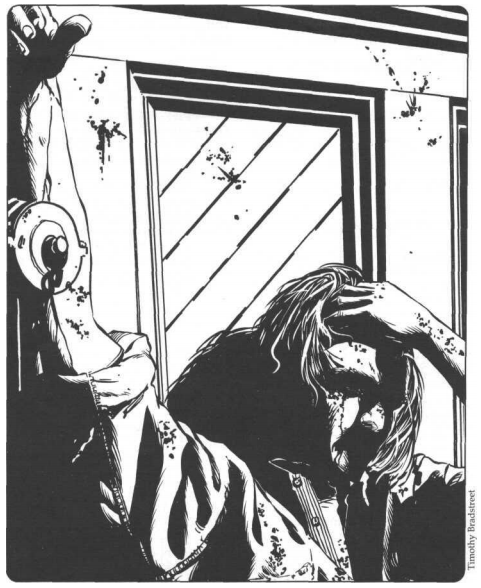
It wouldn't be a 90's RPG without some Bradstreet art.
The initial GodNet info rounds out with a list of some of the regions of the GodNet .
The main hub of the GodNet is Babel Central , a glass-and-chrome tower with rather Esher-ian internal design. It's mostly manned by VX entities who sort through and organize all the incoming data. Oh, and we get a second entity! Gatekeepers are guides and security forces that appear as friendly monks.
The major server points of the GodNet are housed in Cathedrals throughout France. Every data cathedral feeds into Babel Central, and in meatspace they are where the faithful jack in for the weekly sermons. It should be pointed out that a "data cathedral" doesn't have to be an actual cathedral; most are really just small churches. Regardless, they're always built into places of worship.
It should come as no surprise that the GodNet contains a Heaven and a Hell . No net raider has managed to infiltrate either of these regions (or at least done it and returned), although the Church has allowed a few faithful to return from Heaven.
Heaven is surrounded by a low wall that cannot be crossed, and beyond the wall runners can only see endless plains. The only way in is a single gate guarded by a VX simulation of Saint Peter. Those few who've come out of Heaven report that they were actually able to communicate with God Himself through His angels, and have seen changes they've requested in the GodNet actually happen.
Hell, on the other hand, remains a mystery. Nobody who's gone in have ever come out. The sole gate is guarded not by Cerberus, but by a bull-headed demon dressed as a judge.
Even a religion as rigid and unforgiving as the Cyberpapacy needs to offer the hope of redemption. That is the (theoretical) purpose of Purgatory ; to store souls and determine who is saved and who is damned. A cyberpriest can sentence someone to Purgatory by the use of the net damnation miracle, which automatically sends the target to Purgatory then next time they jack in. Purgatory itself is a misty, lonely limbo where the trapped souls are unable to communicate with each other. They shuffle through the miasma, their only human contact being the few cyberpriests whose job it is to determine who's worth saving. Those deemed worth of saving have their souls uploaded into the eternal prison of a spirit chip , where their skills and experiences will by used by Church operatives. Those deemed beyond saving are sent straight to Hell.
It's only the hope of redemption, after all.
---
And that's it. That's the basic GodNet rules available in the core set, all five pages of it. Oh, what's that? You want the rules you can actually use ? You want to know what those programs do, or how you move around the virtual landscape? You want some other things to throw at the netrunner, like security AIs? Oh, well, you'll have to buy the GodNet book for that.
For what it's worth, the GodNet book will cover what you actually need to know to use the GodNet in your game. But the basic information is so scattershot it's unusable. And while the GodNet book does build on the stuff we have here rather than contradicting or overriding it, it does highlight the biggest problem with Torg's mechanical presentation: it's not written for the GM.
I've said a million times that the books are poorly organized, and I think the reason is because the designer knew all the rules already. So when he started putting them in the book, he knew how everything worked, so he naturally left out a bunch of chunks because he didn't think about those mechanics anymore; they were internalized. The books never feel like they were handed off to someone outside the design crew to see if someone who hadn't been up to his ears in Torg for however long this was being developed could follow it.
Or maybe they just weren't very good at writing.
NEXT TIME: Sk1llz and m1r4cl3z!
Sk1llz and m1r4cl3z
Original SA post The storm has a name... - Let's Read TORG
Part 11g: Sk1llz and m1r4cl3z
And now we return to the Cyberpapacy book to cover two chapters: Skills and Miracles of Faith .
There aren't that many new skills available to Cyberpapal characters, but in keeping with 90's design some of them aren't really nessecary.
We've already talked about cyberdeck operation , but there's also a cybertech skill that allows you build, improve, and repair cybernetics. And with cybernetics there of course come rules for cyberpsychosis, so the game provides us with a psychology skill to help deal with that; it's basically a healing skill for mental wounds.
The other two completely new skills are forgery , which is self-explanitory, and streetwise . In this game, streetwise doesn't just help you know which gang is which or who's territory you're in; it also helps you scrounge for food and shelter in an urban environment. Which is actually useful, given the current situations in the major cities.
The last skill to be mentioned is a rather unusual case. The disguise skill does what it says on the label, but the skill is actually from the Nippon Tech realm. That means that, as far as the core set was concerned, only characters from Nippon Tech could get the skill. Which makes no sense, but why look for sense at this point?
And it's time to talk about Miracles , which are a pretty important part of Cyberpapal life. The ability to perform miracles is proof of the existence and power of God, and a large part of how the Church controls the populace. Of course, people of other faiths are capable of performing miracles as well, but obviously that's just the work of the Antichrist trying to lead the faithful astray. The Church said so, and they would know, right?
In fact, Avignon doctrine is so powerful there's a few modifications to the miracle rules.
First off, because the Chruch is at war with the forces of darkness, harmful miracles aren't considered "adverse" to the Cyberpapal faith, and therefore don't suffer the +15 difficulty for performing a miracle that doesn't match your belief system.
This is further expanded by this bit of mechanical wonkery:
quote:
Similarly, adverse miracles defend the faithful against another faith by striving to destroy that faith, so the -5 modifier is gained. But the need for adverse miracles is often not immediate, so they suffer from the +5 modifier. In most circumstances these modifiers cancel each other out. So members of the Cyberpapacy when using adverse miracles ignore modifiers for circumstances. They never gain the -3 modifier for being needed urgently, or in a life threatening situation.

What's interesting is that a side effect of this spritiual conflict is that members of other religions can also use harmful miracles against Cyberpapal forces without suffering penalties or a crisis of faith. It's a battle for the souls of humanity, after all.
And people of other faiths need all the help they can get. Every member of the Church capable of performing miracles is gifted a specially prepared crucifix that gives them a bonus to their faith rolls. For the rank-and-file it's only a +1, but the higher-ranking folks can get as high as +4. There are only two crucifixes that grant a +5 bonus: one is Malraux's, the other is on loan to the Inquisition. Agents of the Church also recieve the blessing vow miracle, which increases one of their stats by up to 4 points.
Let's take a look at some of what the cyberfaithful can do.
Alter disease lets someone increase or decrease the effects of a mundane disease in one person. The better the roll, the more control you have; minimal successes make the disease incommunicable, higher successes can change the speed the disease operates or change its transmission method. There's also a cure disease miracle that does just what it says. This combo is one of the bigger weapons in the Church's battle for the souls of the people; Cyberpapal agents go to areas ravaged by diseases and help people in ways that traditional medicine cannot. Of course, the Church likes to turn the diseases into epidemics beforehand, but how else can you show how helpful you are?
The afforementioned Blessing Vow can increase one of the target's stats by 1 to 4 points, and the flip-side miracle curse reduces one of the target's stats.
The damn miracle is a modified version of curse : in addition to reducing a stat, it brands an inverted cross on the target's forehead. This is a common punishment for "minor" crimes among the populace, and can only be removed via a blessing vow miracle.
Oh, there's an Eradicate Radiation mircale. Just in case, I suppose.
Excommunication is a ritual that only affects people of the Cyberpapal, Catholic, or Greek Orthodox religions. It brands the target as an enemy of the Church and reduces their faith and focus skills. It can only be reversed through the use of a blessing vow . It can be cast on any member of the Cybercatholic church, but the higher-ranked the target the higher the difficulty. So yes, you could cast this on Malraux and have it work if you hit a difficulty of 32; hard, but not impossible.
The Mana miracle maintains your body in meatspace while your brain is jaunting around the GodNet. It basically removes your need to eat or sleep while jacked in. Unfortuntely, it only works while you're actually jacked in, so it doesn't help you at all the rest of the time.
The punnily named Rood Awakening freezes the target into a crucifiction pose (hense "rood"); until the victim can break free, they take shock damage and can't do anything except trying to throw off the effect (which requires a pretty hard faith roll.
Unbeliever's Doom is a damaging miracle that hits harder the further away the target's belief system is from Cybercatholisism. It can't target people who have adds in the faith skill for the Cyberapacy, and oddly doesn't do any bonus damage to people without any faith skill.
There are more miracles, but they're either dull or duplicates of the miracles provided in the core book.
And that's about it. On the plus side, all the Cyberpapacy stuff from here on out will be new material!
NEXT TIME: Every time a monster has "cyber" in the name, drink!
Cyber_____
Original SA post The storm has a name... - Let's Read TORG
Part 11h: Cyber_____
Fun game: Every time I say "cyber" in this post, drink!
It's no fun running around CyberFrance without things to shoot at besides HoGs and Church operatives. Plus Malraux wants people to fear the forces of the Antichrist, so he makes sure that there are plenty of demonic things around to save the populace from. Which brings us nicely to the Creatures and Characters chapter, and as you can imagine most things in this chapter have "cyber" in their name.
Some monsters are GodNet entities , formed by the Tech Surge and multiple axiom washes. They exist mostly in the GodNet, but can manifest in the real world by casting a materialization spell (which is apportation magic, since we have to have everything tie to the stupid magic metaphysics) with a difficulty of 8. Success means that the entity exits the GodNet though an access port or jack.
One thing common to most creatures is a chance to be possibility rated, regardless of the nature of the creature. Even animals have a small chance to have some P-points, because we wouldn't want things to be too easy for the PCs. It does raise the question, however, how a cybered-up horse was capable of making a moral decision during their Crisis Moment to become a stormer. It does, however, raise the possibility of playing an animal.
The section does contain the expected array of generic human threats; cyberpriests, Chruch Police, Inquisitors, and so on. I'm not going to get into much detail on them because they're about what you'd expect.
Starting off the monster section are Booster Dogs , which are guard dogs that have been cybered up to guard important Church installations. There are a few different "builds", with different equipment for attack dogs versus trackers. Generally speaking, they all have dermal mesh armor, cyberfangs, and some form of eye implants so their handlers can track them.
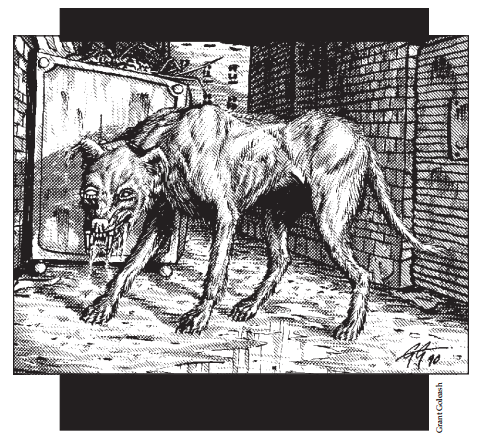
They also look pretty rabid.
The next creature is the Bright Bones , and this one needs a bit of set-up. In the province of Albi, one of the cyberpriests committed the heresy of taking his diocese off the GodNet. Once the Church got the connections back up, new entities had appeared and blocked access to everyone outside this area of the GodNet. Bright Bones look like glowing skeletons with lines of code crawling around their surfaces. They're generally hostile to everyone, but will attack Cyberpapal agents on sight. Because of this, Albi has become a pretty crime-ridden place, since the Church can't get in to enforce their laws.
Cartagras are the husks of people whose minds have been permanently trapped in the GodNet. The Church hooks the bodies up to life support systems when not in use, and are used as disposable cannon fodder. They can be programmed to perform simple tasks using chipware, and can also be controlled remotely by cyberpriests. They can also be cybered to the gills because, being mindless, they don't need to worry about things like cyberpsychosis.
If you have a Cyberchurch, you're gonna have Cyberknights . Don't let the fancy name fool you, though. CyberKnights are recruited from the streets, usually gangers who're sick of getting beating on by The CyberMan or normal folks who have no other survival options. They're lured into the order with promises of glory, heaven, big-ass guns, and their own cyberhorses. Once in, they're indoctrinated, run through an assembly line to get chromed up, and sent out to be meatshields for the Church Police.
One fun aftereffect of France's axioms swinging all over the damn place are cygoyles , a.k.a. cybernetic gargoyles. Some are originally from Manga Verita, others were statues brought to life by reality storms, still more were normal Core Earthers who got on the wrong end of a reality storm. Despite the name, generally speaking only those cygoyles in service of the CyberPope have any cyberware.
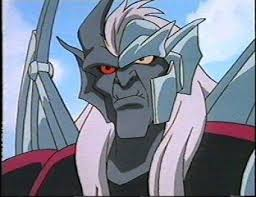
Remember this guy?
Believe it or no, demons barely get any page time. This is the full description of demons, sans stat block.
quote:
Demons come in many shapes and forms, from small looking gremlins to large dog-headed monsters. The majority have large amounts of cyberware implants.
Demons are considered enemies by most faiths, and they make frequent use of the adverse miracles of the Cyberpapacy.
Now it's time to talk about the CyberPapacy's gospogs . Gospogs, in case you forgot, are special troops High Lords can grow by planting corpses in specially-prepared fields. The field can be used up to five times, with each "planting" of gospog yeilding fewer creatures but generating stronger ones until the last planting creates one single uber-monster. First-planting gospog all look like run-of-the-mill zombies, but after that their appearance and abilities change depending on the High Lord in quesion.
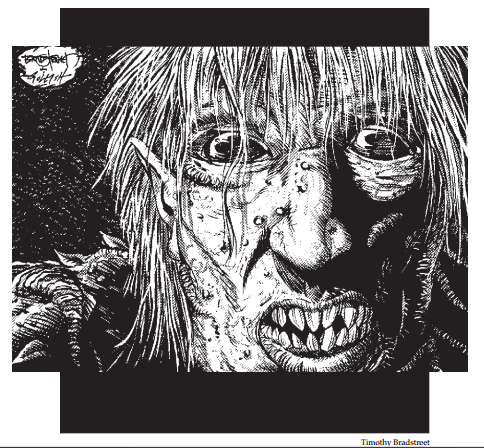
A second-planting gospog
-
Second-planting gospog still look like zombies, but eight feet tall with overlong arms and legs. They're immune to K-results (meaning they can't be knocked out) and love hunting in packs.
-
Third-planting gospog look like "classical" evil witches, complete with stooped backs and warts. They're proficient spellcasters.
-
Fourth-planting gospog appear as medieval-flavored red-skin-horns-wings-and-hooves demons. They're strong, tough, and have access to magic, but prefer to try and manipulate others into evil acts.
-
The fifth-planting gospog is...well...
quote:
The fifth planting gospog is an angel of death, complete with the ragged wings, tattered black robe, and grinning skull. But blackened bones are twined with NeuraCal, and CSI LED’s and other cybereyes are rooted in dry sockets. A chipholder is attached directly to its vertebrae. Slashers do impossible amounts of damage, and a crystalline mass projects holographic images into and in front of the angel.
The images are drawn from LifeChips, DatChips of unknown origin. The angel plugs a chip in, and scenes are projected from the crystal. Most often these are scenes of a character’s life, images which the angel could not have possibly seen, including images from childhood or adolescence which are important to the character.
Hospitallers deserve special mention. As stated above (and because it's a 90's RPG), cyberpsychosis is a thing. Hospitallers are crusaders who believe that cyberpsychosis is the modern equivalent of speaking in tongues, and that the insanity is a sign from God. They are (unsurprisingly) loaded up with as much cyberware as the Church can cram into their bodies.
Incubi and succubi are around, and have almost identical descriptions and stat blocks. The main difference is that incubi have higher charm skill, and succubi have a higher taunt skill. Interpret that how you will.
Since it's been a few pages without a bad pun, we have the Jazuits (Jaz is a substance that eases cybernetic acclimation). They're the social warriors of the Church; they are the missionaries sent abroad to spread the word of Malraux and smite heretics as needed.
Lastly, we have slinkers .
quote:
Cyberware has been added to cats in Paris by cyberleggers who want to maintain surveillance of the approaches to their hideouts. Known on the street as slinkers, these cats augment fixed camera positions and are wired with radio transmitters and receivers, which the cyberlegger uses to send pleasure/pain impulses to direct the cat’s actions.
---
Surprisingly, there's not a lot of really thematic monsters here. You'd think that demons would get more attention than two paragraphs, given how important they are. Hell, the bright bones get more page space, and they only exist in the GodNet of one city! I think the idea is that the main threats of the Cyberpapacy are all human; cyberpriests/nuns, Inquisitors, Church Police, and so on. But if you've got this whole setup where faith and demons are known to be real, why not play to that more? The chapter detailing France down to the square foot is longer than the chapter of villain stats!
It's like they don't understand "tone", or something.
NEXT TIME: Where the chrome meets the meat!
Cold chrome, hot lead, premade templates
Original SA post The storm has a name... - Let's Read TORG
Part 11h: Cold chrome, hot lead, premade templates
And now we finally get to the most important part of any cyberpunk RPG: the equipment section!
quote:
“The GodNet brings the benefits of cybernetics to all loyal Catholics. Imbued with the Holy Spirit and the blessing of the Church, cyberware fortifies weak and yielding flesh with the power of God. Blessed are the faithful, for they shall share in the bounty of the Lord.”
—Extract from the Cyberpope’s Inauguration Speech
That being said, technically cyberware is only available for the faithful. Any legal installation surgery must be approved and supervised by a techpriest, and to ensure that you're actually faithful instead of paying lip service for some chrome, there are a few...hidden systems.
quote:
All of the cyberware systems described here are available at no cost from the Cyberpapacy, but there is a price to be paid: to ensure orthodoxy, or to prevent the use of these systems against the Cyberpapacy, the systems are frequently fitted with homing bugs (homers), and self-destruct devices which can be activated by Malraux’s agents. These devices are activated by radio, and either burn out a cyberware system making it inoperative, or else cause severe damage to the user’s Central Nervous System. In the case of lifesupporting cyberware, death follows quickly as cybernetic hearts and lungs cease their vital functions. Other systems simply burn out and fuse together. At the same time, energy stored in their powercells is blasted through the user’s body causing an attack with a damage value of 18.
Of course, getting implants requires surgery, and since this is Torg you have to roll to see how well the surgery went and how long you're going to need to recover.
Installing cyberware in someone requires a medicine roll, with the difficulty depending on the system being installed. If the roll succeeds, then the surgery was successful. The patient is out for half an hour after the surgery (yes, they specify how long) and will probably have a wound or two that need to heal normally. Better-than-normal successes can improve your healing rate, whereas bare successes or flat-out failures can damage not just the patient, but the cyberware as well, and can actually cause the patient to flatline on the table.
So yes, it's possible for your character to die just by getting a cyberhand.
And even if you get your chrome installed without any problems, there are other systems in play to make your life difficult. The first is the possibility of system failure ; whenever you're doing something involving your cyberware, a roll of 1 means the GM gets to roll abonus and look it up on the system failures table . Because we haven't had a chart in a while, I guess. Oh, and he gets roll-agains on 10s and 20s like it's a skilled roll.
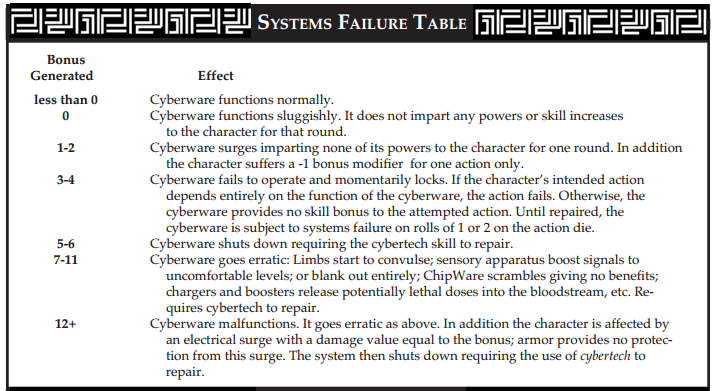
The other problem is because this is a 90's cyberpunk RPG: the danger of cyberpsychosis .
Cyberpsychosis is the dehumanizing side-effect of replacing too much of your body with hardware. Every piece of cyberware in the book has a cyber rating that represents how much of a strain it puts on your headmeats, and your character's cyber rating is the total of all these values.
Whenever you suffer a setback result, from cards of social skill use, the GM takes your cyber rating and generates a total with it. This is compared to your Spirit stat, and the result is looked up on the cyberspychosis table .
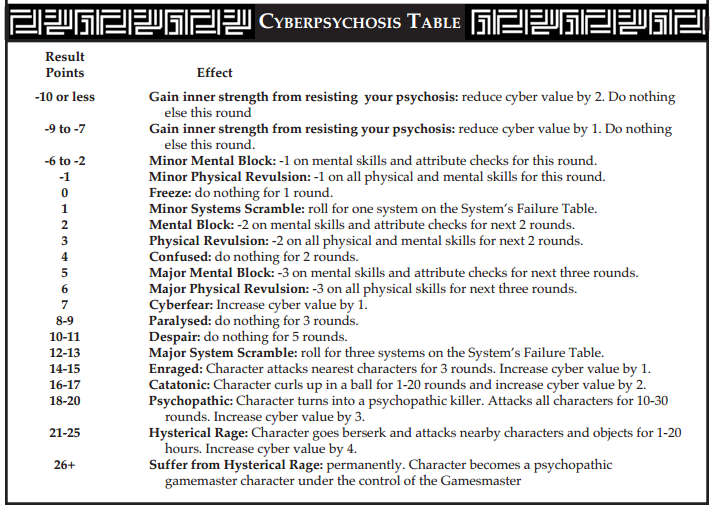
Interestingly, you can declare you're resisting the cyberpsychotic attack, which is treated as an active defense; roll your Spirit to generate a total, with a minimum bonus of +1. Unfortunately, it doesn't say if this is treated as your action for the turn (like a normal active defence), but if it's not, then there's no reason to not resist the attack.
You also have a maximum cyber rating equal to your Spirit +10; if you hit the max, then "cyberpsychosis will doom the character within the span of a few adventures". Unfortunately they don't say what that actually means . There's no "when you hit this number you finally snap and are removed and your character is taken over by the GM" thing, and technically you're only checking for a break when a setback happens, which isn't a guaranteed thing. So I guess the GM is supposed to take the character away after a few sessions?
It is possible to reduce your character's cyber value. You can either have systems removed (which requires more surgery, with all the risks that entails), or can be treated with a psychology roll.
And now that we're past the general mechanics, we would logically talk about the main manufacturers of cyberware because that shouldn't be in the setting info. Each piece of gear in the book has the manufacturer in the name, which is a nice touch, really. This is the closest thing we have to a real list of "megacorps", though, so let's get through this.
BelleVision originally made cosmetic replacement eyes before the Tech Surge, and is now one of the main manufacturers of cybereyes. They're currently dealing with the twin problems of a rival company sort-of stealing their brand name with lower-quality "Belle-View" products, and the fact that a large chunk of their R&D department just defected to Paris Liberté and has set up their own company.
Clear Sight Industries is the number one provider of cybereyes and weapon enhancement systems to the Church; in fact they don't sell to anyone else because the company is run by cyberpriests. Recently, however, one of their main product train shipments was seized by the Resistance, and then stolen again by the Sun Kings.
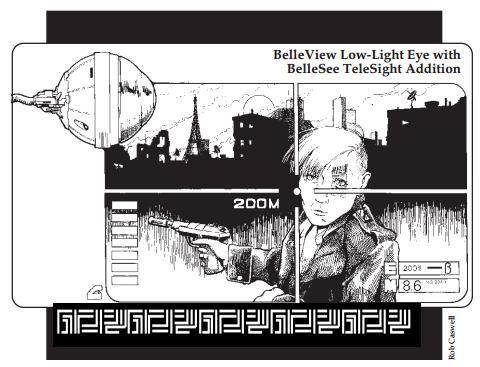
High tech!
Compte Industries develops physical enhancement systems. It's a relatively small company, but their systems tend to find their way into Churh Police or Hospitaller operatives. The German government believes that Compte Idustries is actually a Dr. Mobius operation, or secretly a front company for Japanese interests.
CyberHam Manufacture is a sort of "guerrilla company" created by ham radio operators who wanted to get into this whole "GodNet" thing on the ground floor. They make cyberdecks and other systems designed to infiltrate Cyberpapal systems. They work out of back rooms and warehouses.
Data Audio Systems (DATAS) used to be a manufacturer of audio systems. Now, they lead the way in audio and sensory cybersystems. The company is controlled by the Cyberpapacy, but rumor has it they have a manufacturing facility somewhere outside the main cities.
FreeFrance Optics is the company made by the people who defected from BelleVision. They've had to deal with attacks from Cyberpapal forces trying to either kill them as heretics or bring them "back into the fold", i.e. killing them. They've had to relocate recently to get away from these attacks.
God's Word Industries are the number one manufacturer of weapons and combat gear for the Church. When you're stripping a dead Church Police agent for his gear, odds are that it'll have "GWI" on the label. Many illegal companies try to duplicate GWI gear, but they can't match the overall quality.
Marlenes produces drug-injection systems (including the associated drug), and may or may not be a front of the Sun Kings. The company denies this, of course, but it's probably not a coincidence that their drugs are highly addictive and are sold on the streets with disturbing regularity.
MediCo is a straight-up drug manufactuing company, making normal over-the-counter and prescription drugs. They are very concious of their public image, and give to a lot of charities across CryberFrance. Unfortuntely, a lot of those charities are owned by Malraux.
MindBody Technologies are the main manufacturers of boosters and chargers, cyber-components that inject drugs into a person's system. And they've even managed to work out the kinks, like drug resouvour leakage and brain damage!
NeuroInc develops artificial nerves and skin tissue. Their artificial skin is pretty much impossible to tell from the real thing, but that being said most people don't use it because you want to show off the chrome to show how pieos you are.
Pleasure Products Ltd used to make "massage machines", but now makes sensory enhancement systems. And that's pretty much all there is to them.
Trigon Products make cyberlimbs. Specifically, they make cyberlimbs for the Resistance and assorted street gangs. They've taken advantage of the increased tech available to create "mobile manufacturing plants", which travel the country staying one step ahead of the Inquisition.
True Spirit Enterprises is another maker of sensory systems, but they're also the once who developed Spirit Chip technology. They also copy designs of other companies and sell those designs to the Church.
And with that out of the way, let's talk about cyberware implants!
To start with, every system needs a power source . Small systems (like cybereyes) use inegrated batteries that can run for about two years before needing to be changed, whereas a cyberlimb runs on a larger battery that only lasts a month or so. Cyberlimb batteries can actually be recharged by plugging them into a wall socket. Chipware sockets require very little power, and actually run off the user's central nervous system.
Next up is a brief discussion on costs. Did I mention the books aren't organized very well? Anyway, the prices listed for gear are actually how much it'd cost to get the part from a cyberlegger; the Cyberpapacy does not charge for cyberware, but will only give it to selected members of the church.
On to the basic cybersystems! If you have implants, you need NeuraCal to activate them mentally. NeuraCal is a system of artificial nerve cells that are woven into the brainstem, then connected to your various systems. It has a base cyber rating of 5, which is about a quarter of most characters' max rating. If you don't want to get NeuraCal installed, you can use Jaz Packs instead. Jaz is a chemical that temporarily alters your nervous system to allow implant use. It's injected through an apotheduct , which is a patch put on the surface of your skin that you can plug drug packs into for easy dosing. The apotheduct only has a cyber rating of 2, and a jaz pack has a rating of 1 and gives you -3 to your cyberpsychosis results. The down side is that a dose of Jaz only lasts an hour, whereas NeuraCal never runs out.
It's worth pointing out that you don't need NeuraCal or Jaz to use an unmodified cyberlimb, but you would need one of them to use an implanted weapon or system. If you don't want to go either route, you can get a control pad built onto your arm. It's worth pointing out that 1) they don't tell you this for another five pages or so, and b) the book doesn't say how this all works with stuff like a cybereye. Do I need Jaz to use the zoom function of my eye? Got me.
The other basic cyberimplant is a neural jack , which you need to directly access the GodNet. For the most part, only techpriests or GodNet raiders have these. Everybody else makes do with simple stick-on temple electrodes ("temptrodes") to beam the signals into their brains. Using the GodNet through trodes is very limited (especially compared to what you can do with a jack), but it's good enough for normal users with the added benefit of not having to worry about your frontal lobe melting.
Now we start getting into the good stuff with sensory systems . Each "sensory location" can hold up to three systems, with all their various bonuses stacking. But here's the thing: each eye is considered a different "location", so you could have three implants in your left eye and three completely different systems in your right eye without any sort of problems or headaches. And yes, they specificially say you can do that in the book. Not that you'd want to get too nuts, because while sensory systems only have cyber ratings of +1 or +2, they can add up.
Regardless, we first get a listing of vision enhancements . Obviously, I'm not going to go through every single one, because they're pretty much what you'd expect: low-light/IR vision, heads-up displays, cameras, and an assortment of pluses to your find skill. There's also one system that lets you see electrical impulses.
Next are auditory enhancements , and again there aren't too many surprises here. Sound enhancement and dampening are the main draws, but you can also get enhancements for low- and high-frequency hearing.
There are only two taste systems and they're both pretty useless. One lets you identify tastes you've tasted before (+1 to your Perception for "tasting purposes only"), and the other stores 20 tastes so you can identify them if you've never tasted them before. Whatever.
The olfactory systems aren't much more interesting. Yeah, there's the standard track-by-scent implant, and a general sense enhancer, but the interesting thing here is The Clamp. It's a system that automatically seals your nasal passages shut for three minutes when it detects an unwanted scent or gas.
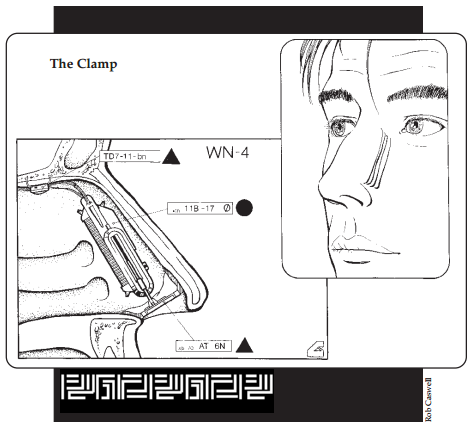
Holding your nose...IN THE FUTURE!
The last of the five senses only has two tactile systems available: one that gives you +2 Dexterity when doing fine work, and one that lets you sense electrical currents within 10 cm by touching something.
There are other assorted sensory systems as well; motion sensors, bioscanners, throat mikes, things like that. Again, it's all pretty much your standard cyberfare.
Next on the list are the physical enhancements . This is where your bioware and overall body ehancements are found. Some of the options available include vocal modifications, chemical enhancers or injectors, tendon replacements, and stat boosts, but ultimately there's nothing super-amazing here with the exception of the MB Blocker. MB Blockers are standard-issue implants for Church Police that release pain suppressants and endorphins when the host is hurt. With a Blocker installed, you ignore all K results on damage rolls, all shock damage you take is reduced by 3, and you don't lose your next turn when heavily wounded. Which makes fighting the Church Police a real pain in the ass.
From here we go to Prosthetics and Armor . Interestingly, cyberlimbs aren't common with followers of the Church. The Church prefers to give the common folk simple implants and internal systems, saving the big stuff for the actual Cyberpapal hierarchy. Outside the Church, of course, they're pretty common, but you have to get them installed by a cyberlegger. Limb cyber ratings vary, from +1 for a low-end cyberhand to +6 for the high-end limbs. That being said, there's no real difference between the low-end and high-end versions of the cyberlimb, but I do like that the highest-quality cyberleg is the Trigon Steve Austin .
quote:
Cybernetic limbs are made from HardPlas: a light, but tough plastic which is also pliable and resistant to damage. Artificial muscle tissues are used to manipulate the limbs, and the limb is covered in NeuraSkin. As with other items of cyberware, street fashions dictate that it is more cool to leave the limb uncovered, coated with chromium plate or painted in other bright colors.
Pain and touch sensors are built into all cyber limbs and, unless switched off, either manually or by a NeuraCal command, the user feels all sensations as he would from a real limb. Cybernetic limbs can have compartments built into them which can be used to hold tools and weapons.
If you want to go as full borg as possible, you can also get a full skeleton replacemet. The Trigon CyberSkel basically allows you to up the Strength scores of your cyberlimbs.
The "armor" part of this section is just subdermal armor. Get metal plates installed under your skin, get up to +5 armor.
The next section is a list of subdermal weapons . Once again, not too many surprises here; you can install a small-caliber pistol, a gas jet, or monofilament blades in your arms. There are two types of arm blades: you can get slicers (which come out of your fingertips or toes), or slashers (which are Wolverine claws). If you saw Johnny Mnemonic, you can also get a monowhip installed in your finger because that's a good idea.
We now come to Chipware , which has a few new things that differ from your standard cybersetting.
As is the case with this kind of thing, you need special jacks installed to use chipware. As is also the case because it's the 90s, the "chips" look like small plugs rather than actual computer chips or SD cards.
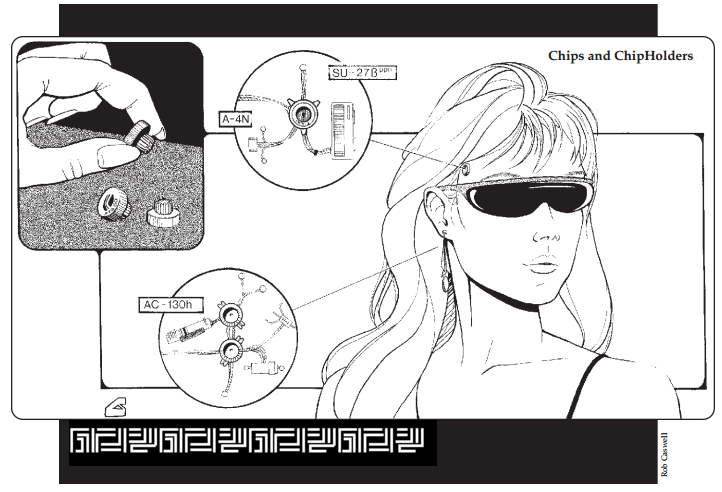
Warning: Choking hazard for children under 3.
You can get chips that give you a +1 or +2 to one of your skills or just give you a ton of file storage in your head, but the two main additions here are faith chips and skill chips . We've talked about faith chips before (they make you a devout follower of Cybercatholisism), but spirit chips need some detail.
Spirit chips contain the personality and memory of a person who was trapped in Purgatory. The victim's "soul" (for lack of a better term) is permanently uploaded into the chip, and when you slot the chip you gain access to that person's skills and memories. The thing is: the rest of the person is in there too.
When not slotted, the inhabitant of the spirit chip is basically in a dormant state, and is awoken when the chip is plugged in. The inhabitant knows how long they've been out, but will need to be told what the current situation is when they wake up. The person who slotted the chip will have access to the inhabitant's skill adds (as long as he has fewer adds than the inhabitant), but uses his own stats to determine the overall score.
The big downside to spirit chips (apart from how they're made) is that the chip inhabitant can try to take over the host's body. The inhabitant still has his mental stats as well as his skills, and can make an opposed Spirit roll on the Interaction Results Table. If the inhabitant wins with an unskilled or stymied result, then the chip takes over for the rest of the scene, using its mental stats and the host's physical stats. If the host loses by more than that, then the inhabitant takes over and shoves the host's mind aside, making him a passive observer of his own actions. What's more, the longer the chip is used, the better the chip will be at seizing control.
The host can try to retake control under a few different circumstances:
quote:
• a chip does something contrary to the character’s beliefs (gamemaster’s decision).
• if the chip needs to ask the character for information or advice. Unless on-line, chips are unaware of their surroundings; this tends to make them ignorant of recent events.
• if the character’s body takes damage, thereby triggering the character’s self-preservation instincts.
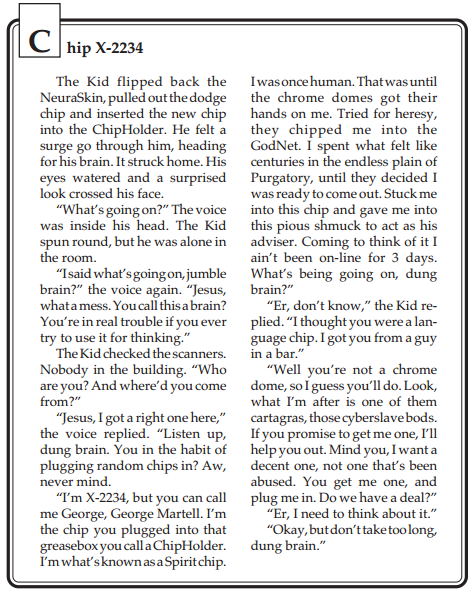
The rest of the chapter is just a few pages of generic gear, guns, armor, and vehicles you can get, but I'm not going to get into this stuff because it's just varations on basic gear. There are still a few things that stand out:
First, laser and plasma weapons are available.
Second, most of the vehicles available vehicles hover. The cars, the APCs, the battle tanks...they all hover.
Third, there's a CyberTrain.
quote:
The CyberTrain is a huge train that runs on a magnetic rail. It is capable of high speeds and is armored and armed with plasma cannons and Hellfire missiles.
 :metal: train ever.
:metal: train ever.
And now, finally, we have the templates available to Cyberpapal characters. The core Worldbook has three templates:
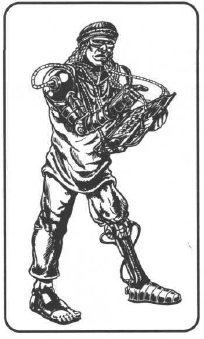
The GodNet Raider is a computer musician who got transformed during the Tech Surge. His default gimmick is that he sees everything in terms of music, like calling the GodNet "a great piece of music being butchered by a backup band". His tag skill is, of course, cyberdeck operation .
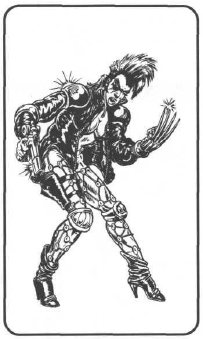
The Jaz Fighter is a straight-up tough-talking street-smart cyber-punk, yo. She's gotten a bit of the old "wire-and-polish" done at a chopshop, and is now ready to take on the "hood-and-frocks". Ridiculous slang aside, the Jaz Fighter starts with a bunch of cyberware and her tag skill is fire combat .
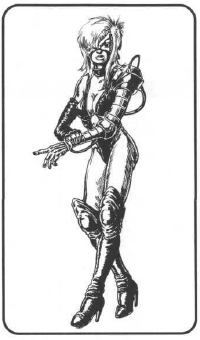
The Obsessed Prodigy is basically Dr. Hachi Mara-Two (she's on the core book cover), only from the Cyberpapacy, but still with the ridiculous hairstyle and outfit. She's your typical "teenage girl who doesn't 'get' life or have social skills yet at college where everyone's ten years older" type, only with cyberware. Her tag skill is science
The Cyberpapacy book adds another twelve:
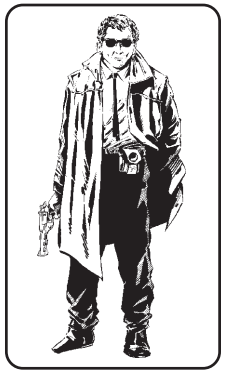
The Amateur Occultist was that kid who was really into tarot cards and runes and such, and didn't let go of that stuff as he grew older. Now that the invasion and axiom wash have happened, he's finding out he was actually more viable than he knew. On the plus side, he can cast spells now! His tag skill is divination magic , and his starting gear includes dark glasses and an overcoat because of course it does.
The Consulting Detective ran a sort of unofficial investigative service for people who needed more discretion than your typical private eye would show. When the Cyberpapacy showed up, you were one of the few who doubted, who saw the manipulation behind the light show. Now he uses his tag skill of evidence analysis to help his fellow freedom fighters.
The Cyberdecker is basically the GodNet raider, but with different gear and not as pretentious. She was a hacker before everything end now, and now she's like a kid in a candy store with all this new tech around. Her tag skill is cyberdeck operation .
The Cyberlegger can get you what you need. Parts, weapons, cyberware that fell off the back of an
quote:
You woke up one morning to find hi-tech goodies littering your workroom. Stuff you’d only previously read about in cyberpunk novels was piled up high. Passing a mirror you noticed that your glasses had changed. Boy, did you look cool in those flush-fitted mirrorshades. Fitted real well, too. A seamless mesh of flesh and tech.
The Dissenting Priest has seen the arrival of Malraux and the Cyberpapacy run roughshod over his own long-held moral beliefs. Even before the Tech Surge and the declaration of Pope John Paul as the Antichrist, you knew what had to be done. And thanks to the sudden increase in divine intervention thanks to your faith (roman catholic) tag skill, you have the means to fight back.
The Disillusioned Hero is a poor bastard who went off to fight in the Foreign Legion, then came back home just in time for the invasion to turn everything to shit. It wasn't bad enough he saw all his friends killed in combat, now he's a front-line defender of Paris, and all these confused civilians are going to him for help like he knows what the fuck to do. His tag skill is fire combat .
The Hunted Witch is actually the first template who comes from Magna Verita. She managed to escape the Inquisition for years, watching friends and allies who weren't as lucky fall to the forces of the Church. When the initial bridge dropped, she managed to sneak into the new world. The Tech Surge gave her cybernetics, and now she's ready to fight back for real. Oddly, she's the only template with two tag skills: alteration magic and scholar (herbs) .
The Psychologist was a normal Core Earther who's found herself on the wrong end of the Church. With the mindset of the masses dialed back to a medieval point of view, psychology becomes "brain magic" and people are having none of that. Still, her impressive social abilities and psychology tag skill can come in handy.
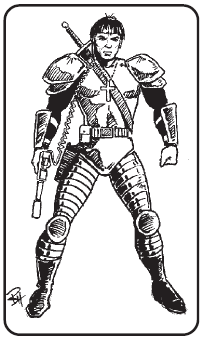
Hey Moe!
The Renegade Hospitaller is originally from Magna Verita, and didn't adjust well to the Tech Surge. He saw Malraux's new dedication to this strange technology as trouble (especially since Malraux was damning technology up 'til then), and the last straw was when he was ordered to torch a village of innocents. He managed to escape the Church and the so-called Cyberpope, and now fights on the side of the just with his faith (Cyberpapist) skill and heavy weaponry.
The Secret Agent was a "military advisor" in Chad when she caught a mortar round. It cost her an eye and an arm, and earned her a desk job in Paris. When the invasion arrived, she was the only one who cared about the Church's covert operations because everyone else was panicking. Then the government collapsed, the Tech Surge happened, and she found herself with some upgrades and able to get back in the game. Her tag skill is stealth .
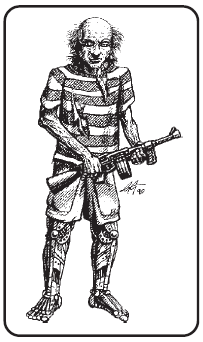
The Senior Citizen is my honest-to-God favorite template in the entire game line. I'm just gonna quote his background in full.
quote:
You thought you’d entered your twilight years. Your body had started to give out. First your hearing went, then your hip joint, followed by your legs. You’d always been myopic, so to came as no surprise when you started going blind.
Your memory began to decline rapidly making it hard to remember when you had to take your long list of prescription drugs. To be honest, you were looking forward to a long deserved rest in the hereafter.
Then the new Pope arrived and brought a new lease of life for you. Your legs changed, the calipers were gone and they were far stronger than they had ever been. Your sight and hearing improved dramatically, and you could even see and hear things that were just impossible before. Your memory improved in leaps and bounds.
You gave praise to God and to Cyberpope Jean Malraux, his servant on Earth, for the miracles he had worked upon you. But you soon realized that it was not the dawn of a new golden age. The Cyberpapacy was as ruthless and as oppressive as the Nazis you’d fought during the war. You still remember rejoicing when France was liberated by the Allies in 1945, but this time you know there are no Allies to come to your aid.
 as
fuck
. Oh, and his tag skill is
fire combat
.
as
fuck
. Oh, and his tag skill is
fire combat
.
The Street Punk was living on the street long before the invasion happened. She had to scrape for everything, and when the invasion hit things got even worse. Insane Church officers, thousands of displaced citizens, and insane new street gangs make survival harder than ever, and now she has to start learning how to get help from others. Her tag skill is streetwise .
More templates would come out in later books, but it's interesting to note that there wasn't a "cyberpriest" template until the Cleric's Sourcebook.
--
And that brings us to the end of the Cyberpapacy book! And as silly as it tends to get, it's actually a really interesting take on the cyberpunk genre. It hits a lot of the main points of the genre (corporations controlling everything, constant surveilance, crazy gangs), but by changing every major controlling power to a version of the 16th Century Catholic Church. Tieing all the tropes to the belief structure of the Church leads to some interesting (and scary) concepts, like faith chips and having your soul "damned" to a spirit chip for all eternity.
The problem is that the book is really hurt by the line's poor organization, needless detail, inconsistent tone, and the whole problem with having to maintain your personal axioms because no matter where you go outside of France you're going to be operating above the local tech axiom. I mean, it's nice that you can play a cyberwitch or cyberpriest without worrying about Shadowrun style drawbacks, but the constant threat of disconnection is a pretty big issue.
Despite everything, I still love the place. As long as I don't have to do any netrunning, and you'll find out why...
NEXT TIME: GodNet DLC!
The GodNet, v2.0: now with functionality!
Original SA post The storm has a name... - Let's Read TORG
Part 11i: The GodNet, v2.0: now with functionality!
A few months after the Cyberpapacy book was released (and even more months since the release of the core set), West End Games finally released the GodNet sourcebook. This doesn't seem like that much of a problem until you realize that, until the release of said book, the game didn't have the complete rules for running the GodNet, meaning that you didn't have the rules needed to take advantage of one of the Cyberpapacy's main selling points.
The GodNet book is a full supplement, and at about 90 pages is about the same size as the Cyberpapacy book itself. Unforunately, a lot of the book is padding. There's useful stuff like generic bad guys and net entities, but there's also a lot of stuff that is just reiterating fluff or stat blocks we've already seen in the main Cyberpapacy book. As a result, I'm going to skip talking about a good amount of this stuff because we've already seen it before.
Regardless, let's get into it.
The first chapter is just a rehashing of how Malraux invaded France, ran into Hachi Mara-Two in the dreamtime, got his axioms changed, and initiated the Tech Surge. This is like the fourth time this tale's been told so I don't know why they felt the need to tell it again except maybe to pad the page count.
Oh, and to show off more of that classic Torgian purple prose.
quote:
The Antipope of Avignon met the young woman upon the maelstrom bridge. She was small, wiry, full of coiled power.She was scantily dressed, with a wild mane of silver hair, and dark makeup masked her eyes. The true horror, as far as Malraux was concerned, was that parts of her body were made of metal. She was an abomination, an unholy combination of flesh and technology. What's more, she had the audacity to attack his person, as though the Pontiff of Avignon was a common brawler!
Claws snapped from her fingers and the young woman sliced at Malraux, cutting through his priestly raiments to expose the bare flesh of his back. She struck again, and the antipope felt the prickle of tiny needles upon his exposed skin. He swung wildly, a vicious back-hand slap that dropped the young woman to her knees. He saw others then, more stormers. He did not want to engage these heathens in physical confrontation. Not when he had other things to attend to. He called to his Darkness Device, and a spiral of light appeared beside him. He stepped into the glowing dimthread, then it retreated back toward his own bridge of light.
But the young woman was not done with Jean Malraux.
She was Dr. Hachi Mara·Two, a scientist from the cyber-world called Kadandra. It was Mara who first postulated the existence ofother cosms of reality to the World Council of Kadandra. She also warned of the first cosm contact, which saved. her world from the invading High Lord of Tharkold. When the war with Tharkold ended, Mara volunteered to travel to another cosm to aid it against similar invaders. This cosm was Earth. Mara brought with her a sensover chip of her world, virtual reality memories that she could plug into whenever homesickness got too bad. It was this chip, connected. to a modified jaz pack, that Mara attached to Jean Malraux's exposed back. With the use of the drug contained in the jaz pack, the virtual reality images could be viewed by anyone without the usually-necessary cyber enhancements. Mara triggered the remote switch, activating the jaz pack/sensover chip assembly.
And Jean Malraux dreamed.
Chapter two is The Net from the Outside , and talks about how the GodNet interacts with the general public and how ubiquitous it is in everyone's life. (spoiler: it's part of everything)
Ever since the Tech Surge, the GodNet has become an integral part of life in CyberFrance. Every home, shop, school, and business has a GodNet connection as required by papal law. Even radio and television broadcasts are part of the GodNet.
Everyone uses the GodNet in one form or another, and doing so is treated as a religous experience. Cyberpapal iconography pervades every user experience from browsing internet sites to the fact that phone dial tones are psalms and hymns.
For 99% of the French population, using the GodNet consists of plugging a computer into an access jack and accessing the GodNet the same way we use the internet. You can browse sites, shop online, watch movies, and so on. Of course, everything is monitored by the Church and you can't access any telecommunications networks outside of France. In fact, you can't even create your own internal network by just hooking five terminals to a mainframe and calling it a day; networking any computers together, even in areas that hold Core Earth's axioms, has to be done by connecting to the GodNet thanks to the Darkness Device. All is One in the GodNet.
While the GodNet does cover all of the CyberPapal realm, the Church has begun spreading its influence throughout the rest of the world (primarily in Central and South America). To keep his agnets abroad in the loop, Malraux has begun setting up a satellite network called The Firmament that allows GodNet signals to connect to areas outside of France.
But again, most GodNet activity happens in the realm itself. Most of the general public accesses the GodNet through dumb terminals that are basically just a PC that's only capable of running the equivalent of a web browser. You don't have to plug your head into it to use it, and you can only do things like check your email, watch HolyVids, chat, or go shopping. People who're a bit further up on the economic totem pole (or who own businesses) can afford smart terminals, which are closer to what we think of as computers; these are machines capable of running actual software and doing office work or data management.
Very few honest citizens own cyberdecks, mainly because they don't need them. Outside of Cyberpapal personel and hackers, very few people need the level of interface that involves a full virtual interface. Not to mention that legally owning a cyberdeck still puts you under suspicion and scrutiny by the Church.
Before we leave this chapter, it's worth pointing out again that the Cyberpapal axioms have worked their way back to Magna Verita. The Avignon bridge serves as a metaphysical network cable between the two realities, but Malraux has been very careful when it comes to revealing the new technologies to his home reality, but is still primarily focusing on Core Earth.
Chapter Three is The Net from the Inside , and this is where we start getting into the mechanical chunks of the GodNet.
Well, after two pages of fluff and unnessecary detail, anyway. There's a page describing someone's experience jacking into the GodNet and getting nailed by a security program five seconds later, and another page of detail nobody needed about jacking in and the cybernetic systems needed and blah blah blah.
It does give us this line, which may be the best thing in the whole book:
quote:
In the words of an anonymous decker posted in the electronic mail: "Leave your body at the interface port, and let your mind out for a run..."

Anyway, once you're jacked in you get a virtual body created from your personal self-image. Your virtual self looks like you (unless you have software to alter it), and you have access to all your normal skills.
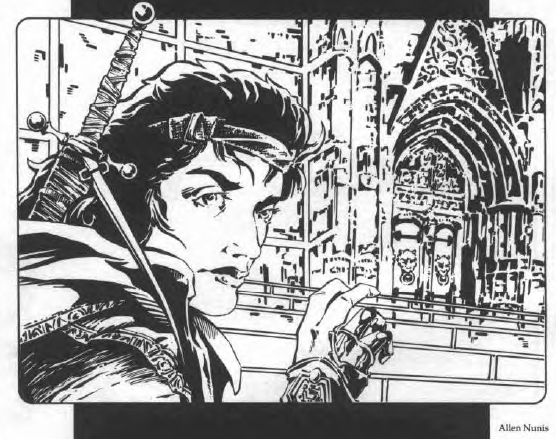
And again, because God fucking forbid anything in Torg is explained in a logical order, between saying that you have all your skills and what that means in the GodNet we get this description of what jacking in looks like.
quote:
He first finds himself upon a glowing datapath that leads to the local Holy Exchange church. He quickly realizes that the path is but one of thousands upon thousands of pulsating lines running haphazardly across a huge glowing cross. The decker is connected to the path by a gossamer strand that tugs him toward the Holy Exchange for clearance and routing. Beyond the local exchange, rising like a tower toward heaven, is Babel Central, located at the junction of the arms of the cross.
However, they might not work as well because all your skills in the GodNet are based off your Perception or Mind instead of their normal stats. Unsuprisingly, the details on this aren't given until later on in the book.
Now that we know how to get in, now we learn about getting out of the GodNet. Even though logging in always takes you to the nearest Data Cathedral, logging out can be done anywhere as long as you're not inside a data construct (which, again, we don't learn about until later).
And now we get to the "percieved geography" of the GodNet. If you ever played one of the early cyberpunk games in the late 80's/early 90's, then this is gonna look a bit familiar.
As stated previously, the GodNet is both the actual telecommunications network of France as well as a pocket dimension created by Ebenuscrux. It appears to jacked-in users as an infinite swirling blackness with the various datapaths and virtual structures just hanging in space. Every virtual construct that exists in the GodNet, regardless of its origin or purpose, appears as a cross between medieval religous structures and 90's neon cyberpunk design.
The most common type of contruct is a datapath , which represents the "telephone lines and microwave transmissions" that carry data from one place to the next. The only way to get anywhere in the GodNet is by taking a datapath, and in fact the only thing you can do on a datapath is travel. No combat, no interaction, just going from point A to point B.
And now it's time to talk about constructs . Constructs are representations of computer networks, and are pretty much what you go into the GodNet to hack into.
quote:
Within theGodNet, constructs take on an appearance that reflects their size. The larger the computer system housed by the construct, the more impressive it appears. They can appear as glowing Gothic churches, cathedrals, fortresses, manor houses, castles, or other buildings. The size of a system usually reflects its importance within the Cyberpapaey. Small, rural churches have small computer systems. Avignon, with its huge computers and countless work stations, has two constructs within theGooNet: the Avignon data fortress and Babel Central.
Cells are the building blocks of constructs. There are different types of cells, each with its own function. And in gaming terms, each one is basically a room in a "dungeon" that the hacker has to deal with to get to where he's going.
That's right, it's time to start building the Netrunner's Magical Side Adventure!
There are seven types of cells:
-
Log-on cells
are the only ways in to or out of a construct.
-
Common cells
represent general use systems. Virtual meeting rooms, theaters, things like that.
-
Defense cells
contain guardian programs.
-
Core cells
represent the CPU. Hacking these can give you control over parts of the construct: viewing system maps, turning datapaths on and off, cancel alerts, etc.
-
Slave cells
connect to meatspace items like security or factory manufactuing systems.
-
Vaults
are just data storage.
-
Work Stations
connect to dumb terminals and allow people to access the construct without a cyberdeck.
In addition, every cell can have a security rating, which is the difficulty of any rolls made to access that cell's functions. Each cell has a list of things you can do in it mechanically if you can beat that rating. The Core is the most involved; from there you can get system maps, shut other cells on and off, fiddle with security gates, and so on. Everything else has fewer options since the other cells are so focused; for instance, all you can do in a data vault is upload or download files.
And how do we set up these constructs? By drawing intricate maps, of course!
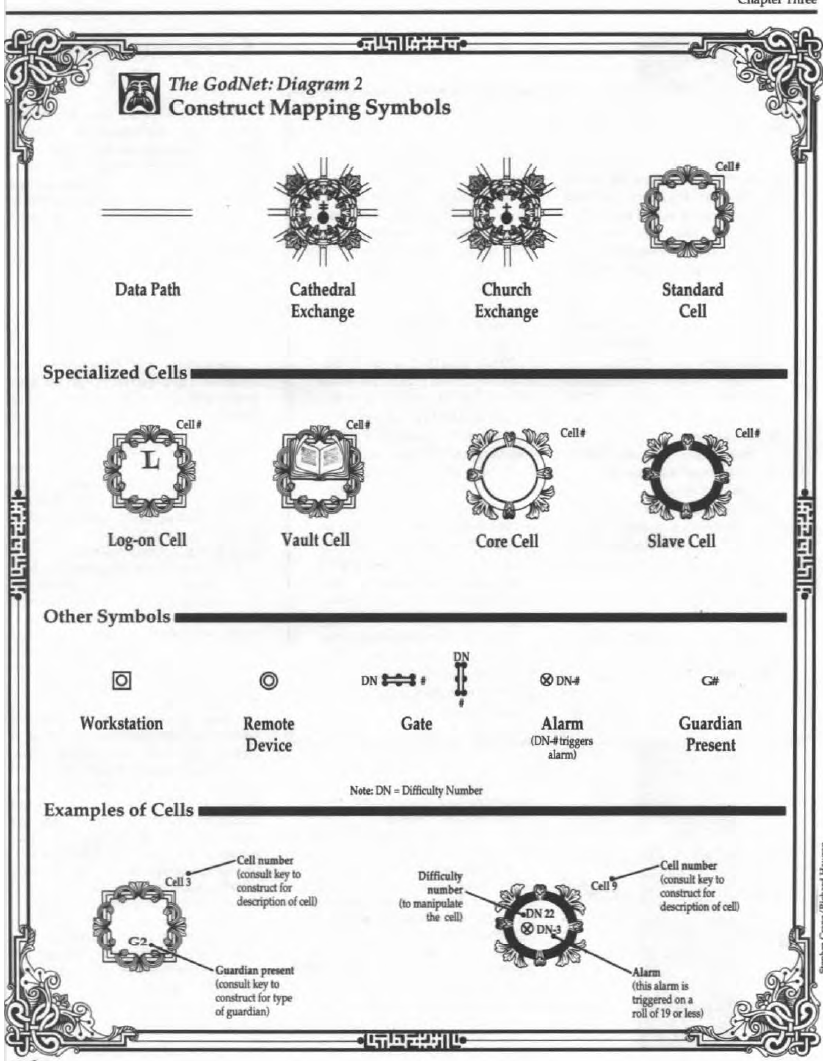
The building blocks of the internet
The idea is that every data construct is mapped out like this. You need a connection from Babel Central to a Cathedral Exchange or Church Exchange to the log-on cell, and from there you move through the system like an old-fashioned dungeon crawl.
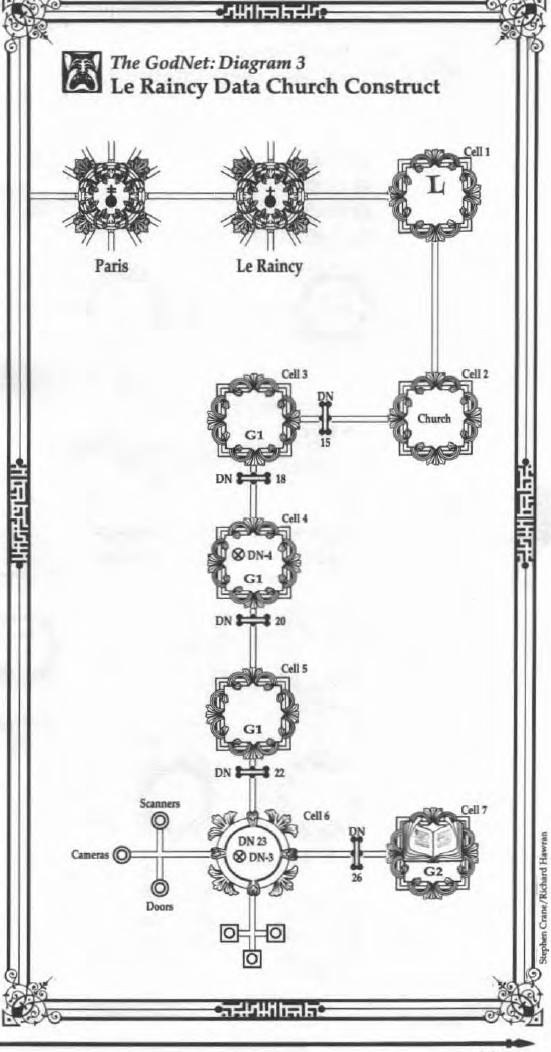
A small data construct
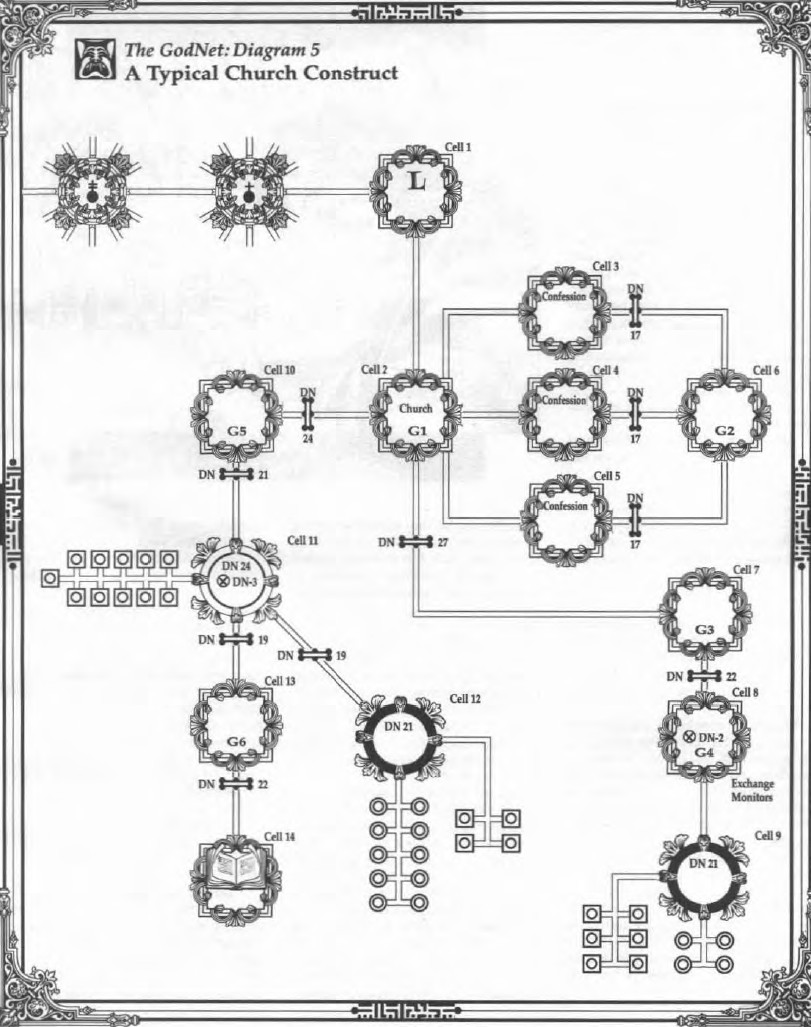
A large data construct
And yes, the GM is exected to map these systems out in full. Pre-written adventures have them made for you, and the GodNet book gives you some standard designs for common construct types, but you still need whole maps for whenever someone wants to go digitally dumpster-diving.
Those of you who played the early cyberpunk games in the first half of the 90's recognize this problem. In order to emulate the source fiction, hacking wasn't handled with a single roll, but was instead done with systems like this. The GM would have a big data structure the hacker had to slowly work his way through one piece at a time, fighting security programs, hacking through firewalls, and so on.
Meanwhile, as the hacker is having his Magical Computerland Side Adventure that could end up taking two hours of real time, the rest of the players are sitting there twiddling their thumbs. This is because of another genre-emulation idea where time in netspace happens at the "speed of thought", so even if the hackventure takes two hours of the session, in game-time it's supposed to take like two minutes. And since there's not much the meatspace characters can do in two minutes, you ended up with everyone getting pissed at the decker because it took him half a session to defeat a password lock on a door.
Amazingly, Torg came up with a very simple solution for this problem: actions in the GodNet take place on the same time-scale as actions outside of it. If the hacker needs ten minutes to get to the cell that controls the security door, the rest of the characters have ten minutes to prep for what's on the other side (or hold off the meatspace security forces they're trying to escape from). There's no thing of most of the group sitting around and waiting for the hacker to do his thing.
In-universe, the reason the GodNet works at this speed is so that the time dilation between normal human perception and the standard-issue "internet speed" don't screw with people's heads. Regardless of how little people like Malraux care about the people under them, it's hard to keep your workforce effective when they spend eight virtual hours working in the GodNet, disconnecting, realizing that only took half an hour in realspace, and then slowly going insane because the constant perception shifts are fucking with their heads.
The next section is about how the game rules work in the GodNet, but this again feels like padding because a lot of it could be summed up in a table. It's mostly "the net <skill> is based off <this stat> instead of <normal stat>" stuff, so I don't know why it needed three pages of that. The short form is that everything works off the Mind and Perception stats.
One important thing to note is that damage in the GodNet is mental damage, not physical, and as such can only be healed with the psychology skill.
Magic and miracles still work in the GodNet, so if you want to be a spell-slinging decker you can do that no problem.
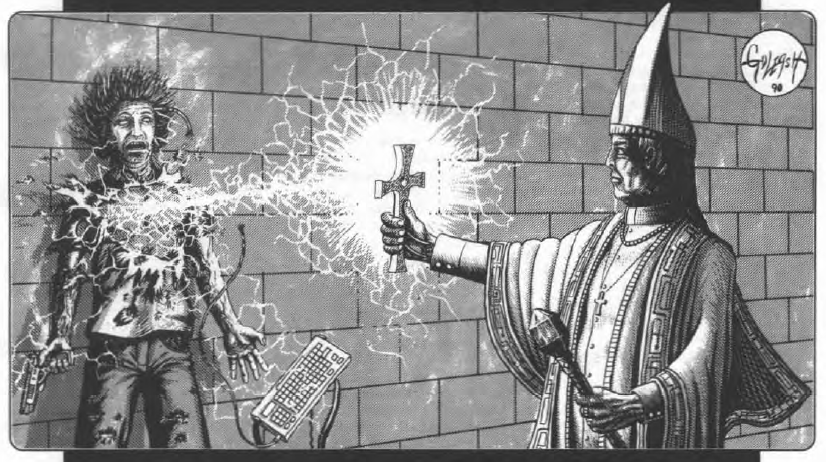
Well, okay, a little problem or two. The biggest problem is that any spell or miracle that targets something physical will just flat-out not work in the GodNet because there's no physicality there. You can't use a spell to blast a firewall off its hinges or fry a security program to a crisp because they don't have physical forms for the spell to latch on to. The other problem is that magic (not miracles) effect values are limited by your stats, so you can't get super-high spell result rolls.
And from there we go to Running the GodNet . Which starts with a page of "why do people run the GodNet" because I guess people couldn't understand why you want to hack into the evil controlling government's computer systems without help.
In keeping with the scattershot presentation, the next section is about being detected in the GodNet, and talks about Guardians , a concept introduced about 10 pages ago and aren't explained in detail for another 20 or so. Dammit why can't they keep this stuff all in one place!

Guardians are basically security software or net entities. A cell can have a Guardian attached to it, and it'll stay there until an alarm is raised or until it detects someone who's not supposed to be in the cell. Some Guardians will stay put, others are able to move through the system after hackers. I'll talk more about them in the next post.
Anyway, when you try to move past a Guardian, you have to make a net stealth roll against its net find . If it sees you it'll attack, and if you screw around in the system enough (and fail rolls) it can get bonuses to its rolls to detect you.
See, every time you try to manipulate a cell and fail, you create a net blip equal to the amount you failed by. The net blip is added to a Guardian's detection roll, but the GM also gets to roll to see if you're detected by any jackpriests when you create the blip. A jackpriest or whoever will only scan for three rounds ever (it says so in the rules), and if he doesn't see you his AI resets and he presumably goes back to his set-path searching pattern.
If you are detected, then the jackpriest will start a trace on you, at which point the alarms are sounded and and the Guardians in the system start actively looking for you. How long this takes depends on how good you are at avoiding and stealthing past people, but remember that you can't log out of the GodNet while in a construct and while you're running for the exit the Church Police are homing in on your meatspace body.
The remainder of the chapter is about running with multiple deckers linking their decks together. Turns out can actually bring non-deckers along with you on a run via TempTrodes, but they can't take any actions in the GodNet. They can use their skills to aid the decker's rolls, though.
Deckers can also "run duo", which means they network their decks together and run as one "entity". Doing this allows them to access programs on each others' decks, but they appear in the GodNet as one single entity, and can't do things like split up.
I am only halfway through this book. And this why I thank God that Shadowrun ended up paring this shit down to a single hacking roll because good lord this shit is complex.
NEXT TIME: Hardware and the app store!
The GodNet, v2.0: killer apps
Original SA post The storm has a name... - Let's Read TORG
Part 11j: The GodNet, v2.0: killer apps
Now that we know how to run the GodNet, we need to learn about the tools required to do that in the first place.
The next chapter is about cyberdecks , and just reiterates information we've gotten elsewhere. Cyberdecks have four stats: response , stealth , processor power , and storage . The first two stats add to various GodNet rolls, processor power determines how many programs you can run at once, and storage is just that. We get some sample cyberdecks you can buy off the shelf, and that's pretty much the chapter. At least it was only three pages!
Now we come to Programs , and things get a little more complicated. There are a lot of different programs, and of course the rules for them are convoluted.
Programs have three stats: Power, Price, and Write. Power generally determines the adds the program gives you, and Write is the difficulty of writing the program from scratch with the science (computer) skill or trying to crack the software to make an illegal copy.
Yes, Torg actually has rules for illegally copying software because why the fuck not.
Before we actually get to the software, we learn about damage to programs. When taking net damage, any shock damage is done to your active programs first, and reduces the Power of the software. If software hits zero power it crashes, and can only be restored by using a "rebuild program" or making a cyberdeck operation roll.
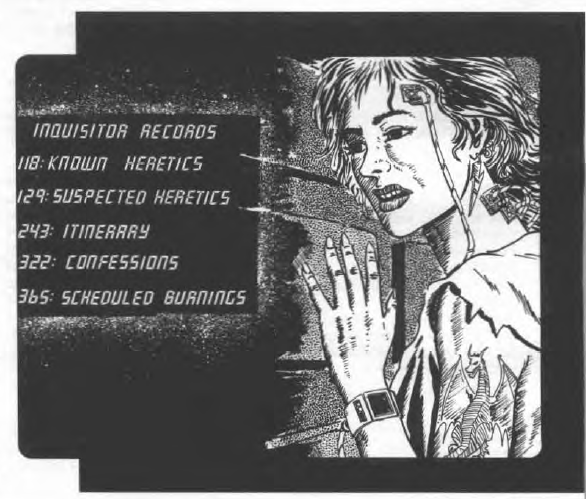
She is really into that readout
So software!
The basic type of software is skill enhancement software , and this is pretty straightforward: the software adds its Power to your skill rolls. Easy enough.
Things get more complex with Special Programs . These are the more complex pieces of software that have better bonuses or give specific abilities.
So of course now we learn about "running cold", which is netrunning without any special programs. This is just an unnecessarily way of saying that you can't perform some actions without the associated software. You can attack without an "attack" program, but you can't destroy someone's installed software without the Scramble program.
And back into the software list we go! And right off the bat we run into some head-scratchers with the base attack software. Attack adds its power to your attack rolls, but there's also "Onslaught" programs that do the same thing, cost more, and cannot be run cold. So I don't know why you'd need two separate programs for these, when the only real difference is that Attack maxes at power 5 and Onslaught tops out at power 6. (Attack 3 is size 3 and costs 10,000 francs, but Onslaught 3 is size 2 and costs three times as much.)
There are six special attack programs:
-
Scramble
attacks software in the user's storage.
-
Mindwipe
increases shock damage done to the target by 1, but can only be used when you've tracked the target's body to its source. I'm also not sure if it bypasses the whole "programs take stun first" thing.
-
BrainBurn
is like MindWipe, but increases shock damage by 3 and can only be used on targets you've tracked to their body and all of whose programs are crashed.
-
Surge
, again, can only be used against tracked targets, and actually causes physical damage to the target.
-
DeckWipe
will overwrite the target's deck storage with garbage, but only works on decks that don't have defense programs running.
-
Lock
prevents the target from loading programs.
On the defensive side, we again have a case of the basic software (Defense) and the more-expensive-but-not-more-effective version (Armor). There's also Scan, which allows you to both analyze cells and see what programs your opponents have running. Last is Shroud, that adds to your net stealth and makes your avatar look like a cyberpriest.
The next category is Evasion software, but there's only one in this category. It's called Evasion and it's used to throw off Trace programs.
Fortunately, Trace programs are up next! There's only one kind of Trace program, and it's used to locate the target's body so you can use your meaner software on them.
Related to the above are Grab programs, which make it harder for the target to jack out. At least the better Grab program, called Grapple, is actually more useful than the basic version because where Grab will prevent the target from logging out, Grapple will actually hold the target in place so they can't leave the cell they're in.
Another single-type program is Breach, which is used to knock gates or seals down. Moving on.
Next up are data manipulation programs , and almost all of these are just boosts to things you can do without special software. Manipulate lets you do stuff with cells, Search helps you find things in data vaults, Copy lets you copy data from a vault to your deck faster, and Alter lets you edit data. One thing you can't do without special software is download files from your deck onto external storage; apparently you can't put a text file on a thumb drive without the Store program. There's also a Disassembler program that adds its value to the other data manipulation software.
And now we come to the special special software. You can overclock your deck with White Light, allowing you to swap programs or upload data faster. Rebuild "heals" damage your software has taken, and the Heal program clears out the user's shock data.
Finally, we get to AngelBusters , and this is some fun 90's tech here.
quote:
AngelBusters are the street name for programs which hold more than one program within them. These programs are specially compacted so that they take up less space in a cyberdeck.
AngelBusters are only rarely available on the shadow market. The Cyberpapacy also writes its own AngelBusters, except it calls them Compact Programs (ComProgs). AngelBusters are written to overcome the inherent problems offitting a lot of programs into the restricted space of a cyberdeck.
AngelBusters are supposed to be a way around this limitation, but they're totally not worth it.
AngelBusters are basically zip files that contain programs so they use up less storage. ABs hold (actual size)x(compression factor) blocks of software: a 3x2 AngelBuster will take up three storage blocks on deck but actually contains six storage blocks worth of software. A 3x4 AngelBuster also takes up three blocks but can hold 12 block's worth of software.
To use the software in an AngelBuster, you just uncompress the software into the processor at which point it goes back to its original size. But here's the problem: you can't re -compress the software back into the AngelBuster. If you need that processor space you have to wipe it from the processor.
But that's not all! Every AngelBuster also has a crash rating , which is equal to the actual size+compression factor+10 (so the 2x3 would have a crash rating of 15). Every time you use the AngelBuster, you have to roll your net manipulation against the crash rating, and if you fail the AngelBuster crashes completely ; you can't use the programs in it, you can't reboot it, nothing. It is rendered completely useless now and forever. Hope you didn't pay a lot for it!
As an added bonus, you can't always tell what's in an AngelBuster. You need to make a science (computer) roll to see what software is in there, or you can just use it blind. Using it blind means you can only pull the programs in the order they're listed.
So let's say I've got a 3x3 AngelBuster that has Attack 3, Scan 1, Copy 2, and Breach 3. If I want to use this thing blind, I first have to avoid the crash difficulty of 16, then I can pull the Attack program out and use it. But if it's not the one I need, then I have to wipe that out and pull the next one in line.
And because we're not fucking over hackers enough here, some AngelBusters contain malware that will activate and attack the user when they try to pull something from the zip file.
The last page of this chapter is about writing programs, and it's pretty dull. Although if you want you can actually create copy protection on the software you write in case you don't want people to illegally get your illegal software. Not that it matters, because there's also rules for cracking protection.
The next chapter is Net Regions and Entities . This is where we
quote:
And I stood upon the datapaths of the GodNet, and saw a beast rise up out of the Deep, having seven heads and 10 horns,and upon his horns were 10 crowns. Who is like the beast? Who is able to make war with him? Revelations 13:1, The Malraux Bible
As I was saying, this chapter starts by covering the major regions of the GodNet. And again, a large chunk of this information is reiterations of stuff from the main Cyberpapay book. We already know about Babel Central, Heaven, Hell, and Purgatory so I don't know why this book spends to much more time on them apart from padding the page count.
There are a few new locations, though, and they get less page space than the areas we already knew about.
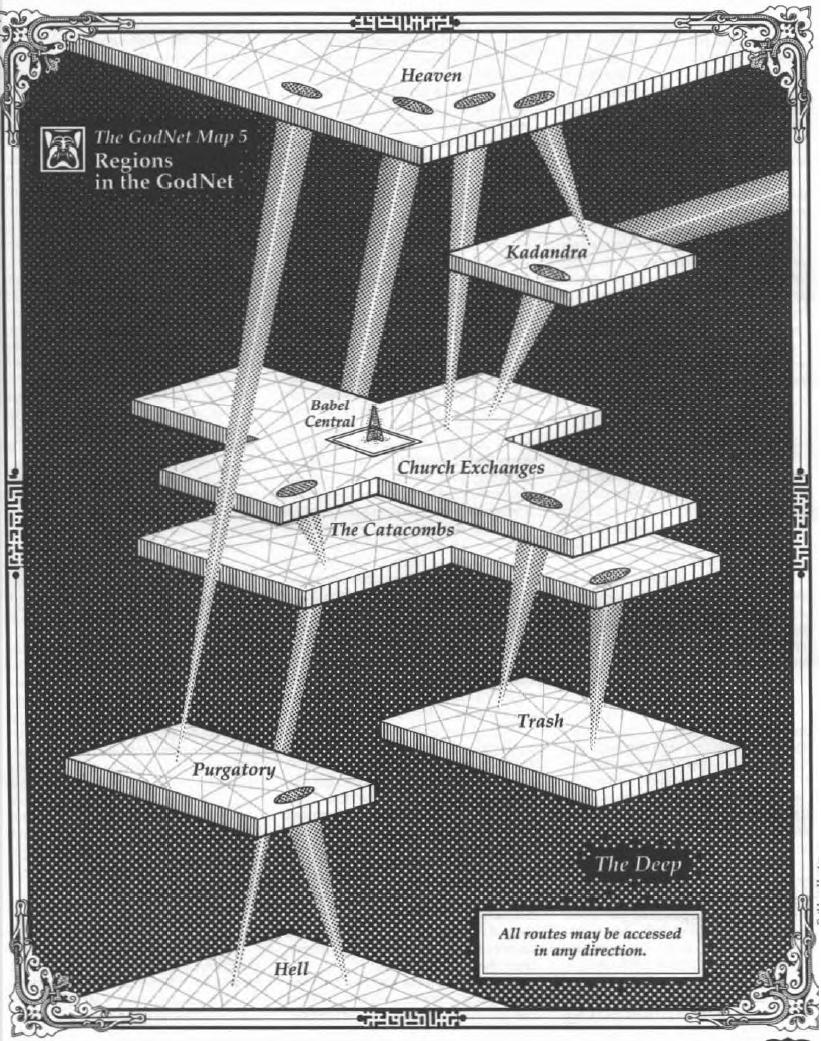
The rough map of the GodNet
The Catacombs is a region that lies "under" the main structure of the GodNet. It was created by hackers and people of faiths other the Cyberpapacy, and as a result is not able to be monitored by the CyberChurch. A large number of Roman Papal agents operate out of this section of the GodNet.
The recycle bin of the GodNet is Trash , except that nobody ever right-clicks and empties it. This is where every deleted file winds up, and Trash connects to every data construct in the GodNet, but the gates leading out are a lot tougher than the ones going in.
The least-known area of the GodNet is Kadandra . This is the simulation of that reality brought to Core Earth by Hachi Mara-Two to help aleviate her homesickness and was on the dataplate jammed into Malraux's back. Malraux spends a lot of time here so he can try to get some context on the new technologies that are cropping up in his realm daily. Malraux has also discovered that there are GodNet connections from this region to...somewhere else.
(It's never revealed where those connections go. It's a plot point that is completely forgotten after being introduced. I suppose the sim could connect to the Kandandra reality, but since Kadandra never gets brought up again it's doubtful that's the case.)
The last "region" is The Deep , but it's not a region in the sense that the other areas are. The Deep is the term for the black void the GodNet exists in. It's theoretically infinite, but the few people who've gone to explore it have never returned.
And now that we've covered that, we talk about actual Net Entities.
Again, this is a topic that's been touched on before. There are self-aware beings that exist independantly in the GodNet, born from Malraux's worldview and understanding of the involved technology.
The entities deckers are most likely to run into are angels . Boringly, they don't have the historically accurate weird-ass version of angels that are things like masses of heads or the lion-wheel thing. GodNet angels of any rank just look like humans with wings, although the more powerful ones have flaming wings or skin that looks like the depths of space.
One thing that worries the Cyberpapacy is that there are angels appearing that do not claim fealty to Malraux or the CyberChurch. These beings claim they are archangels, and often side with enemies of the Cyberpapacy.
And where there are angels, there are also demons. Demons come in fewer mechanical variety than angels (there are about a dozen types of angels stated up, but only three demons: generic, arch-, and hellhounds). Demons...exist? I guess? There's no real information on what they do or what their goals are.
It should be pointed out that angels and demons can be P-rated.
Non-self aware entities are called sentinels , and generally are just placed in cells to protect them. They can't move out of their cells, and not being intelligent they just exist to fight hackers. Given that that's the case, I really do wonder why they get more detail and description than demons.
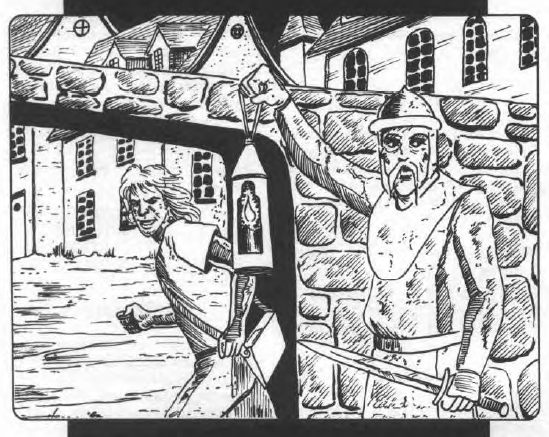
They probably shouldn't have installed CyberNobby 1.0
Lastly, we have viruses , which are the remnants of early Cyberpapal attempts to create net entities. These beings are like sentinels in that they're not intelligent, but are capable of moving around the GodNet and will indiscriminately attack pretty much anything it comes across.
The next chapter is some sample adventures, but you'll forgive me for skipping this one. They're all pretty much the same: you've been hired or asked to attack the data fortress of <group>, here it is. Some of the adventures even have things for people to do in meatspace! Isn't that thoughtful?
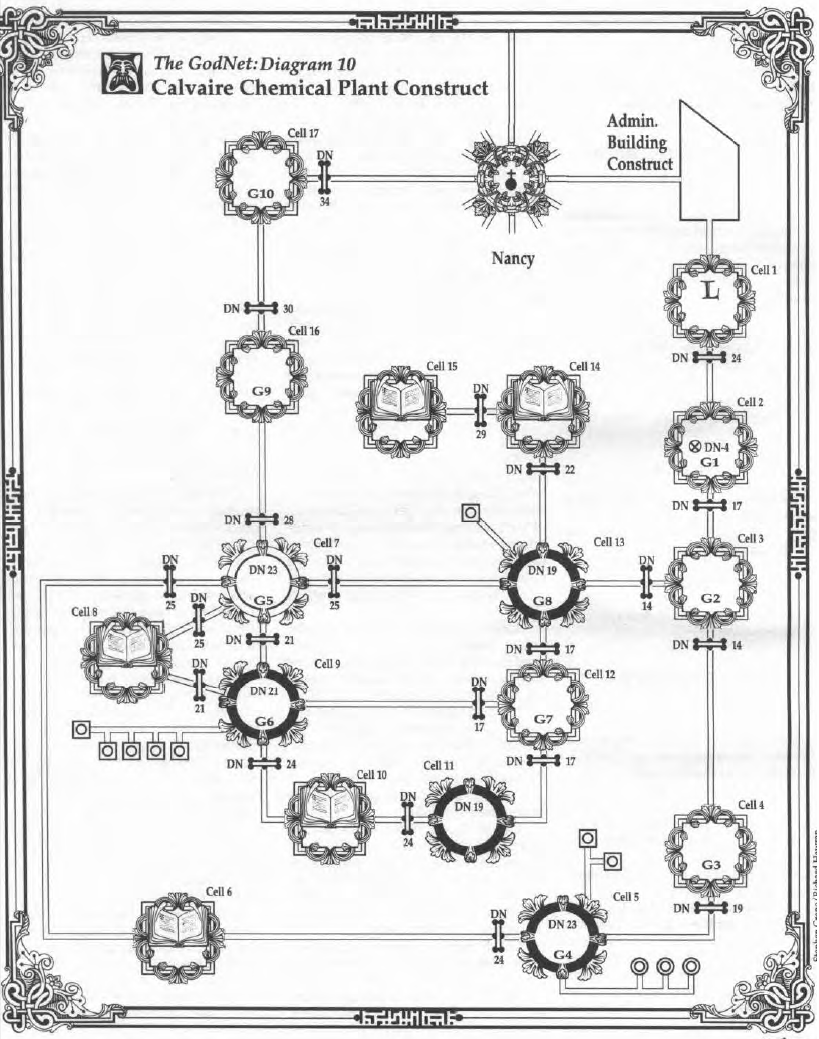
Get to it, hacker-boy.
The final chapter is Characters in the Net , and surprisingly isn't new templates or anything. Instead, it's a collection of NPCs of varying interest. I'll just talk about the not-boring ones.
Francois DuBango, The Lion is a character who appears regularly thoughout the Cyberpapcy books. He's a Jamacian hacker who says things like "Babel gonna fall, mon" and "I'n'l go into the Net, man. Just like I'n'I go into the street. Makes no sense to I'n'l that everything's changed out there."
He's very stereotypical.
Sanjuro Shintaro, a.k.a. The Hunchback sells cyberdecks and information to hackers. What nobody knows is that he's also an operative for the Kanawa Corporation. He's set up an extensive network of contacts throughout The Catacombs, so he's a go-to guy for intel.
Guiles Mondue was one of the first people to convert to the Cyberpapacy when Malraux arrived in Avignon. Despite the fact that he would make an interesting recurring threat to the PCs, his section of this chapter is actually a description of generic Babel Monitors. Why this is here instead of the early "generic NPC" section is beyond me.
Simone Darc is the "Opener of the Way". He's also one of the few people to return from Heaven. His time there transformed him into an angel, and he is fanatically dedicated to the Church. He takes it upon himself to hunt down the enemies of the Church in the GodNet and either kill them or (if they want redemption) drag them to Purgatory.
Lastly, we have Olivier Beauvoir , or at least his body. His mind is destroyed, and his body is under the control of a demon uncreatively named "Bloodletter". Bloodletter was sucked into the GodNet via the maelstrom bridge, managed to escape from Hell somehow, and attacked and killed the first decker it ran into. He's now having the time of his life in two worlds; he likes to harry deckers in the GodNet until he can learn where their bodies are, at which point he hunts down and kills the body.
And with that...we finally come to the end of The GodNet book.
Good fucking lord , for a 90-page book this thing is a fucking slog. The whole netrunning system is so overly-complex it's pretty unfun and convoluted. And again we run into the Torg chestnut of "why are they doing things this way?" Why does netrunning require you to manage your available system memory and processing power? Why are AngelBusters so inefficient? Why are constructs so complex (beyond the "that's how games did it back then" excuse)?
Well, it doesn't matter anymore, because we have reached the end of the Cyberpapacy. All that's left is the summary post...
NEXT TIME: The wrap-up and the vote!
The Cyberpapcy: End of File
Original SA post The storm has a name... - Let's Read TORG
Part 11k: The Cyberpapcy: End of File
Well, here we are. It took a long time but finally we've reached the end of the Cyberpapacy books.
So what happens from there?
Eventually, Malraux tries to jump-start a space program to keep launching satellites to spread the GodNet signal. This eventually gets shut down by Storm Knights, but Malraux doesn't sit on his laurels very long.
Malraux eventually looks up "subtlety" in the dictionary and manages to drop a bridge in Quebec without anyone noticing right away. He manages to spread the realm down over New England until he takes Boston.
The Church also starts moving into South America, taking advantage of the faith of the inhabitants and using miracles to cure diseases that have been running through the populace. Of course, most of these diseases were introduced by the Church in the first place.
Then there was Operation: Central Fire .
The game goes into detail about how you have to take territory back from High Lords, and why you have to be really careful when you do it, because if you fuck it up then every Ord in the stelae zone will die.
The German government, knowing this, looked at the Cyberpapal map and asked "so what would happen if we pulled that central spoke of the 'wheel' there?"

The answer: nothing good. The German government coordinated with NATO forces to attack the Cyberpapacy while organizing bombing runs, all timed with the uprooting of the central stelae.
What they didn't take into account was that Malraux is paranoid enough to keep back-up stelae at every site that he could empower on a moment's notice. They also didn't take into account that stelae zones have to be triangles, so the reality was in heavy flux until the new stelae was activated.
Reality storms ravaged all of France, and when the dust settled and the Cyberpapal reality reasserted itself, the Core Earth forces lost over 10,000 troops. Civilian losses were surpisingly low, only about 4,500 people. But still, it was a severe loss for both sides.
All these attacks only manage to make Malraux even more paranoid; by year 3 he's almost completely lost his shit and is utterly bi-polar. He goes from murderous rage to deep depression to a Messiah complex pretty much on a cycle. Despite the Church's efforts, word of Malraux's madness starts to leak to the people, leading to more rebellion as the divide between the faithful and the heretics becomes wider and wider.
It doesn't help as the effects of the axiom shifts start taking hold back in Magna Verita, leading to a completely new and alien idea: Malraux might not actually be working in accordance to God's will . It's still a new enough idea that nobody knows how to act on this yet, but once they do Malraux's going to have to deal with rebellion on two fronts.
----
So. The Cyberpapacy.
Despite the slog of it, I do really enjoy this realm. It's an interesting take on the whole idea of cyberpunk, where they replace the megacorps with a fanatical church, and it's odd that nobody else has ever seemed to explore the idea.
But because this is a 90's RPG, there's no real sense of exploring the idea beyond a shoot-guys-and-hack-computers stance. Which is a shame, because there are ideas here (like Faith Chips) that would be really interesting to build on. That's some Anti-Life Equation shit right there.
Instead, we get pages and pages of details nobody really needs. It's like they couldn't trust people to make up stuff on their own.
And like other realms, the player options get undermined by the mechanics. Yeah, you can go cyberdelving, but you have to track program space and swap things around and the GM needs to make out these whole side-dungeons and who could possibly care?
The Cyberpapacy ended up being the second most popular realm after the Nile Empire, which is unsurprising. It is a shame that the setting is presented so dryly and nothing super-interesting happens to it in the long run, though.
But that's in the past! Now it's time to look to THE FUTURE! And that means a vote!
Which realm would y'all like to hear about next?
-
The Nile Empire
, where they replace Nazis with Ancient Egyptians!
-
Aysle
, which is like Greyhawk but more generic!
-
Orrorsh
, where Torg tries to do super-deadly horror!
-
The Living Land
, a.k.a. The Land The Game Line Forgot!
-
Nippon Tech
, where 90's corporate culture lives on!
I'll take votes for like a day or so.
NEXT TIME: You tell me!
Nippon Tech - Mission Statement
Original SA post The storm has a name... - Let's Read TORG
Part 12a: Nippon Tech - Mission Statement
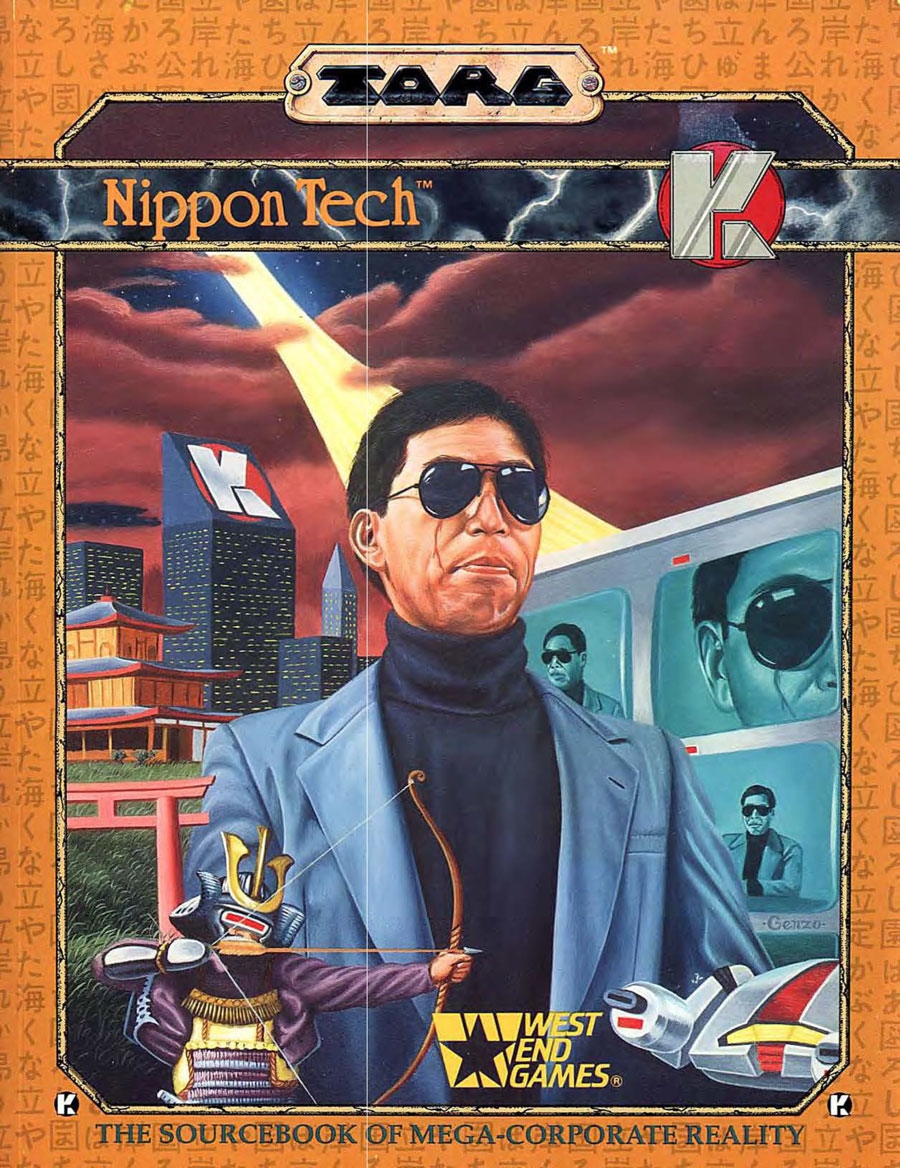
An executive works desperately in his office at 3 AM, seeking to recoup the ¥50,000,000 loss he is responsible for due to a deal gone wrong. He knows that if he fails to do so by the end of the day, he will be required to kill himself. He also knows that if he runs, he will be hunted down and killed by order of the board of directors.
A gun dealer sells stolen high-tech rifles to a group of Yakuza enforcers. Little does anyone know that one of the enforcers is actually a plant from corporate security, and his allies are closing in on the meet. Little does the plant know that he's also on the kill list.
A homeless man, unable to afford even the basic air mask now needed in Tokyo's terrible environment, volunteers for a drug testing program. Within a month, his body and mind will be so mutated by the chemicals in his system that he's nothing but a monster. The researchers will simply dump him back on the street when done with him.
A ninja slides into a 30th story window to assassinate an executive who framed his own brother for embezzlement to claim the brother's position. The brother eagerly awaits word of the executive's death, already preparing to reclaim his former wealth and position.
A office worker dies at his desk after his twenty-second 12-hour shift in a row. Before his body has finished cooling in the morgue, his assets are packed up and sold off by the corporation, and his replacement is already beginning work at the same desk.
Just business as usual in Nippon Tech, as ordained by its High Lord and CEO, Ryuchi Kanawa.
Nippon Tech
(Now, before we go any further, spend some time looking at this web site , particularly "overworked to suicide" and "internet cafe refugees", and watch this video . That's depressingly similar to what Nippon Tech is like.)
With the massive destruction in North America and multiple invading realities in Europe, the world economy is in chaos as the largest economic forces are tied up in the battle for reality. Thankfully, Japan has managed to improve its financial standing on the world stage, taking up the financial slack and keeping the global economy moving. Japanese corporations have begun directly aiding other countries, expanding and building locations that provide much-needed money and employment for the ravaged countries of Core Earth. Foremost of these is the Kanawa Corporation, which has recently become a major player on the world stage under the guidance of its CEO, Ryuchi Kanawa.
What nobody knows is that Japan has also been invaded by an alien reality known as "Marketplace", and by relying on Japan, the world is playing right into the hands of its High Lord, the head of the Kanawa Corporation, the ruthless 3327.
(And yes, his name is actually 3327. In his home cosm of Marketplace, names were long ago replaced with identification numbers. The numbers are four-digit numbers followed by seven decimal places, but people are referred to by their first four digits. This was decided long ago so that these "names" could be used as universal access codes for everything from online shopping to to banking, and put the people further under the control of the corporations.)
3327 managed to keep the invasion of Japan secret by having advance agents found the Kanawa Corporation with the wealth of other worlds, building a massive empty skyscaper to serve as "corporate headquarters", and dropping the bridge inside the husk of the building. He specifically chose Japan as the initial invasion point because it most closely resembled his home cosm, making subtle expansion easier.
In fact, it would be almost three years before the world would learn that Japan had been invaded in the first place. And as much of a surprise as it was to the world, it was more of a surprise to the transformed inhabitants of the realm.
By then, of course, it was far too late to do anything about it.
3327, a.k.a. Ryuchi Kanawa
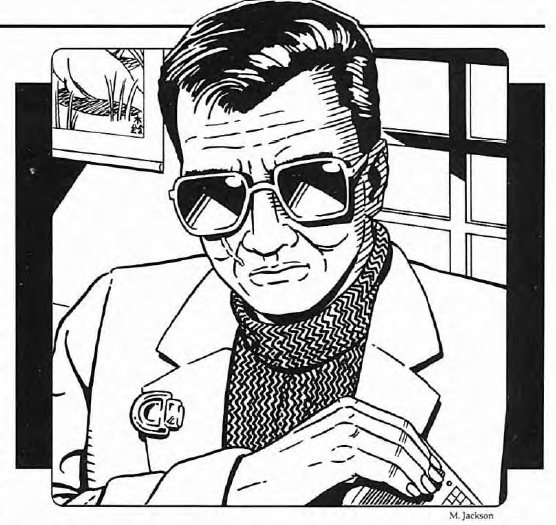
3327, High Lord of Marketplace
3327 has always been obsessed with profit, to the exclusion of everything else in his life. He has only ever performed one "good" act in his life: saving his mentor 2174 from a knife-wielding attacker. Even then, it wasn't at all selfless.
3327 posted:
"I could manipulate 2174, as I might not be able to his successor. It was in my interests at the time to keep him whole."
In thanks, 2174 put 3327 on the promotion fast-track. 3327 rose in the ranks of the Ursan Corporation, and repaid his mentor's generosity by passing along false financial reports that caused the older man to make unwise investments. In Marketplace, the price for financial failure is board-mandated suicide, and 3327 maneuvered his mentor so well the old man never knew he was stabbed in the back.
quote:
The man called 3327 did not start at the soft tone which summoned him to the Ursan Industries boardroom. Indeed, he had been expecting it, and welcomed the message it brought.
The meeting had already begun when he arrived. 2174 was pacing about the room, looking pale and unhealthy. He had failed to recoup the loss - it was all over but the begging, 3327 knew.
The meeting progressed as if he himself had scripted it, as he had, in a way: 2174 sweating and sputtering, trying in vain to explain why he had invested the firm's credits in an enterprise that collapsed; board members angrily pointing to plunging profits this quarter, and looking none too well themselves; and 3327, he who had engineered 2174's fatal error, doing his best not to let a smile disturb his carefully-rehearsed look of concern.
At last, the board had heard enough. Marketplace Security was summoned, and 2174 went with dignity to pay the cosm's penalty for unwise investment. When he was gone, all eyes in the room turned to 3327-without a word, the young executive walked to the head of the table and assumed the seat of power.
He had achieved his first conquest...
3327 rapidly turned the Ursan Corporation into the most powerful economic force in Marketplace, and also managed to seize control of the Triad, the governing force of Marketplace himself.
And just as he started becoming restless after taking control of his world, 3327 came across his world's Darkness Device. This artifact, which he later named Daikoku , promised the CEO more worlds to conquer, new wealth to accumulate in return for the possibility energy of these worlds.
Unlike other High Lords, 3327 did not work his way across the multiverse with rampaging armies. Instead, he approached every invasion as he would a corporate takeover: domination through financial control rather than strength of arms. There were times his forces were so subtle the invaded world didn't even know they had been taken over until it was far too late.
As 3327's empire expanded, he found it harder and harder to control the myriad worlds under his control. This was further complicated by the fact that 3327 refused to give anyone under him any real power in case it would be used against him. Then he hit upon the solution: through a combination of Marketplace's technology and the power of the Darkness Device, 3327 grew five clones of himself and copied his mind into each one. The clones were mentally linked to each other and to the original 3327; any thought or emotion felt by one would be felt by all. Now that he had these surrogates, he could truly run his multiversal empire from multiple places at once. Daikoku, for its part, fully supports this idea because it sees it as a sixfold return on its investment.
When approached by the Gaunt Man to help invade Earth, 3327 decided to manage this invasion personally instead of leaving it to his clone or to underlings as he normally did. He sent his agents to Earth on dimthreads to begin taking control of companies in Japan, laying the financial groundwork for the eventual takeover. He created the persona of "Ryuchi Kanawa" and created the Kanawa Corporation to undermine the country of Japan from within.
3327's whole worldview is based around the ideas of profit and loss. He is nearly emotionless, feeling only greed. Despite being a textbook sociopath, 3327 has spent a long time learning how to read and predict people to make up for it.
The only thing 3327 fears is bankruptcy; he barely fears death thanks to his clone back-ups, but despite that he knows he can still be executed by his board of directors for failing to turn a profit. Core Earth is his riskiest venture to date, and despite his personal wealth it's still possible for him to cut a loss if things go against him.
3327's to-do list is pretty much what you'd expect for the High Lord of a reality based around profit and gain.
1. Acquire Wealth. Profit rules all in Marketplace, and even as High Lord he has to maintain profits to stay in charge. But because he's a Possibility Raider, he has access to the wealth and treasure of countless realities. As it stands right now, 3327's net worth is in the trillions, but it is still not enough.
2. Become Torg. 3327 seeks material wealth, not ephemeral power, but becoming Torg would make him truly immortal without needed to rely on his Darkness Device, and immorality means an eternity of gaining wealth.
3. Keep the realm a secret. Kanawa's operations on Core Earth are dependent on nobody knowing that Japan has been invaded. The other High Lords know he's there, of course, but don't seem to be interested in leaking the information to the world.
4. Expand the realm. More territory = more stolen possibility energy. 3327 knows that his Darkness Device is as dedicated to profit as he himself is, so he makes sure to keep it happy.
5. Find eternity shards. Daikoku can drain possibility energy from these artifacts, so 3327 seeks them out to feed to the Darkness Device.
6. Recruit new forces. 3327 is always on the lookout for new sources of profit, so he has begun an effort to recruit operatives from other realms. Partially so he can get inside information on the other High Lords, but also because he wants access to the technological assets of the Nile Empire and the Cyberpapacy.
7. Contain the other realms. 3327 has no direct allies. He sees every other High Lord as a threat to be dealt with (even as he sells them weapons). 3327 knows that he controls the least amount of territory out of all the Raiders, and he needs territory to expand into for possibility energy and raw resources. This also means he needs to drive the other realms off existing resources.
At the core of everything 3327 does is the drive for profit. It informs every decision he makes, and he sees nothing wrong with selling to every side as long as he makes out on the deal. 3327 has no allies, only customers and tools.
3327 and the other High Lords
3327 sees every other High Lord as a pawn to be used in his own long-term plans, or against each other. He has made no serious alliances with anyone, and in fact actively works against almost every single one of them.
3327 sees Dr. Mobius as one of the biggest threats due to his scientific knowledge and unpredictability. 3327 has been attempting to turn one of Mobius' overgoverners against him, but it's slow going. 3327 has also been funding Israeli forces fighting against Mobius so the Kanawa Corportation can seize control of the oil fields.
Baruk Kaah hates 3327 with a fiery passion. Kaah has learned that American freedom fighters are getting their arms from the Kanawa Corporation, and 3327 was instrumental in the destruction of Kaah's western bridge and loss of most of that territory. In fact, 3327 would drop a bridge in California shortly thereafter, further cutting off that land from Kaah.
While the techno-demon Thratchen is technically not a High Lord, he is managing Orrorsh in the Gaunt Man's absence. Thratchen has recently learned that the reason the Tharkhold invasion failed because the Russian psychic research project that predicted it was funded by the Kanawa Corporation. The only reason he hasn't acted on this knowledge is because he doesn't have his own Darkness Device to back him up.
3327 was as shocked as anyone when Pope Jean Malraux initiated the Tech Surge, and this had a strong effect on 3327's plans. Before the Surge, 3327 pretty much wrote off the False Papacy as a backwater realm that wasn't a threat. Now, he wants access to the cybertechnology of that realm. He has begun sending in operatives and opening factories in the realm to reverse-engineer the technolgy so he can sell it to the rest of the world.
Like the other High Lords, 3327 isn't sure what to make of the situation of Aysle. With the former High Lord Uthorion ousted from the body of Lady Ardinay, he's decided to take a wait-and-see approach until he knows if a new High Lord will arise.
Axioms and World Laws
The world laws of Marketplace have evolved to compliment and reinforce the way the overall culture has been driven.
First up is The Law of Intrigue , which may be a side-effect of 3327's control of the cosm. This law states that deception is easier in Nippon Tech, and betrayal is common. The mechanical effect is that skills like stealth or disguise get significant bonuses, as do attempts to use skills like persuasion when you're lying. A side effect of this Law is that any organization that has at least 100 members will have at least one traitor in its ranks , and larger organizations will have whole cells working to undermine them. Betrayal has become so common it's now baked into the reality itself.
Next is The Law of Profit , and it's the reason why the rich stay rich and the poor stay poor. This law states that people of means will be able to spend less money on goods and services, while poorer people will have to spend more.
I'd be remiss to not let Sir Terry Pratchett sum it up better than I ever could:
Men At Arms posted:
“The reason that the rich were so rich, Vimes reasoned, was because they managed to spend less money.
Take boots, for example. He earned thirty-eight dollars a month plus allowances. A really good pair of leather boots cost fifty dollars. But an affordable pair of boots, which were sort of OK for a season or two and then leaked like hell when the cardboard gave out, cost about ten dollars. Those were the kind of boots Vimes always bought, and wore until the soles were so thin that he could tell where he was in Ankh-Morpork on a foggy night by the feel of the cobbles.
But the thing was that good boots lasted for years and years. A man who could afford fifty dollars had a
pair of boots that'd still be keeping his feet dry in ten years' time, while the poor man who could only
afford cheap boots would have spent a hundred dollars on boots in the same time and would still have wet
feet .
This was the Captain Samuel Vimes 'Boots' theory of socioeconomic unfairness.”
This law doesn't mean that prices will change at the register; it means that the available options to buy things varies depends on who's buying, and the rich will have access to places that will charge them relatively less.
Because of this, if you start sliding down the socioeconomic ladder it's damn near impossible to claw your way back up. It's not just that the upper class is keeping the lower classes down, it's reality that's keeping them down.
The final law is The Law of Vengeance . This law is tied to the Law of Intrigue, and rewards an "eye for an eye" system of justice. The short form is that any character who takes revenge against someone who wronged him will gain six extra possibilities at the end of the act. It does need to be revenge for a significant loss; you can't get revenge for someone shooting you in the leg, but someone shooting you in the leg and leaving you for CorpSec so they can get away is worthy. The only other limitation is that you have to wait at least 48 hours after being wronged. Best served cold, and all that.
The axioms of Marketplace and Nippon Tech reflect the decline of "human" culture and the rise of corporate culture, yet are close enough to Core Earth's that the inhabitants of the realm have barely noticed any major change apart from "wow, things are getting pretty bad in this neighborhood".
Technology: 24 The technology of Marketplace is just ahead of Core Earth's by maybe a
decade. Unfortunately, this is from the point of view of the early 90's so you get a weird mix of stuff
that's still not even close to being possible (laser rifles, flying cars) and things that are low-tech by
modern standards (supercomputers with 256Mb of RAM).
The two technological fields that are having the largest effect on the rest of the world are medical technology and weapon development. Because Nippon Tech corporations aren't bound by those pesky medical ethics or worldwide regulatory programs, human testing is pretty much "anything goes". This has led to some more advanced technologies like better replacement organs and functional prosthetic (not cybernetic) limbs, it also means that human testing often involves hiring homeless or lower-class people, pumping them full of drugs, and seeing what happens.
Weapons technology has become a booming industry, what with the battle for Core Earth and all. Because everything in Nippon Tech is dedicated to profit, Nippon Tech companies are more than happy to sell to anyone . They'll sell guns to NATO forces in preparation for an attack on a Nile Empire outpost, then turn right around and sell guns to the Nile Empire. As a result, the other High Lords aren't too happy with 3327 because he's arming the "good guys" as much as he's arming the other High Lords.
(It's important to point out that because 3327 understand reality mechanics, he maintains companies and manufacturers who build weapons for lower-tech realities using the methods of those realities. Yes, if you buy a Nippon Tech rifle it's going to be Tech 24, but you can also buy a Tech 15 matchlock musket to use in Aysle, or a Tech 22 .30 M1 Carbine that works fine in the Nile Empire without causing a contradiction.)
One side effect of Kanawa Corporation's operations is that the technology of Core Earth is getting a bit of a boost as Core Earth manufacturers reverse-engineer the higher tech.
Social: 22 This is a weird one. While technically a bit higher than Core Earth's social axiom, the fact that the culture is a mix of corporate culture and feudal culture means that things have gotten worse in Japan. The crime and unemployment rates have more than tripled, suicide and drug use rates have skyrocketed, and the class divide is wider now than it's ever been. Being an employee of a megacorporation means that they pretty much own you, and even if you're on the the board of directors you're still considered a completely disposable asset .
Magic: 2, Spiritual: 8 Nippon Tech has the second-lowest magic axiom out of all the realities (Living Land it the lowest at 0). The drive for material profit has resulted in a cultural mindset of cold rationality, driving out the concepts of spiritual fulfillment, and magic was never a large part of the culture to begin with.
A side-effect of the low magic and spiritual axioms is that, to Core Earthers or people from other realities, everything in the realms feels... off . Part of what most people think of as "normality" is due to the natural levels of magic and community we live with daily. In Nippon Tech, visitors are deprived of those levels. It's like the sudden absence of a sound you've heard so much you don't notice it until it's gone.
As a result, everything feels empty . People on the street don't even come close to making eye contact no matter the situation. Every strange event seems larger and more oppressive. Death or suicide due to overwork is incredibly common because there's no sense of fulfillment outside of your job.
The combination of all these factors results in a world of almost total oppression. The inhabitants are barely even treated as people by the corporations, the crime lords are running rampant because the cops now only serve corporate interests, and it's impossible for most people to rise above their current financial situations.
Now, this is where I'd normally say something about the heroes fighting back and how there's still hope for the common folk and yadda yadda yadda.
But that's not the case here.
Here, you're barely a person. You're a cog in the machine, a tool to be used by your corporate masters. Once you're used up, you're thrown away and replaced. If you complain, you're out on the street. If you're on the bottom rung of the ladder you're staying there, and even if you're on the top rung one mistake will get you kicked off the ladder. The only possible help can come from outside the realm, but why would anyone help when they don't even know you're in danger?
And if you've got a problem with that, there are hundreds of people out there who'll be more than happy to fill your position. I can go down to HR and pull five names at random that can do your job. So keep your head down, shut up, and do your job unless you want to wind up on the street.
Now get back to work.
NEXT TIME: Economic realities!
Economic realities
Original SA post The storm has a name... - Let's Read TORG
Part 12b: Economic realities

Chapter Two is about The Cosm , which means we're going to learn about how Marketplace wound up in its current situation.
The creation myth of the world of Marketplace has, in fact, been made illegal by the worlds' government as part of the banning of the former global religion. The world was originally called Gokuraku , and was a "verdant, abundant world" where there was no real concept of need. Everyone was able to have what they wanted, and there was no real concept of "greed" or self-ambition as we think of it.
quote:
All of this changed, according to the legend, when a villager named Weng-Ju scaled a mountain peak and discovered a great valley, cut in two by a sparkling river. All about him he could see trees heavy with golden chestnuts, thickets filled with wild figs and almonds. Never before had he seen such beauty, and of a sudden a dark thought crept into his mind: no one else but he could truly appreciate the wonder of this place, so no othereyes must be allowed to look upon it.
Weng-Ju told no one of his discovery, but many of the villagers began to wonder where he found the delicacies he enjoyed. Soon, the people grew jealous and began to whisper that Weng-Ju was a sorcerer, and should be cast out of the village. But one young maiden, who loved Weng-Ju, insisted it was not so, and said that she would follow him when next he left the village, and return with proof that he was a good and honest man.
For many days, the maiden, Lin-San, followed her beloved without his knowledge. When she reached the peak of the mountain and saw the valley below, she gasped, a small sound that Weng-Ju heard. Infuriated that someone else had discovered his wealth, Weng-Ju hurled a stone in the direction of the sound.
Struck, Lin-San fell dead. Weng-Ju brought her body back to the village, only to find himself branded a murderer by his people. Fearing their wrath, he offered to share the secret of his great wealth with any who would defend him. One man, and then another, came to his side, and Gokuraku wept.
That's the legend, anyway.
But before we get to that, we run headlong into Standard Torg Disorganization and now we're learning about the Geography and Environment .
Modern-day Marketplace, like most of the invading cosms, is fairly similar to Core Earth. It has smaller landmasses spread out over its surface, a similar climate, and so on. But the expansion of the corporations has even had an effect on this.
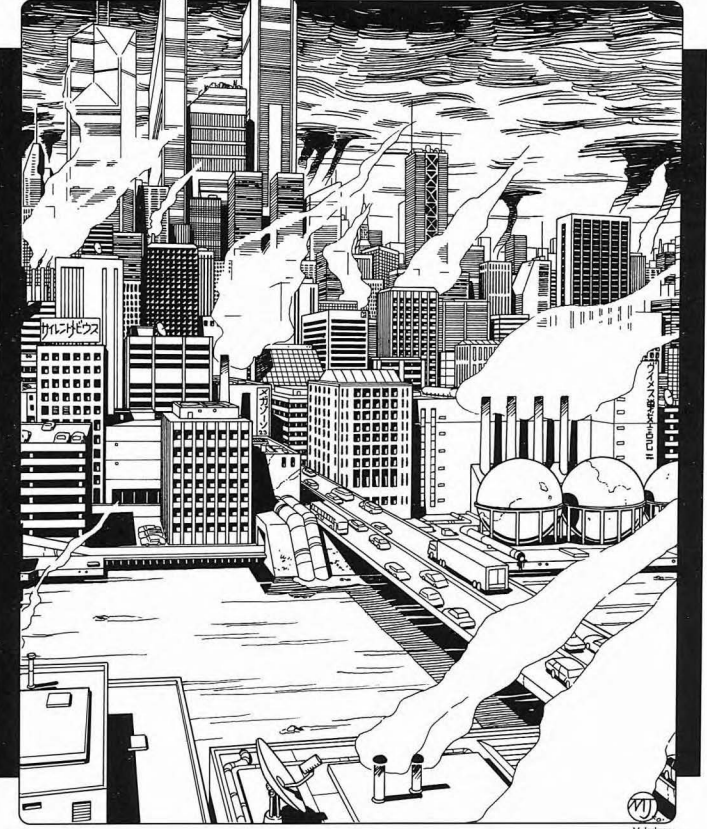
This is a different world, all right.
Due to a rapidly expanding population, the landmasses are not only completely covered by megaplexes, the giant cities have actually had to start building out over the oceans on raised platforms. All available land has been covered by the megacities; there is no "natural" land left. No forests, no mountains, no beaches. Everything has been paved flat and built on. There's barely any wildlife left as well; at most you'll see wild "domesticated" animals like dogs in the back alleys.
This, of course, has had a terrible effect on the environment. The heavy reliance on industrialization has caused extreme global warming. Summers are long, and winters have large temperature swings. In fact, there's so little difference between the seasons now the only way to tell them apart is by the changes in temperature and rainfall.
The megaplexes themselves are the ultimate urban nightmare sprawl. Giant skyscrapers and run-down buildings crowd together along narrow streets, and even though "hover cars" exist, few can afford them so the streets are constantly clogged with traffic.
The environment outside of the megaplexes is a wreck. The extreme climate changes combined with the heavy polution from non-stop industrialization mean that the air and water are pretty much destroyed. A thick smog hangs over most of the planet's surface, and the oceans are toxic slurries
The near-total destruction of the environment has been "dealt with" by creating sealed-off environments in most of the world. Large chunks of megaplexes (that are owned and lived in by the wealthy) are enclosed, UV-shielded, have water filtration, and are climate controlled.
The poorer sections of the megaplexes, however, aren't as lucky.
quote:
Water pollution is no less severe, with industrial waste pumped daily into the rivers and seas. Apartment
complexes and office buildings have their water pumped in through complicated filtration systems, a frequent target for sabotage by opposition groups. The exact chemical content of the water changes daily, and those burakumin who do not take the precaution of boiling the water first can expect a lingering and painful death.
U1traviolet radiation has also become a problem in Marketplace, due to the destruction of the ozone layer by fluorocarbons. Very little attention has been paid to this situation, beyond UV-coating all windows, since it is felt that anyone who spends a prolonged amount of time outdoors is asking for trouble anyway.
Finally, the poorer classes are often made the victims of covert product testing by various chemical companies, which may account for the high percentage of deformities and mutations among the homeless, particularly in Donglin.
These abysmal living conditions are only seen as business opportunities by the corporations. There's a huge market for anti-polution devices, air filtration masks, and UV-resistant clothing. And if people don't want to buy? Well, then the "lower classes" problem pretty much takes care of itself.
quote:
Hanwa, in the arctic zone, is the most challenging continent upon which to live, but also the safest, for few of the burakumin can survive for long outdoors and thus the level of street crime is low.
The nest section is The History of Marketplace , and covers the actual history of the cosm.
For the most part, Marketplace's historical development was roughly the same most places on Core Earth. There was the give-and-take between the main cities and the rural areas, each supporting the other. There were wars of various sizes that led to an extended period of peace. And that's where things started to go bad.
The extended peace made the various corporations that had been profiting off the various wars nervous; war stimulates the economy, and without major conflicts it was beginning to stagnate. A coalition of arms dealers hired numerous ronin flare up minor border conflicts and bribed government officials to fan the flames of hostility. It wasn't long before small conflicts sprang up and and the money started rolling in again.
Thus were private corporate intelligence services born.
Things escalated into another world-wide war, with the mutitions companies raking it in and pulling the strings behind the scenes. Then something happened that was beyond even the companies' wildest dreams.
quote:
But the war had a happy side effect the companies had not anticipated - weakened by public outcries against the war, governments began to topple, and the people turned to successful businessmen to rule in the place of politicians and kings.
Industry accepted the challenge, and in the name of "rebuilding the shattered economy," began dismantling environmental legislation and various labor laws. Full-fledged "factory towns" began to appear, where employees were clothed, fed and housed by their firms - but employers were quick to point out that if a worker should be fired, he would quickly find himself naked, hungry, and out in the cold. Unions came into being, not to defend the rights of workers, but to point out any malcontents to the company for the good of all.
Any corporate executive who was hired to run the coallition of governing companies would invariably favor his old company in "govenment" matters. This would lead to people from rival corporations hiring freelance ninjas (and eventually bringing them onto the payroll) to eliminate the leader so they could place their own stooge in his place.
This cycle repeated so much it led to bloody corporate warfare across the land, and resulted in a summit between the major CEOs. Realizing that there was no way to have one person in charge be completely neutral, and that each corporation had a stranglehold on its own territory, they reached a descision: the corporations took direct control of the government, disolved all national borders, and started a one-world government run by the three largest corporations at the time.
The first thing the new Triad did was institute a worldwide change that tied the larger culture to their control.
quote:
The three firms instituted a system in which names were replaced by numbers which, along with a retina scan, served as an access code for computer banking and shopping, as well as entrance to buildings throughout the cosm. Without a number and a known retina pattern, it is virtually impossible to accomplish anything in Marketplace (the numbers consist of four digits followed by seven decimal places, i.e. 3327.7257901, but most people are commonly referred to by the £rst four digits only). Ignored in all of this, for the most part, were the world's social ills, which had resulted in more and more people turning to the religion of Palan.
When 3327 got his seat on the Triad, he instituted the First Article of Incorporation:
quote:
"Whereas, citizens of Marketplace have the inalienable right to own property;
"And whereas, the right to own implies the right exclusively to occupy;
"Therefore, be it resolved that those citizens over the age of 21 who do not own or lease property have thereby forfeited all rights granted by any charter, declaration or other document currently extant in Marketplace."
And now we learn about the Government . Since I've talked way too much about the background of the cosm that you can't easily go to in-game, I'll just sum up here.
The Triad consists of the CEOs of the three most powerful corporations in Marketplace. There's no elections or anything; Triad membership is determined by company profits and holdings. The current members of the Triad are:
-
3327
, head of the Ursan Industries. Even though he is the High Lord, he doesn't have full control of the corporate world itself yet. He has been quietly aquiring shares and terriotry of the companies of the other two Triad members in an attempt to bring the cosm under his direct financial control.
-
9021
, head of Shori Petroleum. He knows there's
something
weird about 3327, but since he doesn't know about the Darkness Device, he doesn't know the full extent of 3327's actions. He is aware that 3327 is attempting to control the Triad, and is carefully spreading word of this to other corporations.
-
6365
, head of Misaki Computers. Thanks to the Law of Intrigue, she's actually a traitor to the Triad. She is one of the leaders of a group called
Kashi
; a secretive environmental group that wants to overthrow corporate culture and try to fix the damage done to the world.
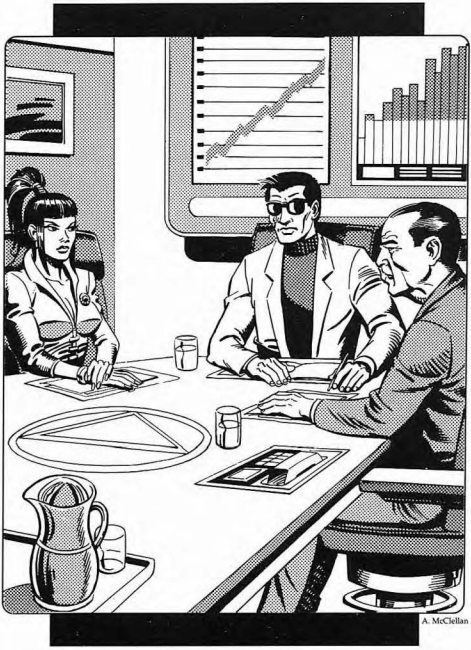
The Triad in a rare face-to-face meeting
The will of the Triad is enforced by Marketplace Security , who act as "law enforcement", but whose real job is to maintain the interests of the corprorations. MarSec has actually gotten so powerful they're almost autonomous now, but thanks again to the Law of Intrigue the larger it gets the more traitors from rebel groups start showing up. Regardless, MarSec tends to treat the lower classes with a "shoot first, ask questions never" policy.
One of MarSec's main jobs is enforcing one of Marketplaces most important laws: corporations must produce profits. If a corporate executive does something that causes his company to dip into the red, it's quite common for that executive to bankrupt himself to counter the corporate loss.
If he fails, then MarSec steps in. The executive is informed by a MarSec agent that he has dishonored both himself and the firm, and is given 24 hours to redeem himself by generating enough profits to make up the loss, at which point he must commit suicide as the price of his failure.
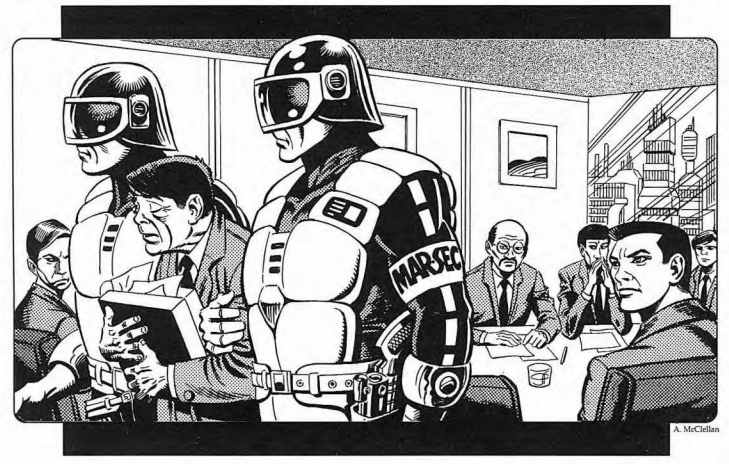
And don't even think about asking for a gold watch.
At which point MarSec stacks the deck against the poor bastard. He's immediately escorted from the building to his apartment (away from his files), all his personal possessions are confiscated to be given to his successor at the company, and he is then padlocked into his apartment and a guard is placed on the door. It's at this point that the executive will be informed that his number and retnal pattern have been erased from the system. He's ultimately cut off from any legal access to methods of generating profit.
If the executive doesn't kill himself in the 24-hour stewing period, MarSec will do it for him...unless the guy can escape pursuit. MarSec denys all rumors that this has happened, of course.
(It's worth pointing out that even 3327 is subject to this rule; if he ever failed to make a profit, MarSec would be fully empowered to hunt him down and kill him. They'd probably succeed, too, since Daikoku will drop 3327 like a hot potato should he fail to earn.)
And from here we bounce to Money and Economy .
The base monetary unit in Marketplace is the credit , and only exists in digital form. One credit is worth about $2 or ¥240. All banking is done via computer, and means that every transaction made is closely monitored by the corporations.
quote:
Under this system, a banking transaction would work like this: 2730 wishes to remove cr~dits from his account to purchase a jeweled dagger. He enters his number into a terminal and submits to a retina scan of his right eye. When the computer determines that the retina pattern matches that logged in 2730' s file, it will inquire about the nature of the transaction.
2730 then types in the item he wishes to buy, and from whom he wishes to purchase it. The computer will then
automatically transfer the credits from 2730's account to that of the seller, and the item will be delivered within one day of purchase.
The next section is just the names of the largest corporations, but forgive me for skipping it because it's pretty must just a list of names. Instead, I'll talk about Maelstrom Markets . Maelstrom Markets are a way that 3327 has managed to draw profits not only from other cosms, but from other Marketplace corporations.
As stated previously, there is literally no place left to build on Marketplace. This means that it's impossible to create new markets anywhere in the world since everyone's under the thumbs of the corporations. When 3327 discovered Daikoku and learned of other realities, he assembled other CEOs and announced that his research teams had "accidentally" broken the transdimensional barrier. Now they could access new worlds, create new markets, and all they had to do was send operatives to these new world, set up the
The next section is about 7710, 3327's protege, but since this is another plot point that's immediately forgotten you'll forgive me for skipping it.
We also get a bit on ninjas, but it boils down to "see next chapter", but for now all you need to know is that every corporation pretty much has its own ninja clan working for it, but there are also freelancers.
Now it's time to learn about Life in Marketplace . Marketplace operates under a pretty rigid social class sysem defined by the enconomic system.
At the top of the heap are the "upper classes", the people making 50k credits or more a year, and have the best living conditions. The middle class is defined as people making between 15k to 40k ($30k to $80k) and make up the bulk of Marketplace's population. Below them are the lower middle class (10k credits or less a year), and take the economic position of "doing the jobs nobody else wants to do". Interestingly, the lower middle class generates the most MarSec agents, ninja, and ronin.
Below the lower middle class are the burakumin; the homeless and hopeless who have no way to rise above their station. Due to being forced to live outside the climate controlled areas, a large percentage of the burakumin are phsyically deformed or suffering from mental illnesses.
Recently, the burakumin have begun to form an organization called the Shiki in order to forcefully defend themselves against MarSec forces. Foudned by an executive who actually resigned of his own free will and renounced his number for a name, and began organizing the more capable burakumin into a fighting force in an attempt to overthrow the corporations.
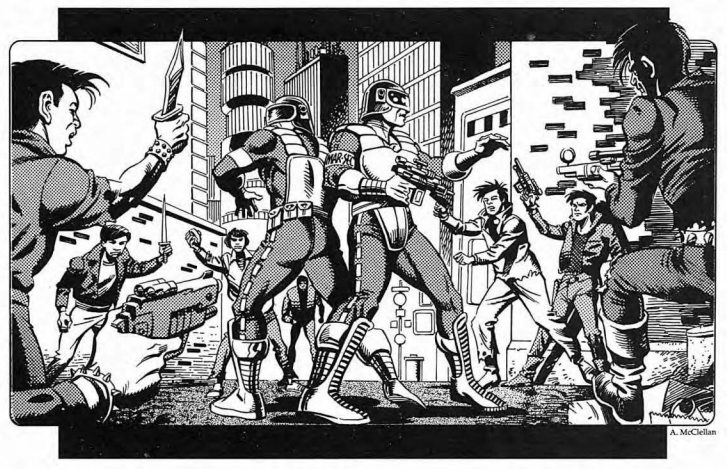
This is not where they parked their car.
The other group actively fighting against the corporations is Kashi . Kashi is a worldwide organization of militant ecoterrorists who want to destroy the corporations and try to fix the damage done to the world by unchecked industrialization. Unlike Shiki, Kashi actually operates heavily inside corporate culture, manipulating executives against each other and sabotaging climate control systems. Unfortuntely, they've also done a large amount of damage to the general population due to destroying the systems required to get clean air and water, or allowing defective products and medicines to be sold because a Kashi operative made important chemicals unavailable.
Oh hey now we're talking about Ronin ! Have I mentioned that these books aren't organized very well?
There's not much here; ronin are just mercenaries, but going by the templates in the back of the book they still dress like samurai even though everything else is "modern day".
Next up are mutants . These aren't the fun superhero mutants, though. Given the omnipresent pollution, lack of oversight on drug testing, and corporate sabotage, genetic mutations among the burakumin are disturbingly common. Yeah you might get super-strength, but you're more likely to get lesions in your brain. Mutants have pretty much been driven into the megaplex sewer systems, but it's not uncommon for one to completely snap and go on a killing spree.
Which leads us logically to Law and Justice , of course. Laws are created by the Triad, approved by the corporations, and enforced by MarSec, end of sentence. It's a very Judge Dredd-ish situation, where technically there's trials to determine guilt, but 99% of the time MarSec is going to chase you down and put a bullet in your head for breaking the law. Especially since there's no prison system; housing, clothing, and feeding prisoners is deemed a drain on the economy. Minor crimes are punished by "exile" to the ranks of burakumin, while major crimes get the aforementioned bullet. 3327 has also begun using this "justice system" as a source of corpses for his gospog fields.
We also get some info on The Sexes in Marketplace . Gender equality is the norm (and grew out of women working in munition factories during the big unnamed wars), but it's actually in a "both sexes are equally repressed" way due to how people are seen as just cogs in the machine. The megacorps actually mandate marriage and childbirth, and it's not uncommon for a marriage to be arranged as part of a corporate merger. Children are raised and taught inside the culture of their parents' corporation, often having more emotional loyalty to the company than to their parents.
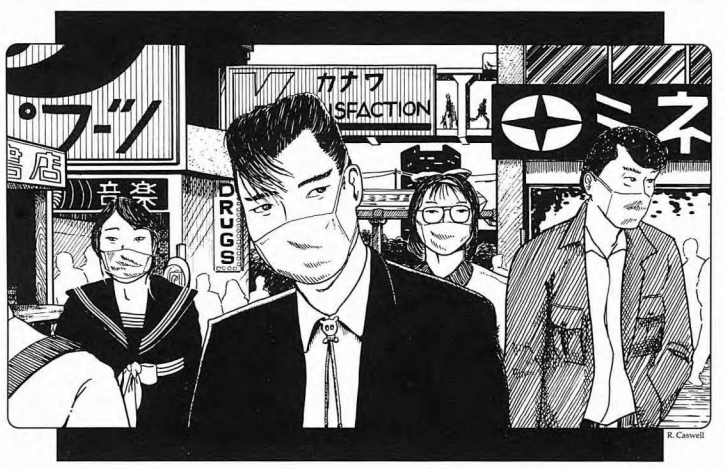
Nope, nothing like Core Earth Japan at all.
Fashion in Marketplace is pretty much the same as Core Earth's Japan. I don't know why there had to be a subheading on this.
The last part of this chapter is about Religion , or the lack thereof. Before 3327 rose to power, organized religion was seen as just another tool used to manipulate the masses. In fact, it wasn't unknown for some corporations to work a worship of the company into its culture and preach that profits were the path to Heaven.
quote:
If the people were growing dissatisfied with this passive brand of religion, they didn't show it until the priests of Palan appeared. Where the order came from remains a mystery, but rumors of its origins have ranged from disaffected mega-corporate executives seeking spirituality to a vast plot by the Shiki to rally the lower classes.
Whatever the truth may be, the fact is that the Palanic priest's anti-materialistic creed rocked Marketplace to its foundations. Suddenly, the workers were questioning whether toil and credits was all there was to life. The radical idea that perhaps the possession of wealth did not necessarily mean the presence of wisdom or honesty undercut Marketplace's peculiar social contract (which reads something like, "You work to survive and to make us richer, and we allow you to do so.") People began to talk about the lack of any semblance of upward mobility in the mega-corporate structure, and found appealing the Palanic idea that it was possible to attain higher levels of spirituality through faith.
Unfortunately, the Palan leadership fell for it.
The resulting massacre led to the death of 80% of the membership of the Palan religion, and drove the survivors underground. From there it mutated from full-blown religion to a secretive cult. They're not sitting on their haunches, either; they've learned of the Maelstrom Markets and have managed to destroy three bridges on their own. This has had the nice side-effect of causing Daikoku to think that maybe 3327 isn't as capable as it first thought. Palan priests have managed to sneak onto Core Earth, and are starting to make their presence known in the realm.
Lastly, there's some stuff about adventuring in the cosm and two sample adventures but honestly who could care at this point.
--
This chapter is just over 20 pages long. It talks all about the details of the cosm, which you can't easily get to, and it's the longest chapter in the book .
I mean, I get that understanding how the homeworld got to the state it's in and the state it's in now will affect your understanding of the realm itself (where you're actually going to be playing), but come the fuck on. This did not need to be this goddamn long.
What's worse, there are some interesting things scattered here and there that could make things more interesting (like the Judge Dredd-style lawmen), but they stay focused on the boring details and let the actually cool stuff fly by. Hell, if I wasn't doing this read-through you you guys I never would have noticed that idea.
Hopefully things'll go faster from here. At least it's only one book this time!

NEXT TIME: Exciting new opportunities!
Exciting new business opportunities!
Original SA postThe storm has a name... - Let's Read TORG

Part 12c: Exciting new business opportunities!

Oops, turns out I was wrong last time; this is the longest chapter in the book. At least it's about the realm itself, where the PCs actually go . So that's something, anyway!
The most important thing you need to remember about the Nippon Tech realm is this: none of the good guys know it's there yet. Where the other High Lords came down with bridges made of trees or light or corpses dropping out of holes in the sky, 3327 drops his bridges inside specially hulled-out skyscrapers. The reality of Marketplace is so similar to that of Core Earth Japan that the only real outward sign of the change is that the economy is booming, businesses are doing better, technology is advancing a little faster, and 15-hour workdays are becoming the norm.
That's not to say it's been an easy ride to hide the realm's existence. The other High Lords know, of course, but so far it's not in their best interests to reveal his existence just yet, and besides it's not like they could hold a press conference or something. There's also the problem of the reality storms that exist around the borders of every realm; 3327 has reduced the possibility drain of his stelae to minimize the power of the storms as much as possible and blames what's left on the proximity of Orrorsh.
So far, it's working. The other governments of the world are too busy trying to deal with the obvious invaders to pay much attention to Japan, and on top of that Japan has had to step up as a world financial and technological power now that North America and most of Europe are out of commission. That's not to say people haven't noticed all these corporate mergers all over the place, or the rise of the Kanawa Corporation, but there's no hard evidence that Ryuchi Kanawa (3327's Core Earth identity) is doing anything really illegal. There's some suspicion that he's a High Lord sympathizer, but as of yet nobody suspects the truth.
(Just to skip ahead in the timeline, it'd be about three years before anyone realized that Nippon Tech was there and that Ryuchi Kanawa was a Possiblity Raider.)
The other sign of Marketplace's invasion is the thick fog that now hangs over the land, the side-effect of the low Magic and Spiritual axioms I talked about back in the first Nippon Tech post. The Kanawa Corporation has stated that this is a harmless side-effect of a process that derives power from sea water, and since the Kanawa Corporation controls all the major media and news outlets in Japan this is being heavily downplayed in the news.
The aftereffects of the invasion as a little harder to hush up. The higher technology brought over from Marketplace has given the Japanese manufactuing industry a shot in the arm, and has caused a sharp spike in most industries. When corporate expansion began to encroach onto Japan's already dwindling agricultural spaces, there were protests as land became scarce and food prices began to skyrocket.
quote:
The tremendous development of the countryside sparked some protests, all of which were ignored by Japanese officials, thanks to 3327's successful efforts at bribery and intimidation of various government officials. Pointing out the loss in employment and tax revenues Japan would suffer should his firms decide to relocate to another country, 3327 was able to win concessions from the government that virtually erased all the environmental regulations put in place over the last 20 years. Ministers who supported his positions were given either a monetary expression of gratitude or a stock tip they could benefit from. Those who resisted his entreaties often fell victim to what the Kanawa-controlled Tokyo Shimbum called "the rampant climate of lawlessness in our cities."
Of course, between the industrial expansion, higher technology, and overlaying reality, pollution has begun to rise sharply. Even outside the major cities, the air and water quality has gotten to the point where people don't go outside unless they have to. Of course, Kanawa subsidiares are taking advantage of this by selling air filter masks and new shop-from-home systems.
The arrival of the Laws of Profit and Intrigue has caused the crime and poverty rates in Japan to reach an all-time high. The widening gap between the haves and have-nots has caused an increase in the homeless population due to people losing their jobs or being unable to afford to live anywhere else. Not helping matters is 3327's attempts to stamp out Storm Knights in his territory, which leads to huge shootouts between the Knights and corporate security forces that result in a lot of property damage and innocent bloodshed. What's worse; the population is just getting used to this as "the way things are now".
Basically Japan is currently in a slow decline that's leading it to becoming just another "subsidiary" of Marketplace, but the decline is being maintained at such a slow, subtle pace, nobody's going to notice anything until it's too late.
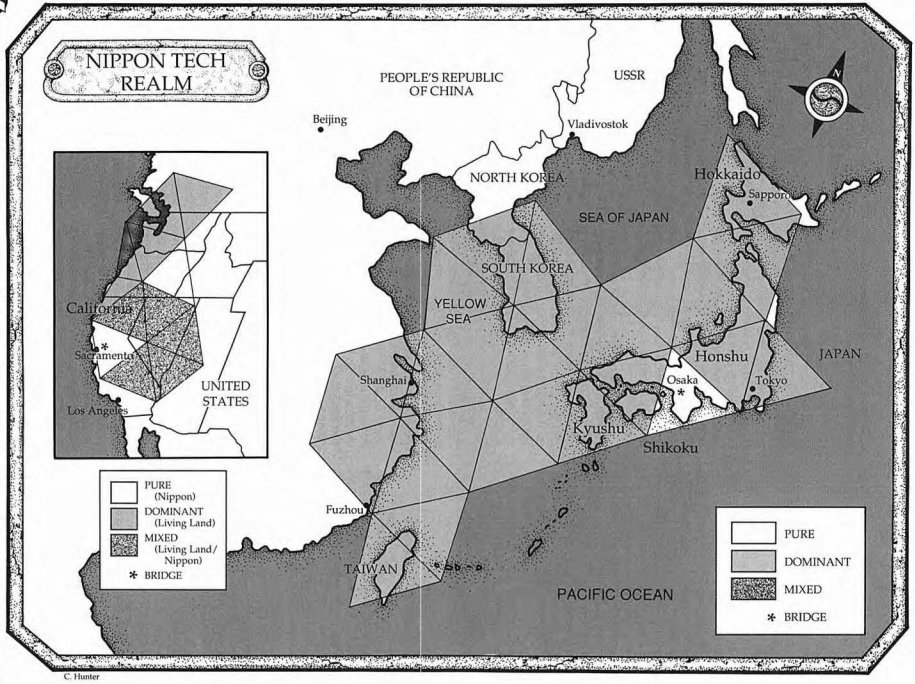
The Nippon Tech realms, about three months after the initial invasion.
3327 has two bridges in play: one in Osaka as part of the initial invasion and one in Sacramento, California that he set up a few months later after Baruk Kaah was driven out of that part of America. He did try to drop a bridge in Hong Kong, but was stopped by a force of Storm Knights.
The next section is about the Japanese Government , and is mostly factual information about how the government is set up because, again, this is the pre-Wikipedia era and it wasn't as easy to look up a simple summary.
The main reason we get a page of info on how the Japanese government is set up is because we need to know how 3327 is controlling it. He's doing it primarily through the Diet , first through bribing officials and eventually by putting his own operatives in office. Three months after the invasion, 3327 effectively controls about half of the House of Representatives and a little under half of the House of Councilors. It's not enough control to pass legislation whenever he wants, but it's enough to block any laws he doesn't like the sound of or push laws through to advance his agendas. The main examples of this are the removal of most environmental regulations, and the "Boom Law", which gave corporations sweeping tax cuts to spur growth and put the financial burden on social and civil programs.
Again, nothing like real life.
It should be pointed out that 3327 has (as of yet) not attempted to replace the current Prime Minister. He knows that would be to noticable a move, so this highest-placed Kanawa operative in the government is the Foreign Minister.
3327 has had little restraint when it comes to the judicial branch of government, though. He's been spreading money around, and the corruption rate among the regional magistrates has tripled in a little under a year. 3327 also has two supreme court justices under his thumb, and has MarSec agents infiltrating police forces throughout Hong Kong.
Technially speaking, the top level of government is Emperor Akihito , but the fact of the matter is that he's seen as more of a symbol than anything else. Still, he's realized that, even with the multiversal invasion going on, some strange things are happening in Japan. He's working with a group called the Rauru Block to try and sieze control of the Diet back from whoever's controlling it.
The next few sections are about the various locations controlled or directly threatened by 3327, and starts with Tokyo .
Tokyo is the largest city in Japan, and has been hit the hardest by 3327's arrival. The sudden industrial boom caused an influx of over 2 million people seeking work, which has caused a severe housing shortage (especially since 3327 has had most of the city's public housing torn down and has defunded social programs). Not only has this caused a marked increase in the homeless and crime rates, it also helps keep the blue-collar workers under the control of the corporations. After all, if you don't like your job there's literally thousands of people ready to replace you, and then it's you living on the street.
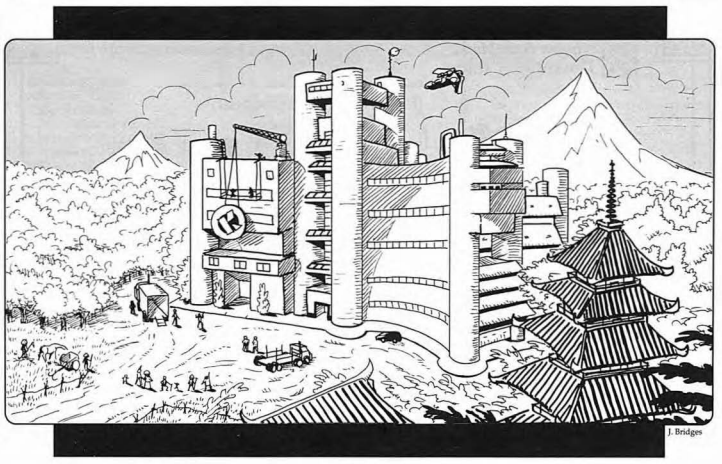
The current population of Tokyo is 11 million, but the unemployment rate currently stands at 44% and shows no sign of improving. Not that things are any better for the middle class; due to the surfeit of workers most employees are treated like replaceable cogs now more than ever. To quote from the Tokyo Citybook:
quote:
UPPER CLASS LIFESTYLE CASE STUDY: MR. KANEDA
Mr. Kaneda is the current CEO of Murano Trust Investment (located in Nihombashi). He is a relatively young chief executive, at 53. He nets a yearly salary of "350 million and supports a mansion in Meguro and a penthouse in Nihombashi. He also owns country houses in Karuizawa and Okutama.
His primary hobby is collecting rare art from foreign countries. Beneath his Meguro mansion is a large gallery of items purchased from France, England and the United States. He has also recently acquired (quite illegally) some Buddhist statues from India.
MIDDLE CLASS UFESTYLE CASE STUDY: MR. TAIRA
Hitoshi Taira is a 33 year old sarariman. He is the chief clerk in Sakai Bussan, one of the larger trading companies in Japan. His annual income is less than ¥l0 million and mostof it goes to support a small apartment in Chofu. He lives in the two bedroom apartment with his wife and two children. His wife was also a minor clerk at Sakai Bussan, but quit when she became a mother.
Every morning he goes to work by train, travelling with several other executives to Tokyo, almost two hours away. He must catch the train at 6:00 a.m. and he works from 8:00 a.m. until 7:00 p.m. After work, he usually remains in Tokyo, going to client receptions held in Ginza. He usually does not arrive back in Chofu until midnight or 1:00 a.m. Mr. Taira works between 300 and 350 hours a month.
LOWER CLASS LIFESTYLE CASE STUDY: TAIICHI UEMATSU
Every morning at dawn, Taiichi Uematsu goes to Vena Station. There, along with many others, he waits for executives to pass by. Taiichi has been out of work for over 18 months now and must beg to feed his wife and child.
Afterwards, he returns to the deserted Iki Warehouse where they live. In a typical day, he will receive just enough money to get two meals of rice.
Osaka is the second-largest city in Japan, and is where 3327 dropped his initial bridge. 3327 now effectively owns most of the city, and his financial takeover was predicated through the use of corporate ninjas sent to Core Earth on dimthreads. The one thing standing in the way of his total control is a group of monks operating out of Shitennō-ji , the first Buddhist temple in Japan and Core Earth hardpoint.
The city of Sapporo is probably the most overtly affected city in the realm. Before the invasion, it was one of the least industrialized cities in Japan. Of course 3327 couldn't be having none of that, and opened a major munitions company in the city and set up tons of factories. The residents aren't too happy about their rural areas turning into bomb factories, and as a result priests of Palan have gotten a pretty good foothold among the people. Interestingly, there's also a lot of ninja training grounds here.
Outside of Japan, 3327 has started running into some problems. The biggest one so far has been South Korea , due to corporate espionage. 3327 attempted to buy out South Korean land through a front company named "Pusan Land Development", but thanks to some Core Earth corporate interests, the fact that PLD was a front from the Kanawa Corporation was leaked to the public. Given that South Korea is still a little mad at Japan from WWII, this sparked major protests. For the first time in the invasion, 3327 had to use military force to enforce his agenda. He sent in
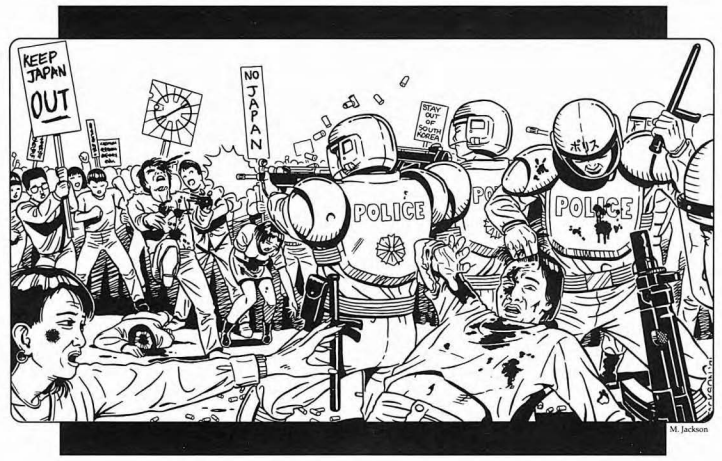
Leave the Bronx!
Of course, not even 3327 can act against an opponent without being a little sneaky. He sent ninjas to plant evidence that one of the main protest leaders was linked to North Korea, at which point Kanawa's propaganda machine kicked into action. Between the discrediting of the movement leaders and the fact that the riot cops are capping people in the head, active South Korean resistance to the corporate influx has dropped off sharply. 3327 has still managed to spin this all in his favor, by selling arms to the South Korean military.
3327 is taking a slower advance into mainland China . He's focused more on pushing consumer goods in the country than his higher-profile options. It's still rough going because of the racism the Chinese people have towards Japan, plus the fact that many Chinese officials are trying to stonewall his land aquisition. For his part, 3327 sees China as a large exploitable resource, and since Orrorsh (to the south) doesn't seem interested in expanding he's trying to get in there before the Gaunt Man makes a play. Interestingly, the Chinese government has suspisions that there's a High Lord operating out of Japan, but are too busy dealing with the overt threat of Orrorsh to worry about it.
Taiwan took a huge hit from everything happening in Japan and China. Without the financial backing of the two countries, the Taiwanese stock market dropped by a whopping 80% before 3327 came in to sweep up the pieces. The financial situation is improving, but the crime and unemployment rates are still through the roof. As it stands, the Taiwanese government is convinced that the Kanawa Corporation will save the country.
Outside of Asia, 3327 has made a huge step and dropped a single bridge in California . What makes this particularly ballsy is that he did this by uprooting Baruk Kaah's stelae around the city of Sacramento, which also just happened to contain Kaah's western maelstrom bridge. The loss of the stelae caused the area to revert back to Core Earth axioms, which ended up destroying the bridge. 3327 then immediately pulled another drop-a-bridge-inside-a-skyscraper, and now Sacremento is a Nippon Tech pure zone surrounded by mixed Nippon Tech/Living Land areas. Although most people think it's odd that all these Japanese corporations are moving into California, the "win" over Kaah has gotten more attention.
The western bridge was Kaah's main supply line back to his home cosm, so now Baruk Kaah has taken one of his first big hits, and this is the beginning of Kaah being the metaplot's bitch. Kaah wants 3327 dead now, because while the rest of his territory in the western U.S. is still there, he has no way of keeping it supported. Why he doesn't just drop another bridge is beyond me, apart from "Kaah is pretty stupid".
3327 is now planning on expanding throughout California, supported by the remants of the U.S. government. The edenios have been driven away from the major port cities, he's moved into Los Angeles and is eyeing San Fransisco, but it's his taking of Hollywood that has the best long-term dividents. Since he controls one of the largest entertainment-producing cities in America, he's tied it to his propaganda machine to start seizing hearts and minds.
And that covers the broad strokes of Kanawa-controlled territory. Since this is a huge chapter, we'll continue talking about the Kanawa Corporation itself...
NEXT TIME: Corporate megastructures!
Welcome to the Kanawa Corporate family!
Original SA post
Good lord I haven't touched this since May.
The storm has a name... - Let's Read TORG

Part 12d: Welcome to the Kanawa Corporate family!
So last time way the fuck back here , I covered half of the chapter on the current situation in Japan. To wit, the high-level, social view.
The next part of the chapter is about the Kanawa Corporation itself.
Like all the other invaders, 3327 had to send operatives ahead of time to scout locations, set up stelae, all that fun stuff. But unlike the other High Lords, 3327's agents had a larger purpose: to find companies that he could buy out to serve as shell corporations.
The "lucky" company was a small electronics firm called Hechiro Electronics of Osaka, a manufacturer of high-tech mutinions. The company was taken over thanks to the standard economic practice of "use ninjas to kill the current owners", and 3327 assumed the position of CEO through his persona of "Ryuchi Kanawa".
Renaming the place to "The Kanawa Corporation", 3327 began expanding his empire. By moving in the higher-tech Marketplace manufacturing technologies (which were faster and cheaper than what Core Earth could do), Kanawa was able to undercut his competition and rocket the company to the largest arms manufacturer in the world. From there, Kanawa started buying out other corportations in other fields. Then he'd set those companies up with the new manufacturing technolgies, undercut that field's competion, and so on.
Within a month, the Kanawa Corporation had positioned itself as a major economic power.
It wasn't long before the secrets of Kanawa's "new" technologies leaked out to Core Earth companies (good ol' Law of Treachery!), and Kanawa managed to stay ahead at first by manufacturing the cheapest consumer goods possible at as much of a profit as he can. But now that the cat is out of the bag (so to speak), he's relying on a good old-fashioned junk bond Ponzi scheme.
There's a few paragraphs about that a junk bond is, given that this was written in the early 90's and most people didn't know what they were since the high-profile stateside schemes hadn't happened yet. That said, the explanation here isn't that great and you're better off reading the entry on Wikipedia .
quote:
The reasoning goes something like this: suppose you were to invest ¥1 million in bonds with a 10 percent yield issued by Toyota, which for all practical purposes has no chance of going bankrupt in the six-month term covered by the bond. At the end of six months, your return would be ¥1,050,000 (¥1 million + ¥1 million x 5 percent - the 10 percent is an annual rate and you have only invested for 6 months) for a profit of ¥50,000. Now suppose you invested the same ¥1 million in 20-percent yield junk bonds issued by 100 separate companies. Right now, the failure without return rate (the percentage of junk bond issuers that go belly up without being able to honor their bonds issued to the public) of such companies in Nippon is roughly three percent, meaning that three of the companies in which you invested will go bankrupt and that you will lose three percent of the money you invested (or ¥30,000). But your return on the remaining ¥970,000 is 20 percent giving you a total return of ¥1,067,000 for a profit of ¥67,000, or approximately ¥17,000 more than you would have made dealing in "blue chip" issues.
3327 has sold literally trillions of yen in junk bonds in the 15% to 20% interest rate category, creating new dummy corporations as needed to get the bonds out there in the first place and lining his pockets the whole time.
On top of that, the Kanawa corporate structure is one large pyramid scheme.
3327 creates new corporations so he can sell junk bonds. But because most of the companies' initial profits are owed to the investors at insane interest, these companies have to come out of the gate earning somewhere in the vicinity of 130% profit. Obviously that's pretty unlikely, so 3327 sets up these corporations in a sort of pyramid scheme. When a corporation's bonds become due, 3327 has a different corporate entity issue its own set of junk bonds, then uses that money to pay off the bonds from the company that's about to default.
And where does the money come from in the first place? From the Japanese citizenry, of course. 3327 has used both the rapid growth of the Kanawa Corporation and the current world situation to send people into an investment frenzy: you're not just earning a profit, you're helping Japan stay an economic power in the post-invasion world! By investing in these corporations, you're helping the fight against the High Lords!
Through all this, 3327 now effectively owns about half of Japan. Like, literally owns . His biggest coup was managing to take over the Bank of Japan and its subidiary lending houses, giving him an even tighter control over Japan's (and, by extention, Core Earth's) economy. There are a few groups that are starting to notice that something's up, and there's a hacker group that is trying to get Kanawa's pyramid to collapse now before it's too late, but unfortunately these groups aren't powerful enough to be anything but a nuisance.
What's even better about this (for 3327 anyway) is that because everyone's so focused on the obvious invaders and scrambling to try and get things back to a stable global position, the rest of the world isn't paying close attention to what's going on in Japan. After all, with most of North America and Europe under new reality management, of course the remaining major economic power would have to step up and fill in the gap! In fact, foreign investors see the current situation in Japan as a huge "get rich quick" scene and are pumping more cash into Kanawa's money engine.
The practical upshot of all this is that Japan's economy is in a very slow, very carefully managed downward spiral that leads right into 3327's bank account. And once the whole system reaches the point where it all has to fall apart, all he has to do is jump ship back to his home reality and start looking for a new world to plunder. To 3327, becoming Torg is secondary to earning profit, so as far as he's concerned Core Earth and the other High Lords can go fuck themselves once he's bled them for everything he can make a dime off of.
That's not to say that he's not thinking long-term. 3327 has a lot of plans in place to take advantage of what would happen if the other Possibility Raiders were defeated before Japan's economy collapses under its own weight.
The main plan involves, believe it or not, land ownership. Through his numerous dummy corporations, 3327 has been buying territory that has been taken over by the other High Lords. There's a lot of very valuable territory out there that the owners can't use because it currently has dinosaurs, Egyptian cultists, vampires, or God-knows-what on it. 3327 has been buying that land up for a pitance from their owners, and when/if the other High Lords get kicked off-planet, everyone is going to be rather shocked to find out that the Kanawa Corporation owns a sizable chunk of the oil fields in Africa and almost all the mining industry in the States.

"I don't know, I can't read English."
The next part of this chapter is about the The Structure of Kanawa , and is a general overview of Kanawa and its subsidiaries.
3327 is the CEO of Kanawa, of course, but he has three board members that are on board with the overall plan and help him keep control of the whole set-up.
The first is "Murasaki Yamato", a.k.a. 7710 and 3327's right-hand man.
The second is a Core Earther, Saito Horyu. Saito was a board member of Hechiro, and was tapped by 3327 because he wanted a "familiar face" on the board through all the changes. For his part, Saito is more than happy to sell out his company and planet; he's greedy and incredibly bitter due to years of being passed over for promotion in the original company. Saito suspects that 3327 may be a High Lord, but even if he figured it out he'd still be willing to serve. Partially because he's a greedy amoral fuck, but also because of the third important board member, Isei Sagato.
Isei is a highly-placed board member, and is rumored to be the head of the Yakuza. And in this case, the rumors are true. Isei is quite comfortable with the rest of the board being terrified of him, and while he also suspects there's more to Ryuchi Kanawa than meets the eye, he's not going to rock the boat as long as the money keeps rolling in.
The rest of the board are basically chair-warmers that the above people don't give a single shit about.
Next up is a list of the various Kanawa subsidiaries, but for the sake of not boring you all to death I'll just post the structure PowerPoint.
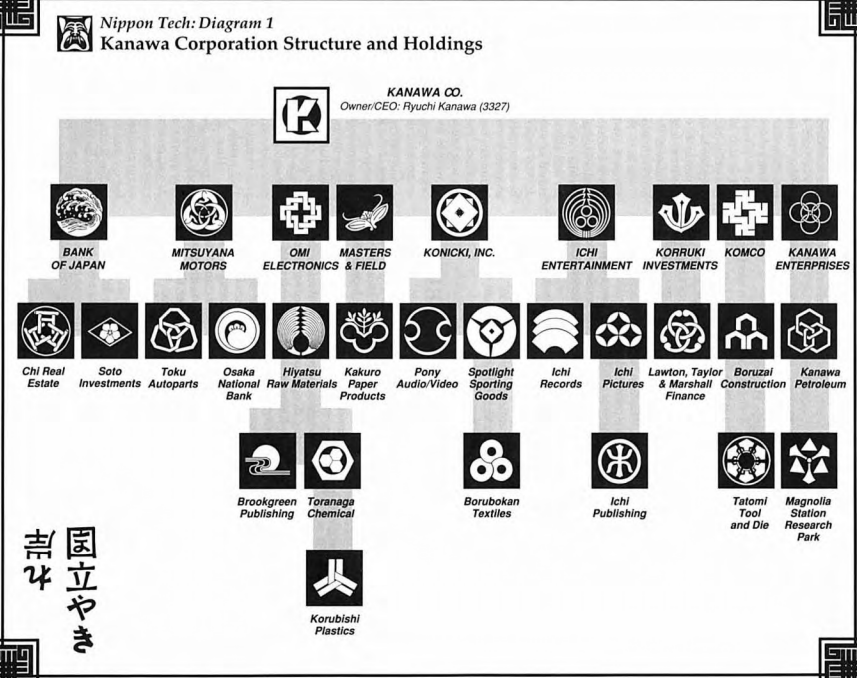
That's not every company under 3327's control, of course. He's taken over other megacorporations, kept them separate from Kanawa on paper, and used them to start new corporate structures in order to keep his eggs in multiple baskets.
So far the only real resistance 3327 has come across (apart from the usual array of Storm Knights) comes in the form of the Rauru Block . The Block was formed by the heads of two corporations who found the Kanawa Corporation's meteoric rise and constant new technological advances rather suspicious. Originally, the Block's purpose was to investigate Kanawa and see what the hell was going on, because clearly something illegal had to be happening. Unfortunately for them, by the time they really started digging in 3327 already had control of the government and a large chunk of the Yakuza. Unable to bring evidence to any sort of authorative body, the Block has had to shift their operations from investigation to stopping the Kanawa Corporation by any means.
Well, not any means just yet. Right now they're focused on corporate espionage and hacking. Once 3327 caught wind of the Block and their activities, he sicced the ninjas on them. The Block wasn't wiped out completely, but now they realize that they need to start working on a more physical level and has begun hiring mercs and related operatives for protection and sabotage.
quote:
Currently, the officials of the Rauru Block know that there is a conspiracy involving big business, the Yakuza, and the government in Japan. They know that the Kanawa Corporation is involved in the conspiracy, and they know that other mega-corporations are cooperating with Kanawa (Block members are aware of the identities of the other firms discussed above that make up 3327's empire).
The members of the Rauru Block do not know:
1) that "Ryuchi Kanawa" is an alien High Lord from another cosm and that he plans to absorb the possibility energy of Japanese citizens;
2) exactly which government officials are part of the conspiracy;
3) exactly who controls the Yakuza, although they are reasonably certain that Sagato is connected with the organization somehow and may be its leader.
Just FYI, both the above two plot devices are never seen again in the rest of the line. Or this book.
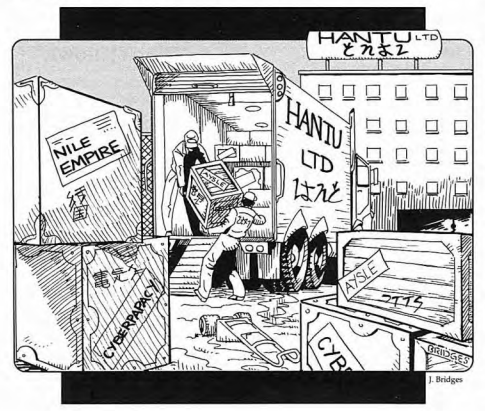
Subtle, guys.
The book now begins spending a large amount of time and pagecount talking about the Yakuza , but forgive me for not including the stuff you can look up on Wikipedia or in John Woo movies.
One of the first things 3327 did when he came to Core Earth was send his agents to inflitrate the Yakuza and bring the whole shebang under his control. Normally this would be rather difficult, but one of the advantages of being a High Lord is access to non-standard methods of persuasion. Such as, for instance, armies of gospogs you can sic on the Yakuza leader when he says he's not interested in cutting a deal.
Once the former head of the Yakuza was cut to pieces by unhuman monsters, the new head of the Yakuza (the aforementioned Isei Sagato) was more than willing to join up. Of course, not all the families under him were as willing, and this kicked off the most violent gang war in Japan's history. 3327 and Sagato came out on top, of course, and the surviving Yakuza families were restructured from 20+ separate families down to five large conglomerates.
For the most part, the new "families" are kept in line through a combination of the threat of another gospog massacre and the largest profits they've ever made in their lives.
There's always a downside, though, and the public perception of the Yakuza has gone down post-Invasion. You see, back
before everything went to hell the Yakuza took it upon themselves to stamp down on non-Yakuza crime through the good
old-fashioned protection setups. On top of that, it wasn't uncommon for people to go to the Yakuza for a little
off-the-record "justice for hire" for things you didn't want to trouble the cops with. Now, the Yakuza are becoming
more...well, thuggish. They're not policing their territories, they're not helping people who come hat in hand, and they're dealing more in things like hard drugs and human trafficking.
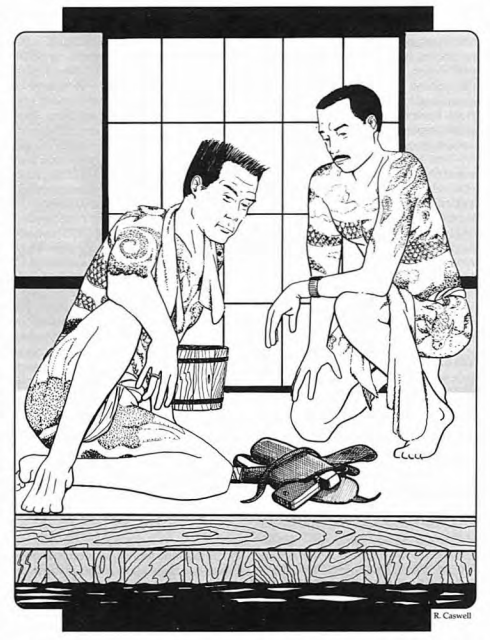
Lllladies...
What's more, the changes are causing a lot of tension within the families themselves. A lot of operatives, enforcers, and lower-tier members don't like how the new restructuing has affected their lives.
quote:
murai.
At the center of the Yakuza code is the idea of loyalty to the family head. A Yakuza soldier is supposed to accept the orders of his family head without question and carry them out successfully. Failing to carry out an order issued by the family head means the soldier must pay a penalty. Many Westerners are familiar with the Yakuza practice of having a soldier chop off his own finger to atone for a failure. Almost all veteran Yakuza soldiers have one or more fingers missing due to this traditional method of punishment.
But self-mutilation is not the only way asoldiercan makeup fora wrong. The family head may call for anything from a fine to death from a failed soldier. The Yakuza code requires the underling to accept the family head's penalty immediately and without question.
Since 3327's reorganization, however, this particular aspect of the code of honor has become rather confused. The honor code binds soldiers only to their family heads, which under 3327's scheme are not necessarily the men who are issuing the soldiers their orders. Some soldiers refuse to accept the penalties demanded by daimyos or underdaimyos with whom the soldier was not affiliated in the past. Sagato has decreed that all soldiers are to accept their daimyos as family heads with respect to the code of honor, but many are still rather reluctant to accept this mandate.
And now, finally, we get to talk about ninjas !
For a page.

quote:
Ninja are highly trained warriors who use their knowledge of the martial arts for assassination. In contrast to many other masters of these disciplines, the ninja have involved themselves in the affairs of the outside world for centuries. Japanese history is filled with colorful incidents of assassinations and spying missions carried out by distinctly garbed ninja warriors, though few realize that the legends of the seemingly "magical" powers of the ninja are all true. For centuries, a combination of greed and pure enjoyment of the sport of assassination led the various heads of the ninja temple to accept these missions and conceal them from the membership of the Sons of the Wind.
Anyway, one important thing about ninjas is that they know martial arts powers that'll come up later, but (of course!) with one important downside: because ninjitsu is a "perversion" of martial arts, their Spirit stat suffers (not that they say how), and ninjas cannot spend Possibilities on uses of the reality skill, even when attempting to reconnect. Why? Because fuck you, that's why.
And yes, "ninja" is one of the available character templates, and suffers from this penalty.
Anyway, 3327 controls the ninja (all the ninja) through an alliance their leader Gazokai. Yes, there's one leader of the ninja.
quote:
The temple of the ninja is the only domain oftheart which has its own fully functional FAX machine.
The next part is about the Sons of the Wind . In keeping with the terrible organization and misunderstanding of the interesting parts of the setting that are endemic to Torg, more space is given to the history of the Sons than to the entiretly of the sections on ninja. Because I care about the schism between two guys 500 years ago to the point where I need a page of history.
The Sons of the Wind are basically an organization of good-guy freelance martial arts heroes. They have a very loose organization, being more like a kung-fu version of the National Guard than an army. They've come out of centuries of hiding due to, and I quote, "various martial artists inJapan began to feel a disturbance in the very reality of things." There are only three main rules:
1. Any member of the Sons may call a meeting of the whole organization in order to vote on important matters, or to determine if they should get involved in global affairs.
2. The Sons cannot reveal the existence of the group to the world.
3. Conflicts between members would be settled through one-on-one martial arts duels.
Good lord we're still not done with this chapter! Now it's time to talk about Nippon Tech stelae . As stated before, stelae in Nippon Tech take two different forms: as either telephone exchange boxes in the country, or as functioning ATMs in the cities. Because 3327 takes new territory via buyouts rather than comquest, it's ridiculously easy to set up stelae boundaries in preparation for dropping a bridge inside some empty skyscraper under the pretense of normal corporate expansion.
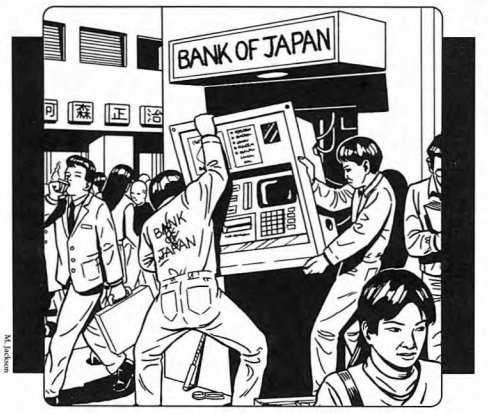
Pictured: reality expansion
3327 is also always on the lookout for eternity shards, and tends to have more success than the other High Lords because, again, nobody knows he's looking. Instead of sitting on them, he sells them to other High Lords at a substatial profit.
3327 employs gospog just like the other High Lords, but initially had a problem where he couldn't figure out the best way to use the giant rampaging plant zombies while keeping a low profile. He solved the problem by converting a Japanese hydroponic plant into a gospog field, and "growing" the monsters into specially-prepared suits of high-tech samurai armor. The armor is completely sealed and very strong, leaving no evidence that there's not a human in there. As an added bonus, gospog are pretty mindless and as a result aren't subject to the Law of Intrigue. 3327 keeps a few near him at all times to serve as bodyguards.
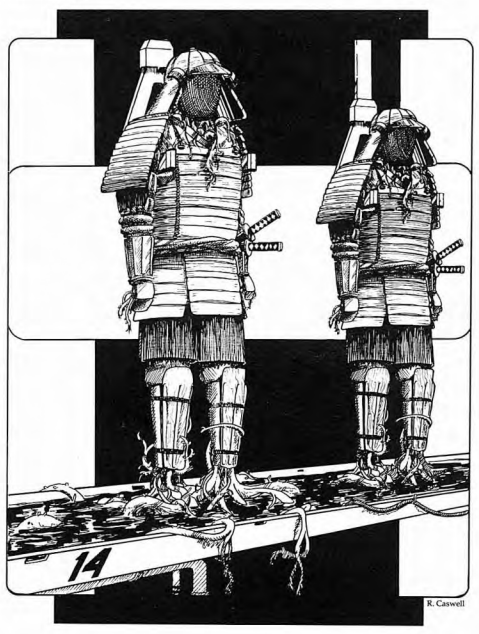
Ew.
And except for some small adventures, that's it for the chapter.
Finally .
Good fucking lord this was rough to get through. it's only 30 pages, but as always it bounces from topic to topic, giving too much detail on shit I don't care about or don't need. I don't need a province-by-province breakdown of what's going on in Japan. I don't need the history of the Yakuza over the past 100 years. I don't need the 500 year history of a group whose sole purpose is...to be where PC martial artists come from I guess?
At the risk of being a broken record, Torg has no idea what the end-user needs to know or cares about. It's just a pile of ideas you're expected to sift through to find the bits that are actually usable.
Can you imagine what this game could have been if the writers were more focused?
NEXT TIME: Axioms and World Rules revisited!
High-level Operational Procedures
Original SA post The storm has a name... - Let's Read TORG
Part 12e: High-level Operational Procedures
This chapter is the detailed information on Nippon Tech's axioms and World Laws. This is stuff I always put in the first post for each realm, but I always like to revisit. Plus, you know, it's been a while.
Marketplace's Technological Axiom is 24, which is just above Core Earth's. Marketplace's extreme corporate culture has pushed technology at a rapid rate, and 3327 is bringing some of these technologies down the bridge to his realm. The trick is that he has to be careful what technology he lets out to the world at large; things that are above Core Earth's tech axiom would cause contradictions, but not spreading the tech around would result in a poor market.
This isn't so much a problem in the realm since everything just seems like a natural extension of current technologies, but as the new stuff gets revealed, it's not hard for other companies to reverse-engineer things and make their own versions. This might lead to an increase of Core Earth's tech axiom if the technologies become too widespread.
The book actually breaks down various fields of technology to show where they stand, which is nice because it's the only axiom you can really do that with.
That said, remember that is all going to be "high tech" compared to 1990.
Marketplace's Medical technologies are incredibly advanced compared to Core Earth, even today. Artificial organs have been pretty much perfected, and are affordable by the types of people who should be able to afford them (i.e., the upper classes). Artificial limbs are almost there, being about 85% functional compared to a normal human limb. As profitable as this field is, it's just a stepping stone on one of 3327's main targets: cybernetic technology.
3327 has a big problem with the fact that Malraux basically stumbled into the highest tech either one of them have ever seen. Cybernetics in Marketplace/Nippon Tech are still in their infancy, and are prohibitively expensive. In an attempt to co-opt Malraux's dumb luck, the Kanawa Corporation has begun purchasing factories and labs in France to take advantage of the higher Tech axiom, and the CyberPapacy corporate world is teeming with Kanawa operatives.
It's also worth pointing out that cloning technology exists in Marketplace, but is not in widespread use. Almost nobody knows about 3327's five clone copies wandering around, but nonetheless corporate heads push for better cloning technology because it might prove to be a good solution to Japan's labor force problem.
The tech field that's growing the fastest is, surprise surprise, the Military sector. Combat drones and self-controlling robots are starting to appear in modern combat forces. Laser weapons exist, but they're not compact or cheap enough to see real use outside of being mounted on robots defending vital locations. Plasma weapons are still in the prototype stage.
It should be pointed out that the Kanawa Corporation sells weapons world-wide for use in the various realities. In order to prevent contradictions, weapons intended for a specific realm are made using materials and manufacturing practices appropriate to that realm. So a crossbow made by Kanawa for use in Asyle can be used without causing a contradiction.
Transportation technology has been a boon to the automotive industry. Kanawa-manufactured cars are faster (top speed 280 kph/174 mph), have more features such as GPS and improved safety features, and are more affordable.
Air travel in Japan has been improved by the development of "jump jets", which don't need as much space to take off and land, on top of being a lot quieter. This has caused modern airports to be capable of handling more traffic.
Interestingly, the only transportation field that hasn't seen much improvement is in actual goods transport. It's just not profitable to try and improve what boils down to large portable boxes above what's available now.
It's interesting to note that in terms of predictions, they actually got Communications about right. The "Sony Talkman" is a personal phone the size of an index card. It's not a smartphone, but you can't deny we're pretty close to getting phones to that size.
But where they did okay with phones, the game's predictions for Computers are hilariously wrong.
quote:
Approximately 94 percent of Japanese homes are equipped with a personal computer. The typical home computer system features 32 megabytes of user memory as well as hard copy, communications, and storage peripherals. Almost all home systems have access to one or more computer information networks. Computers are used for shopping, banking and a host of other activities, as citizens try to spend as little time as possible out in the polluted atmosphere.
Businesses now rely on supercomputers with 64-bit video coprocessors, floating point co-processors, and voice recognition processors. These machines also have up to 256Mb of user memory, and multiple output option module.
That said, the summary of Daily Life in Japan is actually a bit predictive, if only by accident. The new industrial revolution has been a huge boom to the entertainment industry, with people able to access "thousands of recorded films and video programs via home computer". The video game industry has also advanced, with a lot of manufacturers making laser-disc based games based on the current world situation (like "Lizard-Hunt", a wargame based on the battles between the Living Land and America).
quote:
And the more traditional video games have maintained their own popularity, also, with complex home units and portable systems available from a wide variety of manufacturers. Zelda V, a video game for Nintendo's 32-bit home system, has sold more than 9 million copies in Japan alone.
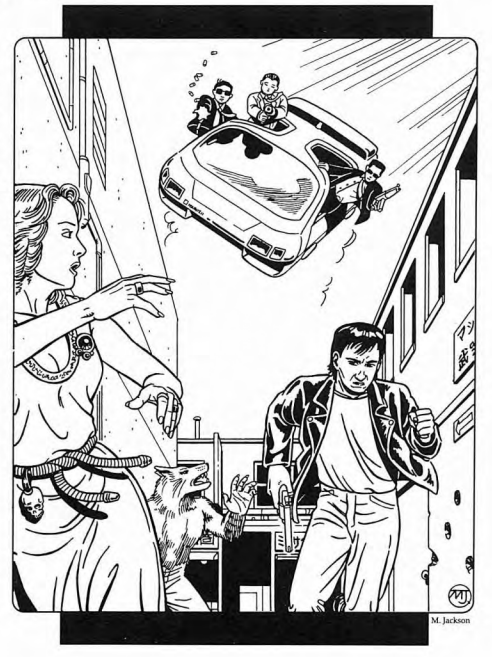
There are also apparently flying cars, but they're not mentioned for some reason.
The Social Axiom of Nippon Tech is 22, which is also just above Core Earth's. But despite the higher Social axiom, life in modern Japan is worse than it's been in a long, long time. Between the new corporate culture, increased Yakuza activity, and MarSec replacing the cops, the country is in the midst of a serious social crisis. In the months since the invasion, the unemployment, crime, infant mortality, and homelessness rates have more than tripled . The current workforce can't keep up with the accellerated corporate culture, and most workers' skills are becoming outdated practically overnight. And because 3327 has a very subtle control over the government, things aren't going to get any better anytime soon because spending money on social services isn't profitable.
The upshot of all this is that the major cities like Tokyo and Osaka have become urban nightmares. Suicide rates, drug use, and crime have all skyrocketed with no relief in sight. The gap between the haves and have-nots widens daily, and the only people who could fix it are in 3327's pocket.
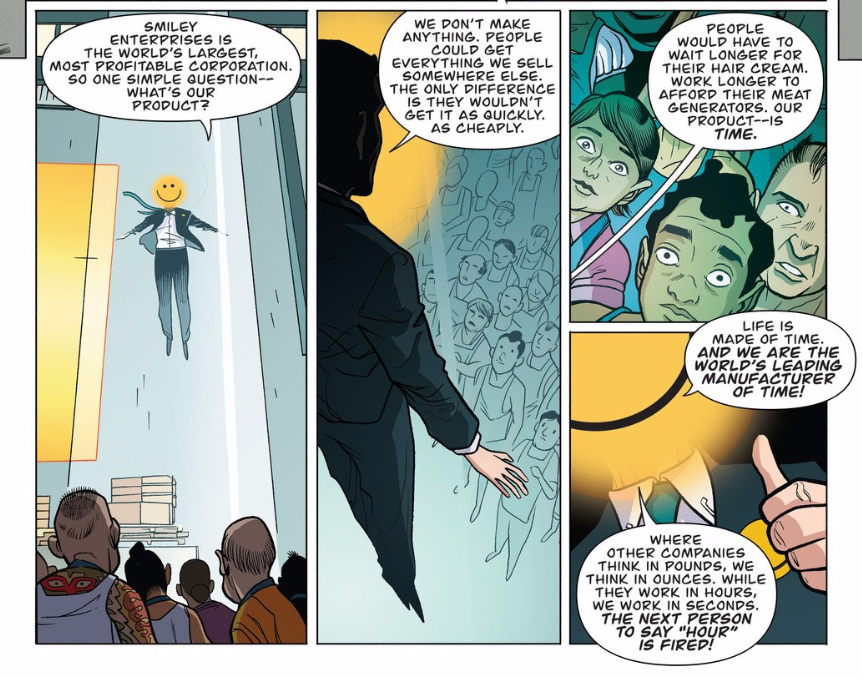
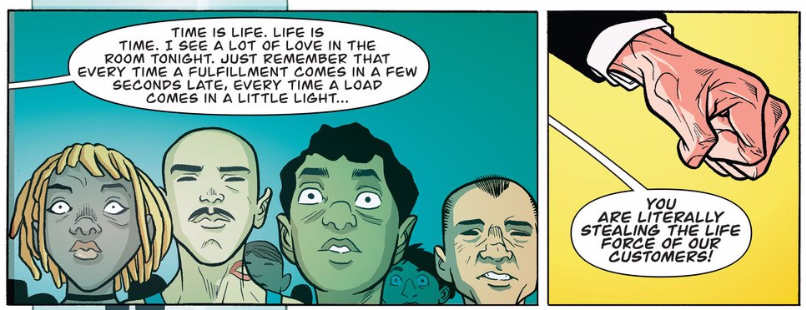
[sub]from Prez #3 , a series y'all need to read. Also completely not relevant to Nippon Tech.
Marketplace has the second-lowest Magic axiom at 2, just above the Living Land's 0. It also has a very low Spiritual axiom of 8. The world is focused on material gain, and as a result the spirit has suffered in oh so many ways. Magic is pretty much impossible, and miracles aren't much better off.
A strange side-effect of the low Magic and Spirit axioms is the strange sense of... wrongness that permeates the realm. Core Earthers are attuned to slightly higher axioms, and don't notice the effect until it's gone. Deprived of the "ambient" magic and spiritual energy, everything feels off . Empty. There's always a feeling of being watched, of disconnection from everyone even in a crowd. People don't make eye contact, and often seem to just melt away into the shadows. You never feel in contol of anything. It's like the feeling of being in an abandoned house, the feel of nobody living there, just writ large.
Another strange effect is that the contry is permeated with a thin, cloying fog. It's harmless (although attributed to the pollution now spreading across Japan), but just amplifies the disquieting feeling of the realm.
There are three World Laws that drive and reinforce how Marketplace and Nippon Tech operate. As always, everyone in the realm is subject to these laws unless they form reality bubbles around themselves.
The first is the Law of Intrigue , which states that deception, lies, and traitorous behavior is easier. The mechanical effects of this are:
-
All uses of the
stealth
skill get a +3 bonus to the roll, and all
Perception
-based tests to detect stealth get +3 to their difficulty.
-
Using
Charm
-based skills to lie or decieve get +3 to the roll. Using
persuasion
to lie gets you another +3 on top of that, and P-rated characters also get +3 to all
trick
rolls.
-
Any group or organization with at least 100 members will have at least one traitor in its midst. The larger the organization, the more traitors there'll be. Note that they don't have to be actively hostile to the group they're in, but they will be working for a rival group.
-
Two thirds of all Storm Knights the PCs meet will be unfriendly. Not evil, just untrusting or untrustrworthy.
Next up is the Law of Profit , which is a more passive law. It states that all goods and/or services bought by "those of means" will cost less and be of higher quality than the goods purchased by anyone else.
Once again, I can't sum this up any better than Sir Terry Pratchett:
quote:
The reason that the rich were so rich, Vimes reasoned, was because they managed to spend less money.
Take boots, for example. He earned thirty-eight dollars a month plus allowances. A really good pair of leather boots cost fifty dollars. But an affordable pair of boots, which were sort of OK for a season or two and then leaked like hell when the cardboard gave out, cost about ten dollars. Those were the kind of boots Vimes always bought, and wore until the soles were so thin that he could tell where he was in Ankh-Morpork on a foggy night by the feel of the cobbles.
But the thing was that good boots lasted for years and years. A man who could afford fifty dollars had a pair of boots that'd still be keeping his feet dry in ten years' time, while the poor man who could only afford cheap boots would have spent a hundred dollars on boots in the same time and would still have wet feet .
This was the Captain Samuel Vimes "Boots" theory of socioeconomic unfairness.
Lastly, there's the Law of Vengeance . This law states that revenge is a dish best served cold and fatally. If you take revenge on someone who has wronged you in a serious way, after waiting 48 hours to plan, you gain six possibilites at the end of the act.
Ultimately, this all should lead to a world that's a mix of John Woo movies, Sleeping Dogs, Judge Dredd, and Demolition Man. Instead, we got what we got.
Talk about wasted potential...
NEXT TIME: The moment you've all been waiting for: everybody was kung-fu fighting!
Training retreats
Original SA post The storm has a name... - Let's Read TORG
Part 12f: Training retreats
And now we get to the skills section. There are four Nippon Tech-specific skills.
Disguise does what it says on the label, and was actually given in other realmbooks first because why on earth would you make that a skill in the core book, right?
Business is your ability to navigate the corporate beuracracy. It's supposed to allow you to make shittons of money, but really its only use is in the corporate warfare mini-game that's coming up in the next chapter.
Meditation is your ability to be zen. It's a Mind -based skill, and can't be used unskilled. You can try to meditate at pretty much any time, although the difficulty is higher if you're in a fight or something. That said, it takes 15 minutes to entere a meditative state so it's not something you're going to be doing on the fly.
Once you've tranced, you get three benefits. First, you can substitute your meditation value for your Perception or Mind when attempting to solve a riddle or puzzle, unless it's science-based. Second, you heal faster; shock and KO heals twice as fast, and if you meditate for three hours you heal an extra wound level. Lastly, you can go without food and with minimal air for a number of days equal to the meditate total.
But that's not why you're here. You're here because you want to learn about kung-fu, TORG style!
And oh man is it Torged.
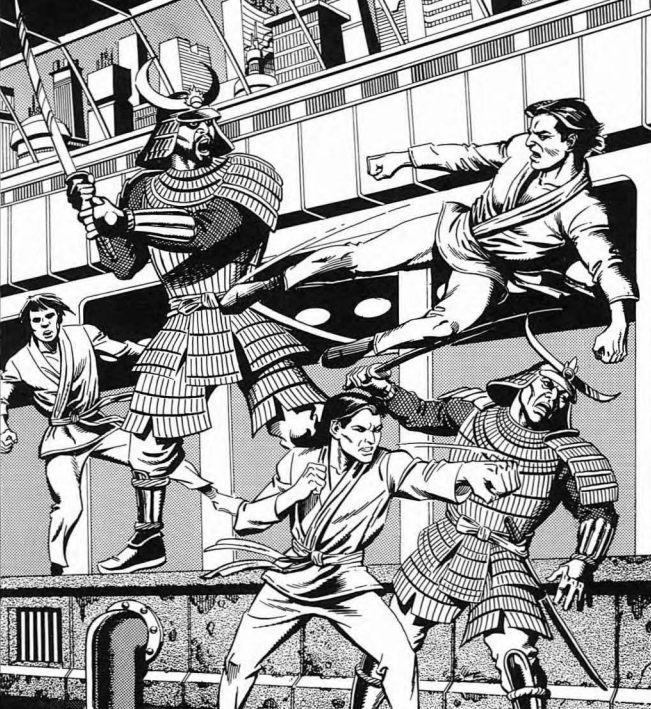
"Modern" Japan.
Let's start with the basics. By which I mean unneeded backstory about the Power of Ki .
Using "martial arts" (the skill) isn't the same as using "martial arts". Using hapkido or karate technically is considered using the unarmed combat skill. Martial arts is as much about the philosophy of fighting as fighting itself.
quote:
The martial arts are combat strategies and maneuvers which cannot be separated from the philosophy of the warrior who practices them. In Core Earth, the schools of thought which gave birth to these arts were founded by a group of Chinese monks known as the "Shao-Lin," just over 1000 years ago. It was the Shao-Lin who first theorized about the existence of an amazing store of energy within each human being (which Japanese masters later dubbed ki ) and discovered rudimentary methods for tapping these energies and redirecting them into the material world.
The Shao-Lin believed that everyone possessed some of this energy, although some people had far more than others. In fact, the energy stores of most people are far too small to master the disciplines that make up even the earliest, most primitive martial arts, which is why the number of martial arts practitioners has traditionally been small.
What the Shao-Lin did not know is that the "energy store" they had discovered was tied to the very fibers of reality itself. In fact, this power is actually the possibility energy sought by the High Lords.
Which, of course, means we need to worry about axiom limits because God fucking forbid we have something that you can just use without worrying about disconnection. Using martial arts requires a world with a Spiritual axiom of at least 7, because that's the minimum level where a spiritual ritual could generate an actual tangible effect. But since the lowest Spirit axiom out of all the available realities throughout the whole game line is Nippon Tech's at 8, it's a completely moot point.
You also need a Social axiom of 21 ("Pluralism on a transnational scale is possible, balancing the needs and wants of nations against each other. The beginnings of a “global society” may take shape.") for some reason, and that's a problem because only three realities have a Social axiom of 21 or higher: Nippon Tech, Core Earth, and one more we haven't seen yet because spoilers. So unless you're in Core Earth or Nippon Tech, using your awesome kung-fu stunts can cause you disconnect if you're not careful.
Martial Arts is keys off Dexterity , is only available to P-rated characters, and effectively replaces the unarmed combat skill. Base martial arts damage is STR+2, and can be used to defend against unarmed, martial arts, melee, and missile attacks. On top of that, if you're fighting someone who doesn't have martial arts training, you get a DEX+1 bonus to your attacks. You can also use the skill in place of melee weapons or missile weapons , but in those cases you use the weapon's base damage. Martial arts can't be used unskilled (duh), but costs more; the first add you buy, be it during character creation or during play, costs three times the normal cost.
Now that's all fine. But that's not the real reason you want martial arts. I mean, we've got ninjas and a whole good-guy kung-fu secret order. What's the fun of those without awesome kung-fu powers? That's where styles, maneuvers, and training come into play.
Every martial arts practitioner has a style , which is his or her specific fighting style. Tiger Fist is a style, ninjutsu is a style, jujutsu is a style despite the book stating that "mundane" fighting styles aren't really "martial arts" but whatever. Each style has eight maneuvers , which are basically like 3.Path feats or Fate stunts.
If you have martial arts , you have to have at least one style. Once you start learning a style, you can't learn another until you master your current one by learning all the maneuvers it contains.
Maneuvers come in three types: minor disciplines, which are your bread-and-butter moves; major disciplines, which are the things that require CG; and master disciplines, which is when you go full anime. Every style has five minor, two major, and one master discipline. On the plus side, the player can create their own style by just picking the moves off the provided lists. There are a handful of pre-made styles, but at least you can make your own.
Minor and major disciplines can be used at any time, but master disciplines require spendng Possibilities to use.
So let's look at some of the minor disciplines. There are more than these, of course, but let's cherry-pick.
Block/Strike lets you, well, block an attack and hit back in the same round as one action. You roll both your defense and attack separately, but at least one isn't dependent on the other.
Dagger Dance requires a dagger or sword, and lets you "leap, spin, and lands in a combat stance, all the while manipulating your blade so that light reflects off its surface." All this does is let you use your martial arts instead of your maneuver skill to make someone fatigued/stymied/unskilled for a round.
Drop Kick actually isn't a drop kick where you leap up and plant both feet in someone's chest, it's a when you drop to the ground, kick up against a charging opponent, and flip him over you. You can fling someone up to 5 meters away with this.
Heart Punch is a vital blow (-8 to hit, damage STR+6) that also forces the target to take a setback .
Instant Up is just a kippup. Without this, it takes an action to stand.
Ki Punch is useless. It's a punch that does STR+5 instead of STR+2 damage, but when you use it you can't make another attack for three fucking rounds afterward because you have to restore your strength.
Lightning Fist lets you attack twice as one action, rolling once for one target or separately for two targets. The downside is that you can't Lightning Fist two rounds in a row, and can't use it if you have a flurry bonus (which gives you two actions anyway).
Sacrifice Kick isn't much better. This is an actual running dropkick, and is treated as an all-out attack . Since it's been a while since we covered the basics, that means that the attacker gets +3 to his attack total and +1 damage (making it STR+3), but everyone else gets +3 to hit him until his next action. In fact, it's worse than a normal all-out attack because on top of the normal penalty, attackers get +3 to their damage values and the user ends the round on his ass, meaning he needs to use his next action to stand up unless he also knows Instant Up. I guess the advantage is that you can move and attack?
Stone Fist is just a STR+4 damage strike with no downside. Which makes it better than a lot of the other damaging maneuvers, including Ki Punch.
Strike does nothing. Like, literally nothing.
quote:
this is a basic maneuver, relatively easy to master. While it does not have the awe-inspiring appearance that a whirling attack or a leaping kick might have, it is a swift and efficient way of downing an opponent.
Sweeping Kick just imposes the knocked down effect if it lands.
So nothing really earth-shattering there, apart from how useless some of those moves are. Maybe the major maneuvers will be better?
Detect Lie gives you +4 to rolls to detect lies with the willpower skill.
Hail of Blows gives you two actions for two consecutive rounds, but after the second round you're considered unskilled (no roll-agains on a natural 10) and fatigued for a round as you get your energy back.
Flashback is...
quote:
when combined with the meditation skill, this discipline allows a martial artist to reflect back upon her training, looking for the solution to a current problem or dilemma. This doubles the contemplation bonus received from meditation, and at the gamemaster' s discretion, may or may not result in a cryptic hint regarding how to resolve the situation.
Iron Fist is a no-frills no-downside STR+6 basic attack. Sadly, it doesn't stack with Stone Fist.
Weapon Master gives you a whopping +2 to your martial arts skill with a specific melee or missile weapon.
Whirling Attack lets you make a "whirling, flailing" attack against multiple targets with one action. You can strike all opponents within 4 meters (13 feet) for STR+2 damage, but only roll once without any penalties for multiple actions and apply the roll to each target. Sadly, you can't do this two rounds in a row, but still.
Lastly, there are the master disciplines. Each style only gets one, so make sure you pick carefully. There are only seven, though, so we might as well touch on them all.
Cyclone Attack is a stronger version of Whirling Attack with a +2 to hit and STR+4 damage that also imposes a -2 penalty on defense rolls. You can use this every round if you want, but each time costs you two possibilities.
Death Touch costs four possibilities, and if it hits the target must make a Toughness check with the attack's final total as the difficulty. If he succeeds he's fine, but if he fails he takes a shitton of damage (Ords take 4Wnd KO 15, P-rated characters take 3Wnd KO 5) and even if they survive that. P-rated targets can reduce the damage, but regardless if they don't get medical treatment in 20 round they just flat-out die. Just as a reminder, characters have 4 Wounds total before they die, KO means they're knocked out, and the number is how much shock damage they take, so assuming the attack hits and the target fails the check they're fucked. Oh, and when you use this attack, the GM makes an attack roll against you to see how much shock damage you take from the "lethal vibrations".
Long Life extends your natural lifespan to 20 times your martial arts skill value. It also gives you +10 to attempts to resist natural diseases, but doesn't negate the stat penalties for aging. In other words, it's the trap choice.
Power Shout lets you focus you ki into a yell that hits everyone within 15 meters in front of you. It gets +5 to hit and does Spirit+5 damage. This costs two possibilities.
Thunder Kick costs one possibility and just gives you a +5 bonus to your damage value when making a basic attack.
True Invisibility gives you +5 to stealth checks for two possibilities, but you have to re-roll every five minutes to maintain your focus.
Wind Running makes you super-fast (about 200 meters per hour, and gives you +2 to your dodge and maneuver skills. This costs one possibiltiy per 15 minutes of use.
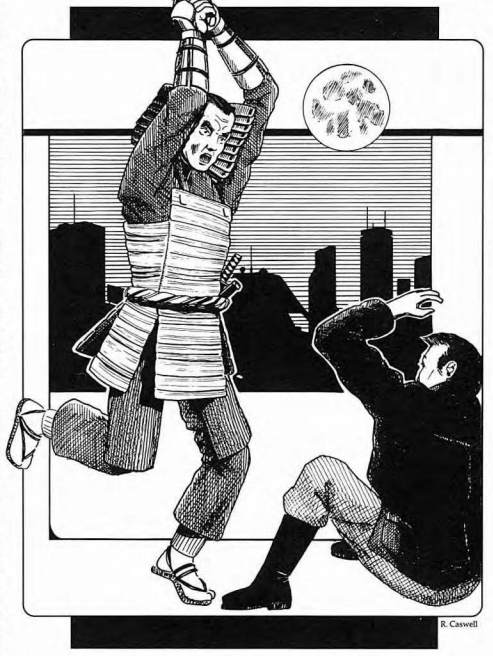
The rarely seen "samurai spaz attack" maneuver
It's worth pointing out that some of the higher-ranked disciplines are stronger versions of lower-ranked ones, but the benefits don't stack and there are no prerequisites. If you want your style to have Iron Fist, there's no reason to have Stone Fist too because once you learn Iron Fist there's no reason to use Stone Fist anymore. It's the 3.Path problem of abilities that don't scale with character growth; yeah that STR+4 damage ability looks cool when you start out, but after you get more powerful attacks that just becomes a dead pick.
When defining your style, you pick five minors, two majors, and one master. Maneuvers have to be learned in a sequence, so you set up the sequence for the minors, then the majors, then the master one is the last one.
So if I wanted to make "Roaring Tiger" style, I could set my maneuver list up like this:
pre:
1. Minor - Block/Strike 2. Minor - Crushing Block (does damage to attackers I defend against) 3. Minor - Instant Up 4. Minor - Feint 5. Minor - Stun Attack 6. Major - Iron Fist 7. Major - Whirling Attack 8. Master - Thunder Kick
Anyway, now that you have the list of maneuvers, you can start learning them. You have to learn the maneuvers in order down the line, and you can't skip over any. And how do you learn your maneuvers? By training, of course!
See, for every maneuver you put in your style, you have to give it a training exercise you have to complete (via skill roll) in order to learn said maneuver. If you fail the roll, you can't make another attempt until you put another point into martial arts and find a master of your style who's willing to teach you.
When you make your character, you take six "years" of training. For each year, you can attempt to learn a new maneuver. If you make all six rolls, then you start the game knowing all your minor disciplines and the first major one. However, if you tank your rolls, it's possible to not know any of them.
And what are these training exercises? Well...you ever see the old Kung Fu TV series?
Yeah.
Training exercises are also split into minor/major/master, and after you select the maneuvers for your style, the GM assigns them each a training requirement of the same rank. Ulitmately, they all boil down to skill rolls.
Minor trainings include:
quote:
Board Break: to signal that he has learned the corresponding maneuver, the martial artist must break a wooden board in half with his fist or foot. To break the board, the student must generate a martial arts total of 9.
Count the Grasses: passing this test requires the martial artist to count the blades of grass in a field. This requires a Perception total of 12 to accomplish successfully.
Pebble Snatch: in this test, the pupil attempts to snatch a pebble from the hand of his master, and it is much more difficult than it sounds. The pebble snatch requires a Dexterity total of 10.
Water Test: in this test, the student holds his or her breath and dives underwater in a pond with a large turtle. To pass, the student must stay underwater as long as the turtle remains submerged. This requires a Toughness total of 10.
A few major trainings:
quote:
Arrow in the Air: the martial artist must pluck from the air an arrow which has been fired at him. This requires a successful martial arts total of 13. Failure means the arrow strikes the martial artist (the arrow has a damage value of 12).
Immobility Test: in this test, the student tenses all the muscles in his body and stand perfectly still. The master then strikes the student, first with his fist, then with his foot, and then with a board. To pass the test, the student must remain completely immobile through all three blows. Flinching even a fraction of an inch constitutes failure. This requires a Toughness total of 12.
Rice Paper Test: in this traditional exercise, the student must attempt to walk across three meters of rice paper without leaving a trace of her movement. Leaving the slightest impression in the paper is considered failure. This requires a Dexterity total of 13.
And finally the zen-ness of master training:
quote:
Appreciate Sunrise: to complete this test, the master sits out and watches the sunrise every morning until she feels one with nature. This requires an ability to be at peace with one's self and the world around one, and a successful Spirit total of 13 to accomplish.
Conquer Fear: the student must allow himself to be exposed to that which he fears most, no matter what it may be. He must then face that fear and defeat it to signal his mastery of the corresponding discipline. This requires a successful Mind total of 12.
Write a History: to pass this test, the master must write a complete and detailed history of his style. A Perception total of 13 is required to complete this test.
Still, flubbed rolls can wind up costing you more possibilities as you try to not miss your once-per-skill-increase chance at learning a new move.
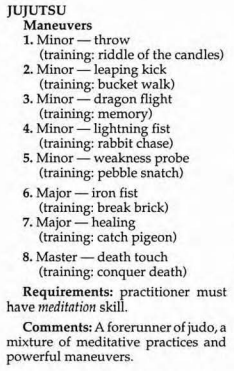
A sample martial arts style
It's just amazing how they can take something so simple and make it so unappealing. Martial arts sound cool on paper, but like so many other things in Torg there's unnessesary subsystems and these ridiculous requirements that can result in you either not getting the power you want or rendering you useless. The idea that you can disconnect because you went to Asyle and punched a dude twice because magic exists but that level of physical ability apparently doesn't.
On top of that, a lot of the maneuvers are useless or can be made useless by stuff you can get later. You can spend one of your eight maneuver picks on attacks that are worse than your generic skill-based attack. You can fail to learn anything about your style if you roll badly enough.
But again, we don't want characters getting too powerful in our game about globetrotting cinematic heroes, do we? That'd just be silly.
NEXT TIME: How to run your own megacorporation!
Coffee is for closers.
Original SA post The storm has a name... - Let's Read TORG
Part 12g: Coffee is for closers.
So there's one question I'm sure many of you have asked: "so what the hell are you supposed to do in Nippon Tech?"
It turns out that one of the answers is "run a megacorp".
quote:
Along with the battles in the streets and alleys of Nippon Tech - ronin versus ninja, ronin versus gospog - there is another kind of war being fought in the realm. It is a quiet struggle, one fought not with guns and knives, but an even more devastating weapon - money.
To the victors in such conflicts go wealth and power; to the losers, financial destruction and complete absorption by the conquering entity. The corporate duelling which takes place between the Business arm of the Rauru Block and 3327's mega-corporations is quite different from any other type of combat in Torg, and thus requires some special rules. Refer to these rules if one of your players chooses the role of a Mega-Corporation CEO, or a Storm Knight obtains control of a megacorporation at some point in your campaign.
So yeah, Nippon Tech has its own "domain" rules.
To start, the CEO needs to set up a corporate structure diagram for his company, while the GM does the same for the competition (or just uses the one provided for Kanawa Corporation).
quote:
In the diagram, represent each corporation with a rectangle and write the name of the corporation inside that rectangle. Then write the name of the holding company at the top of the page, and beneath it, list all the company's direct subsidiaries and draw a line between the subsidiaries and the holding company. Then put down all of the under-subsidiaries and lines connecting them to the subsidiaries that own them.
The recommended size for a starting mega-corp is a holding company and two subsidiaries, and the book also recommends that the first target in 3327's setup should be Windigo Inc. (a marketing/PR firm) since it's the smallest of 3327's holdings with only three subidiary holdings.
Once you have your corporate structure in place (and have named it), now you have to figure out the starting "stats" for each company. There are four: stock price, assets, income, and debt. In keeping with 90's game design, this is handled via random rolls. There are two tables to start with, one of which is a flat d20 roll because the CEO's skill doesn't matter yet.
For each company in your structure, you have to determine the base stock value because everything else derives from this. You roll an unmodified d20 to see how much each stock is worth in yen, which can range from ¥7,000 to ¥20,000 per share. Every company starts with one million available shares, 20% of which are owned by the CEO. The rest of the shares are assumed to by held by generic stockholders and/or other PCs.
Now that you know how much each stock is worth, you determine the overall value of the corporation's assets . This is done by taking the rolled stock value and multiplying it by the number of shares available. But since you always start with one million shares, you're just multiplying the stock value by a million so I don't know why they didn't just say "multiply by 1,000,000". Fortunately, Torg realizes that we might not be good enough at math to add six zeros to the end of a number, and provides us with a handy table to do the math for us.

Thanks, guys.
Assets don't represent flat cash, of course. Assets include factories, land, resources, that kind of thing. Not that it matters what your assets actually are , because the mechanics only care about the value.
Next we determine the company's starting income . To do this, we roll another flat d20 and cross-reference the result with your assets on the Income Table to see how much they earn each month.
Your starting debt is figured out the same way; cross-referencing your assets with a different d20 roll. This gives you two values: the starting amount of debt you owe, and what your minimum payment per month is. Things like payroll and such are considered part of your debt.
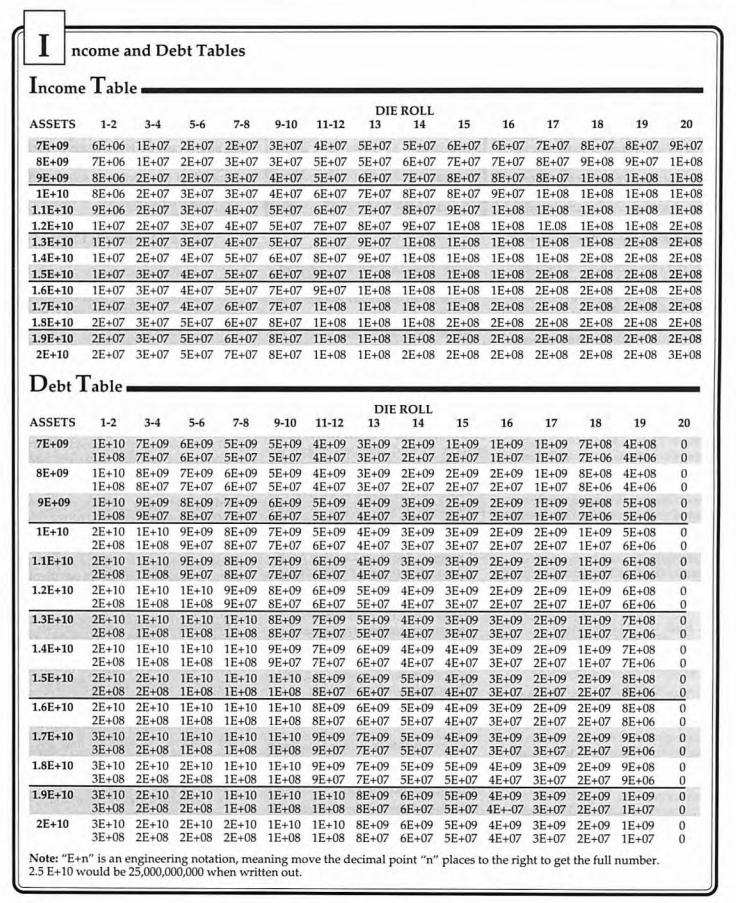
EVE Online: the RPG
I like to think that Torg was the first RPG to make serious use of scientific notation.
Oh, wait, there's one more thing we need to calculate for each company. Each firm has an amount of liquid cash , which is your monthly income after your monthly debt has been paid and you dealt with all the corporate warfare stuff.
Once you've done that for all the companies you control, you can finally participate in Corporate Duels .
Like most stronghold/domain management stuff, you deal with it on a month-by-month basis. You can still run around and shoot dudes and fight bad guys all you want, but at the start of each game month you have to go through a whole sequence of steps.
The first thing you have to do is determine stock fluxuation . As we all know, stocks go up and stocks go down, and in the most realistic economic model ever made this is determined by a roll of a die.
The GM rolls a d20; on a 1-5 it's a "bear market" (bad), and on a 16-20 it's a "bull market" (good). Then the CEO on each side rolls their business skill, and looks up their total on a table to determine what percentage your stock value changes. And there's a pretty wide swing here, from -30%/share to +30%/share depending on how well (or badly) you roll and the current state of the market.
The next step is asset/income adjustment , where you just multiply stock value by total shares, then apply the percentage change to the company's income.
Now you can transfer funds between corporations, which just means shifting cash around.
Next each company has to make its minimum debt payment . The minimum payment is 1% of its total debt, and interestingly in this stage you can only pay the minimum amount. If a subsidiary company can't make the payment, its stock value drops by 5% regardless of how well you rolled back in the stock fluxuation step. If a holding company can't make the payment, then it has to put up a subsidiary for sale in the next step. If the core holding coproration can't make the payment, then the whole shebang folds and everybody is out of a job.
After that, the GM has to set up potential corporate sales . He rolls a flat d20 to see how many outside companies are available for sale (zero, one, or two), and if there some available he rolls up their starting values and company type. Note that you can't buy these until later. Each side can also put their own subsidiaries up for sale at this point if they need the cash or were forced to in the last part.
Now you get to engage in corporate espionage . This just a d20 table the GM rolls on to set up an adventure hook for the players to go on and disrupt the other company's standings. Unfortunately, as near as I can tell it doesn't tell you exactly how your actions can affect the competition. I mean, I guess that blowing up a warehouse would cost the owner X amount of yen, but is that just subtracted from their assets? And how do you determine how much an office building is worth? Or a valuable piece of data? What if you learn about and stop a bribe; how does that affect the numbers?
Anyway, the next step is to allocate funds . You take your liquid funds available, and then allocate some or all of that money to various "corporate maneuvers", which happen next.
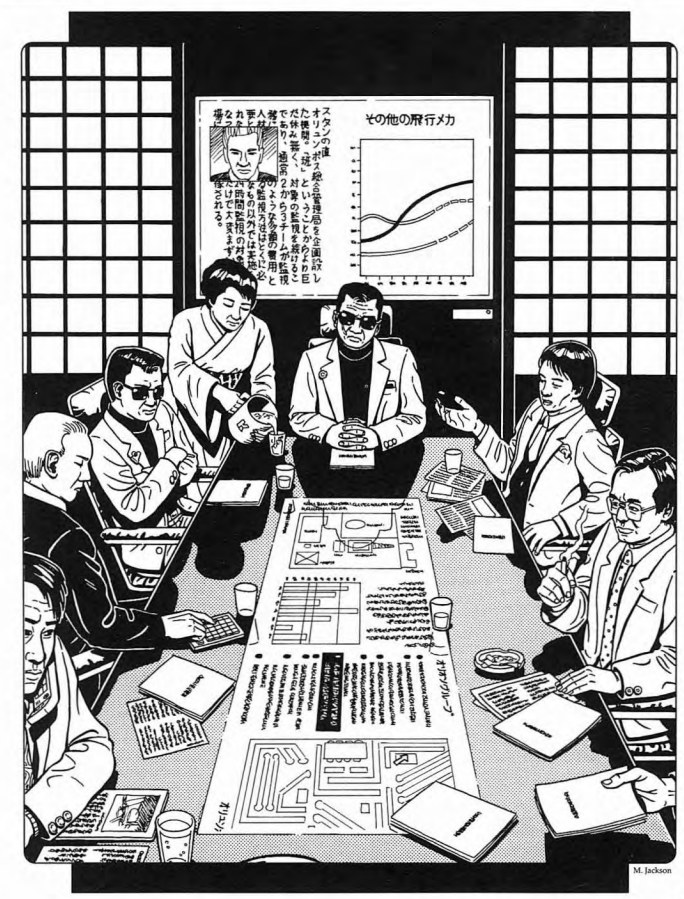
Exciting board room action!
Corporate maneuvers are the "actions" of corporate warfare. This is where your CEO finally gets to use his business skill because everything before this point was all flat rolls. Each month, you can perform as many as you want and can afford. Obviously, both sides of the conflict get to do this stuff.
quote:
This means that the gamemaster should decide on the allocations for the Kanawa-controlled firm involved, while the players decide upon what actions the Storm Knight-controlled corporation will take.
So what are our options?
Well, for starters we can invest in capital ; for every ¥100 million you invest your assets go up by 10%. This will also cause your stock price and income to go up at the end of the "business turn".
You can purchase stock in any company on the board, even ones controlled by your enemy. You can only buy available stocks this way; trying to buy more is a hostile takeover, and is done differently. A company's available stocks is a percentage of the total number of shares not held by the CEO, and the percentage is based on the current state of the market. Buying the stock requires a business roll, with the difficulty being based on the number of shares you're trying to buy. Exceeding the target number doesn't get you more shares than you wanted, but fortunately if you don't roll high enough to get the number of shares you wanted you can still buy shares based on your final total. The purchaser's assets increase by the total value of the purchased shares. It's also worth noting that when someone buys stock in a company, the company's owner does not get that cash; it's assumed to go to the shareholders.
You can also sell stock . The CEO can only sell the stock he owns (the starting 20% of the shares) at cost, and that money goes right into liquid funds. This works like purchasing, where you have to make a business roll to see how many shares you actually manage to sell. This means that it's harder to sell off large amounts of shares at once, which makes sense because nobody wants to buy into a company when the CEO is selling off all his shares.
You have the option of purchasing bonds , either in the "blue chip" or "junk" varieties. Money used for blue chip bonds is put aside for six months, at which point (assuming you're still in business) it returns with 10% interest with no roll required. Junk bonds, however, require a business roll against a difficulty of 14. Success means you get a 20% return on your investment, if you fail then you default and lose all that money.
Any company can issue bonds , again as blue chip or junk. You can issue bonds for up to your minimum monthly debt payment as blue chip, but more than that and they're junk bonds. The cost of the bond plus the 10%/20% is added to the corporation's debt total, but from what I can see there's no reason to do this because all it does is put you further into debt with no benefits whatsoever.
This is the point where you can pay off debts by just paying out of your liquid assets.
Now we start getting to the stuff where you're actively fucking with the other company's stock.
A stock assault is when you attempt to forcably reduce the value of another company's stock. To do this, you spend money in ¥100 million increments, each payout letting you make a difficulty 8 business roll. The better you roll the bigger a hit the target's stock value takes, from ¥100/per share up to ¥1000/share for a "spectacular" success.
You can perform a stock defense to prevent this from happening by spending ¥100 million to cancel an attacker's payout one-for-one. So if one person spends ¥500 million on a stock assault, and the defender spends ¥300 million, then the attacker only gets to roll twice.
You can attempt a hostile takeover , which is when you attempt to buy more stock in a company than is actually available for sale. Once you allocate funds for this, you make a business roll with a target number of the opposing CEO's base business skill. If you succeed, you buy the stock as normal. If you own more than half the stock in a company, you sieze it and add it to your corporate structure.
And again, you can perform a takeover defense by just allocating money, which cancels out the attack's allocated money one-for-one.
Lastly, you can perform corporate restructuring for ¥100 million, which just lets you rearrange your corporation's structure.
Technically after you take all your corporate maneuvers, you move to the final phase. But since Torg is one of the worst organized RPGs ever written, afer all the maneuver descriptions we're informed about something you're supposed to do before you do your maneuvers. At least, I think you are...it says you're supposed to do this before the "corporate operations phase", but there's no phase with that name. I'm assuming they mean maneuvers here.
Regardless, you can try to purchase new companies that were offered by the GM by bidding on them. Each CEO rolls their business , with the higher roll being able to bid on a company first. This is just a basic back-and-forth auction that goes until one person backs out. The winner places the corpotation in their structure and pays the cost. Any companies not purchased in this phase are discared, as it's assumed they're bought out by other megacorps.
The end of the corporate management sequence is stock and asset adjustment , which just means you calculate all your new values based on all the goings on. Oh, and now they talk about how the GM should take the PCs blowing up competitor's assets into account, and it's just "give it a value in yen, deduct it from the owner's assets". I mean, I figured that was the case, but again there's no info or guidelines for things that are a little beyond "we blew up X yen worth of stuff".
At this point you're done with the monthly management. One thing to bear in mind too (and again, they don't mention this until the end, and in what seems like an unrelated section) is that every quarter you have to pay out to your shareholders. This means that every company in your structure has to pay out 1% of its income. Failure to pay this means that the company gets +10 to its stock fluxuation roll until it can pay out.
So now I'm sure you're all wondering what the hell the point of all this is.
The answer, believe it or not, is that it's a way to kick 3327 out of the High Lord's seat.
It's important to remember that despite the power of the Darkness Device, 3327 is still subject to the Laws of his world. Not only does he have his responisibilities as the CEO of Kanawa and everything back in Marketplace, Daikoku (his Darkness Device) is also attuned to the nature of Marketplace and has become as addicted to "profit" as 3327. Yeah, it only cares about profit in terms of how much possibility energy its fed, but still.
If the war on Core Earth ever became unprofitable, if the Kanawa Corproration ever dipped into the red, 3327 would be fucked . According to the laws he himself set up in his culture, he would immediately be stripped of his position, have all his possessions siezed, locked in a room, given 24 hours to recoup the losses, and either commit suicide or get shot in the back of the head, his choice.
And Daikoku wouldn't help him at all. In fact, it'd sever the bond with him and vanish, possibly saying "I guess you've lost it, kid" on the way out, and seek out a new person to empower as High Lord of Marketplace. It's doubtful Kanawa's new CEO would want to hold onto an unprofitable venture, so it's pretty likely Kanawa would be out of business for good.
Corprorate warfare is intended to allow the PCs to do that. Obviously it'd take a while, and the book suggests that you start with the PCs taking out a few smaller megacorps before tackling Kanawa itself, but still it's a potential win condition.
---
You know, I'm kind of torn on this. On the one hand it's a lot of math and it's pretty dry for the most part. On the other, it's modern-day domain management and that's pretty cool. The whole corporate warfare thing is an interesting way to allow players to fight against 3327 more-or-less directly.
Still, I can't imagine this was something that saw a ton of use.
NEXT TIME: Remote offices, miracles, gear, and character templates
Work Sites, Assets, Human Resources, and the Exit Interview
Original SA post The storm has a name... - Let's Read TORG
Part 12h: Work Sites, Assets, Human Resources, and the Exit Interview
The next few chapters are pretty short, so I'm just going to cover them all in one big wrap-up post so we can finish up with the realm.
Chapter 7 is called Flash Points , and is the obligatory collection of "typical" adventure sites, with maps and a hook or two each. Nothing to spend a lot of time with, but let's run down what they have anyway.
First up is the John Woo staple, the Yakuza Armory/Safehouse . This is pretty much what you'd expect: a place for the Yakuza enforcers to hide out and gear up. Now that 3327 is effectively running the whole show, security's been beefed up from the old days of "a few scowly guys in sunglasses". Getting in quietly requires keycards and "invoices" from one of the Yakuza's cover companies. Getting in loudly involves the sorts of weapons you'd expect it to.
Taking a Yakuza warehouse can net you a lot of hardware, and maybe a drug shipment or two if you're lucky.
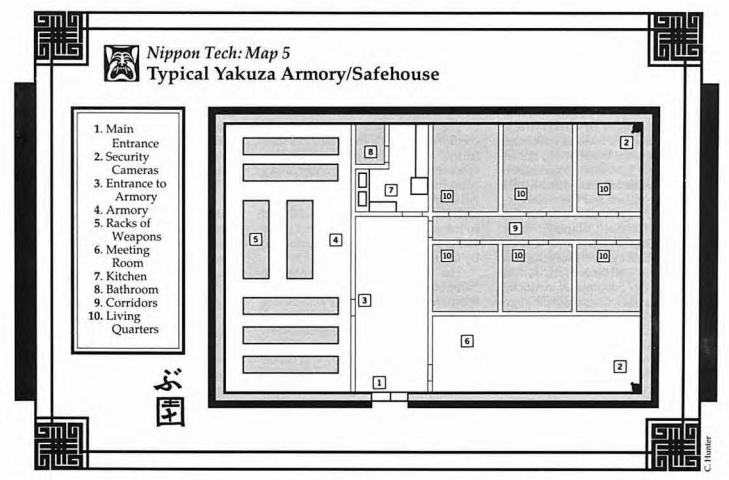
This place is very...rectangular.
The Rauru Block Headquarters isn't a generic location. In fact, the HQ is actually the summer home of one of the member CEOs. It's a nice, large two-story house up near the mountains in Osaka, and sadly doesn't have much by way of security. The only reason 3327 hasn't just killed everyone who lives there is because he's still in the early, subtle stages of the takeover.
quote:
An unknown percentage of Samayura's servants are actually corporate ninja, who serve as bodyguards to the industrialist and the other CEOs who visit the palace.
Ueno Park is the Core Earth headquarters of the Shiki, who you may remember are the Marketplace-based eco-warrior rebellion. A bunch of operatives managed to come down the bridge and have set up shop in the area around the park.

Not that I blame them, the place is beautiful.
And that's a good thing, because the shifting of Japan's axioms has turned the park from one of the country's main tourist attractions into an area rife with criminal and gang presense. Currently control of the area is a tug-of-war between the Shiki and the gangs, with 3327 waiting for one side to wipe the other out so he can come in and mop up whoever's left.
Next up is the good old-fashioned Gospog Factory . As stated previously, 3327 doesn't rely on gospog like the other High Lords do; having giant monstrosities wandering around killing people doesn't really help the whole "secret takeover" thing, so he relies more on human operatives.
That said, 3327 isn't stupid. He knows how useful gospog are, so he's still making them. He's just doing it in a converted hydroponics lab instead of a giant field full of dead bodies.
Then there's the Sons of the Wind Temple , a.k.a. "the dojo you have the big martial arts smackdown at". It's in a suitably out-of-the-way place that requires a difficulty 15 climbing roll to get to, and even when you reach it you might think it was an old Shinto temple. There's really no reason to come here except to meet the Sons of the Wind and then get attacked by ninjas.
Lastly, the Izumo-Taisha Shrine is one of the oldest temples in Japan, as well as being one of the most important. Legend says that all the Shinto gods gather here every October, and given everything that's going on now that might actually be happening.
A number of Palanic priests have set up shop here, some from Marketplace and other converts from Core Earth. The Shinto priests who maintain the shrine allow the Palanic priests sanctuary, unaware that a lot of them have turned their back on their pacifist ways and are actually sneaking out to sabotage 3327's assets. 3327 hasn't made a move against the temple yet, because he knows better than to sent task forces to attack one of the most important sites in the country.
Now we go to Chapter 8, Miracles of Faith . The Spiritual axiom of Nippon Tech is just below that of Core Earth, so miracles are possible , but very hard to pull off. Back in the cosm, only priests of Palan were capable of performing miracles and even then it took years of training. In the realm, Shinto priests are finding themselves capable of performing miracles under the new rules.
That said, there's really not a lot here, though. I might as well just run down the full list:
-
Bow Master
gives you +3 to your
missile weapons
skill for a day.
-
Call Animals
summons all animals (or one specific animal type) in a 600-meter radius. That's a third of a mile. That's a
lot
of animals. Note that you can't control or communicate with them without using other miracles.
-
Captivate
requires you to speak for a solid minute, which will cause the targets to be unable to do anything but listen to the priest until he stops talking or the target is attacked.
-
The Death of Sound
is
an indie prog rock banda ridiculously overpowered miracle that cancels all sound in a 150 meter radius for five minutes. That's one and a half football fields. I'd imagine any benefit you'd gain from stealth would be negated by everyone in the building panicing because they think they all went deaf.
-
Detect Deception
will allow you to detect all untruths for an hour.
-
Flame Burst
causes an existing flame to explode to "20 times greater than the original source".
-
Ghost Walk
lets the target do the walk-on-rice-paper thing, leaving no trace of passage. The target cannot be tracked with the
tracking
skill, but can be tracked with the
detect miracle
rite.
-
Pathway
is divine GPS; you know the best route to any geographic location.
-
Purify Poison
does what it says on the label.
-
Spirit Flight
is basically "astral form". Your spirit is set free, allowing you to move around ignoring obstacles. You can't move more than 300 yards from your body without increasing the difficulty of maintaining the spell, and you can't interact with things in the physical world. You are completely invisible (except to
detect miracle
), and can interact with spirits. This lasts until you return to your body.
-
Spirit Quest
just gives you +3 to
Spirit
-based rolls for an hour.
-
Staff of Palan
gives the priest's staff +1 to its damage value.
-
Sword Master
is the same as
Bow Master
, except the bonus is for
melee weapons
.
-
True Vision
lets you see in the dark and detect hidden doors and panels.
-
Voices of Stone
allows you to talk to rocks. It does not force the rock to actually
tell
you anything, which means you could cast the miracle and get nothing for it.
-
Wings of Sparrow
gives you a whopping +1 to your
dodge
for an hour.
Oh, and there's a miracle that creates a whirlwind that flings stuff around hard enough to hurt people called Kamikaze . I mean, yes, "kamikaze" means "spirit wind" but come on you had to use that word? It's not like the associated baggage that comes with it isn't widely known.
Leaving that awkwardness behind we come to the Equipment chapter. Here we learn the current exchange rates ($1 = ¥140), and this is important because all the prices here are given in yen. They also give a table of how much the value of the yen will deflate over the course of the invasion because that matters. I mean, it's not like they did that for any of the other realities or realms. I'd imagine having Generic Fantasy World land on England and northern Europe did a number on the economy there, but I'm pretty sure there's nothing in the Asyle book about that.
Anyway, we get the usual list o' weapons here. The normal firearms don't have too much that's really worth talking about because it's all "modern guns, just a point or two better" stuff, although it's interesting to note that a bunch of guns publicly sold by the Kanawa Corporation's subsidiaries are made from plastics, which means they don't set off metal detectors. I'm sure that isn't causing worldwide problems.
The melee weapons section is actually a lot leaner than you'd expect. Yeah, there's the katana and the manriki-gusari are included, as they were in any 90's RPG that even mentioned martial arts, but apart from that you've got the shimsi sword (the smaller ninja katana), nunchaka, and throwing stars and that's it.
That's not to say there's not more weapons, it's just that they've been teched up a bit. So you have shock swords (always deal a K result on top of everything else), heat-seeking throwing stars, spring-loaded stiletto, and the EMP Sai that can knock out all electronics in a 10 meter radius for two minutes.
On the plus side, we do have power armor. Sort of.
quote:
Rijato Battlesuit: One of the most sophisticated suits of armor in the realm, the Rijato is solar-powered and equipped with wrist-blasters, magnesium flares, and magnetic repellors which allow it to fly. It is not intended to be worn, but can be controlled from afar via a cybernetic helmet. This armor is beyond even the Tech axioms of Nippon, and at present only the prototype is known to exist (it was stolen by its inventor before 3327 could appropriate it). It is not available on the open market, and there is no way of knowing if it could ever be duplicated.
Due to the strain of maintaining cybernetic control of the armor, for every hour in which the armor is in use, there is a -1 penalty to all of the controller's Mind-based skills. These skills can be returned to normal by resting for a number of hours equal to the time spent operating the armor.
The wrist-blasters do damage value 18(range 3-40/200/5OO), the magnesium flares are damage value 9 (range1-6/15/40-unprotected eyes only),and the armor can fly at a speed of 70 kmh.
The improvement in technology has made the dream of "domestic robots" come true. At least, it came true for people who could afford the ¥2.1 million price tag. The Mitsubishi Home-Domo will cook, clean, perform household maintenance, and even provide early warning against gas attack! Sadly, they don't tell you what it looks like so I don't know if it's a humaniod robot or if it looks like something from Runaway .
The "Adventuring Gear" section has all the espionage gadgets you'd expect; electronic lockpics, grapple guns, tracers, signal scramblers, that sort of stuff. But the main attraction here are the "domestic" electronics.
Why? Because trying to predict technologies will never not be funny.
quote:
Zamftech Monolith: The RISC17-based Monolith computer features a single chip containing the 64 bit video coprocessor, floating point co-processor, and voice recognition processor. Comes bundled with touchpad, 32Mb memory, multiple output option module, including both color and tactile compatibilities and a 1 Gb optical drive. Memory can be increased to 256 Mb and up to seven additional optical drives can be daisy-chained to the primary drive.
quote:
Misaki XE Laptop Computer: The hottest selling portable in Marketplace and Nippon, tlus unit features a fast RISC15 processor-a single chip containing the 16 bit video coprocessor, floating point co-processor, and voice recognition processor. Comes with 16 Mb memory, 100 Mb storage, and weighs less than four pounds.

I imagine it looks like something like this.
quote:
Sony Talkman: The latest revolution in cellular technology, the Talkman is a personal telephone no larger than a wallet. It can be worn on a belt or inside a suitcoat to receive calls at any time, and can also be used in conjunction with the Zamftech Personal FAX.
quote:
Nintendo 32-Bit NES III: Nippon's most popular home entertainment unit, available cartridges include Zelda V, Ninjn Castle, Mega-Corporate Wars, Ronin Rampage, and Evander Holyfield Ten Count. Unit comes standard with stereo headphones and 6" 64-bit color display.
 Although I'm impressed that the NES III has a larger screen than a New 3DS. Just for the record, in 1991 the SNES had
just
come out in the states, and the original brick Game Boy had been out for about a year and a half.
Although I'm impressed that the NES III has a larger screen than a New 3DS. Just for the record, in 1991 the SNES had
just
come out in the states, and the original brick Game Boy had been out for about a year and a half.
Finally, at long last, we come to the character templates. There aren't that many templates for Nippon Tech or Marketplace, with the core set having a whopping two, both from Marketplace:
The Contract Ninja does bad things for money, but doesn't take pleasure in it. That said, he's not liking how a lot of his bretheren are starting to enjoy their work a little too much. Going against the clan made him a target, so now he's on the run and looking for...other options when it comes to employment. His tag skill is martial arts .
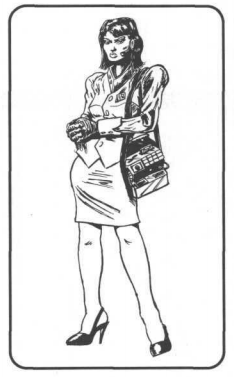
The Disgruntled Corporate used to work for Mitsuyana Industries, one of the companies on the wrong end of 3327's rise to power. She didn't like that; she also didn't like that working for the wrong company could get you killed by ninjas, assault teams, or street gangs for hire. Sick of seeing the downward spiral that is Marketplace "corporate politics", she put in her notice and headed to Core Earth to be a consultant. She starts with a Panasonic Currency Emulator ("manufactures copies of up to 1, 000 units of any paper currency per cartridge", not mentioned anywhere else, probably illegal as fuck), some gadgets, a fake ID, and ¥5,000,000.
Those are pretty...dull, and point to the problem Nippon Tech's always had; the writers had no idea what characters would do there. Fortunately, the realm book added a bunch more options.
The Corproate Ninja used to work for the weakest companies. Not because of honor or a love of the underdog, but because the opponents put up more of a challenge. As the corporate war spread into Core Earth, he was approached by agents of the Rauru Block and hired to fight for them. This is just the Contract Ninja, updated with the stuff from this book.
The Kashi Hacker is a Marketplace freedom fighter from a long line of people who've been fighting the corproate overlords. Unlike most of Kashi, she doesn't rely on sabotage and propaganda. Instead, she got a corporate position to gain access to the computer networks of the megacorps. When she learned of the Core Earth invasion, she got herself added to the project. Now, she uses her skills to aid the Rauru Block and diseminate information to Storm Knight groups. She starts with a hilariously clunky laptop, and her tag skill is science .
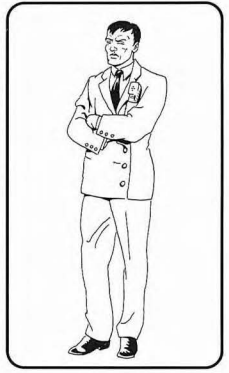
The Mega-Corporation CEO is from Core Earth, and knew something was off about Kanawa from the start. This caused him to become a bit of a business pariah as the companies he used to have good relations with started dancing to Ryuchi Kanawa's tune. Refusing to play ball resulted in one of his factories being bombed and the murders of a good number of his higher-ups. Now allied with the Rauru Block, his main contribution is in the financial sector. He starts with a Brooks Borthers suit, ¥1 billion, and (of course) his own megacorporation. His tag skill is business .
The Priest of Palan started out as a low-level office drone. Then he heard the words of Palan, the idea that all men were equal regardless of wealth or position, the idea that the world was beautiful once and could be again. In a moment of clarity, he left his company (costing them 300k credits on the way out because fuck those guys) and joined the priesthood. And everything was fine until the Termination and thousands of Palan's faithful were wiped out. He managed to insinutae himself back into corporate life as a low-level beurocrat to get to Core Earth, and is now helping mobilize resistance. His tag skill is focus .
The Rauru Block Agent is, well, some guy with a gun. There's no real background for this guy, and his description boils down to "you see Japan going down the toilet and are fighting back". His tag skill is evidence analysis .
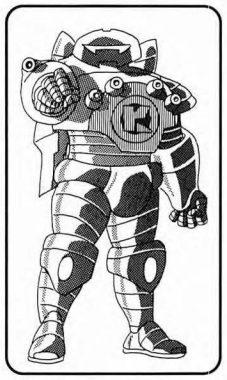
The Rijato Armored Warrior is the guy who developed and stole that power armor we read about back in the Equipment chapter. His tag skill is science .
quote:
For years, you were an integral part of the crack research and design team in a South Korean electronics firm. Shortly before the Possibility Wars broke out in various nations, you and your crew were working on plans for an armored battlesuit, something beyond the limits of current technology. So absorbed were you in your work that you took no notice of the purchase of your firm by the Kanawa Corporation.
Finally, it was ready, a prototype suit of armor that might never be duplicated. Devastating wrist blasters, magnetic repellors for flight, and various other devices made it virtually priceless on the open market.
Then the word came down from the 75th floor of the Kanawa Building in Tokyo: the Rijato belonged to the mega-corporation. You didn't want to see your work turned into a weapon of destruction. You slipped past the guards at the research center, altered the helmet so it would respond only to your mind, and stole the battlesuit.
https://www.youtube.com/watch?v=CISRRn3wolk
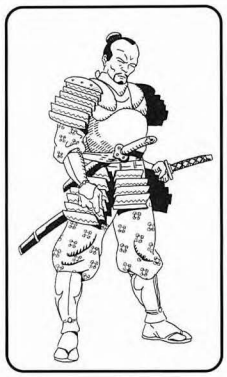
The Ronin is actually a samurai from Marketplace. He inherited the title from his father, but while traditionally a samurai would serve a master, he descided that being a free agent would work out better for him in the long run. This turned out to be a bad descision, because a contract from 3327 himself led you to kill the elderly mother of a Shiki leader. He then made the worst mistake of his life: telling 3327 he wouldn't complete the contract. This branded him a criminal with a sizeable price on his head, sending him into hiding until he learned of 3327's movement into Core Earth. His tag skill is melee weapons .
The Shiki is a street punk who's joined with other punks for mutual survival. Nobody cares about the lower classes in Marketplace apart from the Shiki group, and this kid was part of the front-line fighters who had to deal with MarSec and would raid warehouses for things like food. He was hand-picked to go to Core Earth, where he hooked up with other like-minded individuals. His tag skill is fire combat /
The Son of the Wind was living in a remote temple when the invasion happened, but could sense the change in the land. Calling together the Sons, he petitioned that the group should take up arms and fight the invaders. Unfortunately, most of the Sons felt that the best course of action would be to remain in seclusion rather than risk getting wiped out. Unwilling to stand by and do nothing, he left the temple and entered the world at large for the first time. Adjusting to things has taken a while, but he doesn't regret his choice for a second. His tag skill is martial arts .
The Yakuza Enforcer is one of the old guard. He was respected, feared, and wealthy. But then there was the takeover. The restructuring. All of a sudden he found himself working under a different daimyo and being sent to raid corporations and threaten businessmen. Which made no sense; what the hell did the yakuza care about electronics firms? A little digging revealed that Isei Sagato wasn't the one actually in charge anymore, and that the yakuza was being used as a blunt instrument in a much larger battle. He's still in the yakuza, but now he's doing a little...moonlighting on the side. His tag skill is fire combat .
And that, at long last, brings us to the end of the Nippon Tech book. So what does the future hold for 3327?
Within a year 3327 does manage to drop a second bridge in Sacramento, California, driving back the Living Land and making an enemy of Baruk Kaah. 3327 did this by uprooting Living Land stelae and quickly replacing them with Nippon Tech ones. To the outside world, this looked like the Living Land territory was just receding from around Sacramento for no reason. Dubbed "The Miracle of Sacramento", this spurred the stateside development of the Kanawa Corporation with the grateful backing of the American government.
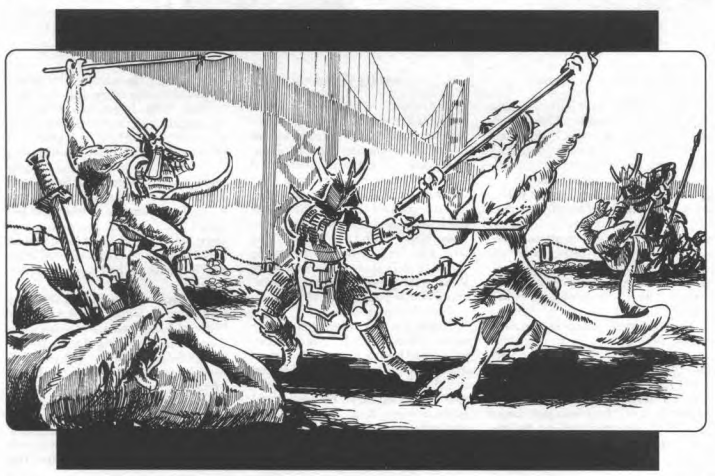
For Torg, this is pretty mundane.
He also expands westward from Japan, dropping two more bridges in Japan and siezing Taiwan and South Korea. From there he begins moving into mainland China.
That's not to say it's all gravy for 3327. Tharkoldu agents, still pissed that he was responsible for their failure in Russia, begin sabotaging Nippon Tech stelae in America. As a result, Kanawa expansion hasn't been as fast as 3327 would like.
Unsurprisingly, 3327 doesn't have too many allies among the other High Lords due to the fact that he sells weapons to the good guys and has been doing the land grab trick. The only ones who'll have anything to do with him are Uthorion (who's so weakened he'll take any help he can get) and Mobius (who's crazy).
The early failures spur 3327 to begin striking harder, which is the first step on him being revealed as a High Lord. That revelation wouldn't come for about three years, but before then he starts expanding faster and further.
Then Tharkold will drop a bridge on L.A., and 3327 will suddenly find himself in a much shakier position.
---
And that, ladies and gentlemen, is Nippon Tech.
I feel like Nippon Tech is right up there with the Living Land in terms of being a really interesting setting idea that falls flat due to bad presentation and lack of thought about what you'd do there. I realize that the 90's were a ways before we as a hobby started asking things like "so what do we actually do with this?". But even so, there doesn't seem to be any effort put into things apart from there being martial arts and megacorps.
I said this before, but Nippon Tech should be "Robocop and Judge Dredd by way of John Woo". All the elements are there: the out-of-control corporate culture, the huge gap between the haves and have-nots, the inbuilt crime drama and revenge story motifs.
But none of it hangs together. Each concept lives in near total isolation from the others, leaving everything feeling disjointed.
I remember someone saying that in the original Feng Shui that the Buro was included so that people had a place to get high-tech guns from, but the developers didn't expect that people would want to go to that juncture and hang out.
I get the impression that Nippon Tech suffered from the same problem. They needed a place for PCs to get weapons and high-tech gear, so they created this realm. But oddly, they didn't realize that if you make a region in your setting and earmark it as being important, then people are going to want to go there and learn more about it.
Ultimately Nippon Tech ends up being another example of Torg's biggest problem: good ideas, poorly implemented. And it's a shame, because who wouldn't want to play in the RPG equivalent of Sleeping Dogs?
NEXT TIME: A different reality! What will it be!?
Welcome to the Nile Empire...now DIE!
Original SA post The storm has a name... - Let's Read TORG
Part 13a: Welcome to the Nile Empire...now DIE!
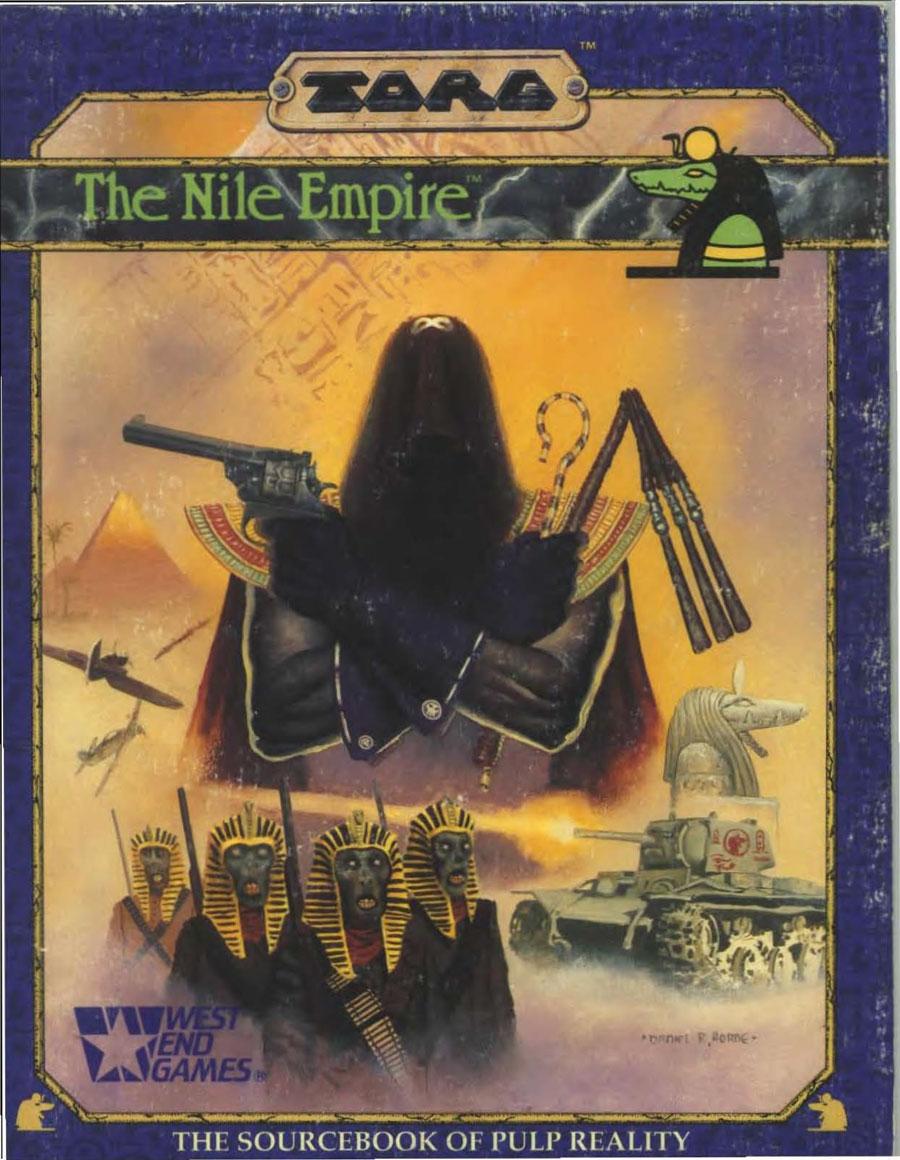
Those are supposed to be mummies, not monkeys.
Robed priests offer sacrifices to the ancient Egyptian gods to honor their High Lord.
Mathematicians, astronomers, and engineers build great works designed to channel the mystical energies of the world to smite their enemies.
Brave explorers find an an artifact in a forgotten tomb, awakening the mummy bound to guard it. Can they escape the mummy and the cultists who also seek the artifact?
A pair of murderous thugs face justice in the form of a mystery man shrouded in smoke and bearing twin pistols.
Just another day in the Nile Empire.
The New Empire of the Nile
A reality away from Core Earth is the world of Terra. Of all the invading realities, Terra is probably the "closest" to Core Earth, sharing a nearly identical history. Of course, there are a few differences.
First of all, in Terra the current year is 1936. The Great War is still a recent memory, with nations recouping losses and trying to figure out what will happen next.
Second, magic exists and technology is a little...different. Early discovery of what is termed "weird science" has affected the larger landscape of the world. Rocket Rangers in jet-powered flying suits fought in the Great War, governments develop superweapons, and countless scientists create impossible devices. Generally speaking, though, weird science hasn't really affected day-to-day life that much.
Third, there are the heroes and villains. "Mystery men" are abound, armed with strange powers, wierd science devices, and their own two fists. They are all that stands between normal folk and the churlish villains that seek to control the world.
Fourth, and most importantly: millenea ago, the man who would become Terra's High Lord was born.
Three thousand years ago in ancient Egypt, pharoh Amat-Ra had an illegitimate son named Sutenhotep. Sutenhotep was a natural leader, and managed to conquer most of northern Africa in his father's name. Despite his victories, the circumstances of his birth would prevent him from becoming pharaoh when Amat-Ra died. Instead, Sutenhotep's half-brother (and Amat-Ra's legitimate son) Toth was chosen to inherit the throne. Sutenhotep was so furious that Toth was chosen, despite the fact that he was clearly the better leader, he swore that he would not only conquer Egypt but "conquer time and eternity itself".
Exiled after an atempted coup, Sutenhotep returned home after 15 of stewing in the desert and raising a new army. This time, he managed to defeat Amat-Ra and sieze control of the nation. Sutenhotep's first order of business was to kill all his father's advisors, and his second was to order the mummification of the still-living Amat-Ra in "tribute to his station".
Amat-Ra's death was slow and torturous, but before he died he was able to curse Sutenhotep and his reign.
quote:
Amat-Ra's curse took effect almost immediately upon his death and quickly caused Egypt's fertile crops to be overcome with blight. The lands shifted into arid, barren deserts and once-complacent peasants turned into unruly rioters. A mere six months after Sutenhotep took power, he was murdered during a public speech. The large audience in attendance bore witness to his assassination, and nearly all cheered uncontrollably for days as Sutenhotep's self-proclaimed desire to rule forever was brutally crushed.
Nearly all.
Fast-forward to August 12th, 1897. Exactly three thousand years after Sutenhotep's death.
A small group of cultists, descendants of Sutenhotep's original followers, assembled on a small island in the Pacific called "Khem" and performed long, profane rituals intended to bring Sutenhotep back from the dead.
And they succeeded. Their lord and would-be pharoh once again walked the earth.
But Sutenhotep wasn't stupid. Yes, he had conqured death, but he knew that this world wasn't the one he left. He didn't immediately send out armies or start scheming takeovers. He went into the world, and studied it.
Sutenhotep spent the next few years acclimating himself with the new world he found himself in. He spent some of this time in hiding, studying books brought to him by his followers. When he felt ready, he traveled to America to see the new world first-hand. It was his stop in San Francisco that would change the world forever:
quote:
Having been thrust entirely into the world of modern science without the intermediate development years, his studies were not clouded by those restrictions that Newton and Edison had floundered in. Combined with his own knowledge of magic and their unnatural effects, his concepts of science were not limited to the realm of Newtonian physics. His genius allowed him to see beyond the scientific community's nearsightedness and discover the world of "weird" science.
Armed with this new discovery, Sutenhotep returned to Khem and began to prepare for his conquest of the world. But that would require money, and so he created a new identity for himself, one worthy of his rank and goals: Sutenhotep was dead, and Dr. Mobius was born.
Mobius spent the early part of the 1900's committing crimes to fund his wierd science research. As his crime spree continued, he became more and more confident and began operating at a higher profile. It wasn't long before scientific prodigy Dr. Alexis Frest was able to predict Mobius's next move and aid the police in capturing him.
(In case you're wondering, Mobius's MO was to commit a robbery, then use an invisibility belt to hide in the room he committed his crime in. He'd wait patiently for the police to arrive and perform their investigation, and then just follow them out the door when they were done, probably trying not to laugh.)
Mobius managed to escape custody thanks to a teleportation device, and laid low for a few years. He tried his hand at crime again in New York, but once again met defeat, this time at the hands of private eye Rex McMasters. Frest was brought in once again and, using a thought-scanning device of his own invention, learned of Mobius' teleporter and confiscated it before sending Mobius to jail once more.
It took three years of scrounging small devices in prison for Mobius to make a replacement.
Mobius's first act upon freeing himself was to kidnap Frest and his family. Mobius continued his crime wave, only to be thwarted by the rising number of "mystery men" around the world. Foremost among them was the hero known only as "The Guardian", and it was in 1925 that Mobius and the Guardian would have a fateful meeting.
Mobius had learned of an ancient artifact that would give him the power he needed to finally conquer Terra. Breaking into a museum, he found it on display: a small statue of his patron god Sebek. The Guardian was there to stop him, and as they fought Mobius let slip the location of Frest and his family before managing to escape.
The Guardian single-handedly freed Frest and his family, and together The Guardian and Dr. Frest assembled a society of pulp heroes to put an end to the threat of Dr. Mobius once and for all: The Mystery Men .
Dr. Mobius, however, would vanish soon thereafter thanks to the artifact: the Darkness Device known as the Kefertiri Idol . Armed with the power of the Darkness Device, Mobius was able to travel to other worlds that were more ripe for the picking, conquer them, drain them dry, and move on without having to worry about those accursed heroes interfering.
Which brings us to the Near Now. Mobius has already conquered nine other cosms, with Core Earth being his "Tenth Empire", or (as he calls it) the "Nile Empire". The new reality he has brought down on Northern Africa has not only effectively turned back the clock to the mid-1930's, it's also brought the power of magic and weird science to the world, reshaping it to his whims. Now the ancient guardians under the pyramids awaken, forgotten artifacts surge with mystic power, and madmen design impossible weapons in hidden laboratories in Cairo.
Forutately, this new reality has brought new heroes with it to stand against them.
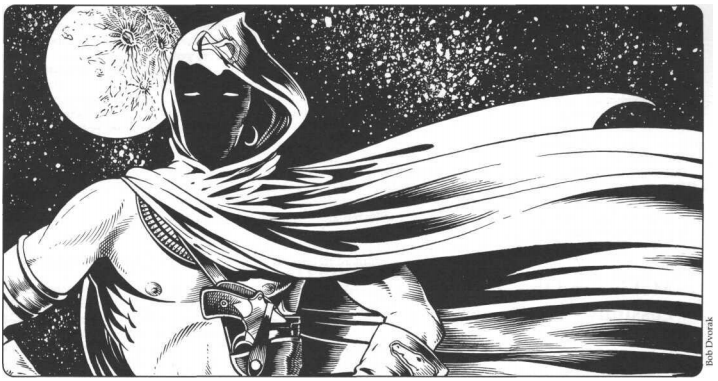
Dr. Mobius, High Lord of the Nile Empire
There are two important things to bear in mind about Mobius before we get to specifics.
First off, he is completely, utterly insane. Mobius is fond of dangerous schemes, bizarre deathtraps, and maniacal laughter. He takes a personal hand in his plans, and loves pitting himself against heroes of every stripe. In many ways he's a spoiled child, convinced that he's owed everything and taking things by force when denied. Despite this, he's still a genius and is capable of both high magics and incredible scientific discoveries. He is a meticulous planner, preparing back-up plans and plotting things to the point where he could give you an exact percentage of his progression in any scheme while he strapped you under the death ray. In fact, he's probably the only High Lord the characters would interact with directly since Mobius loves getting his hands dirty and facing off against do-gooders.
The second is that, despite conquering nine other realities and being a High Lord, Dr. Mobius never conquered his home cosm of Terra. This has a few implications, the main one being that the Nile Empire on Core Earth is not exactly the same as the reality of Terra. Because Terra's possibilities are not being siphoned by a Darkness Device, the normal flow of advancement isn't interrupted. The axioms of Terra are a little different from the Nile Empire's, and while the Nile Empire has a distict Egyptian bent to everything, back in Terra it's still more or less 1936 Earth and Dr. Mobius is Public Enemy Number One instead of the High Lord. Nobody is sure why he never took over Terra, but those in the know suspect it's the lingering effect of his father's curse.
(This also makes Terra unique among the home cosms of the Raiders; it's the only one that hasn't stagnated developmentally due to the normal flow of possibility energy being interrupted.)
In fact, Mobius's maelstrom bridge doesn't even lead back to Terra; it leads to the last cosm Mobius conquered. The Nile Empire is at the end of a "chain" of realities, meaning that to get from Core Earth to Terra would require travel across nine other cosms (that, unsurprisingly, were never actually detailed. Or even named.). This also means that it's a bit tricky for characters from Terra to get to Core Earth, but the game handled this by having Frest make a one-way, one-use bridge from Terra to Core Earth to send a bunch of hero types across.
Given all that, here's Mobius's overall agenda:
1. Achieve immortality. Yes, the Darkness Device makes him effectively immortal, but Mobius wants the real deal, without having to rely on an outside force. After all, the Kefertiri Idol could get bored with Mobius and ditch him at any moment. Right now, his best shot at immortality would involve becoming Torg.
2. Increase Personal Power. Nothing surprising here; for Mobius it's always been about power.
3. Expand the Boundaries of the Empire. The Nile Empire is the largest realm on Core Earth (taking up about a third of Africa), and Mobius just keeps on expanding southwards. Waves of shocktroops and death ray-equipped tanks make most resistance a joke. Also, when he extends his reality into the desert it retroactively becomes dotted with mystic sites and tombs full of ancient artifacts, which he can then plunder. So it's pretty much win-win.
4. Discover and Acquire Eternity Shards and Artifacts. Mobius sees these as tools to be used, weapons to be denied enemies, or bait to lure heroes into deathtraps.
5. Remove the Curse of Amat-Ra. The curse his father laid on him millenia ago still persists, and Mobius suspects that the curse is the cause for every large-scale failure he's ever come across. He's right, too; the curse slowly drains his possibility energy and causes him to automatically suffer setbacks in dramatic conflicts.
6. Solve the Mystery of the Tiles. In his investigations of places of power on Core Earth, Mobius has discovered mosaic tiles. The tiles are much older than the Earth, and are clearly alien in origin. Mobius doesn't know what they mean, but he's determined to find out. This bullet point is related to the first published adventure series, at which point it stopped mattering.
7. Explore the Ancient Mysteries of Earth's Egypt. When the Nile Empire's axioms washed over Core Earth, many of the old Egyptian legends were brought to life. Because this Egypt is different from the one Mobius remembers, he seeks out these new legends to determine their usefulness.
8. Weaken the Other High Lords. This is the lowest priority because Mobius is well aware that the High Lords fight like cats in a sack at the best of times. If there was a way to give himself a significant leg up, he'd take it of course. But until then, he's content to let the other High Lords tire themselves out fighting each other.
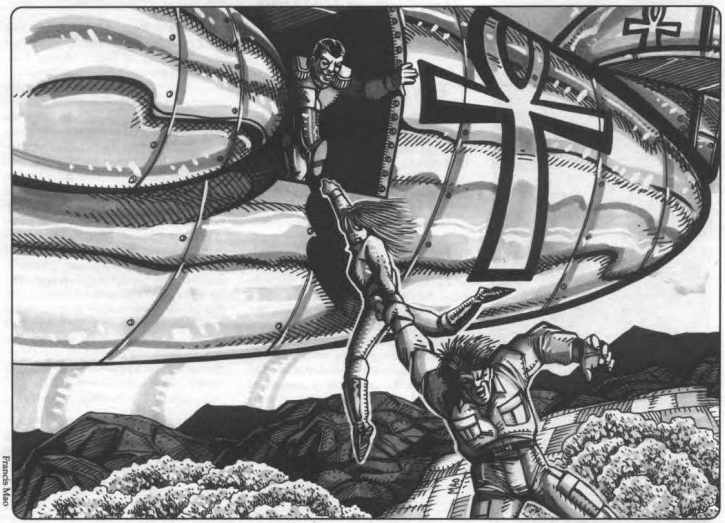
Really, this happens in the Nile Empire about every five minutes.
Axioms and World Laws
Let talk about how things operate in the Empire.
As stated before, the Nile Empire operates as per 1930's Earth for the most part, but the higher magic and spiritual axioms make things a little more interesting.
Technology: 21 - The Nile Empire is a little behind Core Earth tech-wise. Widespread electrical power was "recently" introduced, and most things we take for granted (like electric razors, color film, and toasters) are considered "cutting edge technology". Most methods of mass travel are pretty slow, with steam trains and slow carrier aircraft being the norm. Likewise, medical technology took a significant step backwards, and immunization isn't quite the standard procedure it used to be; disease is a very real danger.
Social: 20 - Socially speaking, things in the Empire are similar to Core Earth. The Empire does run on a large bureaucracy managed by Mobius's "overgoverners", though, and Mobius's troops enforce their rule. There's also this:
quote:
One important difference in the social arena between the Empire and Core Earth is the fact that the Terran cosm (and thus the Empire) never underwent the sexual revolution that rocked western civilization in the 1960s and '70s. An indiscreet unmarried couple from the Terran cosm that spends too much time together is the target of scandal and ridicule. Also of note is the fact that women in both the Terran cosm and the Nile Empire enjoy near-complete equality with their male counterparts, unlike the women of the Core Earth cosm of the 1920s.
Spiritual: 17 - Unsurprisingly, people worship the Egyptian gods, and the truly devout are capable of performing powerful miracles. In addition, powerful religious artifacts exist. Most of these artifacts are buried in the African deserts, and races to them between Mobius's forces and Storm Knights are pretty common.
Magic: 12 - In addition to mythology being made real, the arrival of the Empire has brought two new schools of magic with it: mathematics and engineering . Most practitioners were brought over the bridge with Mobius's troops, but a few transformed folks have been able to learn them. Still, it means that most magic power is controlled by Mobius to some degree.
In addtion to the axioms, the Nile Empire has three world laws that it inherited from Terra that help shape the realm.
First is the Law of Morality , which states that everyone in the Empire is either Good or Evil. Period.
The Nile Empire exists in a state of black-and-white morality. Every single person, regardless of circumstances, falls into one of these two categories. It's an approximate 90%/10% split between Good and Evil in Terra, but in the Empire it's more a 60/40 split.
Basically, "evil" people put their own self interests first, although they're not adverse to working with others if they can get something out of it for themselves. "Good" characters, on the other hand, look to common interests first.
quote:
Thus, stealing is usually an evil act since the thief is acting upon his or her own self-interest instead of the interests of the victim and community. By this same token, murder, extortion. and fraud are usually evil acts as well. Note, however, that one need not be a socially defined criminal in order to be evil. According to the Terran axioms, the old man who chases small children off his lawn for no other reason than the satisfaction of screaming is evil, as is the miser who refuses to give his employees time off when they are ill or injured. At the same time, not all "good" characters are crusading crime fighters. A shopkeeper who minds his own business, pays his taxes, and shows concern for his neighbor's sick aunt is "good," as is the bystander who gives directions to a lost motorist.
It should be pointed out that trying to perform a morally "grey" action is a one-case contradiction, meaning you disconnect on a 1 on a d20.
The world law does give characters two mechanical abilities: you can sense someone's Inclination when you play an alertness card, and it's possible to seduce someone of the opposite Inclination to your side through Charisma checks. Success can cost the target possibilities or even get them to either pay 2 possibilities or change Inclination. However, if you try to change someone's Inclination and fail, it costs you a possibility.
There's one final effect of the Law of Morality: "The Price of Evil". This is the effect of both Amat-Ra's curse and the axioms of the Empire; any time an Evil character enters the Empire he has to immediately forfeit a possibility. Evil doesn't pay, kids.
The second world law is The Law Of Drama , and it's what makes life in the Empire what it is. Basically, it means that anything that happens involving possibility-rated characters will be as melodramatic and exciting as possible. If a scientist is kidnapped, he will have a lovely daughter who will seek out heroes for help and one oh whom she will fall in love with. If you're chasing someone through the city streets, there will be cars pulling into the street in front of you or handcarts to swerve around. If you get into a fight, the furniture will be destroyed and if there's a window someone will go through it. When the bomb is found, there will be enough time to defuse it with two seconds left on the detonator.
Going hand-in-hand with that is the last world law, The Law of Action . The Law of Action states that possibility-rated characters are capable of amazing stunts and feats of ability. In game terms, that means that p-rated characters can spend two possibilities on an action, roll twice, and choose which die he wants to add to his original roll. It's expensive, but it can give you the added "oomph" to make that roll when you really need it.
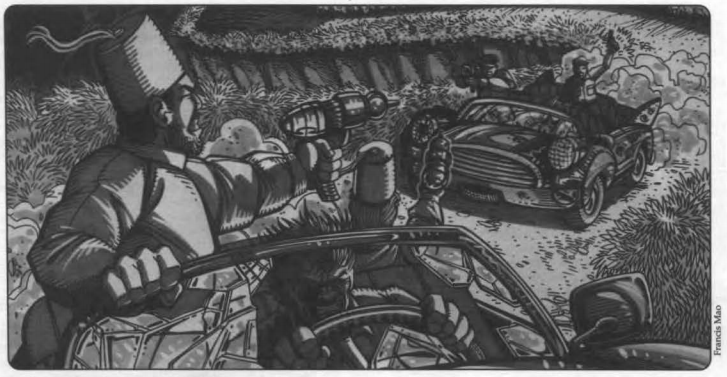
Car chases never go out of style
The combination of these world laws create a reality where advenutre is as important as gravity, where the stakes are always high, and where heroes and villains constantly clash. Magic is woven into mathematical formulas to ward against a swarm of invading mummies. A private eye jumps out a third-story window clutching a valuable lost idol while firing back at the thugs in the room he just escaped. Two cars barrel through crowded streets, a masked woman perched on the hood of the trailing car ready to leap to the pursued vehicle and save the kidnapped child inside before he is sacrificed to a forgotten god. And above it all is the specter of Dr. Mobius, weaving his insane schemes in his bid to become the Torg.
Just another day in the Nile Empire.
NEXT TIME: The red line travels across the map!
Bullet Lists of the Nile Empire
Original SA post The storm has a name... - Let's Read TORG
Part 13b: Bullet Lists of the Nile Empire
The first real chapter of the book is a high-level description of the Empire, so let's dig into it.
As was pointed out last time, Mobius has been expanding his realm very rapidly. In fact, he controls a pretty sizeable chunk of Africa right out of the gate.
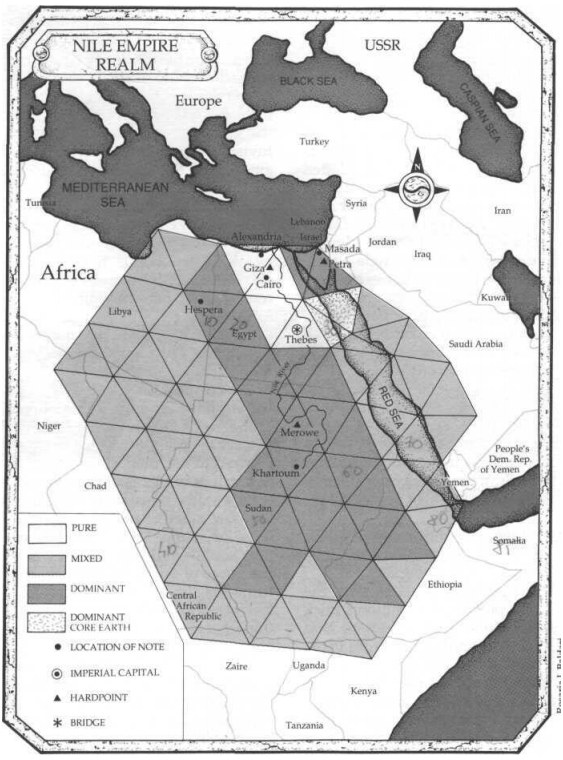
The Nile Empire, about three months after the initial invasion.
This is the map of the Empire at the default setting "start", about a month or so after the initial invasion. As you can see, Mobius has been pretty busy. He controls a pretty sizable chunk of Africa, and has gotten deep enough into Saudi Arabia to start being a threat to Iraq. We'll talk about how well that works out for all involved later.
Like all the High Lords, Dr. Mobius has come to Core Earth to oversee his forces personally. Of course, Mobius is a busy man and can't do everything by himself; that's why he has his five "Personal Advisors". These five people are second in power only to Mobius himself.
-
Ahkemeses
is the High Priest of the Empire, and it's his job to read the omens and act on them. Even though he worships all the Egyptian gods, his first loyalty is to Mobius and he's more than willing to break his religion's precepts.
-
Rama-Tet
is the head of the College of Mathematicians and Mobius' grand vizier. Like all grand viziers, he has his own agenda and is more interested in his own goals than in what Mobius wants. He's also a powerful magician, again, like any grand vizier worth his salt. He's basically the Starscream to Mobius' Megatron.
-
Muab
is the Royal Builder, and as such doesn't actually advise the pharaoh. Instead, his focus is almost entirely on his work: building monuments to Mobius and running the Society of Engineers.
-
Teth-Net
is the Royal Marshall and head of Mobius's military. Despite being totally loyal to Mobius, the High Lord has secretly implanted a poison bomb in Teth-Net's brain just to be on the safe side. Although this is Mobius; he might have done it because he thought it was funny.
-
Felix Bannerman
is the Imperial Accountant, and started out as a small-time hustler on Terra who happened to be very skilled at finance. He's not Egyptian, which makes him feel nervous around Mobius and the rest of the Advisers. Well, that, and the fact that he's skimming off the top.
Below the Advisers are the Overgovernors. There are ten Overgovernors, some of whom have been with Mobius throughout his reality-hopping career. Mobius shares the slowed aging with his Advisers and Overgovernors, so some of these folks have experience running things in other realities. Others are recruited from the invaded cosm.
Each Overgovernor has control of a different area of the Empire, and are allowed more-or-less total autonomy to run things as they see fit. They are picked by and report directly to Mobius himself, and every ten weeks they meet to discuss the state of the Empire as a whole.
-
Tanya Paterksi
was a skilled spy back on Terra, and is a consummate planner. She's faced off against Nippon Tech forces on multiple occasions and won every time.
-
Wu Han
is Terra's equivalent of Fu Manchu; an oriental criminal mastermind who is fond of riddles and leaving hints for his enemies. He's also an accomplished weird scientist.
-
Lord Millon Avery
is a Terran jewel thief and was an ally of Mobius back in Mobius's supervillain days. Avery got his position not by earning it, but by blackmailing Mobius shortly after his discover of the Darkness Device. I'm not sure how you could really blackmail someone bonded to a Darkness Device, but there you go.
-
The Red Hand
, born Michael Mayhew, was another of Mobius's old allies. Armed with an electro-gun and outfitted in a crimson zoot suit, Mayhew became a supervillian for the kicks and teamed up with Mobius back in the old pre-High Lord days. He's loyal to Mobius, but would leave if he found something more interesting to keep him entertained.
-
Natatiri
was originally the servant girl of a former Overgovernor. She was having an affair with the Overgovernor, but when he insulted her honor she assassinated him. Dr. Mobius liked the cut of her jib and promoted her to her master's former position.
-
Ramses
is a fanatic warrior who is probably the only one of the Overgovernors who isn't plotting againt Mobius. He's slowly becoming aware that the other Overgovernors might not have Mobius's best interest at heart.
-
Seselek
is the oldest of the Overgovernors. He is loyal to Mobius, but his age is catching up with him and lacks the energy to really carry out his duties. Even though Mobius has instructed the Darkness Device to slow Seselek's aging, the Kheferti Idol doesn't seem to like Seselek enough to keep him young. Smart money is on him being the next Overgovernor to die.
-
Herunut
has been an Overgovernor since the first Empire, but is not seeing the glory of following Mobius anymore. Instead, he's seeing the suffering; in fact, his Inclination is starting to shift to Good and wouldn't need much to push him to the other side.
-
Lastly, there's Madib
Al-Hebpsa
. Madib is actually Mobius himself, divested of his usual costume. He uses this identity to keep an eye on the other Overgovernors and learn about plans against him. Mobius doesn't realize that Rama knows who Madib really is; Janya and Sesetek know one of the Overgovernors is Mobius in disguise but they don't know which one.
Below the Overgovernors is a structure of governors, advisors, governor's advisors, and bureaucrats. But there's a problem here, which I'll get to in a second.
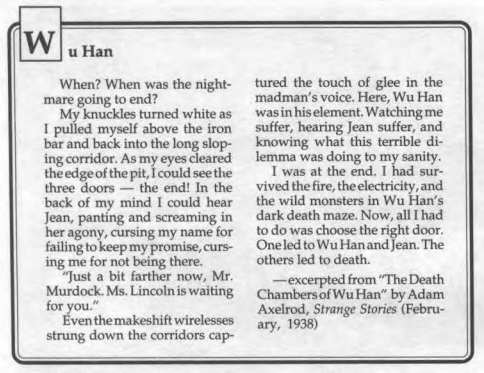
Everyone in Torg talks like this. Everyone .
Outside the structure of Mobius's followers is the military, which is mostly filled by shocktroopers, backed up by traditional armor units and weird science destructive devices.
And this is the problem I mentioned a moment ago: this is another point where we get into Torg's "I don't care about this level of detail" problems. This is what it says about Infantry Organization :
quote:
The smallest unit in the Imperial Army is a squad consisting of 10 men.
In addition to the normal equipment issued to each soldier, every squad is equipped with a Kocha machine gun. Squads are under the command of enlisted veterans.
Four squads make up a platoon . Platoons are commanded by lieutenants, the lowest ranking Imperial officers.
Three platoons make up a company . In addition to the equipment belonging to its platoons, each company has an attached mortar group consisting of five 81mm mortars . Companies are commanded by officers known as veteran lieutenants.
Four companies make up a battalion . Each battalion has an attached artillery group consisting of five 81mm mortars and five 105mm howitzers. Battalions are commanded by field majors.
Three battalions comprise a wing . The wing is the largest pure infantry formation in the Imperial Army. Wings are commanded by officers known as overmajors.
For instance, they talk about Mobius' personal Battlegroup: Super Battlegroup Mobius . That sounds pretty important, right? Like the kind of thing we should know details about, right? Nope! All we learn is how many platoons and infantry and tank units it has. Do they have the best gear? Do they get to play with Mobius' high-tech toys? Who's in charge? Who knows?
And then we run into Torg's other recurring problem: bouncing wildly from topic to topic. Because now we get a brief forray into how Mobius uses his gospog . Or how he doesn't use them, I guess...there are only 50 gospog throughout the Empire, and they're only second-planting ones. He mainly uses them for "special missions". Oh, and unsurprisingly they look like mummies.
At which point we hammer back into talking about military organization with garrisons . Which is just two paragraphs and a small stat block that boil down to "a garrison is manned by generic infantry, here's their stat block".
Now that we're through all that, we get to something important: how Mobius expands his territory. The heading for this section is called Moving the Stelae because fuck decent headers.
Mobius has managed to expand so quickly because he takes a very straightforward approach to it. One thing Mobius has in spades is strength of numbers. When he wants to sieze a new area, he sends in wave upon wave of shocktroops, artillery, and weird science weapons at the problem. Once he wipes out any resistance, his agents rush in and plant the stelae. The troops already there act as the "believers" needed to empower it, and boom. Another chunk of land for the High Lord.
Nile Empire stelae, by the way, take the shape of jackal-headed idols. They can't be buried underground, so Mobius hides them in plain sight by putting non-stelae jackal-headed idols everywhere throughout the Empire.
Now, I know some of you are thinking "superior numbers are one thing, but 1930's military technology probably wouldn't stand up to modern military hardware". And you're pretty much right. For that exact reason, Mobius has pushed the boundaries of weird science and reality-based technology to develop the reality bomb . These bombs don't do any physical damage; what they do is temporarily alter the reality for two miles around the explosion point to a Nile Empire pure zone. And since it's a pure zone, contradictions are impossible. Anything not allowed by Nile Empire axioms simply won't work, which will generally include most Core Earth military hardware. And while everyone's trying to figure out why everything is busted, Mobius' troops can mop up easily.
Rality bombs are incredibly difficult to make because they require a substance called "eternium", which is generated by drawing power from Eternity Shards. Even at peak efficiency, Mobius can only make about five reality bombs a week.
quote:
Etemium is an element of pure possibility energy distilled down from eternity shards (atomic number 772, atomic weight 1611.022). Its synthesis is one of Mobius' proudest accomplishments.In its pure form, etemium resembles a glowing blue rock with swirls of red.
Eternium has two main functions. First, it is the crucial ingredient of the "reality bombs" which Mobius uses to temporarily alter the reality axioms of an area in preparation for an invasion. And second. a chip of eternium is capable of functioning as an infinite power source when properly connected to a gadget or gizmo. All charge-using power components connected to an appropriate chip of eternium can draw energy from that chip forever, with no recharging necessary. The greater the power requirements of the gizmo, the larger the chunk of eternium needed to power it (a component with an adventure cost of 1 or 2 might require a piece of eternium the size of a bottlecap, while one with an adventure cost of 6 or 8 might need a piece the size of a golf ball). Eternium has thousands of other potential uses which Mobius is only beginning to discover.
Since the amount of eternium that Mobius can synthesize directly corresponds to the number of eternity shards he can recover, and since such objects are quire rare, there is presently not very much eternium to go around. Most of the element that is synthesized is used to create the vital reality bombs.
Really, this whole chapter is just...unnecessary. You get all these named NPC who are supposed to be important, and are running whole regions of the Empire, but there's nothing about what makes each leader unique. They don't put their own personal stamp on their territory, they don't favor a certain type of henchman or scheme or whatever, and except for Wu Han I don't think any of them get mentioned again in the game line.
Same with the military stuff. Yes, it's useful to get a general outline of how Mobius' war machine works, since a large part of his plans involve his army pushing further south through Africa and expanding his realm, but do I really need to know how many infantry in a platoon in a battalion or whatever it is?
I hate sounding like a broken record, but these guys had zero idea on how to write tone.
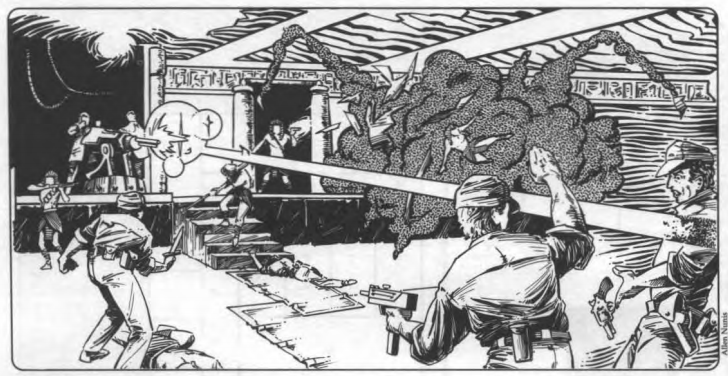
This exact scene is happening somewhere in the Nile Empire at any given moment.
Anyway. The next chapter is Cities of Adventure , and deals with the major cities of the Empire.
Approximately 60% of the Empire's population live in the cities, with the remainder living and working in the farming communities that feed the cities. The reality shift has changed the major urban centers of northern Africa to a technological and social level that best equates to "1939".
quote:
The vast majority of the urban citizens ultimately work for the Imperial government, but, again, Mobius has sold a few scattered businesses back to wealthy, favored Earth people. Approximately 10 percent of the Empire's manufacturing industry, 15 percent of its packing industry, and 30 percent of its merchants are independent. Nearly 100 percent of the Empire's entertainment industry is in the hands of independent businessmen. Saloons (which sell only overpriced "legal" liquor), movie theaters,and dance halls are all fairly common in large cities.
The largest city in the Empire is Cairo , which has been hit particularly hard by the axiom wash. For some unknown reason, Cairo has changed into a wretched hive of scum and villainy. The place is a magnet for every gangster, crooked official, and petty criminal in northern Europe. Vice is the main business, ranging from drugs to bootleg alcohol to prostitution. Really, take the Chicago from any period gangster movie, redress the sets to be more Arabic, and that's what Cairo is like now.
In fact, Cairo has gotten so bad that Mobius has pretty much washed his hands of it. He's got more important things to worry about, and it's a convenient dumping ground for military leaders or bureaucrats that have been annoying him. The military still has a presence in the city, they just don't do anything except run what amounts to a citywide protection racket.
Cairo also has a very large black market. It's said you can buy anything in Cairo, and if you know who to ask that can extend to mystic artifacts or weird science doodads.
The only real "bastions" of Good in Cairo are the underground newspaper The Cairo Connection , and The Living Truth Agency .
The Cairo Connection is basically an anti-Mobius newspaper, but it can serve as a source of information for Storm Knights. Amazingly, we get maps, descriptions, and stats for all four of the paper's staff, which is more information than we got about Cairo.
The Living Truth Agency is a private investigation firm owned and run by hard-boiled private dick Rex McMasters. The only other employee is his partner/secretary Sadi Bel-Adda.
quote:
The agency is located on the second floor of the Nabib Building, which also houses a cut-rate apothecary shop and a health clinic. Making a left at the top of the stairs, the Living Truth Agency is the first door on the right (the words "Living Truth Agency, Rex McMasters, Prop." are written in gold on the door). Entering, you find yourself in an outer office, with a desk and chair, a telephone, and a typewriter. Behind the desk sits Sadi Bel-Adda, McMaster's partner and an adept magician.
Behind her desk is the door to McMaster's office. The office features a set of filing cabinets, with McMaster's desk and chair up against the windows that look out onto the street. A ratty old couch rests against the left wall, and on the right is a closet.
The closet actually has a secret panel that hides McMasters' secret: the costume he wears in his nighttime identity as The Silver Scarab, the electro-gun wielding mystery man.
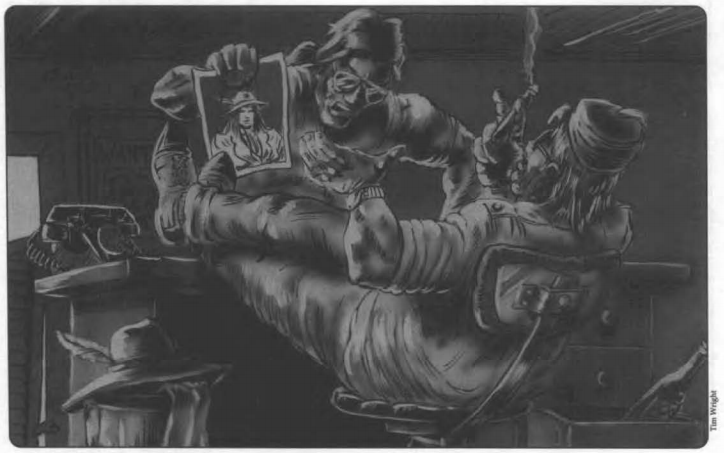
Either someone is being taken off the case, or someone is demanding pictures of Spider-Man.
Moving out of Cairo, we travel to the imperial capital of Thebes and Luxor . Technically they're two separate cities, but thanks to the axiom wash they've sort of joined up into one large city.
The main "attraction" in Thebes is Mobius' royal palace, from which he rules the realm when he's not out fucking with Storm Knights. Thebes also has the Grand Temple of Osiris, the College of Mathematics, the Society of Engineers, and the main headquarters for Super Battlegroup Mobius. Unlike the newspaper office, none of this gets any detail.
Luxor's main point of importance is the 72,000 square foot Grand Temple of Ra. The Temple is topped with a giant artificial sun of Mobius' design, and is capable of illuminating all of Luxor, Thebes, and the nearby city of Karnak. In fact, on "auspicious days", the sun it lit an hour before sunrise and darkened an hour after sunset.
But that's just a side benefit. The real power of the artificial sun is that it's a good, old-fashioned death ray. It has a maximum range of 150 miles, and hits with an explosive radius of 4000 meters. It's damage rating 55, which is a base 24Wound KO 28 shock , aka "you're just fucking dead". Fortunately the power drain is so immense it can only be fired once a month. That said, there are six back-up batteries in case of emergency. The death ray can only be fired by Mobius himself, as it's keyed to his thought engrams.
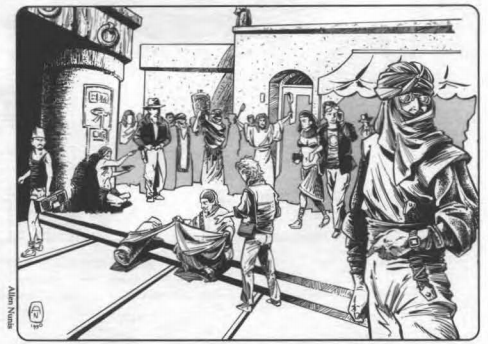
"Modern" city life
The city of Karnak wasn't a city until the reality shift, which is when it changed from a small village to a respectably sized city overnight. The main (and only) point of interest here is the Temple of Ptah, which has a strange curse: it actively attempts to drive out the living. Entering the Temple causes it to make intimidation checks against you every time you enter a room or corridor. The first time it succeeds you take shock damage, the second time you have to flee.
Khartoum is the second-largest city in the Empire (after Cairo). It was taken over shortly after the initial invasion, and Mobius has made it the center of the Empire's railway system. The main temple here is dedicated to Horus.
quote:
The other tidbit that makes Khartoum interesting is the ancient Earth legend of a magical fire opal hidden somewhere beneath its streets. The opal is said to give its bearer fantastic mind control powers. Mobius uncovered the legend shortly after his invasion and has had a team of mathematicians stationed in Khartoum looking for the opal for months.
Memphis is the home of Wu Han, and he's built a sort of mini-Chinatown here to serve as a power base. Mephis houses the Temple of Wadjet, which is the center of a cult known as "The Sisters of the Serpent". The cult seeks to make Wadjet a more powerful god than Sebek, and given that Sebek is Mobius' patron god, this causes a bit of tension around the city. Right now the cult has a very tenuous alliance with Mobius, but one side would betray the other in a heartbeat if it suited them.
Alexandria is the third largest city in the Empire, and home of the famous lighthouse that's one of the Seven Wonders of the Ancient World. There's also a large Colosseum here, which Wu Han has been employing for gladiatorial matches where heroes are forced to fight each other to the death because why the hell else would you have it?
The rest of the chapter are "generic" city locations with incredibly basic maps: a gin joint, a mummifcation parlor, a tomb, things like that.
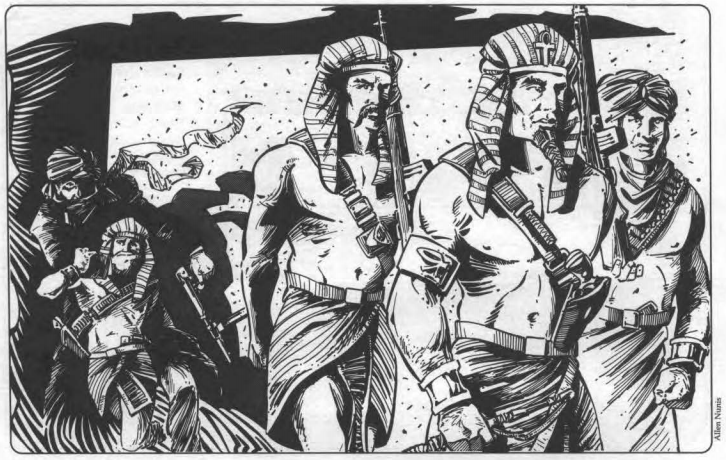
It never pays to be the last goon in line.
The next chapter is Lands of Danger , which covers locations and areas in the larger Empire.
The biggest change in Africa is the Nile Basin . When the axiom wash happened, all the modern machinery used to control and take advantage of the Nile were destroyed, leaving the Nile in its more "ancient" state. This means that the annual flooding that happens around July is no longer managed and mitigated by technology, and people have to deal with the flooding by moving into the cities. That said, the Nile Basin is still the main source of farmland in northern Africa, except that now it's pretty much completely controlled by Mobius's forces. A side-effect of the reality shift is that the Nile now has a larger-than-normal amount of crocodiles and asps now.
The change in realities also affected the Sahara Desert in general, populating it with nomad tribes and peppering it with lost tombs, ancient forgotten cities, and hidden oases. This is all part of Mobius' larger plans: with all these sites appearing, he can raid them for magic artifacts or eternity shards before anyone else stumbles onto them.
For example, the Oasis of Firrah lies deep in the Sahara desert, hidden behind burning sands and howling winds. According to ancient legends that are really only a few months old, Bela Firrah was an Arab trader who stumbled upon the oasis when seeking a source of water for his shady trade caravans. He sent out troop after troop of his men to claim it, but none of them returned.
[quote]
The stories of what happened next are unclear in many respects. But it is said that along the way Firrah found the bodies of the earlier parties, all with their water flasks full, their trails a great circle, as if the sun had driven them mad. After many days of traveling, Firrah's party came in sight of the oasis. They whipped their camels into a gallop, but as they drew near, a fierce sandstorm arose. Blinded, their mounts in a panic, Firrah's men fled into the desert, never to be seen again. Firrah himself struggled to the water's edge, reached out and touched the sparkling blue liquid...
Firrah's body was found the next day by a nomadic tribe. His skeleton gleamed in the sun, the bones blasted clean by the force of the sandstorm. One finger was stretched toward the pool, a pool the nomads would not drink from out of fear.[quote]
This legend may or may not be true, but it sticks around because of the possible fortune in gold at the bottom of the oasis. Or it may just be a fable made up to scare people away from one of Mobius's projects.
The isle of Hespera in Lybia is another example of the types of changes an invading reality can bring, because neither the island or the lake it's in existed before Mobius's arrival and were created whole cloth by the axiom wash. The reality shift caused the legends about the "home of the Amazon warriors" to become fact, and transformed archaeologist Hippolyta Kosmos ( oy ) into Queen Hippolyta. The transformation was Hippolyta's "moment of crisis" and made her possibility-rated as well as transforming her to Nile Empire axioms. Hippolyta has assembled women from the Empire and Core Earth to her side, and so far Mobius and the world at large are unaware of what's happening on the island. Despite her Good Inclination, she's not 100% convinced yet that she should bring the fight to Mobius, prefering instead to live peacefully on Hespera. That's not to say that some of her Amazon warriors haven't left the island to fight for the side of good, of course, but so far she's not angling to become a major player.
Scattered throughout the Empire are Weird Science Research Centers . These are where Mobius's forces develop their unique weapons and devices. Protected by minefields and artillery, these sites can be a treasure trove of new experimental gear for heroes brave enough to penetrate the defenses and defeat the squads of shocktroopers there. There's not much else to say about these facilities, even though the Nile Empire book spends five pages on WSECs, describing them in the usual ammount of unnecessary detail. I mean, I get that these are the types of places PCs will be hitting up a lot, but still. The cities don't get that much detail!
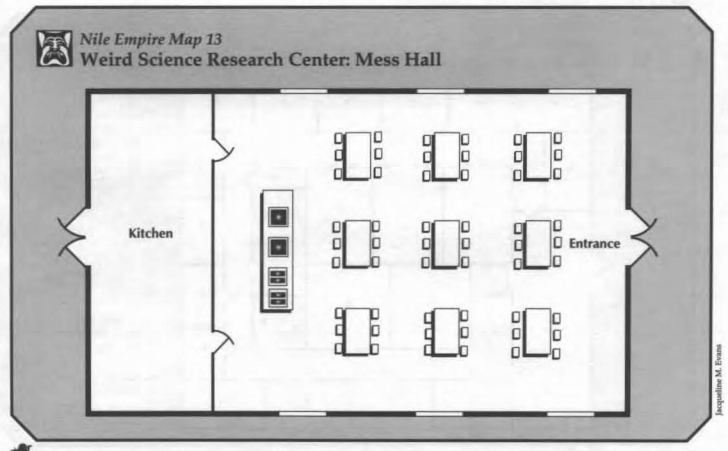
Do we really need a map for this?
The mixing of Core Earth and Nile Empire axioms has had more subtle effects on the landscape, such as the transformation of Egypt's network of gold mines into The Land of the Dead , a sprawling network of catacombs and caves that wind under most of eastern Egypt. These are the mines where Empire officials sentence criminals and opponents to, to spend the rest of their lives digging for gold for their pharaoh. Rumor has it that some of the caverns actually stretch halfway around the world to North America, and the extended cave network is a favorite hiding place for the Empire's many pulp villains.
Lastly, we learn how Mobius gets along with his Middle Eastern neighbors. Spoiler: not very well .
Things have gotten very strange in Ethiopia . The spread of the Empire transformed the Ethiopian forests into a full-blown rain forest, complete with lost temples and hostile "native tribes". Between this new source of artifacts and the country's established gold and diamond mines, Ethipoia has become a high priority target for the military. Although Ethiopia's army has pretty much fallen apart under the assault, the only reason Mobius hasn't just taken over yet is because the terrain makes it difficult to move troops in. Ethiopia is surrounded by mountains and is at a very high elevation, which Mobius' war machine isn't built to deal with. As it stands right now, both forces are in a rough stalemate, although Mobius keeps a few battalions on the Ethiopian border to keep them boxed in and to keep control of the mines on the country's border.
Dr. Mobuis was smart enough to realize early on that Israel was going to be a major threat, so he made it a point to move into their territory as soon as he could before they had time to assemble an effective defense. The western half of Israel is now under the Empire's control, but he's been unable to get in any further due to the Israeli forces not only putting up a better defense than Mobius expected, but also raiding into Empire territory. Isreli and American forces have set up a resistance outpost in Massada and are beginning to harry enemy forces.
Things are a little tenser with Libya . It's important to remember that this game was written in the early 90’s, so Muammar Qaddafi was still in charge at the time. The oil fields of Libya were an early target for Mobius, so Qaddafi made a bargain: if Mobius stopped trying to invade, accepted 45% of Libya's crude oil production, and give Qaddafi access to weird science weaponry to use against the West, Qaddafi would not detonate the nuke he buried in the oil fields and irradiate the world's main source of oil. Mobius agreed to these terms, partially so he can concentrate on other battefronts, but also because he doesn’t know what a nuclear bomb is because they don’t exist in Terra or the Empire. Yet.
Lastly, there’s the Sudan . Sudanese forces have fallen back into a defensive position. Fortunately, they’re being supported by the Soviet Union’s “Soviet Psychic Group”, whose psychics have been able to predict attacks by Nile forces. It's not known if Mobius knows that 3327 is behind the SPG, but for now Mobius isn't pushing too hard in that direction due to having bigger fish to fry.
--
Man, that's a lot of fluff of varying degrees of usefulness. And while some of these are clearly more useful than others, there's just a bizarre mix of what the writers thought would be useful. Yes, I'm more likely to need info on an adventuring site than a whole city, but even so there should be more info on the city rather than one building. Cairo, largest city in the Empire, gets less detail than the Temple of Wadjet! Did they not realize that people would spend more time in a city than one building?
I mean, there's full walkthroughs of the Cairo Clarion newspaper office and the Living Truth Agency that are longer than the information on Karnak. Why do I need the detailed layout of a private eye's office? All you need to say is "it's a 30's private eye's office" and bam, everyone knows what you're talking about.
But don't worry, things only get dumber from here.
NEXT TIME: Skills and powers! No, not the AD&D book.
You don't buy pulp powers, you just rent them
Original SA post The storm has a name... - Let's Read TORG
Part 13c: You don't buy pulp powers, you just rent them
Before we get into "cool" pulpish abilities, let's take a quick look at the more mundane new skills we get in this book.
-
Egyptian Religion
is a general knowledge skill, and is used in one of the Nile Empire's new magic systems.
-
Hieroglyphics
lets you read hieroglyphics. Not sure why we needed a new skill for this, but there we go.
-
Mathematics
is a magic skill for another of the Empire's magic systems.
-
Scholar (Master Criminal)
is used to plan your big supervillain heists. The way it works is that you roll this skill while planning your caper, and during said caper you can substitute the skill total you got for any roll you'd make.
-
Engineering
is
another
new magic skill.
-
Hypnotism
does what it says on the label and covers your basic creepy mentalism. Putting someone under requires a roll against the target's
Mind
+5. Once under, you can interrogate with a +5 to your skill, or implant a post-hypnotic suggestion.
-
Weird Science
is used to make weird science devices.
The Terra sourcebook that came out later and covered Mobius' home cosm added a bunch more.
-
Espionage
is your general spycraftyness skill.
-
Journalism
can be used to
interrogateinterview people to get information, or to present information in a way that can sway people's opinions.
-
Photography
is your skill at taking pictures. That's it.
-
Politics/Diplomacy
is your knowledge of world events and your ability to talk nice to foreign dignitaries.
-
Research
is, uh, your ability to research things. Technically this is like the core
evidence analysis
skill, except that you get the info "after the fact" instead of from an immediate location.
-
Science: Archaeology
is obvious.
-
Science: Cartography
is likewise.
-
Petty Crime
is all about being a street thief or hustler.
Okay, so...two things.
First off, those are some damn granular skills that would barely ever see use. Why do I need to know how good my photo is? Why does studying Egyptian history need as many as three different skills? It's like fucking Rope Use or Profession: Blacksmith; they didn't realize that you don't need skills for every potential thing PCs might want to do. I know it was years before anyone thought of "if failure doesn't mean anything, don't roll", but come on, who used these?
Second: there are skills there that are clearly meant for NPC use only. Petty crime and Scholar (Master Criminal) in particular aren't the kinds of things cinematicly heroic pulp hero PCs will be doing on a regular basis. Even if they're doing a "reformed criminal" thing, what's wrong with just expanding use of the base streetwise skill?
And what makes this all worse is that characters don't get a ton of skill points. You get your 16 adds at character creation, and after that you need to pay out possibility points. And as we'll see in a moment, Nile Empire pulp heroes can get fucked on metagame currency harder than Shadowrun mages get shafted on Karma.
So. Pulp powers.
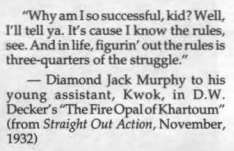
I hate it when the book tries to be clever.
Pulp powers are a "by-product" of Terra's and the Nile Empire's weird science doings. In fact, unlike every other realm-specific ability in the game (cybernetics, magic, martial arts, etc.), pulp powers are only available to characters from either the Nile Empire or Terra. Also, only p-rated characters can have pulp powers, so no Ord NPCs can do this stuff.
Each power is basically a self-contained rules chunk that you generally don't have to roll to use. They cost one possibility each at character creation, and there is technically no limit to how many you can have.
Note my use of "technically". Let's explain why.
Let's look at a typical power's stat block.
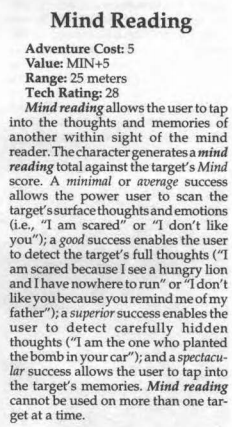
I'll get back to "Adventure Cost" in a second.
The "action value" is the fixed effectiveness value of a power. For some powers, this value is fixed and replaces other rolls; for example you can use your flat Mega-Sight value instead of rolling your Perception skill. Other times, it's used as the base of a roll like a normal skill.
"Range" is self-explanatory.
"Tech Rating" only comes into play if you're trying to build the power into a weird science device.
Now remember when I said before that you technically only pay one possibility at character creation to buy them?
The "Adventure Cost" is how many possibilities you have to pay at the end of an adventure to keep the power. If you don't pay this cost, you lose the power forever.
I'm going to say that again so we're all clear.
If you don't pay out a power's adventure costs in possibilities at the end of an adventure, you lose the power forever.
Oh, and in the Terra sourcebook they added another requirement: if you don't use your powers often enough, you can lose them.
quote:
Powers that are not used during an adventure start to "fade." A character who does not make a meaningful use of any of his powers (gamemaster's discretion as to what a meaningful use is) should start to lose the power. After two or three adventures, the character should start losing the power, and when it is gone, it is gone permanently.
The intent behind this rule is to keep players from selecting a bunch of powers at the beginning of the game and then just using them when they want. In reality, no character should have more than two or three powers (super attributes and super skills don't always fit into this limit), and the character certainly shouldn't be able to go through a menu of powers during an adventure.
And here's the thing: there's no Fate-style Refresh in this game. You're expected to get maybe eight or nine Possibilities per adventure. Even two minor powers can cost you half of your payout, and that's assuming you're getting all the awards. There are ways to reduce the adventure cost of powers that we'll get to at the end of the chapter, but there's no way to reduce the cost to 0.
So if you have the mind reading power, you're going to have to pay out 5 Possibilities each adventure to keep being able to do that, but a mage who buys a spell that does the same thing just has to buy the spell once and that's it.
Between the core set, the Nile Empire book, and the Terra sourcebook, there are 35 pulp powers all told. The game wants to make it clear that these are not meant to be used to make a costume-wearing superhero character because that is not what this is about.
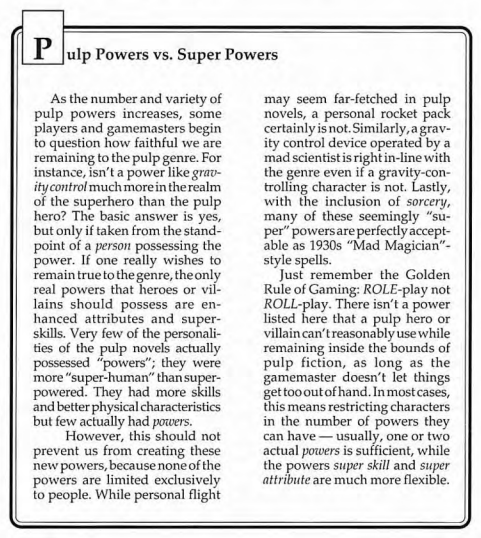
This is total BS, however, because almost every NPC with pulp powers in the rest of the game line is pretty much a costume-wearing superhero. If they don't want characters to have the more out-there powers, then why didn't they just say "this power must be built into a weird science device unless you can give your GM a good reason why you have it"?
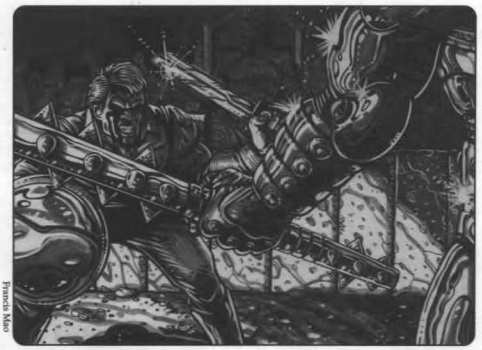
I don't know what power this is, but it's shiny.
There are 38 pulp powers split between the core set (6), the Nile Empire sourcebook (23), and the Terra sourcebook (6). A small handful appear dotted throughout later supplements (one of the SPOILER cosmbooks in particular), but for the most part that's all Nile Empire characters got to choose from. Of course, I'm not going to descible all of them, but let's take a look at a few.
Animal Friend allows you to talk to animals for 3 Possibilities per adventure. Animals are only capable of communicating simple ideas (so "are there Empire shock troops around the corner waiting for us?" is not valid, but "is there danger here?" is). Communication also requires a roll: your CHA+2 versus the animal's Spirit to successfully communicate. You can try to convince animals to do your bidding with a second roll, but you can't use this power to get an animal sidekick.
Darkness creates a field of darkness in a 5-meter globe around themselves. I'm not sure if that means a 5 meter radius or diameter, but regardless it blocks vision for everyone but the user, inflicting the standard penalty for fighting in the dark (-5). This also has an adventure cost of 3.
Electro-Blast is "the ability to project a powerful bolt of energy from the hands", but again this isn't about playing superheroes ! The blast has an attack value of the user's STR+10 (so probably around 20 or so total; about as powerful as an AK-47) and keys off the user's Dexterity , but generating a successful attack total deals the user 2 shock, even if you miss. This has an adventure cost of 4.
Flight is pretty straightforward; your airspeed is based of your Dexterity , but you need the flight skill to perform fancy maneuvers. The adventure cost is 3, and the tech rating is 24, which is one higher than Core Earth's, which means that in the 90's we were close to creating jetpacks.
Growth is the ability to increase your overall size by a factor of 3, with appropriate increases to your Strength and Toughness , which both go up by 7. The downside is that being huge makes it easier for you to get hit. Oh, and the adventure cost of 5.
Jump lets you long jump up to your DEX-3 meters on the ol' number-to-value chart, and standing jump a third of that distance. With an an average Dexterity of 10, that's a value of 7, which equates to 25 meters/82 feet. So it's a pretty substantial distance, but I don't think it's worth 2 Possibilities per adventure.
Mega-Scent can be used to detect or track people by scent. Your smell power is such that you can detect people from up to 50 meters away, which is pretty damn impressive. This costs 3 possibilities/adventure.
Shrinking , usually the purview of a mad scientist's ray, costs 12 possibilities per adventure; again, you get like 8 per normal adventure. With this, you can shrink down to 2 inches tall, increasing your Dexterity by 5, decreasing your Strength and Toughness by 5, and increasing your stealth by 10.
Super Attribute and Super Skill each have an adventure cost of 3, have tech ratings of 27 and 26 respectively (even though it explicitly states that you can't build these powers into a device), and let you go over the normal stat/skill maximums. Buying Super Attribute gives you three more stat points, and you can go above the normal human max of 14. Super Skill gives you three skill adds and lets you go over the usual +3 limit on skills. You can buy these multiple times for more stat/skill points.
Telekinesis (or "TK", as the book helpfully informs us) is the ability to move things with your mind. The effective strength of the power is your Mind +5, cross-referenced on the big conversion table. An average Mind of 10 would let you move something up to 1,000 pounds. You don't have to roll to just move stuff, but if you want to throw things, that needs you to roll against the target's defense plus the mass value of the object. You can't use this power to move people who don't want to be moved (no idea why), and TK isn't capable of precise movements or fine work. Believe it or not, the ability to toss around half a fucking ton without trying only has an adventure cost of 4.
Water Breathing is a very situational power that nonetheless costs 2 possibilities per adventure. All it lets you do is breathe underwater.
(Just for the record, here's the full list of available powers from the three books: Animal Friend, Chameleon, Dark Vision, Darkness, Dazzle, Dispersal, Electro-Ray, Emotion Control, Fear, Flight, Fog Screen, Force Field, Gravity Control, Grow, Illusion, Invisibility, Jump, Mega-Hearing, Mega-Scent, Mega-Sight, Mind Control, Mind Reading, Power Neutrality/Resistance, Running, Shrinking, Super Attribute, Super Skill, Swimming, Telecommunication, Telekinesis, Teleportation, Ultra-Sight, Wall Walking, Water Breathing, X-Ray Eyes .)
Now, that's all expensive as hell, right? I mean, even having one "level" of Super Skill is going to cut into your XP curve, let alone having to pay out for something like Mind Control at 5/adventure.
Fortunately, the game designers realized that forcing people to keep buying their abilities is pretty rough, but instead of reducing costs or working out a different mechanic they instead added a system for Power Flaws .
quote:
Powers are not always perfect. In the Nile Empire they often come with a flaw which can make life difficult for heroes. Of course, the flip side is heroes in distress generally make a story more interesting, and whenever a story becomes more interesting, there are Possibilities to be gained.
The way it works is that you can attach a flaw of some sort to a power, such as "stops working when I am around handwavium" or "doesn't work on the color yellow". If the flaw comes into play and actually makes things more difficult you get X possibilities. There are three levels of flaws:
-
Three-point flaws will inflict a
stymie
on the character, or inflict a point of shock damage while around the trigger.
-
Six-point flaws can cause your power to stop working for a while, or grant your opponent a
roll again
when you use your power. The effects of six-point flaws will linger for a minute (six rounds) after the triggering condition is removed.
-
The single nine-point flaw is the "fatal flaw", which means you take an automatic wound
each round
you're around the flaw's trigger.
It is possible to attach multiple flaws to a power, but you can't have more than one flaw of each value.
quote:
Example: Cobalt has a power setback which affects his two super attributes and his grow power. In any scene in which he is bathed with a mix of mystic and weird science forces, he would earn 18 Possibilities. As the adventure cost of his three powers is 11, Cobalt's player must assume that his character will run across this combination fairly frequently in order to pay for his expensive powers.
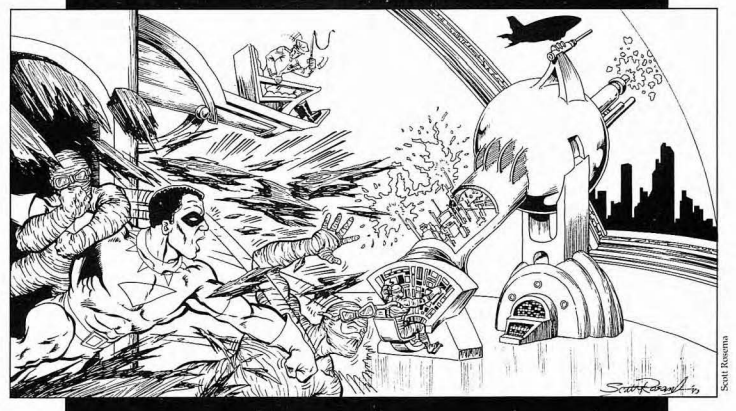
Pictured: Totally not a superhero
Just to complicate matters more, the Terra sourcebook has a second flaws system: advanced flaws .
quote:
In The Nile Empire sourcebook, a basic system is presented for invoking "power flaws." These flaws were designed to help player characters pay their adventure costs for their different powers - and to make their characters more interesting.
In the first case, it succeeded. Stymie , setback , and other flaws certainly come across with the possibilities, giving the character a chance to pay his costs.
However, in the second case, they are a little flimsy. Fortunately, since Terra is so removed from the Possibility Wars, it has developed a different style of power flaws. These advanced flaws give more "character" to the powers a character has, making them and the character more interesting, and they provide a fun dlallenge for roleplaying.
Advanced flaws reduce the adventure cost of powers they're attached to. They don't have fixed "costs", but vary depending on how the flaw manifests.
For example, the Activation flaw means you have to perform a specific action of some sort to use the power. The example in the book is that "Meteor Lad might have to touch a piece of the meteor he gained his flight power from before he can fly", but again they said on the previous page we're not supposed to be playing superheroes .
Anyway, an Activation flaw that requires you to simply touch a badge would be worth one point, while having to make a roll to activate the power in the first place is worth two.
Activation Time is pretty much the same thing; the long it takes for your power to actually go off, the more the flaw is worth.
Burnout means that the power has a chance to become unusable for a period of time on a bad roll, even powers that you normally wouldn't roll to use. The longer it goes away for, and the easier it is to happen, the more it's worth.
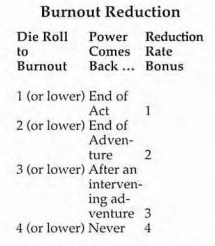
The way the table works is you determine the d20 roll in which the power stops working, then the duration, and add the reduction bonuses together; having a 20% chance that your power goes away forever with each use reduces the power's cost by 8, but having it go away forever on a 1 reduces it by 5.
Also, in another wonderful case of Torgian design, the third level is "you lose the power until the end of the next adventure", but if you don't use a power in an adventure you lose it forever. Does that mean that the rank 3 version is effectively the same as the rank 4 version? And if it's not, does the character still have to pay to keep the power he couldn't use?
Power Reserve means that a power is only usable a certain number of times per adventure. The power draws from its own "energy pool" of 1 to 5 points, each use costing one point. This reduces the power's cost by 6-uses. And this flaw is so poorly described it doesn't explain how it actually works until the example of how the flaw works.
The final flaws are power reduction and situational modifiers , which is where you reduce a power's mechanical values to reduce the cost. You know, reducing the duration or strength or whatever. Unfortunately, these are "play it by ear" flaws, because there's no guidance on what constitutes a point of cost reduction. Maybe reducing water breathing's duration from "unlimited" to an hour is worth dropping the cost by a point...unless the GM thinks that even an hour is too much (since it's not a situation that comes up much), so he might say that dropping the power cost by one knocks the power's duration down to 10 minutes. You know, the usual fun having no real guidelines gives you.
Normal and advanced flaws can be combined on a power, but you can never reduce a power's cost to below 1. You can also "link" multiple powers to one flaw for an all-or-nothing effect, reducing the overall cost of the powers but applying the flaw's effect to all the powers.
--
So there we are. Torg's not-superpowers system. Really, it's not that , just a bit limited, but the whole adventure cost thing is ridiculous for what you're getting out of it.
Still, it pales in comparison to what we're going to see...
NEXT TIME: Building pulp gadgets! Get your slide rules ready!
Gizmos and gadgets: Keep rollin' rollin' rollin' (what?).
Original SA post The storm has a name... - Let's Read TORG
Part 13d: Gizmos and gadgets: Keep rollin' rollin' rollin' (what?).
A big part of 30's pulp is the weird technology. Jet packs, shrink rays, mind-projection helmets...all the toys that shouldn't be remotely possible and yet feel right at home in the setting.
Torg has two types of pulp devices: gizmos and gadgets . Yes, there is a mechanical difference.
Gizmos are...well...
quote:
A gizmo is a technological tool with abilities expressed in terms of attributes, skill, powers or Special values (such as armor values). Thus, cars, guns, microwave ovens, and invisibility belts are all gizmos, as are shrink pills and knockout gases (these too are technological tools). A construction crane, for example, would have Strength since it is capable of lifting heavy objects, while an invisibility belt would have the invisibility power, and a wonder drug would have the medicine skill because it is capable of curing illness.
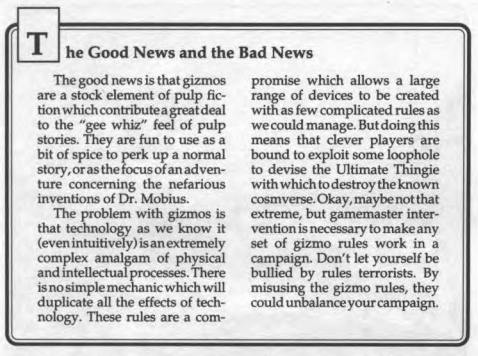
Ah, such a level of trust in the players...
Even after all this time, I'm still amazed that the game feels the need to point out that this system isn't a full-blown technological process and is, in fact, an absrtracion.
It's important to point out that, in order to be a gizmo and thus built using these rules, the object must be technological in origin. A helmet designed to project your thoughts is fine, but a mystic amulet that does the same thing can't be built with this system, even though you can build a gizmo that contains magic skills. How would you get that amulet, then? I don't know, make something up or buy the Aysle sourcebook, I guess.
At the highest level, there are four steps to creating a gizmo:
1. Decide on the purpose of the gizmo.
2. Draw the blueprint
3. Gather the components
4. Build the gizmo
Building or repairing a gizmo requires either the science or weird science skills, but using them does not.
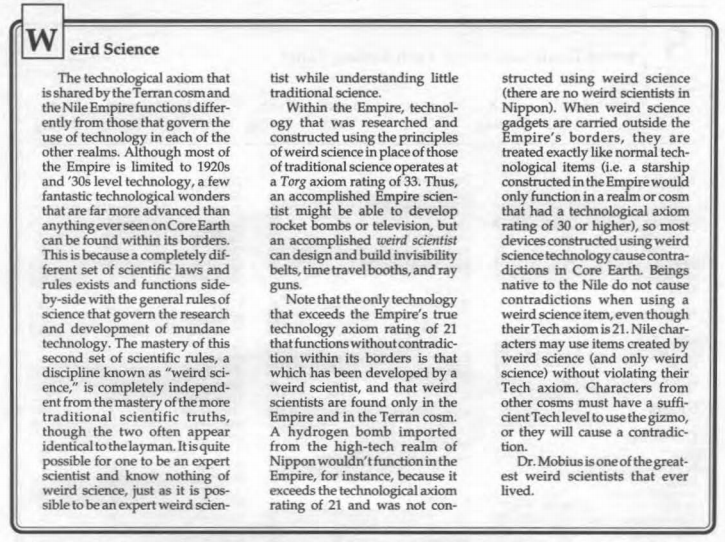
I don't know why they felt the need to point out that Mobus is TEH BEST.
The first step (decide what it does) is the only easy step. A gizmo can contain any attribute, most of the skills in the game, and all the available pump powers except super attribute and super skill .
For this example, I'm going to build Starman's Cosmic Rod . The cosmic rod let Jack fly, it could lift objects in a gravity field, and fire bolts of energy. In game terms, that'd be the electro-blast , flight , and telekinesis powers.
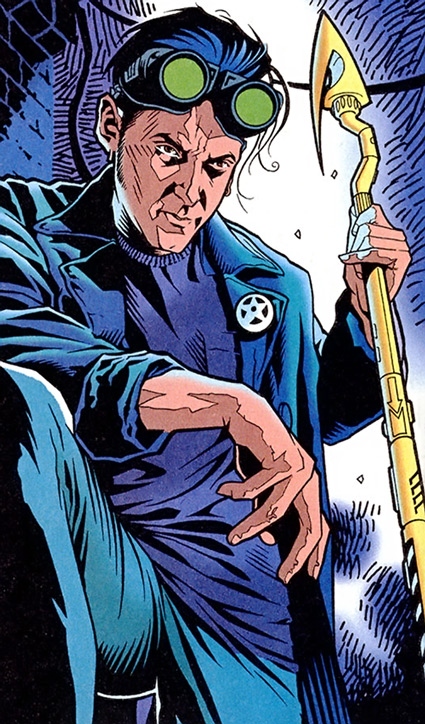
I think that's sufficiently pulp-y, don't you?
So that's done. The next step is to draw the blueprint. See, when I said this was a system to build a gizmo, what that means is that the player actually has to draw out a blueprint and assemble components to do this.
Before we can really get into the blueprint phase, we need to discuss components . There are a bunch of them, and you need to know how they all work before you can really get going.
First off, every component needs a housing , which is basically the object you're building the gizmo into. It can be pretty much anything; a belt, a car, a giant-ass laser, and so on. The housing will determine the gizmo's base Toughness .
Each attribute, skill, or power you build into a gizmo requires its own system , which are the real mechanical chunks of the device. Each system can have boosters that increase the values of the abilities built into the system but make it harder to use, and compensators that offset the booster penalties.
Every system, without exception, requires a power source. If a system uses actual powers, it needs a Possibility capacitor to function, because powers only work by having Possibilities dumped into them. Anything else requires a power plant .
Lastly, there are adapters and caps . I'll get back to those later, but for now just keep them in the back of your mind.
Now that we know what all the components are, now we have to assemble them. Gizmo creation involves assembling all the systems one at a time, then adjusting the inherent values with boosters and capacitors.
The first step of building a system is to generate a science or weird science total against the tech rating of whatever you're building into the system. The result of the roll is the value of the ability...
...except that every ability you can jam in a gizmo has a limit rating that caps it. To go higher, you need to use boosters.
So let's start with the Electro-Raysystem. Electro-Rayhas a tech value of 27 and a limit value of 7. That means that, barring boosters, I can't get the ray's damage value above 7, which is actually pretty crap (that's the same damage rating as a throwing knife).
For the sake of example, let's say I have a weird science skill of 15 and I don't roll below a 4, which would put me into the "0 or less" range for the power's final level. So now I have an Electro-Ray system at 7.
Since I want my Electro-Ray to actually fucking do something, I need to install boosters. This is another skill roll, this time on the General and Push Results Table (remember that?). The result on the table is the modifier on the system's strength. If you're using the normal science skill, you can only add one booster to a system and use the speed column of the table, but if you're using weird science then you use the power column and can add as many boosters as you want or until you fail a weird science roll, at which point you have to stop.
So let's boost the Electro-Ray. My first booster roll total is 10, which is +4. I'll add another booster, and rolling again gets me a total of 15, which is +6. That's a strength of 17 so far, which is the same as a flintlock. Guess I better keep rolling! One more roll gets me another +6, for a total final strength of 23. Four rolls to make a weapon barely stronger than a .357 Magnum.
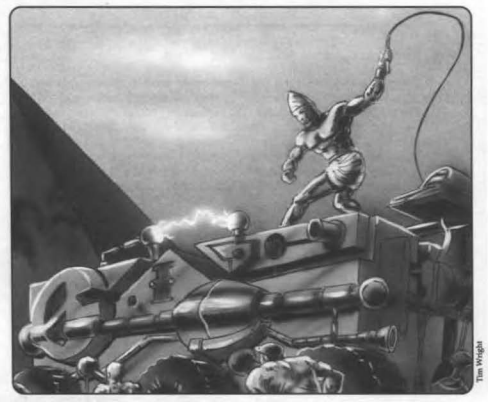
Yeah, I know how you feel.
By the way, if I had failed any of those rolls, then I would have had to stop trying to improve the system, and couldn't try to add more boosters at all until I take another add in my weird science skill or find a GM-fiat component. So it's entirely possible to try to build a gizmo, tank the roll to determine the system's strength, tank the first booster roll, and wind up with a useless gizmo I'm stuck with for at least a few adventures.
Anyway, every booster on a system increases the difficulty of using that skill/power/whatever by 1. On top of that, the difficulty to repair a gizmo is equal to the total number of boosters installed throughout all its systems. On top of that , if a gizmo is using two systems at once (like using the cosmic rod to fly and blast people), the difficulty of using those systems goes up by +2 in addition to any other penalties. The only exceptions are adding boosters to the housing's Toughness , which won't count in terms of penalties, and powers that don't need a roll to use, in which case the penalty becomes a side effect that limits its usefulness.
To counter these penalties you can build compensators into a system. You can't start adding compensators until you're done adding all the boosters, because the difficulty of the roll to to add them is the final boosted value of the system. Also, you can't add more compensators than boosters.
Adding compensators works the same way as boosters, so in our example gizmo I can roll my weird science up to three times to counter the penalty for the three boosters. For the sake of example let's say I only managed to install two compensators at +3 each. Now the Electro-Ray system has a final strength of 23, +1 difficulty to the attack roll, and a compensated value of (base power+value of boosters-value of compensators)=17. Compensated value will come into play later.
But we're not done yet! Now I have to add a Possibility Capacitor to actually fuel the power. See, powers in a gizmo still have an adventure cost, it's just that the cost is reduced by 2, then increased by one for every booster attached to the system. This cost needs to be payed out from a capacitor the first time it's use each adventure. More than one system can draw from the same capacitor, but a capacitor can only hold a maximum of 10 Possibilities so if(when) shit starts getting expensive you're probably going to need multiple capacitors. The only upside to this is that we don't have to roll to add it.
So what happens when the capacitor runs out? It'll need to be recharged, of course. This requires a laboratory of some sort, a day, and someone to donate the Possibilties to put into the capacitor. Because even with a gizmo, a PC has to pay out the fucking points to allow someone to keep their goddamn powers.
Jesus fucking Christ.
Oh, and although we're not going to have one in this gizmo, systems that grant an effective attribute or skill use power plants instead. Power plants require a roll to build, and the plant's value is the result of the roll. Power plants just work until a hero setback or hero stymied result comes up in combat. When that happens...
quote:
[T]he gizmo operator must generate power plant totals for every gizmo currently in operation. The difficulty number is the largest system value which draws power from the plant. If the plant powers more than one system, use the One-On-Many Table. The number of successes is the number of systems still working. On a stymie, the player decides which systems are still powered. On a setback, the gamemaster gets to choose. Any systems which lose power may not be used until the power plant is repaired or recharged. Recharging requires a laboratory and a full day.
One last thing we need to take into account before we can actually assemble this damn thing is housing integrity . Remember back where I said that every housing has to have a Toughness stat? That's because a housing can only safely use systems that have a compensated value equal to the housing's Toughness +5. If a system's compensated value is higher than that, the housing takes a damage result equal to the difference between the housing integrity and the system's compensated value, ignoring KO results. If the gizmo takes too much damage, it'll stop working and need to be repaired.
The cosmic rod probably isn't that strong, let's say it has a Toughness of 7. The housing integrity is therefore 12, which is 5 less than than the Electro-Ray's compensated value. In this case, that's an O3, but using Electro-Ray does two shock damage to the user each shot, so it's really O5. Every time I fire the Electro-Ray, the cosmic rod takes 5 shock. Because a character can take up to its Toughness in shock before getting knocked out, I can fire the Electro-Ray three times before the whole device breaks down. And that's assuming it's not taking damage from other sources.
Oh hey, I haven't designed the flight and TK systems yet! Let's just assume I didn't roll super-high on those, which is fine because I don't need to break the sound barrier or fling tanks around (or get into making more boosters and compensators). I generate a [/b]flight[/b] value of 10 (100m/round; about 35 mph) and a telekinesis value of 12, which lets me lift 250 pounds. Both of those are under the housing integrity so we're good there, and I'm not going to bother adding boosters.
Oh, and I need to figure out the adventure costs for everything. Electro-Ray actually costs one more than normal at 5, flight costs 1, and TK costs 2. Given that a capacitor only holds 10 Possibilities, I'm going to have to recharge this damn thing at least every two adventures if I give Electro-Ray its own capacitor.
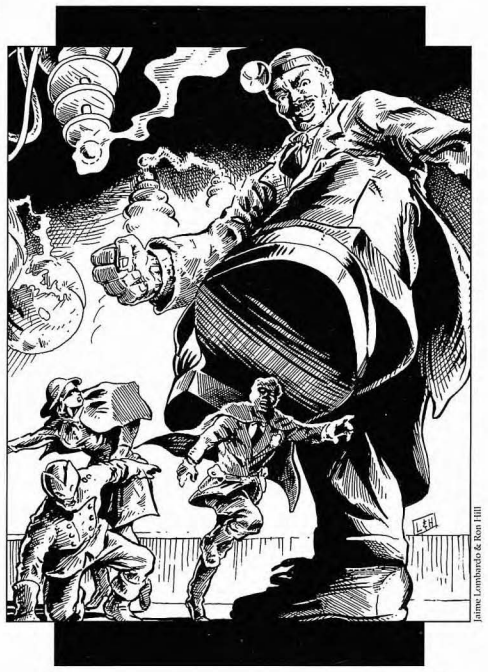
The reason mad scientists go mad is because of this system.

So now we have all our systems. Now we actually get to assemble them by drawing the blueprint!
Here's the blueprint symbols for all the available components:
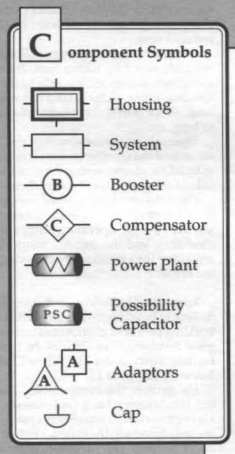
They're like Legos, only they make you want to kill yourself.
Every component in your gizmo needs to be drawn out. Each system is pretty much a loop that links the power/skill, the power source, and any boosters and capacitors together. Also, you see how every component has so many lines for connections? Those are fixed connectors; a housing will always have four connectors, and if you only need two of them, then the other two need to have caps attached to them. Likewise, adapters have to be used to attach multi-component systems to a housing.
So now we get to draw everything out. Here's the Electro-Ray system:
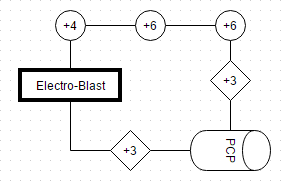
Thank God for free flowchart programs, is all I'm saying.
And here's everything attached and capped:
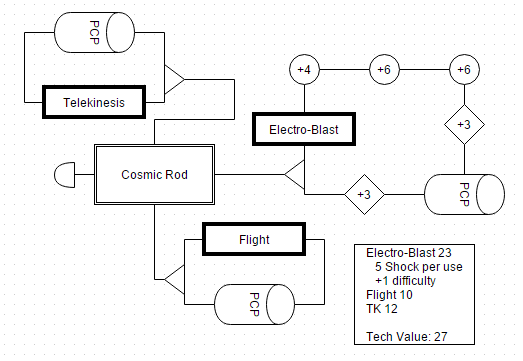
Now, you're probably wondering what the hell the point of drawing out the blueprint is. I mean, we've already gone through the hassle of defining what everything does, right?
And the answer is "yes, but..." Because now we come to the point where we actually have to build the fucking thing in-character. That means actually buying all the components, and making more fucking rolls to actually create all the connections between components in-game .
See, I've been doing this out of order. What you're supposed to do is draw the blueprint while designing, adding all the components and rolling to connect them as you go along. In addition to the normal rolls for adding boosters and compensators, you have to roll to attach the power source to each system, adapter, and cap. Each roll you make while building the gizmo, pass or fail, requires a day of work. The only consequence of failing to connect the generators, adapters, or caps is just wasted game time.
In addition to all the rolling, you also need to buy every single component off the equipment list. The cosmic rod has a housing, three boosters, two compensators, three adapters, three Possibility capacators, and a cap. A small housing costs $30, systems up to value 15 cost $500, systems range from $400 to $40000 depending on the system's value, the capacators cost $5000 a pop, caps are $5, adapters cost 10% of the value of the system they're attached to. Oh, and each booster and capacitor costs as much as the system it's attached to.
So assuming I lowball the system prices based on the given ranges:
pre:
Housing: $30 Cap: $5 Electro-Blast: $41,600 Value 23 system: $6,000 PCP: $5,000 3 Boosters: $18,000 2 Compensators: $12,000 Adapter: $600 Flight: $5,560 Value 10 system: $500 PCP: $5,000 Adapter: $60 Telekinesis: $5,560 Value 12 system: $500 PCP: $5,000 Adapter: $60
Gizmos, despite their nature, are still subject to the rules for Tech axioms: the tech value of the gizmo is the highest tech value of all its component systems, and using it outside that axiom level will risk disconnection. That said, they never cause contradictions inside Nile Empire axioms.
So what happens if you want to play someone who just uses the gizmo, but isn't the one who actually made it? I guess you better hope the GM gives you an NPC scientist with a decent skill, or hope that you roll really well because the whole shebang assumes that the character is the one making the device, not that it was given to him or he found it or whatever.
And you're also going to need someone who can fix the damn thing, because (as stated previously) gizmos can take damage. A gizmo that is "knocked out" has to be restarted with a simple science roll, but repairing damage can be done with either of the construction skills. The difficulty to repair a gizmo is the gizmo's highest value, plus one per booster. In the cosmic rod's case, that's a 26, which is pretty damn hard.
So there we are. About 20 skill rolls, $50k in-game cash, and I have a gizmo that I can use to do things assuming it doesn't shake itself apart with shock damage, and an attack that's as strong as a fucking pistol and yet costs $40,000.

Why any of this? Why is this so complicated? Why are there so many goddamn steps and limits and drawbacks? When you get right down to it, building more than one power into a gizmo is barely cost-effective in any sense of the phrase, especially since you still have to pay out Possibilities to fuel powers.

This whole thing is giving me a headache, so here's some kitties.
But don't worry! The Terra sourcebook realized that this whole process is too complicated, so it had a "simplified" gizmo creation system. And by "simplified", I mean that you don't draw blueprints anymore. That's really the only significant change in the process.
Oh, and under the newer system boosters and compensators work differently; now boosters do a point of shock to the gizmo every time the power is used, and compensators can reduce that damage. The reason for this? Because the old way let players "chuck the limit values out the window".
GOOD! Those made no goddamn sense! Letting people be powerful should be the point of a self-styled cinematic system, especially when it takes place in a pulp reality! Not forcing a bunch rolls and mechanics to make your device worth a damn.
Also, this being Torg, there's literally two pages of explanation as to why the Terran gizmo rules are different from the Nile Empire gizmo rules, because people needed an in-game explanation apparently. Like when there was the Time of Troubles to explain the changes between 1e and 2e D&D. The short form is that Mobius' understand of pulp technology (which is what informs the Empire's weird tech) has become outdated from recent developments back home on Terra.
Just to over-complicate matters even more, what the Nile Empire book calls a "gizmo" is called a "gadget" in the Terra book, and the Terra book uses "gizmo" to refer to a one-shot pulp device, like a strength-boosting pill or a one-shot teleporter made from spare parts. They're built like bigger devices, except they don't use Possibility capacitors, and instead have to be fueled by someone spending Possibilities when the device is used. Whatever.
--
Christ.
Why?
Just why ?
NEXT TIME: Why should gizmos have all the overcomplication?
Nile magic agic agic agic
Original SA post The storm has a name... - Let's Read TORG
Part 13e: Nile magic agic agic agic
The Nile Empire (and, to a lesser extent, Terra) is a world where both magic and technology more-or-less coexist. It's common knowledge in the Empire that priests and engineers can produce miraculous effects, but unfortunately this is Torg which means we have to have a ton of new rules to cover them, because in case you haven't noticed Torg does not know how to model tone.
As a result, the Nile Empire has two new types of magic: mathematics and engineering . Both of these types of magic also share a subsystem based on astrology , and all three of these new magic bits is a separate skill you need to take on top of the normal magic skills. In fact, to be a magician from the Empire you have to take either the mathematics or engineering skill in order to cast spells, and you need astronomy to cast spells or perform miracles.
On top of that, the Terra sourcebook has pulp sorcery, which works completely differently from normal Torg magic and Nile Empire magic.
While you bear all that in mind, you might want to go re-read how magic works and how miracles work , because Nile characters actually require more skills and mechanics.
First off, we learn about Astronomy and how it applies to magic.
quote:
Magic and miracles in Mobius' reality rely upon the positions of various heavenly bodies for spell casting. Accomplished astronomers, the ancient Egyptians of Terra were so proficient in the art of astronomy that they had mathematically proven the existence of all nine planets in the solar system thousands of years before many of the planets were officially "discovered." They also charted the profound influence the planets had on magic and miracles.
Every spell and miracle in the Empire has two astronomical parts: which planets directly influence the spell, and the minimum number of planets from that list that must be taken into account when casting the spell.
The planets are all named for the Egyptian gods, and in an amazing coincidence the Core Earth solar system and gods correspond to Terra's. What were the odds?
quote:
Mercury = Ra (god of the sun)
Venus = Isis (patron of magic and children)
Earth = Osiris (god of earth)
Mars = Horus (god of life)
Jupiter = Nut (god of the sky)
Saturn = Nepthys (patron of women)
Uranus = Ptah (god of craftsmen)
Neptune = Anubis (god ofthe underworld)
Pluto = Set (god of evil)
Anyway, the way it works is that you start by determining how many planets you want to bring into the spell, and which planets you're going to use. You then use the Planet Chart to get the highest difficulty of the selected planets.
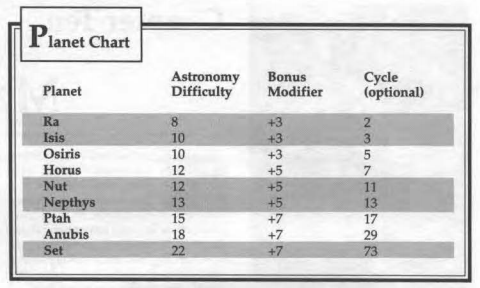
Because if there's one thing Torg doesn't have enough of, it's tables.
This number becomes the difficulty of the astronomy roll. You then take the result of the roll and look it up on the One-On-Many chart to see how many planets you "hit", starting from the innermost and working out. For each planet you've successfully configured into the spell this way past the minimum, you get the planet's listed bonus to your actual spellcasting roll. On the plus side, Egyptian magic doesn't have to worry about backlash.
For example, the Rot spell (which causes inanimate objects to decay) requires one planet and is influenced by Ra, Nut, Anubis, and Set. I want to cast it and I have an astronomy skill of 15. I bring in two planets: Ra and Anubis. The highest difficulty of these planets is 18, so I need a +3, which means I need to roll a 16+ to get both planets. Assuming I did, then I'd get a +7 to my actual spellcasting roll.
What happens if/when you fail the astronomy roll? No idea. The book doesn't say. I guess the spell doesn't go off if it required a planet?
In case that's not enough unnecessary mechanics for you, there's an optional rule for Planetary Cycles , where you have to (and I am not making this up) track the overall positions of the planets.
You see that "Cycle" column on the planet chart? That's the number of days that planet becomes "naturally" aligned, and will automatically self-configure into spells, and thus you don't have to roll for it.
quote:
As gamemaster, you have to keep a record of the days which have passed in your campaign in order to use the cycles. Each time Mobius invades a cosm, the calendar starts again with Day One. The events written about in this sourcebook go up to Day 65 of the Pharaoh's invasion. Begin your campaign calendar with Day 65, and mark off one day for each day of game time which you and your players spend in the game world.
Divide the campaign day by the cycle of a planet; the remainder is called the position of the planet. If the position of a planet is zero, the planet naturally configures on this day.
We recommend you calculate the zero positions of planets out of game time, and for a substantial period of time (say, one year). Writing it down in calendar form and check off the campaign days as you run through them. That way, you will know what planets are influencing spells for the current day of play.

I honestly want to know how many people bothered doing this, mainly because I'd guessing it's a number pretty close to zero.
So let's pretend that last part didn't happen and move on to Mathematics . And before we can actually learn how to do this, we apparently need close to a page about the organization of mystic mathematicians in the Nile Empire.
quote:
Most practicing mathematicians on Terra and in the Nile belong to an organization known as the College of Mathematicians. The college serves as both a forum where mathematicians can gather and share any new secrets they may have discovered, and a support organization for the training and guidance of young apprentice mathematicians. In the Nile, the College also serves as an official arn of the Imperial Government. In this capacity, it is one of the resources that Mobius frequently exercises. In fact, practicing mathematics in the Empire without being a recognized member of the College is a crime.
There is a very rigid and formal hierarchy within the College. At its head is Rama-Tet, the Royal Vizier and personal adviser to Mobius. Beneath Rama are 10 Grand Deans (mathematics and one magic skill at values 18 to 25, the other magics at values from 17 to 22), one for each of the Overgovemorships. Beneath each Grand Dean are three Lesser Deans (mathematics at values of 16 to 20, magic skills at values of 13 to 19). Beneath the Lesser Deans are a varying number of Initiates and Apprentices. Initiates are low-level mathematicians waiting for an opening in the ranks so they can ascend to the rank of Dean. Apprentices are young mathematicians in training.
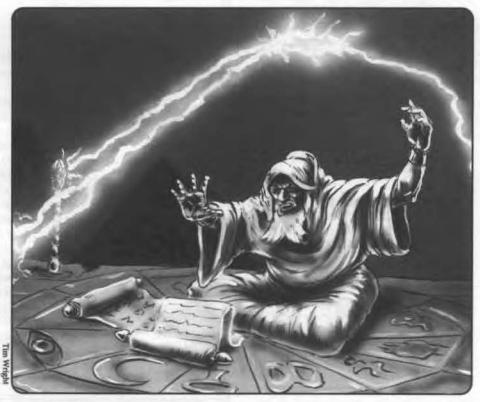
Pictured: not an apprentice
When Mobius has a service he would like the mathematicians to perform, he takes it to Rama-Tet, who then assigns it to a Greater Dean, who will in tum either assign the project to a Lesser Dean (if it is relatively simple or unimportant) or perform it himself. The Overgovemors follow a similar procedure, beginning with the local Greater Dean and possilly ending with an Initiate.
Oh, and you can't just have the mathematics skill, either. You can't increase your skill without a teacher (until you get 3 adds), and learning your first rank costs double the normal cost.
So when you cast a spell, in addition to the astrology bullshit above, you also have to roll your mathematics skill. If you succeed, you finally get to try and cast the spell. Failure means the spell doesn't happen and you have to roll on the Mathematics Backfire Chart).
So this is how you cast a spell as a Nile Empire character.
-
Determine which planets (if any) you will configure into the spell.
-
Roll your
astrology
skill to see how many of the planets you actually configure. This takes a round.
-
Assuming you hit the minimum number of planets, make a
mathematics
roll.
-
If the
mathematics
roll fails (there's no difficulty, so I'm assuming you just need to get a positive total), then you roll on the Mathematics Backfire Chart and that's what happens to you.
-
If you succeeded at the
mathematics
roll, then you can finally roll the spell's appropriate magic skill (
alteration magic
,
apporation magic
,
conjuration magic
, or
divination magic
), plus the astrology bonus, against the spell's difficulty to actually cast the damn spell.
As near as I can tell, the mathematics skill adds nothing to the process apart from making you roll an extra time and take an extra round. Well, you don't have to worry about the arcane knowledges, but that's not a huge benefit compared to adding another two potential failure points to the process.
So given how much more difficult it is to cast mathemagic spells, they must be pretty awesome, right?
Ha.
There are 17 mathemagic spells in the Nile Empire book, and they're a mixed bag. Some highlights:
Animate Mummy does what it says on the label, only requires one planet, and has a difficulty of 15 so it'd be pretty easy to pull off.
Calculate Weakness is difficulty 10, requires one planet, and gives one person a +3 to their next attempt at a task. So that's three skill rolls and a round to give someone a +3.
Commune with Crckets is a very specific version of "speak with animals" that's one point easier than animating a mummy.
Death Shout is an attack spell that does magic total+5 damage. Given that the difficulty is 20, that's about as powerful as a heavy pistol.
Gemwork doubles the value of a single gem. This is one point easier than talking to crickets, and therefore two points easier than animating a mummy.
Prepare Mummy is a fairly easy spell that mummifies a body. Given that Animate Mummy doesn't require the use of this spell, it begs the question of why it's a spell in the first place.
Sundew only requires one planet from Ra, Osiris, Horus, and Nut, and will "heal the wounds" of everyone within 50 feet of the caster who shares his Inclination. The thing is, it doesn't say what "heals the wounds" means in a mechanical context; does that mean that the spell heals all a person's wounds? If so then this spell is ridiculously powerful, even at difficulty 20 and a one-round spinup time.
Wing of the Hawk lets you fly at speed value 11, or about 40 mph, for three hours. Note that even with all the rolls this is objectively cheaper than the Flight pulp power.
So that's one type of magic down. Now we get to the most useless magic type: engineering .
quote:
Exactly how the ancient Egyptians of Earth built their huge pyramids and sculptures remains a mystery. The Egyptians of Terra built their monuments using a magical discipline known as engineering. Engineers have the ability to design fantastic structures and monuments, as wellas abilities that facilitate the construction of these monuments.
In Torg, such engineering is governed by the use of the engineering , and the four Torg magic skills.
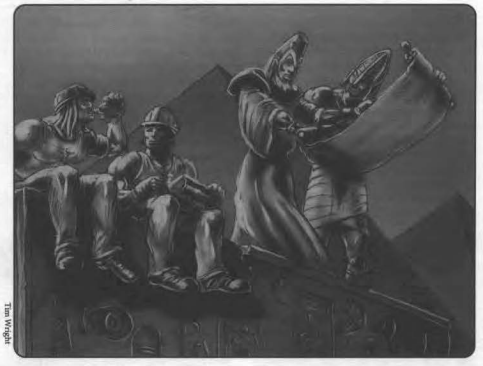
He may be an insane megalomaniac dictator, but Mobius still makes sure everyone gets a lunch break.
Engineering uses some metaphysics wonkery to get around the normal Torg magic restriction of the Principle of Definition, the short form of which is that it's possible to cast more than one spell on a building. Because that's the point of Engineering Magic: enchanting an entire building with temporary or permanent effects.
Engineers have access to exactly five spells:
-
Detect Traps
locates every trap within 125 feet of the caster, assuming the roll of the spell beats the trap's
stealth
value, and the trap is Tech Axiom 21 or less.
-
Find A Path
will let you sense what's on the other side of a door, navigate a maze (which requires you to cast the spell at
every intersection
), or to detect secret doors.
-
Lift
creates a magically enhanced block-and-tackle system that lets someone substitute the caster's final spell value for their
Strength
to lift things with said pulley system. Note that you have to build the block-and-tackle system; the spell doesn't create one.
-
Imbude with Mystic Energy
gives a building a Possibility pool and (depending on how well you rolled) a few points in said pool. Yes, this means the building is now P-rated.
-
Neutralize Trap
can deactivate traps you know are there.
The main strength of engineers is that they can construct buildings with inbuilt devices, spells, miracles, or pulp powers. That's why they have that Imbude with Mystic Energy spell.
Installing something into a building requires the creation of a maat matrix . A matrix is a magical construct that takes a week to make, and can have pretty much any spell, miracle, skill, gizmo, power, or mundane device bound to it. If successful, then the maat matrix will power the ability from the building's Possibility pool. It only costs one Possibility per year to power the matrix, and bound devices will never decay over time, but will still use any materials needed to operate. So if you have an automatic machine gun mounted on a wall, it won't rust but someone will still have to reload it.
That said, most things will require some sort of activation device: a tripwire, a pressure plate, IR sensor, and so on. Each of these is considered a separate device and therefore needs its own matrix.
The building can use any ability bound to its matrices at the cost of one Possibility per use This means that a tripwire/fireball spell combo will require two Possibilities to work; one for the sensor and one for the spell. Once activated, though, inbuilt devices will remain active for about 24 hours.
Oh, and it's worth pointing out that if the structure is a pyramid, then you don't need the Imbude with Mystic Energy spell. It'll generate Possibilities on its own.
...I don't understand what the point of the engineering stuff is.
I mean, is this supposed to be something PCs are expected to do? I mean, I suppose characters could make a base of operations, but unless they put it in the Nile Empire they're going to have to deal with disconnection issues, and Torg is supposed to be a game of globetrotting adventure. And if it's not something PCs are going to do, why is it there? Is the GM expected to roll all the NPC skills and track this stuff? (spoiler: of course he is.)
The final new type of "magic" I'm going to cover is Pulp Sorcery . This was added in the Terra sourcebook, so it's pretty much a GM call if it's allowed for Nile Empire characters. On the plus side, pulp sorcery doesn't cause a contradiction if used in the Empire.
Sorcery is considered a pulp power, and costs one Possibility during character creation. Its function is to allow you to mimic other pulp powers through the use of mystic rituals. Sorcery has a base adventure cost of 6, so it's expensive out of the gate, but you also have to pay Possibilities for any rituals you use. Ritual cost is the duplicated power's normal adventure cost, minus two, minimum of one Possibility. You only need to pay the cost for rituals you actually use during the adventure.
So if I have a pulp sorcerer and I used rituals for mind reading , fire blast , and telekinesis , that would cost me 6 for sorcery, 5-2=3 for mind reading, 5-2=3 for fire blasting, and 4-2=2 for TKing. That's a grand total of 6+3+3+2= 14 Possibilities I'd have to pay at the end of the adventure. If I only used mind reading and fire blast, then the final cost would be 12; I wouldn't have to pay for the ability I didn't use.
You need a separate ritual for every power you want to duplicate. Rituals cost one Possibility each at character creation and you can only start with three tops, but you can learn more later by finding a teacher/mystic item/what have you and paying the adventure cost of the new ritual between adventures.
Unfortunately, the powers you build rituals around can't have flaws attached to them, meaning that you can't reduce the cost beyond the two-point reduction for being a ritual.
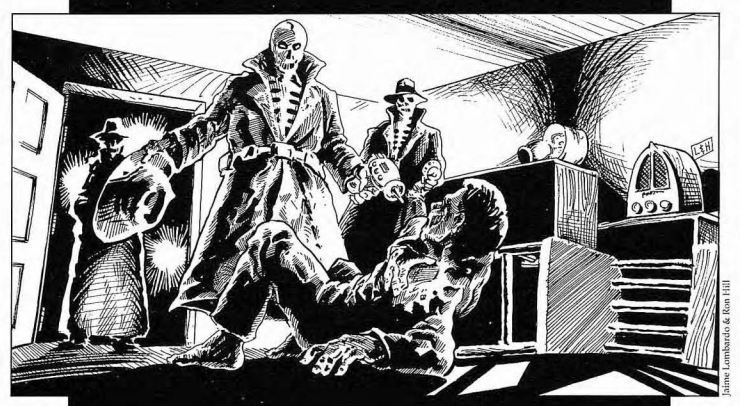
Do you have a minute to talk about our lord Skeletor?
Using a sorcery ritual involves looking up the copied power's "ritual difficulty" on yet another chart. You then have to roll your pulp power: sorcery skill against that difficulty. That said, most of the difficulties are in the 20's or 30's.
quote:
The difficulty numbers deliberately run high so as to encourage the use of the modifiers to flavor spellcasting (multiple modifiers can be placed on the same ritual). Try to imagine Hadji (from the cartoon show Johnny Quest) without his trademark "Sim sim Salabim!" command and you get the idea of what spells without modifiers are like.
Modifiers are things you can require on your rituals to reduce the difficulty number. They all have associated charts but they boil down to a few categories, three of which are the old vocal/somatic/material bits from AD&D that nobody ever used. You can also increase the casting time (requiring more rounds to use the ritual), take fatigue, or perform a sacrifice. No matter what you add, the modifiers are permanent; if you can't meet one of the ritual's requirements then you can't use the power.
--
It's amazing how hard they try to be "thematic" with pulp magic, and then drop the ball so completely. Pulp wasn't about fiddly details, it was about action and lots of it.
What's more, mathematics and engineering add nothing to the game beyond more rolling. Mathematics is bad, but there's absolutely no reason to learn engineering because all it does is let you make a location you probably won't be spending a lot of time at.
And again, the pulp powers aren't so overpowered that you need even more checks and balances in place. A pulp sorcerer needs to pay like 8 Possibilities just to use one power, but unless you have a lot of powers it's not cost-effective at all. And again, you're really not gaining any benefit in terms of usability or cost because you still need to buy all the powers in advance.
For as popular as the realm was, the Nile Empire really does make itself hard to use.
NEXT TIME: Realm-wide roll call!
Miracles, monsters, machines, and men of mystery
Original SA post The storm has a name... - Let's Read TORG
Part 13f: Miracles, monsters, machines, and men of mystery
The last few chapters are pretty short, so I'll just cover them all in one post.
The chapter on Miracles of Faith starts with a list of the tenets of the Terran Egyptian faith (as filtered through Mobius, of course).
-
Terra, the heavens, and all the other Egyptian gods were created by Ra.
-
The Pharaoh is a divine being, whose will is law.
-
The purpose of life is to achieve a state known as
maat
, which means "truth".
-
Death is not final; when you die you are judged by Osiris, and if you have achieved
matt
then you ascend to eternal bliss. If not, your soul is devoured.
-
Most gods use specific species of animals as their eyes in the mortal world.
I really don't think the people behind Torg really understood the point of religion.
Anyway, now we get a section on worship in the Empire. The Egyptian religion doesn't have weekly masses or anything, instead having large services on specific holy days. That said, there are weekly ceremonies held on Tuesdays because that's the day that Horus' planet naturally aligns, so it's a good time to get those ritual spells in.
And apart from a bunch of stuff about the church hierarchy (which is mainly focused on NPC skill levels), that's all there is about the
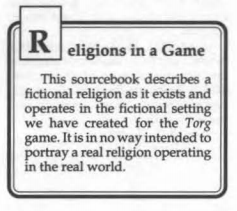
...as I was saying, that's all there is about the Egyptian faith.
To absolutely nobody's surprise, there are modifications to the miracles rules for the Empire.
quote:
Unlike the miracles of Core Earth described in The Torg Rulebook , Egyptian priests cannot perform many of their miracles without concurrently enacting a special ritual consisting of sacred chants, movements, and sacrifices. The more powerful the miracle, the more complex the associated ritual. This ritual is always timed with the movement of the planets, and is affected by astronomy in the same way as mathematics. In game terms, whether or not a priest knows how to configure a ritual with the movement of the planets is reflected by his or her Egyptian religion score.
So once again let's take a look at some miracles.
Battle Bless increases the Toughness of a unit of 1,000 men, with a difficulty of 38 and ritual time of 2 hours. It lasts until the "position of Set is next 0", which means I guess you have to track the damn planets.
Great Curse gives the target a -1 penalty on all actions, makes them always stymied (loses their first reroll), grant enemies +1 to all actions against them, and if they draw stymied from the Drama Deck they take a setback (lose next action). The effect lasts for a week, but the caster can maintain the effect by making sacrifices to either Set or Horus depending on the Inclination of the target.
Invest Pharaoh is a day-long ritual that includes a feast for at least 100 people, and will formally recognize the target of the miracle as the Pharaoh of the people. The Pharaoh gets one free Possibility a week, and the difficulty of all miracles cast against him increased by 7. Technically you could cast this miracle on a person to make them the new Pharaoh, but you'd have to beat the rolled total of the current incumbent. Given that Mobius' ritual hit with a final total of 74 (technically 81 with the penalty), good luck with that.
Pronouncement of Doom does the same thing as Great Curse, but lasts for a year and a day, and every time the target performs an infraction of some sort against the caster's god, the penalty increases by 1.
Snake Staff does what you'd expect. It only needs two rounds and lasts for an hour, and the snake created can poison victims. This is another spell where you need to track when certain planets are in the "0" position.
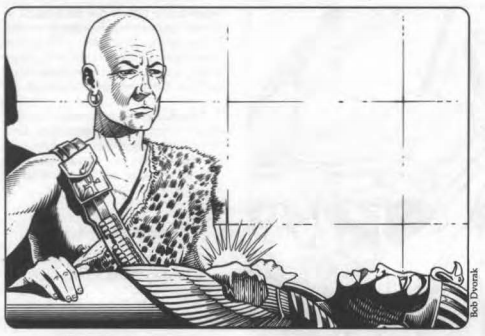
This guy looks awfully bored.
The next chapter is Creatures of the Empire , and it's pretty dull. Mobius relies manly on human agents, so there's not a lot of real "creatures" to be had.
I mean, there's your giant Egyptian animals (crocodiles, asps, spiders, and so on), but there's not much else. That said, they things we do get are odd.
For instance, there's the Terran Martians .
quote:
ln the pulp reality of the Terran cosm, an advanced scouting party from that cosm's equivalent of the planet Mars (Horus) has secretly infiltrated human society. Their motives are, at this point, unknown, but invasion is suspected by those few who know of them.
How they managed to get to the cosm of Core Earth is also unknown, but several Martians have been spotted m and around the city of Luxor since the invasion. Terran Martians appear as average humans, their only distinguishing feature being a large diamond-shaped birth mark where the belly button would normally be. The true appearance of a Terran Martian is that of a spider-like insect with bulbous eyes. Special Martian-designed
"Chameleon Belts" actually change the shape of the Martian to conform to humanoid standards. The attributes are the same between shapes, except that the insectoids have pincers (damage value 15) on one set of limbs, as well as a set of hands and two pairs of insect legs.
Although the reasons are unknown, it has been noted thatTerran Martians always travel in groups whose size is some power of two (2, 4, 8, 16, etc.). They refuse to travel in groups whose size is not a power of two. Note that 2° is one, so Martians can travel alone. The number four seems to be of particular importance to them. Many things that they do have a "four" theme to them. If you were to meet one, he might say "hello" four times, or shake your hand four times, or both.
It should be pointed out that 1) in the Terra sourcebook, Mars is just called "Mars" because Terra isn't completely Egyptian-themed, and 2) Terran Martians never come up again outside of being re-mentioned in the Terra sourcebook.
There are stats for gospog, even though it was stated that Mobius only has a handful of them. Unsurprisingly, they all look like mummies, and basically each generation is stronger than the last. Nothing really interesting here.
The shift in axioms has created one rather severe threat: walking gods . Technically they're not gods; they're more major tomb guardians that take the form of Anubis, Bast, Sebek, or Set. Each version has its own special abilities (Anubis has a giant sword an eye-lasers, Bast can cast spells, Sebek can clamp down with his giant claws, and Set has a giant spear and a sonic blast), and are generally intended to be "end bosses" in tombs.
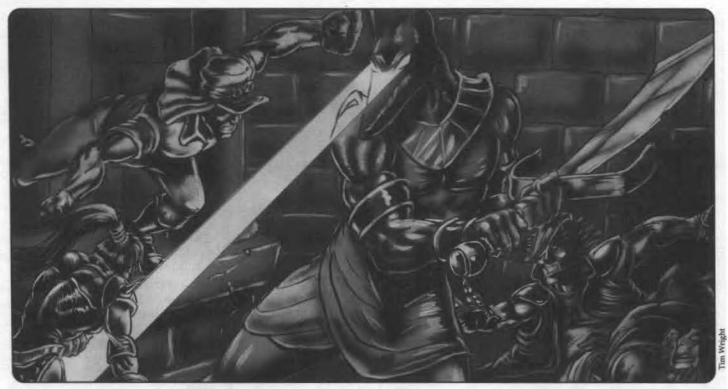
Optic Blast! Optic Blast! Gene Splice!
Equipment is up next, and it's really just a list of weapons and gear available at the 1930's tech levels. You can't just buy pulp gizmos and doodads, so really it's just mundane gear.
It is worth pointing out that Mobius has instituted a new economy in the Empire: the base unit of currency is the royal , which equates to $10 American. Crowns are dime-sized coins minted from 14k gold alloy, and are stamped with the Eye of Horus.
Government taxation is pretty heavy: 20% of all legal earnings per month. Needless to say, this creates a pretty heavy divide between the upper and lower economic classes, and really does a number on people of Good Inclination since they're not going to try to make a little money on the side.
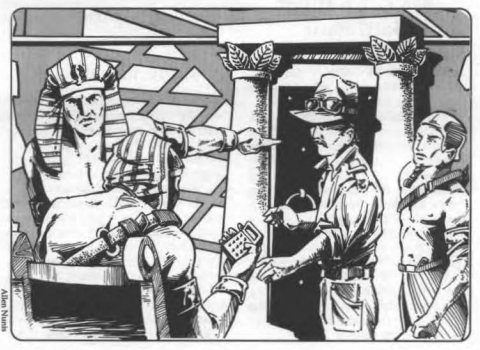
"Wow, this calculator makes all my magic a lot easier."
And lastly, we come to the character templates, and things get a little wonky with these. As you may or may not recall, there's no direct line between Terra and the Empire, so there was really no way for "good guys" to sneak in with Mobius' forces from home. Likewise, there was a one-time bridge created where Dr. Frest sent a bunch of pulp heroes on a one-way trip to Core Earth to help out.
That means that technically there are two types of Nile Empire characters: ones from the "Nile Empire" (people who've transformed) and "Terran Expatriates" (people actually from Terra). Unfortunately, you wind up with weird situations where characters were apparently from Terra despite working for "the Pharoah", even though he didn't become Pharoah until he left Terra.
Three templates were included in the base boxed set:
The Fast Hero answered an ad in the back of a Terran magazine looking for volunteers for "enhancement research", which actually gave her superpowers. But when she was expected to use her powers in the service of the Pharoah, she jumped ship and started working for the good guys. She doesn't have a tag skill, but starts with the flight power.
The Gadget Hero was the kid who spent all his time reading science journals and messing around with HeathKits. He was one of the forerunners of weird science, working for Mobius before learning about the Pharoah's expansion into other realities. He had his moment of clarity as he was moved down a maelstrom bridge with Mobius' forces. The Gadget Hero was made before the pulp gizmo rules existed, so he has a "gadget belt" that lets him fake one the pulp powers provided in the core set at a value of 17.
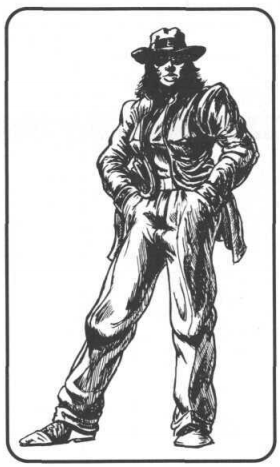
You got hit by...a smooth criminal.
The Tough Hero is...well, look. You know the drill; there's scum out there in the streets, preying on the innocent. Sometimes you need someone who's not afraid to get her hands dirty cleaning it up. Starting gear includes half a ham sandwich, a pack of gum, and a checking account with a minimum balance. World-weary receptionist is optional. Her tag skill is unarmed combat .
The Nile Empire book adds another ten:
The Amazon was a Core Earth college student who was on Hespera when the axiom wash happened. Now transformed to Nile's reality, she's now a skilled warrior-philosopher with some nice blessed gear. She also has two super attributes for an overal +4 to STR and +2 to DEX, with an adventure cost of 6 Possibilities, and the flaw that if a man taunts or tricks her and she suffers a setback from it, she loses the stat boots. Her tag skill is melee weapons .
The Dark Hero 's loved one was killed in a bank robbery, so he grabbed two pistols, dressed all in black, and made them pay. Now he doles out .45mm justice on a nightly basis. He has the option of starting with either darkness , fear , or fog screen , which he learned from monks in Tibet. His tag skill is either stealth or intimidation .
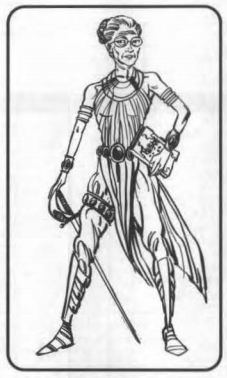
The Engineer was a former member of the cult of Khem (the guys who resurrected Mobius), and followed him through the various realities building facilities for the Pharoah's forces for promises of wealth and power (not to mention not getting killed by the rest of the cult). After a while, he realized the promises were empty and that he couldn't just keep his head down any more. His tag skill is engineering , and he has access to the magic skills.
Oddly, the picture for the Engineer is of an older woman; either there was a mix-up between the artist and the writer, or that's pretty damn progressive for the tim.
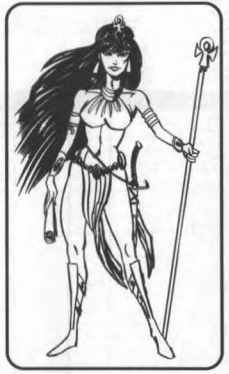
No, she doesn't start with any armor. Why do you ask?
The Egyptian Princess 's father and grandfather were both members of the cult of Khem, her grandfather being one of the people who resurrected Mobius. Unfortunately, she were dragged along for the ride when Mobius began conquering other realities because her father received a favorable sign from the gods. Turns out that the sign was faked, and her family was tricked into Mobius' service. Time to make up for the mistake. Her tag skill is egyptian religion and can take the faith and focus skills.
The Jungle Lord 's parents were anthropologists in Ethiopa when the axiom wash hit, and they were both killed by Mobius' forces. He managed to escape into the jungle, where he was found by Ooorook the gorilla and her tribe. They took care of him, trained him, and taught him to communicate with the creatures of the jungle. Armed with his newfound strength, it's time for a little revenge. He starts with the animal friend power, and his tag skill is maneuver .
The Mathematician is another former Khem cultist, although he were really just an apprentice to one of the full-fledged cult members. Dragged along when Mobius began creating his new Empire, it wasn't long before he realized that Mobius' promises of glory were just that: promises. He managed to escape the pharoh's clutches and is now trying to make amends for his past. His tag skill is mathematics and he can also buy magic skills.
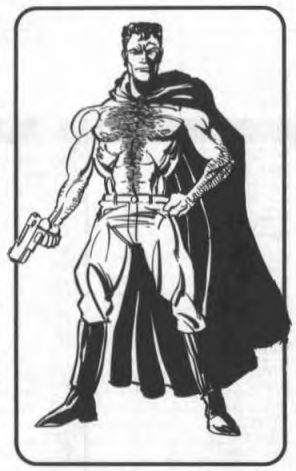
Who needs a costume when you have dense body hair?
The Mystery Man is from Terra, where he grew up incredibly rich and incredibly bored. Then all these costumed heroes and villains started popping up all over the place, and he thought, "I say, that sounds fun!" He had the money to afford the best training and to travel the world learning amazing techniques, and it wasn't long before he was thwarting the bad guys. It also wasn't long before it stopped being a game and became something he genuinely cared about, so when he learned that Dr. Mobius hadn't actually vanished but travelled to a new world, he leapt at the chance to follow. He can start with a pulp power if he wants, and his tag skill is disguise .
The Old Professor was never the heroic type until the maelstrom bridge dropped while she was on a ship in the middle of the Mediterranean with some colleagues. She were caught in a reality storm, which caused her ship to crash on shore just as Mobius' troops were establishing their territory. She were captured, but managed to escape when the same storm destroyed her captors. It wasn't long before she realized that reality was different, and that the old laws of physics aren't what they used to be. Now she's got a whole new field to discover. She start with a few gadget parts: four system components, five boosters, four adaptors, two caps, and two possibility capacitors, which is all actually worth a small fortune. Her tag skill is weird science .
The Private Detective spent ten years of his life as a cop walking a beat. But he butted heads with his corrupt superiors one to many times, and found himself kicked off the force. Now he works for himself. One day, a dame came in asking him to investigate the mysterious death of her father. Turned out is was one of those masked weirdos by the name of Mobius. He didn't realize there was more to him than a headdress and evil laugh until he learned he'd skipped town, and by "town" you mean "reality". He met up with a bunch of masked types who were going to follow him, and you agreed to come along. His tag skill is evidence analysis .
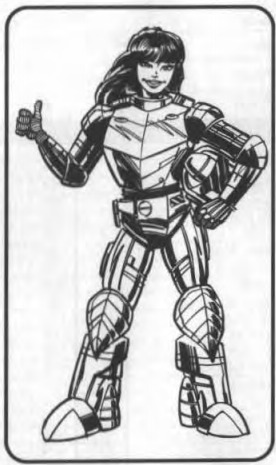
Thumbs up...for FREEDOM!
The Rocket Rangers were created during The Great War on Terra (WWII hasn't happened there yet). They're a international police force with a strong moral code, and this particular Ranger is the exemplar of that force. To quote the book, "You're almost too good to be true. Everyone likes you, and it's no wonder; everything about you is nearly perfect. You always know the right thing to say to make people happy, and you don't suffer from a single negative personality trait." Your only piece of starting gear is a Rocket Ranger Battlesuit, and your tag skill is flight .
The Rocket Red battlesuit is pretty damn powerful; it grants the wearer STR 14 and TOU 19, +7 armor (max 23), flight 11, and mega-sight . The downside is that it imposes a -1 to DEX, and the suit tends to overheat meaning that you take extra stress when a fatigue result comes up.
The Terra sourcebook added another handful of templates that are supposed to be exclusive to Terra, but they fit into the Empire pretty easily.
The Adventuring Archaeologist spent the majority of his life in one hole or another in some corner of the world or other, digging up relics of the past. Of course, this is on Terra, so that means that sometimes you have to deal with ancient curses, magical artifacts, and pre-Nazis. But we all know that just makes it more fun, right. And yes, he does start with a fedora. His tag skill is science(archaeology) .
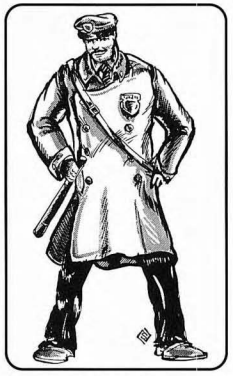
What's all this, then?
In a world of super-villains, jetpacks, rogue sorcerers, gangsters, spies, and lord knows what else, there's gotta be someone looking out for the common man and protecting him from the threats beneath the notice of the superheroes. That's the job of the Beat Cop . His tag skill is scholar (local neighbourhood) , which may be the most useless tag skill ever.
The Ex-Gangster used to own these streets. People paid him tribute and gave him respect. Now these wingnuts are coming in with their capes and their ray guns and they don't know nothing about respect. They sure as hell didn't respect him when they vaporized half his gang. That was a pretty loud wake-up call. Maybe it's time for him to take a look at what he's doing, y'know? If people are paying him for protection, then shouldn't he be protecting them? He did buy a super-strength serum from some scientist, just so he could play on the same level as the capes ( super attribute TOU+3), and his tag skill is petty crime .
The Government Spy is a loyal operative armed with a few hidden gadgets, a tux, and a rock-solid ego, and always gets the job done. Stopping terrorists, thwarting Martians, getting the lovely scientist's daughter, no matter what he does he looks damn good doing it. He starts with a device that boosts his stealth by 3 and a pair of dark vision goggles. His tag skill is espionage , of course.
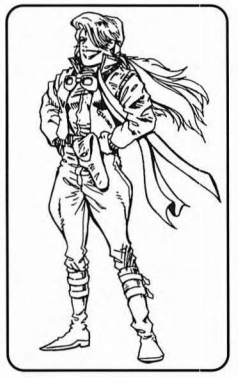
Smoke me a kipper, I'll be home for breakfast!
If it's got wings, the Pro Pilot can fly it. His father was a pilot in the Great War, and he grew up at his father's knee. The Great War was over by the time he were old enough to fly, but nowadays there's plenty of would-be conquerors out there, and if you're lucky, they've got some forces you can dogfight with. He do start with a plane; either a two-seater fighter or a junky old passenger plane. His tag skill is air vehicles .
The Pulp Sorceress was a normal student, bored with her mundane classes. Then she met the Old Man. He sensed power in her, and took her under his wing and taught her the ancient secrets of sorcery. She learned how to bend the world to her will, but before she could learn why she were chosen to learn these abilities, the Old Man vanished. Guess it's time for her to forge her own destiny. She get a few pre-designed spells and her tag skill is pulp power (sorcery) .
----
And with that, we finish up our visit to the Nile Empire.
It should be no surprise that I love the Empire. I mean, why wouldn't you? It's your standard-issue Nazi-punching pulp action, but instead of Nazis (which were starting to get overused even back then), you get Egyptian cultists. It takes the whole idea and spins in it a really fun new direction that lets you deal with an old concept in new ways.
But the Nile Empire brings Torg's biggest flaw into stark relief: the mechanical overcomplication. Pulp gizmos are way too involved to create, with a ton of unnessesary extra rolls. Magic has a ton of new subsystems that are supposed to add tone but just make you roll like three extra times to do one thing. Adventure Costs on powers make them very non-cost-effective in the long run.
I mean, I get what they're trying to do, but the way to make things thematic isn't to jam more and more mechanics onto your already overdesigned mechanics. Tone requires a gentler touch.
And speaking of tone, I want to bring up the idea about how pulp heroes aren't supposed to be "costumed tights-and-logo superheroes", then in every book after this one people with powers were always presented as costumed tights-and-logo superheroes. They couldn't even keep their non-mechanical tone consistent through the books.
Despite all that, the Nile Empire was the most popular of all the realms that appeared throughout the game line. Pretty much every published adventure had at least one scene in the Empire, and it received so much focus that other realms suffered a bit from lack of attention.
The Empire was popular with the game's writers, too. Not only did they write up on Terra (the only "home cosm" to get that honor), one of the writers' pet characters was the pulp hero Destructo Don, who appeared in the novels and a few of the adventures later in the line.
But for now, we leave Mobius' artificial sun in our rear view mirrors as we fly to the distant horizon, smiling at the memories of thrilling adventures and shaking our heads at the stupid mechanics.
...everyone has enough Possibility points to keep their abilities, right?
NEXT TIME: New adventures! New realms! New dumb mechanics!
Orrorsh
Original SA post The storm has a name... - Let's Read TORG
Part 14a: Orrorsh
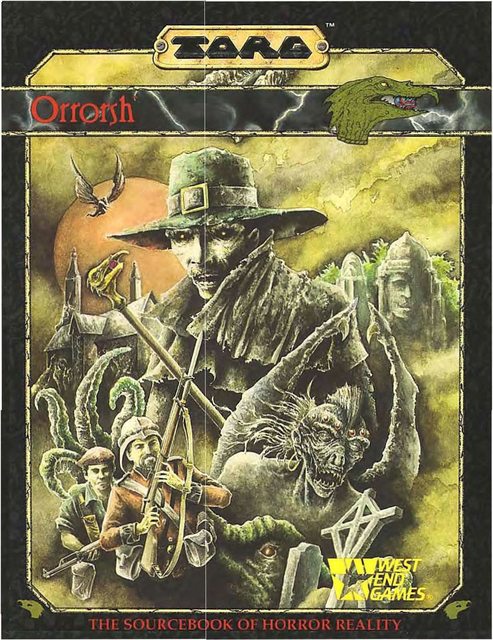
A mutilated body is found in a misty side alley, ripped to shreds, the blood still warm. The passerby discovering it is frozen in horror at the sight, completely unaware of the still-hungry vampire stalking up behind him.
A man runs through the city, pursued by a shadowy fiend soaring above the gaslit streets. The creature is invisible to everyone but its target, and the people on the street just see a raving, running madman. The man will spend the rest of his life in an asylum tormented by a beast only he can see.
A woman creates an effigy of her cheating husband out of old rags and a lock of his hair. In the light of candles and surrounded by a magic circle, she slowly lowers a pin towards the doll's eye.
This is life in Orrorsh, a carefully tended garden of horrors cultivated by the being known only as the Gaunt Man.
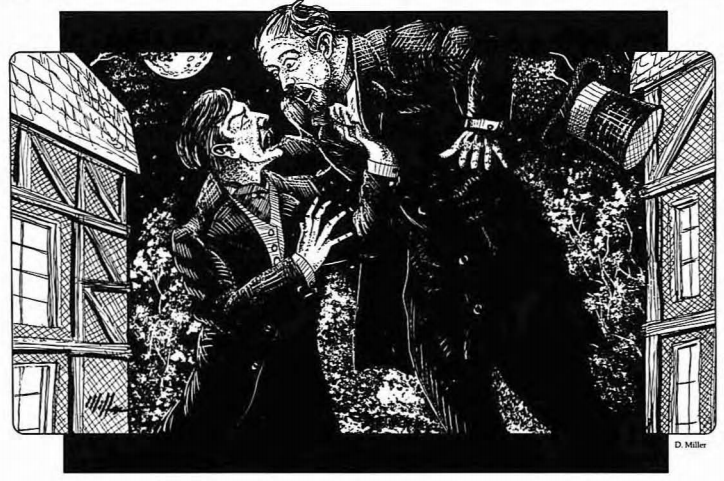
I say, that's not cricket!
For Queen And Empire
Orrorsh was the first invading cosm to touch down on Core Earth, and did so in secret. By picking relatively isolated countries, all the outside world was aware of were strange storms around the Indonesian island chain that seemed to cut off communications. Before the world at large had a real chance to address this, Baruk Kaah dropped his main bridge on Shea Stadium just before game 1 of the World Series and suddenly people had bigger things to worry about.
Which, of course, is what the Gaunt Man wanted. By keeping the realm isolated from the rest of the world, he kept people out of his business and the inhabitants trapped in a world of terrors.
You see, Orrorsh isn't the reality that is invading; "Orrorsh" is the original home of the Gaunt Man, an invasive reality that has spread from cosm to cosm over countless millennia. Until recently, the Gaunt Man was content to allow Orrorsh to decimate the worlds it came across and leave nothing but ashes in its wake.
Then he came across the world of Gaea.
Gaea, like other cosms such as Terra and Magna Verita, is very similar to Core Earth, except that it "exists" at an earlier point in Core Earth's history. In this case, the Gaunt Man found a world at the height of the Victorian Empire. A world where England had conquered most of the world "for its own good". A world ruled by a people who know that only they are truly capable of being in charge because they are the only truly civilized people in the world. A world where colonialism has run rampant for centuries fueled by xenophobia and evangelical religious fervor.
A world, to be frank, where The Gaunt Man could truly cultivate fear.
He did so by sending horrors across bridges in what the Victorians considered "heathen lands", further fueling their xenophobic tendencies while spreading his influence through the government. Once he had arrived and brought his Darkness Device Heketon over, the Gaunt Man was able to completely halt the societal advancement of the world while adjusting it to his particular desires.
For three hundred years he slowly eroded the world of Gaea away and replaced it with the reality of Orrorsh. He possessed members of the government to help steer things along, driving Victoria's development down whist overrunning the rest of the world with the Ecology of Fear. The Empire itself never understood what was happening, believing the events to be caused by the forces of Satan as punishment for "moral laxity" and turning more to their increasingly rigid state religion for support.
Now the island of Victoria is the last bastion of "civilization" on Gaea. The Gaunt Man keeps his forces from overrunning the nation, because he enjoys the hopeless fear of the population. In fact, the Gaunt Man has altered the cosm's rules so that he gains more possibility energy from ords when they're afraid. So he keeps the Victorian population afraid all the time .
When the time came for the invasion of Core Earth, the Gaunt Man let a Victorian scientist named Dr. Wells "discover" an ancient treatise that described the existence of the multiverse, as well as a way to break the dimensional barriers and travel from one world to another. Wells saw this as a potential way to aid the Empire; if he could reach other worlds, he could call in allies to help fight back the darkness. He managed to use the knowledge in the treatise to create a reality bridge to another world, but when he activated it he never expected what would happen next: the creatures that had destroyed his world began streaming down the bridge to this new world! Unable to stop the machine, all he could do was watch as his actions doomed this "Earth" to the same nightmares that destroyed Gaea.
Unable to deal with the guilt, Wells informed allies in the government and took his own life. The Victorian government knew that clearly they were the only ones who could stop these invaders (after all, what could the natives do? They're not us ). Military forces were assembled and sent down the bridge to establish a colony and fight the horrors they had unleashed upon this new world.
Which is exactly what the Gaunt Man wanted.
The Gaunt Man's invasion force wasn't the monsters that went down Wells' bridge. Actually, they didn't even exist in the first place; it was just an illusion to fool the doctor. When the Victorians came down the bridge into Indonesia, they were the Gaunt Man's unknowing invasion force. They were the believers needed to power the stelae planted well in advance. They were the ones that brought their reality into Core Earth, allowing the true horrors to exist here.
The Victorians don't see it that way, of course. It's their job to drive out these "backwards natives" and protect them from the horrors they can't comprehend due to how ignorant they clearly are. As it is, all these "darkies" clearly drove the original white settlers out and took over, because how could they create any of this technology? It's the Empire's job to establish the colony of Majestic (formerly known as Indonesia) and save the world. It's their burden, their God-granted purpose. And really, once Core Earth is under the aegis of the Empire it'll be much better off. After all, who knows better than the Victorians?
Pax Victoriana . So to speak.
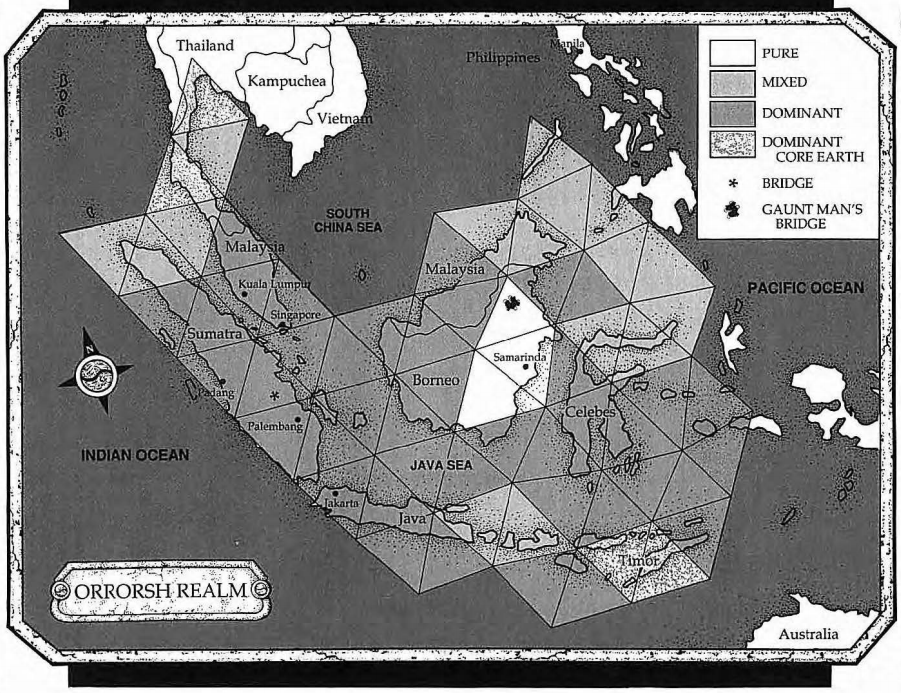
The Realm of Orrorsh, about three months after the initial invasion.
The Gaunt Man
So let's talk briefly about the Gaunt Man.
The Gaunt Man is the mastermind behind the whole invasion of Core Earth. He's come closest to becoming Torg than anyone else in known history, and he knows more about the nature of the cosmic entity known as "The Nameless One" than pretty much anybody else.
The Gaunt Man's backstory isn't given in the RPG, but was the subject of the novel Interview with Evil . I'm not going to get into it here (mainly because I haven't read the book because it's terrible), but what matters right now is what the current situation of the Gaunt Man.
The Gaunt Man rules Gaea, even though nobody there is aware of it. Unlike the other High Lords, the Gaunt Man keeps a relatively low profile on his world. That's not to say he's not involved; at the time of the invasion he was posing as (read: "had taken over the body of") Lord Byron Salisbury, a highly-placed cavalry officer. He uses magic to hide his decayed appearance from the Victorians, who consider him a war hero. Interestingly, a few of the other High Lords do refer to him as "Salisbury" from time to time, but in general he is mainly known as The Gaunt Man.
He's also been out of the picture for almost the entire invasion.
As part of the events of the prequel novel trilogy, the Gaunt Man is currently trapped in a pocket dimension by an eternity shard known as "The Heart of Coyote", trapped in an unending cycle of destruction and recreation. The only person who knows that the Gaunt Man is out of the picture is his lieutenant, the techno-demon Thratchen. Thratchen has told the other High Lords that the Gaunt Man has sequestered himself away to "prepare for the next phase of the invasion", but everyone knows that's bullshit and has started the scramble for territory and power among themselves. There's also the various operatives and horrors that are trying to take advantage of their lord's absence, but for the most part Thratchen doesn't give a shit about them. What he is trying to do is attune himself to the Gaunt Man's Darkness Device so he can become High Lord of Orrorsh, but so far he hasn't had any luck.
What this means is that the Gaunt Man's personal forces aren't so much in disarray as realizing that the boss is out of the office and now it's time to work on more personal projects. Some of the High Lord's agents are still steering the expansion of the realm and the planing of stelae, but for the most part everyone is just engaging in whatever terrible acts they feel like.
Axioms and World Laws
quote:
The reality of Orrorsh bases itself upon the central tenant of horror. This horror manifests itself as ghouls and oozing terrors, but this is only the realm's clothing - what it shows to the world, how it interacts with people. The core of Orrorsh is that it encourages people to do evil and discourages people who would oppose evil. Heroes who travel to Orrorsh from other realities might be surprised to discover that they are not as powerful as they are in other realms. In Orrorsh the villains have a distinct upper hand - and the monster hunters need to find the secret weakness of creature's before they can expect to be successful in defeating the beasts.
Of course, the Gaunt Man loves evil, and offers mystical reward for anyone, even Storm Knights, who commit acts of evil. Within the Gaunt Man's reality, Storm Knights must move carefully, treading a narrow path between effectively destroying monsters and becoming monsters themselves.
The Gaunt Man has taken a very personal interest in Gaean and Orrorshian advancement, guiding it like a gardener tending a flowerbed. He's spent centuries guiding and shaping Orrorsh into the realm it is today, allowing a certain amount of progress to happen just to keep things from becoming too stagnant.
Magic Axiom: 15
Orrorsh has the second-highest magic axiom out of the initial raiders (Aysle is still first), which is what allows the innumerable horrors to exist. Magic is possible in Orrorsh, but "traditional" spell-based magic is very rare. Instead, there is occultism , which is a ritual-based form of magic capable of performing pretty much whatever the caster wants...as long as they're willing to pay the price, which is usually "too much". What really makes occult magic dangerous is that it can be performed by anyone without any special training.
Spiritual Axiom: 17
Surprisingly, the Gaunt Man has allowed the religious side of Victorian culture to keep existing. Of course, it's because allowing people to believe they have souls allows the trade in same, but also because despair is better when it comes from broken hope.
The Sacellum is the state religion of the Empire, and has its roots in evangelical Christianity. The unending onslaught of horrors from the rest of the world has caused the Sacellum to become a source of desperate hope from the people, despite the fact that the Sacellum is focused on the idea that salvation can only come from unwavering dedication to the principles of the church. As a result, Victorians believe that any form of change will bring the world down around their ears as punishment for their "sins".
Social: 20
As stated, Victoria is pretty much England in the mid-to-late 1800's, only stagnated over the last three centuries due to the presence of a Darkness Device. Victorian society is very... delineated . There's a place for everyone, and everyone has their place. Of course, if you're not actually a Victorian that place is very far down the ladder. Not that Victorians are equal amongst themselves; women are still considered the "lesser sex" and don't have equal rights, and classism is very prevalent. The government itself is very bureaucratic, and is heavily influenced by the Sacellum.
In fact, the Sacellum is involved in day-to-day life it even controls entertainment. Public "entertainment" mainly consists of long Sunday sermons about sinners repenting their evil ways, and live out their lives listening to long Sunday sermons about sinners repenting their evil ways. Novels and plays run along the same lines and with the same themes. There is a sort of underground writing movement forming, currently focused on tales of 'orrible murders and adultery, but for the most part Victorian entertainment is focused on the concept of redemption and resisting the evils of the world.
Technology:19
It goes without saying that Victorian technology isn't very advanced. In Core Earth terms, it's about as advanced as 1891 England. The Victorians have not done much technological advancement on their own, even though the Gaunt Man hasn't interfered much with their achievements in this area. In fact, on a few occasions the Victorians have willingly ignored what would be considered major technological advancements because they were "unnecessary" or "beneath us".
This also means that, disconnection aside, the Victorians pretty much refuse to use modern Core Earth technologies because it wasn't made by them. This makes life even more difficult for the Indonesians as they try to survive the occupation because the Victorians deny anyone access to Core Earth tech.
Back on Gaea, steam power and gaslight are the norm, although electrical systems exist. They just don't see widespread use. Telephones are used for communication in the cities, and telegraphs are used for long-distance communication. There is a "Transdimensional Cable" running up the bridge from the Gaean city of New London down to the Majestic colony so the military leaders can maintain contact with the government.
The main focus of innovation is in the weaponry field; unsurprising given the nature of their world. Bolt action rifles and hand-cranked machine guns are still relatively new developments, and the go-to military strategy is still lines of riflemen firing in sequence. This is because the monsters they have to deal with back on Gaea do not (for the most part) attack en masse . A Gatling gun is great for taking down a zombie horde, not so much for stopping a pair of vampires before they decimate the regiment.
Now, the World laws...whatever World Laws Gaea used to have are long since erased and forgotten. In their place, the Gaunt Man has instituted three of his own: The Power of Fear, The Power of Corruption, and The Law Of Eternal Corruption. These laws are so pervasive they will actually affect anyone in the realm, even of they're in a reality bubble.
The Power of Corruption rewards acts of unnecessary evils. Whenever a person commits what is generally considered an "evil" act for no reason apart from their own desires (which the game refers to as a "Wicked" act for convenience), they receive an automatic up result (free roll again and add) on the action. They also get a new "skill": corruption , which always starts at 8. Every time a character commits a Wicked act, they get the free roll-and-add, then their corruption increases by one to five points depending on the nature of the act. The character must then make a corruption check against a difficulty of 12. If the roll succeeds, then the character gains some physical manifestation of their evil nature. The more they "succeed" by, the worse the deformity. Narrow success may result in body-wide sores or your eyes becoming cat's eyes, but at the extreme end you can actually transform fully into a horror of some sort and become an NPC.
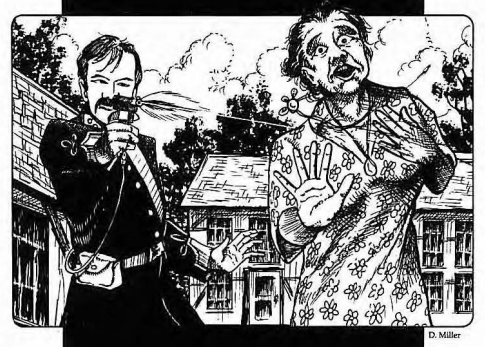
"Pacifying" the natives.
The Power of Fear is, um...well, let's let the book tell you.
quote:
There are two reasons that the Power of Fear exists in the reality of Orrorsh. The first reason is part of the logic of the world within the game world, the second is a logic of game mechanics, exterior to the "fictional reality" of Torg.
First, the Power of Fear exists because the Gaunt Man is very powerful and created a powerful force that weakens his enemies. Some High Lords use their power to increase their technology so they can build tougher tanks, others increase the sophistication of their reality's miracles. The Gaunt Man and Heketon, who love fear, decided to make it harder for heroes slay his monsters rather than make the monsters tougher.
The second reason is that every realm of Torg: Roleplaying the Possibility Wars should have its own distinct feel to it. The realm of Orrorsh is a place of atmosphere, of slow searches through mist-shrouded graveyards. We created the Power ofFear so that Storm Knights cannot go blasting their way through every conflict the same way they might do in the Living Land or the Empire of the Nile.
The last World Law is the Law of Eternal Corruption , and is actually not a player-facing law. This law allows the soul of any killed monster or corrupt human to bypass being brought to the afterlife for judgement and the inevitable eternal damnation. Instead, the soul can allow itself to be reborn into a new, monsterous form and return to torment the world of the living.
These three Laws form the foundation of what the Gaunt Man refers to his Ecology of Fear . He's created a cycle where monsters can roam unchecked and people can be tempted to commit heinous acts for power. Anyone fighting against the forces of darkness just reinforce the system, because they weed out the weaker horrors and allow the stronger ones to thrive by defeating would-be heroes. And even if you defeat the monsters, they can just choose to come back a month, a year, a decade later and start the whole cycle all over again.
As a result, the realm of Orrorsh is like a stagnant pool of fetid water. The willing unchanging rigidity of the Victorians prevents them from really being able to effectively fight against the darkness, and the Gaunt Man's laws ensure there will always be another beast ready to feed on the fear of the populice. To say nothing of the terrible things done to the natives of the Indonesian island chain by the Victorians themselves in the name of the Empire. It's a vicious cycle of terror, a snake so busy devouring its own tail it fails to notice it's being devoured by a wolf.
Even without the Gaunt Man guiding things, the cycle continues unabashed. You can't defeat the darkness, all you can hope to do is delay it for a while.
Really, hope isn't worth it. You're barely even delaying the inevitable.
Give up. It's just easier that way.
NEXT TIME: Southeast Asia, then and now
Your new-caught, sullen peoples, Half-devil and half-child
Original SA post The storm has a name... - Let's Read TORG
Part 14b: Your new-caught, sullen peoples, Half-devil and half-child
This is going to be a rough book to review, because it's one of those ones where the information is interwoven throughout the book instead of being laid out one concept at a time. So occasionally an important bit of background info is revealed in passing two chapters after it should.
The first chapter of the Orrorsh sourcebook is about Southeast Asia and is presumably about the region before the Gaunt Man showed up.
Instead, well...
quote:
We do not intend this book to cover every detail of so many different countries. Adequately describing even one of these nations would require a book containing hundreds of pages.
Well, anyway, lets take a look at that part of the world.
The territory now overrun by Orrorsh consists of over 13,000 islands of varying size, the largest being Borneo (which is also the third-largest island in the world). The overall population is around 150 million spread throughout the region.
quote:
Many of the people live in isolated tribes and by the laws of their ancestors. Others live in huge cities such as Singapore and Jakarta, the business people and factory workers and miners. Any discussion of Southeast Asia must keep in mind that the area has a tremendous mix of ancient traditions and modem technologies.
The regions are described in what appears to be a pretty random order, so we might as well just run down the line.
Malaysia is split between the southernmost archipelago of southeat Asia and the northern edge of the island of Borneo. It's a constitutional monarchy (meaning the king or queen is the Head of State, and actual legislation is performed by an elected Parliament), with a population of about 60% Malays and 30% Chinese. The country has been hit pretty hard by the invading reality, with the seat of government retreating to Japan (in their defense, nobody knows about Kanawa yet) and leaving the cities to pretty much fend for themselves.
Singapore is a small republic that is actually the only city-state in the world. It's incredibly densely populated, and most of the major world religions have a presence here. Because it's really just one big industrialized city, Singapore is completely reliant on import for its agricultural needs. Singapore appears to be a Core Earth hardpoint, given that the horrors of Orrorsh seem to stop just outside the city, but in fact it's just in a mixed zone. A powerful dark entity named Skutharka has claimed the city for her own, and is slowly twisting the available technology into new and disturbing sources of fear.
For the most part, Burma hasn't been nailed too hard by the invasion. It's lost territory, yes, but it's still mostly outside the stelae zones. Unfortunately, this means that they have to deal with the influx of refugees from Malaysia and the nearby islands. The country's infrastructure is completely overwhelmed by the influx (not to mention trying to keep Orrorsh from pushing further north), and the Red Cross and the Cyberpapacy's Soldiers of Mercy are rushing in personnel, food, and medical supplies as fast as they can.
Thailand is in a similar situation as Burma, but has recently undergone a strong religious revival as the faithful flock to Bangkok. The strength of the Buddhist and Islam faiths does seem to have slowed Orrorsh's advancement into the country, but unfortunately that just means that the forces of darkness are putting more attention on Burma.
The Philippines have suffered very heavily from the invasion. Because the country is actually a collection of islands out on the edge of the overall region, they were cut off from pretty much everyone when the Gaunt Man dropped his personal bridge on Borneo shortly after the Victorians invaded. They haven't lost much territory (yet), but the invasion has fractured the Phillipine people pretty heavily. The government is currently focused on trying to reunite the islands before Orrorsh can make a significant push.
Indonesia is the largest country in this mess, and the one hit hardest by it. Indonesia consists of 13,667 islands (half of which aren't even named), but about a third of them are under Orrorshian axioms. Orrorsh has taken over Sumatra, Java, Borneo, and Timor, with the Victorian having conquered a sizable chunk of Sumatra as the colony of Majestic. The Gaunt Man also has a bridge of his own in Borneo, which is (well, was ) the center of his operations. Indonesia has been invaded many times in its history by the Dutch, the British, the Portuguese, and the Chinese, and in fact did not achieve independence until its first general election in 1971 after 500 years of being under other people's thumbs.
Until the invasion happened, the capital of Indonesia was Jakarta, its largest city. The city is still there (and is an actual hardpoint), but the government has bugged out to Irian Jaya (now known as West Papua after 2002) because it's outside the stelae zone. The government is trying everything it can to get aid from Japan and the Soviet Union, but so far only the Soviet Union has seemed to be willing to send any form of aid.
Technically speaking, Australia is not part of Orrorsh, but given that they're within spitting distance of its southern border they're pretty much forced to be involved. They've allied themselves with the displaced Indonesian government, and have begun very cool relations with the Victorian forces. This is because the Australian government is treating the Victorian occupation as a revolutionary movement that has illegally ousted the old government, and the Victorians treat the Australian government like bunch of ignorant children who should mind their betters.
Monsters and horrors are starting to appear in northeastern Australia, but so far it seems that Core Earth weaponry is more than capable of taking out monsters. But as we will learn later on, this is not actually the case.
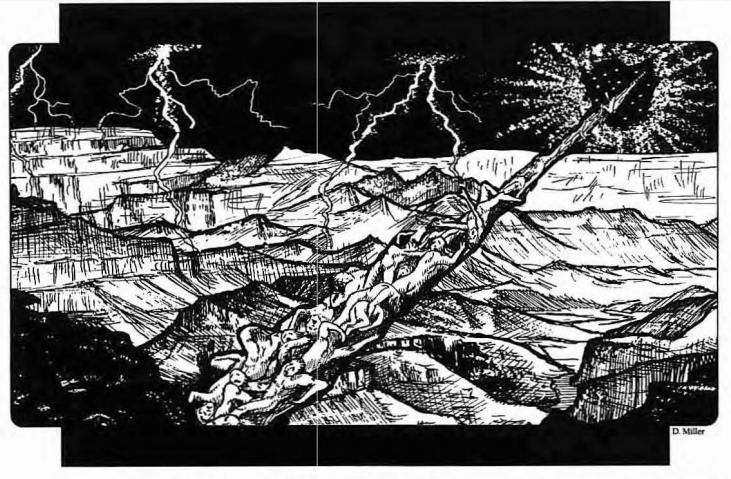
Pictured: the view in Borneo
And that's pretty much all we get for Southeast Asia! There's a little more, yes, but for the most part everyplace but Indonesia gets maybe two paragraphs, and most of Indonesia's entry is concerned with the history of the nation.
The next chapter is The World of Gaea , and is about the most recent world the invaders are coming from.
quote:
There is no longer a home cosm for Orrorsh. Like the other invading realities, the reality moves on from world to world. The reality of Orrorsh was so brutal that it eventually consumed each world the Gaunt Man invaded. He left no trail.
The main divergence point between Core Earth and Gaea happened in 43 AD, when the British chieftain Caratacus led his people against the invading forces of the Roman Empire. In our world, he failed and the Roman forces took over the island.
quote:
In the history of Gaea, the Brits had in their number a warrior-woman named Viictoria. Just when the Romans seemed about to win, she turned the battle and brought her people to victory. They rallied around her and she unified the people of her island. She was a politically astute woman who realized that she would have to focus her peoples' attention upon an external force. Focus against Rome eased dissension in Britain. She turned her people toward the Roman Empire. Her subjects coined the phrase "Victoria For The World," and it never lost its value.
Over the next century, the Victorians cut their way through Gaul on their way to Italy. But unlike Rome, Victoria didn't leave conquered territory to its own devices under the empire's aegis. Instead, they set up colonies everywhere, replacing the native cultures with their own and taking any available land or resources along the way.
Once Europe was conquered, Victoria turned its sights on the rest of the world. The Victorian naval force was very primitive compared to their neighbors such as the Vikings or Huns, because the arrogance of the Victorians made any form of technological advancement very difficult. When confronted by a new societal advance (especially if it was from another culture), the Victorians tended to dismiss it out of hand.
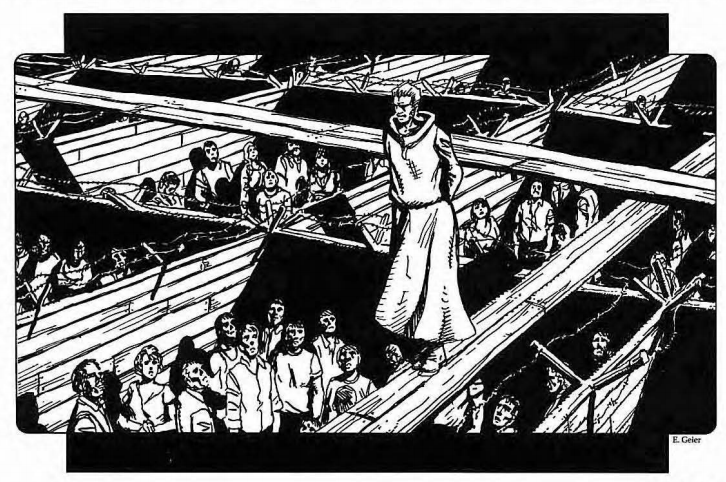
Really, it's for their own good.
Interestingly, the one major discovery they adopted for themselves was Christianity. Where the early "Martyr cults" were dismissed by the Romans, the Victorians saw a religious system that worked very well with their belief that dying for a cause (be it God, or the expansion of the empire) was the highest goal one could aim for.
Victoria was the Roman Empire of Gaea, except that the Victorian empire was much, much longer lived. The empire spread across the face of Europe and the Middle East, leaving colony after colony in its wake. The discovery of Islam led to three solid centuries of warfare as the Victorians finally found an enemy that could match it in religious and tribal furor. The only nation able to hold them back was Japan, although Victoria did enter (begrudging) trade with China.
Despite everything, some outside ideas did permeate into Victorian culture, shaping it into what we would consider "Victorian English culture". Overall societal advancement was still very slow, but by the 17th century Victoria controlled most of the Eurasian continent and was starting to move into what we think of as North America.
American colonization more or less followed the same path as they did on Core Earth, albeit for different reasons. Instead of seeking religious freedom, the colonists were interested in the potential for profit that could be wrung from this new land.
At the end of the 17th century, the second major world-changing event happened: the Battle of Medway . A series of strange murders occurred in the American colonies involving dismemberment and cannibalism. Believing the attacks were the work of the "heathen" natives, open warfare began between the colonists and the Native Americans.
To the colonist's shock, they learned that the "East Indians" were capable of powerful mystic feats (or, as one colonist put it, "alive with the fire of the Devil"). This was the Victorian's first encounter with anything supernatural, and they had no idea how to deal with it.
quote:
In 1692 ten girls in Salem, Massachusetts were convicted of murdering their own parents. The girls claimed to have been corrupted by the satanic powers of an East Indian named Tituba , a servant of the Reverend Samual Parris , and two other women of Salem. The girls all decreed that hell was unleashing its demons upon the world; only a return to the old way of blood and conquest could save the world. The morning after the girls made their statements, their bodies were found completely charred in their beds. Fire had touched nothing else in any of their rooms, including their bedding.
The Salem Witch Trials began.
(I should point out, by the way, that while Gaean history does involve real people from our history, the book doesn't actually point this out. If I hadn't thought to Google one of these names, I never would have realized that this was all a twist on human history. I guess they just assumed that the readers were familiar with the major players of the Salem Witch Trials and would just recognize the names.)
The supposed demonic work of Tituba resulted in a backlash against all the East Indians as being servants of Satan, and the push to kill the so-called "forces of darkness" led to a full-on holy war in America. And while the more monstrous beasts were an obvious target for the military, it wasn't long before creatures started appearing that could blend in with normal humans; werewolves, vampyres, and sorcerers began spreading through the Empire.
What the Victorians couldn't know, of course, was that the sudden appearance of the supernatural was the work of the Gaunt Man, who had dropped a bridge in the Grand Canyon. He sent his minions out under the guise of working for the Native Americans in order to ferment the natural Victorian racism into something larger. He also began possessing members of the aristocracy in order to begin steering Victorian culture to his desires. He cemented their instituional racism, he pushed for the growth of sweat shops for the "benefit of the lower classes", and generally encouraged the worst aspects of Victorian culture. Some of his followers learned what he actually was and worked with him voluntarily, but for the most part nobody realized how they were being manipulated both from within and without.
Eventually, Orrorsh managed to overwrite most of the reality of Gaea and reach the borders of the island of Victoria itself. Victoria was forced to write off its colonies as being destroyed, but every now and then a missive would work its way back home from the besieged colonies. The ruling class managed to put enough information together to learn the name of the force behind the invasion: The Gaunt Man. But to the evangelical Victorians, this is just another guise of Satan.
For the past century, the Victorians have been fighting to keep the horrors off their shores and maybe start pushing back. The Gaunt Man is smart enough to allow the Victorians the occasional victory so they have just enough hope to keep going. The Gaunt Man has learned how to gain more possibilities from people who were under the grip of fear, and has molded both Orrorsh and Gaea into a self-sustaining source of both possibility energy and unrelenting terror. He gains so much energy from the remnants of the Victorian people that it's worth not just wiping them out and moving to the next world. In fact, he's been known to provide aid to those who can fight back against the darkness in order to weed out his weaker creations.
But eventually the time came when the Gaunt Man discovered Core Earth, and with it his best chance at becoming Torg. So he allowed the plans for a makeshift maelstrom bridge to fall into the hands of one Dr. Wells, and...well, we all know what happened there.
Currently, the Victorians have taken over about a third of the island of Sumatra, driving out the native Indonesians and renaming the colony "Majestic". Technically the Victorians are here to fight the horrors they think they've unleashed on Core Earth, but what's actually happening is that they're feeding into the Gaunt Man's short-term plans. The Victorians are convinced that the "primitive" native Indonesians have "driven out the white settlers" of this region, and they honestly believe that it's their job to take the colony back and elevate the natives to a proper level of civilization (i.e., the Victorian's level). White Man's Burden , and all that. Of course, the Gaunt Man has a few loyal followers in the governments on both sides of the Victorian bridge, so that official stance isn't going to change anytime soon.
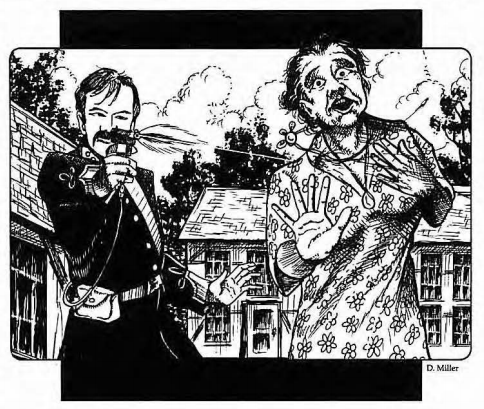
That'll teach her to not be White.
What this all boils down to is that the situation in southeast Asia is one of the worst out of all the conquered territory. Indonesia, having just regained its independence, finds itself dealing with a threat that might have stepped out of its own past. Monsters are spreading throughout the region, working their way out with no seeming way to stop them. The Victorians are driving people out of their homes in the name of an Empire that refuses to accept even the possibility that it might be doing the wrong thing.
It's a downward spiral of hopelessness, crafted with care by a madman who seeks to destroy both worlds, both in a physical and a spiritual sense.
And to make matters worse, he's not even controlling it anymore. The hand is off the leash, and now the beasts are running wild.
Yeah...this is gonna get uncomfortable.
NEXT TIME: As you sow, so shall ye reap.
The architects of fear
Original SA post The storm has a name... - Let's Read TORG
Part 14c: The architects of fear
And now, it's finally time to really talk about The Gaunt Man.
Very little is known about the Gaunt Man's history. Where the other High Lords will spend hours monologueing about their greatness and conquests, the Gaunt Man rarely (if ever) talks about his past. The commonly held beliefs are that he either doesn't want to accidentally let some obscure weakness slip, or that he actually doesn't remember it himself.
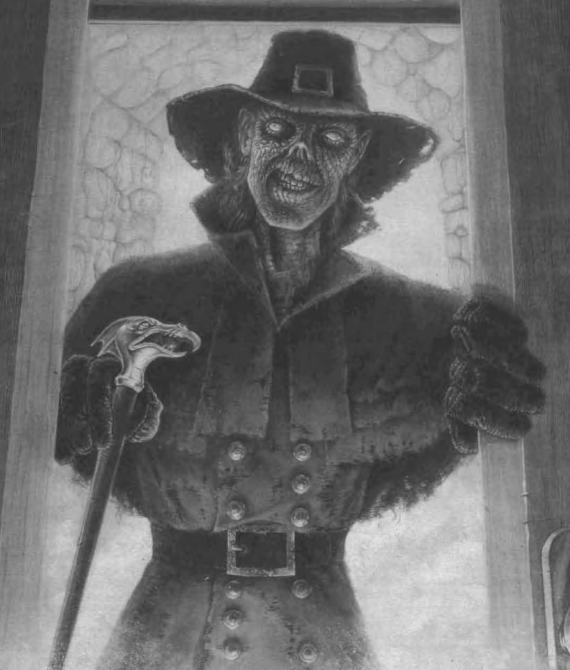
The Gaunt Man, High Lord of Orrorsh and mastermind behind the Core Earth invasion
What is known is that the Gaunt Man is not really "human" in any traditional sense anymore. He is an entity capable of possessing body after body in order to further his goals. This possession is very rough on the host bodies and gives him his defining characteristic, but he is capable of casting illusions over himself to blend in with mundanes. Currently he's posing as Lord Bryon Salisbury, a Victorian cavalry hero, and this is the name the other High Lords also know him under.
As stated previously, the Gaunt Man is the mastermind behind the whole Core Earth invasion. He was the one who managed to get the other High Lords to work together to help him become a god, promising that he would give favorable treatment to those who aided him in this endeavor. His overall plan was to strip Core Earth of its incredibly high amount of Possibility energy, then kick off a major natural disaster to give him the physical energy needed to complete his apotheosis.
Unfortunately for him, during the events of the original trilogy of novels, the Gaunt Man was trapped in a pocket dimension by a Core Earth eternity shard called The Heart of Coyote. The Gaunt Man and the Heart are currently "outside" our reality, trapped in an eternal cycle of creation and destruction. The Gaunt Man is painfully disintegrated and reformed hundreds of times a minute, leaving the Possibility Raiders without their mastermind and Orrorsh without its High Lord. He is slowly draining Possibilities from the Heart of Coyote, so really his freedom is only a matter of time.
That said, despite being trapped and cut off from his power, the Gaunt Man is still High Lord of Orrorsh. His Darkness Device is still bound to him (and vice versa), and until it decides to release him and find a new High Lord nobody will be capable of taking the realm over.
The other High Lords don't know what's happened to the Gaunt Man yet. They do know he seems to be out of the picture for a while, though. The Gaunt Man's lieutenant Thratchen has been telling the other High Lords that the Gaunt Man is in seclusion to prepare for the next stage of the invasion, but nobody's really buying that. Until the Gaunt Man can break free, the other High Lords are free to pursue their own agendas and possibly become Torg.
All that being said, what's the Gaunt Man's overall priority list outside of "escape the eternal reality storm"?
His top priority is gaining knowledge of the Nameless One. The Gaunt Man is obsessed with this entity, and believes that the only way to gain true understanding of a cosmic entity is to become Torg.
(Remember the Nameless One? Of course you don't; it's because the Nameless One is one of the two cosmic entities mentioned in the brief description of the creation of the multiverse way the fuck back in the Basic Set, where he's only mentioned in the creation myth and that it's the force that created the Darkness Devices in the first place. The Nameless one (and Apeiros) are actually really important to the overall three-and-a-half-year metaplot, despite being brought up in official material once in a blue moon. It really does bring into sharp relief how the overall metaphysics and such weren't for the players, they were for the writers.)
Anyway, his second bullet point is to gain as much power as possible. This feeds into his overall top priority; after all becoming Torg requires an insane amount of both Possibility and physical energy.
Third, he wants to spread the reality of Orrorsh across Core Earth. Inspired by the Victorians, he wants to set up "colonies of fear" across not just Earth but the realities of the other invaders. Ideally, Orrorsh would spread across Core Earth, over the various realms, then up the now-conveniently-placed bridges to the other High Lords' cosms.
Fourth is maintaining the culture of fear throughout his realm. He does this by creating horrors and letting them lose on the general populace. That said, he's always careful to keep things to the shadows; he's smart enough to realize that if the horrific becomes common, the fear will vanish and people will be able to really fight back. So he keeps things subtle (for the most part) in order to reap the benefits of fear.
Lastly, he wants eternity shards. There are two reasons for this; first off, he wants them as sources of Possibility energy. Second, and more important, eternity shards are the only weapon effective against him. Unless killed with an eternity shard, he'll just come back like nothing happened.
Despite being a total megalomaniacal tyrant, the Gaunt Man is a surprisingly calm person. He comes across as very cool and calculating, and that's the case for the most part. The only times he shows any real emotion are when he flies into a rage when his plans are thwarted, or the disturbing joy he feels when his machinations instill more fear on his subjects. In a lot of ways, he's a kid burning ants with a magnifying glass, laughing when they flee and throwing fits when his toys are taken away.
The Gaunt Man's Darkness Device is Heketon, which appears as an obsidian heart about the size of a fist. Heketon is one of (of not the) oldest and most powerful Darkness Devices. Heketon and the Gaunt Man have worked together for millennia, and together they are the only known force ever able to defeat another Darkness Device. Long before discovering Gaea, the Gaunt Man and Heketon invaded the feral werewolf cosm of Kantovia and defeated its High Lord, Dairoga. While the Gaunt Man was able to brainwash Dairoga into being one of his personal agents, Dairoga's weakened Darkness Device managed to dimthread out of there and escape to a new cosm: Earth. This is how the Gaunt Man learned of Core Earth, and was the spark that set off his whole plan.
This being Torg, both the Gaunt Man and Heketon are given full stat blocks. This is despite the fact that the Gaunt Man is (as of the release of the book) out of the picture and unreachable, and that Heketon (being a Darkness Device) is impossible to destroy. And to make sure that they can't be beaten before the metaplot says so, their stats are through the roof because somehow that makes more sense than saying "these are entities that can squash you like a bug". The Gaunt Man's lowest skill is an 18, and the skills he can use to inflict effects like stymied or setback are in the mid-30's. On top of that, Heketon itself has completed an occult ritual that allows it to use any of its powers through any active Orrorshian stelae.
quote:
Heketon carefully observed the opening days of the Possibility Wars. It was disturbed by what it saw, and what the ravagons reported. While not likely, the chance of defeat existed. One or more realms might fall, and then the possibility energy of Earth would surge in a storm across the remaining realms, shattering the stelae which bounded them. All the work of Heketon and its High Lord undone in one furious cataclysm. The Gaunt Man believed the plan still worked well enough. Heketon did not.
Heketon researched the problem with the blinding speed and power available to it as the master of Orrorsh's reality. The answer was an occult ritual, one of daring complexity and scope requiring great sacrifice. The first sacrifice was betraying the Gaunt Man to his enemies. Many others were necessary. The final sacrifice involved itself, giving up part of itself to use the power of the occult.
Currently, Heketon is waiting to see if the Gaunt Man can escape from the Heart of Coyote's reality storm. It's maintaining its bond with the Gaunt Man for the time being, but if it becomes clear the Gaunt Man is gone for good, or if he escapes and is too weak to stop anyone trying to usurp him, then Heketon will abandon him to his fate.
Which brings us nicely to the Gaunt Man's inner circle. Only one of his lieutenants is detailed in this book, but I'll mention the others as well.
The most powerful of the Gaunt Man's inner circle is the techno-demon Thratchen. Thratchen is from the cosm of Tharkhold, which you may remember suffered a one-two punch of losses when its High Lord first attempted and failed to invade the transhuman cyberpunk reality of Kandara (which would lead to the creation of the Cyberpapacy), then got his bridge in Russia destroyed thanks to the Soviet psychic Katarina Tovarish (groan) and the Soviet psychic research program that was secretly bankrolled by the Kanawa Corporation. Thratchen was the Gaunt Man's second-in-command, and is currently stuck on Core Earth thanks to recent events.
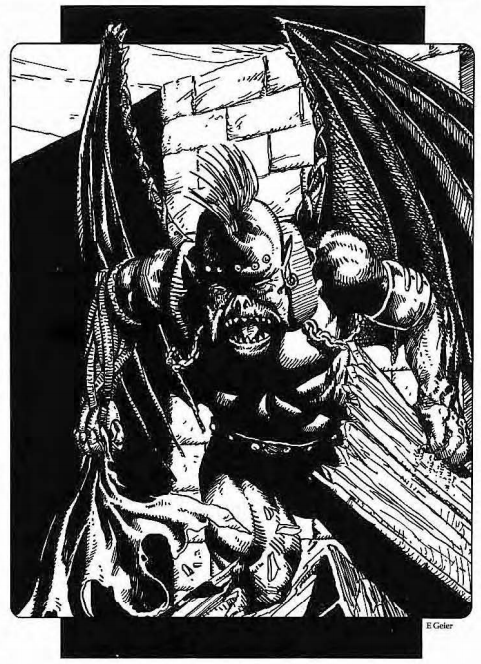
Thratchen, techno-demon and pretender to the throne
Not one to rest on his cyber-laurels, Thratchen has declared himself Regent of Orrorsh. He knows what happened to the Gaunt Man, and is trying to find Heketon while maintaining the illusion that the Gaunt Man is just "in seclusion to prepare for the next phase of the invasion". So far it's working, but the other High Lords are beginning to suspect that something's up. Currently, Thratchen's main priority is seizing the Darkness Device for himself before anyone else can get their hands on it. Slightly below that priority is killing the shit out of 3327 for causing the Tharkhold bridge in Russia to fail.
As a techno-demon, Thratchen is cybered to the gills. He has all sorts of fun toys like retractable hand blades, internal computer systems, and wing enhancements. He also has the ability to cast miracles, but these being miracles of his rather... unique culture they're rather messed up. Only two are given in this book: Mechanization turns a person into a literal robot slave for five minutes, and Animate Cables causes any cables touching a person to either tie them up or choke them.
For the sake of completeness, let's see the rest of the Gaunt Man's special followers from other books.
Kurst is a werewolf, and was the Gaunt Man's primary hunter. He's also actually Dairoga, former High Lord of Kantovia. The Gaunt Man wiped his memory after Kurst's Darkness Device abandoned him, and used him as an assassin for a few centuries. Kurst's defeat happened around 1250 BC our time, and his Darkness Device Tagharra fell into the Olmec empire and influenced the peoples of that region over the next few centuries. Over the course of the novel trilogy, Kurst regained his memories and allied himself with the Core Earth forces, and is in fact the one who threw his former master into the reality storm. He doesn't seem to know that Tagharra is on Earth, and really it's hard to say what he'd do if he did. Really, Kurst pretty much vanishes from the line after the novels, getting like a dozen mentions here and there until popping back up during the War's End adventure, a.k.a. the "shit this is the last book we have to tie up all these loose ends NOW" adventure.
Malcolm Kane is your standard-issue 90's RPG badass serial killer. He's from Core Earth, and was recruited by the Gaunt Man to hunt down the main characters of the novel trilogy. He's supposed to be hunting down Storm Knights for the Gaunt Man (like Stone was for Deadlands), but again he doesn't even get a mention in the core game line. In fact, he's barely mentioned until the adventure High Lord of Earth , where Kane learns about Tagharra and attempts to seize it for himself. Technically he dies in that adventure, so again kind of a waste.
Lastly, there's Utherion. He was (technically) the most successful of the Gaunt Man's lieutenants, in that he was allowed to become a High Lord. Specifically, he became High Lord of Aysle, but in a rather roundabout way. The Gaunt Man convinced him to let his soul be removed from his body, at which point he possessed the queen of Aysle, Lady Pella Ardinay, and attuned her body to Aysle's Darkness Device. This didn't work out too well for him; during the novel trilogy he was ousted from her body. It turned out that the bond between a person and the Darkness Device is tied to the body, not the soul, so now Utherion is stuck trying to find a new body to take over so he can re-attune to the Darkness Device, which is still bound to Ardinay. We'll see more of this once we get to the Aysle cosm book.
With that little detour taken care of, it's time to discuss The Structure of Orrorsh. This section starts out with close to a page of Kurst monologing in a very unnatural manner about the overall tone of Orrorsh's power structure, and if you think you're strong enough try and get through this:
Kurst posted:
"Know that fear rules Orrorsh. The Gaunt Man made it no secret that he drew his power from Heketon, the Darkness Device of Orrorsh. He let all under his command know that it is fear that appeases the device, and that he received the device's favor for creating fear on Gaea and Earth. In turn, whichever subjects created fear on Gaea and Earth would receive rewards from the Gaunt Man. Orrorsh became a pyramid of fear, with zombies vying to create fear beneath the powerful vampyres, each creature supporting the fear of the greater monster above it. Atop the pyramid rested the Gaunt Man. Above him, floating just over the pyramid's peak, was Heketon. The entire structure served the Darkness Device; it was the system's sole purpose.
"You ask me what the organization of the Gaunt Man is. This is hard for me to put into words you know, for your minds, your world, are used to organizing the world. The point of organizing the world is to remove fear. You catalogue the stars, name all the animals, study the motions of the planets so that they are no longer mysterious. You, Bryce, your people, from what you have told me, created a government based upon logic and social law. Men gathered and debated. The government arose out of rational arguments.
"This is not the case of Orrorsh. Orrorsh is a place of fear. It is a place where fear rules, not rational thought. The notion of having a regulated bureaucracy has no place in the Realm. But still, there are positions of power in Orrorsh. Not always of authority, mind you, but of power.
"Ruling Orrorsh is the Gaunt Man, the High Lord of the Realm. He draws his power from the Darkness Device, and all of his minions were taught this. The Gaunt Man made this clear to his minions so they would not try to overthrow him - every one of the Gaunt Man's servants knew that without the power of the mysterious Darkness Device to support him, he had little chance of challenging the Gaunt Man.
"The Gaunt Man is the mastermind of Orrorsh and its invasions. It is he who decides what core areas of an invaded world the horrors attack next. He decides who sits on the Hellion Court, which of his minions rules different parts of the realm, and which corrupted souls are assigned to what creatures.
"As to his methods of invasion: It is his policy to 'soften' an area with random attacks of terror in an area he wants to conquer. He destabilizes the government with mysterious murders of political leaders, and supernatural slaughter of the general populace. From what I understand Thratchen has followed this policy and shown its effectiveness within the borders of Thailand, Cambodia, and Vietnam. He has used zombie death squads to spread fear and panic throughout the general populace and the governments of the nations. The supernatural elements tended to confuse the people who confronted the zombies.
"In one of the nations, Vietnam I think, nationalist forces captured and studied a zombie. Did this calm the people who studied the creature? Certainly not. For in your world such a monstrosity brings every underlying precept of the nature of reality into question. You have all spent so much time on Earth figuring out how reality really works. When confronted by a creature that defies all you know a sense of dread passes over you. One of the scientists who studied the zombie, Dr. Nu Pham, took his own life after studying the creature. In his note he wrote - 'How can we survive the invasion? They have the power to create the horrors that mankind dreams. As mirrors of our subconscious such monsters were ours to control. But as physical realities ... ? - No. We are doomed.'
"You may think that since Vietnam has heard about the invasion in the East Indies the impact of monsters running through their countryside would be lessened. This is not the case. Until a person sees a monstrosity with his own eyes or holds in his own arms the body of a loved one killed by a creature of Orrorsh, there is a denial of the reality of such beings. I saw the same thing occur on Gaea, for the citizens of Victoria believed that the colonists of India and the New World were reading to intense loneliness when the first reports of monsters started filtering back to the Mother Country. It was not until the creatures overran the continent that the full impact took place.
"Of course, if the High Lord sends too many monsters into the areas to be "softened" then the impact is lost. People become used to the beasts and terrors. For this reason the Gaunt Man, and now Thratchen, keeps tight control on which horrors are sent where. No Nightmare is allowed to send any creatures outside of his province without the express permission of the High Lord, and this is rarely done. It is usually members of the Court or their assistants that are sent on missions outside the realm.
"The Gaunt Man has no concern for taxes or any other monetary wealth. He does not want tribute or glory or the respect of his allies or enemies. He only craves power. And he generates this power through the fear his minions create."
- from a transcript of an interview with Kurst, a former servant of the Gaunt Man

While the realm is ultimately controlled by the Gaunt Man and Heketon, the actual "control" of Orrorsh is done by a group known as The Hellion Court. They're the power level below the Gaunt Man himself, and report directly to him. The Court consists of powerful supernatural creatures and power-hungry morals whose job it is to maintain the atmosphere of constant fear throughout the realm. The membership has shifted throughout the centuries, but it always consists of the most powerful nightmares of the realm.
Since the Gaunt Man's disappearance, Thratchen has instituted some personnel changes to the Court, eliminating those he didn't trust and paring it down to five members:
- Baron Victor Manwaring is a vampyre, and the newest member of the court. He had been demanding the Gaunt Man allow him to join the court, but it wasn't until Thratchen took over that he was elevated to the big leagues. Victor knows that Thratchen is actually running the show, and will do whatever it takes to keep Thratchen in charge so he can maintain his position.
- Basjas is a giant, intelligent spider, but she can also change her shape into that of a young girl or an attractive Victorian woman in her early 30's. She's one of the oldest and most powerful of the members of the Court, and is the only one who knows what actually happened to the Gaunt Man (since she watched it happen from the shadows). She remains loyal to the High Lord despite this, and is assembling a power base to oust Thratchen for when her true master returns.
- General Avery Wellington is one of two "normal" humans in the Court, albeit one granted supernatural strength by his former master. He's the commander of the Victorian forces in Majestic, and his role under the Gaunt Man was to lead his forces to "victories" over monsters as needed to keep the spark of hope alive in the Victorian populace. Wellington isn't really loyal to the Gaunt Man or Thratchen; he's happy to serve whoever's in charge as long as he can maintain his power and feed his desires.
- Lord Stanton Cheltenham is the other "human" member of the court, and is over 300 years old. He is highly placed in the Victorian government and was instrumental in allowing the Gaunt Man to expand as easily as he did by convincing the Victorians that reports of the supernatural from the colonies were just "superstitious rubbish". Cheltenham is an accomplished occultist, and spends most of his time researching new rituals to inflict on people.
- Parok is a ravagon; a species from a dying world that had pledged their loyalty to the Gaunt Man. Ravagons are winged lizard-like primitive warriors with the unique ability to track P-rated people by their "possibility signatures", and as a result are used by the Gaunt Man to hunt down storm knights. Ravagons is another of those concepts that were introduced in the novel trilogy but wound up being mostly forgotten as things went along.
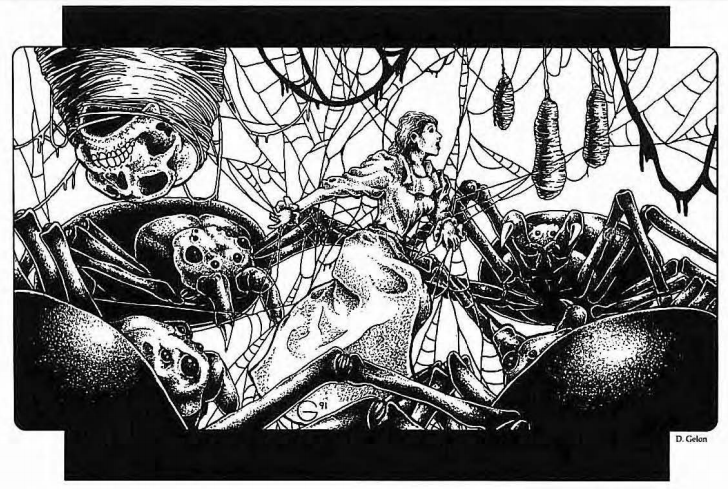
Basjas has a guest over for dinner.
The majority of the Gaunt Man's empire is controlled by beings collectively known as Nightmares. Each Nightmare controls its own territory as assigned by the Gaunt Man himself. There are hundreds of Nightmares throughout Gaea, and the Gaunt Man brought down about 200 Nightmares to control the Orrorsh realm, and has spread them across the islands to start building up the atmosphere of terror.
A few of the more active Nightmares are listed:
- Ahjebax is, and I quote, a "giant mound of pus and ooze". He has been assigned the area around Jakarta, and moves through his territory via a series of underground tunnels he's dug under the city. His creatures tend to be as formless and disgusting as himself. Ahjebax is also an accomplished sorcerer, and used to be human until his meddling with Gaean dream spirits resulted in his current form.
- Dr. Willhem Sconce lives in an appropriately spooky castle close to the southernmost point of the Majestic colony. Originally, Dr. Sconce was attempting to meld science and occultism to find a way to stop the Gaunt Man's forces, but his experiments drove him insane and into the service of the man he was once trying to stop. Dr. Sconce is the prototypical mad scientist, constantly experimenting in the reanimation of dead tissue, usually after assembling monsters from parts of his victims.
- Sabathina is one of the oldest vampyres in Orrorsh, having come from a world conquered by the Gaunt Man eons ago. She controls the northeastern edge of the realm, and is attempting to gain power while not looking like too much of a threat to the other Nightmares. She maintains a core power group of ten vampyres from her original home cosm, and bolsters her numbers as needed from the populace.
- Skutharka is the three-meter tall wolf-man that controls Singapore. Formerly close to the bottom of the Nightmare power structure, his fascination with Core Earth's "cutthroat corporate culture" has combined with his fascination of Thratchen's techno-horror nature and resulted in a meteoric rise in power. This is because, instead of utilizing "normal" methods, Skutharka has begun twisting "mundane" Core Earth technologies into new sources of fear that flourish in Core Earth's urban environments. He's set up shop at the top of one of the largest business skyscrapers in the city, where he "plays businessman" like a kid would, doing things like grabbing dead phones and having fake business conversations into them. His personal assistant is a Core Earth Chinese martial artist known as Mr. Ho.
- Patches doesn't get any real mention until the Creatures of Orrorsh sourcebook, but all you need to know is that he is a demonic killer clown. Because there's always a demonic killer clown.
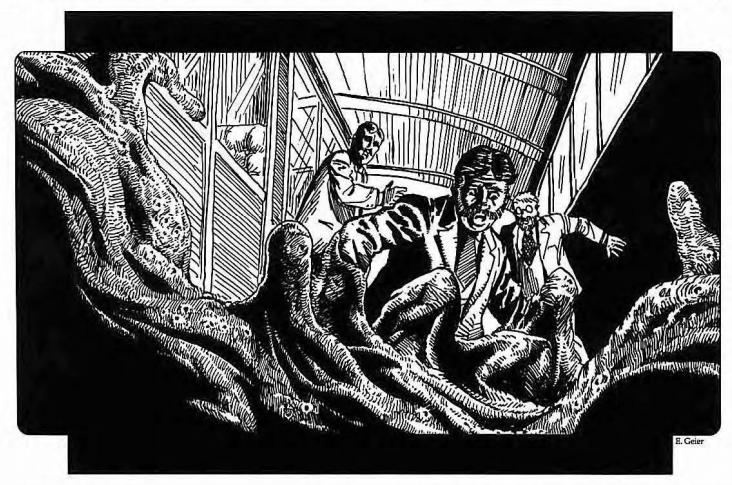
It creeps, and seeps, and glides and slides across the floor...
Now, given how many creatures there are running around, the question arises about how this whole system actually works without collapsing in on itself. The answer to that is what is referred to as the Ecology of Fear.
quote:
Unlike the other realities that have invaded Earth there is no room for a true society in Orrorsh. Societies are designed to provide comfort and structure. Comfort and structure discourage fear, and since it is fear that Heketon wants, society has no place. However, a High Lord and his Darkness Device draw power from the possibility energy drained from people living in the realm. If the monsters and terrors of Orrorsh are too fierce and chaotic and destroy too much of the planet's population then the invasion is for nothing, for there is no more energy to be drained. On the other hand, if the monsters are too organized, like the Cyberpapacy or Dr. Mobius' Empire, then although they are strange invaders they produce less fear. Much fear rests in the unknown. An army of werewolves might be terrifying at first, but soon they are no more frightening than any other army. The horrors of Orrorsh are the terrors of the dark comers and footsteps walking behind you late at night.
It's taken him centuries, but he finally managed to hit a state of equilibrium where the entire system is self-sustaining. The monsters of the realm do not actively fight each other for territory anymore, and can focus on the humans. The humans, meanwhile, have just enough hope to keep fighting back, but not enough power to win.
The whole system runs off three points, which the Gaunt Man has transformed into Orrorsh's world laws: The Power of Fear, the Power of Corruption, and the law of Eternal Corruption. I touched on these in brief back at the beginning of this book's posts, and will get into more detail on them next chapter.
So where do all these beasts and monsters come from? It turns out, from a bunch of places.
Monsters of the "Nightmare tier" or higher are capable of creating monsters on their own, and they tend to do so quite often. Generally these monsters follow the thematic mold of their creators; Ahjebax creates ooze-like monsters, Dr. Sconce creates patchwork creatures, and so on. This is where a good chunk of your "fodder" monsters come from.
Humans can become horrors if they tap into the Power of Corruption enough times. Once someone has taken advantage of the Power of Corruption for any reason, when they die they will have the option to enter the Gaunt Man's cycle of reincarnation and keep coming back to the world instead of going to the afterlife and receiving his just deserts.
Third, some horrors can turn humans into other horrors against the person's will. This is the purview of vampyres, werewolves, and things of that kidney. It's interesting to note that then a person is transformed this way, they're not subject to the reincarnation cycle. Instead, their soul is released to whatever afterlife awaits it, and a waiting corrupted soul is taken from Heketon's "storage" and used to animate the body. Interestingly, this means that every horror has a soul of some sort, even lowly creatures like zombies.
Lastly, there's "wild horror". Wild horrors are very rare, but no less dangerous. These are horrors that are created on their own, with no guiding hand other than the general belief of the humans of the area and the local magic and fear levels. Wild horrors tend to not slot into the Ecology very well, but the Gaunt Man and Heketon find them useful to give the humans a target they can fight without knocking the rest of the system out of whack.
quote:
A prime example of "wild horror" is the fortress of Muslim zombies that sprang upon Majestic's northern shore when the reality of Orrorsh washed over the land. The zombies are the corpses of Muslims of Earth desecrated by Portuguese sailors hundreds of years ago. The souls of the zombies are the same souls of the Muslims who died hundreds of years ago. Orrorsh is not part of controlling this terror. The zombies are acting on their own will. The arrival of Orrorsh only acted as a catalyst for the creation of the zombies.
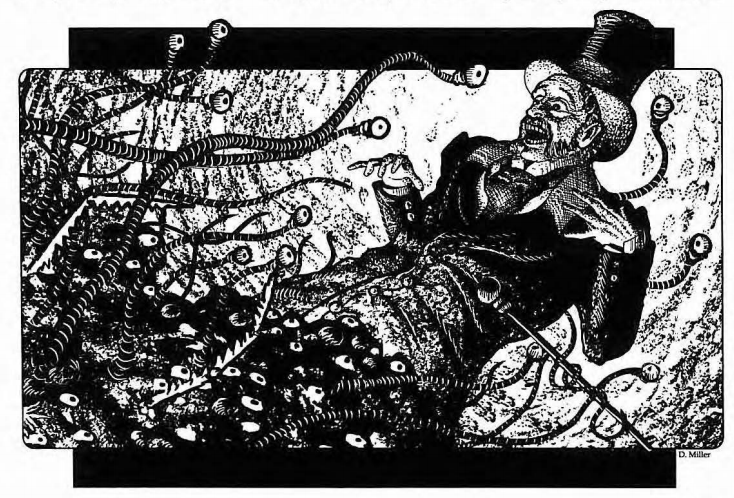
I say!
One thing that does need to be pointed out before we close this section out is the concept of Strong Life and True Death.
As pointed out, the horrors of Orrorsh are technically immortal. When they are "killed", their souls are fielded by Heketon and sent to special storage zones known as Waiting Villages. There, the soul waits for a new body to become available through one means or another, and once that happens it just re-enters the world and picks up where it left off. Corrupted souls can "degrade" if they reincarnate enough, but that's just survival of the fittest. As souls become weaker, they get put in less and less powerful bodies until they are so worn down that they just remain in the Village, used for nothing and feeling nothing.
In order to keep his monsters in line, the Gaunt Man instituted the rule of the True Death. Every corrupted soul has one specific weakness that, if used on a horror, will kill its soul off for good and send it straight to the afterlife. Sometimes it's well-known (stake through the heart for vamps, silver for werewolves, destroy the head for zombies), but for the more individual horrors it's going to take some research to figure out what the monster's weakness is. And even then, it's probably not going to be easy to do. For example, Basjas needs to be wrapped in her own webs for three days (at which point she will die), Skuthharka must be decapitated and have a mixture of bee's honey and rose petals poured down his throat, and General Wellington must be killed at sunrise in a one-on-one duel.
The more powerful Nightmares go to great lengths to keep the methods of their True Deaths hidden (for obvious reasons). The longer a horror can stay in the world, the more powerful it gets, and the hard it is to kill. Even a non-True Death death is a major setback, the first step in a downward spiral towards becoming a forgotten voice in a Waiting Village. Every horror knows this; the Ecology of Fear is a world of survival of the fittest, and a moment's weakness towards stormers or other horrors can result in a loss of rank and territory. Every Nightmare knows, deep down, that all it takes is one misstep to fall out of favor and wind up in Hell...or worse.
It's very rare that a Nightmare realizes that it's trapped in the same web of fear as the humans. And when one does...the Gaunt Man just laughs.
NEXT TIME: People, places, and... things.
Victims
Original SA post The storm has a name... - Let's Read TORG
Part 14c: Victims
This is the second half of the "Realm of Fear" chapter, and is a discussion of the various people that now inhabit the region and the organizations that drive Victorian society.
And, well...we gotta get something out of the way first.
quote:
Besides the creatures of the night that the Gaunt Man has brought down the maelstrom bridge, there are several groups of people who have travelled down the bridges of their own volition. They have come to Earth either to war with the Gaunt Man so as to prevent his gaining more power, or to escape the terrors of Victoria and forge new lives for themselves on the relatively safer world of Earth. These groups are the Victorians, the Gypsies, and the Swamis. Although each group means well to the people of Earth, the fact that they are from a different world with a different history and reality often leads them to make mistakes when dealing with people from Earth. Sometimes these mistakes only lead to bad feelings between groups. Other times they lead to blood.
But before we get there, we start by discussing the Victorians themselves.
We've already gotten a pretty good broad view of the Victorians and their culture. Their society is pretty much based around the idea of "inherent superiority", and this mindset has driven them for centuries even before the Gaunt Man showed up. This tends to manifest in what can best be described as proper behavior. All Victorian citizens take everything in their lives very seriously. From speech to clothing to day-to-day action, everything must be done with dignity and decorum and utmost seriousness. To do less is to let down the Empire.
One of the main reasons for this is the Sacellum , the religion of the Victorian empire. The Sacellum shares some similarities with Evangelical Christianity, but...more so.
quote:
As Mr. G. M. Young writes: "Nor can it escape the notice of men that the virtues of a Sacellum model are easily exchangeable with the virtues of a successful merchant or a rising manufacturer. To be serious, to redeem the time, to abstain from gambling, to remember the Sabbath Day and keep it holy, to limit the gratification of the senses to the pleasures of a table lawfully earned and the embraces of a wife lawfully wedded, are virtues for which the reward is not laid up in Heaven only."
Unfortunately, that same righteousness also colors their dealings with other races. The Victorians see, well... non-whites as "primitive peoples", and as such it is their moral duty to "introduce civilization into their lives", generally at gunpoint. Even members of other races that have acclimated into Victorian society at large are treated terribly.
Not that life for the domestic lower classes is a lot better. The working classes live in squalor and poverty, working 12+ hour days, six days a week to barely feed themselves. The slowly encroaching industrial revolution has begun putting small tradesmen out of business, and working conditions are worsening. And thanks to the Gaunt Man's control, the Social axiom of Gaea is just shy of the point where people would be able to come up with the idea of unionization.
Next, we learn about The Victorian Majestic Charter . The Charter was hastily created shortly after the Victorians went over their bridge, both as a means of controlling this new colony and as a desperate attempt to get the Victorian economy moving again (since there's no way for them to get any kind of external resources back home).
The Charter was created and is managed by a consortium of 112 investors, very few of whom actually live in Majestic. The real control is by a board of 12 investors, and they're the ones who are plotting out the expansion and exploitation of the colony.
One board member of note is Samuel Benford . Benford is one of the few members of the consortium who actually lives in the colony. He's also pretty much the only one who who's figured out that the Indonesians are more advanced than the Victorians. As stated previously, the Victorians think that all the advanced tech and buildings and roads and whatnot were left behind by white settlers and subsequently stolen by the "natives". As a result, he's become something of an obstacle not only for the rest of the investors (who just want to profit by any means they can), but also for the military (since he's keeping a record of every infraction and war crime they commit). The only reason he hasn't met an unfortunate "accident" is that he's one of the primary money people in the consortium.
The military arm of Majestic is run by Governor Robert Ashton , a violent man who's gotten very close with General Avery Willington. Ashton has been experimenting with the occult, and has been completely corrupted. He's not a horror yet, but when killed his soul will be heading straight for a Waiting Village so he can step up to the big leagues.
Below Ashton is the expected military structure. The book (once again) goes into unnecessary detail about this, so I'll just summarize.
There are only a few hundred regiments assigned throughout the Majestic colony, and they're having an uphill battle. Victorian military units tend to be smaller than their Core Earth equivalents due to the one-on-one nature of battling Horrors. Regiments tend to be split between taking new territory and defending existing cities from attacks by Horrors. For the most part, the regimental commanders haven't been corrupted yet...but given that they all answer to Ashton it's probably only a matter of time before the rot spreads through the whole army.
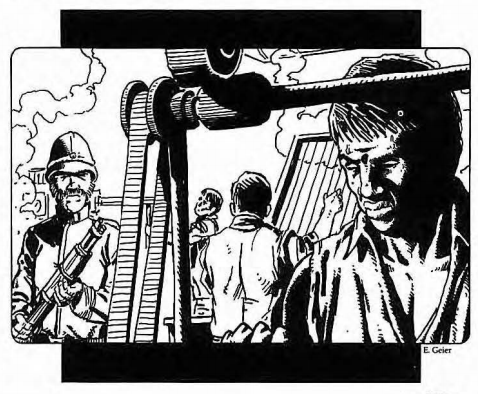
You have to watch the working classes like a hawk.
One interesting thing about Victorian society is that there's little to no leisure activities, or really any sort of "release valve" on people's emotional needs. The culture is morally and socially strict to the point where tablecloths are required to be long enough to completely hide the table's legs, lest the sight of something even resembling a woman's leg send a man into a spiral of depravity that damns his very soul. And according to the Sacellum, the moral failing of one soul would spell doom for the whole culture.
quote:
To obtain a pure spiritual community the Sacellum discourages certain ideas: free thought, free expression, art that encourages free thought, art that encourages free expression, anything to do with the notion of sex, anything to do with religion that does not reflect the accepted dogma of the Sacellum (that is, anything that does not present a male, white god ruling the people of earth through his chosen male white representatives), anything to do with magic or any element of the imagination (for it is believed that the slightest thought of anything but the true Sacellum will lead everyone to worship the evil Gaunt Man), and so on.
In Victorian society, this has resulted in the birth of many secret societies dedicated to exploring such dangerous ideas such as philosophy, studying other cultures, or creative writing. Oh, and the secrets of the occult, of course.
Oh sure, the majority of the secret societies are ultimately harmless. They revolve around things like reciting poetry, or discussing scientific ideas, or learning to draw nudes because that's how you actually get better at drawing people. But there are some that are focused on studying the monstrosities of the world, either to fight them or to tap into their power. But as far as the Sacellum (and, therefore, society at large) is concerned, there's no moral difference between a society dedicated to learning how to bargain with demons and a society dedicated reciting poetry about flowers. So every society has to meet in utter secrecy, with the associated call signs and handshakes.
Three sample societies are given in the book:
-
The Sanctum
is focused on the study and cataloguing of knowledge. Not just occult knowledge, but any form of scientific thought not accepted by the Sacellum. The members always wear full-body robes when they meet, meaning they're one of the few societies that allow woman to join (since nobody knows they're women).
-
The Sign of Six
is a heavily militant society that actively fights the horrors of Orrorsh. They work very heavily in isolation, so that if one of their members falls to the Power of Corruption he won't bring the rest of them down with him.
-
The Order of the Purple Eyes
is a straight up horror-worshiping cult. Its sole purpose is to increase the power of its members by dark means.
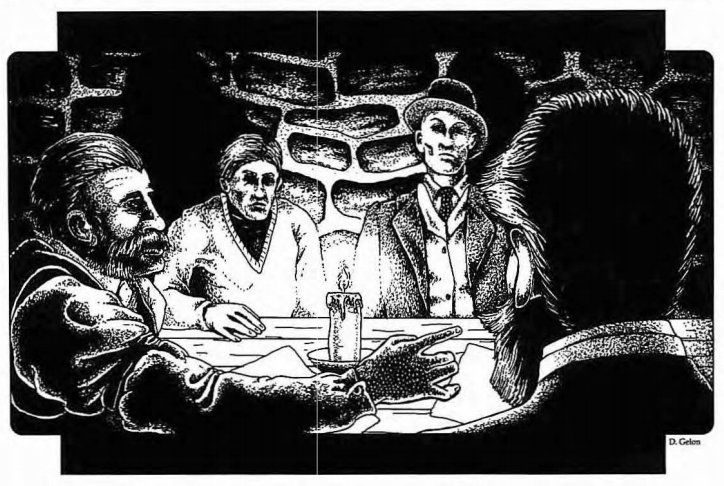
Occult conspiracy, or creative writing circle?
Finally, we get to The Sacellum itself.
The Sacellum was originally a variant of Catholicism, discovered by the Victorians when they took over the Roman Empire and discovered the apostles therein. The Victorians quickly adopted the religion for their own use, adjusting things here and there to match their own mandate-from-heaven mindset.
Even in the beginning, the Sacellum was a very rigid theology. The church was not to be questioned at all, and nobody was allowed to question the faith or its methods. It should come as no surprise that non-supernatural corruption was rampant throughout the power structure of the Sacellum for centuries.
That said, in the 16th century, there was almost change in the church...and then the Gaunt Man showed up.
quote:
This religious institution began crumbling in Gaea's sixteenth century when a German monk, Thomas Moss,
demanded reforms within the church that gave greater power to the people. Moss' reform movement began slowly, but soon had a steady, firm momentum.
What might have been an even more successful version of Earth's Protestant movement was derailed by the
arrival of the Gaunt Man. He saw the reformation movement as chance to make a corrupt institution more corrupt than it was before. When the people of the Victorian Empire began to panic as strange creatures were spotted around the globe and horrible murders were committed without any explanation, a cry went up from the people for a religion that could save them from the influence of the devil.
Bishop Gyre Todd, a member of the religious reformation, was working in the colonies of North America when the invasion was just beginning. A sincere but harsh man, he began adopting cruel tactics to keep his followers on a spiritually pure path. Slowly the Power of Corruption seduced him. Eventually the Gaunt Man himself appeared before Todd in the guise of an angel and declared him the new chosen prophet of god. The Gaunt Man then gave Bishop Todd a manuscript written in Greek that appeared to be written on ancient vellum. The angel told Todd that is was a more accurate translation of the New Testament than that which the Victorians had used for the last sixteen centuries.
Bishop Todd preached this gospel across the empire, stating that the influx of demons and horrors was a punishment from God for misunderstanding His message. Desprate for anything that might stop the flow of monsters, the people flocked behind the new gospel, and it was worked into the reform movement. Soon the new Bible was officially accepted by the church, and was preached to the people.
Which, of course, is what the Gaunt Man wanted. While the Sacellum does offer a glimmer of hope to the Victorians, it's a false, stifling hope. It's a sort of spiritual bureaucracy, forcing people into rigid lines of thinking and reinforcing the idea that its members should just follow rigidly-defined behavioral procedures to be saved, as opposed to performing good works or considering the nature of their souls.
Not helping matters is the fact that despite the moral inflexibility, the Sacellum doesn't have a consitent overall structure. There's no central papal figure; instead the the church is run at the top level by numerous bishops, each with varying levels of power. On top of that, the church itself is split into hundreds of diocese, each of varying size and none really reporting to any of the others. Without any sort of central authority, the "official" solution to the problems that arise is "just do what we did yesterday", even though yesterday didn't fix anything either. Each diocese ends up having to deal with problems on their own without guidance from a central figure, so every diocese ends up being just different enough to make working together difficult.
What this all means that the Sacellum is a strange mix of moral inflexibility and organizational splintering. The Sacellum is pretty much incapable of real change for a lot of reasons, not least of which is because they're terrified of God's wrath should they try to change.
False hope may be better than no hope, but not by much.
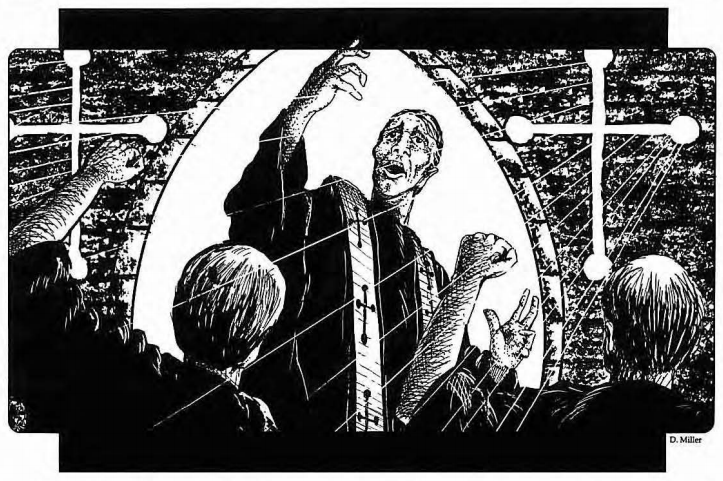
Repent, O Ye Sinners!
And now...this part.
quote:
The Gypsies of Gaea come from Rumostria, a nation of undead located in Europe. To sate their need for blood and flesh, the undead inhabitants raise humans like cattle. The Gypsies are those humans who have managed to escape the pens. They are scattered throughout the world of Gaea, hunted by monsters but shunned by the Victorians. When the bridges opened up from Gaea to Earth the Gypsies took flight, hoping to find safer lands. While Earth's Southeast Asia is safer than Gaea, the Gypsies are still locked in conflict with the terrors of the Gaunt Man.
quote:
They have a great many songs celebrating the life of motion that they lead. They are also a people given to telling stories and fantastic tales.
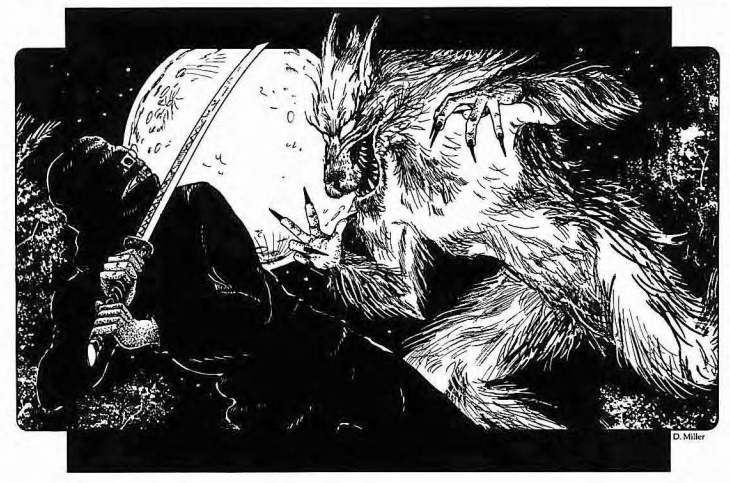
As a palette cleanser, here's a ninja fighting a werewolf.
The last part of this chapter is about swamis , and here they mean Gaean swamis. Gaean swamis are the holy men of the Findaru religion, which is based around the concept of escaping a repeating cycle of reincarnation through meditation ( gessa ), adherence to the Tov scriptures, and devotion to a swami.
quote:
The Tov scriptures are the holy writings of the Findaru faith. They describe the universe as being made up of one god, Harat, though this god has divided itself into many parts. Because of this it is possible to worship certain specific parts of god at a given time. A faithful Findaru, for example, might ask aid from the creative portion of Harat, or the destructive portion, or the portion that is in charge of prosperity and good fortune.
The holy writings state that all living beings are reborn again and again through reincarnation. What a living being is reborn as depends upon what sort of life the creature led. The better the life lived, the farther advanced the reincarnation. The ultimate goal is to leave the cycle of life and become one one with Harat. Since Harat is the god of "all knowledge" the path to joining him is to master the truths of the universe. Primary among these truths is the fact that all beings are already part of Harat - it is only a self-deception, an illusion, that any living beings are separate from Harat. To understand this one must practice gessa, adhere to the Tov, and study with a teacher who is well on his way to pulling aside the illusion of separateness.
Because they know the nature of the beasts, as it were, they claim that horrors are not part of Harat. In fact, only living beings born of Gaea or those who convert are considered part of Harat; anyone else is an outsider. That said, they are very welcoming to anyone who is willing to convert. They're even accepting of the Victorians, who consider them backwards heathens.
quote:
But the Findarus do not hold a grudge against the Victorians. To the Swami's eyes the typical Victorian still has an infinite number of reincarnations to go, and is someone to be pitied.
---
Man, that was all way too much goddamn setting . I had to split this chapter into two posts just because it was getting so huge.
This chapter is just all over the place. It talks about the Gaunt Man himself, his council, assorted bad guys, the Ecology of Horror and the world laws, and everything you could possibly know about everyone.
There just comes this point where the information becomes white noise, and Torg's never had a problem crossing that line over and over again. Like, do I really need to know the exact breakdown of the military structure to the point where I know how many people of what rank are in a company versus a regiment? Does the church's history really need a page and a half of backstory? Knowing where stuff comes from is useful, but what's more useful is what it's like now .
NEXT TIME: Feeding the vicious cycle.
The Architecture of Fear
Original SA post The storm has a name... - Let's Read TORG
Part 14d: The Architecture of Fear
Time to start sinking out teeth into the mechanics of the realm, which means we need to more closely examine the axioms and world laws.
Magic Axiom: 15
Orrorsh is the second-most magically infused realm out of all the invaders. The high magic axiom is needed to fuel horrors, but in practice "normal" Torgian magic is pretty rare. It's certainly possible to learn and prepare a normal spell under Orrorshian axioms, but finding an actual spell in the first place is very rare. Instead, magic in the realm takes the form of occultism , a freeform ritual magic system. Occult rituals can actually be performed by pretty much anyone, even without access to magic skills, and will be covered in more detail in a few chapters.
Social Axiom: 20
This is only a single point behind Core Earth (axiom 21), but despite the narrow difference Victoria is remarkable backwards by Core Earth standards.
Victorian society is highly bureaucratic and heavily structured. "A place for everyone and everyone in their place". Unfortunately, unless you're a straight white Victorian male said place is at the bottom of the social ladder. Women and members of other races do not have the right to vote, cannot own property, and for the most part cannot hold jobs of any import. Even in a reality constantly onset by monsters of every conceivable stripe, non-white-males are pretty much treated like shit. An African man could kill a vampyre in front of Parliament and would be lucky to be given a pat on the head.
There is the beginnings of social equality movements in Victoria and Majestic (mainly due to the culture being forcibly exposed to new ideas), but the Sacellum ain't having none of that, and is working hard to prevent the movement from gaining even an inch of ground.
Likewise, the poor are treated horribly. Child labor has not been outlawed, and while there is industrialization the concept of "workplace safety" hasn't caught on yet. Children of the lower classes tend to start having to work around the age of eight, leaving no time for education. Not that the upper classes want the lower classes to become educated; it'd just give them ideas above their station.
Spiritual Axion: 17
Interestingly, Orrorsh is tied with the Nile Empire for the second-highest Spiritual Axiom (first is Living Land at 24). This is because this is the level needed to support the whole soul-recycling thing the Gaunt Man has going on; you need to have everyone accept the concepts of the soul, redemption, and damnation for it to all work. Priests of the Sacellum and swamis are capable of performing miracles.
Technology Axiom: 19
The Gaunt Man has capped Victorian technology at its current level, but really that was more of a formality than anything else; the Victorian mindset did most of the work for him. Because anything made by not-Victorians would be inherently inferior to Victorian knowledge, it was fairly common for the Empire to invade cultures that were more advanced in a particular field and then throw out any new ideas because they were made by backwards barbarians.
The main thrust of Victorian technological advancement has (unsurprisingly) been in the field of weaponry and military technologies. Bolt action rifling techniques are fairly new, as are hand-cranked machine guns. Very little development has been made in the field of heavy weaponry or artillery, but this is mainly because most major horrors are singluar monsters, and a slow tank isn't that useful against a vampyre or werewolf that can run rings around it.
The automobile has not been invented yet in Orrorsh; instead people still rely on horse-drawn carriages for short-distance travel and steam engine locomotives for long-distance. The Victorians have been building a railway line along the western edge of the Majestic colony with the "assistance" of the native Indonesians.
Electric power exists, but doesn't see heavy use. Houses use gas lights instead of electric, and all home appliances are hand-powered (preferably by a servant).
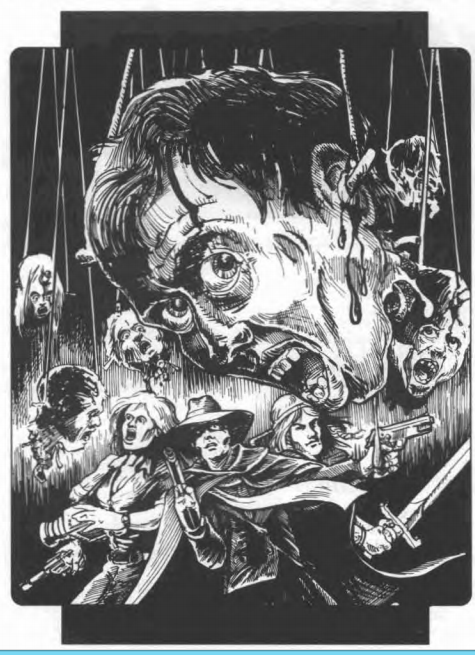
Sometimes Orrorsh isn't very subtle.
And now the World Laws. We've covered these a few times already, because all the backstory information kind of keys off them. Still, in this chapter we dig a little deeper into how they work and intermingle into the Ecology of Fear. One thing that's important to note is that anyone in Orrorsh is subject to these laws, even if otherwise protected by a reality bubble.
The Power of Corruption is the means by which the Gaunt Man tempts people into the downward spiral of evil behavior.
quote:
An act of true evil in the environment of a role-playing adventure is often difficult to adjudicate. This is because adventurers and heroes are often in dangerous situations where lying, killing, and stealing is either necessary or an accepted pa.rt of life. Whereas most of us live in a society that considers murder reprehensible, the state of war that exists on Earth sets up a separate set of ethics for people directly involved in the conflict. These ethics state that killing the enemy is at worst a necessary evil, and at best a just and heroic action. The human soul, even in war, often views killing as evil, no matter what the conditions.
The book tries to define what would be a "necessary evil" (while escaping, only killing guards when you have no choice; setting one of the group as bait to draw out a flesh-eating monster) versus "unnecessary evil" (killing everyone you come across during your escape; using some innocent person as bait), but it seems like a strange time to start bringing in a morality system of this nature. At least it's one that probably wouldn't require a lot of arguing about the nature of evil or whatever.
Anyway, when a person commits a Wicked act they get an automatic up boost (an additional free roll-and-add on top of whatever they would get otherwise). In addition, they get a brand-new "skill": corruption .
Corruption isn't really a skill per se , but more of an overall counter of how evil you've been. The first time you commit a Wicked act, you get the skill at a rank of 8, and every Wicked act after that will get you from one to five Corruption points. Stealing food from a starving family is worth one, torture is worth two, and "the destruction of an entire city" is five, so it's a bit of a sliding scale.
After committing the act, the character has to make a Corruption roll against a difficulty of 12. If the player "succeeds" at the roll, then the character gains a physical sign of his evil nature. The higher the success level, the worse the change. There are four "tiers" of changes, and you can only have one per tier.
quote:
Minimal/average: red or yellow eyes; eyes glow in dark like a cat's; sharply pointed eyebrows and ears; forked tongue; open sores on arms.
Good: grows tail; eyes melt away, but the character can see normally; sores become large enough that bone is seen through the holes; a foul odor, perhaps that of a corpse rotting, surrounds the character.
Superior: horns sprout from the character's forehead; hair covers the character's body; the character's body is covered the scales of a reptile; the character's mouth becomes a snout; the character's left hand becomes a metal hook.
Spectacular: The character becomes a horror of Orrorsh. The character might become a monster (a zombie, a vampyre) or he might retain his form and work within human society as an agent of evil. The character is no longer under the control of the player and has become a gamemaster character. He is a monster, like any other monster, that must be hunted down and destroyed.
Heketon also protects those who are along the path of Corruption. Any attempt to detect Corrupt individuals or to investigate their actions can be resisted by the creature's Corruption skill. If the creature makes the roll, then the character is unable to find out anything regardless of how they were actually investigating.
The second world law is the Power of Fear , and starts with a few paragraphs with a very oddly placed defense of the fact that the Power of Fear exists.
quote:
There are two reasons that the Power of Fear exists in the reality of Orrorsh. The first reason is part of the logic of the world within the game world, the second is a logic of game mechanics, exterior to the "fictional reality" of Torg.
First, the Power of Fear exists because the Gaunt Man is very powerful and created a powerful force that weakens his enemies. Some High Lords use their power to increase their technology so they can build tougher tanks, others increase the sophistication of their reality's miracles. The Gaunt Man and Heketon, who love fear, decided to make it harder for heroes slay his monsters rather than make the monsters tougher.
The second reason is that every realm of Torg: Roleplaying the Possibility Wars should have its own distinct feel to it. The realm of Orrorsh is a place of atmosphere, of slow searches through mist-shrouded graveyards. We created the Power of Fear so that Storm Knights cannot go blasting their way through every conflict the same way they might do in the Living Land or the Empire of the Nile.
These rules make it vital that the characters spend some time investigating their opponents and introduces the risk that whenever they are facing off against a horror of Orrorsh their characters might flip out from the sheer terror of the situation. The Power of Fear also creates a situation where (hang on to your possibility energy) the Storm Knights might lose, or, at the very least, a character or two might find True Death before they stake the vampyre's heart. Again, this isa choice on our part to make Orrorsh a nasty, frightening place. Storm Knights entering this reality should be prepared to face the most challenging realm on the planet - for although he was defeated by the heroes of Earth, his reality is the most powerful and evil reality to invade our world. We're warning you ahead of time. Tarry in Orrorsh and you can assume that you have a good chance of meeting an untimely end. This is not to say Storm Knights should not adventure in Orrorsh. On the contrary, Orrorsh must be destroyed - precisely because it is so evil. But the cost for victory will be high.
Well, on reflection, that second point shouldn't be that surprising. Torg isn't just trying to be multi-genre, it's trying to be multi-tone. And that's not an easy trick to pull off. Orrorshian adventures are supposed to be really deadly and difficult, as befits a heavy horror game...but then next session you can be in the Nile Empire and mowing down mooks with narry a care in the world or consequence in sight, then you can roll over to Nippon Tech and get involved in some insane shades-of-grey espionage. On top of that, Torg claims to be "cinematic" in the sense that characters can take a lot of punishment before keeling over, even though the mechanics don't really support that idea very well.
Oh, right, mechanics. Every Orrorshian monster has a stat called their Fear Rating , which goes from 1/2 to 5, but tend to average around 3. When dealing with a creature that has a Fear Rating, two mechanics come into play:
-
Characters cannot invoke reality storms. Attempting to do so will cause the character to immediately disconnect.
-
Players cannot play for the critical moment with their cards.
quote:
If the Storm Knights unwittingly try to play for the critical moment when the Power of Fear has not been overcome, the gamemaster should let all the players put all their cards out on the table, then smile cruelly as he sweeps the cards up off the table and tells them it doesn't work. The players lose the cards. That's it. It just doesn't work.
Anyway, we now get into another long chunk of text about The Nature of Horror Stories . And I'm sorry, but get ready for another terrible text dump because I'm going to give you the full text of the section.
quote:
Take a moment to think about horror stories you have read or horror movies you have seen. In every horror story the heroes usually destroy the monster - but only after lots and lots of people have been killed in the process. It isn't just innocent victims who get taken out by the monster. In both Stephen King's Salem's Lot and the movie Alien (which is really a haunted house in space) there is a group of characters that band together to take out the unnatural menace. In Salem's Lot , only two people out of an entire town leave alive. In Alien only Ripley and Jones the cat get off the ship and back to Earth. This is what Orrorsh is like. The heroes go forth to battle the terrors of the night...but not all of them come back.
An aspect of "feel" that the Power of Fear builds into adventures set in Orrorsh is that the creatures of Orrorsh are frightening. In many roleplaying games the characters set themselves against one monster after another, but seldom do thecharacters react to them as monsters. lnstead, a zombie is usually just another entity to destroy. Now, there is nothing wrong with this. In a reality of high fantasy like Aysle, where magic is plentiful and heroes encounter the fantastic every day, it makes sense that animated skeletons or
vampyres do not faze Storm Knights. In Orrorsh, a reality built on fear, it is vital that the Storm Knights react with a difference. The rules of the Power of Fear help build this sensation.
Of course, a set of rules can't create the atmosphere alone. The gamemaster must help build the mood so that the rules fit into the reality properly.
I fully admit that I'm not a fan of the horror genre. Part of it is because I'm a big ol' coward, but it's also because horror has become a lazy genre over the years. Most of what I know about horror comes from my Halloween tradition of watching Bravo's "100 Scariest Movie Moments".
I admit that I only know it as an outsider, but it seems like most horror movies nowadays tend to be about jump scares and gore than building up a mood of any sort. The horror is more viceral than emotional.
(Side note: I love how in Bravo's 100 Scariest moments, most of it is about the amazing mood and the tension built in "classic" horror movies from the 60's, 70's, and 80's. Then they did "30 Even Scarier Movie Moments" and it was almost all gore and stuff from modern movies like Saw or Cabin Fever.)
Now, I understand that horror needs a heavy sense of threat hanging over the characters in order to work; if you know that nobody's going to die then the horror loses a lot of its impact. But at the same time, the horror of Orrorsh is either supposed to be things lurking in the shadows waiting to pick off straglers, or straight-up monster stomping. And which one it is seems to depend on which chapter you're in, or which adventure you're reading at the time.
But boiling it down to a mechanical value that doesn't have that big an impact on play doesn't really reinforce any sort of genre. So they can't use reality storms or play extra cards? That doesn't mean they can't just find out the monster's True Death and kill it by other means.
...sorry. Back to the book.
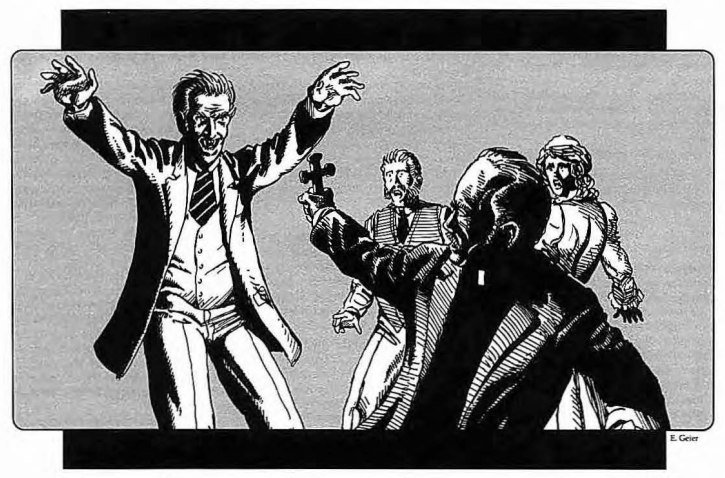
Bluh!
So every monster has this Fear value. It's (technically) a drawback because it robs the PCs of two of the tools in their arsenal. That said, I'm sure you're wondering what the meaning of the value actually is.
In order to overcome the Power of Fear, Storm Knights have to be dedicated to taking down the horror itself. This is done by generating Perseverance . Perseverance is sort of "party stat" that represents how much work the PCs have done to take the horror down.
Perseverance is used in every Orrorshian adventure, and always starts at 8. As things progress, the value will increase. At various point in the
quote:
The Gaunt Man and Perseverance
The Gaunt Man wants to limit resistance to the Power of Fear. The nature of Storm Knights is to exceed whatever limits are place upon them. The High Lord experimented with Perseverance on each new cosm he invaded. He and Heketon built a machine to sort possibilities, to gather the slimmest of chances and concentrate them, to make them real. Hundreds of stormers were carefully used, their possibilities dissected by the machine. Finally he succeeded at making real one critical aspect of Perseverance : he separated the basic ability to resist fear from the abilities and attributes of individuals. Individual actions could still affect Perseverance , strengthening it. The Gaunt Man seeks to eliminate this imperfection, but has so far failed. The High Lord is beginning to believe that such an act might be beyond even his own abilities.
Perseverance is still one of the Gaunt Man's great achievements. His horrors face the small chance of defeat, and each defeat helps convince the populace to continue the fight. Orrorsh lives in fear, not despair. That is as the Gaunt Man wishes. The small chance of a monster being slain was not as inconvenient as he first thought.
The Gaunt Man had not counted on the number of Storm Knights created by the Possibility Wars. For the first time, enough heroes exist to make the necessary sacrifices to defeat the horrors of Orrorsh. The Ecology of Horror might become unbalanced, and the final victory might slip from the Gaunt Man's grasp.
Anyway. At various points in the adventure, the party has to make a Perseverance check against a Perseverance difficulty number . Said difficulty number is usually the Fear Rating of the "endboss", but really it's the Fear Rating of the biggest threat. The Perseverance difficulty is always a secret, so that way the PCs don't know how big a threat they're actually up against. Sample difficulties range from around 10 for a single werewolf hunt to the low 20's for a cult to 27 for members of the Hellion Court.
Perseverance checks are made "when the gamemaster decides it is appropriate", but really it's meant to deprive the characters of assets and such. It's a sort of version of a SAN check; you're supposed to make people roll when the encounter monsters, witness an occult event, or come across something truly horrible.
The check is made by a flat roll, with nothing added to it. Players can't use cards or skill adds or anything, because it's a "group check". If the group passes, they're fine.
If they fail , then the monster gets fear points equal to the amount the roll missed by, multiplied by the number of PCs. So if a roll fails by 3 and there's five people in the group, then the monster gets 15 fear points. That's a lot , as we'll see in a moment.
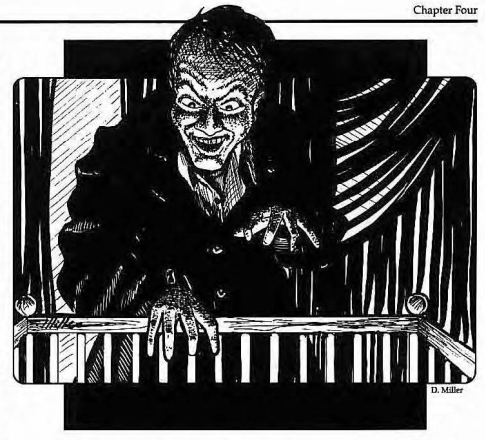
Pictured: what GMing Orrorsh should look like.
Fear points must be spent immediately, and spend to do the following:
For one fear point, a creature can take a card from any player's pool, stymie a PC, or spend an extra Possibility for a roll-again.
For two fear points, a creature can give its side an up result, cause someone to suffer a setback from fear, or mark a character for death (they can't spend Possibilities to remove damage).
So let's go back to that failed roll. 15 points to spend means that a horror can prevent all five characters from negating damage for the remainder of the scene and take one card from everybody. Because they missed a roll by 3 points.
I'm sorry, that's fucking ridiculous . There's making things hard on the group because of genre, but this is pretty stupid. Especially since the GM is supposed to be making checks all the time.
The way to raise the group's Perseverance is basically by doing monster hunter-y things. Researching the monster in quesiton, winning fights against minions, helping people, things like that. They also gain Perseverance when the monster kills NPCs that the heroes couldn't defend. The group can also lose Perseverance by losing fights, PCs getting killed or seeing horrific things they couldn't prevent. Of course, there's no guidelines for how much Perseverance to reward or take away apart from "between one and five points", and the GM is expected to put together setpieces to make sure the players can gain enough Perseverance to overcome the monster's Fear Rating.
Once the group's Perseverance score hits the adventure's Perseverance Difficulty + 12, they have overcome the Power of Fear and are no longer subject to fear points or the Power of Fear. (the +12 is because the lowest possible rolled modifier is -12; when they reach the Difficulty+12, they can't mechanically fail). Note that you're not supposed to tell the group they've overcome the Fear, I guess they're just supposed to guess when they can invoke storms and such.
The rest of this chapter is more GMing advice on this whole convoluted system. One is that you shouldn't let players game the Perseverance system by doing things like setting NPCs up to die so they can feel bad about it and become more determined. The other piece of advice is about splitting up the group, and is about how to encourage this.
See, in a good horror story, everyone always splits up, right? Yeah, I know it never works out well for them but just go along with this. To encourage people to split the party, each sub-group everyone splits up into gains Perseverance on its own, and when everyone regroups, the whole party gets the accumulated Perseverance . The idea being that one group can, say, go research while the rest of the group investigates a murder scene. Which is fine, I suppose.
The other given reason is so that, if a PC goes off on his own and is killed, the group doesn't suffer the Perseverance loss. In fact, they'll actually gain Perseverance due to one of the PCs getting killed.
Uh huh.
--
You know...out of all the ways they could have come up with to represent adventures of slow, psychological horror, this may be the most ridiculously convoluted way of doing it. The parts that really get me are how the monsters get all kinds of fuck-with-the-PCs abilities when the party fails a roll they can't modify (oops, rolled a 2 first check? Guess you're just screwed!
 ) and how the GM is supposed to be so coy about when the PCs will finally be able to face the Big Bad without having to worry about getting smacked because they tried something that will auto-fail.
) and how the GM is supposed to be so coy about when the PCs will finally be able to face the Big Bad without having to worry about getting smacked because they tried something that will auto-fail.
Then again, given what other stuff we've seen so far, I guess I shouldn't be that surprised.
NEXT TIME: Research modes
Seeking the Truth
Original SA post The storm has a name... - Let's Read TORG
Part 14e: Seeking the Truth
Like every other Torg sourcebook, Orrorsh gets some new realm-specific new skills. And again, thanks to the Gaunt Man's reality-controlling wonkery, using Orrorshian skills outside the realm can cause a contradiction.
Research is based off Perception, and is a "magical" (their word) version of the core evidence analysis skill. Unlike evidence analysis, the idea is that research works off secondary sources rather than direct evidence, as well as a healthy dose of dots-connection by "reading between the lines" (their phrase) the "magical principles of contagion and similarity" (again, their phrase).
I belive this makes Torg the first RPG to ever consider "looking something up at the library and drawing a logical conclusion" as a form of magic. In fact, this skill can't be used in realms that have a Magic axiom less than 10 without causing a one-case contradiction.
Anyway, research always takes a few hours, and the difficulty of the roll is the Spirit or faith score of the person or thing you're researching, whichever is higher. Success means you get some info on the thing you're learning about, as well as a point of Perseverance for finding information on the Big Bad. If you get a superior success, then you also get an "intuitive feeling" about the location of the next clue. If you get a spectacular success, you also get an intuitive feeling about what obstacles are in the way.
If you fail the roll, however, you get the option to become obsessed. This gets you a Perseverance point, but you take two shock damage in fatigue that can't be healed until you complete the research. Then you keep on researching.
quote:
Each day the researcher may generate a research total; if the player believes the total to be high enough he tells the gamemaster his total. If the total exceeds the difficulty, all fatigue is removed and the information gained. If the research fails again, the researcher suffers another fatigue result; the disappointment of his most recent failure has taken a psychic toll. This fatigue also stays until the research is successful. A researcher who takes research fatigue in excess of his Toughness falls into a coma. Unless the answer to his research is found within a month, he expires, lacking the will to live. If a character can speak the answer to him, the comatose character regains the will to live, and consciousness follows in a day or two.
Occult is a Mind based skill, and is used in Orrorsh's unique ritual-based magic. However, that's all covered in the next chapter so let's move on.
The remaining skills are all based off Spirit, and are all complex to the point to needing at least a page each of mechanics because god fucking forbid you just be able to do something with a simple roll. Also, two of them are kinda racist.
Shapechanging is only possessed by werewolves and other people who can change into animal forms. Normally, when someone shifts, it's involuntary and they lose control of their faculties, but if you're P-rated you can keep some self-control. Oh, and unsurprisingly using this outside of Orrorsh causes a contradiction. If you are a were-whatever, then Shapechanging has to be your tag skill.
When you shapeshift, you can turn into any animal you want (although the game seems to default to "wolf"). Your animal form can be a different size than your human form based on the initial adds in shapechanging. You have the same total value of stats in each form, but can shuffle your stat points around between your two forms. The only limitation is that you can't change your Spirit. That said, you have different skills in each form: your animal form gets 16 skill adds that can only be used for skills that animals could logically use, three of which have to be put in shapechanging. And for more fun, skills have to be increased seprately for each form; if you have unarmed combat at the same level in both forms, you have to pay to increase each skill separately.
When in animal form, your basic animal attack does Strength+ shapechanging adds damage, plus you have the later-described monster abilities resistance to normal weapons and severe weakness to silver .
If you get knocked out in animal form, you revert back to human without having to roll or anything. And, uh...
quote:
If the damage is from friendly sources (i.e. players trying to avoid having the shapeshifter lose control) the gamemaster may insist on a shapeshifting total, as described below, too see if the gamemaster takes control of the character.
A character can willingly shapeshift to animal form by making a skill roll with a difficulty of 10. There's also involintary triggers: taking a wound in combat, or getting a setback result when in danger or when the moon is full. Trying to resist the change is a skill roll with a difficulty of 10 + however much shock damage you took from the triggering attack.
Changing back to human also requires a roll, with the difficulty being based on how long you've been in animal form. The difficulty is number of minutes + shock taken while in animal form. Failing the roll means the shapeshifter has fallen to their animal nature, and the GM gets to drive for the same amount of time the character was in animal form. On top of that, failure also nets the character at least one Corruption point.
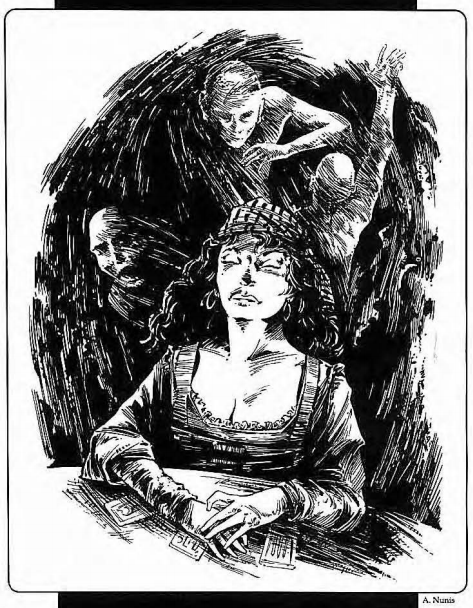
Pretend I said something funny about mediums and size here.
Spirit medium can only be used by, and I quote, "characters born and raise as Orrorsh Gypsies". It lets the character communicate with the various spirits and Lost Souls that litter the realm. The trick is that spirits just want to talk, and as a result it's not uncommon for spirits to just tell the medium what they think he wants to hear so they can stick around.
quote:
Even very experienced Gypsies contact a Lost Soul who doesn't know what's what. Thus, anyone depending on a Gypsy for information must take care - it is an imprecise art.
Using spirit medium has a base difficulty of 12, and success means you've summoned a bunch of Lost Souls. The Lost Soul with the highest Spirit is the one the medium apparently wants to talk to. This Lost Soul always has a Spirit of 15 plus the result points of the spirit medium roll.
The trick is trying to talk to the strongest spirit while the other, lesser ones are swarming around.
quote:
When the spirits arrive they all clamor for the chance to talk with the medium. Anyone watching the medium at work only hears soft giggles and whispers coming from around the head of the medium. But the medium hears the voices dearly. "I know all about the future!" a soul will cry. "Oh, don't listen to him," another will counter. "He doesn't know what he's talking about!" "Do you know what I did yesterday," a third will say. "I watched people eat a pig. I forgot people did that!"
quote:
The bond between the Lost Soul and the medium allows the Lost Soul to use both bonuses generated for two separate Spirit totals.
When the medium asks a question, the difficulty is equal to the highest Spirit or faith value out of everyone involved in the question. (For example, if you're asking "who will the werewolf kill next?", the people involved would be the werewolf and the intended victim.) The the Lost Soul then makes a Spirit roll of that difficulty to see if it knows anything. Failure means the medium gets incorrect info, success means that some information is given, with better success meaning more info.
Oh, but if the question's target is Corrupt, they can make a Corruption roll to completely block spirits from learning anything about it ever, although the group does get a point of Perseverance as a consolation prize. And yes, if the monster makes the roll, mediums and spirits can never attempt to learn anything about it through spirit mediuming. If the seance works but the Corrupt target fails, then the medium will only get a partial answer.
quote:
Note that this means that the Gypsy can rarely be sure if her information is 100% correct, no matter what bonus she generates.
The swami skill works differently from other skills because of course it does. Each add gives you access to a new distinct ability as follows:
+1: You can enter a self-induced trance for a number of days equal to his swami total, during which time he does not need to eat or drink. He also needs very little air to survive.
+2: You can make a swami roll to make disbelief rolls against Illusion spells.
+3: You heal faster when in a trance: shock and KO damage heal twice as fast, and if you meditate for three hours you can eliminate an additional wound level if you make a healing check.
+4: You can purchase adds of the true sight skill at one less Possibility.
+5: You can use the swami skill to resist charm or persuasion attempts.
+6: You can hypnotize snakes to attack people, move somewhere, or spy on people. Yeah.
+7: You can purchase adds of the faith and focus skills for Hinduism or Findaru at one less Possibility.
+8: You can disengage yourself from the illusion of the world: make a swami roll, and if you succeed you cannot be interacted with in any way until you choose to drop the effect or someone makes a faith roll higher than your total.
The swami skill can be used in any realm with a Spiritual axiom of 8 or higher without causing any contradictions.
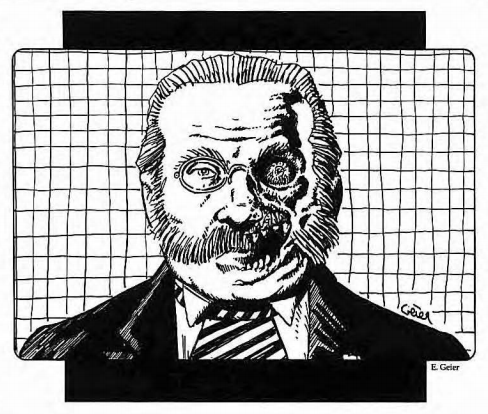
You got a little something on your face there.
Lastly, the true sight skill is taught by some Victorian secret societies and the Findaru legion to sense the presence of Corrupt individuals. Using true sight involves focusing your attention on the target rolling against the target's Spirit. If you succeed (and the target is corrupt), then you'll see any hidden physical signs of the person's corruption. Higher rolls can also reveal the monster's abilities or weaknesses.
But heaven forbid we give Orrorshian characters something useful without a ridiculous drawback or two. Using the true sight skill successfully lowers the group's Perseverance. This is because, and again I'm quoting, "The Power of Fear knows such knowledge is dangerous, and compensates for the use of true sight." On top of that, corrupt characters can avoid the effects of true sight by generating a Corruption total. If they beat the true sight total, not only does the skill fail, but that character can never again use true sight on that person. This does give the group two points of Perseverance, but since the group loses a point for the successful use of true sight in the first place you're really just up one point.
Interestingly, using true sight does not cause contradictions anywhere. But since it's only useful against people with Corruption, it's pretty useless outside of Orrorsh.
The remainder of the chapter is advice for the GM on how to set up an investigation-focused adventure. Or, at least, three paragraphs of it is advice. The rest of the chapter is an extended investigation example, my favorite part of which is the group having to make an evidence analysis roll to tell that a victim was torn to shreds.
The Torgian method of mystery design involves creating a sequence of scenes with the following in each:
- Information about the creature being hunted.
- The amount of Perseverance you get for finding said information.
- Where the information is found.
- Where the information is not available.
- A lead to the next scene, where the whole list starts again.
There's also some advice on how to keep the investigation moving:
quote:
One notorious problem with clue-based roleplaying adventures is the the group of players who wander off of the trail of clues. They may be on a hot lead of their own devising, or they may be confused, but they certainly aren't where you expected them to be. A good gamemaster rule of thumb is if the players' hunches do not contradict given or future information and do not warp the story, help turn the players' choice into the right choice. This is why it is a good idea to include where the scene's information might be found and where it absolutely will not be found.
Such a goddamn mess.
NEXT TIME: As below, so above
A series of unfortunate events
Original SA post The storm has a name... - Let's Read TORG
Part 14f: A series of unfortunate events
As stated a few times previously, Orrorsh doesn't have "magic" in the same way that other realms have magic. I mean, yes you can have ranks in the various casting skills and learn spells from the core book and so on. But that form of magic is very rare; it's incredibly hard to find someone to teach you, and even harder to find spells to learn.
Instead, Orrorsh has the power of the occult.
What is the occult?
quote:
- A mad scientist works in his lab. He bends over a corpse, feverishly scratching out notes on his small pad. Glass beakers filled with strange chemicals glow with unholy light. It is his goal to animate the corpse. His notes are nearly indecipherable. His mind takes mad leaps of logic and is driven by an insane intuition. Yet it might work. The scientist believes it will. The scientist's obsession is sincere. He will do anything to succeed.
- A Victorian woman sits on the floor of her attic. The door is locked. Her children and husband are asleep. Strewn about her are strange flowers and leaves she collected from the jungle. A pile of bones rests by her right knee. In her hand is a piece of chalk. She draws out the picture of a man's body on the floor and marks the illustration with strange symbols. She cannot stand her boorish husband. Her goal is to make him to respond to her will. The objects and the runes are guesses at a formula for summoning power to herself-they are half memories of tales she heard of magic's dark power since she was a little girl. She possesses a gift - the gift of hatred.
- Professor Sjahrir, professor of anthropology at ·the University of Jakarta, is a good woman. When the invasion began she knew that she could not stand idly by and watch her country taken over by the colonial invaders. Then she discovered the mystical nature of the invasion. A creature, red, pulsing, formed of countless limbs, killed her husband. She hunted it down, but found that she could not kill it with a gun. The creature nearly killed her, but she escaped. She sought help from others who knew of the magic of the invading reality. She discovered its true nature - and she discovered its weakness. She stands now in a tool shop in the city of Jakarta. No one else is about. She has a sword with her. It was her grandfather's. He captured it from a Japanese soldier when the Japanese occupied Indonesia. The forge is now hot enough. She takes the vial from her pocket, unstops the cork, and pours her husband's blood along the blade.
It's also another attempt to work the desired tone of Victorian horror into the rules. Shocking, I know.
quote:
This magic system has a different feel than magic in most high-fantasy worlds. Orrorsh is a different place. If you examine horror movies and horror stories you can quickly see that a common element is that the protagonists are dealing with forces they do not precisely understand. They might make guesses as to how the supernatural works. They might even be right, but beyond that guess there's another mystery,and then another and then another. The key is the idea of the unknown. Places of horror are places with lots of unknowns. If the Storm Knights know everything about how magic works, then they are wizards. If they don't know how to make the mystical energies of Orrorsh bend to their every whim, then they are guests in a land they do not understand. They're not powerless. They are certainly not as powerful as Storm Knights in other realms, and that can be frightening.
We wanted to mimic the feel of arcane research in horror stories. The reader never knows exactly how Victor Frankenstein creates his monster in the novel Frankenstein, and there's reason to believe that only Frankenstein himself could repeat the act. In the movie Alien, when Ash gives his jerry-rigged gizmos to the crew so they can track and herd the monster, the attitude is definitely "We don't know if this stuff is going to work, but we have to try." The weirdness of Orrorsh should never be fully understood by the Storm Knights or their players. If it is, it isn't weird anymore.
Performing an occult ritual is pretty ridiculous, even by Torg standards.
Occult rituals are composed of one or more event sentences, which are the descriptions of the things the people performing the ritual want to have happen. Each event sentence consists of a Noun, a Verb, and a specific Object, and sentences can feed into other sentences.
quote:
The grammatical terms of the event sentence are capitalized to distinguish them from actual grammatical terms. We do this because there are some important differences between a grammatical sentence and an event sentence.
Anyway, event sentences tend to fall into the pattern of "This NOUN will VERB the OBJECT"; for example, "this sword will kill my husband's murderer", or "this formula will animate this corpse".
Of course, you can't just have a sword become magic or pull a corpse-animating formula out of your ass. So once you have your overall goal sentence, you put in a few setup "steps" before it to explain how you're going to actually make your end-goal happen.
quote:
It is also possible to have more than one sentence string as part of an event. This happens when the occultist needs to pursue several objects to make the occult event work, and then brings them together at various points. In these cases, a period is used to denote the end of a sentence string.
quote:
When several smaller event sentences come together they form a Compound Noun. The first sentence of the last string ("This blood and fire shall enchant this sword") uses a Compound Noun, as the blood and the fire are the nouns of the sentence.
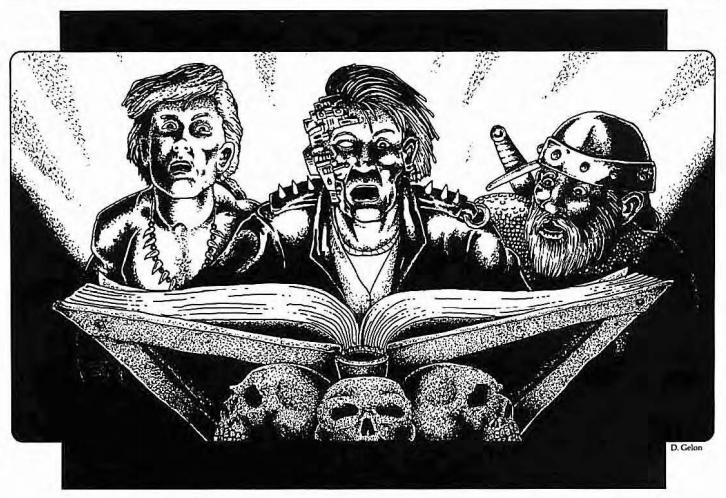
Me IRL trying to figure these fucking rules out.
Anyway, the reason you'd want to add more sentences to your ritual is because the more Objects (sometimes refered to as "props") you have in your process, the more effective the ritual will be. Basically the players are rewarded for coming up with a bunch of ridiculous tasks, not to mention setting up their own adventure hooks to get some of the more out-there requirements.
So let's say I want to create a ritual that will lead me to the tomb of a vampyre by doing the old hold-a-dowsing-stone-over-the-map trick. I'll set my overall event sentence as "This map and dowsing stone will reveal the vampyre's lair." Simple enough. But now I want to put together the steps that will get me to that point. So let's put together a few steps to set this all up:
quote:
1. I will aquire the fang of one of the vampyre's progeny; this fang will become the dowsing stone.
2. I will aquire the blood of one of the vampyre's victims.
3. I will dip the fang in the blood to empower it.
4. I will hold the blood-coated fang over a map of the region; the fang will hover over and drip blood on the location of the vampyre's lair.
The GM is encouraged to set up situations where players have to resort to using the occult to solve their problems, such as a situation where the PCs need to make a special weapon in order to kill a Horror. This way, you keep the flavor of the realm while giving the PCs something to do to solve their problems other than making a bunch of research rolls.
It also leads to this 90's-as-hell GMing sidebar.
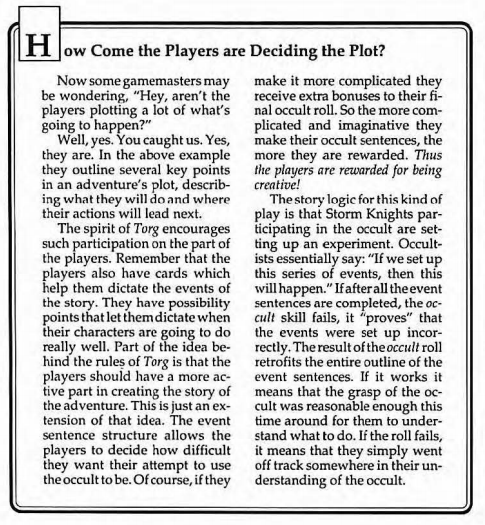
I just love the whole monocle-popping idea that the players might have some say in what's happening in-game. It's just a reminder of how far we've come. (Although if you've ever read any of the published Torg adventures, you wouldn't be that surprised.
So once you've done all the things to the thing to make your thing happen, you have to generate an occult total, and bear with me because this is one of those sections where things aren't presented in a logical order.
Generally speaking, you're going to roll to see if the ritual succeeds when you get to the last of your events. In the above example, that'd be the step where I'm holding the bloodied fang over the map.
UNLESS you have "occult sub-events", which are described at the end of this section after a bunch of other concepts. If the GM decides that a step is complicated enough to require rolling, then the character has to make a roll at that point against a difficulty of 12.
So regardless, making the occult roll. Oh wait, nope, there's a step before you make the roll that's described after the part that tells you when to make the roll.
Have I mentioned that these books aren't organized very well?
See, because the players are the ones defining the effect they want, they have to stat up the end effect as a "spell", enchanted item, or monster as needed. You (the player) want to create a superzombie? Then you (the player) need to stat that superzombie up.
Unsurprisingly, there's no guidelines on stating said stuff up. I guess you can just assign values however you want, bearing in mind that the values you assign will affect the final difficulty of the ritual. So for my ritual, I'm going to have to stat it up as a spell.
quote:
Dowsing Spell
Effect Value: 15
Bonus Number to: effect
Range: 26 (~100 miles)
Duration: 0 (Instant)
Cast Time: 9 (1 minute)
Now that we have all that, we can finally determine the difficulty number. The base difficulty of a ritual depends on its type; spells use the effect value, weapons use their max damage value, and if it's a creature or other effect you use the [SCENE MISSING]. Luckily I made a spell effect so the base difficulty is 15, adjusted for the range to the target. The GM can tweak the difficulty up or down a bit depending on how horror-genre-y the overall effect is going to be.
Then the player rolls their occult skill, getting +1 to the skill for every prop involved in the ritual (not counting the ritual's final target). But that's too easy, so of fucking course we have to get a half a page of restrictions.
quote:
Once an occult event string is designed in an adventure, no more than one occult prop becomes effective per scene during which the characters deal with the occult event. Dealing with the occult event includes obtaining the props, doing the necessary research, and experimenting in the laboratory. If an event string contains six props, but the characters only spend four scenes gathering props, arcane bits of this and that, or puttering around the lab before generating the occult total, then the occult value is increased by +4 rather than +6. lf players are not willing to spend game time on the occult event, do not give them the bonus for occult props and objects.
All of the props are still necessary. If the occult event requires six props or objects, all six are needed before the event can be completed. If players design a lengthy event string in the hopes of large bonuses, they are stuck with working their way through the entire string to get the occult event to work at all.
So you make the roll, and if you succeed then the final effect happens. Failure doesn't seem to have any kind of special downside. In fact, you're not even required to get any corruption from the Power of Corruption unless the GM determines you commited an evil act as part of the ritual. And since you're not required to perform at least one evil act as part of a ritual, you could be occulting left and right and never suffer a karmic ping.
We close out occult rituals with the limits on rituals, which would have been handy at the beginning of this section instead of almost at the end. There are only four:
1. Occult rituals have to have a singular final effect. Rituals are intended to be a one-problem solution. I couldn't use the above ritual to track down any vampyre, just one specific one and that's it.
2. You can't affect anything that you don't know about. So you can't make a "kill every monster in Orrorsh" sword unless you've encountered every single monster in Orrorsh.
3. You need some sort of lab or workshop.
4. When performing a ritual, there's no cap on how many points of Corruption you gain from the Power of Corruption. Usually you can't get more than 5 for a single act, but depending on how heinous you are ("I turn the oceans around Indonesia to blood") you could get upwards of 20.
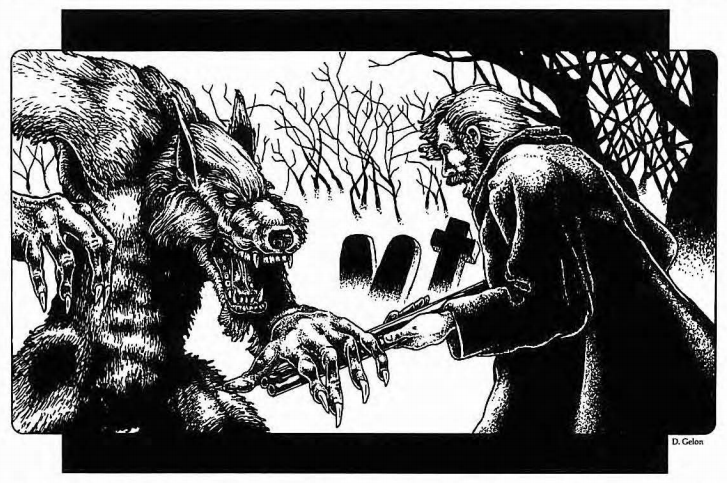
"Hey, watch where you're pointing that thing!"
From here we smash-cut into actual spells. As stated previously, standard magic-skill based casting is rare in Orrorsh, so the big trick to using the new spells is actually finding them in the first place.
Let's go to the highlight reel!
- Artistic Grace is an illusion spell that gives an artistic work the "appearance of brilliance" for about a month. People seeing it have to pass a stat check or think the work is the greatest thing they've ever seen.
- Boiling Blood does require a bit of blood of the target's "creature type", and deals irreducible damage over four rounds.
- Death Haunt torments the target with images of his own inevitable demise. This gives a penalty on all actions taken due to distraction by your own impending mortality.
- Eye Spy allows you to see through an eye taken from a corpse. You can make the eye roll around like BB-8, only gross instead of adorable.
- Fear just lowers a group's Perseverance.
- Madness drives someone mad. The GM gets to pick the type of madness, so he could make the person catatonic, or homicidal mania. Hope he's in a good mood!
- The Mark of the Hunted can only be cast on someone you've got a hostile or enemy reaction relationship with. It creates a mark on the target that the caster can always see, even if it's covered up or the target changes shape.
- Seduction lets you use your spellcasting result in place of social skills when manipulating someone of the "desired" sex.
- Slow Death causes the target to suffer from a cardiac arrest, only it's stretched out to about an hour instead of taking a few seconds.
- Summon Scarabus calls forth a common Orrorshian monster, which will do your bidding if you beat it in a test of wills.
- Transmute Lead to Gold does what you'd expect, and also as you'd expect it only lasts for a day.
- Youth halts the aging process of the caster, Dorian Grey style but with a mirror instead of a painting. Oh, and you have to cast it every week.
The next chapter is the list of Orrorshian miracles, many of which are appropriately Old Testament.
- Bless Missile is commonly used by regimental priests, and has to be cast on an ammo stock. Blessed ammo deals damage twice to any target; the normal physical attack, and a spiritual attack on top of that.
- Blind, well, blinds the target for an extended period. The blindness can only be lifted by a member of the Sacellum or a priest of the target's religion.
- Crucifixion lets you fire metal spiked from your hands (no, really, that's what it does) that nail the target upside-down to the nearest hard surface if they hit. Breaking free requires the target to fight against the hardness of the surface they're crucified to.
- Hell's Fire can only be used on creatures, and just does a ton of damage.
- Paralyzation is another does-what-it-says miracle.
- Pillar of Salt can only be cast in chruches, or in areas that have a Spiritual axiom of 18 or higher. When successfully cast, the target is permanently turned into a pillar of salt. The only way to avoid this is to make an active defense if you know it's coming, otherwise you're screwed. The only way to reverse the spell is through occult means or big magic/miracles. Oh, and be careful when moving the victim.
- Plague calls forth a plague of small technically harmless creatures of your choice. Snakes and frogs are fine, vipers and badgers are not. Basically it's a wide-area intimidation effect.
- Satan's Mark is the same as the core miracle Curse, just with tweaked numbers and effect. It also lowers your Charisma when dealing with members of the Sacellum.
- Sins of the Flesh makes the target's skin rot, opening lesions and cuts all over their body.
- Staff of Righteousness is a week-long ritual that creates a staff that increases the wielder's Strength and melee weapons when using it.
- Tempest causes the area around an object (like a house, an airplane, or a boat) to erupt in violent storms.
- Ward Enemy is another modified core miracle, and prevents supernatural entities from affecting an area.
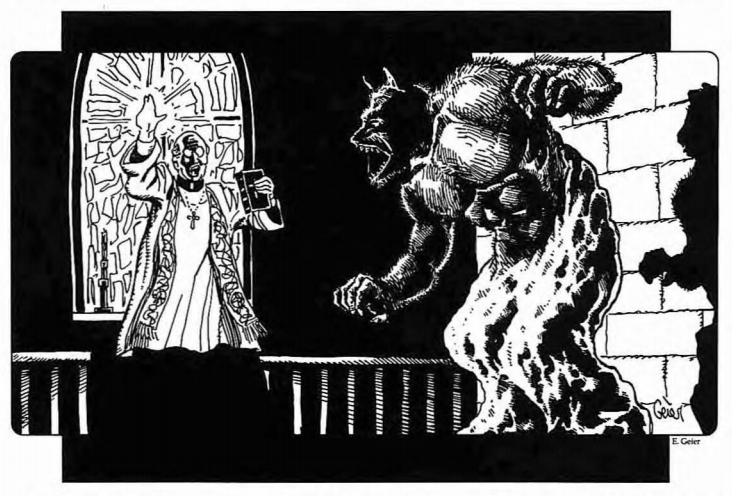
I guess he saved for half?
And there we are. Orrorshian magic of various stripes.
And once again, we get back to Torg's "good idea, poorly implemented" problem with the occultism rules. The whole point of occult rituals being easy to perform is that the Gaunt Man wants to tempt people into evil deeds in exchange for power, so they get started on the Power of Corruption slippery slope. But it's entirely possible to create occult rituals that don't involve anything that would be considered an "evil act". Thus defeating a large chunk of the point of occult rituals.
It's almost like they didn't understand how to enforce their own ideas, or something.
NEXT TIME: Things that go bump in the night
Ghoulies and ghosties and long-legged beasties
Original SA post The storm has a name... - Let's Read TORG
Part 14g: Ghoulies and ghosties and long-legged beasties
At long last, we come to the chapter on Horrors. I mean, it's a realm of horror, there must be some pretty scary beasties to deal with, right?
Well, there are a bunch of decent monsters, yeah. But Torg doesn't want them being treated as "generic" monsters, because once you know a Horror's general stat block and weakness then they become less scary. So to counteract this, the stat blocks for the Horrors are treated as templates, with each listed monster getting a Power Point rating. These points are used by the GM to buy extra powers for the horror off a couple of lists.
As an aside, the book warns that the idea of a monster having an ability it normally doesn't have may not be for the faint of heart.
quote:
This shorthand might suggest that any monster can have any power, which might offend the sensibilities of some readers (after all, a zombie with a shape changing ability does go against the spirit of what zombies are all about). We suggest that those of you who want your monsters "real" shouldn't focus too much on these apparent rifts of logic. It's simply a system to distribute many powers that many creatures have in common. For those of you gamemasters who are a bit more daring, remember that the reality of Orrorsh is similar to the monster stories of Earth, but is not the same. Like any Nightmare worth his blood, you should feel free to experiment with strange combinations and even come up with new powers. Remember that even Earth's stories of vampyres and werewolves contain contradictions and variations on the powers such creatures wield.
Anyway, minor monsters may only get one point, whereas more end-boss-y creatures can have up to 8 or 9.
The one-point powers can give the monster a darkness field 25m in diameter, +10 Toughness against a specific damage type (with damage types including "melee weapons" and "firearms"), night vision, or an attack that instead of killing people turns them into monsters.
The two-point powers include the ability to negate up to 10 points of a target's armor, changing into an elemental form, resistance to normal weapons that turns the first five wounds taken into shock damage, and the ability to transform into an animal.
The three-point powers include hypnosis (effective skill roll: Charisma+15), life draining, possession, and regenerating as if the monster was spending a possibility per round to eliminate existing damage.
Note that there's no limitations on what power I can put on what monster beyond the point costs. I could be a total dick and give baseline zombies +10 effective armor against guns; good luck getting those headshots.
The more powerful monsters also have suggested weaknesses and True Deaths, but again the GM is encouraged to alter these to fuck with the player's OOC knowledge and expectations.
So let's get to the monsters!
Amphids are slimy humanoids whose skin is covered with images of the faces of its victims. They exist maunly around the western tip of Java, and have rubbery skin (+4 armor), sharp claws and teeth (about as damaging as a heavy pistol), and can travel underwater. Despite that, they're considered minor creatures with a Fear Rating of 1/2, but 4 Power. So you can make them hypnotic and immune to bullets! Oh, and they have a True Death: "strangulation and then decapitation".
Bone Golems are created through occult rituals and require the bones of at least seven different kinds of animals. They're really just heavy bruiser monsters, with no real abilities beyond being able to rip you to shreds.
The Children are the creation of Punch, the Nightmare clown who isn't mentioned anywhere until this point. They look like children of race appropriate to the area they're in, and will approach adults who have recently lost children themselves. Then, when they're adopted and accepted by their new family...well...at least they have the decency to wait until everyone's asleep. Their True Death requires being baptized in a church to release the corrupted soul.
Chthons are best described as insect golems. You take a few thousand dead bugs, ritually prepare them and assuming you don't blow the ritual roll you've now got a disgusting, winged beast with giant pincers. I mean, you still get that if you screw up the ritual, but in that case you don't get to control it.
Corrupted Souls are one of the most common Horrors, yet at the same time the ones heroes are least likely to meet. Corrupted souls are what horrors are when they are "between bodies", and as such are generally only found in the Waiting Villages. Entering one of these Villages is a bad idea, because the dozens (if not hundreds) of souls will attempt to kill you and take your body for themselves. Individually they're not very strong, only have four skills, and can only attack by floating through a person (attack value 15)...but you never encounter only one.
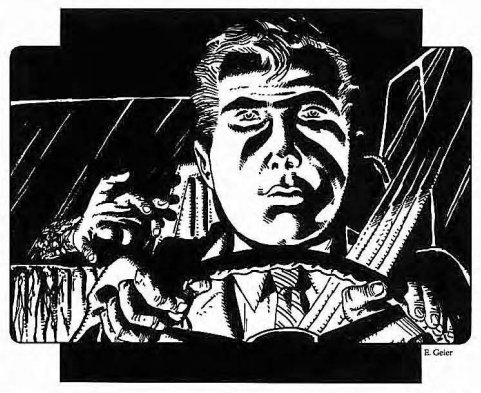
I'm not touching you...
Disembodied Hands are, well, disembodied hands. They possess individual "intelligence", and are actually more dangerous than you'd expect due to their size and the fact that they make no noise.
quote:
The hand moves by extending its fingers forward and dragging its wrist behind it. The creature cannot communicate, but it possesses a mystical sight and hearing. It can sense where objects are and can hear the breathing of someone hidden in closet.
A disembodied hand attacks by sneaking up on its victim and strangling the person. The creatures climb electrical cords to get the drop on their victims, or bury themselves under pillow and wait until their prey go to sleep.
Faceless Ones are humanoid creatures with leathery wings and smooth featureless faces. But because we always want what we haven't got, Faceless Ones are capable of stealing the faces of their victims. They do this by simply pinning someone (by getting a knockdown result) and grabbing them. The victim's face is transfered to the Faceless One, as are all the victim's memories, knowledge, and skills. The victim's face becomes smooth and featureless, meaning they can't see, hear, or breathe, which means that in six rounds they'll suffocate. The only way to save them is to kill the Faceless One, which returns the victim's face. Their True Deaths require being presented with a mirror while in their faceless state.
Orrorshian gospog come in a few varieties based on the planting, as always. First and second planting gospog are used as caretakers for the more powerful ones, or are gifted to powerful Horrors. Third planting gospog are were-tigers that can change forms at will, although they prefer their human form for hunting in cities. A fourth planting gospog is called a "Scarabus", and looks like a more traditional demon; goat head, horns, barbed tail, and so on. Scarabuses (scarabi?) can be summoned via occult rituals, and can grant people power in exchange for their souls. Fifth planting gospog are wraiths, and are pretty much mindless killing machines. Their primary use is when the Gaunt Man or Thratchen want to not just make an example of someone, but also everyone within two blocks of that someone. Their only weapon are claws (damage value 19), but they also have insanely high unarmed combat skill and Toughness.
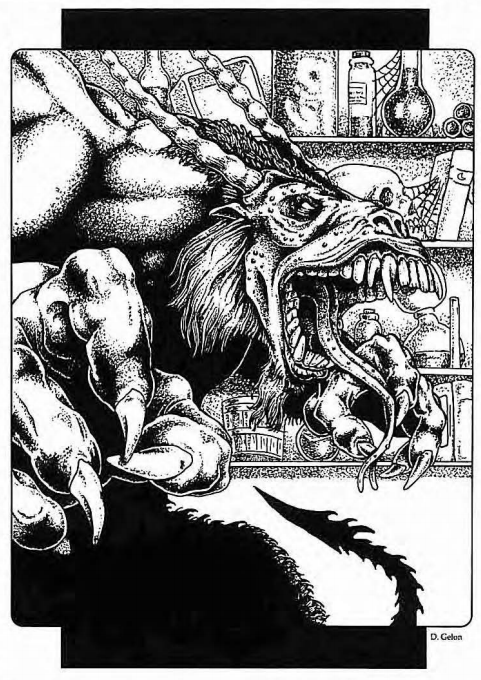
Metaaaal!

Ghouls are your Night-of-the-Living-Dead style monsters. They're bodies that have risen from the grave to feast on the flesh of the dead (the solitary ones that stay close to graveyards) or the living (the shamble-into-town ones). Note that zombies are a different monster we'll get to later; the main difference is that ghouls can act autonimously and are a lot tougher.
Lost Souls were mentioned before when we talked about spells. Nobody (not even the Gaunt Man, not even the lost souls themselves) know where they come from. The souls never remember a point where they were even alive to begin with. They can only be contacted through the spirit medium skill.
The Others are your required Chtuhloidian octopus-like creatures. They spend all their time in the jungles of Orrorsh, maintaining and feeding off the gospog fields or any luckless humans they can find. They're slow movers, but once they get close then they can make up to four attacks without penalties with their damage value 20 tentacles. They're also usually accompanied by a few second planting gospogs armed with blunderbusses.
Shaden are the remnants of one of the Gaunt Man's previous conquests. They appear as clouds of inky darkness, and can alter their shape to hide in shadows (darkness gives them +5 to their base stealth of 18) or whip out acidic tentacles. They usually have the "ignore armor" ability, and their True Death is being killed via unarmed or melee combat.
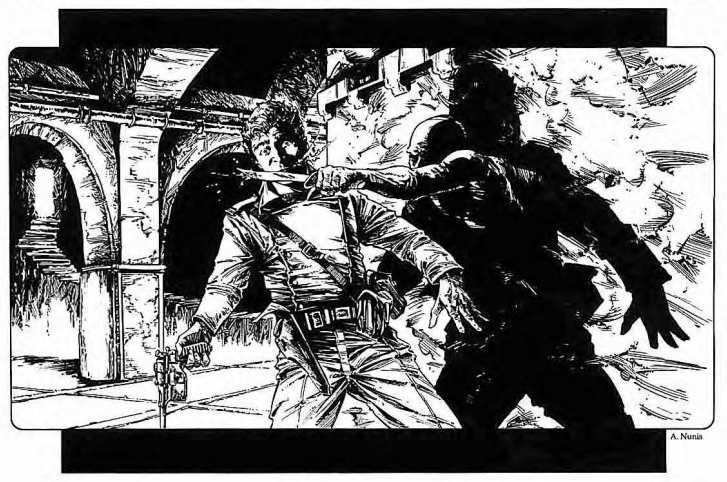
You wanna know how I got these scars?
Shadows are actually the first creature in the game to be based off Indonesian culture! How about that! Shadows are born from the Muslim belief that creating images of Man was an affront to God. To get around this, entertainers used shadow puppets for shows since they were technically not "images of man". The shifting reality of Orrorsh (and the mind of Punch) have twisted this idea around to create living shadows. These shadows are two-dimensional beings, but are capable of interacting with three-dimensional objects. Like many Orrorshian monsters, they have ridiculously high stealth scores, and as an added bonus they can teleport between shadows that are within 25m (Torg really loves that measurement, doesn't it?) of each other. Shadows tend to hunt in groups of five or so, harrying and taunting the victim the whole time. Their True Death involves being trapped in bright light for a full minute.
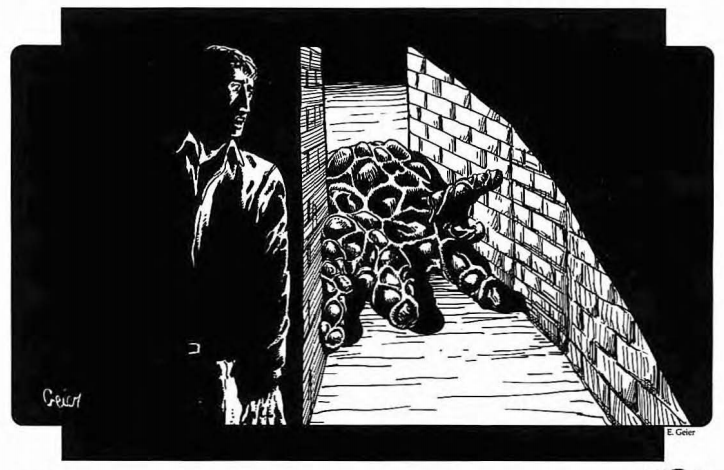
Someone seriously needs to clean out this alley.
Skarths are amorphous red slimes. Skarths feed on human blood, and acquire it by find a person, snaking around his body to strangle him, then oozing inside his mouth and chewing its way through the corpse. Skarths can do the wrap-around thing if they get a high enough result on a hit, and when they are crushing someone they get +3 to their damage until the victim makes a contested Strength check.
Succubi and Incubi are more standard-issue monsters. They're actually not that dangerous, especially compared to the other monsters available, although they do have high enough social skills that they can make life difficult when working in tandem with other monsters.
The Video Cassette Recorder of Death is a creation of our old buddy Skutharka. Technically speaking, the horror isn't the VCR itself, but the small machine spirit inside it. At any point, regardless of if there's a tape in it or not, the VCR can play back an image of a ghostly face made up of static and video artifacting. The face can communicate with the viewer, and will ask the person what they want most out of life. When the person answers, they see a TV show of that fantasy in vivid detail. While this is happening, the VCRoD is making charm and persuasion rolls until it gets a vow result on the social skill table (from waaaay back in the core book). Since its skills are in the low 20s, it's not going to be long before the rube is stuck following the VCR's instructions: "Go out, kill someone, bring me back the body and feed the remains into the cassette slot of the VCR."

I have to return some videotapes.
The machine spirit consumes the parts, and will continue to convince the victim to go out and kill again until either the poor shmuck is killed or someone destroys the VCR.
Vampyres are indeed spelled with a "y". Apart from that, they're about what you expect, although because the Life Drain and Infection powers are separate things they need to buy it's entirely possible to have vampyres that neither turn other people into vampires or drink blood. Vampyres have a pathological need to live in civilized areas as opposed to somewhere more isolated where they'd be safer. They also organize into covens for mutual protection, especially the ones not strong enough to create progeny. Only one vampyre is in charge of a given coven, but internal politics being what they are infighting isn't exactly uncommon. In fact, sometimes a vampyre will leak information about a rival to hunters or Storm Knights so they'll do his dirty work. Vampyres are not inherently strong, but they are fast ( acrobatics 20, dodge 19, stealth 20) and have a charm skill of 26. Their weaknesses and True Death are, again, what you'd expect. Given how vampyres are mainstays of gothick horror, they get surprisingly little space.
Werewolves are another horror mainstay, and again get much less space than you'd expect. Werewolves are not native to Gaea, and were actually created by one of the incumbent Nightmares; the fact that they're just like Core Earth's understanding of werewolves is just a coincidence. Regardless, the souls in Waiting Villages see being put in a werewolf body as a punishment, because a werewolf cannot control its actions when in wolf or wolf-man forms. For the most part, werewolf transformation is completely involuntary and based on the phases of the moon. Some werewolves can control the change, but they'r rare. And of course, the only way to kill one for good is with a silver bullet.
Zombies are mindless bodies raised from the dead. They contain the weakest of all possible corrupted souls, the ones who have been defeated so much they're barely the whisper of an idea. Zombies are incapable of showing any form of initiative or self-motivation. Without instructions they'll just stand there. In other words, they're fodder.
Zuvembies are zombies, but tougher. These are closer to early zombie-movie zombies: tougher, much stronger ( Strength 20), and completely mindless. Interestingly, the book explicitly states that you can't charm, taunt, or persuade a zuvembie due to it being completely mindless, but normal zombies don't have that text. SO I guess that means you can trick, persuade, or charm zombies? That's pretty weird.
---
So there we are. Twenty monsters, and only one of them has anything to do with Indonesian culture. But while that bothers me, there's something else that bugs me more.
I included a lot of pictures from the book in this update, but the thing is that's all the art in the chapter except for one of a werewolf that I think I put in a different update. You don't realize how useful a visual reference for a monster is until you don't have one. Especially when dealing with the horror genre; the descriptions in the book are incredibly vague, and a few more pieces of art would help break up the normal Torgian wall of text and stat blocks.
But really, the biggest problem is that, once again, there's no consistent tone here. Are we doing Victorian horror, 50's B-movie monsters, or what? Why is there only one "modern technology warped by evil" monster? Is that a thing we're trying to do here, or what? What is your point, Orrorsh?
Well, anyway, we're in the home stretch now. But don't worry, soon we'll be learning how to run horror adventures... Torg style!
NEXT TIME: Fighting the good fight.
Tools of the trades, and the tradesmen who use them
Original SA post The storm has a name... - Let's Read TORG
Part 14h: Tools of the trades, and the tradesmen who use them
Time for the home stretch! We've come to the Equipment chapter, and as such I'm not going to spend too much time on it because there's really nothing interesting here and it's only three pages long anyway.
First off, we get conversion rates: the base of the Victorian economy is the sterling, which is about $5 US. Sterlings are silver coins embossed with the image of the original Queen Victoria. A medway is 1/20th of a sterling, and the smallest denomination is the tradescoin, which is about ten cents American.
As is often the case with games of this era, "equipment" means "guns". There's only nine new weapons listed, and they don't even get specific descriptions. The main limiting factor of Victorian weaponry is that they're technologically stagnated (due to both the Darkness Device and the Victorian's endemic dismissal of anything they didn't come up with themselves), so Victorian weapons are just normal guns, but they do a little less damage.
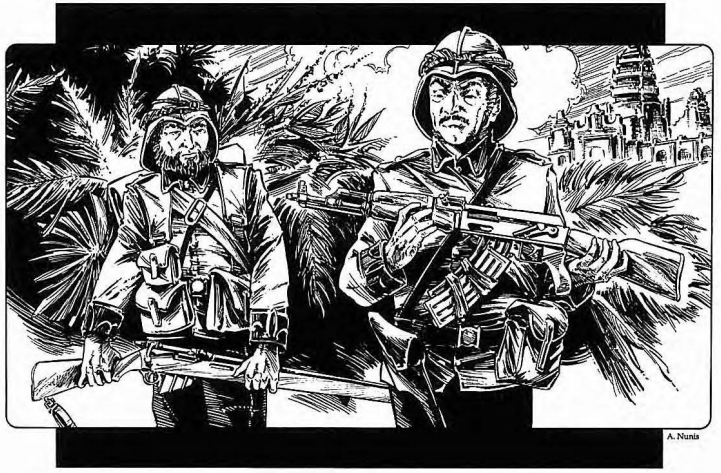
"Yes, it's more effective, but it's so...crass.
There's a bunch of "Traveling Gear" listed, which is stuff like cots, lanterns, tarps, and rope (100'). Apparently camping is a big thing in Victorian-run Indonesia. I suppose it's because a lot of Indonesia is a jungle? I guess? I'd imagine that there's more to camping out in the jungle than just buying some tents.
The most (read: only) interesting things you can buy are occult gear. You can buy an occult kit (400 sterling), which is your standard-issue black leather bag of weird ritual stuff (such as "an organ or two taken from a dead animal"), and is required for any ritual of difficulty 20 or less. For rituals higher than that, you need an occult lab (1000 sterling). You can also get an occult library for 2000 sterling; you can use an occult library as part of the research skill, or to get bonuses on a ritual you're going to perform later.
There's also a few specific occult tomes listed, each of which grants bonuses when performing certain ritual types. Obviously, Victorian culture comes down hard on people who own these books (or have occult labs or libraries, for that matter), so buying this stuff in the first place is probably an adventure in itself.
quote:
The Noctuma: Covered in a smooth, blood-red, unknown material, this volume is thousands of years old. It contains spells, curses, and arcane knowledge from a sorcerer whose name was blasted from the text by a later occult event. The book grants a bonus for any event producing madness (+3) or death (+2); any event concerning demons(+2); any event using brass or silver (+2). It has a bonus unique to this volume: any occult ritual dealing with the High Lord of Orrorsh, or his Darkness Device receive a +3 bonus.
The Kellatastin: Bound in silver covers the Kellatastin contains 80 pages dealing with rituals involving blood (+3 bonus on blood rituals).
And that's all for equipment! Like I said: three pages.
The next chapter is sort-of for the GM, and it's about Adventuring in Orrorsh. Again, we're getting into "how do I tone?" territory here, and is about how to present adventures and such so that you really get that horrific, fighting-a-losing-battle feel.
quote:
Orrorsh is the reality of horror. It is very different from the other realities that have invaded Earth. In every other of the invading realities there isa place for heroes and astounding triumphs. Sometimes, like in the Nile, these triumphs are really astounding. In other places, like the Cyberpapacy, the triumphs come with serious lumps...but the Storm Knights are still pretty certain that they'll win in the end. But Orrorsh is a reality of horror. What should that be like?
So now we're going to get advice on how to deal with how to run a horror game...except that they don't really explain how to do that.
See, Orrorsh isn't about the type of horror that involves an escalation of tension or a slowly building threat. I mean, it thinks it is, but it's not. This horror is about the idea that your character can get killed at any time because that's what horror is, right? Just a constant threat hanging over your head?
quote:
Roleplaying in Orrorsh is a different than playing in other Torg environments. When you read a horror story you know that bad things are going to happen You know it will scare you. You know that characters you like are going to die. Why do we read them if we're setting ourselves for such disappointments?
We don't know. We just know that people do.
The trick then, is to bring that same sense of loving fear into roleplaying games. Most roleplaying games, especially Torg, are not geared toward adventures where characters die regularly. But that's exactly what Orrorsh is all about. If the vampyre doesn't take out some of the heroes then he's a vampyre out of a sword and sorcery heroic fantasy-and that's another reality.
I mean, yeah, I get the idea that if there's no serious threat to the PCs, then there's no real sense of horror. And yes, horror is a really, really tricky genre to do as a tabletop RPG.
But as we've learned in the years since Torg, you can't go into a game with an adversarial GM-versus-players mindset, because the GM is capable of stacking the deck ridiculously in his favor. There's more to good horror than just "oh man anyone can die at any moment!", there's atmosphere, there's tension, there's...well, a lot of stuff.
But when your immediate next subheading after that text I quoted above is:

...then I think you may not really "get" the kind of horror you're doing.
This is a bullet list of stupidity, but I'm just going to summarize each item.
- "Avoid bringing your favorite Storm Knight to Orrorsh." Yup, if you don't want your character to die, just bring a new one! Campaign continuity? What's that?
- Related, the GM should have "back-up Storm Knights" so when characters die they can just grab a new sheet and get worked into the adventure somehow.
Anyway. Back to the list.
- Adjust your idea of winning from "everyone lives" to "the main bad guy monster is killed". Why those two ideas have to be mutually exclusive is beyond me.
- "If you bring characters from outside Orrorsh don't stick around too long." So once the nessecary adventure stuff is done, bug out I guess. Because (and again, I quote) "too much horror loses its edge."
- "The gamemaster should not go out of his way to kill the Storm Knights. Horror is not a slaughter-fest." This is supposed to be about balancing an scenario's threat, because if the players can't make progress because they keep tripping over the dead bodies of their previous characters they'll get justifiably frustrated. But given the other advice, this doesn't line up.
- "Finally, play for story, not for personal survival."
This leads us to what may be the worst bit of RPG player advice I've ever read.
quote:
This requires a certain amount of player detachment. Instead of focusing all of your energy on keeping your characters alive, as if you are your character, you should be like actors in a horror movie. Because the actors read the script, they know ahead of time that their characters are going to die. But the fun is still in playing the part and getting to the death. It's the same with Orrorsh. The story is creepy and death-fraught, but getting to its end is enjoyable because it is an enjoyable story.
Okay. Look.
I know that around here we like to make fun of "verisimilitude" and "MY IMMERSION" and stuff like that. And yeah, like anything when people get too focused on these ideas it'll turn out bad. That pretty much applies to any concept you care to name.
But.
For a horror game to work, the players need to be invested in what's going on; their characters, the NPCs, the relationships, fighting an ongoing threat. You don't do that by constantly telling people to do things that make them more detached from the story. Playing disposable characters, with other disposable characters as back-ups? Don't play your character as if they were an actual person, just as a horror movie deadmeat? What the hell kind of advice is that to players? You don't enforce tone in a game by putting more layers between the players and the game. Especially with the Perseverance mechanic, which boils everything down to "you can't win the adventure until you get this number high enough."
Christ.
Anyway. The rest of the chapter is about setting up Orrorshian adventures. Or adventure singular, I guess, since the only type of adventure they talk about is a monster hunt. The idea is that when choosing a monster to be the focal point of an adventure, you need to look at things like its Fear Rating and how much Perseverance the PCs need to get to overcome the Power of Fear. The GM also needs to set up the clues and research bits so that the characters can generate the needed Perseverance.
The book likens this whole process to a game of cat-and-mouse; the PCs are looking for the clues needed to figure out what's going on, what they're hunting, stuff like that, while the monster is engaging in hit-and-run attacks on the group or their allies, or sending out mook monsters to do the same. Except...
quote:
The Storm Knights have to constantly balance the need to kill the monster as is quickly as is possible against the need for more information and more Perseverance points.
I mean, I get why the whole Perseverance thing is there. It's to create a situation where the PCs have to work their way up to defeating a monster instead of just loading up with guns and raiding its lair. That's fine. But by mechanizing things to this degree, you completely obliterate any sense of real horror you might have created. Yes, you need to have a significant threat and an uphill battle against the forces of darkness to have a good horror story. But you also need some character attachment in there too.
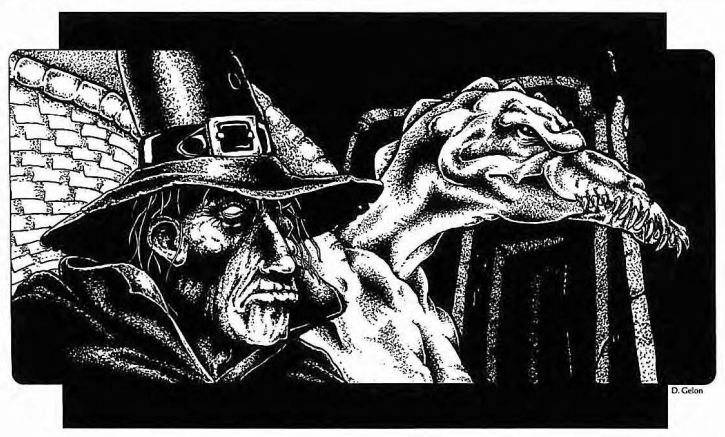
Right there with you, buddy
The book tries to redeem itself by talking about using Creepiness to enforce the feel of the realm; instead of the buckets-of-blood style of set dressing, use small moments of "wrongness" to get people off-balance and remind them that stuff in Orrorsh isn't right. The example they give is actually an early scene of The Exorcist.
quote:
In the beginning of the movie The Exorcist two men are having a meeting in an office. There is a grandfather clock in the room, and the sound of the clock's pendulum ticking back and forth becomes part of the background noise of the conversation. Suddenly the pendulum comes to a complete stop. The noise stops and the two men fall silent and look at the clock. One of the men, a priest, is acutely aware that something is wrong. And so is the audience. The two men continue talking, for there is nothing to be said - a clock just stopped, that's all - but in that simple moment we all wondered what the portent of the clock stopping was. We in the audience all caught our breaths.
quote:
The characters are at the theater one night in New London. The gamemaster describes the event - well-lit, everyone in tuxedoes and beautiful evening gowns. The seats are made of fine oak and crushed velvet. It is a fine evening and everything is in place. Then one of the Storm Knights notices that a woman sitting in the row in front of them is bleeding. Just a single drop of blood, over and over again from just behind the left ear. If the character points this out to the woman she turns - nothing strange about her - smiles, and says it must be a cut that re-opened. She excuses herself and heads to the bathroom.
Is she the strange creature they are seeking? It seems strange to think so in such a normal environment - and yet...
Moving on, the next section is about Using the jungle, and since it's short I'll just quote it fully.
quote:
One of the stranger elements of Orrorsh for many people is that it's in Southeast Asia. What has horror got to do with vampyres and werewolves?
Well, think of it this way. A jungle is a place filled with trees and plants and animals. There are so many leaves and trunks that there are plenty of places for creatures to hide. Or places where Storm Knights think creatures are hiding. It's like a big haunted house right outdoors in the bright sunlight of day.
Also, when Storm Knights are in the jungle it means that they are cut off from civilization and help. They are on their own. The gamemaster should use that to his advantage. Isolate them and make them know that things could get much worse very fast.
The last thing in the book (apart from the character templates) is some time spent on the idea that The Monsters are the Adventure. The main gist of this section is that the GM can't treat monsters in Orrorsh like in other RPGs; they're not supposed to be speedbumps or disposable fodder like in D&D. Horrors are rare, and killing one is a not-insignificant blow to the Gaunt Man's forces. Monsters don't just happen, they're fueled by lost souls, and every monster knows that defeat means going to the back of the line to wait for a new body...and that the more they go back to that line, the easier it'll be for other lost souls to cut in front of them, eventually leaving them mindless whispers in the wind. On top of that, the Gaunt Man created his monsters to sow fear; if a horror can't do that without calling hunters down on his head every five minutes, then the Gaunt Man has no need to keep said monster around.
And since they know all that, monsters shouldn't just wait in their lairs for the PCs to show up for the final boss fight. They should have goals they're pursuing, obstacles to throw at the PCs, allies to call upon. The monster should be hunting the PCs just as much as the PCs are hunting it, because it knows what the real price of its defeat will be. Winning means more power, maybe a seat on the Nightmare Court. Losing means...well...let's just say that the horrors are really motivated to win.
It's amazing that there's no real interesting GM advice in this book until the very end.
Finally, we come to the character templates.
The core set had three templates available for players, all of whom were Orrorsh natives:
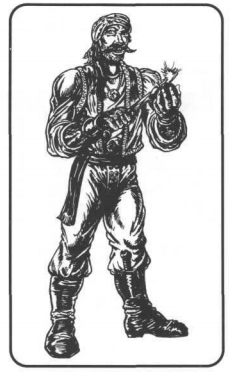
The Gypsy Soothsayer is an Orroshian native is a "showman, con artist [and] magician" who came over with the Victorians because he was being paid to help out. Victorians may not like him, and he may not like them, but that's not going to stop him from taking their money as payment for his fortune telling. His starting equipment includes a forgery of the "Grolisch Tome of Ancient Lore", and his tag skill is divination magic.
The Vampyre Hunter lost a sibling when she was young, and that event shaped the rest of her life. An obsession with understanding the supernatural led to an academic career at Holgromb's College at Oxford, but since Victoriana didn't encourage majoring in Monsterology she studied science in hopes of using the knowledge in monster hunts. Her tag skill is evidence analysis.
The Werewolf used to be just another Victorian soldier defending the colonies from monsters. But when his unit was ambushed one night, the rest of his unit was wiped out to a man. The company chaplain said that he alone avoided the "fate of the beast", and thus was allowed to live. Unfortunately, the chaplain was wrong. After changing for the first time, the former soldier has come to Majestic, where he hopes for a fresh start. His tag skill is shape shift, which worked a little differently in the core set.
The Orrorsh book adds another ten templates from both Orrorsh and Core Earth.
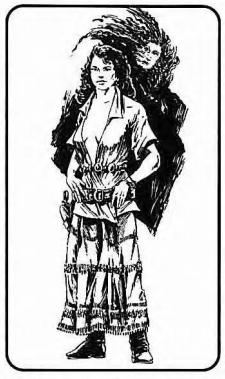
The Gaean Gypsy grew up in a tribe that spent most of its time avoiding the beasts of Orrosh and the Victorian armed forces. The Victorians would sometimes begrudgingly ask the tribe for information, and sometimes the tribe didn't lie to them. Just before the invasion, her tribe was wiped out by zombies. She managed to escape down the bridge, and now helps people fight the Gaunt Man's forces...for a price. Her starting equipment does not include an undershirt or bra, and her tag skill is spirit medium.
The Gaean Swami spent most of his life surviving in the jungles of Orrorsh solely on his spiritual strength. He sees more than most that the world of Gaea is ready to collapse in on itself, its death throes only held at bay by the power of Darkness. Learning of the new world discovered by the Victorians, he chose to abandon the dead world in the hopes of aiding the living one. His tag skill is swami.
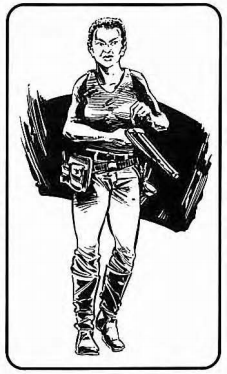
The Indonesian Dock Worker never asked for much out of life. She grew up in a blue-collar suburban area, got married, had kids, and had a stable job working on the docks. Then the invasion happened. Then the vampyre stalked her neighborhood. Then her husband and children were killed. Then her son came back for her, he just wanted some blood and they could be together again... Then she ran. Fear and shame became anger, and she started hiring herself out as a "native guide" to the Victorians in order to learn more about killing monsters. Now, she hunts down horrors because that's all she has left. Her starting gear includes a shotgun and a sledgehammer, and her tag skill is true sight.
The Indonesian Professor grew up during Indonesia's fight for independence in the 60's. He lost many friends in the protests and riots, but the end result was worth it: freedom and democracy for his country. Once life settled down, he went to school to study (and later, teach) anthropology. After all, those who don't learn from history are doomed to repeat it. But now, history has repeated in the worst way possible. Victorian forces have invaded the country "for its own good", and seem to have brought nightmares with them. Hopefully, if the monsters can be defeated, then the Victorians will leave for good. On the plus side, a lifetime studying myths and legends of the region has a much more practical application nowadays. His tag skill is scholar.
The Indonesian Reporter is in a bit of a bind. He's smack-dab in the middle of the story of the century...and the TV and newspapers have stopped. It's also hard to be an objective reporter when your friends have been killed by monsters and you're treated as a backwards savage by white invaders who haven't even figured out the internal combustion engine yet. Still, you have contacts all over the country from your reporting days, and people who are good at investigation are in high demand. His tag skill is research, but because that's an Orrorshian skill and he's a Core Earther, using it is always at least a one-case contradiction.
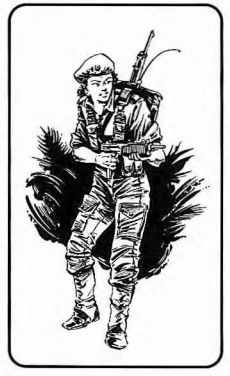
The Muslim Warrior is...well, a rather reactionary soldier. She was raised in the traditions of the Muslim faith, and joined the army to serve her country and give herself to Allah. But there's no way she could have predicted the current situation: demons walk the streets, the Victorians forcing everyone to worship in the Sacellum, and the common people of Indonesia caught in the middle. In her mind, there's two sides: the Indonesians, and Everyone Else. She's willing to work with non-Muslims if she has to, but she knows that when she dies, her struggles against the forces of darkness will assure her of a place in heaven. Her tag skill is faith (Islam).
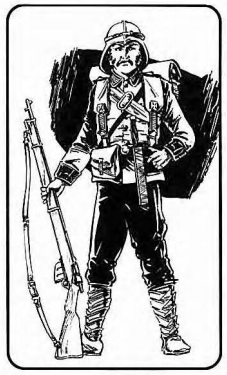
The Regimental Soldier was a loyal member of Her Majesty's army, fighting for Queen and Country. One night, his lieutenant was attacked in his tent by a demon, and it took the combined forces of the infantry's blessed weapons to put it down. The official report claimed that the lieutenant was killed on duty, but the soldier knew the truth: he was next to the lieutenant's tent just before the attack, and overheard the lieutenant summoning the demon. Unable to trust the chain of command anymore, he deserted. After all, how can you fight evil when the higher-ups are on the side of darkness? His tag skill is fire combat.
The Sacellum Priest has always had doubts. He thought that by rooting out corruption in the church, he was serving God's will. But obstacle after obstacle appeared in his path, preventing him from finding the proof he needed. When the maelstrom bridge was built, he chose to go with the military in order to investigate the church from the "outside". Now, he knows that while the faith is pure, the church has rotted from the inside out. Now, the church wants him dead. His tag skill is focus.
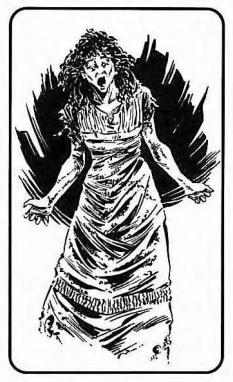
The Victorian Lunatic is...well...look, it's not her fault, okay? It's not her fault monsters exist. It's not her fault the state religion is a corrupt force used to bludgeon people into obedience. It's not her fault her world is a dying ember of hope. It's not her fault she looked into the abyss. It's not her fault she can't keep a "stiff upper lip" like everyone else. At least she can keep things together for a while. Long enough to help. Long enough to fight. Long enough to let the cracks show. Her tag skill is occult.
The Victorian Occultist is good at fitting in. She knows the rules of Victorian society, what a lady is and isn't allowed to do. For example, a lady isn't supposed to talk back when the other members of society say that the evil is only in monsters, not in the Victorians themselves. A lady also isn't supposed to join a secret society dedicated to learning more about the truth of the world. A lady is not supposed to learn the power of the occult. And lady must never, ever take it upon herself to fight the darkness that nobody else will face. Good thing she doesn't do any of that. After all, she's a proper lady. Her tag skill is occult.
And with that...we're done. Ah, but I hear you ask: what does the future hold for the Realm of Horror?
Orrorsh doesn't expand very much at first, mainly because the Gaunt Man isn't around to drive people. Thratchen can't get Heketon to empower stelae (since it's bonded to the Gaunt Man), so things continue more or less as described for about a year.
Then, unsurprisingly, the Gaunt Man finally manages to escape and return to Orrorsh.
The Gaunt Man's return is "chronicled" in the appropriately-titled adventure The Gaunt Man Returns. In keeping with the standard Torgian inability to know what the interesting parts of its setting are, the return itself is done entirely in the four-page opening fiction of the adventure, which only the GM would ever read. So really, the adventure isn't about the Gaunt Man's return. It's actually about the Gaunt Man summoning the PCs to Illmound Keep about halfway through the adventure (page 47 of 98) so they can kill Lord Avery Wellington for him, because he wants to "test the Storm Knights" and Wellington is trying to usurp the Gaunt Man via an occult ritual that would kill everyone in a major city. Refusing to help the most evil man in the world gets you 13 corruption points because not helping save a city is a Wicked act. Agreeing to help the most evil man in the world gets you 8 corruption points. It's all as dumb as it sounds.
While all that's going on, Thratchen remains focused on getting revenge on 3327 for fucking up Tharkhold's maelstrom bridge. He sets a few members of the Hellion Court loose in LA to destabalize the Kanawa Corporation's holdings.
Once the Gaunt Man gets caught up on current events (and gets the other High Lords to get more or less in line), he begins expanding his territory. He pushes eastward into New Guinea, and in four months since his return begins working south from there into Australia. He also reorganizes (read: purges) the Hellion Court, removing Thratchen's ringers and bringing in a few new Nightmares.
The Gaunt Man also manages to destroy two of his own bridges trying to kill some Storm Knights, so good job there. He does manage to drop a bridge into New Orleans at one point, because every reality but one eventually lands on the United States.
But the Gaunt Man's main act upon his return is to start kidnapping women around the world who have the gift of prophesy. This won't come into play until late-game metaplot happens, so I'm afraid you'll all have to wait and see how deep that rabbit hole goes.
---
Man, that was rougher than I expected.
Orrorsh is probably the worst realm when it comes to the writers not getting how tone works. They wanted the realm to be dark, broody horror, but then they can't stop the jokes from leaking in, and then you wind up with stuff that's splatterpunk or gross-out or B-movies. And while it's possible to use mechanics to reinforce tone, you can't use mechanics as tone. I hit most of the points about halfway up this post, but really they're trying so hard to make the mechanics enforce the feel of the realm they forgot to just include the feel through the fiction.
Like I said, I get what they were going for. But it's clear the writers had no idea how to enforce a tone of slow-burn horror in any way beyond mechanical subsystems. I get that here in 2016 we can roll our eyes at these old ideas and point to things like Apocalypse World's countdown clocks, or the Fate Fractal method of stating up threats. But even in 1991, I can't imagine these rules were effective because all they do is make you work to get a number to a certain point, and the players won't even know what point they're aiming for since the target number is only known by the GM.
It's not frightening at all. It's not even spooky. It's not even spoopy. It's just dull.
I admit that I'm not a horror fan by any stretch of the imagination. But even so, I'm pretty sure this is not the way to do horror of any stripe.
But now, it's time to turn on the lights, realize that there's no monsters under the bed, and leave the bleak racist shitshow that is Orrorsh behind us. But worry not, for on the horizon lies our next realm, which we will dive into...
NEXT TIME: A new realm! Swords and/or sorcery! Latin! Secular Dwarfism! And the most insane flowchart you've ever seen in your life!
Aysle - Darkness and Light
Original SA post The storm has a name... - Let's Read TORG
Part 15a: Aysle - Darkness and Light
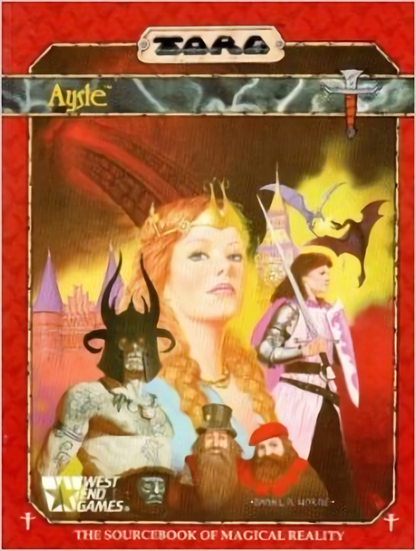
Knights in shining armor charge a line of half-man, half-beast monstrosities as the forces of light and dark clash for control of the region. The charge is cut short when the monsters brandish AK-47s and mow down their foes.
A ship attempting to cross the English Channel is attacked by a sea serpent. Spells and artillery fire combine to drive back the beast in the heart of a reality storm.
Viking raiders attack a coastal town in northern Norway. The police are unable to fight back against the invaders' sorcery...but the dragon that lives nearby doesn't like having its sleep disturbed by these loud savages.
A London gangster enters a local store that hasn't been paying its protection money. The shopkeeper is defiant...until the the gangster's legbreaker, an ogre, comes in. As the gangster watches the ogre work, his face becomes noticeably darker and more corrupt.
This is the state of northern Europe in the Near Now. This is the world of darkness and light, honor and corruption. This is Aysle.
Aysle - The Patchwork Realm
The situation in England and Scandinavia is pretty chaotic, even by the standards of what's going on in the rest of the world. Like many other parts of Core Earth, another reality has invaded and overlaid a great deal of the region, altering the local reality and its inhabitants. In this case, the reality is known as Aylse: a world where magic holds sway, where great armies clash in an eternal battle between the forces of darkness and light.
And while this battle rages on in the background of the Possibility Wars, it's been part of Aysle's history for centuries. Because unlike the other invading cosms, the true battle is between the two High Lords of Aysle itself.
Five hundred years ago, the world of Aysle was under the control of the council of Houses and its queen, Lady Pella Ardinay. She was a fair and just ruler, dedicated to the high principles of honor. She protected the many races of the land from the monstrosities that lurked in the shadowy corners of the world, and in turn she was protected by the leader of her knights, the warrior-woman Tolwyn of House Tancred.
But peace never lasts. Especially when your world catches the attention of the Gaunt Man.
Aysle was a world rich in possibilities, and the Gaunt Man had plans for it. But rather than get his own hands dirty, he sent one of his lieutenants: the necromancer Uthorion. Gifted with a Darkness Device and explicit instructions on how to defeat the queen, Uthorion's army swept across the land. The dark army wasn't just taking territory and killing innocents, however; every piece of land taken by the Gaunt Man's forces became corrupted. Trees became twisted and black, lakes and rivers fouled, even the inhabitants changed to more monstrous forms.
Uthorion knew that Ardinay was too powerful to defeat by normal means. She drew her strength from the land, and even with a Darkness Device at his side he couldn't just overrun her army and kill her. But he also knew there was one point in time, one small window where he could sieze control. So his army marched to Ardinay's castle to face off against Tolywn's forces, and strike down Ardinay in the gap between sunset and moonrise.
The battle was bloody, and all hope seemed lost when Tolwyn was struck down by a corrupted dragon known as the Carredon. Ardinay and Uthorion faced off, a battle of sorcerers as the war raged around them.
But not even Ardinay's magic could withstand the power of the Darkness Device. But even as defeat loomed, not even Ardinay could have predicted what happened next.
Rather than kill his foe, Uthorion sundered Ardinay's soul from her body and transfered his mind into the now empty shell. In the body of the queen, Uthorion truly bound himself to the Darkness Device, the black crown Draxacanus. He sent word for his forces to retreat, and stepped forward as the queen to declare victory over the forces of darkness.
And the armies of light cheered, unaware that their queen was no more.
For five centuries Uthorion ruled Aysle, adjusting the reality of the cosm to allow the power of corruption to spread more easily. He ruled as Ardinay, giving lip service to the former ruling council and eroding the world from within for his master.
But what Uthorion didn't know was that Ardinay had one last card to play.
Tolwyn's defeat in the great battle was not unexpected. In fact, Ardinay had planned for it. When Tolwyn fell, her soul was caught by a powerful spell and trapped in a timeless limbo. She "slept" for centuries until her soul awoke in the body of a Core Earth woman who was killed shortly after the initial invasion. Finding herself far from home in both time and space, she quickly allied herself with others who were fighting back against the High Lords. People like Father Christopher Bryce, Doctor Hachi Mara-Two, and the edinos warrior Tal Tu.
They were the Storm Knights, and they are the ones who trapped the Gaunt Man in the pocket dimension and stopped him from becoming Torg.
But that wasn't their only triumph. Returning to Aylse, Tolwyn faced Uthorion in battle, and managed to not only drive him from Ardinay's body, but to restore Ardinay's soul back to where it belonged. The queen was restored, and the High Lord of Aysle was defeated.
In a manner of speaking.
It turned out that the Gaunt Man was more forward-thinking than either Ardinay or Uthorion had expected: the bond between High Lord and Darkness Device was not a spiritual one; it was a physical one. That meant that once his spirit was removed from Ardinay's body, Uthorion couldn't access the Darkness Device's power anymore...a detail that the Gaunt Man didn't happen to mention to him. Now cast adrift and powerless, Uthorion had to find a new body to inhabit in order to try and retake Ardinay's body and regain control of the cosm.
Lady Ardinay, meanwhile, found herself in control of a reality that had been twisted to darkness and bound to an artifact of pure evil. She is back in control of Aysle, yes, but the land is nothing like she remembers. She wants to fix the damage that had been done in her absence, but doesn't know how. She can't uproot the stelae planted by Uthorion without causing millions of deaths, she can't pull Uthorion's forces back up the maelstrom bridge because they won't listen to her, and she can't undo the changes done to Aysle's world laws and axioms without giving in to the Darkness Device.
So now Aylse exists in a point of uneasy equilibrium. The restoration of Ardinay has undone some of the corruption of the land, but some of the damage has dug in too deep to fix. The other High Lords know that she's back in control, but at the same time none of the Core Earth governments are really sure they're buying this "I was evil because I was possessed but I'm not now" thing to really form a strong alliance.
And all the while, Draxacanus ceaselessly whispers in her ear, telling her that she can fix everything, end the War, help everyone, save everyone...all she has to do is wear the crown and its power will be hers.
She's been resisting the crown's siren songs. So far. But still, it's tempting...
Lady Pella Ardinay and Uthorion
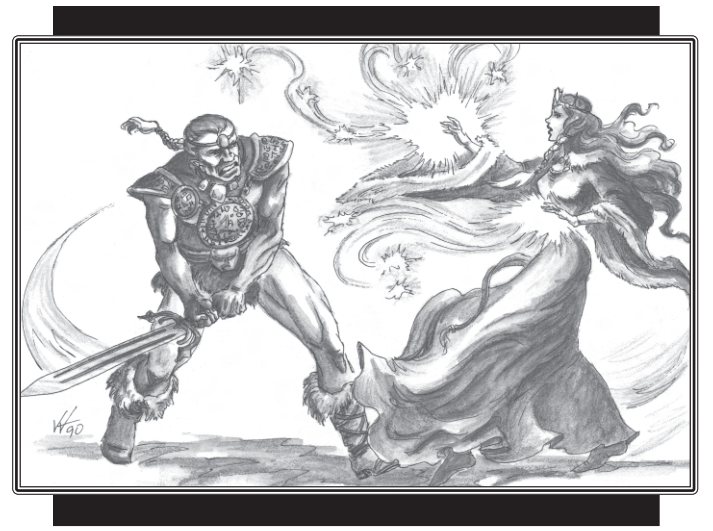
Technically, Aysle has two High Lords, although only one of them is really a High Lord as per the normal definition.
Lady Ardinay is indeed bound to Aysle's Darkness Device, with all the benefits and powers that entails. However, she didn't get this power volintarily, and she knows exactly what would happen if she did tap into that power even for the "right" reasons. So she's doing what she can under her own power to make things right. She's abdicated some of her power back to her people, and is dedicated to hunting down the more dangerous creatures of darkness that Uthorion set loose. As for the realm...well, that's a trickier problem. She knows what would happen to all the Ords if she began pulling back her borders, so that's out of the question. Right now, she's focusing on trying to help the native Core Earthers adapt as well as they can to the acceptance of Ayslish reality because what else can she do? Besides, they'll have to learn that magic is better and more natural than that strange technology stuff they used to have. So she's not using the Darkness Device at all, trying to rely on her own innate magical power and experience to see things through.
The biggest problem with that is that Draxacanus won't leave her alone. It knows she's still weak after returning to her body, so it's constantly whispering in her ear to try and break down her defenses and not give her a minute's peace to just think.
Uthorion, meanwhile, is (understandably) not happy with his current situation. See, there's two things you need to know about him. First off, he's a Class I Toadie with a side of "Now I am in control muhahaha!". Second, he's a moron. He only invaded Aysle in the first place because the Gaunt Man said to, he only knew how to defeat Ardinay because the Gaunt Man told him, and he only took over Ardinay's body because the Gaunt Man told him to. He was pretty much given free reign after that, but everything he did was still part of the Gaunt Man's long-term plans.
Now...now's a different story. Uthorion has taken over the body of a Viking warlord named Thorfinn Bjanni and has at least managed to unite the various Viking tribes under his banner. But while he's now got enough forces to stay in the game (as it were), he's run into another problem: he has no idea what to do next. He knows he wants to take Ardinay's body over again so he can be High Lord, but he doesn't know how to do that. He doesn't have anything close to his old army. He doesn't even have access to his dark magic since that belonged to his old body. The Gaunt Man isn't around to give him orders anymore, and Thratchen is pretty much ignoring him. As for the other High Lords...well, they're not exactly leaping to help him. The only one willing to help him is Malraux, but now that Malraux is the Cyberpope, Uthorion finds himself unable to trust the only person giving him a hand due to living in technology-hating Aysle for 500 years.
So right now Uthorion is limited to raiding coastal towns and skirmishes against Ardiany's weaker forces. He's still a threat, but nowhere near what he used to be.
Axioms and World Laws
As always, let's take a quick look at the setup of Ayslish reality.
Magical Axiom: 18. Unsurprisingly, Aysle has the highest Magical axiom in the whole game line. Magic is ridiculously common in Aylse, to the point where everyone in the cosm is capable of casting a spell. In fact, everyone in Aylse starts the game with a randomly determined spell they can cast without any training. At this axiom level, permanent magic enchantments are also possible. We'll get to that in more detail later, of course. (Oy lord, will we ever.)
Social Axiom: 18. This is tied with the Cyberpapacy, and is a few points below Core Earth. As befits a Generic Fantasy World, life operated under feudal laws, although that it's worth pointing out that the infusion of magic throughout the culture makes life a bit better for an Ayslish commoner than it did for the ones from our world. The overall standard of living is about where it would be post-Industrial Revolution. Technically the world is ruled by a royal figure, but Ardinay set up a counil of Lords to advise her. This also kept things pretty equal among the various races of the land since everyone had a voice (sort of). While Uthorion was driving, however, the council was disbanded and interracial tensions rose. With Ardinay back, things are slowly returning to the old stability, but centuries of distrust are hard to overcome.
Spiritual Axiom: 16. It's pretty interesting to note that Asyle's Spiritual axiom is higher than the Cyberpapacy's. Aysle has your standard fantasy pantheon; i.e. a bunch of different gods, and people with faith and focus can cast miracles. On the plus side, unlike places like the Forgotten Realms, the gods don't manifest in the world. One thing that's interesting to point out is that because of Reasons that we'll get to later, dwarves are the only race that won't call on the power of the gods. Not can't; won't.
Technological Axiom: 15. This is the "movable type, calculus, crude firearms possible, steam power possible but risky" level. Technology in Aysle is (at best) not something most people care about due to the preponderance of magic. After all, if magic is common enough that literally everyone can use it, why bother working to develop other solutions? You don't need to develop the steamboat when you can just hire someone to cast a spell that makes the water push the boat forward. In keeping with normal fantasy idioms, dwarves do have an interest in technology, and have developed basic steam power and flintlock rifles. The discovery of Core Earth technologies has been of great interest in this area.
And now we come to the world laws. There are four laws all told, one of which was tweaked by Uthorion to make his job easier. That said, only two of them do anything practical and one of them is completely, utterly useless.
The Law of Observation states that reality in Aysle is defined by what one can observe through the normal five senses. What this means is that in Aysle, what is observed is true. The sun rises and falls not because that's how people observe its path based on the revolution of the planet in relation to a stationary object, but because the sun actually does rise into the sky then fall again.
quote:
Under Aysle’s Law of Observation, everything that is perceived is real, and everything that is real has been previously perceived.
The Law of Magic states the following, and I quote:
quote:
The Law of Magic states that magic is real.
That's some prime one-way thinking.
The Law of Honor states that the good people do in the world will be reflected in that person. Being "honorable" is an important part of life in Aysle, and the law of the land reflects this by protecting the innocent. Being "honorable" is defined as being honest, faithful to those close to you, respectful of those under you, and bravery in the face of danger. In fact, the land will reward those who behave as honorably as possible.
The Law of Corruption is sort of the flip side of the previous law. It states that the evil you do will be reflected on your soul and difficult (if not impossible) to hide. People who wallow in corruption and evil find that they're unable to keep their wicked ways secret for very long. Evil needs an audience, and the worse a person is the more their true nature will leak through to be visible on their body and soul. Uthorion managed to twist this law when he took over Ardinay's body to allow truly corrupt people to channeled the signs of corruption into the land itself. In this way, nobody would sense his occupation of the queen, and an added bonus was that evil people of power could corrupt the land on their own. As a result, large portions of both the cosm and the realm are twisted beyond recognition, giving rise to new monsters and hiding dark deeds.
The Laws of Honor and Corruption are the closest thing we get to an alignment system, because they all add two new mutually exclusive skills to the game: honor and corruption. We'll cover those when we get to the skill section, but basically the way they work is that the more honorable/dishonorable you are, the easier it is to perform honorable or dishonorable acts.
Due to centuries of Uthorion's evil being channeled into the world, Aylse is not the world of wonder it used to be. Uthorion's actions destabilized the world's government, allowed the corrupt races of Aysle to walk under the sun, and kept the wicked from being dealt their just rewards. And even now, with the rightful ruler back in place, too much damage has been done to easily fix. Large swaths of the realm are trapped by shadow, innocent people are being caught between the armies of light and dark, and the realm has no friends on the outside. Ardinay wants to undo the harm done in her name, but centuries of powerlessness have taken their toll on her spirit. Uthorion is still out there, slowly rebuilding his power base and destabilizing Ardinay's already shaky position. The constant shifting between darkness and light has affected the people of the realm in unpredictable ways, warping the unfortunate into new monstrous species never before seen in Aysle. And through it all, Lady Pella Ardinay tries to block out the non-stop tempting whispers of the Darkness Device, an font of power that she never wanted but could solve all her problems so easily if she'd just listen for one moment...
It is a time in need of heroes. Saddle up, brave knights; it's time to face down the forces of darkness.
NEXT TIME: Our fantasy is the genericest!
A world of the purplest prose
Original SA post The storm has a name... - Let's Read TORG
Part 15b: A world of the purplest prose
The first real chapter of the book is the description of the Aysle cosm, and of course we get waaaaaaaay too much detail about it. This chapter is about twice as long as the one about the realm, a.k.a. "the place the PCs will actually be spending time". But this is pretty much always the case so I don't know why I'm shocked by this. And just for shits and giggles, and so you understand why it takes me so long to write these, I'm going to intersperse this post with how many pages I am into the chapter.
Aylse itself is a disk-shaped world (which is its only really comparison point to the Diskworld) that was created in The Distant Past by the dwarven gods. We get a page-long myth of the dwarven gods creating the world, but you'll forgive me for not transcribing the whole thing because who could possibly give a fuck. Rest assured that it's packed to the gills with unnatural purple prose.
Well, okay, here's a taste.
quote:
Then the Creators came, riding mighty beasts and scattering stars about as they traveled. Once they had been great builders, constructing vast worlds with a wave of their hands, and long and hard and well did they labor for others. But then their masters turned upon them, and spat at them and called them foul names, and so they fled.
They journeyed far, enduring much hardship and misery and pursued by the creatures of their vengeful masters. But they persevered, searching for a place where they could be free to create for themselves and not for others. Finally, they arrived at this place. They knew their masters would never think to look for them in the midst of so much Nothing, and here, they felt sure, they could build something all their own.
Building Something when Nothing is all there is means much hard work, even for Creators. But were they dismayed? No, indeed, for they were the greatest craftsmen of all. Stopping only for a quick bite of lunch and a puff on their pipes, they rolled up their sleeves and began.
Fordex the Elder looked about him. “This Nothingness offends me!” he cried. Reaching into his sack, he brought out a single grain of dust. He blew it into the Nothingness before him and shouted, “I banish you!” Now that it contained Something — yea, though naught but a grain of dust — the Nothingness was no more. For the Book of Laws says, “If a thing be one thing, it cannot also be another.” Since a thing cannot be both Nothing and Something, the Nothingness was banished forever.
Exhausted by his labor, Fordex rested.
One and two thirds pages into the chapter.
One interesting thing about Aysle the cosm is that it's not an infinite universe. One of the creators made "The Limit", which marks the end of the Ayslish reality. There are no other worlds, and the stars are just points of light set on the Limit itself. The Limit moves (well, wobbles) around Aysle, causing the stars to rise and set every six hours or so. The relative position of the stars doesn't move because neither Aysle or the Limit rotate in any fashion.
Aylse itself is a flat disk about 9,000 kilometers in radius (about 3,000 km longer than Earth's) and 100 km thick at the center, but growing thinner as you move towards the rim. Gravity pulls towards the central plane of the disc, and the sun travels up and down through a hole in the center of the world called The Sun's Path.
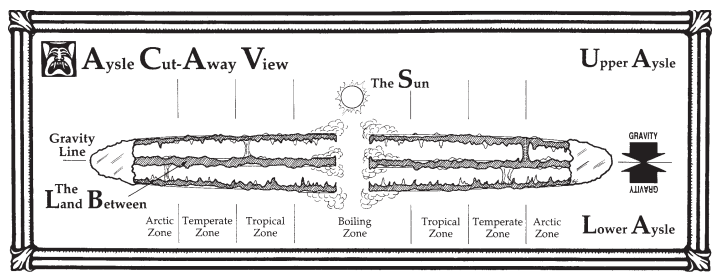
Aysle, Side View
quote:
It should be said that temperatures are not constant within a zone, but they are gradational. Basically, the closer one is to the sun, the warmer it gets. There are no seasons on Aysle — temperatures within a given circular band vary little throughout the year. Wind and water naturally move sunward. So, by definition, any wind or water moving rimward or in some other direction is unnatural and must be the result of magic or elemental forces.
Lower Aysle is the home of the giants, but unlike most fantasy worlds the giants are not automatically bad guys. Lower Aysle consists primarily of four continents: Chamkatt, Polja, Rakholm, and Arland. There was once a fifth continent, but some ancient calamity reduced it to an island range known as the Broken Land.
As for the Land Between, there are "underground" seas and continents, and what light they can get is from when the Sun passes through the hole in the world. That's really all the book has to say on the Land Between for now because it's time for more legends!
Once the Creators left Aysle to go work on a different cosmic project, dwarves began to spread throughout the world. Everything was nice and peaceful (as is often the case with legends like this) until the sun "became angry" for some unexplained reason and began to spit fire around the surface of Aylse. This forced the dwarves into the Land Between, and they decided to stay there as the sun raged on.
Eventually the dwarves wondered what was going on back on the surface, so they sent expeditions to see if the sun had settled its hash yet.
quote:
When they reached the end of the tunnel, the warriors were shocked. Moving in and out of the cities were ugly creatures who did not know the right way to use their tools, and who babbled and chattered and made great noise everywhere they went. The dwarves thought of attacking these intruders, but there were too many of them and too few warriors, so they wisely decided to return to the Land Between.
On the way there, they discovered another tunnel, and this one led to the Land Below, now known as Lower Aysle. There they found very ugly creatures who towered above the rocks and the trees, and carried big sticks with which they smacked each other. The dwarves were ready to attack these monsters, but then thought better of it, and once again turned for home.
When they told their tale, some believed, and others did not. Thus they offered to take the leaders of the tribe to the Land Above to prove the truth of what they said. They showed them the ugly, noisy creatures and also saw something new; rather handsome and industrious beings were building a city apart from all the others.
The the giants discovered the tunnels of the dwarves, and all hell broke loose as the giants swarmed to Upper Aysle. The humans and dwarves allied together, and tried to get the elves (the handsome ones) to join up; but being elves, they just sat back and watched.
Once the dust settled, the giants had won. For 500 years the giants lorded over the humans while the dwarves retreated to the tunnels.
Six pages into this chapter.
Then came the hero Dunad, a human warrior wielding the magic sword Aurel. Dunad refused to bow to the giants, and the power of Aurel made him invincible. Despite this amazing power, Dunad was still unable to free the humans from the yoke of the giants. It took much thought and study, but Dunad learned how to truly free his people. He travelled to what is now known as the Valley of the Sword, and shattered Aurel over his knee. This released the arcane knowledge trapped in the blade, which flew into the sky and became the stars. The knowledge then drifted across the world, granting the humans, elves, and dwarves the power known as magic.
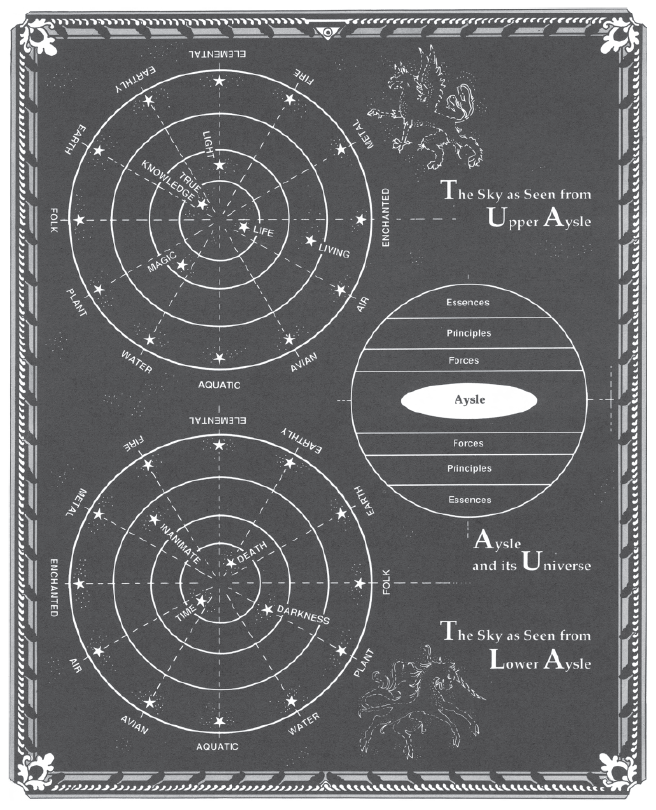
It is very important to know where the stars are because
This allowed the races to fight back against the giants, who found themselves unable to tap into this new power. The giants were forced back to Lower Aysle and the other races were finally free.
Dunad was never seen again, but the humans believe he went to the stars to be one with the powers he released. The hilt of his sword was found in the valley, and now serves as the symbol of the religion that has risen around him that now dominates Upper Aysle.
Once freed from the giant's control, humans began forming their own kingdoms around Upper Aysle. The elves maintained their lands, and humans granted the dwarves their own kingdom on the surface. The various rulers of each kingdom became noble Houses.
Of course, humans being humans, it wasn't long before all the Houses started infighting. It doesn't say how long this war lasted, but it ended when Lady Pella Ardinay managed to get all the heads of the remaining six Houses to sit down and hash out a treaty. It was determined that Houses could only control property, never people, and that the heads of the Houses would rule in tandem as a council. Lady Ardinay dissolved her own House as a show of good faith and gifted her property to House Tankred. Ardinay was selected as the leader of the council (since she controlled no land, she wouldn't have any reason to favor one House over another), disputes were settled with debate and concession rather than blood, and peace more or less ensused for centuries until Uthorion appeared.
Seven pages into this chapter.
So the Houses. The six Houses still exist, each one weathering Uthorion's leadership differently. For the most part they've stayed mainly on Aylse during the invasion, where Ardinay's current absence has created a power vacuum since she refuses to leave the realm until she can figure out how to undo what Uthorion did while posing as her. As a result, the Houses have returned to the old ways of flat-out warfare that threaten to tear Aylse apart.
The six Houses are:
House Tancred gave us Tolwyn, the knight who was famously killed defending Ardinay and who's soul was sent to the future to Mary Sue her way around the original novel trilogy. When she "fell" in battle, her brother Gareth secretly killed the head of the House and assumed control. Gareth allied with Uthorion-in-Ardinay (even though he never learned the truth of that situation), and was granted power from the Darkness Device to rule his House for the last five centuries. Now, between Ardinay's apparent change of heart and the return of Tolwyn, Gareth has turned into a paranoid recluse. House Tancred controls about half of Upper Aysle, and is the wealthiest of the Houses.
Once in control of about half of the Aysle continent, House Liandar has been driven back and beated down to the point where they only control one island that can barely support colonization. Attacks from other Houses and Orrorshian horrors during Uthorion's rise pretty much broke their power base. Still, the House maintains itself as a beacon of Light and honor in the wake of Uthorion's corruption. William Liandar, the current leader of the House, is trying to form alliances with the other Houses to fight back against the corrupt ones.
House Daleron is very heavily focused on warfare. They're the "might makes right" House, and took advantage of Uthorion's invasion to take a sizeable chunk out of House Liandar. House Daleron allied with Uthorion, being the only ones who knew what the situation was with Ardinay's possession. Now that Ardinay's back in control, agents of the House have traveled to Core Earth to try and overthrow her.
House Gerrik has always focused on seamanship and exploration. They had the misfortune of Uthorion's maelstrom bridge landing in their territory, and ever since they've gone from being one of the most powerful Houses to one of the weakest. House Daleron was given much of Gerrik's territory by Uthorion, leaving House Gerrik with no real other option than to hunker down and try to wait out the storm. Current leader Agustus Gerrik isn't sure what to make of Ardinay's sudden "change of heart", but he's banking on it being genuine and is throwing his support behind her.
House Bendes have been working to undermine "Lady Ardinay"'s rule for the past 15 generations, while publically backing her reign. This wasn't out of some sense that Ardinay was not who she seemed or anything like that; they just wanted to oust her and put themselves on the throne. Now that Ardinay has shown her weakness in calling off the invasion of Earth, the House feels this is the best time to strike. They operate mainly through hordes of mercenaries, and are planning on striking down the other Houses first.
House Vareth is composed entirely of dwarves, who were gifted a House name in thanks for their part in the war against the giants. The heady rush of political power has corrupted the House over the generations, to the point where the very idea of performing any sort of physical labor is repugnant to them. The Vareths solved this problem by kidnapping dwarves from the Land Between, enslaving them or selling them to other houses. Nowadays, the Vareths main source of income is through slavery. They eagerly joined in the invasion of Earth since it meant a new source of slaves, but now that Ardinay's had her change of heart the House leaders are getting really nervous.
Technically, the final house is The People's House, which pretty much just consists of Ardinay. Her territory was used as the meeting place for the various Houses, but when Uthorion took over he disovlved the council and used the territory as his home base. The maelstrom bridge to Core Earth is located in the courtyard of Ardinay's castle.
Nine pages into this chapter.
There are other kingdoms outside of the Houses, but really they're not so much unified peoples as "a bunch of similar dudes".
For instance, the "Elven nation" doesn't seem to have a real name or anything. There's nothing about their culture, their government, or really anything that an elven character would know about their own history. All we reall get for a third of a page is that non-elves have never been allowed to enter the Elveim continent at all apart from one trade city called Elvenport.
The Vikings, likewise, are listed as a single culture and a "fierce warrior race" despite (again) no real information being given on their actual culture apart from the fact that there seems to be only one tribe of Vikings. I'm sure you can guess what their main activities are, so I won't bore you with that stuff. The chieftain of all the Vikings is Thorfinn Bjanni, their strongest warrior. Thorfinn has declared war on Ardinay due to her sudden turn of weakness, but this is because Thorfinn's body is current host of Uthorion's soul. The Vikings are also tasked with guarding the maelstrom bridge at Ardinay's castle due to alliances made when Uthorion was in charge.
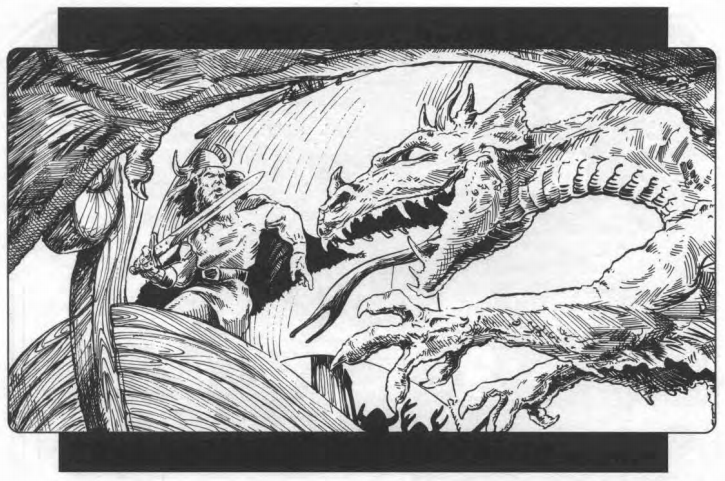
Yeah, there are dragons.
You wouldn't think that Corsairs would be considered a kingdom, but here we are. The way things are presented, it seems like a loose amalgamation of pirates who've set up their own Tortuga-like homeland and consider every ship its own "kingdom". Regardless, corsairs prefer to plunder in a non-violent fashion, because "repairing ships and crew is highly expensive".
The Barbarians are one big tribe that live on the island of Bar'aan, and are considered by the world at large to be unfeeling savages, filthy giant-lovers, and/or cannibals. The fact of the matter is that, apart from being more brutal than most other people, the only real way they're different from everyone else is that they don't have any real form of government. Otherwise they focus mainly on iron mining and warring with the nearby Vikings.
Freetraders is really just a conglomeration of people who loves them some trading. They don't worry much about where the cash comes from as long as it comes in, so as a result the Freetraders have a heavy hand in the slave and drug trades. Despite that, the Freetraders see themselves as "good guys" since they're the backbone of the world's industry and economy; they just pretend that other stuff is being done by outliers. The Freetraders are totally on board with the invasion, as it opens up new markets and trading opportunities.
The Ice Nomads are exactly what you'd expect from a people that live in the arctic regions and have almost zero contact with the outside world, so let's just move on.
Half-Folk are the newest "race" to appear on Aysle, having been created by the reality storms caused by Uthorion's original invasion. Native folk of Aysle were warped into half-man/half-beast abominations, and a lot of them were driven mad by the change. This is where you get your standard fantasy monster races like minotaurs, centaurs, and harpies.
There is one thing I will give Aysle credit for, though: no orcs.
The Giants still maintain control over Lower Aysle, but don't seem to have any interest in taking back control of Upper Aylse. In fact, there's been very little contact between the giants and everyone else since the big war centuries ago. The giants are organized into tribes, and the political situation pretty much boils down to "whoever is strongest gets to run things", and that a leader may be challenged at any time. This leads to a situation where there's not a lot of elderly leaders, but it also means that the big thinkers aren't the ones running the show.
quote:
The giants have a particular hatred for humans, especially those who worship Dunad. Giant histories make no mention of Dunad or his deeds, but refer instead to a traitorous giant named Lafetor who betrayed his race to the humans. Those giants who have taken the side of the Light tend to be followers of Ugorl or those who have ventured into Upper Aysle and been awed by the riches and the different races found there. A giant in Upper Aysle can find work fairly easily (there’s always demand for someone who can lift boulders and considers two wolacs a fair day’s wage). Other giants who oppose the ravages of the Dark Forces have formed a community on the isle of Ugorland in Lower Aysle.
The Dwarves are split between two kingdoms: the Land Between and House Vareth's holdings on Upper Aylse. The dwarves in the Land Between keep enemies from both sides of Aylse out via trapped tunnels and geurilla warfare; dwarves aren't strong, but they're crafty. This defense of their territory has aided the peace between Upper and Lower Aylse, mainly because neither side likes the idea of having to go through dwarven lands to get to the other. In fact, the only real outide threat the dwarves have to worry about are their own kind from House Vareth who will regularly raid the tunnels to capture slaves.
quote:
When Ardinay announced a truce, the dwarves were divided. Some took this to mean she had not been herself over the last 500 years, and was not responsible for all that had happened in Aysle; others claim she simply saw the battle was going against her, and decided to try the “Did I do that? I can’t remember!” trick that many a dwarf has pulled after a long night of lager. Regardless of their opinion, these bands continue the fight against the Dark Forces in the realm.
Finally, there are the Lesser Folk. These are what we generally refer to as "goblinoid races": gnomes, kobolds, ogres, and trolls. The Lesser Folk live primarily in the Land Between and have no real organization or government. At most you'll see a family sticking together, but that's about it. They'll stay out of the way of large groups of the major races, but can be quick to take down a lone traveler if they think they can get away with it. They also often find work as hired muscle for the more disreputable Houses.
14 pages into this chapter.
Now we get an overview of Magic In Aylse, and here's where we start getting into the new mechanics.
quote:
Since Dunad broke his enchanted sword and released the arcane knowledges into the cosm of Aysle, magic has been a part of everyday life. Because of Dunad’s blessing, all folk are born with a magic skill and a knowledge, and simple magic is as commonplace as electricity in Core Earth. The rim stars — those celestial embodiments of the Kindred and Element knowledges — determine which knowledge a person is born with. The skill is determined by the time of the month.
And how do you determine what magic skill and arcane knowledge you start with?
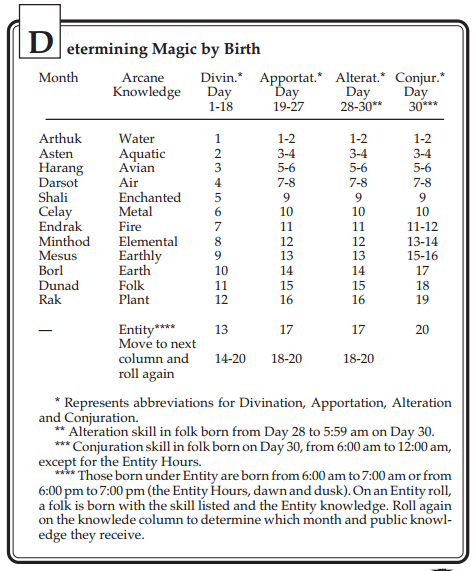
When your table has four footnotes, you really need to back up and rethink some shit.
Did you really need to ask?
The "Determining Magic by Birth" table allows you to pick or roll what skills you start with. All you need to know is the month, date, and in some cases time of your character's birth.
Yes, that's correct. You might need to know what time your character was born. I think Torg may be the only RPG in existence that's done that. So...achievement unlocked, I guess.
So if my character was born on the 29th of Endrak, he starts with one free add in alteration magic and the arcane knowledge fire. If you want to determine your skills randomly, you start by presumably rolling a d30 to determine the type of day, then a d20 to determine which month it was in.
But of course we can't leave it at that because that's too simple. You'll notice at the bottom of the chart there's an entry for the "Entity" knowledge.
quote:
When the arcane knowledges were released from the blade of Dunad’s sword, each found a home in the Limit as a star. One of the knowledges did not take physical form, however. It remained incorporeal, haunting the very edges of reality with its presence. But it retained the ability to manifest itself twice every day, at dawn and at dusk. These parts of the day became known as the Entity Hours, the time when the world is closest to the places of spirits, demons, and other things not of the folk.
And just to add another bit of mechanical whatsis on the pile, you can be born contrary. Once you determine your magic skills, you need to roll a d20 to determine if you were born during the day or night. This is because if you were born during the day, the star that's tied to your arcane knowledge wasn't in the sky and you're born contrary to the knowledge, which means you get +3 to your backlash roll. A roll of 1-5 if you're of "common" birth indicates contrariness, while if you're of noble birth you got mages to help out and you're only contrary on a natural 1.
15 pages into this chapter.
We now get information on The Mage Isles and the Arcane Academies for about half a page. Short form: there are four mage academies (the Isle of Being, the Isle of State, Bridge Island, and Pure Island), each one run by an archmage. Each archmage specializes in a body of arcane knowledges and that's where you go to learn how to be a full-blown mage. There are rumors of a fifth island called "Pinnacle", but nobody outside the most powerful wizards has ever seen it.
And yes, I'm zipping through this part, but I do have to point out how inconsistent the descriptions are here. Sometimes it feels like the writers are getting sick of the material as they write it (like I am).
This is the full description of the Isle of Being:
quote:
The Isle of Being contains the Seven Towers of Kindred Knowledge, and is run by the archmage L’lana of the Seven Towers. This mage allows all manner of kindred to wander the shores of her domain, but none save the serious mage-born can pass the tests that allow them entry into the towers of arcane knowledge. Normally, only six of the towers can be seen rising over the trees from the port town. But every day at dawn and dusk a seventh tower appears beside the others — the hauntingly different Entity Tower. To look upon the tower is to invite the notice of an otherworldly being, or so the legend goes.
quote:
The Bridge Isle, or the Island of Two Towers, contains the arcane academy of Mixed Forces. The elven archmage Thelim of the Two Towers oversees the academy.
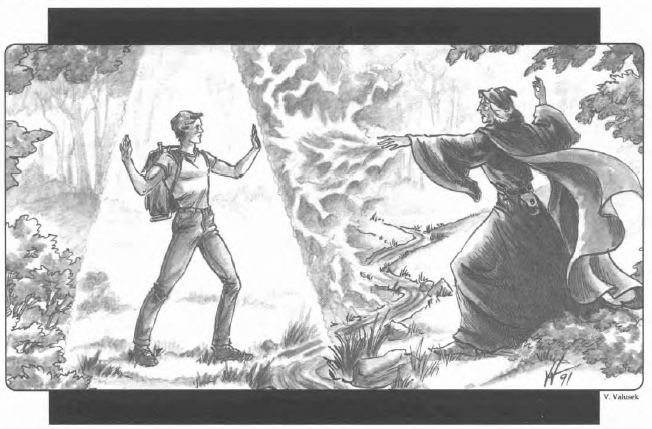
You shall not pass...this tiny stream!
Anyway, I guess we learned about the academies so we could then learn about Improving Magic Skills and Knowledges. For the most part, the people of Aylse don't try to get more into magic than their inborn abilities. That said, people also tend to specialize based on their star signs; if you're born with the metal arcane knowledge, odds are you're going to become a blacksmith or something.
This is because learning actual magic is expensive and time-consuming. Learning a magic skill takes 10 months for an Ord, or 10 Possibilities for a P-rated character. Having a teacher will halve that. Although technically, that's how learning skills works in the game anyway.
Going to a mage academy and learning the trade requires you to pledge yourself to one body of knowledge as represented by one of the academies. The applicant then has to undergo a test where they [SCENE MISSING]. If they survive the undescribed test, they can start learning magic.
quote:
When an apprentice joins an academy, he gives up his family name. So, Belder of House Gerrik becomes simply Belder for the remainder of his apprenticeship. Once he has achieved 12 adds in arcane knowledges (at least two of which must be from his pledged body of knowledge), then Belder can call himself Belder the Mage. Belder’s next goal is to achieve 20 adds in magic skills, 10 adds in any two knowledges of his academy, and at least one add in every other knowledge of his academy. Once he does that, then Belder can claim the title of his pledged body of knowledge. For example, Belder of the Three Towers, which makes him a master mage specializing in the Principles.
16 pages into this chapter.
The last big section of the chapter is dedicated to the Religions of Aylse.
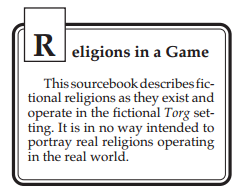
Remember when every RPG was required to have this disclaimer by law?
The gods of Aylse fall into three different moral stances: Honor, Corruption, and Balance. Unsurprisingly, these map one-for-one to the D&D versions of good, evil, and neutrality.
quote:
The followers of Honor tend to consider themselves good. The major tenets of belief center around faithfulness, loyalty, respect, and being true to yourself. The followers of Corruption see themselves as opposed to the followers of Honor. Their actions could be considered evil, and they take the form of both overt and subtle activities. Their tenets incorporate destructive and disruptive tendencies. The followers of Balance try to walk the middle path, leaning neither toward Honor nor Corruption but incorporating both into their tenets. They believe in balance, and strive to maintain a balance in everything.
Despite cleric-y abilities being based off the faith and focus skills, each god influences specific arcane knowledges. In fact, people who follow the gods get a +2 or +3 bonus when casting spells within that god's preferred knowledges.
The gods of Honor are:
- Dunad: We already know about this guy. He's the god of generally goodity.
- Shali: Shali was the first "real" mage in Aysle, and was Dunad's lover. She sought out the secrets of the world and followed him into the heavens to become the goddess of magic.
- Argon: As near as I can tell his whole shtick is to hunt down the corrupt god Harang.
- Mesus: Mesus appears as a female centaur and is a general-purpose goddess of nature.
- Elmiir: The elven god of water. Legends state that he brought elves to Aysle from another world.
- Asten: The beautiful mate of Elmiir is the goddess of...something. It really doesn't say.
The gods of Corruption are:
- Arthuk: Arthuk was the original leader of the giants back when they ran Upper Aylse. Dunad killed him with his enchanted sword, but Arthuk refused to surrender to death and became the main god of corruption.
- Borl: Borl is the mate of Arthuk and is the goddess of the corruption of life.
- Harang: The god of torture, and patron of harpies.
- Estar: Estar is the corrupted son of Elmiir and Asten, and is responsible for teaching the giants the ways of magic.
- Endrak: The god of fire and darkness, who teaches that the world should be cleansed by fire and claimed by darkness.
- Kalim: God of the Lesser Folk. Your standard-issue loud hostile war god.
- Cobra'al: God of "entities". Technically he's a god of corruption, but a lot of the other dark gods refuse to hang out with him. He exerts control over demons, spirits, and the undead.
The gods of Balance are:
- Minthod: This minotaur is the god of "adventurous half-folk". He actually preaches patience and knowing when to pick your time.
- Celay: A gnomish goddess who attempts to pull the Lesser Folk away from worship of the gods of corruption.
- Darsot: The god of peace and diplomacy.
- Areel: God of night and war. That should tell you everything you need to know about her priests.
- Ugorl: The giant god of moderation. She's more popular in Upper Aylse than Lower Aysle.
- Rak: Viking god of living forces and "survival of the fittest".
There are two other major religions that need to be covered.
First up is my personal favorite, Secular Dwarvenism. As stated back at the beginning of this post, it's common knowledge that the dwarven gods created the world and that the dwarves were the first race on Aylse. However, when the other races started showing up, they were rather annoyed that this world created by all-powerful beings wasn't exactly well-designed. And since that was clearly because of the now-extant dwarven gods, the dwarves themselves ended up catching the second-hand resentment. The dwarves, meanwhile, were rather annoyed that their gods didn't bother to fix all the problems they saw in the creation of Aylse and instead went to make a different, better world. Plus everyone else was mad at them because of their gods' shoddy workmanship.
The practical upshot of all this is that the dwarves as a culture hate the gods and don't want anything to do with them at all. They know the supernatural exists, of course, but they feel that the gods and such should just leave them alone, thanks. There is an undercurrent of "smug atheism" in there as well, since the dwarves have a tendency to look down on people who do beseech the gods. The spiritual role in dwarven society is filled by philosophers and general pragmatism.
The only known philosophical sect of the elves is the Elven Path of True Knowledge. This is a fairly aesthetic movement that states that the path to true understanding of the universe can be found by studying all of it. The sect's main purpose is to walk the world and acquire as much knowledge as they can. This knowledge is then recorded in their temple library. The sect has sided with Uthorion's invasion solely because it opens up new worlds for them to explore. The monks may not imbibe alcohol or take mind-altering drugs, and are forbidden to aquire wealth beyond what is needed to further their search for knowledge.
If a monk has adds in the faith skill, they can learn Elven Disciplines. Unlike every other form of powers in Torg, these are actually free; you get one per add you have in faith. You can do stuff like increase your Mind stat when resisting mental control, get a few adds in other skills, increase the damage of your punches by two, or reduce fatigue from pushing yourself.
Lastly, we get a brief section called Adventuring in Aylse. The unqiue thing about Aysle compared to the other cosms is that it actually possible to head up one of the many bridges with Ardinay's permission and go tromping around Aylse, although I have no idea why you'd want to do that. I mean, yeah you've got the political infighting of the Houses, but dealing with that kind of thing is not what Torg's systems are good at. Again, I get that games with design focused on intrigue were a long time coming, but still the Houses work better as background stuff or seeing how they deal with the situation in the cosm.
quote:
In addition, characters from other fantasy roleplaying games might somehow find themselves on the disk-shaped world and have to handle the complex and dangerous intrigues that have become an integral part of life in Aysle. Perhaps Uthorion mounted an attack on that fantasy realm in an effort to drain its possibility energy.
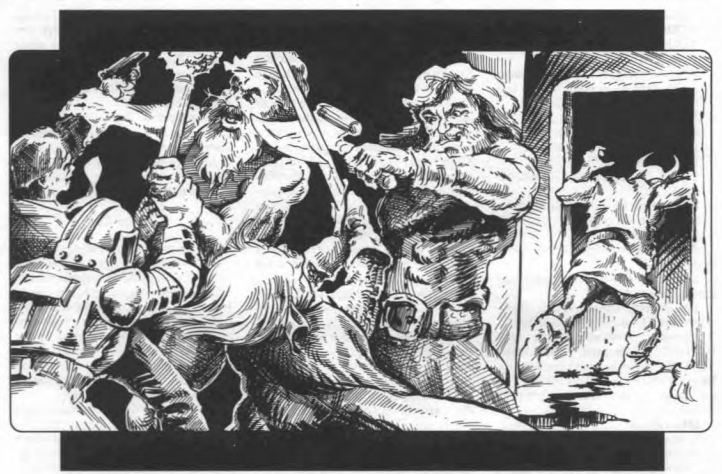
Or you can just do generic fantasy adventuring, I don't know.
20 pages into this chapter, and the end of the chapter.
-----
God, I hate this book.
More than any other cosm book, this one is just full of shit I don't need to know or care about. In fact, it's also the biggest of the cosm books (~130 pages, most of the others are only 90-100 pages).
Look how long this is. Look at it. And bear in mind: I summarized a ton of stuff. The details of everything are just so dull and pointless. I mean, there are starcharts of where the various stars are in relation to Aylse. Why? Did we really need to waste a page on that?
What really gets me is how genericly pointless half this stuff is. The gods get four pages of descriptions, but it's a total D&D "pile of gods" pantheon. There's no thought into why people come up with gods, it's just a bunch of gods of what the writers think they should have gods of. There's nothing past the surface thoughts of half of these ideas.
And belive me...it only gets worse from here.
NEXT TIME: Merrye Olde Englande
The Olde And the New
Original SA post The storm has a name... - Let's Read TORG
Part 15c: The Olde And the New
So now it's time to talk about the Aysle realm, so of course to start off we have to talk about Tolwyn of House Tancred, a.k.a. possibly the series' Mary Sue-iest character.
As I've mentioned before, Torg technically begins with a trilogy of novels that cover everything that happens from the first bridge drop in Indonesia to the defeat of the Gaunt Man, ending at the "start" of the box set a few months after the invasion began.
One of the main characters in the novels was Tolwyn, a knight from Aysle and the leader of Ardinay's Knight Protectors. Tolwyn was supposed to protect Ardinay during Uthorion's invasion, but Ardinay cast a spell to remove Tolwyn's spirit from her body and leave it in a sort of suspended animation. How Ardinay knew that this was a good idea is anybody's guess.
(And since this is Torg, that spell is available in the game as an eternity shard power. You know, in case you want to send the soul of one of the PCs centuries into the future.)
Regardless, Tolwyn's soul floated around for the 500 or so years of Uthorion's rule. Then the whole invasion thing happened on Core Earth, and Tolwyn's soul was (somehow) slam-dunked into the body of a Core Earth woman Wendy Miller who was the victim of a hit-and-run during the confusion of Baruk Kaah's attacks on New York.
(I bring this up because it's some that's always made me feel uncomfortable; in the novel we see Wendy's soul passing by Tolwyn's as Wendy dies in the hospital, and she seems awfully chill about both being killed and someone else taking over her body. Stuff like that always makes me uneasy.)
Anyway, Tolwyn does damn near everything. She assembles the main characters of the books to fight together, she's the one who creates the term "storm knights", she's the one who defeats Uthorion, blah blah blah. She's just awesome all around and is the one who wins (and as the line progresses, continues to win) pretty much everything.
Oh, and Tolwyn has a full stat block because of course she does.
The point of me telling you all this is because she was the only one who was destined to defeat Uthorion. Uthorion knew this, and when he heard that Tolwyn had returned but had been killed he came down one of the bridges to Core Earth. Tolwyn wasn't dead of course (since she's a pet NPC and all) and confronted Uthorion in the Dreamtime. Which, if you may recall, was where Malraux got the cybervision that caused the Cyberpapacy to happen. Uthorion was ousted from Ardinay's body, Ardinay was back in her body, and that put the forces of Light more-or-less back in charge.
There's two reasons I'm leading with this information. First, it's because the chapter leads off with it. Second, Ardinay's seeming change of heart halfway down the bridge has put her leadership position on very shaky ground. Because nobody knew about the whole possession thing, it looked like Ardinay went from "GO FORTH AND CONQUER, MY MINIONS!" to "We must sue for peace and help these people" in like half an hour. Now the forces who were loyal to Uthorion-as-Ardinay are either in disarray or seeing this as a chance to sieze power for themselves.
Let's take a look at the ol' realm map, because this is gonna get more complex than it needs to.
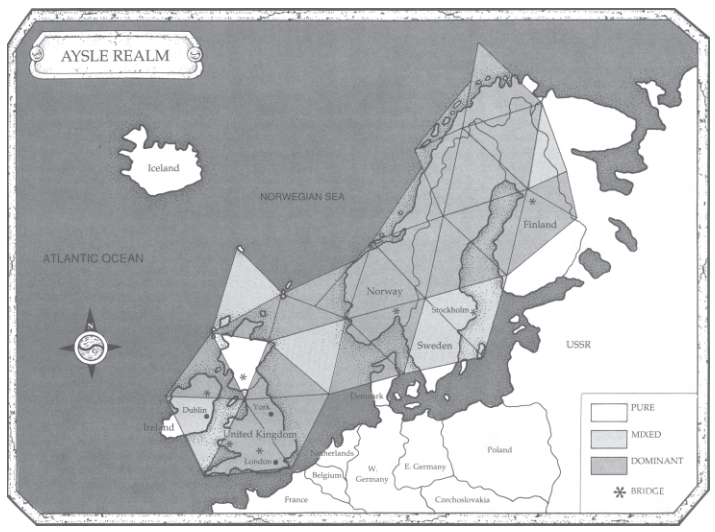
The Aysle realm, about three months after the initial invasion.
Uthorion's defeat did more than just shift control to Ardinay. It also altered the ream itself in a rather fundamental way.
quote:
Uthorion’s defeat and the restoration of Ardinay’s spirit wrought many of the same changes in the Aysle realm as occurred in the cosm. Dunad offered the Ayslish on Earth the same choice he had given the residents of the cosm: live under the world laws as perverted by Uthorion, or return to the natural tenets that had existed long before the High Lord arrived.
When the choices were made, reality twisted in the realm. Areas that had been barren and blighted suddenly became lush and green once again, while in other regions, fields withered and crops died. Evil creatures that had appeared angelic saw their features melt and change, becoming hideous reflections of the wickedness in their hearts.
But with neither the Light nor the Dark being dominant in the realm, portions of the land remain bleak and foreboding, yet populated by beautiful, alluring creatures who hide monstrous corruption in their souls. Other regions are fruitful and teeming with life, yet when the sun disappears, foul things emerge from caves to stalk the night.
And now we get into the details. There are seven Aysle bridges all told: the main bridge from Ardinay's castle landed just outside Oxford, and the others are in Wales, Scotland, Ireland, Norway, Sweden, and Finland. Unfortunately, the map only shows five of them so I don't know if the other two were pulled up or if they're just not shown.
The first country we learn about is England, and it's in a really bad spot. The entire island is operating under Aysle axioms, effectively cutting the whole nation off from the rest of the world. The reality storms around the realm's borders make it incredibly dangerous to get goods in (or people out) by sea. Not helping matters is the fact that both sides of the English Channel are taken over, so that two-mile-wide stretch of water is a constant storm of three realities battling each other. The sea monsters that have cropped up in the realm aren't helping, either.
The inability to get any sort of easy basic supplies into a realm is always a problem, but England's position makes things worse than usual. Ardinay is unique in that she won't stop goods from coming in, but ships have a really hard time getting through the reality storms. England's farmlands have been hit with a one-two punch of getting wrecked by the land becoming Corrupt (which kills the soil) and the fact that they're forced back to a medieval level of technology that is ridiculously unable to keep up with the needs of England's modern-day population. In fact, the technological drop and stelae zone coverage have really driven home how geographically isolated England actually is.
The "main" Aylse bridge is in Oxford just outside Christ Church College, and this has become the seat of Ardinay's realmside government. Since her "change of heart" many of the college's academic staff have become her advisers. Refugees from the surrounding areas are swarming into the city since it's one of the safest areas in the realm.
Speaking of refugees, the lack of easy departure from the island has left thousands upon thousands of people stuck wandering between cities that can't support them. Not helping matters is that the countryside is now swarming with highwaymen, bandits, minotaurs, dragons, giants, ogres, and other assorted fantasy detritus that see refugees as a source of income and/or food.
There is a bridge in Wales as well, but because it was dropped just before Uthorion's defeat (and therefore didn't have Dark armies sent down it) Wales has actually made out relatively well. That's not to say it's completely safe, but the lack of heavy monsters in the area have made the transition a little less terrible.
It's worth pointing out that Ardinay is currenly focusing on fixing things in England and Wales, and is pretty much ignoring Scandinavia. She'll send her own troops or Storm Knights to go help there, but so far they're on their own.
There are four major hardpoints in England: London (duh), York, Stonehenge (also duh), and Salisbury Plain. Out of all these, London is the only one that gets any actual description.
So London. London, as you can imagine, is undergoing the biggest overcrowding problem it's ever had to deal with at about 24,000 people per square mile thanks to refugees streaming in almost constantly.
Power for the city is handled by coal and oil burning, but since those aren't easy to get under Aylse's tech axiom the city is forced to heavily prioritize who gets electricity. Said priority goes to government offices, vital infrastructure (like hospitals), and the military. This means that the rest of the city has to rely on personal generators at best or batteries at worst. A black market has sprung up selling power-related goods, and a lot of Aylsish dwarves have been making a good living fixing broken generators and figuring out how to build converters for car batteries.
The lack of power means there's almost no mass communication inside the city, and lack of fresh water is also starting to become a problem, partly because it's damn near impossible to get water up past the third floor of a building.
quote:
York Road between Westminster Bridge and Waterloo Bridge is completely without water because a band of dwarves has blocked off the pipes and turned them into living quarters for themselves.
It's interesting to point out that the London Stock Exchange is still operating, which is surprising given the rather destroyed state of the world economy. No information is given on how it's working or interacting with the outside world, but we are told that dwarven merchants have started getting involved on the Exchange and are making a killing.
The biggest internal threat facing London is from the Underground. Due to its dungeon-like nature and lack of power, it's become a home for ogres, trolls, and the occasional dragon. The Underground has also become the de facto home of the newest species to show up: the goblins.
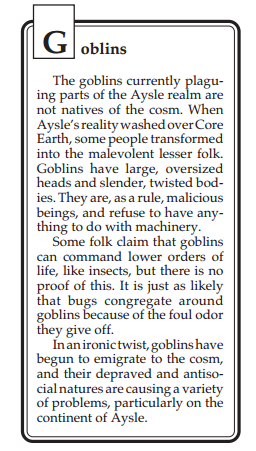
At least they're not soccer hooligans.
Overall, though, London is attempting to soldier on. It's generally held that the current situation is better than what happened in the last war, and Londoners are becoming accustomed to seeing the occasional dwarf or elf going about their business in the city. There is a growing tension growing in the populace about the state of the royalty, however. Out in the countryside, it's not uncommon for native English to refer to Ardinay as the Queen, even though she's not even queen back in Aylse. She's not making any attempts to stop anyone from calling her this, which has led to suspicion that this may be a long-term plan to undermine the Royal Family. The Royals, for their part, are safe in Buckingham Palace under heavy guard. You know, just to be on the safe side.
While not a hardpoint, Oxford gets some coverage due to being ground zero of the main bridge drop and for being Ardinay's seat of government in the realm. The initial invasion did a number on the city, but now that Ardinay is back in charge the city has become the central point of trying to figure out how to undo all the damage done by the invasion. Ardinay is advised by people from both Aysle and Core Earth, and this makes the city a very tempting target for the forces of Darkness. The city is protected by the Home Guard, a combination milita and police force that answers directly to Ardinay.
Meanwhile, Ireland is doing a little better than England. Most of the country is still under Core Earth axioms, so the general populace still has access to things like medicine and electricity. That's not to say everything's great; Uthurion's invasion force has been composed mainly of giants and dwarven demolitionists that have done a pretty hefty amount of damage to the country. This has forced the IRA to work with the British military, which neither side is really happy about. Since all their weapons and homemade bombs stopped working under the axiom wash, the defensive forces have had to resort to guerilla warfare. All Irish citizens are given "officially unofficial" basic military training and are drafted into military-ish service, becoming medics, rescue personnel, and other support positions. The general mindset is "if you're going to stick around here, you're gonna have to help." The two biggest Core Earth hardpoints in Ireland are the Books of Kells in Dublin amd St. Patrick's Tomb in Downpatrick.
Belfast has been hit particularly hard by the invasion force, partially because the giants that attacked the city were one of Uthurion's elite units, and partially because the dwarven half of the invasion force remembered they hated the giants half and turned on them.
quote:
Worse than the wanton destruction in the dwarves’ eyes was the fact that much of the potential plunder was ruined, and not having any great love for the giants to begin with, they began to turn on their Brobdinagian allies. When Ardinay made what seemed to be a miraculous change back to the ways of peace, the two groups realized they would have to look after their own interests, and skirmishes broke out in the city.
Regardless, between that and a dragon that decided to set itself up nearby for some reason, Belfast is pretty much a warzone where everybody is fighting everybody else.
Dublin, meanwhile, is in a dark Asyle dominant zone, which means it's partytown for goblins and ghouls despite the city's hardpoint.
quote:
City officials made overtures to some of the dwarves in the area in search of help, and the little folk readily agreed. Unfortunately, they discovered the abandoned Guinness Brewery at the same time, and have since been seen but rarely, staggering and hiccupping up and down Stevens Lane.[quote]
Classy.
The city's also been overrun by faeries, but fortunately Irish myths about how to handle the fair folk have applied to Ayslish fae as well.
Scotland is the only Ayslish pure zone at this point thanks to the bridge in Glasgow. Just over half the population has transformed into non-humans, and the loss of technology brought about the collapse of the central government. In response, most Scottish citizens have kind of reverted to a clan system in order to protect their own hides. This doesn't really help when the realm swings between Light and Dark, which it does rather frequently. On the plus side, a proportionally large number of Storm Knights have been cropping up in Scotland and have begun getting organized to fight back.
Norway is currently embroiled in conflict with the VIking tribes, and unfortunately Norway is losing. The axiom wash was devastating on the Norwegian navy, and the Vikings were right there to take advantage of that fact before anyone really got a handle on what was going on. Lady Ardinay has been attempting to send aid to the country, but the Vikings are too entrenched and have so far managed to destroy any incoming ships.
[quote]
Interestingly, reports have come out of the city of Stavanger of a large number of Japanese businessmen in the area, apparently engaged in heated negotiations with the Vikings. It is believed they may be agents of Nippon Tech, attempting to secure the rights to make use of the abandoned oil rigs that dot the North Sea. The arguments have focused on just how much of a cut the Vikings will receive for not burning the rigs.
It's worth pointing out once again that the leader of the Vikings, Thorfinn Bjanni, is actually the current meat suit of Uthorion. Nobody's aware of this (remember, very few people in Aysle even know Uthorion exists), but some of the Viking tribal leaders have noticed that Thorfinn's been acting more bloodthirsty than normal.
Denmark has hit a very odd equilibrium in terms of the invading forces. The Vikings were able to take over about a third of the country right at the start of the invasion, but then the whole Uthorion-gets-kicked-out thing happened, and suddenly the Vikings had no support from the "Queen". As a result, the Viking forces are sitting around awaiting orders because they don't know if they're still supposed to be taking the country.
Sweden is one of Uthorion's landing points, with a giant waterspout landing in the middle of Stockholm. But there was a delay in getting the bridge dropped (why? Doesn't say; it's probably in the novels.) so the Swedish army had a chance to get ready when they saw the other bridges dropping. Since they knew that modern tech wouldn’t work, the defense forces started pulling ancient weapons out of the [url=”https://en.wikipedia.org/wiki/Livrustkammaren%94]Livrustkammaren[/url] and the [url=”https://en.wikipedia.org/wiki/Swedish_History_Museum%94]Historika Museet[/url] which proved to be still effective under the new axioms. That’s not to say Sweden had everything its own way; Viking forces still swept up the coastline from Norway, forcing the Swedish government to pretty much abandon the northern part of the country in order to focus their defenses.
Finland has been having a lot of problems with Vikings, but more of a problem with trolls, giants, dwarves, and other assorted non-human threats. The Finish defense forces have fallen back on tactics used back in WWII against Nazi invaders, such as ski trooper units who are a lot more familiar with how to fight in snowy regions and have started resorting to guerilla tactics. The Finish people are not happy about this whole “another damn group of would-be conquerors” thing, and the central government has set up a “Radio Free Helsinki” that broadcasts exhortations for the people to take up arms and fight against the invaders.
Okay, before we move to the next part...I have to point out again how fucking dense this book is.
You see those paragraphs where I summarize what’s happening in each country? In the book, they’re at least a third of a page, with some of the capital cities getting another column or so. Meaning that each country gets the better part of a page.
But really...do I need that much information? Again, I get that this is supposed to be a globetrotting game, but come on, I don’t need troop movements and who’s doing what to who gives a shit and all this fucking detail. Learn to summarize, book that came out 20 years ago!

Anyway. We’re still not done because it’s time to talk about Life in the Aysle realm!
Needless to say, the economy in England is a fucking mess. See, the economy in Aysle is based on magic; specifically conjuration magic. The base monetary standard in Aysle is the “conj”, which represents how much energy it takes to use a conjuration/magic spell to create half an ounce of platinum for one hour.
quote:
Since all money must have some tangible basis for its value, Ayslish economists spent many months determining just how much such a spell would be worth in precious metals. For instance, the standard conjuration/magic spell is worth .5 ounces of platinum, one ounce of gold, and 1.85 ounces of silver.
A standard spell is worth, in Ayslish currency, 70 conjs, 300 lemays, 600 trades, and 1200 wolacs. In U.S. currency, it is equal in value to $300, or 206 British pounds.
Of course, this has been wreaking havoc with the London Stock Exchange. Not only are they trying to integrate a monetary system that is literally based on magic, now all these new stocks are forming for things like dwarven mining and, yes, magical services. The trade in magical services has actually caused a boom in the Ayslish economy due to Storm Knights seeking out magic training or weapons in order to fight the good fight, but it still wouldn’t take much at this point to completely tank both the Aylsish and British economies.
We get a brief discussion on The Sexes in Aylse, which boils down to “equality of the sexes has been the norm for centuries”. Not much to really expand on here.
Now we get to learn about the Class System, which is where the inequality comes in, because it really is based off caster superiority.
At the top of the class system are human sorcerers, i.e. people who actually focus on and have expanded on their magical ability. Below them are human priests, and below them are human warriors. And yes, those are the terms the books use. I guess it’s a literal class system?
Below the warriors are the freetraders, a.k.a. the people who actually keep the economy working, and after that it pretty much boils down to “everyone else”, with the barbarian types on the lowest rung.
The non-human races tend to follow the same basic class structure, with the wizards and sorcerers being at the top and everyone else below them. That said, humans tend to treat elves and dwarves as “below them” on the ladder, while the elves just know they’re better than everyone else.
All that said, the half-folk are basically slaves with no rights in general Ayslish society, with the lesser folk like gnomes, goblins, and ogres barely considered “people”. In fact, killing lesser folk is barely considered a crime.
Which leads us nicely into Justice in Aysle, which gets less space than the next section on fashion because we all know what’s important here, right? Basically the laws of Aysle more-or-less line up with England’s.
Yes, there’s a section about Fashion because it’s really important to get into the details of how people dress. Big shock, they dress as you’d expect for a Standard Generic Fantasy Realm, which is to say "Reneisance Festival".
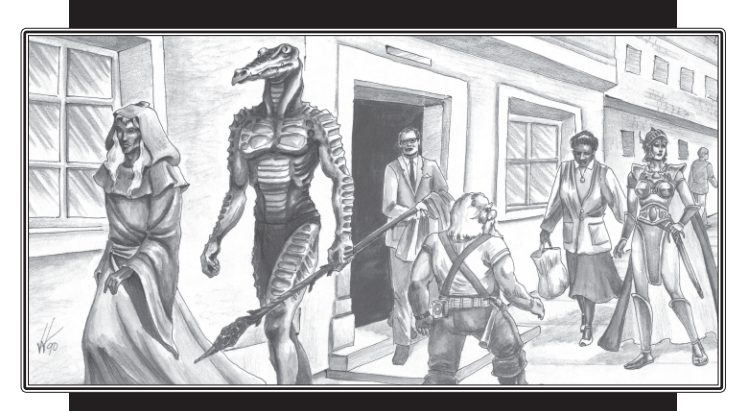
All the lonely people...where do they all belong?
The next part is about Magic and Technology, because there is a rather important culture clash there. As stated previosuly, everyone from Aysle is capable of casting at least one spell. This means that, due to magic being so prevelant, technological advancement has been incredibly slow. Technically speaking, magic fills the role of technology in terms of day-to-day life. An Ayslish resident paying for someone to cast a long-distance communication spell is treated with about as much gravitas as someone from Core Earth making a phone call.
Citizens are expected by law to register their magical abilities (as in, which magic skills they know) with the government. This is so said government can keep track of who's capable of doing what, pretty much in the same way we register our ability to drive or own a handgun. Also like reality, not everyone who should be registered is registered. Since the Ayslish economy (and now Core Earth's) are tied into concepts of magical ability, it's not unheard of for casters to manipulate the economy for their own benefit.
Likewise, since magic does pretty much everything the people of Aysle have little use for technology, and Core Earth tech is given the ol' side-eye by most Ayslish. Back home, people see technology as kind of pointless; why spend all this time and effort trying to figure out how to make demolitions for mining when you can probably find someone who can just cast a "move earth" spell and call it a day? As a result, only the dwarves seem to care about technology. In Aysle, single-shot gunpower weapons and basic steam engines are pretty much the cutting edge.
This has caused a few...incidents when the invasion happened and the invaders came up against Core Earth technology.
quote:
Shortly after the invasion, a band of Freetraders encountered a Stormer serving in the Dark Forces. The Stormer shot one trader with a pistol, wounding him in the stomach. The merchants were familiar with primitive firearms, but not having seen the Stormer go through the complicated process of loading the gun they were used to, did not make the connection. Thus, believing the gun a magical weapon and the wound caused by the great noise it made, they did not discover and remove the bullet, and their companion bled to death.
Almost done! We just need to get through talking about The Houses in the Realm!
Each of the noble houses have, of course, set up shop in northern Europe. Each one has "claimed" a part of the realm, despite whoever was actually there first.
House Tancred has set up shop in southeastern England, and is run by Tolwyn. Despite the infighting between the members following Tolwyn and the ones loyal to Gareth, the House has re-pledged itself to Ardinay and trying to fix the damage of the invasion.
House Liandar are in the northern part of the realm, and are stuck between House Vareth's land and Utorion's forces. House leader Cedric Liandar has determined that Ardinay has recently shaken off a dark sorcery that twisted her mind (which is sort-of true) and has pledged himself to her service.
House Daleron is still allied with Uthorion, even though they don't know where he is right now. Daleron has the largest House-controlled military in the realm, and has taken the counties of Suffolk, Norfolk, Cambridge, Lincoln, Leicester, Nottingham, and Rutland, and the cities of Cambridge and Norwich. Manfred, head of the House's lands in the realm, is currently focused on taking Oxford from Ardinay.
House Gerrik is pretty much Oxford's main line of defense against the other Houses. In fact, House Gerrik were actually gifted the counties of Cornwall, Devon, Somerset, Glouster, and the surrounding counties by Ardinay herself. The House's interests are managed by Duncan Gerrik, who is in love with Tolwyn and is hoping to marry her and bring the two Houses together.
House Bendes is also still loyal to Ardinay, even though historically they paid lip service to Uthorion. Bceause of their service in using its vast wealth to support rebel forces against Uthorion, Ardinay gave the House "control" of Wales. Earl Thomas Bendes has been focused on fixing the economy and infrastructure of Wales, focusing on food and weapon production to support other Houses.
House Vareth is still terrible. Even after Ardinay's return, they're still invloved in the slave trade. The House has actually stepped up its game, using forces of minotaurs with automatic rifles to take isolated villages and towns for people to sell off. Taleron Vareth is in charge of the House's territory around York and Lancashire, and is a firm believer in the use of violence and torture to get what he wants.
---
Fucking finally.
This chapter...this chapter is waaaaaaay too goddamn dense. I know how much I keep saying this about every Torg book, but there is just too much stuff here. I mean, look how long this post is, and summarized a lot of things. And the biggest problem is that I don't need to know all of it. Nothing is summarized or described in broad strokes, and after a while your eyes just slide off everything.
And we're still two chapters away from the WORST chapter in the book.
NEXT TIME: Rules of behavior.
Laws of the Land
Original SA post The storm has a name... - Let's Read TORG
Part 15d: Laws of the Land
This chapter is the ususal "Axioms and World Laws" chapter, but also includes two new skills that are unique to Aysle.
As is always the case, I touched on the axioms and world laws back in the first Aysle post. But let's look at the axioms in closer detail.
Magical Axiom: 18 Aysle has the highest magic axiom out of all the invading realms, including the ones added later. The high axiom is what allows everyone in the cosm to inherently know one spell. In addition, enchanting magic is possible, and creatures that can only exist in a world where magic can let them override "physics" (like, for instance, dragons) are relatively common.
Social Axiom: 18 When you get right down to it, Aysle is very much a "perpetual Renaissance festival" society. You know, kings and queens, knights, serfs, things like that. Technically speaking it's "medieval Europe", but the standard of living is better thanks to the prevalence of magic. The overall standard of living is comparable to post-Industrial Revolution Europe. When Uthoion was running the show, the various cultures and people were forced to "work together" under pain of pain, but now that Ardinay's back in charge the various countries and such are becoming more independent.
Spiritual Axiom: 16 Basically, gods exist and people of faith can tap into their devine power and channel it into the world. That's...pretty much all there is to say about that.
Technology Axiom: 15 The best way to describe Aylse's level of technology is "early Renaissance". Technological development has always been a low priority since magic can do all that stuff easier and cheaper. Unsurprisingly, dwarves are the most advanced race in this area, having developed basic steam engines and wheel lock firearms.
Yeah, not a lot there really. Let's just move on to the World Laws.
I'm just going to go ahead and quote myself on some of the World Laws because there's not much left to say about them:
quote:
The Law of Observation states that reality in Aysle is defined by what one can observe through the normal five senses. What this means is that in Aysle, what is observed is true. The sun rises and falls not because that's how people observe its path based on the revolution of the planet in relation to a stationary object, but because the sun actually does rise into the sky then fall again.
This law has zero effect on gameplay, or really on anything at all. I'm not really sure what the point of it is.
The Law of Magic states the following, and I quote:
I mean technically it exists in other realities where this law doesn't exist, but it also exists in Aysle. It's worth pointing out that this law also states that everyone in Aysle starts with one free add in a magic skill and a magic knowledge skill, and that racial stat limits are higher here. But really, the main reason this law exists is because the Law of Observation states that only things that can be observed are real, but you can't observe magic, so instead of going back and changing the useless Law of Observation, they added this as a sort of band-aid.quote:
The Law of Magic states that magic is real.
The other two Laws are The Law of Honor and The Law of Corruption, and they work pretty much the same way and function as a sort of alignment system.
The Law of Honor states that honor cannot be hidden; the good that you do is reflected in your spirit and will affect the world around you. "Honorable" traits are things like loyalty, keeping your word, bravery, and respect.
The Law of Corruption states the same, but for "evil". The evil you do will be reflected on you as well, eventually twisting your body and making you more obviously evil. "Corrupt" acts are things like premeditated theft, cheating, cowardice, or turning traitor. If you become too corrupt, the Law will reveal that person's evil nature in their body and soul.
Before Uthorion happened, the Law of Honor was the dominant Law in the land. This was mainly because if someone acted too evil, the Law of Corruption would punish them to the point where you could just look at him and go "yeah, he's evil" and they wouldn't be able to hide their wicked ways.
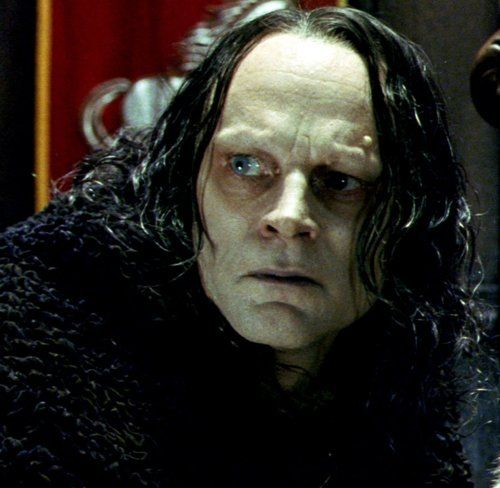
Case in point
Once Uthorion took over, he used his Darkness Device to alter the Law of Corruption in a small, but very effective, way. Now, those who commit evil deeds are able to transfer the signs of their corruption into the land itself, sparing them from the direct wages of sin. Now, no matter how heinous someone acted, the usual obvious signs of their misdeeds never appeared. And in a world where everyone knows that "very evil people will look evil because that's how the world works," this was the perfect cover for the world's assholes.
While Uthorion originally changed the Law so that his deeds wouldn't be found out when his Ardinay bodysuit started looking like a crone, word quickly spread and evil got a major upswing in the world.
When corruption is passed to the land, things will look very "cursed land" very quickly. The soil will become dry and dusty, trees become twisted and black, and the sky is always overcast. This only affects the land where someone powerful and/or in charge has been going full supervillain, but even so there are large patches of Aylse that been corrupted.
In the realm itself, Uthorion's corruption (and the evil of his subordinates) and the return of Ardinay have been affecting the steale zones. Some zones are "light" zones where the Law of Honor is stronger and the Law of Corruption works the way it used to, and there are "dark" zones where Uthorion's version of the Law of Corruption holds sway.
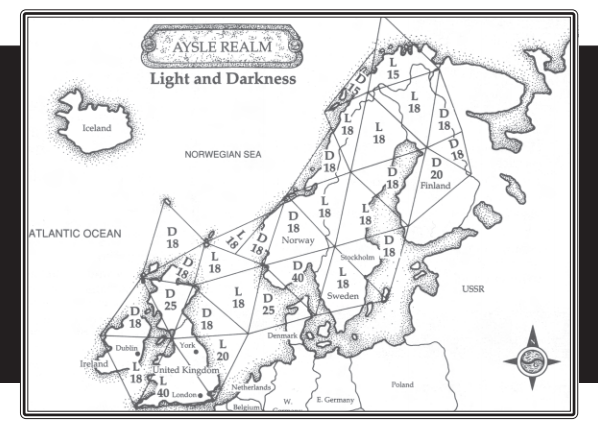
The "Patchwork Realm"
There's no real mechanical effect of whether or not you're in is more aligned to Ardinay or Uthorion, but the zone's inclination will have an effect in terms of who's in charge, the types of threats you'll face, things like that.
Of course, this being Torg, there are mechanics for determining if a realm flips to one side or the other.
quote:
To reflect this in the realm, refer to the “Light and Darkness” map. Areas within a stelae triangle can be either light (“L”) or dark (“D”), and they have a difficulty number as well. When making a patchwork check, roll a die. If the final roll (rolling again on 10s and 20s) is equal to or greater than the difficulty number, then the area flips.
...
Make a patchwork check for an area whenever any of these conditions are met:
• Once every month of game time.
• Once per week if the Darkness Device is used specifically to cause a check (but only on one area per week).
• A glory card is successfully played in a dark area.
• A character with 14 corruption adds specifically calls for a check (which he may do once per adventure).
These are the only two new skills added in the book, and they're mutually exclusive. There are two ways to get the skills: either by buying them during character creation or by earning them later on.
If you want to start with one of the skills, you're only able to buy one add in the skill to start with and you have to do it during character creation; you can't buy either of the skills later.
After character generation, the only way to get adds in honor or corruption is to earn them through your deeds. Of course, this requires performing an honorable or corrupt act. When you do so, you can make (or may be forced to make) a difficulty 20 roll with your existing skill adds or your Spirit stat. You can't spend Possibilities on this roll, but you do get a modifier based on how honorable or corrupt the original action was. It should be noted that you can't always choose to make a roll; if you're murderhoboing your way across the land and not worrying about collateral damage, the GM might force you to make a corruption roll to see if your deeds catch up with you.
For example, not killing an unarmed foe is an honorable act (and would let you roll to get an honor increase), the act is a very basic act of honor and wouldn't give you a bonus because that's just baseline honorable behavior. But if the action was something that had a risk of serious personal harm (maybe pulling someone from a burning building that's collapsing all around you), then you'd get a +5 bonus. The bonus gets up to +20 for "(h)onorable acts which further the will of the gods of honor against ultimate evils, regardless of the danger to life and limb."
Likewise, performing moer corrupt acts will affect the roll for that. Simple corrupt acts such as lying, attacking an unarmed enemy, or betraying an ally technically give a +0 bonus, but don't force a roll unless you already have honor levels, in which case they'll give you up to a +5. +20-level corrupt acts are generally crimes against the gods or society in general; mass death, allying with creatures of darkness, and so on.
As implied previously, honor and corruption will cancel each other out. If you have three adds in honor and gain a point of corruption, what'll actually happen is that you lose a rank of honor. Once one of the skills bottoms out, you can start earning ranks in the other one.
So what do these skills do? They don't work like normal skills in that you roll them to do something (besides get more levels in themselves, I mean). Instead, each rank from 1 to 15 gives you flat mechanical bonuses. Some of them are just free skill ranks, others let you perform new actions.
For instance, 1 add in honor gives you an effective +1 to your faith skill. At 2 ranks, you also get +1 to your charm, melee weapons, and first aid skills. At honor 5, you get another free rank of faith and access to the healing miracle. At 10 ranks you get a total of +4 to your melee weapons and can boost your allies once per act. At max honor (15 ranks), you can raise the recently killed once per adventure, with a difficulty based on how honorable the target is.
And in the same way high honor makes you more knight-ish, corruption makes you more assassin-y.
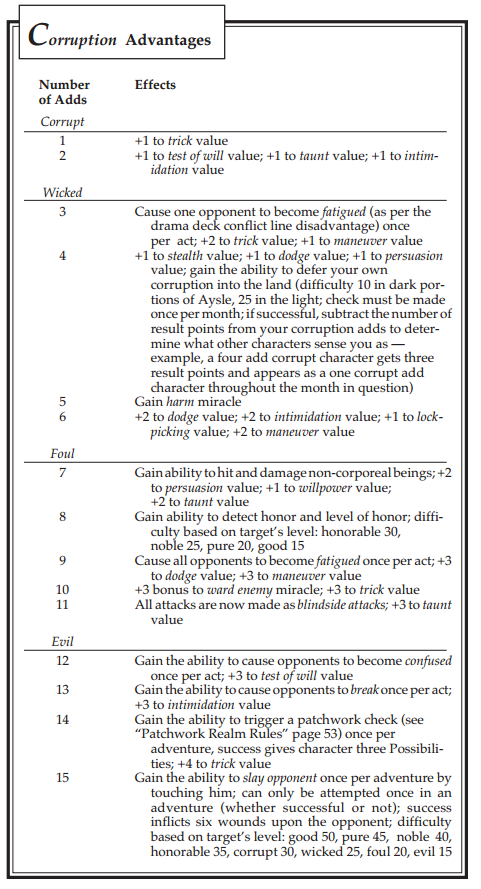
The wages of sin pay pretty well, actually
And...that's pretty much it. This is a very short chapter, most of which I already covered back in the initial Aysle post.
There's not much to really comment on here; I actually like the way the honor/corruption system works in that going in one direction or the other makes you more likely to keep acting that way by making the actions that would increase your standing easier, and they tie nicely into Aysle's general "generic European fantasy" vibe. It's one of the few tone-enforcing subsystems in Torg that I think works well enough.
Don't worry, though. The next chapter brings us back to the game's usual bullshit with something that is actually Torgier than the Nile Empire gadget rules.
NEXT TIME: God help me, I delve into the magic system.
The science of magic
Original SA post The storm has a name... - Let's Read TORG
Part 15e: The science of magic
...
Okay.
I hate this chapter.
No, really. I fucking hate] this chapter.
It's basically a microcosm of everything I hate about Torg's overall mechanical mindset. Why? Because it refuses to allow the game's mechanics to exist without talking about what all these skills and rolls and shit actually mean in the setting itself.
This chapter is called The Theory of Magic, and is a very in-depth look at how magic works and how to create spells.
And when I say "how magic works", I mean getting into the in-setting understanding of what the types of magic are, how they interact, what they all mean, and basically validating and defending the whole Torg magic system.
Written by a physicist.
I'm going to say that again to make sure we're all clear here.
The whole spell design system, the system used to make all the actual spells in the game, was written by a physicist.
Let that sink in.
And how do we learn the ins and outs, the whys and wherefores, the fundamental explanation of how magic actually works? Why, with seven pages of fiction, of course!
quote:
The brass hinges on the door squeaked loudly, announcing Mathea’s entrance into the classroom. The murmur of conversation died the instant she crossed the threshold, her appearance as effective as any silence spell ever cast. She moved quietly to the podium, setting down her notes and her hindsight bowl. She unstoppered her flask, emptied water into the bowl, and uttered a spell. She faced the class, looked sideways at the bowl, and an image of a whiteboard appeared behind her. Another spell, and a colored marker began to write for all to see:
Mistress Magister Mathea of the Two Towers, First Arcanum, First Division.
She turned over the first page of her notes as she absently pushed back strands of gray-streaked hair to a comfortable resting place above her spectacles. The notes were familiar; the students before her were not.
For one thing, they were all human. Not a dwarf, elf or giant among them. For another, they were clothed strangely; many wore tight-fitting straight pants, shirts with peculiar angular collars, or more comfortable looking woolen overshirts called “sweaters.” The women wore similar outfits, or skirts which would be completely useless in the field, having no pouches or pockets sewn into them.
What was truly strange was not their appearance, but their attitudes, their patterns of knowing, their view of reality. These students had been selected by Core Earth officials and approved by Pella Ardinay. They had an aptitude for magic. But they had no conception of how magic worked, no experience with its day-to-day uses. One of Mathea’s favorite examples of theorem application and restrictions, the breakfast brownie, would be meaningless to these students. They had probably never seen a brownie — at breakfast or any other meal.
Mathea cleared her throat. “Good evening. This is First Arcanum. I am Mathea, Mistress Magister from the Arcane Academy of the Two Towers. I am here through the graces of Lady Ardinay to further her efforts in helping the people of your land adjust to the reality it now holds. In Aysle, magic is pervasive; trying to adapt to Aysle without an understanding of magic is futile … ah, yes?” questioned Mathea, indicating a frantically waving youth garbed in black leather. His hair was thin, vertical and tricolored. He lowered his hand when Mathea acknowledged him.
“When I’m done with this, can I make the bullets in my Uzi explode on target?” he asked. There was a titter from one of the other students. The rest waited quietly for an answer.
Mathea took a deep breath. “Combining magical principles from Aysle with the technical artifacts from your Britain is a subject considerably more advanced than what we must cover here. Should you fail to learn — and learn completely — what I have to teach, magic will be of little use to you. Once you have mastered the knowledge I present to you, then perhaps you can experiment with the possibility of exploding bullets.”
Mathea waited a heartbeat for her words to sink in, then plunged ahead. “I have a question for you. What is magic?”
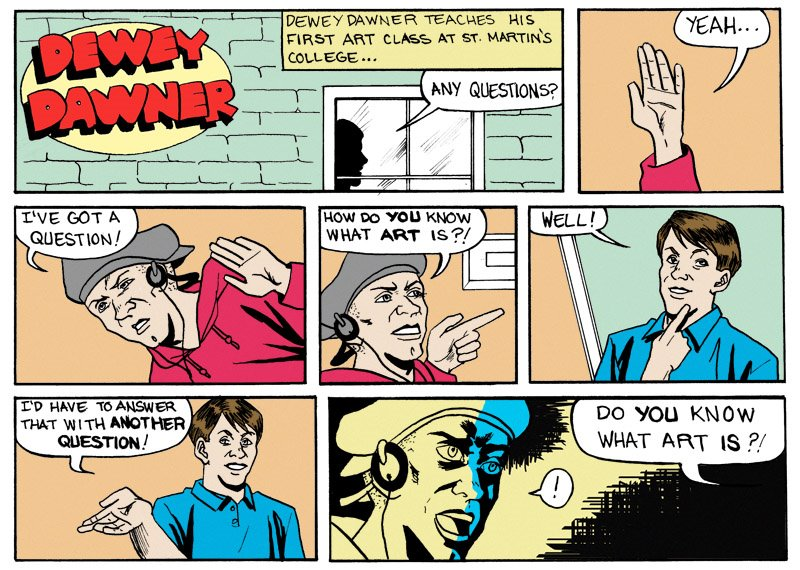
Not directly relevant, but this is what I think of every time I read that last paragraph
And when I say that this fiction is about explaining Torgian magic, I mean that Mathea is babbling on about what spell duration is. What cast time means. What all the lines and terms of a spell's stat block mean, because all that stuff and everything I'm going to talk about in this chapter are all known in-setting.
(Before we go any further, you might want to go back and reread my original post on how Torg magic works in the first place, particularly the stuff about knowledges.)
Once the fiction finally grinds to a halt (barring one last sidebar), we get to the point of this chapter: Spell Design. And even here outside the fiction we learn that the steps of spell creation were in fact created by someone from Aysle.
quote:
The following is condensed from Magister Throrvald’s Foundations of Effective Magic, but they are presented in a manner which is directly applicable to the Torg game, leaving out many of the metaphysical asides which have confused students in the past.
Here is an overview of spell design:
1. The mage decides the effect she wants the spell to have, and then chooses the knowledges for the pattern, mechanism and result. The mage needs all four magic skills to design a spell, but the pattern skill is the only skill necessary to cast the spell.
Next the mage chooses whether the spell should be cast directly, focused, impressed or placed in a ward. It is at this stage that the axiom level of the spell is decided upon, and the bonus number of the spell is assigned to increase one of its attributes.
2. The mage assigns values to the pattern, state, control, apportation, and duration portions of the spell process.
3. The mage uses her magic skill and the pattern knowledge to generate totals. The pattern total is generated from the magic skill used to observe the pattern, with the mage’s adds in pattern knowledge added to the skill value. The conjuration, divination, apportation and alteration totals are generated using the respective skills, which have each been increased by the adds of the pattern knowledge. The pattern knowledge adds are added to the magical skills only for spell design, never for casting the spell.
4. The skill totals are subtracted from the pattern and process values. If a skill total exceeds the pattern or process value by more than five, a -5 is recorded. The only exception is when the alteration total exceeds the duration by more than five; the full difference is recorded. This is the reason many spells have a short duration. These are then added together into the spell sum. If the spell sum is less than zero, it is raised to zero.
5. The basic complexity is calculated. The basic complexity is increased by the type of magic skill used in the pattern, the maximum value of the pattern or spell process, the spell sum, and reduced by the cast time of the spell.
6. Theorems are applied, restricting the effects of the spell, or requiring additional steps in the casting process. Each theorem takes at least a week to apply; taking additional weeks tends to increase the effectiveness of the theorem. The totals of all applied theorems are added to form the theorem sum.
7. The final complexity of the spell is equal to the basic complexity minus the theorem sum. There are minimum complexities depending on the type of magic used to cast the spell.
8. The spell is recorded. It is given a name. The final complexity is split into backlash and difficulty at the discretion of the mage. The other values of the spell are recorded.
And you know what this means, don't you? That's right...it's time for me to try and make a spell.
The spell I'm going to create will be something I can cast on a sword or axe or whatever so it'll animate and fight on its own for a while. A pretty basic effect, right? I mean, I could do that in a few other systems with minimal effort.
With my overall spell effect defined, I have to pick the knowledges for the "pattern, mechanism, and result". These were defined in the fiction dump, but here's what they mean:
- The Pattern is the knowledge that ties to what you're trying to effect.
- The Mechanism is the knowledge used to manipulating the pattern. This will usually be either Magic, Living Forces, or Unliving Forces.
- The Result is the knowledge that ties to whatever my final spell is supposed to do.
I think. This whole thing is confusing as shit.
Back in the original magic chapter, we learned about the 28 Knowledges:
quote:
The Essences: Death, Life, Time, True Knowledge
The Principles: Darkness, Light, Magic
The Mixed Forces: Inanimate Forces, Living Forces
The Elements: Air, Earth, Fire, Metal, Plant, Water
The Seven Kindred: Aquatic, Avian, Earthly, Elemental, Enchanted, Entity, Folk
Theory Knowledges: Cast Time, Control, Duration, Range, Speed, State
Each one of the non-theory Knowledges does get an entry explaining what it means, and what it means if it's the pattern, mechanism, or result, like so:
quote:
Inanimate Forces
Inanimate forces are the link to the elements. Inanimate forces can affect kindred. Inanimate forces cannot be used to transform or change kindred, even if the changes are illusory.
Inanimate forces are the forces which affect elements, and are associated with elements: heat, electricity, magnetism, forces which bind elements together, forces which make them appear as they do. Only those forces which are specifically covered by another knowledge, such as light or living forces, are excluded from the range of inanimate forces.
Pattern
Inanimate forces are used in a pattern when a mage wants to convert one inanimate force to another.
Example:Alteration/inanimate forces is the pattern of a “convert gravity to heat” spell, magic is the mechanism, and inanimate forces are the result.
Mechanism
Inanimate forces are used as the mechanism for a variety of less costly spells using the elements. Inanimate forces can apport any physical object, including kindred.
Inanimate forces can be used as the mechanism for results of light or magic, mixed forces, or elements.
For elements, they may be used as the mechanism for divination, alteration, or illusory conjuration.
Example: The fool’s gold spell has a pattern of alteration/metal, a mechanism of inanimate forces, and a result of metal. The resulting metal may look and feel enough like gold to fool the magically unprepared, but Ayslish merchants have long since bought enchanted coin scales from the mage guild to remedy this problem.
Result
If you want a lightning bolt, you need inanimate forces as the result of your spell; same with magnetism, gravity, or other force which is not an embodiment of an element, living forces or light.
Examples: The lightning bolt spell has a pattern of alteration/inanimate forces, a mechanism of magic, and a result of inanimate forces. The general purpose telekinesis spell has a pattern of apportation/air, a mechanism of magic, and a result of inanimate forces.
I have to pick one of those for the Pattern, one for the Mechanism, and one for the State. Each of the Knowledges (except for the Theory Knowledges) can generally be used as any of those three slots. For the record, "folk" refers to natural self-aware races, while "entity" refers to straight-up supernatural beings such as ghosts or demons.
Since I'm trying to make a spell that animates a weapon, the most applicable knowledge for the Pattern would probably be metal. I'm also affecting something made of metal, so I suppose the Result would be metal as well? The Mechanism would be inanimate forces, because that's the Knowledge used to move items around.
So there we go. First step down.
Now I have to start assigning values to a bunch of things.
Now I have to define the pattern by...wait, didn't I already do that? Whatever, lets just get through this. I have to further define the pattern by picking a magic skill (alteration, apportation, conjuration, or divination). This is an easy one, since spells based around moving objects fall under apportation.
Next I have to decide how the spell is cast; is it just cast directly, focused on another person or object, impressed (i.e., Vancian-prepped for quick casting), or put into a ward. Normal casting generally requires a lot of time, and my spell is something I'm going to want to be able to cast in combat as an action, so I'm going to need to make it impressed. That way I can prep it ahead of time then release the spell when needed.
Now I decide where I want the spell's Bonus Number to go; it can be assigned to either the effect, range, or duration. I'll assign it to the effect because I think it'll make the sword a better fighter.

Yeah, you and me both, buddy.
And now I have to figure out the spell's axiom level, because yes it's possible to create a spell that can cause you to disconnect. The problem here is that the magic axiom tiers are so vaguely defined it can be hard to tell where a spell should be in terms of if it's allowed at a specific axiom level. For instance, apporation magic is possible at a magical axiom of 5 (albeit with long rituals), impressed spells need a magic axiom of 17, but if I didn't want to make an impressed spell I don't know what axiom level that would be because none of the listed tiers tell you what level just simple non-ritual casting is. Whatever, let's just assume I need an axiom level of 17. Fortunately that's just under Aysle's magic axiom so I'm good there.
The next step is designing the pattern of the sp...wait, this is the third time I've had to define the pattern! Come on, guys, didn't anyone read this before putting it in the book?
Apparently this part of defining the pattern is about settling on an effect and determining the area or volume of said effect. In game terms, the effect is the number used to determine how effective a spell is. If it's a combat spell like fireball, then the effect is how much damage it does; if it's a spell for moving things, however, then the effect is how much the spell can move and how fast it can move things.
So...I guess my effect will be how well the animated sword will fight? I'm not sure because there's no details here on how to chose your effect apart from "pick a number". In the case of my spell I'm just going to assign the effect as the sword's effective melee weapons skill, even though I have NO idea if that's allowable as something a spell can do. I'll assign an effect value of 16 because that's a moderately skilled fighting level.
Oh, I'm sorry, there's one example of actually working out an effect value: transforming one person or object into another. In this case:
quote:
If a spell is transforming one object or being into another, the result points of the spell must be enough to account for the greatest attribute difference between the original and the transform. The effect value of the spell is compared with the the original’s attribute which created the difference.
Example: A giant with a Dexterity 8, Strength 17 and Toughness 19 is being turned into a frog with DEX 4, STR 0 and TOU 1. The greatest attribute difference is between the giant’s TOU and the frog’s TOU, a difference of 18. A spell which would turn the giant into a frog would require 18 result points, against the giant’s TOU of 19, which would require an effect total of 37 if magic is the mechanism (making the effect illusory), 69 if any other knowledge is the mechanism, as it would have to be filtered through the Power Push Table.
quote:
As the above example shows, building transformation spells which can produce great changes can be extremely difficult if magic is not the mechanism. Fortunately, a mage named Colvinax discovered an important principle. Spells which have a mechanism other than magic may buy a Power Push result for the spell, and put this result point modifier into the spell. This result point bonus is added to any earned through the casting of the spell, although the spell must earn at least one result point before the modifier is added.
Now comes area and volume. I'm only affecting a single item so I don't have to worry about this either, but since I'm quoting large chunks of this chapter let's just enjoy this.
quote:
A spell effect usually only effects one target. A spell may affect an area or a volume, in which case it affects every eligible target as it comes in contact with that area or volume.
Ayslish geometers long ago noted that space has three dimensions. The range of a spell is one dimension of space (the length) over which the spell can take effect. An area affect spell has two dimensions over which the spell may take effect, affecting everything within a radius of effect; the result is a circle of effect. A spell with volume takes effect within a sphere. If the spell has a range, then the spell effect already has one dimension. All the mage must do is build the second dimension of effect into his spell. The smaller of the two dimensions determines the area of effect.
So anyway we record all these values for the range and volume and such on the Spell Labratory Sheet, which I suppose I should show you now.
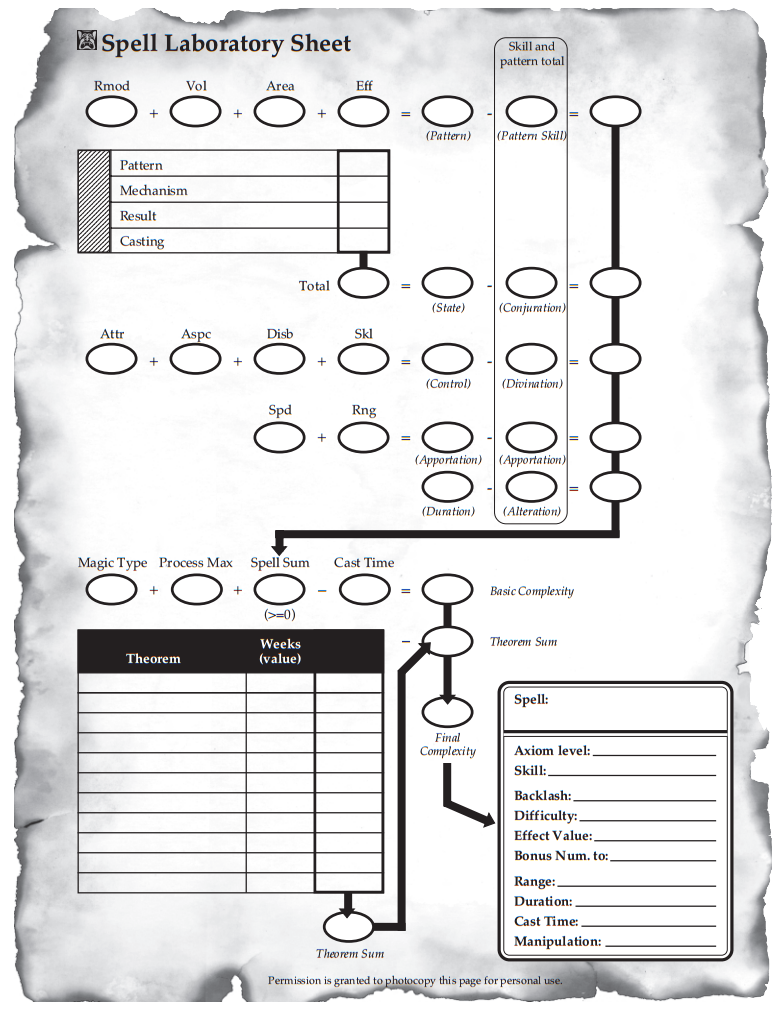
Oy.
The "Rmod" circle is for the Result Modifier, which is...tied to that stuff before about the result point modifiers? I guess? But I'm not using those, so I guess it's zero? It's hard to tell because while while the text refers to sections of the sheet as the "Pattern Section" or whatever, the sections on the sheet itself aren't labeled at all.
Yeah, there are going to be a lot of question marks from here on out.
Now that we've gotten through all that shit, we have to create the state path. We start by writing the values for the pattern, mechanism, result, and casting type on the Lab Sheet. Then we're going to have to move from the pattern to the mechanism to the result on the State Chart.
What's the State Chart, you ask?
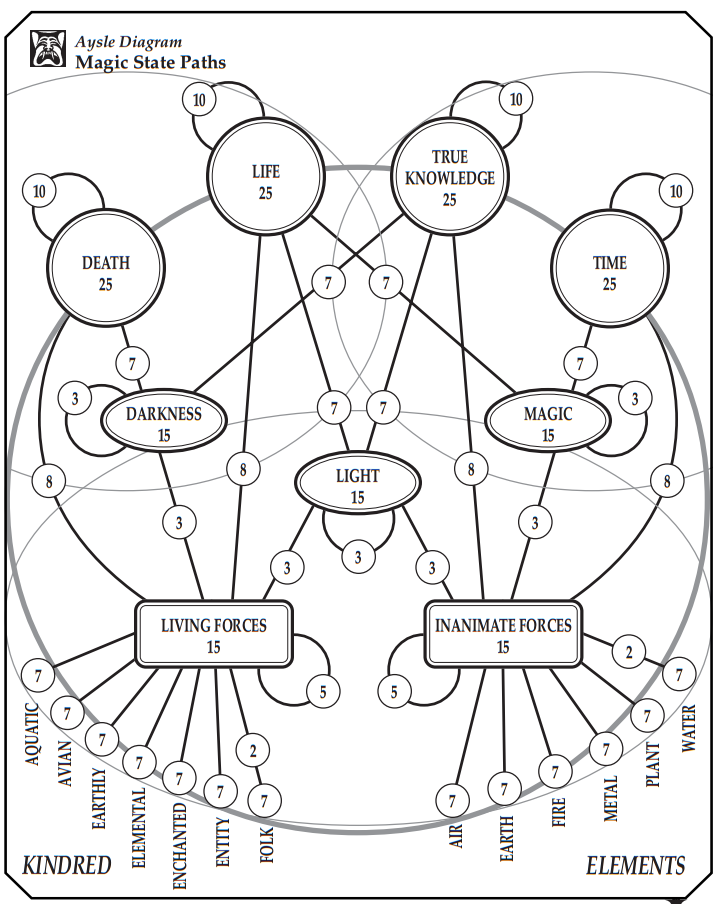
That. That is the State Chart.
Look at that chart. Fucking look at it. This is what I'm doing for your entertainment. This is what I've been writing about for over three years. Is it working? Am I entertaining you? DO YOU LOVE ME YET? WHY DON'T YOU L
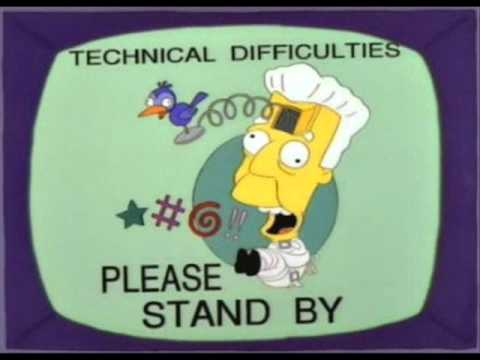
...sorry.
To navigate through the state chart, I start with the knowledge I've assigned as the pattern. In this case, that's metal, so I take that value (7) and write it on the lab sheet. Now I move from that spot to the knowledge for the mechanism, which is inanimate forces, and record the total values of the circles I pass through. Which isn't listed, but I'm assuming all those branches have a cost of 2 since every other line has a value. Fortunately I'm only moving one spot so that's just the cost of 2. Now I do the same again to get from the mechanism to the result, which will be 2 again.
As a larger example, if I wanted to go from folk to life, that would have a value of 2+3+7 = 12 for "life".
Now, I can swing through other areas of the State Chart if I wanted to; for example I could path my way through Light after I hit Inanimate Forces; this would add a visual effect to the spell that has no actual effect on anything but increases the difficulty. I don't know why you'd want to do that apart from some bullshit "roleplaying" reason, nor do I know why they make you pay for what is essentially descriptive dressing.
Oh, and here's something weird, but in a "that's actually odd" way rather than "these rules make no sense" way. The text mentions moving up and down the state chart based on the flow of the arrows connecting all the nodes; moving with the arrow costs the number in the circle, but moving opposite only costs 2. Thing is, in the PDF version of the book, the State Diagram doesn't have arrows, just lines. I'm honestly not sure why this is, but given that the official PDF doesn't have the full book cover, has a slightly different layout, and not all of the art, I'm guessing it was a reconstruction of old layout files or something. Basically, though, all the arrows move towards the top of the page.
Moving on. The "casting" value is based on the particular casting method. Impressed spells have a flat cost of 3, so at least we're set there. A spell that's cast directly has a cost of 0, a focused spell has a cost of 2, and enchanting an item...well...
quote:
To build a spell which can be placed in an object is even more difficult. The state path must be extended from the pattern knowledge to living forces (to be impressed), then to folk (to connect the state path to the character casting the spell), then to the element knowledge which best describes the material of the object (to be stored in the object.)
Next on the list is the "control" of the spell. This starts with a flat value based on the skill used when casting the spell. For the dancing sword spell that's apportation, which has a base value of 10. I record that as the skill control cost, or "Skl" on the worksheet.
I can now tweak the spell's "controlling aspects", which is actually more confusing than everything we've had up to this point because it's barely explained. I think how this works is I determine which of the spell's stats I want to be able to adjust: additional targets, the shape of the spell, controlling the movement of an apportated item, duration, accuracy, and if it's a ward or not. I'm going to adjust the movement (so the weapon can move in more than just a straight line away from me) and duration (because if I don't control the duration, the spell can't be turned off). That's two, which I then look up on the ol' One-On-Many chart (remember that? it's how you use one skill on multiple targets) and get that modifier, which is +4. That gets recorded in the "Aspc" circle. The other two circles for this section are for spells that directly affect the target's stats or for disbelieving illusions, neither of which apply here.
Next is the spell's range and speed. Range is obvious (and comes off the Benchmark Chart), and "speed" is actually how fast the spell travels to its target in m/round, like that fucking matters because if the range equals the speed, then the spell hits its target in one round. I'm just going to throw a range and speed of 6 in there because who fucking cares. I mean, I could make them different values but there's no real point.
Now I get to pick the duration! This is probably the easiest part; I just look up the time on the Benchmark Chart from back in the core book and record the value for the duration I want. This is a combat spell, so a max duration of a minute should be enough. That's a 9, so I write that in the appropriate circle.
Almost done! Now I need to start adding up values. I bet you think that'll be simple, don't you?
See, the first totals I have to create are my "knowledge totals". That's the column that's outlined on the sheet. For each of those circles, I have to make a skill check with all four casting skills and the pattern knowledge skill, adding my ranks in the pattern knowledge skill. For the sake of this example, I'm just going to throw some arbitrary values in there. Let's say I have the spellcasting skills at 15 each, and 11 in the pattern skill.
Yes, your skill rolls are hardcoded into the spell.
Once I have those values, I can start figuring out the Spell Sum.
quote:
A spell is derived from the observation of a pattern, which is modified by the state path, aspects controlled by the mage, and finally the apportation and duration of the effect. But the entire process is woven into the pattern which it modifies, and each part of the process has an affect on the other. If a portion of the pattern or the process is beyond the capabilities of the mage (as represented by the total she generated), that portion can be offset by other parts of the spell. If a mage cannot muster enough control for the spell, excess ability in the apportation and duration aspects can make up for the lack of control. This balance is represented by the spell sum.
I now have to figure out the basic complexity of the spell. This starts with a flat value based on the magic skill needed (apportation = 19), and adding the highest pattern value from the top half of the worksheet (that's the values just to the left of the vertical box). Then I determine the casting time based on the Benchmark Chart again; I'll take a cast time of four seconds for a value of 3. This value is subtracted from the first two, so the longer it takes to cast a spell the easier it is to cast.
I can also reduce a spell's complexity by applying theorems. Each theorem I put in a spell adds a week of game-time (eight hours a day, seven days a week) to the amount of time it's going to take my character to create the spell.
quote:
The value for applying a theorem is the value of the number of weeks spent applying the theorem. Process theorems each have a theory knowledge which grants the mage a bonus when generating the theorem total; the cast time theory knowledge gives a bonus to the theorem of cast time total. The bonus is equal to the adds of the theory knowledge.
knowledge.
There are a bunch of theories, like "voice", "cast time", "similarity" and so on. All the descriptions for these are, again, in the seven pages of fiction about a school lecture about magic. Some of these theories actually have an effect on the spell itself; for example, the theorem of touch means that the caster has to physically touch the target of the spell.
Now I determine the final complexity, which is just doing all the math as indicated by the arrows on the sheet. I split the final complexity total between what I want the spell's casting difficulty and backlash values to be, and I'm finally fucking done.
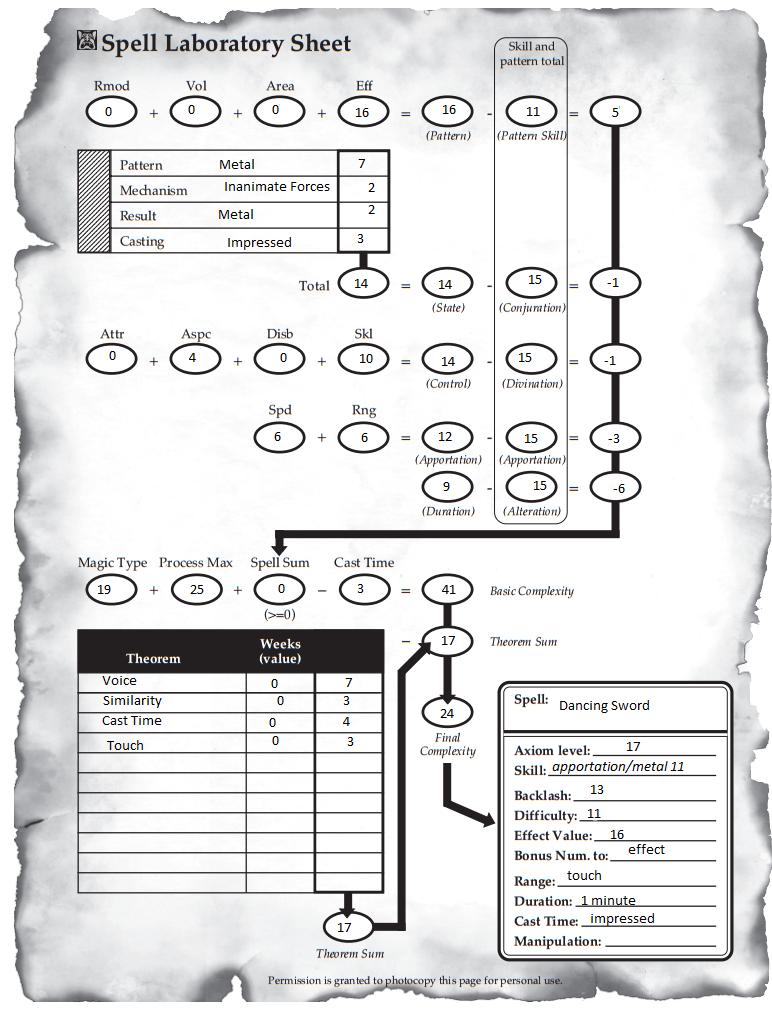
The final sheet, I guess
So here's the thing: I have absolutely no frigging idea if I did that right. I have no way of knowing if my spell is mechanically correct because the whole process is so needlessly complex it's impossible to just quickly go back and check my work. On top of that, there's barely any useful examples. There's one extended example of how to make a turn-people-into-a-frog spell, but what about other spell types? What about a simple attack spell? Or a teleportation spell? Basic things that shouldn't require a lot of exceptions or whatever to make?
To make matters even worse, I can't even reverse-engineer the existing spells, because all the spell creation math and values and shit aren't given. Most of the numbers I recorded have no use once the spell itself has been created and "bolted down".
Let's just finish the chapter out and move on.
The next part is Casting on the Fly, which is, yes, making up a spell on the spot. It also mean casting a spell that you haven't learned (i.e., spent Possibilities to buy), but have either seen cast or are reading out of a grimoire. The drawback to casting on the fly is that backlash is more dangerous. To remind everyone: suffering backlash means that you take the spell's backlash value, subtract the spell casting total, and apply that difference as damage. With a spell you've learned, if your skill roll was less than your Mind stat, you use the stat instead, so tanking a roll won't completely screw you. But if you're casting the spell from a grimoire because you haven't learned it, you don't get the buffer from your Mind. If you have a Mind of 14, roll a total of -5 to cast a spell, and the spell has a backlash value of 21, then if it's a learned spell then the final damage value is 21-10=11, which is less than a basic pistol. If that was being cast from a grimoire, then the damage would be 21-(-5)=26, which is about as bad as getting hit with a LAW missile.
It's also possible to cast a spell you've seen cast, assuming you have the necessary skills and knowledge. This is because of the Law of Observation, apparently. It works like normal spellcasting, but not only do you not get the benefit of you Mind, the spell's difficulty and backlash are increased by 4. To use the numbers in the above example, that increases the backlash damage to the same level as a 30mm autocannon.
quote:
Observing the pattern and then casting the spell is essentially rapid-fire spell design. The mage must assign the pattern and process values, then generate each of the five skill totals, arrive at the spell sum, and calculate the basic complexity. As no theorem may be applied in less then a week, the basic complexity is the final complexity. The mage divides the complexity into the difficulty and backlash of the spell. He must then either cast the spell the next round, or lose the pattern.
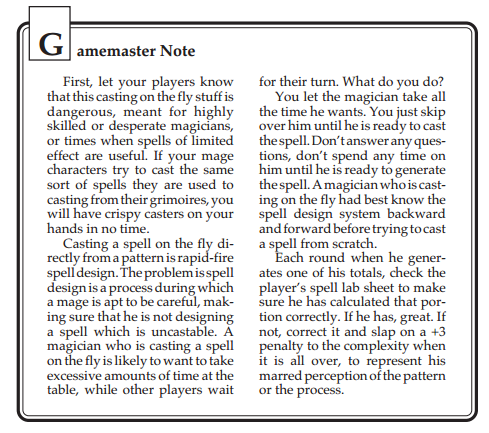
And you thought netrunning slowed your game down?
The next part is about Manipulating Spells and is basically ways to fiddle with the numbers of an spell as you cast it. You have to have all the magic and knowledge skills to do this. And what are the benefits?
1. You can spend a round shifting points between the spell's difficulty and backlash value.
2. You can spend a round moving points from one of the effect, range, or duration to one of the other two.
3. You can spend a round to move points from the cast time to either the duration (one-for-one) or range (two-for-one).
4. You can increase a spell's backlash by to increase the spell's effect, range, or duration. This takes no time but has to be announced before you roll.
Lastly, we get a bunch of stuff about Permanent Magic. Creating a permanent spell has the same penalties as casting an observed spell, on top of a -15 modifier to the roll, and believe it or not there's a reason for that modifier.
See, the highest magic axiom possible is 33, at which point all conjuration spell are permanent due to the high levels of ambient magic energy. But at axiom levels below that, there's a penalty to permanent conjuration (or other types of magic apparently) equal to the magic axiom of the world minus 33. And Aysle has a magic axiom of 18, so 33-18 = 15.

Making a spell permanent means that you either make the pattern permanent or the process permanent. Making the process permanent means that the effect will last forever (a permanent fireball will burn forever), whereas making the pattern permanent makes...uh...
quote:
If the pattern is made permanent, the potential to cast the spell permanently exists. The caster must still provide the appropriate magic skill to cast the spell. The primary advantage of making a pattern permanent is that the pattern need not be observed by the caster, as it is already there. The second advantage is that as permanent pattern is not yet part of the natural world, is cannot be dispelled by a spell effect of the same knowledge. Any effects of the spell may be dispelled, but the pattern itself could not be dispelled. Any theorem restrictions still apply to the spell; an altered fireball wand with a permanent pattern still requires the component of pitch and coal.
Note that none of that applies to enchanted items; that was all just making a spell that never ends. Creating a magic item (which is just an item with an existing spell in it) that can be cast by anyone is poorly explained, but basically involves creating a spell that will allow the storage and manipulation of other spells, then casting that spell as a permanent spell.
quote:
Constructing items which require no skill to use are difficult, as the spells must be impressed. The first step to building such an item is creating a permanent effect that allows spells with the result knowledge of fire to be impressed into an object. Assume we are building a staff of fire magic. The pattern is plant, the material of the staff. The mechanism is life, to imbue the staff with real living forces, allowing spells to be impressed. The result knowledge is fire, the pattern knowledge of any fire spell stored in the object. However, as discussed above (see “Casting” ), the state path is pretty convoluted: plant to inanimate forces to magic to life to living forces to folk (to allow folk to cast the spell) to living forces to light to inanimate forces to fire. The spell is cast directly.
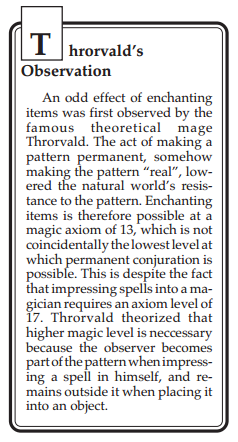
So wait, people in the setting do know about axioms?
---
I hate this chapter.
Seriously, I'd argue that this one chapter is the worst thing in the entire Torg line, up to and including War's End.
No part of this, no part, was necessary.
Who cares how magic works in-setting? You don't explain how cybernetics or miracles or any of the other dozen power types work in-setting, so why do we need a literal lecture about How Magic Works?
It's magic! You don't gotta explain shit!
I guess they were going for a realism thing, or something, but...why? Who could possibly care? What would be lost by not having this?
I just...I don't get it.
I hate this chapter.
NEXT TIME: A lot of premade spells so you don't need to bother with spell creation!
Grimoires and Prayers
Original SA post The storm has a name... - Let's Read TORG
Part 15f: Grimoires and Prayers
quote:
It is with tremendous pleasure that we of the Academy of Four Towers present the following excerpts of Pixaud’s Practical Grimoire, perhaps the finest grimoire known to the kindred. While legends of Pixaud vary considerably with the house and class of the teller, most versions agree that Pixaud was the second dean of the Academy of the Four Towers, and a contemporary of Throrvald. He began the grimoire while an adjunct conjuror with the academy. After his disappearance, such illustrious names as Throrvald, Voiny, Westermass, Eloini’nar and Coltershiv watched over subsequent editions of the grimoire. My compatriot Kenipat and I are honored to have been chosen to compile and annotate the current edition of the Grimoire, and it is our fervent hope that this edition shall not tarnish the deservedly sterling reputation of these volumes.
—Zelephest of the Four Towers
The next two chapters are the obligatory lists of new spells and miracles. The spells are presented as being taken from "Pixaud’s Practical Grimoire", which is the chapter title, an in-setting book, and also the name of the actual Torg supplement that had even more spells.
Since this is just a chapter o' spells, and the next chapter is a chapter o' miracles, I'm just going to pick a few highlights from each.
There are a lot of spells here, and the descriptions can get...weird. People who remmeber old Shadowrun supplements will recall how some books (like the old Street Samurai Catalog) had commentary by in-universe characters as part of the item descriptions. They kind of do the same thing here, with the two afforementioned wizards Kenipat and Zelephest providing a little extra background on some of the spells.
To make things even stranger, there's a sidebar that states that Pixaud's Practical Grimoire is indeed an item in the game, kept in the Arcane Academy of the Four Towers and that only students are allowed to learn spells from it. But the chapter implies that all the spells in this chapter are from the Grimoire, and as such you can't just learn them without having access to the book. But if that's the case, and they're not easy to get, why include them or put that limitation in place?
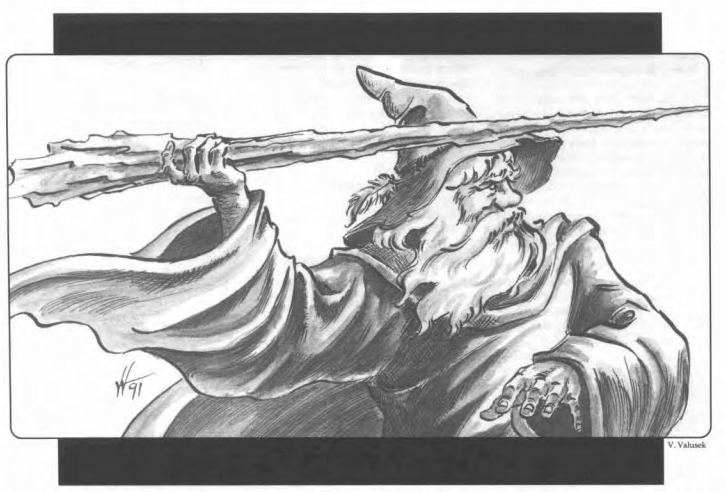
A wizard throwing an object physically? What's next, shouting hands back on?
Whatever, let's just get rolling.
Every spell gets a normal stat block, but also describes the little ritual actions you need to perform to cast the spell. Some of these are really embarassing.
Arm of Air is your basic move-stuff spell. The caster creates, well, an arm of air that can move about 50 feet away from the caster and has an effective Strength of the spell's effect value and lasts a minute. It can't perform anythign that would require a Dexterity roll, so it could pull a lever but not lift the keys off a guard's belt.
Bullet is the basic attack spell. You cast it on a metal object about the size of a coin, and after making a sling-whirling motion with it the caster shoots the object at the target at high speed. The spell's damage is about the same as a .44 Magnum, although with the spell you have to worry about backlash and looking silly when you cast it.
The awkwardly named Cast Lasher requires the mage to "pantomime the effects of backlash", and increases the backlash values of the target's spells.
Detect Folk Evil is a consequence of the whole granular magic knowledges system. It's a detect evil spell, yes, but because "natural intelligent races" and "unnatural intelligent races" are two different concepts as far as Torg is concerned, this spell only works on humans, dwarves, giants, and any race with the concept of a racial society. This means that the spell will not detect, for instance, a demon or actively hostile undead being.
Enchant Bow is a lot of work to increase a bow's damage value.
quote:
To cast this spell, the mage should take a piece of armor and heat it until it begins to grow soft. He then puts an arrow into the bow and fires it at the armor, which it will easily pierce. He must repeat this action several times, while reciting the proper incantation. When he is done, the bow will fire straight and true and cause great damage to the enemy.
Kenipat — Again, wizards should beware of copies of this spell. If the stave of the bow absorbs the enchantment, but the string does not, it may snap at a crucial moment. In addition, some versions of this spell increase the strength wonderfully well, but destroy the weapon’s accuracy to the point where even the best archer cannot hit the broad side of a Fomorian.
Speaking of stupid casting rituals, Fighting Whirlwind has what may be my favorite casting ritual:
quote:
The magician spins himself around once while exhaling to make an ever louder whooshing noise.
Folk Repelspell increases the target's resistance against spells that use the folk knowledge. I just mention it because I like the spell name.
Freeze Time is an impressed spell that generates a sphere up to 40 meters (130 feet) in radius where time just stops for everyone except the caster himself. Only 10 people can be affected by the spell; if an 11th person walks into the effect the whole thing collapses.
Invisibility does what it says on the label, but has the weirdest mechanics description.
quote:
The effect value is compared to the recipient’s Toughness on the Power Push table. To this result nine is added. If the final result equals or exceeds the target’s Toughness, then he is rendered completely transparent to light.
Multiple Images is basically Mirror Image, except that it doesn't tell you how many images you make when you cast the spell. Prepping the spell requires a room full of mirrors, so it's not exactly something you're going to be able to use day-to-day.
Open Lock basically lets you use your spellcasting skill instead of a normal skill to pick a lock.
Plant Shackles is...well...
quote:
To put this incantation to use, the caster takes five blades of grass (or whatever plants are nearby) and drapes one across both wrists, both ankles, and his neck. When he mutters the correct words and specifies the target with a hand gesture, the plants within range will begin to writhe and wrap themselves about the opponent. They will hold the target in their leafy embrace for up to one hour, with a strength equal to the effect value of the spell.
Kenipat — This spell was discovered by dwarf magicians in Upper Aysle, shortly after the establishment of House Vareth. It has proved to be of limited use to Land Between dwarves, as the plant life in that area consists largely of mushrooms and mosses, which are not effective in the context of this spell.
The Ritual of Perception Preparation increases your Perception value. I'm sure there was a shorter name they could have come up with.
The opposite of the above is Snail Wit, which decreases the target's Perception. To cast it, you point at the target and say "two plus two is, um, uhhh...", which feels more like something you'd say to reduce the target's intelligence, but whatever. I love that these spells require the caster to act like a doofus.
Telepathy is another does-what-it-says-on-the-label spell, only, you know Torg-ier. Casting the spell requires either a hair from the person you want to telepath to, or an object used by your intended target for at least a year. Likewise, to recieve thoughts back the target also needs the same thing for the caster. And again, because this is Torg, they tell us how quickly the message transmits because God knows we need to have that value (it's 1000m/round, in case you're wondering). At a kilometer it takes a round to send a message, and at six kilometers it takes a minute even though the spell's default max range is one kilometer. Oh, and while communicating you can't do anything else but concetrate on the spell.
And before we move on to miracles, I want to point out how impractical the ritual requirements are on some of these spells. Like with Multiple Images; prepping the spell requires a room full of mirrors. But this is supposed to be a game about globetrotting adventure, and rooms aren't really know for their portability. Why it couldn't be something like "meditate between two mirrors for 20 minutes" is beyond me. All it does is make it damn near impossible to prep the spell unless you happen to be close to your base of operations.
Or with Telepathy; having to have an item of the other person and not being able to do anything but "talk" are just annoying hurdles that just serve to make the caster's life more difficult for no real reason. I mean, it's not like a player didn't already have to deal with skill levels and paying out and backlash and shit to get the spell in the first place.
That said, I really do love the goofy-ass somatic components for some of these spells. Just the image of a wizard in a fight twirling around, calling someone dumb, and pretending to throw things in order to cast their spells just makes me smile.

Pictured: wizards
Anyway, miracles.
Miracles, oddly enough, do not have the same insane creation system as spells. In fact, there's no rules for miracle creation anywhere in the Torg line. It's a pretty odd omission, especially given how there's creation rules for pretty much every other damn thing. On top of that, there's no mention of any in-universe tomes of miracles, or commentary by famous clerics. Funny, that.
Regardless, the only real tie between the Ayslish gods and the miracles available is that some specific miracles are only available to people who worship the gods of honor, and some are only availble to the followers of the gods of corruption.
When you cast Banish, you compare your faith skill to your target's skill, and whoever has the lower value has to flee. This can be embarassing when you cast it and you end up being the one who flees.
Beauty increases your Charisma by 3...when dealing with the opposite sex of your race. When dealing with people of the same gender, their base attitude drops one level on the relevant table. What makes this one even more of a collar-tug is that it's not forbidden for a follower of the gods of honor to use magic to make themselves more sexually attractive.
The Curse of Arthuk imposes a -2 penalty to all the target's physical skill rolls and a -1 to mental ones for a year and a day. The only way to break the curse is to have the original caster remove it, or for another cleric to beat the original spell effect total by <SCENE MISSING>.
Fertility can make a one kilometer radius of earth fertile enough to grow crops, even if the land's inclination changes. While useful, not something I can see getting a lot of use in play.
The oddly specific Illusory Dragon lets the cleric appear as a "fierce dragon" and get an intimidation bonus. I'm glad they specified that the dragon would look "fierce".
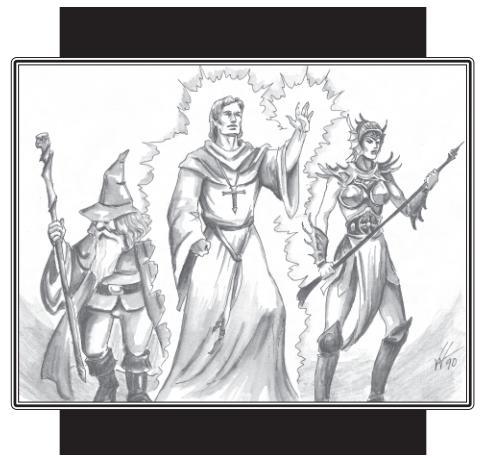
A cleric casts the "draw aggro" miracle.
Inferno is the Flame Strike equivalent, and is a little less damaging than a 15mm cannon.
Mental Link is like the telepathy spell, except you don't need hair, both people can move around and do things, and there's no "broadcast speed". So...yeah. Sure.
Passing Shadows doesn't do what you think it does; it lets you see into the past of an area.
Sanctum is another of those not-as-useful-as-they-seem-to-think-it-is spells. When cast, it creates a 20 meter radius zone that is sacred to the cleric's religion, centered on the target person. Anyone who attacks the target has the attack's difficulty increased by the cleric's faith adds...but only if they're the same religion as the caster. So if a cleric of Dunad (god of honor and "goodness") casts this miracle, he's only protected from being attacked by other followers of Dunad, but not from the followers of the various gods of corruption, or non-religous foes.
Trap makes one trap undetectable by non-magical means. Using this level of skulduggery to trick your foes is apparently okay with the gods of honor.
Warrior Madness can be cast on willing or unwilling targets, and turns said person into a whirling engine of desctruction. They get +3 to their Strength, Toughness, and melee and unarmed skills. In addition, they can't be affected by attempts to trick, intimidate, or otherwise misdirect them. Snapping out of the frenzy needs a willpower roll.
quote:
This miracle does not actually cause muscles to grow larger, but simply allows the target character to operate at peak ability.
And...that's kinda it. It's just spells, not much left to say. So I leave you with this excerpt from the actual Pixaud's Practial Grimoire supplement of an actual honest-to-God Torg spell you can spend your hard earned XP on.
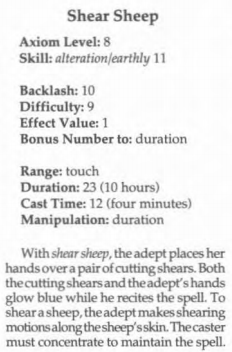
NEXT TIME: The Monster
Fantastic Beasts, and also monsters
Original SA post The storm has a name... - Let's Read TORG
Part 15g: Fantastic Beasts, and also monsters
The next two chapters are The Folk, which is about the actual races of Aysle, and Creatures, which is your monster list.
The chapter on the Folk is just a list of the various races in Aysle, with the expected generic stat blocks for each. In keeping with bad fantasy tradition, humans are multicultural while everyone else is monocultural.
For humans, there's Ayslish (basic humans), Corsairs (pirate humans), Freetraders (economic humans), Barbarians (free range humans), Ice Nomads (cold free range humans), and Vikings (bearded fighty humans). Not really much to say here apart from pointing out the stupid 90's RPG need to stat up Bob Genericman on the off chance I really need to know what some nameless NPC's survival skill is. As it is you can tell they're stretched to fill in two paragraphs of every human subspecies.
The other races get more information, even though there's very few surprises to them.
Elves are (big surprise) "the most mysterious race in Aysle". They're really good at magic, make very light chainmail, and can live for centuries. In other words, they're elves.
The only real standout thing about elves is that they have "skin of a dark hue". I don't know if that means they're supposed to be drow-like, or if they're supposed to have a more Middle-Eastern cast to their skin. The art is in black and white so it really doesn't help you figure it out.
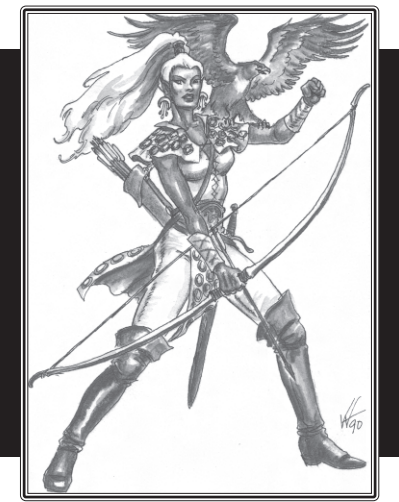
Of course she has a bow.
Dwarves are dwarves. You know the drill; miners, bad at magic, good at blacksmithing and engineering. As stated back in the beginning of the book, the Dwarves aren't so much atheists as a race that thinks the gods can bugger off due to the creators of the world leaving the job half-finished before wandering off to their next job. Because they're not as skill at magic as other races, they've been leading Aysle glacial technological advancement, and have adapted well to using Core Earth technology.
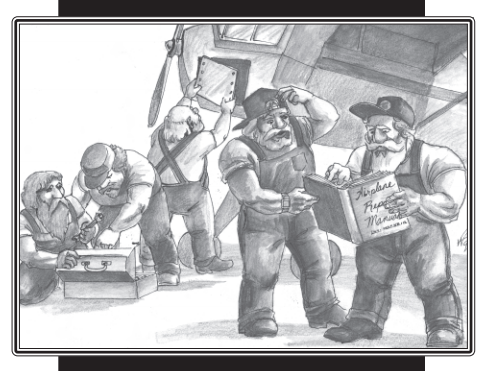
"Why don't they just make the whole thing from the black box?"
Giants are mostly assholes. Nobody likes them, they don't like anyone else. While they're not unknown in civilized Ayslish society (although they're still pretty rare), the majority of the race lives a tribal existence in the caverns of Lower Aysle. Most of the race backed Uthorion's invasion, and the few who didn't were ostricised by the other tribes. Giants on Core Earth have found work as bodyguards, mob enforcers, and football goalies.
Those are the "core races" of Aysle, but not the only ones. For instance, there's Half-folk, which is a catch-all term for beings like minotaurs, harpies, or centaurs. Half-folk have no rights in Ayslish society and are prime fodder for slavers.
Below the half-folk are Lesser Folk: trolls, goblins, ogres, and kobolds. Even moreso than the giants, lesser folk operate under a "might makes right" attitude, and as such love to prey on the weak and helpless. They're basically your fodder races.
And now we come to Creatures. And once again, we're retty much getting the Standard Fantasy Assortment here, but with Torg-ian twists.
Take, for example, dragons. There are a bunch of different types of dragons, and shockingly they're not color-coded like standard D&D dragons. Instead, they're elemental-based; fire, water, earth, air, metal, and plant. But while they're called "dragons", they're not actually called dragons.
What I mean is that (for instance), a water dragon isn't actually called a "water dragon" or a "sea serpent". It's called a "Draconis Aquatica". Not "Sea Dragon, a.k.a. Draconis Aquatica", just "Draconis Aquatica". Similarly, the cavern-dwelling earth dragons with metalic-looking scales are "Draconis Metallica". My personal favorite is the plant dragon, which is the Draconis Crotalaria.
...Those names are dumb. They're just dumb. I cannot think of a single reason why they chose this naming convention. I mean...even for Torg's constant "nobody talks like that"-isms, nobody talks like that. Can you imagine a knight saying "tread carefully through these woods; there are draconis crotalarias lurking about"? Or paniced townsfolk screaming "Look out! There's a draconis teutonica headed for our village!"?
It doesn't exactly roll off the tongue, is what I'm saying.
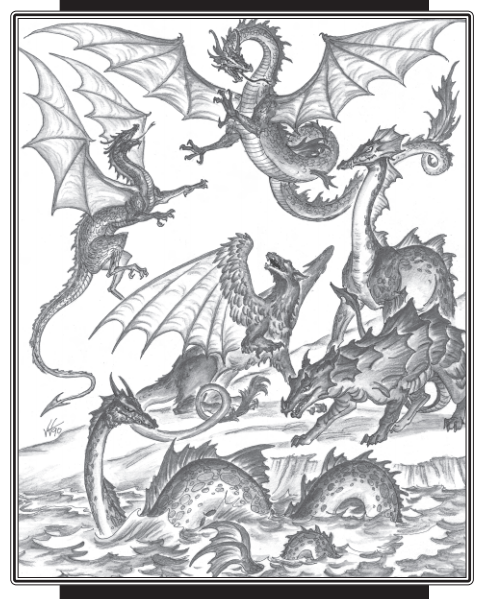
What's the plural of Draconis? Draconi? Draconises? Dratini?
To break down the six types: Draconis Teutonica (air) are winged serpents who don't really do anything, Draconis Aysle (fire) are four-clawed winged dragons and are Good and Honorable, Draconis Aquatica (water) are evil sea serpents, Draconis Metallica (metal) are treasure hoarders, Draconis Terra (earth) are wingless and don't really do anything except fight air dragons, and Draconis Crotalaria (plant) are basically 30-foot-long scaly druids.
Another monster type with a lot of oddly-named subtypes are Fairies. Fairies actually existed on Core Earth, but "gradually disappeared as the Tech axiom grew and the Magical axiom declined", which means that apparently magic was actually real at some point in Core Earth's history and everyone just forgot. Regardless, the arrival of Aysle's axioms have brought them back, and once again they line up to the same six elements as the dragons.
Faeries all look like what you'd imagine when I say "twinkly winged faries"; they're a few inches tall with thin bodies and wings. Cinlums (air) are assholes, Infernas (fire) light dark paths for travellers, Aqueates (water) sink ships, Soliums (earth) are good faries, Cypruim (metal) steal shiny things, and Celosia (plant) have the skill artist (flower arrangement) at 12.
The Fey are from Aylse proper, and even though they're also tied to the elements they're a lot more interesting and a lot more dangerous. And while each elemental type is named, for some reason only brownies (earth) get a stat block. Weird.
Anyway! From here on it's just short monster descriptions, so let's just plow on through.
Fomorians are a race of giants who have been corrupted by centuries of in-breeding. They're cannibals, really stupid, and very evil. Think the bad guys from a gone-on-too-long slasher franchise, only twice as tall.
Ghouls are your standard-issue flesh eating undead. Uthorion unleashed a lot of these things on England as part of the invasion, and unfortunately they're still kicking around the dark cornders of the realm.
Gorgons are medusas who turn people to stone.
quote:
the gorgon’s attack uses his or her willpower as the effect value, with a difficulty number of the target character’s Perception. If the target is actively avoiding the gorgon’s gaze, he or she must get a “setback” or a “player’s call” result on a trick to make the attack. The attack is consider a “one-on-many,” adding +2 to the difficulty of the trick attempt and +4 to the difficulty of the actual attack. (See the MultiAction Chart on page 45 of the Torg Rulebook.) Each wound level causes the victim’s body to solidify further, and reduces all Dexterity-related skills by two. After three wounds have been taken, the victim is completely turned to stone, and can be returned to flesh only if the gorgon is slain. This can be done by severing the head of the creature, or reflecting their gaze back at them. If less than three wounds, the victim’s DEX returns in 24 hours
Uthorion had his own gospog just like every other High Lord, although now that he's not in charge anymore they're not very common. There's only a handful of fifth-planting gospog left, although the other types still have decent numbers.
Second-planting gospog are dire wolves with hides of thick plant matter, and perfer to operate in packs. They are expert trackers, and their "skin" is covered in large thorns that make fighting them very difficult, especially when the pack is trying to tear you to shreds. Third planting gospog look about the same as the second-planting, only larger and with a pair of tentacles coming out their backs instead of thorns. Fourth-planting gospog are even larger (averaging about 8 meters long) and start to look more dragon-like. Fifth-planting gospog are 10-meter long wolf-dragons with acid breath.
Green Men are human-tree hybrids, the details of the creation of which are thankfully not given. They attack travellers in the forests and drink their blood for some reason.
Griffins are giant predators that prefer to nest in mountains, but come down to more civilized areas to hunt prey for food, with "prey" generally being defined as "anything smaller than itself". 'Tis weak to fire!
Kraken are apparently native to Core Earth, a fact that is quickly glossed over as we learn that they've started setting up shop off the coast of Norway. They feed off anything unlucky enough to swim or sail past, and has actually been taking a large chunk out of the invading Viking forces because they're a much easier meal than a Core Earth naval vessel. Their main method of attack is to wrap their 100 meter long tentacles around a ship and squeeze until the ship shatters, then eating everyone that falls out.
Legend Apparitions are ghosts, kind of.
quote:
A legend apparition closely resembles a ghost, both in appearance and behavior. But unlike the classic restless spirit, the legend apparition is not an independent entity, but rather an illusion formed from the energy of the beliefs and superstitions and others.
An apparition will usually form in an area where a particularly hated and malevolent individual has recently died. The fears of local residents that the deceased will return as a ghost cause a legend apparition to take shape. It will possess the memories and characteristics of the person it resembles, which are impressed upon it by the minds of the people who caused it to appear, and will genuinely believe it is the ghost of a dead individual. Unable to attack physically, the legend apparition operates by frightening those around it using its intimidation as the effect value against a difficulty number of the target’s Mind.
Since it is not, destroying the body or the building it is haunting will prove ineffective in dispelling it. However, if proof of such an action can be shown to the apparition and the people it is tormenting, their belief that the “ghost” has been destroyed will cause the apparition to vanish.
Manes are...well, nobody's really sure what they are. They're small red-skinned humanoids that occupy the Land Between back in Aysle, and seem to have a rudimentary intelligence. At the same time, they don't seem to be capable of communicating with other species or each other, so they don't have anything even approaching a culture. They tend to keep to themselves and will avoid other species. That said, if someone makes the mistake of entering their territory they'll swarm them en massé.
Manticores are manticores, and are an analogy of mankind's effect on the environment.
quote:
According to legend, the manticore was originally a plant-eater, subsisting on the leafy vegetation that grew along the mountainsides. Then a Viking hunting party took to the hills, slaughtering many manticore and forcing others to flee. Cornered, one of the creatures lashed out at its pursuers, and so tasted flesh for the first time. Since that day, manticore have been man-killers, preferring to stalk at night and resisting all efforts to exterminate them.
Mimis are tiny blue humanoids that feed off the plants that grow in the cracks in rocks, and attack interlopers in swarms of 100 or more. Of course, this is Torg so they expect you to run the fight against 100 of these little assholes.
Revenants are the restless spirits of evil people. Never well-disposed to other people when they were alive, revenants see their new state as a way of really fucking with people. On Core Earth, they're fond of the horror movie cliché of appearing in the middle of a dark road in front of a car, forcing the driver off the road to avoid an "accident". Since they're incapable of interacting with anything in a physical manner, they have to rely on jump scares to torment people. Which would work in-game if it was possible to do damage that way.
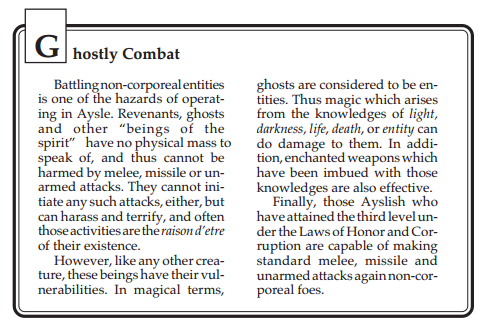
Skeletons were one of Uthorion's primary shock troops, basically because they don't feel pain, always follow orders, and are easy to mass-produce. Other than that they're really just a walking basic melee attack.
Spectral Knights were (back in the good old days) Lady Ardinay's six Knight Protectors, comprised of the best warrior from each house and led by Tolwyn of House Tankred. When Uthorion took over Ardinay's body, he summoned and bound demons to the Knight's physical bodies, trapping the knights' souls and forcing them to watch as the demons ran roughshot across the land in their bodies. Centuries of being helpless in their own bodies has not had a good effect on the Knights, and their souls have become Corrupt due to such long-term proximity to demons. When Tolwyn came back after spending centuries in the void, she killed her old body in order to stop it; that said, the remaining five Knights are still out there wreaking havoc in Uthorion's name.
Wendigo are actually from Lower Aysle, but carry the same basic origin as the Core Earth legend: they're people cursed by the gods for the sin of canibalism. Rumor has it they've started showing up in Norway, but it's not clear if they're starting to appear in the realm. If they are, that's a big problem for both sides because wendigos are basically giant clawed blenders who don't care about one side or the other; everyone's just food.
https://www.youtube.com/watch?v=qQcNXitLAWE
Yeah, it's not from the book, but tell me you didn't hear that sound clip when you read that.
Wyverns are like dragons, but lamer. In Aysle, wyverns are really just giant snakes that spend two months hibernating before heading out to roll over, crush, and devour anyone they can catch before hibernating again. They're also apparently related to the Sarlac, because if you're swallowed whole by one it takes years to be fully digested, although once you die from shock or starvation I don't think you'd really care about how long it takes after that.
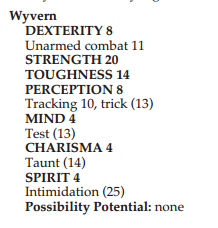
Oddly, they don't have any special "roll over and crush" or "swallow whole" attacks. Or anything, really. Kinda makes you wonder why they bothered.
Wotan and the Wild Hunt are
And...that's kinda it. These chapters are really just a collection of stat blocks with almost no art, so...sorry. At least we'll have more to talk about next time?

NEXT TIME: Gear and characters
Arms & Equipment Guide; Player's Options
Original SA post The storm has a name... - Let's Read TORG
Part 15h: Arms & Equipment Guide; Player's Options
Here we are at the end of the Aysle book. Thank the lord.
The next chapter is about Equipment, and really most of this chapter isn't anything you haven't seen a million times before in every other fantasy RPG ever made. This is a longsword, here's a mace, here's your ten overly-similar types of mundane armor, yadda yadda yadda.
This chapter does have a bunch of enchanted items listed, but since this is a 90's RPG it's mostly weapons and armor. There are basic +X armor and weapons, as well as your more traditional special items. But the problem is that some of this stuff is poorly mechanically defined, again probably because of the ol' "I know what I meant when I wrote it" problem.
For example, an Infernas Sword can apparently shoot conjured fireballs from the tip...but it doesn't say how. Does the sword cast the fireball spell? If so, what's its skill level? What happens if there's backlash? How many times can I do that? Are there charges? No idea, because all the description says is that it can shoot conjured fireballs from the tip.
Likewise, the Cyprium Metal Armor says it's "extremely effective against missile and melee weapons". Ignoring the fact that most weapons fall into one of those two categories, there's no numerical bonus or anything against certain types of attacks. From a rules standpoint, it's just armor.
Or take the Aqueate Armor:
quote:
Literally a battle-suit made of solidified water, aqueate armor is constructed using both the water faeries’ water spray spell and the cinlum weather control spell. The aqueates provide the liquid, and the cinlum’s manipulate the air pressure and temperature so as to contain it around the wearer’s body. Each suit must be built around a specific warrior’s body, and can only be used once, falling back to the ground as water once it is removed. While worn, the water circulates, actively deflecting any melee or missile weapon it is attacked with. It is, however, vulnerable to attack by cyprium weapons, which contain electric charges. The other drawback is that the suit is heavy and causes the wearer to move more slowly, so reduce all Dexterity-related skills by one when wearing it. There has also been one recorded incident of a Draconis Teutonica using its arctic air weapon to freeze the armor solid.
It is extremely expensive to purchase a suit of aqueate armor, because it is difficult to get the two races to cooperate on its construction.
What's more, there's no mechanical backing to the notes that it's vulnerable to lightning attacks. It's just fluff that a GM may or may not remember to use.
Not that it matters, because all the magic armors are actually mechanically worse than mundane leather armor. Leather armor provides +2 Toughness to a max of 20 for 800 coins, whereas all the magic armors give +2 Toughness with a max of 17 for over 15,000 coins.
Or take the Climate Cloak, which is "imbuded with an alteration/folk spell" that protects the wearer from extreme heat and cold. Which spell? What are its specifics? Hell if I know, it's just an unnamed alteration/folk spell.
Now yes, I know that back in the 90's we had the same deal going on in D&D, where magic items weren't supposed to be made by the PCs but were instead doled out as rewards by the GM. That being said, given how almost everything else with the magic system has a long-ass design process that's intended for the players to use, it's very conspicuous by its absence.
Magic weapons don't fare much better. Again, all the magic weapons have the same exact stats (+6 damage, max damage value 21). Yeah, they're supposed to have spells built in, but the rules are (surprise, surprise) ridiculously vague. What's more, all the magic swords have the same exact stats as a broadsword; the only advantage is theoretically being able to cast a spell through them, and even then I don't know if you need the spellcasting skills or not and quite frankly at this point I'm not going back to the magic chapter to check how that worked again.
The next chapter covers Character Creation, and the minor yet annoying ways it's different than normal character creation. There's two main differences:
First, as stated before, when an Aysle character takes a magic skill as their tag skill, they get 12 point in which to buy knowledges, not to mention the stuff they get from their birth sign.
Second, and more complicated, is what happens if you want to play an elf or giant.
If I may quote the book for a moment, "[g]iants and elves are, by nature, more magical than other creatures", which means that they have higher stat caps than humans and dwarves, who are of course just short humans. This is done by the mandatory purchase of enhancement points in packs of three; these points are then used to increase your stats (and the associated stat maximums) by one point each. Giants can only put these points in Strength or Toughness, whereas elves can put the point in any stat but Toughness. Elven or giant characters are required to buy at least one of these packages.
Now, it's possible for this to get pretty unbalancing, especially early on. Characters are normally built on 66 stat points, and it's possible to buy two or three packs at character creation and get a pretty significant stat boost.
For reference, here's the normal Aysle stat caps:
pre:
DEXTERITY 14 STRENGTH 15 TOUGHNESS 15 PERCEPTION 14 MIND 14 CHARISMA 13 SPIRIT 13
pre:
DEXTERITY 8 STRENGTH 13 TOUGHNESS 13 PERCEPTION 8 MIND 8 CHARISMA 8 SPIRIT 8
In order to keep those higher stats, I have two options:
1) Pay out one Possibility per package per adventure.
2) Give one of my other stats a much lower cap per package.
So I can either have to constantly pay out two possibilities per adventure (screw that), or reduce the cap of two of my other stats. Elves have to take a stat cap of 7, whereas giants have to put in a stat cap of 7 for the first attribute and 6 for the rest. I can mix-and-match so with two packages I could just cap one stat and pay an adventure cost for the other, but why bother.
So I'll make my Charisma max out at 7, and my Spirit max out at 6. Of course, now I have to put those extra three stat points somewhere...
pre:
DEXTERITY 8 STRENGTH 14 TOUGHNESS 15 PERCEPTION 8 MIND 8 CHARISMA 7 SPIRIT 6
So what happens if you choose the adventure cost and can't pay it? Well, if that happens, or you disconnect, then you lose all your enhancement points and your stats drop to their normal levels (i.e., what they'd be without the enhancement points). If you disconnected, then you have to make re-connection rolls for each of your enhancement packages in addition to making the re-connection roll for yourself. Until you make all these rolls, your stats stay at the normal-person levels and you're still considered disconnected.
If you're disconnected for more than a day, or you can't pay out the adventure cost at all, then you catch the "wasting disease", and at that point you're kinda fucked. You immediately take a permanent, irreducible point of shock damage each week, until either you're cured, you reconnect, or your shock damage matches your Toughness, at which point you enter a coma. While in a coma, you keep taking shock damage until you hit twice your Toughness, at which point you die.
quote:
To be healed, an ord must return to Elveim or Lower Aysle (depending on his race) and find a cleric to cure him. A Possibility-rated character can do the same, or can attempt to earn enough Possibilities over the course of the next adventure to pay the adventure cost and thus dispel the disease and the shock damage and regain his enhancements.
Payment must be of the cumulative adventure cost. In other words, if an elven character with two packages has been without their benefits for two adventures, he must pay four Possibilities to regain them rather than simply two.
Oh, and if a giant's Strength drops below 10? They're not strong enough to easily walk around due to their size, and have to make rolls just to get around.
And you know what the best part of all that is? We're coming up to realm books that have other non-human racial options for PCs, and guess how many of them have to deal with this bullshit?
That's right: none of them!
Oy.
Anyway, all that's left are the character templates. The World Book from the core had a pretty limited list of options:
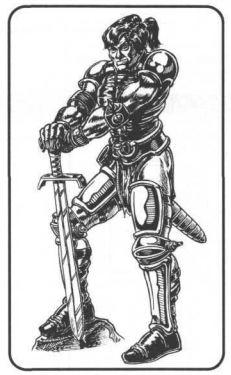
The Barbarian Warrior is puzzled by these strange changes that have swept across Aysle, as well as Ardinay's sudden change of heart. Not that he sided with Uthorion; he's just in it for the joy of battle and the ability to explore new lands. Still, better to be fighting with the good guys, right? He starts with generic fighter gear and his tag skill is melee weapons, of course.
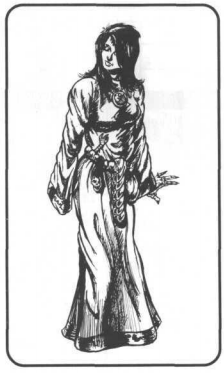
The Curious Mage has studied magic all her life while managing avoiding being conscripted into Uthorion-as-Ardinay's forces. When the Core Earth invasion happened, she felt the sudden shift in magical energies as Aysle's reality poured down the bridge. Now that Ardinay seems to be on the side of good once again, she's heading down to the realm to study how magic works on the edges of the stelae zones. Her tag skill is alteration magic, but she left her money pouch back in Aysle.
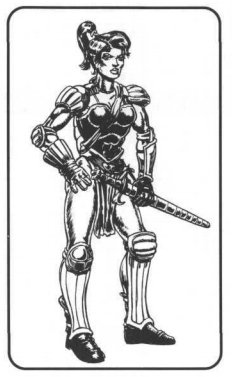
The Paladin is...well...okay, she's just straight-up Starter Kit Tolwyn. Seriously, she has the same sent-through-time backstory and everything. No, I don't know why they used the same background as their Mary Sue instead of something else apart from the fact that the core set had templates for all the main characters from the novels. Anyway, she starts with a "worn copy of The Dark Knight (not the novelization of the movie since it wasn't out yet so I dunno what it's supposed to be apart from a Batman reference) and her tag skill is faith.
And of course the realm book added a bunch more:
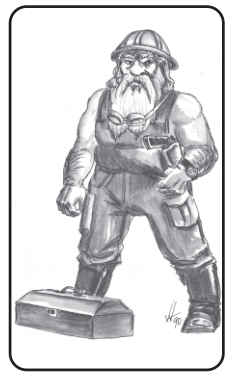
The Dwarf Engineer was taken by House Vareth slavers when he was a child, and was put to work repairing basic farm tools. When the invasion happened, the House Vareth slaves managed to organize a rebellion while the House's leaders were focused on the new cosm. Stowing away on a Vareth supply cart, he came to Core Earth, where he discovered an uncanny knack with all this new technology. He starts with a toolbox, a digital watch, and a .44 Magnum. His tag skill is science
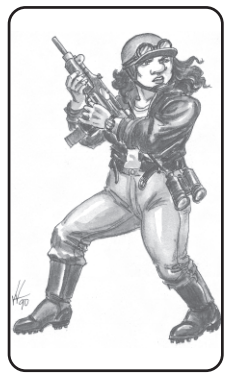
The Dwarf Tunnel Runner's family has always fought. They were involved with the War of the Giants, the War of the Crowns, and defended the dwarven tunnels from intruding monsters. Unfortunately, all that skill and experience didn't mean a thing when House Vareth attacked from within. Avoiding the slavers, she began organizing geurilla raids on Vareth's holdings. The fight eventually went over the maelstrom bridges, where she found something that really swung the odds in her favor: automatic rifles. She starts with a ton of weapons (including a can of mace), and her tag skill is fire combat.
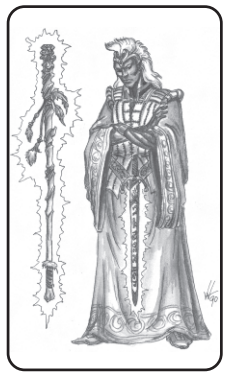
The Elf Mage has spent centuries studying in Elveim, until there was no more the world could teach him. Fortutiously, shortly after reaching that point the invasion happened and he saw a new world that would (hopefully) have more to teach him. But seeing as how the realm is just rediscovering magic, it might be more the other way around. He starts with the standard-issue wizard robe, staff, and grimoire, and his tag skill is conjuration magic.
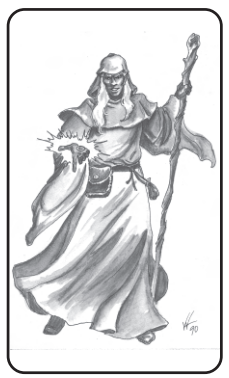
The Elf Monk is unusual in that he chose not to remain neutral in the war between Light and Dark, whereas most elves are waiting it out. He's part of a group of priests of Estar that have traveled down to the realm to travel the land and aid Ardinay's forces. He's slowly coming around to the idea that maybe the idea that the elves shouldn't have been getting involved for centuries is kinda dumb. His tag skill is faith.
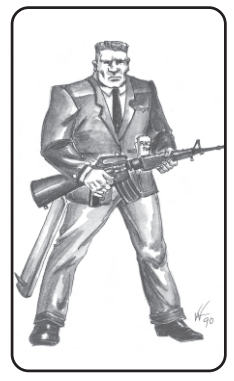
The Giant Bruiser is a real good fella. He was part of the initial invasion force, his tribe sent down into Glasgow to take it for "Ardinay". But during the intial confusion, he got separated from the rest of his tribe. Lucky for him, he ran into a real friendly guy who was willing to give you food and a place to sleep in exchange for doing some armbreaking, which he had no problem with. Then a rival giant clan came in, killed his buddy, and left him for dead. Now it's time for a little payback, capeesh? He starts with a rifle, a racing form, and a nice suit. His tag skill is unarmed combat, and he starts with a point of corruption. He also has a whopping nine enhancement points, and as such has an adventure cost of 3.
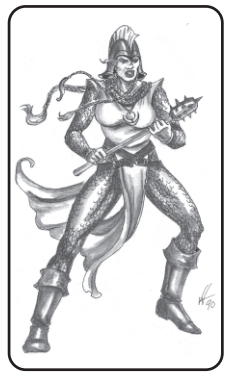
The Giant Preistess in very unique in terms of giants: she's actually curious about the other Ayslish races and wants to understand them. Of course, given the reputation of the giants that's a lot easier said than done. In an attempt to balance her violent nature with the needs of other races, she became a cleric of Ugrol, one of the gods of balance. She saw the invasion as a chance to meet even more new people, but once she got there she realized that her comrades were succumbing to their darker natures and that it was up to her to stop them. Her tag skill is focus.
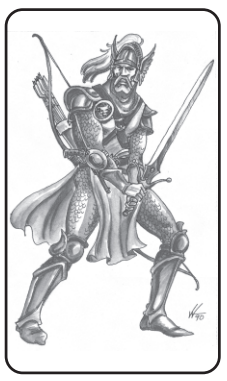
The Human Knight is from House Tancred because every good guy knoight is from frigging House Tancred. And there's really not much to say here. You know the drill; dedicated to honor, fighting the good fight, loyal to Tolwyn, etc. He starts with a standard fighter loadout (sword, bow, armor) and some wheellock pistols. His tag skill is melee weapons and he starts with a point of honor.
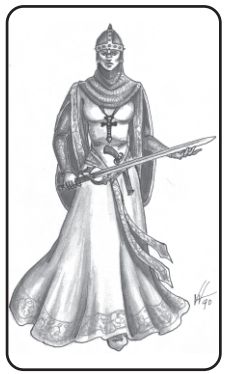
The Priest of Dunad watched helplessly as Ardinay turned her back on the ways of honor and drive the world into darkness, but wasn't able to do anything due to the ruling Houses only caring about their own needs. She remained loyal to the god of honor, and when Ardinay entered the realm and ended the invasion, she saw a chance for honor to prevail. And this time, she can do something to help. Her tag skill is focus.
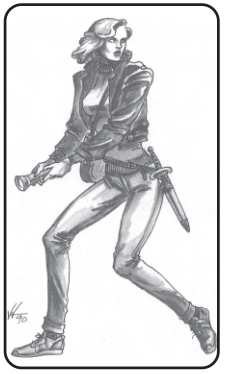
The Street Thief is from Core Earth, but was transformed by the axiom wash. Before the invasion, she was basically a self-serving professional thief. When Aysle invaded, however, she started facing competition that could pick locks by snapping their fingers and security systems that shot fireballs. But hey, the challenge just makes it more fun, right? She starts with a dark outfit, lockpicks, and a cockney accent.
quote:
“Cor! It’s a Lockrite! Didn’t think no one used those anymore. Give me room, I’ll have it open in a tick.”
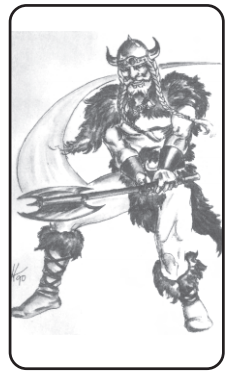
The Viking came for the conquest, and stayed for the redemption. As part of Ardinay's initial invasion force, he was okay with the whole run-roughshod-over-new-lands thing, but then Ardinay had her change of heart, and his leader Thorfinn changed and became more bloodthirsty and hostile towards Ardinay. He knew something was up, but being unable to confront Thorfinn directly, he sought out new allies to help him discover what happened to his leader. He starts with the generic furs-axe-horned helmet as befits a fantasy viking, and his tag skill is melee weapons.
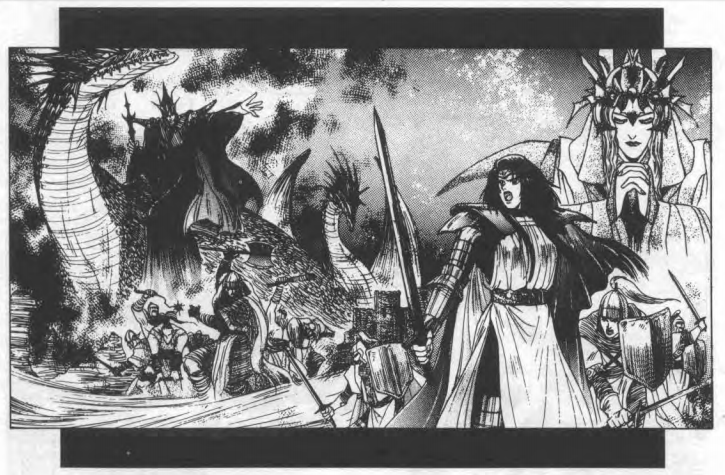
For some reason, the art in the later Torg books got very anime.
Now that we've covered the "current state" of Aysle, what does the future hold for the realm of high fantasy?
Ardinay and Uthorion spend most of the early parts of the invasion in a deadlock. Ardinay won't use the Darkness Device since she knows what'll happen, and while Uthorion is still a threat he's no good without someone like the Gaunt Man telling him what to do. More than anything Uthorion wants to get the Darkness Device to abandon Ardinay and support him again.
Uthorion's early goal is to do enough evil deeds to get Drakacanus to bond with him again, but the Darkness Device doesn't want anything to do with him now that it can see what a useless idiot he is. In a bid for more power, Uthorion eventually ends up discarding Thorfinn's body and placing himself in the body of a Draconis Teutonica (god that still sounds dumb) just before a battle with some Storm Knights. And while that wasn't a bad idea, Uthorion didn't take into account that piloting a dragon body is a bit different than his normal meatsuits and got his ass handed to him again.
Meanwhile, the Darkness Device had been scouting new High Lord candidates; even though it had a half-dozen candidates (Wotan being among them), the one it ended up going with was "The Warrior of the Dark", a duplicate of Tolwyn created through dark sorcery.
In just over a year, the Warrior of the Dark leads an army across the realm, converting most of the ream to Dark stelae zones and reinvigorating the remnants of Uthorion's army. This has the further problem of creating vast food shortages throughout Aylse, since Dark zones can't grow food in the numbers needed to support an army, let alone the whole realm. The Warrior ends up making a business deal with 3327 for food and weapons to support her troops. She also begins slowly expanding into Cyberpapacy territory to further cut Malraux off from the rest of the world. Once she has her power base established, she puts constant pressure on the Oxford hardpoint, forcing Ardinay's forces to defend it to the detriment of protecting the rest of the realm.
During this time, Uthorion keeps his head low, constantly trying and failing to earn Drakacanus's favor once again since he can't put together a decent plan to save his life. Eventually, the Gaunt Man returns, and sends Uthorion on a mission to the dead cosm Kantovia, which you may remember was one of the Gaunt Man's first conquests. When Uthorion arrives and announces who he is, he is attacked by hundreds of P-rated werewolves. And since he was too stupid to run and instead tried to fight back, he was slowly and unceremoniously ripped to shreds.

Pretend I photoshopped this to say "Uthorion" instead of "Beavis".
As for what happens to Ardinay and the Warrior of the Dark (and Tolwyn of House Tankred), that all ties into the major overarcing metaplot and is all irredemably dumb as hell. But we'll save that for when we eventually get to War's End; all you need to know for now is that of course Tolwyn marshalls the armies of Good and leads them to victory and saves the realm and single handedly defeats the Warrior of the Dark and everybody loves her. On the plus side, the PCs get to stand around and watch her do all that without being able to get involved!
And with that out of the way, we are finally done with Aysle.
Fucking finally.
--
God, I hate this book.
Seriously, this is my least favorite of all the cosm books, probably in all the game line, because so much of it is either writer wank for a setting that's not as interesting as they seem to think it is, or is ridiculous mechanics that don't add anything to the game itself.
More than anything else, it's just dull. I can't bring myself to care about the houses or the layout of Aylse itself or any of it. Yeah, there's a good idea or two in there, but it's buried in so much generic fantasy BS you can't bring yourself to care.
And as is always with these kinds of things, there's such promise there. The whole idea of a good leader constantly trying to resist corruption to solve all her problems while the previous evil overlord is bodyhopping around? That's some good stuff! The whole "good and evil are quantifiable things in the setting and the world swings between them piecemeal" could have some really cool ramifications. But no, once again the writers are so focused on the details only they care about they completely miss stuff that other people would be interested in. Hell, Uthorion is a close second to Barruk Kaah as the series' main whipping boy.
As for the magic stuff...Christ, there is no reason to make your spell creation system that complicated. I know that this was the era before we really started thinking about what rules really meant and designing for the players and such, but come on. It manages to be both way too detailed and too vague at the same time. It's just not fun, and at the end of the day games need to be fun. That's kind of the point.
But regardless, we're done with it now, so all that remains out of the core invading realities is the whipping boy of the whole shebang, which we'll get to...
NEXT TIME: The realm that time (and the players) forgot!
The Living Land
Original SA post The storm has a name... - Let's Read TORG
Part 16a: The Living Land
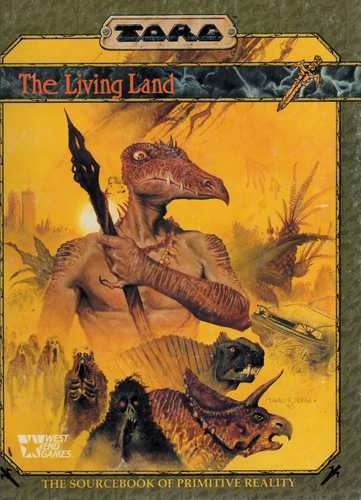
A group of survivors carefully picks its way through a New York skyscraper that has been destroyed by and is help up by giant vines and trees. They're looking for food and trying not to be heard by the velociraptor pack hunting outside.
A survival colony deep in the new jungles of Canada defends itself from an attack by fanatical lizardmen. The attackers revel both in the pain on their victims and in the pain they feel as their bodies are shredded by gunfire.
A supply convoy travels slowly along an overgrown path in an attempt to support a survivor colony. Vines the thickness of a man's arm wrap themselves around the vehicles, leaving them vulnerable to the dinosaurs seeking easy prey. The few vehicles that reach the colony will discover that the people there have seen the light of Lalana...and they want to spread the word.
This is no longer the world of men, of technology. This is the world of savagery, of nature run rampant. The land is alive...and it hates you.
A Land Forgotten By Time
Out of all the invading realities, the one most different from Core Earth is the one known as Takta Ker, which literally translates to "Living Land". Takta Ker is almost completely covered by jungle, throughout which roils the Deep Mist; the ever-present dense fog that hides everything. Giant reptiles and beasts roam the land, as it is a world without what we would think of as "civilization". There is currently only one intelligent race on this world: the lizardfolk that call themselves edeinos, worshipers of the goddess Lanala.
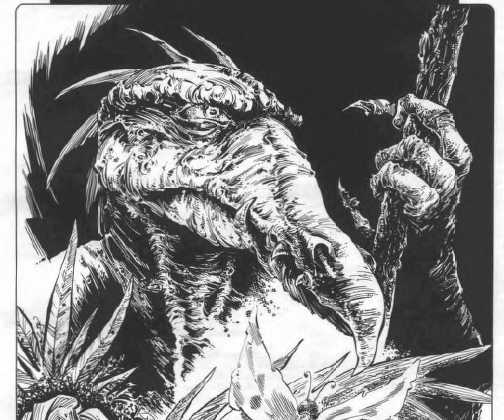
An edeinos
Lanala is the central figure of edeinos society, the goddess at the center of the world that grants everything life. The worship of Lanala is the worship of life itself, and to honor Lanala, the edeinos refuse to use tools made of stone, animal parts, or dead plants. These things are all considered "dead things", and are anathema to Lanala. The use of dead things mark you as dead yourself, and as an abomination in Her eyes. It is the duty of all followers of Lanala to destroy these heretics by any means.
It is this belief that, centuries ago, united the innumerable edeinos tribes to wipe out Takta Ker's only other intelligent race; the insectile ustanah. The ustanah were an artistic race, and were just begining to develop an understanding of engineering when when the edeinos sought to bring them the word of Lanala.
When the ustanah politely refused, they were wiped off the face of Takta Ker and their works destroyed. After all, if the ustanah were willing to embrace death, the edeinos saw no reason to deny it to them.
You see, while Lanala is the goddess of life, she is herself unable to experience it directly. Instead, she feels what her followers feel, senses what they sense. Therefore, it is the duty of every edeinos to experience as much life as possible for her. Every sensation, good or bad, is done for her.
The feeling of breeze on your skin is a prayer to Lanala. The reflection of sunlight on a dewey leaf is a prayer to Lanala. The beating of your heart as you hunt your prey is a prayer to Lanala.
The jolt of shock up your arm as your weapon plunges deep into your enemy's body is a prayer to Lanala. The feeling of your own blood spraying as a vicious claw rips into your body is a prayer to Lanala.
And the edeinos are very, very, religious.
quote:
During their war with the ustanahs, the edeinas saw that the tools the ustanahs used could be advantageous. But they were forbidden from creating such things as the ustanah had created them, for such creation involved using items that were dead. They asked Lanala for guidance, and through prayer the goddess granted them liVing plants that would grow in useful ways, thus simulating dead tools.
The war with the ustanahs greatly increased the complexity of edeinos culture, through contact with a new social structure. They transformed from a scattered, unorganized people who depended mostly on the family unit for shelter, to a society with standard religious prayers and a large tribal infrastructure. For the first 500 years after the end ofthe ustanah war, the tribes were separate and frequently at war with each other (for no purpose other than to experience the intensity of combat).
Driven by the strange dead-yet-not-dead thing, Kaah began uniting tribe under his own banner. Those who did not follow were sacrificed, those who did were rewarded by being able to kill the dissenters. It took several decades for Kaah to marshall his forces, but once he did he created his first maelstrom bridge and, armed with a an army of fanatics, conqured his first reality.
For years afterward, Kaah traveled across the multiverse, bringing the word of Lanala to new cosms. With each victory, his army only grew, and as his army grew each subsequent victory became easier.
It wasn't long before Kaah came to the attention of the Gaunt Man. An alliance was quickly formed, allowing Kaah to bring the will of Lanala to another dead world.
And so, on Core Earth, during the first game of the 1990 World Series, with the President of the United States in attendance, Baruk Kaah dropped a maelstrom bridge directly onto Shae Statium and sent thousands of his warriors and beasts swarming into New York City. As technology failed around humanity, his forces spread through the streets in a wave that stopped for nothing. A second bridge soon followed in California, and a third in Canada. There was no warning, no way to fight back. In less than a week, Baruk Kaah had overwritten the reality of a sizeable chunk of the North America continent. Yes, others would soon follow around the world, but none of them had the savagery of that inital attack.
The invasion had begun in earnest, and Kaah reveled in the hunt.
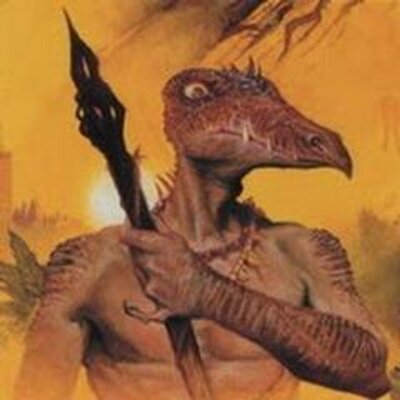
Baruk Kaah, High Lord of the Living Land
Make no mistake: Baruk Kaah is a monster.
Technically speaking, Kaah is unqiue among the edeinos because he possesses something the other edeinos do not: vanity. While the rest of his people think in terms of what is good for the tribe as a whole, Kaah is only out for himself. For centuries he's led the edeinos as their Saar, and despite his actions (as we'll see coming up), he is utterly devoted to Lanala. But everything he does is filtered through the idea that only he is worthy of power. All of his followers are there for no other reason than to support him. Anyone who opposes him is a sacrifice to his glory and the glory of Lanala.
In fact, he is so devoted to Lanala, he's convinced that it is his destiny to become her true lover. Not just a follower of her ways, but an equal...or superior. Only he is worthy of her true love, and once he gains enough power he will ascend to godhood and take her as his own. It is his destiny, for no other being in the multiverse is as devoted to her as Baruk Kaah himself.
Kaah's Darkness Device, Rec Pakken, told Kaah about the legend of the Torg, and that by getting enough Possibility energy Kaah could ascend to godhood as Torg. This goal has driven his entire campaign of multiversal conquest, and has resulted in both sweeping victories and crushing defeats. Kaah's general battle strategy tends to boil down to "throw troops at it, choke the rivers with either their dead or our dead, probably both." It's be surprisingly effective due to the Living Land's very low technology axiom and some of its World Laws, which make the use of technology almost impossible.
Baruk Kaah's long-term goal is one single point: become Torg so he can claim Lanala as his lover. That's it. Everything he does is to either further that goal, or to set up his final "gift" to Lanala.
You see, once he becomes Torg, Kaah will spread the reality of the Living Land across the face of Core Earth. Once everyone is converted to his reality, he'll pull back the stelae zones and watch as everyone is killed by the lack of Possibility energy needed to survive a second transformation. This mass painful sacrifice of billions will be his ultimate gift to Lanala: a truly unique experience that nobody but the great Baruk Kaah could create for her.
With such a gift to her glory, how could Lanala refuse his love?
Because he's so focused on his insane goal, he's also unique in that he's set himself up as someone with something to lose. Again, normal edeinos society is based around the tribe, not the individual. Because Kaah only cares about his own goals, he'll ask for (and accept) help from anyone he thinks will give him an edge. Needless to say, this will bite him on the ass later.
He's also begun embracing the use of technology, which is strictly forbidden by his religion. But again, because he's the one doing it he feels it's okay. That said, he keeps the use of dead things secret from his followers solely because he knows it'd cause problems for his position if he didn't. He's set up a small cult in secret to explore the options Core Earth's technology gives him.
Lanala's Love of Life
Before we go any further, we need to discuss the Lanala and her religion, because it is central to edeinos society.
The religion of the edeinos is called Keta Kalles, and its only divine figure is Lanala. As stated before, Lanala is the giver of all life, and her worship involves feeling sensations on her behalf. Any sensation, good or bad, is important to the edeinos because it's the only way their goddess can experience the world. As a result, Keta Kalles really doesn't have many taboos apart from the use of "dead things".
"Dead things" is a very general term, but one that's easy to understand: anything that isn't alive. The use of dead things is forbidden in Keta Kalles, because in doing so you're turning your back on Lanala's gifts. So pulling branches off a tree to build a basic shelter is forbidden, feeding off the corpse of a beast is forbidden, even just picking up a rock and bashing something with it is forbidden.
Likewise, those who do not follow Lanala are considered "dead". And while the edeinos will try to convert non-believers, they don't see much of a problem with killing them since they're refusing to accept Lanala's gift. That's not to say they won't go out of their way to kill heretics (for the most part), it's just that they have no real problem with it.
The priests of Keta Kalles are known as Jakatts, and they're generally in positions of power. They understand the importance of intense sensations to their goddess, and the key word here is "intense". While the thrill of hunting prey through the jungle is loved by Lanala, so is the sensation of having a broken leg. edeinos won't actively hurt themselves to provide sensations for Lanala, but when they are wounded they embrace the pain, drawing a sort of repture from it. After all, pain is a reminder you're alive, right?
This is why Kaah's army is so frightening. They're not just religious fanatics, they're religious fanatics who don't care about any wounds they suffer in battle. edeinos warriors won't stop fighting until they die; in fact it's not uncommon for a warrior to enter a frenzy and fight harder while being riddled with bullets. Win or lose, everything they do in battle is a prayer to Lanala.
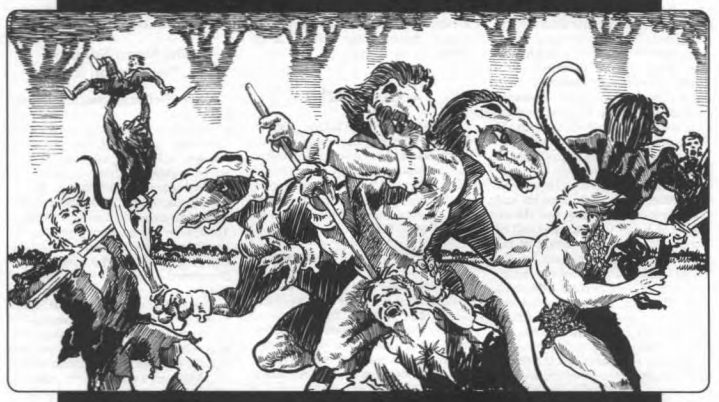
As we always do, let's take a quick look at the Living Land's axioms and World Laws.
Magic axiom: 0 Magic simply does not exist in the Living Land. Period. Any use of magic at all is a contradiction. It's interesting to note that this is the only reality that has an axiom level of 0 in anything.
Social axiom: 7 The most complex social unit in the Living Land, and in fact the central social unit, is the tribe. In fact, the needs of the tribe will override the needs of your immediate family. The Living Land is a very dangerous place with a high mortality rate, so people think in terms of protecting the clan as a whole rather than just one family in the clan. The low social axiom is also the reason for Kaah's dedication to swarm tactics and why the US military had such a difficult time fighting back: the concept of a military structure doesn't exist at this level. The idea that your small group has to follow the orders of that one guy, who in turn is part of a different group who has to follow the orders of a third guy, and so on up the command chain, is impossible at this axiom level. The standard edeinos battle strategy is to basically just have everyone rush and work yourself into a frenzy, and the human soldiers couldn't adapt in time.
Spiritual axiom: 24 The Living Land has the highest Spiritual axiom out of every invading reality. The religion of Keta Kalles pervades every aspect of edeinos society, and the high axiom level means that most of them are capable of performing miracles even if they're not Jakatts.
Technolgical: 7 This...is where we hit a bit of a problem.
I talked about this before, but the Tech axiom doesn't line up with the way the Living Land is presented. This is what's possible at Tech axiom 7 according to the Revised Edition core rulebook:
quote:
Metal is first smelted, tools may be made from first copper and then later from alloys like bronze. Metal hand axes and daggers are state of the art weapons.
Bows are possible, but only with enough punch for small game. Potter’s wheel appears, plow speeds agriculture. Glass, cloth, wine, beer invented. Seaworthy ships are possible but still musclepowered. Oil lamps invented. Kiln-fired bricks used in buildings.
Anyway, let's look at the World Laws. They're a little different from the Laws of other realities, in that they're more special mechanics that happen in the Living Land rather than explaining why things are they way they are.
First is The Deep Mist. The Deep Mist is a thick smoky fog that covers most of Takta Ker and that Kaah has brought to his realm on Core Earth. The Mist pervades everything, and alters the weather patterns of the realm so it's always hot and humid. On a clear day, the Mist restricts vision to about 30 meters, and prevents you from really seeing details past 10 meters. If it's cloudy, then the vision limit is 20 meters. At night, you need a strong light source to see beyond 10 meters; past that the Mist diffuses the light too much to see. In addition, Kaah has used his Darkness Device to make the Mist screw with methods of navigation. You can't navigate by the stars, use a compass, or (presumably; they weren't invented yet) use a GPS signal to find your way around. The edeinos get around this through the use of miracles, but you're probably not that lucky.
Second is Lanala's Love of Life. This law states that anything that is dead decays at a vastly accelerated rate. Any living thing that dies in the Living Land will completely decompose within 24 hours; if it was dead before it entered the realm (such as, say, food), then it rots even faster; food prepared more than a week in advance will rot in about 40 seconds, although if it's packaged then the "timer" doesn't start until the package is opened. This makes survival a very moment-to-moment deal, because whatever you kill (or prepare) you need to eat right away. On top of that, using raw materials like wood is impractical because it would rot away too quickly to be of any long-term use.
Lastly, there's the Law of Lost Valuables. This Law states that possessions will not stay in your...uh, possession long. The claws of an attacking creature will slash open your backpack, sending your survival gear into swampy water. You'll drop items when trying to cross rivers, things will vanish from your camp during the night, and so on. This isn't so much a World Law (although it's listed as such in the Revised Corebook) as a way for the GM to screw with players.
Putting this all together, we get one of the most hostile realms on the map. Everything, everything in this world sees you as a sacrifice, a heretic, or food. You can't trust your senses, you can't trust your gear, you probably can't even trust your friends. Survival of the fittest, and all that. Monsters abound just beyond your sight, hunting you, tasting your fear, waiting to chase you down and revel in your bloody death.
...did you just hear a twig snap?
--
This is a very disappointing book.
But not disappointing in the sense of "I don't like it", but disappointing in the sense of how much of it is wasted potential.
Like, go back and re-read that stuff I wrote about Kaah's long term goals. Pretty nasty, right? I mean, Baruk Kaah is lizard Ghengiz Kahn with a side order of religion fanaticism. His "military strategy" always boils down to sending in thousands of fanatical troops to overwhelm the opposition because he has thousands of fanatical troops available to him at any given moment.
Guess what. That gets forgotten by the game line almost immediately. As has come up before, Kaah became the series' whipping boy; almost immediately after the start of the invasion he loses Sacramento to 3327, then he loses about half his overall territory, and things just keep going downhill from there. Eventually he manages to damn near erase himself from reality, but we'll get to that whole metaplot nonsense later.
Compounding the problem is that the writers really had no idea what players were supposed to do in the Living Land. The only real "adventure" they ever presented was realm running: driving trucks of supplies to survivor colonies in the jungle who either won't or can't leave and are trying to eke out a living. Which is fine the first time...but when that's all the writers can think of to do in their own setting, you know you're in trouble. As it is the Living Land barely makes an appearance in published adventures.
I mean, at the risk of bragging, I'm doing a better job presenting the Living Land than any of the official material did.
A large part of the problem, too, is that the Living Land just isn't as well designed as the rest of the realms. Because it wasn't popular, the writers did fewer things with it, and when the writers did fewer things with it it became less popular. It's so bad, I can't even find a picture of Kaah in any of the books. In fact, rather than fixing the Living Land once they realized the problems with it, the writers supplanted it with a whole new realm!
Hell, the remnants of the United States and Canada almost get more page space in the Living Land sourcebook than the Living Land does. Figure that out.
NEXT TIME: Welcome to the jungle, it gets worse here every day.
Prehistories
Original SA post The storm has a name... - Let's Read TORG
Part 16b: Prehistories
The next two chapters are a breakdown of Baruk Kaah's home cosm of Takta Ker and of the religion of the edeinos.
(In the edeinos language, "Takta Ker" does translate directly to "Living Land"; the edeinos are a pretty straightforward people when you get right down to it.)
Takta Ker has five major landmasses, each covered in thick lush jungle and populated with what we would term dinosaurs, although the beasts there have a much greater diversity in size. The poles of the world are covered in frozen tundra, and there's very little life there apart from giant burrowing snakes. Likewise, the oceans are teeming with fish life, some of which are larger than whales.
Really, the defining characteristic of Takta Ker's environment is "extremism". The mountains are huge, the chasms impossibly deep, the creatures gigantic and deadly, the jungles impenetrable.
And...that's about it in terms of the world. Since the edeinos won't advance technologically (or socially, really), there's no cities, no buildings, no real culture to speak of, no locations to discuss. There's just the hunt.
Oh, and the maelstrom bridges; we shouldn't forget those. Kaah has four active bridges (which are basically giant vines the thickness of a skyscraper): three to Core Earth that connect to New York City, Sacramento, and Fort Providence. The fourth actually connects to the Aysle cosm, but we're not told why Kaah built it and it's pretty much forgotten immediately so let's just move on.
As was discussed last post, the history of Takta Ker and the edeinos is not complicated. Thousands of years ago, the edeinos wiped out the only other intelligent race in the world, and since then have lived alone in the jungles. Even a genocidal war had very little effect on their tribal culture beyond causing the various tribes to stop warring all the time. Really, the wars were more to feel the rush of battle than anything else.
Things stayed this way for centuries; because the edeinos live very much "in the moment", they saw no reason to think about the long-term development of their race.
Then one day, a young edeinos warrior named Baruk Kaah saw a falling star while staring at the stars in prayer to Lanala.
Kaah went to investigate, and discovered a large red-hot hollow rock inside a fresh crater. And he knew the rock was hollow, because something inside was calling to him to break through the rock and free it.
quote:
At dawn he succeeded, and the contents of the rock spilled out: a single, giant seed. It was as black as night and as smooth and reflective as a calm pond. It was as big as his fist, and it sang to him of power and glory. Thinking the seed was a gift from Lanala, the young edeinos took it off to an area far from his tribe and planted it. It immediately took root and began to grow. In only a week's time it was as large as a tree, and in his pride Baruk Kaah brought others to see what Lanala had given him.
It only took a few weeks before the roots of the tree began to spread out and take root, causing more stone trees to sprout. It was clear that this abomination would keep spreading, forming a vast dead forest like a scar across the world. Those tribe members who objected "vanished" during the hunts. When the rest of the tribe learned that Kaah was not only behind the deaths, he was taking the bodies and putting the corpses into strange sacks woven from the vines of the stone trees.
This was a crime worse than the murders; all edeinos know that is natural (and therefore right) that corpses quickly decompose in the Mists so that they may feed the land. The tribe turned against Kaah for breaking the cycle of life.
Kaah revealed that the tree (now a copse of trees) had spoken to him, and taught him how to take the bodies of the fallen and infuse them with the power of the world. And since the power of the world is the power of Lanala, then obviously this was good! A gift from the goddess herself!
Not all the edeinos saw it that way, of course, but Kaah had been able to amass a large amount of followers by promising them power and new experiences. Those opposed to Kaah, who saw all this as a perversion of Lanala's gifts, tried to fight Kaah. By this point, though, Kaah had fully bonded with his Darkness Device and was unstoppable. The "traitors" were killed, and their bodies also used in these strange sacks, which Rec Pakken called "stelae". The Darkness Device told Kaah that by planting them in specific locations, he could extend Rec Pakken's power outward, keeping Kaah immortal even when not near the copse.
Kaah quickly began expanding his territory, and within a few decades had complete control over his whole world and every tribe therein. And once he was their true leader, their "Saar", he created his first maelstrom bridge to another world. Driven by promises of sensations never before experienced, his warriors flooded down the bridge to a new cosm; the homeworld of a species of flying starfish known as stalengers. The stalengers saw the light of Lanala, and Kaah's army only grew.
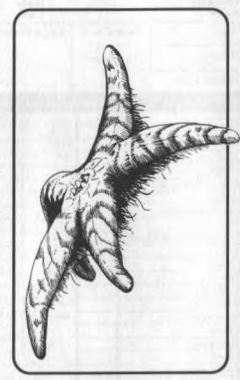
A stalenger. And yes, they're a playable race.
Since then, the Living Land has spread across the cosmverse like a virus. Dozens of worlds have been conquered, and new species and beasts roam the ever-expanding jungle of the Living Land.
Kaah was eventually approached by the Gaunt Man to participate in the invasion of Earth. By this point, Kaah had learned of the legend of the Torg, and was rather annoyed by this weird being that wanted to claim the title for himself. Still, new conquests were new conquests, and Kaah agreed to join the other Possibility Raiders. For now.
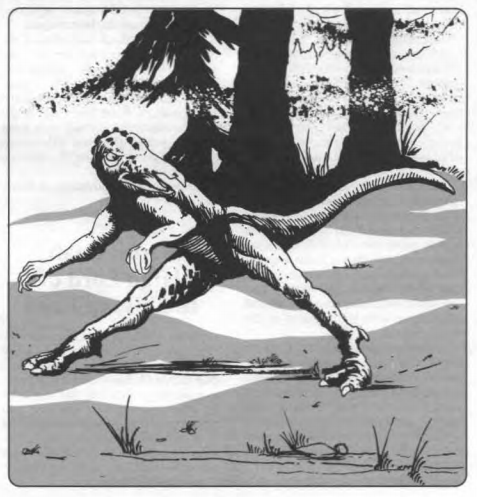
Majestic, aren't they?
Now, the next chapter is about the Keta Kalles religion, then from there the next chapter is about the invasion, then the chapter after that is the one about the realm itself. Even by Torg standards, the book isn't organized very well. To be fair, it was the first cosm book to be published. But since we're doing everything in order (and because it's useful to know this stuff for later), we're now going to learn about The Keta Kalles Religion.
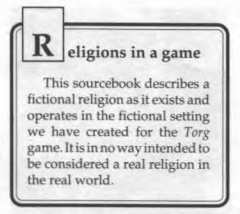
Look, it was a different time, okay?
quote:
Lanala was very much alive. Her skin, as pale as the moon above, was pulled taut over the entire length of all the worlds. Her eyes were as big as the suns, her finger tips caressed the night sky.
But there was nothing for Lanala to feel, for Lanala was all there was. There was no light. Thert was no world. There were no trees or water, smells or flesh. There was no blood. There was only Lanala, and she wanted something she could experience. She longed for food to taste, for colors to see. She desired textures to touch, scents to smell, and sounds to hear.
So Lanala decided to create so that she might have sensations. First she made the stars, and scattered them through the cold black of night so she might marvel at their beauty. Then one night, she decided that t~ stars should have worlds to warm, as they already had heat. In this way, they would know what it was to use themselves to give pleasure. So Lanala made the worlds.
She was pleased with her work, but quickly saw that some of the worlds were getting too hot. She created oceans so that the worlds might cool down. She cupped the water from the oceans in her hands and poured it over her head, shivering from head to toe at the wonderful coldness. But it occurred to her that the water did not have the opportunity to give anything, as she gave the stars energy and the stars gave the world heat and the world gava the water a place to be. So she made plants to draw on the water for growth, and the water could give sensation as well.
Lanala had just completed creating the plants when they began crying out, one after another, over and over again, "We're good to eat! Taste us! Taste us!" Lanala did and discovered the plants were indeed uery pleasing to eat. She had grown weaker, though, from making all that she had made, and could not taste the plants fast enough. So she made the animals to help her taste the plants of all the worlds.
Soon, though, the animals were dying from old age, while the plants were born again and again each season. The animals begged to be allowed to live forever as the stars and worlds and oceans did, but Lanala did not have enough strength to do this. Instead, she said to the animals, "I enough power to let you create yourselves anew through your own passion." And
the animals, with no further prompting nmIed from Lanala, began making more of themselves.
When Lanala was done though, she realized that she had used up so much of her power that her senses were dead. She could no longer see the stars, or feel their warmth. She could not touch the soil, or smell the ocean breeze. Her grief was unbearable. It was impossible for her to be among the universe yet be unable to experience it.
She decided to transform herself from the one strong god she was, into many weaker mortals who would experience the universe for her. The mortals became her eyes, ears, nose, tongue, and fingers. In return for life, the mortals were required to experience everything, as fully as possible, for Lanala.
The priests (or Jakatts, which translates directly as "lovers") preach that the central concept of the religion is that the more intensely you experience the physical aspects of life through your senses, the more Lanala feels; and the more Lanala feels of her creations the more she will reward you.
The key word there is "intensely". It's not enough to just watch a sunset or swim through a raging river; you have to fully indulge in the experience. In a manner of speaking, this is how the followers of Lanala pray to her.
What's more, the reason for the sensation is irrelevant. If an edeinos is in battle, it doesn't matter to him if he's overcome with the thrill of battle or is terrified for his life. Both situations are just as effective as praise to Lanala.
Asking for a gift from Lanala (a.k.a., performing a miracle) requires the offering of an intense sensation. When not in battle, this can take the form of an artstic effort. Dancing is common, as is weaving art from living plants. So is sacrifice. To the Jakatts, pain and pleasure are just different sides of the same coin.
When the need is a bit more immediate, such as a miracle needed in battle, then self-mutilation is usually used due to the simplicity and intensity of the action. Many edeinos have a permanent wound, which they call a yunti ("passion") that they can use to feel pain when they need Lanala's blessings. Most tribes will cut their young during puberty, usually under a flap of skin on the stomach, and the wound is never allowed to fully heal.
An except from an interview with a Jakatt
quote:
Lanala has taught us how to feel everything. To look at this...(indicates the table before him and he is told its name)...table is fascinating, though you pass your eyes over it without seeing it. You do not see. Do you understand? You have eyes, but you have torn the Sight from them. But this table is dull compared to what lives. You have smothered its surface, cut its sides clean, removed all of its roughness. It is easy to look at, easy to touch. This is how you die. You make things easy, you get lazy. The tree you killed to make this was more interesting by far than this thing you made with it. Harder to take in, but much more interesting.
Needless to say, Keta Kalles is a very informal religion, especially from a human standpoint. There's no formal structure to the clergy; anyone who is dedicated enough to Lanala can perform miracles with no special training. Anyone who can perform miracles is referred to as a Jakatt, and those who dedicate their lives to their faith are called ophants, and tend to be leaders in their tribes.
There is a very new special "branch" (for lack of a better term) of priests known as gotaks: "they who must suffer no passion". That's a bit of a misnomer, because the gotaks are still expected to feel sensations for Lanala as much as everyone else. Their role in edeinos society is to deal with dead tools. Such as the stone knives used to sacrifice beings for Rek Pakken; no other edeinos would ever touch such a thing. They're also responsible for the preparation of corpses to create stelae, and to manage the gospog fields. The gotaks are a relatively recent addition to the religion by Baruk Kaah, because he needed people to handle the physical gifts the Darkness Device. It's worth noting that the gotaks are not considered heretical or wrong, nor are they shunned in edeinos society; in fact they're pitied. Well, and feared a bit as well, since they understand the workings of Rek Pakken.
One very interesting thing to point out is that Keta Kalles, and by extension the edeinos themselves, have no concept of the soul. They just feel that you're you, and that's all there is to it. Because of this, there's no real concept of an afterlife (when you die, you feed the plants and that's it), nor is there a concept of "damnation" or divine punishment. This means that there's really no taboos in Keta Kalles apart from maybe deliberately avoiding an intense sensation. Keta Kalles is all about living in the moment, after all.
Likewise, there's no real drive to live a "good" life, at least in the way we'd think of it. For a Jakatt, everything is good except for the loss of life, and even then it's not something that's really considered bad. A Jakatt's job is to live life to its fullest, but at the same time they know doing so brings them closer to death.
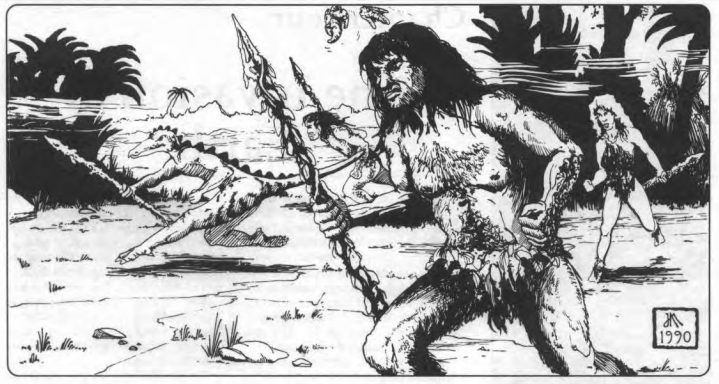
Keta Kalles has had a lot of converts lately.
Throughout the chapter are excerpts from interviews with edeinos conducted by Core Earth researchers. It's a nice touch, really, and actually do a really good job of explaining the edeinos mindset.
quote:
Everyone else in the tribe is equal. We all do what must be done, some days doing one thing, other days doing another thing. We are not lazy like you, and ...
What do you mean lazy?
I often hear your people say, "I want to get out of here," or "I can't stand doing this," when working. When I ask what one of these people will do when they "get out of here," they answer that they will sit around and drink or turn on your televisions and sit around some more. You all sit around. You sit around at work and go away to sit around some more. We enjoy our work, because we know we must work to live.
What about when your people, and by that I mean all Jakatts, walch a tree? Isn't that sitting?
When you run you do not strain yourself as much as when I watch a tree. I look for everything. I am looking at a tree to find my goddess.
quote:
What was a day for your tribe like?
We would rise early. Some would go hunting for animals to use as food or as mounts, some would stay with the children. Others would prepare living plant sculptures for the rituals forthat night. When word came for us to fight, we would gather our weapons and travel as we were commanded.
Hunting was a day long activity. We traveled in groups of about five, armed with our spears. We would track prey and then attempt to touch the animal before killing it.
Could you explain that?
It is a chance to feel fear and excitement. We attempt to get close enough to the animal to touch, while it is awake, before we cast our first spear. After the first hunter touched the animal we could kill it. Sometimes a hunter wanted to touch an animal although someone had already touched it, and this was always allowed.
We also had to touch the animal when attempting to acquire them for a mount. This was easier because the animal could be asleep, although walking up to the animal without waking it is no easy task.
Staying with the children meant two tasks-playing with them and watching after them, for they are young and do not know the ways of survival yet. Also, those with the children must guard the campsite from hungry creatures.
The games usually involved much running and hitting. Acommon game is upk. The children and adults are divided into two teams and each player is given a hrockt shoot. At the center of the camp is a skull of an enemy wrapped in mummified skin (the "ball" is, of course, prepared by the tribe's gotak). The first team to carry the ball outside of the camp area wins.
What are the rules?
Rules?
How do you play?
I just told you.
--
The stuff just in these two chapters just makes me sad at how the Living Land was cast aside by everyone. There's some really cool stuff here! The book does a great job explaining not just the religion of the edeinos, but also taking into account how Kaah had to twist Keta Kalles to his own ends so he could "validate" the use of his Darkness Device.
I feel like if they'd just taken things a few steps further, or at least kept revisiting these ideas, the Living Land would have been more popular.
NEXT TIME: Survival of the fittest
Nature reclaims its own
Original SA post The storm has a name... - Let's Read TORG
Part 16c: Nature reclaims its own
The next two chapters are The Invasion of Earth and The Living Land Realm, which means it's time to talk about how things are in the States and Canada.
In the public eye, Baruk Kaah's invasion was what kicked off the entire invasion of Earth. Yes, Orrorsh was technically first by a few days, but the Gaunt Man made sure to keep the invasion a secret for as long as he could. He knew that once his bridges dropped and the storms sprung up around central Indonesia, the rest of the world would be cut off and it'd be a while before the outside world could find out what was going on, and he was counting on the other invaders landing to draw attention away from his realm for as long as possible.
However, "subtlety" is not a word Baruk Kaah understands.
The first of Kaah's maelstrom bridges dropped directly on Shea Stadium during the first game of the 1990 World Series, creating a Living Land pure zone that covered about half of New York state and Pennsylvania. Chaos ensued as technology stopped working, lizardmen riding dinosaurs flooded the streets, and people started attacking each other for no reason. Thousands of humans were immediately transformed to Living Land axioms, and thousands more were killed in the chaos.
In less than twelve hours, New York City was in ruins.
The military was called in quickly to deal with the situation, but were unable to fight the invading forces. In the pure zone, weapons and vehicles stopped functioning, the chain of command broke down completely as soldiers became incapable of understanding a command structure, and there was no way to communicate with other forces inside or outsize the zone.
Kaah knew that he had to press his advantage quickly. Jakatts were sent out in all directions to begin planting stelae, while the gotaks quickly began planting gospog fields. Expanding the realm was easy, since the military defenders were completely powerless in the face of the Living Land's reality.
Within days, Kaah controlled most of the northeastern portion of the United States. But he wasn't done there.
A second bridge was dropped on Fort Providence, Canada. Again, he was able to take the territory with little effort, but instead of rapid expansion Kaah only set up two pure zones, making sure they were well defended before preparing his third incursion.
Kaah's third and final bridge was dropped onto Sacramento, California, and this was Kaah's first real defeat. When the bridge dropped, the area known as Silcon Valley failed to transform and became a Core Earth hardpoint. Thinking that his own power would be enough to overwhelm the region, but was unable to overcome Core Earth's reality. He was forced to retreat back up the bridge, but his forces did manage to expand northward into Canada.
Another thorn in Kaah's side were the increasing number of storm knights being created by Core Earth; more than had been seen by anyone in any previous world. Kaah reached out to Uthorion, who loaned him the Wild Hunt as part of his own schemes (which would never come to fruition).
By this point, hundreds of thousands of gospogs were harvested, and Kaah used them to prevent people from escaping his realm. The inhabitants were either integrated into existing tribes, sacrificed by the gotaks, or killed and used as raw material for more gospog.
Within three months, Baruk Kaah controlled about a quarter of the United States.
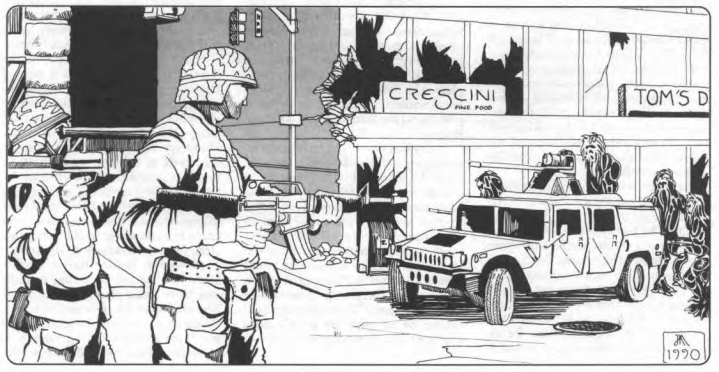
"One weekend a month, my ass!"
So let's talk about Kaah's tactics. Or lack thereof.
As we've seen, Kaah's overall strategy in an invasion is to throw warm bodies at the target. And it's effective because not only does he have several worlds' worth of followers to do this with, the axioms of the Living Land favor his people in conflicts
For instance, the Living Land's low social axiom barely allows the concept of a militia that can be assembled for defense. It doesn't support the idea of a standing military, or an army that's assembled for conquest. Of course, "assembling an army for conquest" is what Kaah does every time he invades a world, but he gets around that by keeping everyone assembled into tribes he can order around. He knows that you need planning and strategy to wage a war, but the rest of the edeinos don't (and can't) think that way. They live in the moment. Really, the only reason Kaah keeps the social axiom where it is is because it hurts any actual army that gets in his way.
But while the low social axiom doesn't hurt his forces, whose preferred attack style in any case is the chaotic swarm, it makes it damn near impossible for people to put together a decent defense. Add to that the low technological axiom (which his people are used to but most other realities aren't) and it's easy to see why he's been able to steamroller so many cosms.
Of particular interest is the Battle of Chicago, where Kaah managed to suffer a short-term loss but get a long-term gain.
The US military quickly realized that Kaah was taking population centers; Kaah needed believers to power his stelae and maintain the realm. The military also realized that attempting to fight the edeinos in their own territory was suicide. The only real option was to dig in and set up a defense in Kaah's path, and wait for his troops to enter Core Earth reality.
Kaah had assembled a gigantic army to attack Chicago, and since he knew all about shock and awe made sure the Army could see it coming. Both sides were assembed at the border of Illinois, waiting for the other to make the first move.
Unfortunately for the Army, nobody knew about steale yet. Kaah had sent small forces around the planned battlefield to plant stelae. One such group was discovered and stopped by a National Guard unit, but it wasn't enough to stop a zone being created in the northern third of Illinois, with the Army right in the middle of it.
At this point, the military tried to evacuate Chicago, focusing as many troops as they could on defending the civilians. This turned out to be a disaster; the shortest route back to Core Earth was along I-57 and I-55, only 25 miles...but that's not very easy to do when you're funneling the population of one of America's largest cities through two highways. It was depressingly easy for Kaah's forces to descend on the evacuees and slaughter the military forces.
But, interestingly, not the civilians. The Jakatts had other plans for them.
quote:
The Jakatt army had two goals: to kill as many military personal as possible, and to drive the evacuees back into the Living Land. Although the American soldiers fought bravely with the simple tools they had available (knives and bayonets), thousands were wiped out when confronted with the primitive army trained to fight in such a reality. The march south was halted when the primitives spilled across the highways and demanded that the humans return to the north. Countless civilians died in the ensuing panic. Some people were able to sneak around the edeinos, but most were too weary to make an effort. Parents traveling with children (the majority of the evacuees along the highways), when they saw that the lizard men were not going to harm them, agreed to return to their homes. The Jakatts aided the humans who cooperated in every way, as was their custom, and performed many miracles to help the weak and injured survive. As always, these efforts had a positive effect on the Earth natives' attitudes toward the invaders, and by the time the journey north was completed many a human had come to depend on the Jakatts for survival.
The Jakatts accept humans into their tribes, regardless of if they've transformed or not. Of course, humans who've transformed are probably worshiping Lanala and are capable of performing miracles, but even those who haven't switched over yet are tolerated in the tribes in hope they'll come to love Lanala. There's actually quite a few non-transformed humans in edeinos tribes, often for no other reason that survival in the Living Land without their help is damn near impossible for a 20th century human.
One thing that's important before to note before we close out the chapter is that some of the Jakatts are beginning to rebel against Kaah. They're slowly realizing that Kaah's ambitions only serve himself as opposed to all the tribes, and they've grown increasingly unhappy with Kaah reliance on dead things. Several Jakatts have split from the main religion, calling themselves Jakatt Teks, and started their own tribes. Right now the Jakatt Teks are a small enough problem that Kaah just ignores them, but he has forces ready to sweep in and kill the traitors if they become too much of a problem.
The last part of this chapter covers Kaah's Relations with the World, which is to say the other High Lords. For the most part, Kaah doesn't care about them because he's too focused on himself, but he's been known to ally with the other Raiders as needed. He has a very tenuous alliance with Dr. Mobius, mainly just because they both dislike Malraux's goal of spreading CyberCatholisism worldwide. Despite everything, Kaah is very faithful to his religion (or at least his interpretation of it), and sees Malraux as a serious threat. Rumor has it that the CyberChurch has been reaching out to the Canadian government to offer aid against the Living land, and as you can imagine Kaah is not happy about that.
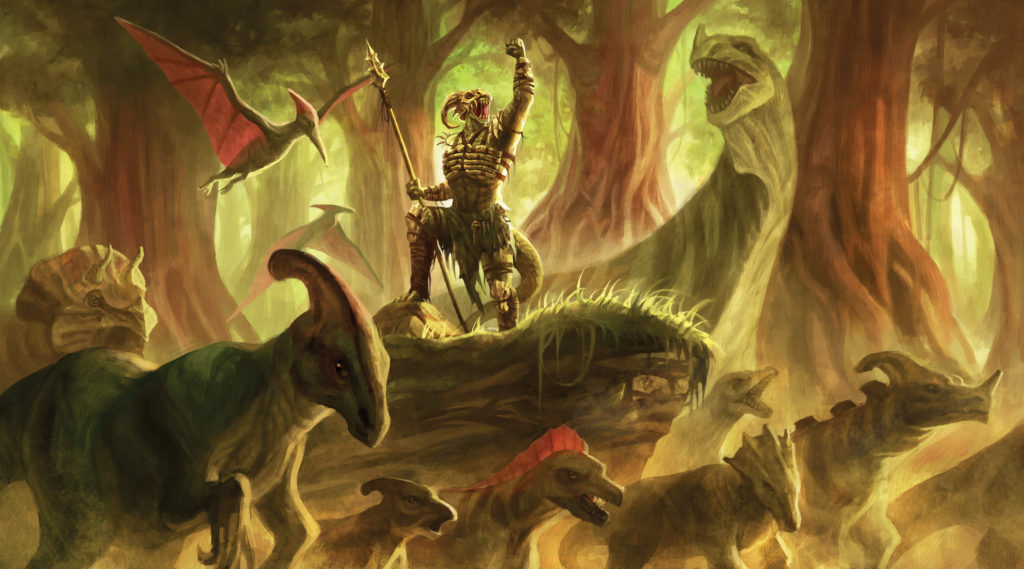
Technically, this is from the upcoming Torg Eternity, but it's also the only decent picture of Kaah I could find.
So what's life like in the realm now?
It's pretty damn scary.
quote:
"Father?"
Ted opened his eyes. Jenny stood before him. His arms tried to grab her, to hold her, but he discovered that his wrists were tied behind his back.
"Jenny? Jenny, honey, how are you?"
"I'm fine, Father," she giggled, as if the question were silly.
"...Listen, I'll get us out of here, don't..." And then he noticed the hunger in her eyes. Or at least it seemed like hunger at first. As he looked into her eyes, though, he realized she was actively consuming as well, as if she were possessed by an eternal appetite that was always being fed, but never sated.
"Shhhh." She put her finger to her lip. "The optant wants to sacrifice you. I told him you were blood, and he said if you decided to join the tribe you would be spared." Jenny stopped and stared at him again,still with the same hunger.
"Join the tribe? Jenny, these are aliens or something. They've taken over parts of the country. I can't join them."
Now Ted noticed about 30 figures around him and his daughter. All of them were watching. Most were the lizard creatures,but some of them were humans. There were a few larger lizards, which Ted had seen the creatures ride as mounts. And beyond those, in the trees as the edge of the clearing, Ted saw what looked to him like giant starfish made of stained glass. For a moment he was captured by their beauty.Then his daughter's voice brought him back to the situation.
"Then you will die."
"Jenny!" he whispered harshly. "What's with you. Don't you want to get out of here?"
"No." She answered the question with such ferocious joy that it frightened him. She must have flipped over to their way of thinking, like the others he had met.
"Doesn't it mean anything to you that I'm you're father?"
"It is why I asked them to spare you."
"And if I don't surrender?"
"Father ..."
"Stop calling me father!" Ted shouted. "I'm your daddy, blast it!"
She stopped as if she had been slapped. For a moment he could see his little girl in her eyes. Then the alien hunger returned, and she continued coldly. "You are blood. But the tribe comes first. If you wish to die, then so be it. That is the first test anyone must pass before joining Baruk Kaah. If the person wants to die, they cannot be part of the tribe. They are given their wish. Everyone in the tribe wants to live."
"What are you talking about?"
"Everyone in the tribe wants to live. No one here ever wants to die. The night after Mother died, you cried and said you wanted to die. If you were to join the tribe you would never have that feeling. We always want to live."
Henry Winslow's grinning face sprang up in Ted's mind. "I just left Henry Winslow dying down the road. He seemed happy enough about it."
"He is not dead. He was cured by a praying to Lanala. He rewarded him for the sensations he gave him. And if you thought he was happy about dying you are wrong. But the pain was..." she stopped to search for a word. "A feeling he was overwhelmed by. In the tribe all feelings...everything..." She could not go on, but her eyes were so very alive. She was like a new born baby who had been given the intellect to go out and get whatever it desired.
"I don't want to feel that," Ted said.
"You will feel that just for a little bit before they kill you. That is part of the ritual."
"I don't want to live that way. I want to be upset over your mother's death. I want to care." His daughter turned and walked away from him.
"Jen! Jenny!"
She walked on.
Kaah's territory is split into three separate regions: The Eastern Land, which is most of the northeastern US, the Western Land, which consists of most of the North American west coast, and the Northern Land in Canada. Of these, the Eastern Land is by far the largest, and is where Kaah has set up his base of operations.
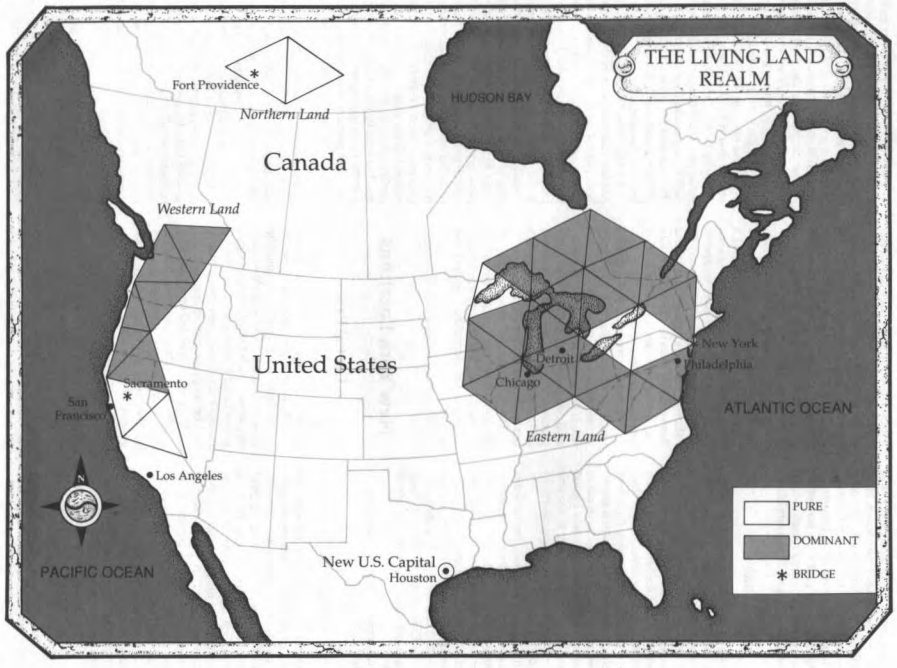
The Living Land, about three months after the initial invasion.
Kaah was able to establish and expand the Eastern Land so quickly due to its population density; right from the start of his invasion he had millions of converted believers powering his stelae. The majority of Kaah's forces are here; countless tribes are used to harvest gospog and defend the boarders.
At the heart of this Land is New York City, which has been utterly destroyed by the invasion.
quote:
It is ruled by those with a will strong enough to survive and possessed of the almost mythical New Yorker disinclination to leave the city no matter how bad things get.
New York City still sort-of belongs to the humans, mainly because to the edeinos it's composed of nothing but dead things. The only real area they care about is Central Park, which has been converted into a gospog field. That said, the majority of the population have descended into near-barbarism, and the city (apart from the south end of Manhattan Island) is now pretty much run by the gangs.
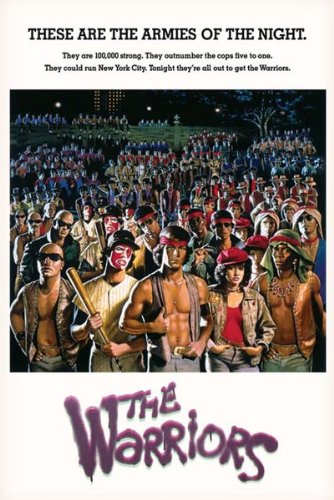
Can you dig it?
Well, not really "gangs" in the sense of street gangs so much as neighborhoods assembling a bunch of dudes to stake out and defend thier territory. It's very much a Batman "No Mans Land" situation, where the ords stuck in the city (and that haven't transformed yet) have been forced to band together into rough...well, tribes, claim a few blocks as turf, and defend the borders (and their dwindling supplies) from everyone else.
The big thing is defending your territory's supplies. The Deep Mist has permeated the city, and the current World Laws means that most of the food in the city rotted away months ago. And since nothing is coming in, this means that the overall food supply is a perpetually dwindling resource. People have had to rediscover basic hunting and tracking skills to take down the dinosaurs and other beasts wandering the city, but rumor has it that some gangs have already begun sliding towards cannibalism.
Really, more than anything else food is the main reason for inter-gang fighting. Chasing prey into someone else's turf but not following means you're giving them an advantage over your gang (since now your people can't eat), but following the prey in is going to result in a battle with that turf's defenders.
Territory is demarked via graffiti and gang tags, which have become a sort of "law" in the ruins. Whoever marks the territory first gets it. Most territory battles start off with a gang overwriting another gang's tags in an attempt to claim territory.
The unwritten rules of territory are:
- Graffiti and tags mark turf, period. If you don't like it, tough shit.
- If you enter another gang's turf without permission, you forfeit any rights you have to protection or anything.
- If you're chasing prey and it goes into another gang's territory, it's theirs now.
- You can get permission to pass through another gang's turf in order to get at a third gang that invaded your turf.
That said, no gang or conclave or whatever goes anywhere near Central Park. Nobody's sure what the Jakatts are doing there, but whatever it is they're killing everyone who gets close to the Park so nobody's in a hurry to find out.
As you'd expect, we get a few sample gangs to seed the city with.
The Subs consist of kids ranging from ages 14 to about 20. They operate out of Grand Central Station and hunt mainly along the subway and shuttle lines. They stay underground for the most part, and only come up to the surface to see what the overall situation is.
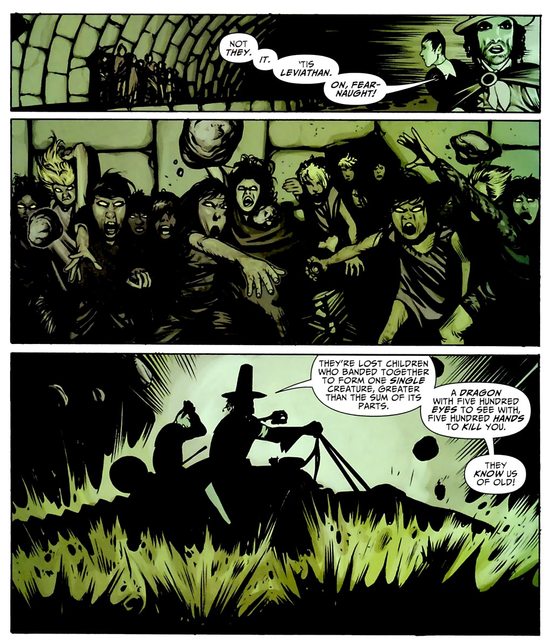
It's only a matter of time, really.
The Zonks is comprised mainly of small-time drug dealers and low-end criminals, and currently controls most of the upper east side. Needless to say, the area isn't quite a opulent as it used to be, but the Zonks love it because it still sort of represents the wealth they always wanted. Despite the fact that they're living in the ruins of luxury (and have the gaudy jewelry to prove it), they're also one of the most dug-in gangs because their past "professions" make them one of the best-armed gangs in the city. Admittedly only P-rated gang members can use guns, but that still puts them ahead of a lot of other gangs.
Then there are The Links
quote:
Basing their slang on a Nintendo video game, this adolescent gang spends its time looking for "hearts" (live animals), collecting "gems" (ammo), and searching for Zelda, a term which doesn't have a specific translation, but means to still be alive, or "the next day." A Link who just survived a close battle against a tra might say, I'm still on my way to Zelda, man."
The gang has spent an inordinate amount of time securring power sources to run their electronic games and televisions in the apartment buildings of their turf on the upper east side. Their turf extends from First Avenue over to Lexington, and from 80th to 86th Streets, though they are quickly losing the war with the Zonks to keep their southern boundary. (They call Zonks
"spiders.")
Because of their passion for electronic fantasy games, the Links were one of the first gangs to shift to more primitive weapons, taking up swords they scavenged from sporting good stores to use against the reptilian creatures haunting the streets of Manhattan. When not playing video games or hunting, the gang members spend a great deal of time sparring against each other with their steel weapons. Their combat style is a unique combination of fiercely efficient charges and flashy Errol Aynn maneuvers(watching fantasy movies on VCRs is their second passion.)
The headquarters of the gang is a small electronics store, a hardpoint located on Lexington between 81st and 82nd. Although it's located in a pure area, the kids can play any of their games and watch any of their movies on the plethora of electronic goodies left over from before the invasion.
The gang has a good supply of modern weaponry to supplement the swords, though such arms are usually reserved for skirmishes against the Zonks.
The symbol of the Links is a heart.
Anyway, moving on.
The reason Central Park is a no-go zone is because (as stated previously) it's a gospog field. The Park is always defended by about a thousand first- and second-planting gospog; fortunately for the gangs they stick close to the Park itself. The Jakatts manning the field, on the other hand, tend to go deep into gang territory looking for fights to heighten their experiences and to scour the city for eternity shards.
It turns out that there's actually a lot of eternity shards in New York City; the large number of museums, libraries, and centers of learning means there were a lot of objects layign around with strong ties to Core Earth's reality. Most of these items were either lost during the confusion of the invasion, or have already been claimed by gangs who don't quite know what they have on their hands. The Metropolitan Museum of Art, the New York Public Library, and the Museum of Natural History in particular have generated a large number of artifacts.
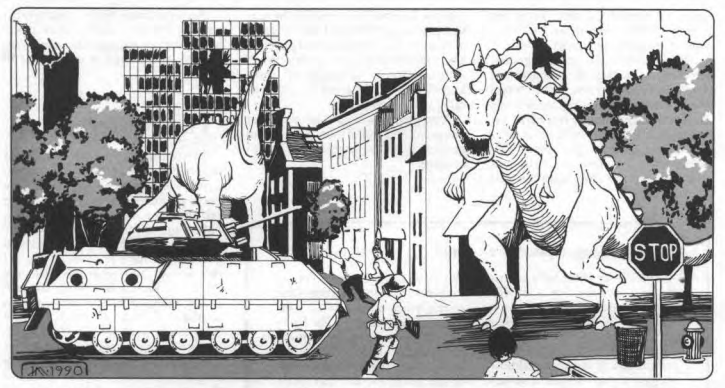
"Hey, I don't care if you're a dinosaur, no jaywalking!"
So remember before when we talked about how the southern part of Manhattan Island isn't in the pure zone? It's still a Living Land dominant zone (starting around W 23rd Street and covering everything southwards) and is now calling itself The New York Metropolitan Protectorate. The area now known as the Protectorate was where all the city's political and financial leaders were forced to retreat to during the invasion. Despite the chaos, the police force and what little National Guard presence there was managed to defend the line, and now the Protectorate is firmly dug in.
The current "mayor" of NYC is a woman whose last name is Bradshaw and was previously deputy-mayor; she's replacing the former mayor whose last name was Green, who abandoned the island early in the war. The reason I'm only giving the last names is because the book doesn't tell me their first names, and as near as I can tell these aren't based on the real mayor/deputy-mayor at the time. (The mayor of New York City was Dinkins back in 1990/91).
Well, whatever her name is, Bradshaw's overall goal is to keep what territory she can. She's smart enough to know that trying to take back the rest of Manhattan is a fool's errand, so the focus is on keeping the Protectorate safe. She's been going well outside the lines of what a mayor can legally do, but it's generally accepted that the normal "this is what the mayor is allowed to do" ideas kinda went away when the city was invaded by dinosaurs.
The Protectorate barely has enough P-rated individuals to keep things running at (and I quote) "at a level which is at least as sanitary as New York was before the invasion." Of course, overcrowding is an issue, as is keeping everyone fed. There's still an economy of sorts, although it's really more of a barter system. Payment for city services (patrolling the streets, repairing things) is done with food and supplies distributed by the mayor's office.
Greenwhich Village has actually been doing pretty well for itself, mainly because theater is the only real form of escapism or entertainment left available to the survivors. The only real source of information is the New York Times which is still operating and publishing despite the apocalypse. Even then, nobody knows what's going on outside the realm, as government forces haven't been able to penetrate that far into Kaah's territory.
The biggest hardpoint in New York is, unsurprisingly, the Statue of Liberty. Or, I should say...was the Statue of Liberty. During the first month of fighting Liberty Island was the base of operations for the National Guard and a symbol of hope for the survivors. But of course, Kaah wasn't going to have any of that crap in his backyard and sent waves of Jakatts and gospog to overwhelm the National Guard forces. Once the defenders were killed, Kaah had a kaiju-sized fifth-planting gospog destroy the statue and the hardpoint. It's believed that somewhere in the ruins of the statue is a powerful eternity shard, but since Kaah doesn't know anything about American culture he doesn't know what it would be. Just to be on the safe side, he has the giant gospog guarding the island 24/7.
Now that Lady Liberty has (literally) fallen, the largest hardpoint in Kaah's eastern territory is Philadephia. Which isn't to say it's really doing that much better than NYC.
One of the major differences between the two cities is that the Philly government is still trying to do things by the book. Whereas Mayor Bradshaw has figured out that her territory is pretty much on its own, Philadelphia has actually applied for Federal Aid.
Thing is, it's getting it. Since the whole city is a hardpoint (centered around the Constitution), it's seeing a lot of military use as a staging point since the city isn't located in a Living Land pure zone, as well as being the largest staging ground for the supply convoys . So yeah the city is getting government money, but it's mostly going to support the military operations.
Which is a problem, because Philly's starting to get overloaded with Core Earth refugees. The city's seen a 50% jump in population in just under a month, and the overcrowding and lack of basic supplies is starting to wear on the city's infrastructure. The city is able to get supplies in via boat, but getting people back out of the city the same way can't happen as fast as the refugees are coming in.
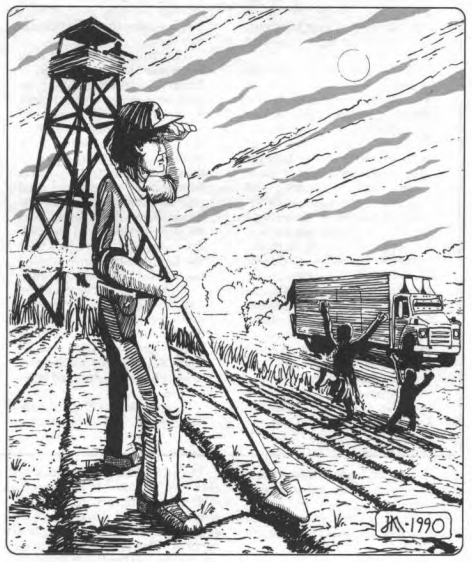
Hail to the truck farmer!
The rest of the Eastern Land is peppered with survivor colonies. Remember, unless they're in a pure zone ords will generally take months to transform, and until then most of the population of the northeast is stuck in towns and 'burbs that are surrounded by hostile jungle. Many of the colonies are small hardpoints with maybe 100 people living there, relying on supply convoys for food and news.
The thing about the survival colonies is that, for the most part, they're full of people who aren't able to leave. Even ignoring the fact that navigation through the jungles is ridiculously difficult, getting out of the Living Land would require weeks of travel through dinosaur-infested hostile territory. For ords, that's damn near impossible even if you have a few P-rated people backing you up. And even if you get out, you're probably leaving most of your possessions behind, which makes resettling pretty hard to do. And yes, there's also a lot of "ain't no lizards gonna drive me off my land" types out there, but for the most part the people in survival colonies are pretty much stuck. Some of the colonies have made tentative alliances with those Jakatts and tribes that are realizing that Kaah isn't exactly the best leader. It's a risky proposition for both sides, because neither group fully trusts the other, and many resistance and survival-focused colonies treat anyone allied with the edeinos as "traitors to humanity".
The last major topic about the Eastern Land is Detroit, which is the second-largest hardpoint after Philladephia. Unlike Philly, though, Detroit's population has actually taken a sharp decline due to people evacuating as the Living Land expanded around it from New York and Thunder Bay. Still, the city's managed to stand tough in the face of the invasion, and has sort of revitalized due to two major points.
First, being a hardpoint relatively close to the center of the Eastern Realm has made it an important center of trade between Core Earth and the various surivor colonies. Second, the city's automotive manufacturing industries have shifted focus from building cars to building big rig trucks, which are needed for the supply convoys.
The real problem that Detroit is facing is the conflict of interests in regards to the city between Baruk Kaah and the US government. Kaah, believe it or not, wants Detroit to keep functioning. Why? Because it keeps people alive in his territory, and the more people there are in his territory the more possibility energy he can siphon off them. The government, meanwhile, now knows about how reality mechanics work and wants Detroit to stop supplying colonists, forcing them to abandon their colonies and leave the Living Land, thus slowing Kaah's growth. Of course, the government can't really enforce this idea without turning the city against it, so tensions between the city and the military are strained at best.
Wow, that was a lot of words about only one of Kaah's territories, wasn't it? Don't worry; the rest of the chapter is much shorter.
In fact, The Western Land barely gets half a page all told. But really there are only two major differences between it and the Eastern Land.
First off, a noticeable percentage of the human population in the Western Land are practicing Jakatts, many of who weren't in the Living Land but emigrated there once learning about the Keta Kalles religion. This is attributed to (and I quote) "California's high population mix of cult-seekers and what have become derisively known as 'nature lovers'."
Oh, the 90's.

The other difference is that a very large number of the edeinos tribes in the region are rebelling against Kaah. Nobody's exactly sure why, although the prevailing theory is that it's because of the influx of humans who came willingly and have become Jakatts. Not every tribe has turned its back on Kaah, so inter-tribal warfare is very common.
Lastly, we have The Northern Land, the small region he siezed around Fort Providence, and where Kaah engages in some very dangerous secret experiments.
The Northern Land is a secret to all except the most loyal of Kaah's Jakatts and gotaks; not even the other High Lords know what he's doing there. And what he's doing is twisting nature and his followers into weapons.
The first of his projects involves taking gospog and infusing them with the spirituality of Keta Kalles. These creatures, called osthangs, are created by infusing gospog with the infused mystical properties of Great Slave Lake. Osthangs are beings made of water that can shift between solid, liquid, and mist forms at will. They're incredibly dangerous because not only can they shift to mist to avoid bullets then shift to a solid form strong enough to punch a tank, they're also capable of rusting metal by touching it.
The second project is the creation of Fire Warriors. Flame warriors are Jakatts who are infused with flame from a Kaah-created rift in the earth near Lac la Martre. Although I think "infused" might not be the best word; the flame is not put in the Jakatts so much as the Jakatts throw themselves into the fires and take them within themselves. This fire slowly and painfully consumes them from the inside out (which the Jakatts love, of course), and in exchange for having his life span reduced to about five weeks tops the fire warrior becomes stronger, and his very touch will burn his foes. The Jakatts know they will die, but they belive they've been specially chosen by Lanala to experience this intense sensation for her.
They are very, very wrong. What they're doing is actually the greatest sin imaginable to a follower of Lanala: committing suicide.
Both of the projects Kaah is undertaking in the Northern Land are sacrilege to Keta Kalles, and he knows it. The osthangs are technically a manufactured thing (there's a page describing the process in detail that you don't need to know about) because they're made by hand from dead bodies, and in order to become a fire warrior a Jakatt must throw away Lanala's greatest gift: life. Kaah keeps all this secret because he knows that if the Jakatts learned about the truths of these creations, they'd turn on him in a heartbeat. So he lies to his loyalists, and tells them that they've been chosen by Lanala and that they're doing all this with her blessing. So far, they're all buying it.
Of course, Kaah's confident that nobody will find out. As stated before, Kaah is overwhelmed with ego and hubris, and his experiments in the north are one of the many things that will turn around and bite him squarely in the ass in a short amount of time.
But Kaah's future will have to wait, because we're going to see how the rest of America is dealing with the invasion...
NEXT TIME: The State of the Union
State of the Union
Original SA post The storm has a name... - Let's Read TORG
Part 16d: State of the Union
So now that we've seen how things are inside the Living Land, how's the rest of North America holding up?
Well, that's where things get a bit odd.
There's an ongoing idea throughout the entire Torg line that, despite the fact that all these alternate realities have landed all over the place and overwritten large swaths of the most powerful countries in the world, life in Core Earth is pretty much going on as it always has.
Now, I get the idea that stuff gets normalized over time, and that cultures will adapt and so on. But in the Torgiverse, they treat things as if the invasion doesn't affect anything at all about most people's day-to-day lives. At one point the Cyberpapacy takes over Boston, a city which is within half a day's travel of the Living Land border, and yet international and stateside flights are still going into and out of Logan Airport. Movies are still being made in LA even though the Living Land is right there.
The book does point out that this complacency is sue to the fact that most of middle America is very far removed from what's happening, but still, see above.
quote:
Outside the realm of the Living Land, life continues in many ways as it did before the invasion. The United States of America is a besieged country, but only a third of it is dominated by the invaders. The other two thirds, while preparing for war, must also live day to day. Sporting events, plays, schools - all continue to function. For most people in the country, the invasion is far away. There is a mistaken belief that the abrupt slowing down of Baruk Kaah's progress is because the military has created a stalemate (the invasion has slowed because the stelae Baruk Kaah brought from his cosm have run out and he can only move forward as fast as new stelae are produced). The general populace believes that it is only a matter of time before the army pushes the invaders back over the land and up their bridges.
That said, there has been a serious upheaval in the US government, to the point where it's more-or-less restructured completely.
As was touched on back in the beginning of the book, President Douglas Kent and Vice President Gregory Farrel were in New York City when Kaah attacked. There's been no word from then since the invasion, and the line of succession went to the Speaker of the House, Johnathan Wells. Wells managed to keep the country together as Kaah expanded, and when it became clear that Kaah's territory would overtake Washington D.C. he moved the seat of government to Houston, Texas because it was far enough away from the Living Land that they wouldn't have to worry about an axiom wash.
Wells, sadly, didn't live past the original novel trilogy as he was assassinated by an unknown assailant (rumored for a while to be congressman Andrew Decker, who was a secondary character in the novels). The current president is the former Secretary of Defense, Dennis Quartermain, even though there should have been three other people ahead of him in the line of succession. I don't know if that's a research failure or if it was covered in the novels, but either way Quartermain has not been dealing well with the invasion as a whole. Quartermain did a decent job in his previous position, but now that he's president he's become much more conservative and paranoid. In order to help manage the resistance effort, Quartermain has assembled a think-tank-slash-task-force to deal with otherdimensional invaders: the Delphi Council.
The Dephi Council is...well, let's put it this way. What's the first image that pops into your mind when I say "shadowy government council"?
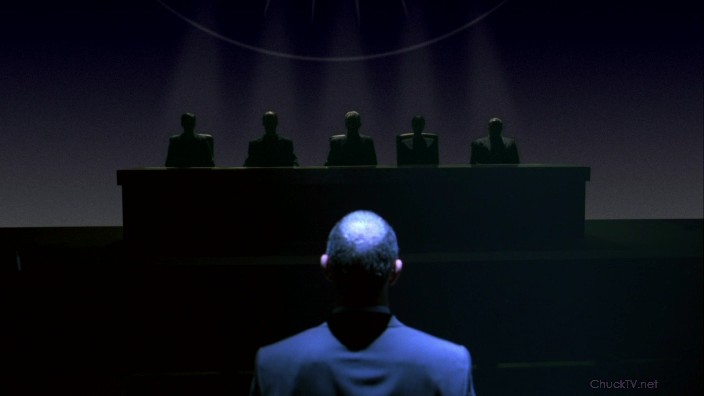
Probably something like this, right?
The Council's job is to formulate strategies and organize operations to deal with the various Possibility Raiders, Kaah in particular. Which makes sense; that's a needed function in the setting. But because the members of the Council were picked by Quartermain (who, it turns out, may not be mentally stable), they're very reactionary and paranoid. On top of that, good old-fashioned corruption exists with some of the Council members, who are trying to spin things to their financial advantage even while the country is in an extended state of emergency. Two of the Council members are tied to two of the nation's largest munitions manufacturers, and they're already directing cash towards "Doling Aircraft" and "General Automations" to develop weapons that can work in the Living Land.
Uh huh.
The Council employs vetted mercenaries code-named Spartans to perform operations in the Living Land. The Spartans' primary task is to get civilians out of the Living Land...one way or another.
See, the Council has learned about how reality mechanics work by interrogating captured Jakatts. So now the government understands that the High Lords are gaining power by draining Possibility energy from ords. Therefore, logically, if the Council can get people out of the Living Land, that'll reduce Kaah's overall strength, right? So the Spartans' main task is to find survivor colonies and get them out of the Living Land via military escort.
And if the survivors don't want to leave, the Spartans have full authorization to kill them. As far as the Council is concerned, it's just a matter of expediency.
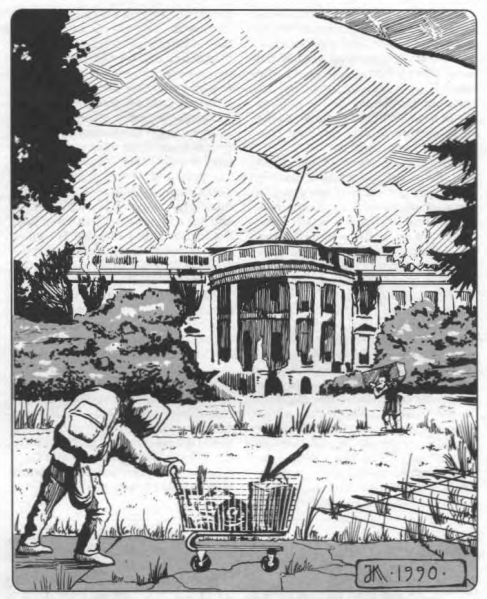
Of course, what's considered "expedient" tends to vary between the Council and the Spartans; some Spartan units will just flat-out kill survivors without giving them a chance to leave on their own if they're in the right mood.
Further complicating matters is the rise of human Jakatts. Yes, some of the humans who've converted to Keta Kalles have done so involuntarily when they transformed, but just as many (if not more) have converted willingly. In some ways, this is seen as "betraying their country" since they're embracing the religion of the invaders, but it's becoming clearer that not all followers of Keta Kalles follow Baruk Kaah. The government hasn't quite figured out how to deal with the whole situation yet, because it falls under the aegis of religious freedom.
That is a really amazing analogy to something that's been going on for years here in the year of our Lord 2017, especially since it was written in 1990.
quote:
Legal experts secretly questioned on the issue have stated categorically that it would be horrific to classify a citizen as a traitor to his country because of a religious preference.
Now, obviously, this is a very tricky situation for the government to navigate, and the Delphi Council has decided to deal with this moral and legal minefield by completely ignoring it.
quote:
In a special report to the President on the matter, the Council advised that for the duration of the war all Jakatts, no matter what species, be defined as the enemy. "Even if they don't all look alike," said Senator Jesse Bows, "they all think alike, which is even worse. If they wish to worship a heathen god, they have taken the responsibility of their deaths upon themselves."
This all came to a head when an infantry division was sent to wipe out a pacifist tribe of human Jakatts outside Fresno.
quote:
The tribe had made it clear that as civilians they had not sided with he invaders in any capacity. The Council heard about the tribe and decided that it would have to be destroyed. before word of pacifist Jakatts got out and generated sympathy among the American populace. "The last thing we want," declared Colonel Stan East, "is another Viet Nam."
The soldiers arrived and began attacking. A brief battle ensued and most of the tribe escaped. Neither side suffered heavy casualties, but the die was cast. The tribe threw its lot in with the High Lord, who had left them alone in peace.
Needless to say, the US military is not having a good time of things right now. In addition to a cavalcade of questionable orders coming from on high, they have to deal with the fact that (since most of the military are ords) that every piece of equipment they have down to and including survival knives don't operate under Living Land axioms. To make things even worse, there's the aforementioned problems with the much lower social axiom that result in tactical planning breaking down on a regular basis. As a result of all this, the Pentagon has decided to cease sending armed troops into the Living Land.
As the military shifts into a more defensive position, the Pentagon is attempting to figure out a way to get Core Earth technology (or at least weapons) to work in the Living Land. But since this book takes place right at the start of the game line (and therefore at the "start" of the Torg timeline), nobody on Core Earth knows how reality mechanics work yet. Since concepts like axiom levels aren't widely known yet, nobody's sure why everything keeps breaking down in the Living Land.
quote:
Several theories have been been put forward which range from extrapolations of present day science (called "the reasonable theories") to quite absurd theories, created only because the situation at hand is, really, quite absurd (these theories are called the "crackpot theories.") Because times are strange, "crackpot theories" are considered with equal weight against the "reasonable theories." The names are only given to categorize the two types of theory, and are not meant to suggest one is superior over the other.
Well anyway, working theories about why things don't work in the Living Land include the idea that the invaders are hypnotizing people to believe their stuff won't work, that the invaders are ghosts of dead aliens who visited earth millions of years ago, and bloody quantum.
Of course, the reason things work differently outside Core Earth is because of axiom levels and such. The book actually spends a paragraph explaining this, as if we hadn't already read the core set and know that.
The biggest problem with these theories is that people are spending a lot of money and manpower to solve an unfixable problem. Companies are pumping money from the government to solve the whole "make stuff that works in the Living Land" problem. There have been successful technology tests in the realm, but that's because the people working the tests were P-rated. The companies (and the Council) are slowly starting to figure out the whole Storm Knights thing, but haven't put all the pieces together yet.
Further complicating matters are the Common Ground Association. The CGA is a recently formed grassroots movement based around the idea that not all the edeinos are working with Kaah, and that Keta Kalles is just another religion and therefore has protections under US law. Needless to say, the CGA has not exactly been embraced by the populace, and especially not by that portion of the populace who were hit hardest by the invasion.
quote:
The above-the-board operation is centered at CGA's headquarters in downtown Houston, where the group works busily on lobbying for their cause. The offices have already been bombed once (at night; no one was hurt). and there is no doubt further attacks will continue. Throughout the nation the organization is publicly present in the form of its members traveling door to door to get signatures to support their goals. Obviously the canvassers travel in groups, but even this has not prevented several volunteers from being attacked by zealously "loyal" Americans.
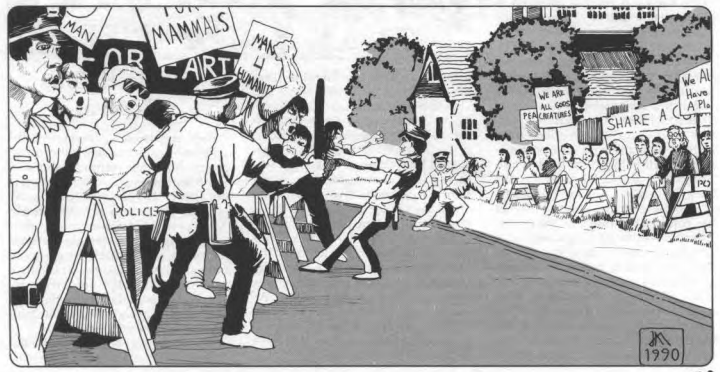
Not relevant at all to modern America.
A side-effect of the invasion on American life is that it's created a very strong religious revival, particularly of fundamentalist religion. The realization that the edeinos can gain power from their "alien god" has prompted a resurgence in faith, as people start to wonder "hey, if that god's real..." Unsurprisingly, most fundamentalist sects paint the edeinos as demons and Lanala as Satan; not that hard, given that (when you get right down to it) Keta Kalles is a pretty hedonistic and violent religion. Not helping matters are the humans who've converted to Keta Kalles, either involuntarily (and are acting as undercover agents for Kaah) or willingly (and are therefore "siding with the enemy").
One example of the problems this is causing is the case of Reverend Arnold Butcher, who broadcasts nationwide from North Carolina. The Reverend Butcher is a staunch anti-Keta Kalles zealot, and gives people hope by telling how he and his followers are strong enough in their faith that they've pushed back Jakatt forces.
This is a complete lie. Reverend Butcher is a total hypocrite who's incapable of performing miracles, but doesn't let that get in the way of accepting donations from across the nation. What's more, the Council has begun funneling money towards him to keep him on the air, giving people false hope that good ol' Murican faith can keep the invading reality at bay.
But that's not all! Along the eastern border of the Western Land (from Idaho down to Nevada), things are beginning to get a little Max Max-y. This region (referred to as The Borderlands has a lot of fighting between the Jakatts and human suriviors.
quote:
The
area is now populated by an amalgamation of refugees from Washington, Oregon,and California and transplants from Montana, Wyoming, Colorado, Arizona and New Mexico all looking for a good fight. In the eyes of some the North American continent has a frontier to conquer once again, and the opportunity to win it should not be passed up.
"War towns," reminiscent of the mining towns of the last century, have sprung up and down the length of the Borderlands. Instead of picks and pans to search for gold, the towns sell weapons ranging from composite bows to black market personal rocket launchers. Buildings that were already standing have been rented or bought at cheap prices from those in a hurry to leave the approaching Jakatt invasion. Around these buildings shacks, tents and a few fortress-like structures have been built.
This is an oddly prescient book, isn't it?
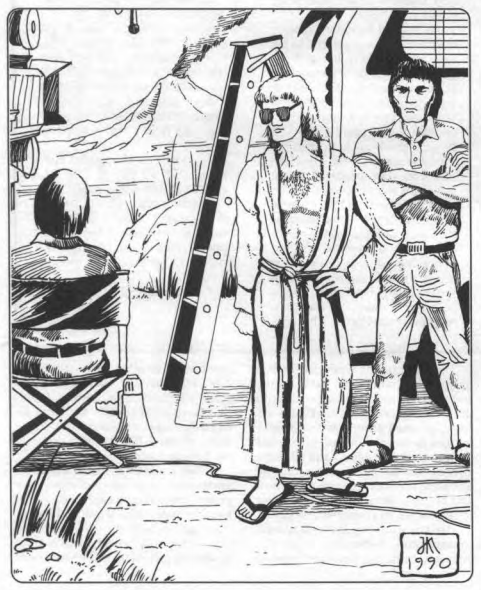
Alright, alright, alright.
Meanwhile, Los Angeles is more or less abandoned due to the proximity of the axiom border; most of the inhabitants headed east in case the Living Land overran California. In fact, most of the show biz people moved to Florida, making that the center of the US's movie industry. Between that and the fact that the Living Land is less than a day away, the city's fallen on hard times and is damn near a ghost town. The city government is still in power, but a large chunk of the city is without basic utilities like electricity. Squatters are common now, and tend to shack up in the formerly upscale parts of the city.
And that's pretty much it for LA!
That said, we now move to Show Biz During the Possibility Wars because that's a thing we need to learn about. While the film industry has (somehow) completely uprooted itself and moved to Florida, it's still going to be a while before film production can get settled in enough to really start putting things out at the old speed again. Cinemas are getting a resurgence due to people's need for entertainment and escapism during wartime, but due to the relocation cinemas are showing popular movies from the 80's and established classics.
In fact, newsreels are starting to make a comeback as well, showing news and combat from the Living Land itself. The film and television companies are trying to take advantage of the public's interest, and have begun paying expedition forces to bring cameramen along with them on raids or supply runs. Of course, things will be heavily edited to make them "family appropriate", but still there's a booming industry in Living Land video footage.
Another growth industry is academia, particularly in regards to researching the Living Land. Anthropologists, biologists, and zoologists are having a fucking field day with the Living Land and self-funded expeditions into that territory aren't that uncommon. I mean, yes it takes a lot of bravery (or stupidity) for someone without combat training to willingly enter such hostile territory for extended periods of time, but the opportunities for learning are amazing.
Of course, so are the opportunities for getting eaten by a dinosaur, so those academics who wish to hold expeditions need to go to the government or private corporations in order to get cash and trained personnel. The various scientists have been in contact with the Jakatts and have learned much about the Living Land from them; remember, the Jakatts don't bear humans any ill will, they just follow Kaah's orders. The Council isn't too happy about the idea of people learning that the Jakatts aren't just evil homicidal monsters, so they have a very tight control over what information comes out of the realm and have a tendency to alter studies to fit the image they're trying to project to the world about Kaah's forces (i.e., that they're inhuman monsters who want to kill all the humans and each other). Unscrupulous researchers have begin spinning their findings in this direction in order to get more Council money.
By the way, I just want to point out how much I'm compressing the text in this book. This section on academic interest in the Living Land is just over a page long once you pare out the almost-full-page boxed text about a sample guy you can work for, but most of that text is just...noise. Like, do I really need to be told the difference between a "closed expedition" and an "open-ended expedition"? Or, at least, did I really need two paragraphs on the difference?
I know saying that Torg's over-writing is pretty much redundant at this point, but it comes into stark relief in the next section: Spreading the Tales of Good Deeds. Why? Because it's a page and a half about how to restore Possibility energy to ords via tales of fighting back against the High Lords.
quote:
Here's where the Storm Knights come in. They are the heroes of Earth who people can identify with quickly. They are the individuals, like Odysseus and Robin Hood, that tales are told about for years and years. It is the job of the Storm Knights to do heroic deeds so that people can hear the stories, remember the possibilities that exist within the human race, and thus become full once again with possibility energy. When an entire area's population has become full of possibility energy once again then, and only then, can the stelae bounding it be removed safely.
And I realize that now is not the time for me to bring this up (halfway through the core set of realm sourcebooks), but despite the whole fight-back-the-High-Lords-and-remove-the-realms idea that's presented as a focus of the game, that whole thing really doesn't come up in the books or adventures. Sure, sometimes you have to stop one of the High Lords from planting a new stelae and expanding their territory, nobody except for Kaah really loses territory in canon. If anything, they keep expanding because the High Lords can just drop more bridges wherever they want so taking back territory is a bit of a moot point. Hell, throughout the whole game line, every single invading reality except for Aysle ends up landing on North America anyway.
Sorry, got a bit tangential there.
This section also mentions that the PCs should be "doing heroic deeds" as they go looking for eternity shards or whatever. I just find this adorable because being heroes and doing heroic things is kinda the point of an RPG like this.
But anyway, we're finally done learning about what the States are like, so it's time to turn our attention to Core Earth Canada!
For four pages. One of which is almost a full-page NPC stat block and description. Oh, and another almost-page of artwork.
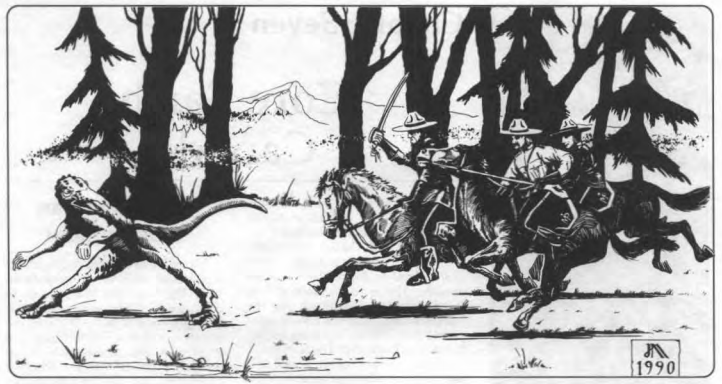
I know I should be making a "take off, eh?" joke, but all I can think of is "Yakkety Sax".
Canada hasn't been hit anywhere near as bad as the States, but that doesn't mean that Canada's having a better time of things. In fact, the Canadian army is split three ways, keeping a perimeter around the Northern Land and trying to keep Kaah from expanding further north.
The Canadian parliament barely had time to adjust to the invasion before Ottawa was overrun by an attacking force of Jakatts and gospog, resulting in the majority of the members of parliament being captured and/or killed. In the aftermath, the various provinces scrambled to self-govern until a new parliament could be elected.
The center of government was moved to Regina, mainly because it's far away from Kaah's territory. Fortunately, the military managed to keep things together in the interim, managing relief efforts and protecting refugees. Unfortunately, supplies are starting to run low, and Canada's normal allies are all dealing with their own invasions. In the early months of the invasion, nobody was able to help anyone else.
But don't worry! The fine people of Japan and the Kanawa Corporation are providing humanitarian aid, arms, and technology to help fight Baruk Kaah's forces. What nice people!
In addition, Cyberpope Malraux has sent representatives to negotiate an alliance with Quebec. Now, unlike Kanawa and 3327, everybody knows that Malraux is the evil overlord of the reality that has taken over France. So why is Canada entertaining an alliance? Two reasons:
quote:
First, the province is primarily of French decent and of the Catholic faith. Although Quebec has not shirked its responsibility in providing resources for the nation, if the country should fall they would be perfectly willing to throw in their lot with a powerful ally who apparently is attempting to put France back in the position of world power it once possessed.
Secondly, the antipope is offering the people of Quebec something they can hardly refuse given the course of the invasion so far. He is himself a High Lord, a creature of equal power to Baruk Kaah. He can offer the people of Quebec technology and religious power far beyond what is available to them with Earth's axioms. Given the choice between being conquered by the barbaric religion and primitive technology of Baruk Kaah's reality or allying with the theocracy and wondrous toys of Jean Malraux, the populace of Quebec would most probably prefer the latter.
Anyway (I say that a lot, don't I?), Canada's also having trouble with refugees and overcrowding. Montreal, Quebec, Ontario, and other cities near Kaah's territory have been evacuated and turned into military posts, and the population has been moved north for lack of anywhere better to put them. Meanwhile, fighting continues around Alberta due to its proximity to the Northern Land. Kaah keeps sending forces out from there not so much to take territory as to keep the Canadian military occupied and not paying too much attention to what's happening deep inside the Northern Land. On top of that, the whole "Borderlands" thing that's happening Stateside is happening here too, with people trying to claim territory around the borders of the stelae zones.
And with that, we finish the fluff half of the book.
And again, I'm not mad at all this. Yeah, it could be presented better, but there's enough stuff here to give GMs ideas on what you can have PCs do in the realm.
Of course, none of that is used later in the game line. God, such a waste...
NEXT TIME: Finally! A use for the Direction Sense skill!
Obfuscating mechanics
Original SA post The storm has a name... - Let's Read TORG
Part 16e: Obfuscating mechanics
Pretty much everything in the book has been fluff up to this point, so now it's time to get into the crunch.
The general rules chapter kicks off with a description of the Living Land's axioms. As always I brought these up in the first post for the book, so let's revisit.
Evil Mastermind posted:
Magic axiom: 0 Magic simply does not exist in the Living Land. Period. Any use of magic at all is a contradiction. It's interesting to note that this is the only reality that has an axiom level of 0 in anything.
Social axiom: 7 The most complex social unit in the Living Land, and in fact the central social unit, is the tribe. In fact, the needs of the tribe will override the needs of your immediate family. The Living Land is a very dangerous place with a high mortality rate, so people think in terms of protecting the clan as a whole rather than just one family in the clan. The low social axiom is also the reason for Kaah's dedication to swarm tactics and why the US military had such a difficult time fighting back: the concept of a military structure doesn't exist at this level. The idea that your small group has to follow the orders of that one guy, who in turn is part of a different group who has to follow the orders of a third guy, and so on up the command chain, is impossible at this axiom level. The standard edeinos battle strategy is to basically just have everyone rush and work yourself into a frenzy, and the human soldiers couldn't adapt in time.
Spiritual axiom: 24 The Living Land has the highest Spiritual axiom out of every invading reality. The religion of Keta Kalles pervades every aspect of edeinos society, and the high axiom level means that most of them are capable of performing miracles even if they're not Jakatts.
Technological: 7 This...is where we hit a bit of a problem.
I talked about this before, but the Tech axiom doesn't line up with the way the Living Land is presented. This is what's possible at Tech axiom 7 according to the Revised Edition core rulebook:
However, as we've already seen, none of these things can exist in edeinos society. Metal is a dead thing, so that's out, which cuts off most basic tool use. Likewise, they wouldn't live in a brick house because (again) that's a dead thing. At best the tech level should be 1 ("Natural objects such as rocks and sticks may be used as very simple tools. Fire can be domesticated but not created."), but I guess the writers didn't want to have a realm with two really low axioms.quote:
Metal is first smelted, tools may be made from first copper and then later from alloys like bronze. Metal hand axes and daggers are state of the art weapons.
Bows are possible, but only with enough punch for small game. Potter’s wheel appears, plow speeds agriculture. Glass, cloth, wine, beer invented. Seaworthy ships are possible but still musclepowered. Oil lamps invented. Kiln-fired bricks used in buildings.
Now we come to what are, in a manner of speaking, the Living Land's World Laws.
I mentioned this before, but when the game line started not every reality had World Laws. In the core set, only the Nile Empire and Nippon Tech had Laws, and everyone else got them in their respective books.
Except for the Living Land, since it was the first realm book and was released before they started giving everyone World Laws. Instead, it had some new mechanics for overall effects that permeated the realm. When the Revised Corebook came out, these were listed as World Laws even though that's not what they are. Regardless, next up are the new realm-specific mechanics.
First is the Deep Mist and the Compass Curse, which I admit sounds like a bad Harry Potter ripoff.
The Deep Mist is the thick smoky fog that permeates the Living Land and all of Takta Ker, apparently created by Kaah a few months after the invasion and brought down from the cosm question mark? It's not presented very well and I don't get why it needs to be Kaah's creation rather than a natural effect of the world, but whatever.
The Mist has a number of effects on the realm. The first is that it sort of overwrites the weather patters inside the realm. Because of the mist, the Living Land is always humid and warm regardless of the time of year or the weather outside the axiom zone. Of course, this environment is perfectly fine for the edeinos, but for humans it's a bit of a hassle.
Under a clear sky, the Deep Mist reduces visibility to 30 meters, and if it's overcast then you can only see about 20 meters out. Either way, detailed vision is cut off at 10 meters; past that you're just seeing silhouettes. At night, you can only out see out to 10 meters max regardless of light source. These effects apply to everyone, human and edeinos alike. The edeinos do have access to miracles that can allow them to see through the mists, though.
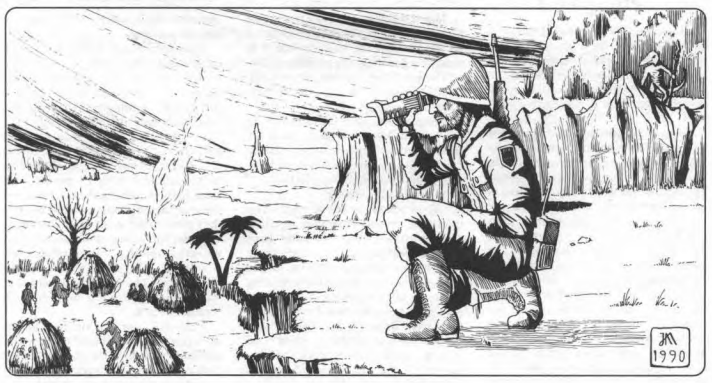
Tunnel vision is always a problem regardless of draw distance.
The light diffusion of the Mist makes navigation via celestial objects very difficult. Because the Mist extends up about a mile, it's almost impossible to navigate by celestial means. In the daytime the sun's light is so diffused all you can really tell is if it's rising or setting, and at night it's damn near impossible to see the stars or the position of the moon.
The second major effect of the Mists is the "compass curse", which is an effect that Kaah recently built into the Mist via the use of his Darkness Device.
quote:
The effect of the miracle is that any navigational device that depends on the magnetic poles to determine direction will notwork. The object itself is not affected, but the flow of Earth's magnetic fields through the area bounded by Living Land stelae is. The miracle takes the flow of the magnetic fields and randomly twists them around.
In this way, a possibility-rated character cannot "activate" his compass, for it has never stopped working. The compass simply responds to the random fluxes of the magnetic field, "correctly" finding north in one direction, and then in another.
That's right. A decade before Third Edition D&D, Torg had direction sense skill.
Direction sense is based off Perception and is "developed by a character over a long period of time." It's used in Torg's equivalent of an overland travel system. The way the whole thing works is that the GM sets a travel time from where the PCs are to where they want to go. Then as the PCs travel, the GM makes a secret direction sense roll for them every 15 minutes using one of the character's skill rank. The difficultly of the roll starts at 6, but gets modified based on the following chart:

The GM then compares the result to another chart to see how on-course they are and specifically what he tells the players.
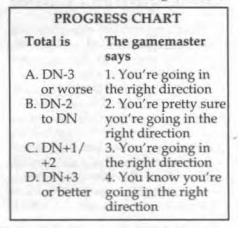
If the PCs want to boost the skill roll, they have to spend Possibilities or play cards blind because that's fun.
Anyway, unless the roll is made by 3 or more, then the group is "defined as lost" and they need to try to get back on track by continuing to make rolls and hoping for a C or D result on the second chart there for each flubbed roll that got them lost (a.k.a. the "wander around until we figure it out" method). On the plus side, if they're retracing their steps then they get the -3 to the difficulty. So if the were lost for four failed rolls, they'd need to succeed at four rolls to get back on track.
Which is an interesting idea, I guess, but it feels like it wouldn't work well in practice. Apart from the kind of mother-may-I blind rolling, there's a problem of time. To wit, you have to make navigation rolls every 15 minutes of travel time. Okay, fine. But what if you're trying to get somewhere that's two hours away? Three hours? What happens if people keep tanking rolls? The book does tell the GM that they can throw encounters in the mix for people to stumble over, but at the end of the day it's a "keep rolling until you figure it out" thing.
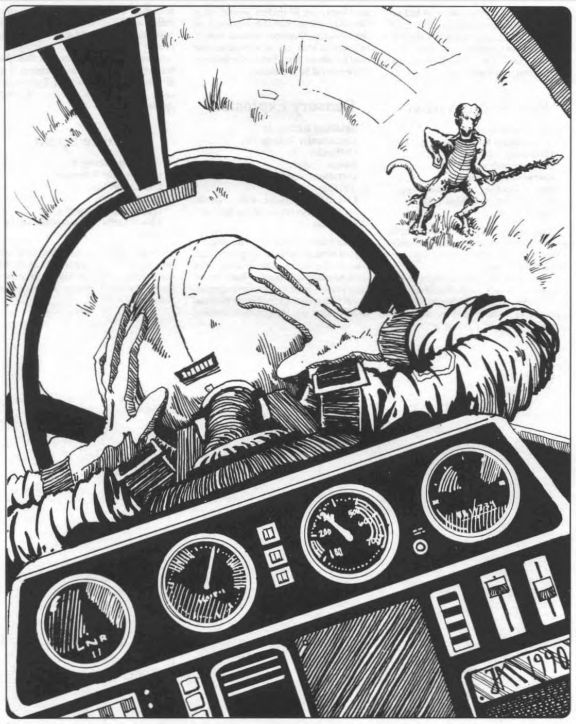
Not really relevant, but funny.
The second "World Law" is Lanala's Love of Life, which is also tied to the Deep Mist. In the Living Land, when something organic dies, it rots incredibly quickly. It doesn't matter what it was; a creature, a person, an apple falling off a tree, once it's cut off from its source of life it will begin to decompose immediately, completely rotting away within 24 hours. Edible substances will only provide nourishment for about the first third of whatever its lifespan it.
If something dead in the realm has been sealed in an airtight container (like canned goods left in the ruins of a supermarket), then it will begin to rot when exposed to the Mist. The longer the item has been "dead", the faster the decomposition. Basically, for every day since it was killed, the time it takes the item to decay triples. So if you prepare some food, and bring it into the Living Land three days later, it'll rot completely in a little under an hour.
Note that food and such will only be affected once "exposed" to the Mist. Stuff that's in cans or vacuum-sealed won't begin to rot until the seal is broken and the stuff inside is exposed to air. Unfortunately, anything that's been prepared over a week ago will rot in 18 seconds, so it's not exactly practical.
It turns out that completely artificial foodstuffs (like soda and junk food) aren't affected by the Mists, but obviously you can't live on them. At least, you can't live on them for long. On top of that, food brought in from outside the realm doesn't seem to be affected by the Mist, which has caused a booming business in what's called "realm running": freelance truckers and transporters who bring news and supplies to survivor colonies. It's a very risky job, but it pays really well.
Since food can't be stockpiled if you're not getting it from realm runners, survival is very much a day-to-day affair. It's not uncommon for colonies on the major realm runner routes to stockpile canned goods as emergency supplies and use hunting as their primary food source. In order to keep this interesting, the survival skill gets a few modifications in the Living Land.
The basic way the survival skill works is that when you're searching for food and water, you make a roll with a difficulty based on the type of environment you're in. If you make the roll, you forage enough supplies to get you through at least one day before you have to make another check; the more you beat the difficulty by, the longer you can go before making your next roll. If you fail the survival roll, then you take a wound due to lack of food and water and make a new survival roll the next day. Easy enough.
In the Living Land, the difficulty of the survival roll is 10 if you have rations available, otherwise it's 12. For reference, "high mountains" are difficulty 8, and "desert" is difficulty 12. Higher rolls still earn you however many days of supplies, but you can share those supplies with other characters who've failed the rolls to "give them your days", as it were. So if I make the survival roll and get two day's worth of food, then someone else tanks the roll and would take a wound, I can give them my extra day and they're fine.
But here's the thing. Passed survival rolls assume that the characters are foraging small bits of food as they go; berries, small game, things like that. As soon as someone fails their survival roll and takes a wound, then it's assumed that the group is running low on food: for each day after the first that someone takes damage due to starvation, the difficulty of everyone's survival checks from that point on goes up by 2. The only way to reset this modifier is to spend a whole day hunting big game.
And of course since this is Torg, we have rules for hunting and setting traps. Hunting something involves making Perception rolls at a difficulty of 8 to get on the track of something. Once you've got a lead on some big game, from there it's just making tracking rolls to hunt it down.
Trapping big game is a little different; each trap you want to make requires two and a half hours to dig a pit or whatever, then everyone who made a trap makes a survival roll. The better the roll, the more people are fed by the trapped game. Admittedly I'm not an outdoorsman, but I don't think that's how trapping game works.
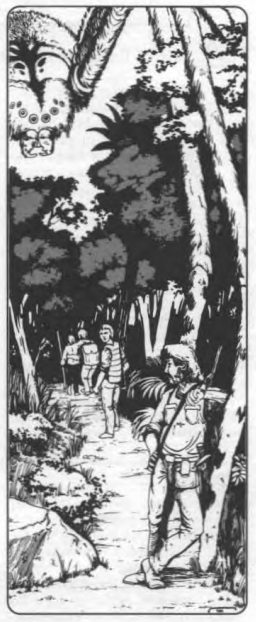
Sometimes, everyone tanks their tracking roll.
The third "World Law" isn't really named until the Revised corebook, where it's called Law of Lost Valuables, and is really just a way for the GM to fuck with characters. Basically all this means is that living beings will be separated from their non-living possessions. Why? Who knows? Examples of ways things can get lost that are given are having your camp being attacked in the middle of the night, your vehicle crashing, or the giant lizard you're fighting slashing your backpack open with its claw.
The way this works is that every time there's a chance someone might lose something, the character makes a difficulty 12 Mind roll. Success means that they realize that they're about to lose an item and thus have a chance to grab it before it's lost.
quote:
The gamemaster is under no obligation to remind the players that their characters are about to lose something important. Only if a player mentions it does a character have a chance to make the roll. The player must declare what his character is trying to rescue. Another player might try for the same object, to increase the chances of recovery ,or grab for another object. After all the rolls have been made, if there is anything left that could be destroyed that matters to the group, or if an item was temporarily forgotten about (i.e., the Mind roll was failed) the gamemaster should determine a way to get rid of it.
The gamemaster should have fun inventing new ways of removing objects of value from the player characters, leaving enough material so that the heroes can survive, but taking enough to make things tense. This is one of the prices to be paid for entering a savage land.
https://www.youtube.com/watch?v=bKy6BtAbTU8
Anyway, two more sections to this chapter. The first (and shorter of the two) is about Eternity Shards in the Living Land, and they come in two general types.
The first type are the shards native to Core Earth. Because Kaah has spread his territory around one of the major cultural centers of the United States, there are a lot of shards in the Eastern Land. Things like the Declaration of Independence have maintained Core Earth axioms and have gained strength from people's believe. On top of that, the are places like the Smithsonian and the Metropolitan Museum of Art that have scores of artifacts that are tied to the world in general, not just American culture.
As for Living Land shards...these are a bit different than the shards from other worlds. Due to the nature of the Living Land, eternity shards are actually living things. There are some incredibly rare species of plants that are naturally occurring eternity shards. Even the rumor of one of these existing is enough for Kaah to send out an expedition to claim it.
All that said, there's maybe only about a dozen eternity shards all told throughout North America. Of course, none of them are detailed at all.
The chapter closes out with an in-depth discussion of the Living Land's low social axiom, which is actually nice because more than any other realm in the game, it's hard for people like us to really "get" the Living Land's social limits affect things.
The thing to remember is that the low social axiom doesn't make people stupid, which I suppose is how a lot of people would view it. What the axiom effects is peoples' ability to understand the ways we communicate with each other or the concept of a social group outside your immediate peers.
quote:
Here's a brief recap of some major concepts no longer available to someone from Core Earth living under the Living Land's pure axioms: economic concepts such as capitalism and communism, federal governments, nation states, arbitrary systems of time (such as minutes and hours), renting of property, news services, libraries, money, arithmetic counting, kings.
Like time. The edeinos don't really have a concept of measuring time outside side of a day/night cycle. This can be a problem when a Core Earther is, say, waiting to do something at a specific time. He won't forget what his watch is, necessarily, but he won't understand what it's measuring. So he wouldn't be able to do something in, say, "15 minutes from now" or "at 5:32 pm" because those are artificial social constructs he wouldn't understand anymore. He'll get ideas like "at sunset" because that's an observable concept, but beyond that he wouldn't understand what his watch is doing.
Likewise, the Core Earth concept of government doesn't work in the Living Land either. To the edeinos, there's your tribe, there's other tribes, and you're all doing your own things. And while each tribe will have a "chief" and maybe a senior Jakatt, they don't have the concept of a tiered command structure, or how their chief is answerable to a more important chief five tribes "up the chain". At most they all answer to Kaah, but even then it's a direct leadership role.
Now, that stuff all applies mainly in pure zones, because those are the places where ords transform quickly and P-rated characters have to create reality bubbles. In a Living Land dominant zone, people can keep their original axioms in mind, but the ideas will get fuzzy around the edges.
Take the concept of money and trade, for instance. Someone in a dominant Living Land zone would understand the concept of trade well enough ("if you give me your food, I'll give you this weapon"), but would have trouble with the related concept of buying something with money ("if you give me your food, I'll give you $50"). Basic trade works on a simple principle of equivalency, but once currency enters the picture, you run into a problem: currency doesn't really work without the idea of government backing. A person in the Living Land wouldn't accept money because there's nothing to spend it on, but because they don't get why you're insisting these green paper rectangles have any inherent value.
And while PCs can overcome having their ideas limited by the low social axiom, ords don't have that luxury. Which can cause all kinds of fun problems with trying to get NPCs to understand things like "we're here from the US government to help you" or "give us ten minutes, then make a run for it."
Amazingly, the GM is told to not use the low social axiom as a blunt instrument against PCs. Instead, you're supposed to keep it light. Dealing with survival colonies should be more about funny misunderstandings than getting screwed over, or when the players are planning a big coordinated attack reminding them "what's a minute again?"
quote:
Remember that in the world of Torg, Earth has been invaded by competing realities. Part of what fighting this war means is that when you go into conquered territory you start playing by the bad guys' rules. It's weird, but that's the Possibility Wars for you.
NEXT TIME: Praise be to Lanala
The myriad gifts of Lanala
Original SA post The storm has a name... - Let's Read TORG
Part 16f: The myriad gifts of Lanala
The next chapter is the list of miracles available to followers of Lanala, and as you can imagine there's quite a few of them.
The book goes into a little detail about how the Jakatts operate and what their role is in edeinos society, but really it's nothing we haven't covered already.
Oh, by the way, I should point out that here on page 72 of 130 is where the term "Saar" is finally defined: it just means "chief above all chiefs". I mean, I pretty much got that through context, but they still should have defined that much earlier. It's worth pointing out, though, that the title of "Saar" didn't exist until Kaah became High Lord and made it up for himself.
Unlike a lot of other miracles, the ones listed in this book are only available to followers of Keta Kalles. But before I start listing them out in order, I'm going to call out one particular miracle because it's pretty important.
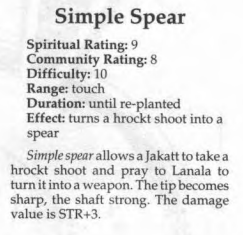
People have asked before how edeinos use weapons if they can't use dead things. Well, this is how. Hrockt shoots are stiff tree-ish plants that grow to about three feet tall and tend to be a few inches thick. When this miracle is cast on one (usual as part of a ritual rather than on the fly), then the shoot can be uprooted, used as a spear, and then replanted without the plant dying. Once it's replanted, the hrockt shoot will take root once again and continue growing.
So as always, let's hit the highlights.
Animal rage is a ritual that involves finding and enraging an animal. Once you've done that, you touch it and draw the animal's rage into yourself for up to 24 hours. You can then use the "charge" to give yourself a combat boost. You also get +3 to be hit and +3 "to be damaged" (which I guess means +3 to damage results?) due to being berzerk.
Blossom Spears is mostly the same as simple spear except it causes the hrockt shoot to grow thorns. The thorns will infict an extra wound of damage on the spear's first hit as the thorns break off and stick in the enemy, although if the person wielding the spear makes a medicine roll they can pull the spear out without losing the thorns.
Earth's Ear lets the Jakatt prepare a circle of land three meters across so that he will recieve a warning when an enemy passes within a certain distance (based on the success of the roll) around the three meter circle. This is done by having all the leaves, flowers, and plants in the circle listen for intruders, then crying out to warn the Jakatt.
Make Stelae does what it says on the label, but is only used by gotaks since it involves the ritual mutilation and preparation of corpses. Said corpses need to be ritually sacrificed, and the gotaks tend to use captured Core Earthers for this.
Reverse Emotions also does what it says. It doesn't create emotion (you can't make someone calm feel jealousy), but it could turn love to hate. The downside is that the caster has no control over what the target does after the miracle takes effect.
quote:
An enraged man about to kill an edeinos who is successfully influenced by reverse emotion might let the lizard go out of happiness, or enjoy killing the lizard. Only the emotions are influenced, not the actions.
Sensory Explosion is either a blessing or a curse, depending on who's on the recieving end. For Jakatts, it's a way to take in all the sensations of their surroundings as part of a meditation on Lanala. For people who didn't expect it, though, it's a bit rough to have all your senses turned up to 11: the miricle inflicts up to a -5 penaluty to all actions for the duration of the miracle.
There are also individiual miracles for increasing each one of the senses, as well as boosting the three physical stats.
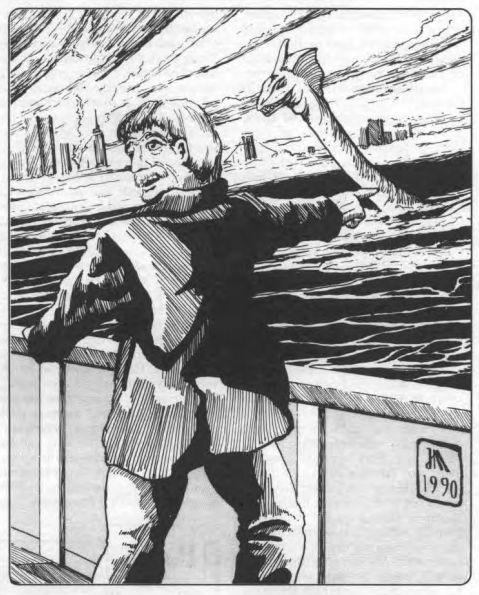
"Hey, that thing doesn't have a stat block!"
And now that that's out of the way, let's start talking about the Folk and Creatures of the Living Land.
The Living Land is populated with a very...biodiverse range of beings. There are other intelligent races that Kaah has conquered and converted to Keta Kalles, and there's all the weird-ass beasts from multiple worlds now occupying the jungles. The whole place is pretty much a kaiju-palooza, and it would have been nice if the book had some more pictured of these things.
Anywho, let's get to it. I'm listing all of them because they're a pretty eclectic bunch. Plus the names are all funny.
Unfortunately, this is just going to be a big ol' list of names, because with like three exceptions none of these creatures have any illustrations. Which is something you kinda need when you're introducing 20+ new critters.
Abentallos are 10-meter long giant-ass snakes with meter-wide mouths. They tend to lay in wait under the foliage in the barer parts of the Living Land because they have a hard time getting around trees.
Baragons are basically reptilian bears, over 20 feet tall with giant claws and thick scaly hides. They feed on dinosaurs, which they are more than capable of taking down so yikes. Sadly, they cannot shoot beams of fire out of their mouths.
Bedotoks are a sphere-shaped unintelligent creature from the stalenger's homeworld. They're basically glowing, floating bags of gas, unable to move under their own power. Only really notable because their natural defense against predators is to expel a cloud of poison gas.
Benthe are small, amoeba-like beings that feed off of, and can manipulate, pheremones. They're also intelligent, and are ardent followers of Keta Kalles. This means that they have Jakatts, and are capabale of performing miracles. On top of that, they can also sense emotions and generate pheremones to manipulate enemies. The main use for Benthe by the edeinos is to control the beasts of the Living Land. Bentre reproduce via mitosis.
quote:
Because of this natural ability, if a benthe is attacked and damaged, for each level of wound received after the first wound, a new benthe is formed. The new benthe divide the damage received among their siblings. For example, if a benthe were hit for two wounds in a single round, it would become two benthe and each of these would only suffer one wound each. If a benthe suffers enough damage to kill it in a single round, then itdies and no new benthe are formed. Each new benthe formed by violent separation receive the original's attribute and skill points at -2. A benthe cannot divide below Toughness 0. So, a benthe with faith 14 would form two benthe, each with faith 12.
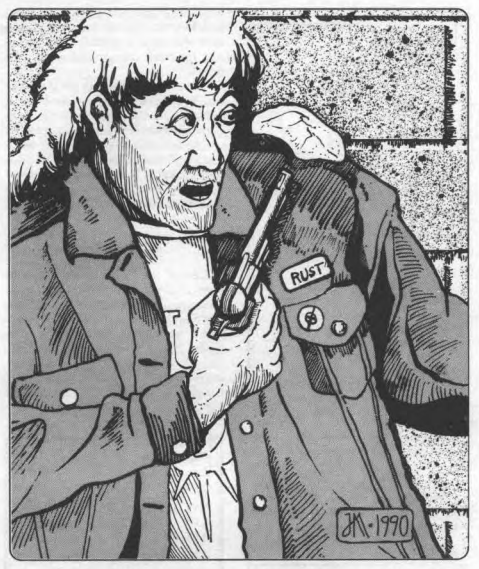
I don't think you're really thinking that through there, Rust.
Bonthkra are the oil slick from that one Creepshow segment with the lake.
Borr Akas are some of the largest creatues in the Living Land. They're up to 85 meters tall, 150 meters long, with a long neck and back spikes. Borr Akas can and will flatten large swaths of the jungle while hunting for prey, and the edeinos tend to use them as siege weapons. It has a Toughness of 43 (higher than an M1 Abarams) and its bite is damage value is 42 (higher than a direct hit by a torpedo). They're not fast by any means, but when you're that tough and that pwoerful you don't really have to be.
Carnols are 15 meter-long dinos with spiked tails. Not as tough as Borr Akas, but a lot faster.
Crosktreckts are small carrion-feeding lizards that travel in packs. Since things rot so quickly in the Living Land, they're always on the prowl for food. They're attracted by the sounds of fighting, and will often wait out a battle to feed off the losers. They'll only attack living creatues if they're desprate for food.
Ecrusts are an indirect danger. These lizards are barely a foot long, and feed off insects. What makes them dangerous is that a) they have poison spines on their backs, and b) they're very easy to not notice, and therefore step on. If someone does so, then the lizard makes an "attack" against the target's Toughness, and if that hits then the spikes penetrated the skin. If the target takes a wound, then they have eight rounds to do something (or must make a pretty hard Toughness roll) to neutralize the poison of they're dead.
Oh hey, gospog! Remember those? Kaah's been introducing gospog very slowly to edeinos culture (since they're grown in fields full of corpses). As it is, he never grows them back in Takta Ker, instead having all the operations in worlds he's conqured. This has kept the Jakatt's objections to a (relative) minimum, although ever since the Core Earth invasion there's been a much surge in the Jakatts pushing back against these mockeries of life and has been causing some of the edeinos tribes to turn their backs on Kaah.
Second-planting gospog are 10-foot tall four-armed humanoid lizards; they also very closely resemble edeinos, which is another reason the Jakatts hate them. Third-planting gospog are person-sized beetles that can stand on their hind legs and use weapons (like guns). Gospog of the fourth planting are three meter tall insectoids with coarse wings and powerful mandibles.
The fifth planting gospog...
quote:
The horrendous gospog of the Fifth Planting has the body of a giant, bloated fly topped with three huge heads - all of which are reptilian in nature. Each head's mouth is filled with a sea of sharp teeth and has a long tongue capable of shooting out and catching preyup to 10meters away. The gospog are eight meterstall, far larger than the other gospog, and in every respect much more dangerous.
The huge, fly like body of the gospog is covered with thick, stubby hair. Its skin is rough and wrinkled. Like the other gospog, it is six-limbed, with thin, but very strong multi-jointed limbs. Its forearms are shorter than the two rear sets of legs. Like a fly, it constantly rubs the hands of these shorter arms together, passing the hands from one head to the next to be licked by each tongue.
 On top of being disgusting, they get three attacks per round via claws, teeth, tongue, and wings.
On top of being disgusting, they get three attacks per round via claws, teeth, tongue, and wings.Grotuks are herbivores, but they're also 20 feet tall at the shoulder with antlers and three tentacles growing from their snouts, so they're capable of doing some damage when enraged.
Herres are snakes with eight clawed legs that likes to attack prey by waiting in trees and dropping onto whoever's unlucky to wander beneath them.
Itoons are human-sized T-rex like creatures that are solitary hunters, whose primary weapon is the large horn on the end of its snout. Because their little T-rex arms are useless in a fight, they keep them tucked behind their necks.
Jaadds are from the same world as the benthe, and like the benthe they live off people's emotions. Specifically: fear. Jaadds look like weeping willow trees, but are capable of moving via four feet hidden at the base of the "body" under a mass of tentacles. They prefer to attack sleeping victims, using their pheremones to instill nightmares in their prey.
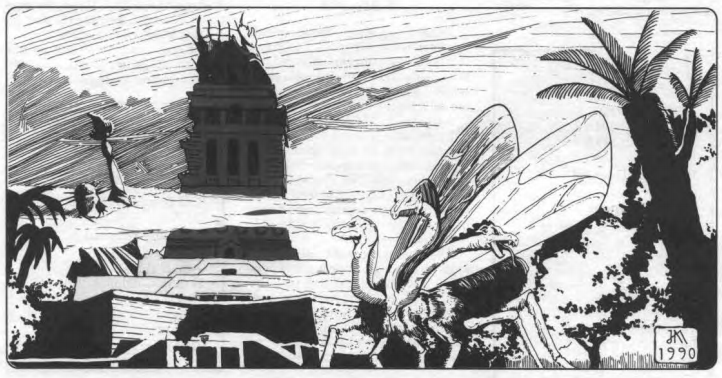
Oh, hey, an actual picture of something! This is a fifth-planting gospog.
Jeskowntas is a feathered lizard with useless wings that lives in the plains. They're kind of like Jurassic Park raptors, only with sharp beaks.
Karkatas are tiny flying insects who like to lay their eggs in living hosts. Nests of karkatas enter breeding frenzies every three weeks or so, and each individual insect can lay anywhere from 20 to 100 eggs. The eggs take an unknown time to hatch, but when they do they begin to feed on the host for the first week of their life, at which point they leave the host and return to the nest that spawned them. Removing the eggs requires a bunch of medicine rolls.
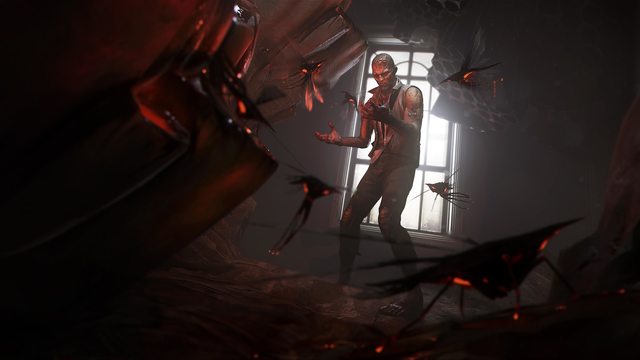
You're better off just saving your incindiary bolts for the nests, really.
Kaylls are trees that feed off the rotted remains of anyone unfortunate enough to get close enough to get slashed by their thorny branches. Yes, in the Living Land even the trees are out to kill you.
Koltras are yet another upright reptilian hunter. What makes these different is that a) they're nocturnal, and b) each of their arms has two elbows.
Kylots are basically spiked triceratops with a big spiked club tail.
Lakten are flying beasts with a four-meter wingspan that are often used by edeinos as flying mounts. On their own, they've been known to leave the Living Land to hunt for food (i.e., livestock or people) in Core Earth areas close to the stelae zones.
Langatoks are also flying beasts used as mounts, only these things are actually giant winged scorpions because the Living Land hates you.
Meksobats are giant butterflies. No, really. They have a two-meter wingspan and can spray poison. This poison is pretty much a save-or-die-in-five-rounds thing because that's always fun.
Nosktret are graboids. That's kinda it.
Pakottons are amphibious humanoid creatures who are basically Deep Ones or murlocs depending on your frame of reference. In a bit of design that preps for the Aysle sourcebook and spell creation, Pakottons are considered "creatures", not "folk", because they don't use tools or have a society, and "respond entirely to instinctual signals of fear and hunger."
Portochks are five meter tall mobile swamp plants that feed on creatures that wander near them by basically falling on them. This is done via a contested Dexterity roll; if the portochk succeeds by 3 or more points, then the target is pinned and entangled in vines. Pinned targets can't do anything except try to free itself by making contestsed Strength rolls. Oh, and weapons are ineffectual (-3 to the weapon's damage value) against these things for no real defined reason.
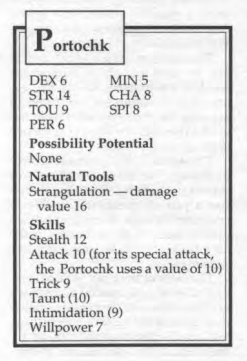
I'm only including this to show how dull a Torg stat block is. Note that the creature's special rules aren't in the stat block; they're only in the description.
Quarteks are small leeches that are also from the benthe's home cosm, and like all beings from that cosm they're capable of manipulating emotions. Quarteks don't drain blood; they drain your will to live. They do this by making a Charisma roll against the target's Spirit once an hour. The target gets a penalty to all actions equal to the value the leech succeeded by. The book states that the player shouldn't be told about the penalty in advance or why they're reciving a penalty, which I kinda get, but still feels like a dick move because I doubt players are going to think to check under their clothing to see what's going on. Oh, and the Jakatts consider quarteks to be a plague on the Living Land (for obvious reasons) but don't know how to deal with the problem yet.
Restras are...
quote:
Restras are native to the stalenger homeworld. Thecreatures areabout a meter in diameter and a meter high. They are circular in shape and have four legs, each about half a meter high, and have four to eight arms, which radiate randomly from the body's surface. The skin of a restra is covered with a thick, yellow mucus that it secretes from various pores.
Although the creature uses its legs when scuttling about on the ground, its feet as are equally adept at swinging through the trees. In fact, when traveling by tree branch the restra seems to lose all concern for "facing," for it tumbles through the foliage like a ball spinning through the air, flipping one way and then the next, gaining the next grip on the tree with whatever appendage is available.
It is able to do this because each foot and hand, is equipped with its own sensory organ and "sub-brain" which processes the information of spinning through the air and looking for the next branch to grab onto separately. The information is fed to the central brain, after all the data is processed, so that only the choice of which appendage should grab the branch is left to be made.
Ropraj look like mounds of mud with tentacles around the base and a giant mouth on top. They are incapable of movement, but since their metabolism is ridiculously slow they only need to eat once a month or so.
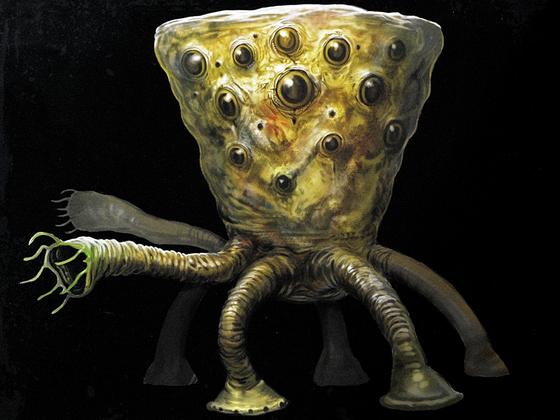
So one of these, I guess?
Rufkas are flying serpents, although not big enough to eat a skyscraper. They're only two meters long on average, and their preferred method of attack is strangulation.
Shestike are GIANT spiders. Like, eight meters tall giant. Legs like tree trunks giant. I don't think I need to go into any more detail, really, because the book doesn't.
Skroches are also spider-like, but are lizards. They do build webs, though, that require a Toughness roll of 10 or 12 to get out of. And again, that's all we get on these things.
Stalengers were mentioned before; they're the most populous intelligent race in the Living Land after the edeinos. They're starfish-shaped creatures about two meters in diameter. They fly by means of what's essentially an organic air pump and the fact that their "arms" are aerodynamically shaped like an airplane's wing. They also have thin tentacles that allow them to perform fine manipulation. They can also change the color of their skin to hide in natural foliage.

A stalenger.
All stalengers are converts to Keta Kalles, and those who do become Jakatts use their color-changing ability to create beautiful patterns on their skin to increase the beauty in the world.
It should be noted that there are two stalenger character templates, but depite having natural camouflage, the ability to fly, and a long-range attack thanks to their tentacles, there's no special rules or penalties for playing one. Odd, that.
Toradas are giant octopus things where you can fight each of the tentacles separately.
Tornlen are carnivorous plants with a red-and-blue speckled pattern on their leaves. It attacks by spraying poison into the target's face, then using its strong arm-like vines to drag the creature into the acid pool at the plant's center.
Tromblens are from the stalenger homeworld, but look like flying manta rays rather than starfish. They're also not intelligent, rather being pack hunting animals. They prefer to attack by swooping down from on high to take bites out of their prey, then flying back up out of range of a counterattack.
Udatoks are large herbivores that "look much like the ancient triceratops of our world, but has only one large horn." The only notable thing about them is that Jakatts like to use them as the target of miracles that allow them to directly control animals.
Ugresk are large winged serpents that actually are big enough to menace a skyscraper. They're basically dragons; 25 meters long, gree scales, wings, lays eggs.
Voskats are large bettle-like insects with red coloration that mixes in well with a lot of the new plant life in the realm. There's really not much to them; they lay in wait for prey and attack in groups of 10 or more.
---
And that's all of them. Sorry this was such a boring list of creatures, but they seemed to be more interested in quantity over quality. I mean, there are some interesting critters in there, but there's also a lot of "This is a dinosaur. This is also a dinosaur" in there as well. Not that a lot of the creatures matter because, once again, the majority of this stuff wouldn't see the light of day in the game line due to the Living Land being pretty much abandoned after this.
On the plus side, we're chewing through the book pretty quickly?
NEXT TIME: Exploring the lost world.
Off the beaten path
Original SA post The storm has a name... - Let's Read TORG
Part 16g: Off the beaten path
At this point, there's only three chapters left in the book plus the templates, so let's just get through them because these three chapters are literally only 13 pages all told. And of course, these 13 pages are about what you're actually supposed to do in the Living Land.
The Designing Adventures in the Living Land chapter itself is only five pages long (one of which is a full-page illustration), setting the tone for the rest of the game line. To make things worse, a solid page of this chapter is reiterating the whole "Earth is invaded by other realities, each reality has its own tone, here's how you remove stelae and restore hope" thing that's already detailed in the main book. Seriously, we get it! I've got the core set, I already know all this!
Ugh. They do that in a lot of the books, actually. I just never really point it out but it's really hard to ignore here, where they're wasting space with stuff that's from the core instead of giving me stuff I can use. Part of me wishes it was practical to c&p the whole "chapter" into this post so you can see how useless it is, but instead I'll have to pick and choose.
quote:
The Living Land is based in part on the fictional lands of the Lost World, created by Arthur Conan Doyle, and Pellucidar, created by Edgar Rice Burroughs (who also wrote the Tarzan and John Carter of Mars books). Although the Living Land has some important differences from these two places,which will be discussed shortly, there is a wealth of similarities that can act as a guide for the gamemaster. If you've got the time, go out and get some books by the above authors. You'll find them very inspirational for creating adventures set in the Living Land. If you don't have time, here are the main points of adventures set in places like the Living Land and the Lost World.
I assume they wanted us to go get those books because they sure didn't spend a lot of time thinking of ideas for themselves. The point they hammer home the hardest is that the Living Land is every trip into the realm should be a trip into the unknown. While it's incredibly easy to get into the Living Land, the challenge lays in getting out in one piece. The Deep Mist obscures everything, making every shadow a potential threat. A large number of creatures in the realm look like normal plants...up until the point where they attack you. Everything familiar (buildings, wrecked vehicles, landmarks) are made alien due to damage and the overgrowth of the jungle.
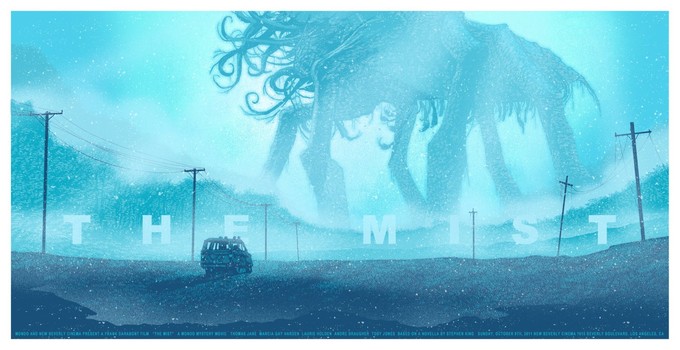
Like this, but foggier.
Unfortunately, the only advice we get on how to make this come to life is "go read those books". Even for creating actual adventures, they only give three basic hooks for "lost world" adventures:
- Save something
- Find something
- Destroy something
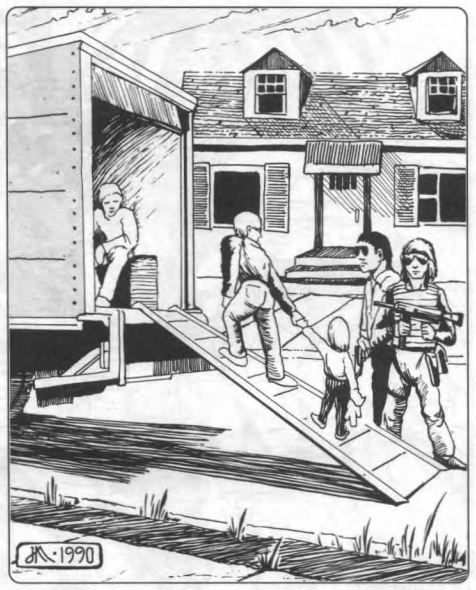
For example, you can help your friends move!
Oh, but don't worry; once you cycle through those three concepts you can start adding complications to keep things fresh! Like...uh, copying the plot of Doyle's The Lost World. Or Tarzan at the Earth's Core. Basically, go read something else and do that.
quote:
New plots can directly effect the player characters or can be something outside of their own concerns that they can become involved in. An example of the former is if their vehicle crashes far into the interior of the Living Land and they have to escape on foot. An example of the latter is if the group comes across a resistance community being harassed by survivalists and the heroes help defend the community.
Even if the players are determined to stay on the course of finding that eternity shard (or whatever launched them into the adventure) they should keep in mind that these alternate storylines are the good deeds that have to be done to fill people up with possibility energy. Thus, as long as they are doing good in the world, even if it wasn't their original plan, they're hurting Baruk Kaah.
I'm starting to see why they didn't use the place much.
Anyway, the next chapter is three Locations in the Living Land that people can run around and do things in. Really these are sample adventures so I don't know why they're not called such.
The first one is "The Valley of the Uscranta", which is notable because it contains a tree that's an eternity shard. The first trick is finding the valley in the first place.
quote:
On a piece of paper, draw two lines across the page. Label each of the three sections created as Area One, Area Two, and Area Three. Ask the players if they want their characters to explore Area One, Two, or Three.
Each day that the heroes wander around, roll a die. If they picked Area One don't worry about the result, they can't stumble across the valley, but don't tell them that. If they are exploring Areas Two or Three, however, and a 19 or a 20 comes up, they have found the valley. If the number on the die equals the number of days they have been wandering around, they hear the crack of a gun off in the distance. If they pursue the sound, they come across Ed Zacks, a crazy old man. Ed lives alone in a cabin just to the east of the valley the player characters are looking for.
The second location is "The Altar on Lake Michigan", which is one of the major sacrificial sites used by the gotaks in the Eastern Land. The altar is set up in an observatory on the Northeastern University campus, and rituals are performed there most nights. Both gotaks and Jakatts operate out of the structure; the Jakatts aren't too happy about it, but see the structure as only a little blasphemous due to being open to the sky. There's not much to do here; it's just a place to go blow up and free prisoners from.
The third location is "The Sword of Cochulain and the Uptown Express", and is basically an excuse to use the three New York gangs described in the previous chapters.
quote:
Buried in a subway tunnel in Manhattan is the Sword of Cuchulain, forged by Cregory Augusta in ancient Ireland for his king. The sword was found in a burial mound in 1902 and was kept at the College of Dublin until just before Earth was invaded, when it was brought to New York's Metropolitan Museum of Art with an exhibit about Ireland.
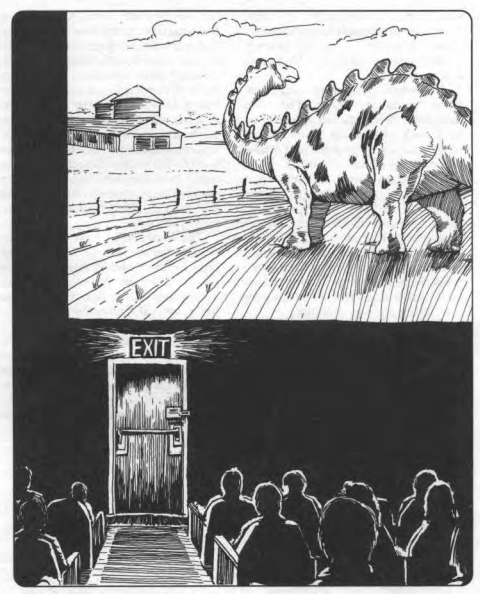
Ugh, another boring documentary.
The final chapter is Adventure Ideas, and it's just a few rough outlines for "standard" Living Land adventures.
The first idea is what ended up becoming the Default Living Land Adventure: escorting a convoy through the Living Land to survivor colonies. The twist on this one is that there's a resistance colony in the area, and people are competing to report it for a government reward.
The next outline is based around the idea that the PCs catch word of an infantry unit in Philly that's going to try and take out a Jakatt tribe. The problem is that the tribe in question is actually working against Kaah (apparently one of the PCs just "knows" this), and the further problem is that high command knows the tribe is friendly. The idea is that the platoon is going to the tribe under the pretense of joining up for an attack on Kaah's forces, then mowing the tribe down and filming it to show as a rah-rah "we're beating the lizards!" propaganda film.
The third and fourth ideas are pretty straightforward; a race against Kaah's forces for an eternity shard, and rescuing an expedition. Nothing to really comment on.
The fifth adventure seed actually brings in the other High Lords: a small contingent of Cyberpapal agents are posing as "normal" Christians and are hiring Storm Knights to escort them into New York City. Their ultimate goal is to steal the altar crucifix from St. Patrick's Cathedral, but sadly we're not told what their cover story is. This one is basically an escort mission with a betrayal at the end.
And...that's the end of the book, really. All that's left are the character templates. The Living Land is a little unusual in this regard because a lot of the templates from the realm book are actually Core Earthers (okay, Americans) who are tied to the Living Land in some way, shape, or form. Since I'll be covering Core Earth in a brief "here's the basics" post before we move on to the last three realms, I'll deal with a bunch of those templates there to pad my word count. For now, I'll just deal with the Living Land focused characters.
The core set only had two real "Living Land" templates:
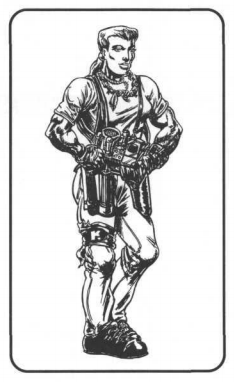
The Realm Runner was always good with cars. She's the quintessential grease monkey, always tinkering with any vehicle she can get her hands on. When the invasion happened, she learned that she was one of the people who could keep tech working in areas where it shouldn't. That's an ability that's in high demand nowadays. And really, the only thing better than fixing cars is driving them. She starts with a beat-up ride of her choice, tools and spare parts. Her tag skill is either land vehicles, air vehicles, or water vehicles.
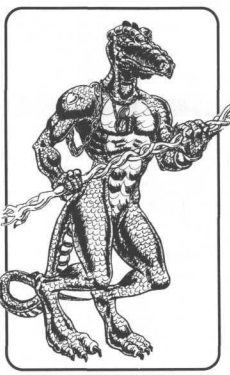
The Renegade Edeinos used to be loyal to Baruk Kaah, and followed the will of Lanala as handed down by the Saar. But Kaah's ways always sat wrong with him. First it was the gotaks, then when the edeinos came to this new world Kaah chose to starve out the enemy tribes rather than fighting. But when told to use the dead things called "rifles" taken from the humans, he brought his concerns to his optant...and was almost killed for his troubles. Now he's escaped his tribe and is exploring the new sensations available to him in this new world of "Earth". He starts with a hrockt spear, a loincloth for some reason, a musical greeting card, and a TMNT t-shirt. His tag skill is melee weapons.
The realm book added a few more options, which is to say it added some options. There are a few Core Earth templates I'm not listing, simply because they don't have anything specific to do with the Living Land. I'll cover them when I cover Core Earth itself.
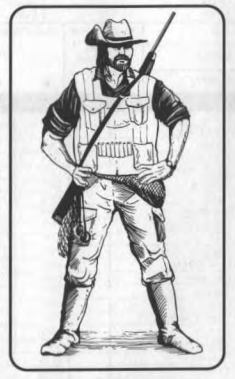
The Big Game Hunter is actually pretty okay with the whole invasion thing. Used to be, to hunt dangerous game he had to head to Africa or something; now he barely has to leave his front yard. What's more, the creatures crawling around the Living Land are much more impressive (and much more dangerous) than the stuff he's been hunting his whole life. He starts with a bunch of survivalist gear, a rifle, and his tag skill is tracking.
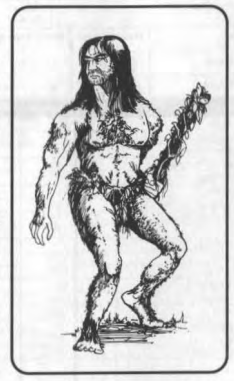
The Earther Gone Native used to be, well, normal. He played sports in high school, loved the rush of action and the thrill of victory. Then, well, time happened. He got an office job, settled down, started to let himself go. Then the invasion happened. But unlike most of the people affected by it, he realized the changes were breathing new life into him, letting him appreciate life more. He's an ardent follower of Keta Kalles, but as a recent convert he can see Kaah for what he truly is. He starts with a hrockt shoot club and a hrockt shoot spear, and his tag skill is direction sense.
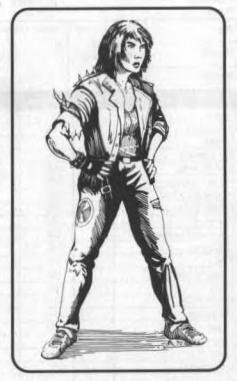
The Gang Member grew up on the streets of New York, in one of the neighborhoods where you pretty much had to join up with a gang to survive. He did a lot of things he's not proud of, but when the lizards invaded he had to start doing a hell of a lot worse. New York is almost literally "kill or be killed" nowadays, and his time is split between keeping his own turf safe and protecting people who come into the city to salvage stuff to fight the dinos with. He gets a leather jacket, switchblade, and "gang colors", and his tag skill is lock picking.
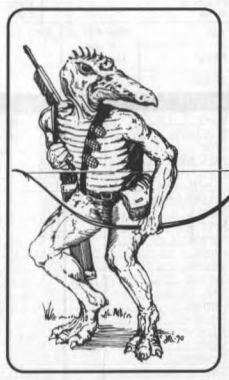
The Edeinos Gone Native is a reminder that transformation works both ways; this is actually a Core Earth template and operates under those axioms. He left his tribe to learn more about the humans, but somehow lost his connection to Lanala (and the Living Land in general), but the trade-off is an increased understanding of "dead things". These devices no longer seem evil, and in fact are capable of providing excitement and sensations beyond anything he ever dreamed of. He's a "noble savage in a strange land"
 , and starts with a long bow, some grenades and a fucking minigun. His tag skill is fire weapons.
, and starts with a long bow, some grenades and a fucking minigun. His tag skill is fire weapons.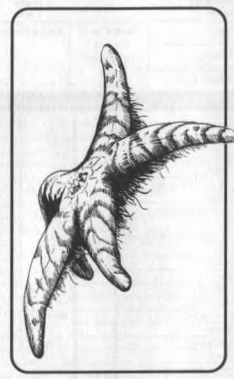
Yes, I know you've seen this before.
The Inquisitive Stalenger has been travelling as part of Baruk Kaah's tribe as it's brought the word of Lanala to new worlds. But as exciting as it is to be a Jakatt, it's even more exciting to examine these humans and their amazing new experiences. Things like music, and clothing, and televisions. But by communicating with the humans, it's learned what Kaah's crusade is really about. It doesn't start with any items apart from some Core Earth souvenirs, but it does have one of my favorite character quotes:
quote:
"Let's listen to that Rolling Stones circle again."
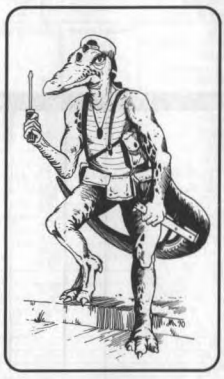
The Edeinos Tech Prodigy is another transformed edeinos, although this one's circumstances are different. He was captured by human soldiers early in the invasion, and transformed when brought to a military outpost in Core Earth. He became fascinated with machines after watching a soldier fix a jeep, and actually started befriending the soldiers when Kaah's counterattack happened. Now he fights to protect his new home from his former master. He starts with a bunch of tools, a .44 Magnum, and various Core Earth trinkets. His tag skill is scholar (mechanical engineering).
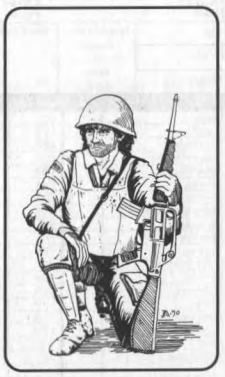
The National Guardsman found out that he was P-rated the hard way: he was the only guy in his unit whose gun didn't jam when fighting the lizards. That wasn't enough to stop his home from being overrun by the edeinos, so now he's getting his revenge one dead lizard at a time. This guy starts pretty well kitted out, with Kevlar armor, an M-16, and a bunch of survival gear. His tag skill is fire combat.
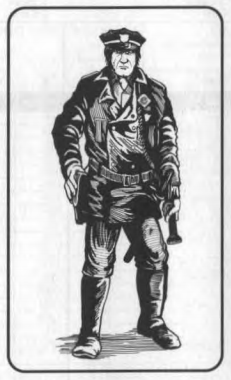
The New York Cop is one of the few survivors of being at the first invasion point, and it's only because he was the only person around who could get his car to work. In the new post-invasion New York, he's focused on protecting what little territory isn't already controlled by the gangs or the lizards. He took a vow to serve and protect, and by God that's what he's going to do. The standard cop loadout's a little beefier since the invasion: bullet-proof vest, .38 revolver, nightstick, walkie talkie, and (for some reason) his ticket book. His tag skill is evidence analysis.
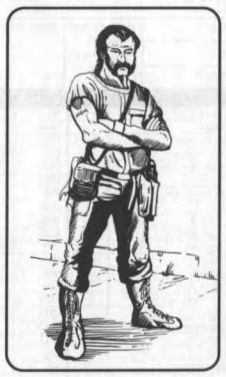
The Profiteer isn't an asshole, he's just practical. There are people stuck in the Living Land who need food and supplies brought to them on a regular basis, resistance colonies that need guns and ammo, but what none of them realize is that all that shit costs money. And you gotta spend money to make money, right? Plus you got expenses, you gotta hire bodyguards and guides...that stuff affects the prices, you know? This guy starts with a big rig, a few guns, and $500 cash. His tag skill is persuasion.
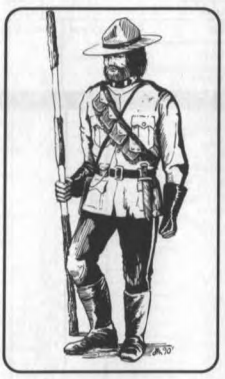
The Royal Mountie is having an easier time than most law enforcement types in the States. The invasion left Canada relatively untouched, but that doesn't mean that he doesn't have anything to do. Kaah's efforts to expand his territory need opposing, but fortunately as a Mountie he's trained to survive in the wilderness. Plus his horse is more reliable than a car nowadays. His tag skill is tracking.
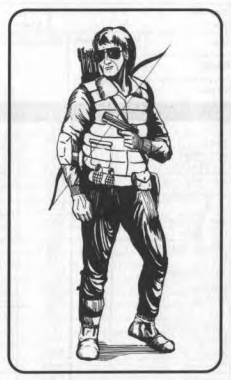
The Spartan signed up with the military to serve his country, and got his chance when the invasion happened. The Delphi Council recruited him to go on deep operations into the realm. Only now he's hearing these rumors about some of the stuff the Council's been up to, like killing human survivors and blaming it on the edeinos. He hasn't been asked to cross any lines, though...yet. He starts with Kevlar armor, some guns as well as some primitive weapons (a bow, a spear), a compass that's useless, and polarized sunglasses. His tag skill is persuasion.

Yes, they use the same picture for both stalenger templates. What do you want? It's a flying starfish.
The Stalenger Optant is a follower of Lanala who revels in every sensation it experiences. It's also realized that Kaah is perverting the worship of Lanala for his own ends, and has heard Her calls for revenge. So it has joined with these new beings that oppose the High Lord, and as a result has begun opposing the Saar. It starts with no gear, but has one of my other favorite character quotes:
quote:
"If you want a real experience, I recommend running head first into that tree."
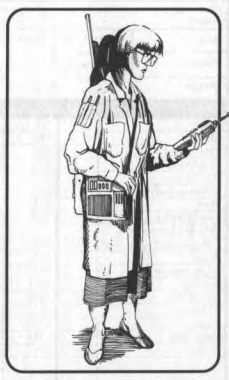
The Tech Wiz has been tinkering with technology since she was a kid. But when the Living Land happened, technology stopped working...for everyone else, anyway. But things still work when she's around, and in the current post-invasion world that is a very valuable commodity. She starts with various tools, spare parts, and an AK-47, and her tag skill is scholar (electrical or mechanical engineering).
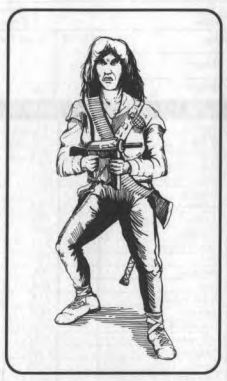
The Vengeful Human is a survivor. But not by choice. Her home was overrun by the lizards, but for some reason she was the only survivor. She's lost her family, and now all she has is a desire for revenge and a death wish. All that matters is killing the lizards, and no matter what happens she'll never kill enough. She starts the game with a bunch of weapons, and her tag skill is unarmed combat.
And with that we finish up with the Living Land. That was a quick one, wasn't it?
But as always, before we go we're going to take a look into the future of Baruk Kaah and see how the metaplot treats him.
As stated many times before, Kaah becomes the whipping boy of the whole game line because nobody liked adventuring in the Living Land. I'm sure part of that was pre-planned due to metaplot, but even so Kaah starts suffering setbacks pretty much from day one.
In the first 18 months of the invasion, Kaah actually manages to lose two of his three bridges: the one at Sacramento is lost when 3327 destroys the stelae zone closest to San Francisco, and the the entire Northern Realm in Canada is taken down by Storm Knights. On top of that, his Darkness Device, Rec Pakken, has actually betrayed him twice without him realizing it.
That's not to say that Kaah doesn't have some wins; he starts expanding both of the Lands in the States inwards towards the Midwest, dropping another bridge on the Wyoming/Colorado border and actually getting his own borders to the outside borders of the Dakotas.
Despite that, Kaah still skirmishes with the other High Lords. He hates 3327 for taking part of his territory, Mobius keeps sending teams into New York to hunt for eternity shards, and in the near future Malraux sets up shop around Boston.
When the Northern Land falls, the edeinos start turning against Kaah as they see this as a sign of weakness. Within a year, a Death-worshiping edeinos attempts to usurp Kaah and seize Rec Pakken for himself. The coup fails, but it's a further drain on Kaah's resources. He soon loses Denver, and that becomes a major rallying point for Core Earth forces. What's worse, he ends up losing damn near all his maelstrom bridges, cutting him off from his home cosm and any reinforcements he could get.
Kaah starts taking bigger and bigger risks as his power base starts to erode, and begins losing territory as a result. But his biggest setback will come in just under two years, when a major metaplot-related geological event destroys all of the Eastern Land and a sizable chunk of North America.
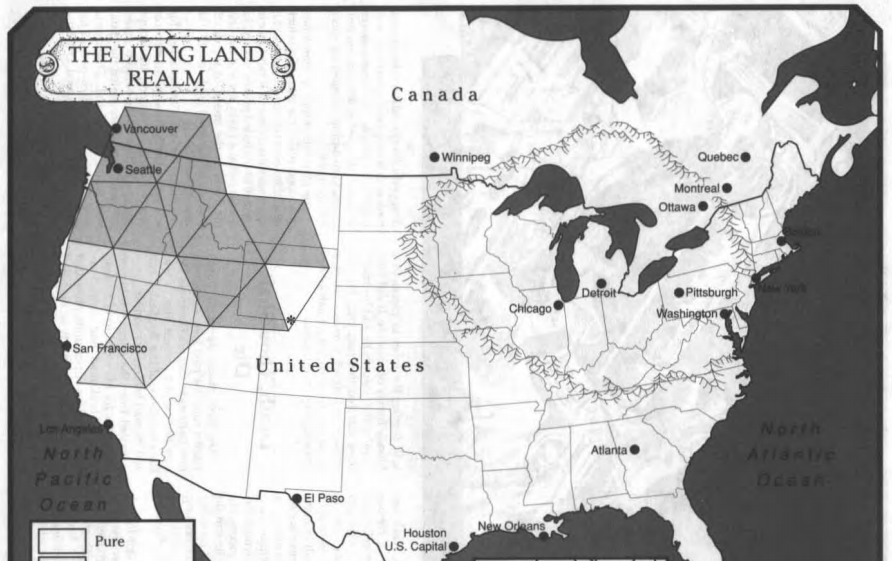
Holy shit.
Eventually, Kaah realizes that Rec Pakken is basically out to get him, and this is the final straw that changes Kaah from "failed conqueror" to "omnicidal maniac". He convinces the Darkness Device to transform itself into a portable shape so he can take it to a "new master". Instead, Kaah brings Rec Pakken deep under the Earth to a strange multifacited crystal called "The Nexus of All Realities" and attempts to throw the Darkness Device into it. His theory is that throwing the thing into the thing will destroy the entire Core Earth cosm and all the other High Lords because he's sick of all their bullshit. Instead, Rec Pakken vanishes to parts unknown when it hits the crystal, and Kaah is pulled into the crystal because Reasons. The last he is seen, he's being ripped apart across all known realities.
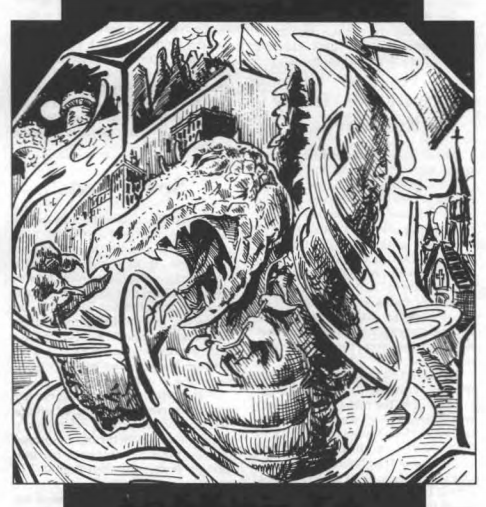
Believe it or not, this is the most impact he's had on the metaplot in years.
And that is the end Baruk Kaah. OR IS IT? It's not.
By the way; that last plot point? That was only described in the newsletter. If you didn't subscribe to the monthly newsletter, then the only other way you'd learn Kaah was gone was to get the second or third metaplot update books, and even then they didn't give you the details. The inherent assumption by the writers that everyone was reading everything they put out really comes into focus here.
With Kaah "dead", the Living Land begins to collapse rapidly. All the bridges to Takta Ker are destroyed, and while it's not eliminated completely when the game line ends, it's only a matter of time before it's wiped out. By the end of the game line the Living Land realm is barely a footnote in the game line it helped kick off. The only real dangling plotline is what happened to Rec Pakken: it popped up again in the Western Realm, but by the time the game line ended it hadn't picked a new High Lord.
----
And there we go. The most wasted potential in the entire game line, a realm that came out of the gate strong and actually started petering out before they even hit the end of the book. I mean, I don't even have much to say about the realm as a wrap-up because there's so little there.
I mean, yes, there are great idea in there; the non-human races, the whole religion of Keta Kalles, Kaah's constant expansion, but it seems like the ink had barely dried before they just lost interest in the realm. It didn't help that even the creators couldn't think of interesting things to do there beyond "go find stuff, I guess?".
But before we actually finish up with the Living Land, we gotta address the elephant in the room. We gotta talk about Skippy.
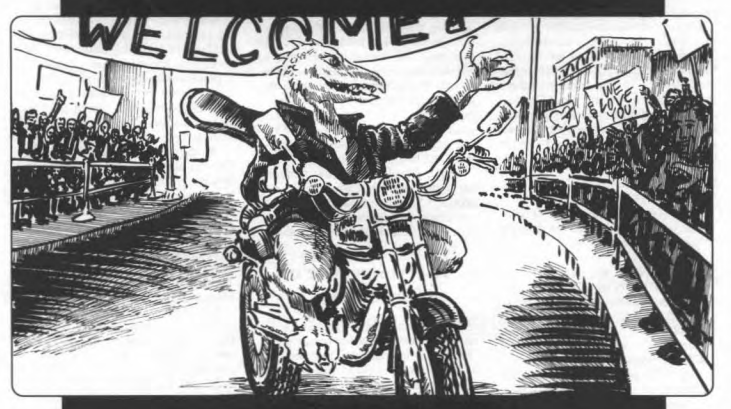
Oy.
Skippy first appeared in the Character Collection, which was a book of pregenerated characters/NPCs. Skippy is an edeinos who's "gone native" and flipped to Core Earth reality, and through means never really explained becomes a sort of mascot for "good" edeinos for humanity. Skippy also owns what's believed to be the crown of King Pellinore, whoever that is. I think it has something to do with Aysle but honestly the whole concept of Skippy the Edeinos is so goddamn stupid I can't care enough to check.
Skippy becomes famous somehow, to the point where they're making action figures of him. He ends up getting killed in an appropriately stupid way.
quote:
In the end, Skippy was slain, not in combat with the minions of High Lords, but in the middle of a private war. Ensign Egypt, the Keefee Haroo sidekick of Nile Mystery Man Colonel Cairo, had shifted inclination to Evil and begun plotting his mentor's death. One of his attempts involved planting a time bomb in a building and then luring the Colonel there. Egypt's work was interrupted by Skippy, who helpfully pointed out that the Keefee's clock was set to the wrong time. Skippy corrected the "error" and perished in the ensuing explosion.
Later, there were rumors that Nile "weird scientists" had stolen Skippy's remains and created four Skippys: a teenaged Skippy, a cyborg Skippy, an Ayslish edeinos in a suit of plate armor ("the Skippy of Steel") and a brutal Skippy ("the Last Son of Lanala"). These rumors turned out to be just that: rumors. Skippy sightings occasionally still pop up in supermarket
tabloids, but the fad seems to be slowly dying out.
---
Hey.
Do you all realize where we are now?
That's right: we've finally, finally finished the last of the realms from the core set. All six invading realities have been covered in more depth than I like to think about.
So that means we're done, right?
Hahahahahanooooooooo.
See, once all the realms were covered, West End still needed to keep the supplement train a-rollin'. And since you can only put out so many adventure modules and gear books before those wells run dry, three more realms showed up to start fucking with the status quo.
Hey, remember in the first book how the Gaunt Man needed seven invading realities to overcome Earth's natural resistance? And how since one of them didn't make it, we hit this state of equilibrium? And as such, adding three more would logically tip the balance the other way? No? That's okay, the writers didn't either!
So yeah, we have three more books to cover before we get to War's End, the metaplot-capping adventure. Before that, though, we're going to take a quick stop in Core Earth to cover the basic there and hit a few more metaplot points before we start chugging through the back half of the game line.
Y'all ain't seen nothin' yet.
NEXT TIME: Oh yeah, technically Core Earth is a realm.
A brief stopover in Core Earth and metaplot points in-between
Original SA post The storm has a name... - Let's Read TORG
Part 17: A brief stopover in Core Earth and metaplot points in-between
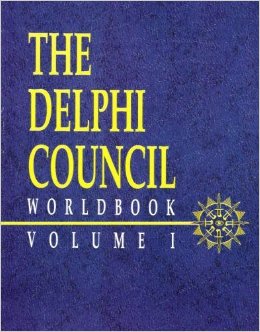
A few years after Torg was released, the writers seemed to realize something: they never gave Core Earth any real attention.
I mean, yes, in each realm book they do talk about how that realm is affecting the nations around it, and yes the core book listed Core Earth's axioms. But there was never a book focusing on Core Earth itself.
So two years after the release of the core set, we got The Delphi Council Worldbook Volume 1, which is the closest we got to having a "realm book" for Core Earth.
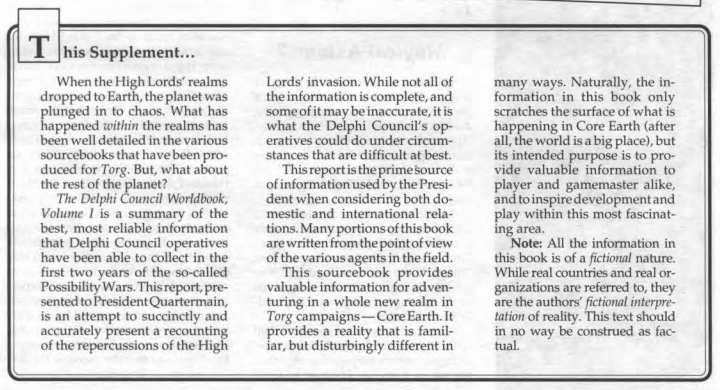
Just fyi, the book isn't written as an in-universe document, although there are "excerpts" throughout.
That said, I'm not going to cover it like I did the other books for two reasons.
First, there's not really much here setting-wise that isn't going to be touched on in the other books.
Second, we still have four other books to get through before we're completely done and I gotta cut corners somewhere.
So what we're going to do here is touch on the axioms and World Laws of Core Earth (the latter of which didn't exist until this book), point out some things that will come up in the metaplot later, and cover the Core Earth character templates. Sound good?
quote:
The axioms of Core Earth are not new to most of us. We live in a world comparatively rich in technology, and fairly socially advanced. Magic is uncommon in our world, though it does not have to be, and spiritually we have a certain amount of strength. This is the world we know. The axioms listed here reflect the world that we know, as well as giving the gamemaster a few ways to enhance the feel of Core Earth.
As with all cosms, Core Earth has a series of World laws that help to define its reality. The world laws presented here help to give feeling to the reality of Core Earth. The laws also indicate why it has been so hard for the Possibility Raiders to defeat the Earth.
Right?
Wrong! Turns out that magic and miracles are totally possible on Core Earth! I guess nobody ever thought to check until the invasion happened.
Magic axiom: 7 At this level, only divination magic can work with any sort of regularity, but even then magic's incredibly hard to pull off. Attempting to cast any spell allowed by the low magic axiom gets +5 to difficulty and backlash because apparently the low magic axiom resists spellcasting, which is apparently a thing. The reason that anyone is capable of casting spells in Core Earth at all due to the reawakening of Core Earth's possibility energy, which is apparently also a thing. Now that people know that magic is totally real, Core Earthers have begun experimenting with various forms of magic.
Spiritual axiom: 9 At this level, direct intervention of the divine is possible, despite that not being a thing that's ever actually happened as far as I know. I mean, it might have happened; I don't get out much. Not that I'd be able to tell one way or the other.
quote:
At any given point in time, a character may become the object of divine intervention - but there is truly no pattern by which this intervention works. A character with a high faith skill seems to have no better chance of being aided in time of crisis than one with no faith at all. Characters with high faith, however, recognize the signs of divine intervention far easier than those who do not possess this skill.
Interestingly, the book actually contains a whole chapter on how magic works on Core Earth, because heaven forbid we get a sourcebook without new subsystems. However, the majority of the chapter is about Voodoo: how it's a spiritual belief system that's really magic and therefore you can substitute skills for casting, news spells, and the new skill science: folk medicine. I'm not going to go into detail about it because really there's not much to go into detail about. Well, except for the fact that some areas of Core Earth have a slightly higher Magic or Spiritual axiom because.
For sake of completeness, Core Earth's Social axiom is 21, and the Technological axiom is 23. I'm not going to go into depth on those apart from saying they're basically the world in 1990.
And that brings us to the World Laws. As has been pointed out before, when the game line started only two realms had World Laws (Nippon Tech and the Nile Empire), and everyplace else had them retrofitted in the realm books. In the same way, Core Earth finally gets a few World Laws here to explain how the cosm has been able to fight back against the High Lords so effectively. Well, technically that's what they're about; what they're really about is how much awesomer Core Earth characters are than everyone else.
The Law of Prodigy states that some people are just inherently better than others. No, really.
quote:
Some people in Core Earth are born with greater abilities than others. There is a small percentage of humankind that seem to have innate talents, or who can figure out even the most difficult problems in certain areas with minimal effort. These are the people that have been influenced by the Law of Prodigy.
The Law of Hope is why Core Earthers have such a strong will to fight and have refused to give in to despair in the face of the Possibility Raiders. This law has two effects. The first is that it's harder for P-rated characters from Core Earth to transform, and it's easier for them to reconnect. The second is that any group with a Core Earth Storm Knight can invoke the "Sieve Initiative" effect of a Drama Deck card for free as if he'd just played the card. This can only be done once per Dramatic conflict.
Lastly, The Law of Glory helps characters plant story seeds. When a Core Earth character attempts to plant a story seed or was involved in the event that's allowing the seed to be set up, you get +2 to the Persuasion roll.
Man, we're just awesome, aren't we?
So I promised some hints at upcoming metaplot things, right? There's only two, but they're both equally "important" in that they're metaplot points that only the writers care about. Those of you who're familiar with the details of Torg's upcoming metaplot points are already rolling your eyes.
The first is the mysterious figure known only as the Guildmaster, who has begun recruiting and organizing Storm Knights the world over. She operates out of Hawaii and works closely with the US government, hiring out P-rated operatives around the world. Rumor has it that she has detailed dossiers on thousands of Storm Knights, even ones who don't work for her. What are her long term goals? Who is she really? What role does she play in the Possibility Wars?

The second is...this.
quote:
In the early days of the war, a new roleplaying game appeared from a small company called S&W. Entitled The Five Realms, the game offered the players the chance to be Storm Knights battling the forces of the Cyberpapacy, Orrorsh, the Living Land, the Nile Empire, and Aysle (Nippon Tech was not included, perhaps because the US government has never officially acknowledged that it is a realm).
The game was not only timely, but eerily accurate, as published adventures began to reveal details of High Lord plots that only confidantes of the invaders (or the Stonn Knights involved) could have been aware of. Just as the game's popularity had seemingly reached its peak, the creator, Jeff Mills was kidnapped by Nippon agents. Knights speculated that perhaps the Kanawa Corporation was interested in discovering just where Mills was getting his infonnation.
Later, Mills just as mysteriously reappeared, now the focus of Delphi Council attention. Rather than submit to "debriefing," Mills and his staff vanished into Oregon, and are continuing to publish the game through blackmarket channels. In recent weeks, new versions of the boxed set entitled "The Seven Realms," and featuring the REDACTED and Tharkold, have appeared.
There is even a rumor that an expansion set (including a new Japanese realm) is floating around, but no game distributors admit to seeing it.

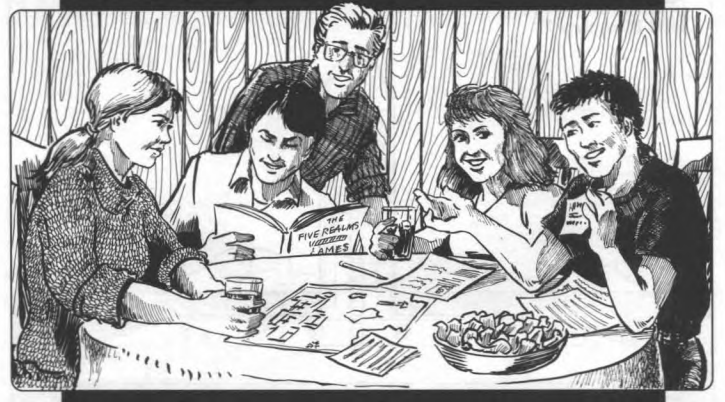
Fuckin' nerds ruin everything.
So yeah, we're doing the "there's an RPG in the setting that's the RPG of the setting!" thing here. What's more, and believe me I hate saying this as much as you hate reading it, this is actually important to the metaplot. I'm not even kidding. Despite only being mentioned like five times all told in the game line, Jeff Mills actually has more of a metaplot impact than Baruk fucking Kaah.
Those of you who remember my original Torg post (i.e. none of you) may remember that I called Jeff Mills "the worst NPC ever." I still stand by this, but the reason why will not become fully clear until we hit the end of the game line. All you need to know right now is that Jeff Mills is basically an expy for Torg's creation Greg Gorden.
And as a side note, maybe it's just me but people getting into playing an RPG about a potentially world-ending war that's actually going on around them at the time seems just a tad uncool.
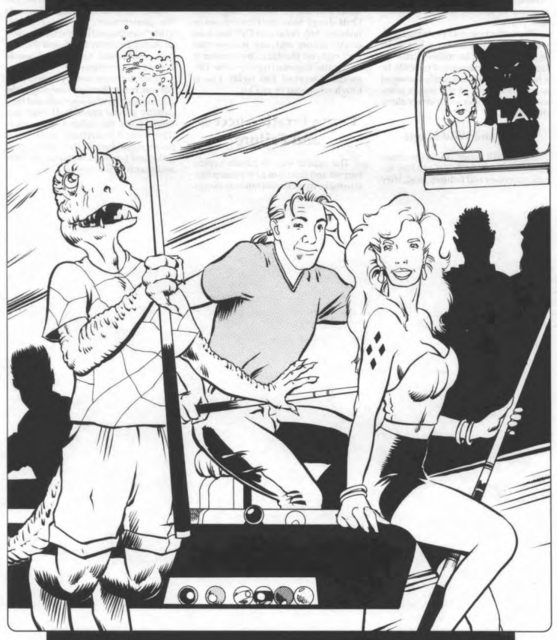
Just another night on the town.
Well, despite that there's not much else to get into. So let's check out the Core Earth templates! Even though all but two of them were created long before this book came out, so don't have the requirements for their focus skills or have the +3 to their tag skills!
The templates from the Core Set (and the Living Land book, which was the "unofficial" Core Earth realmbook) are:
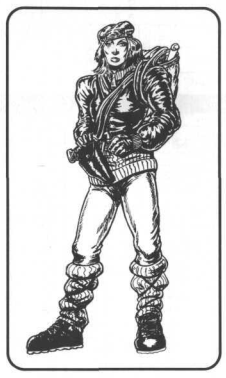
The Adventurous Scholar spent most of her life studying in universities before travelling the world to work on her doctoral thesis. Then the world was invaded by alternate realities, and her talents suddenly became very in demand. Groups of Storm Knights needed information on ancient cultures, on obscure survival techniques, on who knows what nowadays. Of course, now that all these other realities have showed up there's just so much more to learn. She starts with some basic survival gear, a pistol, and her tag skill is scholar (player's choice).
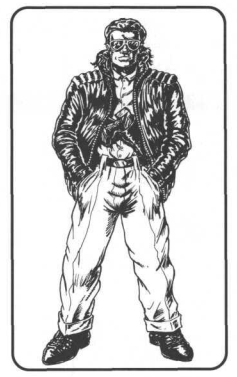
Good thing he's not dressed to stand out.
The Covert Operative had the dumb luck to be working in Africa when the Nile Empire touched down, and wound up being stranded without his support networks as reality started shifting. But the thing about covert ops organizations is that they adapt quickly, and soon enough new orders came through: seek out the leaders of this whole mess and eliminate them. Easier said than done, of course, so right now he's mainly in information gathering mode until he has a better view of the big picture. He starts the game with a Beretta, some 90's spy gear, and $2000 in gold coins. His tag skill is persuasion.
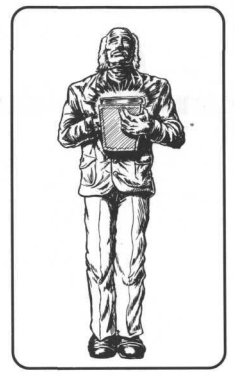
The Doubting Cleric is yet another template that's actually a character from the novel trilogy; in this case Father Christopher Bryce, who was the first ally and sort-of-love-interest for Tolwyn of House Tankred; he's the guy on the cover of the main book/boxed set. Presumably this template is set up the way it is so people can play the novels? Well, regardless there's not much to this you couldn't guess from the name. His starting equipment includes envelopes and postage for some reason, and his tag skill is evidence analysis also for some reason.
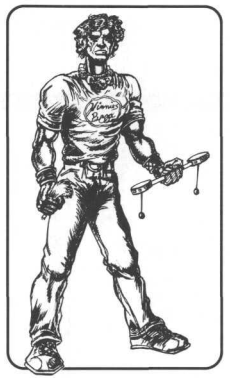
The Human Tribal Shaman has been hearing the voices of the spirits since he was a child, but unlike most he listened to what they had to say. They showed him, and I quote, "what the white man could no longer see, heard what he no longer was able to hear." The spirits warned him of the coming of the High Lords, and in response he began walking the world, helping those who would accept him. He starts with a war boomerang because of course he does, and his tag skill is conjuration magic since he was made at the start of the game line, even though two years later we learn that conjuration is really f'ing difficult.
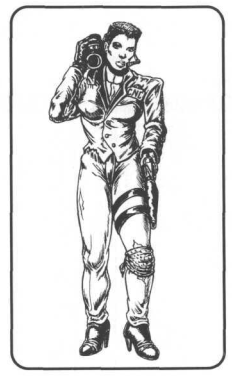
"Coming to you very much live and direct..."
The Intrepid Reporter has been on top of the invasion since it started. Why did Indonesia drop off the global grid? What really happened in New York City? Why did this self-proclaimed "Pope" choose Paris? That's what she's here to find out. And the only way to get to the truth is to get into the field and mix it up with the invaders. Yeah, her journalist's objectivity has gone out the window, but there's larger truths at play now. She starts with a news van, a camcorder, a Macintosh portable computer, Samsonite luggage, and her tag skill is persuasion.
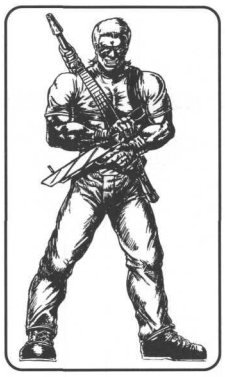
Let's rock, baby!
The National Hero started out as a sports superstar, but when that started to take its toll on him he was maneuvered by his hangers-on to shift into politics for their own ends. Despite his handlers, he still tried to do the best job he could, putting the people first. Attempts to discredit him by his former "allies" were cut short when the invasion happened, and now is serving in the field, rallying the people and inspiring hope.
quote:
"Times which need heroes usually get the heroes they need, but probably not the ones they want."
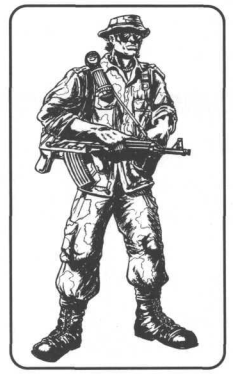
The Soldier of Fortune is just in it for the money. At least, he says he is. But once in a while, his morals shine through and he winds up "forgetting" orders or getting in his superiors' faces. This got him fired, so he began working freelance in Africa and wound up fighting against some wingnut proclaiming himself Pharaoh. Maybe now it's time to fight for something besides money. He starts with a bunch of guns, some stolen maps of Nile Empire installations, and $700. His tag skill is fire combat.
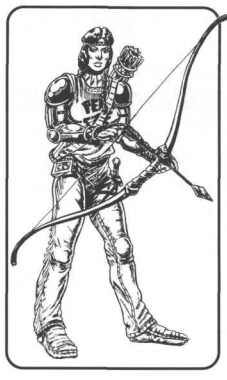
The Story Teller was always happy to hear the shaman tell his stories of the past. What she never expected was that she'd end up hearing the stories of the wind or the land told by the spirits themselves. They told her that her destiny to tell stories, to learn the tales of hope and spread them across the world to the people who need to hear them. She starts with a spear, a bow, clothes, papers, pens, a tape recorder, and a copy of "Winnie the Pooh". The reason I'm pointing out her full equipment list is because she's technically a Living Land character (and operates under those axioms), and even without being a follower of Lanala shouldn't be using most of that stuff. Her tag skill is charm and she has a terrible character quote.
quote:
"Time was different then than it is now... this is a story of that time."
The Delphi Council book adds a few more templates.
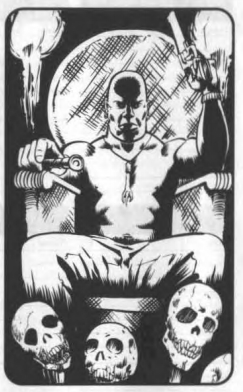
"I...am the Lord of Deadside.
The Haitian Bocor has been a faithful follow of
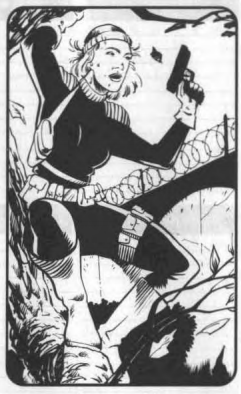
The Inform Agent is a member of a new Soviet intelligence agency that's formed from the remnants of the KGB in the wake of the Possibility Wars. She was part of the KGB up until the Soviet Union collapsed, and her skills made her too valuable to liquidate. Good thing, too, because now the Soviet Union needs to help Europe stand strong against the invaders. She starts with "nice clothing", a portable computer, and a Glock 17. Her tag skill is evidence analysis.
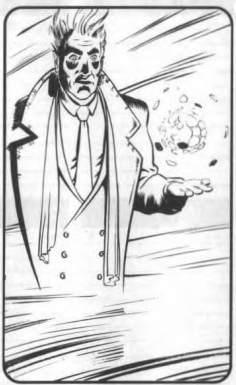
The Magic Practitioner has been studying magic his entire life. This has had a few obstacles, such as the fact that nobody else believed magic existed at all. Philistines. But now that the Possibility Wars have begun, and places like Aylse and the Cyberpapacy prove that magic exist, who's laughing now, eh? Yes, he's not that good at magic yet but it's really just a matter of time. He starts with a spellbook with only one spell of magic axiom 7 or less, as well as some "magic" props. His tag skill is divination.
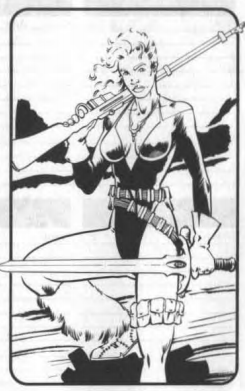
The Revised Realm Runner spend her entire life in the same space most people do when they bum around Europe for a year before going to college. She was more interested in seeing the world than settling down in one place. Now that there are so many more worlds to explore, she's discovered that being good at a lot of things rather than being awesome at one thing is a much more useful ability. She starts with a Sharps 1855 rifle, a GWI GodLight pistol from the Cyberpapacy, an elven longsword from Aysle, two trinkets from other realms, and a spellbook with two spells if she buys any casting skills. Her tag skill is reality, but she has access to skills that are contradictions on Core Earth for no real explained reason.
I hope people aren't upset that I'm glossing over most of the content of this book, but really it's pretty dull. The majority of it is either backfilling mechanics or updates on what's happening around the world. That said, another reason I'm not going into detail is because this book came out after all three of what I've been calling the SPOILER realms came out, and as such involves them pretty heavily. Most of the high points will be touched on when I do the last three realm books.
Speaking of which...it's finally time to begin covering the SPOILER realms! I know you've all been waiting with baited breath. We're going to start reviewing the latecomers with the realm that was late to the whole party, the one that was supposed to land in Russia but was repelled in Core Earth's first real victory, the one that was down, but not out...
NEXT TIME: In the grimdark present, there is only war.
Tharkold
Original SA post The storm has a name... - Let's Read TORG
Part 18a: Tharkold
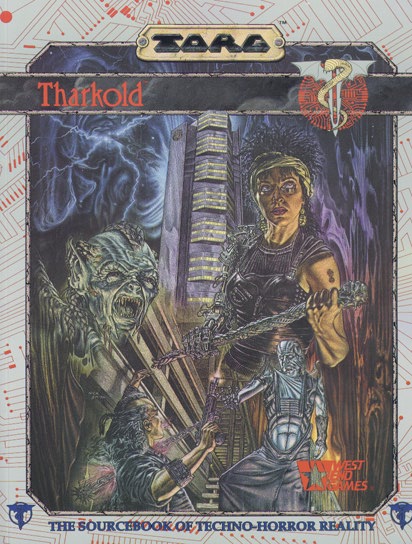
A horrifying beast, half-demon and half-machine, tears apart the leader of one of L.A.'s most vicious gangs with its bare hands. Slowly, the gang members bend knee to the technodemon and accept it as their new leader.
A squad of soldiers prepares an attack against a technodemon outpost. They're well trained, heavily armed, and have decades of military experience between them. None of them will survive, but they willingly lay down their lives for the greater good. Their sacrifice will accomplish nothing.
Two technodemons engage in a running battle through downtown L.A. to determine dominance over the other. The winner will control the cabals of both of them, the loser will be killed. The battle destroys five city blocks and everyone therein.
A three-thousand year old war has come to Core Earth, and has transformed Los Angeles into a nightmare of blood and metal. This is Tharkold, where only the strong survive, and the lucky ones are already dead.
A World of War and Techno-Horror
The world and cosm now known as Tharkold had another name once, but it's been lost in the mists of a three-thousand year old war.
Tharkold is another cosm that (originally) had strong similarities to Core Earth. But the fact of the matter is that now, nobody remembers what the world was like before The War.
Tharkold is home to two different species, each one convinced that the other is the invader.
One one side are the humans. Ages ago there were multiple enthicities and cultures, but after millennia of war (and forced breeding in slave pens) all differences have been bred out, and now humanity refers to itself as The Race. Now organized into the Free Nations, the Race fights a desperate battle for survival.
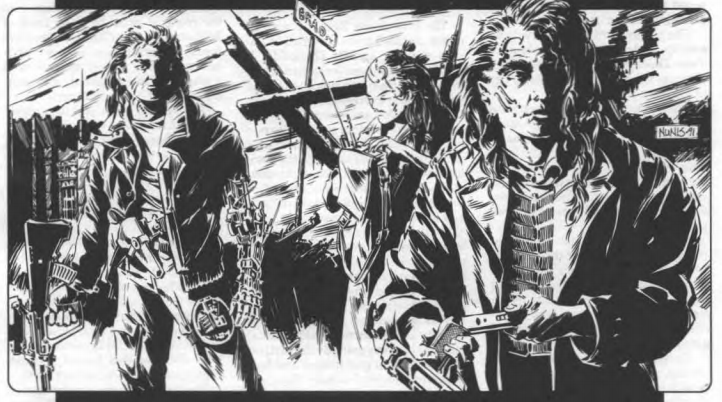
Typical Race soldiers.
On the other side are the demonic entities that call themselves Tharkoldu. The Tharkoldu are experts in both technology and magic, and their society is based on the concept of hierarchical dominance: the strong rule those weaker than themselves, and the weak are meant only to serve.
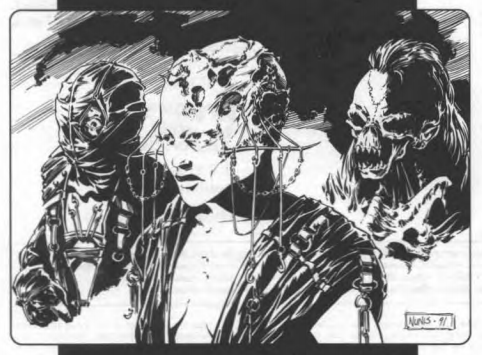
There are no "typical" Tharkoldu.
The Race and Tharkoldu have battled for supremacy for three thousand years, but despite the length of The War, everyone knows why it started and why it continues: survival. Humanity and Tharkoldu simply cannot coexist. The Tharkoldu see the Race as slaves at best, and as a pest to be wiped out at worst. The pendulum of battle has swung back and forth for generations, neither side able to maintain superiority over the other.
Unending battle has led to incredible advances in both science and sorcery. Cybertechnology exists, but is treated as a tool rather than a stylistic choice. Race corpses are animated through the use of technomagic to fight for the demons. Monstosities beyond description are summoned and let loose on the battlefield.
It is a war that has enveloped the world, a war with no chance of ending. And now, that war has spilled over to Earth.
The Fall and Rise of a High Lord
The Gaunt Man, as we all know, had a plan.
In order to take control of Earth and drain it of its unusually high reserves of Possibility energy, the Gaunt Man needed to bring in other High Lords to split Core Earth's natural resistance to an invasion across multiple fronts. His theory was that Core Earth's reality couldn't handle a simultaneous attack from seven invading realities at once, and would thus be ripped apart. He could then use that energy to become Torg.
One of the invading realities was known as Tharkold, a world where humanity had been fighting for thousands of years against strange demonic beings that called themselves Tharkoldu, but that humans called techno-demons. The High Lord of this realm was the techno-demon Kranod, who had been serving the Gaunt Man for centuries. Kranod was to drop a maelstrom bridge in northern Russia, and his failure here would end up turning the invasion into the stalemate we have today.
Because while Kranod was an accomplished military leader and High Lord, he let his greed get the better of him. Shortly before he was to invade Russia, he learned of the transhuman cosm called Kadandra and launched an attack on it. Unfortunately for him, while Tharkold and Kadandra were about equal in terms of technology, Kadandra's strength lay in its people being able to work as a unified whole. The invasion was repelled, severely weakening Kranod's forces before the main invasion. What's more, the Kadandrans had managed to instill hope and the idea of rebellion in the human slaves, an act which began to turn the eternal war more towards the damn monkeys.
But it's unknown if that failure would have had any effect on his invasion of Core Earth, because his invasion would be thwarted by the machinations of fellow High Lord 3327. As part of 3327's early excursions into Core Earth, the Kanawa Corporation invested in an abandoned Soviet psychic research project. The psychics managed to predict the location where Kranod would drop his bridge, and as a result a military detachment was able to destroy one of Tharkold's stelae just as the bridge was falling through the sky.
With the stelae boundary broken at just the right time, Earth's reality fought back and destroyed the bridge. In fact, the counter-attack was so powerful it swept up the connection back to Tharkold itself, wiping out all of Kranod's assembled forces in a flash of light.
For the Darkness Device known as Malgest, this was the last straw. Kranod clearly couldn't control his world anymore. Malgest needed to find a new High Lord to support.
And as fate would have it, one appeared shortly after Kranod's defeat.
As Kranod was attempting to decide what to do after his defeat by the Core Earthers, a human slave known as Jezrael chose that moment to attack her former master. Kranod wasn't concerned with this monkey slave's attack...until he felt the Possibility energy granted him by Malgest being drained away. The ancient Darkness Device had finally had enough of Kranod's failures in defeating the Race and invading other realities, and severed the link to the now former High Lord. Shorn of his Possibility energy, the technodemon was quickly dispatched by Jezrael, the echos of his own failure the last thoughts in his mind.
Malgest had found a new High Lord. One who hated the Tharkold who raised her as a slave, who hated the Race that were unable to save her, who despised her entire world. One who, in reality, hated existence as much as Malgest itself.
And less than a year after the beginning of the invasion, the "forgotten" cosm of Tharkold dropped a maelstrom bridge into the center of Los Angeles, heralding a new phase of the Possibility Wars.
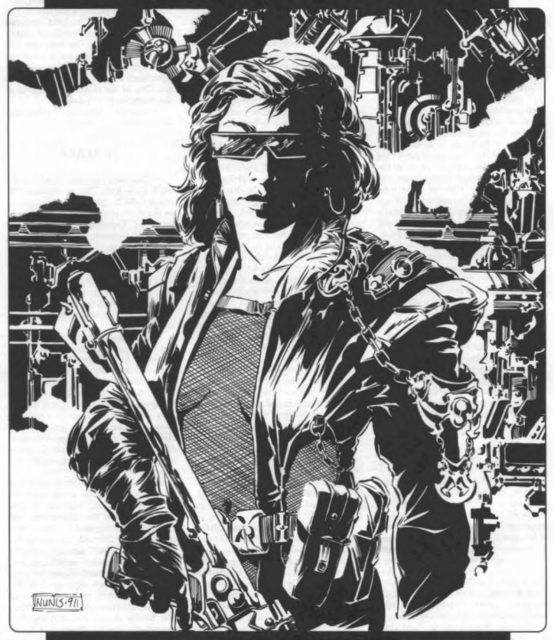
Jezreal, the new High Lord of Tharkold
Jezrael has wasted no time establishing herself as High Lord. Her list of goals is short, but require all of her skill and power to pull off.
Her primary goal is to achieve and maintain domination over the Tharkoldu. The demons are incredibly hierarchical creatures: there are 65 Demon Princes, each of whom maintains dominance over several hundred Demon Lords, each of whom held dominance over thousands of followers, and so on and so forth. As High Lord, Kranod maintained dominance and control over all 65 Demon Princes, and by extension the entire Tharkoldu race. Now that she's High Lord, Jezrael needs to earn dominance over the Demon Princes.
This would normally be much easier said than done, because despite the fact that she killed Kranod none of the Tharkoldu would be willing to bend knee to a lowly human. Jezrael isn't going to take "fuck off, monkey" as an answer, and shortly after rising to power she defeated the Demon Prince Krezlakh in single combat while her followers assassinated his inner circle. The Tharkoldu are learning the hard way that Jezrael may be better at their own game than they are.
quote:
It is enlightening that she never appeared to consider challenging the Demons' supremacy on Tharkold and allying herself with the free humans of the Race. The slave girl G-5473,having risen to rule the world, seems to consider herself a demon in all but the biological sense. She intends to dominate the demons. She intends to dominate the Free Nations.
Her second priority is to invade Core Earth. Between the failed invasions of Kandara and Core Earth, Malgest expended a pretty significant amount of Possibility energy with nothing to show for it. And without a fresh source of Possibilities to refuel itself, Malgest's hold on Tharkold will start to weaken. So Jezrael has inserted herself into the Possibility Wars, claiming a small territory on the west coast of the United States. Her realm is almost minuscule by invasion standards: a single stelae zone 100 miles to a side, wedged between Kaah's territory and the Kanawa Corporations holdings.
She chose this location for a few reason: the high population density gives her a better return on her investment when it comes to draining Ords, it's easier to get her power base solidified in a smaller territory, and she's in very close proximity to 3327's territory.
That last point ties to her third goal: revenge on 3327. Malgest is well aware that it was the Kanawa Corporation's financial backing of the Soviet psychic project that directly led to the destruction of the maelstrom bridge. Kranod had dismissed the suggestion that 3327's machinations would affect the invasion plans, and now that he's paid the price the Demon Princes are howling for Kanawa's head on a spike. Jezrael doesn't give a shit about 3327 right now, but she knows that part of getting control of the Princes means getting revenge on him.
It should be pointed out that Jezrael doesn't know about the legend of the Torg yet. Malgest hasn't passed that information along, because it wants to see how well Jezrael does establishing herself as High Lord first.
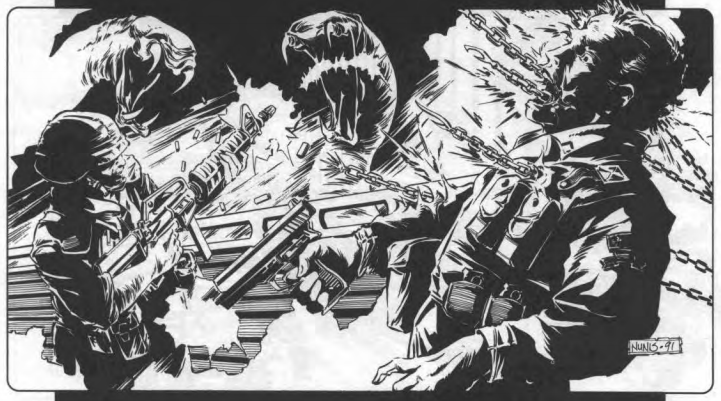
The rules of War are "whatever you can get away with".
World Laws and Axioms
As is the norm, let's finish up with a quick run down of the realm's vital statistics.
Magic axiom: 12 The magic axiom level has actually fluxuated over the centuries, starting at 9 during the beginning of the War and slowly rising and falling since then due Kranod adjusting the axioms. It stabalized at 12 about 80 years ago, and for some reason Kranod was never able to raise it any higher. Magic is more the domain of the Tharkoldu than the Race, due to the Race seeing magic as a tool of the demons. Magic knowledge isn't common, and any new spells that are developed are kept as secret weapons rather than disseminated to the populace. A unique aspect of Tharkold is the existence of technomagic, the binding of magical energies into weapons or cybernetics. Right now Tharkold is about equivalent to the Nile Empire in terms of magic: it's there, but it needs to be highly ritualized.
Social axiom: 20 While the social axiom of Tharkold is high (due to the Race coming together and uniting under a common cause) and only one point less than Core Earth's, Tharkoldu culture itself is rather primitive. The cyberdemons barely have anything approaching what we'd think of as art or literature; what they tend to have instead are epic poems or litanies of personal genealogies. Even among the Race, there's not really much of a culture outside of the needs of a military livelihood. Everyone is expected to fight, and even the most "liberal" of the Race nations is still a military oligarchy. It's worth pointing out that due to one of the cosm's World Laws, the social axiom is limited to 12 for non-violent social interaction.
Spiritual axiom: 17 The Race and the Tharkoldu each have their own religions, and unsurprisingly they're diametrically opposed to each other. The religion of the Tharkoldu is actually very integrated with the demons' use of technology for survival, leading to some very...unique miracles. The religion of the Tharkoldu is called the Cult of the Dominant, and any differing religions the Race may have had at one point have all ended up homogenized together into The Way of the Race. Like pretty much everything else on Tharkold, the War has pared down peoples' needs to the bare essentials.
Technological axiom: 26 The tech axiom of Tharkold is the same as the Cyberpapacy's, and as a result they have a very similar level of technological progress. There's a global computer network ("The Grid") that is accessed via direct neural interface, cybernetics exist, and weapon technology has advanced in leaps and bounds. What's different about the two worlds is their attitude towards their technologies. For example, in the Cyberpapacy cybernetics are treated as gifts from God and are designed as much for aesthetics as usability. On Tharkold, cybernetics are a tool, with form being a distant second to functionality; no chrome, just steel. For the Race, cybernetics are really more for veterans who've suffered massive damage but are too valuable to just let die than something you just go to a chop-shop and get. For the Tharkoldu, cybernetics are a method of expression: the demons love using implants to twist themselves into even more horrific appearances.
The constant drain of both side's resources has led to the development of AutoCAD technologies. The best analogy would be industrial-level 3D printing; factories will operate under computer control and manufacture goods from raw materials with minimal operator input. The operator selects a blueprint from a control computer, and the automatic systems do the rest. Note that "raw materials" here generally means "any scrap or wreckage you can get your hands on", as most of Tharkold's natural resources have long since dried up.
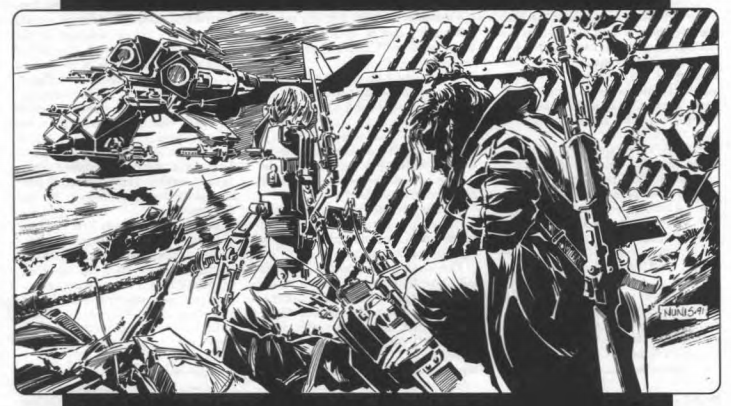
This is about as quiet as it gets.
There are three World Laws in Tharkold, and they're all pretty terrible.
First up is The Law of Ferocity, which rewards violent behavior for any reason. The basic effect is that characters always get a +3 to their intimidation and taunt results. Also, when dealing with people not of your nation (if Race) or pride (if Demon), you get +3 Willpower or Mind to resist the effects of the charm and persuasion skills.
In combat, when someone makes an all-out attack, they ignore any K or O results dealt against them until their next action. In addition, they cannot be taken by complete surprise.
A side-effect of the Law of Ferocity is the limiting of Tharkold's social axiom in non-violent interactions. While the general social axiom for the realm is 20 (pluralism, the birth of bureaucracies), in non-violent interactions the social axiom is limited to 12:
quote:
Social organization sufficiently robust as to assimilate conquered cultures rather than simply rule them. Societies may trade "cultural ideas" as well as hard goods. Credit and money lending established. Property is rented. Religions may institute a ritual bureaucracy or church, allowing religion to influence far greater numbers of people than before. Postal and news services are possible.
Related to the Law of Ferocity is The Law of Pain. Pain, as they say, is a great motivator; on Tharkold it's pretty good for the inflictor too. When someone inflicts pain on an enemy, they get to "bank" a free roll-again-and-add as if they'd spent a Possibility on the roll, including the "rolls less than 10 count as 10" benefit. This roll again result must be used within half an hour, and can't be used on the same target that the pain was originally inflicted on; you've got to spread the "love". Also, if your original attack kills the victim, you don't get the roll again.
Here's the thing, though: if the victim lives, then they get to bank a roll again result 24 hours later. This roll again can only be used against the one who inflicted the original pain, and has no expiration date. You can hold on to it for years if you want. As long as you have it banked, the person who inflicted harm on you can't invoke this Law against you again. Of course, once you use your roll again against your original tormentor, the roles reverse and he gets to bank a roll again against you. I think you can see where this is going.
There is only one situation where the Law of Pain won't kick in, and it involves the final world law, which is also the law that drives Tharkoldu culture: The Law of Domination.
quote:
"You may only serve one master. Its master is not yours, until it proves its worth as a dominant. Never bow before two.
"You may dominate as many as your talons can rake. Many may bow before you. Make them bow. Such is the wisdom of Omoo-Zhan"
- Krom-Ashur the Undying
It's important to note that "submitting" works different depending on the species. Between members of the Race, submission takes the form of a formal vow, but it's not very common. For Tharkoldu, submitting to another demon either involves a ritualistic statement and act of submission (basically a verbal statement of submission, followed by a lot of kowtowing), or by accepting a role in the breeding cycle as initiated by the dominant.
Oh, did I not mention that Tharkoldu are hermaphrodites, and breed through the use of domination/submission? Because they do. In fact, Jezrael has already impregnated one of the Demon Princes as one of her first acts as High Lord.
It's important to note that when a Tharkoldu defeats a human in combat and takes them alive, the human automatically becomes a submissive to the demon, but if a Race member does the same to a Tharkoldu then the Law doesn't come into effect. This is due to Kranod and Malgest adjusting the Law over several decades to favor the demons and make it that much easier to keep humans as slaves.
So what does all this mean when you put it together?
Tharkold is, when you get right down to it, nothing but a battlefield. War has all but erased human culture, and what little is left is dedicated to the battle. The world itself enforces a constant back-and-forth between both sides of the War, both sides suffering so many victories and losses the words become almost meaningless. The only reason the Race has even survived to this point is because Kranod enjoyed their suffering too much to just wipe them out with Malgest's power. There's no chance for peace, for understanding, for anything but battle. All there is is the War, and the War is all that matters.
And above it all, still grooming its new High Lord, Malgest watches both sides of the chessboard tear each other apart over and over again, and feasts on their suffering.
But the events that led to the downfall of Kranod have had a revitalizing effect on the Race. The slave pens grow restless. The humans fight back with renewed vigor. And for the first time, the Race can get help in the War from another outside force.
So pick up that rifle and get out there. This war isn't going to win itself. And remember: when you die, you die to ensure the survival of our whole species.
And yes: it's not "if". It's "when". You got a problem with that, soldier?
NEXT TIME: War. War never changes.
A history of violence
Original SA post The storm has a name... - Let's Read TORG
Part 18b: A history of violence
The first chapter of the book is about The Cosm of Tharkold, but really it's focused on discussion of the Tharloldu and the Race. And we start with the Tharkoldu, so get ready for some fucking :biothruths:.
The Thakoldu are, for wont of a better word, demons. They are naturally violent beings who gain psychic sustenance (and fun) from chaos and the pain and terror of others. As far as they're concerned, humans are prey. Period. Humanity's natural place in the world is to serve the Tharkoldu as slaves and food. The problem is that the damn monkeys won't accept their place, and instead of using strength or ferocity to defend themselves (as is right and proper by Tharkoldu thinking), they use tricks and treachery.
Tharkoldu instinctively resist the idea of a "central government", and as a result their governmental and cultural structure can best be described as "feudal clans". The most ferocious demons are in charge, but only if they can hold on to the position. From there, things operate in a sort of "domination pyramid"; all Tharkoldu relationships basically boil down to the concepts of domination and submission.
quote:
A pride is dominated by an alpha. All the demons in a pride are submissive to the alpha. This does not mean that the alpha has defeated all the pride members in combat. Many prides contain members who have voluntarily submitted to the alpha in order to participate in some activity at which the pride excels. For example, most powerful Tharkoldu magicians are alphas, dominating prides composed of their students and assistants.
An average pride contains 20 demons, all dominated by a single alpha. The largest pride has slightly over 100 members, and a small pride can consist of a single paired dominant and submissive.
A great alpha dominates a great pride, made up primarily of alphas. An average great pride contains 20 alphas. Thus, a typical great alpha indirectly dominates about 400 demons.
At the top of this weird-ass pyramid are the 64 Demon Princes. These are the ones who dominate the Lords (as well as their own retinues), and as such can indirectly command tens of thousands of demons. Two of the most powerful Princes, Trog Ammoz of the Scarlet Waste and Sterret of the Blades, each control over a million Tharkoldu each.
Technically speaking, the High Lord should be at the top of this whole pyramid scheme, but while the Princes submitted to Kranod (thanks in no small part to his Darkness Device) the majority haven't submitted to Jezrael yet.
quote:
There are prides that do not owe ultimate submission to a Prince, or even a great alpha. Some are outlaw prides, predators who prey upon other demons. Some are new prides, or prides whose chain of dominance has been broken by the death or conquest of a superior. Demons at all levels are constantly jockeying for more power. Every dominant, from the newest alpha to the most powerful Princes, is well aware that those who submitted yesterday are probably plotting against it today.
The reason given in the book is that the Tharkoldu are intelligent enough to override their instincts, even though they don't like it. Which...okay?
quote:
They can transcend their instincts. They don't like it, they don't do it unless they have to, but one of the tests of intelligence is the ability to overcome or sublimate instinct in order to achieve abstract goals. Demonkind passes that test.
Tharkoldu are also able to repress their natural instincts in pursuit of abstract concepts like capitalism or research. Of course, they're still built around the whole dominance/subservience thing so Tharkoldu tend to be pretty violent in their pursuit of these ideas. Economic contests turn into struggles for monopolies, with a few Princes controlling what little economic structure Tharkoldu culture has. As for science...really, most Tharkoldu technology comes from the humans. Humanity has had to advance quickly to survive in the War, and "properly motivated" Race slaves are the main source of discoveries on the Tharkoldu side.
Next up we go into Strongholds and Demesnes, which we mentioned a bit earlier.
quote:
Tharkoldu are territorial. Make that TERRITORIAL! Entering a demon's territory uninvited is a direct challenge and usually risks immediate and violent reprisals. Alphas, great alphas, and Lords establish their territory in strongholds. Princes dominate numerous strongholds in an organization called a demesne. There are 66 demesnes on Tharkold: 65 are ruled by the Princes. The 66th is Oris, the demesne of the High Lord.
A demense is more like a country, although they're much smaller than what we'd consider a country. The largest demense, Dzis, only has a population of two million Tharkoldu spread out over the world's equivalent of Africa and Madagascar. For reference, that's about the population of Nevada spread out over a whole continent.
It's also worth pointing out that demnses don't just house Demons. The global human population is estimated at 1.5 billion (it being hard to get an accurate count at the moment), and just under half of that number live as slaves in the demenses. To put this in perspective, the global population as I'm writing this in March 2017 is 7.4 billion. Dzis itself contains almost 60 million Race slaves, used for everything from mining to breeding stock to generate more
Which...brings us to Demonic Breeding and Population. And if you think this is gonna be uncomfortable to read, rest assured it's even more uncomfortable to write because you're just reading my summary. I had to read the whole damn thing.
So let's just get this out of the way: Tharkoldu are natural hermaphrodites, capable of either seeding or gestating a child. And how is it determined who in the relationship does which? That's right: through the line of domination! The dominant Demon gets to pick who's going to impregnate the other (the "Inseminator") and who's going carry the child to term (the "Gestator"). In fact, Demons who aren't in a dominance/submissive relationship can't conceive. It's also not unheard of for a dominant Tharkoldu to cement dominance though...
...you know what? I'm not going to finish that sentence.
While a Demon is pregnant, both the Thorkoldu in the relationship lose their hermaphroditic "abilities" (their word, not mine), even though there's no reason the one who impregnated the other would have to. The given explanation (which would be pretty much confirmed in the world history) is "because magic" so whatever. In addition, the submissive Demon cannot plot or betray the other because magic again.
Tharkoldu gestation takes 22 months, although after about 11 months the embryo is usually removed from the parent and placed in a magically-enhanced incubator on the property of a Tharkoldu lord or prince. Near as I can tell, this is mainly to keep the species capable of growth while still leaving as many Demons available for the War as possible. Tharkoldu are carnivores from birth, which may be another reason for the chambers. It's incredibly rare for a Tharkoldu to give birth to more than one child at once. We need to know all this because reasons, but the takeaway is that the Tharkoldu birth and population growth rates are far lower than humans'.
Oh, and just as an FYI: Jezrael has managed to impregnate the Demon Prince Krezlakh (the first Prince to submit to her) through a mix of techno-magic and metaplot. This is actually an "important" plot point later on down the line.
A Tharkoldu reaches physical maturity around 8-10 years old, and barring violence they'll live to about 150-200 years on average (Kranod lived for about 600 years, but he had the Darkness Device so that doesn't really count). Of course, "barring violence" isn't really an option for their species and world. The global Tharkoldu population hovers about 40 million, which is very low, especially compared to the humans. The main reason they've managed to last through the War is because even a 10-year-old Tharkoldu is capable of killing a small group of soldiers on its own. As far as the species is concerned, there's no such thing as a "non-combatant".
Jumping ahead a bit, the other reason is that, when the species as a whole is threatened, the Tharkoldu will form a "swarm" and rally around a central figure...without honoring the normal lines of submission!

 During a swarm, all Tharkoldu become focused only on the enemy. Old grievances, the concept of internal dominance, all that is put aside as the Demons focus all their anger on their enemy. Swarms are incredibly rare events, with the most recent being 600 years ago. In fact, the leader of that swarm was Kranod, was empowered by the Gaunt Man, and resulted in the military stalemate that's lasted until the recent ousting of Kranod.
During a swarm, all Tharkoldu become focused only on the enemy. Old grievances, the concept of internal dominance, all that is put aside as the Demons focus all their anger on their enemy. Swarms are incredibly rare events, with the most recent being 600 years ago. In fact, the leader of that swarm was Kranod, was empowered by the Gaunt Man, and resulted in the military stalemate that's lasted until the recent ousting of Kranod.And now we come to the religion of the Tharkoldu: The Cult of the Dominant. And it's disgusting.
quote:
"Omoo-Zhan, Progenitor of Demonkind, the self-begotten, Itself It bore, inseminator and gestator, within the womb of stars. Wings flaring, eyes burning, did Omoo-Zhan fly Its hunting dance among the stars. Talons tearing, fangs biting, did Ommo-Zhan seize Creation by the throa and bear it down. Before Omoo-Zhan, the Universe did bare the throat. Unto Gestator Omoo-Zhan did Inseminator Universe submit. And <She> bore many children from <His> seed, and we shall rule the worlds."
-From the "Kraznavekta"
WHAT THE FUCK??
Why? Why would anyone feel the need to make this up? I get it, they're evil! You pretty much established that when you had them fighting and enslaving humanity. What, were they worried we wouldn't "get" it without this little factoid?
Ugh, it's just...it's just disgusting. There's no reason and no excuse for this.
You know what? I'm not even going to cover this section, even though it's only four paragraphs. Moving on. Time to talk about humans.
Humanity on Tharkold is collectively known as The Race, and for the most part have been forced to become almost completely mono-cultural (and, in a manner of speaking, mono-ethnicity) due to thousands of years of war effectively wiping out the major cultural differences.
quote:
The Race is composed of human beings. Human beings who have survived three millennia of unending War. Human beings whose foes uses pain and terror as their weapons of choice. Human beings whose world is blotched with hostile wastelands, plague spots of technological and magical mass destruction. Human beings who have fought for six centuries against the power of a High Lord.
In other words, very, very tough human beings. Think of the human resistance in the Terminator movies. Then think of what they might be like after another dozen decades of warfare.
The Race places high value on the honor, bonds of friendship, and love, because those are the things that have enabled them to fight back against the Tharkoldu for so long. Which isn't to say that Race soldiers aren't capable of being as vicious or brutal as the demons; after all this is a war for survival of their species. But it's the ability to still maintain the concepts of trust and friendship that keeps the Race from becoming as merciless as the Tharkoldu. So far.
Unfortuantely for the Race, the harsh violence they need to commit to survive actually helps the Tharkoldu, because their fear and anguish that's just accepted as "the price of war" feeds the Darkness Device Malgest. In fact, the reason the Race has managed to stay in the War for the past six centuries is because Kranod let them. By allowing the Race to maintain their numbers and keep the Nations running, it was able to use the Race's emotional energy to feed Malgest and keep himself in power. Keeping the "monkeys" alive also provided the High Lord with a challenge, as well as a way to keep the slave pens fresh via what can best be described as "free range" humans.
Of course, this all bit Kranod in the ass when he failed in his invasion of Kadandra just before the start of the Possibility Wars. If the High Lord hadn't let the humans stay that organized, or if it'd taken the free humans more seriously as a threat, they wouldn't have been able to mount a decent offensive when the Tharkoldu bridges got destroyed (briefly turning the tide of the War) and Malgest wouldn't have abandoned it for Jezrael.
All that said, now that Jezrael has instigated a successful second invasion of Core Earth, it's entirely possible that she'll get enough P-energy and resources to conquer (or exterminate) the Race once and for all. But if she fails, Malgest would more than likely just abandon the world altogether; the centuries-long hold the Tharkoldu have on their world could finally slip, and the Race might finally be able to defeat the demons for good once the Darkness Device isn't in play. More than any other reality, the events currently unfolding on Core Earth are vital to the future of one of the invading worlds.
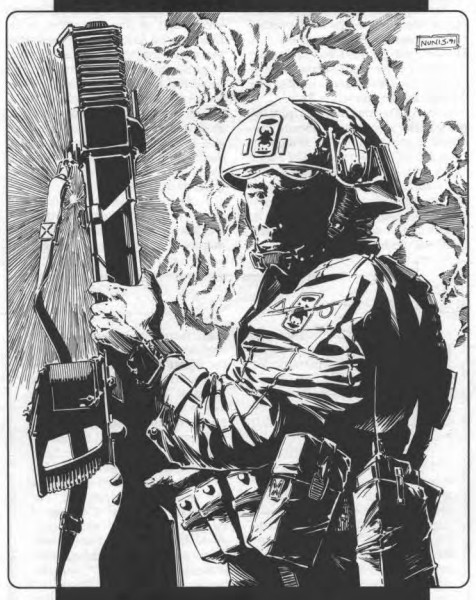
You see me now a veteran, of a thousand Tharkold wars
The Race are currently assembled into mega-enclaves known as the Five Nations. There's not a lot of detail about them, and they don't really have an effect on anything, but let's touch base with them anyway.
- Aurioch covers most of the "Middle East"; Israel, Syria, Iraq, and so on. Aurioch is the most technologically advanced Nation, and is run by a military council.
- Kham looks like a monarchy at first glance, but the "ruler" is really just a figurehead for the military high command. Kham is incredibly beurocratic and covers most of Africa.
- Helfei is where Europe is on Core Earth, and is really a collection of sixteen heavily fortified city-states. Each one is run by a warlord, but all six warlords meet to discuss policy for the entire Nation.
- Jhou is on the Chinese/Korean peninsula, and is the largest Nation in a geographic sense. This means that they're also one of the major targets for demonic forces. Jhou is a military dictatorship run by a single warlord.
- Mizatyan comprises the three islands of Japan, and while it's the second most technologically advanced, it's the most self-sufficient. This is because it's surrounded by the demense of Demon Prince Krothard Hellbear, whose stronghold is actually deep under the mountains of Hokkaido.
And now that we've gotten that information nobody cares about out of the way, let's talk about the "religion" of the Race, called The Way of the Race.
quote:
"And upon the mountain tops, the People slew many of the Demonkind, for the Will of the Race was to survive. And after the wrack of the battle, the People turned their faces to heaven, and cried aloud.
'Behold, here is Thy holocaust, oh God. We are the Race, and before us Thou shalt have no others. For we are a jealous people'..."
- Book of Liberation
The Way has no central religious structure (and thus no "universal" methods), and while each of the Nations are teaching from the same book (as it were), there are slight cultural differences in how each Nation's priesthood operates. The Way also exists among the slaves in Tharkoldu territory, but not in any public way.
quote:
The penalties for any slave found practicing the Way are ghastly, designed to terrify. At one time, the demons broadcast the hideous executions of those caught following the Way, to intimidate the other slaves. However, this practice ceased after the uprising of 2978, when the heroine Veda managed to invoke the miracle of liberation during her death agonies, turning her execution into the required ritual by sheer force of faith and will. Over 20,000 slaves were freed of domination and wrought
havoc on their former masters until the uprising was put down with enormous loss of life and property.
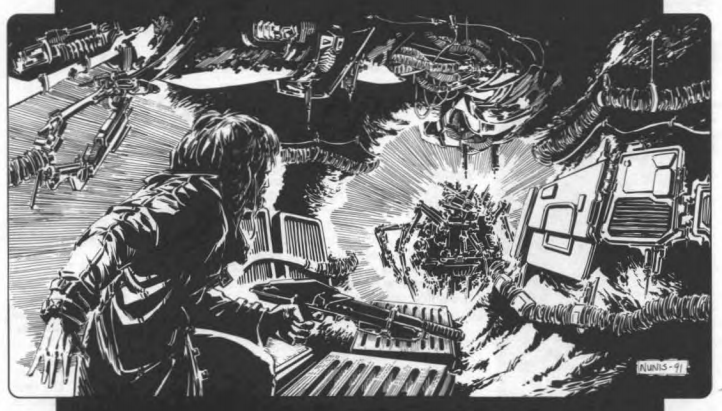
I don't know what's going on here, but I'm assuming it's bad.
And now it's time to talk about the history of the Tharkoldu cosm. Which is to say, it's time to talk about The War.
The War has been going on for 3,000 years. The first year of the War occurred in the equivalent of 1200 BC on Core Earth. For non-History majors, that's a little after the siege of Troy. This event was the first recorded clash between humans and Tharkoldu, but the book doesn't say if the Tharkoldu existed in the world before then, or if they invaded from another world, or what. Given that the only recorded history of the cosm starts at War Year 1, it's pretty likely that information's been long lost.
The attacks of the demons resulted in a rapid increase in human technological and magical advancement. The humans gained an early victory when an ancient king developed spells that were lethal to Tharkoldu but not humans. It would be 200 years before the demons developed an effective counterspell to swing things back to their favor.
In WY 483, the Jhou developed the first gunpowder weapons, and as a direct response to this development the Tharkoldu assembled into the first recorded swarm. This colored the path of the War for centuries to come: one side would develop a new technological or arcane weapon, resulting in a heavy reprisal by the other side.
The arms race swung back and forth fot 1,500 years, at which point an incredible holocaust known as The Spasm took place. Over the course of several weeks, both sides unleashed dozens of different weapons fueled by the high Technological and Magic axioms. Nuclear weapons were launched, bio-engineered plagues released, summoned elementals were unleashed, and magically created waves of madness swept across the face of the world. To make matters worse, magic and technology were combined to create major seismological events that destroyed continents.
But while the Spasm itself ended after a few weeks, the aftereffects lasted for centuries. Huge swathes of the world were rendered inhabitable to humans and demons alike. The seismic activity greatly increased the levels of earthquakes and volcanic activity worldwide. Really, it's a miracle (thanks to the high Spiritual axiom) that all life on Tharkoldu wasn't wiped out.
The demons made out better in the immediate aftermath of the Spasm due to being more naturally attuned to the needs of a post-apocalyptic wasteland; i.e. hunting in packs and working on instinct. The Race, on the other hand, were scattered by the events.
But once again, the pendulum of battle swung back to the humans' side. As both species crawled out of the wreckage of the Spasm, mages on both sides came to a shocking discovery: many of their most powerful spells no longer worked. While this was a bad turn for the Race, it was a far worse discovery for the Tharkoldu. The demons' metabolisms and breeding cycles were very dependent on magic. Tharkoldu numbers dwindled quickly as their birth rate plummeted, and the Race wasted no time in taking advantage of the situation. Demons were forced out of human territories and hunted down like animals.
It wouldn't be for another 700 years that the reason for this was discovered: Tharkold's Magic axiom was declining as a result of the Spasm. It was rapidly approaching a point where it'd be too low to support supernatural entities like demons. If the Race didn't end up wiping out the Tharkoldu, then reality itself would do the job for them.
quote:
At this time, the Tharkoldu had no knowledge of the cosmverse, of its Everlaws and Axioms. Before the Spasm, the art of magic had achieved great heights, and the demons still remembered much of what they had known. The recent rediscovery of computer technology allowed Tharkoldu to accurately model the levels of magical energy available to them. There was no possible doubt. If Tharkoldu could not find a way to reverse this trend, they were doomed to extinction.
A desperate plan emerged from a great swarm of scholars, magicians, and scientists. The Warlord Kranod, a mighty Prince and cunning mage, was given charge of the best minds Tharkoldu could produce. Kranod's task force constructed a technomagical probe, combining the forces of sorcery and the most advanced technology available to them. In 2314 the project launched a carefully programmed beam of energy from a secret laboratory in Kranod's stronghold. If their theories were correct, the probe would pass through a multi-dimensional matrix, and would seek out the most powerful source of magical energy within its range.
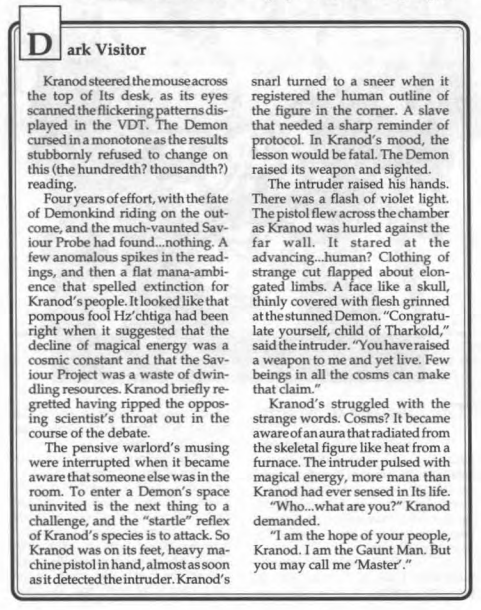
The Gaunt Man found the Tharkoldu facinating, and realized they would be a useful tool in his long-term goal of multiversal destruction.
Thus a bargain was struck: Kranod would submit to the Gaunt Man, and in return the Gaunt Man would prevent demonkind's extinction. Kranod accepted the terms almost immediately, knowing he really didn't have much of a choice. Within weeks the other Princes submitted to the Gaunt Man as well, and in return were rewarded with armies of horrors from Orrorsh.
It only took a few years for the demons to conquer the American continents. The supernatural forces of the Gaunt Man didn't need to rest and harried the humans non-stop, preventing the Race from getting even a second to mount a counter-attack.
But the Gaunt Man can't change his nature. While he kept his end of the bargain and prevented the Tharkoldu from dying out, he did so on his terms. He stabalized the cosm's Magical axiom at 7...but the minimum level for supernatural creatures to exist "comfortably" is 8. The Tharkoldu were still alive, but were being starved for the magical energies they needed to survive. Or, at least, survive without constant hunger and pain.
To solve the problem, Demons and human slaves developed a very clumsy technology known as LifeCyber. These surgically implanted technological systems augmented the demons' metabolism, allowing them to live in the low-magic reality. This was the birth of cybertechnology on Tharkold.
After a century of serving the Gaunt Man in other cosms, Kranod was on a mission for his master on an unnamed world when he heard a strange song calling to him. Following the "voice", he came across an ancient temple housing...well, more accurate to say trapping a strange onyx staff. This was the Darkness Device Malgest, and after an unknown time being locked away it was more than willing to bond itself with Kranod.
Returning to Tharkoldu with a Darkness Device of his own, Kranod wasted no time launching his own reality invasions. Kranod also began twisting his home cosm's World Laws and raising the Magic axiom back up to its original level. Because of this, the demons no longer needed LifeCyber to live, but cybernetics had become a common mark of power among the Tharkoldu and as such was central piece of the demons' self-image.
Kranod ruled the cosm for over 500 years as its High Lord, deliberately keeping the Race at a barely sustainable level for both his and Malgest's amusement. Then, finally, word came from the Gaunt Man: he had found a world richer in Possibility energy than any discovered before. Kranod was to join forces with a group of other High Lords to perform a multi-front attack on this "Earth". But Kranod's greed got the better of him, and he decided shortly before the invasion to get a quick reinforcement of P-energy from a world called Kadandra...
...and we all know what happened after that.
---
Man, look at all that shit you don't care about and that I wrote.
I realize I'm beating the dead horse here about how there's all this backstory for cosms that doesn't need to be anywhere near this detailed, but for some reason Tharkold's is one of the worst, and not just because of the rapey bits (although that's part of it).
Like, I get that, as a completely new race, we need info on the Tharkoldu and how they operate and everything. But the problem here is that the information is very unbalanced. We get a bunch of detail on the Tharkoldu and their society, but almost nothing for the Race itself. There's nothing about how human culture operates after three millennia of war, how the Free Nations get along, what the actual differences are between being from Kham versus being from Mizatyan. Once again, again, they don't seem to get the difference between what they think is cool or important about the setting, and what a GM or player would think is important.
We're not out of the fluff woods yet, though. We still have the realm to cover!
NEXT TIME: Mean Streets
To Live And Die In L.A.
Original SA post The storm has a name... - Let's Read TORG
Part 18c: To Live And Die In L.A.
Oh come on, don't give me that look. I had to say it eventually.
The chapter for the Tharkold realm begins with a generalized weekly timeline of the American invasion up to this point; specifically how Lost Angeles was affected since day 1. I'd ask why this is here but why ask why at this point.
I'm not going to run through every point (you're welcome), but let's hit some highlights.
quote:
Week Eight - The Los Angeles Dodgers announce their intention to play out their current home stand. They reduce general admission to $1.00. Home games are to be televised to the remaining LA audience. The Delphi Council issues a "terrorism advisory" for the games, urging the Dodgers tocall off the games and suggesting that fans travelling to the games might be killed. by unnamed. "forces hostile to the security of the United States." The Dodgers politely inform the Delphi Council that they will take the risk, and, under the watchful eyes of the LAPD and the California National Guard, the games go off without a hitch. The games are a desperately needed diversion for the city which had been completely spell-bound by the exodus along the interstates. The phrase "it takes a dollar and a Dodger" comes to symbolize courage during dark times.
Anyway, fifteen weeks after the start of the invasion, the L.A. government finally abandons the city. A Health Department official named Terri Bender declares herself mayor, and nobody objects because nobody else wants the job. At this point, the population of L.A. has dropped to about 400,000 people in the city itself.
Meanwhile, Ichi Entertainment opens a small film lab in the city, and shortly afterwards the Hachiman Arms company begins giving the remaining L.A. police forces experimental weapons for "field testing". Coincidentally, both these companies are owned by the Kanawa Corporation.
A few months after the start of the War, the L.A. gangs are running rampant. Then one gangs makes the mistake of attacking an Ichi Entertainment warehouse and 3327 ain't having none of that. Ichi Entertainment publicly states that they're going to put its North American headquarters in L.A. Privately, 3327 declares war on the various L.A. gangs. Within a month, over 14,000 gang members are killed.
A little under a year after the invasion, Nippon Tech agents manage to uproot the Living Land stelae around Sacramento and replace them with Marketplace stelae, turning Sacramento to Nippon Tech's reality. Since that's remarkably close to Core Earth's reality (and nobody knows about Nippon Tech yet), nobody realizes that a switch has been made; as far as anyone can tell, the Living Land just receded from around the city. Dubbed the "Miracle of California" or the "Miracle of Sacramento" depending on which sourcebook you read, and is hailed as a victory for Core Earth.
Perhaps seeking to ride on the coattails of the "victory", both the Cyberpapacy and Aysle send representatives to found embassies in the city. Understandably, the Cyberpapal Nuncio is a little less accepted than the dwarf from Aysle.
Jezrael's coup happens at invasion Year Two, Week Fourteen, and she almost immediately declares war on Core Earth and vengeance on Kanawa. She picks the Demon Prince Sterret of the Blades to lead her invasion force.
Sterret actually started by dimthreading into Russia, using magic to disguise himself as a human. He spends time studying Core Earth cultures and making his way towards L.A. Meanwhile, the city's population increases greatly, with a quarter of a million people immigrating to the city per week.
A year and a half in, the population of L.A. hits eight million. Gang activity continues to be a problem as Sterret dimthreads in with a few of his own operatives to start setting things up for the invasion. A rash of random, violent attacks start happening in the city as the techno-demons prepare the city. They start in the less occupied parts of L.A., but soon start moving out to areas like Beverly Hills and Granada Hills. Sterret keeps the Nippon Tech forces chasing each other by making it seem like an Ichi Entertainment courier was killed by a Hachiman Arms operative; this has the added benefit of getting Nippon Tech's forces to let up on the gangs. Sterret then starts recruiting (read: dominating) gangs so there will be enough believers to power the Tharkold stelae.
One year and fourty-four weeks after Kranod's botched invasion attempt, despite the best effort of a group of Storm Knights, Sterret manages to power the Tharkold steale. A maelstrom bridge drops squarely on Ichi Entertainment's headquarters in downtown L.A., technodemons and slaves pouring into the city. It was only a single stelae zone, 100 miles to a side, but it was enough. Jezrael had her foothold. Los Angeles was the new hunting grounds for the technodemons. Tharkold was back in the war.

The Tharkold realm, almost actual size.
One important thing to note is that the realm is ridiculously close to the Living Land. This causes a lot of reality storms due to the proximity of three conflicting realities, so on top of everything else the people in L.A. have to deal with reality-affecting superstorms. Even at the best of times there are days-long rainstorms that make the realm even drearier than it should be. This, combined with the pollution the Kanawa-owned companies have been spewing for the past year, make L.A. very rain-soaked-noir-ish to the point where there can be as much as a +5 to the difficulty of perception-related rolls.
Not that people are hitting the streets much. When Tharkold invaded, they brought along countless horrors and magictech devices and let them loose in the streets. One of the relatively lesser threats are the synthecyclers: autonomous truck-sized machines that scour the streets for raw materials for the Tharkoldu's factories. In this case, "raw materials" means pretty much anything inorganic that isn't nailed down. Street fixtures, cars, and rubble are all fair game.
But that's just the minor threat. The larger threats include the Tharkoldu (of course), cybered-up street gangs, the assorted monsters cooked up by the Tharkoldu, paranoid as fuck Kanawa security personnel, and trigger-happy LAPD squads who're not happy about being outclassed by pretty much everything.
quote:
The symbol of the invasion is the ruined Ichi Entertainment building. The 122-story structure is visible from virtually the entire city and much of the rest of the outlying area. During the day, winds whip about the building. clouds overhead darkening and congealing into wrong shapes, something which drips/twists around the building. At night small storms flare near the top of the building, spectacular multi-colored lightning striking ten or twelve spots simultaneously. The demons did this. The demons are inside.
Because they're latecomers to the War, the Tharkoldu hold on the city isn't as firm as they'd like. After over a year of battle, Core Earthers knew how to react to a reality invasion; on top of that, there are four other invading realities in or near the city limits leading to a tangled mess of alliances. The next section of the chapter is a rundown of each of the power groups in the city and what their goals are.
The main population of Core Earthers just want to survive. Leaving the city is a rough prospect, since the western Living Land cuts off all the direct routes to the rest of the States and the realm borders are held by the Tharkoldu. This has lead to some of the most vicious urban fighting anywhere on Core Earth, due to the one-two punch of the Law of Ferocity and the inhabitants of the city refusing to give an inch to the invaders.
quote:
Mayor Terri Bender represents the views of hundreds of thousands of Los Angelenos when she says "Hell has come to the City of Angels. We must pray we have the strength to honor our God in this, the first true battle of Armageddon. Most Core Earthers have an instinctual, spiritual repugnance to the Tharkoldu. Their repugnance, mixed with their fear, causes them to lash out against the invaders, rather than flee or submit. This reaction is certainly increased by Tharkold's world laws, such as the Law of Ferocity, which often increase the odds of a conflict.
The interests of the Cyberpapacy are represented by Nuncio Claude Eschlimann. Publically, he was sent to L.A. to open a Cybercatholic church and do good works, but really he was there to assess how deeply the Kanawa Corporation had gotten its claws into the city. This was a very uphill battle: between the Kanawa-owned media and the "faery-brat" (his term, not mine) Ellerby, Eschilimann became a laughingstock. Despite that, he still managed to get enough converts to keep things operating. Now that the city's been invaded by cyberdemons, the Cyberpapal outpost has kicked into overdrive. Eschlimann sees this situation as a straight-up holy crusade, and has refocused all his resources on fighting the Tharkoldu. Jazuits and cyberpriests have been flocking to the city in order to get in on the action. Malraux himself has tasked Eschlimann with capturing as much Tharkold cybertech as he can to be sent back to France for study.
While all this has been going on, the Living Land tribes are still within spitting distance of the edge of the realm. There are (as always) countless tribes, but the government refers to the larger "meta-tribes" via the regions they inhabit; the Topanga tribe, the San Gabriel tribe, and so on. About a quarter of the tribal population in the region is human. The edeinos have no love for the Tharkold (who the optants see as "walking dead things"), and the Tharkoldu like fighting the edeinos because the edeinos experience pain in ways humans can't. Plus they find the whole worship-of-life thing very unsettling. Currently, the tribes are in a shaky alliance with the Core Earth humans against a common foe.
The Kanawa Corporation had invested heavily in L.A. as part of 3327's intital expansion. Through various dummy corporations, Kanawa invested trillions of dollars into the city's economy, giving it a much-needed boost in the first phases of the War. Of course, none of that means jack shit anymore since Jezrael dropped her maelstrom bridge directly on Ichi Entertainment headquarters. With everything that's going on, Nippon Tech forces are mainly just trying to get a new base of operations set up and circle the wagons to get their California operations back in the black. Right now their biggest problem is that they underestimate the Tharkoldu due to not being able to understand the technodemons' overall goals.
quote:
While NipponTech admires Tharkoldu technology, Nippon's contempt for the demons backward social organization and their complete lack of a profit motive leads them to disparage their opponents: "Why don't Tharkoldu corporations ever show a profit? Because red ink looks better when it splatters." This disparaging view often causes Nippon executives to underestimate Tharkoldu abilities, with brutal consequences.
The Race has managed to get a surprisingly large number of operatives across the bridge by infiltrating the Tharkoldu's slave pens. Not that this was an optimal solution; since there's only one bridge and it's firmly under Jezrael's control any Race soldiers are completely cut off from their home cosm. This means that they're coming into Core Earth with zero intel on who's who and what's what. Right now the Race forces are just scouting out the situation and looking for potential allies. Unfortunately, their first pick seems to the the Cyberpapacy due to the perceived similarities. Regardless, for now the Race are staying low so the Tharkoldu don't know they're there.
As for the Tharkoldu themselves...there actually aren't as many there as you'd expect. There are only about 2,500 Tharkoldu in the city, under the control of Sterret, Prince of Blades. Jezrael knows better than to overcommit this time, but she wouldn't hesitate to send more Tharkoldu over if there would be a provable gain. Jezrael and Sterret both know that the invasion isn't successful yet: yeah, they have the territory, now the trick is keeping it. All it'd take right now is one uprooted stelae and the one-zone realm would collapse, doing even more damage to the Tharkold cosm and would probably make Malgest abandon the cosm altogether.
To make up the numbers, the Tharkoldu sent over about 16,000 Race slaves to perform the usual duties as workers, cybertechs, "pain sculptors" (whatever they are), cannon fodder, and emergency food sources. Sterret has managed to capture and enslave another 20,000 people from L.A.'s native population, most of whom were gang members. Jezrael and Sterret's current agenda revolves around getting revenge on 3327, getting more slaves to support the invasion, and defending the realm borders.
Lastly, the US Military has set up outside the realm borders. Just as the conflict with the Living Land was entering a "cold" stage, here comes this new threat they have to deal with. The army is under orders from the Delphi Council to only perform "morale building missions", which means night missions against lightly defended targets. The Council wants to be seen taking action, but in a way that doesn't harm
So there's all the major players in the city. At the time the book "opens", things are still pretty chaotic as the various forces adjust to the sudden invasion, but I think they manage to get the ideas across well enough it'd be easy to extrapolate forward.
The next part of the chapter is about the Areas of the Realm, which is another pre-Google era breakdown of the various parts of L.A. On the plus side, it's not a ridiculously detailed breakdown like we got with the Cyberpapacy book. Still, I'll be summarizing here.
That said, we're going to run into the Torg issue of "American life goes on", like how LAX is still operating despite the presence of two invading realities, or, as a further example, the situation in Cosmicland
quote:
While the program has been quite successful at so far reducing incidents at Cosmicland to a minimum, retaining skilled security personnel on the job has been a problem. As Quin Sebastian said, in an interview in Soldier of Fortune, 'I have endured Sahara sandstorms, Cyberpapal sermons, and edeinos "cooking," but working in the park was ridiculous. They pack you with enough firepower to level Ardinay's castle. then they pop you into this sparkling silver and blue hard plastic costume, concealing most of your goodies and making your sweat glands put themselves on their 'Niagara' setting. Chatter in your left ear is telling you how close to the park the baddies have been sighted, chatter in your right is telling you where other members of your unit are going. You are standing in a crowd of targets, scanning up, with some kid dripping ice cream in your boots, a set of parents "yoohooing" you for a picture with their brat, and some wise-ass kid shouting, 'I bet you guys don't even know that the Feral Four have their secret hideout in Tibet, do ya?' It was the last one that got me fired, when I leveled my Hornet 9mm at the kid and stage-whispered "Feral Four information has priority alpha, your possession illegal. You must be terminated." My bosses figured that wasn't part of the image of Strike Force Proxima."
Bellflower was abandoned way back at the start of the Living Land's invasion, and since then it's just been downhill. Those few who couldn't (or wouldn't) leave during the first invasion have had a hard time getting help. The city government has pretty much ignored them, and when the gangs started moving into the area only Nippon Tech was willing to give the locals the means to defend themselves. Things were more-or-less stable until Sterret showed up and started literally smearing people against the walls. In order to defend themselves, many Bellflower residents have begun getting cyberware installed at the various chop-shops that are springing up around the city. At present time, the residents have retreated to a small part of the district, set up walls and other defenses, and are hunkering down. This is their last stand, and they're not giving up their territory without a fight.
Beverly Hills has...changed a bit. The neighborhood had more than enough money and influence to ensure that they had more than adequate police protection during the Living Land's initial push. The idea of "homesteading" also started up; residents would "hire" desperate families from the other parts of the city and let them live on their property. In return, the family would basically be required to help maintain the property and defend the Hills. Still, a lot of people left after the first invasion (selling their property to various Japanese companies), but came back after the Miracle. Turns out they should have waited a little longer.
Burbank got hit pretty hard in the chaos following the initial invasion, and it still really hasn't recovered. Between the gangs, desperate squatters, and edeinos raiding parties, Burbank was written off by pretty much everyone. Everyone, that is, except Ichi Entertainment, who purchased NBC's facility just before the Miracle of Sacramento. IE was able to start producing content almost immediately, capitalizing on America's desperate need for entertainment following Kaah's arrival. Despite the Tharkold bridge dropping right on their goddamn headquarters, Ichi is still cranking out sitcoms and other shows.
Compton is, uh...well, it's a bad scene. I mean, Compton has always been a bad scene (especially from the early 90's point of view), but the situation now has actually shifted the local culture away from crime and towards mutual survival. Sort of.
quote:
When Los Angeles was evacuated for the first time, a minority of Compton's residents stayed behind ... as did many of the gangs. At first little changed; the gangs killed each other, and the gangs preyed on the residents. But the change in scale changed the conflict. The remaining residents could barely support themselves, let alone carry the extra burden of crime. As Compton began to die, the gangs realized. they were part of the problem. One result was a treacherous confederation, The Posse: a conduit for communication between the gangs, and a forum for disputes. Occasionally the disputes brought to the Posse were resolved without much bloodshed.
Downtown L.A. used to be the center of the municipal government before everything went to shit. It also contains Little Tokyo, Chinatown, The Museum of Contemporary Art, and Dodger stadium. While the government facilities were well-defended when the Living Land started getting close to the city, the rest of the region wasn't as lucky. This resulted in things like the MOCA being raided and about 75% of the contents being stolen. After the Miracle of Sacramento and the arrival of Ichi Entertainment, though, the area started experiencing an upswing in fortunes. Nippon Tech bought up most of the land in Little Tokyo and Chinatown, and quickly built up the Ichi Entertainment building. Things were looking pretty good up until the Tharkold bridge slammed down, at which point Nippon Tech left City Hall to fend for itself. Nowadays, this is probably the most dangerous part of the city, and yet Mayor Terri Bender continues to try and fight for her city despite the fact that City Hall is maybe ten blocks from the bridge.
Glendale was one of the more..."conservative" parts of the city. It was also almost completely abandoned during the original invasion. The whole area almost collapsed until resident Richard Clanton wrote to his (former) neighbors to convince them to return and "defend the way of life which has been so important to you for so many years." This somehow shamed people into coming home, and after the Miracle more people returned to their homes. Now that all these people had come home, when Tharkold invaded they decided they weren't going to be driven off their land again. Which has proven difficult, due to how Tharkold has affected the nearby Forest Lawn Cemetery. Forest Lawn is where the greats of the Golden Age of Hollywood were buried, and has recently been affected by a Tharkold nanovirus that animates the dead. As a result, Glendale is dealing with what might be the most awkward zombie problem in history: the corpses of people like W.C. Fields, Cary Grant, and Jean Harlow are up and shuffling around waiting to be blown away by Storm Knights. And while it's not a full-blown zombie apocalypse, these "lawners" are still a threat to the city.
Hollywood hit the skids back when the movie industry pulled up stakes and moved to Florida. There's only one film company left in the city: Forever Films, who've taken over the old Paramount Studios. Forever Films does indeed make movies (albeit low budget B-movies), but their main function is to be a front for Nile Empire weird science testing. In the meantime, Mann's Chinese Theater is still operating, although it's not quite the tourist attraction it once was.
Los Angeles International Airport is inexplicably still operating despite the fact that there's two invading realities within spitting distance. LAX is one of the biggest lifelines from the outside world, and as such is under very heavy security from the LAPD, local military, and Hachiman Arms CorpSec. Despite the high security, LAX only gets about a third of its normal traffic nowadays, and that's mostly goods transport and military planes. And really, if it wasn't for the constant influx of flights from Japan and China, it'd be a hell of a lot lower. Kanawa executives still come into the city to oversee operations, although they usually don't stick around that long.
Pasadena has had a weird time of it.
quote:
Home to the Rose Bowl and the annual Tournament of Roses Parade, Pasadena has died, revived and died again during the course of the Possibility Wars. The Rose Bowl is now closed,a result of government outrage at the last Rose Bowl game between USC and Michigan. When USC's starting tailback went down at the end of the season, the team decided to use a new "student," Matl-Kena, of the Topanga Tribe. Government officials asked that USC not field a team with an edeinos. The "first tailback with a tail" rushed for 226 yards against Michigan, a impressive feat considering she was almost never used on first down. Matl-Kena's sideline behavior wasn't helpful. She stripped off most of her gear whenever the USC offense left the field, ran amok in the stands, played one of the USC band's trombones very poorly, and generally made a mess of things. Getting her back in uniform during the exchange of possession explains why Matl-Kena almost never played on first down. The government was not amused; play at the Rose Bowl was banned. The Tharkold invasion convinced 90% of Pasadena's residents it was time to find another permanent address. Pasadena is one of the few empty areas left in the city.
Venice has actually had a bit of an upswing in fortunes due to the Kanawa Corporation discovering fresh oil deposits in the area. Venice had done well with the oil trade back in the 80's, but the Living Land invasion put a stamp on what was an already dying industry. Now, Kanawa is buying up the land and setting up "petro-complexes"; facilities that combine the functionality of an oil derrick, refinery, and manufacturing plant. Kanawa has also set up new housing (with CorpSec security) for the workforces that are moving into the region.
--
Wow, that's a lot of crap you don't care about, isn't it?
I mean, I know we've gone through this dance a bunch of times, but again: I don't need this level of detail. Give me some general ideas of things that're going on in the city, and I can extrapolate from there! Or at least, if you're going to do these district-by-district rundowns, at least make them interesting! There's only so many ways I can try to make this shit interesting and I used them up like four realms ago.
But don't worry; we're done with the boring-ass setting stuff. Now it's time to get into the broken-ass mechanics stuff!
NEXT TIME: The rules of battle
Basic Training
Original SA post The storm has a name... - Let's Read TORG
Part 18d: Basic Training
Now that the boring fluff is out of the way, it's time to get into the boring mechanics. On the plus side, the chapters are shorter now so I can get through the faster.
The next chapter is the obligatory Axioms and World Laws, which means it's time to quote myself again!
Evil Mastermind posted:
Magic axiom: 12 The magic axiom level has actually fluxuated over the centuries, starting at 9 during the beginning of the War and slowly rising and falling since then due Kranod adjusting the axioms. It stabilized at 12 about 80 years ago, and for some reason Kranod was never able to raise it any higher. Magic is more the domain of the Tharkoldu than the Race, due to the Race seeing magic as a tool of the demons. Magic knowledge isn't common, and any new spells that are developed are kept as secret weapons rather than disseminated to the populace. A unique aspect of Tharkold is the existence of technomagic, the binding of magical energies into weapons or cybernetics. Right now Tharkold is about equivalent to the Nile Empire in terms of magic: it's there, but it needs to be highly ritualized.
Social axiom: 20 While the social axiom of Tharkold is high (due to the Race coming together and uniting under a common cause) and only one point less than Core Earth's, Tharkoldu culture itself is rather primitive. The cyberdemons barely have anything approaching what we'd think of as art or literature; what they tend to have instead are epic poems or litanies of personal genealogies. Even among the Race, there's not really much of a culture outside of the needs of a military livelihood. Everyone is expected to fight, and even the most "liberal" of the Race nations is still a military oligarchy. It's worth pointing out that due to one of the cosm's World Laws, the social axiom is limited to 12 for non-violent social interaction.
Spiritual axiom: 17 The Race and the Tharkoldu each have their own religions, and unsurprisingly they're diametrically opposed to each other. The religion of the Tharkoldu is actually very integrated with the demons' use of technology for survival, leading to some very...unique miracles. The religion of the Tharkoldu is called the Cult of the Dominant, and any differing religions the Race may have had at one point have all ended up homogenized together into The Way of the Race. Like pretty much everything else on Tharkold, the War has pared down peoples' needs to the bare essentials.
Technological axiom: 26 The tech axiom of Tharkold is the same as the Cyberpapacy's, and as a result they have a very similar level of technological progress. There's a global computer network ("The Grid") that is accessed via direct neural interface, cybernetics exist, and weapon technology has advanced in leaps and bounds. What's different about the two worlds is their attitude towards their technologies. For example, in the Cyberpapacy cybernetics are treated as gifts from God and are designed as much for aesthetics as usability. On Tharkold, cybernetics are a tool, with form being a distant second to functionality; no chrome, just steel. For the Race, cybernetics are really more for veterans who've suffered massive damage but are too valuable to just let die than something you just go to a chop-shop and get. For the Tharkoldu, cybernetics are a method of expression: the demons love using implants to twist themselves into even more horrific appearances.
The high tech axiom also allows for the existence of The Grid, which is the Tharkold equivalent of the internet. Like the Cyberpapacy's GodNet, the Grid is a virtual reality experience that is accessed via direct user-to-computer wired connections. In an amazing coincidence, the Grid and the GodNet are mutually compatible; someone from Tharkold with a datajack and a cyberdeck can jack into the GodNet, and the same applies in the other direction. Despite this, it's important to realize that the Grid and the GodNet are not otherwise connected or similar in any way (for starters, the Grid isn't a pseudo-pocket-dimension powered by a Darkness Device).
As for magic; despite the decent magic axiom and the fact that the technodemons need magic to live, actual magic-users are fairly rare. Magic needs to be self taught (or you can submit to a teacher because we need to keep that going), and the only spells available are the basic spells from the core book and the "generic" spells from the Aysle sourcebook. Casters from Tharkold can learn other spells as they go along, of course, but for the most part mages jealously guard their knowledge since it's technically another weapon.
Oh yeah, and technomagic exists. A grimoire can be kept digitally, cybernetics can be enchanted, and so on. How does it work?
quote:
Technomagic is a product of the Law of Domination, bending technology to support and augment magic.

With the axioms out of the way, we get to the details of the World Laws. To remind everyone:
The Law of Ferocity states that when someone takes an all out attack action will ignore potential knockout results scored against them, and that the intimidation and taunt skills get +3 to their results. In addition, everyone gets a +3 defense bonus against charm and persuasion attempts.
The Law of Pain grants a roll-again-and-add when you inflict pain (as in actual wound damage) on someone.
The Law of Domination is that weird one that defines what happens and what you can/can't do when you formally submit to a master. This law has a page and a half of rules so forgive me for not re-summarizing beyond "it's hard to work against someone you've submitted to, also it's creepy".
With that thankfully out of the way, we can look at the new skills available to Tharkold characters.
First off, the flight skill from the core set is available to Tharkoldu characters. Which makes them the third type of character who'd ever need the spell. (The other two were pulp heroes with the flight power and wizards who knew spells that let them fly. Tharkoldu are the only one's who'd have a realistic need for this skill.)
Cyberdeck operation is used to access the Grid via a cyberdeck. Amazingly, despite being from a completely different reality with different technological standards, this works the same way as the skill of the same name from the Cyberpapacy. The same deal applies to the cybertech skill, which is used to build, install, and maintain cyberware, and the psychology skill, which is used to counteract the effects of cyberpsycosis, and the science (computers) skill, which is pretty much the same as cyberdeck operation only worse. So out of the skills presented here, four are from another book.
The first of the three actually new skills is occultech, which is basically the same as the cybertech skill, only it applies to demon-specific cyberware. In addtion to letting you install occultech, it also allows you to attempt to exorcise it. What this means is that you're trying to cancel the magical attunement that allows the Tharkoldu metabolism to handle the technology. It has to be used on occultech that isn't actually in a cyberdemon (mainly because it takes a day to do this), and successfully using the skill will "cleanse" the occult taint from the cyberware and allow it to be put in a human. On the flip side, the skill can also let Tharkoldu take non-magical cybernetics and attune them for Tharkoldu use.
The other use of occultech is to make vril batteries, which are special infinite powers sources that can only be created by Tharkoldu. Vril batteries are fueled by the life forces of P-rated beings as they are slowly, painfully killed. Because, in case you missed it, the Tharkoldu are pretty evil. And make sure we get it, there are detailed mechanics telling you how long it takes for someone to get turned into a battery, which I suppose would actually be useful when you want to have a "save someone before they get killed" scenario.
The second new skill is pain weapons, which is just a weapon skill for the new Tharkoldu weapon type presented in this book. Pain weapons are like normal weapons, only they have the potential to do spiritual stun damage, which is a thing from the miracle system back in the core book. The silly thing is that to use a pain weapon, you still use the normal melee weapon skill to attack with the Pain Weapon, then you make a pain weapons skill roll to see if you do the extra damage.
The last new skill is UltraCAD Operation. This skill isn't tied to a specific stat, but is added to a different skill when making something with an UltraCAD setup. So if you want to make a gun, you add this skill to your fire weapons skill.
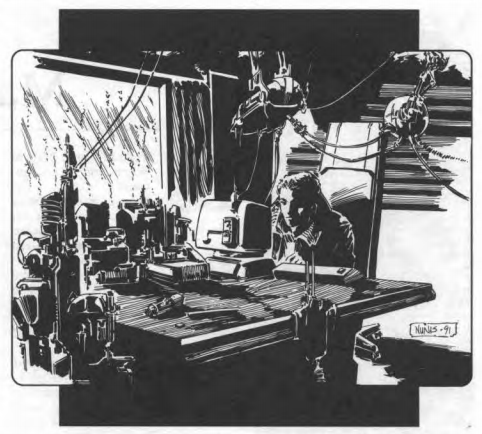
That's one way to keep your cables from tangling, I guess.
The next chapter is about Magic, which means we're about to get a list of spells. But it also means we're going to get a bit more info on occultech and technomagic. That's not as interesting as it sounds, because really it's just more BS about how the cosm's axioms mix together to allow technology and magic to overlap and how the Spasm altered the magic axiom and some spells are tied to the Law of Ferocity and who could possibly care stop explaining everything nobody fucking cares and this has nothing to do with anything.
Anyway we get a list of spells from other books that are available to Tharkoldu (and I would assume Race casters as well, but the book only mentions Tharkoldu), which is odd because this is the first and I think only time they've done this. Then we get into the new spells and once again I'm going to hit the highlights.
And boy howdy are these spells something else.
- Alpha Stech lets the caster transfer damage from themselves to anyone who's submitted to them. "Stech" is a Tharkoldu term meaning "to have others take consequences for you", in case you were wondering.
- Attack Dominant is a damage-over-time spell that does damage by changing the target's cellular structure. If they die from the spell, they melt.
- Corpse Keep is, AND I QUOTE: "actually two inanimate forces spells which have been joined together, one spell dominating the other." This spell lets someone move a corpse of someone they've killed to a pre-specified location. Note that I said "move", not "teleport"; the spell description says the corpse moves at speed value 12, but doesn't specify if it floats there, walks, ragdolls along the floor, or even what happens if it hits a wall or a door.
- Foeblaster does a bunch of damage to everyone within 40 meters (so 131 feet, or an approximate radius of a 13-story building's height) except the caster and anyone who's submitted to them.
- Flesh Captive requires two things: a slave locked up somewhere, and some physical remnant of the spell's target (like a lock of hair or something). You touch the remnant to the slave, and then any damage done to the slave is also done to the target, with a range of 1,500 km (~932 miles, which is 200 miles longer than the state of Texas) for one week. Oh, and the damage bypasses armor so fuck you.
- Laser Armor is actually what you'd think from hearing the name: it gives you armor made of lasers and not only acts as real armor, but causes your unarmed attacks to do more damage. For reasons unknown to magical scholars, Race casters get cobalt blue armor, and Tharkoldu get green lasers.
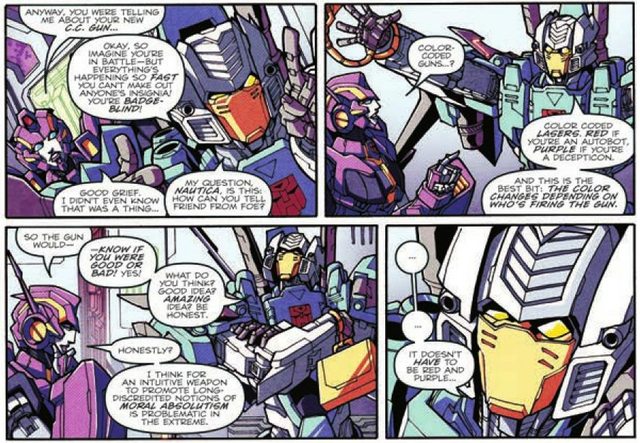
Transformers: More Than Meets The Eye #28, in case you're wondering
- Monkey Form and Monkey Mimic are very similar illusion spells that allow Tharkoldu to appear as normal humans. The difference is that Monkey Form doesn't let you look like a specific person, whereas Monkey Mimic does. Also this spell can only make a Tharkoldu look human, so you couldn't look like an elf or edenios or something.
- Pain Flip and Pleasure Flip are also similar spells. Pain Flip makes the target makes pain feel like pleasure, allowing the caster to suggest dangerous actions to the target that the target might do if they fail a willpower check. Pleasure Flip is the opposite; the target won't be able to do something they like without feeling intense pain unless they make a check. So basically they're charm spells.
- Pop is just a teleportation spell with a non-horror name that only works on the caster. The Tharkoldu actually have a different spell for teleporting human slaves, which is pretty much the same spell but it gets a seprarte entry anyway.
- Slave Tough can only be cast on people who've submitted to you, and to cast it "the caster has the recipient mimic his own actions. These actions are pantomime acts of speed, stealth, strength or hardiness." Succeeding at the spell increases the target's Strength and Toughness.
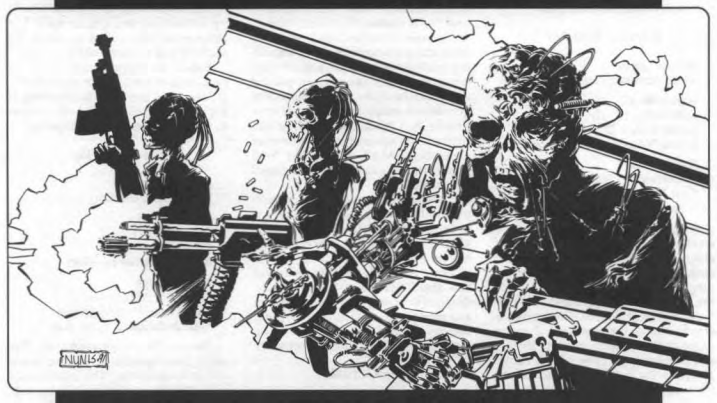
Oddly, no spells for creating cyberzombie soldiers.
The next chapter is Miracles, and they're divided into the two religions of the realm: the Tharkoldu's "Cult of the Dominant", and the humans' "Way of the Race". There aren't a lot of miracles listed for either religion, because in case you haven't noticed Torg doesn't think miracles are as interesting as magic. Oh, and there are also "cybermiracles" but we'll get to those in a minute.
One thing the book does mention is that due to the nature of the War, some miracles are "War miracles", which means they ignore the rules about casting miracles on people of other faiths. Which is to say, difficulty modifiers and the idea that you can convert someone if you roll high enough.
Since there's so few religion-specific miracles, I'll just hit them all. You're welcome.
The Cult-specific miracles are:
- Conceive is used to allow to Tharkorlu to...y'know. It's worth noting that for this spell to work, the caster's faith roll total has to exceed the Toughness of both the targets. That's the least creepy thing about this spell.
- Enslavement forces the target to become utterly obedient to the caster until the caster chooses to drop the effect. When given an order, the target must make a Spirit roll or do what he's ordered to do.
- Mark Prey is a ritual that requires a sample from the target. Successfully casting the ritual gives the Tharkoldu bonuses to tracking the target, increases the Tharkoldu's defenses from attacks from the target, and gives resistance to any interaction skills used by the target.
- Ritual of Power restores damage done to a Tharkoldu's faith skill.
- Temptation gives the caster bonuses to charm and persuasion rolls. The better the casting roll, the higher the bonus. If you succeed enough at the spell, you can break slavery/submission links.
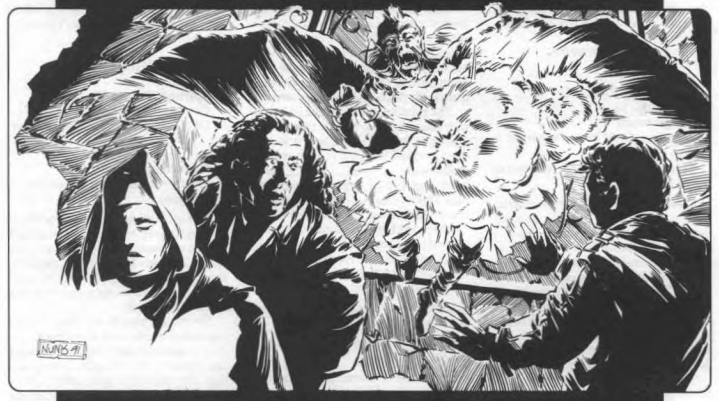
I like how the demon seems to be going "Oh shit my stomach blew up!"
The Race miracles are:
- Good of the Race is...uh...
quote:
This tragic miracle came into being during the various times in the history of the Race when a community could not afford to support anyone who would not contribute to racial survival. It was, and on occasion still is, invoked to test infants whose fitness is in question. The miracle will instantly and painlessly kill a baby that is too sickly to grow to healthy adulthood.
Apparently weak infants who survive this test frequently tum out to be possibility-rated in later life.
What's more insane is that this spell has no mechanic for determining if the baby is "fit". That was the entire spell description up there. Torg, a game that has mechanics for fucking ev-er-y-thing, doesn't have mechanics for this particular miracle.
But the more important question is: what is the fucking point of this miracle? Why would a character cast this? What kind of situation needs to have this miracle available? Why do we, as players or GMs, need to know this exists? Why mechanicize it? What is the point of it?
What's more insane is that no criteria is given for "worth". Is it checking the baby's stats? Reading its future? Basing things on the parents' DNA? Examining the community the baby was born into to see if there's enough resources for another person? Flipping a coin? Who knows!
Jesus...
Anyway. Back to the list.
- Liberation is a ritual that's performed via rousing sermon. This is another more-effects-with-a-better-success miracle, but the basic idea is that it breaks people out from submission, either from the Law of Submission or spell effects.
- Uprising works like Liberation, except that it gives everyone targeted by it combat bonuses against demons or slave troops.
- Will of the Race is an attack spell, with the added bonus of damaging the caster if he flubs the roll.
Lastly, we have cybermiracles.
quote:
Technology achieved mythic significance for the Race during the dark age that followed the Spasm. The technological wonders of the shattered civilization seemed like memories of a paradise lost. Ancient bits of technology were treated as sacred objects, and indeed, the preservation of such artifacts and of scientific texts helped hasten the Race's climb back from barbarism.
During the fall of magic, when the development of LifeCyber enabled them to survive, the Demons also formed a mystical perception of technology. Demons felt religious awe at the powers that allowed the contemptible humans to defeat them. Yet they also saw the salvation of their species as a sign that they were still the favored children of Omoo-Zhan.
Tharkoldu religion became linked to technology and both the Cult and the Way can perform cybermiracles.
Cybermiracles are all related to technology, cybernetics, and the Grid (Tharkold's cyberspace). Highlights include:
- Animate Cables is the technomagic equivalent of that D&D spell that animates vines, except that it only affects wires that the target is in contact with, or are in a machine that the target is in contact with. The better your success, the more cables animate, and yes they have their own stats.
- Cyberharmony has two uses. When used as a normal prayer, it stops a cyberpsychotic episode. When used as a ritual (which takes two hours a day, three times a day, for a week), it reduces the cyber rating of one of the target's implants.
- Killmachine lets the user animate a machine within the range of her voice and command it to attack anyone it can "see".
- Mechanization "transforms the cursed character into a gleaming, metal robotic version of himself. His eyes become glowing lights, his skin smooth chromed metal, his ears are radio receivers, and a NerveJack appears in the middle of his forehead." Sadly, the coolness factor of being turned into an 80's Trapper Keeper character is downplayed by the fact that the target becomes the roboslave of the caster. There's no way to resist the caster's commands, but at least the spell only lasts five minutes...unless a SlaveChip is installed in the target's forehead slot, in which case the effect lasts until the chip is removed.
- Souldeck lets you transmit your mind into any computer network as if you were using a cyberdeck. This works on any computer network regardless of its tech level, so yes you can take this to Nippon Tech and upload yourself into Kanawa's mainframes. However, since you don't have a cyberdeck, you can't use programs or upload/download files.
And that brings us to the end of this chunk of book.
--
Wow, that got dark quick, didn't it? Apart from That Miracle, again there's nothing really interesting here. It's just a lot of stuff that seems like it's trying to worldbuild but either doesn't add much (the skills) or give any sort of impression beyond "this cosm is creepy as hell."
I know I've said this before, but Torg always had a problem presenting and maintaing tone. And with Tharkold, since the subject matter is "darker" it gets so much worse.
NEXT TIME: Roll call
Soldiers and civilians
Original SA post The storm has a name... - Let's Read TORG
Part 18e: Soldiers and civilians
Now it's time for Characters and Creatures, the monster and NPC chapter. And as is SOP with Torg, all the major NPC are mixed in with the generic creatures instead of being listed out separately because God forbid we could organize this stuff in a useful fashion.
quote:
The chapter is arranged in alphabetical order. Unlike a telephone book, the human characters are listed first name first. You find the description of Mark Dyer under "Mark Dyer," not under "Dyer, Mark." Techno-demons, alphas, demon lords and other types of Tharkoldu are all described in the "Tharkoldu" entry. Individual Tharkoldu, such as Sterret, have their own entries.
That said, I'm going to do things a little differently this time and cover all the major NPCs first before getting into the generic monsters.
One of the reasons for this is the existence of Reality Solutions Ltd. RSL "investigative, trouble-shooting agency aimed at solving problems, no matter what reality they are from." Which is to say, they're freelance Storm Knights, going as far as being listed in the Yellow Pages. RSL consists of three people:
Abbas Sombol studied electrical engineering at the University of Cairo, but was expelled as part of a cheating scandal he was actually framed for by fellow student Sirhan Odemir. When Mobius landed, Abbas was put to work in a pharmaceutical lab under the management of "Dr." Sirhan Odemir. Abbas sabotaged the lab after learning they were making mind-control drugs, which was the moment he transformed and became a Storm Knight under Nile axioms. Abbas fled to L.A. and began working as the masked hero "Street Hawk", where he ran into Mark Dyer while investigating Odemir's attempt to create movies with hypnotic-suggestive film stock. Abbas and Mark founded Reality Solutions Ltd., and were instrumental in slowing the initial invasion (without them, the Tharkold realm would have been much larger out of the gate). And yes, he still patrols as Street Hawk.
Mark Dyer is a former member of the Army before being discharged due to an injury he didn't have (the X-rays got mixed up at the hospital). When the initial invasion happened, he was one of many civilians who took it upon themselves to run raids into the Living Land. Mark became a Storm Knight under Living Land axioms after a botched raid there.
quote:
Mark's mind nearly snapped with the transformation. Seeing life and the world as a Jakatt saw it was not easy for Mark, who was used to seeing life through advertising jingles, sloganeering and 10-second sound bites. His mind recoiled from the harsh spiritual reality of the Living Land.
Kreya Keena-Three is a soldier from Kadandra (remember that?) who specialized in destroying Tharkoldu stelae during Kranod's failed invasion attempt, and was drummed out of the military due to killing her superior officer during a cyberpsychosis attack. When the Kadandra leadership learned about Tharkold's attempted invasion of Core Earth, she (like Dr. Mara-Two) was sent there to help out. Unlike the good doctor, however, Kreya was sent through hacked-together replacements for Dr. Mara-Two's original gate tech because she was "useful but expendable". Like any Kadandran character (I think this is the second one ever), she's stranded on Core Earth with no way to get back to her home cosm. Kreya's making the most of it, battling Tharkold forces whenever she gets the chance.
Reality Solutions Ltd. is basically your "PC contact group". They're there to give Storm Knights in the area work, but apart from doing an important blink-and-you'll-miss-it task in the timeline at the start of the book there's no real details about what they actually do apart from "fight Tharkoldu".
But with that out of the way, let's look at the lead representatives of the various realities in the area. With one obvious exception, they're all presented as contacts and support personnel for PCs.
Terri Bender, as stated earlier, is the current mayor of Los Angeles because everyone else in the city's government fled when the invasion happened. Fortunately for everyone involved who matters, she's surprisingly good at her job. Not only has she held the city's infrastructure and the LAPD together, she's managed to keep pressure on the Tharkoldu and has kept Kanawa's involvement in the city to a minimum. The later was mainly just because of a weird feeling she had at first, but the three assassination attempts since then have kind of solidified her doubts. Terri makes regular walking tours of the city (despite the danger of Tharkoldu attacks) to make sure everyone knows that the city government hasn't abandoned them. Interestingly, Mayor Bender may actually be (unknowingly) using the Law of Domination to her advantage with the citizens; people seem to be fiercely loyal to her. This has a downside, though: if something happens to her, the city's will to fight back will pretty much fall apart.
Cyberpapal Nuncio Claude Eschlimann is Malraux's representative in the city. Sort of. He was shipped to L.A. due to his rapid rise through the Cyberpapal ranks, which is the kind of thing that ruffles the frocs of the people in the higher ranks. While his cover was to be a representative of the Cyberpapacy, his real job was to screw up Kanawa operations in the area. Eschlimann knew he was being set up to fail, so he made heavy efforts to convert the locals, stop Kanawa and, through that success, get assigned back to France. What he didn't account for was the American (and Kanawa-influenced) news system; while he's a handsome man and a good orator, he's incapable of performing even the simplest interview or sound bite without calling people heathens or saying they're going to hell. Things only got worse when Ellerby Quaff arrived as the Ayslish ambassador, because Ellerby was a) very good at humor, and b) took to the media like a duck to water. Ellerby turned the hate aimed at Eschlimann into mockery, which made the nuncio even madder. Then the invasion happened, and Eschlimann realized his true God-given purpose: to defeat these demons in the name of God, and to save the souls of everyone in the city. Given that his faith has only strengthened since the invasion started, he might be right.
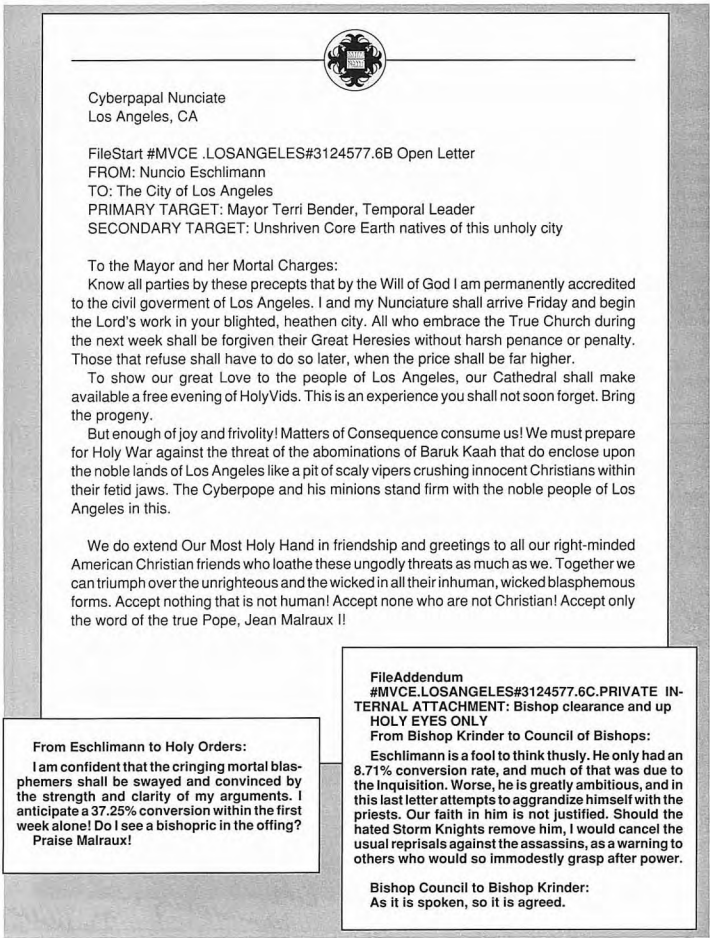
...or maybe he's just an asshole.
Ellerby Quaff is the dwarven emissary from Aysle. Ellerby spend over 300 years as a House Vareth slave, but a natural ability for humor got him "promoted" to jester. Fortunately, Ellerby was smarter than he acted (as well as having some magical talent), and made sure to listen in and remember as much as he could from the House's upper management. As a result, he was instrumental in helping slaves escape from the House's clutches. He escaped to Core Earth in the confusion of the invasion, and came to the attention of Tolwyn of House Tankred. Realizing that he was a natural diplomat, he was assigned to L.A. to represent Ardinay's interests. Ellerby quickly became a favorite of the local news media due to his quick, smart wit, which he usually aimed directly at Eschlimann. Post-invasion, Ellerby's job is to protect citizens of those Aysle stuck in the city by the invasion, either via shelter or getting them out of the city. Fortunately, Ellerby maintains a good relationship with Mayor Bender and the LAPD, so he's able to organize regular escorts out of the city. On a more personal level, Ellerby's main goal is to free the Race and human slaves who've fallen under the control of the Tharkoldu. He pays very handsomely for the elimination of technodemons.
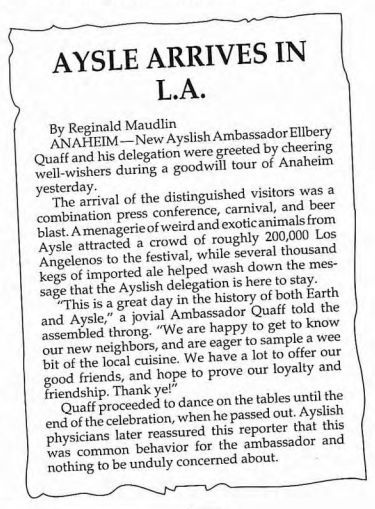
Always leave 'em laughing.
Yoshiko Nakata originally a computer security analyst back in Marketplace, Yoshiko joined Shiki after her company was gutted and cleaned out during one of the many corporate battles common in that cosm. She managed to steal enough money from a megacorp to buy herself the identity of Yoshiko Nakata; her original name and background are unknown and she prefers it that way. She managed to worm her way into the companies that were prepping for the original invasion, particularly the forces that were assigned to prevent Tharkold's original invasion in the Soviet Union. That got her a job at Ichi Entertainment's North American division as "Executive of Special Operations". From there, she helped prepare L.A. for the (then) upcoming Nippon Tech takeover of the city. When the Tharkoldu invasion happened, Yoshiko managed to retreat into a panic bunker, and has been coordinating outside forces (like Storm Knights and Reality Solutions Ltd.) from there. She ofter contacts Storm Knights as an anonymous source of info and/or jobs, and is willing to offer payment in Nippon Tech supplies. Despite all this, it's still unknown exactly who's side she's on.
And lastly, there's Sterret.
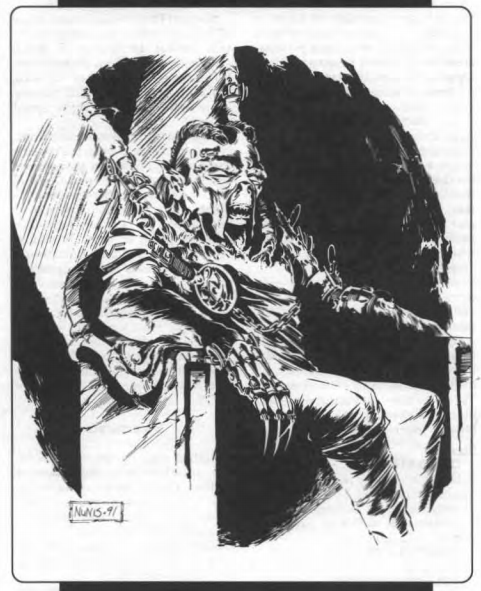
It's not my goddamn planet; understand, monkey-boy?
Sterret, Demon Prince of Blades is the only demon prince who's formally submitted to Jezrael, and as such has been granted control of the one million Tharkoldu involved in the invasion. Sterret submitted because it figured that the best way to learn how monkey-kind think was to submit to one. After all, Jezrael will more than likely fall just as Kranod did before her, so by keeping his position he can focus on the War and on wiping out the humans/Race. On top of that,
Sterret's main tasks are to expand the realm as best he can given the proximity of the other reams, and to destroy any Kanawa assets still in the city. Having run into Reality Solutions Ltd., Sterret knows that there's some sort of force from Kadandra on Core Earth, and is scouring the city to determine the extent of their forces. Really, Sterret wants to personally shred every member of RSL to death as slowly as possible, but it realizes that the larger goals have to come first.
It's this dedication to his actual tasks (as opposed to just inflicting violence and worrying about domination/submission politics) that makes Sterret so dangerous. Revenge is great and all, but it's not worth risking the bigger picture on. So it waits. It studies its enemies, and once the Tharkoldu power base is more secure will it strike on a more...personal level. Sterret is also dedicated to learning as much about human culture as it can in order to learn how to defeat it; it spends a lot of time in a magically-created human disguise, just...exploring the city. You know, meeting and talking to people, trying food, listening to music or taking in a movie. Touristy stuff. The more Sterret learns about humanity, the more he wants to see us wiped out.
So that covers the major players. Now for the generics! And while we do get generic stat blocks for Tharkoldu of various statures, the LAPD, and such, there are some very...odd creatures thrown into the mix. The problem with a lot of these creatures, though, is that no context is given for them. In the other cosm books, you can at least get how the mosnters fit into the ecosystem or there's a handwavey explanation as to why they're there (like how Baruk Kaah brings in monsters from conqured worlds into the Living Land). But these...they're just there. They're not described as bioweapons, or natural beasts, or whatever. They're just ideas slapped together to be things you can fight.
Bloaters are four-legged scrabbly scorpion-y things about two feet long, covered in an exoskeleton which is in turn covered with natural camouflage spots so it can hide easily. The thing is stupidly fast (it can run 100 meters/round in five-round bursts, which maths out to 22 miles per hour), although its preferred method of attacking is to drop on or leap onto its prey. Once it does so, it makes four simultaneous attacks (one with each limb, using the Many-On-One rule); if it hits hard enough it latches onto the victim. Then it injects the poor shlub with poison that rots his flesh for six rounds, at which point either the toxin wears off or the guy's dead.
Bochdogs are large (3 feet at the shoulder, 450 kg) dog-like beasts that hunt in packs and have some minor, instinctive magical talent. The talent manifests as strengthened armor-like fur, the ability to fire lightning, and a magical howl that disrupts electronics and cyberware.
Darkfangs are creatures of living darkness. They have a manta-ray-like "travel form" and an ogre-like "battle form", and can switch between the two as a simple action. They attack with claws and fangs that completely bypass armor, even magical armor, unless you enchant it with light spells. They can also use shadows to bind or blind opponents. As if that wasn't enough, on a successful attack darkfangs can inject victims with a venom that has a few possible results, such as the target losing any adds they have in the faith or focus skills, or being unable to take actions until they succeed at a skill roll to shake off the effect. At least the venom only lasts for a minute.
Direwings are...uh...
quote:
A direwing is a flying monstrosity that is actually made up often eel-like creatures. The individual creatures are known as tubucules. Each creature starts its life identical to every other tubucule. They each retain their mouths and digestive tracts after joining to form the direwing, but organ specialization starts soon after joining. For example only three of the tubucules accelerate the development of the optic nerves to form eyes.
The tubucules join to form a knotted central mass. The central mass is further joined by veins, arteries, organ nodules and sensory organs that developed as the tubucules specialized to from the direwing. The mouths of all ten tubucules dangle below the central mass, while five tails emerge from the left dorsal and five tails from the right. Membranes are grown to form wings, and the hideous amalgam can fly at seemingly impossible speeds.
Anyway, direwings get to make up to ten separate attacks each round against up to four targets without worrying about the One-On-Many penalties. On top of that, they can regenerate after you kill them.
quote:
Each wound a direwing receives kills one tubucule. Four wounds kill four tubucules, and the direwing "dies" and cannot takes any more action as a single entity. With a wet popping and cracking, the central knot unravels and falls apart, but the remaining tubucules are still alive. If four or more remain alive, they sporespray any dead tubucles.
Sporespray carries DNA-encoded instructions which reconstruct the dead tubucule. One tubucle can be revived each round. The tubucule take no action until seven tubucles are alive. They then reform the direwing. A tubucle may participate in a sporespray only once per day. A direwing could therefore sporespray at most twice in a day, and once is far more likely.
Flensers do what they say on the label. These are spindly humanoids with triangular heads and long claw fingernails. Or at least, that's their native form, which is rarely seen; flensers are able to absorb the forms (and memories and skills) of their victims. This process takes three paragraphs to describe, and involves magic-infused nanotech, liquid metal, and other stuff you don't really need to know. The process takes 100 minutes (nice round number there), and to make matters worse flensers can "store" as many as 150 different forms, and can switch between them as a full-round action with a magic roll. It should be pointed out that flensers were created by the Tharkoldu, who lost control of them short after their first field deployment.
Forcefoots are huge hair-covered humanoids that live by ingesting "inanimate forces", which they can absorb by touching the source of. They normally keep to themselves, but because they're naturally drawn to energy-producing facilities, the Tharkoldu and Race have hunted them down since even a small pack of forcefoots can shut down a major factory. They're called forcefoots because they have a stomping attack that does mental damage to everyone in 25 meters. They're also capable of generating defensive force fields, scrambling sensors, and shutting down electrical equipment.
Gangslaves are Core Earth gangbangers who've fallen under the control (willingly or unwillingly) of Sterret. Sterret was very busy pre-invasion dominating gangs, and there are currently over 25,000 gangslaves under his control. Only 10,000 or so have actually been kitted out with cyberware (or slavechips), but the numbers are still there. The "elite" gangslaves are called CyFlyers, and they're the ones who have a high capacity for cyberware; as a result they're chromed to the gills. Most other gangslaves are just loaded up with high-tech weapons and pointed at targets.
Ghuls are corpses that have been animated by Tharkoldu technology. The corpse is controlled by a nanovirus called Relictin-V, which the Tharkolu like to spray-bomb onto battlefields after the fight's over. As long as a corpse has any level of connective musculature or tissue, it'll rise an hour after the virus makes contact. From there, the ghul acts as a standard-issue Romero zombie: a fairly mindless hard-to-kill monster fueled solely by hunger for living flesh. If a ghul doesn't feed for a few hours, the virus will run out of power and the ghul will fall apart. However, since the ghuls are also carriers, anyone killed by a ghul will be infected and rise as a ghul themselves. The more of a corpse a ghul eats, the stronger it gets; in fact, a fully fed ghul can retain enough of its mind to be able to lay traps or lure in fresh victims.
https://www.youtube.com/watch?v=lRcle-JgnFA
It's important to note that the Tharkoldu's use of Relictin-V has become so prevalent, the Race now requires that every human corpse must br cremated, even in the field, and has outlawed every other funerary practice to prevent ghul outbreaks. The Tharkoldu have gotten around this by mass-killing their own slaves.
Jake Nori is a monster, but he doesn't play one on TV. He's the host of the hot new game show L.A. Challenge, which is basically Running Man but without the safety compliance. The show works like this: desperate citizens are recruited to try and overcome a set of challenges set up throughout the city. You know, simple things like spraying anti-gang grafitti in a gang's turf, driving a motorcycle through Tharkoldu-controlled streets, things like that. The prizes range in value from $5,000 to a million bucks, paid out to the contestant's next of kin as needed.
Jake himself comes off on-camera as a happy, sympathetic guy, quick with a joke or truly sorry for the loss of a contestant, just trying to make the best of a bad situation. In reality, Jake's a completely amoral shitstain who's only interested in himself and ratings. This is a man who arranged for the kidnapping and execution of his sister's kids to generate sympathetic media coverage, so you know Kanawa lapped him right up.
Jake knows why everyone's watching the show (i.e., to see some poor shmuck get violently killed), so he rigs the contests for maximum carnage. For instance, with the tag-in-a-gang's-turn challenge, he'll let slip to the gang that someone's going to be in their turf at the appropriate time. His goal right now is to get some Storm Knights on the show, since that'd be a huge ratings boost. L.A. Challenge is backrolled by Ichi Entertainment (off the books) and doesn't air on normal television. Instead, it's distributed through "private" channels, with the unedited versions going to high-paying "connoisseurs" around the globe.
https://www.youtube.com/watch?v=xStvfbIddM0
Jackwraiths are the ghosts of hackers who died in cyberspace, twisted into madness by Tharkoldu magic. They attack foes by probing their memories, and creating illusory worlds based on their fears and nightmares.
The LAPD is, well, the LAPD, only with better guns.
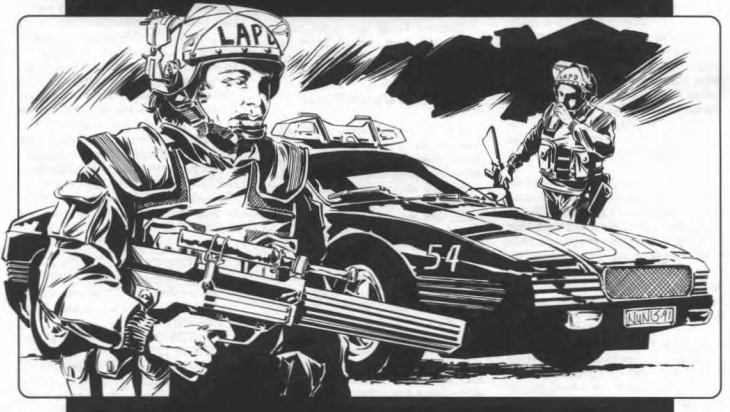
Note that this book came out about six months after the Rodney King riots. Just sayin'.
Loons are...uh...
quote:
The Loon's natural form is a knobby mock-orange body, resting atop three bristly legs, with double-jointed ankles ending in stubby-toed feet. The loon has two arms, which are too short to touch its hips. Its mouth and nasal passage are nearly identical, stacked one above the other and set directly into its body. It has three eyes, a large yellow eye which gives it the best image, and two smaller black-and-white eyes set far apart on either side of the yellow eye. These are used solely to help the yellow eye judge distance and depth. The loon makes a gurgling, whooping sound when it is frightened, which is most of the time.
Necros are small flying beasts that "resemble a cross between a vulture and an armadillo". They're carrion feeders who make sure they have a decent food supply by manipulating people into getting killed. They're smart enough to know which beings in an area are the local apex predators, and a flock will lead them to weaker prey. They'll also perch in obvious places to basically intimidate people into going into dangerous territory. Even worse, they're smart enough to mix things up once in a while (tricking people into safer paths, for instance) to keep prey off-balance. They have enough inherent divination magic to be able to track prey from up to 100 meters away.
Quon are small(ish) little hunter things that look like scorpions. They seem to be a manufactured critter, because they have liquid metal blood. This nanoblood or whatever it is allows quons to regenerate at a pretty surprising rate. As an action, a quon can make a repair roll against itself, removing damage based on the degree of success. It's tail-stinger is actually a drill with a diamond tip that can hit 3500 RPM, yet only does as much damage as a composite bow.
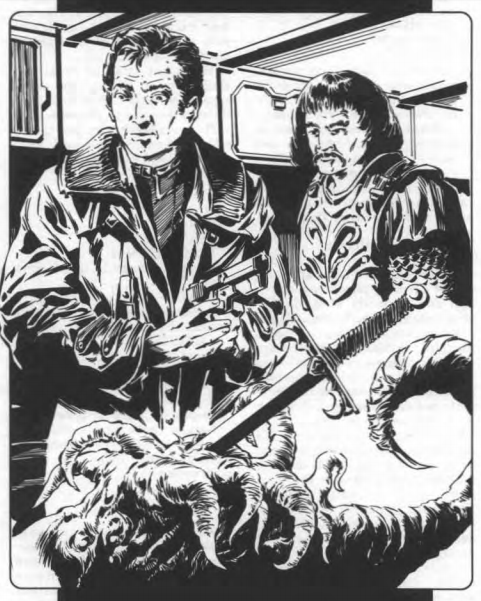
Whosoever pulls this sword from the facehugger...
Shrilleeches are non-corporeal, invisible leeches. No, really. It feeds off the soul of whoever it's attached to, doing very slight spiritual damage. It's only one shock damage every SCENE MISSING, but the real danger is the magical shrieking it emits, which can only be heard by entities (such as Tharkoldu).
Skats are (and I quote) "small rocket-propelled pterodactyls." They can fly at Mach 1.4, and use sonic booms to soften up targets before swooping in to attack. Since they like to hunt in packs, this is pretty rough since in addition to deafening enemies they also have strafing lasers. And while they seem to be robotic, it's mentioned in passing that they feed on their kills. And of course, since this is Torg we have to have creature-specific rules for tricking skats into thinking you're dead so you can lure them into attack range.
Spinners also have a really dumb description.
quote:
Spinners look like short bearded dwarves whose eyes have been covered by cobwebs. Their fingers are tapered, nearly twice as long as normal dwarf fingers. The fingers end in spinnerets which can shoot strands of web up to 60 meters. Spinners use their missile weapons skill to hit targets with their webs. Once victims are firmly enshrouded, the spinners egg each other on until a few of them gather the courage to beat the victim to death with their clubs.
Swarmrats are...uh...rats that come in swarms. These are Tharkold-native rats, which means they've been mutated by magic, fallout, and god-knows-what-else. There's some mechanics for rolling up swarm size (because of course there are), so a swarm can range from 10 to 250 rats. The biggest problem with swarmrats is that they have a hivemind, and that's a problem because (again, being that this is Torg) there are mechanics that apply to individual rats, mechanics that apply to groups of rats, and mechanics that apply to the entire swarm. See, while each individual rat has its own physical stats, they also operate in "cells" of 10 rats, which has a Toughness stat that overrides the Toughness of the individual rats. On top of that, a swarm's mental stats dependent on the number of cells involved. It's unnessesarily complcated, but that's what happens when you try to use the Torgian "the rules are physics" mentality to try to model a swarm creature.
Synthecyclers are a huge pain in the ass for the inhabitants of LA, especially those who part on the side of the road. They're autonomous drone vehicles that are programmed to wander the streets, hunting for things to break down into raw materials. Once they have enough materials, they head back to their preprogrammed destination so the materials can be used in AutoCAD manufacturing. Thing is, "things to break down into raw materials" includes people. While it's easy for a 'cyler to grab a pile of rubble or someone's motorcycle, it's just as easy for one to run down some poor shmuck on the street and, well.
quote:
A synthecycler may attempt to run over a character. An overrun uses the synthecycler's land vehicles skill to hit. The reclaimer (a synthecycler's "mouth") is located at the front of the creature. The reclaimus "lips" are a weave of ceramic. metal and synthetic fibers that can expand to fit around the object being reclaimed, the same way a python dislocates its jaw to swallow a large prey.
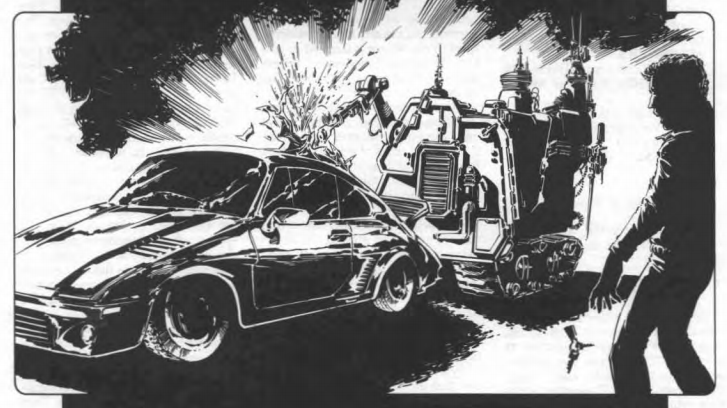
Ooooh, my caaar!
And that's it, apart from talking about Tharkol's gospog.
Gospog don't see a lot of use by the Tharkoldu, due to the combination of the cyberdemons wanting to do their own hunting and the fact that Tharkoldu see corpses as a food source. Yeah there's the gospog field in Anaheim, but it's just starting to crank out second-plantings. Really, the gospog are more for a show of power than anything else.
- Second-planting gospog are squat, muscular beings that can spread a fear mist and reduce one of a target's physical stats by touching them.
- Third-planting gospog are all, thin humanoids covered in spikey carapaces. When it slashes a target with its bone claws, it can infect the target with a "bonevirus" that makes the target's bones suddenly grow spikes that push through their flesh from the inside out. On top of that they have spectral sythes that ignore armor.
- Fourth-planting gospog look like "Frankenstein's monster" and reduce the Toughness of nearby foes with an aura effect. They can also cast a magical net that temporarily steals the victim's memory or skills because why not.
- Fifth-planting gospog look like Tharkolu made out of braided bone, flesh, and skin. It reduces damage from anyone who can't beat it in a faith roll-off, gets an additional action each round, can steal someone's skill for its own use, can possess people, and for good measure has a death gaze with a 40 meter range and will autokill you if you don't succeed at a Dramatic Skill Resoultion thing.
So here's a question: why so many creatures?
I mean, there's already a ton of stuff going on in LA between the Tharkoldu themselves, their slaves, the gangs, the Race soldiers, and so on. And while it makes sense for there to be bioweapons and such, there's too many things here that don't feel like they belong. They feel like they're just there for the sake of there being a monster section.
I mean, some of these I like. Swarmrats make sense (even though the mechanics suck), and synthcyclers would be good for bringing into the middle of a scene or combat to mix things up a bit. But the rest of it doesn't have any real context so I don't know why they're included.
The overall tone of Tharkold is supposed to be "Clive Barker's Terminator", but very few of the creatues listed enforce that feel. They don't feel like they fit here.
Honestly, this chapter could have been about a third of its size and been fine.
NEXT TIME: Tarnished chrome
Lock and load
Original SA post The storm has a name... - Let's Read TORG
Part 18f: Lock and load
Since we're dealing with a cyberpunk(ish) reality, we have to have cybernetics and awesome future guns. Which means it's time for the Cyberware and Equipment chapters.
Mechanically speaking, cyberware from Tharkold is pretty similar to stuff from the Cyberpapacy. In fact, characters from one realm can use cyberware from the other if they can get their hands on it.
The main differences between Tharkold cyberware and Cyberpapal stuff is in how the technology is viewed and its availability.
As you may recall, cybernetics are very important in CyberPapal beliefs. Cybernetics are the "body of Christ", and as such is treated with a degree of reverence. Cyberware is treated as a "reward" in the church, a way of becoming closer to God. As such, cyberware tends to be designed to be shown off; what's the point of being holier-than-thou if you don't have proof, right? Cyberpapal tech is heavy on the chrome and designed to be aesthetically pleasing; for instance a cyberarm will be molded and designed to look like a flesh-and-blood arm, even if it's obviously metal. Even minor systems like datajacks are intended to be shown off. They're status symbols. Proof that the Church trusts you enough to grant you this boon. It's also a lot more common, especially when you take illegal chopshops into account.
The cyberware from Tharkoldu is almost the direct opposite. Cyberware is designed to either look as frightening as possible (for Tharkoldu) or is built for base functionality and no regard for the look of the thing (for the Race). It's not a reward, it's not a gift, it's a weapon. Soldiers are more likely to be given implants by their government, especially if they're experienced soldiers, but you can't just go to the cyberware shop and ask for a replacement arm.
That's not to say there aren't cyberware shops in LA, it's just that there's barely any. Cyberware hasn't really caught on with the natives, and what few facilities there are in the city haven't gotten things down 100% yet.
Getting cyberware involves surgery and recovery time. This is (again) pretty similar to how it's done in the Cyberpapacy, but since cybernetics have existed in this reality for longer, the surgery rolls are easier. The Tharkoldu also recently developed
Cyberware also has its downsides, because this is a 90's RPG and heaven forefend we have a mechanical system without drawbacks. The first downside is systems failure, which can happen when you roll a 1 when using a cybernetically boosted ability. When this happens, the GM rolls a bonus value and looks it up on the Systems Failure chart. I should point out that this table is about 10 pages away from where it's mentioned.
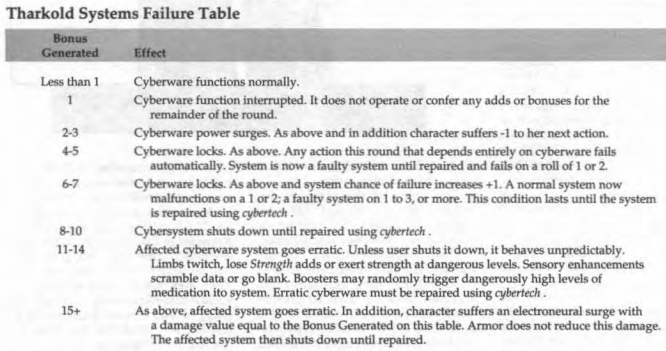
The other potential problem is our ol' buddy cyberpsychosis. Every piece of cybergear has a "cyber rating", which is totaled up for the character who has shit installed. Whenever the character gets a setback result from cards or whatever, then the GM rolls the PC's cyber rating versus their Spirit stat, and looks up the difference on the appropriate table. Which, again, is like 10 pages ahead of this point in the chapter and not with the Systems Failure chart.
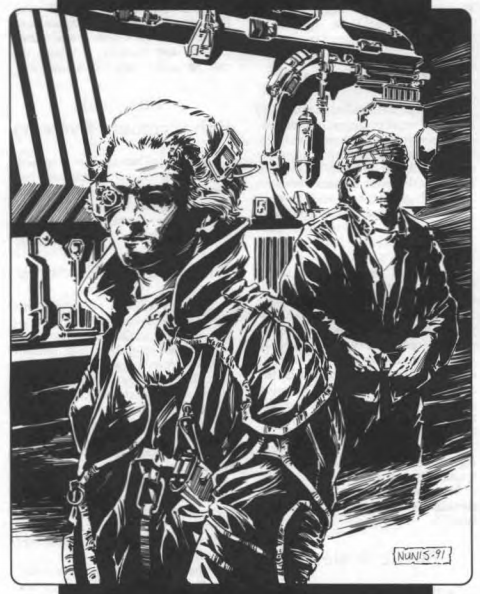
Tharkold cyberware isn't designed for looks, okay?
An interesting thing about this table is that it's only used when characters are in Tharkold reality, regardless of where they got their cyber. That said, the book doesn't say anything about suffering from cyberpsychosis when you're not under Tharkold's axioms, so I guess everywhere else you're good?
Regardless, a character can't have a cyber rating more than 10 points higher than their Spirit stat. If you go higher than that and suffer from cyberpsychosis in Tharkold, then instead of the normal result you just snap and turn into an NPC. And again, they specify that this happens if the character in in Tharkold, but not what happens if they're somewhere else.
From here on out, we're just dealing with lists of gear. Let's talk about the general mechanics first, then we'll hit the highlights of the list.
Any piece of gear can be used by either species, but if you're stripping people for parts it's important to note that cyberware from one species doesn't work well for the other. Tharkoldu need to enchant cyberware via the occultech skill in order to be able to use it, and that energy doesn't mesh will with a human's soul; any occultech device implanted in a human has +2 to its cyber rating. If a Tharkoldu tries to use un-enchanted cyberware, it suffers a systems failure on a roll of 1-4.
So with all that out of the way, let's see what kinds of things you can jam into your body.
The fundamental system needed to use any cyberware is Nanocord. Nanocord is a permanent upgrade to the nervous system (it requires an injection of nanites that take a week to rebuild your nervous system) that allows it interaction with various other cybersystems. It's pretty similar in function to NeuraCal and Jaz from the Cyberpapacy, to the point where characters with those installed can use Tharkold cybertech. Convienient, isn't it?
Moving on, the other basic implant is the Nervejack, which is your standard-issue "plug your brain directly into computer systems" implant. You know how this works, right?
Cybereyes get all the kinds of things you'd expect (video cameras, zoom lenses, IR/low-light vision, HUDs, and so on). But since this is Tharkold, they all have silly names. The zoom function is "Farsight", IR vision is "Heathunter", and stuff like that. That said, since the demons love body horroring themselves, you can give yourself an additional cybereye wherever you can fit it on your body. Technically you could add more, but you can only have one of your "extra" eyes active at a time.
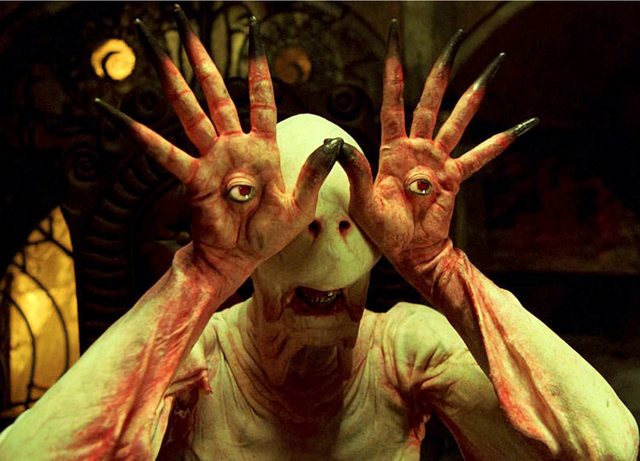
I know you were all thinking it.
There's also a bunch of auditory systems you can jam into your earholes. Bug sweepers, recording software, audio filtering (excuse me, "Freqfilter"), radio receivers, and so on. You can also get sonar installed if that's your idea of a good time.
We also get the (small) array of enhancements for taste, touch, and smell, but they pretty much boil down to getting a bonus to certain skills.
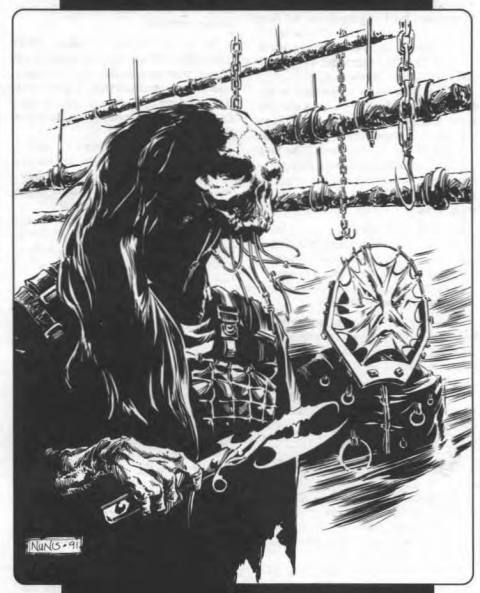
Horrifying, but impractical.
From there we go to Metasensory Systems, which actually give you new, enhanced senses. Inbuilt electronic detection systems, Biostat systems that show your current vitals, radio communication, and nanotech-powered self-healing. Okay, yes, none of those are technically "senses" but that's what they're listed under so who cares. We're all just trying to get through this, okay?
There's a few Vocal and Structural Systems available, but again this is all stuff you'd recognize from every cyberpunk RPG ever. The only one that feels new is "tendon augmentation", which you need if you have a cyberlimb that grants a Strength bonus of +3 or more, because otherwise your meat body couldn't handle the strain. Getting a cyberlimb with a Strength between +6 to +10 requires a BodyMax system, which is basically the same as the tendon augmentation except it's a separate installation that doesn't stack.
Which brings us nicely to Prosthetics. The usual array of cyberlimbs and related augmentations are available, but (once again) since this is Torg we need special rules for cyberlimb strength.
quote:
Cybernetic limbs can be made far stronger than natural ones. All adds are based on the user's natural Strength. A limb can have a Strength add of up to +2 without any other structural modifications to the body. A Strength add of +3 to +5 can be supported by Tendon Augmentation. A Strength add of +6 to +10 requires a Bodyrnax. Naturally, a Bodymax can also support limbs with Strength adds below +6.
The maximum add for cyberlimbs routinely available on Tharkold is +10. Experimental models with higher adds, developed by the military scientists of the Race, have so far proven as dangerous to the user as to any opponents.
Cyberlimbs with adds operate off of a power cell that requires monthly recharging.
And again, you can jam all the usual suspects into a cyberlimb. Gun mounts, blades, drug injectors, and such. Yeah I'm kinda rushing through this but like I said it's nothing we haven't all seen a million times before.
One fun trick you can do is to get yourself a cyberorgan of your choosing for a whopping +1 cyberrating. What does a cyberorgan do, you ask? It lets you install up to three shock buffers[/s] at no additional cyber cost. And what does a shock buffer do? Oh, it just increases your max shock rating by 10. Each. Normally they have a cyber rating of +2, but for a total of one whole point of cyber rating, you can get +30 shock damage. Since a character can normally take shock damage up to their Toughness stat (average 10), by doing this you can effectively triple the amount of shock damage you can take before you fall over.
There are also a few things I want to touch on when it comes to Chipware. Like most other cybersettings, you can get a chip socket installed in your back and upload new skills as needed. No surprise there. But there are still a few points that should be addressed:
First off, unlike other cyberware, Tharkold and CyberPapal chips are incompatible with the other realm's chipreaders. The Tharkoldu have developed special adapters (from when they were fighting Kadandra, who were the basis for the Cyberpapacy's tech), but outside of that this is the first tech that's not cross-compatable. And even with the adapter, the system will fail on a 1-4 roll.
Second, the Spirit Chips from the Cyberpapacy cannot work with Tharkoldu systems, no matter what. The Tharkoldu have spent a good amount of time and effort trying to crack the technology for themselves, but so far it seems impossible; the working theory is that Spirit Chips are only possible due to the unique nature of the GodNet and how it's powered by a Darkness Device. That said, the cyberdemons have put out a standing reward for Spirit Chips for anyone willing to bring them some. Unsurprisingly, not a lot of takers on that one.
Third, there's SlaveChips. SlaveChips were developed by the Tharkoldu to keep their human slaves in line with minimal effort. While SlaveChips can be installed into any normal chipware slot, they work just as well when surgically installed directly into the host.
SlaveChips impose a mental program into their host that forces him to follow Tharkoldu orders to the best of their abilities. Each chip is designed to make its host recognize a specific Tharkoldu as his "master", and the slave will prioritize that particular demon's orders. SlaveChips also allow for the scanning and tracking of the host's DNA.
So you're probably wondering why they'd need SlaveChips when the Law of Domination exists. The fact of the matter is that SlaveChips actually reinforce and strengthen the effects of the Law by increasing the difficulty of resisting an order. On top of that, the chip can receive orders from the host's master via radio transmission, can zap the host (dealing stun damage), trigger an intense and very distracting burst of pleasure for 30 seconds, or (if you've really pissed off your master) explode with the approximate strength of a 15 mm cannon shell. The host still resists with their Toughness stat as normal, and assuming they live (and if they're Ords, they probably won't) the chip is destroyed.
Note that SlaveChips only work on humans, not Tharkoldu. Note also that the Race have developed SlaveChip technology of their own that works on Tharkoldu. They don't want to use them, but they have the technology to do so.
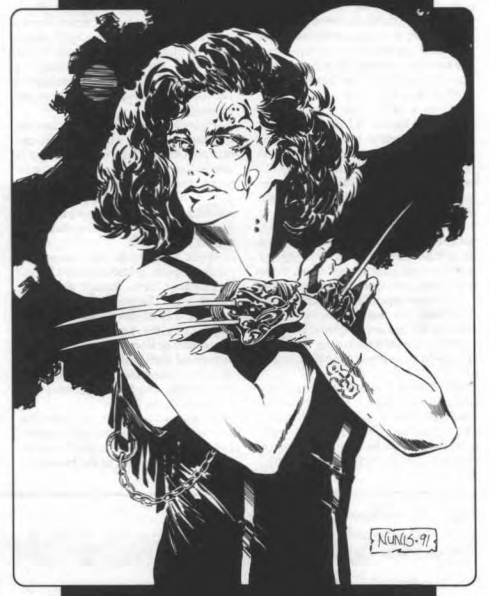
I know what they're going for, but really she looks cross-eyed.
The rest of the chapter is a discussion of Technomagical Implants. The Tharkoldu developed this technology during the decline of the cosm's Magic axiom to allow them to survive, and when the Magic axiom was increased by the Darkness Device this also increased the power of these devices. Now, the Tharkoldu have developed cybertech that increases the user's magical skills.
These come in three flavors. You can get any of the magic skills as chipware, although just having the skill via chipware won't let you create spells. You can also get "technomagical enablers" that increase your normal magical skills.
Lastly, you can get SpellChips, which are "the high-tech equivalent of the ornate scrolls and grimoires of Aysle." A SpellChip has to be plugged into a Nervejack instead of a normal chipware reader, so if you want to use multiple SpellChips at once you need multiple Nervejacks. It also costs a Possibility to attune the SpellChip to yourself.
The short form is that once you have a SpellChip attuned, you can slot it and cast the spell as per normal, which means that backlash is still a possibility. And that's "normal" for Torgian spellcasting, which means we have to take all kinds of shit into account.
quote:
SpellChips also contain a sophisticated VX simulation system that allows the technomage to perform mimicry or use any props that the spell may require under the Theorems of Similarity or Contagion. For example, a magician casting Altered Fireball using a SpellChip does not need the traditional ball of burning pitch physically, since he is experiencing the somatic component of the spell virtually, through the VX circuits of the SpellChip. The Law of Domination is again at work, allowing technology to substitute for integral parts of the spell casting process.
However, if a spell uses Specific Contagion, then either the usual sample of material from the target is needed, or else the SpellChip must be programmed with the target's DNA pattern or molecular structure using occultech skill. This requires the same sample of material that the spell itself would use.
SpellChips can be used to cast impressed spells without contradiction in Tharkold, even though the Magic axiom is 12. The mage casts the spell with the chip on-line. If successful the chip stores the impressed spell. A Tharkoldu or Race mage who casts an impressed spell without the SpellChip causes a four-case contradiction, as the spell has a higher axiom level than Tharkold or the caster.
It's worth pointing out that there's nothing stopping an Ayslish mage from getting this stuff installed, apart from the usual issues with using gear outside your axiom levels.
And...that's it.
---
This is where I'd normally summarize things, but there's really nothing to summarize here. See you all next time!
[b]NEXT TIME: Revisiting the console cowboys
Mass production...in the FUTURE!
Original SA post The storm has a name... - Let's Read TORG
Part 18g: Mass production...in the FUTURE!
There's only two more chapters in the book, not counting the templates, so let's get a-diggin' in so we can get to the really ridiculous books.
First is the Equipment chapter, where we're going to mainly learn about guns, but really we're going to learn about UltraCAD.
quote:
In primitive societies, someone who needs a piece of equipment either knows how to make it herself, goes to a crafter who can make it for her, or does without.
In industrial societies like Core Earth or Nippon Tech, the means of production are factories, specialized complexes tooled up to produce whatever is needed in bulk, from chain guns to disposable lighters. The ability to use an item is often far removed from the ability to make it.
Tharkold is a post-industrial civilization. One individual can operate the equivalent of a Core Earth factory. Technology bridges the gap between knowing how to use an item and programming a machine to make it. The general term for this technology is UltraCAD, derived from the ancient (on Tharkold) concept of CAD/CAM (Computer Assisted Design/Computer Assisted Manufacturing).
Okay, yes, it's a little more technical than that, but you get the general idea.
UltraCAD systems can vary in size from one meter on a side to 30m by 30m by 15m. And yes, the size of the UltraCAD does matter because a system can't make something larger than itself, because it makes the item all in one go. You can't make a car by having one system making doors, then another making parts of the engine, another making tires, and so on, then have a completely different system assemble all the parts into a working vehicle. It's all or nothing, probably because back on Tharkold people generally want shit made now instead of having to wait for however long a tank or rifle needs to be put together on an assemebly line.
In addition to an UltraCAD system (referred to as a module) and stuff to turn into raw materials, you'll also need the pattern for whatever it is you're trying to make. Patterns are just the virtual blueprints for the product, and can be customized in the virtual control environment to make simple tweaks. And it does have to be done virtually via a neural jack of some sort; even with a generic pattern you don't intend to modify, the whole process is so complex it can't be done manually.
Once you have your modules and patterns, the only thing that really limits you in cranking out assault rifles are raw materials. Since the planet Tharkold is pretty much drained of resources, devices called SynthCyclers were developed to break things down into "raw materials". These were mentioned back in the monsters chapter; rather than sending scavenging parties out, humans and Tharkoldu realized there's a better return in taking what amounts to a large dump truck, give it drone-like autopilot, stick a bunch of guns and armor on it, and set it to patrol a certain area. SynthCyclers will attack pretty much anything that's not nailed down (including people), break them down to component parts, and bring it back to a UltraCAD facility.
Maker modules come in 12 different types: biochemical, ceramics, chemicals, cybernetics, electronics, machining, nanotech, plasmatics (stuff that handles energy fields or radioactivity), plastics, polymers, structural (anything from furniture to buildings), and vehicular. And believe it or not, this is important to know, because pretty much all of the equipment in this section can be maker'd by the PCs.
Equipment is divided up into a few different categories, and each category will tell you the MakerMods you need, the types of raw materials used, the scale your setup needs to be, and what extra MakerMods you can use to affect the devices made. You can even buy "brand name" patterns and customize them to your liking.
quote:
In a lot of games, Torg among them, the future is brand names. A character doesn't just pullout a gun...he pulls out a Hachiman 12mm KM11 or a .44 Smith and Wesson Magnum. He doesn't drive a sports car, he drives an Aston-Martin Special.
Brand names are part of industrial culture. When the average citizen can make a car in a couple of days, using the equivalent of a basement workshop, brand names join dinosaurs and the phlogiston theory on the list of ideas whose time has come and gone.
"How do you like the car? It's a Fred."
It's also worth pointing out that, now that the Tharkold have entered the Possibility War in earnest, they've started creating patterns for items from other realities and Tech axioms. It's possible to use a MakerMod setup to create an Orrorshian rifle or an Ayslish breastplate and not have to worry about disconnection while using it.
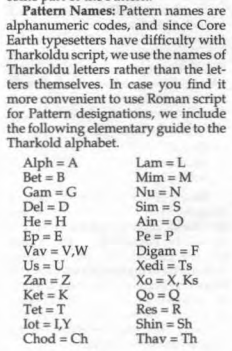
Sure, why not?
So that's all confusing and poorly explained by both the book and myself! Let's look at the categories of stuff you can make.
Cybernetics and cyberdecks are covered in other chapters, so there's not much to say here.
Besides, you're more likely to want to make Firearms.
"Firearms" covers any gun that fires physical ammo regardless of size and that doesn't qualify as a "heavy weapon". That said, they don't use gunpowder as a propellant or mechanical firing systems. Instead, everything uses caseless ammo with internal propellant charges that are fired via an electronic ignition system. Which also means that Tharkoldu guns can only use ammo specifically made for them.
On the plus side, any firearm can be made into a cyberweapon that can be installed into a cyberlimb. Pistols can fit into a hand, but something the size of a rifle needs to be mounted on an arm or leg.
a very important note posted:
Cyberweapons are denoted by the affix -Ket in the pattern designation. For example, a snub pistol made for use as a cybergun would be a 9/Gam-Ket.
- 9/Gam Snub Pistol: your basic autoloader pistol
- 11/Alph Automatic: an 11mm pistol; the "standard issue" firearm among the Race.
- 13/Zan Magnum: a larger 13mm pistol, just too big to fit in a simple cyberhand mount.
- Vav-9 Machine Pistol: a light submachine gun, small enough to fit in a simple cyberhand mount.
- Thav-9 Submachine Gun: a standard-issue SMG.
- Nu-15 Close Assault Weapon: a shotgun with an overly complicated name.
- Mim-8 Assault Weapon: an automatic gun that comes in either carbine or rifle configurations.
- Pe-Ain Assault Chaingun: the standard-issue 5.5mm for Tharkoldu. It's too big to be mounted in a cybernetic system, but it can be attached to power armor.
Unsurprisingly, you can also make Firearm ammunition with the right setup. In addition to normal ammo of (I'm assuming) whatever caliber you want, you can also make explosive ammo (which only gives a +1 to damage and doesn't even have an area effect), plasma ammo (still only +1 ammo, but now it has a 2m blast radius), and smart ammo (+2 to your attack roll). The weird thing is, though, that while you do need specific extra modules to make plasma or smart rounds, you don't need anything except the base maker components to make either normal or explosive ammo. Which begs the question: why would anyone make "normal" ammo in that case if explosive ammo costs the same? I don't even mean from a mechanical standpoint, I mean in terms of how the reality rewards needless violence.
Oh, and there's supposed to be gas ammo as well; it's listed in the MakerMod stat block, but not in the details or on the equipment lists.
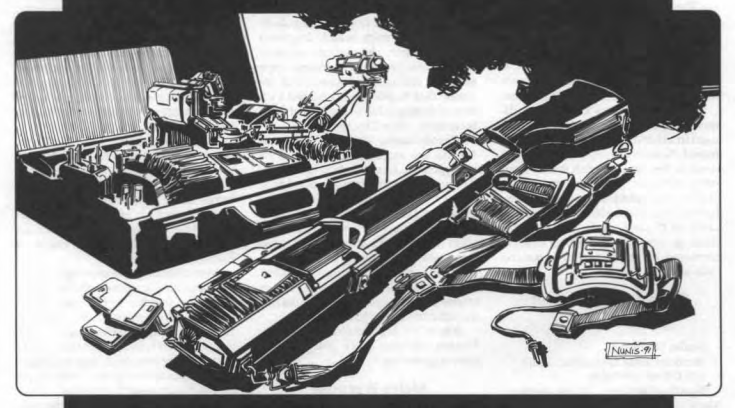
Pictured: guns
But anyway, that's the boring basics out of the way. Time for the weird sci-fi shit.
Such as Energy Weapons! Energy weapons only exist in pistol or rifle designs, and can't be placed into cyberware without using occultech due to the electromagnetic systems needed for an energy weapon screwing with cybernetic systems.
The main thing that differentiates energy weapons from firearms (apart from the ammo) is that energy weapons can be overloaded. Overloading an energy weapon lets you increase the damage of a gun by discharging its entire power cell into one big blast. When you fire an overloaded weapon, the gun's damage value based on the number of shots it has left. The downside is that energy weapons aren't really designed to do that; an attack roll of 1-4 will have something happen:
quote:
On a 4: The power cell fuses. The weapon delivers a normal shot and exhausts the cell. It must be reloaded.
On a 3: The power cell fuses without firing. The weapon must be reloaded.
On a 2: The weapon fuses. It is junk.
On a 1: The weapon explodes. An explosion with the increased damage goes off. Plasma weapons cause their usual explosive damage. Other weapons affect all targets within 4 meters.
Energy weapons come in a few basic varieties. The most basic (and the cheapest) are Ion Blasters. Ion blasters work by creating a carrier wave to the target, then zapping an electrical blast down the wave. The downside of ion weapons is that they don't work underwater. Or in a heavy rain.
Plasma guns launch balls of hydrogen plasma suspended in electromagnetic fields that discharge when contacting...well, anything. This means that plasma weapons are basically explosives, with an average max radius of about 10 meters, although some weapons have a bigger blast.
quote:
Thav/7-Nu is an infantry support weapon. It is available as a bi-pod stabilized rifle, weighing over 140 pounds (65 kilos). The weapon is fired from the ground, with the firer prone. A character firing the rifle while standin gor kneeling suffers a -3 bonus modifier unless her Strength is 15 or better, in which case she can stabilize the weapon.
Now we come to Heavy Weapons, but I'm not going to spend a lot of time on these. This is stuff like grenade launchers, chainguns, and the plasma cannon. Sadly, the plasma cannon isn't as interesting as you'd expect; it's just a big plasma weapon that doesn't even have a higher blast radius or anything.
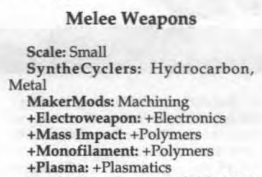
Melee weapons are the usual array of sharp or blunt instruments, although you can tweak the basic designs with some high-tech extras like monofilament edges or special impact-focusing polymers, but all these do is increase the base damage and maximum damage of the weapon by 1. Plasma melee weapons are available for people who want lightsabers, increasing the damage by a whopping 2 points! You can also have your weapon shock the target, increasing its shock damage by 3.
And I need to pause here about this. A plasma melee weapon, which is to say: a weapon sheathed in a plasma field, increases that weapon's damage by one point more than the more mundane options. It also requires a power cell, and if it's out of juice (or you disconnect) then the weapon's damage stats actually drop by 1 from its baseline, since the weapon isn't designed to be used without the field. All this begs the question: what's the point? It seems like a lot of extra hassle for one additional point of damage. And yeah, in Torg a +1 to a damage rating doesn't just mean "it does one more hit point of damage", but still. It's a fucking plasma weapon.
Anyway. Time to get into the weird stuff with Pain Weapons. Pain weapons require a Tech axiom of 26 and access to occultech, because they channel their power into an attack against the target's Spirit attribute. When a pain weapon hits, instead of determining damage value normally the attacker adds their attack bonus to their pain weapons skill, and that's what determines the damage done. Pain weapon damage is resisted with either the pain weapons skill or the Spirit stat. Pain weapons only do Spiritual stun damage, which was something from waaaaaaay back in the core book as part of the miracles rules.
Pain weapons include the Agonizer, the Pain Wand, the Pain Baton, the Pain Staff, and the Pain Whip. Really they're all pretty much the same, it's really more a matter of style than anything else.
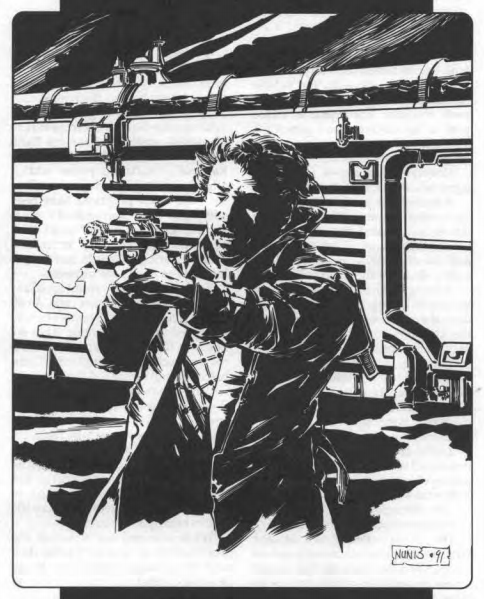
"AAAAAAAHHHHHHHH!!!"
Apart from weapons, you can also 3D print various types of Armor.
quote:
Considering the damage done by Tharkold weaponry, it should come as no surprise that personal armor technology is very advanced.
That said, there's a good variety of armor types available. The most basic is the Kap/3 Mesh, which is the Tharkold equivalent of a bulletproof vest, and the next step up is synthleather. But you don't care about that stuff. You want to know about power armor!
The basic power armor is the Chod/8 armor, which is really just a big ol' stompy suit of armor. You can install plasma jets to get some limited flight and/or an anti-energy weapon system, but that's all. Still, it has a higher armor value than an M1 Abrams so it's not like you need it to do a lot. You do need a NeuroJack to operate the armor effectively, though; without one you can still wear it but you suffer Dexterity and fatigue penalties.
The next step up from the Chod/8 is the experimental Chod/10 armor, which operates off solar power instead of a power cell, boosts the user's Strength and Dexterity if he's jacked in, has gun mounts on both arms, and can be modified to allow Tharkoldu to still use their wings with a bonus to their flight skill.
Sounds pretty awesome, right? Well, there's a catch: you can't just buy the pattern. The price is actually listed as "n/a" on the equipment list. Which probably means that if you want the Space Marine armor you're going to have to raid a factory that's already cranking the suits out. Good luck with that!
The rest of the chapter is about the types of vehicles you can make, but you'll forgive me if I don't go into details about them. I mean, there's only so much you can say about motorcycles, cars, boats, and so on.
That said, there are two things worth mentioning about vehicles. First off, hover vehicles exist and are fairly common. They're mainly used for water vehicles, have a maximum hovering height of about 5 meters, but apart from that they're pretty much the same as ground vehicles.
The other thing worth mentioning are the air vehicles, because in keeping with that 90's design idea of "well someone might want to do it" it's possible to make a full-size passenger jet or a suborbital fighter. Because, you know, those are the kinds of things that PCs will need.
--
Not a lot to say here, really. Yeah there are some neat weapons, but given the whole nature of the AutoCAD stuff it would have been cool to see more options for customization than just "you can make it look different".
Still, we're almost done with Tharkold! One more post to go! That's good, right?
NEXT TIME: Machine/Man Interfaces
The Grid, Templates, and the Future
Original SA post The storm has a name... - Let's Read TORG
Part 18h: The Grid, Templates, and the Future
We're in the home stretch, folks! We have one last thing to cover in detail before the end of the book: The Grid.
quote:
The Grid represents the culmination of centuries spent developing the interface between mind and machine. Processors got faster. Data structures became more complex. Old fashioned user interfaces based on text commands and pictorial icons were unable to give operators enough control to use the full capacity of their computer systems. The human factor became a bottleneck.
A cybertech civilization can overcome this bottleneck by interfacing the enormous processing power of the living brain and nervous system to its computer systems. Slow access methods like keyboards, icons, voice programming, all go out the window and
are replaced by Virtual Experience (VX). Using a VX cyberterminal, or a cyberdeck, a computer user, a decker, can use the full power of an advanced system.

Remember this?
Well, turns out that the designers realized that having the decker go through a whole side-thing every time they wanted to grab a file was a bit tedious. So now, we have a streamlined decking system in its place, which can also be used for runs through the GodNet since their technology is conveniently comatable.
Unlike the Cyberpapacy (or Core Earth, for that matter), there's no single global network on Tharkold. The realities of the War make that incredibly impractical. Instead, there are six different complexes that function as a large-scale intranet: one for the Tharkoldu (imaginatively called DemonGrid) and one for each of the Race nations. None of these complexes are directly connected to each other; since this was the mid 90's and the idea of wireless internet didn't exist yet the only available method would be via a landline. And as you can imagine, you couldn't run one through enemy territory. This means that if data needs to be transferred from one network to another, it has to be done by a courier carrying physical media. And since this usually only has to be done between the Race nations, that means that the courier has to get across Tharkoldu-controlled wastelands.
quote:
The price of failure can be costly indeed. Eight years ago, Kham developed a vaccine against a mutated War plague that was ravaging Mizatyan. A Gridrun to deliver the information was hit by Tharkoldu forces and the human deckers were massacred. Not only was the formula prevented from reaching its destination, but Tharkoldu deckers used the link to invade the Grids in both Mizatyan and Kham, doing terrible damage before the link could be broken. The vaccine information eventually got through by chip, but the losses in the Grid were high enough to end Kham's cooperation with Mizatyan for six years.
Accessing the Grid requires a direct connection to the physical network via a Nervejack, which means that if you want to get into the enemy's systems you need to be on their territory. Note that possession of a cyberdeck by a human in Tharkoldu territory is punishable by messy death for the first offence.
Accessing the Grid also requires a cyberdeck, which has the same four stats as the Cyberpapal versions: Response (the deck's speed), Stealth, Processor (how many programs the deck can run at once), and Storage. In addition, a decker has "net skills" that represent his ability to do things in the Grid, as well as programs that will boost those skills. All this stuff is pretty much the same as we saw back in the GodNet book, so forgive me for not getting into detail here.
That's about where the similarities end, though, because instead of using maps of digital structures, using the Grid is done using the Dramatic skill resolution system. Or, to put it another way, a skill challenge.
That said, there are a few basic differences between decking and normal dramatic task resolution. First off, you don't have all four steps. Instead, you always have step A (which is "locate the virtual address of where you're trying to go") and step B ("relocate VX code", which is a fancy way of saying they log into the system). The majority of the time you'll also have step C, which will vary depending on what you're trying to do; get a file, turn off alarms, access security history, and so on. Step C can require multiple rolls if you want to do multiple things (such as kill the alarm system then find a file), but regardless of how many things you do they all happen during step C.
Every system has two stats you need to know about :
The base security rating can best be described as the system's defense skill against any action the decker makes. The alarm tolerance is how many "alarm points" the decker can generate before risking a system-wide alert, and we'll get into how you get alarm points in a second.
Like the GodNet, time in the Grid operates at the same speed as it does in meatspace. This has the nice in-game effect of not having to worry about shit like time dilation, and a nice mechanical effect of letting the rest of the group actually do something while the decker is doing shit. This means that each round on his action, the decker gets to make one roll to perform one action. This is an opposed roll, against a total generated by the GM based off the system's Base Security Rating.
If the hacker succeeds, then they do what they intended to do. If they fail, however, they generate one to three alarm points based on how badly they flubbed the roll. The decker can also generate alarm points if the system's security roll beats their net stealth value, in which case the decker get points equal to the difference of the rolls.
When the decker has alarm points equal to or greater than the system's alarm threshold, an alarm check is made. The GM rolls a result total based off the system's security rating plus any alarm points the decker currently has, then looks the result up on this chart.
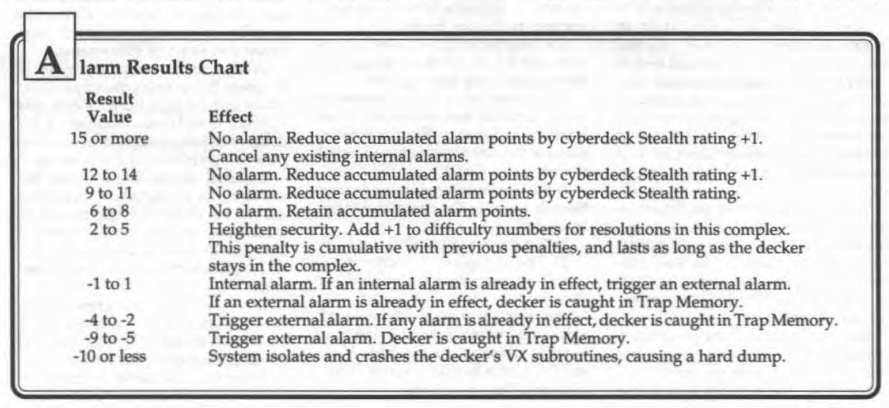
If (when) a person is forcibly removed from a VX system, either from getting "killed" by a security program or just getting unplugged, this is a hard dump.
*cough*
Sorry. When this happens, the decker takes mental damage as if the system's security value + generated alarm points was a weapon attack, and attempts to resist the damage with their Mind stat. Based on the results, in addition to the damage you can wind being considered unskilled in cyberdeck operation for a while, or (if you wind up with a heavy wound) unable to use a cyberdeck at all until you're healed.
Surprisingly, Tharkold's net security systems don't seem to be able to directly kill someone. At most it does "pain damage" like we saw last chapter, knocking them out and forcing them to make a hard dump check (god that sounds dumb) on top of the damage from the security system or net combat. Of course, being unconscious inside a Tharkoldu facility when all the alarms are going off is kind of worse than just some black ice.
The last thing to be aware of is that, thanks to occultech, Tharkoldu are capable of casting spells in the Grid. They have to have the spells encoded into SpellChips to do so, but this gives them a bunch of new options when it comes to dealing with enemy hackers, such as fireballs and the ability to teleport past digital security systems.
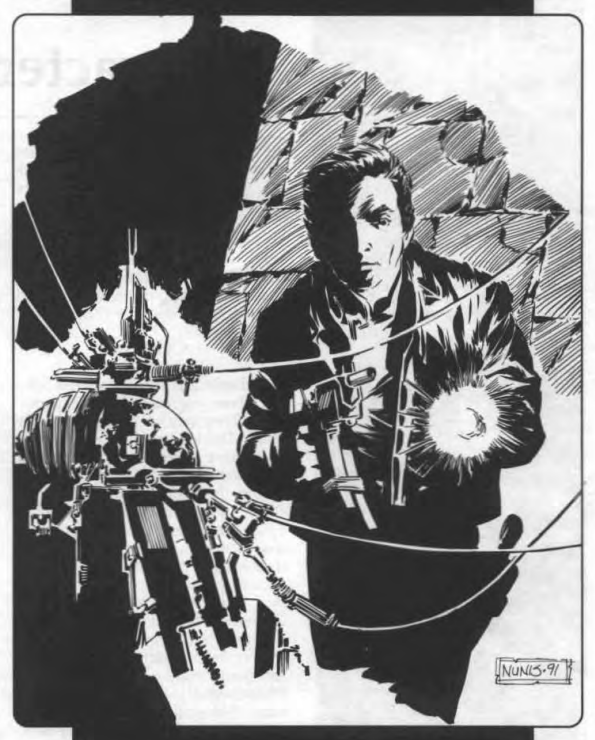
And you think changing the settings on your router is hard.
The last chapter of the book is about Character Creation, and gives us some non-human options to play as: cyborgs, mutants, and rebellious Tharkoldu. Only members of the Race can be cyborgs or mutants.
Cyborgs are members of the Race whose bodies have been mostly replaced with machinery. They're more resistant to cyberpsychosis, and are the only people who can take the cyberpsyche skill. This skill adds to the character's Spirit stat when making a cyberpsychosis check. Cyborgs also start with whatever cybernetics they want as long as their total cyber value doesn't go above 20. The downside to being a cyborg is that if you ever transform to a reality with a Tech axiom less than 26 (which is to say: any of them except the Cyberpapacy and one of the remaining two SPOILER realms) you just die immediately.
Mutants are the result of centuries of biological warfare, magical storms, radioactivity, and all the other shit that the Race and Tharkoldu have put their world through. And these aren't the fun kind of mutants where you get cool powers; maybe one mutant in a thousand doesn't have a debilitating mutation. Those who did luck out get an extra six attribute points in the form of enhancement packages. You may remember these from Aysle, where you got stat boosts at the cost of spending Possibilities every session. They work about the same here, except that these packages have a variable cost depending on which stats are increased; each stat has a Possibility cost, and you add up the costs of all the stats you've boosted. If the character can't pay out the needed possibilities at the end of the session, they start to waste away and die. And just as an added bonus, using stats boosted by mutations is a contradiction in a reality with a Tech axiom of 26 and a Magic axiom of 17. Unfortunately, the only realm with both those axiom levels is Tharkold, so it's always going to be a contradiction.
Rebellious Tharkoldu are a little more complicated, and the book states that it's perfect allowable for the GM to ban them as a player option.
Rebellious Tharkoldu are Tharkoldu who have managed to break out of the abusive chain of Domination. Their alpha either died or let them go, and rather than just getting in with another pack and accepting the Law of Domination they've struck out on their own. To Tharkoldu society at large, they're threats to their very way of life. In fact, normal Tharkoldu can detect rebels by making a Perception check against the rebel's Spirit. On top of that, rebellious Tharkoldu always suffer a -5 penalty to social rolls (except intimidation) against normal technodemons, and a -3 against humans.
A starting Tharkoldu character gets six three-point stat enhancement packages, and whatever cyber it wants up to a total rating of 16. The only limititation on stats is that there's a minimum of 13 for both Strength and Toughness. The enhancement packages have a total adventure cost of 6 Possibilities, and if they don't pay out then the Law of Domination kicks back in and the character becomes an NPC permanently. Oh, and once again using the boosted stats is a contradiction anywhere outside of Tharkold. Transformation is bad for Tharkoldu; if they transform to a reality with a Magic axiom between 9 and 12, then they lose their enhancement packages but keep their wings and can still fly. If the Magic axiom is less than 9, however, they die instantly.
All that's left now are the character templates. Sadly, there's not that many, because as I'm sure you've guessed (and I believe as was brought up before) people from Tharkold tend to fall into one of two categories: technodemon or Kyle Reese. Since Los Angeles was under Core Earth rules until recently, you can slot any of those templates into L.A. without a hassle.
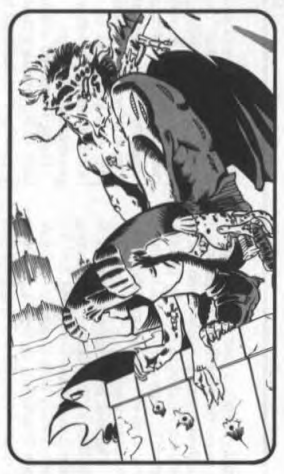
The Demon Scholar used to follow a powerful alpha who was supposed to submit itself and its pride to Sterret shortly after the invasion. But an ambush kept that from happening, and the rest of its pride were wiped out. But instead of submitting to a new master, the scholar decided to explore this new "freedom" concept. It's surprisingly addictive. The Demon Scholar starts with a plasma axe, a bunch of cybernetics, and no friends. Its tag skill is science.
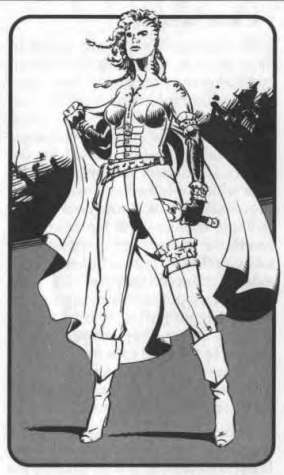
The Mutant Survivor was a member of one of the many mutant tribes living in the blasted edges of Tharkoldu. Like most tribes of this nature, they didn't give a shit about the Race or the Tharkoldu; they just wanted to be left alone. Still, needs must, and while raiding a Tharkoldu army encampment she saw the first wave of slaves being sent through a hole in reality. She followed, and discovered a world (relatively) untouched by devastation. This might not be a bad place to move the tribe too, once the demons are dealt with. She starts with a very high Strength, a plasma sword with no power cell, some tourist maps, and a few shiny trinkets. Her tag skill is melee weapons.
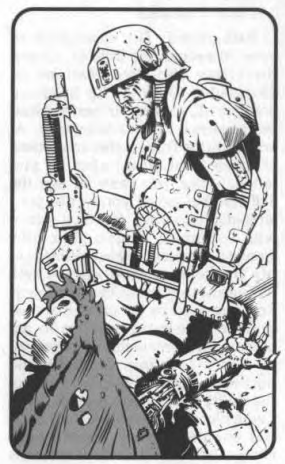
The Race Soldier was raised to do one thing: fight. He does it quite well. Too well, some might say; he isn't interested in troop movements or supply lines or tactics or any of that shit. He wants to fight. He wants to kill technodemons. It doesn't matter how it's done, as long as he gets to blow those motherfuckers away. Rather than deal with a court martial for disobeying orders, he volunteered to be part of the Core Earth deployment. Chaotic urban fighting is more his speed. He starts with a bunch of guns, a suit of Chod/8 power armor, and a problem with authority figures. His tag skill is fire combat.
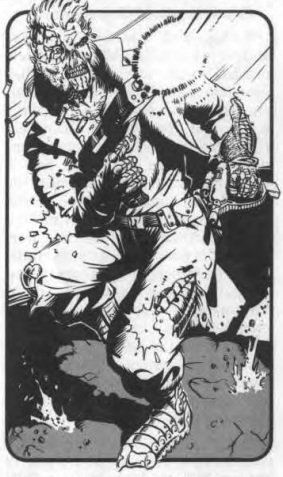
The Cyborg Infiltrator has not had an easy life. He started out as a Race slave, and was picked by the Tharkoldu to be jammed full of cyberware and programmed to infiltrate a Race stronghold. When he was found out (and eventually put down), he was reprogrammed again to protect the Race and kill demons. He was sent to L.A. specifically to aid resistance forces there, mainly by gathering intelligence but also by killing Tharkoldu.
quote:
Personality: You have what Race scientists charitably call a "rudimentary social response matrix." You are often wooden or make slightly inappropriate remarks, particularly for cultures other than the Race. You have a rough sense of humor and often speak with candor. You take most statements very literally; idioms such as "Hey, hit the lights!" are an invitation to social disaster
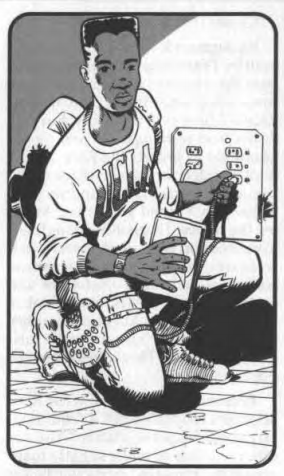
The Student Hacker was a CompSci student at UCLA when the initial Living Land invasion happened. When the Miracle of Sacramento happened and the Living Land zone was pushed back, he went back to school to try and keep up with the new technologies coming out of Japan. When the Tharkoldu invaded, he was transformed upon discovering one of the first Grid setups in the realm. This can probably count as "practical experience" on his future résumé.
quote:
"I once coded the OODBMS module to wire-down two megs of VM for its working heap. Saved a half-dozen cycles per seek."
And with that nonsensical character quote, we finally reach the end of the book.
--
So where does Jezrael go once her foothold is secure?
Well, for starters she ends up butting heads with Thratchen, the pretender to the Gaunt Man's throne, almost immediately. Thratchen (who was covered in the Orrorsh sourcebook) was in a bad situation when the Tharkold bridge landed; the Gaunt Man was still out of the picture, people weren't buying its excuses for the Gaunt Man's absence, and it was still unable to bond itself to the Gaunt Man's Darkness Device. Even worse, the talisman that allowed Thratchen to maintain his reality in Orrorsh was starting to lose power. In a desperate attempt to curry favor with Jazreal, he pit one of the alphas involved in the invasion against a group of Storm Knights. Thratchen's plan was to have the Storm Knights weaken his rival's pride enough for him to come in and mop up, and it actually managed to pull it off. Its long term plan is to see what happens in terms of Jezrael's rise and the possible return of the Gaunt Man, then back whichever looks to be the most powerful.
But what really solidifies Tharkold's place in the war is when Jezrael dropped a bridge directly on Berlin.
As stated back in the Cyberpapacy sourcebook, Germany was pretty much the only thing stopping Cyberpope Malraux from extending his territory eastward, and Berlin was a staging ground for special operatives and Storm Knights alike for pretty much all of Europe and parts of the Nile Empire. With Tharkold's arrival, that was thrown into chaos. But not because of Jezrael, but because of Dr. Mobius.
The High Lord of the Nile Empire learned of Tharkoldu agents planting the stelae around Berlin, and decided to try an experiment: what would happen if he uprooted one of the three Tharkoldu stelae and replaced it with one of his own?
The answer is that the resultant realm would be a mix of both Tharkoldu and Nile Empire realities. This was only really possible because the Darkness Devices agreed with each other that this would further their goals of chaos and destruction, but hey, you can't argue with the results. The single stelae zone around Berlin contains a mix of both worlds, and the effects have been...unexpected. Like how Nile villains are less likely to capture heroes and stick them in deathtraps and more likely to just shoot them in the back of the head. Or how Tharkoldu alphas have started monologueing. You know, little things like that.
Emboldened by her (more or less) victory in Berlin, Jezrael focuses on expanding the L.A. realm. This is both easy (since Tharkoldu are great at fighting) and hard (because genreally speaking Tharkoldu tactics boil down to "kill everyone between you and where you're trying to go").
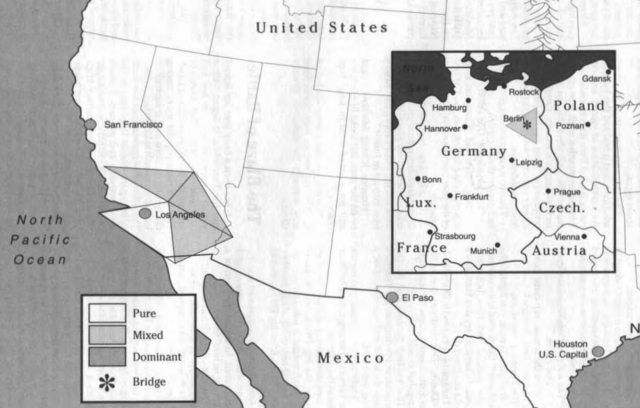
Jezrael's territory by the end of the game line.
Meanwhile, the Race figures out that working with the Core Earth governments will help everyone in the long run and begins setting up outreach programs and military alliances with the US government. This hasn't gone as well as you'd expect, since the Race's approach to warfare isn't much better than the Tharkoldu's: basically all that matters is victory. Troop or civilian safety is a secondary concern. It's not helping matters that many Race leaders have been tricking Storm Knights into coming to Tharkoldu cosm to fight battles there, too.
Lastly, there was the birth of Jezrael's son Sidon.
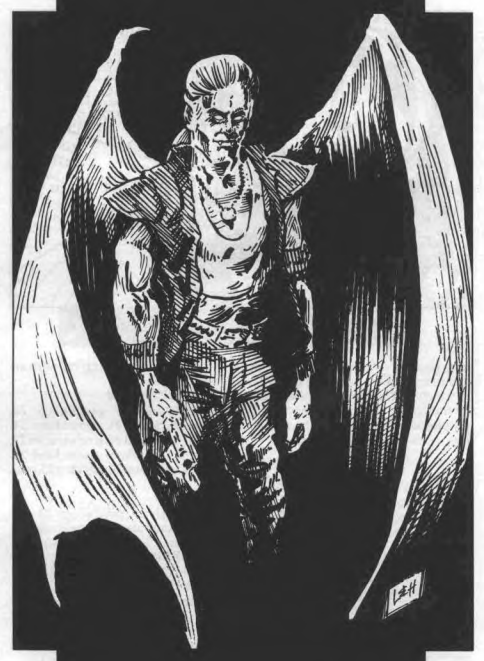
90's gaming, personified.
Sidon was born about two years after the initial invasion of L.A., and was immediately hidden and raised in secret to protect it from Jezrael's enemies. Sidon grew to maturity in a matter of weeks, and once reaching "maturity" began showing signs of being sympathetic to the Race. Obviously that wasn't exactly desired behavior, but before Sidon could be put down he managed to escape. Sidon quickly went to the L.A. realm and hooked up with the Resistance, where his mixed blood makes him very good at thinking like the enemy. He's displayed strong divination ability, and is certain that he's going to have to confront his mother at some point.
quote:
Lately, Sidon has gone into a series of trances in which he makes cryptic prophecies. The one prophecy that keeps coming up is as follows:
As the architect of the miseries comes to us,
And darkness is locked up in his heart,
The mighty will be cost down,
For the sake of resisting a nameless foe,
and his first victim will return for retribution,
Then shall flesh face flesh,
Until only one stands,
And all kingdoms fall.
--
So what's left to say about Tharkold? Not much, really. The designers flat-out admit that they never intended for Tharkoldu to be an invading realm; it was just supposed to be something that lived in the setting background at that was it. But fan interest wouldn't let it go, and thus this book was born.
And while it's a pretty interesting idea, the fact of the matter is that there's nothing to do there except fight demons. Like, that's it. There's not a whole lot you can wring out of the concept since it's just one big fight scene.
But hey; it's one more realm down! Two more SPOILER realms to go! We're nearing the end! Are you excited?
Don't be, because the next realm is probably the most pointless of all the realms in the game. But before we put on our pith helmets for that place, we're going to check in on what's happening in Core Earth.
NEXT TIME: Meanwhile, back at the metaplot...
Core Earth Pit Stop
Original SA post The storm has a name... - Let's Read TORG
Part 19: Core Earth Pit Stop
Before we move on to the next realm, let's take a quick break to see what's going on in Core Earth. There are are adventures I want to bring up. One is a trilogy, the other is a stand-alone.
The trilogy was called "The Relics of Power Trilogy", and kicked off in the first published adventure for Torg, The Destiny Map.
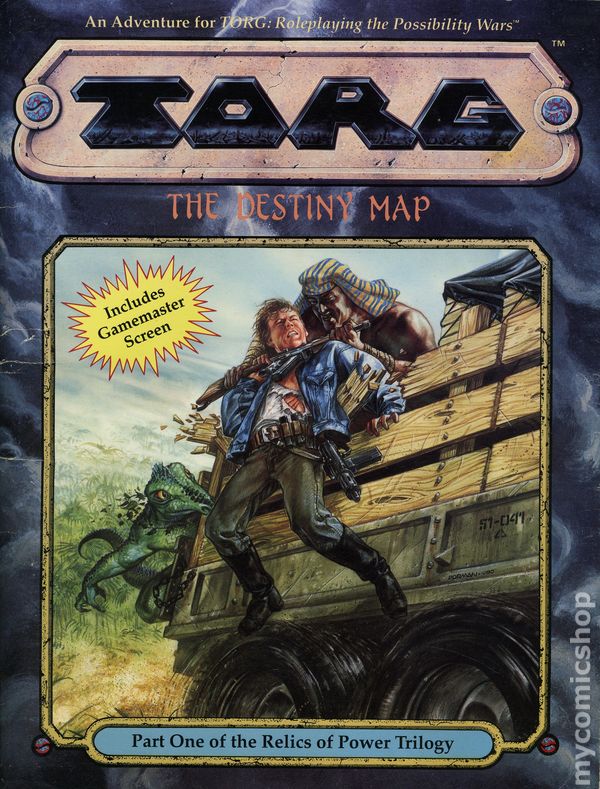
Way the hell back in the Nile Empire sourcebook, it was mentioned that Dr. Mobius has been trying to figure out the secret behind a bunch of strange mosaic tiles that were "older than the Earth". The trilogy is based around racing Mobius, Kanawa, and Malraux to discover the secret of these artifacts.
The first part of the trilogy involves getting pieces of a map that need to be brought to a specific temple in India and keeping Mobius' lieutenant Wu-Han from killing them all and destroying the temple before they figure out where the second part of the trilogy takes place. Assembling the map gives the starting location of the next module, the McGuffin they're looking for, as well as that old favorite: the bad Clue Poem.
quote:
YOU HAVE FOUND THE TEMPLE OF THE MAP
HERE WHERE THE HUMANS JOIN HANDS
THE TIME OF POSSIBILITIES HAS BEGUN
SEE NOW THE RESTING PLACE OF THE CHALICE
FOR ALL THESE UNTOLD EONS
YOUR DESTINY CALLS YOU THERE
TO ACCEPT THE DEFEAT OF THE FOUR COLORS AND FIND THE CHALICE
THEN CARRY THE CUP NORTH FROM THE TEMPLE OF THE MAP
TO WHERE THE MEN OF THE NORTH JOIN HANDS
AND LIGHT THE SIGNAL FIRE TO CALL OUR DISTANT SAVIORS
The second part of the trilogy ("The Possibility Chalive") involves tracking down the chalice, an eternity shard that turns out to be the Holy Grail.
To give you an idea of what a Torg adventure looks like, here's a high-level outline of how this adventure goes.
- The party goes to the location where the Destiny Map pointed them to. It's in the middle of the Gulf of Thailand, but there's a Kanawa Corporation oil rig on the exact spot.
- The PCs fight their way through the oil rig and discover that it's actually a way down to a seabase attached to a sunken temple.
- After dungeon-diving through the temple, it turns out that the chalice is already gone! Oops! In its place is a message left by a Ayslish mage named Babbidge, saying "if you can read this, come seek me out in Aysle."
- In Aysle, it turns out that Babbidge has been kidnapped! The group is then
railroadedhired by Tolwyn of House Tankred to track down the missing mage.
- Eventually the party learns that he's being held captive in a ~spooky~ castle in northern England by a wizard named Amethyst.
- After fighting their way through the ~spooky~ castle, they find Amethyst, who also has the chalice. Taking the logic leap that if Storm Knights want it, it must be an eternity shard, he escapes during a cutscene and the party has to give chase.
- The final battle takes place on a viking longboat, where the party gets to fight an evil wizard and his viking goons while being bombarded by a naval carrier.
By the way, I've mentioned before how linear these adventures are. Here's an example from the last act of this adventure for what happens if the players try to short-circuit the final battle before it happens.
quote:
The Storm Knights catch the vikings too quickly: If the Storm Knights have spells, items, cards or equipment that you can't get rid of, and it gets them too close to the vikings too fast, Amethyst casts a mega-size fog spell. His own ship, oars creaking slightly (but the echoes make it impossible to follow), glides out of the fog and regains its lead. The Knights flounder in this case. the Uvwe can show up to lead them out of the haze. This can take as much or as little time as you like.
If the nature of the Knights' advantage precludes even the fog or mage dark, then Amethyst's ship simply vanishes, to reappear a moment later and about 500 meters further away (or whatever it takes to pace the scene properly). The Dark Wizard has enacted his special teleportation spell once again.
Seriously, you don't often see rubber band AI in an adventure module, do you?
Anyway, the PCs defeat the vikings, don't get blown up and/or sunk, and have the chalice. Now they need to bring it to adventure three, "The Forever City".
This adventure kicks off with everyone being jumped by Cyberpapal operatives. The reason for this is because the PCs are to learn from these goons that Malraux has gotten his hands on something called the "Signal Fire", and is transporting it to wherever it's supposed to go on the Orient Express.
They PCs also learn that one of the leaders of La Resistance is also on the train.
Good thing whichever operative the PCs leave alive knows all that!
Oh, what's that, they didn't leave any of these guys alive? Well, then the last guy surrenders and Tolwyn (who they start the adventure with) forces the PCs to accept it because it's the Honorable thing to do. Oh, they kill them all anyway? Then a second group of cyberoperatives will attack the next night. All those guys get killed? Then you just skip the interrogation scene and do the next one instead.
Writing!
Anyway (man I say that a lot in these reviews), the PCs take the Orient Express to get the Signal Fire. What's that, they have faster transport and want to ambush the Cyberpapal team and steal the Signal Fire when they get off the train? Well, they can't do that because HEY WHAT'S THAT OVER THERE? (running feet, car door slam, screeching tires)
Honestly, though, they actually do take this into account: you just skip the whole Act that takes place on the train. That's it. Believe it or not, I want point this out because of something that's going to happen much later.
If the party does take the Orient Express, they get to meet setting NPCs Katrina Tovarish and Nicolai Odnarev. These two are from the original novel trilogy and were part of the Soviet psychic research project that predicted (and prevented) Tharkold's original invasion attempt in Siberia. They're currently disguised as a nun and a priest because Katrina has predicted that something important is going to happen on the train so they're on board to see what's going on. Katrina is a powerful psychic but can't fight should the need arise. That's okay, though, because Odnarev is a highly trained Soviet soldier who treats Katrina like a daughter and has zero moral problems with killing the shit out of anyone who threatens her.
Also on board is a jewel thief by the name of Horace Blessed, who came on board to steal whatever it is that the Cyberpapacy was transporting. This didn't work out well for him, and he was given the choice of either being a stalking horse for people seeking the Signal Fire, or getting shot in the back of the head. His job is to trick people into looking for the Signal Fire in a trapped location where the schmucks can be ambushed easily.
Oh, and there's also an Orrorshian vampyre on board, because why the hell not.
The whole point of this scene is for the PCs to interact with a bunch of different NPCs, fight a bunch of cyberoperatives on top of a train, and get their hands on the Signal Fire, a brilliant blue jewel.
It's also a fake.
Yup, Malraux set this whole thing up to keep the Storm Knights distracted while he goes to the final temple location in they Himalayans. The Signal Fire isn't on the train. It's not even a gem. The whole thing was one big trap to keep anyone seeking the Fire busy and hopefully get the Chalice off their bodies.
Okay, I'll admit it. That's pretty good.
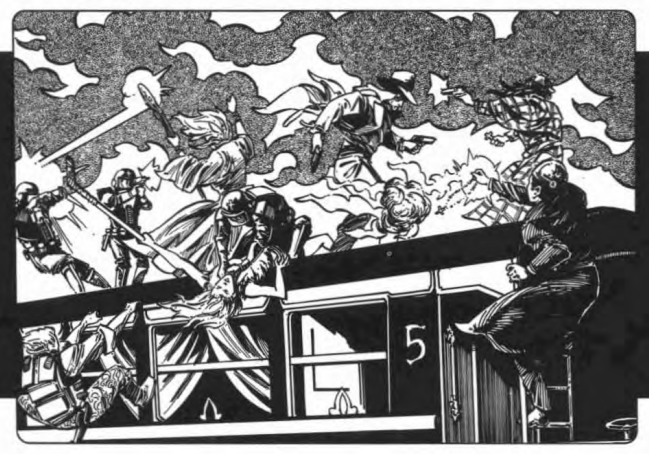
At least they get to fight on top of a train?
The end of the adventure involves getting to the Himalayan Mountains and getting to the temple where the real Signal Fire is before anyone else. They get to climb mountains, fight a yeti, and fight a vampyre and some gospog before arriving at the ruins of some ancient forgotten city. Once they deal with a bunch of Egyptian god avatars courtesy of Mobius, they get to explore the city and find the temple of the Signal Fire.
quote:
An inscription is clearly visible on the statuary. The writing is extremely strange, and those who have been to the temple of the Destiny Map in India recognize it as the same language as was found there. The effect on the reader is as it was on the temple wall - despite the alien alphabet, the Knights can somehow read and understand the words. The inscription reads:
THE TIME OF POSSIBILITIES IS AT HAND
SKY AND FIRE MUST BE MIXED
AND CARRIED FORTH TO ANOINT THE BRAZIER
AND PREPARE IT FOR LIGHTING
BUT BEWARE
ONLY THE MOST WORTHY WILL BE ABLE TO SUFFER THE PAINS OF THE SACRED STAIRS AND LIVE
TO LIGHT THE SIGNAL FIRE AND HERALD THE NEWS OF EARTH
The party needs to carry a puzzle item up four stairs to activate the Signal Fire. Which is easy enough, except that for every one of these steps you climb you take one wound. Four steps means four wounds, which is how many wounds a character can take before dying. In order to climb the steps, someone needs to be able to spend a possibility to prevent at least one of those wounds. This is what's meant by "only the most worthy"; only P-rated people could do this without dying.
So the PCs climb the steps, find the Signal Fire (a giant stone brazier) and activate it. This is done by putting the puzzle item on the brazier.
quote:
A message appears on the brazier in the same ancient, yet readable language. It reads:
HOW WILL YOU SEND YOUR MESSAGE?
This is a clue which refers to the final step in "lighting the Signal Fire."
As mentioned in the statuary instructions, the Knights must "Herald the news of earth." In other words, they must use the group power of herald, bestowed upon them by the Possibility Chalice to light the Signal File. If they announce that they will "herald" their message, go immediately to the next scene.
If the Knights do not have the herald power, they must immediately purchase that power (see Torg Rules Book, Gamemaster Chapter Nine).
What happens if the party can't afford to get the power? Good question! It's also one the authors didn't ask because there's nothing here to take into account that the party might not be able to do this. Well, hopefully the party can pay out before the city is destroyed?
Oh, did I not mention that a reality storm kicks in at the start of this scene and will destroy the city in 10 minutes? No? Well, don't blame me because the adventure doesn't mention it either until pretty much this point. Good writing, guys! Oh, and the vampyre from before attacks again at this point.
Anyway, let's assume that everyone pays out the 20 Possibilities between them and use the herald power. So what happens?
This happens.
quote:
An impossibly bright light shoots forth from the mouth of the brazier, sending searing knives of pain through your eyes. The vampyre screams in agony at the cursed light - you can hear him running for his life, but you cannot see him. You cannot see anything.
As your eyesight gradually returns, you see the image of a shimmering globe hovering above the mouth of the brazier. The familiar shapes of oceans and land masses reveal to you that it is your beloved Earth.
The globe is dotted with tiny pinpoints of light, and interspersed among these are seven pulsing points of utter blackness.
As you stare, transfixed, into the mystical image, you feel yourself falling into it, travelling down onto the face of that glowing planet, speeding toward one of the many points of light. You now stand near a group of children ina playgrounds and box. You are unable to move or to speak. A man lies half-buried and bleeding in the sand, and the children surround him. They poke and prod him with maliciousness slightly beyond a child's normal curiosity - some kick sand in the helpless man's battered face.
The sandbox is cloaked in shadow as a winged Ravagon lands amid the children. They smile and clap as it touches down in the sand, staring at the creature in wide-eyed wonder.
The Ravagon pats several of the tykes on the head,and speaks softly to them. "I've crippled this Stormer for you, young ones. Do with him as you will."
With that, the Ravagon plucks an aluminum baseball bat from the sand and hands it to a red-headed boy. "Go on, child. Haven't you ever wondered what it would be like?"
The boy steps over the man's crumpled arm and onto his chest, gripping the bat tightly and waving it above his head. His young friends urge him to strike. The boy hesitates. The mystic letters form again over the scene: HERALD YOUR MESSAGE.
The idea here is that the group has to use the herald power to send the kid with the bat a message of hope, because this is his "moment of crisis" that could lead to him becoming P-rated. And that's all they can do; use the herald power with a difficulty of 27.
That's right! The big climactic moment comes down to a single skill roll!
If the characters fail the roll, then the kid beats the helpless Storm Knight to death and the party is returned to the Forever City. The adventure presumably ends there since nothing says what happens after this when the image fades. As is often the case with Torg adventures, the assumption is that the PCs will win.
If they players succeed and they send some sort of message of hope (not sure how they're supposed to know to do that since they don't know why the kid's doing this), then the kid throws the bat at the Ravagon and the kids all run. The Ravagon looks confused for a second and then pursues them, but the PCs are returned to the city and the image of the Earth. They see more lights appearing across the globe, and know instinctively that each of these are a new Storm Knight being infused with Possibilities. Their message of hope has created thousands of new heroes across the world, strengthening the forces arrayed against the High Lords!
Oh, and the reality storm ends, and in what seems like an afterthought a portal appears before the heroes leading to the scene they just witnessed so they can beat up that Ravagon.
But what about that giant beam of light that launched into the sky? If that was the message, who was it for?
We'll get there. Oh man, we will get there.
The other adventure I wanted to discuss is the stand-alone High Lord of Earth
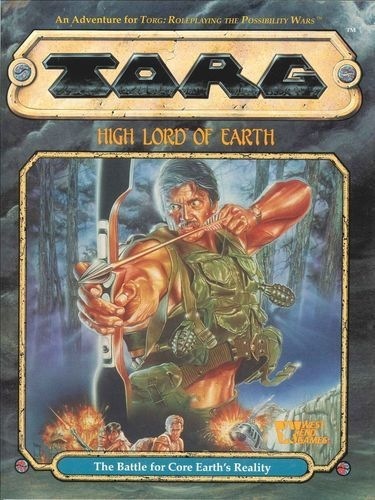
This cover has nothing to do with the adventure.
This adventure revolves around a question that had come up in the fandom: does Core Earth have a Darkness Device? And the answer, unfortunately, is "yes". It's been inactive for hundreds of years, but with the rise in Possibility energy and the arrival of other Darkness Devices it's awakened and is seeking out a new High Lord.
Like all Darkness Devices, Core Earth's is not native to the reality it found itself in. It was previously in the possession of Kurst, High Lord of Kantovia. If that sounds familiar, it's because it was brought up in the Orrorsh book; Kantovia can best be described as a "Slavic Werewolf reality", and back even before the prequel novels took place Kurst was its High Lord. Kurst ended up getting the shit kicked out of him by the Gaunt Man and Heketon, and turned into one of the Gaunt Man's followers. Kurst's Darkness Device managed to escape by dimthreading to Core Earth, specifically Mexico during the height of the Olmec empire.
The Device had suffered greatly in battle, and had lost much of its strength and knowledge. But the Olmecs didn't care about things like Possibility energy or stelae; they saw the device as a god, and worshiped it as Huitzilopochtli, the god of war. And it wasn't long until the Device began to believe itself to be the actual Olmec god of war.
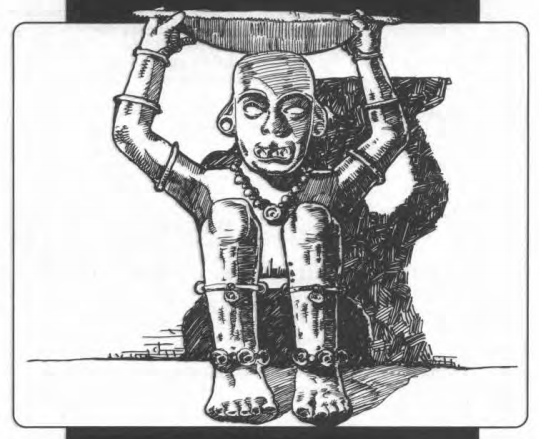
Huitzilopochtli destroyed the Olmecs, turning them on each other to test the limits of their faith. It then went on to corrupt and destroy the Mayans in the same way. The Toltecs were the next to fall. Then the Aztecs...
It wasn't until the arrival of the Spaniards in 1519 before the Device was defeated. When the Aztecs were conquered, nobody worshiped Huitzilopochtli anymore. It attempted to control the Spaniards but found them too strong-willed to control (what with no space for a god of war in their monotheistic mindset), and couldn't remember that it could seduce someone into becoming a High Lord. It wanted multiple worshipers, not just one. The invaders (not knowing what the Device truly was) buried it in a deep tomb, and that was where it remained until the arrival of the High Lords and their own Darkness Devices.
Huitzilopochtli now remembers what it's capable of, and is sending out a call for those capable of becoming a High Lord. However, it still thinks it's the god Huitzilopochtli, and wants to "restore the glory of the Aztek empire."
The current leader in the High Lord sweepstakes is Malcolm Kane badass 90's serial killer and agent of the Gaunt Man. He was promised his own Darkness Device if he signed on board with the invasion, but with the Gaunt Man out of the picture he's decided to get one on his own.
I'm not going to go into detail about the adventure, mainly because it's pretty straightforward. The PCs are tracking Kane across the world and hear about weird happenings in Central America, where there's no invader presence. A zombie plague in a city in Belize turns out to be the outcome of a sacrificial ritual, which ends up pointing them to Tikal in Guatemala. They fight ancient spirits as a "test" and learn that Kane is headed to Teotihuacan.
The important part of the advetnure is the last Act, where the PCs have to both stop Kane (newly empowered as the High Lord) before he can set up a stelae zone and bring Huitzilopochtli back to the height of its power. The main advantages that the group has is that Kane doesn't use his High Lord abilities to start with since he's not used to having them, and that Huitzilopochtli barely had any energy to give to Kane to begin with.
If the group defeats Kane, then the Darkness Device will try to tempt one of the PCs into becoming High Lord. It does so by making a bunch of charm skill rolls against the group to see who's to weak-willed to be an effective High Lord (it wants someone willing to serve it). It tempts the PCs with power enough to save Earth; all they have to do is plant the last stelae and Huitzilopochtli will create a bridge to the "realm of the gods" (actually Kantovia), re-empower itself, then return to Earth and make one of the PCs a High Lord and spread a reality of blood sacrifice and death.
Assuming the party refuses, they can try to destroy the Darkness Device itself, but given how powerful it is that's pretty much suicide. They could destroy the stelae in the area, but that leaves the problem of an active Darkness Device floating around. The actual way to win is to do what it says: plant the last stelae. Then, once Huitzilopochtli has gone up the bridge, uproot the stelae and let Core Earth's reality destroy the bridge. Huitzilopochtli will be trapped in the other reality, problem solved.
But what if none of that happens?
There are two failure states in this adventure: either Kane drives off or defeats the PCs and plants the last stelae, or one of the PCs accepts the offer to become High Lord. If Huitzilopochtli isn't stopped and manages to create a High Lord, then a new realm is created in Central America.
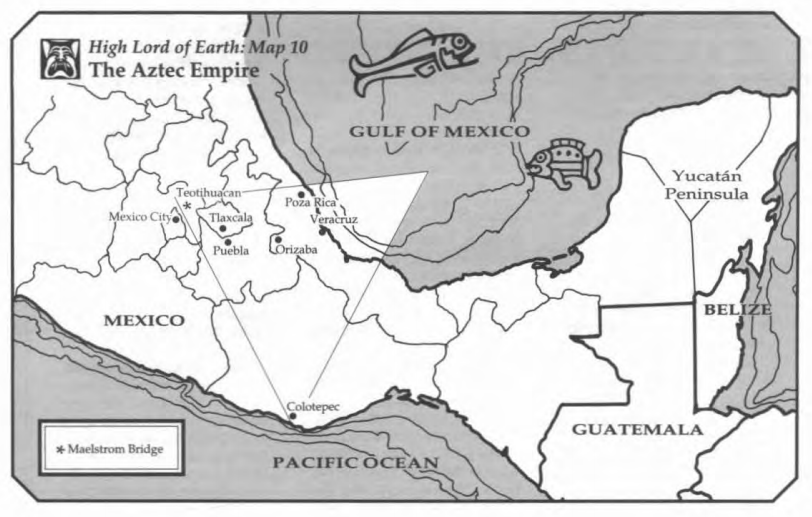
[sub]You gotta start somewhere.[sub]
This realm is called "The Aztec Empire", and will have axiom levels close to Core Earth's, only with a higher Spiritual and Magic axioms. Which means you could have fanatical Aztec warriors armed with assault rifles and slinging spells spreading across Central America. Given the situation in North America, this is a huge danger to the stability of the States. On top of that, the Empire would declare war on Orrorsh because Huitzilopochtli wants revenge on the Gaunt Man. The War enters a whole new phase, knocking many of the other High Lords' plans into disarray.
But that didn't happen.
See, while this adventure did take into account a worst-state failure, it wasn't canon when it was published. Instead, at the end of the adventure was a form you were supposed to fill out and send to West End Games, telling them what the outcome of the adventure was for your group.
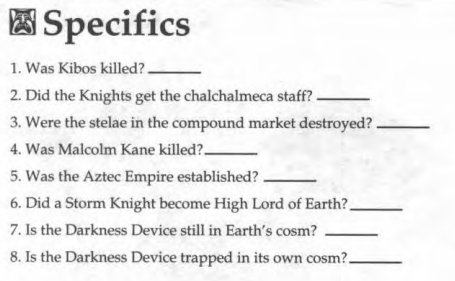
Whatever outcome happened the most would become canon, and since most groups defeated Kane and Huitzilopochtli, the Aztec Empire never happened.
But what if your group failed? Well, in this case you run into the Metaplot Problem: if your campaign doesn't line up with metaplot events, then you end up having to adjust everything that comes later to fit your non-standard campaign.
In none of the other books is there as much as a sidebar taking into account that there's an Aztec realm, or that the Darkness Device might still be kicking around Mexico. Once the adventure's over all this stuff is just forgotten and never brought up again.
So yeah.
The last thing I want to bring up in this post is an update on Jeff Mills, who (you may recall) is an in-universe game designer who's publishing a game called Five Realms based around the Possibility War that everyone's involved in, and who seems to know more than he should be expected to and keeps slipping through people's fingers. He's still popping up here and there, at one point being invited by the president to speak to the Joint Chiefs of Staff.
Now, none of this has anything to do with the next book; I just wanted to show you the stuff I'm not talking about so you can perhaps see why I'm not spending time on it.
NEXT TIME: Going native!
The Land Below
Original SA post The storm has a name... - Let's Read TORG
Part 20a: The Land Below
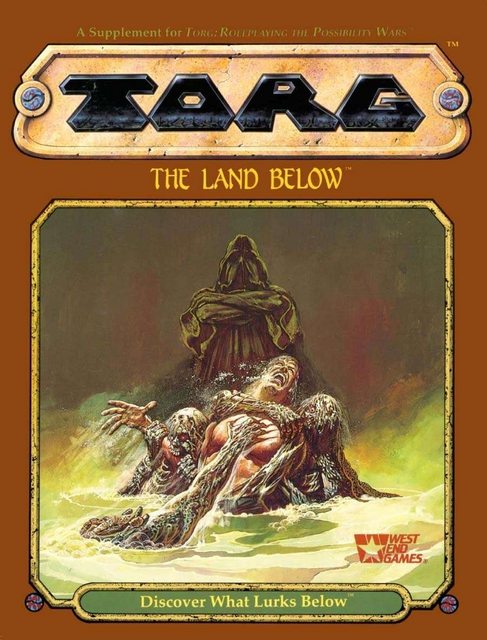
A group of explorers run through a jungle, pursued by a beast from another time who sees them only as food. They're heading for the ruins of a temple in hope of shelter...and in further hope that there aren't traps for the unwary in it.
A phalanx of Nile Empire troops escort a truck of supplies down a tunnel deep into the Earth. What they do not know is that their path will take them through the hunting grounds of ancient Egyptian demons that devour the souls of the unworthy.
A Storm Knight in Nippon Tech evades his pursuers by running into old forgotten subway stations. In his rush, he doesn't realize how far underground the stairs and stations go...until he finds himself in a rusty sub-basement that seems like it's been abandoned for decades, except for the fresh blood on the walls.
As above, so below.
Legends of the Underworld
The Land Below is very, very difficult to summarize, because there's really no central idea there.
This isn't an invading reality. There's no High Lord, no stelae, no long-term plans or agendas.
Yes, technically it's a realm and as such has its own axioms and World Laws, but really more than anything else it's just...there. It only really has one effect on the metaplot (admittedly, it's a major one, but still it only really impacts things once).
The Land Below, as presented in the majority of the book, is a lost world, a straight-up Hollow Earth style jungle full of strange beasts, lost tribes, and forgotten ruins. It's also a universal "Underworld" for every reality it touches. And it touches all of them, tendrils of reality reaching up and forming into each realm's image of the darkness below the world.
That last part is the most interesting bit. It's also the one that gets the least attention.
The Land Below was actually the brainchild of Baruk Kaah and Dr. Mobius. They allied with each other at the beginning of the war, and needed a way to move people and supplies back and forth. Of course, being on opposite sides of the planet would make that tricky, especially since technology wouldn't work in the Living Land so it's not like you could fly stuff in.
To get around this, Kaah and Mobius had their respective Darkness Devices communicate with each other to form an underground tunnel between the Living Land and the Nile Empire. Surprisingly, the Devices agreed and began twisting reality to form the tunnel.
But large-scale works like this are tricky, and can have unexpected consequences. As the tunnel created by the Khefertiri Idol extended, it "absorbed" the Egyptian concept of the Underworld from the minds of the people it was draining Possibilities from. On the other side, Rec Pakken's end of the tunnel carried with it the natural forces of the Living Land; branches and sub-caves formed like weeds, splitting off from the main branch.
Creating a sub-reality takes a lot of energy, and as the tunnel neared completion the energies of all the realities began to leak into the tunnel. After all, every culture has some sort of legend or mythos about an underworld of some sort, be it a place where the "damned" go, or just a shadowy reflection of the real world.
And when the tunnel was completed, these legends bled into the sub-realm. Or maybe it was the other way around. It's always hard to tell.
Regardless, now this new pocket dimension brushed against all the realities involved in the Possibility Wars. This was a surprise bonus to the Darkness Devices, because this new realm also had its own people. Tribal, violent, warlike people. People who could very easily be molded into new High Lords.
quote:
As the war dragged on and Baruk Kaah and Mobius enjoyed ever greater victories, both Devices agreed that their High Lords were too concerned with the trappings of personal power. They were not creating enough destruction to suit Rec Pakken and the Kefertiri Idol's desires.
However, the Land Below was a savage realm where the ambitious and destructive could quickly rise to power. In their savagery, these people would also appreciate the usefulness of such destruction. Here was a realm most suited to breeding a High Lord worthy of becoming Torg.
Of particular interest is the domed world of Merretika, deep within the Land Below and home to Damo Kil of the Leopard Men and Hadian Fel Arof the Pyrian Fire Tamers. However, to develop the skills necessary to rule a cosm, such individuals needed challenges; the warlords of the Land Below needed to learn about technology and magic, for without that knowledge they would face swift defeat at the hands of advanced cultures.
After all, what doesn't kill you makes you stronger.
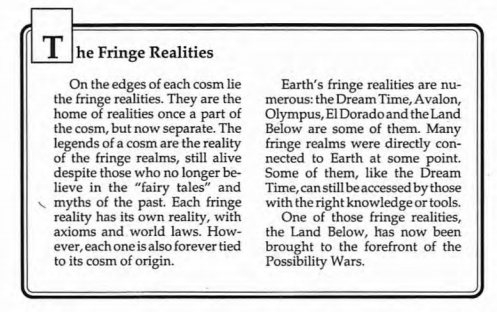
The idea of "pocket dimensions" crops up in Torg from time to time, usually in passing. The most obvious example is the GodNet, which is both the actual physical internet of the Cyberpapacy and at the same time a pocket dimension. Through the Inifniverse updates, there would sometimes be new sub-realms that crop up and can be slotted into a campaign. There were realms based on myth (such as Atlantis, Olympus, and Avalon), there were realms that tied into the backstories of NPCs (such as the home of Sabathina, one of the Gaunt Man's servants), there was even a "cartoon" realm that was the Torg writers' attempt to do comedy.
But the Land Below was the only one that got its own book. Most of the book details Merretika, a large domed underground jungle populated by savages and peppered with strange prehistoric beasts and ancient lost ruins; a world full of ancient wonders thousands of years old...only they were just created last year. And I know what you're thinking: "that sounds kind of like the Living Land."
And you're right; it's very similar. In fact, the Living Land in Torg Eternity, the new edition, has more in common with the Land Below than the original Land as presented in the core and its own book. In fact, you'd be justified in thinking that the Land Below was designed to fix the Living Land by replacing it. Except that the Land Below was hinted at in the early books, which just makes the Living Land redundant, even though it actually came first.
On the plus side, since there's not much here, we should be able to get through this book relatively quickly.
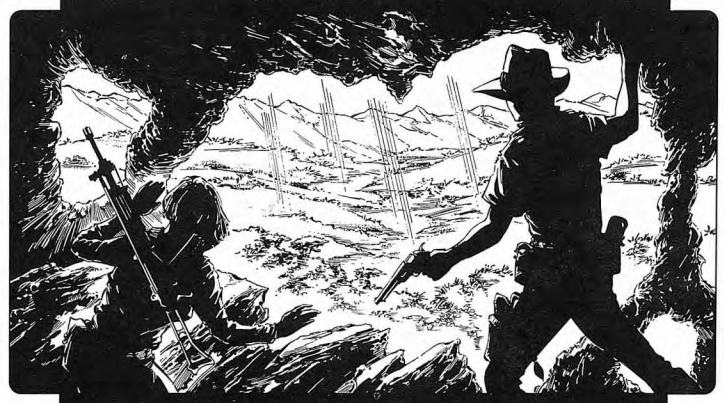
Well, there's somethin' you don't see everyday.
There's no High Lord for me to bring up, but I'm still going to get into the axioms and World Laws. And it's important to note that while the Land Below does have its own axioms and Laws, they only apply to the parts of the realm that don't touch other realms. Those areas operate under the axioms and Laws of the realm they're part of. For example, where the Land Below pushes up into Aysle, there are old-school dungeons, mines, and caves populated with the sorts of beasts you'd expect. In those caves, the Laws and axioms of Aysle hold sway, but once you leave them into the "proper" Land Below, you move to those axioms.
Anyway, the axioms are:
Magic: 12. Slightly above Core Earth's, just below Orrorsh's. Spellcasting is possible, but doesn't see much use in the jungles. Most sources of magic are the ruins that dot the landscape, many of which are only possible because of magic. That said, there are a lot of natives with inborn magical talent; they tend to position themselves as shaman.
Social: 8. At one point above the Living Land's, the social axiom allows for multiple distinct tribal societies, but not much else. This axiom is low not so much because the inhabitants haven't advanced much, but because there simply aren't enough native dwellers to create a larger society. There is a rudimentary justice system in place, complete with the idea of eye witnesses, but the harshest punishment is usually banishment rather than a straight death penalty.
Spiritual: 17. This is the highest axiom down here. While there are multiple religions in Merretika, they tend to exist only to one tribe and are either monotheistic or based around a handful of "protector spirits". Miracles are possible, but there aren't many unique miracles.
Technology: 10. Unsurprisingly low; the tech axiom does allow for better weaponry than the Living Land (such as bows and metal blades) as well as rudimentary medicine. That said, hunting and gathering is still the main source of food, but since you can't swing a spear without hitting some sort of game most of the tribes have abandoned the nomadic lifestyle. Only one tribe has actual writing and what we'd consider scientific research.
The land below has three World Laws, but one of them is the Law of Action, which is identical to the Law from the Nile Empire, so I'm not going to reiterate that here.
Of the two new Laws, the one that holds the most sway is the Law of Savagery. This law states that the Land Below is a harsh one; survival must be fought for day-to-day, there are no guarantees. Cunning and intelligence will only get you so far, what matters is who's left standing when the blood settles.
The Law of Savagery has two mechanical effects. First off, players cannot play cards for non-physical actions in combat. You can still taunt or maneuver, but you can't use cards to get bonuses to those actions. Second, when "attack" is an approved action, you only get to draw a card when you perform an All-Out Attack.
This Law also has some narrative effects. To start, characters who act more savagely are rewarded with an extra Possibility at the end of the session.
The second effect is that your clothing will be destroyed, in a tasteful PG-13 manner. Thorns will snag on fabric, natives will want to trade your interesting clothes for supplies, and every attack will rip something on someone. Characters will never end up naked, though; there's always just enough left to cover your naughty bits. Actual armor fares better (in that it doesn't just fall apart), but no matter what armor will never provide more than a +4 bonus to Toughness.
There are a few more things the Law of Savagery does, but they only apply when you're in a Pure Zone or if you're a native.
quote:
Male characters will find that their body hair grows at an alarming rate. Beards are grown in a few days and chest hair will become thick within a week. Female characters will find that their scalp hair grows at this incredible rate and after a week, their hair will reach their waists or even their ankles if their hair was already long. The new hair growth can be cut or shaved normally if the tools are at hand, but the hair will quickly grow back again.
quote:
The other physical side effect of the Law of Savagery is that physical attractions become heightened as the animalistic effects of the law take hold. Members of the opposite sex will appear more attractive to one another and latent love interests will flare to bold passion. Characters who play a romance subplot while adventuring in the Land Below receive one extra possibility point at the end of each adventure act. Also, any Charisma-based test involving a member of the opposite sex receives an automatic +3 to effect (as if a Presence card had been played).

The final Law is the Law of Wonders, which is what allows the creation of buildings and temples and such beyond the limits of the Tech axiom. This Law allows the Nile Empire engineering skill to be used in the Land Below, and even then it's only used by one tribe. Which is to say, this Law does nothing.
This all combines to create a world reminiscent of old pulps, Tarzan, Tomb Raider, or the beginning Raiders of the Lost Ark; a huge jungle full of superstitious natives, trap-laden ruins, and lost treasures just waiting to be discovered.
It's also a world on the other side of eight different realities' concepts of Hell. But you know what they say; getting there is half the fun.
NEXT TIME: The darkness below your feet is reaching out.
As Above, So Below
Original SA post The storm has a name... - Let's Read TORG
Part 20b: As Above, So Below
As stated last time, the Land Below extends caves up to the surface of the world. As people learn of them, expeditions start becoming more common as everyone tries to figure out where this giant cave network came from and where it leads. The first chapter of the book, The Caverns of Earth, discusses how people go about this and what they find before they hit the Hollow Earth stuff.
quote:
Players will undoubtedly explore the tunnels for a variety of reasons (concocted by the gamemaster). The tunnel network serves as a means of entering protected areas in other realms, discovering new races that are potential allies against the High Lords, or spoiling the schemes of the High Lords as they attempt to use the tunnels for their own dark purposes. Simply exploring the tunnels leads to a host of challenges for the players, and preparing for an underground scenario requires some special consideration from the gamemaster.
(In case you're wondering, the top two ways to get the party interested are "someone hires them to go into the cave" and "something's stolen and taken into a cave".)
The next section is about hazards, specifically natural hazards, but is shockingly very vague about the details of the types of things that you can run into while spelunking. So yes, it mentions problems like how easy it is to get lost, running into pockets of natural gas, the threat of cave-ins, but we don't get any mechanics or anything for them. They're just listed as Things That Could Happen and I guess it's up to the GM to hash out the details. The only real "new" threat is the Reality Warp, which is just a very concentrated reality storm that can last for a few days.
The next section is about Core Earth's caves. Or, to be more specific, about the inhabitants of the caves.
quote:
Many species of flora and fauna have taken up residence in the tunnel network, including a wide assortment of lower life forms such as phosphorescent fungi, bats, rodents, worms, and lizards. While many of the creatures have migrated from the surface, a large number of creatures have entered the Earth from the Land Below by use of the dimthreads.
quote:
Most of the deep-earth creatures are amphibious and hunt in both the tunnels and lake caverns. They are tremendously varied in size and shape, with some being slug-like, other bipedal, and still others having a dozen limbs. Research scientists have found it impossible to catalogue these creatures because of the sparsity of data. Specific species have yet to be identified because no one has seen more than one example of any given creature. A "fringe" theory suggests that all of the creatures are evolved from the same set of genetic material, but each individual evolves appendages and tools appropriate to its environment. The most alarming constants between all of these creatures are a gigantic maw, lined with rows of teeth, and the reckless, frenzied approach to bringing down prey.
quote:
The molemen are a race of shapechangers who are believed to have entered Core Earth tunnels from Orrorsh. However, the race quickly spread throughout the planet and the Land Below. The race forms communities varying in size from twenty to a thousand individuals.
But we do have some actual interesting things to talk about, because this is where we get to the actual interesting (and thus underused) concept of the Land Below: the underworlds.
As stated before, each realm (except Tharkold, which actually came out after this book) has tunnels connecting them to the Land Below. And where the Land Below intersects with the realms, the tunnels take on aspects of that realm's idea of an "underworld".
Sort of. Shockingly, these underworlds aren't very consistent in what they represent. For some of the realms, they're capital-U Underworlds, based on the realm's idea of a Hell. For others, it's not. Each realm does get at least two new critters to run into, but really each of these underworlds barely gets a page of content.
That said, let's see what these underworlds are like.
The Nile Empire has dozens of entrances to the tunnels, which isn't surprising given that Mobius uses the Land Below for troop and goods transport. One of the major connections is actually deep in the sewers under Cairo. The book states that "The most accessible entrance to the Land Below is in a cavern of the Land of the Dead (see The Pharaoh's Network)," but there's no section in the book called "The Pharaoah's Network" Jesus Christ did anyone actually edit these books?
The reason I'm mad about this is because there is no information about the Land of the Dead in the fucking book. Is it actually populated with the souls of the damned? Do the Egyptian gods hang out down there? Are the Scales of Truth down there? You got me! All we get here is a pointless description of ancient Egyptian beliefs, then two new monsters. And just to show you how awkwardly this information is presented, here's the context:
quote:
The Kefertiri Idol often constructs temporary cavern entrances to snatch particularly troublesome Storm Knights and Ords. These entrances seem to appear from nowhere: the offending characters walk over a seemingly solid patch of ground only to find that it collapses beneath them.
Possessing little knowledge of the true nature of the world, the ancient Egyptians of Earth did as many other ancient peoples - they made up stories to explain natural phenomena beyond their ken.
For example, to the Egyptians, the sun was not a sphere many hundred times the size of the Earth. Instead, it was a much smaller ball, albeit one that glowed brightly. When the sun "set" at night, the Egyptians believed that it actually passed through a great tunnel beneath the sands of Egypt so that it could "rise" on the other side of their land the next morning.
Historically, vast complexes of caverns that sat on top of the sun's tunnel housed much of the Egyptian Underworld. These are the stories in the Nile Empire that have helped spawn the miles and miles of tunnels and caverns beneath Egypt. Certainly, the pulp fiction elements ofthe realm are inherent in this area as well, but primarily the caverns have come to resemble the Egyptian Underworld of legend. Most creatures within the caves prowl the entire region, so Storm Knights should proceed with great care.
And that's pretty much it for the Nile Empire caves! Well, there's a bit later on when we get to the main Land Below realm, but yeah, that's pretty much it.
Exciting, huh?
The caves below the Living Land also directly connect to Merretika, and like the Nile Empire there are hundreds of entrances to the tunnels on the surface, with the largest being at Lake Michigan. The Living Land's caves all appear to be natural caverns, full of moss, dripping sounds, and pools of water that aren't as shallow as they look. The caves are inhabited by all kinds of different creatures, from giant insects to man-eating plants to regular edeinos patrols. The last one there is because Kaah has realized the strategic potential of the caves, and uses them to move troops and gospog around his territory beyond the prying eyes of the US Military.
Again, we get two new creatures. Corpul are spherical floating critters that feed off explosive gases. They're actually harmless in a general sense; at the first sign of a threat they propel themselves away via farting stored gas. In a more specific sense, they're dangerous because they're big bags of explosive gas that will go up when attacked.
The other species that's been cropping up in the caves are the ustanah. Those of you with very good memeories will recognize this name (although even then it's unlikely) from the Living Land sourcebook. The ustanah were the mantis-like "advanced" species that inhabited the edeinos' world and were wiped out ages before Kaah rose to power. Nobody knows if these are the actual ancient race come back from the dead, or a completely new race that just happens to look the same; while they're clearly intelligent, nothing's known about their society. They're clearly tool users, have a spoken language, and some sort of social structure, but beyond that all encounters with the ustanah (with one notable exception of a National Guardsman) so far have been violent.
That's a pretty cool idea, huh? A race thought extinct reappearing under the lands of the race that wiped them out? Too bad that's the last this is discussed! Time to move on!
The tunnels under Paris present a very interesting problem for the Cyberpapacy. For starters, the existing Parisian tunnels are a constant battleground between the city's many gangs, members of La Résistance, and the Church Police. Then, on top of all that, the caves have worked their way up to connect to the tunnels. The caves have been affected by the beliefs of the realm, and have transformed from the usual natural caverns into the Inferno: the common view of Hell.
And it is indeed what most of us probably imagine when I say "Hell". Rivers of lava, flame pits, walls of fire, and both "traditional" and cyber-enhanced demons.
quote:
The presence of the Inferno has become a well known folk-tale. The Church has pronounced that the Inferno is part of a demonic plot to take over France, but spies report that Malreaux is pleased that his subjects have such a vivid reminder of what happens to heretics when they die.
Two types of demons are stated up. One type is the swarmer, and they're your cartoonishly stereotypical demon; red skin, horns, tail. Where they differ from the popular conception of demons is that they're chock full of nanotech they use to infect targets.
quote:
One hand of the demon is a water hose sized nozzle and the other is a spike about the width of an ice pick. The tip of the spike is open as well. The larger nozzle is a nanotech discharger and is used to spray millions of nanotech beings at opponents (this is a missile weapons attack, with a range of four meters, covering a 120 degree arc). Any opponents in melee combat with the swarmer who are in the path of discharge suffer a -3 modifierto any dodge attempts. Opponents hit by the attack will be infested with the dangerous nanotech beings, which slowly deaden the nerves and reflexes of opponents. Those who are infested suffer damage value 12 each round, although those with sealed battle suits will not suffer damage for the first two rounds.
The other creature is the NerualJack Nightmare. These demons are pale humanoids jammed full of cyberware and sporting eight cables out their back. The Nightmares can control these like tentacles; two of them are monofilament whips, but the other six are actually neuraljack cables. If the Nightmare can get a vital blow attack result against someone with a nerualjack, the cable will connect to the victim's port and drag their perception (and conciousness) into a prison construct in the far reaches of the GodNet. Once that's done, the Nightmare will take over the victim's body in five minutes and gain access to their skills and cyberware. The only way to save someone who's been taken over is to kill the Nightmare; just cutting the cables won't do it; in fact it'll make things worse because the mind prisons of the Nightmare are hosted on a server inside its own body.
Unsurprisingly, Aysle has adapted best to the tunnels since they're really just D&D dungeons. If anything, the native Ayslish don't even realize that the caves and tunnels aren't supposed to be there. And really, they're just...dungeons. It's just the Land Between from back in the Aysle cosm, only on Core Earth now. The dwarves have taken to the tunnels like ducks to water, and have been mapping out the caverns and setting up small colonies. The two new creatures aren't even that interesting: the cave dragon (excuse me; "draconic cavernum" :jerkoff:) and gremlins, which is just an underground race of little impish jerks.
Oh, wait, sorry, there's actually three new creatures! We also get a new monster race: Monoliths
quote:
Monoliths appear as hugemen, over four meters tall, with skin the color of stone and faceted like a cut gem. They wear simple clothes bound with iron bands and carry large battle axes with shafts of iron and a blade of faceted stone. They always travel alone, never speaking or communicating with any other beings. They often seem preoccupied with their travels, only taking notice of those who bar their path. Anyone who obstructs a monolith (accidently or otherwise) is attacked until the way is clear. The origin of the geas which compels the monoliths is unknown, as is the race's origin, but it is bad fortune indeed to be the target of a monolith's quest, since the creature never rests until the quest is complete (it moves at a speed value of 12). It is known that monoliths require neither rest, nor food, and possibly can exist without air.
And yes, I know, early 90's design, we didn't know better, etc. and so on. But it's still frustrating to look at this with 2017 eyes and see how much wasted potential there is here. But I'll talk about that more at the end of the post.
The Nippon Tech tunnels are very numerous, and almost all of them connect to urban centers. The "caves" in this region take the form of sub-basements, abandoned subway tunnels, and sewage systems to match the realm's aestheic.
quote:
The underworld is madeup ofsubway tunnels, basement complexes, and networks of corridors with walls sheathed in steel. Just as
Japan scarcely realizes it has been invaded by another reality, so too is it difficult to realize that the world below Nippon Tech is anything other than man-made passages. Actually, the underworld was created in the same way as the tunnels below other realms and Core Earth, but the Nippon Tech underworld took on the technological image of its realm.
At least the new Nippon Tech creatures are interesting, because they're actually thematically tied to the culture of Japan.
Kensai spirits seem to be "ancestor spirits", appearing as Japanese men wearing medieval clothing and wielding katanas. They're drawn to high technology (or people using high tech) for unknown reasons and the sole purpose of destroying/killing them. For the purposes of this desire, "high tech" is defined as anything with a tech axiom above 24 (Core Earth). What's even stranger is that under Nippon Tech axioms, spirits aren't possible; in fact, they automatically make a very strong intimidation attempt the first time they encounter someone who's never seen a supernatural occurance before.
The other creature...is Godon. And Godon is a classic kaiju.
quote:
The memories and fears of atomic weaponry inspired the Japanese movie monster genre. That subconscious fear of total destruction has manifested itself in living incarnations of these apocalyptic creatures, although none have appeared - yet. A half dozen of these giant creatures sleep under the nearby seas or in massive caverns. Such events as earthquakes, volcanic eruptions, or weapons testing could awaken one of these beasts and cause a rampage through Japan or China.
There are rumors that Kanawa scientists have uncovered a sleeping behemoth and are trying to discover ways to control the beast so that they could awaken it and use it as a potential weapon of war or sell its services for profit. Godon is a typical example of this type of creature, although particular characteristics vary greatly from individual to individual.
Lastly, we have Orrorsh. (Sorry, cyberdemon fans, this book came out before Tharkold.) The Gaunt Man is well aware of the caves and the Land Below, and has instructed his Darkness Device to extend the Orrorshian stelae boundaries a kilometer below ground level to ensure that the caves fit into his Ecology of Fear.
The upper levels of the caves take the form of barrows, ancient tombs, and other unhallowed ground. Mass graves are common, all filled with the "pagans" who the Victorians were unable to convert in the past. Tombs for those poor souls excommunicated by the Sacelleum abound, and below your feet you can always hear the scrabbling of the undead attempting to claw their way back into the land of the living.
And that's all before you even hit the 150 meters down mark.
The remainder of the caverns are less interested, but no less deadly. The creatures that spawn (and believe me, "spawn" is the correct word) in the depths aren't the capital-H Horrors that thrive on the surface and engage in long-term scheming. These are mindless, nameless beasts, the sort of Lovecraftian monstrosities that destroy your mind just by looking upon them. Fortunately, they very rarely make it to the surface...unless summoned by a dark ritual.
One of these beasts is the Nightmare Worm, one of the creations the Gaunt Man is most proud of. Nightmare worms are 10-foot long insects that look like caterpillars with human-ish faces, from which spout four long poisonous tendrils. When a worm is summoned, it bursts from the ground to attack its prey; a hit with the tendril does damage and has a chance of infecting the target with a poison that both decreases the target's Mind stat, but also paralyzes them with fear for the rest of the fight. If you live, then the lost points come back at a rate of one per hour. If your Mind drops to zero, however, you are driven irrevocably insane.
The other new creatures are wights, rumored to be the souls of people so foul, not even the devil would let them into hell. This is wrong, of course; the Gaunt Man takes those souls and traps them back in their original bodies and sets them loose upon the world they hate. Wights appear as deathly pale humans dressed in the tatters of their burial outfits, and are driven to seek out and murder any living being they can. Apart from their natural teeth and claws, wights possess the chill of the grave; when a wight simply touches someone, both the wight and the victim roll their Spirit against each other. If the wight wins, then the victim takes additional damage based on how much it won by.
Since these are Orrorshian creatures, they also have stuff like Corruption Values, Weaknesses (the worms' is open flame, the wights' is sunlight), and True Deaths (for the wight, you just need to destroy the body with damaging miracles, but the worm has to be "cast into a volcanic pit after each tentacle has been severed by a blessed blade").
And apart from a page-long sidebar about dimthreads that has nothing to do with anything except trying to settle the game's metaphysics with the stuff as presented, that's the end of the chapter.
--
What a wasted opportunity.
I know I say that a lot, but really, there's no other way to put it.
The idea of a "realm" that's basically each reality's version of the "underworld" is an idea with a lot of potential. And you can see bits of it poking out here and there. The idea of Japan's nightmares coming back to fight against what Japan has become. The idea of Hell being a physical place you can see in the Cyberpapacy. The idea that a race the edeinos wiped out ages ago may have come back. The idea that everything underneath Orrorsh is a mass underground graveyard and below that are the Things Man Was Not Meant To Know.
But they don't do anything with any of it. They're so focused on getting to the "Hollow Earth" stuff, any idea they had here is half-finished or just left by the wayside. Does the Hell under the Cyberpapacy connect to the Hell sector in the GodNet? What kinds of things can you actually find deep under Orrorsh apart from the nightmare worms? Why not have the Egyptian underworld gods under the Nile Empire? What's the deal with the Monolith race; why are they always questing? Why not something? Hell, there aren't even any illustrations in this chapter I can show you to break up the wall of text! The book can't even keep a consistent definition of "underworld"; sometimes it means Hell, others it just means a bunch of caves.
Back when I started the review of this book, I did my usual thing of giving a few bullet points about what happens in the realm, and one of them was a guy stumbling into the "caves" under Nippon Tech and implying if it was a Silent Hill kind of situation. Someone asked me if that was in the book, or if I exaggerated it to make it more interesting.
The sad fact is that I had to exaggerate it; as much as I'd love to say that there's . Because that's all you can do with these idea. They're not settings. They're barely frameworks. What they are is a speedbump on the way to Living Land Again. Which, believe it or not, is still two chapters away.
Man, what could have been...
NEXT TIME: Flora and/or fauna
Are we there yet?
Original SA post The storm has a name... - Let's Read TORG
Part 20c: Are we there yet?
Before we can get to the Land Below proper (which is to say, the land of Merretika), we still have another chapter of dangerous plants and beasts to get through. This chapter is called Entering the Caves, which feels more like it should be called We Need to Pad This Out to 90 Pages.
This may be a close second to Aysle for my least favorite book in the game line.
For some reason we start the chapter off with about half a page about Belladereth Dularent, an Ayslish researcher who first discovered the Land Below because who the hell could possibly care. We then get a general description of the realm in a grand sense.
quote:
The Land Below is a huge mass of rock in the form of an oblong cylinder. It is nearly 25 million kilometers long and over 10 million kilometers in height and thickness. The cylinder is everything in the realm - there is nothing "outside" the cylinder, not even a void. There is simply no physical space outside this amazingly large hunk of rock.
Within the rock are millions of caves and caverns. The surface area of the known tunnels easily exceeds the surface area of the Earth. The whole of the realm is filled with an oxygen rich atmosphere especially hospitable to humans.
The caves are home to all kinds of creatures both known and unknown. Many creatures have migrated across to the Land Below from Earth. Unlike the Earth, there was never a great cataclysm to wipe out the dinosaurs, so most varieties of Earth dinosaurs can found. Creatures from all of the major epochs can be found within different sections of the caves. In addition, creatures seemingly native to the Land Below are quite common, encompassing all of the major biological groups.
I get it, okay? I get that the caves can be different sizes and that there's all kinds of weird plants and shit down there. You told me that in the first chapter, I didn't forget this 20 pages later. I'm honestly wondering if this was a "pad the book" thing, or if they were worried that the reader wouldn't "get it" without the constant reminders.
Of course, in a few chapters' time I'm going to be complaining about the unneeded levels of detail on other stuff.
I have been doing this for over four and a half years.
...
So! Let's talk about plants!
quote:
The dominant plant life forms of the Land Below are moss and fungi, although ferns can be found in small quantities. More sophisticated plants like bushes and trees can only be found in the domed worlds.
The fungi come in all shapes and sizes, with some growing as high as ten meters. Common species are less than one-meter tall, with several short stem-like protrusions growing vertically out from the main root. They typically have well-developed roots which are able to absorb the requisite nutrients and moisture from the soil, while the protrusions absorb scarcer materials from the air. They are an excellent source of nutrition for most of the animals in the realm.
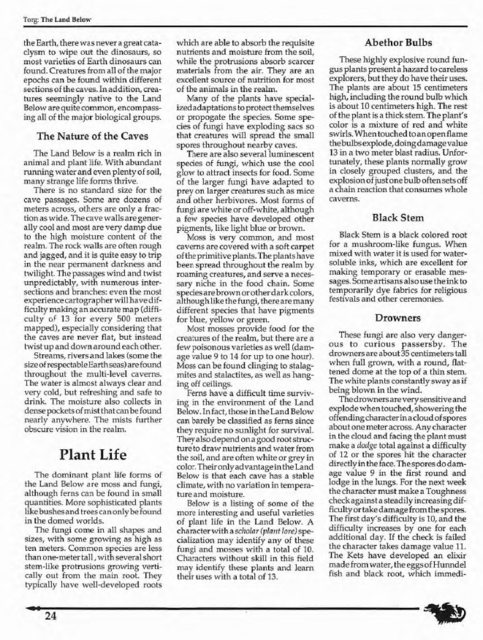
Imagine trying to describe a whole line of books, that all read like this, for years.
Now do you see why it takes me so long to write and summarize these things? Torg books have very little art (I think I've posted like 75% of it over the years), so the majority of the books are these fucking walls of text with badly-sized section headers and things generally not described in a logical order or given the attention they should be.
For instance, in this chapter we go from "more Caves 101" to plants to animals to describing two of the civilizations in the Land Below, and the two civilizations barely get more descriptions than the animals in this chapter!
Whatever, let's just get through this chapter.
The plants described are all either monsters or mysterious healing herbs, and have the usual lazy "bad Scrabble hand" names, such as "Sata'Char", "Tbathap", and "Zeta'ckl Moss". Each plant type except for the drowners gets one paragraph of description and mechanics, so clearly the writers cared as much as I do about them.
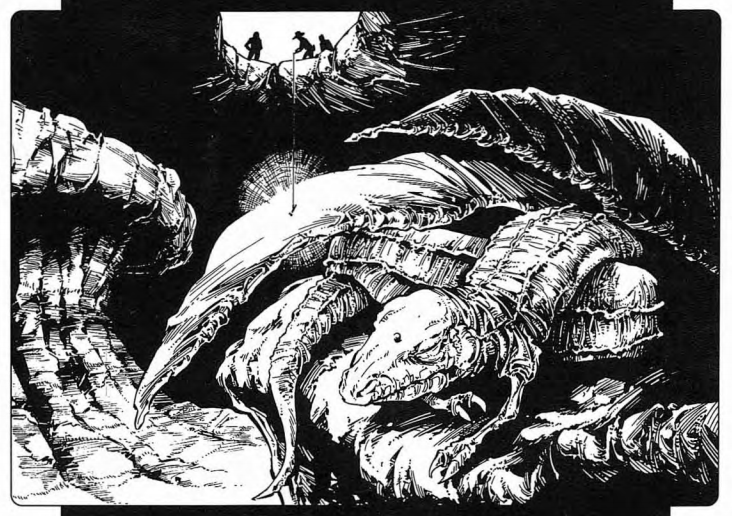
That sure is a big whateverthehell that is.
Only two animals are described. Atten are birdlike critters that are very common in the caves. They've adapted to the perpetual darkness by having sonar, and adapted to dealing with prey by having razor-sharp talons. By themselves they're not much of a threat, but when you stumble into a nest of 30 of them protecting their eggs, that's a different story.
The other new creature is the Rassitar, which is basically a big cave-dwelling crocodile. The book can't even come up with anything interesting for them, so why should I?
We from here we get descriptions of two new underground civilizations, the Kets and the Wanneck.
Kets are short humanoids with "pale brown skin" and oblong heads, with the eyes set deep in the skull. They have four fingers on each hand, but with two fingers each opposed to the other pair. They're pretty low on the Tech scale (they're just recently getting into animal domestication), and are very hostile to outsiders due to their low numbers. That said, they have a "predictable" facination with both magic and technology, as well as a good amount of knowledge about the local plant life, so they'd probably made good guides.
The Wanneck are a "proud, but friendly people" with solid builds and "deep brown to black skin." They have a multi-tribal structure, but interestingly none of the wanneck tribes have ever warred with each other. They started a few permanent city-states and have learned to use metals, so they're clearly advancing up the tech tree pretty well. The wanneck are hospitable and not above giving explorers food and shelter, as long as you're willing to pay them back in communal work.
I can't really think of a good segway for the next topic, so let's go on to Domed Worlds.
Dotted throughout the Land Below are what can best be described as "bubbles", ranging from a few hundred to several thousand kilometers across. These are the Domed Worlds, and while each of them is unique they all abide by the axioms and World Laws of the Land Below. Only one of these worlds is described (Merretika, which we'll finally get to next chapter), but we don't really get any information about what they're like.
quote:
The domes worlds are rare (perhaps one every few thousand kilometers), but they provide a much easier existence than that of the caverns. Each domed world normally has several unique species of creatures (as well as many common to the Land Below), as well as at least one intelligent race. Terrain within the worlds is frequently plains or mountainous, although swamps, jungles, forests and even deserts can be found in some of the worlds.
Sometimes you can also stumble into the remnants of Lost Civilizations; ruins with a clear influence from ancient Core Earth cultures such as Hellenic Greek, Mayan, or Imperial Chinese. Or from civilizations that have no clear analogue on Core Earth or any of the invading realities. Regardless, they always seem to have been abandoned centuries ago (despite only existing for about two years) and can be a source of strange artifacts.
The chapter closes out with this section about Knowledge:
quote:
Once characters have entered the Land Below the most valuable treasure is knowledge. Characters will be desperate to secure steady supplies of food, water and shelter from the more aggressive creatures. They will also want to acquire weapons and probably salves and potions made from the natural plant life.
They can be given this information by native tribes or wandering individuals.
After a time the wanderlust of the characters will ignite the desire to leave the Land Below no matter how comfortable an existence they may have been able to eke out. They could always just wander back into a dimthread to lead them to Earth, or they might enter Merretika and discover the Nile pit or the Living Land waterfall. They might also encounter other groups of wandering Storm Knights, and between them they may be able to formulate a plan for escape. The final option is to have them acquire a mystical artifact loaded with divination knowledge so that they may be able to find their way home.
--
...
Yeah, I got nothin'.
NEXT TIME: You have reached your destination.
Merretika
Original SA post The storm has a name... - Let's Read TORG
Part 20d: Merretika
Here we finally are: a third of the way into the book and we finally get to the central location.
Merretika exists in an enclosed dome about 320 km in diameter and 130 km high at the tallest point. Floating just below the top of the dome is Helephez, a tiny sun that lights and warms the whole realm.
There are six available entrances to Merretika. Four of them are just generic caves so we don't need to talk about them (even though the book does). The other two are connected to both the Living Land and the Nile Empire, so those get some more detail.
The direct connection to the Living Land is The Great Waterfall.
quote:
The source of the waterfall had been a subterranean river, but just a few months ago Rec Pakken created a giant chasm in Michigan, and used a permanent
dimthread connection to connect to Merretika.
Because we need to give a complete page over to The Nile Pit! The Nile entrance to the caves is a nearly perfectly circular 5,000 km pit dug straight down from the Land of the Dead. The top of the pit is surrounded by mining areas and staging areas, used by Mobius to move troops down into Merretika itself. This is handled by a specially designed levitation device, which is really just a large round platform under a giant ray that has the flight power built into it; the platform can carry about 60,000 kg of supplies, but the trip takes about 20 hours.
Oh, and since this is a Nile device? Yeah.
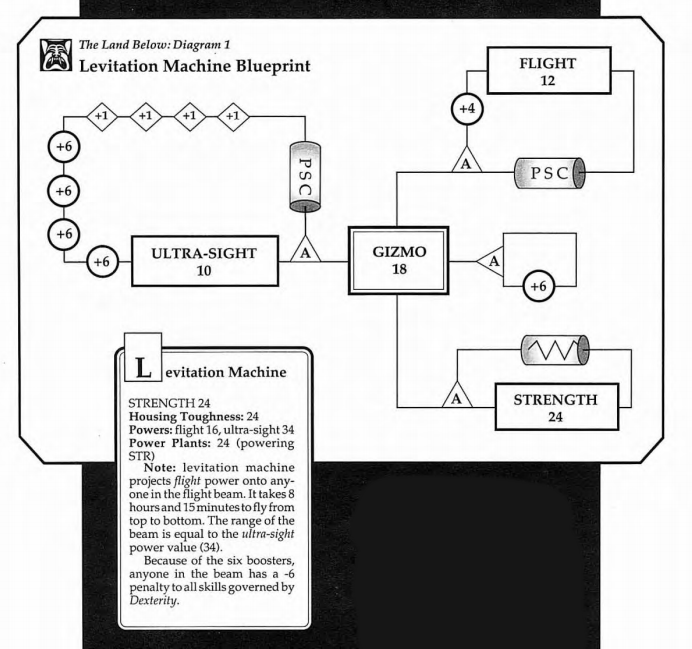
That's strange, my eye just started twitching.
Because God fucking forbid we just have a thing that doesn't have mechanics attached to it. Bear in mind that there's a whole page of text dedicated solely to the background and day-to-day use of this thing.
quote:
The Nile expedition uses a backpack radio to command the operator. Each trooper carries a flashlight and a radio; once he has passed through the Land Below pure zone he turns on the flashlight to see how far down the cave floor is. Once the bottom is spotted, he radios for the operator to slow the flight speed. Both the flashlight and the radio only cause short-range contradictions in the Land Below dominant zone. There is a slight margin of error (due to the intricacies of the machine and human error), so delicate goods cannot be sent down unless they are well-packed.
And once again, since nothing in Torg is presented in no sort of real order, we get to a brief description of Helephez, the miniature sun. The various races in Merretika all worship it as the creator of the universe.
Here's the thing, though. Helephez, the sun...has a stat block.
No, really.
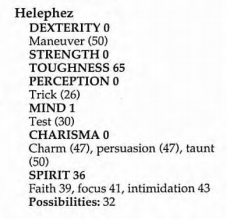
That's the sun's stat block. Not listed in the block itself is that the sun attacks with a spiritual attack that's about twice as damaging as a direct mortar shell.
Now, the book does explicitly say that the sun is actually a creature, which does nothing but just hang in the sky and provide a perpetual day.
But.
You know how we talk about how rules-as-physics lead to all sorts of ridiculous edge cases, like how Aylsih Ords have a pretty decent chance of killing themselves when casting utilitarian spells? This is even worse, because it raises so many ridiculous questions and scenarios.
To start with, why make the sun a creature in the first place? What does that add? What does it accomplish? What's the point?
But then we look at the stats. They're really just there to provide difficulties for social attacks and spells, but again these just raise ridiculous outcomes. You could potentially bluff the sun. Or "stymie" it. You could maneuver around it and distract it.
Except that it's unintelligent. The Mind stat is lower than an animal's. Again, all it does is hang in a specific spot in the sky. It's just...there.
So why give it stats?
Seriously, what's the point? Were they honestly worried that PCs were going to get up there somehow (no idea how; there's no tech and barely any magic) and try to blow up the sun? Was that a concern?
90's design. I don't miss it.
But anyway. We're finally in Merretika.
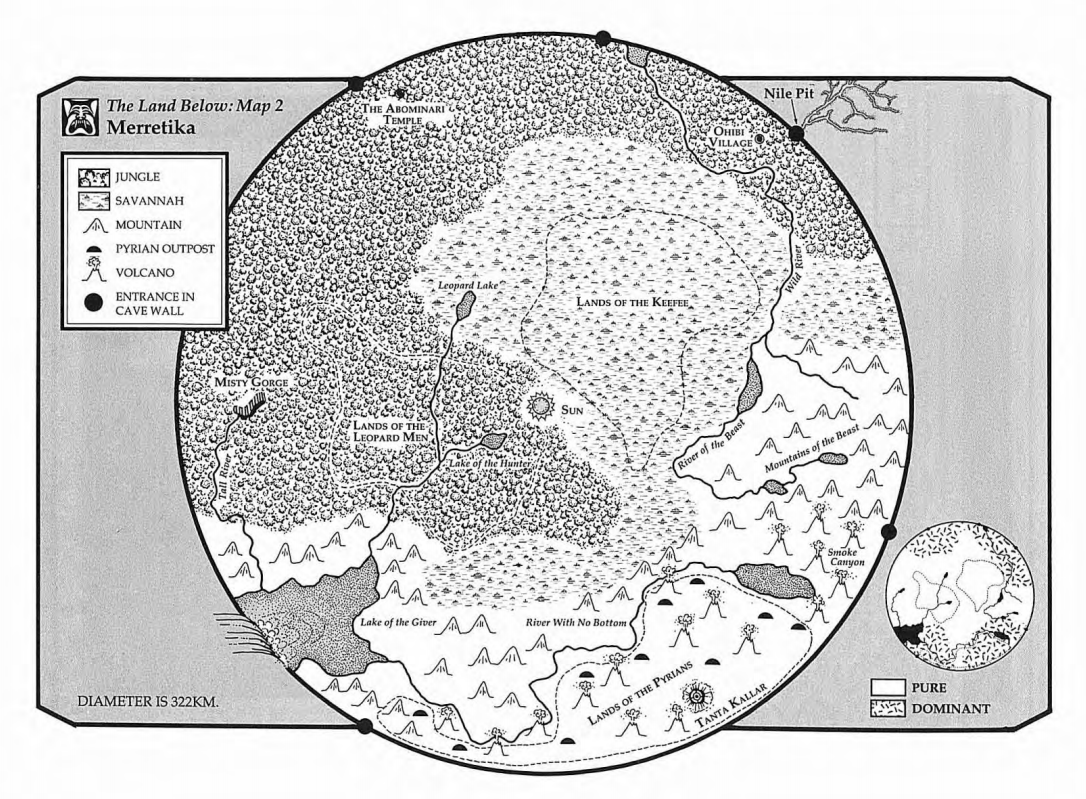
Biomes!
The domed world is comprised of various different biomes under a perpetual day. There is no night, no seasons, no other types of weather except "hot day" and the occasional light rain.
The three largest land types are the savanna that takes up the rough middle of the dome, the dense jungle to the "north" of it, and the mountains and volcanoes to the "south".
(Directions like north and south don't really make sense in Merretika, since compasses don't work and the concept of cardinal directions doesn't exist for the native tribes. The terms are just used relative to the provided map for convenience.)
There's not really much to talk about in terms of generalities here, even though the book goes into just over a page telling us what savannas, jungles, and mountains are. The only real thing to note here are the volcanic fields in the mountains, which (in accordance with standard Lost World procedures) are always either erupting, have lava flows, or are at least billowing smoke.
We do get some description of the various rivers and lakes, though. The main body of water is the Lake of the Giver at the base of the Great Waterfall, from which the three main rivers flow. There's the River with no Bottom, which is chock full of whirlpools and waterfalls until it hits the volcanic lands; the Tall River, which is completely uninteresting; and the Leopard River, which is only notable because it has crocodile-like creatures in it.
And if it seems like I'm rushing through this part, it's only because I am. This stuff is actually more boring to write about than it is to read, because there's really nothing to talk about. We're about to get into some actual points of interest, but after 35 pages of who gives a shit it's hard to muster up any enthusiasm.
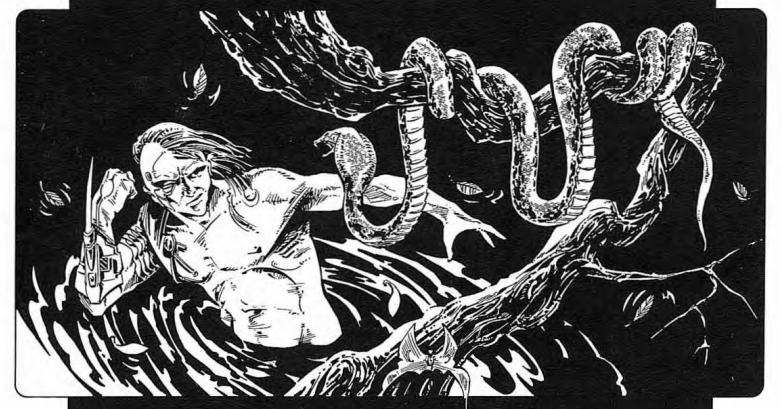
I'm pretty sure you shouldn't get your exposed cyberware wet.
So let's talk about some of the Landmarks you can explore.
In the "western" part of the realm is Misty Gorge, a kilometer-deep canyon at the end of the Tall River. Nobody knows what (if anything) is at the bottom of the gorge; the only local tribe who's spent any time near the place are the Darooni (who we'll get to next chapter), and they consider the place cursed. The humidity and waterfall make climbing into the gorge incredibly difficult, and the mists from the churning water make navigation difficult for people using magic or aircraft. And...that's pretty much it.
Huh. For a point of interest, that's not that interesting.
The largest volcano in the realm is Tanta Kallar, with a height of 1,500 meters. Another of the native tribes, the Pyrians, make their homes on the side of the volcano and have built their temple over the top of it.
At the end of the River with No Bottom is Smoke Canyon, a roiling mess of natural gasses and toxic fumes that will quickly kill anyone dumb enough to get too close. Even 60 meters away the fumes start to affect people, and at the canyon itself the gasses are strong enough to kill in under a minute.
Up in the northwestern part of the realm is the Abominari Temple, which is...different.
quote:
It is obviously the product of the Law of Wonders, with a trio of floating obelisks which revolve around a central point once every 16 earth hours. The obelisks float about two meters off the ground and are made of a shiny black and very hard (Toughness 21) stone. They are about four meters high and are covered with carved runes. Apparently growing out of the bottom of each obelisks are several long roots: at the base of the obelisk, they seem almost to be made of stone, but the ends are flexible and definitely plant-like.
Just at the edge of the dome is the Nile Empire Outpost, which is the staging area for all Nile operations in the realm.
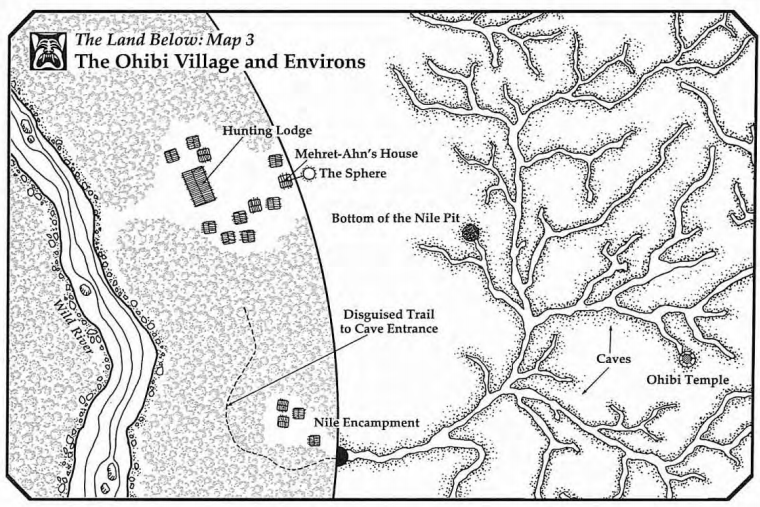
Wow, a point of interest that's actually interesting!
From here, Field Major Achmed Tunakakan maintains a very shaky peace with the local Ohibi tribal village by dint of a "don't come near us and we won't burn your villages to the ground" policy. And even then, there's no guarantee he'd win in that scenario; he only has a force of about a dozen soldiers. Yeah, they have "modern" weapons, but that's still not a lot of people. Achmed has been smuggling extra supplies down the lift, but hasn't given Mobius any real details apart from "we found a giant domed world down here."
If Ahmed learns about The Sphere, though, his plans will probably change in a heartbeat. The Sphere is a large hollow globe embedded in the earth, big enough to hold a dozen or so people if they're really good friends. There's a person-sized hole in the side, through which someone can crawl. Meditating in the Sphere for 24 hours while holding a sliver of it will imbude the sliver with Possibility energy.
See, the Sphere is an eternity shard. In fact, it's the largest known eternity shard, with a capacity of "thousands" of points of P-energy. Possiblities stored in the shards can only be used within 150 km of the Sphere, and can only be used to boost combat rolls, but if someone with designed on conquest of the realm learned about it, it'd probably be a pretty high priority. Not to mention that regardless of anything else it's a powerful eternity shard, so many High Lords would want to get their hands on it. Especially Mobius, given that he can turn eternity shards into weapons.
Lastly, there's Ohibi Temple. This temple is one of those "you can't find it unless you know where it is" types of places. There's not much here to talk about apart from noting that the leader of the Ohibi uses shards from the Sphere here to power one of his people's more important miracles.
And...that's it.
--
Someone around here (sadly, I don't remember who) once said that setting material generally falls into two categories: stuff you use in-game, and bathroom reading material for the GM.
Most of this chapter falls into the later category, and is further complicated by not even being interesting reading. We finally get some details on places you can go, but aren't given any reason to go there, or even told anything beyond a surface description. There's only one place that can really be considered a plot hook (the Nile outpost), but there's no detail there that can be spun into a game. What's Ahmed's personal goal? How far has he explored? Is he loyal to Mobius, or is he interested in forming his own kingdom down here? You got me, because the book doesn't tell you anything about him.
What this chapter really drives home is how pointless this book is. There's nothing interesting to look at down here because it's all just...generic. We get two weird temples and they maybe get two paragraphs each. Yet describing a jungle gets about half a page because who knows.
NEXT TIME: Just a bunch of indigenouses
Savage Natives
Original SA post The storm has a name... - Let's Read TORG
Part 20e: Savage Natives
Merretika, being a pulpy Lost World pastiche, is of course inhabited by numerous native tribes. We get details on five of them in the book, but it seems like these are the only five tribes there are. Which is fine by me, because god I'm so sick of this book you have no idea.
Before we get into the tribes, there's a few bits about some general ideas that apply to all the tribes:
- Because there's no magnetic pole, there's no concept of north/south/east/west. The tribes use the sun Ret-Heleph as a reference point for moving towards or away from the edge of the dome, and the great waterfall as the reference point for lateral movement. That said, there's no standard measurements either.
- Likewise, the fact that the sun never sets or dims (not to mention that there's no change of seasons) means there's no real concept of time. Tribesmen generally measure time from a personal perspective based on life events ("before that time I first killed a leopard."), but beyond that time just isn't a concept most can wrap their minds around. As such, all the timeframes for things in this chapter are given in "sleep cycles" for the most part.
- It's also worth noting that, since there's no night, natives of Merretika are pretty much universally afraid of darkness. The only real darkness they'd normally encounter is in the deep caves, which most of the tribes consider "holes of death". Even seeing a well-lit night sky on the surface would be terrifying to a tribesman.
- Lastly, the language problem. None of the tribes use the same language, which means that Torg's wonky language mechanics come into play: the first time you hear a language, you have to make a language skill roll of 12 to just magically understand it. Otherwise...
quote:
This will facilitate role playing in the realm by forcing characters to communicate with hand signals and grunts.

The first tribe to be discussed, and the one that seems to get the most page space, are the Darooni Wasp Riders.
The Darooni are a cannibalistic tribe who've based their culture and religion around a giant wasp hive. And when I say "giant wasp hive" I mean that in the sense of the wasps themselves are giant. In fact, they tend to be bigger than the Darooni themselves, who only average about five feet tall. They're called the "Wasp Riders" because, well, they've learned to bond with the giant wasps.
The Darooni occupy the region around the Misty Gorge, a.k.a. "that infinite pit full of poisonous gases that there's no reason to go to". For the most part, the Darooni proper keep to themselves; the only ones generally seen by the other tribes are the Wasp Riders themselves, who (and I quote) "capture children for food and religious sacrifices".
On the plus side, the tribe consists of only about 300 people and about 60 giant-ass insects. The down side is that they basically worship the wasps and have built their culture around some on the most evil-minded bugs known to man.
quote:
The Darooni society is closely regulated by the religion, which regards the giant wasps as superior to humans. Darooni society is very clearly dominated by females, and only women may become Wasp Priestesses and Wasp Riders, the two most important classes in the society. The most important male is The Boatman, who is responsible for trade in Darooni society. Next are the Wasp Scouts, the only men who are entitled to fly with the giant wasps. Farmers form the largest caste. Wasp Consorts are men who are taken in by the priestesses for basic tasks, but they have no formal status in the society, and are considered property of the priestesses and the wasps.
The remaining two thirds of a page are an in-depth description of Darooni trade, what they trade, how they prep it, and who in the tribe gets what based on caste.
And now you see why it's taken me so long to get to this part of the book: there is so much shit that I could never care about, let alone use. Do I, as a GM or player, really need to know how the scouts prep the game they capture? Does that help me play? I know the whole ~verisimilitude~ thing but come the fuck on.
Ugh. Now I'm remembering why I burned out on this.
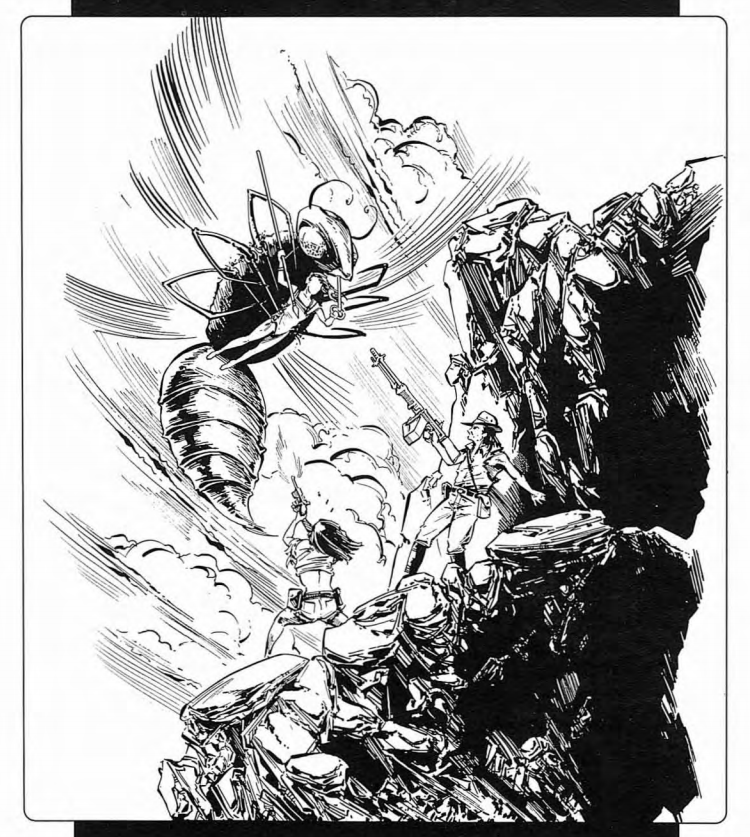
Crap, get the bug spray!
Darooni religion is based around their goddess Olakaa, who isn't described in terms of what they imagine he/she/it looks like, what it wants, or anything like that. The Darooni see themselves as the only "chosen" people, and everything else is there to benefit themselves. Hense why they don't differentiate between people and animals when it comes to hunting for food. The land, the river, everything in the area the Darooni occupy was made specifically for them (as far as they're concerned). This is especially true of the wasps; more than anything else the wasps are revered by the tribe, to the point where when a wasp dies, its rider will commit suicide rather that go on without her mount.
The leader of the Darooni is traditionally the Head Wasp Priestess, a position currently occupied by Okina Ko. Okina is shocking not described as beautiful, which I'm only pointing out because this is a 90's RPG setting based around mysterious tribes, and as such you'd expect her to be drop-dead gorgeous and barely clothed. Instead, Okina is pretty badly scarred up due to the initiation rites she had to go through as part of her initiation. Also surprising is the fact that she's not a calculating schemer, a seductive murderer, a bloodthirsty fanatic, or anything of the sort. In fact, the only real information we get about her is that she's afraid that the leader of the Wasp Riders may be getting ready to stage a coup.
Speaking of: the Wasp Riders. Every young girl in the tribe is groomed to become a wasp rider, and are trained in riding and spear hunting as early as possible. It's worth noting, however, that you can't just become a rider; there's a special bonding ceremony that I'll get to in a minute. As mentioned, men can also become riders, but they're not allowed to use (or to be trained with) weapons.
The current leader of the riders is Kihiti Dok, an ambitious young woman whose ability to communicate directly with the wasps marks her as "one with Olakaa" to many of the tribe members. And of course, she's begun buying into her own hype. Okina is smart enough to know she's a threat, and because she's P-rated, the Darkness Devices are keeping her in mind as a potential candidate for High Lordship.
And now we get to the two most important parts of the Darooni culture: the Hatching Ceremony and the Choosing Ceremony.
The Hatching Ceremony happens roughly every six months, and is a reaffirmation of the Darooni's position as the chosen of their god. When the priestess senses that the wasp queen is ready to lay eggs, riders are sent out to capture someone for the queen to lay her eggs in. Although, when things are hard, it's not unheard of to use one of the elderly former riders for this "honor".
The ritual involves the priestess using a miracle to paralyze the victim, after which the wasp queen is summoned. The queen then implants her eggs into the victim's chest, where they'll gestate for about thirty days. A large feast is held while the eggs hatch from the (I hope) corpse and the grubs eat their former host, and a grand time is had by all. The grubs are brought back to the main hive after the ceremony, and they generally hatch in groups of five or six.
The Choosing Ceremony takes place every three years, but the preparation happens for almost a year prior. Women (and the men too I suppose) can attempt to be chosen as riders, but before the ceremony even begins the applicants have to be tested. These tests take place over 300 days, and include such activities as combat (except for the men), fasting, and making sure the would-be riders are light enough to be carried by a giant wasp.
The ceremony proper is so basic it's anti-climactic.
quote:
The women and men enter the wasp hive for the final segment of the Choosing Ceremony. If a wasp chooses a woman to be its rider, the wasp will emerge from the hive with the woman. Male wasps may choose a scout, and will accompany the lucky man outside the hive.
If there is a vacancy amongst the Priestesses, all of the riderless female wasps will battle for the right to commune with the queen. The winner will choose one of the women to be a new Priestess, and will carry the young woman outside the hive and to the altar of the temple.
Which brings us quite nicely to the wasps themselves. The events that led to the bonding between the Darooni and the wasps are lost to history, but it's undeniable now that the wasps are very dependent on the tribe for survival.
Instead of having to hunt for a host for her eggs, the queen just waits for the humans to bring her warm bodies. From the wasps' perspective, this is worth letting the humans ride them around once in a while. The female wasps have stingers, which not only do as much damage as a small handgun but also have a paralyzing toxin that the riders will usually coat on their spears.
It's worth pointing out that the riders don't sit astride the wasps, but instead hang below them in harnesses sort of like a hang glider in order to not block the wings or stinger. The wasps are about 5 meters long and have a 10 meter (~30 foot) wingspan.
And that wraps up the Darooni. They're pretty much the "obviously evil" tribe in the book, so of course there's a template for a playable one in the back of the book so you can play the One Good
Next up on the hit parade at the Keefe.
quote:
Dotting the landscape of the realm's savannahs are tall, majestic Dalberry trees. Around all of these fruit-bearing trees live the tribes of the Keefee people. The Keefee people are relatively peaceful and knowledgeable folk compared to the other races of Merretika.
They have a structured, agricultural/gatherer society and indulge in the arts more than any other race in the realm. The Keefee build mound and burrow homes in the soil and care for their tribal Dalberry tree with religious zeal.
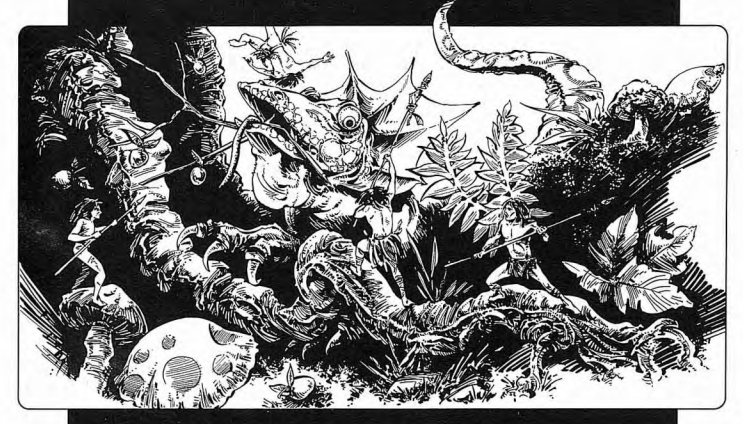
Ach, crivens...
Every dalberry tree in the realm has a Keefe tribe, because without the Keefe the trees couldn't grow and maintain themselves. The Keefe dig tunnels under the roots, but also generally keep tunnels inside the tree to get to the higher branches.
While each tribe is pretty much a "city" unto itself, the Keefe have no real leaders. Any internal problems are handled by getting everyone in the tribe together and talking it out, although the priests (the "Lallap") and the elderly are given extra consideration since they're considered to be wiser. In fact, a Keefe's "worth" is pretty much based on their wisdom. The greatest Keefe heroes are the ones who overcame their foes not by force, but by cleverness.
As you can probably guess from this, the Keffe are a very peaceful race; they barely have a concept of war. The other tribes consider them a curiosity at best, which suits the Keefe fine, since at the end of the day they just want to be left alone. The main activity of the tribe is creating art, which is practically unheard of in the other tribes.
In much the same way as the Darooni and the wasps, the Keefe's entire culture, from food to housing to religion, is focused around their particular dalberry tree. They live in its roots, they make tools from its wood, clothes from its fibers. They live off its fruits, shape its growth, even divine the future from it.
quote:
If the tree begins to sway when there is no breeze, it is a sign that the tribe has reached a decision which is unwise. If rotted fruit drop from the tree, it means that the tree is about to die and that the tribe should create a fruit with seeds using the seedberry miracle. The new fruit is then used to transplant the tribe to a new location on the savannahs. If the tree's leaves become wet without a recent rain, it means that there is opportunity for an alliance with a nearby Keefee tribe or a group of helpful strangers. By this omen, many individual Keefee tribes have temporarily joined just before a major disaster struck.
One thing that's pointed out is that the Keefe will generally have two names: their birth name, which is then replaced by an "adult name" once they do something worthy of being an adult. The example given is Artho Tark, whose name translates to "Worm Wrestler", which he received after some worms dug into his home.
And...that's kinda it on the Keefe. Which sucks, because I actually like these guys as presented and wouldn't have minded a little more stuff to use with them, especially since they're clearly meant as trickster types and potential PC allies.
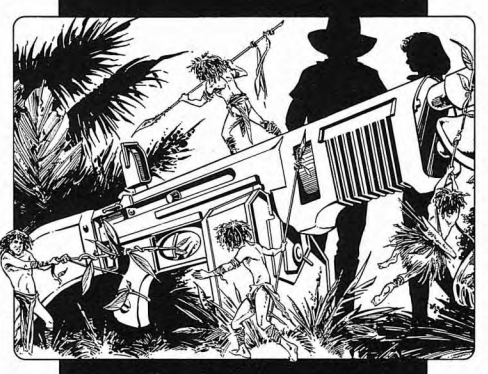
There's no way this won't end badly.
Anyway, time for the third major tribe: The Leopard Men. Whereas the Darooni were the "Evil Tribe" and the Keefe are the "Trickster Tribe", the Leopard Men are the "Honorable Warrior Tribe".
The Leopard Men occupy the western jungles of Merettika, and guard their territory fiercely. Death is usually the punishment for a first trespassing offense, although it's possible to earn their respect either through defeating one in single combat or performing a task of great (i.e.: suicidal) bravery. They don't attack people out of hatred (most of the time), and generally won't go out of their way to hurt people (unlike the Darooni, who the Leopard Men loathe).
The Leopard Men (and Women) are all built like brick shithouses. They average about six and a half feet tall and 230 pounds of solid muscle. The men are all shaved bald, ripped, and broad-chested, while the women are lithe, sculpted, and wear their hair down to the waist.
The one thing both genders have in common is the wearing of leopard skins. The men wear theirs so that the head of the pelt is over their own head, and the front legs (with the claws still attached) are tied to their arms and wrists. The women don't wear their skins for combat, but they're still the universal outfit.
It's also worth noting that the men are always the hunters, and the women are always the keepers of the lore and rituals. Every Leopard Child is taught their role at a young age, and given how violent their lives are there's really no such thing as a Leopard Elder.
The Leopard Men are arranged into multiple small tribes, each consisting of a handful of families where the father is always the one in charge. The head of each tribe is always male (I'm sensing a theme here) and is always the strongest; leadership passes on through trial by non-lethal combat. There's no formal challenge apart from "attacking the current leader" so I imagine this happens a lot.
Oh, and
quote:
If the tribe has several females who are ready to choose a mate, sometimes young men are abducted from a neighboring tribe if a suitable mate is not available in the female's tribe.
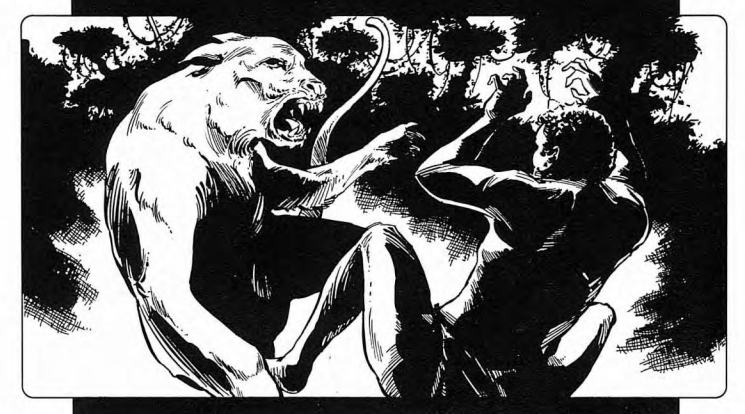
This is the only picture in the Leopard Man section. It's not flattering.
The Leopard Men got their name from their rite of manhood, which involves a young man going out and single-handedly killing a leopard, claiming its skin, and eating its heart. The womenfolk don't have a specific adulthood ritual, they just teach the girls all the rituals and such, and they're considered "adults" when a man wants to marry them. At least the women have the right to refuse?
Oh, and men who complete the rite
quote:
will return to his tribe and claim a mate or will single-handedly attempt to kidnap a mate from another tribe. The male may not choose females that already have a mate.
As you can no doubt infer, the men of the tribe love to hunt (although it's worth noting they only hunt for what's needed, not for pure pleasure). Hunting is generally done solo, unless the prey is a very large beast. Leopard Men revel in every aspect of the hunt, from the tracking to the takedown. No weapons are ever used apart from the claws of the hunter's personal leopard skin, which are modified to allow the hunter to retract the claws as needed. Oddly, there's nothing about what happens if a hunter's leopard skin is damaged beyond repair or stolen, because I'd imagine it's a pretty big deal.
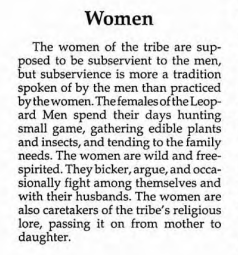
Men are from Mars, women are from Venus.
The religon of the Leopard Men is called Holuku, and is an animistic religion with some similarities to Ketta Kales from the Living Land. The basic idea is that every living thing has a soul, and non-living things don't have souls but are protected by spirits.
The twist here is that the Leopard Men have a rather unique idea of what constitutes a "living thing". The short form is that anything that moves is alive (and therefore has a soul), whereas things that do not move are not. So a river is "alive" and has a soul, as do clouds in the sky. But a tree isn't "alive", so it's protected by a spirit.
This is an important distinction for the tribe, because when a Leopard Man kills something (or partakes of it, in the case of a river's water), he prays for that thing's soul. Doing so, they believe, grants them a portion of that soul's power. When they use a non-living thing (making a hut, for example), they give offerings of thanks to that thing's protector spirit for allowing that use.
(In fact, it's implied in the Leopard Man character template that not praying for a defeated foe's soul is a pretty major insult; you're so unimpressed you don't think their soul is worth taking for yourself.)
The Leopard Men tribes spend most of their time warring with each other over hunting grounds. Well, not "warring" so much as feuding. Some of these grudges have been going on for generations, since peace between the individual tribes is a pretty alien concept.
At least, it was until the rise to power of Damo Kil. Damo Kil is the first tribe leader able to become chieftan of two different Leopard Man tribes and combine them into one. His long-term goal is to unite all the Leopard Man tribes under himself and wage war on the rest of the Land Below. Given that he's managed to defeat everyone who's attempted to stand in his way, it's not outside the realm of possibility.
quote:
The Darkness Devices are ecstatic over Damo Kil. He is powerful, loyal but not subservient to his religion, and completely ruthless. Unlike most of his people, Damo Kil is an evil man. He is the beast that kills more than it can eat for the sheer joy of killing. He rules his people by fear and pain. Many ofthe hunters in his tribe have become fanatically loyal to Damo.
Now we come to the Ohibi, who are the "Plot Hook Tribe".
The Ohibi are a group of hunter-gatherers who keep to themselves so much, they barely know anything about what's going on in the rest of Merritika. There's exactly one Ohibi village with a population of 150. Their village is on the far side of the Wild River, pushed up against the edge of the dome, and due to apparently not knowing how to cross a river they've been stuck there for God-knows-how-long. There's just enough jungle in this little crook for them to hunt in, and there's a few small caverns in the wall of the dome that the Ohibi use for religious ceremonies. At least, used by one specific person; as mentioned before the Ohibi, like the rest of the Merretikans, are terrified by darkness.
The Ohibi themselves are pretty, well, basic. The men hunt, the women farm. Their leader, Mehret-Ahn, is also their head priest. They have almost no interest in exploring, although they're always interested by meeting outsiders. They have no reason to try crossing the river (there's more than enough food in the nearby jungles, so what's the point?), and they don't want to explore the nearby caves. They'll do the occasional animal sacrifice to their god Mehret, and will sacrifice anyone who seems to be wavering in their faith.
The Ohibi probably wouldn't even bear mentioning in general if it wasn't for one piece of very bad luck: their village is located near the bottom of the Nile Empire pit. As such, their tribe is under nearly constant threat from the Nile expeditions.
The first Nile contact with the Ohibi was made by Major Hopten-Ra, who convinced the tribe that he and his forces were sent by Mehret and that the tribe was to serve them. Fortunately, as often happens in the Nile Empire, his sceme was exposed and thwarted by the sudden arrival of a heroic Storm Knight.
Currently, the new leader of the Nile forces, Field Major Achmed Tunakakan, has set up camp near the village. He has a tenuous peace with the tribe, but that's only because he doesn't know he's set up his camp between the village and the secret temple known as The Sphere.
I talked a bit out this in my last post, but to reiterate: The Sphere is embedded in the caves nearby and can only be reached via secret tunnels. The Sphere itself is the largest known eternity shard; it's a hollow sphere just big enough to squeeze in a half-dozen people, accessed via a small crawlspace in the side. The Sphere itself isn't super-powerful: people can attune themselves to it to draw Possibilities from it as normal, but it's so heavily embedded in the rock it's almost impossible to move. On top of that, the purpose of The Sphere is to maintain the natual primitive nature of Merritika, and as such any Possibilities drawn from it must be used for this task.
What makes The Sphere valuable is the ritual that can be completed inside it. Mehret-Ahn knows the miracle, which requires taking a shard from inside the Sphere and meditating with it for 24 hours. Upon successful completion of the ritual, he can boots the stats of anyone inside the phere for a full day.
So far, Achmed doesn't know about the Sphere. The Ohibi haven't made any waves yet because the Nile forces aren't denying the tribesmen access to the caves...yet. If Achmed did learn of the Sphere, that'd change pretty quick. While Achmed does have modern weapons, he only has a dozen men and as such he's still outnumbered.
The Ohibi religion is based on the idea that their god Mehret created the world for them. They believe that the other peoples of the region were created after the fact, but fled across the river because they couldn't handle living here. They also believe that Mehret created the Sphere as a temple to challenge the Ohibi to enter the tunnels.
As stated, the high priest is Mehret-Ahn. He teaches the tribe to share between families and to protect their lands. He allows outsiders into the village, but only for short periods of time. He goes to the Sphere about once a month to perform his ritual. Mehret-Ahn himself is on the older side, and is naturally subborn. The most striking thing about him is the swirled red-and-blue tattoo on his chest; it's the symbol of leadership, but anyone who's been in the Possibility Wars for a while will recognize it as symbolic of an eternity shard.
Lastly, we come to the "Surprisingly Advanced Tribe": the Pyrian Fire Tamers.
The Pyrians occupy the southern end of the realm, which would normally be uninhabitable due to the large number of volcanoes and seismic activity. They've have not only settled here, they've actually managed to thrive by taming and controlling the volcanic activity.
The Pyrian capital is Tanta Kallar, which is the name of both the largest volcano in the region and the city built along its slopes. Like the Ohibi, the Pyrans are boxed in by their environment; they're also right up against the great dome's wall, and are surrounded on all sides by Smoke Canyon, the River With No Bottom, and (of course) more volcanoes. Unlike the Ohibi, however, they're not happy about this layout and are more staying out of stubborn pride and for religious reasons than anything else. After all, nothing can grow here and wildlife is almost unheard of, so the Pyrians rely on trade and the occasional raiding party to survive.
As a wise man once said, a harsh land breeds harsh people. Despite being the most advanced people of Merritika in both a social and technological sense, the Pyrian culture is very rigid and intolerant with a strictly enforces caste system.
Sitting at the top of the hierarchy is the military. Below them are the religious leaders, then craftsmen, laborers, and slaves way down at the bottom. Your caste is generally locked in from birth since jobs tend to follow along family lines.
The current leader of Tanta Kalla is Hadian Fel Ar, head of the military. His word is law, although he does have a few advisors he keeps on a short leash. He maintains his power by keeping everyone below him bickering amongst themselves, but anyone who gets enough power to be a thread will suddenly find themselves given the "important" job of being shipped to the edges of the empire far away from the court. That said, the biggest threat to his position right now is the high priestess Amethia Cor Tal, who has (so far) avoided any attempts to shift her from her goals.
The working classes are surprisingly well-regarded, being supported by the taxes of the wealthier castes, but slaves are, well...slaves. Most of them are prisoners of war from other tribes and are treated about as well as you'd expect.
Note that the book has tho thirds of a page going into the ins and outs of this caste system, who ranks where, even what foods you're likely to have at whatever level. I'm not going to go into those details, though, because nobody cares including myself.
You're welcome.
What is important to point out about the Pyrian working classes is that your job is pretty much your life. There's no time for anything resembling recreation or family time, to the point where if you gave a Pyrian a day off he honestly wouldn't know what to do besides keep working. As such, Pyrians are a very stolid, cold people. They are obsessed with whatever job they have, be it stone carving or running a temple. This isn't a way that the upper classes keep the lower classes in line; everyone thinks this way.
This extreme focus makes Pyrians a very aggressive nation. They've managed to take over most of the southern part of Merretika, and are looking to start pushing outwards. Of course, the natural obstacles are a problem, since it's hard to move a lot of troops over an insane river near volcanoes. Still, with a standing military of about 2000 thralls and trained soldiers, they vastly outnumber pretty much everyone else.
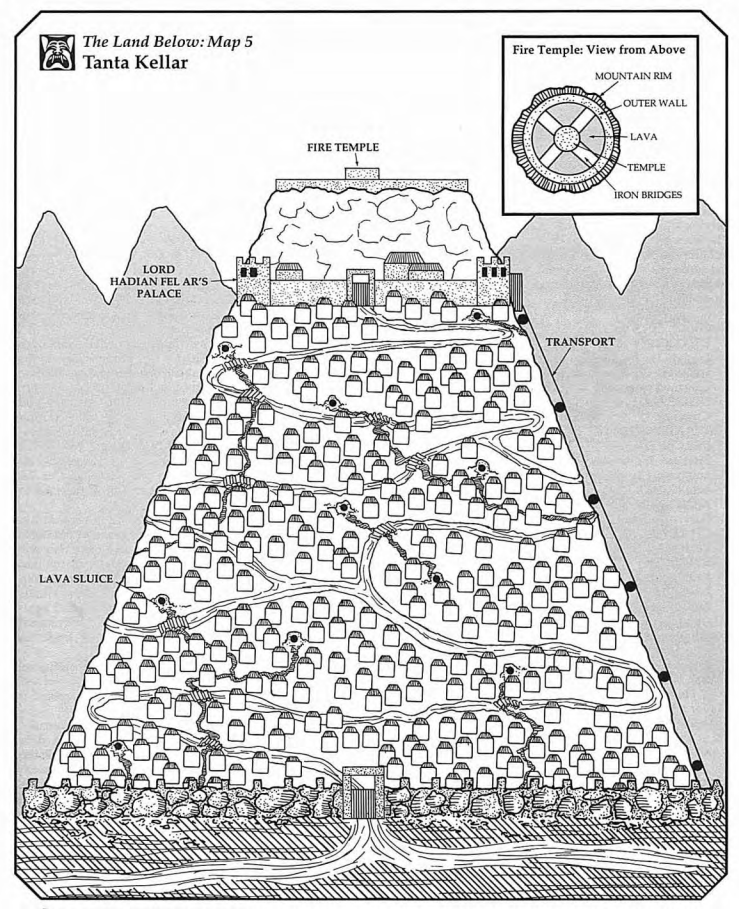
Looks like a nice place to visit.
I'm going to skip the two pages of stats for various named NPCs who really don't do anything to get to the section on religion.
quote:
The religion of the Pyrians is logically based around the violent terrain they call home. Their religion is an unusual monotheism. Instead of having a diametrically opposed evil power, as in many monotheistic religions, the Pyrians see their god as having two sides: one good, and one evil.
When the god is benevolent, he is called Karruk, the warmth-giver. When the god turns violent and evil, he is known as Darok,the hell-breather. This duality of being is based on the dual protective and destructive natures of fire.
It's generally understood that Karruk/Darok makes his mood known through the volcano itself. As such, they've spent a lot of time reinforcing the city walls. That said, they still believe that the priests can placate Darok enough to prevent the volcano from fully erupting.
The chapter closes out with some information on the city of Tanta Kallar. The layout of the city matches the caste system: the richer people live in the better homes near the top of the volcano, and things get progressively more slum-like the closer you get to the base. The entire north face of the volcano is taken up by Lord Ar's mansion, which is designed to ensure that there's no doubt about the size of his dick.
quote:
Lord Ar's palace contains a main building which sweeps across the entire north face of the volcano (the ground floor runs 100 meters from end to end), towering 50 meters into the air and covered with bronze. Huge sculptures of Pyrian heroes line the lower wall of the palace, while smaller sculptures can be seen on the many balconies built into the upper floors. The entrance is an arch 20 meters tall, with numerous guards. Torches over four meters tall line the walls. The presence ofKarruk is seen throughout the building, as countless bronzed torches, from one to three meters tall, are within and on the outer walls of the palace. Two guard towers of seamless black stone, 70 meters tall and over 20 meters in diameter at the base, rise on the east and west slopes and connect to the palace.
At the top of the volcano, floating about 300 meters above the caldera, is the Fire Temple. The temple sits on a floating disc of solidified ash, which in turn is tethered to the volcano's rim by giant chains and a few bridges. The air here is poisonous to non-Pyrians (who've evolved a sort of internal air filter), to the tune of small-arms-level damage each round. Likewise, the metal bridges to the temple glow red-hot but do not burn Pyrians. The temple is where all rituals are held, and contains a convenient hole in the central temple to throw sacrifices down.
---
I think you can see why I had a hard time getting to this one. Like any "setting detail" section in Torg, things get weighed down with just...noise. There's some good potential here for interesting encounters, but the writers didn't seem to bother thinking about what those enconters may be.
On the plus side, we're pretty much through all the setting crap. Now comes the easy part: the mechanics!
NEXT TIME: Back to the safety of numbers
Mechanics of the Lost Temple
Original SA post The storm has a name... - Let's Read TORG
Part 20f: Mechanics of the Lost Temple
Now that we're fucking finally done with the grand tour, we can get to the mechanics. Which is nice, because I can probably get through the next few chapters in one or two posts without getting burned out again.
The first chapter after all the setting dribble is Axioms and World Laws, which (as always) I already discussed in the opening post for this book. But (again, as always) I'll quote myself here.
quote:
Magic: 12. Slightly above Core Earth's, just below Orrorsh's. Spellcasting is possible, but doesn't see much use in the jungles. Most sources of magic are the ruins that dot the landscape, many of which are only possible because of magic. That said, there are a lot of natives with inborn magical talent; they tend to position themselves as shaman.
Social: 8. At one point above the Living Land's, the social axiom allows for multiple distinct tribal societies, but not much else. This axiom is low not so much because the inhabitants haven't advanced much, but because there simply aren't enough native dwellers to create a larger society. There is a rudimentary justice system in place, complete with the idea of eye witnesses, but the harshest punishment is usually banishment rather than a straight death penalty.
Spiritual: 17. This is the highest axiom down here. While there are multiple religions in Merretika, they tend to exist only to one tribe and are either monotheistic or based around a handful of "protector spirits". Miracles are possible, but there aren't many unique miracles.
Technology: 10. Unsurprisingly low; the tech axiom does allow for better weaponry than the Living Land (such as bows and metal blades) as well as rudimentary medicine. That said, hunting and gathering is still the main source of food, but since you can't swing a spear without hitting some sort of game most of the tribes have abandoned the nomadic lifestyle. Only one tribe has actual writing and what we'd consider scientific research.
The Land Below has three World Laws, but one of them is the Law of Action, which is identical to the Law from the Nile Empire, so I'm not going to reiterate that here.
Of the two new Laws, the one that holds the most sway is the Law of Savagery. This law states that the Land Below is a harsh one; survival must be fought for day-to-day, there are no guarantees. Cunning and intelligence will only get you so far, what matters is who's left standing when the blood settles.
The Law of Savagery has two mechanical effects. First off, players cannot play cards for non-physical actions in combat. You can still taunt or maneuver, but you can't use cards to get bonuses to those actions. Second, when "attack" is an approved action, you only get to draw a card when you perform an All-Out Attack.
This Law also has some narrative effects. To start, characters who act more savagely are rewarded with an extra Possibility at the end of the session.
The second effect is that your clothing will be destroyed, in a tasteful PG-13 manner. Thorns will snag on fabric, natives will want to trade your interesting clothes for supplies, and every attack will rip something on someone. Characters will never end up naked, though; there's always just enough left to cover your naughty bits. Actual armor fares better (in that it doesn't just fall apart), but no matter what armor will never provide more than a +4 bonus to Toughness.
There are a few more things the Law of Savagery does, but they only apply when you're in a Pure Zone or if you're a native.
quote:
Male characters will find that their body hair grows at an alarming rate. Beards are grown in a few days and chest hair will become thick within a week. Female characters will find that their scalp hair grows at this incredible rate and after a week, their hair will reach their waists or even their ankles if their hair was already long. The new hair growth can be cut or shaved normally if the tools are at hand, but the hair will quickly grow back again.quote:
The other physical side effect of the Law of Savagery is that physical attractions become heightened as the animalistic effects of the law take hold. Members of the opposite sex will appear more attractive to one another and latent love interests will flare to bold passion. Characters who play a romance subplot while adventuring in the Land Below receive one extra possibility point at the end of each adventure act. Also, any Charisma-based test involving a member of the opposite sex receives an automatic +3 to effect (as if a Presence card had been played).
The final Law is the Law of Wonders, which is what allows the creation of buildings and temples and such beyond the limits of the Tech axiom. This Law allows the Nile Empire engineering skill to be used in the Land Below, and even then it's only used by one tribe. Which is to say, this Law does nothing.
What's wrong with there just being huge weird impossible temples? How many players are realistically going to see (for example) the Pyrian temple floating over the volcano and try to reverse-engineer how it works. It's an idea that we use a lot around here, but: nobody's going to check your math, GM. You don't need to validate every aspect of your game world to the point of having specific spells used to reinforce the magical Principle of Whateverthefuck, just put stuff where it makes sense and move on!
Leaving that stupidity behind, we quickly come to the chapter on Miracles of Faith. Each tribe pretty much has its own religion, and as such each one has their own specific miracles.
The Dahooni only get a few:
- Call Giant Wasp doesn't quite do what you'd expect; it's only used by the high priestess to summon all the bonded wasps from the hive, or every six months for the birthing ritual. Also, it doesn't actually command the wasps, it just calls them. As such, it's another of those "this spell is here cover something that an NPC shouldn't even be rolling for" situations.
- Catalepsy prevents the target from moving at all. The target is still aware and can breathe, but that's it.
- Cure Poison does what you'd expect. I'm pretty sure this miracle has appeared in a few of the sourcebooks.
- Wasp Sting is a touch-based "attack" that doesn't inflict actual damage, but if the attack hits hard enough it can paralyse the target.
The Keefe miracles unsurprisingly revolve around the dalberry trees.
- Animate Tree, sadly, does not make trees start walking around, but it will allow the target tree to attack foes with its branches or entangle people in its roots.
- Poisonberry will turn any natural ripe fruit still on the vine/branch poisonous. The fruit will remain poisonous indefinitely.
- Seedberry is a ritual used to create a new dalberry tree seed. Again, no reason to make this a purchasable spell.
- Speak With Grass and Speak With Tree, again, do what you'd expect. They're just slightly different versions of the Speak With Plants miracle that (again) has appeared in other books.
Leopard Men miracles are based around their idea that you can pray for the soul of a defeated foe and gain some of its power. That said, we once again have a "ritual miracle" that shouldn't be something you roll for.
The miracle is Consume the Leopard's Heart, and, well...
quote:
For a boy to become a man among the Leopard Man race, he must hunt down a great leopard and kill it single-handedly. When he eats the heart of the great cat, the boy becomes a man in the eyes of his people. This miracle is cast by the young man to capture the power of the leopard's soul and make it his own. Compare the boy's faith total to the leopard's Spirit, reading the results on the power push table. The boy may add the power push to any attribute except Mind, or divide the result among any number of attributes. The miracle's benefits are in effect for a time value of 31 (two and a half "weeks"). This miracle is only used once in a lifetime by each Leopard Man.
First off, is this miracle required to achieve "manhood" in the tribe? What happens if the kid beefs the roll? It says right there it's only used once per person; does that mean he can't try again? What if he doesn't have a high enough faith skill to know the miracle in the first place? The miracle has a range of "Self" so he can't have someone else perform it on him; does that mean he can never become a man? Not to mention that buying this miracle for a PC would require spending XP on something that you can only use once, if your character is a "man" in the eyes of the tribe, then you're actually spending XP on something you already used in your backstory and can never use again.
Stuff like this makes me so mad. It's such shitty design, because at this point you're just making spells for the sake of making spells. This is the mindset that gave us such great ideas as "spending skill points in Perform is roleplaying".
Ugh, sorry. Didn't mean to go off on that rant again. But here's the thing about the Leopard Man rituals: only two of them are things that would be used regularly from a PC's standpoint. The rest of them just cover things that any other game would handwave as just "these are just things they can do and that we don't need rules for".
The rest of the Leopard Men miracles are:
- Steal the Essence of Water, which lets you drink from a natural water source to heal shock and KO damage once a day.
- Power of the Beast is the generic version of Consume the Leopard's Heart, although to be fair it is more powerful. When performed over a kill, you make a faith roll and compare it to each of the beast's stats on the Power Push table. You then get to add the result from the table to that stat for 24 hours, up to a max of the beasts' stats. Yes, this means that you can potentially boost all your stats with one roll.
- Ritual of the Hunting Totem is used to mark the boundaries of the Leopard Men's territory. Passing between two totems requires a Spirit test. Passing the test lets you move past the totems, but failing will weaken the target and alert the tribe.
- Ritual of Tree Bracing and Ritual of Tree Weaving have no other use than to make the tree houses the Leopard Men live in. That's it. Hell, all the Tree Weaving one does is let you bend the branches of a tree into any configuration for one hour. That's worth spending your hard-earned XP on, isn't it?
The Ohibi miracles can only be performed by an Ohibi with the focus skill (which...is how miracles work in general), and the only Ohibi with that skill is their high priest Mehret-Ahn. He's apparently happy to cast these on people as needed.
- Animal Sounds lets the target make perfect animal noises for an hour.
- Calm Beast is another "what it says on the label" one.
- Living Jungle makes vines and branches come to life and entangle people.
- Painless Kill causes the first unarmed combat attack the target makes do a lot more damage (10 + the caster's faith total, rather than the usual flat Strength), but the attack does no shock or KO.
- Pass Quietly basically just gives someone +8 to their stealth rolls for an hour.
- Power of Mehret is this religion's useless miracle. It's the one Mehret-Ahn performs in The Sphere.
Lastly, we have the Pyrians. The interesting thing about Pyrian miracles is, because of their god's dual nature, each miracle has two difficulty numbers. When the god is in his "good" state, defensive miracles are easier, but when he's feeling destructive damaging spells are easier.
- Cloud of Ash creates a cloud with a 100 meter diameter (that's 300 feet, or just a bit wider than the wingspan of a Boeing jet) that reduces vision to one meter and causes people inside it to slowly suffocate.
- Darok's Breath creates a miniature volcanic eruption that does roughly grenade-level damage.
- Fertility turns ground into fertile soil, in case you were worried that there was a miracle in this group that was effectively useless for PCs.
- Flame Aura turns the caster into a "pillar of flames", increasing his unarmed damage.
- Flame Ward gives a +8 bonus against heat-based damage.
Next up are the new Pulp Powers, and thankfully there's only six of them. As a reminder, pulp powers have an XP cost that must be paid every adventure, and if you don't (or can't) pay out, or don't use the power at least once in the adventure, you lose the power forever. Bear that in mind as we go through these.
- Adrenaline lets you, twice per day, shake off all shock and KO damage and increase your Strength and Dexterity for a while. The amount of the increase depends on how long you want the boost. You can use this more than twice a day, but doing so will wear you out. This has an adventure cost of 3.
- Animal Companion gives you a animal sidekick that is loyal to the point where it'll die for you. It will do whatever its master wants, and the two are actually capable of rudimentary communication. This also has an adventure cost of 3.
- Claws lets your unarmed attacks do STR+3 damage instead of STR. This costs 2 XP/Possibilities per adventure, or 3 if you want them to be retractable. Note that this is the same damage as a baseball bat or knife, which do not cost XP.
- Far Vision lets you see and hear what is happening to someone, from the point of view of about 10 meters away from them. Range depends on how well you roll when you use the power, and you can only do this once an hour. Still, that's pretty damn useful for an adventure cost of 2.
- Regeneration, when used, clears one wound or removes either a "K" or an "O" if you succeed at the power roll; the worse your wound level, the higher the difficulty. Failing the roll means you can't try again until the next day. This has an adventure cost of 5.
- Sense Magic lets you detect any form of magic for ten minutes. It can only be used once every 12 hours and has an adventure cost of 1.
Moving on from there, we get to the Creatures and Folk of Merretika chapter, and here at least I see one thing I like over this chapter from previous books: they actually separated the creatures from the NPCs.
Not that it really matters, because pretty much all the creatures are "jungle animal, but bigger". The only real exceptions are the huevenge (a unique bat-creature that defends a single spot for some unexplained reason) and the rodar, who are rodents that are only noteworthy because they're P-rated and are surprisingly intelligent, to the point where they'll help humans they like.
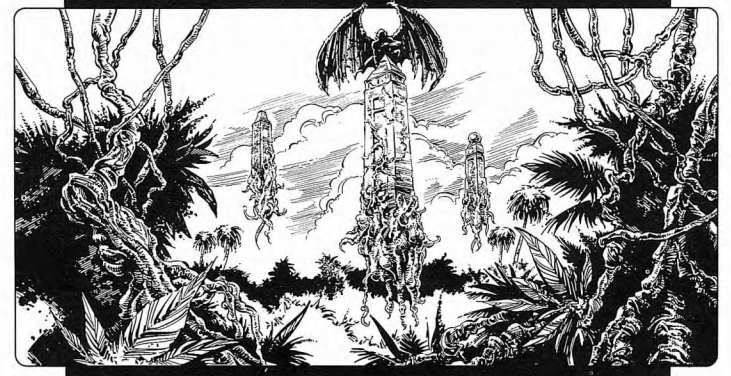
The huevenge defends these floating obelisks for some reason.
As for the folk...well, there's only three people listed, and one of them is a giant ape.
Kord fell into Merretika as a teen from his home in Michigan and wound up transforming into the self-proclaimed defender of the lands. He's forgotten his old life, and seeks answers as to where he came from. He's a straight-up Tarzanesque "noble jungle lord", only instead of having an ape as a companion he has a saber-toothed tiger. He also possesses an eternity shard called Fang that increases his stats and gives him the animal friend power, but he doesn't know that this tooth hanging from his necklace has any sort of power.
Lathiar the Mystic is, no word of a lie, a wandering wizard. That said, I don't know why because his description doesn't list his personality, goals, or anything like that. Just that he seems to be on good terms with everyone but the Dahooni.
Ungrosh is the aforementioned giant ape. He stands about 20 meters tall, is P-rated, and is feared by every tribe as an unstoppable rampaging engine of destruction. He spends most of his time in the mountains, but when he gets hungry he wanders down into Merriteka proper and starts eating every animal or person he can get his mitts on.
OH HEY ONE CHAPTER LEFT! I never thought I'd see the day.
The final chapter is Adventures, and here we can see what the writers intended people to do down here. Sadly, the answer is pretty boring.
quote:
Escape from the dangerous jungles of the Leopard Men. Discover the secrets of the Ohibi. Battle the ever-encroaching presence of the Nile Empire. Travel to the bottom of the Misty Gorge. Deal with the powerful Pyrian Empire.
What makes the Land Below unique in the Torg universe is that there is no central villain. The realm is an unknown, waiting for exploration. There is no active High Lord to oppose. However, that doesn't mean that Storm Knights will have an easy time of it.
Petty warlords, dangerous creatures and wondrous sights await those who enter the fringe reality. Once a group of Storm Knights have entered the Land Below, there are two main ways of pushing adventures along: have one of the players use one of the Land Below templates and funnel her information, or use the jungle lord Kord to send the Storm Knights on their way.
The problem with the Land Below is that there's no central threat. There's no real driving idea behind it beyond exploring a lost world and discovering things.
Which is fine on its own; that's the basic idea of your hexcrawl setting. But that's not what Torg is about. There's a central threat in the setting that drives all the action and setting development. There's a basic idea the rest of the game is built around.
But when you hit the Land Below, none of that matters. It's so detached from the rest of the setting it's pretty much pointless. There's no reason to go there to begin with because it's not tied to the Possibility Wars at large, and there's nothing to really do there that matters because the Land Below is so self-contained.
Land Below might work as a stand-alone hexcrawl for another game, but even then it wouldn't be an interesting hexcrawl because so much of the place is just empty space with nothing to do. And the places that do have things feel less like cool things to interact with than "hey check out this thing we made, isn't it cool?". Everything about the Land Below has the feel that you're just supposed to see everything and be impressed. It's a tourism setting. You don't interact with it, you just go from point to point and see all the neat things the designers created.
(Not to get too ahead of myself, but the Land Below is in Torg Eternity as a sort of pocket realm in the Living Land. It appears in the big Living Land adventure, and you do indeed spend that part of the adventure being shuttled to visit every tribe and meet a bunch of NPCs before leaving. So that's a straight-up tour guide adventure.)
Anyway, the sample adventures provided are "discover the Land Below by chasing Nile Empire operatives and discovering the big elevator", "get tricked by Pyrians to do their dirty work", and "literally the plot of King Kong". There's a few adventure hooks, of the "named NPC X finds you and needs help with Y" variety, but there's really nothing worth going into any detail over.
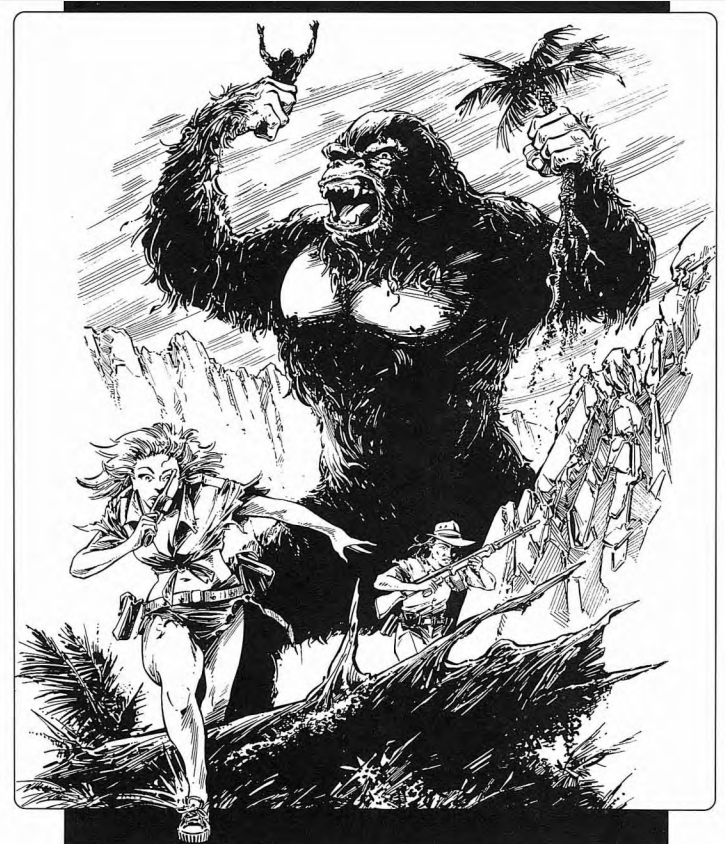
The remakes are never as good as the original.
Lastly, we have four character templates.
The Darooni Wasp Rider spent her whole life dreaming of becoming one of the elite warriors, and when she bonded with her mount it was the proudest moment of her life. Unlike the other riders, however, she loved exploring and wondered what existed beyond the Darooni borders. The priestesses forbid exploration, so she went off on her own. She starts with a giant wasp companion, and her tag skill is beast riding
The Keefe Haroo is a sort of wandering priest-slash-bard. He goes from Keefe tribe to Keefe tribe, spreading tales and outwitting the "big folk". Then he learned about a group of big folk who were getting the best of these bad guys who call themselves "high lords" or somesuch, and he had to get a piece of that action. Outwitting the most powerful people in the world? That's how you become a legend. His starting weapon is a Keefe poleaxe (which is basically a hair accessory for humans) and his tag skill is trick.
Oh, and I should point out that despite being only a foot tall, Keefe PCs don't seem to suffer any stat bonuses or penalties. In fact, there's no actual racial rules for Keefe. Not even a "you have to buy the pulp power 'Shrink' with an always-on limitation". It's a very weird omission given that every other race has had a bunch of rules.
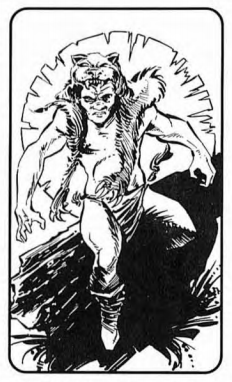
The Leopard Man Warrior is here for one reason and one reason alone: to hunt. That's it. They spent so much space on his background ("hunted and killed leopard") they forgot to give him a motivation or anything. He does start with his leopard pelt, the super attribute pulp power for +3 Strength, no miracles (so how'd he do that ritual, eh, book?). His tag skill is tracking and he has a pretty cool quote.
quote:
"I will kill you, but I will not praise your soul or take power from your heart. Your soul is empty and your heart is wicked."
The Pyrian Priestess spent her life in service of the twin aspects of Karruk and Darok, embracing the duality of caregiving and anger. She's a true believer who struggled up the hierarchy only to learn that the people at the top saw the religion as a political tool for their own ends. Disgusted with this heresy, she now attempts to being the good word to the peoples of the frontier in order to find "people who will accept her great religion without free of politics and other impurities." She starts with a knife, a toga, and some bronze jewelry, and her tag skill is focus.
----
And that's it. We're finally done with the Land Below.
Of course, this begs the question of what role Merretika plays in the overarching Possibility War. The answer, of course, is "not much".
Well, that's a bit unfair. About two years into the invasion it destroys a quarter of the United States and finally pushes Baruk Kaah over the edge into full uselessness.
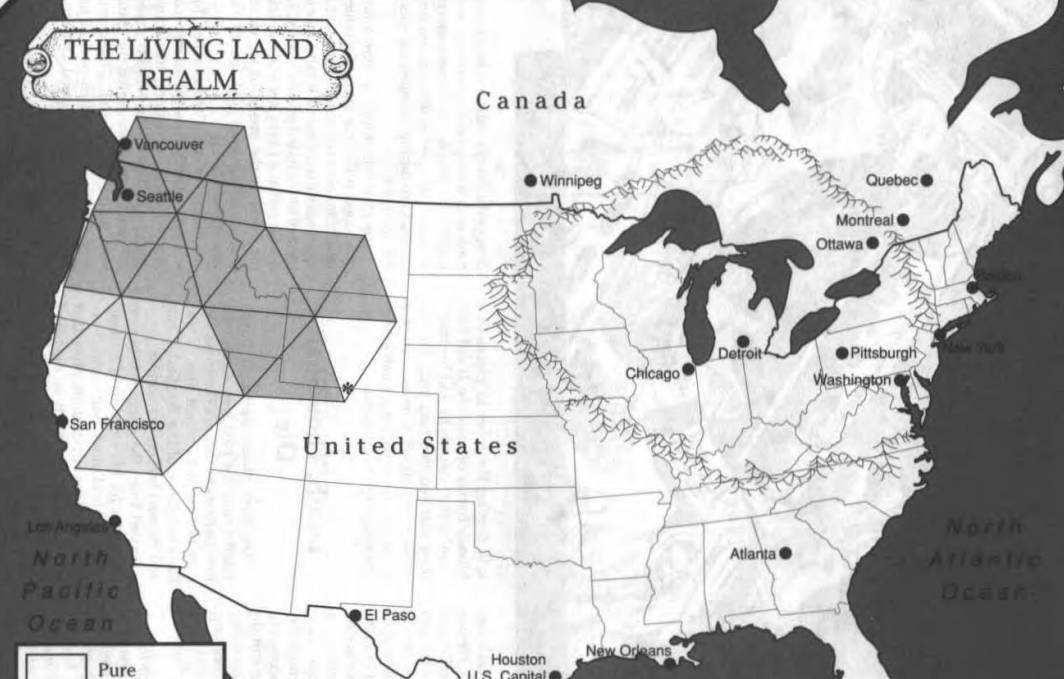
That can't be good for anyone involved.
Through the course of events I'm not going to get into here (because they're dumb; it involves Darkness Devices getting into an argument), the Land Below ended up pushing upwards and driving a ring of mountains up in the northeastern United States. This completely destroyed all of Baruk Kaah's stelae in the region and utterly wiped out his eastern territory, along with (presumably; the book is unclear) a few million Ords when the stelae zones got destroyed. New England is pretty much the only part of the region that survived, and given that it's under Cyberpapal control that's not really a bargain. What's more, this destroyed Kaah's last remaining maelstrom bridge, completely cutting him off from his home realm.
Now known as The Land Above, this isn't so much a realm as a strange Land Below dominant zone where that reality's rules hold sway, just without stelae boundaries. This has also weakened the fabric of reality, allowing access to all sorts of new pocket dimensions, such as Atlantis or Mount Olympus. On top of that, the areas that had been fighting against the edeinos have to contend with Leopard Men and Darooni Wasp Raiders instead.
Meanwhile, the Land Below was expanded by this whole mess, and a new race of serpent people have appeared and started getting into territorial battles against pretty much everyone. Eventually, the leader of the Pyrians starts hearing the whispers of a Darkness Device speaking to him from somewhere on the surface world, but the game line ends before he can find it.
And that, as they say, is that.
----
I said way back when I reviewed the Aysle book that it was my most hated cosm book. Even after this, I stand by that statement.
The Living Land isn't the worst book, it's the dullest. It starts out with promise with the whole "underworld of every realm" thing, but then throws that aside for a Lord World pastiche.
And as I said earlier, that wouldn't be so bad if it had any kind of solid tie to anything else in the setting. Instead, it's just...there. There's no reason to go and nothing to do once you get there. The whole thing just takes it for granted that your group would want to wander around in this sub-setting.
But hey, it's done, and I don't ever have to write about it again! Yay! And you don't have to read about it anymore! Bigger yay!
We're actually in the home stretch now, folks. There's the final SPOILER realm to cover, and once that's done it's straight into War's End. But before we can dip into all that stuff, there's a few things we have to cover first. And we'll learn what those are...
NEXT TIME: The final metaplot pit stop!
The final metaplot update
Original SA post The storm has a name... - Let's Read TORG
Part 21: The final metaplot update
Okay folks, this is the final major general points metaplot update before the final realm book. I hope you're ready for some stupid plot points!
This is going to be on the shorter side because there's only two things I want to discus. Both these events happened near the end of the game line, long after the events of the final realm book but before War's End. I just want to cover them now to get them out of the way and because...well, you'll see.
One thing I want to point out about all this is that both of these plot points only happened in the Infiniverse newsletter, so despite being important to the events of War's End, it was entirely possible to not know they happened because they stopped publishing the campaign update sourcebooks after these events happened.
The first thing I'll cover is Baruk Kaah. Because man, he has not had a good time of things.
As has been discussed many times, Kaah was the series' bitch. After his initial successes during the novel trilogy, at no point after that did he have a win. First, 3327 and the Kanawa Corporation managed to sieze control of Sacramento from him, establishing their foothold in the States and giving the Core Earthers their first major (percieved) win. Then a group of Storm Knights managed to destroy the small territory he set up in Canada, destroying the bridge there and taking down the stelae zones he was doing all his sacreligious experiments in. From there, he managed to barely keep control of his eastern and western territories. Soon enough, his Darkness Device Rek Pallen got sick of Kaah's failures and attempted to replace him with a new High Lord.
This replacement was thwarted by a group of Storm Knights in a published adventure called The Temple of Rek Stalek, in which a priest of the edeinos god of death tries to usurp Kaah. The PCs stop this, on the basis of "better the ineffective idiot we know than the scarily effective necromancer we don't".
By this point Kaah knows that Rek Pallen is actively working against him, and the one-two punch of the destruction of his western maelstrom bridge followed by the destruction of his entire eastern territory was the last straw, finally driving the Saar into madness. Kaah told Rek Pallen that he was going to give up and bring the Darkness Device to a new, worthy High Lord down in the Land Below, handing it over in person as was tradition. It turns out that Rek Pallen was about as dumb as Kaah, because instead of just breaking its connection with Kaah and teleporting to someone worthy, it transformed itself from its normal form of a copse of stone trees into something Kaah could carry and let Kaah carry it down into the caves of the Land Below.
Of course, Kaah wasn't bringing the Darkness Device to meet a new High Lord. Instead, he led an expedition to a location in the caves known as the Nexus of All Realities. The Nexus was found months earlier by Kaah's scouts; a strange multifacited jewel whose faces reflected every known (and many unknown) realities. Kaah's plan was to throw his Darkness Device into it; his hope was throwing a multidimensional artifact into a nexus of multiple dimensions would create an explosion great enough to destroy both the Darkness Device as well as the Core Earth cosm.
Yup, at this point Kaah more than ready to go down and take the entire reality down with him.
At this point, any PCs who heard that Kaah was missing and cared enough to go find him could track him down to the caves just before he does the deed (although it should be pointed out that they'd have no idea what he's doing unless he tells them when they catch up to him, which means none of what's about to happen will make any sense).
quote:
By the time the Knights catch up to Kaah, he and his party will be in the nexus. The edeinos warriors will turn
to protect their Saar while Kaah approaches the nexus. The Darkness Device will not take part in any battle, unless one of the Knights dares to touch it, at which point it will send a damage value 60 surge of energy through the offender.
The Knights will probably make short work of the edeinos, even though they are all possibility-rated, and may even get to mix it up with Kaah. At some point, he will toss the Darkness Device at the nexus, though. Keep in mind that he will be willing to suffer damage from a Knight attack to do this.
When the Device hits the nexus, the gem will shatter, only to reform again. The Device will be nowhere to be seen — it will then emerge from one of the facets and vanish.
At that moment, a great wind will arise. The Knights will feel it, but will be unaffected by it. Kaah — conscious or not — will be drawn into the gem. Soon, all of its faces will show images of the Living Land High Lord being torn to pieces. Kaah will not re-emerge and the winds will cease when the nexus has finished exacting its revenge.
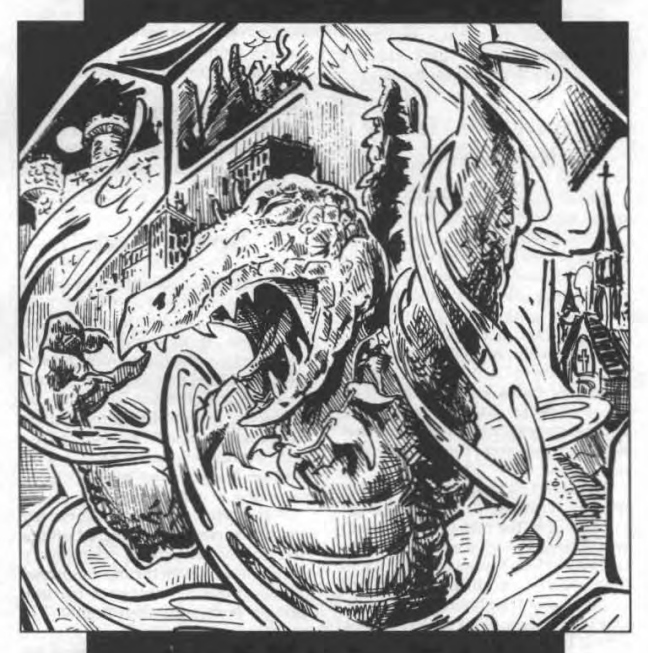
It could be that the purpose of your life is only to serve as a warning to others.
Once Kaah is out of the picture, the remnants of the Living Land realm are thrown into even more disarray. A few leaders rise to try to fill the vaccuum, but by this point there's not much time for them to do anything, and even if there was none of them are bonded to Rek Pallen so there's not much for them to do.
And really, that's the end of the Living Land as a going concern. Of course, by this point in the game line nobody gave a shit about it anyway.
The second thing I'm going to discuss is a "plotline" is something the Gaunt Man had been working on for a while as a series of adventures in the newsletter called Bride of Darkness.
This series sees the Gaunt Man sending operatives and Nightmares out into the world to kidnap women of power. People such as the head of the Dephi Council; Natatiri, one of Doctor Mobius' overgoverners; and Lady Pella Ardinay, leader of Aysle. The reasons why weren't revealed, but it's always safe to assume that whatever the Gaunt Man wants you don't want him to have.
The previous four parts of the adventure involved the PCs attempting to stop the kidnappings. But wouldn't you know it, Lady Ardinay was captured outside an adventure so that succeeded no matter how many women the group saves. Man, what rotten luck!
So anyway, the final chapter of the adventure has the PCs fighting their way into Illmound Keep, the Gaunt Man's home and base of operations. The real important action happens in the final scene, which is so goddamn bad I'm actually to break my normal protocols and quote the entire fucking thing for you. Get ready for some Deadlands: Hell on Earth: The Unity level stupidity.
quote:
Read aloud or paraphrase:
In your time as a Storm Knight, you have witnessed scenes of horror before. But never anything to quite match this. The Gaunt Man stands in the center of the cavernous room, watching occult energies play across the chained, writhing form of Pella Ardinay. Beside her, also shackled to the wall, are other women, watching the Gaunt Man in terror. Several six-armed giants stand guard over them, seemingly oblivious to Ardinay’s pain.
Before you can react, the Gaunt Man turns and smiles. “Welcome, my unexpected guests. You are just in time to witness the culmination of my greatest experiment. My researches have proven beyond doubt that this woman —” he says, gesturing toward the pain-wracked Ardinay — “is more than she appears. We will soon see just how much more.”
The Knights have a couple of options here. They can attack the Gaunt Man; they can attack Pella (which will involve fighting the Gaunt Man); they can try to rescue Pella (the Gaunt Man will no doubt watch in amusement); or they can try to rescue the other captive women before they are destroyed by the energies unleashed here.
By now, you’re probably wondering just what the hell is going on. Well, it’s like this: some time ago, the Gaunt Man learned that one of the women intimately connected with the Possibility Wars was the focus of a portion of the Nameless One’s power. Up to now, only the Gaunt Man has tasted of this energy — but if another were to be “blessed” by the Nameless One, and could be brought under the sway of the Gaunt Man, nothing could stand in his way.
He therefore initiated his kidnapping scheme, with mixed success. The ritual he is performing will (he believes) simply speed up the transformation into a chosen of the Nameless One. (This is not the whole story, but not even the Gaunt Man knows that yet…)
<The Gaunt Man's stats; suffice to say they're ridiculous. Not that it matters, because he's not going to fight anyone and can't be defeated anyway.>
As soon as the Gaunt Man finishes his little speech, the hexaphim will abandon their posts and attack the Knights. Meanwhile, the occult energies continue to bathe the struggling Ardinay.
<The hexaphim's stats. They're just tough monsters who're there to slow the PCs down until the next cutscene starts.>
During the battle, read the following:
Suddenly, an inhuman scream comes from Ardinay’s lips. Now what looks to be a negative image of her strains against the chains that bind her. The occult energy of the Gaunt Man’s ritual is no longer simply bathing her, but is now radiating from her. Then she is the Ardinay you have known again; then the negative; then the two switch back and forth, as if battling for control of her form...or perhaps merging.
hat is most surprising is the Gaunt Man’s reaction. No cry of triumph comes from his lips, no shrill laughter reeks through the lab. Instead, he watches with something akin to awe, saying, “By the Nameless One, what is happening here? My ritual should not produce this effect. It cannot!”
Now the Keep begins to quake. The hexaphim, if they are still standing, begin to fall back. The chained women scream as masonry crumbles around them. The Gaunt Man is occupied with watching Ardinay, giving the Knights the opportunity to rescue the captives if they choose to (the quakes have weakened the walls, so pulling the chains free requires only a Strength total of 9).
Read aloud or paraphrase:
The Gaunt Man wheels on you, rage burning in his eyes. “You! You have done this, somehow! How did you interfere with my ritual? Tell me
or I promise you a hell worse than has ever filled your nightmares!”
His answer comes from an unexpected source. Ardinay, occult power blazing in her eyes, exudes only a fraction of her newfound energy and explodes her chains. Then she rises into the air, shouting, “Fool! Have you so soon forgotten that there is one whose power is greater than your own?”
The Gaunt Man raises a hand and fires a bolt of energy at the hovering form. Ardinay deflects it with a gesture. It strikes a table full of chemicals,
which explode in flames.
“You have been manipulated from the start, High Lord!” Ardinay continues. “The Nameless One required you to pour some of your occult power into this vessel to prime it for transcendence. Once that had been done, his own energies completed the transformation. I am everything you were and far, far more!”
“This cannot be!” the Gaunt Man rages. “I am the chosen of the Nameless One!”
“You? You are limited, Gaunt Man! You know only evil, only one side of the battle. The Nameless One requires a servant who has walked the paths of both the Light and the Dark.” A wicked smile comes to her lips. “And this vessel will serve admirably.”
She turns her almost inhuman gaze upon you then. “Hear me, Storm Knights. No longer am I the woman you knew! I have ascended — I have completed the journey begun when Uthorion possessed this shell centuries agone. I am a goddess of destruction! Challenge me at your peril!
“And you, Gaunt Man. Know that the eyes of the Nameless One and his servant are now upon you. Crush this pitiful cosm quickly — the master hungers for its energies. And if you harbor any foolish thoughts of treachery —”
Ardinay lifts her slim, white arms to the heavens and bolts of lightning fly from her fingers, blasting a hole in the ceiling of Illmound Keep. Then she rises through the gap and vanishes into the night sky.
For the Storm Knights, leaving would be a real good idea right now, since the Gaunt Man has just been told he’s been used and probably isn’t taking it well. With portions of the Keep coming down (though we’re not talking mass destruction by any means), there’s enough confusion to allow the Knights to make a quick exit.
Now I'm sure the question on everyone's lips is "what the fuck was the point of that?" And the answer is twofold.
First, it reveals to the players and the GM that the Gaunt Man has been manipulated since day one. This is used to explain why, for example, he made Uthorion the High Lord of Aylse despite the fact that Uthorion is a fucking idiot. It's because the Nameless One manipulated the Gaunt Man into not only picking Uthorion, but also into getting him to possess Ardinay. Which...is a hell of a long-term plan.
quote:
The Nameless One’s goal was a simple one: he required a servant who understood both the Dark and the Light, something the Gaunt Man, for all his power, could not do. By tainting Ardinay’s body with Uthorion’s evil, the Nameless One banked on the possibility that eventually her spirit would return to its shell (after all, Uthorion couldn’t pull off the deception forever) and she would find herself divided between good and evil. A perfect tool …
Once this happened, it remained only for the Gaunt Man to be prodded into believing that the “bride of Darkness” would be at roughly his power level or slightly below and a potential ally in his quest to become Torg. By seeking her out and unleashing her latent evil through an occult ritual — one of sufficient power that the Nameless One would be able to seize control of it — the Gaunt Man allowed Ardinay to ascend to her new role as demigoddess of Darkness.
The second reason, and I'm not making this up, is to give the GM a weapon to use against the players when they get a little overconfident, or stray too far off the path you've set up for them.
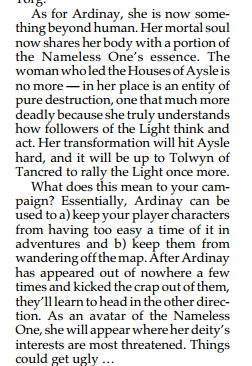
"Godinay", as she came to be known by the fanbase, is straight-up intended to be a PC killer. Her skills are all in the mid to high 40's (higher than the Gaunt Man's), access to every spell in the game, and 500 Possibilities.
And yes, Godinay does play a part in War's End. As far as I know she never appears in any other books so she's a bit of a surprise there if you haven't been keeping up on things.
And lastly, I want to talk about Jeff Mills. Jeff, you may remember, is the creator of the "Five Realms" RPG, the role-playing game where you fight the Possibility Wars while they're happening outside your window. He's popped up in the past, seeming to know a hell of a lot about what was really going on.
Amazingly, he's nowhere to be seen. By the time of the third big setting update book, I guess they forgot he existed.
And that covers what I wanted to touch base with. These things will come into play once we hit War's End, but before that, it's time to finally hit the final SPOILER realm...
NEXT TIME: You're not gonna believe this!
Space Gods
Original SA post The storm has a name... - Let's Read TORG
Part 22a: Space Gods
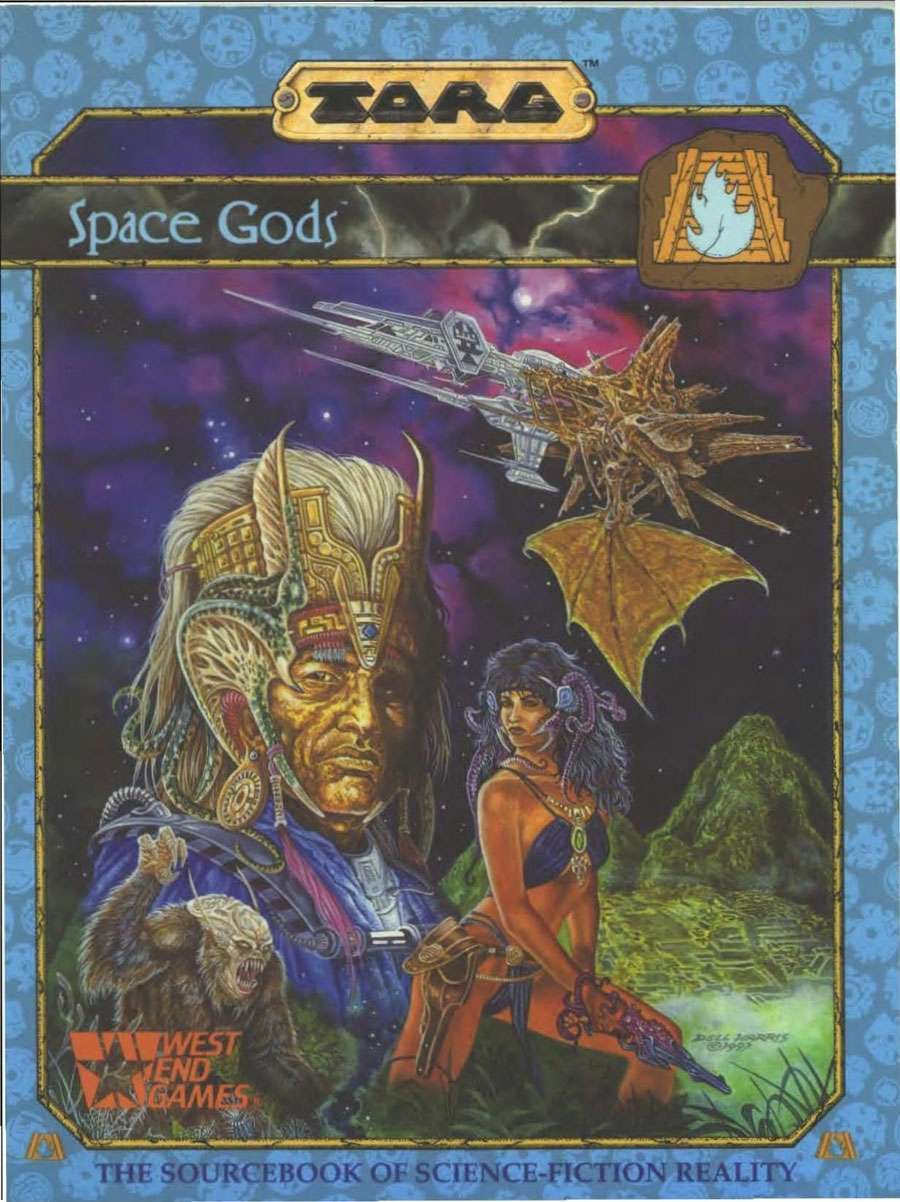
A man hides from a zombie-like mob pushing its way through Buenos Aires. The mob is linked by a hive mind, and seeks him out with a hundred eyes. If they catch him, he will be forced to join the hive...and he will love them for it.
A gun runner shows a client a new type of weapon: a rifle that’s a fusion of technology and organic material. When the client picks it up, small tendrils extend from the weapon and merge into his flesh. He smiles, feeling the rush of the gun drawing power from him; this will turn the tables against the cartel his group is fighting.
A strange bug-like alien works in a lab, using advanced genetic engineering techniques to design a cure for a disease. Outside his lab, a Cyberpapal hit team prepares to stop the “heretic” before he disrupts the cyberpope’s long-term plan for the region.
A distress call was unknowingly sent, and has been answered by an alien race; a culture who have mastered psionics, biotechnology, and non-invasive reality technologies. But rather than coming to aid us, they came seeking our help to save them from a disease that is slowly corrupting the minds of their entire culture. Their arrival might be the turning point in the Possibility War...only to replace it with a worse threat.
Space Gods
Yup, aliens showed up.
You long-timers to the Torg review may or may not remember when I covered the Relics of Power adventures. At the end of the adventure series, after dealing with a lot of riddle BS a beam of light was shot into the heavens with a "you’ll find out what that means later on".
It’d be about a year before that reveal happened.
The Signal Fire (as that flare was known) was actually left by a race of Mezoamerican-looking aliens known as the Akashans. The Akashans are an ancient race, who long ago mastered such diverse technologies as biotechnology and reality mechanics. Their distant home is a region of space known as the Star Sphere, where they work closely with various "client races", using their knowledge to help as many people as they can.
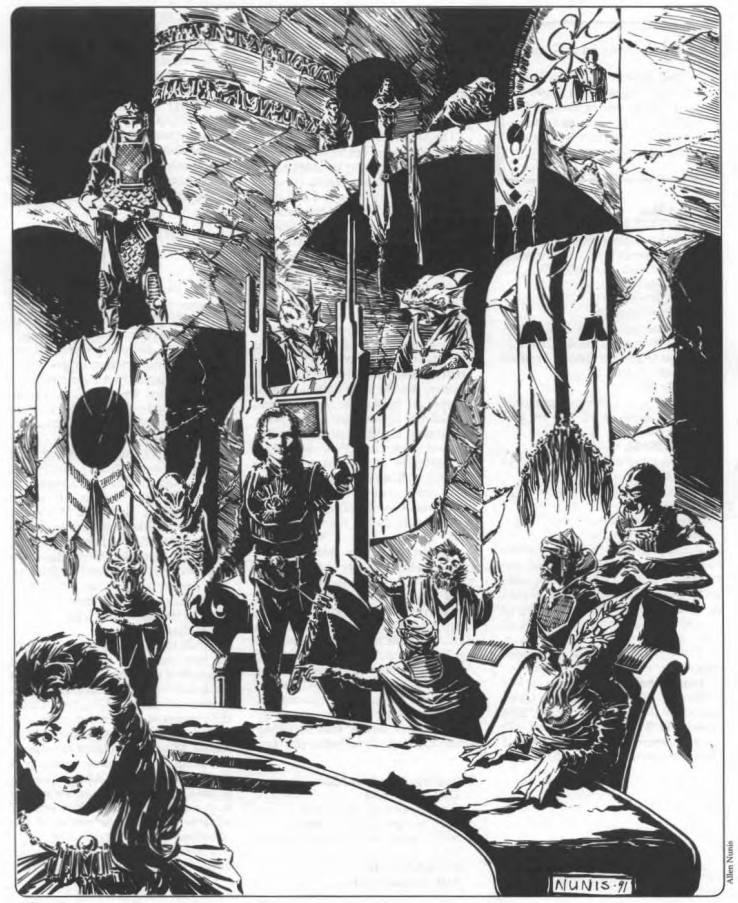
Your government, inaction
The Star Sphere is a distant galaxy with over 500 known distinct races. The book refers to this as the Akashan "cosm", but they're in a different part of the Core Earth cosm so already we're running to problems. Regadless, the Akashans rule this entire part of space, and through their explorations left many Signal Fires on countless worlds. The Fires were intended to be a beacon to the Akashans; once a race advanced enough to understand what the Signal was and activate it, they were ready to join the Akashan's empire.
But as we saw, the Signal Fire on Earth was set off far too early.
The Akashans were surprised that humanity had advanced so quickly, but saw a chance for help. After all, if humanity was advanced enough to activate the Signal Fire, then they might be advanced enough to help find a cure for the plague.
They arrived at Machu Picchu, expecting to meet equals. Instead, they found themselves in the middle of a war.
They also unleashed the virus ravaging them on an unsuspecting world.
The Comaghaz Virus
It’s important to note that the Akashan "realm" doesn’t have a High Lord, nor is there a Darkness Device. The Akashan mindset and religion (which are based around the peaceful merging of ideas) aren’t exactly compatible with the Devices’ “break everything and smash the shards” goals. That doesn’t mean that there isn’t a threat from within, however. In some ways, it’s even worse than the High Lords, and it’s all the fault of one person.
Several years ago, one of the client races' colonies was dealing with a very virulent plague that was infecting all their food sources and slowly killing them off. The High Council sent Sarila, one of their top geneticists to cure the plague. It was difficult, but Sarila managed to cure the virus, saving the colony and earning her a position on the High Council.
Which would have been nice, if she had actually cured the plague.
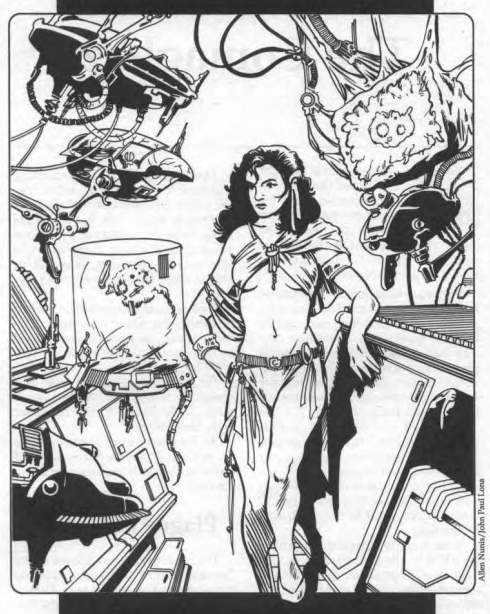
Sarila
Sarila couldn't figure out a cure, so she did the "next best thing": she altered the virus so that it would go dormant, then mutate into a much less severe form and make the crops appear safe to eat. Which it was...for about a year. After that, the weakened toxins would have built up enough in the population to render the population sterile.
When that ended up happening, nobody made the connection to the blight of the previous year.
quote:
She knew, of course, that the now undetectable blight posed in some ways a greater threat than the one she had been called upon to cure. But she had succeeded in confirming her theories regarding viral genetic mutations, and the eventual collapse of the colony was ascribed to some heretofore unknown kind of cosmic radiation acting upon the inhabitants.
Once she had the basic idea, the plan was simple: create a disease that would spread quickly, have a lot of obvious symptoms, and be eventually deadly. Then unleash it on the Akashan home world, wait for everyone to realize how bad the infection was, then come in with a "miracle cure".
After making sure she was immune her own creation, she unleashed her creation on her people. It wasn't long before it started to become an epidemic, but to Sarila's surprise, her creation had a very unexpected side effect: she could hear the thoughts of the infected. At first, the thoughts seemed to beg her for direction, but it wasn't long before she heard another, more alluring voice beneath them. The microorganisms she created had achieved sentience, and had created a linked group mind with their hosts.
Fortunately for Sarila, her self-treatment allowed her to connect to the hive mind without being taken over. At first, she tried to create a cure before the truth of what was happening came to light. The virus, with the sense of self-preservation that comes with sentience, had altered itself to resist her cure. This left Sarila in a very bad position; she couldn't cure the disease as originally planned, but she also couldn't go to the Council for help without raising some hard questions.
Over time, Sarila learned how to differentiate between the minds of Comaghaz victims, and eventually to supplant their thoughts with her own. The tenets of her religion forbade the idea of control, but in her twisted mind she wasn't dominating people, just...offering suggestions. She also convinced herself that the virus was no longer lethal, despite the evidence to the contrary.
"Comaghaz", by the way, is the Akashan word for "domination".
As the Akashans became more desperate to find a cure and deal with the hivemind infected who were attempting to spread the disease, the Signal Fire was received. After much deliberation, it was decided that if Earth had advenced enough to activate the signal, then they might be advanced enough to help cure the plague. The Akashans wasted no time heading into a war they didn't even know existed.
Sarila originally didn't want to come to Earth, fearing that her virus might actually be cured, but shortly after the Akashans arrived a Storm Knight was infected with the Comaghaz. Instantly, Sarila learned of the Possibility Wars, and is currently seeking to infect more Stormers to learn more about these other realities. She doesn't know about becoming the Torg (yet), but the idea of spreading her mind across other cosms is very, very appealing.
Reality Trees and the Akashan "Realm"
As stated previously, the Akashans have mastered "non-invasive reality technologies". This means that they have biotechnological devices capable of mixing two realities without the need for stelae boundaries, Darkness Devices, or the syphoning of Possibility energy from Ords.
Instead, the Akashans have developed a unique “technology” known as Reality Trees. These trees generate a mixed zone around themselves between the native reality and another based on the tree itself.
Well, sort of. For a reality tree to work, a living, sentient being from the realm in question must be fused with the tree itself. When a reality tree is planted (which requires the casting of a few miracles), the surface turns semi-fluid to allow someone to willingly enter the tree and bond with it. After nine months (assuming nothing happens to the tree) the person is released and the tree creates a mixed zone with a 160 km (100 mile) radius, as well as seeds that can be planted to make it easier to create new reality trees elsewhere.
For reference, that’s an area of 31,315.9 square miles. That’s about half the size of New England.
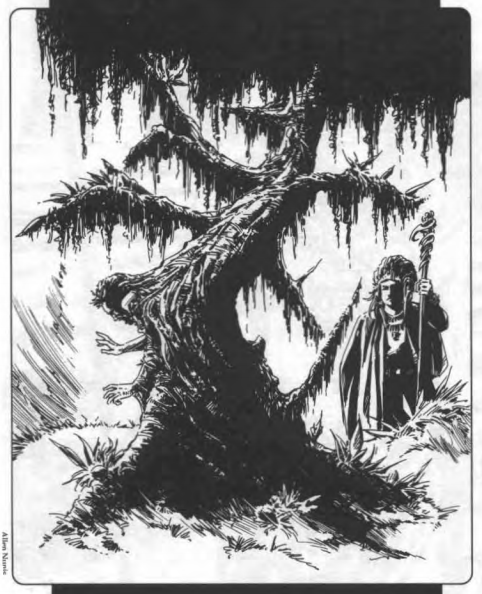
Looks comfy and not creepy at all.
When the Akashans arrived, they started setting up reality trees along the western coast of South America. This has turned a sizeable chunk of the continent into a Core Earth/Akashan mixed zone. While there haven’t been the usual problems of an invasion (widespread transformations, reality storms, and so on), it’s obviously thrown several countries into turmoil.
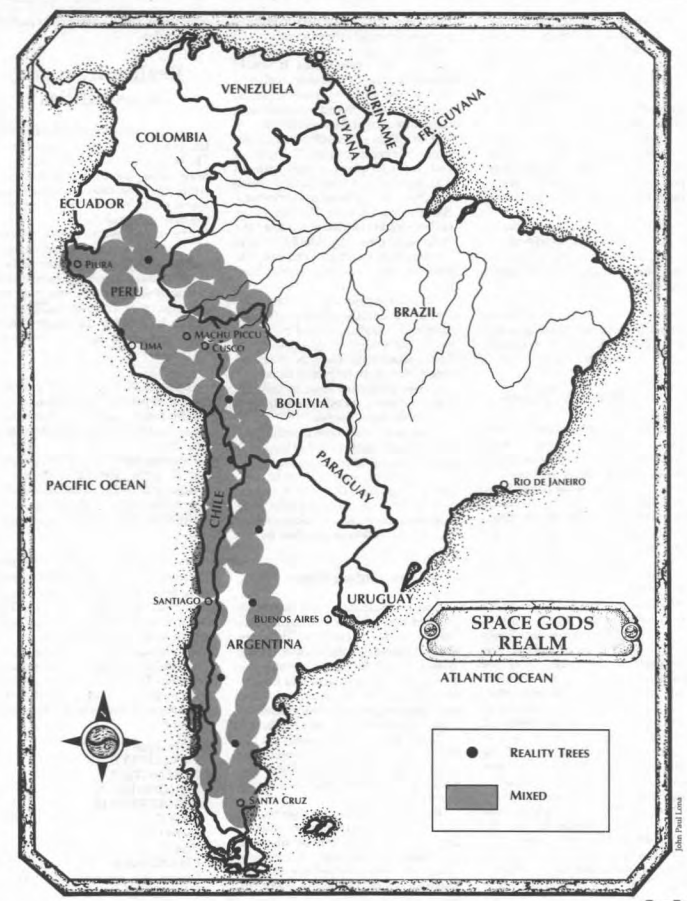
The Akashan "realm", about a year after their arrival.
It’s also obvious that reality trees could be a valuable weapon against the High Lords, because planting them in existing stelae zones and creating permanent mixed zones would allow the stelae to be taken down without killing all the Ords in the region. Of course, they could also be weapons for the High Lords, and as such they’ve become valuable targets for all sides.
Axioms and World Laws
The Akashans stand out amongst the other realities due to having very high axioms. As such, Akashan culture is a bit on the complex side as well as allowing access to new abilities such as bioengineering and psionics.
Oh, did I not mention psionics? Because this book adds psionic powers. I suppose that would have been implied by the nature of the Comaghaz virus, but for now you just need to know that they exist.
The Akashan axioms are:
- Magic: 7 - This is the only “low” axiom here, just below Core Earth’s. Magic is known to exist, but it’s high effort for little payoff and seen more as a strange pastime than anything else.
- Social: 27 - The high Social axiom allows for their rather unique form of government. There is the High Council that is in control, but they have representatives of thousands of worlds in a sort of Starfleet situation. The Akashans run things, but they must listen to all the other cultures they work with. The high Social axiom also allows for the existence of psionics; in fact about half of the Akashan population has some form of psychic ability.
- Spiritual: 13 The Akashans believe that every religion is just a reflection of Aperios (the cosmic force of creation) or the Nameless One (the cosmic force of destruction). As such, there's no one "correct" religion, including their own. Or, to put it another way, all religions are correct, just looking at the "actual" gods from different angles. This belief will heavily influence one of the World Laws.
- Techonological: 30 This is not only the highest Tech axiom in the game, it's almost the highest axiom level possible. Akashan technology is focused on biotechnology; they do have access to more "traditional" technology but find it aestheically unpleasant. As such, almost all their tech is organic, up to and including their spaceships.
The World Laws revolve around the high social axiom and the Akashan belief that all cultures and belief systems are valid.
The first is The Law of Religious Compatibility. As I explained above, this law states that there is no such thing as a “correct religion”. People of different faiths can assist with casting ritual miracles without penalty, and performing a miracle on someone of a different faith won’t have a chance of converting the target to your faith.
The second is Law of Acceptance, which is probably the most important world law.
quote:
Unlike most cultures, as Akashan culture evolved, it did so on the basis of first accepting the unknown, and then coming to understand it. Few cultures have been so able to assimilate others' beliefs into their own structure. This belief is tied into the philosophy of Zinatt and is so ingrained into every Akashans' psyche that it has become a world law. Even Sarila, in her mad desire for conquest, accepts this world law. She accepts the ways of others and then perverts them for her own ends.
A side effect of this law is that any Akashan zone will either pure or mixed. There’s no such thing as a dominant Akashan zone.
The final law is more of a philosophy than an actual “law”, but this philosophy/religion is so pervasive in Akashan society it’s evolved into a world law. It’s called The Way of Zinatt, and it affects every way of life in the Akashan reality. Every Akashan seeks enlightenment through two of these stances, with the third being the final balance of the first two.
Zinatt consists of three philosophical "stances":
- Aka is the belief that wisdom is found by looking within, via introspection and meditation. Aka followers tend to look after themselves first, and are very individualistic. This is the belief Sarila belongs to, although she's filtered it through her control of the Comaghaz hivemind.
- Coar is the belief that wisdom comes from asserting your will onto the world. Followers of Coar put the group over the individual; the needs of the many outweigh the needs of the few. Note that doesn't necessarily mean putting the good needs into operation. Many Akashans see Coar as the path to power.
- Zinatt is the balance of aka and coar, and is the ultimate goal of enlightenment. When you achieve a state of Zinatt, your every action brings harmony and benefits all those around you. Very few Akashans have achieved this level of understanding, but those who do tend to become leaders of the Council.
This sudden infusion of these rules and axioms has created a very dangerous situation in an already dangerous war. New weapons are being spread among Core Earth cartels and invaders' forces. Despite their philosophy of acceptance, the Akashans have inserted themselves into a bad situation and are causing more problems than they've solved. They've started spreading their reality through several countries without seeing how the governments would feel about it. And while the reality trees might be able to save thousands of Ords, they could become dangerous weapons in the hands of the High Lords.
And that's all not even taking into account the Comaghaz virus. Sarila sees the Possibility War as a way to expand her hivemind out through the maelstrom bridges and into other realities. She could become a being of comparable power to the Torg, a single mind spread out through every possible reality.
Of course, no reality would survive the process. But isn't the possibility of living forever in the mind of a goddess honor enough?
---
Bet you didn't see that coming, did you?
NEXT TIME: We are all made of stars
The Lights In The Sky Are Friends
Original SA post The storm has a name... - Let's Read TORG
Part 22b: The Lights In The Sky Are Friends
So let's start talking about aliens.
Chapter 1 of the book is The Cosm of the Akashans, and already we're running into trouble because the way they set up the home of the Akashans isn't consistent with the terminology up to this point.
Right up front we're told that the Akashans are from another galaxy, but nothing says that galaxy isn't part of Core Earth's reality. Now, a cosm has been defined from day one as a single reality. On top of that, there's nothing in the book about the Akashans having trans-dimensional travel capabilities. So I don't know why they come from a "cosm" apart from the designers wanting to give them their own axioms and world laws.
Well, regardless, let's get into it.
quote:
The Genesis of the Star Sphere
An excerpt from the Akashic Records:
In the beginning, there was the void.
Then Eternity entered the Place; dreams and possibilities were unleashed and spread throughout the Void. The Maelstrom was born from the meeting of these two great powers of the cosmverse.
The possibilities spewed forth from the Maelstrom created galaxies and worldS, only to see them consumed by the Void. Eventually, only two possibilities survived - Apeiros, the Creator, and the Nameless One, the Destroyer.
Apeiros spang from the side of Eternity to send possibilities spinning throughout the Void. Life began, and Apeiros' power was multiplied billions of times. But the Nameless One emerged from the Void and consumed the energy provided by Apeiros, and then attempted to consume the Creator himself.
Apeiros spread his wings and soared from the Void. He entered the Sphere of Stars where galaxies spun from his wings. Whirling on their axes, the galaxies flickered and flared, and novas blasted across the Star Sphere. Where the Creator's wings touched, worlds were imbued with possibilities and began to glow with power.
Slowly, the worlds began to revolve around the stars. The stars warmed the planets, causing oceans to boil. Great winds blew, mountains arose from the ground and volcanoes exploded, shooting fire into the sky. In time, these worlds grew quiet, and the seeds of life, planted by Apeiros, began to bloom.
Beings created in the image of Apeiros thrived. But the Nameless One envied the Creator's accomplishment, and sent his darkness to consume the civilizations of the Star Sphere. He did not succeed, for the children of the Light were strong.
The Nameless One is an entity of limitless patience, and we must never relax our Vigilance. Someday, he will return and attempt to undo all creation, and on that day, our courage and strength will be our only weapons.
The Akashans hail from the Star Sphere, a galaxy far, far away that is host to about 500 individual alien species. The Akashans are the ones in charge, though, and refer to the various species they've made contact with as "client races".
As a species, the Akashans are over ten millenia old. They began rising to prominence when they were visited by a race called the Mohani, who took an interest in the fledgling race and began shaping their development. They taught the Akashans the need for balance, gave them technology, and helped them learn about reality mechanics.
quote:
The Mohani referred to themselves as pultaak, a word which can be roughly translated as "caretakers."
The Mohani explained that they took it upon themselves to uplift the Akashans, because the purpose of those with knowledge is to pass it on to make others' lives better. This leads to what may be the most 90s RPG sentence ever: "The Mohani often expressed the hope that one day the Akashans could become the pultaak for other civilizations." With that line of gobbledegook delivered, the Mohani informed the Akashans of the existence of stargates and vanished mysteriously from the backstory, never to be heard from again.
Not knowing what happened to the Mohani, the Akashans decided that they were ready to move out to the stars. And thus began the true Akashan empire.
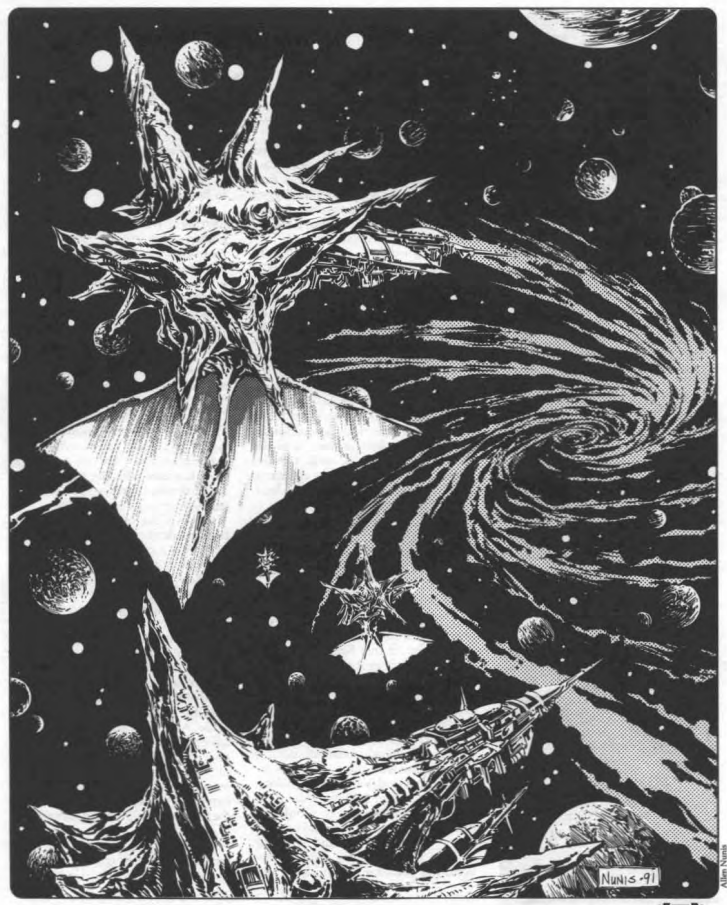
What this all probably looked like in the author's head.
In keeping with a realm book's terrible organization, we now get a description of what an Akashan actually looks like. They average about six feet tall, with features that resemble Mayan Indians to the point where they superficially look like humans. The only real difference is that their body temperature is about 32 degrees F, so they're very cool to the touch. They have a natural lifespan of about 100 years, and a notable percentage have psychic abilities. Those with actual psioncs are highly valued in Akashan society, but at the same time have to deal with the kind of predjudices you'd expect against people who can read your mind.
The Akashans are governed by the High Council, the leader of which is known as the Rotan. The Rotan's job is to be final word on rulings, after considering the balance of all arguments involved.
And there are arguments. The High Council does not decide things through votes, but via debate and an appeal to the Rotan, whose decision is always final. The Rotan is not elected, but chosen by all Council members. Being Rotan is a job for life, unless he's doing such a bad job everyone agrees to oust him.
The current Rotan is Ulka, and it was ultimately his decision to answer the Signal Fire and head to Core Earth. It was, admittedly, a choice made out of desperation, and he's well aware all the problems caused by the Akashan's arrival are a result of this decision.
Along with the High Council, non-Akashans are represented by the Kyat, a sort of sub-council comprised of representatives of the client races. They represent the interests of the various non-Akashan races...at least, that's how it looks from the outside. In reality, the Kyat aren't allowed to get involved with major Council discussions and have no say in anything of actual import. The Kyat was specifically formed to placate the client races and make it look like they had a say in the governance of the Star Sphere, but for the most part people (at least, non-Akashan people) think the Kyat actually matter as part of the governmental process.
The Akashans have also created a unified economy across the Star Sphere, the basic unit of which is a small crystal called the ciara, so at least we're not using credits. But given their dominance of space travel and control of government, the Akashans as a people are pretty well off. Sadly, the same can't be said for the client races; while the Akashan lifestyle is one based around the pursuit of art, science, and leisure, the client races are the ones who do all the actual work.
quote:
This is not a situation that sits well with some younger Akashans. They believe that the isolationist tendencies of their race, combined with assured wealth, have turned their elders into naive, detached leaders incapable of handling a crisis. Many point to the predominance of alien crews on Akashan vessels and alien laborers performing essential services as signs of a gradual erosion of their society.
Huh. That is honestly not something I expected to see in a 90's Torg setting book.
Law and order in the Star Sphere is enforced by the Monitors, although it's not exactly right to think of them as cops or a military force. The Monitors were originally intended as a defensive force to deal with the kinds of threats you run into while exploring space (pirates, hostile aliens, and so on). They eventually evolved into a first-contact task force, and now their job is to protect the inhabitants of the Star Sphere from internal and external threats.
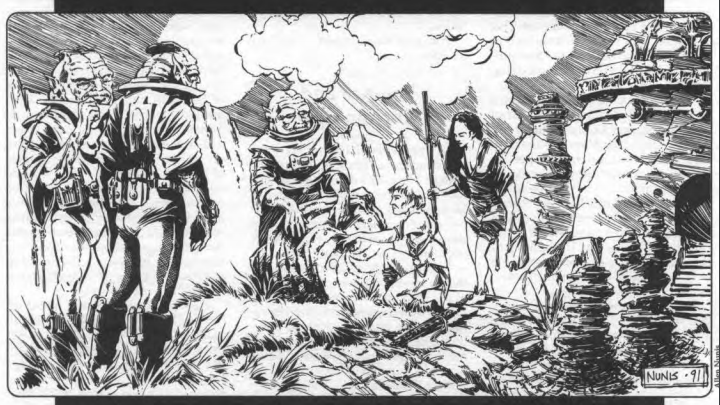
My scientific analysis: it's weird.
Now it's time to get into the details of Akashan philosophies. I know most of you are probably rolling your eyes at the idea of having to deal with yet another pointless setting detail, but the fact of the matter is that the Akashan belief system is very important to their society as a whole, to the point that their society is based around it.
The philosophy/religion (it has elements of both) of the Askashans is known as Zinatt, and can best be described as the need to achieve balance in all things.
quote:
For every creation, there is a destruction, and every being has creative and destructive energies within him. Akashansdo not believe that any tool (psionics, weaponry, etc.) is inherently good or evil, but that its place in the order of things is determined by how it is used.
This belief in the existence of coexisting, but contradictory, forces has allowed the Akashans to accept both Apeiros and the Nameless One into their religious pantheon. While the majority of Akashans prefer life to death and the Star Sphere to the Void, they understand and accept that there must eventually be an end to all things. This passive attitude has led them to often ignore potential threats until it was too late, as was the case with the Comaghaz.
To be fair, though, it's established that Aperios and the Nameless One are real, so I guess you have to give the Akashans a bit of credit here.
Zinatt is composed of two different philosophical camps: Aka, which is the more isolationist, and Machu Coar, which believes that the Akashan's purpose is to be caretakers of the "lesser races". Note that this is a little different than the alignment system I brought up in the opening post, but in the interest of not throwing a million concepts around I'll leave that stuff for later.
Followers of Aka are known as "Akites", and are the larger of the two camps. Akites believe that the Akashans have no right to interfere with societies outside the Star Sphere, no matter how much help they can provide. They don't believe that the Akashan's own precursor race handed down a manifest destiny that had to be fulfilled, or even that their precursors benefited from that help in the first place.
This has led to a very isolationist mindset: the Akashans should worry about the Akshans, everyone else is on their own. The rise of the Cohamgaz virus has only made this mindset worse, to the point where Akite extremists have begun blowing up ships belonging to client races, on the basis that they might be carriers.
It's interesting to point out that most of the richest and most powerful Akashans are Akites, as are a large portion of the High Council. The only reason they agreed to answer the Signal Fire was desperation.
Machu Coar is a relatively new camp, having formed after the Akashan's first failed contact with Earth at Machu Pichu. Followers of Coar see the Akashans as steward to the lesser developed species (i.e., everyone who isn't an Akashan), and that it's their duty to sweep in bearing the gifts of higher civilization.
quote:
Extremist elements within the Machu Coar had, at one time, advocated the outright conquest of those worlds that were destroying their environments and retarding their own development. The idea was that Akashans would manage the planet until the native race had advanced sufficiently to be able to manage on their own and the imbalances they had created had been corrected. This was tried with mixed success 1500 to 2000 years ago, but was the first program to fall out of favor after the disaster on Earth.
The rise of the Cohmagaz has resulted in a growth in popularity for the Coar. They claim that the Akites, and by extension the High Council, is out of touch with the people, and that the Akites are willing to throw the client races under the bus if it meant stopping the plague. Recent evidence (as well as the lighting of the Signal Fire) has boosted support for the Coar, and it's becoming more prevalent with younger Akashans.
It should be pointed out that not everyone in the Star Sphere belongs to one of these camps. Those who follow neither are assumed to be followers of "pure Zinatt", and as such have achieved a sort of balance between the other two camps. Which is to say, they're not political extremists. This (again) plays into the alignment system we'll see in a few chapters.
But enough about depressing political stuff! Let's talk technology.
As has been stated before, the Akashans are a very technologically advanced race. Their precursors, the Mohani, utilized what we'd think of as "modern" technologies, but the Akashans found it very off-putting due to its inherent artificiality. This eventually led to the Akashans developing biotechnology during their Fourth Industrial Revolution. This was also the point where the Akashans developed space travel, but interstellar travel didn't start until the Mohani revealed the existence of stargates to them.
All Akashan technology now is based around biotech, up to and including their spaceships. Akashan biotech is designed as much around aesthetics as functionality. Akashan biotech is more plant-like than meat-based, although their ships have a sort of aquatic appearance to them. Akashan ships are solar-powered, and while they can last for a very long time, they can't handle inter-system flight without the use of stargates.
The stargates were (presumably) created by the Mohani. They're not so much "gates" as holes in space that can only be detected via psionic abilities. The stargates are connected to each other in an established network, and traveling from one gate to the next takes about a week.
The last part of the chapter is about the client races. Or, to be more precise, four of the client races. And while they're kind of neat, they suffer the Torg problem of secondary races being sort of shuffled into the background and forgotten about after being introduced.
First up are the Lorbatt, who look like two-meter tall beetles. They stand upright, using their front four legs as arms, and are capable of excreting a strong glue-like substance as well as the solvent for said substance. They're also violent as fuck; Lorbatt will fight with anyone and everyone (including each other) just for the hell of it. They're strict carnivores that operate in a caste system based on the leadership of hive-queens, the most honored caste being warriors. The Lorbatt were quite a ways along on conquering the Star Sphere before the Akashans were picked to be the One True Masters, and as such the Lorbatt are very rebellious against Akashan leadership. The fact that the Akashans spread the Cohmgaz virus to the Lorbatt homeworld didn't exactly help relations either. The High Queen has decreed that anyone carrying the virus should be executed on sight, regardless of species, location, or situation.
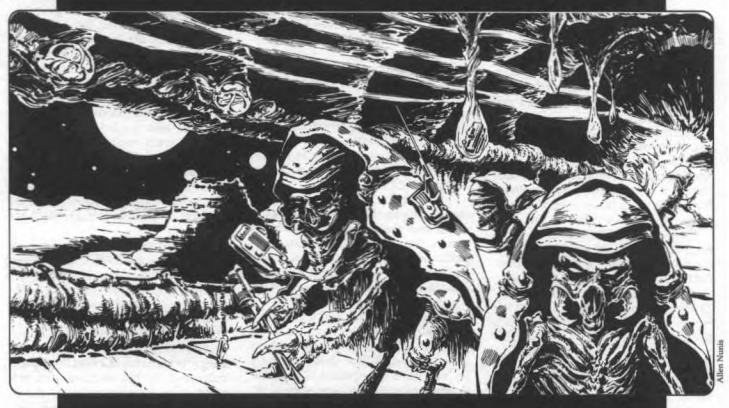
What're you lookin' at, pinky?
Next up are the Gudasko.
quote:
Gudasko are humanoid creatures which average two meters in height. They are covered with a smooth, tight skin which ranges in color from the purest white to pale violet. Their hair, which covers the sides of their heads and lightly coats the rest of their bodies, is bristly and white.
Gudasko have a bony ridge running down the center of their foreheads, and two flexible antennae sprout from either side of their heads. These antennae grow to a length of nearly a meter and are deep red in color. Gudasko use their antennae as feelers for both smell and touch. Gudasko haveno noses, and their faces resemble flat skulls. They are incapable of facial expression.
The mouth of a Gudasko is filled with sharp pointed teeth, giving the species an even more frightening appearance. Their slitted, cat-like eyes allow them to see in clearly in lowlight conditions. Their hands and feet are equipped with sharp, retractable claws which they use to good effect in combat.
Next we have the Larendi, the obligatory bird people. The Larendi are a migratory species who don't go in for personal possessions, and have an inherent hatred of technology that would harm the environment. And...that's pretty much it for these guys.
Last up are the Draygakk. Draygakk are "large dragon-like humanoids" that resemble the edeinos, only scalier, with bone ridges and no tails. The Draygakk are actually a very placid species until riled, at which point they erupt in berserker frenzies. The Draygakk homeworld is "Tes-Klick-Aah", which isn't pronounced like that; it's a series of hisses, clicks, and exhalations. The Draygakk are very curious about other races, and as such have taken advantage of Akashan space travel to set up scientific outposts throughout the galaxy.
Now, while those are interesting races, only the Lorbatt keep popping up throughout the book. All these races are playable, but it's a huge pain in the ass to create them.
--
Well, there we go. Not much to say here, except god damn Torg loved its silly names.
NEXT TIME: Sarila is.
Sarila Is
Original SA post The storm has a name... - Let's Read TORG
Part 22c: Sarila Is
It’s been a while since the last post (again), but now it’s time to talk about the Comaghaz virus.
quote:
Santor paused in his work and wiped the perspiration from his brow. He could not recall its ever being so warm on Akasha before - perhaps the climate control devices in this structure need repair, he said to himself.
He forced himself to concentrate on his studies. The history of the Draygaak people was a fascinating one, and he found it particularly interesting how they had transcended their fearsome physical appearance and become such noted scholars. Granted, they had not
yet approached the level of the Akashan intelligentsia, but given time…
A bead of sweat dropped into his eye, blinding him. He let out a gasp at the burning sensation and dropped his infoscanner. He was going to complain to the· caretaker of the building when the room seemed to shift before him suddenly, and he found himself on the floor.
A wave of fear passed through him. He felt ill - something which should have been impossible, given his genetic makeup. He had spent over 1000 ciaras on having his immune system strengthened, and if that money had been wasted, his bioengineer would be sorry indeed.
He struggled to rise, fighting off the dizziness. He would go home and take a rest, perhaps he had been studying too hard…
That was when he heard the voices. They were all around him, soothing him, encouraging him, a chorus led by the soft, silken voice of a woman. He could almost see her face as she spoke to him of destiny and fate, and offered him a sense of belonging he had never known before.
Deep inside his mind, something was screaming a warning, telling him the voices were a product of the fever that raged within him. But he did not listen, indeed he could not. The voices insisted he join with them, and told him once he belonged, he would be able to share his experience with others.
It all seemed so wonderful, he had no further thought of resisting. Gratefully, totally, he surrendered himself to the voices, and let them tell him what he must do. He felt whole, even the fever had ceased to annoy him. As he passed through the hallway, the caretaker bade him farewell.
As the voices sang in triumph, he reached out to take the old man's hand and share the new sensation he'd discovered ...
As stated in the initial Space Gods post, the Comaghaz is the creation of the geneticist Sarila, who was trying to create a threat she could easily solve to raise her political standing. The virus was indeed designed to be highly contagious and (eventually) deadly, but what Sarila didn’t intend was for the virus to become intelligent and self-aware.
Her attempts to find a cure were stymied by the virus’s self-preservation instincts, but once she realized the immunizations she had given herself allowed her to access the virus’s hivemind without being taken over, her goals shifted significantly. Her current goal is to spread the virus throughout the Sphere, and once she attains control over everyone she’ll declare herself head of the Council as a formality and lead the Akashans to “further greatness”. At least, that was her plan until she learned about the idea of becoming the Torg. Right now, she’s just trying to infect a few Storm Knights to get more of an idea how the Possibility Wars work before making any other moves.
(It’s worth noting that Sarila is fully stated up and, like most women in Torg, is described as “young” and “extremely beautiful”. That said, given that she’s a vain power-hungry master genetic engineer I suppose that description at least makes sense here, at least.)
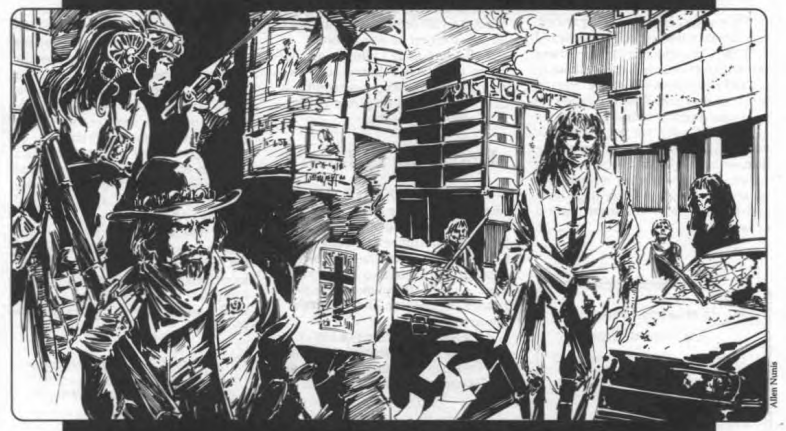
Not everyone shares Sarila’s vision of the future.
So let’s get into the details of the virus and how it operates.
The Comaghaz virus is a three-stage virus, being very contagious in the second and third stages. The virus has two major effects on the host: the aforementioned connection of the host to the hivemind, and a fairly rapid physical degradation that eventually burns out the victim’s body and brain.
The first stage of the virus start immediately upon infection of the host, and lasts for about three weeks. The virus is very difficult to detect at this stage; it’s basically biding its time, weakening the host’s natural immune systems and gearing up to attack the host’s mind. At this point, the host can be treated (assuming it’s known they’re infected) through medicine or the use of miracles like cure disease. Unfortunately, “treatment” isn’t the same as “cure”. The best you can do is return it to the dormancy of the first stage. And even then you need Tech axiom 26 medical equipment (which few realities have), and even then it’s a very difficult roll to succeed at the procedure. Even using a miracle or spell will simply return the virus to stage one for an “unknown period of time”. To make matters worse, the further along the virus is, the harder it is to treat.
When the virus reaches phase two, that’s when things get really bad. The host begin showing obvious signs of infection: cold sweats, fevers, increased heart rate, and dizziness. While the host’s body is deteriorating, the host’s mind is being connected to the greater hivemind.
This is the only point where the virus can be expelled from the system, and it can only be done by the victim. When the virus attempts to connect the host to the hivemind, the host must generate a Mind total. If they get a total of 25 or higher (which isn’t easy, even with Possibilities and cards), then they’ve managed to fight off the infection and are cured. The physical effects of the virus are undone, and you can keep your mind...as long as you don’t get re-infected.
However, if you get less than a 25, then you become connected to the hivemind. The lower your result, the lower in the hivemind’s “cell structure” you’ll be placed, but we’ll get to that in a bit. Regardless of where you are in the hierarchy, you will receive a single imperative from Sarila: Spread the virus by any means necessary.
The virus is very contagious at this point; simple skin-to-skin contact will do it. Technically, the virus uses perspiration as a carrier and can enter the victim through their skin pores. Injection also works; in fact there are recorded instances of infected capturing people and setting up “plague hospitals” designed to pass the virus along and keep people contained until they hit phase two.
This phase can last anywhere from six weeks to two years, depending on the host’s strength of will (as reflected by that Mind roll). The virus wants people it can control but who are still aware enough to make their own choices to stick around as long as possible to coordinate things. During this stage, the host’s physical stats actually increase (due to the host ignoring things like pain and the body’s natural limits), but for most of the infected their mental stats will start to drop.
Phase three is the final phase, and is the point where the host is pretty much doomed. By this point, the host’s mind has been burned out due to the constant presence of the hivemind. Physically, the host looks like a decaying corpse with twisted limbs and cracked skin. From these cracks exudes a green viscous liquid that’s also a carrier for the virus.
Most carriers are nothing but mindless berzerkers used by the hivemind to break targets too difficult to infiltrate. The stronger-willed members will still look fairly normal, but are also living on borrowed time.
Once the virus reaches this stage, the host will die within six months. Once a carrier dies, it’s believed that the virus itself will die along with it. Still, better burn the bodies just to be safe.
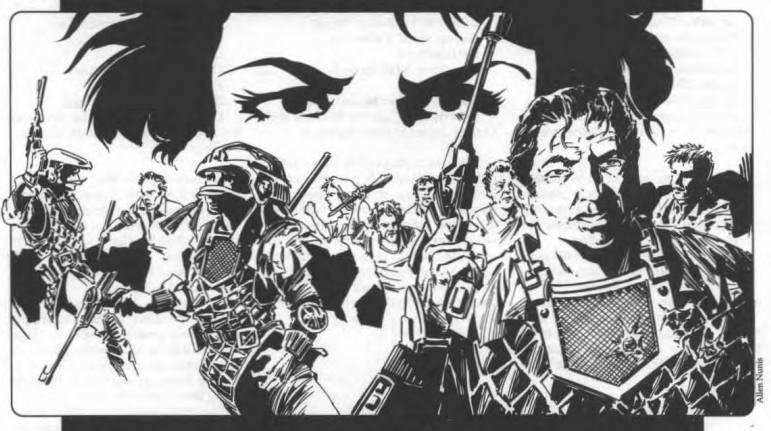
"When I make a fist to crush your resistance." "It is with three billion hands!"
That about covers the physical effects of the virus. But what about the mental? We’ve talked about the hivemind a bunch, so it’s time to get into the details about it.
As stated before, when someone becomes part of the hivemind, they come under the domination of Sarila. Being part of the hivemind is overwhelming to anyone except her, but even then she can’t control everyone all the time. To make up for this, her victims are organized into small units called cells.
Remember before when I mentioned the roll to resist being taken over during stage two of the infection? The value of that roll (assuming you didn’t beat the target number of 25) will determine where you get placed in the mental hierarchy. Getting a 20-24 marks you as a leader, a 12-19 makes you a soldier, and an 11 or less marks you as a drone.
Leaders are those who still maintain the ability to act (mostly) independently, and tend to be P-rated. They maintain their original personalities for the most part, and have more of a self-survival instinct than other infected due to their usefulness; in fact the Comaghaz will delay the breakdown of a Leader for as long as possible to better serve the cause. Every cell has a Leader, who will be in mental control of the Soldiers and Drones of that cell.
Soldiers are those who are capable of being Leaders if needed, or those who possess useful skills but don’t have the strength of will to maintain their minds. The best way to describe them would probably be as back-up systems for Leaders. If a cell’s Leader dies, one of the Soldiers will be selected to replace him. Soldiers can also control a few Drones to split off from the main cell temporarily as needed.
Lastly, there are Drones. Drones are...well, drones. Worker bees. They’re there to do the heavy lifting, overrun opponents, and be meatshields for the more valuable Leaders and Soldiers. Drones have no real free will; they’re just extensions of the Leaders. While a Leader might have a half-dozen Soldiers under his control, he can have any number of Drones to serve as weapons.
The purpose of the cell structure is two-fold. First, it removes a lot of the heavy mental lifting from Sarila. Second, it makes the controlled people more powerful. Sarila created the cell structure because she realized that keeping Comaghaz-infested people together gave them access to new psionic abilities; the more minds in the cell, the stronger the power. This is measured in-game by the cell’s group mind value, which is calculated by taking the Leader’s Mind stat and adding a bonus based on the number of people in the cell. Unfortunately, this is Torg so instead of just adding a number, you take the number of people in the cell and look that number up on the Value Chart in the core book, then you look that value up on the Power Push Table to get the final bonus.
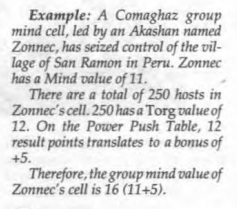
Have I mentioned that I’m insanely grateful Torg Eternity exists?
Anyway, the group mind value determines how effective the cell’s powers are, as well as the maximum range the Leader can control everyone else. Soldiers outside of the Leader’s range can last for a while and attempt to accomplish a goal they were given, but a Drone without anyone telling it what to do will just sort of stand around until given simple instructions or being “absorbed” into another cell.
There are only five group mind powers, but they’re more utilitarian than anything else. Which is fine, really; when you can have one guy controlling 250 other dudes and able to see through their eyes, you don’t need much else on top of that to be a threat.
- Alarm can only be performed by Drones, and sends an alert to a Soldier or Leader if a certain event comes to pass, such as “we are being attacked” or “someone has come out of that building”. Note that since this is done by Drones, it’s very much a simple if/then case; in the later example, the Drone would have to actually see someone leave said building for the alarm to happen. If people sneak out the back, or the Drone sees people enter the building, nothing happens.
- Extend Group Mind lets a Leader increase the range of its control for an hour.
- Psychic Jammer increases the difficulty of psionic powers for three meters around any cell member.
- Report lets a Drone or Soldier set up a two-way mental link between itself and its Leader or another Soldier.
- Sentinel lets a Leader or Soldier see through the eyes of anyone in the group mind who’s lower on the mental totem pole.
And while this is the end of the chapter, I would like to point out one bit of Torgian design on these powers.
Alarm, Report, and Sentinel are powers that should just work. Inherent abilities, right? Kind of the point of the whole group mind? Well, unfortunately they’re stated up as full Torgian powers. Which means a full stat block, which also means there’s a difficulty. For the abilities that should be automatic, instead of just saying “Difficulty: none” or something simple like that, they gave these abilities very low difficulty numbers. Like 5. Which is really easy to hit, but also means that a bad enough roll could mean that a Leader couldn’t use their hivemind powers. It also means that the GM needs to roll every time they want to do these basic abilities.
Even after all this time, Torg still makes me shake my head in disbelief.
--
The Comaghaz is interesting, and has some very cool uses, but...well…
It doesn’t feel like it belongs in this game. It doesn’t help that the Akashans showed up so damn late, but with the whole War going on it feels sort of extraneous. It’s just One More Thing on a game that already has a huge pile of concepts.
Oh well. I’m sure discussing the Akashan realm will go better!
NEXT TIME: Colonialism, but for
We invaded you, please help us
Original SA post The storm has a name... - Let's Read TORG
Part 22d: We invaded you, please help us
So now we have this race of aliens coming to Earth, setting up colonies, and spreading a virulent disease in what may be the weirdest metaphor for colonialism ever. What's it like in a realm of mixed realities and full of psychic zombies?
The Akashans' ships were first noticed in the skies over Peru and Bolivia before they ended up touching down at Machu Pichu. Needless to say, there was surprise on both sides.
Core Earth and the invaders were not expecting aliens to show up, of course, and the Akashans were surprised that Core Earth wasn't the super-advanced race they had expected. And in actuality, the Council was ready to just leave rather than exacerbate the already chaotic situation they stumbled into.
But then the debate started.
As was stated previously, all Akashans belong to one of three schools of thought; Coar (asserting your will on others aggressively will lead to enlightenment), Aka (self-reliance and not interfering with others will lead to enlightenment), and Zinaat (enlightenment comes from finding the balance between the Coar and Aka beliefs).
The Coar elements of the Council argued that it was their duty to stay and help. After all, the Akashans had done this thousands of times before, aiding less-capable species and lifting them to the heavens. The situation on Core Earth required the Akashans to stay, fight the invaders, and lead humanity to a Bright And Glorious Future.
The leader of Council then asked the highest-ranking Akaite to provide a counter-argument. Unfortunately, that person was Sarila, and she said nothing. She had just started picking up the options that the Possibility Wars would open up for her, and she wanted to stay and learn how to turn this mess to her advantage.
(It's worth pointing out that, at this point, Sarila has no long-term plan. She is winging it as best she can with no end goal beyond "become a god". She's even managed to fool herself into thinking that the Comaghaz isn't killing people despite the obvious fact that it kills everyone infected. She won't get much better at things down the line, either.)
With the Council in "agreement", the Akashans landed at Machu Pichu and began planting reality trees. It also turned out that when the Akashans last visited Core Earth centuries ago, they left some labs hidden deep underground with 100 Monitors waiting for the Akashans to return.
quote:
The Akashans who have been in Machu Picchu all these years consist of over 100 Monitors and bioengineers, virtually all of whom would be considered radical Coar by the present Akashans. Their abandonment by the High Council has long been a cause
celebre in the Star Sphere, and they are legends to a whole new generation of Akashans who believe their race has a right to guide others.
Their revival produced a psychic explosion in Peru, as their awakening minds began to probe for others of their kind. Latent psionic powers were triggered in a number of people who were unversed in how to use them, with the result that many were felled by severe headaches or plagued by visions of Akashans clad in Incan garb. Meanwhile, the first to awaken prepared the reality of Machu Picchu by planting the lone surviving reality tree.
It only took a few months for the reality trees to take root, making a sizable chunk of South America's western coast a mixed zone. Sort of.
Which makes this as good a time as any to talk about how Akashan reality works!
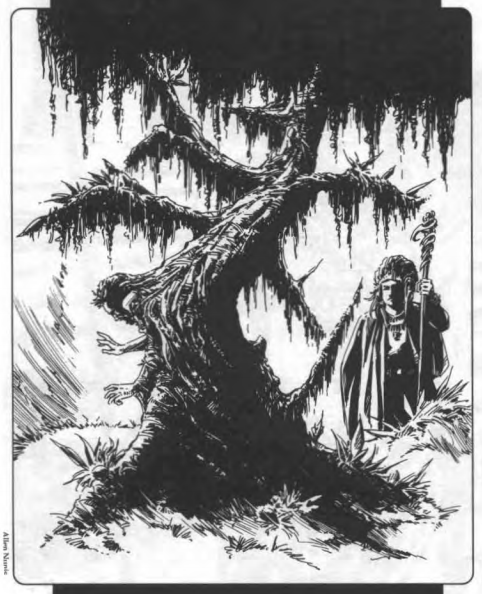
Looks comfy.
As stated in previous posts, Akashan reality is non-invasive and non-destructive. What this means is that Akashan reality does not cause transformations in the same way that other realities do. It's still possible for someone to flip to Akashan reality, but only in extreme circumstances, such as being caught in a reality storm. That's not to say you couldn't disconnect, but even if you did you can reconnect pretty easily.
In addition, the World Laws allow the World Laws of other realities to remain in effect for P-rated people. If you're from Aysle and in Akashan territory, then you'd be operating under the Star Sphere's axioms and World Laws as normal, but you'd also still have access to the World Laws of Aysle. The only exception is when a World Law directly contradicts ones of the Akashan ones (such as the Cyberpapacy's "Law of the One True God"), in which case it causes a one-case contradiction.
The way Akashan reality is spread is not through stelae zones, but by reality trees. Reality trees are probably the pinnacle of Akashan bio-engineering, because they allow the users to create safe, permanent, mixed reality zones without having to worry about stelae boundaries or having access to a Darkness Device.
Reality trees are grown via special seeds, planted in locations picked by the Rotan himself. Once planted, the create reality tree miracle is performed, imbuing the tree with possibility energy.
quote:
At this point, the process enters its most critical stage. For an extremely brief period (normally not more than an hour) during the course of the miracle, the outer surface of the tree will become fluid. When this occurs, a living, cognizant and willing being must enter the tree by passing through its surface. Once inside, he will become a part of the plant, sustained by it until it is fully grown.
Once the tree is fully prepped, it begins creating a mixed zone out of the reality it's planted in and the reality of the person inside the tree. So if you planted a tree in the Cyberpapacy with a person from the Nile Empire inside it, the tree will start forming a mixed Cyberpapal/Nile Empire zone. It takes nine months for the tree to fully gestate; when the process is complete, the person is expelled by the tree and the mixed zone will extend out to a radius of 160 km (about 100 miles), and will be permanent. This means that if the aforementioned Cyberpapal zone came down, the Cyberpapal/Nile Empire mixed zone would remain. A tree's zone can be extended through the use of "secondary seeds", which the tree will sprout from its roots.
Unlike stelae, reality trees don't need to be powered by Possibility energy or a Darkness Device, don't cause reality storms (at least, not big ones), and don't need to be placed in any sort of pattern (although the Akashans generally plant them so their radii don't overlap).
The Akashans only end up planting six trees at the time the book takes place, but have managed to extend things out so that most of the western coast of South America is a mixed Akashan/Core Earth zone. It should be pointed out that at no point did the High Council ask anyone on Core Earth if they were okay with this.
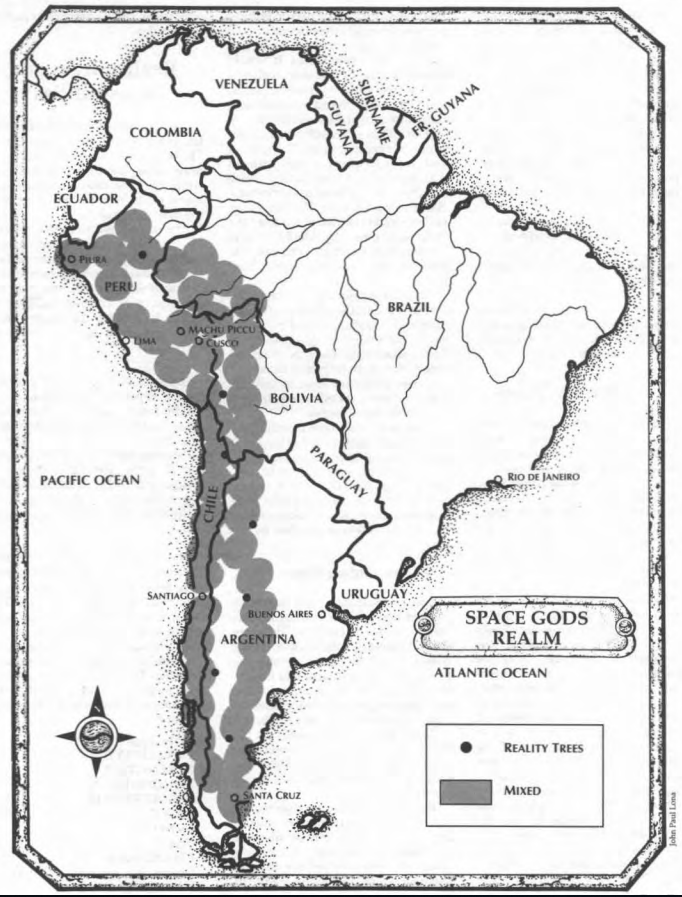
The Akashan realm, not long after their arrival.
Now, the clever amongst you will have realized that this is a potential way to take back territory from the High Lords without having to go through the whole business with doing great deeds and hunting down stelae. That's deliberate.
quote:
The End of the War?
The non-destructive reality technology of the Akashans represents major progress in the war against the High Lords, as it may solve one of the greatest problems the Storm Knights face: how to successfully reclaim an area without immolating hundreds of the transformed?
Prior to the Akashans' arrival, the only way to do this was to perform a great deed about which tales could be spread, thus infusing the transformed with new hope and Possibilities. When stelae would then be removed, those refilled with energy would be safe from the consequences of twin transformations.
Reality trees provide a more reliable answer to the problem. For example, reality trees could be planted on the island of Hokkaido in Japan with Nippon Tech characters within them. When enough area was covered by what would now be non-destructive Nippon reality, stelae could be ripped up. All of those on Hokkaido who had transformed to Nippon during 3327's invasion would be safe, as they would still be living within a Nippon reality. But 3327's Darkness Device would no longer be receiving
possibility energy.
In this manner, the High Lords can eventually be defeated, but the alternate realities they brought with them can remain. This, of course, depends on the Akashans' willingness to share the technology, which many wish to be conditional upon receiving aid from Storm Knights against the Comaghaz.
So let's get into the nitty-gritty of how humanity has adjusted to this mess landing in its backyard.
When the Akashans first arrived, the Nippon Tech-controlled media outlets immediately started urging panic at the threat of a new invasion; 3327 (probably) didn't know who the Akashans were, but took the safe bet that they weren't here to help the High Lords. The Cyberpapacy also got involved, but that was due more to Malraux having already having a foothold on Central and South America.
Before landing (and seeing the effects their arrival had already caused on the populace), Council leader Ulka ordered reality trees to be planted in secret at the landing site at Peru before his ships touched down. Note that he didn't mention this to the Peruvian government.
When the ships finally landed, onlookers were pretty shocked to see that the aliens looked pretty much like humans in ancient Incan garb and were speaking the native language of the native Peruvian tribes. They were even more shocked when the translators arrived and the aliens were talking about something called the "Signal Fire" and by the way there's this plague they needed help with...
Not exactly what you'd call an optimal first contact situation.
quote:
With a general truce in effect, the Akashans and the Peruvians began to work together. Already considered the "major gene pool of the world," Peru offered a vast bounty of research material for Akashan bioengineers. As the Space Gods' reality has spread throughout the country, the jungles have grown lush again and the government has sponsored institutes to study the psionic abilities now being evidenced by many in the realm.
In addition, the Akashans' extensive knowledge of the ancient civilizations that thrived in Peru has led Core Earth archaeologists to many startling finds. There have been reports of more secretive expeditions by the Akashans to major archaeological sites such as Cajamarquilla and Pachacamac, something which has been denied by representatives of the Monitors.
Thus far, Comaghaz infection in Peru is relatively rare, with most of the problems focused on the Arequipa area in the southern section of the country. Although the Akashans are concerned, the Peruvian government is not yet willing to commit resources for what they see as simply mass hysteria.
The first actual location that's discussed is Cuzco, which was the heart of the Incan empire back in the day. Now, the inhabitants have welcomed the Askashans into the city because they feel that the Akashans were the source of the valley's prosperity back in the day. The Akashans have turned the city into its military headquarters, feeling that the small valley is a perfect location to hold of Comaghaz hordes should the need arise. Rotan Ulka has also relocated to this region.
Next up is Lima, which is the capital of Peru and is also not as cool with these aliens showing up and setting up shop. Riots happened with the arrival of the ships, and the government attempted to keep the Akashans out of the city while they tried to figure out how to deal with this whole situation. I say "attempted" because a few Coar-aligned Akashans managed to sneak into the city to try and "fix" things (again, without asking). This lead to more riots and the Akashan leaders and important people (like Sarila) to pull all their people out of the city while they met with the country's leadership.
That went about as well as you think.
quote:
Not everyone heeded this offer, and Lima is now home to the dregs of the client races, radical Coar activists, and Comaghaz carriers who have started spreading the disease in the slums of the city. Periodically, Monitors are dispatched from bases outside the city to capture and discipline Star Sphere residents.
Hey, you know what Columbia was known for in the 90's?

Yeah.
So I'm sure you're all assuming this is a case of the Akashans having the ability to create superdrugs would result in the cartels trying to get in on that action, right?
Wrong.
Here's the thing: the Akashans have created recreational drugs (of course), but long ago bioengineered methods to eliminate the addictive qualities of those drugs. On top of that, the drugs have the nice side-effect of cleansing the human system of other addictive substances. Needless to say the cartels are not happy about this, and have begun preliminary strikes on the Akashans. Which would seem suicidal given the differences in technology, but fortunately for the cartels they've begun getting backing from various Nippon Tech sources. The Akashans have been playing a defensive game on this front, but some of the coar followers have been pushing for a full offensive to wipe out the "vermin of this society".
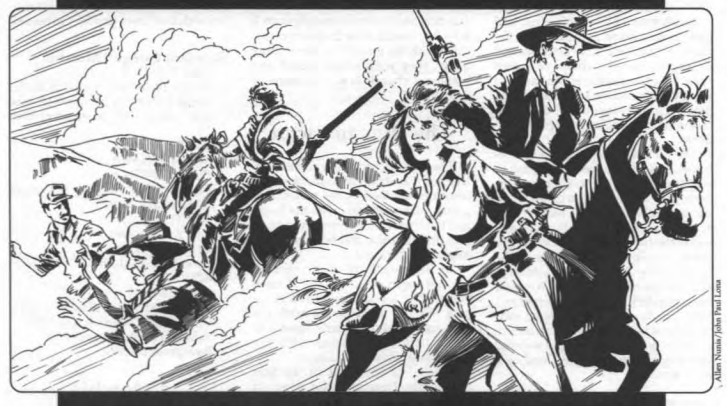
Not really relevant, I just wanted to break up the text.
Brazil hasn't really been directly touched by the invasion, but that doesn't mean they're not affected. Brazil contains a pretty sizable chunk of the world's rain forests, and despite everyone telling them the planet needs all that biomass the Brazilian government has been pretty dedicated to ripping it down. The arrival of the Akashans and the sudden axiom changes has re-awoken an old Akashan creation: the rhadangea plant, a plant/animal hybrid that is more than capable of fighting back against the logging companies. They were created way back when the Akashans first arrived on Earth, but laid dormant until the lighting of the Signal Fire.
This is actually a very important detail, partial because environmentalism, but also because the discovery of the rhadangea had a pretty bad domino effect. After a few loggers got strangled to death, the Brazilian government hired some Storm Knights to go find out what was going on. It was determined that the rhadangea wasn't the work of a High Lord, and this investigation was the first contact the Akashans had with Storm Knights.
It was also the first time a Storm Knight was infected with the Comaghaz.
In the end, the Brazilian government declared the Akashans enemies of South America. This may have been influenced by the Cyberpapal nuncio in the capital, but we'll talk more about that later.
Bolivia has been thrown into near total chaos by the arrival of the Akashans.
quote:
Roughly half of Bolivia's population is descended from the pre-Columbian Aymara and Quechua cultures, and have in general been considered an underclass, derisively referred campesinos ("peasants") by the European upper class. As the Akashan realm spread across the western half of the nation, with some transformations occurring near Tarija and Monteagudo, the poorer classes began to look to the visitors as saviors. Some paint them as agents sent to restore the ancient glories of the native Indians, others as military leaders who will reclaim the territory Bolivia has lost to its neighbors over the years.
Chile has been heavily populated by the Akashans, but the government is trying to split the difference between giving the Akashans power and balancing it with negotiations with the Comaghaz hivemind for some damn reason. Something something "both sides" I guess. The Akashans don't know that the Chilean government has been talking to the hivemind, but would presumably not be happy about it if they found out. The whole situation has been set up by the Kanawa Corporation under the guise of the South American Development Trust, which was actually set up at the start of the Possibility War under the cover of "providing aid to South American economies". Somehow, the SADT has managed to get up branch offices and research facilities in Akashan territories, so I'm sure nothing good will come of that.
Lastly, we have Argentina, which has made out worst of all the South American countries due to the lightships that landed there having a lot of infected on board. Sarila has made a big push here, spreading the virus as widely and as quickly as she can. This has caused the Argentinian government rejecting Akashan offers of help due to distrust of the aliens who dumped this mess in their lap. That, in turn, has made containment difficult. The uninfected parts of the country have seen a strong increase in generalized xenophobia, making it dangerous for pretty much anyone from the outside who's trying to help.
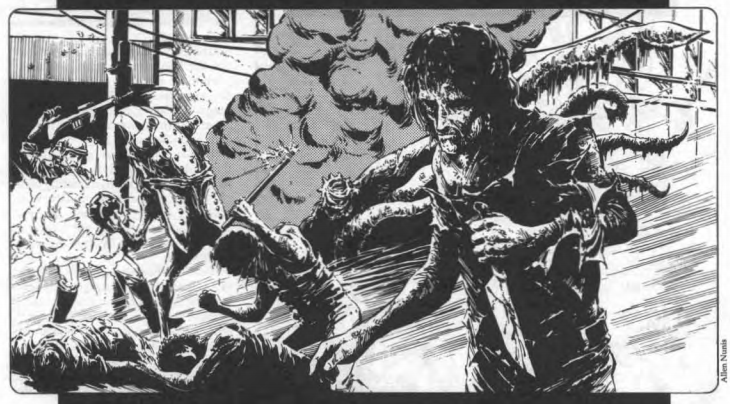
This is fine.
There's a little info on the rise of the Comaghaz and psionic powers on Core Earth, as well as the usual details on money and how people dress, but this is insanely long at this point so we're just going skip those really short sections and (assuming anyone's still reading this) go ahead and talk about how the other High Lords are dealing with this new twist in the War.
At this point, Baruk Kaak's in a pretty shitty position and has been losing a lot of territory. As such, he's eying Akashan biotechnology as a useful new weapon that'd be an easy sell to his followers. After all, these weapons aren't dead things! How could Lanala be offended by their use? Interestingly, the Akashans seem to have very little problem with the edeinos in general; they see the edeinos as a primitive version of themselves from back before they were uplifted.
Lady Ardinay and Lord Uthorion are too busy dealing with each other to really worry about the Akashans, although Ardinay has extended diplomatic contact in hopes of an alliance (assuming the Space Gods are as good as they say they are). Uthorion really doesn't care outside of some sympathy for his old buddy Malraux, who's having issues with the Akashans. Neither Ardinay or Uthorion know about reality trees yet, but once that knowledge gets out both leaders will be heavily invested in acquiring them. Ardiany would see them as a way to pull out of the War without killing millions, Uthorion would see them as a way to cement his holdings.
Speaking of Malraux, the Cyberpope has a lot of fucking problems with this whole scene. A race of heretical aliens arrive in the territory he was trying to claim for the Cyberpapacy, bringing with them disease and this strange "psionic" witchcraft? And on top of all that, they think that all religions are equally valid? It's like they were created solely to be a slap in the face of the entire Cyberpapacy! He's been trying to undermine the Akashans through the various groups he controls in the area, and knows enough about reality trees to order them all destroyed when encountered by his forces. The Akashans, for their part, are smart enough to realize that Malraux's faith doesn't work well with the whole idea that "all religions are valid", and as such are prepping for the inevitable conflict.
Over in Orrorsh, the Gaunt Man is still trapped in his pocket dimension at this point in the timeline. That means that Thratchen the cyberdemon is still airquote-"in charge", and is so busy trying to maintain the illusion that the Gaunt Man's still in charge and trying to seize his Darkness Device that he's pretty much ignoring the whole thing. Heketon, the Orrroshian Darkness Device, is very aware of what's going on, and already has plans in motion to take advantage of the situation.
Dr. Mobius is fucking ecstatic at the arrival of the Akashans and all that sweet, sweet biotechnology, not to mention all those cool psionic powers. He's extended the hand of friendship, but fortunately the Akashans were warned about him early on and are just playing along for now. Mobius is too egotistical to think the Akashans are a threat, and the Akashans have a strong interest in the fact that some of their old temple/colony/labs are in Nile Empire territory.
3327, like Malraux, has had designs on this region since the beginning of the war. Unlike Malraux, however, the Kanawa Corporation was further entrenched when the Akashans showed up. Seizing control of criminal cartels, destabilizing various economies, buying up resources, manipulating governments, all the usual Nippon Tech bag of tricks got thrown out the window when the Akashans touched down. Arms sales are down (since the Akashans have better guns), the drug trade is hurting, and the economic and governmental controls 3327 had in place were shattered. As such, Kanawa has declared war on the Akashans. He's throwing everything from boardroom experts to ninjas at South America, and is also looking into aquiring reality tree technology for himself. While the Akashans don't see 3327 as a threat, Sarila is smart enough to realize that 3327 is a major obstacle to her plans.
And with that, we finally reach the end of the chapter.
---
Here we are at the end of the chapter again, and once again I don't have much to say in summary. There's only so much I can say about piles of setting info, really. At least now we can get to the mechanics.
NEXT TIME: The mind is the limit
The mind is the limit
Original SA post The storm has a name... - Let's Read TORG
Part 22e: The mind is the limit
Now that the setting details are out of the way, we can talk about the much more interesting mechanical side of things. As I always do, I'm going to quote myself on the axioms and World Laws.
quote:
The Akashan axioms are:
- Magic: 7 - This is the only "low" axiom here, just below Core Earth’s. Magic is known to exist, but it’s high effort for little payoff and seen more as a strange pastime than anything else.
- Social: 27 - The high Social axiom allows for their rather unique form of government. There is the High Council that is in control, but they have representatives of thousands of worlds in a sort of Starfleet situation. The Akashans run things, but they must listen to all the other cultures they work with. The high Social axiom also allows for the existence of psionics; in fact about half of the Akashan population has some form of psychic ability.
- Spiritual: 13 The Akashans believe that every religion is just a reflection of Aperios (the cosmic force of creation) or the Nameless One (the cosmic force of destruction). As such, there's no one "correct" religion, including their own. Or, to put it another way, all religions are correct, just looking at the "actual" gods from different angles. This belief will heavily influence one of the World Laws.
- Techonological: 30 This is not only the highest Tech axiom in the game, it's almost the highest axiom level possible. Akashan technology is focused on biotechnology; they do have access to more "traditional" technology but find it aestheically unpleasant. As such, almost all their tech is organic, up to and including their spaceships.
The World Laws revolve around the high social axiom and the Akashan belief that all cultures and belief systems are valid.
The first is The Law of Religious Compatibility. As I explained above, this law states that there is no such thing as a "correct religion". People of different faiths can assist with casting ritual miracles without penalty, and performing a miracle on someone of a different faith won’t have a chance of converting the target to your faith.
The second is Law of Acceptance, which is probably the most important world law.
The Law of Acceptance states that when someone is in an Akashan zone, they are subject to the Akashan world laws as per normal, as well at those of their home realm, regardless of what reality they’re from. More importantly, using another reality’s world laws in an Akashan zone does not cause a contradiction. This doesn’t mean that you can’t cause a contradiction if you do something not supported by local axioms, however.quote:
Unlike most cultures, as Akashan culture evolved, it did so on the basis of first accepting the unknown, and then coming to understand it. Few cultures have been so able to assimilate others' beliefs into their own structure. This belief is tied into the philosophy of Zinatt and is so ingrained into every Akashans' psyche that it has become a world law. Even Sarila, in her mad desire for conquest, accepts this world law. She accepts the ways of others and then perverts them for her own ends.
A side effect of this law is that any Akashan zone will either pure or mixed. There’s no such thing as a dominant Akashan zone.
The final law is more of a philosophy than an actual "law", but this philosophy/religion is so pervasive in Akashan society it’s evolved into a world law. It’s called The Way of Zinatt, and it affects every way of life in the Akashan reality. Every Akashan seeks enlightenment through two of these stances, with the third being the final balance of the first two.
Zinatt consists of three philosophical "stances":
- Aka is the belief that wisdom is found by looking within, via introspection and meditation. Aka followers tend to look after themselves first, and are very individualistic. This is the belief Sarila belongs to, although she's filtered it through her control of the Comaghaz hivemind.
- Coar is the belief that wisdom comes from asserting your will onto the world. Followers of Coar put the group over the individual; the needs of the many outweigh the needs of the few. Note that doesn't necessarily mean putting the good needs into operation. Many Akashans see Coar as the path to power.
- Zinatt is the balance of aka and coar, and is the ultimate goal of enlightenment. When you achieve a state of Zinatt, your every action brings harmony and benefits all those around you. Very few Akashans have achieved this level of understanding, but those who do tend to become leaders of the Council.
Aka adherents get a +3 bonus to various athletics-style skills like climbing, running, and acrobatics. They also get the bonus to disguise and charm for some reason, as well as to combat skills when they do an all-out defense. Aka followers heal more damage when spending a Possibility, but can't recieve, trade, or give cards through the use of other cards.
Coar followers get +3 to all their combat skills, plus a few others. It's a smaller list than the aka folks get, but ultimately more useful in an rpg sense. They also heal less when spending a Possibility, but can "buy" cards off other characters by paying them Possibilities.
People who've achieved the state of zinatt only get the +3 to a handful of knowledge-based skills, but get an ability
called "restore the balance" that lets them get a +3 bonus to any action that falls under one of the other two alignments
when that action is taken to counter an action from the other alignment. On top of that, if their skill total is higher than the other person's, they use the taunt/trick result table instead of whatever else they'd use because they're so ~above it all~.
quote:
Example: Atalpa is a Zinatt-aligned character. A Coar-aligned character blazes away with an energy weapon. Atalpa could dodge, which is an Aka-aligned action, but his willpower value is much higher. The gamemaster considers, and then agrees that using willpower to suppress the pain of a shot does count as an Aka action.
The Coar-aligned character generates a 14, which hits Atalpa. Atalpa generates a willpower total of 24, for 10 result points.
The bolt of energy flares across Atalpa. Atalpa never flinches from the damage he suffers, continuing to regard the Coar-aligned character calmly. Slack-jawed, Atalpa's attacker is set back.
First, c&ping that text out of the PDF made Atalpa's name "AtalfXl", which I thought was funny. Second, this is straight-up "Mother May I" mechanics, especially in this example because I don't know what the character was trying to do here apart from just taking the hit to intimidate his foe, I guess? Why was that a better idea than not getting hit? Just a free intimidation check, I guess?
God, how can this game still shock me with how bad its examples are?
Anyway, you're probably wondering now how you determine which of the three alignments your character would fall under when they come to Akashan territory. Thankfully, the book gives examples for most of the major belief systems in the game. However, they tend to fall into "Aka = good, Coar = evil", which doesn't make sense based on the way they were presented. People who believe in Cybercatholicism, people who are "Evil" in the Nile Empire, and people with the corruption skill from Aysle are all assigned Coar, because Coar is about asserting your will on others and the idea that the "superior guide the inferior". But if you have the honor skill, follow Lanala, or willingly support the Kanawa Corporation, you're Aka, which means that supporting an evil megacorp is on the same moral level as worshiping a goddess of life.
In short: alignments are dumb.
Moving on to skills. There's only six new skills in this book:
- Biotech weapons is the new combat skill, and only covers biotech ranged weapons.
- Psionic Manipulation is your ability to use psionic powers (assuming you have them).
- Mindsense is your ability to resist mental damage by meditating for a half-hour or so after taking mental damage.
- Psionic Resistance is badly named, because it's not just about resisting psionic powers, but how well you resist the strain of using psionic powers.
- Science (Biotech) is what you think it is.
- Frenzy is a skill that allows Draygaak characters to go into a berzerker rage. To do this, you make a roll with a difficulty based on how many wounds you've taken: the more wounded you are, the lower the difficulty. Succeeding will increase your physical stats and decrease your mental ones by an amount based on the difficulty of the roll, and lasts for the same amount of rounds as your bonus. You can try to end the rage early by making another skill roll but the difficulty is higher the less hurt you are. Non-Draygaak characters can learn this skill, it's just more expensive to buy the first rank.
And with all that out of the way, we get to the part you've all been waiting for: the Psionics chapter!
Shocking exactly nobody, psionics have axiom requirements in order to determine if you can use them without disconnecting. The minimum axiom levels are Social 21 (the idea that We Live In A Society and your mind is connected on some level with others), Spiritual 9 (the concept of people coming together to perform a "miraculous" effect from nothing), and Tech 15 (the acceptance of abstract scientific processes).
So yeah the Star Sphere hits those limits, but these values mean that the only other cosm that can handle psionics is Core Earth. Nippon Tech and Tharkold come close, but their Spirit and Social axioms respectively are one point shy.
Anyway, acutally using psionic powers requires having both the psionic manipulation and psionic resistance skills. Akashan and Core Earth characters can buy these skills as normal during character creation, but getting them later has a higher Possibility cost for the first rank in the skill (5 points rather than 2).
Once you have the skills, you have to buy at least one power group, which cost either one Possibility or skill add, which I think means you can spend your actual skill level (which might cost more than one Possibility) to buy a group. Power groups are Kinesis (the power to move things), Psionic Defense (which also includes healing), Psyichic Senses, Telepathy (all forms of mind reading/projecting), as well as one group for each alignment. Buying a group gets you one of its powers for free, and after that they cost one Possibility each. Buying a new power group after character creation costs 5 Possibilities.
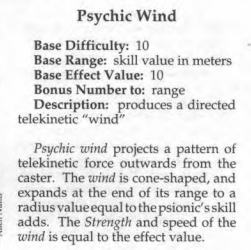
Nope, not going for the easy joke. Just a sample stat block.
So now you've got your spiffy new powers; how do you actually use them?
Hoo boy.
At the start, it's easy; you make a psionic manipulation roll against the difficulty of the power. Simple enough.
Then you compare the final difficulty of the power (after modifiers and such) to your psionic resistance skill level. You then look the difference up on the ol' Torg damage chart to see how much mental damage you take. Mental damage has the same types as physical damage does (shock, K's, O's, and wounds), and all stack with normal damage except maybe for wounds because the book is unclear on this. Mental wounds can only be healed via the psychology skill, which just gives me a mental image of someone in the party holding a therapy session for another in the middle of a session after a combat.
Now all that would be fine, if we didn't have to start worrying about modifiers.
For instance, what if you wanted to use multiple powers in the same round? That's possible, you can always do split actions in Torg. What you do in this case is determine which power will be the "primary" power, then "secondary", and so on. You then use the One-on-Many table (a.k.a., the table you use to determine multitasking penalties for pretty much anything) to get the new difficulty numbers for the powers. The reason you have to determine the "priority" of the powers is because that's the order they'll go off. That's important, because in Torg, when you try to do a multi-action you roll once and apply the bonus to all the actions you're taking. So it's possible to line up three powers to use and only have two of them go off.
You can also increase a power's stats by increasing the difficulty by an equal amount. Note that there's no way to decrease a power's stats to lower the difficulty.
Lastly, you can try to actively resist the strain of using a power rather than just passively using your psionic resistance base skill. Doing so requires a multi-action (so back to the One-on-Many chart), which makes your attempt to use the power itself harder. On the plus side, you'll always generate a bonus of at least +1 on the psionic resistance.
So let's put that all together!
quote:
Example: Karin is playing an Akashan psionic named Torinka, who unwisely parked her flying transport in a swamp. When she got back, it had sunk into the mire. Since Torinka possesses the telekinesis power, she believes that she can lift the vehicle
out of the mud and onto dry land.
Unfortunately, Torinka only has a psi manipulation total of 15 (which means the Base Effect Value of the power is 15), and the weight value of her transport is 24. In order to be able to lift the transport, Torinka needs to add +9 to the Base Effect Value. This will also add +9 to the Base Difficulty (14) and +9 to the corresponding psi strain value. The adjusted difficulty and psi strain of the action is now 23.
But she decides to try anyway. Wisely, Torinka declares a multi-action: she opts to both use her psi manipulation skill to invoke the power, and her psi resistance of 14 to resist the effects of psi strain. While this gives her a small chance of
success, it makes her more able to survive the experience.
Torinka decides that lifting the ship out of the water will be her primary action, while resisting will be secondary. Thus, the adjusted difficulty of invoking the power is now 25, while the Final Difficulty for resisting psi strain is 27.
Karin rolls the die. She gets lucky (again), by rolling a 10. She rolls again and gets an 18. Right now, that's a total of 28 - and a bonus number of +9. With her skill of 14, that gives her a psi manipulation total of 24. That's one point shy of what Torinka needs to accomplish the action. However, her psi resistance total is 23, which is enough to keep her from taking serious harm from the action.
Karin decides that Torinka had better spend a Possibility and, rolling a 12, she increases her bonus to +11. That gives her a total psi manipulation skill roll of 26. This allows her to succeed and it decreases the psi strain she'll take to two result points. Since Torinha currently has no cards that are applicable to her situation, she has to leave it at that.
Of course, she still has to drain all the mud out of the transport; she left the windows down.
In addition to all that crap, we have to worry about maintaining powers. By default, a psionic power lasts for one round (10 seconds) unless the power specifies that the generated bonus applies to the duration (by looking it up on the Value Chart to get a duration, because Torg). Attempting to keep a power going longer than that that requires:
- That the power not have a limited duration specified in the description.
- The psi user declaring their intent to maintain the power before the end of the round.
- There isn't a setback result on the initiative card.
- The psi user isn't attempting to change the power's stats.
Simple!
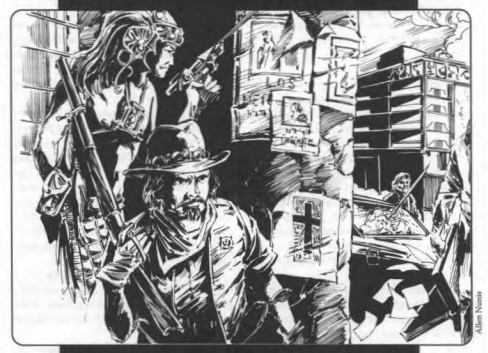
Or you could just use guns.
After about a page of stuff on how to learn psionics if you're from another reality (it involves finding teachers and the right "psychic retreats"), we finally get to the powers. In the interest of not boring people to death, I'll just hit the highlights of each of the power groups.
Kinesis abilities involve moving things around. The old standby telekinesis is in here and is surprisingly simple (the item's mass determines the DC, using it on unwilling subjects is a resisted roll), but you can also create force domes, create tk blasts, do the "create a storm of small objects" trick, all the stuff you'd expect.
The one new idea here is energy conduit, which lets the user take "the thermal or light energy produced by a fire, the fusion or fission energy of an energy weapon, or any number of kinetic energy types that she is aware of, and send it in a specified direction." This is...confusing. I think the idea is that you can take the energy from a weapon and send it elsewhere, like back at the attacker, but the text isn't worded well.
The Psychic Defense group has the defensive and sort-of-healing powers. The basic ones are general defense (self) and general defense (group), which increase the effective defense values of the targets' psychic defenses. There's also psychic aid, which is the equivalent of a first-aid skill, and diagnostic probe, which gives the user a bonus on the psychology skill when treating mental damage. I'd also like to call out telepathic repulsion solely because the name makes me smile. It just makes it harder for people to read your mind, but still.
Psychic Senses powers do what you'd expect. Awareness lets you potentially detect danger by rolling against someone's stealth score, there's various "extend a sense out to a certain range" abilities, and so on. One interesting power is implanted perceptions, which lets you see through an object like it's a 360 degree camera. Of slightly less use is psychic infravision, which lets you see heat/cold sources.
The last general power set is the Telepathy group. Again, these are powers that do what you'd expect: straight mental communication ("mind meld"), sensing emotions, confuse people, and such. You can also pull the Jedi mind trick with perception distraction, which is always fun.
Now we get to the groups that are specific to each of the three religious alignments. There's not many of these, but they start getting more complex.
Aka powers revolve around internalizing power, and using your psi energy to improve your body's abilities. They have access to two powers that boost physical and social abilities (Enhanced Adrenalin and Charisma Control, respectively) as well as other ways of increasing their stats.
They also have the very odd Mind Seal power. This lets the caster seal off part of their Mind stat for a short period of time, rendering the target effectively mindless and can only perform simple actions (i.e. nothing that'd require a roll normally), and even then still have to make rolls. When the power ends, the target "wakes up" and gets a big bonus to resisting or throwing off mind control powers.
Which...okay? That seems useful, but the way it's designed seems incredibly situational.
Coar powers are more aggressive, as befits the "impose your will on others" stance they have. They don't have any real "attack" powers apart from Psychic Assault and Telekinetic Attack, but they still have ways of dicking with people like Ego Strike, which lets you taunt someone psychically, or Project Emotion, which lets them implant emotions in people.
Their biggest trick is Domination, which is the only real direct "mind control" power in the game. Using this power requires that your Mind stat is two points higher than your target's, your Perception is four points higher, and your Spirit is six points higher. Which...is all pretty unlikely, since NPCs in Torg are stated up like PCs and as such would have similar stats. I feel like having only one of those stats be higher would be enough.
Anyway, using Dominate requires a multi-action because you're trying to attack all three of those stats at once. If you succeed, though, you get total control of the target. They will follow your every order, no matter how dangerous, and cannot take any action unless ordered by the person using the power or "misinterpret" an order until the caster drops the power. The caster can even see through the target's perceptions.
I guess the high requirements are because it's so powerful, but still, like Mind Seal it seems to be too much work for what it is. Especially given how stats work; it seems unlikely you'd be able to cast this on anyone who's not a mook-ish NPC.
Finally, we have the Zinatt powers. Oddly, there's no real central theme to these powers, despite the whole idea of Zinatt being balance. There's a power called Living Harmony, but all it does is increase your Toughness for the purposes of resisting rough environments. There's an okay healing power in Accelerate Healing, but at the end of the day it's a stat-swap for the basic medicine skill. There's also clairvoyance and sense past for time wonkery stuff, which are useful. On the flip side are the reality probe and skill search powers, which let you tell if someone is Possibility-rated and what skills someone has ranks in, respectively. Which are useful, I guess, but seem rather outdated now that Torg Eternity has a "full mechanical transparency" thing going on.
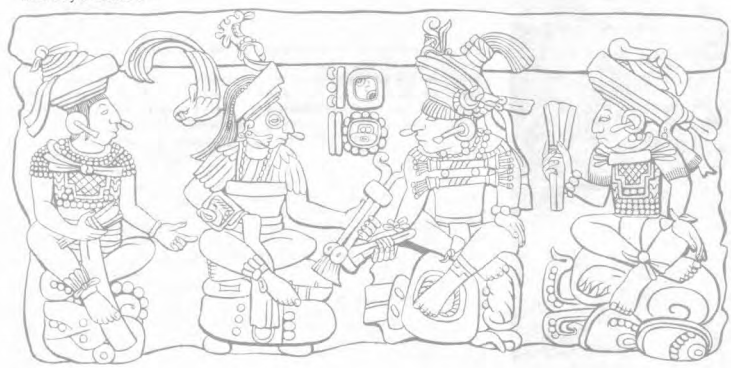
They have these types of illustrations all through the book.
The next chapter is Miracles, and in keeping with Torg's usual stance that belief-based powers are pretty much an afterthought, this chapter is literally four pages long and only has eleven powers. Admittedly, part of this is because of the Law of Acceptance.
quote:
Because of the law of Acceptance, characters have access to miracles from other cosms. As all cosms are part of creation, followers of the paths of Zinatt, Aka,or Coor may use any miracle from any other realm. To accomplish this, the character must have at least one add in faith (Akasha). He must also have seen the miracle performed before attempting to invoke it.
Anyway, since there's only a dozen of these and this is the end of the post, I'll just list them all out.
- Ride Lines lets you turn into pure energy and travel via the Nazca Lines.
- Tongues lets you communicate with anyone regardless of languages.
- Computer Empathy lets you use your faith skill instead of whatever relevant skill you'd use when working a computer.
- Ease Frenzy is only used to calm someone down when they're using the frenzy skill.
- Electro-Dampner instantly shuts down electronics.
- Create Reality Tree is self-explanatory.
- Introspection protects the user from harmful miracles.
- Replay Reality lets you reroll once in the next hour from when the miracle is performed.
- Boost Damage increases unarmed damage.
- Reduce Toughness does what it says on the label.
- Spirit Sword creates a sword of "pure faith" that has a damage rating the same as the caster's Spirit stat.
And there we go.
--
You can tell that by this point, the writers were really struggling to come up mechanical ideas for stuff. The whole alignments thing is interesting, but trying to give it its own subsystem while also trying to integrate it into multiple other subsystems is just...there's a lot of underwhelming powers, let's just put it that way.
Part of that is because they didn't want to make powers "generic", and I get that. But to make powers thematic, you have to do more than just have them. You don't need to integrate them with everything, just have one system that builds off the central ideas and you're good.
But as always, Torg didn't know when to stop.
Thankfully, I do! Right here, with maybe one more post left for Space Gods!
NEXT TIME: Biothings
Biology and related sciences
Original SA post The storm has a name... - Let's Read TORG
Part 22f: Biology and related sciences
Time to get through the final parts of the book, because as always, once we get past the new subsystems there's very little left to really talk about.
The Locations chapter is just a bunch of maps where you can have adventures. Black market warehouse, biotech lab, prison where infected are being held, whatever. The only location really worth mentioning is Machu Pichu, but that's really only because it's the Akashan's main landing site. Even then there's not much here apart from mentioning that there's a cryo facility and big biotech lab.
So moving on! Like any good sourcebook worth its salt, Space Gods has certain things it needs to include to check them off the "Standard Sourcebook Chapters" list. Which is why we have a Creatures chapter, because I guess the aliens and psychics and hive-mind zombie plague just weren't enough for players to deal with.
But wait, I hear you say, isn't this just a bunch of spaceships coming to earth, not a full-blown invasion? This is still just mostly Earth, isn't it? Where'd monsters come from?
The answer is "from bullshit".
quote:
A large number of strange creatures have made their appearance on Earth since the creation of the Akashan realm. Some of these were brought from the Star Sphere by the lightship armada in a form of ark, others are the result of the unleashing of airborne gene spores in the realm by unethical bioengineers, which resulted in mutations of Earth creatures. Finally, there are a few which went into dormancy at the same time as Those Who Wait and were roused when they were awoken.
But instead of, say, making templates that can be applied to existing animals, we get whole new gribblies to deal with. On top of that, why would the Akashans, who are supposed to be very intelligent and are here to ask for our help, bring a bunch of dangerous animals and just dump them on our metaphorical lawn?
Such as the Dinsendas, which are three-meter tall carnivorous lizards that the Akashans brought here from another planet because, when psionically domesticated, they're used for lifting blocks around during temple construction. When not psionically domesticated, they're cunning pack hunters who have a sonic screech attack. The book does state that the Akashans brought them here because they're sure they can control them, but it also states that dinsendas are susceptible to the comaghaz virus.
You know what the nice thing about forklifts is? They don't turn into pack hunters when you turn your back on them. That said, can you imagine what a video like Shake Hands With Danger would be like if these things had to be OSHA approved?
https://www.youtube.com/watch?v=1BxD66YRpVw
The appearance of the Akashan axioms has also had a few mythological critters show up, such as the [url="https://"https://cryptidz.fandom.com/wiki/Iemisch"]"]Iemisch[/url], which is a mythological Incan creature that's basically part cat and part fox. The Incans hunted them to extinction back in the 16th Century, but they've begun popping up again for no given reason.
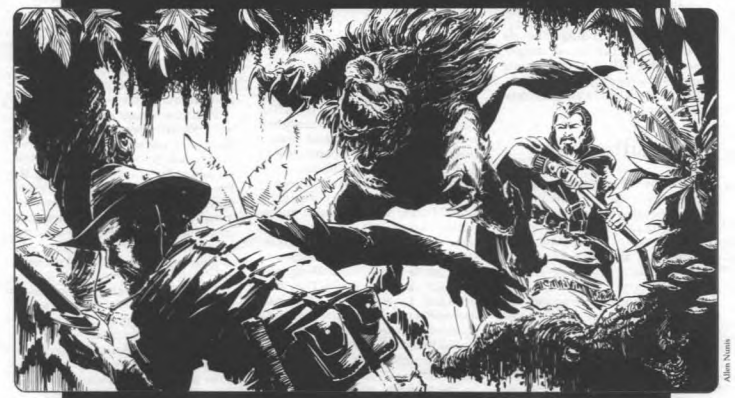
Kitty!
I'm not going to cover all the creatures here, because really there's not that many and they all fall into one fo three categories: "dangerous animal brought by the Akashans because this is what they use instead of work vehicles", "lost cryptid that's reappeared for some reason", and "giant version of normal animal, result of unethical bioengineering". The best example for the last one is the Piranhax, which are AND I QUOTE
quote:
Resulting from one of the more abominable experiments conducted by Akashan bioengineers, piranhax are amphibious cousins of the dreaded piranha fish, with the limited ability to launch themselves from the water and glide a short distance.
Besides, moving past this takes us to the Equipment chapter! Finally we can start learning about what biotech actually does!
quote:
Biotech weds carefully bred living creatures to small amounts of nonliving substance to create a device capable of performing a specific function at the will of the user.
The major appeal of such equipment is that it produces no harmful waste materials during manufacture or while in use. Nor does it require fossil fuels to power it, enabling the Akashans to be virtually self-reliant.
Biotech is still uncommon in the realm, due to the complexity of biotech manufacture. Large-scale production requires a lot of setup and support, and in the short time the Akashans have been here they haven't gotten anything huge up and running. Smaller-scale manufacturing still happens, of course, but Rotan Ulka has forbidden the exporting of biotech to Core Earth until things settle down a bit. Not that this stops the more unscrupulous engineers, of course.
The main thing about biotech is how its powered, and everything falls into one of three categories: living, which requires nutrient packs as battery equivalent; living/inert, which can generate their own food-fuel (basically plants); and symbiotic, which feed off the user. There's no universal mechanic for this, but is dealt with on a case-by-case basis.
Oh, and in case you're wondering, yes biotech have wound tracks, and yes you can disconnect while using this stuff in other realities. When biotech takes one wound, it's -3 to use, and any further damage renders it inoperable until fixed. When biotech disconnects, it takes damage every round until it dies.
With that out of the way, let's gear up.
First off is protective gear.
quote:
Biotech protective suits are generally made from unicellular creatures with microscopic control devices which allow the wearer to regulate their function. They enclose the wearer from head to toe in a thin, transparent membrane. and are almost undetectable by visual means (Perception or find difficulty of 18 to spot on the wearer).
Most biotech suits tend to be symbiotic, drawing nutrients from the waste products of the wearer's body. Barring damage through disconnection, the suit will remain functioning for as long as the wearer is alive. If the wearer dies, the suit will expire one hour later. If the wearer should disconnect, the construct will become inert and cease to be effective until he reconnects.
The user may will the suit to remove itself at any time, at which point the biotech construct will become dormant until it is donned again.
Physical Enhancers are a little more interesting. These are all microorganisms that are injected into the recipient's bloodstream and provide a permanent benefit. On the plus side, having these in your body doesn't cause contradictions so at least you don't have to worry about that, but they'll still die off if you disconnect for too long. There also doesn't seem to be any downside to jamming all these things into your body, which is actually surprising.
Just to give a few highlights of the kinds of things you can jam into your body:
- Amninatral helps your body heal, giving others a +2 to any medical rolls made on you.
- Gutadatl lets you boost your Strength and Dex-based rolls by 2 for an hour, once per day.
- Hatsur gives you infravision.
- Herat is a "millimeter-long centipede which makes its home in the inner ear of larger creatures", and gives you +3 to any roll involving balance, up to and including riding animals.
- Lomos pumps pheromones, giving you a +3 to charm rolls against the opposite sex.
- Psionic Enhancers give you a +1 to your psi skill, but dies after 24 hours.
Game balance!
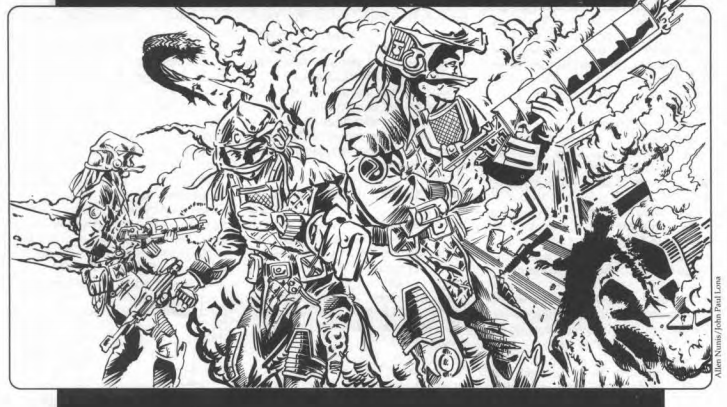
"That's weird, my gun isn't shoving an ovipositor into my arm."
Now we come to weapons, and this is where things get weird.
There's only five melee weapons available, since at the end of the day there's only so many ways you can hit someone with something. The Bhelablade looks like a stone knife, but can extend thorns that are coated in a poison that keeps doing damage if you manage to hit with it. It's also the only one that's not an actual critter you're expected to swing around.
The Calaki, for example, is a snake-like creature that resembles a "chain mace".
quote:
It is serpentine, with a large, angular head and a long, thin body. At its tail end, it is joined to a non-organic hilt from which the user can control its actions.
The Volent is basically a retractable staff. When "dormant" it contracts down to about 25 cm long, but when "activated" it extends out to a full meter. Similarly, the Whipfang works pretty much the same way, but is a whip rather than a staff, and has a two-meter reach.
And lastly, there's the Tentacle Sword.
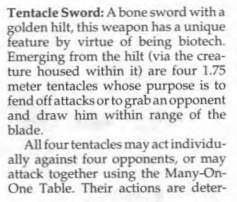
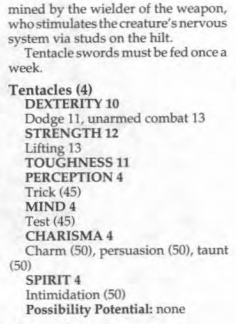
The jokes just write themselves, don't they?
Next up are the missile weapons, and again there's not many options. That said, they're all pretty fucking nasty. The coar spear can adjust its flight in mid-air, the jiros is basically a two-headed-snake/boomerang, the Larendi Bow fires critters that burrow under your skin and eat you from the inside out, the Salend Sling fires little critter that latch on to the target and spew acid, and the Starshredders are thrown items that also burrow into your skin, but instead of eating you they expand inside you.
The Akashans are fucking psychopaths. This shit feels like it should be in Tharkold, not alien-Inca-land.
Now we get to the actual biotech guns. Compared to the stuff we've seen, these are practically benign.
Well, mostly. Some of these are just "gun that fires weird energy" (the Electronus fires electricity, the Gravitic Ray fires pure force, the Mindlance fires psionic energy), but some of the others...
Well, there's the Cell Jammer, which disrupts the cellular structure of the target. Or the Mitositer, that traps the target in a giant porous gelatinous bubble. Or the Shatterer, that actually damages the user as well as the target.
Hmm. Maybe the guns aren't really that much nicer.
The Akashans also have "standard" tech guns, mainly to sell to client races or to impress people who don't know what biotech is. These mostly fall under the "plasma energy weapon" category to varying degrees. The blaster shoots plasma shots, the bolter is the same plus explosion, smash guns are effectively shaped charges, and so on. I'm not going into details here because really there's not much to tell, especially compared to the biotech.
The chapter closes out with some vehicles (two bio-hovercars and a tech dump truck) and adventuring gear. Surprisingly, there's not a lot of non-weapon biotech listed. There's biothings that can act like flashlights, or communication systems (small psionic critters housed in earbuds), translator pods, a biotech repair kit, and a "volent rope" that's based off the weapon and that's it. Normally I'd say this is a problem, but really you're not going to want a ton of stuff on you that you can only use in this realm without causing a contradiction. I don't need a Tech 30 bio-flashlight when I can just use a fucking wooden torch.
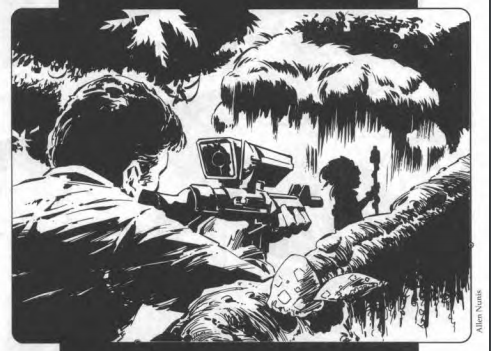
Sometimes lower-tech is better, is what I'm saying.
The final chapter is Character Creation. Akashan characters are built like normal PCs; 66 stat points, 16 skill points, at least one add in reality. They also have to pick an alignment, but don't have to buy the matching faith skill if they don't want to. Akashan characters can start with psionics if they buy the appropriate skills, and as previously stated get one free power group to start with.
Aliens, though...aliens are a different story.
There's no list of alien races for PCs to use outside of the general races displayed earlier in the book, and even then you don't get simple stat adjustments to play them. Instead, the book goes the same route as the way the Aysle book handles non-humans, where you have to buy an "enhancement package" for your stats. This time around, a package gives you four attribute points to put wherever you want. The downside is that there's a cost: you either have to pay out one Possibility each session or set a max of 7 for one of your stats. Problem is, if you disconnect or can't pay the one Possibility (assuming you chose that option), your enhancement bonuses go away, and you have to reconnect both your character and your stat boost.
Note that there's no racial powers or anything. The only thing you get out of playing a non-human is the extra stats.
Lastly, we come to the character archetypes. There's more here than in most of the books, which isn't surprising given how late this came out. There's also characters from other realms to fill in the gaps.
The Archaeologist was just working a normal dig in Peru when the War first started, and happened to be at Machu Pichu when the ships landed. Since then he's been like a kid in a candy store; the Akashans were happy to share their history and knowledge with a fellow scientist, and now he's dedicated to stopping the High Lords from repeating history. His tag skill is science (archaeology), and he starts with a magnifying glass, brush, pipe (with tobacco) and a Glock 17.
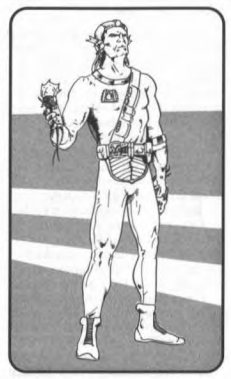
The Akite Engineer spent most of his time in his lab, feeling that exploration only drew everyone's attention away from the internal problems of the Star Sphere's cultures. This dedication to his work made him one of the first to see the spread of the Comaghaz, as well as one of the first to see it wasn't just a normal virus. The Signal Fire was a glimmer of hope, but now he has to deal with the conflict between his aka beliefs and his desire to save Earth's fascinating biodiversity. He starts with gravitic ray, an amninatral implant, and the dumbest quote possible.
quote:
"Oh dear, I'm sorry. I thought you said you wanted designer genes."
The Coar Council Member was born into the aristocracy, and grew up knowing the importance of his lineage. He also felt that the ancient abandonment of Earth was a mistake, and as such was one of the first to volunteer to answer the Signal Fire and "fix" the mistakes of the past. He doesn't see the current situation as a source of political power, but more as a way of proving the superiority of his coar beliefs. That said, he wouldn't be adverse to staying and "helping out" once the War is over. His tag skill is medicine, and he starts play with a protective suit and a handful of enhancers.
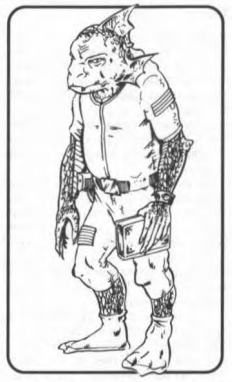
The Draygaak Scholar comes from a world where his people used to be warriors. The key phrase is "used to", as now they've worked hard to suppress their violent natures in pursuit of knowledge. They've been mostly successful; while very advanced, the Draygaak still have the tendency to fly into berserker rages. This is why the scholar hasn't managed to advance too far in his career: he's very bad at holding his temper. He's fascinated by Earth, the other realities, the High Lords, all of it. And hey, if he can use his knowledge to help blow shit up or kill some assholes, all the better. For what it's worth, he does feel guilty when he tears someone in half.

He starts with a few basic items and an attitude problem, and his tag skill is evidence analysis.
The Gaucho lived his life pretty much to himself, even after the invasion started. It wasn't until the Argentinian government started using the arrival of the Akashans as an excuse to push their own agendas. His family was "arrested" and contained a penitentiary due to claims that they'd become Comaghaz victims. It wasn't long before he realized that only the elimination of the virus would save thousands from the same fate as his family. His primary goal is finding where his family is being held and freeing them; everything else is secondary. His tag skill is fire combat and he starts with some general cowboy gear.
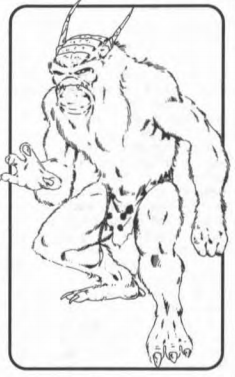
The Gudasko Hunter led a content, simple life on the plains of his home planet until an infected cadre of Monitors came and started killing everyone and burning his village to the ground. The Comaghaz began to spread, but he managed to escape the planet and found a living as a guard for a high-profile Akashan noble. The noble was chosen to aid in the war effort on Earth, but succumbed to the virus. After killing his former master, the hunter now runs with a pack of Storm Knights. His tag skill is tracking and all he needs is a spear.
The Knight Templar is from the Cyberpapacy, and was part of a renegade order that was dedicating to stopping Malraux's long-term plans to take control of Central and South America. The arrival of the Akashans threw a huge monkey wrench into everything, and his comrades were killed in one of the initial Comaghaz attacks. Rather than returning to France, he's stayed in South America to try and help the civilians caught in the middle of the entire mess...and avenge the deaths of his brothers in arms. He starts with a bunch of cyberware, an Armor of God suit, and a power sword. His tag skill is energy weapons.
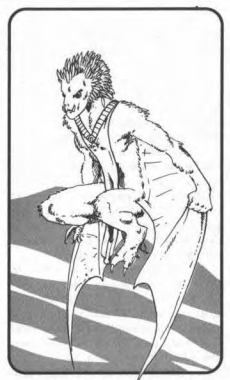
The Larendi Chieftain saw his homeworld fall to the Comaghaz, and it was his responsibility to put down his brethren when they succumbed. What made matters worse was learning that some of his infected peoples managed to smuggle themselves off-world to infect others. He feels responsible for the acts of his infected peoples, even as he knows they're not responsible for their actions. He has joined the War more out of necessity; he sees it as something that pulls him away from his goal of wiping the virus from his species. He starts with some bioweapons, and his tag skill is flight.
The Monitor has been a soldier all his life. He's fought in countless wars against countless foes, but still feels that akite decrees limit his effectiveness. He jumped at the chance to answer the Signal Fire, hoping the conflict would spur the High Council into more definitive action. Unfortunately, it seems that the Council doesn't appreciate the potential threat of the High Lords and are more focused on the virus. In the end, though, what matters is the battle. His tag skill is biotech weapons, and he starts with a bunch of 'em.
The Nippon "Economic Adviser" worked for the South American Development Trust for Kanawa for over a year, despite not having a business degree. That's because the advice he generally gave people was "do what Kanawa wants or I'll shoot you in the head." But loyalty only goes so far, and in his case it stopped when his brother was executed for costing his company several million yen. He's working as a free agent now, but keeps the "adviser" cover since it makes people underestimate him. He starts with some business gear, a bulletproof vest, and a 9mm. His tag skill is fire combat.
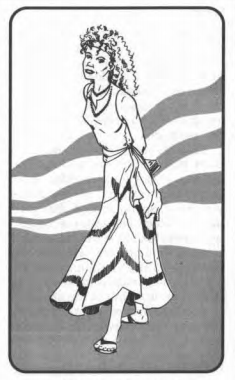
The New Ager has been globe-hopping since the invasion started, seeking the hidden truths she knows to be missing from her world. Time spent in Aysle attempting to learn magic were fruitless, and her studies in Orrorsh were an even bigger mistake. She happened to be in Guatemala when the Akashans landed, and immediately packed up and headed to Peru. Her dedication has finally paid off, and now she's beginning to learn to use her latent psychic powers. She starts with some guide books, a Tarot deck, some crystals, and other New Age bric-a-brak. Her tag skill is scholar (occult lore).
The Smuggler did not have a good life. He ran everything across every border he could find, all in the name of profit. And that was enough until the Possibility Wars started. Then he realized that money doesn't really matter when all of existence is at risk. After all, where would he retire? And so he started running guns and supplies into every realm, ducking the agents of the High Lords at every turn. Now he's in South America fighting alongside what may be the strangest people he's ever run across. He starts with some weapons, a forged passport, and chewing gum. His tag skill is fire combat.
The Priestess of Zinatt is dedicated to the idea of balance and the importance of it in Akashan society. She's spent most of her life working as a mediator, but like many was forced into battle when the Comashaz appeared. In the back of her mind, she wonders if the virus is a punishment from Aperios for the sins of the Akashans' past. Both the virus and the High Lords are agents against balance and the natural order of things, and at the end of the day her job is to protect that balance. Her tag skill is faith, and she starts with plasma armor, a Larendi bow, and a first aid kit.
The Soviet Psychic is a remnant of the Soviet Union's old psychic research project. She was one of the people called to action and helped repel Tharkold's original bridge, but once that was done the government kept her hidden away, not knowing what to do with her. The arrival of the Akashans gave her a goal, and now her task is to evaluate how much of a threat the aliens are to the Motherland. Personally, she's hoping they can increase her powers. Her tag skill is psionic manipulation, but she still needs to buy psionic resistance if she wants to actually use powers.
And with that, we finally reach the end of the book. But now that they're here, what effect do the Akashans have on the Possibility Wars?
The answer is "not a whole hell of a lot." Well, wait, no. The answer is "make everything measurably worse."
Shortly after arriving, the Akashans get into serious conflicts with Nippon Tech and Tharkold. Bioengineers were supplying Storm Knights on the west coast of America with bioweapons to help fight the cyberdemons, and it wasn't long before said demons managed to track the things back to their source. Sarila led the Council in declaring war against Tharkold, which backfired almost immediately when the first conflict was a loss and Sterret got his hands on biotech. As such, he's looking to see if he can combine it with occultech, so good job there.
On top of that, the Gaunt Man gets his hands on a reality tree seed and sets up a mixed zone in North America centered on New Orleans, making Aysle the only reality to never have a foothold in the States.
About the only good thing the Akashans do is start bringing verious edeinos tribes that were against Baruk Kaah into the fold, giving them a new home in Akashan territory as the Living Land slowly dwindles down to nothing.
As for Sarila...well...she's not doing great. Early on she's still convinced herself that she's in control of the virus, but it's not long before she hears a new voice in the hivemind, one that isn't subservient to her will and might pose a threat to her control. While she's still managed to get the virus to a few other realms (notable the Nile Empire and Orrorsh), the spread isn't anywhere near as fast as she'd like.
It would be a year before Sarila loses control of the virus, but it's only for a few moments. Her rival is a Lorbaat named T'ky Z'tkl, who's managed to link to the Comaghaz hive mind despite not being infected with the virus. While Sarila did manage to sieze control back, she doesn't know if T'yk can do it again. For his part, T'yk wants to free his people from the virus (everyone else can go hang, apparently), and to wipe out the Akashans for allowing this damn mess to happen in the first place. This puts Sarila in a pretty bad postion; she doesn't know exactly who is trying to take control away from her (just that it's a Lorbaat), and she doesn't have anyone she can go to for help. She can't even go to the Council to ask for help without blowing her cover.
Oh, and as for Torg Eternity? The Akashans are pretty much wiped out before the game began. It turns out that, in exchange for not being attacked by the Gaunt Man's forces, the elves of Aysle sold out the Akashans. They told the Gaunt Man of the powerful reality-mixing weapons the Star Sphere have access too, and agreed to point the Gaunt Man in the right direction for their own safety.
The Gaunt Man agreed, left the elves to their own devices, and destroyed the Star Sphere and damn near every being in it.
Now the Gaunt Man has twisted reality trees into "Nightmare Trees", which not only create Orrorsh mixed zones, they also allow his forces to teleport between them. The elves are now feeling the weight of their actions, and are trying to fight alongside the other good guys without giving away the fact that they directly made the Gaunt Man stronger. There's been a few hints that there are still some Akashans floating around, but outside of that they're not really a going concern anymore.
--
So there we are. The Space Gods.
This whole thing was almost a good idea. Which is to say, the core idea of "benevolent aliens arrive, need our help with a mind control virus" is great, and is something you could probably hang a game or TV property on. And like I said way back, I love seeing Anti-Life-ish concepts in other media.
But here, in Torg, it's one concept too far. There's already a ton of stuff going on for everyone to deal with, and in the scope of that this just becomes background noise. It doesn't really fit themeatically (like the Land Below), and feels like they just put this in because someone, probably Greg Gorden himself, really liked Incan and Aztec imagery.
What's worse is that they don't do anything. They arrive so late, with so many other damn things going on, they're just...there. Reality trees pop up from time to time in adventures, but in the grand scheme of things they might as well not bothered writing this book.
Ah well. At least we got psionics out of it? That's something, right?
Right?
Regardless, like the Akashans themselves, we're done here.
--
Wait, do you know what this means?
I've finally, after all these years, finished reviewing all the cosm books! That's the last one! Nobody else shows up after this! Holy crap!
On top of that, there's no more metaplot updates after this. No major things I need to cover.
Which all means...there's one book left. The final book. The one that wraps up over five years of books and metaplot.
Get ready.
The end is near.
NEXT TIME: The beginning of the end
War’s End
Original SA post The storm has a name... - Let's Read TORG
Part 23a: War’s End
On April 15, 2013, I did something that was either incredibly dumb or incredibly bold: I started reviewing Torg. It's been a long time, I know. I kept getting burned out. I started over at one point. But I pushed through, reviewing the entire setting, every realm, all the main metaplot beats. And now, six years later, it all comes down to this. Enjoy.
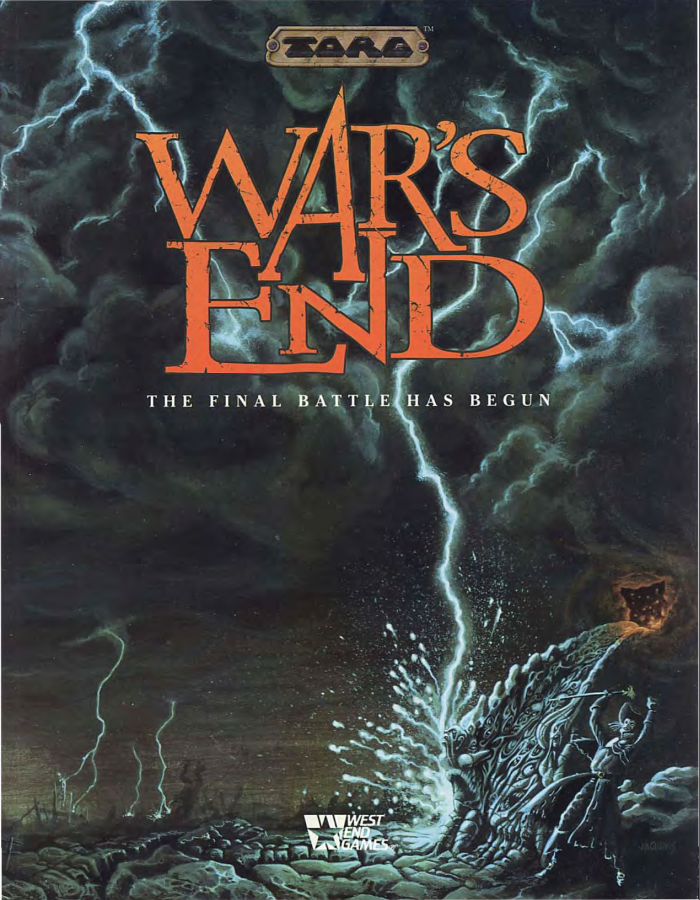
This is it. The end of the road. The culmination of five and a half years of metaplot and over 100 books. The Possibility Wars are finally coming to an end.
But how do you do that? Is it possible to wrap up everything that's happened in Torg in a single 130 page book?
Of course not. But by god John Terra tried.
From what I've heard, the end of Torg as a game line kind of snuck up on West End Games. Things had been chugging along well enough, but the thing about the ol' supplement treadmill is that it's not really sustainable. There was a heavy drop in quality in products, and I'm not just talking about the stuff we've seen in the later realm books. Published adventures were railroads, most of the important information about new content was only in the newsletter (which not everyone subscribed to), and WEG refused to move ideas to the new-fangled Internet thing that was becoming big.
The buy-in was a problem, too, especially when the game had been out for a while. Because the setting information in the core set was so light to practically be non-existent, you pretty much had to buy all the realm books to fill in the gaps. Then these books added more mechanical complexity to the game, not to mention the inevitable power creep and all the metaplot stuff in the newsletter (which you couldn't get back issues of, because it was a newsletter), and so on.
There were other factors, of course, like WEG's cash-sink licensed games and failure to pay their licensing fees to LucasArts for the Star Wars RPG that led to the company's closing in 1998. But at the end of the day, Torg was a well that had run dry for all but the usual group of die-hard fans.
As a result, so the legend goes, long-time Torg writer John Terra was told to write the final Torg adventure, the one that'd be a capstone on everything and wrap up all the loose plot threads that had accumulated over the years.
Back when I reviewed Deadlands: Hell on Earth: The Unity, I stated that Unity was a terrible adventure because of the metaplot, whereas War's End was bad despite. Will I be eating my words? Will this adventure be worth it? Will I actually finish reviewing Torg? Only one way to find out!
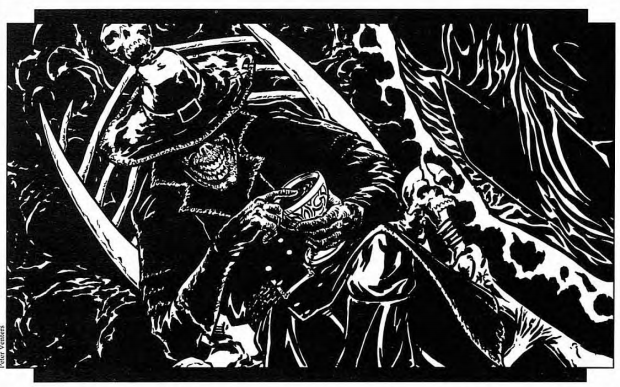
War's End opens with a page of fiction focused on the Gaunt Man and Heketon, his Darkness Device. The gist of it is that the Gaunt Man has finally had enough of this horseshit and has decided to end the War and make the final push to become the Torg.
For those who don't remember (which is probably all of you), in order to become the multiversal god known as the Torg, you need both a fuckton of Possibility energy (the "spiritual" factor) and a ton of kinetic energy (the "psychical" factor). In order to get the Possibility energy, he plans to use a ritual that will summon all the other Darkness Devices to merge with Heketon and siphon off the P-energy collected by all the other High Lords. He can do this because he knows that the Devices are all fragments of the dark god known as the Nameless One, so he can ritual something up to pull them out from under the other Raiders. As for getting the physical energy...well, we'll get to that.
So that's the set-up. The players won't know this, of course. They're busy being in the Nile Empire to begin with.
Act One: In A State Of De-Nile
Have I mentioned that Torg loved shitty pun titles in adventures? Because Torg loved shitty pun titles in adventures.
Case in point, this is the opening box text for the first scene, "A 'Prophetable' Venture":
quote:
Your adventures of late have deposited you in the city of Cairo, an ancient city filled with modern intrigue. Your band is in the marketplace, where the shouts of the merchants hawking merchandise mingle with the sounds of livestock, and the air is filled with the scents of spices and produce. It is three in the afternoon. Something is odd in Cairo these days; there's an undercurrent of tension as if a storm were about to break. Still, your contacts have no concrete information for you - it's just a feeling they have.
One tent does catch your eyes, though. A gypsy sits before the flap of this multi-colored silken shelter, doing his best to convince passers-by to enter. "Fortunes told!" he shouts. "In these uncertain times, you need to know what tomorrow will bring!" He beckons you to enter.
It turns out that a lot of psychics, seers, and assorted fortune tellers have been disappearing lately, and Karlo's mother Agatha and one of his clan mates Valara (both of whom could sense the future) have vanished. He wants the PCs to figure out where they went. He does have two leads (his mother vanished when visiting a silversmith, and his friend was at a club on the waterfront), and can pay.
Assuming the players agree, they can check out one of the two leads. But what if they don't?
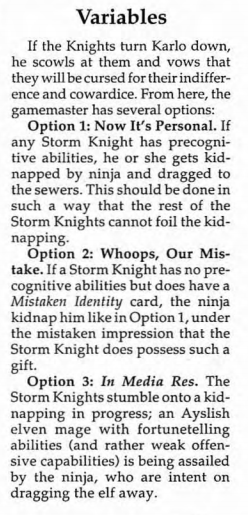
Yeah, it's one of those adventures. At least the players have an actual choice on which lead to investigate first!
If they decide to check the docks, they can find a little place called "The Cairene Cafe". They also get jumped by some street toughs for no other reason than to have a fight scene here. If the PCs interrogate them after beating them up, they can learn that Valara did indeed come to this cafe often to dance and roll idiots, and possibly getting the name "Gat 'The Grabber' Grabowski", a guy who specializes in kidnapping.
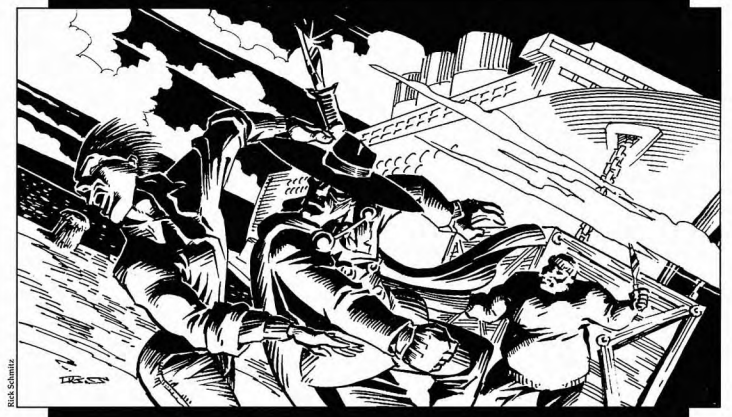
Asking locals some questions, Nile Empire style.
The Cafe itself is basically a shack with a back room designed solely for criminal enterprises. The bartender will remember that there was a Japanese guy who was "keen on having his fortune told" here the other night, but he bolted just before Valara showed up. Note, however, that the PCs have to make a roll for him to remember this.
Checking the alley behind the cafe (and making perception and find rolls to look for clues) will turn up a torn strip of black silk, a small bangle, and part of a charm bracelet. What happened is that Valara was grabbed by ninjas (oy), but the PCs won't have any way of knowing that. So now they either have to check their other lead or go talk to Grabowski.
Oh, and at the docks there's also a ship called the Aix La Chapelle. This is a red herring; there's nothing on board except 20 P-rated Cyberpapal Church Police and 24 generic Veteran Shock Troops with nothing better to do than wait for the PCs to investigate the ship, because I guess it's funny to waste everyone's time with a long, pointless combat.
Speaking of which, there's something I'd like to remind everyone: Torg does not have mook rules. All 44 of these enemies have full stat blocks and the same three damage tracks (wounds, shock, and K/O status) as PCs. Also, half of them are P-rated so they take less damage and can boost their own rolls. Just something to bear in mind when I point out some of the upcoming combats.
If the PCs chose to go track down Agatha first, they find that the silversmith's store is closed for the day. An old drunk hanging out outside the building didn't see Agatha, but he did find a silver comb she dropped when she was grabbed. Searching the area (again, requiring rolls) will lead to a storm drain with signs of a struggle around it.
Whatever the PCs try to do, they're interrupted by a "warning shot" from an Akashan Monitor squad. They've been dispatched to the area because one of the Akashan's best seers, Lotar Grell, was last seen in this area but is now missing. Assuming the PCs don't return fire (yeah, right), the squad leader apologizes. They're seeking Lotar because the High Council has decided to leave Earth in about a week. Turns out that the Council has determined that sticking around has done more harm than good, what with the Comaghaz virus and spread of bioweapons and the Gaunt Man getting reality trees and all. The squad's leader will ask the PCs if they have any information, and also ask them to pass word along to Lotar if they find him. With that, they go on their own way leaving the PCs free to enter the sewer system.
We'll get to the Akashans leaving in a bit. It's part of another thing that is woven into the book.
The last option to this point was to find and talk to Grabowski. He's a mafioso who hangs out at a speakeasy in one of the many bad parts of Cairo. Getting past the doorman (an Ayslish troll) requires the password "Ali sent me". Using the password gets you in the door, forcing your way in results in a fight against the troll and about 20 gangsters.
Once inside, actually getting to talk to Grabowski involves setting things up through the twin bartenders, Butch and Bozo Smash, a.k.a. the Smash Brothers.
Before you groan, this was four years before Super Smash Bros. first came out. Just sayin'.
Anyway, if the PCs manage to get a meeting with Grabowski, it turns out he doesn't know anything about the kidnappings. Or, at least, these specific kidnappings; he's got eleven people being held prisoner in a secret room off his office. The only information he can give is that he knows someone's muscling in on his racket, and that these don't feel like "normal" kidnappings.
So that's a dead end. If the PCs notice the secret door and free the kidnap victims, they can get a nice cash reward, but that's about it.
Ultimately the PCs are supposed to go down the storm drain outside the silversmith's office. In keeping with 90's RPG design, it's entirely possible for the PCs to fail every check that would point them in this direction.
Once in the sewers, the party has to overcome a bunch of obstacles to get to where they're going. These include whirlpools, a rat swarm (200 rats, insert 5e playtest joke here), mummified crocodiles, and giant mutated spiders. The final "obstacle" is a giant wave of water out of nowhere.
It's impossible to avoid being swept away (gee, that sounds familiar), and everyone has to make a roll to avoid drowning. Assuming someone lives, they encounter some boxed text.
quote:
You stagger, wet and winded, into a large vault, clearly not part of the Cairo sewer system. Gasping for air, your eyes adjust to the lighting, and a shiver of dread runs through you as you hear dozens of swords unsheathing. You look up and see dozens of figures dressed in black, all with katanas.
Standing behind them, a smug smile on his face, is none other than Cairo Overgovernor Wu Han. The mastermind shakes his head at you. "Unless you Stormers have somehow gained precognitive powers, the Pharaoh has no need for you at his grand palace in Thebes. He would tell you that himself, but he is currently holding court there, seeking the counsel of his unwilling guests. As for you ... it seems somehow fitting you should perish in a sewer, amid the rest of the city's filth." He turns his attention to his ebon-clad army and says simply, "Kill them."
This is just a fight scene where Wu Han monologues the next clue at the PCs, as keeping with pulp tradition. Wu Han won't join the fight unless forced, and will bolt out an escape hatch as soon as it looks like his guys are losing. The PCs can follow him, but he triggers a silent alarm before going out a trapdoor that leads to the street above. The PCs have a few moments to search his office (they can find notes about the seers being taken to Mobius' palace, how one Cyberpapal witch escaped Mobius and went to Boston, and how security at the Palace is being lessened to allow petitioners to see the pharaoh) before 40 Veteran Nile Shock Troops show up.
At this point, the adventure assumes that the PCs are going to head to Thebes to save all the kidnap victims from Mobius' evil clutches. So how are the Storm Knights supposed to get there?
Yeah, about that.
The next scene takes place on a train to Thebes. But what if the PCs have their own transport?
quote:
There is also the possibility that the Storm Knights have their own air transportation. If they choose to use it, they will find another two dozen shocktroopers at the airport, forbidding all private planes/gyros/whatever from taking off. If they do get airborne, throw as many Paket fighters at them as needed to bring them down. And where do they crash? Why, right near the tracks of the Cairo-Thebes Express, and the train is coming! A good time to jump on, no?
Anyway, the train will always be just leaving however the group gets there, requiring a roll to jump on. What happens if you fail that roll? Good question!
There are Nile troopers on the train, of course, asking to see everyone's papers. People without papers (or who are packing weapons) are arrested and imprisoned in the troop's trai ncar.
The real reason the PCs get funneled here is so they can fight one of the Gaunt Man's agents: a shape-shifting manticore from Aysle who transformed to Orrorsh. He's on the train under the alias "Mr. Manuel T. Koar", and will attack anyone who does anything Storm Knight-ish.
That's it. That's the whole scene.
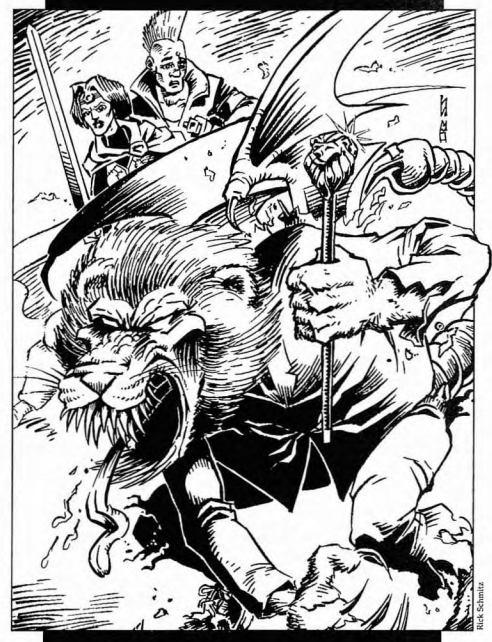
"No ticket."
The next scene takes place outside Mobius' palace in Thebes. There's the aforementioned petitioners lined up outside, but the bigger attention getter is that the artificial sun/death ray on top of the palace is missing.
The whole point of this scene is to get into the palace. This is the seat of Mobius' power, and as such is crawling with troops, gospog, and God knows how many deathtraps. Hopefully the players realize that fighting their way in is suicide, and either sneak in or disguise themselves as petitioners and bluff their way in.
However they get in, the final scene of this act starts in the palace's courtyard and we get our first real gaint block of boxed text.
quote:
In the courtyard of Mobius' palace is a sight to take your breath away. The circular yard is roughly 30 meters in diameter, with its floor composed of millions of tiny mosaic tiles which make a beautiful rendition of the Zodiac. At the far northern end, a tall, thin, cowled figure sits on a throne. Behind him rests a small bunker, and beside him an idol of a man with the head of a crocodile, made of black obsidian. But even this is not the most arresting sight: Mobius' grand palace is on fire!
quote:
The cowled figure's right hand absently pets the black idol, which pulses with blue and red light. Then he looks up at you and speaks:
"Greetings, Stormers! So glad you could join me for this momentous occasion. No doubt you are here for the missing prophets and sages. Ah, me ... well, they are here somewhere. But they may well die of Cancer before you find them.
"You are most likely wondering why I, the mightiest intellect in this cosm, should undertake to abduct fortunetellers and their ilk. It's quite simple: the mark of true genius is knowing what you do not know. I knew something was amiss in this cosm - very amiss - but I did not know what. I brought the seers here to determine for me what is going to happen, and praise be to Sebek, the poor fools did. And do you know what? It's going to happen in three ... two ... one!"
Before your startled eyes, the Kefertiri Idol begins to shimmer, to fade, and then ... it is gone. Mobius sighs and continues: "It's such a burden being right all the time. Farewell, Kefertiri, you fickle piece of stone. It's over, you know. He's won. The Gaunt Man, that is. He's a genius - almost as brilliant as myself!
"Of course, I don't know the whole story. The last piece of the puzzle was that D'Aramis woman, and she vanished into Malraux's Boston before my bumbling henchmen could grab her.
"Still, I digress. I have enjoyed matching wits with you, Stormers, even if yours are pitiful compared to mine. What makes this truly tragic is that I was winning, you know. I was winning! I would have conquered this miserable cosm, made its inhabitants bow before me, and you, you would have been the lowliest slaves of all!!!"
Mobius pauses, as if trying to regain control of himself. When he has sufficiently recovered, he says simply, "Where was I? Oh, yes, now I remember - so long, suckers!"
At this point the fire (which was set by Mobius himself) is spreading to the courtyard. The palace itself has already been stripped of anything of value, and all Mobius' best toys were sent back to Terra (he's insane, not stupid). The PCs now have 15 rounds to find the missing seers, defeat the gospog guards that are now converging on them, and get the hell out of the palace before the whole place explodes.
As stated, there are twelve large tiles laid out with Zodiac symbols around the courtyard. All the seers mentioned so far. plus a few nameless extras, are under the symbol for Cancer as you could deduce from Mobius' obvious clue (to be fair, that does fit his whole "cursed to never know victory" deal). The PCs can try to bust through the steel plate to chase him, but given that it's a foot of solid steel and the fact that Mobius has a head start, it's not really a good idea.
After eight rounds, an escape rocket with Mobius' symbol on it will launch from a hidden bunker, but will explode in mid-air two rounds later. Searching the wreckage will reveal a corpse, but since nobody's ever seen Mobius without his hood, it's impossible to know if it's really him or not. It's not. He had a slave with his approximate build strapped into the rocket so he could fake his death and take a one-shot portal back to Terra.
This ends Act One. The seers explain that they foresaw an "evil man with the power of a god" tearing apart the Earth, and a woman who could stop him being burned at the stake. The PCs get rewarded for saving Karlo's family, Lotar will teach people psionics if they're able to learn them (and chooses to stay behind on Earth rather than go back to the Star Sphere), and now the group knows they need to head to Boston, Massachusetts for the next act.
But before that happens, there's a flash of light, and the PCs find themselves in a courtyard of a German hospital, where three of Terra's famous Mystery Men are talking to Dr. Alexus Frest, Mobius' archenemy.
See, there's a lot of important stuff happening in this adventure outside of the players' stuff. All the High Lords are having their personal stories wrapped up, and the way this is handled in-game is by having some Mysterious Force teleport the group to witness these scenes. Note I said "witness"; they only get to join in on maybe two of these. What these are for is for the GM to read pages of boxed text cutscenes at the players.
Case in point: this scene between Dr. Frest and the Mystery Men is basically getting people caught up with what happened with this NPC, and all of them finally managing to get back to Terra.
Just imagine sitting at the game table and hearing the GM read this to you.
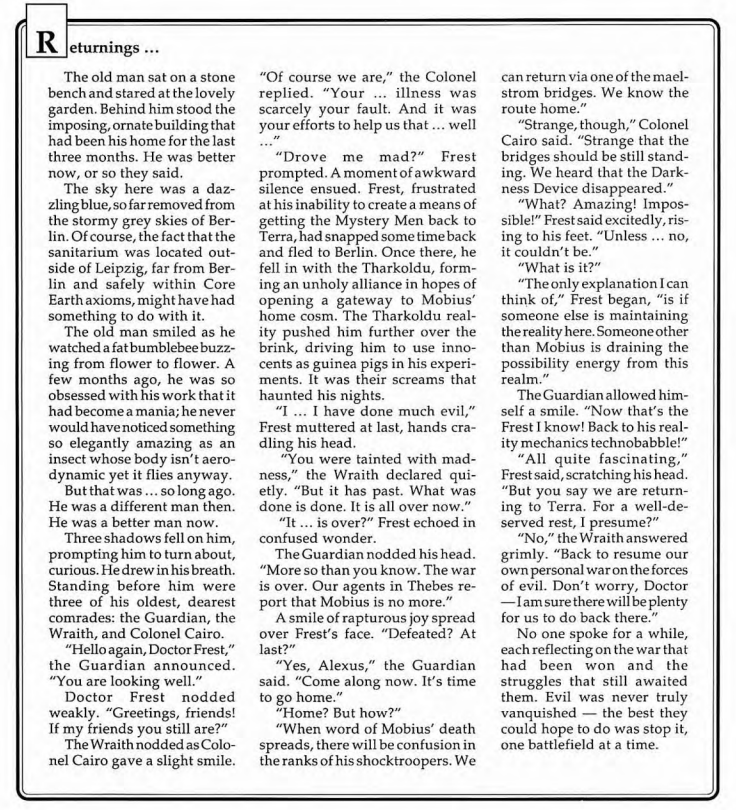
When the scene ends, the PCs are returned to the outskirts of the palace in another flash of light. And while they don't witness it, they have this scene implanted in their minds.
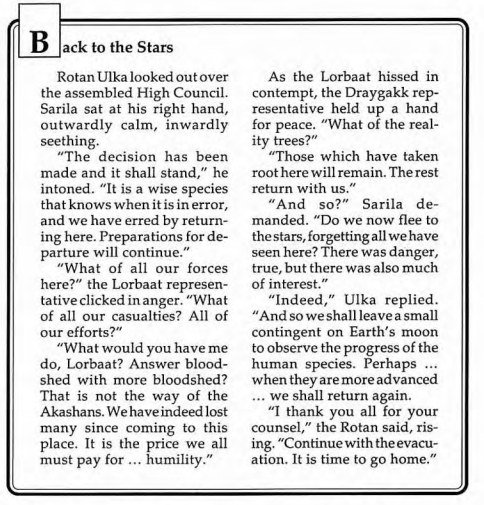
SARILA DIED ON THE WAY TO HER HOME PLANET
Yup, the Akashans just leave. After having nothing to do with anything, after making everything worse, they just go without even an "our bad."
Now the first Act ends. Wasn't that exciting?
--
Three acts remain.
NEXT TIME: My only friend, The End.
The Final Countdown
Original SA post The storm has a name... - Let's Read TORG
Part 23b: The Final Countdown
Act Two takes place stateside, starting in Boston, Massachusetts which at this point is part of the Cyberpapacy. Technically the Church doesn't run the city yet, but is slowly working its way into people's minds as Malraux trys out this cool new idea her heard of called "subtlety".
All the PCs have to go on at the start is a name (Roxanne D'Aramis). The Act starts with the PCs touching down at Logan Airport, and can branch depending on how they decide to get information. Which is to say, there's four options presented to them: getting access to Cyberpapal records, hitting up a cyberpunk nightclub, or just wandering around Boston Commons and waiting for a plot point to find them. The book sort of presents the church as the default start, so we'll begin there.
Getting access to Cyberpapal records requires breaking into the main Cyberpapal stronghold in the city: The First Church of Christ, Scientist. This landmark has been taken over by the Cyberpapacy and made into a staging area/GodNet hub.
This scene is treated as a pretty standard cyberpunk-esque B&E. The place is manned by 20 cyberpriests, 24 Church Police, four cybergargoyles, and is run by Archbishop Daniel Mouton. Hacking into the GodNet here reveals a bunch of stuff:
- Roxanne was arrested four days ago by the Church Police shortly after arriving in Boston and shipped to Salem.
- The Archbishop has been reading up on the Salem Witch Trials and thinks they'd be a useful tool in manipulating the area.
- There's been a lot of fighting against Church forces in the Boston Commons and Kenmore Square areas.
- The Kanawa Corporation has managed to get a foothold here by opening a Bank of Japan branch in the city.
The nightclub lead brings the PCs to Kenmore Square and a cyberdive called "The Rat".
quote:
Situated within walking distance to Boston University and Fenway Park, Kenmore Square is a loud, crowded place these days, humming with a diverse nightlife of students, sports fans, cyberpunkers, and runaways. Always a busy place even before the war, it has been transformed into a leaner, meaner, and more exciting place than ever.
When the group arrives, they happen to coincide with a Church Police streetsweeper team chasing down a young woman accused of being a witch. Defeating the squad gets the woman's gratitude, but that's about it.
The club itself is a stereotypical idea of a cyberpunk nightclub: lots of chrome, lots of moshing, and a solid wall of noise. There's also two Kanawa ninjas stationed here in secret because the bar's owner is suspected of moving black market merch. They'll get photos of anyone who looks like a Storm Knight, and with a high enough roll the PCs can notice and trail them back to the Bank of Japan building.
There's really not much to do here except dig for rumors (most of which are pointless to the adventure), possibly get into a bar fight, maybe see the ninjas, and spend time in the mosh pit (taking damage roughly equivalent to a pistol for each moshing "attempt", which takes 10 minutes), because as we all know that's how moshing works.
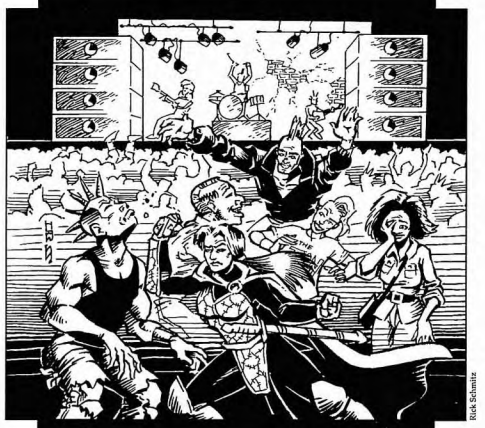
Hey, ho, let's go!
The final initial lead brings the PCs to Boston Common, where they do indeed run into a plot device.
Word about what happened in Thebes has gotten around the High Lords, and Jezrael wants to get her hands on Roxanne to give her the upper hand in whatever's coming up next. She's sent our old buddy Thratchen and a dozen Tharkoldu to the city to hunt her down.
While wandering around the Commons, the PCs are required to make spot checks to see if they hear the sounds of a struggle, then make another roll to follow the source of the sounds. Hopefully they do, because otherwise the scene ends and nothing happens.
Following the noises will lead to Thratchen, who is getting information the only way he knows how: by attacking people. He's currently "questioning" two teenagers a third bleeds out on the ground. He's accompanied by a dozen cyberdemons.
quote:
"Ahhh, Stormers! I would know that stench anywhere! You are like insects,so easily exterminated, yet still found wherever one looks! Come then! Face he who was regent of Orrorsh, and is now the favored one of Jezrael! My wing here craves blood, and you'll do quite nicely."
The wounded kid can be saved with a first aid roll, but the teens don't know who Roxanne is. However, making a streetwise roll and talking to the various street people around will let the PCs know that Roxanne was here, but got picked up by the Church Police and shipped to Salem.
The last lead is the Kanawa one, and this is a little trickier. After the fall of New York and Philadelphia, the stock exchange was forced to move to Boston to keep the global economy moving. Now Boston is part of the Cyberpapacy and Kanawa is starting to move in, so the financial district is heavily patrolled by the state police force, the Church Police, and MarSec.
Getting a meeting with the bank president Mr. Takashima is pretty much impossible, so the PCs will have to break in to a second-story office in a skyscraper owned by the Kanawa corporation. This means the place is defended by twenty heavily armed-and-armored MarSec agents, a dozen corporate ninjas, and whatever Boston Police show up when the alarms go off.
Hacking into the computers here will give the group a lot of information, none of which is useful to the mission at hand, as well as the following memo if they roll high enough:
quote:
"It is with regret that Kanawa Corporation announces that the world known as Earth is no longer a valid site for continued business and trade. For a number of reasons, it has been decided that nothing less than a full withdrawal and re-consolidation back in Marketplace is necessary to ensure our continued prosperity.
"All holdings on Earth that have not been liquidated by the end of fiscal '95 shall be turned over to a handpicked consortium of executives, who shall run the businesses in our absence, in essence, leasing them from our megacorporation. This is done with the understanding that if we ever deign to return, all resources and assets revert back to us.
"This venture has been a beneficial one, in which many lessons were learned and many profits made. Our wisdom has increased greatly as a result. In fact, it is that wisdom which tells us that the time to leave is now.
"We wish to express our gratitude for your loyalty and service to Kanawa Corporation."
- Ryuchi Kanawa, CEO
Kanawa Corp
So after all that, only two of the four leads actually had anything useful. Good job, guys.
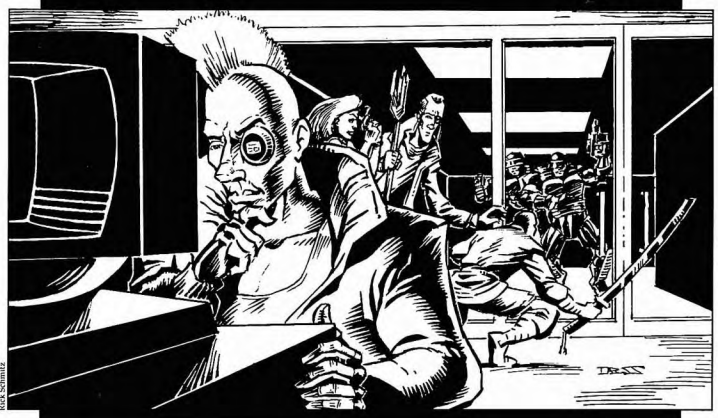
"Did you find anything yet?" "Yeah, Becky from Accounting is having an affair with Jeff from Sales."
Anyway, the PCs get on the road to Salem. This is where Scene Five happens: an encounter with a Nineties RPG Badass Serial Killer.
This NRBSK goes by the name Randolph Chapman. He used to be an operative for the U.S. government until the Gaunt Man got into his dreams; now he believes that the nightmares will stop if he hunts down and kills a specific Storm Knight. He doesn't know which Storm Knight that actually is, so he's just killing all of them.
Chapman has set up a trap alongside the highway; a van clearly forced off the road with blood on the doors. Chapman ran the van off the road, killed everyone inside, and is now laying in wait for whatever good Samaritans end up stopping to help. Normally this would be an easy fight, but Chapman got his hands on an eternity shard weapon: The Sword of Vlad the Impailer. The Sword is particularly vicious, effectively doubling his normal melee damage (in his hands, it does as much damage as a grenade), and allows him to detect P-rated individuals.
Chapman will try to fight until he gets a kill, but if that doesn't seem likely he'll fight until he manages to wound someone. When he does, he jumps on his motorcycle and takes off, content. The PCs can chase him down if they want, but really this is like the train fight in the last chapter: just there to be there. Although the Sword is a nice prize if the PCs can get it.
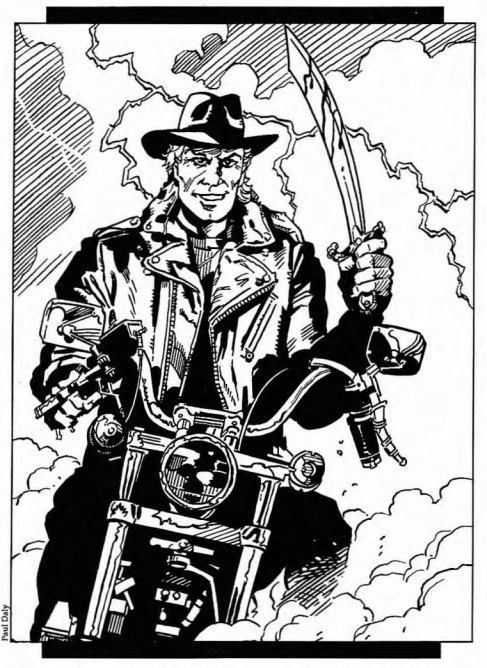
When you were arguing about RPGs online...
So anyway, the PCs finally get to Salem. At least, they get to the outskirts of Salem. The roads are blocked off by the cops and by a huge crowd of citizens. The reason there's a crowd is because everyone's het up for a witch burning.
Cyberpapal agents have been working the area for a few months now, spreading the word of God and in particular how that word relates to the burning of witches. "Witches", in this context, meaning "anyone who looks weird." Unfortunately for the PCs, this probably also includes the Storm Knights. The cops order the Knights out of their vehicle and into the main square, where the Inquisitor will sort things out "after the hanging."
The main square is surrounded by enraged citizens, all of whom boo and spit at the Knights as they're escorted through. A bonfire is going, full of books, CDs, video games, movie posters, and Bibles.
quote:
A huge platform and scaffold has been erected. Surrounding the area are a score of black uniformed Church Police, supplemented by a half dozen cybernetically enhanced warriors wearing white surcoats with red crosses over their black armor. These sit high on cybernetically enhanced steeds.
Atop the platform stand eight men in white robes and skullcaps, listening to a man in red robes screaming, "The time has come to purge ourselves of the influence of witchcraft and false religions! As we are burning the mind- and soul-poisoning materials found in our homes, we shall also remove from our midst those whose minds and souls are so poisoned with deceit that they are a threat to us all!"
The crowd cheers, punctuated with exclamations such as "Burn the witch!" and "Save us!" as the man with red robes raises a hand for silence. "Brothers and sisters, I present to you, the condemned! May the Lord have mercy on their souls!"
You see a line of people at the scaffold, each with a rope around their neck. You can quite clearly make out clergymen of various faiths, three young women, a young man, a male dwarf, and a Mystery Man. One Church Policeman, close to the gallows, holds a strange red helmet in his hands, evidently taken from this Nile hero.
The red-robed figure gestures up in the sky, and everyone sees a robed skeleton with oily black wings and a scythe. Some people scream in terror. "Behold!" the robed man shrieks, clearly building the tension up to a fever pitch. "Behold, the Angel of Death, Uriel, awaits the souls of the condemned! Let the executions commence!" The crowd roars its approval.
The PCs can try to persuade the crowd; this is rough but doable, especially if they have the evidence from the Cyberpapal system before. Succeeding will get the crowd on their side, but the Cyberpapal forces will attack once they realize the crowd has turned against them. If they fail, or just attack, the crowd (over 100 civilians) will attempt to overwhelm them with the aid of the Church Police.
The Cyberpapal forces consist of the cardinal, 20 Church Police, six Hospitallers each mounted on a cyber-enhanced horse, eight Inquisitors, and the Angel of Death, which is a fifth-planting gospog and very bad news. On top of this are over 100 civilians, who'll either be panicking or attacking in a frenzy.
if the Storm Knights can get to the gallows and free the prisoners, Roxanne can help in the fight with magic, and the Mystery Man (a guy with flight named "Destructo Don", who apparently appeared in the novels) will help out as well. Two of the other prisoners have slight magic power, but not enough to help in a fight.
Once the dust settles, Roxanne can tell the PCs about two visions she's had: "two women, one who feeds on blood and one who lurks in webs, battle to the death in a city that is somehow both American and French" and "a one-eyed ruler, or monarch, seeking refuge in that same city." These are supposed to point the PCs to New Orleans, where the Gaunt Man has set up a reality tree and turned the place into a mixed Core Earth/Orrorsh zone.
But before the PCs can leave, there's another flash of light, and it's time to see what happens in Aysle and the Cyberpapacy.
The Aylse part is very infuriating, because it's two and a half pages of Tolwyn of House Tankred fighting the Warrior of the Dark. What makes this especially infuriating is that it's all written in that insanely wooden Ye Olde Fantasye Prose that makes me want to hit somebody.
quote:
Having beaten back the Warrior's first assault, the Army of the Light now launched a counteroffensive. At their head stood Tolwyn, slashing through the ranks of the Dark army, leaving a trail of corpses in her wake.
"It ends now."
Tolwyn halted at the sound of the chillingly familiar voice. Before her were the tents of the Army of Darkness' commanders, and standing alone, the black crown Drakacanus on her head, was the Warrior of the Dark herself. The two women confronted each other for the first time, even as the fighting raged around them.
"You were a fool, Tolwyn, to emerge from behind your walls," theWarriorsaid coldly. "You would have been well served to remain
beyond the bridge and let this world fall to me."
"Nay, villainess," Tolwyn snarled. "I tire of this madness. The war has been won on the world of Asyle; now it shall be won here."
The Warrior of the Dark threw back her head and laughed, the great helm hiding her features. "Fool! It will end, but only with
your death. We meet now, blade to blade, and I have the added advantage of Draka-"
At that moment, the Darkness Device vanished. All around, the fighting began to cease, as the soldiers noticed the impossible: the Warrior of the Dark was Tolwyn of Tancred ... or so it seemed.
"This is the second time I have faced my reflection in a dark and twisted mirror," Tolwyn said. "Are you, then, another Horror of Orrorsh?"
"No, sister," the Warrior responded, with a malicious grin. "I am you- the darkness within you, plucked from your soul during your sojourn in limbo. I am all that you could have been, if you did not wear the chains of Light."
"I wear no chains, thing of evil!" Tolwyn shouted. "And if you are my darkness, then I shall make an end to you, here and now!"
This leads to what may be the most 90's-est metaplot-est RPG-est sentence ever:

I mean, just look at that. Marvel at it.
Sorry, as I was saying, when the fight with the dragon ends Tolwyn manages to defeat the Warrior, at which point the most insanely cliche thing possible happens.
quote:
"Mercy!" the Warrior cried out. "I appeal to you, in the name of Dunad, to spare me!"
A loud cry went up from the assembled armies, as a horde of barbarians charged at the Army of Darkness. Tolwyn smiled and turned back to the bleeding High Lord. She took a deep breath and said quietly, "Go ... go and take your life with you. Your power is broken, monster. In Dunad's name, I spare you."
Tolwyn turned her back on the defeated Warrior, contemptuously. She raised her sword in victory before her mighty army.
quote:
With surprising speed, the Warrior reached her feet even as a dagger slid from a sheath on her wrist. She raised it high and charged, its point headed for Tolwyn's back. But for some reason that may never be known ... perhaps because, in some way, the two were truly one ... Tolwyn turned in time to see the murderous attack. She wheeled and brought her sword down, severing the hand of the High Lord and sending the dagger spinning into the grass.
Anyway, the Warrior dies while claiming it will return, Tolwyn wins and everyone cheers and she declares a new era for Aysle and Earth and everybody loves her and God I fucking hate this character.
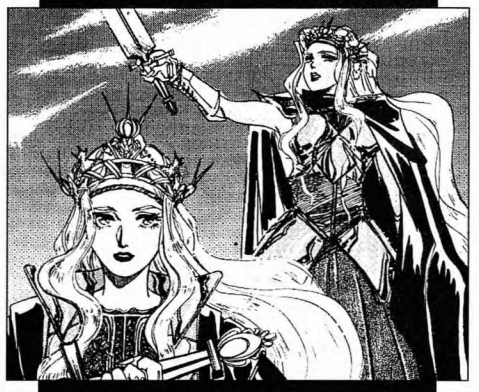
I guess she's also an anime now?
The PCs blip back to Salem, with the knowledge of events in the Cyberpapacy which is another two-page boxed text.
Malraux has hit a new high in paranoia, and is convinced that everyone is working against him. Seeking guidance, he prays before his Darkness Device, the black cross Ebenuscrux, in an attempt to tap into it and reinforce his control. Too bad that was the exact moment it was summoned back by the Gaunt Man.
In a panic, Malraux calls on the power of God to come to his aid. And shockingly, it does.
Which is to say, not the false God created by Ebenuscrux. The actual godhead of Core Earth, the Trinity, flows into him. And it is not happy.
The divine power strips away all his delusions, showing him the dark truths of his actions, and how he was manipulated by his Darkness Device. It takes over his body, and forces him out to the balcony where he was to perform his annual sermons about the power of the Cyberchurch and the omnipresent threat of the AntiChrist. And in front of the papal crowd, his image being broadcast across his entire realm, the power speaks through him.
[quote]
"It's a lie!" Malraux said in a ragged shout. "It's all a lie! We have been deceived by Satan, the Devil in a form of a black cross! Yahweh is the one true God! Jesus is His Son! Muhammad is Allah's Prophet! Cybernetics ... cybernetics are an abomination."
A collective gasp erupted from the crowd. The faces of the assembled CyberChurch clergy went white with shock, then red with
fury.
But Malraux was helpless in the grip of a will far more powerful than his own. "We ... are all heretics! We have blasphemed against the Lord! And we must pay!"
[quote]
The assembled Clergy manage to cut the broadcast and tackle Malraux, but it's too little too late. Without the power of the Darkness Device, the Church no longer has a hold on the people. In front of millions, the Cyberpope decried his God and was now speaking in tongues. In a rush, Malraux was dragged kicking and screaming back into the cathedral, to be sent back up to Magna Verita for "re-education" as the furious masses began breaking down the door.
And with that, two more High Lords bite the dust. That's the Nile Empire, the Space Gods, Aysle, and the Cyberpapacy now out of play. With the Living Land having been wiped out at this point, that still leaves Nippon Tech, Orrorsh, and Tharkold unaccounted for. Who's next on the chopping block? What other horseshit will the PCs have to muddle through to go nowhere? We're running out of time to find out!
--
Two acts left.
NEXT TIME: Things get dumber before they get better.
Two Minutes To Midnight
Original SA post The storm has a name... - Let's Read TORG
Part 23c: Two Minutes To Midnight
At the end of the last Act, the PCs were vaguely pointed towards New Orleans, which is currently housing an Orrorshian reality tree. They were also given some other vague clues to seek out a "one-eyed king" seeking refuge in the city, and two monstrous women waging war there.
quote:
The atmosphere in New Orleans is a mix of old and new. Gaslights and electric street lights stand side by side, horse-drawn hansom cabs jockey for road space with automobiles and motorbikes, and gentlemen in silk top hats and ruffled shirts associate freely with leather jacketed and denim-clad partygoers.
The Cyberpapists are here in force, drawn to the French population, and Nippon Tech still controls many offshore Gulf oil rigs. Voodoo now works all too well in this area.
Gamemasters should play up New Orleans as an easy-going, friendly,seductive place, with many secrets that could lead to danger and death. There is Southern hospitality and the well-known New Orleans party atmosphere, but there's also a sinister undercurrent, thanks to the presence of Orrorshans.
So now the question is: how much of this Act is going to be pointless dead ends? Let's find out!
Act Three starts with the PCs being stopped just outside the city, regardless of how they're arriving. At least this time it's a valid roadblock, because the cops are investigating a rather gruesome crime scene.
quote:
The damp chilly air is filled with the crackling static of police radios and the orders and commands being shouted out to several of the law enforcement members. Here, at this lonely railroad crossing, a gruesome scene awaits.
Three bodies lie at the side of the road, near the gravel of the railroad bed. Two of the bodies appear half-covered in webs. The other body appears somewhat shrivelled, as if drained of fluids. Strands of webbing hang from gnarled shrubs and low-lying tree branches.
However, that is not the worst of it; strewn about haphazardly are the bodies of four giant spiders, each two meters long, and three gray blobs covered with dull red eyes. The giant spiders have human skulls for heads.
The cops, for their part, are trying to figure out what happened while trying not to throw up. If the PCs offer assistance (given that this is the kind of thing they're used to), the sheriff in charge (J. T. McAllistar, stereotypical Southern cop) can be convinced to let them look around.
By making a bunch of rolls, the PCs can gather the following clues/remember the following things, all of which are missable:
- The skull-headed spiders are minions of Basjas.
- The eye-blobs are "bloodthirts", and are Sabathina's minions.
- Basjas and Sabathina are at war with each other.
- The bodies in the web died of poisoning.
- The other bodies have large holes in their necks, and the victims were completely drained of blood.
- All three victims are African-American (thankfully there's no need to roll to notice that, you just do).
- One of the victims had a small talisman that, upon closer inspection, is a voodoo charm used to ward off danger.
- A business card for "The Southern Gentlemen" with an address on Canal Street in New Orleans.
From here, the PCs can either check out "The Southern Gentlemen" or the La Bon Vie. However, the next scene is designed to slot into the Act anywhere, and it's another one of those "we need to have a fight scene I guess" moments.
quote:
A lot of the changes also affect the so-called average person, and you see evidences of this everywhere: gentlemen in Victorian dress, shadows flitting by which mayor may not be ninja, and Cyberpapal street preachers warning about the dangers of New Orleans' style hedonism.
Another interesting change is heading towards you right now. It starts with a low rumbling, like a flight of demons on the wing. Next, you see many spots of bright light, diffused in the New Orleans' evening mist. All at once, you see the source of the light and noise: a pack of young women on motorbikes, riding recklessly through the streets. They're all wearing distinctive plaid skirts, dark green blazers, and black patent leather shoes. Some of them have blades coming out of their knuckles, while others seem jacked into their machines. Many of them have a tell-tale red glow in one eye.
The girls cast malevolent glances at you and gun their throttles, bearing down on you.
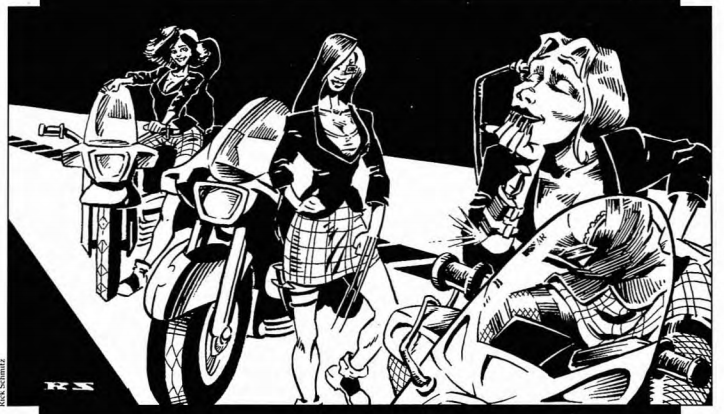
At least they're not Bikini Girls With Machine Guns.
The girls are just out screwing with people for kicks; they'll start a fight but will retreat if they take half their wounds or if half the group gets wounded. That's literally all this encounter is.
So "The Southern Gentlemen", then!
The Gentlemen are a recently-formed Victorian secret society dedicated to defending New Orleans from all the weird shit that popped up recently, "but with a sense of class." When the PCs arrive at the mansion, the door is answered by Reeves, the butler. If the party can convince him they're here on business, he'll let them in. Oddly, the book doesn't say what happens if they can't.
The PCs will be greeted by Sebastian Orwell, leader of the society, who acts like a Southern gentleman; muttonchops and all. He'll make small talk to try and determine if he can trust the party. He does know the victims from the start of the Act; they came to him for help, but were too scared to give any details. If the subject of Roxanne's vision of a "one-eyed king" is brought up, he'll point the Knights towards a bar called the One-Eyed King, which is near St Louis Cemetery #1. He also knows about the turf war between Basjas and Sabathina, but won't talk about it unless pressed or Roxanne's other vision is brought up. If the PCs show him the talisman, he recognizes it as coming from a voodoo practitioner called Sister Trinity.
If the PCs are respectful, they can use Orwell's library for occult research. That said, he won't sell them stuff or let them crash here; this is home, not a motel. On the plus side, one of the members of the Gentlemen is a doctor who can be called on to patch people up.
The Gentlemen have also invited a few Gaean Gypsies to the mansion as a consultation to see if they really can predict the future. The only one of them who can is Grandmama Kella, who charges 10 Sterlings to read someone's future. She's here to perform a seance, and if the PCs stick around they can ask her some questions. Before they can, though, she goes into a trance and gives the following three prophesies:
quote:
"Once on high,now one in many, it walks the Earth in rage and defeat, looking for blood. A tool it is, to be used by he who would take all."
"Unholy Horror within arbor prison sleeps, changing all we know into its own twisted vision. Strong it grows, rooted where the trumpeter is honored."
"Metal priests of heresy, failing, fading, have no part in this part of the play of horror and pain."
The PCs can ask their questions now, but if they ask more than three, there's a wobble in the Warp or something and a Chthon pops into existence and starts attacking everyone because fight scene. Once this thing is dealt with, the scene ends and the PCs don't have to go home but they can't stay here.
Checking out La Bon Vie takes the PCs to another Victorian mansion, but this is actually a theme hotel, not something that transformed. The clientele is a mixed bag; there's Sergeant-Major Crawford, who's leading the 7th Regiment, Victorian Royal Order, and are here on a goodwill misson for the Empire. There's also Reverend Montague Winter, a Sacellum priest who is here to eradicate as much sin as possible. Pere Gastoneau is the representative of the Cyberchurch here, and always has a half-dozen Church Police with him. There's also a freelance journalist here named Cassandra Riley, who is here to get in the way. Oh, and Sheriff McAllister is also staying here while he's assisting with the crime scene.
At some point while the PCs are present, Reverend Winter and Pere Gastoneau (who have been arguing the whole time they've been here) start getting further into each other's faces to the point where the Victorians and Church Police are about to draw on each other. Sheriff McAllister will draw and tell everyone to stand down, but neither side listens to him (they say this is an "inter-cosm dispute" and he should mind his own business. McAllistar repeats his demand.
Unless the Storm Knights figure out a way to get everyone to calm down, a big ol' fight will break out as both sides try to kill the shit out of the other. If a fight does break out, all the generic background patrons will take off, and Cassandra will hide behind the bar and take pictures.
Regardless of how that shakes out, later the same night a group of four vampyres who stumble in drunk after hanging out at the One-Eyed King and are looking to kick some ass.
Again, no new information is learned here. This is just a place to work out of and for fights to happen because adventures need fights.
Eventually, the PCs should head to the One-Eyed King and hooooooooooooo boy get ready for this.
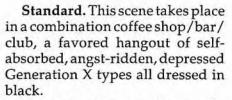
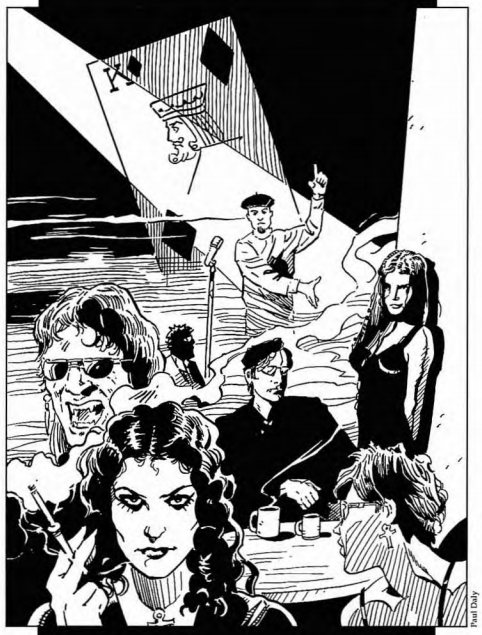
Oh god, I think I used to hang out here in the early 90s.
quote:
Regardless of the room, the clientele is the same: young people, ranging from late teens to late twenties, sit at tables or lean against the interior walls. Most are clad in black: trenchcoats, leather jackets, blazers, jeans. There is a preponderance of jewelry with skull, dagger, and ankh motifs.
You've been in everything from the gangster-owned speakeasies of the Nile, to the raucous taverns of Aysle, and the smash clubs of the Cyberpapacy, but never have you seen a club where the mood is so deliberately subdued, even depressing. Most of the clientele appear to be posing, overacting, or overdosing on angst.
You might be tempted to just laugh and dismiss the whole place as a gathering area of preening, self-absorbed, pseudo-intellectual losers, except for the fact that there is definitely an underlying sinister current of evil. The place has many shadowy corners, and you could swear that sometimes you can catch the glint of a badly concealed weapon, the flash of cyberware, even the hint of a fang or two in a mouth opened wide with sarcastic laughter.
Maybe you will be a little more careful in here.
Shortly after the PCs arrive, a poet takes the stage and reads what may be the worst prose ever in an RPG adventure since Tomb of Horrors:
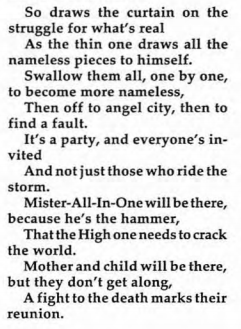
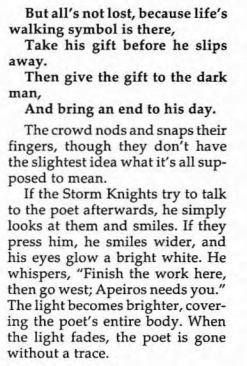
Once that happens, Basjas sends a bunch of her spider-kin into the club because she knows Sabathina's followers hang out here. Apart from that, there's no further leads; the PCs are basically here to hear the shitty poem and make themselves know the the technomage.
The last lead available is to the voodoo practitioner Sister Trinity. Trinity knows that when people come to buy voodoo trinkets, real or otherwise, they expect a show. As such, she leans heavily into the French accent and weird preistess act.
Trinity will identify the talisman (after being paid $5 for her time); she sold it to a guy named Albert to protect him from winged demons. The talisman does actually work, just not against the things Albert and his friends got jumped by. That's all she knows, but she can sell the PCs various basic occult and monster-hunting tools; holy water, corpse dust, crucifixes, and so on. She also sells medicine bags for $100 a pop: two that add +5 to the actions of any spiders or spider-like creatures that act against the carrier, and two that do the same for vampritic creatures. That's pretty convenient! She also has a bunch of zombies in a back room in case the PCs try to start something.
From here, all that's left are the final wrap-up fights. This Act really has two "boss fights", although technically I guess the first one is optional if the PCs don't want to get involved. I mean, they're both optional in a way because neither has anything to do with the greater plot of the Gaunt Man ending the war, but whatever. Why ask why at this point?
The first of these scenes is the final battle between Sabathina and Basjas. Note, again, that the PCs don't have to get involved with this. Nothing they've learned about their conflict points to them being directly involved with the end of the War. Then again, the PCs probably barely know that's happening so let's just get to it.
The two Nightmares are having their final confrontation at St Louis Cemetery #1. The PCs can get there early and set up whatever they want, because when the action starts we're back into cutscene territory.
quote:
Near the middle of the cemetery, where there are fewer tombs, two women stand off, a distance of ten meters separating them. One is old, perhaps in her early 60s. Her skin is wrinkled, and her short hair is grey, but she radiates power, nonetheless. Swirling around her are a flock of amorphous grey blobs, covered in hideous red eyes. Many of them hover in the air above her.
The second woman is a tall, attractive woman in her early 30's, clad in a flowing Victorian dress with a high collar, her long brown hair piled atop her head in a bun.
Sheer hatred burns in both women's eyes. A host of spiderkin, huge spiders with heads that resemble human skulls, crawl around her, clacking their mandibles impatiently. As both small armies crawl towards each other, the women step forward as well. "It ends tonight," the older one hisses, and you see fangs glistening when she opens her mouth. "That it does," the younger one says, "And it ends with a stake of ice through your heart!"
Suddenly, the older woman pauses. "Hold," she says, raising her hand. "We have visitors!"
Both women unerringly turn and look at your group. Evil smiles, frightening in their similarity, spread across their faces. "What say, Sabathina?" the younger woman laughs. "A little snack before we settle this once and for all?"
"Aye, Basjas," the woman you now know as Sabathina nods, licking her blood-red lips. "And a contest as well. Whoever collects the most Stormer hearts gets to strike the first blow when we resume our due!."
"Done!" Basjas replies. Both women close in as their armies, still obeying their respective mistress' last orders, clash in a horrible fury of webs and blood. Before your eyes, Basjas' form changes from an attractive woman to a bloated spider form three meters high.
On top of that, there's also twenty spider-kin and eighteen blood-thirsts. These things are nasty, but on the plus-side they're not P-rated. There are a lot of them, though, and they all have the Resistance to Normal Weapons trait (as do their mistresses), which turns the first five Wounds dealt by an attack into shock instead. The mooks will fight each other at first, but will change targets if their boss starts having trouble.
Also on the battlefield are two bags, each of which was brought by one of the women. Each bag contains the weaknesses of one of the Nightmares, as well as the tools needed to inflict the True Death on her foe. If the Storm Knights can fight their way to the bags they they can use these items...if they know how. There's no instructions.
For the record, Basjas' weakness is gold, and her True Death is inflicted when she is wrapped in her own webs for three days. Sabathina's weakness is the holy symbol of her homeworld (a circle with a triangle in it), and to kill her for good you have to drive a stake of ice through her heart.
The way this combat is supposed to be run is that each round, the GM rolls a d20 and divides by 2. The result is how many casualties the mooks inflict on each other, splitting evenly between the two sides. As soon as one of the Nightmares falls, her forces will swarm the Knights. The survivor will fight until she takes two Wounds, at which point she'll declare herself the victor and have her critters cover her escape.
Regardless, however the fight shakes out doesn't matter. Presumably one of the women escapes to do stuff another day, but since this is probably the end of most people's campaigns I can't imagine anyone cared.
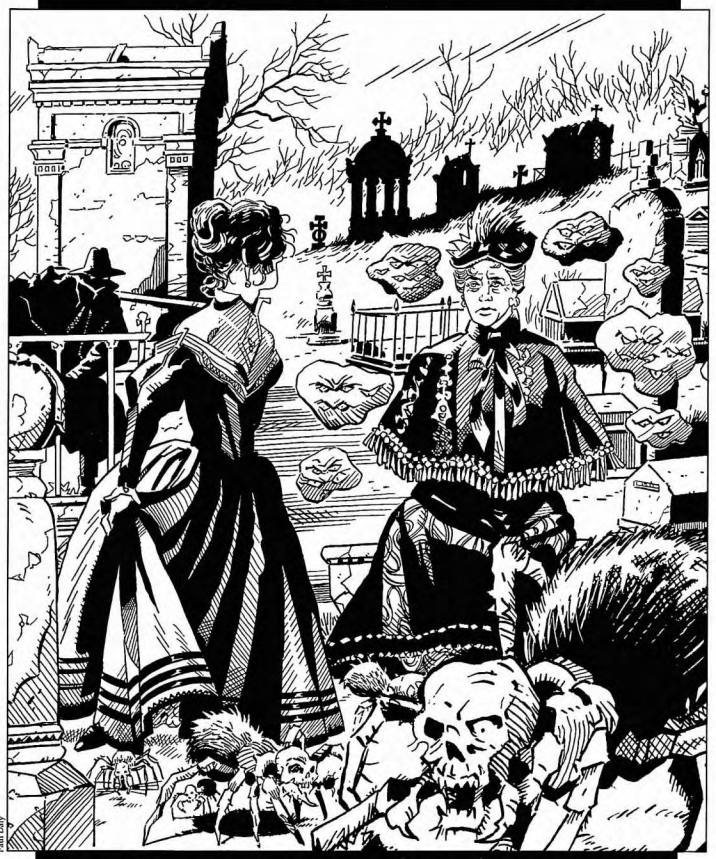
What're you looking at?
The other end of the act revolves around destroying the reality tree that's affecting the city. The tree itself has fulyl grown, which means that the creature that was inside (a ghoul) has left and the zone is self-sustaining. "Defeating" the tree involves uprooting it, which is actually pretty tough. It's got a very strong grip on the ground and an insanely high Toughness stat. It also leaened the intimidation skill from the ghoul it housed, and will use this every round(this is represented by it having a weird moaning face and swaying in an "unnatural" way). For those who don't remember, intimidation can make targets stymied (lose their next free bonus roll-and-and) or have them suffer a setback (prevents them from taking action against the user of the skill).
The tree also has two defenders: Mr. Koar from Act One and Randolph Chapman from Act Two, assuming they're both still alive. One thing I missed in Act One is that Mr. Koar does have a True Death (being stabbed in the heart with a knife while seeing his face in a mirror), but since the PCs have no way of knowing that he's a capital-H Horror they probably didn't inflict his True Death, not that they'd have a way (or reason) to find out what it is. So at the very least they'll have to fight Koar.
Once dealing with those two, it'll become clear that just punching the tree to death won't work because its Toughness is so high it's probably immune to any form of attack the PCs can bring to bear. To put it in mechanical terms: in order to damage the tree, you'd have to get a damage total higher than its Toughness of 50. For reference, a torpedo is damage value 34.
Rather than just spend the next three sessions attacking the tree, the PCs can also defeat the tree by nailing a ghoul to it with four silver nails. Why? No idea. The players are supposed to learn this by researching it at the New Orleans public library, begging the question "why would this information be at the public library, let alone available anywhere?"
Thankfully, there's a pack of eight ghouls "hanging about", and by an amazing coincidence the ghoul originally in the tree is one of them! Not that you need that specific one, but whatever. The PCs can also buy silver nails from the gypsies staying with the Southern Gentlemen for $20 each.
However they do it, when the tree is destroyed the following happens:
quote:
The tree collapses on itself, smoldering, dying. Suddenly, it heaves to life again, pulsating as if it were breathing rapidly. At last, it explodes like an overripe melon, except that instead of pulpy fruit matter, a hurricane laced with red and blue lightning erupts from within.
Call for Dexterity totals. On a 12, the character has found something to hang on to and avoided being buffeted about. Failure means the Act Three
character suffers damage value 20 from the shockwave.
Read aloud:
You grit your teeth and narrow your eyes as the violent wind slices into you. Managing to turn your heads and look toward the city, your hearts leap with excitement as you see hansom cabs and gaslights vanishing, to be replaced by electric street lights and automobiles. Top hats, waist coats, bonnets, and hoop skirts change back into baseball caps, leather jackets, berets, and blue jeans.
You realize that thanks to the fact that Core Earth was already present here, no story seed needed to be planted. You hang on for dear life for what seems like an eternity, but in reality is only about 70 seconds. Finally, the wind dies down to a light breeze, then stops altogether.
Shaking, you pick yourselves up, brush yourselves off, and look around. All is quiet. Apparently, the hurricane was limited only to the confines ofthe park. You leave the place on wobbly legs, eyes wide. New Orleans seems none the worse for the experience; all traces of Orrorsh are gone. You did it. You freed the city.
quote:
Yourjob in New Orleans is done. You have been through hell, but it's over, and you've emerged triumphant, though probably a little shaken. Staring off at the western sky, you see dark storm clouds gathering, with what you'd swear are forks of blue and red lightning. You know that your destiny now lies out there, in California. After over five long years, at last you have come to the end of it all. The Gaunt Man must be stopped, one way or another, and it looks like it's up to your group to do it.
This is it. The final battle of the Possibility Wars. Maybe the last battle you'll ever fight.
But before we go the final act, there's the flash of light again, and now it's time to learn the final fate of 3327, a.k.a. Ryuchi Kanawa, High Lord of Nippon Tech.
Back in the Nippon Tech sourcebook, we learned that 3327 had five back-up clones to serve as body doubles or backup bodies as needed. Here, we learn that Jezrael has replaced all five clones with ones loyal to her. This is because back in the start of the War (in the first game novel) the Kanawa Corporation was directly responsible for Tharkold's reality bridge being destroyed by Russia before it could touch down. Now that the shit's hitting the fan and 3327's Darkness Device having vanished, the clones are moving in for the kill while the Kanawa Corporation packs up and prepares to head back to Marketplace.
quote:
All five men stood impassively in the elevator as it shot up to the penthouse offices of Ryuchi Kanawa, their images reflecting in each other's mirror shades. As one, each tugged on the collar of their black turtlenecks, then straightened the lapels of their grey sports jackets.
The elevator door opened, and a dozen heavily armed and armored MarSec troops leveled their Impala Chain Guns. The squad's leader began to ask for identification and verification of the visitors' appointment with the now very reclusive High Lord, when his jaw dropped in a most uncharacteristic fashion. "Im ... impossible," the commander gasped. "What trickery is this?"
"You're all fired," the CEO of Kanawa Corp announced as five lasers blazed away at the MarSec troops. In seconds, all twelve men lay dead.
Satisfied, the clones walked up to the ornate steel office door. 3327 placed his palm on the reader. The door hissed open smoothly, and the five men walked through the secretary's office. It was empty -- Miss Mikuma had already gone back up the maelstrom bridge, back to Marketplace.
This time, the High Lord of Marketplace had the honor of placing his palm on the reader. The door opened, granting them access to the sanctum of none other than Ryuchi Kanawa, aka 3327, aka the High Lord of Marketplace, aka the CEO of the megacorporation known as Kanawa Corporation.
The man who sat at the desk, Ryuchi Kanawa, frowned as he stood up, hands resting on the desk. He knew, of course, what this tableau meant. "Computer!" he barked. "Initiate program Judo One!"
The clones raised their laser pistols and took careful aim. Five beams lanced out and struck the High Lord, who was blown backwards by their sheer force. He was bloodied and burnt ... but still alive.
...and this is the point where the PCs pop in. I don't know if they're supposed to know everything that happened up to this point, and this time the people here can see them. When the 24 MarSec troops arrive, they'll naturally assume they're here to deal with the Storm Knights and open fire. Likewise, the clones will assume that the real 3327 hired the PCs as extra security and will also open fire. Ryuchi, for his part, will yell at the MarSec guys for attacking the wrong targets and try to kill the clones.
quote:
At this point, gamemasters can take it one of two ways: Apeiros can take the Storm Knights back to where they came from, or they have to get out of the building before the bomb blows (what bomb, you ask? The one 3327 is going to set off in the second half of the fiction, below). If the latter is used, the Storm Knights have four rounds before the explosion goes off. Once they clear the building, Apeiros takes them back to the spot they started from.
What's supposed to happen is that Kanawa "prime" activates program "Kamikaze One" at the same moment the last remaining clone shoots him in the head, killing him. The clone realizes that he could take the real Kanawa's place as head of the Kanawa Corporation, and was just about to arrange the real Kanawa's body with the fakes when he realizes that Ryuci's chest is beeping. Turns out that all high-ranking Kanawa personnel have heart monitors implanted in case something bad happens so medical and MarSec teams can be dispatched.
quote:
Frowning, Ryuchi couldn't help but to wonder why it was beeping. It wasn't supposed to beep.
And shouldn't MarSec and the EMTs have been here by now? Was something wrong with the computer?
The computer!
Suddenly, like a thunderbolt, Ryuchi remembered the dying High Lord's last words: "Computer - initiate Kamikaze One!" His mind raced. What command was that? Kamikaze meant divine wind ... kamikaze was also the name of the Japanese pilots on this world who, in their last major war, committed suicide by ramming their planes into the enemy ships. The pilots died ... but they took the enemy with them.
Ryuchi's eyes went wide. He dropped the corpse and realized there was nothing more to do now.
Nothing to do but die.
When the PCs pop back to where they started, they again have the implanted knowledge of the end of another realm. Oddly, it's not Tharkold, the only realm unaccounted for, but what happens to the Ravagons.
I know I never really talked about Ravagons, but they were mentioned waaaaaay back at the start as a race of flying lizard people from a dead world that the Gaunt Man tricked into serving him. They barely show up anywhere, and even then only as enemies to be punched. Why John Terra thought it was more important to close this off than say what happens in Tharkold is beyond me. Maybe because Jezrael figures prominently in the final Act, I guess?
Anyway, that's most of the major players now dealt with. All the High Lords are off the table except for the Gaunt Man and Jezrael. The party has a big ol' arrow pointing them to California. It's time to put this whole damn mess to bed.
It's time for the final confrontation with the Gaunt Man, and the end of Torg.
--
One act left.
NEXT TIME: And I feel fine
The End Of The World As We Know It
Original SA post The storm has a name... - Let's Read TORG
Part 23d: The End Of The World As We Know It
This is it. The final Act of Torg, the final face-off against The Gaunt Man. I never thought we'd see the day.
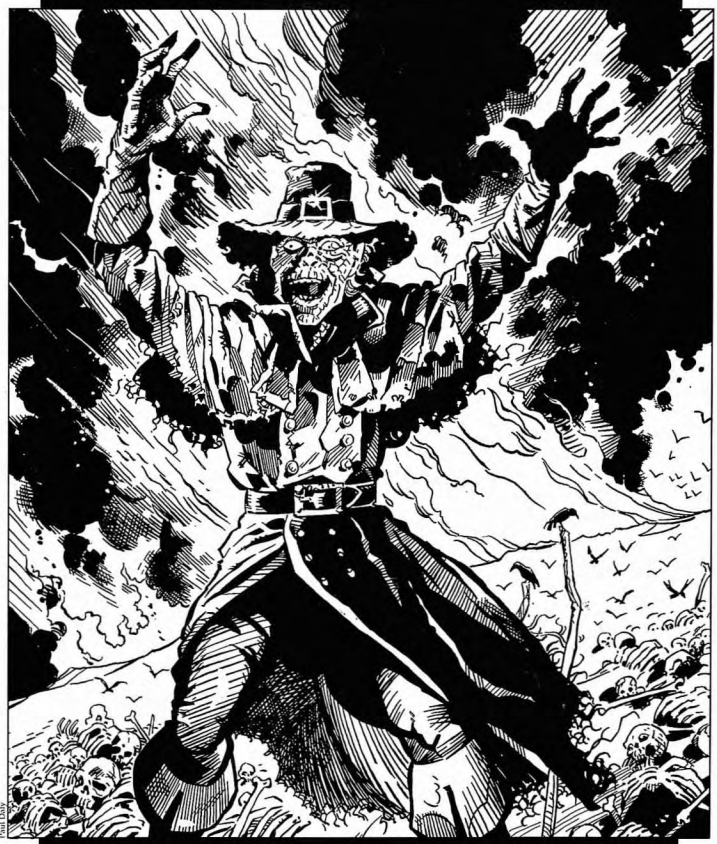
Some people just want to watch the setting burn.
(Before we start, I'd recommend checking out the archived review for the three metaplot [url="https://projects.inklesspen.com/fatal-and-friends/evil-mastermind/torg/#21"]updates. A bunch of stuff that's going to happen are introduced in those.)
This Act starts out with "A Word of Warning" for GMs, which is a bunch of stuff about what's going to happen in this Act. Here's a few highlights.
quote:
Gamemasters must exercise extreme caution during this act. Not only are there loads of opportunities to kill off Storm Knights, there is also the unfortunate chance that the Storm Knights could wind up just sitting around and watching the action unfold around them, since some pretty significant things happen in rapid succession in this Act. A lot of loose ends get tied up.
...
The worst thing that could happen in this Act is for the gamemaster to be sitting back, reading longwinded descriptions of all this neat action taking place beyond the Storm Knights' reach, while the players, bored and feeling unable to do anything, tune out. This is THE LAST ACT OF TORG. Excitement should be everywhere.
...
It may seem like this act is rather linear, dragging the Storm Knights from one big bang-up battle to the next. Well, that's because it is. This is the act where the forces of evil and the forces of good duke it out. No quarter, no compromise, no shortcuts - it's now or never, folks. Above all else, have fun with this. This is the last act of the Possibility Wars, and should be a very big deal. It's been five years in the making, and when it's over, the world will never be the same.
This Act starts with the PCs flying into L.A., because I guess they were supposed to figure that out from "go to California" at the end of the last Act. Just before the plane lands at LAX, it's attacked by two Alpha Techodemons who're just looking for Storm Knights to kill. Their plan is to rip the hatch off, fight their way to the cockpit, and kill the pilots so the plane will crash. One of the passengers actually has a gun and will start fighting back, and to slow down the Knights the Tharkoldu will throw people out of the plane.
Assuming the players stop the demons, the plane lands at LAX. If they don't, then they need to either land the plane themselves or crash, which deals a ton of damage. Regardless, the woman who opened fire survives. This is Allison Hawke, a fellow Storm Knight who's here to investigate some goings-on in L.A. She knows that occult activity has been on the rise in the area, Kanawa is keeping an insanely low profile (because they left), and that Sidon, Jezrael's son, has started allying himself with Storm Knights and is preparing to move against his mother.
(If they have their own transport, the Alphas will be hiding in the airport using magical disguises, and the PCs just meet Allison.)
For her part, Jezrael knows that the Gaunt Man is up to something, just not what exactly. The fact that her Darkness Device has vanished hasn't disheartened her, and she's convinced that no matter what the Gaunt Man has planned, she can swoop in and take control of it. As such, she's gearing up for a big assault. Thanks to Thratchen and some divination spells, she knows the party is heading into L.A.
Once in the airport, the party can't help but notice some young men dressed in black holding a sign that says "Mr. Sidon's group". The PCs are expected to realize that this is for them and approach these guys, who are indeed part of the Resistance. I guess the technomage the Knights were supposed to befriend in the previous Act was supposed to tell them this, but it never came up.
Anyway, when the party approaches them, they ask "how has Mr. Sidon been getting along with his mother lately?" The answer is something along the lines of "terribly", which isn't exactly a huge secret so is probably not the best spot-check they could come up with. The Storm Knights are ushered to two limos, and the group is split up between them to be brought to the Bellflower neighborhood. The limos stop in a courtyard surrounded by abandoned buildings, the drivers get out, then SUDDENLY IT'S AN AMBUSH OH MY GOD WHO COULD HAVE SEEN THIS COMING.
Lasers blast out, taking out the drivers and parts of the surrounding buildings, then two vampyre gang members per Storm Knight attack from the buildings. Once the PCs engage, the drivers stop playing dead and join the fight against the PCs. Before this happens, though, one of the drivers will plant a tracker on one of the characters, although it might make more sense for them to try to do this before the ambush but whatever.
Just as the fight ends (or a little sooner if the PCs are getting creamed), the actual Resistance members show up. Turns out that one of the members was a Tharkoldu double agent and managed to intercept the PCs at the airport. Oops.
After the apologies, the PCs are brought to actually meet Sidon for real. Sindon is holed up in a ruined part of the city (which, I realize, doesn't really narrow it down at this point given everything that's happened to L.A.) owned by "Demon-Pruf Home Security Systems".
quote:
The basement of this building is practically one huge room. Partitions are set up, giving groups of resistance members privacy for their various activities. You catch sight of a med area, a cyberlegger, weaponsmiths, hackers, codebreakers, worktables covered with electronics, everything you can possibly imagine a resistance cell needing. The entire place is buzzing with activity.
From behind one partition, a swarthy young man in tom jeans and a leather jacket emerges and walks towards you. His eyes glow green as he looks your group up and down. After a few seconds, he gives a curt nod and walks back to the cubicle, signalling for you to follow, but not the other resistance personnel.
In the cubicle, the young man sits and looks you over. "Word has it that you're here for the big End of the World rumble. I'm Sidon, son of your enemy," he says smiling.
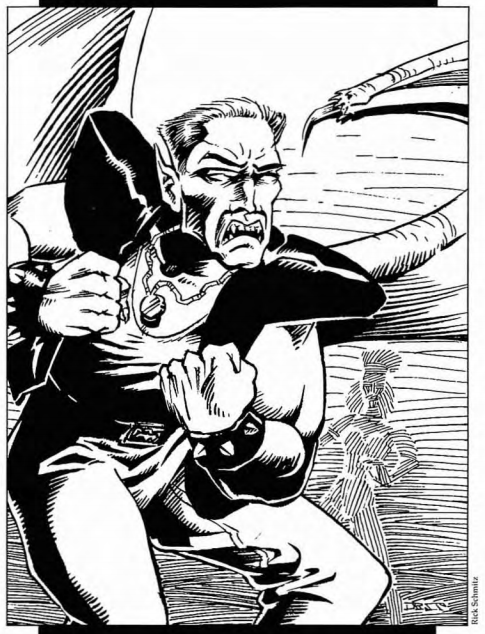
"...theeeeese wounnnnnnds they will not heeeeeeeal!"
Sidon is the first half-human/half-Tharkolku in existence, and as such has Weird Plot Powers. To wit, he's been having visions of a great battle that'll decide the fate of the multiverse. He also knows Jezrael will be there, so the Resistance is gearing up to stop her once and for all. He also knows where everything's going to go down: The Devil's Playground, in the middle of the Mojave Desert.
Sidon wants the Storm Knight's help in the battle, so hopefully they'll agree to ally themselves with him. Even if they don't, he's going to be there with all his troops regardless so they might as well be on his side. If they agree, the party can rest and restock in the HQ. Oh, and during the night before the battle, 36 P-rated technodemons will attack because of course they will. It's been a whole scene before a giant-ass combat!
Okay, technically they're attacking because they've been following the transmitter. This is Jezrael's last-ditch attempt to take out Sidon before the final battle, but because he has to be there he can't be killed or anything. The Tharkoldu's goal is to wipe out as many people as possible (PCs and NPCs alike), and confirm that Sidon is indeed in the city.
When the fight's over, Sidon will automatically see the tracker that was planted on the characters, so that should be a fun roleplay moment.
From here on out, everything in this Act is part of the final conflict. Now, there's going to be a lot of loose threads flying around, so everyone please wear eye protection before we continue.
quote:
Taking Interstate 10 East, then Interstate 15 North, three hours of driving finds you at the place called the Devil's Playground in the Mojave Desert. The Tharkoldu axiom wash has changed this terrain into a mixture of desert and rugged rock formations of almost alien shape. You survey the desolation as the wind moans through the rocks, and you can't help but wonder if this is what the entire Earth will look like if the Gaunt Man wins.
Your force consists of your group of Storm Knights, Sidon, four dozen resistance members, and three dozen Race soldiers. The increased numbers do little to bolster your courage.
The ground suddenly shifts and erupts, rocks shatter and crumble, spewing forth a host of gospog. They are all around you, closing in eagerly for kill. You can feel the power of Fear radiating off them, tipping you off as to exactly who sent them.
- 72 First-Planting Gospog. These guys are effectively mooks; not strong or tough, but they have numbers on their side.
- 36 Second-Planting Gospog. These are a little tougher; they have blunderbusses, and resistance to energy weapons.
- 18 Third-Planting Gospog. These are "weretigers"; they have claws, can change between human and tiger forms, and are resistant to magic.
- One Fifth-Planting Gospog per Storm Knight. These guys are the heavy hitters. These Wraiths have a paralyzing touch, can ignore armor, and are resistant to normal weapons, energy weapons, magical, and physical damage.
That's just over two hundred NPCs involved in this fight. And remember: this game was designed before the idea of "mook rules". Every one of these assholes has all three damage tracks: Wounds, shock, and K/O. There's also no mass combat rules. Oh, and these things have Fear ratings, which means that unless the PCs have had a chance to research the enemy and prepare, they can't invoke reality storms or play cards for the critical moment (read the archive to remember what those mean; I'm not stopping here). Since the PCs wouldn't have had an opportunity to do that even if they'd known this was coming, that's just in effect.
How in the fuck are you supposed to run this? I'm seriously asking. I'm assuming the resistance members will help, but it's not like that's going to make things less complex. The "roll a d20 and halve it, that's how many guys wipe each other out" thing from the last Act wouldn't work here because the gospog force is a hell of a lot stronger than the generic troops.
To make matters worse, the next scene doesn't start until "the last gospog falls", which means that the PCs are expected to wipe out all 130ish enemies! I can't believe I'm saying this, but even Deadlands: Hell on Earth: The Unity had the good sense to make a simple "roll to see how many dudes you blow up per attack" mechanic, and that book thought forcing the party to kill one of the PCs to advance the plot was a good idea!
Well let's assume they win, because otherwise this will never end and as always, the book doesn't take into account what would happen if the PCs lose. Which is especially bad considering the stakes of the battle here.
Anyway, the next scene starts as such:
quote:
The sound of the last attack echoes through the desert as the last opponent hits the gritty sand in a spray of foul-smelling viscera and plant matter. Gasping to catch your breaths, you survey the scene; the desert is littered with scores of corpses, the brown desert sand stained the sick green of spilled gospog blood.
A light breeze puffs out of nowhere, blowing sand onto the remains. The breeze becomes a wind, pushing sand faster and faster over the ruined gospog, until each piece sinks into the desert. In a matter of seconds, all trace of the battle is gone.
The wind doesn't die down; on the contrary, it roars into a huge funnel, whirling in front of your battle-weary group. Suddenly, blue and red bolts of jagged lightning crackle up and down the vortex, as a humanoid form begins to coalesce inside the funnel.
With a loud explosion of red and blue light, the vortex terminates. Your blood turns to ice when you see what stands within. It is the Gaunt Man, his cane in hand, his eyes glowing red. He holds forth one hand, conjuring several globes, some red, some blue, orbiting each other rapidly like mad planets orbiting an erratic sun.
He throws his head back and utters a laugh that echoes across the Mojave.
"Greetings, stormers, and others ... I am pleased to see that you have made it this far. It is good to have witnesses to the end of all things. The power of the combined Darkness Devices now rests securely within my form.
"It is time to end this war, stormers. It is time for me to take my rightful place as Torg. How fitting that those who for the last half decade have thwarted the plans of the various Possibility Raiders, are now here to witness my ultimate triumph!
"Your world now dies screaming, stormers. And so shall you!"
With a wave of his hand, gospog erupt from the sand. The precise same number of gospog you had already dispatched!
Oh, and at this point the GM is supposed to call for a Perseverance Check, which is a mechanic from the Orrorsh book tied to the Power of Fear. I'm not going to go into the nitty-gritty (again, check the archive) but basically if they fail this roll, the Gaunt Man will be able to spend his Fear Rating to buy abilities on the spot, such as stealing cards from players, cancelling bonus rolls, or preventing a character from spending Possibilities to cancel damage. So that's fun.
BUT WAIT! As soon as the gospog rise, another scene starts! Then what was the point of a scene where all that happens is the Gaunt Man showing up and a single die roll being made? No idea!
quote:
As you stand in the middle of the battlefield, dark clouds gather overhead, like a major thunderstorm forming in fast-motion. The vast gospog host, the ones that you went through all that trouble to kill, stand patiently, obediently, awaiting the last High Lord's word to attack.
Suddenly, a hole opens in the clouds and a vast structure descends from the sky. It almost resembles the Living Land's maelstrom bridge, but not quite; it seems to be a mixture of rock, mud, and tough plant fiber, wreathed in small flames.
Coming down the bridge is a vast horde of humanoid wolves, fangs bared. A ripple moves through the invading army, and you realize that what you are seeing is the effect of scores of shapechangers shifting into more feral forms. There can be little doubt of what you see: the cosm of Kantovia, the Gaunt Man's first conquest, is invading Earth!
Kantovia is indeed an established part of the setting, but like a good chunk of the setting, it was a part that barely had anything to do with anything and was only cared about by Lore Nerds. This is the home reality of Kurst, one of the Gaunt Man's lieutenants who played a major part of the novel trilogy and then just got forgotten.
Leading the attack force is Kurst's former mate, the High Lord of Kantovia, Ayroa. She's also setting NPC "The Guildmaster", who was a Mysterious Figure With A Mysterious Past who could be a patron for Storm Knights. Again: nobody cared by Lore Nerds. It's also worth pointing out that she became High Lord after the events of the adventure High Lord of Earth. This was one of the first adventures for Torg, but we don't learn about this until this moment because again who could possibly care.
Ayroa is here for the Gaunt Man, and will ignore the PCs. The Gaunt Man, for his part, will use magic to shatter the maelstrom bridge (dropping a few hundred werewolves to their deaths) and summon forth Kurst to fight Ayroa even though Kurst broke free of his control ages ago.
At this point, all hell breaks loose. Kurst and Ayroa attack each other, and Ayroa's retinue of 200 P-rated werewolves will attack anyone who threatens Ayroa. Whatever resistance shmucks are still alive will open fire on the gospog, and the Gaunt Man will begin stalking the Storm Knights across the battlefield. The Gaunt Man is powerful enough to crush most PCs like Coke cans, but now he's drawing out the pleasure of scaring the PCs. Assuming they're scared of him, of course, and don't try to attack because that'd be suicide.
Oh, side note: previously, the Gaunt Man could only truly be killed by using an eternity shard, but now that he's absorbed all the Darkness Devices he's removed that weakness, which means that he can't be killed at all anymore. So yeah, suicide.
While he chases the PCs through the carnage, he does take advantage of the moment to monologue.
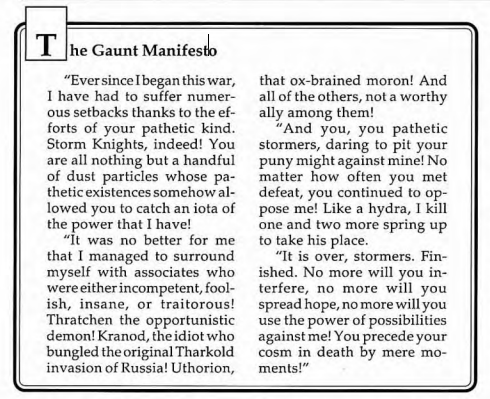
Oh, and if any characters have ranks in the corruption skill, which you get by doing evil things in Orrorsh, the Gaunt Man just kills them.
quote:
If there are one or two Storm Knights who do have the taint of corruption (or who for the entire adventure thus far have been completely wretched and uncooperative), kill them. It would hardly be dramatic if there were not one or two demonstrations of the Gaunt Man's power, right?
The way this is supposed to work is that the Gaunt Man advances on the PCs while they're fighting a small group of enemies, forcing them to move away to a different group, and so on until they're cornered and the Gaunt Man runs out of things to say...AND THEN A NEW SCENE STARTS GO GO GO
quote:
The Gaunt Man raises his walking stick at your group and whispers in a sepulchral voice, "Farewell, stormers."
Suddenly, a maniacal shriek splits the air, and two figures, locked in a deathly embrace, lunge from out of nowhere. Intent on their fight, they crash into the Gaunt Man, actually upsetting his footing. Your eyes manage to make out the combatants: it's Sidon battling his mother Jezrael in hand
to hand combat. Obviously, Sidon had laid low, conserving his strength for the fight he knew he was destined to have. Each combatant has their cybernetic slicers extended, each is taking,out huge chunks of flesh from the other.
A wing of techno-demons, obviously Jezrael's escorts, move forward. Many of them fly off to embroil themselves in the massive melee. The tougher Tharkoldu move to help their High Lord, only to be frozen in their tracks by an icy, defiant glare from their mistress. "Stay back!" she snarls to them. "If you want to make yourselves useful, rip apart my son's friends. That should unsettle him!"
Jezrael and Sidon will be solely focused on killing each other; given that they both have full stat blocks, I really do wonder if the GM is supposed to roll to have them attack each other and keep track of damage. Well, given what'll happen in a moment, I know you shouldn't do this.
Jezrael has brought 48 regular technodemons and one Alpha Technodemon per PC to the party, and they're going to focus on killing the PCs as instructed. I'd like to point out that these 50 or so enemies are also Possibility-rated, which means they can spend points to increase their rolls or reduce incoming damage. On top of that, the Alphas have a bunch of spells on top of their weapons and cyberware. So that's fun.
Oh, and what happens if the PCs let Sidon worry about his mother?
quote:
If the characters do not intervene in the Jezrael-Sidon battle, Sidon. attempts to move the fight by flymg off. Jezrael sinks her slicers into his flesh and goes along for the nde. Her added weight throws Sidon out of control and they plunge toward a mesa in the distance. When they hit, there is a huge flash of light and the two of them are gone. (Later investigation will reveal no traces of either one of them.)
So, remember when I reviewed Deadlands: Hell on Earth: The Unity, and there was that thing that was the worst part of any adventure ever? This adventure has something similar: on the plus side, it's nowhere near as bad as Unity's. It's still pretty bad, though.
Once the PCs deal with the technodemons, this happens.
quote:
The Gaunt Man watches the huge battle with the delighted countenance of a child watching electric trains chugging on their appointed circuits. The sands of the Devil's Playground are saturated with blood. Tharkoldu, gospog, Dire Wolves, and LA resistance fighters continue their struggle, all sides suffering horrendous casualties.
Suddenly, from behind you, there comes a disturbingly familiar, sibilant voice. "Ssstormerss! Good! I have a bloodlust only you can sssate!" You turn and find yourself staring into the face of Kaah, the denizen of all realities, armed and ready for battle.
Kaah was last seen in the final metaplot update I did, falling into a crystal called the Nexus that was a doorway to all realities when he tried to destroy his Darkness Device. It was believed that Kaah was torn apart by being smeared across the multiverse, but in fact he survived and has now become a member of all realities. As near as I can tell the fact that Kaah survived and turned into this thing was never revealed, so I guess this is a total last-minute decision.
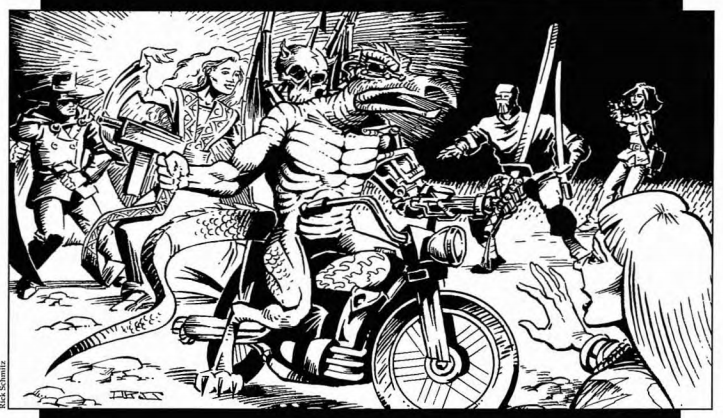
Really?
Kaah was drawn here by the Gaunt Man, and will attack the PCs on sight. He has 100 Possibilities, and powers from every cosm. Ayslish magic, cybernetics, a Fear Rating, pulp powers, occultech, guns, psionics, eye-fire blasts, "any miracle from any cosm", and, of course, a fucking katana.
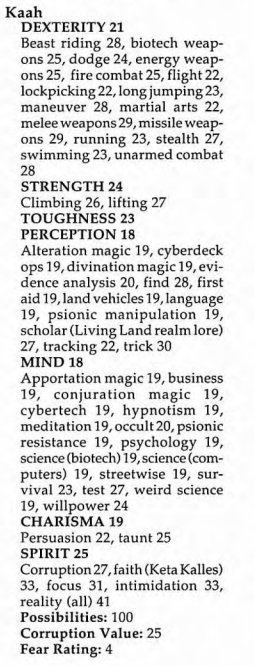
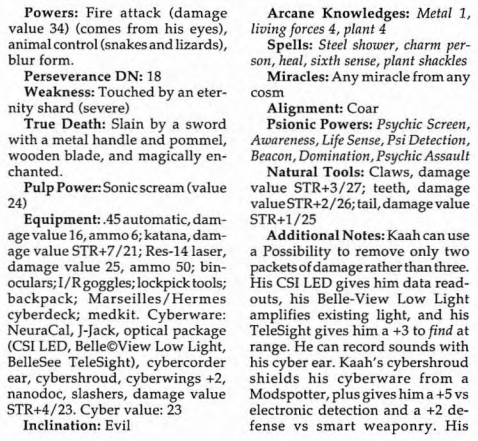
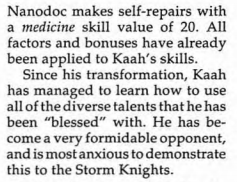
Remember when I started reviewing Torg, and people wondered why the game didn't let people just mix realities on their characters? This is why.
The PCs are to fight Kaah for a while (or until they get bored, I guess), but before they can kill him the Gaunt Man will summon Kaah to his side. At which point, there's a flash of light like the ones that were blipping the PCs around before, and another new arrival shows up.
quote:
A being walks forth from the light. At first, he looks like a young man clad in jeans and a Five Realms shirt. Then he begins to shift back and forth between this form and one of pure energy. In his hand he holds a glowing sword made of red and blue stone. He looks at you after a moment and says, "I hope I'm in time. Some of you have known this body as Jeff Mills - I used that guise, the Five Realms game and later my powers to try and slip you information without drawing the Gaunt Man's attention. But it's too late for games now. So now you see me for what I truly am: the Avatar of Apeiros in this cosm, he who embodies creation.
"You have to listen. The Gaunt Man is planning to use Kaah as the trigger for a massive earth quake along the San Andreas fault. He'll use that to absorb the physical energy he needs to become Torg. Ifhe succeeds, millions will die and then millions more when he ascends."
If one of the Knights points out that they are nowhere near the fault, the Avatar will explain impatiently that nevertheless, this is the ideal point for a detonation. The Gaunt Man is playing his own version of geophysical dominoes.
The Avatar hefts the sword. "This is the only thing that can stop the Gaunt Man ... and I'm the only one who can stop him. You must go and stop Kaah. He's the explosive - the Orrorshan is the detonator. Stop one and you stop the other. Now go!"
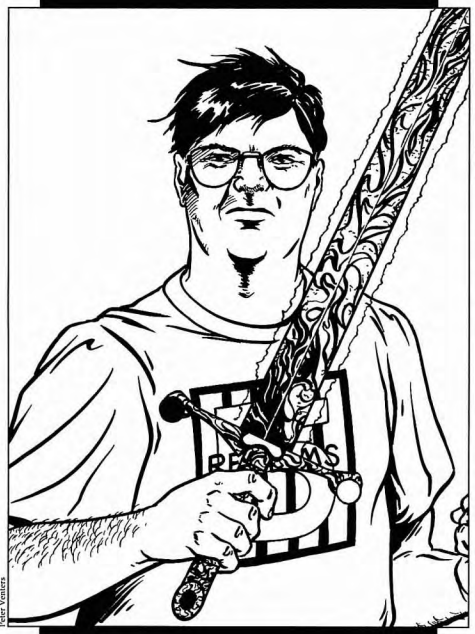
Really?
Jeff Mills (who apparently bears a striking resemblance to Greg Gorden, creator of Torg) has indeed been the avatar of Apeiros this whole time. Which would have been an interesting twist if this had been set up at all.
Jeff is, as near as I can tell, only mentioned in passing in the three setting update books as the creator of the Five Realms RPG, which is the RPG that mirrors the events of the Possibility Wars. I guess he was hiding clues in game books? I'll admit that I haven't read most of the modules but still that's something you have to have a bit more up front. Or, you know, not do to begin with because it's an embarrassing setting element. When he is mentioned in the books, he always seems to vanish when people are looking for him to question him.
As for Apeiros...way back when I wrote the first Torg post six years ago, I included the creation legend. Apeiros is mentioned there as the general force of creation, as the Nameless One is the general force of destruction. Checking the complete works of what I've written about Torg, the name "Apeiros" appears 19 times. Sixteen of those 19 times are in the creation myth in the first post, and the remaining three are part of the Space Gods review.
I'll let you draw your own conclusions here.
So now the PCs have to fight their way across the battlefield, through whatever enemies are left, and take out Kaah while Jeff kills the Gaunt Man. Kaah's probably healed thanks to his miracles and cyberware, so this is basically just a rehash of the last fight. I mean, it's not as good as letting them fight the Gaunt Man, but at least they get to do something important, right?
Once Kaah is killed, subdued, or otherwise dealt with, this happens.
quote:
You hear a sound like the rushing of wind, followed by a terrible scream. Then you suddenly realize silence has descended on the Devil's Playground.
You look around, and realize that the battle is over. In every direction, dead bodies lie stretched out. Flies have begun gathering on the corpses. Gospog, Dire Wolves, techno-demons, Race soldiers, and LA Resistance, all are dead. A single first-planting gospog, missing the right half of its face and its right arm, staggers amidst the fallen, too stupid to know that it should be dead too. A solitary techno-demon, its wings broken, tries in vain to fly, and only succeeds in making its wounds even worse, hastening death.
You see the Gaunt Man grinning madly, and at his feet, the burning corpse of "Jeff Mills," the Avatar of Apeiros. A short distance away from the body, about six meters from where you stand, lies the sword that the Avatar was trying to use. Looking at the Gaunt Man, it becomes apparent that his foe never landed a blow on the High Lord. As you stare at the sword, it. fades from view.
The Gaunt Man looks at you and smiles. "And so it comes down once again to you, stormers, as it always has, as it always must. I commend you for actually surviving long enough to face me ... but all good things must come to an end."
Yup; Jeff Mills, avatar of the god of creation, created solely to defeat the Gaunt Man, failed to defeat the Gaunt Man. He couldn't even GMPC right.
I said it before, I'll say it again: Jeff Mills is the worst NPC ever.
The Gaunt Man snaps his fingers, killing Kaah if he isn't already dead, and draws a green energy from the corpse. Man, Kaah just can't win for losing, can he?
quote:
"All this death, stormers, all this glorious death. This is the combined life energy - physical energy, if you will - of all those who died on this field. Add to that the energies of this pitiful Avatar, and poor, bedeviled Kaah ... and I have much of what I need. But not quite all ..."
In the air above the Gaunt Man, the dark figure of Ardinay appears. She is not there to attack - merely to observe. On the horizon, the clouds begin to shift madly, and for only a moment, it seems as if a horrible, formless face is looking into this world. This is the Nameless One, preparing for the feast that must surely follow the Gaunt Man's ascension.
"I offer you a choice, stormers, as I have done in the past: crawl to me, beg for the mercy that is mine to give, and your end will be swift. Refuse, and you will live to see your world die around you. You will be the last living things remaining on this barren planet ... and I will make you relive your failure again, and again, and again. I give you a moment-this cosm's last moment-to make your decision."
Before the PCs can make last-ditch attacks or grovel for mercy, they hear Jeff's voice in their minds.
quote:
"Creation can never truly be destroyed, Storm Knights. Though my physical shell is dead, and my spirit quickly dying, I will live on in you. Seek, and you shall find my blade, for only the wicked are blind."
This is the final scene of the adventure: someone has to get past the Gaunt Man, get the sword, and try to kill him with it. Despite what was set up earlier about the Gaunt Man's invulnerability, the Sword of Apeiros can actually kill him.
The trick is actually doing that.
First off, someone needs to get past him and get the sword. Once someone grabs the sword, it transforms into a melee weapon appropriate to the character's home cosm. Now all you have to do is inflict the standard four Wounds on the Gaunt Man.
Thing is, he's still a very powerful foe. He has very high stats, regenerates, and can silence people to negate spellcasting ability. He also has very good social attacks, so he can easily taunt/trick/etc. the PCs to give them debuffs or get rid of their cards. He's also resistance to all forms of damage that aren't the Sword.
The Gaunt Man also has 225 Possibilities. Fortunately, the power of the Sword of Apeiros prevents him from spending Possibilities to heal. You know what it doesn't prevent, though? Him spending Possibilities on anything else. He's more than capable of boosting his melee attacks and skill use, and given that his melee weapon (he turns his trademark cane into a sword) deals roughly the same damage as a 20mm shell, odds are that he's going to be killing someone every round.
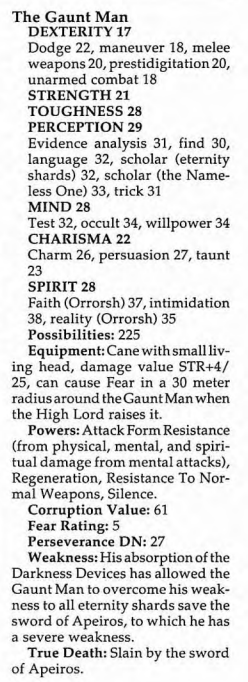
For reference, a 20 in a skill is considered pretty damn high for PCs.
There's also the question of what the other PCs are expected to do while this is going on. Torg does have social attacks and such that can put negative effects on people, so at least they can help out a bit while waiting for their turn to grab the Sword off the corpse of the last guy.
Now, admittedly, it's hard for me to gauge how hard this fight would be just through reading it. I don't know how powerful the book expects PCs to be, and the way Torg's stat blocks mechanics work it's damn near impossible for me to eyeball it. Still, I imagine this battle is going to be pretty goddamn hard. And yeah, I suppose characters dying against the actual final boss is dramatically appropriate. I just wonder because if the fight is too stacked against them, then everything ends with every reality being destroyed and no way for them to really do anything about it, which would kinda suck.
But let's assume that someone lives long enough to land the final blow on the Gaunt Man. Time for the final boxed text!
quote:
As the weapon of Apeiros plunges into the Gaunt Man, a huge blast of red and blue energy knocks everyone down onto the blood-soaked sand. The weapon remains lodged in the High Lord's chest.
Pure white light erupts from the Gaunt Man's eye sockets as his jaw drops lower that any normal person would think possible, and a shrill death shriek leaves his mouth, the sound carrying for miles. Vainly, the Gaunt Man's now shriveling fingers try to pull the weapon out, but it is to no avail. You shield your eyes as the High Lord's body is wracked by a series of increasingly powerful explosions, each one sending a jolt of agony through his frame.
Finally, one last explosion erupts, blasting the Gaunt Man to the four winds, and unleashing a massive rippling pulse of possibility energy. You shield your eyes as the energy wave keeps expanding outward, and something deep within you realizes that the wave will cover the entire earth. Fearfully, you wonder what effect it will have.
As your eyes adjust to the blinding light, the very skies themselves appear to rend open. Something dark and seductive roils within the breach. A huge chunk of black matter flies up from the explosion's ground zero, and hurls itself into the hole. You have this queasy feeling that you shouldn't look into the breach, at least, not if you want to keep your sanity intact.
Have each Storm Knight generate a Mind or willpower total. They'll need a 12 to avoid looking into the breach. If they do look, they see the following:
Within the tear in space, you see a face that is both more and less than human ... something made of shadows and mist and a deeper darkness than any you've ever seen. You feel a tidal wave of rage and frustration pass over you as the entity begins to recede and the wound in the sky begins to heal. This, you know, was the Nameless One ... stopped just short of devouring this cosm.
There is one more scene to be played. Above them, the dark goddess that is Ardinay transforms back to the Lady of the Houses of Aysle, Pella Ardinay, and plummets to Earth. The sands shift to cushion her body as she lands, and though not unhurt, she is alive. The death of the Gaunt Man and the retreat of the Nameless One have purged her of her taint of corruption. In saving the cosm, the Knights have saved a soul as well.
Now, at last, the battlefield is at peace. The sword is no more; the Gaunt Man is no more. It takes several long moments for you to realize the import of what has just happened: after five long years, the war is over.
And Earth has won.
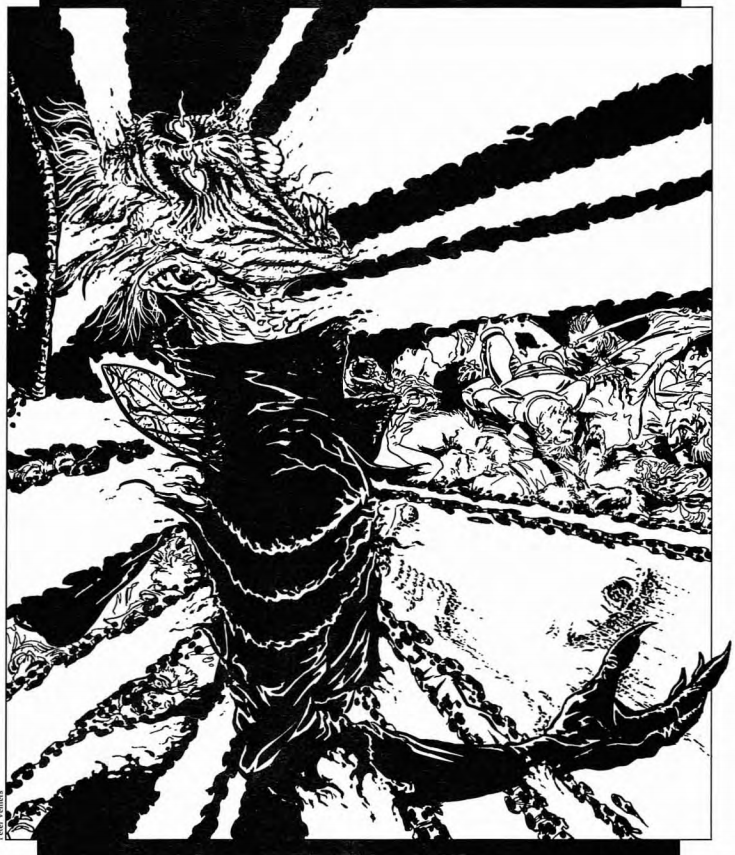
For saving the entire multiverse from destruction, each surviving PC gets twenty Possibilities. Whoever got the killing blow on the Gaunt Man gets another five.
And that, ladies and gentlemen, is the end of War's End, the final adventure for Torg, and the end of the Possibility Wars.
NEXT TIME: What the fuck do you mean there's one more chapter?
The End
Original SA post The storm has a name... - Let's Finish Reading TORG
Part 23d: The End
Yes, there's one final chapter (okay, technically it's the "Appendix"). Okay, technically there's two Appendixes, but the second one is just a sub-reality called "Arachnidia". Arachnidia is an underground domed world like the Land Below, only populated by insect people called ustanah. Long-time Torg scholars will remember that this was the species that the edeinos wiped out ages ago. There's really not much to tell because it's literally four pages long, so I guess it was just there to pad out the page count?
Appendix A is What Lies Beyond?, and covers what could happen after the War for those who want to keep their campaigns going.
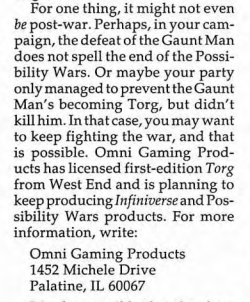
Needless to say, Omni Gaming Products didn't actually produce anything. I can't even find any information about the company online.
Anyway, post-war scenario #1 flows out of the default events of the adventure. The world-wide reality storm has wiped all the invading realms off the map. However, the Nexus, the crystal that connects all realities, still exists in the caves of the Land Below. The UN has taken it upon itself to guard the Nexus, but they're doing a shitty job of it. Storm Knights have learned that they can travel through the Nexus to return to their home realities, but have also discovered that the Nexus leads to other worlds that were never involved in the Possibility War. What's more, by revisiting their home cosms, they can "recharge" their connections for about three months. On top of that, there's also the fact that Core Earth's Darkness Device has never been discovered, and is theoretically still out there somewhere. (The one from the "High Lord of Earth" adventure was from Kantovia, not Core Earth.)
quote:
The setting for this is essentially a world rebuilding, very much like post-World War II Europe. It puts the emphasis more on intrigue than on big battles and such, but remember that elements of the other two scenarios presented here can also be incorporated into it.
The second scenario is for "fans of the Max Max films, A Boy and His Dog, and the world of Tank Girl." In this set-up, the global reality storm ends up destroying most of civilization. Whole cities are wiped off the maps, portals to pocket dimensions are cropping up all over the place, and resources like food and water are scarce. Now all the refugees from the invading realities have to band together for survival.
quote:
The benefit of this scenario is that it essentially wipes the game board clean, so gamemasters don't have to deal with any aspects of Torg they don't like. The downside is that too many adventures can wind up being just about staying alive, with the characters' actions hampered by constant searches for water and ammunition.
The final scenario is probably the most complex, and was going to be the set-up for the next "version" of Torg. In this scenario, the global reality storm still did a lot of damage to Core Earth, destroying most long-distance communications but not enough other stuff to go full post-apocalypse. The storm burns out all the still-existing stelae, but the actual realms themselves get "burned into" Core Earth. Now they're self-sustaining mixed and pure zones, still maintaining their axioms and World Laws. And while the High Lords are gone, there are still plenty of minions floating around who see this as their big moment to rise to power. Most people have become Possibility-rated now, but the Storm Knights and Stormers are still the best at handling shifting between realities.
The Nexus itself has become tainted by the reality storm, and now other realities and pocket dimensions are starting to appear to prey on the existing realms, twisting their borders and axioms. People who have high reality skills can "lock" realities into place, to to make the change permanent eternity shards are needed.
This was to be the concept behind the next game, called "Storm Lords" and that involved the PCs basically trying to manage the conflicting realities, but of course that never materialized.
It's worth noting here that new editions of Torg were actually planned for 2004, 2005, and 2006, with a "big announcement" not-happening at GenCon 2005. The only thing that came out of this was the Revised & Expanded version, which was at best Torg 1.5. And while it does weigh in a little under 300 pages, it has no setting information beyond what's needed from a mechanical standpoint. Which means you'd still need to buy all the fucking cosm books.
The book also contains conversion rules for WEG's generic MasterBook system, which was the cornerstone of most of WEG's games at the time. MasterBook was derived from Torg's mechanics, but the settings that were published for it were some...odd licences properties. Like "The World of Tales from the Crypt." Yes, the HBO series. Or "The World of Tank Girl." Remember Tank Girl?
Those weren't the only settings published (probably the two best known were the hard sci-fi game Shatterzone and the horror-noir Bloodshadows), but the idea was that your Torg characters could visit these other settings, or you could run Torg with the newer system.
And after that, are the final words.
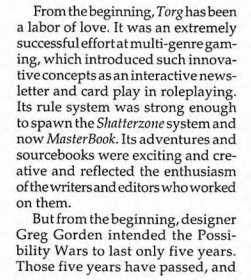
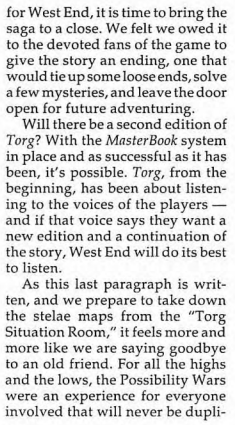

And with that, we have truly reached the end of War's End, and, believe it or not, the end of Torg.
--
Torg. Man, Torg.
I mean, what's left for me to say about it at this point? I know that sounds trite but, again, I've been doing this for six years. I don't know what else I could say.
Way back on April 15, 2013, I started reviewing Torg with the claim that it's my favorite setting with my least favorite system. Now, here, on April 15, 2019, that still remains true. Hell, just doing these read-throughs revealed new levels of design crap I never noticed before, or discovering new metaplot moments because they were buried in the newsletter or mentioned in passing.
But really, how would I notice them without going through everything? Torg is rules upon rules, concepts atop concepts, words banging into words banging into words. Only a madman could run this game as written. It was big for a while in the 90s, the era of metaplot, rules bloat, and the supplement treadmill. But time moved on, these ideas passed out of vogue, and Torg was pretty much forgotten by the hobby at large.
Which was a shame, because it's actually got mechanics that you can see in modern games. Possibilities are very much an early version of Fate points or your various meta-currencies. Shane Hensley, founder of Pinnacle Entertainment Group and creator of Savage Worlds got his start working on this game. There were things like the drama deck that put narrative control in the hands of the players, which was pretty innovative at the time.
When Torg Eternity was announced, I'll admit I was hopful, but as I said around here many times, I was sure it was going to break my heart. And as I've also said many times, I'm so, so glad I was wrong. Torg Eternity takes everything I love about the setting, and while it doesn't throw away all the mechanics, it does look at them through a modern lens. The people who write it know how to create tone, and what works and what doesn't.
I feel like I'm just padding this out, but really, can you blame me? I've been doing this forever. And while I'm glad to finally finish it, at the same time it's a weird feeling. This has been a side project of mine for an insane amount of time. Even when I wasn't working on it for whatever reason, I was planning posts in the back of my mind. I'm pretty sure I've written more about Torg than most of the people who actually worked on the game itself.
I know a bunch of people have gotten Torg Eternity because of these reviews, and I know even more of you have been entertained by my suffering. Some of the gags I did in the middle of posts I literally had planned for years ahead of time, but a lot of the anger and frustration was real. Especially since I wanted to show why stuff didn't work. I had to fucking push myself to get through some of these parts, like making a pulp device, and the entiretly of Land Below.
God I hate the Land Below.
But at the end of the day, I entertained a lot of people. And I got a lot of people interested in a game I love, which always makes the reviews I do feel worthwhile.
So yes, buy Torg Eternity. Play Torg Eternity. Explore one of the most batshit settings to come out of the 90s. Explore a game I love.
And honestly I'm going to get schmaltzy here, but goddammit I think I earned it. Thank you to everyone who read the piles and piles of words I put on the internet about a friggin' RPG.
Thank you.
Now, if you'll excuse me, I'm just...I'm just gonna go outside for a few minutes and just...state at nothing for a while. You understand.